| schema location: | ..\..\Workspace\railml3-public\schema\railml3.xsd |
| attributeFormDefault: | |
| elementFormDefault: | qualified |
| targetNamespace: | https://www.railml.org/schemas/3.2 |
| Elements | Complex types | Attr. groups |
| railML | railML | aRailML |
| schema location: | ..\..\Workspace\railml3-public\schema\visualizations3.xsd |
| attributeFormDefault: | |
| elementFormDefault: | qualified |
| targetNamespace: | https://www.railml.org/schemas/3.2 |
| schema location: | ..\..\Workspace\railml3-public\schema\timetable3.xsd |
| attributeFormDefault: | |
| elementFormDefault: | qualified |
| targetNamespace: | https://www.railml.org/schemas/3.2 |
| schema location: | ..\..\Workspace\railml3-public\schema\rollingstock3.xsd |
| attributeFormDefault: | |
| elementFormDefault: | qualified |
| targetNamespace: | https://www.railml.org/schemas/3.2 |
| schema location: | ..\..\Workspace\railml3-public\schema\interlocking3.xsd |
| attributeFormDefault: | |
| elementFormDefault: | qualified |
| targetNamespace: | https://www.railml.org/schemas/3.2 |
| schema location: | ..\..\Workspace\railml3-public\schema\infrastructure3.xsd |
| attributeFormDefault: | |
| elementFormDefault: | qualified |
| targetNamespace: | https://www.railml.org/schemas/3.2 |
| schema location: | ..\..\Workspace\railml3-public\schema\common3.xsd |
| attributeFormDefault: | |
| elementFormDefault: | qualified |
| targetNamespace: | https://www.railml.org/schemas/3.2 |
| schema location: | ..\..\Workspace\railml3-public\schema\generic3.xsd |
| attributeFormDefault: | |
| elementFormDefault: | qualified |
| targetNamespace: | https://www.railml.org/schemas/3.2 |
| schema location: | ..\..\Workspace\railml3-public\schema\rtm4railml3.xsd |
| attributeFormDefault: | |
| elementFormDefault: | qualified |
| targetNamespace: | https://www.railml.org/schemas/3.2 |
| schema location: | ..\..\Workspace\railml3-public\schema\gml\gml4railml3.xsd |
| attributeFormDefault: | |
| elementFormDefault: | qualified |
| targetNamespace: | https://www.railml.org/schemas/3.2/gml |
| schema location: | https://www.dublincore.org/schemas/xmls/qdc/2003/04/02/dc.xsd |
| attributeFormDefault: | unqualified |
| elementFormDefault: | qualified |
| targetNamespace: | http://purl.org/dc/elements/1.1/ |
| Elements | Groups | Complex types |
| any | elementsGroup | elementContainer |
| contributor | SimpleLiteral | |
| coverage | ||
| creator | ||
| date | ||
| description | ||
| format | ||
| identifier | ||
| language | ||
| publisher | ||
| relation | ||
| rights | ||
| source | ||
| subject | ||
| title | ||
| type |
| schema location: | ..\..\ProgramData\Altova\Common2023\Schemas\xml\files\xml.xsd |
| attributeFormDefault: | |
| elementFormDefault: | |
| targetNamespace: | http://www.w3.org/XML/1998/namespace |
| Attributes | Attr. groups |
| base | specialAttrs |
| id | |
| lang | |
| space |
element railML
| diagram |  | ||||||||||||||
| namespace | https://www.railml.org/schemas/3.2 | ||||||||||||||
| type | rail3:railML | ||||||||||||||
| properties |
| ||||||||||||||
| children | rail3:common rail3:infrastructure rail3:interlocking rail3:metadata rail3:rollingstock rail3:timetable rail3:visualizations | ||||||||||||||
| attributes |
| ||||||||||||||
| source | <xs:element name="railML" type="rail3:railML"/> |
complexType railML
| diagram |  | ||||||||||||||
| namespace | https://www.railml.org/schemas/3.2 | ||||||||||||||
| children | rail3:common rail3:infrastructure rail3:interlocking rail3:metadata rail3:rollingstock rail3:timetable rail3:visualizations | ||||||||||||||
| used by |
| ||||||||||||||
| attributes |
| ||||||||||||||
| annotation |
| ||||||||||||||
| source | <xs:complexType name="railML"> <xs:annotation> <xs:documentation>This is the root element of any railML file.</xs:documentation> </xs:annotation> <xs:all> <xs:element name="common" type="rail3:Common" minOccurs="0" maxOccurs="1"> <xs:annotation> <xs:documentation>root element for railML3 common model</xs:documentation> </xs:annotation> </xs:element> <xs:element name="infrastructure" type="rail3:Infrastructure" minOccurs="0" maxOccurs="1"> <xs:annotation> <xs:documentation>root element for railML3 infrastructure model</xs:documentation> </xs:annotation> </xs:element> <xs:element name="interlocking" type="rail3:Interlocking" minOccurs="0" maxOccurs="1"> <xs:annotation> <xs:documentation>root element for railML3 interlocking model</xs:documentation> </xs:annotation> </xs:element> <xs:element name="metadata" type="rail3:Metadata" minOccurs="0" maxOccurs="1"/> <xs:element name="rollingstock" type="rail3:Rollingstock" minOccurs="0" maxOccurs="1"> <xs:annotation> <xs:documentation>root element for railML3 rollingstock model</xs:documentation> </xs:annotation> </xs:element> <xs:element name="timetable" type="rail3:Timetable" minOccurs="0" maxOccurs="1"> <xs:annotation> <xs:documentation>root element for railML3 timetable model</xs:documentation> </xs:annotation> </xs:element> <xs:element name="visualizations" type="rail3:Visualizations" minOccurs="0" maxOccurs="1"> <xs:annotation> <xs:documentation>root element for railML3 visualizations model</xs:documentation> </xs:annotation> </xs:element> </xs:all> <xs:attributeGroup ref="rail3:aRailML"/> </xs:complexType> |
element railML/common
| diagram |  | ||||||||||||||
| namespace | https://www.railml.org/schemas/3.2 | ||||||||||||||
| type | rail3:Common | ||||||||||||||
| properties |
| ||||||||||||||
| children | rail3:electrificationSystems rail3:organizationalUnits rail3:speedProfiles rail3:positioning rail3:timePeriods rail3:projects | ||||||||||||||
| attributes |
| ||||||||||||||
| annotation |
| ||||||||||||||
| source | <xs:element name="common" type="rail3:Common" minOccurs="0" maxOccurs="1"> <xs:annotation> <xs:documentation>root element for railML3 common model</xs:documentation> </xs:annotation> </xs:element> |
element railML/infrastructure
| diagram |  | ||||||||||||||
| namespace | https://www.railml.org/schemas/3.2 | ||||||||||||||
| type | rail3:Infrastructure | ||||||||||||||
| properties |
| ||||||||||||||
| children | rail3:topology rail3:geometry rail3:functionalInfrastructure rail3:physicalFacilities rail3:infrastructureStates rail3:genericLocations | ||||||||||||||
| attributes |
| ||||||||||||||
| annotation |
| ||||||||||||||
| source | <xs:element name="infrastructure" type="rail3:Infrastructure" minOccurs="0" maxOccurs="1"> <xs:annotation> <xs:documentation>root element for railML3 infrastructure model</xs:documentation> </xs:annotation> </xs:element> |
element railML/interlocking
| diagram |  | ||||||
| namespace | https://www.railml.org/schemas/3.2 | ||||||
| type | rail3:Interlocking | ||||||
| properties |
| ||||||
| children | rail3:assetsForInterlockings rail3:controllers rail3:signalBoxes rail3:radioBlockCentres rail3:specificInfrastructureManagers | ||||||
| annotation |
| ||||||
| source | <xs:element name="interlocking" type="rail3:Interlocking" minOccurs="0" maxOccurs="1"> <xs:annotation> <xs:documentation>root element for railML3 interlocking model</xs:documentation> </xs:annotation> </xs:element> |
element railML/metadata
| diagram |  | ||||||
| namespace | https://www.railml.org/schemas/3.2 | ||||||
| type | rail3:Metadata | ||||||
| properties |
| ||||||
| children | any | ||||||
| source | <xs:element name="metadata" type="rail3:Metadata" minOccurs="0" maxOccurs="1"/> |
element railML/rollingstock
| diagram |  | ||||||
| namespace | https://www.railml.org/schemas/3.2 | ||||||
| type | rail3:Rollingstock | ||||||
| properties |
| ||||||
| children | rail3:vehicles rail3:formations | ||||||
| annotation |
| ||||||
| source | <xs:element name="rollingstock" type="rail3:Rollingstock" minOccurs="0" maxOccurs="1"> <xs:annotation> <xs:documentation>root element for railML3 rollingstock model</xs:documentation> </xs:annotation> </xs:element> |
element railML/timetable
| diagram |  | ||||||
| namespace | https://www.railml.org/schemas/3.2 | ||||||
| type | rail3:Timetable | ||||||
| properties |
| ||||||
| children | rail3:timetableScenarios rail3:validities rail3:categories rail3:baseItineraries rail3:itineraries rail3:operationalTrains rail3:commercialTrains rail3:commercialSchedulings rail3:commercialConnections rail3:connectionTransferTimes rail3:passengerTextInfos rail3:announcements rail3:transportServices | ||||||
| annotation |
| ||||||
| source | <xs:element name="timetable" type="rail3:Timetable" minOccurs="0" maxOccurs="1"> <xs:annotation> <xs:documentation>root element for railML3 timetable model</xs:documentation> </xs:annotation> </xs:element> |
element railML/visualizations
| diagram |  | ||||||
| namespace | https://www.railml.org/schemas/3.2 | ||||||
| type | rail3:Visualizations | ||||||
| properties |
| ||||||
| children | rail3:infrastructureVisualizations | ||||||
| annotation |
| ||||||
| source | <xs:element name="visualizations" type="rail3:Visualizations" minOccurs="0" maxOccurs="1"> <xs:annotation> <xs:documentation>root element for railML3 visualizations model</xs:documentation> </xs:annotation> </xs:element> |
attributeGroup aRailML
| namespace | https://www.railml.org/schemas/3.2 | ||||||||||||||
| used by |
| ||||||||||||||
| attributes |
| ||||||||||||||
| source | <xs:attributeGroup name="aRailML"> <xs:attribute name="version" type="xs:string" use="required"> <xs:annotation> <xs:documentation>the supported railML version should be declared for software compatibility reasons, valid for all subschemas, don't mix railML versions between subschemas in one XML file</xs:documentation> </xs:annotation> </xs:attribute> </xs:attributeGroup> |
attribute aRailML/@version
| type | xs:string | ||
| properties |
| ||
| annotation |
| ||
| source | <xs:attribute name="version" type="xs:string" use="required"> <xs:annotation> <xs:documentation>the supported railML version should be declared for software compatibility reasons, valid for all subschemas, don't mix railML versions between subschemas in one XML file</xs:documentation> </xs:annotation> </xs:attribute> |
complexType AreaProjection
| diagram |  | ||||||||||||||||||||||
| namespace | https://www.railml.org/schemas/3.2 | ||||||||||||||||||||||
| type | extension of rail3:ElementProjection | ||||||||||||||||||||||
| properties |
| ||||||||||||||||||||||
| children | rail3:name rail3:designator rail3:usesSymbol rail3:coordinate | ||||||||||||||||||||||
| used by |
| ||||||||||||||||||||||
| attributes |
| ||||||||||||||||||||||
| annotation |
| ||||||||||||||||||||||
| source | <xs:complexType name="AreaProjection"> <xs:annotation> <xs:documentation>element projection as area location (min 3 coordinates, whereas the last coordinate is identical to the first one to close the area)</xs:documentation> </xs:annotation> <xs:complexContent> <xs:extension base="rail3:ElementProjection"> <xs:sequence> <xs:element name="coordinate" type="rail3:ProjectionCoordinate" minOccurs="3" maxOccurs="unbounded"> <xs:annotation> <xs:documentation>coordinates for area projection (min 3 whereas first and last coordinate have to be identical to close the polygon)</xs:documentation> </xs:annotation> </xs:element> </xs:sequence> </xs:extension> </xs:complexContent> </xs:complexType> |
element AreaProjection/coordinate
| diagram |  | ||||||||||||||||||||||||
| namespace | https://www.railml.org/schemas/3.2 | ||||||||||||||||||||||||
| type | rail3:ProjectionCoordinate | ||||||||||||||||||||||||
| properties |
| ||||||||||||||||||||||||
| attributes |
| ||||||||||||||||||||||||
| annotation |
| ||||||||||||||||||||||||
| source | <xs:element name="coordinate" type="rail3:ProjectionCoordinate" minOccurs="3" maxOccurs="unbounded"> <xs:annotation> <xs:documentation>coordinates for area projection (min 3 whereas first and last coordinate have to be identical to close the polygon)</xs:documentation> </xs:annotation> </xs:element> |
complexType ElementProjection
| diagram |  | ||||||||||||||||||||||
| namespace | https://www.railml.org/schemas/3.2 | ||||||||||||||||||||||
| type | extension of rail3:VisualizationBaseElement | ||||||||||||||||||||||
| properties |
| ||||||||||||||||||||||
| children | rail3:name rail3:designator rail3:usesSymbol | ||||||||||||||||||||||
| used by |
| ||||||||||||||||||||||
| attributes |
| ||||||||||||||||||||||
| source | <xs:complexType name="ElementProjection"> <xs:complexContent> <xs:extension base="rail3:VisualizationBaseElement"> <xs:sequence> <xs:element name="usesSymbol" type="rail3:ElementProjectionSymbol" minOccurs="0" maxOccurs="1"> <xs:annotation> <xs:documentation>use an (external) symbol for element projection</xs:documentation> </xs:annotation> </xs:element> </xs:sequence> <xs:attribute name="refersToElement" type="rail3:tRef" use="required"> <xs:annotation> <xs:documentation>reference to any element of infrastructure model</xs:documentation> </xs:annotation> </xs:attribute> </xs:extension> </xs:complexContent> </xs:complexType> |
attribute ElementProjection/@refersToElement
| type | rail3:tRef | ||
| properties |
| ||
| annotation |
| ||
| source | <xs:attribute name="refersToElement" type="rail3:tRef" use="required"> <xs:annotation> <xs:documentation>reference to any element of infrastructure model</xs:documentation> </xs:annotation> </xs:attribute> |
element ElementProjection/usesSymbol
| diagram |  | ||||||||||||||||||||||||||||||
| namespace | https://www.railml.org/schemas/3.2 | ||||||||||||||||||||||||||||||
| type | rail3:ElementProjectionSymbol | ||||||||||||||||||||||||||||||
| properties |
| ||||||||||||||||||||||||||||||
| children | rail3:name rail3:designator rail3:isLocatedAt | ||||||||||||||||||||||||||||||
| attributes |
| ||||||||||||||||||||||||||||||
| annotation |
| ||||||||||||||||||||||||||||||
| source | <xs:element name="usesSymbol" type="rail3:ElementProjectionSymbol" minOccurs="0" maxOccurs="1"> <xs:annotation> <xs:documentation>use an (external) symbol for element projection</xs:documentation> </xs:annotation> </xs:element> |
complexType ElementProjectionSymbol
| diagram |  | ||||||||||||||||||||||||||||||
| namespace | https://www.railml.org/schemas/3.2 | ||||||||||||||||||||||||||||||
| type | extension of rail3:VisualizationBaseElement | ||||||||||||||||||||||||||||||
| properties |
| ||||||||||||||||||||||||||||||
| children | rail3:name rail3:designator rail3:isLocatedAt | ||||||||||||||||||||||||||||||
| used by |
| ||||||||||||||||||||||||||||||
| attributes |
| ||||||||||||||||||||||||||||||
| source | <xs:complexType name="ElementProjectionSymbol"> <xs:complexContent> <xs:extension base="rail3:VisualizationBaseElement"> <xs:sequence> <xs:element name="isLocatedAt" type="rail3:ProjectionCoordinate" minOccurs="1" maxOccurs="1"> <xs:annotation> <xs:documentation>coordinate, where the icon or symbol shall be placed with its reference point</xs:documentation> </xs:annotation> </xs:element> </xs:sequence> <xs:attribute name="externalIconRef" type="xs:string" use="optional"> <xs:annotation> <xs:documentation>reference to an external Icon or symbol</xs:documentation> </xs:annotation> </xs:attribute> <xs:attribute name="orientation" type="rail3:tElementProjectionSymbolOrientationExt" use="optional"> <xs:annotation> <xs:documentation>orientation of the external icon or symbol with respect to its standard orientation (up)</xs:documentation> </xs:annotation> </xs:attribute> </xs:extension> </xs:complexContent> </xs:complexType> |
attribute ElementProjectionSymbol/@externalIconRef
| type | xs:string | ||
| properties |
| ||
| annotation |
| ||
| source | <xs:attribute name="externalIconRef" type="xs:string" use="optional"> <xs:annotation> <xs:documentation>reference to an external Icon or symbol</xs:documentation> </xs:annotation> </xs:attribute> |
attribute ElementProjectionSymbol/@orientation
| type | rail3:tElementProjectionSymbolOrientationExt | ||
| properties |
| ||
| annotation |
| ||
| source | <xs:attribute name="orientation" type="rail3:tElementProjectionSymbolOrientationExt" use="optional"> <xs:annotation> <xs:documentation>orientation of the external icon or symbol with respect to its standard orientation (up)</xs:documentation> </xs:annotation> </xs:attribute> |
element ElementProjectionSymbol/isLocatedAt
| diagram |  | ||||||||||||||||||||||||
| namespace | https://www.railml.org/schemas/3.2 | ||||||||||||||||||||||||
| type | rail3:ProjectionCoordinate | ||||||||||||||||||||||||
| properties |
| ||||||||||||||||||||||||
| attributes |
| ||||||||||||||||||||||||
| annotation |
| ||||||||||||||||||||||||
| source | <xs:element name="isLocatedAt" type="rail3:ProjectionCoordinate" minOccurs="1" maxOccurs="1"> <xs:annotation> <xs:documentation>coordinate, where the icon or symbol shall be placed with its reference point</xs:documentation> </xs:annotation> </xs:element> |
complexType EllipticalProjection
| diagram |  | ||||||||||||||||||||||||||||||||||||||||||||||
| namespace | https://www.railml.org/schemas/3.2 | ||||||||||||||||||||||||||||||||||||||||||||||
| type | extension of rail3:ElementProjection | ||||||||||||||||||||||||||||||||||||||||||||||
| properties |
| ||||||||||||||||||||||||||||||||||||||||||||||
| children | rail3:name rail3:designator rail3:usesSymbol rail3:center | ||||||||||||||||||||||||||||||||||||||||||||||
| used by |
| ||||||||||||||||||||||||||||||||||||||||||||||
| attributes |
| ||||||||||||||||||||||||||||||||||||||||||||||
| annotation |
| ||||||||||||||||||||||||||||||||||||||||||||||
| source | <xs:complexType name="EllipticalProjection"> <xs:annotation> <xs:documentation>element projection in form of an ellipse or circle</xs:documentation> </xs:annotation> <xs:complexContent> <xs:extension base="rail3:ElementProjection"> <xs:sequence> <xs:element name="center" type="rail3:ProjectionCoordinate" minOccurs="1" maxOccurs="1"> <xs:annotation> <xs:documentation>center point of the ellipse</xs:documentation> </xs:annotation> </xs:element> </xs:sequence> <xs:attribute name="longAxis" type="rail3:tLengthM" use="required"> <xs:annotation> <xs:documentation>length of the ellipse long axis in meters</xs:documentation> </xs:annotation> </xs:attribute> <xs:attribute name="shortAxis" type="rail3:tLengthM" use="required"> <xs:annotation> <xs:documentation>length of the ellipse short axis in meters</xs:documentation> </xs:annotation> </xs:attribute> <xs:attribute name="turnAngle" type="rail3:tAngleDeg" use="optional"> <xs:annotation> <xs:documentation>angle between x-axis and the long half axis of the ellipse, given in degrees (default value 0)</xs:documentation> </xs:annotation> </xs:attribute> </xs:extension> </xs:complexContent> </xs:complexType> |
attribute EllipticalProjection/@longAxis
| type | rail3:tLengthM | ||
| properties |
| ||
| annotation |
| ||
| source | <xs:attribute name="longAxis" type="rail3:tLengthM" use="required"> <xs:annotation> <xs:documentation>length of the ellipse long axis in meters</xs:documentation> </xs:annotation> </xs:attribute> |
attribute EllipticalProjection/@shortAxis
| type | rail3:tLengthM | ||
| properties |
| ||
| annotation |
| ||
| source | <xs:attribute name="shortAxis" type="rail3:tLengthM" use="required"> <xs:annotation> <xs:documentation>length of the ellipse short axis in meters</xs:documentation> </xs:annotation> </xs:attribute> |
attribute EllipticalProjection/@turnAngle
| type | rail3:tAngleDeg | ||
| properties |
| ||
| annotation |
| ||
| source | <xs:attribute name="turnAngle" type="rail3:tAngleDeg" use="optional"> <xs:annotation> <xs:documentation>angle between x-axis and the long half axis of the ellipse, given in degrees (default value 0)</xs:documentation> </xs:annotation> </xs:attribute> |
element EllipticalProjection/center
| diagram |  | ||||||||||||||||||||||||
| namespace | https://www.railml.org/schemas/3.2 | ||||||||||||||||||||||||
| type | rail3:ProjectionCoordinate | ||||||||||||||||||||||||
| properties |
| ||||||||||||||||||||||||
| attributes |
| ||||||||||||||||||||||||
| annotation |
| ||||||||||||||||||||||||
| source | <xs:element name="center" type="rail3:ProjectionCoordinate" minOccurs="1" maxOccurs="1"> <xs:annotation> <xs:documentation>center point of the ellipse</xs:documentation> </xs:annotation> </xs:element> |
complexType InfrastructureVisualization
| diagram | 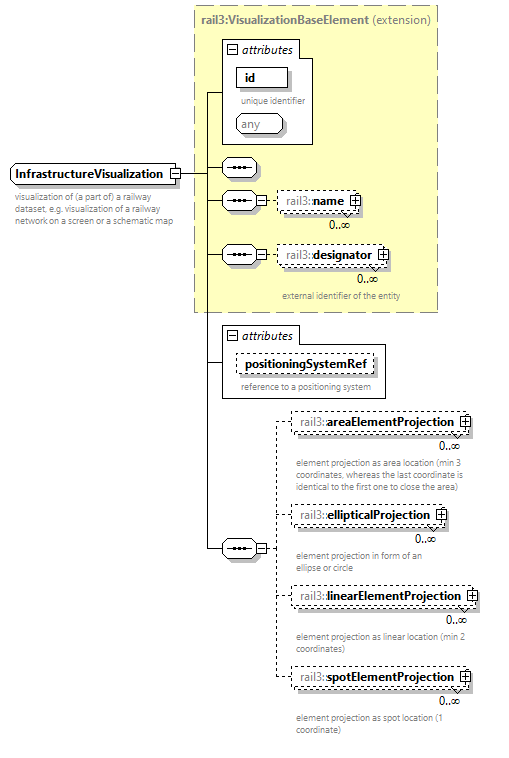 | ||||||||||||||||||||||
| namespace | https://www.railml.org/schemas/3.2 | ||||||||||||||||||||||
| type | extension of rail3:VisualizationBaseElement | ||||||||||||||||||||||
| properties |
| ||||||||||||||||||||||
| children | rail3:name rail3:designator rail3:areaElementProjection rail3:ellipticalProjection rail3:linearElementProjection rail3:spotElementProjection | ||||||||||||||||||||||
| used by |
| ||||||||||||||||||||||
| attributes |
| ||||||||||||||||||||||
| annotation |
| ||||||||||||||||||||||
| source | <xs:complexType name="InfrastructureVisualization"> <xs:annotation> <xs:documentation>visualization of (a part of) a railway dataset, e.g. visualization of a railway network on a screen or a schematic map</xs:documentation> </xs:annotation> <xs:complexContent> <xs:extension base="rail3:VisualizationBaseElement"> <xs:sequence> <xs:element name="areaElementProjection" type="rail3:AreaProjection" minOccurs="0" maxOccurs="unbounded"> <xs:annotation> <xs:documentation>element projection as area location (min 3 coordinates, whereas the last coordinate is identical to the first one to close the area)</xs:documentation> </xs:annotation> </xs:element> <xs:element name="ellipticalProjection" type="rail3:EllipticalProjection" minOccurs="0" maxOccurs="unbounded"> <xs:annotation> <xs:documentation>element projection in form of an ellipse or circle</xs:documentation> </xs:annotation> </xs:element> <xs:element name="linearElementProjection" type="rail3:LinearProjection" minOccurs="0" maxOccurs="unbounded"> <xs:annotation> <xs:documentation>element projection as linear location (min 2 coordinates)</xs:documentation> </xs:annotation> </xs:element> <xs:element name="spotElementProjection" type="rail3:SpotProjection" minOccurs="0" maxOccurs="unbounded"> <xs:annotation> <xs:documentation>element projection as spot location (1 coordinate)</xs:documentation> </xs:annotation> </xs:element> </xs:sequence> <xs:attribute name="positioningSystemRef" type="rail3:tRef" use="optional"> <xs:annotation> <xs:documentation>reference to a positioning system</xs:documentation> </xs:annotation> </xs:attribute> </xs:extension> </xs:complexContent> </xs:complexType> |
attribute InfrastructureVisualization/@positioningSystemRef
| type | rail3:tRef | ||
| properties |
| ||
| annotation |
| ||
| source | <xs:attribute name="positioningSystemRef" type="rail3:tRef" use="optional"> <xs:annotation> <xs:documentation>reference to a positioning system</xs:documentation> </xs:annotation> </xs:attribute> |
element InfrastructureVisualization/areaElementProjection
| diagram |  | ||||||||||||||||||||||
| namespace | https://www.railml.org/schemas/3.2 | ||||||||||||||||||||||
| type | rail3:AreaProjection | ||||||||||||||||||||||
| properties |
| ||||||||||||||||||||||
| children | rail3:name rail3:designator rail3:usesSymbol rail3:coordinate | ||||||||||||||||||||||
| attributes |
| ||||||||||||||||||||||
| annotation |
| ||||||||||||||||||||||
| source | <xs:element name="areaElementProjection" type="rail3:AreaProjection" minOccurs="0" maxOccurs="unbounded"> <xs:annotation> <xs:documentation>element projection as area location (min 3 coordinates, whereas the last coordinate is identical to the first one to close the area)</xs:documentation> </xs:annotation> </xs:element> |
element InfrastructureVisualization/ellipticalProjection
| diagram |  | ||||||||||||||||||||||||||||||||||||||||||||||
| namespace | https://www.railml.org/schemas/3.2 | ||||||||||||||||||||||||||||||||||||||||||||||
| type | rail3:EllipticalProjection | ||||||||||||||||||||||||||||||||||||||||||||||
| properties |
| ||||||||||||||||||||||||||||||||||||||||||||||
| children | rail3:name rail3:designator rail3:usesSymbol rail3:center | ||||||||||||||||||||||||||||||||||||||||||||||
| attributes |
| ||||||||||||||||||||||||||||||||||||||||||||||
| annotation |
| ||||||||||||||||||||||||||||||||||||||||||||||
| source | <xs:element name="ellipticalProjection" type="rail3:EllipticalProjection" minOccurs="0" maxOccurs="unbounded"> <xs:annotation> <xs:documentation>element projection in form of an ellipse or circle</xs:documentation> </xs:annotation> </xs:element> |
element InfrastructureVisualization/linearElementProjection
| diagram |  | ||||||||||||||||||||||
| namespace | https://www.railml.org/schemas/3.2 | ||||||||||||||||||||||
| type | rail3:LinearProjection | ||||||||||||||||||||||
| properties |
| ||||||||||||||||||||||
| children | rail3:name rail3:designator rail3:usesSymbol rail3:coordinate | ||||||||||||||||||||||
| attributes |
| ||||||||||||||||||||||
| annotation |
| ||||||||||||||||||||||
| source | <xs:element name="linearElementProjection" type="rail3:LinearProjection" minOccurs="0" maxOccurs="unbounded"> <xs:annotation> <xs:documentation>element projection as linear location (min 2 coordinates)</xs:documentation> </xs:annotation> </xs:element> |
element InfrastructureVisualization/spotElementProjection
| diagram |  | ||||||||||||||||||||||
| namespace | https://www.railml.org/schemas/3.2 | ||||||||||||||||||||||
| type | rail3:SpotProjection | ||||||||||||||||||||||
| properties |
| ||||||||||||||||||||||
| children | rail3:name rail3:designator rail3:usesSymbol rail3:coordinate | ||||||||||||||||||||||
| attributes |
| ||||||||||||||||||||||
| annotation |
| ||||||||||||||||||||||
| source | <xs:element name="spotElementProjection" type="rail3:SpotProjection" minOccurs="0" maxOccurs="unbounded"> <xs:annotation> <xs:documentation>element projection as spot location (1 coordinate)</xs:documentation> </xs:annotation> </xs:element> |
complexType InfrastructureVisualizations
| diagram |  | ||
| namespace | https://www.railml.org/schemas/3.2 | ||
| children | rail3:infrastructureVisualization | ||
| used by |
| ||
| source | <xs:complexType name="InfrastructureVisualizations"> <xs:sequence> <xs:element name="infrastructureVisualization" type="rail3:InfrastructureVisualization" minOccurs="1" maxOccurs="unbounded"> <xs:annotation> <xs:documentation>visualization of (a part of) a railway infrastructure dataset, e.g. visualization of a railway network on a screen or a schematic map</xs:documentation> </xs:annotation> </xs:element> </xs:sequence> </xs:complexType> |
element InfrastructureVisualizations/infrastructureVisualization
| diagram |  | ||||||||||||||||||||||
| namespace | https://www.railml.org/schemas/3.2 | ||||||||||||||||||||||
| type | rail3:InfrastructureVisualization | ||||||||||||||||||||||
| properties |
| ||||||||||||||||||||||
| children | rail3:name rail3:designator rail3:areaElementProjection rail3:ellipticalProjection rail3:linearElementProjection rail3:spotElementProjection | ||||||||||||||||||||||
| attributes |
| ||||||||||||||||||||||
| annotation |
| ||||||||||||||||||||||
| source | <xs:element name="infrastructureVisualization" type="rail3:InfrastructureVisualization" minOccurs="1" maxOccurs="unbounded"> <xs:annotation> <xs:documentation>visualization of (a part of) a railway infrastructure dataset, e.g. visualization of a railway network on a screen or a schematic map</xs:documentation> </xs:annotation> </xs:element> |
complexType LinearProjection
| diagram |  | ||||||||||||||||||||||
| namespace | https://www.railml.org/schemas/3.2 | ||||||||||||||||||||||
| type | extension of rail3:ElementProjection | ||||||||||||||||||||||
| properties |
| ||||||||||||||||||||||
| children | rail3:name rail3:designator rail3:usesSymbol rail3:coordinate | ||||||||||||||||||||||
| used by |
| ||||||||||||||||||||||
| attributes |
| ||||||||||||||||||||||
| annotation |
| ||||||||||||||||||||||
| source | <xs:complexType name="LinearProjection"> <xs:annotation> <xs:documentation>element projection as linear location (min 2 coordinates)</xs:documentation> </xs:annotation> <xs:complexContent> <xs:extension base="rail3:ElementProjection"> <xs:sequence> <xs:element name="coordinate" type="rail3:ProjectionCoordinate" minOccurs="2" maxOccurs="unbounded"> <xs:annotation> <xs:documentation>coordinates for linear projection (min 2)</xs:documentation> </xs:annotation> </xs:element> </xs:sequence> </xs:extension> </xs:complexContent> </xs:complexType> |
element LinearProjection/coordinate
| diagram |  | ||||||||||||||||||||||||
| namespace | https://www.railml.org/schemas/3.2 | ||||||||||||||||||||||||
| type | rail3:ProjectionCoordinate | ||||||||||||||||||||||||
| properties |
| ||||||||||||||||||||||||
| attributes |
| ||||||||||||||||||||||||
| annotation |
| ||||||||||||||||||||||||
| source | <xs:element name="coordinate" type="rail3:ProjectionCoordinate" minOccurs="2" maxOccurs="unbounded"> <xs:annotation> <xs:documentation>coordinates for linear projection (min 2)</xs:documentation> </xs:annotation> </xs:element> |
complexType ProjectionCoordinate
| diagram |  | ||||||||||||||||||||||||
| namespace | https://www.railml.org/schemas/3.2 | ||||||||||||||||||||||||
| used by |
| ||||||||||||||||||||||||
| attributes |
| ||||||||||||||||||||||||
| source | <xs:complexType name="ProjectionCoordinate"> <xs:sequence/> <xs:attribute name="x" type="xs:decimal" use="required"/> <xs:attribute name="y" type="xs:decimal" use="optional"/> <xs:attribute name="z" type="xs:decimal" use="optional"/> </xs:complexType> |
attribute ProjectionCoordinate/@x
| type | xs:decimal | ||
| properties |
| ||
| source | <xs:attribute name="x" type="xs:decimal" use="required"/> |
attribute ProjectionCoordinate/@y
| type | xs:decimal | ||
| properties |
| ||
| source | <xs:attribute name="y" type="xs:decimal" use="optional"/> |
attribute ProjectionCoordinate/@z
| type | xs:decimal | ||
| properties |
| ||
| source | <xs:attribute name="z" type="xs:decimal" use="optional"/> |
complexType SpotProjection
| diagram | 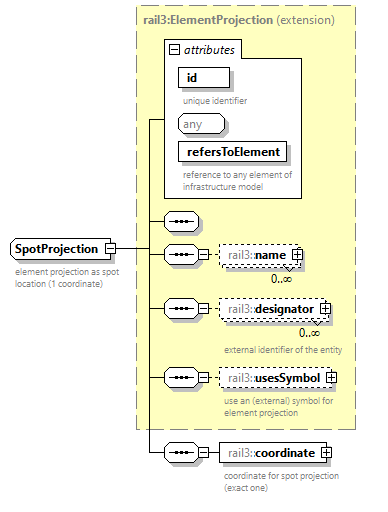 | ||||||||||||||||||||||
| namespace | https://www.railml.org/schemas/3.2 | ||||||||||||||||||||||
| type | extension of rail3:ElementProjection | ||||||||||||||||||||||
| properties |
| ||||||||||||||||||||||
| children | rail3:name rail3:designator rail3:usesSymbol rail3:coordinate | ||||||||||||||||||||||
| used by |
| ||||||||||||||||||||||
| attributes |
| ||||||||||||||||||||||
| annotation |
| ||||||||||||||||||||||
| source | <xs:complexType name="SpotProjection"> <xs:annotation> <xs:documentation>element projection as spot location (1 coordinate)</xs:documentation> </xs:annotation> <xs:complexContent> <xs:extension base="rail3:ElementProjection"> <xs:sequence> <xs:element name="coordinate" type="rail3:ProjectionCoordinate" minOccurs="1" maxOccurs="1"> <xs:annotation> <xs:documentation>coordinate for spot projection (exact one)</xs:documentation> </xs:annotation> </xs:element> </xs:sequence> </xs:extension> </xs:complexContent> </xs:complexType> |
element SpotProjection/coordinate
| diagram | 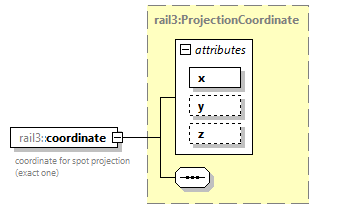 | ||||||||||||||||||||||||
| namespace | https://www.railml.org/schemas/3.2 | ||||||||||||||||||||||||
| type | rail3:ProjectionCoordinate | ||||||||||||||||||||||||
| properties |
| ||||||||||||||||||||||||
| attributes |
| ||||||||||||||||||||||||
| annotation |
| ||||||||||||||||||||||||
| source | <xs:element name="coordinate" type="rail3:ProjectionCoordinate" minOccurs="1" maxOccurs="1"> <xs:annotation> <xs:documentation>coordinate for spot projection (exact one)</xs:documentation> </xs:annotation> </xs:element> |
complexType VisualizationBaseElement
| diagram |  | ||||||||||||||
| namespace | https://www.railml.org/schemas/3.2 | ||||||||||||||
| type | extension of rail3:tElementWithIDandName | ||||||||||||||
| properties |
| ||||||||||||||
| children | rail3:name rail3:designator | ||||||||||||||
| used by |
| ||||||||||||||
| attributes |
| ||||||||||||||
| source | <xs:complexType name="VisualizationBaseElement" abstract="true"> <xs:complexContent> <xs:extension base="rail3:tElementWithIDandName"> <xs:sequence> <xs:element name="designator" type="rail3:Designator" minOccurs="0" maxOccurs="unbounded"> <xs:annotation> <xs:documentation>external identifier of the entity</xs:documentation> </xs:annotation> </xs:element> </xs:sequence> <xs:attributeGroup ref="rail3:anyAttribute"/> </xs:extension> </xs:complexContent> </xs:complexType> |
element VisualizationBaseElement/designator
| diagram |  | ||||||||||||||||||||||||||||||
| namespace | https://www.railml.org/schemas/3.2 | ||||||||||||||||||||||||||||||
| type | rail3:Designator | ||||||||||||||||||||||||||||||
| properties |
| ||||||||||||||||||||||||||||||
| attributes |
| ||||||||||||||||||||||||||||||
| annotation |
| ||||||||||||||||||||||||||||||
| source | <xs:element name="designator" type="rail3:Designator" minOccurs="0" maxOccurs="unbounded"> <xs:annotation> <xs:documentation>external identifier of the entity</xs:documentation> </xs:annotation> </xs:element> |
complexType Visualizations
| diagram |  | ||
| namespace | https://www.railml.org/schemas/3.2 | ||
| children | rail3:infrastructureVisualizations | ||
| used by |
| ||
| annotation |
| ||
| source | <xs:complexType name="Visualizations"> <xs:annotation> <xs:documentation>container element for all visualizations</xs:documentation> </xs:annotation> <xs:sequence> <xs:element name="infrastructureVisualizations" type="rail3:InfrastructureVisualizations" minOccurs="0" maxOccurs="1"> <xs:annotation> <xs:documentation>container element for infrastructure visualizations</xs:documentation> </xs:annotation> </xs:element> </xs:sequence> </xs:complexType> |
element Visualizations/infrastructureVisualizations
| diagram |  | ||||||
| namespace | https://www.railml.org/schemas/3.2 | ||||||
| type | rail3:InfrastructureVisualizations | ||||||
| properties |
| ||||||
| children | rail3:infrastructureVisualization | ||||||
| annotation |
| ||||||
| source | <xs:element name="infrastructureVisualizations" type="rail3:InfrastructureVisualizations" minOccurs="0" maxOccurs="1"> <xs:annotation> <xs:documentation>container element for infrastructure visualizations</xs:documentation> </xs:annotation> </xs:element> |
simpleType tElementProjectionSymbolOrientation
| namespace | https://www.railml.org/schemas/3.2 | |||||||||||||||||||||||
| type | restriction of xs:string | |||||||||||||||||||||||
| properties |
| |||||||||||||||||||||||
| used by |
| |||||||||||||||||||||||
| facets |
| |||||||||||||||||||||||
| source | <xs:simpleType name="tElementProjectionSymbolOrientation"> <xs:restriction base="xs:string"> <xs:enumeration value="down"> <xs:annotation> <xs:documentation>the icon or symbol is turned 180 degrees</xs:documentation> </xs:annotation> </xs:enumeration> <xs:enumeration value="left"> <xs:annotation> <xs:documentation>icon or symbol turned 90 degrees left</xs:documentation> </xs:annotation> </xs:enumeration> <xs:enumeration value="right"> <xs:annotation> <xs:documentation>icon or symbol turned 90 degrees right</xs:documentation> </xs:annotation> </xs:enumeration> <xs:enumeration value="up"> <xs:annotation> <xs:documentation>standard orientation of icon or symbol</xs:documentation> </xs:annotation> </xs:enumeration> </xs:restriction> </xs:simpleType> |
simpleType tElementProjectionSymbolOrientationExt
| namespace | https://www.railml.org/schemas/3.2 | ||
| type | union of (rail3:tElementProjectionSymbolOrientation, rail3:tOtherEnumerationValue) | ||
| used by |
| ||
| source | <xs:simpleType name="tElementProjectionSymbolOrientationExt"> <xs:union memberTypes="rail3:tElementProjectionSymbolOrientation rail3:tOtherEnumerationValue"/> </xs:simpleType> |
complexType Activities
| diagram |  | ||
| namespace | https://www.railml.org/schemas/3.2 | ||
| type | extension of rail3:ActivitiesBase | ||
| properties |
| ||
| children | rail3:activityLoad rail3:activityRollingStock rail3:activityOther rail3:activityTrainReverse | ||
| used by |
| ||
| source | <xs:complexType name="Activities"> <xs:complexContent> <xs:extension base="rail3:ActivitiesBase"> <xs:sequence> <xs:element name="activityTrainReverse" type="rail3:ActivityTrainReverse" minOccurs="0" maxOccurs="unbounded"> <xs:annotation> <xs:documentation>Allows to specify that the train is reversed at the station. Usually that means that previously forward facing parts of the train are subsequently facing backwards, and vice versa. However, if a turntable or similar infrastructure is involved, the reversal may not apply to all parts. The resulting formation reversal is indicated by the attribute @orientationReversed at the formationInfo of the operationalTrainSectionPart.</xs:documentation> </xs:annotation> </xs:element> </xs:sequence> </xs:extension> </xs:complexContent> </xs:complexType> |
element Activities/activityTrainReverse
| diagram |  | ||||||||||||||||||||||||||||||
| namespace | https://www.railml.org/schemas/3.2 | ||||||||||||||||||||||||||||||
| type | rail3:ActivityTrainReverse | ||||||||||||||||||||||||||||||
| properties |
| ||||||||||||||||||||||||||||||
| children | rail3:previousActivities | ||||||||||||||||||||||||||||||
| attributes |
| ||||||||||||||||||||||||||||||
| annotation |
| ||||||||||||||||||||||||||||||
| source | <xs:element name="activityTrainReverse" type="rail3:ActivityTrainReverse" minOccurs="0" maxOccurs="unbounded"> <xs:annotation> <xs:documentation>Allows to specify that the train is reversed at the station. Usually that means that previously forward facing parts of the train are subsequently facing backwards, and vice versa. However, if a turntable or similar infrastructure is involved, the reversal may not apply to all parts. The resulting formation reversal is indicated by the attribute @orientationReversed at the formationInfo of the operationalTrainSectionPart.</xs:documentation> </xs:annotation> </xs:element> |
complexType ActivitiesBase
| diagram |  | ||
| namespace | https://www.railml.org/schemas/3.2 | ||
| properties |
| ||
| children | rail3:activityLoad rail3:activityRollingStock rail3:activityOther | ||
| used by |
| ||
| source | <xs:complexType name="ActivitiesBase" abstract="true"> <xs:sequence> <xs:element name="activityLoad" type="rail3:ActivityLoad" minOccurs="0" maxOccurs="unbounded"> <xs:annotation> <xs:documentation>Represents (commercial) loading and/or unloading activities at a station. This can be passengers (for passenger trains) and/or cargo (for freight trains). As with all activities minimum times for that activity can be specified.</xs:documentation> </xs:annotation> </xs:element> <xs:element name="activityRollingStock" type="rail3:ActivityRollingStock" minOccurs="0" maxOccurs="unbounded"> <xs:annotation> <xs:documentation>Allows to describe that at the stop some activity regarding rolling stock is taking place. This could for example be the adding or removing of an engine or a coach.</xs:documentation> </xs:annotation> </xs:element> <xs:element name="activityOther" type="rail3:ActivityOther" minOccurs="0" maxOccurs="unbounded"> <xs:annotation> <xs:documentation>Represents activities that cannot be described otherwise. In other words, activities that are no loading/unloading of goods or passengers, no rolling stock related activity, no train reversal operation, no trip or crew dependency. An example would be a time that is allocated while stopping somewhere for passengers taking a photo, or for officials checking passports, etc.</xs:documentation> </xs:annotation> </xs:element> </xs:sequence> </xs:complexType> |
element ActivitiesBase/activityLoad
| diagram |  | ||||||||||||||||||||||||||||||||||||||||||||||
| namespace | https://www.railml.org/schemas/3.2 | ||||||||||||||||||||||||||||||||||||||||||||||
| type | rail3:ActivityLoad | ||||||||||||||||||||||||||||||||||||||||||||||
| properties |
| ||||||||||||||||||||||||||||||||||||||||||||||
| children | rail3:previousActivities | ||||||||||||||||||||||||||||||||||||||||||||||
| attributes |
| ||||||||||||||||||||||||||||||||||||||||||||||
| annotation |
| ||||||||||||||||||||||||||||||||||||||||||||||
| source | <xs:element name="activityLoad" type="rail3:ActivityLoad" minOccurs="0" maxOccurs="unbounded"> <xs:annotation> <xs:documentation>Represents (commercial) loading and/or unloading activities at a station. This can be passengers (for passenger trains) and/or cargo (for freight trains). As with all activities minimum times for that activity can be specified.</xs:documentation> </xs:annotation> </xs:element> |
element ActivitiesBase/activityRollingStock
| diagram |  | ||||||||||||||||||||||||||||||||||||||
| namespace | https://www.railml.org/schemas/3.2 | ||||||||||||||||||||||||||||||||||||||
| type | rail3:ActivityRollingStock | ||||||||||||||||||||||||||||||||||||||
| properties |
| ||||||||||||||||||||||||||||||||||||||
| children | rail3:previousActivities | ||||||||||||||||||||||||||||||||||||||
| attributes |
| ||||||||||||||||||||||||||||||||||||||
| annotation |
| ||||||||||||||||||||||||||||||||||||||
| source | <xs:element name="activityRollingStock" type="rail3:ActivityRollingStock" minOccurs="0" maxOccurs="unbounded"> <xs:annotation> <xs:documentation>Allows to describe that at the stop some activity regarding rolling stock is taking place. This could for example be the adding or removing of an engine or a coach.</xs:documentation> </xs:annotation> </xs:element> |
element ActivitiesBase/activityOther
| diagram |  | ||||||||||||||||||||||||||||||||||||||
| namespace | https://www.railml.org/schemas/3.2 | ||||||||||||||||||||||||||||||||||||||
| type | rail3:ActivityOther | ||||||||||||||||||||||||||||||||||||||
| properties |
| ||||||||||||||||||||||||||||||||||||||
| children | rail3:previousActivities | ||||||||||||||||||||||||||||||||||||||
| attributes |
| ||||||||||||||||||||||||||||||||||||||
| annotation |
| ||||||||||||||||||||||||||||||||||||||
| source | <xs:element name="activityOther" type="rail3:ActivityOther" minOccurs="0" maxOccurs="unbounded"> <xs:annotation> <xs:documentation>Represents activities that cannot be described otherwise. In other words, activities that are no loading/unloading of goods or passengers, no rolling stock related activity, no train reversal operation, no trip or crew dependency. An example would be a time that is allocated while stopping somewhere for passengers taking a photo, or for officials checking passports, etc.</xs:documentation> </xs:annotation> </xs:element> |
complexType ActivityCrewDependency
| diagram |  | ||||||||||||||||||||||||||||||||||||||||||||||||||||||||||||||||||||||
| namespace | https://www.railml.org/schemas/3.2 | ||||||||||||||||||||||||||||||||||||||||||||||||||||||||||||||||||||||
| type | extension of rail3:ActivityTripDependencyBase | ||||||||||||||||||||||||||||||||||||||||||||||||||||||||||||||||||||||
| properties |
| ||||||||||||||||||||||||||||||||||||||||||||||||||||||||||||||||||||||
| children | rail3:previousActivities | ||||||||||||||||||||||||||||||||||||||||||||||||||||||||||||||||||||||
| used by |
| ||||||||||||||||||||||||||||||||||||||||||||||||||||||||||||||||||||||
| attributes |
| ||||||||||||||||||||||||||||||||||||||||||||||||||||||||||||||||||||||
| source | <xs:complexType name="ActivityCrewDependency"> <xs:complexContent> <xs:extension base="rail3:ActivityTripDependencyBase"> <xs:sequence/> <xs:attribute name="crewType" type="rail3:CrewTypeExt" use="optional"> <xs:annotation> <xs:documentation>Indicated what kind of crew is changed as part of this activity.</xs:documentation> </xs:annotation> </xs:attribute> <xs:attribute name="transferTime" type="xs:duration" use="optional"> <xs:annotation> <xs:documentation>Can be used to specify a time the crew will need to transition from the providing train to the receiving one. The time provided here may differ greatly from connection transfer times as the crew may need to take preparations. If no transferTime is specified here, however the transferTime specified in the connection transfer times applies.</xs:documentation> </xs:annotation> </xs:attribute> </xs:extension> </xs:complexContent> </xs:complexType> |
attribute ActivityCrewDependency/@crewType
| type | rail3:CrewTypeExt | ||
| properties |
| ||
| annotation |
| ||
| source | <xs:attribute name="crewType" type="rail3:CrewTypeExt" use="optional"> <xs:annotation> <xs:documentation>Indicated what kind of crew is changed as part of this activity.</xs:documentation> </xs:annotation> </xs:attribute> |
attribute ActivityCrewDependency/@transferTime
| type | xs:duration | ||
| properties |
| ||
| annotation |
| ||
| source | <xs:attribute name="transferTime" type="xs:duration" use="optional"> <xs:annotation> <xs:documentation>Can be used to specify a time the crew will need to transition from the providing train to the receiving one. The time provided here may differ greatly from connection transfer times as the crew may need to take preparations. If no transferTime is specified here, however the transferTime specified in the connection transfer times applies.</xs:documentation> </xs:annotation> </xs:attribute> |
complexType ActivityLoad
| diagram |  | ||||||||||||||||||||||||||||||||||||||||||||||
| namespace | https://www.railml.org/schemas/3.2 | ||||||||||||||||||||||||||||||||||||||||||||||
| type | extension of rail3:OrderedActivity | ||||||||||||||||||||||||||||||||||||||||||||||
| properties |
| ||||||||||||||||||||||||||||||||||||||||||||||
| children | rail3:previousActivities | ||||||||||||||||||||||||||||||||||||||||||||||
| used by |
| ||||||||||||||||||||||||||||||||||||||||||||||
| attributes |
| ||||||||||||||||||||||||||||||||||||||||||||||
| source | <xs:complexType name="ActivityLoad"> <xs:complexContent> <xs:extension base="rail3:OrderedActivity"> <xs:sequence/> <xs:attribute name="onOff" type="rail3:OnOff" use="optional"> <xs:annotation> <xs:documentation>Indicates if passengers are boarding or unboarding as part of this activity. When used in context of a cargo train indicates if goods are loaded or unloaded.</xs:documentation> </xs:annotation> </xs:attribute> </xs:extension> </xs:complexContent> </xs:complexType> |
attribute ActivityLoad/@onOff
| type | rail3:OnOff | ||||||||||||||||||
| properties |
| ||||||||||||||||||
| facets |
| ||||||||||||||||||
| annotation |
| ||||||||||||||||||
| source | <xs:attribute name="onOff" type="rail3:OnOff" use="optional"> <xs:annotation> <xs:documentation>Indicates if passengers are boarding or unboarding as part of this activity. When used in context of a cargo train indicates if goods are loaded or unloaded.</xs:documentation> </xs:annotation> </xs:attribute> |
complexType ActivityOther
| diagram |  | ||||||||||||||||||||||||||||||||||||||
| namespace | https://www.railml.org/schemas/3.2 | ||||||||||||||||||||||||||||||||||||||
| type | extension of rail3:OrderedActivity | ||||||||||||||||||||||||||||||||||||||
| properties |
| ||||||||||||||||||||||||||||||||||||||
| children | rail3:previousActivities | ||||||||||||||||||||||||||||||||||||||
| used by |
| ||||||||||||||||||||||||||||||||||||||
| attributes |
| ||||||||||||||||||||||||||||||||||||||
| source | <xs:complexType name="ActivityOther"> <xs:complexContent> <xs:extension base="rail3:OrderedActivity"> <xs:sequence/> </xs:extension> </xs:complexContent> </xs:complexType> |
complexType ActivityRef
| diagram |  | ||||||||||||||
| namespace | https://www.railml.org/schemas/3.2 | ||||||||||||||
| used by |
| ||||||||||||||
| attributes |
| ||||||||||||||
| source | <xs:complexType name="ActivityRef"> <xs:sequence/> <xs:attribute name="ref" type="rail3:tRef" use="required"> <xs:annotation> <xs:documentation>Reference to another activity</xs:documentation> </xs:annotation> </xs:attribute> </xs:complexType> |
attribute ActivityRef/@ref
| type | rail3:tRef | ||
| properties |
| ||
| annotation |
| ||
| source | <xs:attribute name="ref" type="rail3:tRef" use="required"> <xs:annotation> <xs:documentation>Reference to another activity</xs:documentation> </xs:annotation> </xs:attribute> |
complexType ActivityRollingStock
| diagram |  | ||||||||||||||||||||||||||||||||||||||
| namespace | https://www.railml.org/schemas/3.2 | ||||||||||||||||||||||||||||||||||||||
| type | extension of rail3:OrderedActivity | ||||||||||||||||||||||||||||||||||||||
| properties |
| ||||||||||||||||||||||||||||||||||||||
| children | rail3:previousActivities | ||||||||||||||||||||||||||||||||||||||
| used by |
| ||||||||||||||||||||||||||||||||||||||
| attributes |
| ||||||||||||||||||||||||||||||||||||||
| source | <xs:complexType name="ActivityRollingStock"> <xs:complexContent> <xs:extension base="rail3:OrderedActivity"> <xs:sequence/> </xs:extension> </xs:complexContent> </xs:complexType> |
complexType ActivityTrainReverse
| diagram | 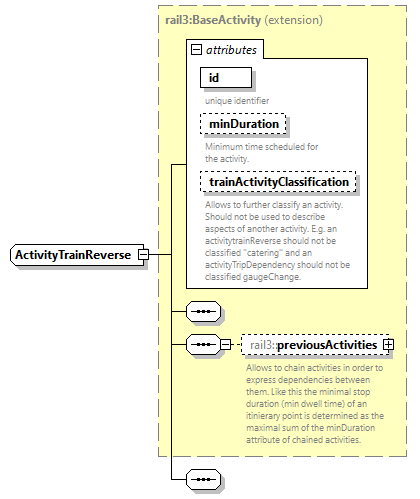 | ||||||||||||||||||||||||||||||
| namespace | https://www.railml.org/schemas/3.2 | ||||||||||||||||||||||||||||||
| type | extension of rail3:BaseActivity | ||||||||||||||||||||||||||||||
| properties |
| ||||||||||||||||||||||||||||||
| children | rail3:previousActivities | ||||||||||||||||||||||||||||||
| used by |
| ||||||||||||||||||||||||||||||
| attributes |
| ||||||||||||||||||||||||||||||
| source | <xs:complexType name="ActivityTrainReverse"> <xs:complexContent> <xs:extension base="rail3:BaseActivity"> <xs:sequence/> </xs:extension> </xs:complexContent> </xs:complexType> |
complexType ActivityTripDependency
| diagram |  | ||||||||||||||||||||||||||||||||||||||||||||||||||||||
| namespace | https://www.railml.org/schemas/3.2 | ||||||||||||||||||||||||||||||||||||||||||||||||||||||
| type | extension of rail3:ActivityTripDependencyBase | ||||||||||||||||||||||||||||||||||||||||||||||||||||||
| properties |
| ||||||||||||||||||||||||||||||||||||||||||||||||||||||
| children | rail3:previousActivities | ||||||||||||||||||||||||||||||||||||||||||||||||||||||
| used by |
| ||||||||||||||||||||||||||||||||||||||||||||||||||||||
| attributes |
| ||||||||||||||||||||||||||||||||||||||||||||||||||||||
| source | <xs:complexType name="ActivityTripDependency"> <xs:complexContent> <xs:extension base="rail3:ActivityTripDependencyBase"> <xs:sequence/> </xs:extension> </xs:complexContent> </xs:complexType> |
complexType ActivityTripDependencyBase
| diagram |  | ||||||||||||||||||||||||||||||||||||||||||||||||||||||
| namespace | https://www.railml.org/schemas/3.2 | ||||||||||||||||||||||||||||||||||||||||||||||||||||||
| type | extension of rail3:OrderedActivity | ||||||||||||||||||||||||||||||||||||||||||||||||||||||
| properties |
| ||||||||||||||||||||||||||||||||||||||||||||||||||||||
| children | rail3:previousActivities | ||||||||||||||||||||||||||||||||||||||||||||||||||||||
| used by |
| ||||||||||||||||||||||||||||||||||||||||||||||||||||||
| attributes |
| ||||||||||||||||||||||||||||||||||||||||||||||||||||||
| source | <xs:complexType name="ActivityTripDependencyBase"> <xs:complexContent> <xs:extension base="rail3:OrderedActivity"> <xs:sequence/> <xs:attribute name="bipRef" type="rail3:tRef" use="required"> <xs:annotation> <xs:documentation>Reference to the base itinerary point of the referenced train that needs to be reached before this activity is finished.</xs:documentation> </xs:annotation> </xs:attribute> <xs:attribute name="operationalTrainVariantRef" type="rail3:tRef" use="required"> <xs:annotation> <xs:documentation>Reference to the operational train variant the enclosing train is dependent upon.</xs:documentation> </xs:annotation> </xs:attribute> </xs:extension> </xs:complexContent> </xs:complexType> |
attribute ActivityTripDependencyBase/@bipRef
| type | rail3:tRef | ||
| properties |
| ||
| annotation |
| ||
| source | <xs:attribute name="bipRef" type="rail3:tRef" use="required"> <xs:annotation> <xs:documentation>Reference to the base itinerary point of the referenced train that needs to be reached before this activity is finished.</xs:documentation> </xs:annotation> </xs:attribute> |
attribute ActivityTripDependencyBase/@operationalTrainVariantRef
| type | rail3:tRef | ||
| properties |
| ||
| annotation |
| ||
| source | <xs:attribute name="operationalTrainVariantRef" type="rail3:tRef" use="required"> <xs:annotation> <xs:documentation>Reference to the operational train variant the enclosing train is dependent upon.</xs:documentation> </xs:annotation> </xs:attribute> |
complexType AdditionalStopInfo
| diagram |  | ||||||||||||||
| namespace | https://www.railml.org/schemas/3.2 | ||||||||||||||
| type | extension of rail3:AdditionalStopInfoBase | ||||||||||||||
| properties |
| ||||||||||||||
| children | rail3:passengerTextInfos rail3:announcements rail3:origin rail3:destination rail3:activities | ||||||||||||||
| used by |
| ||||||||||||||
| attributes |
| ||||||||||||||
| source | <xs:complexType name="AdditionalStopInfo"> <xs:complexContent> <xs:extension base="rail3:AdditionalStopInfoBase"> <xs:sequence> <xs:element name="activities" type="rail3:Activities" minOccurs="0" maxOccurs="1"> <xs:annotation> <xs:documentation>Container element for the additional activities for the stop indicated by the attribute @bipRef.</xs:documentation> </xs:annotation> </xs:element> </xs:sequence> </xs:extension> </xs:complexContent> </xs:complexType> |
element AdditionalStopInfo/activities
| diagram |  | ||||||
| namespace | https://www.railml.org/schemas/3.2 | ||||||
| type | rail3:Activities | ||||||
| properties |
| ||||||
| children | rail3:activityLoad rail3:activityRollingStock rail3:activityOther rail3:activityTrainReverse | ||||||
| annotation |
| ||||||
| source | <xs:element name="activities" type="rail3:Activities" minOccurs="0" maxOccurs="1"> <xs:annotation> <xs:documentation>Container element for the additional activities for the stop indicated by the attribute @bipRef.</xs:documentation> </xs:annotation> </xs:element> |
complexType AdditionalStopInfoBase
| diagram |  | ||||||||||||||
| namespace | https://www.railml.org/schemas/3.2 | ||||||||||||||
| children | rail3:passengerTextInfos rail3:announcements rail3:origin rail3:destination | ||||||||||||||
| used by |
| ||||||||||||||
| attributes |
| ||||||||||||||
| source | <xs:complexType name="AdditionalStopInfoBase"> <xs:sequence> <xs:element name="passengerTextInfos" type="rail3:PassengerTextInfoRefs" minOccurs="0" maxOccurs="1"> <xs:annotation> <xs:documentation>Container element that allows providing non-audio passenger information for the stop indicated by the attribute @bipRef.</xs:documentation> </xs:annotation> </xs:element> <xs:element name="announcements" type="rail3:AnnouncementRefs" minOccurs="0" maxOccurs="1"> <xs:annotation> <xs:documentation>Container element that allows providing audio passenger information for the stop indicated by the attribute @bipRef.</xs:documentation> </xs:annotation> </xs:element> <xs:element name="origin" type="rail3:OriginDestinationInfo" minOccurs="0" maxOccurs="1"> <xs:annotation> <xs:documentation>Allows providing information about the origin of the train in case it can not or should not be extracted from the path of the train. The provided information is related to the stopindicated by @bipRef.</xs:documentation> </xs:annotation> </xs:element> <xs:element name="destination" type="rail3:OriginDestinationInfo" minOccurs="0" maxOccurs="1"> <xs:annotation> <xs:documentation>Allows providing information about the destination of the train in case it can not or should not be extracted from the path of the train. The provided information is related to the stopindicated by @bipRef.</xs:documentation> </xs:annotation> </xs:element> </xs:sequence> <xs:attribute name="bipRef" type="rail3:tRef" use="required"> <xs:annotation> <xs:documentation>Reference to the base itinerary point the additional stop infos are meant for.</xs:documentation> </xs:annotation> </xs:attribute> </xs:complexType> |
attribute AdditionalStopInfoBase/@bipRef
| type | rail3:tRef | ||
| properties |
| ||
| annotation |
| ||
| source | <xs:attribute name="bipRef" type="rail3:tRef" use="required"> <xs:annotation> <xs:documentation>Reference to the base itinerary point the additional stop infos are meant for.</xs:documentation> </xs:annotation> </xs:attribute> |
element AdditionalStopInfoBase/passengerTextInfos
| diagram |  | ||||||
| namespace | https://www.railml.org/schemas/3.2 | ||||||
| type | rail3:PassengerTextInfoRefs | ||||||
| properties |
| ||||||
| children | rail3:passengerTextInfoRef | ||||||
| annotation |
| ||||||
| source | <xs:element name="passengerTextInfos" type="rail3:PassengerTextInfoRefs" minOccurs="0" maxOccurs="1"> <xs:annotation> <xs:documentation>Container element that allows providing non-audio passenger information for the stop indicated by the attribute @bipRef.</xs:documentation> </xs:annotation> </xs:element> |
element AdditionalStopInfoBase/announcements
| diagram |  | ||||||
| namespace | https://www.railml.org/schemas/3.2 | ||||||
| type | rail3:AnnouncementRefs | ||||||
| properties |
| ||||||
| children | rail3:announcementRef | ||||||
| annotation |
| ||||||
| source | <xs:element name="announcements" type="rail3:AnnouncementRefs" minOccurs="0" maxOccurs="1"> <xs:annotation> <xs:documentation>Container element that allows providing audio passenger information for the stop indicated by the attribute @bipRef.</xs:documentation> </xs:annotation> </xs:element> |
element AdditionalStopInfoBase/origin
| diagram |  | ||||||||||||||
| namespace | https://www.railml.org/schemas/3.2 | ||||||||||||||
| type | rail3:OriginDestinationInfo | ||||||||||||||
| properties |
| ||||||||||||||
| children | rail3:mediaResources | ||||||||||||||
| attributes |
| ||||||||||||||
| annotation |
| ||||||||||||||
| source | <xs:element name="origin" type="rail3:OriginDestinationInfo" minOccurs="0" maxOccurs="1"> <xs:annotation> <xs:documentation>Allows providing information about the origin of the train in case it can not or should not be extracted from the path of the train. The provided information is related to the stopindicated by @bipRef.</xs:documentation> </xs:annotation> </xs:element> |
element AdditionalStopInfoBase/destination
| diagram |  | ||||||||||||||
| namespace | https://www.railml.org/schemas/3.2 | ||||||||||||||
| type | rail3:OriginDestinationInfo | ||||||||||||||
| properties |
| ||||||||||||||
| children | rail3:mediaResources | ||||||||||||||
| attributes |
| ||||||||||||||
| annotation |
| ||||||||||||||
| source | <xs:element name="destination" type="rail3:OriginDestinationInfo" minOccurs="0" maxOccurs="1"> <xs:annotation> <xs:documentation>Allows providing information about the destination of the train in case it can not or should not be extracted from the path of the train. The provided information is related to the stopindicated by @bipRef.</xs:documentation> </xs:annotation> </xs:element> |
complexType AdditionalStopInfos
| diagram |  | ||
| namespace | https://www.railml.org/schemas/3.2 | ||
| children | rail3:additionalStopInfo | ||
| used by |
| ||
| source | <xs:complexType name="AdditionalStopInfos"> <xs:sequence> <xs:element name="additionalStopInfo" type="rail3:AdditionalStopInfo" minOccurs="1" maxOccurs="unbounded"> <xs:annotation> <xs:documentation>Allows specifying additional stop activities for a stop of the enclosed section of the train.</xs:documentation> </xs:annotation> </xs:element> </xs:sequence> </xs:complexType> |
element AdditionalStopInfos/additionalStopInfo
| diagram |  | ||||||||||||||
| namespace | https://www.railml.org/schemas/3.2 | ||||||||||||||
| type | rail3:AdditionalStopInfo | ||||||||||||||
| properties |
| ||||||||||||||
| children | rail3:passengerTextInfos rail3:announcements rail3:origin rail3:destination rail3:activities | ||||||||||||||
| attributes |
| ||||||||||||||
| annotation |
| ||||||||||||||
| source | <xs:element name="additionalStopInfo" type="rail3:AdditionalStopInfo" minOccurs="1" maxOccurs="unbounded"> <xs:annotation> <xs:documentation>Allows specifying additional stop activities for a stop of the enclosed section of the train.</xs:documentation> </xs:annotation> </xs:element> |
complexType Announcement
| diagram |  | ||||||||||||||||||||||
| namespace | https://www.railml.org/schemas/3.2 | ||||||||||||||||||||||
| type | extension of rail3:tElementWithIDandName | ||||||||||||||||||||||
| properties |
| ||||||||||||||||||||||
| children | rail3:name rail3:variant rail3:mediaCategories | ||||||||||||||||||||||
| used by |
| ||||||||||||||||||||||
| attributes |
| ||||||||||||||||||||||
| source | <xs:complexType name="Announcement"> <xs:complexContent> <xs:extension base="rail3:tElementWithIDandName"> <xs:sequence> <xs:element name="variant" type="rail3:AnnouncementVariant" minOccurs="0" maxOccurs="unbounded"> <xs:annotation> <xs:documentation>Allows specification of variants of this announcements for different languages.</xs:documentation> </xs:annotation> </xs:element> <xs:element name="mediaCategories" type="rail3:MediaCategories" minOccurs="0" maxOccurs="unbounded"> <xs:annotation> <xs:documentation>Container element for media categories that apply to this announcement</xs:documentation> </xs:annotation> </xs:element> </xs:sequence> <xs:attribute name="URI" type="xs:anyURI" use="optional"> <xs:annotation> <xs:documentation>Can be used to point to an external resource that belongs to this announcement.</xs:documentation> </xs:annotation> </xs:attribute> </xs:extension> </xs:complexContent> </xs:complexType> |
attribute Announcement/@URI
| type | xs:anyURI | ||
| properties |
| ||
| annotation |
| ||
| source | <xs:attribute name="URI" type="xs:anyURI" use="optional"> <xs:annotation> <xs:documentation>Can be used to point to an external resource that belongs to this announcement.</xs:documentation> </xs:annotation> </xs:attribute> |
element Announcement/variant
| diagram |  | ||||||||||||||||||||||
| namespace | https://www.railml.org/schemas/3.2 | ||||||||||||||||||||||
| type | rail3:AnnouncementVariant | ||||||||||||||||||||||
| properties |
| ||||||||||||||||||||||
| attributes |
| ||||||||||||||||||||||
| annotation |
| ||||||||||||||||||||||
| source | <xs:element name="variant" type="rail3:AnnouncementVariant" minOccurs="0" maxOccurs="unbounded"> <xs:annotation> <xs:documentation>Allows specification of variants of this announcements for different languages.</xs:documentation> </xs:annotation> </xs:element> |
element Announcement/mediaCategories
| diagram |  | ||||||
| namespace | https://www.railml.org/schemas/3.2 | ||||||
| type | rail3:MediaCategories | ||||||
| properties |
| ||||||
| children | rail3:mediaCategory | ||||||
| annotation |
| ||||||
| source | <xs:element name="mediaCategories" type="rail3:MediaCategories" minOccurs="0" maxOccurs="unbounded"> <xs:annotation> <xs:documentation>Container element for media categories that apply to this announcement</xs:documentation> </xs:annotation> </xs:element> |
complexType AnnouncementRef
| diagram |  | ||||||||||||||
| namespace | https://www.railml.org/schemas/3.2 | ||||||||||||||
| used by |
| ||||||||||||||
| attributes |
| ||||||||||||||
| source | <xs:complexType name="AnnouncementRef"> <xs:sequence/> <xs:attribute name="ref" type="rail3:tRef" use="optional"> <xs:annotation> <xs:documentation>Reference to announcement defined in the root of timetable.</xs:documentation> </xs:annotation> </xs:attribute> </xs:complexType> |
attribute AnnouncementRef/@ref
| type | rail3:tRef | ||
| properties |
| ||
| annotation |
| ||
| source | <xs:attribute name="ref" type="rail3:tRef" use="optional"> <xs:annotation> <xs:documentation>Reference to announcement defined in the root of timetable.</xs:documentation> </xs:annotation> </xs:attribute> |
complexType AnnouncementRefs
| diagram |  | ||
| namespace | https://www.railml.org/schemas/3.2 | ||
| children | rail3:announcementRef | ||
| used by |
| ||
| source | <xs:complexType name="AnnouncementRefs"> <xs:sequence> <xs:element name="announcementRef" type="rail3:AnnouncementRef" minOccurs="1" maxOccurs="unbounded"> <xs:annotation> <xs:documentation>Allows referencing of announcement elements.</xs:documentation> </xs:annotation> </xs:element> </xs:sequence> </xs:complexType> |
element AnnouncementRefs/announcementRef
| diagram |  | ||||||||||||||
| namespace | https://www.railml.org/schemas/3.2 | ||||||||||||||
| type | rail3:AnnouncementRef | ||||||||||||||
| properties |
| ||||||||||||||
| attributes |
| ||||||||||||||
| annotation |
| ||||||||||||||
| source | <xs:element name="announcementRef" type="rail3:AnnouncementRef" minOccurs="1" maxOccurs="unbounded"> <xs:annotation> <xs:documentation>Allows referencing of announcement elements.</xs:documentation> </xs:annotation> </xs:element> |
complexType Announcements
| diagram |  | ||
| namespace | https://www.railml.org/schemas/3.2 | ||
| children | rail3:announcement | ||
| used by |
| ||
| source | <xs:complexType name="Announcements"> <xs:sequence> <xs:element name="announcement" type="rail3:Announcement" minOccurs="1" maxOccurs="unbounded"> <xs:annotation> <xs:documentation>Announcements encode acoustical infos that are played back by a passenger information system, either onboard the train or at the station. </xs:documentation> </xs:annotation> </xs:element> </xs:sequence> </xs:complexType> |
element Announcements/announcement
| diagram |  | ||||||||||||||||||||||
| namespace | https://www.railml.org/schemas/3.2 | ||||||||||||||||||||||
| type | rail3:Announcement | ||||||||||||||||||||||
| properties |
| ||||||||||||||||||||||
| children | rail3:name rail3:variant rail3:mediaCategories | ||||||||||||||||||||||
| attributes |
| ||||||||||||||||||||||
| annotation |
| ||||||||||||||||||||||
| source | <xs:element name="announcement" type="rail3:Announcement" minOccurs="1" maxOccurs="unbounded"> <xs:annotation> <xs:documentation>Announcements encode acoustical infos that are played back by a passenger information system, either onboard the train or at the station. </xs:documentation> </xs:annotation> </xs:element> |
complexType AnnouncementVariant
| diagram |  | ||||||||||||||||||||||
| namespace | https://www.railml.org/schemas/3.2 | ||||||||||||||||||||||
| used by |
| ||||||||||||||||||||||
| attributes |
| ||||||||||||||||||||||
| source | <xs:complexType name="AnnouncementVariant"> <xs:sequence/> <xs:attribute name="language" type="xs:language" use="required"> <xs:annotation> <xs:documentation>specifies the language this announcement resource is in.</xs:documentation> </xs:annotation> </xs:attribute> <xs:attribute name="URI" type="xs:anyURI" use="optional"> <xs:annotation> <xs:documentation>Used to point to an external resource that usualy would encode audio data for this announcement variant.</xs:documentation> </xs:annotation> </xs:attribute> </xs:complexType> |
attribute AnnouncementVariant/@language
| type | xs:language | ||
| properties |
| ||
| annotation |
| ||
| source | <xs:attribute name="language" type="xs:language" use="required"> <xs:annotation> <xs:documentation>specifies the language this announcement resource is in.</xs:documentation> </xs:annotation> </xs:attribute> |
attribute AnnouncementVariant/@URI
| type | xs:anyURI | ||
| properties |
| ||
| annotation |
| ||
| source | <xs:attribute name="URI" type="xs:anyURI" use="optional"> <xs:annotation> <xs:documentation>Used to point to an external resource that usualy would encode audio data for this announcement variant.</xs:documentation> </xs:annotation> </xs:attribute> |
complexType AudioFragment
| diagram |  | ||||||||||||||||||||||
| namespace | https://www.railml.org/schemas/3.2 | ||||||||||||||||||||||
| children | rail3:textToSpeechTemplate | ||||||||||||||||||||||
| used by |
| ||||||||||||||||||||||
| attributes |
| ||||||||||||||||||||||
| source | <xs:complexType name="AudioFragment"> <xs:sequence> <xs:element name="textToSpeechTemplate" type="rail3:TextToSpeechTemplate" minOccurs="0" maxOccurs="1"> <xs:annotation> <xs:documentation>Allows specification of a text to speech template to be used by system that generate announcements based on this.</xs:documentation> </xs:annotation> </xs:element> </xs:sequence> <xs:attribute name="code" type="xs:string" use="optional"> <xs:annotation> <xs:documentation>Allows to reference an audio resource available in the importing system. Can also be used to refer to an audio file that is provided along with the railML file.</xs:documentation> </xs:annotation> </xs:attribute> <xs:attribute name="language" type="xs:language" use="optional"> <xs:annotation> <xs:documentation>Describes the language of the audio fragment.</xs:documentation> </xs:annotation> </xs:attribute> </xs:complexType> |
attribute AudioFragment/@code
| type | xs:string | ||
| properties |
| ||
| annotation |
| ||
| source | <xs:attribute name="code" type="xs:string" use="optional"> <xs:annotation> <xs:documentation>Allows to reference an audio resource available in the importing system. Can also be used to refer to an audio file that is provided along with the railML file.</xs:documentation> </xs:annotation> </xs:attribute> |
attribute AudioFragment/@language
| type | xs:language | ||
| properties |
| ||
| annotation |
| ||
| source | <xs:attribute name="language" type="xs:language" use="optional"> <xs:annotation> <xs:documentation>Describes the language of the audio fragment.</xs:documentation> </xs:annotation> </xs:attribute> |
element AudioFragment/textToSpeechTemplate
| diagram |  | ||||||
| namespace | https://www.railml.org/schemas/3.2 | ||||||
| type | rail3:TextToSpeechTemplate | ||||||
| properties |
| ||||||
| annotation |
| ||||||
| source | <xs:element name="textToSpeechTemplate" type="rail3:TextToSpeechTemplate" minOccurs="0" maxOccurs="1"> <xs:annotation> <xs:documentation>Allows specification of a text to speech template to be used by system that generate announcements based on this.</xs:documentation> </xs:annotation> </xs:element> |
complexType AudioFragments
| diagram | 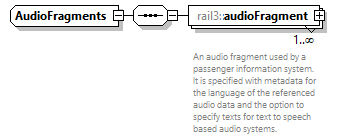 | ||
| namespace | https://www.railml.org/schemas/3.2 | ||
| children | rail3:audioFragment | ||
| used by |
| ||
| source | <xs:complexType name="AudioFragments"> <xs:sequence> <xs:element name="audioFragment" type="rail3:AudioFragment" minOccurs="1" maxOccurs="unbounded"> <xs:annotation> <xs:documentation>An audio fragment used by a passenger information system. It is specified with metadata for the language of the referenced audio data and the option to specify texts for text to speech based audio systems.</xs:documentation> </xs:annotation> </xs:element> </xs:sequence> </xs:complexType> |
element AudioFragments/audioFragment
| diagram | 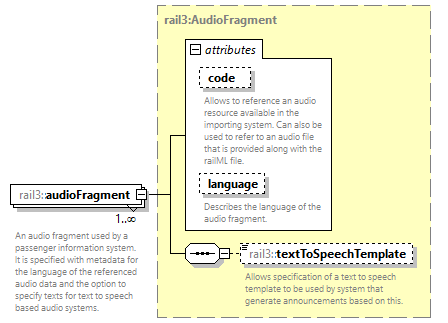 | ||||||||||||||||||||||
| namespace | https://www.railml.org/schemas/3.2 | ||||||||||||||||||||||
| type | rail3:AudioFragment | ||||||||||||||||||||||
| properties |
| ||||||||||||||||||||||
| children | rail3:textToSpeechTemplate | ||||||||||||||||||||||
| attributes |
| ||||||||||||||||||||||
| annotation |
| ||||||||||||||||||||||
| source | <xs:element name="audioFragment" type="rail3:AudioFragment" minOccurs="1" maxOccurs="unbounded"> <xs:annotation> <xs:documentation>An audio fragment used by a passenger information system. It is specified with metadata for the language of the referenced audio data and the option to specify texts for text to speech based audio systems.</xs:documentation> </xs:annotation> </xs:element> |
complexType BaseActivity
| diagram | 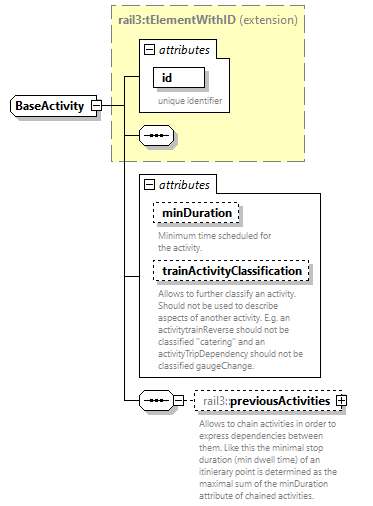 | ||||||||||||||||||||||||||||||
| namespace | https://www.railml.org/schemas/3.2 | ||||||||||||||||||||||||||||||
| type | extension of rail3:tElementWithID | ||||||||||||||||||||||||||||||
| properties |
| ||||||||||||||||||||||||||||||
| children | rail3:previousActivities | ||||||||||||||||||||||||||||||
| used by |
| ||||||||||||||||||||||||||||||
| attributes |
| ||||||||||||||||||||||||||||||
| source | <xs:complexType name="BaseActivity" abstract="true"> <xs:complexContent> <xs:extension base="rail3:tElementWithID"> <xs:sequence> <xs:element name="previousActivities" type="rail3:PreviousActivities" minOccurs="0" maxOccurs="1"> <xs:annotation> <xs:documentation>Allows to chain activities in order to express dependencies between them. Like this the minimal stop duration (min dwell time) of an itinierary point is determined as the maximal sum of the minDuration attribute of chained activities.</xs:documentation> </xs:annotation> </xs:element> </xs:sequence> <xs:attribute name="minDuration" type="xs:duration" use="optional"> <xs:annotation> <xs:documentation>Minimum time scheduled for the activity. </xs:documentation> </xs:annotation> </xs:attribute> <xs:attribute name="trainActivityClassification" type="rail3:TrainActivityClassificationExt" use="optional"> <xs:annotation> <xs:documentation>Allows to further classify an activity. Should not be used to describe aspects of another activity. E.g. an activitytrainReverse should not be classified "catering" and an activityTripDependency should not be classified gaugeChange.</xs:documentation> </xs:annotation> </xs:attribute> </xs:extension> </xs:complexContent> </xs:complexType> |
attribute BaseActivity/@minDuration
| type | xs:duration | ||
| properties |
| ||
| annotation |
| ||
| source | <xs:attribute name="minDuration" type="xs:duration" use="optional"> <xs:annotation> <xs:documentation>Minimum time scheduled for the activity. </xs:documentation> </xs:annotation> </xs:attribute> |
attribute BaseActivity/@trainActivityClassification
| type | rail3:TrainActivityClassificationExt | ||
| properties |
| ||
| annotation |
| ||
| source | <xs:attribute name="trainActivityClassification" type="rail3:TrainActivityClassificationExt" use="optional"> <xs:annotation> <xs:documentation>Allows to further classify an activity. Should not be used to describe aspects of another activity. E.g. an activitytrainReverse should not be classified "catering" and an activityTripDependency should not be classified gaugeChange.</xs:documentation> </xs:annotation> </xs:attribute> |
element BaseActivity/previousActivities
| diagram | 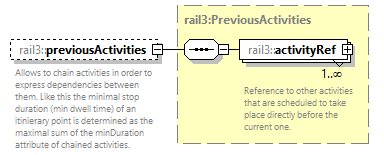 | ||||||
| namespace | https://www.railml.org/schemas/3.2 | ||||||
| type | rail3:PreviousActivities | ||||||
| properties |
| ||||||
| children | rail3:activityRef | ||||||
| annotation |
| ||||||
| source | <xs:element name="previousActivities" type="rail3:PreviousActivities" minOccurs="0" maxOccurs="1"> <xs:annotation> <xs:documentation>Allows to chain activities in order to express dependencies between them. Like this the minimal stop duration (min dwell time) of an itinierary point is determined as the maximal sum of the minDuration attribute of chained activities.</xs:documentation> </xs:annotation> </xs:element> |
complexType BaseItineraries
| diagram | 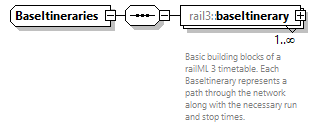 | ||
| namespace | https://www.railml.org/schemas/3.2 | ||
| children | rail3:baseItinerary | ||
| used by |
| ||
| source | <xs:complexType name="BaseItineraries"> <xs:sequence> <xs:element name="baseItinerary" type="rail3:BaseItinerary" minOccurs="1" maxOccurs="unbounded"> <xs:annotation> <xs:documentation>Basic building blocks of a railML 3 timetable. Each BaseItinerary represents a path through the network along with the necessary run and stop times.</xs:documentation> </xs:annotation> </xs:element> </xs:sequence> </xs:complexType> |
element BaseItineraries/baseItinerary
| diagram | 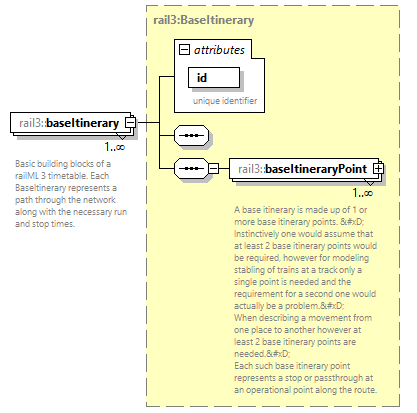 | ||||||||||||||
| namespace | https://www.railml.org/schemas/3.2 | ||||||||||||||
| type | rail3:BaseItinerary | ||||||||||||||
| properties |
| ||||||||||||||
| children | rail3:baseItineraryPoint | ||||||||||||||
| attributes |
| ||||||||||||||
| annotation |
| ||||||||||||||
| source | <xs:element name="baseItinerary" type="rail3:BaseItinerary" minOccurs="1" maxOccurs="unbounded"> <xs:annotation> <xs:documentation>Basic building blocks of a railML 3 timetable. Each BaseItinerary represents a path through the network along with the necessary run and stop times.</xs:documentation> </xs:annotation> </xs:element> |
complexType BaseItinerary
| diagram | 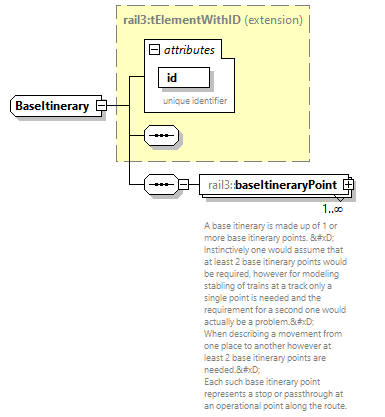 | ||||||||||||||
| namespace | https://www.railml.org/schemas/3.2 | ||||||||||||||
| type | extension of rail3:tElementWithID | ||||||||||||||
| properties |
| ||||||||||||||
| children | rail3:baseItineraryPoint | ||||||||||||||
| used by |
| ||||||||||||||
| attributes |
| ||||||||||||||
| source | <xs:complexType name="BaseItinerary"> <xs:complexContent> <xs:extension base="rail3:tElementWithID"> <xs:sequence> <xs:element name="baseItineraryPoint" type="rail3:BaseItineraryPoint" minOccurs="1" maxOccurs="unbounded"> <xs:annotation> <xs:documentation>A base itinerary is made up of 1 or more base itinerary points. 
 Instinctively one would assume that at least 2 base itinerary points would be required, however for modeling stabling of trains at a track only a single point is needed and the requirement for a second one would actually be a problem.
 When describing a movement from one place to another however at least 2 base itinerary points are needed.
 Each such base itinerary point represents a stop or passthrough at an operational point along the route.</xs:documentation> </xs:annotation> </xs:element> </xs:sequence> </xs:extension> </xs:complexContent> </xs:complexType> |
element BaseItinerary/baseItineraryPoint
| diagram | 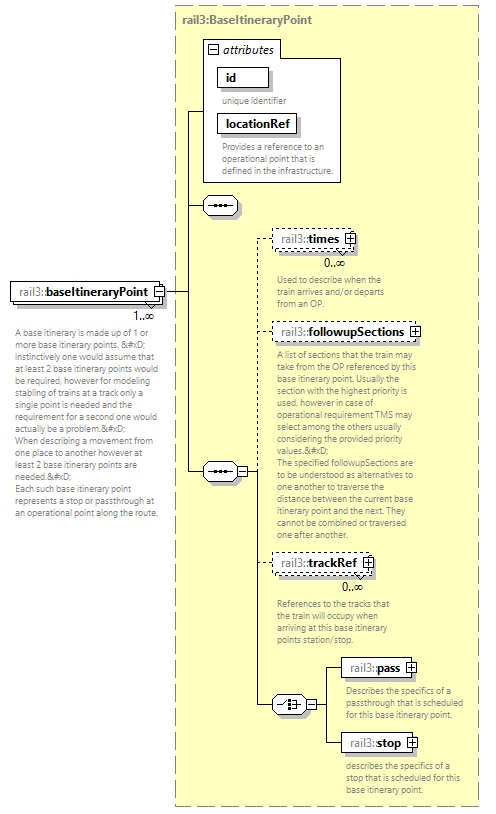 | ||||||||||||||||||||||
| namespace | https://www.railml.org/schemas/3.2 | ||||||||||||||||||||||
| type | rail3:BaseItineraryPoint | ||||||||||||||||||||||
| properties |
| ||||||||||||||||||||||
| children | rail3:times rail3:followupSections rail3:trackRef rail3:pass rail3:stop | ||||||||||||||||||||||
| attributes |
| ||||||||||||||||||||||
| annotation |
| ||||||||||||||||||||||
| source | <xs:element name="baseItineraryPoint" type="rail3:BaseItineraryPoint" minOccurs="1" maxOccurs="unbounded"> <xs:annotation> <xs:documentation>A base itinerary is made up of 1 or more base itinerary points. 
 Instinctively one would assume that at least 2 base itinerary points would be required, however for modeling stabling of trains at a track only a single point is needed and the requirement for a second one would actually be a problem.
 When describing a movement from one place to another however at least 2 base itinerary points are needed.
 Each such base itinerary point represents a stop or passthrough at an operational point along the route.</xs:documentation> </xs:annotation> </xs:element> |
complexType BaseItineraryPoint
| diagram | 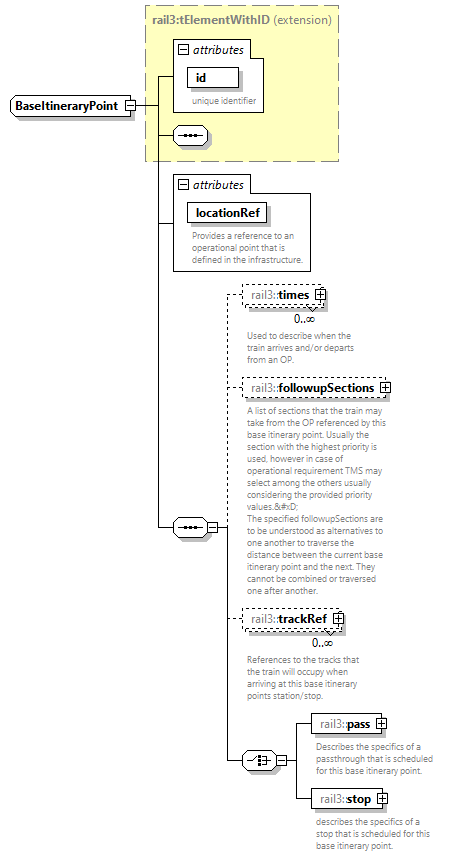 | ||||||||||||||||||||||
| namespace | https://www.railml.org/schemas/3.2 | ||||||||||||||||||||||
| type | extension of rail3:tElementWithID | ||||||||||||||||||||||
| properties |
| ||||||||||||||||||||||
| children | rail3:times rail3:followupSections rail3:trackRef rail3:pass rail3:stop | ||||||||||||||||||||||
| used by |
| ||||||||||||||||||||||
| attributes |
| ||||||||||||||||||||||
| source | <xs:complexType name="BaseItineraryPoint"> <xs:complexContent> <xs:extension base="rail3:tElementWithID"> <xs:sequence> <xs:element name="times" type="rail3:Times" minOccurs="0" maxOccurs="unbounded"> <xs:annotation> <xs:documentation>Used to describe when the train arrives and/or departs from an OP.</xs:documentation> </xs:annotation> </xs:element> <xs:element name="followupSections" type="rail3:FollowupSectionsTT" minOccurs="0" maxOccurs="1"> <xs:annotation> <xs:documentation>A list of sections that the train may take from the OP referenced by this base itinerary point. Usually the section with the highest priority is used, however in case of operational requirement TMS may select among the others usually considering the provided priority values.
 The specified followupSections are to be understood as alternatives to one another to traverse the distance between the current base itinerary point and the next. They cannot be combined or traversed one after another.</xs:documentation> </xs:annotation> </xs:element> <xs:element name="trackRef" type="rail3:TrackRef" minOccurs="0" maxOccurs="unbounded"> <xs:annotation> <xs:documentation>References to the tracks that the train will occupy when arriving at this base itinerary points station/stop.</xs:documentation> </xs:annotation> </xs:element> <xs:choice minOccurs="1" maxOccurs="1"> <xs:element name="pass" type="rail3:PassInfo" minOccurs="1" maxOccurs="1"> <xs:annotation> <xs:documentation>Describes the specifics of a passthrough that is scheduled for this base itinerary point.</xs:documentation> </xs:annotation> </xs:element> <xs:element name="stop" type="rail3:StopInfo" minOccurs="1" maxOccurs="1"> <xs:annotation> <xs:documentation>describes the specifics of a stop that is scheduled for this base itinerary point.</xs:documentation> </xs:annotation> </xs:element> </xs:choice> </xs:sequence> <xs:attribute name="locationRef" type="rail3:tRef" use="required"> <xs:annotation> <xs:documentation>Provides a reference to an operational point that is defined in the infrastructure.</xs:documentation> </xs:annotation> </xs:attribute> </xs:extension> </xs:complexContent> </xs:complexType> |
attribute BaseItineraryPoint/@locationRef
| type | rail3:tRef | ||
| properties |
| ||
| annotation |
| ||
| source | <xs:attribute name="locationRef" type="rail3:tRef" use="required"> <xs:annotation> <xs:documentation>Provides a reference to an operational point that is defined in the infrastructure.</xs:documentation> </xs:annotation> </xs:attribute> |
element BaseItineraryPoint/times
| diagram | 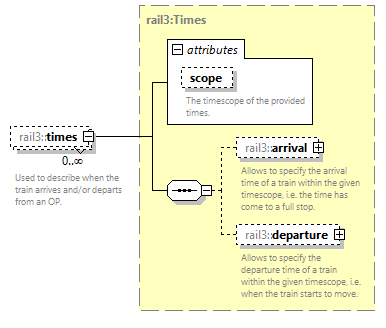 | ||||||||||||||
| namespace | https://www.railml.org/schemas/3.2 | ||||||||||||||
| type | rail3:Times | ||||||||||||||
| properties |
| ||||||||||||||
| children | rail3:arrival rail3:departure | ||||||||||||||
| attributes |
| ||||||||||||||
| annotation |
| ||||||||||||||
| source | <xs:element name="times" type="rail3:Times" minOccurs="0" maxOccurs="unbounded"> <xs:annotation> <xs:documentation>Used to describe when the train arrives and/or departs from an OP.</xs:documentation> </xs:annotation> </xs:element> |
element BaseItineraryPoint/followupSections
| diagram | 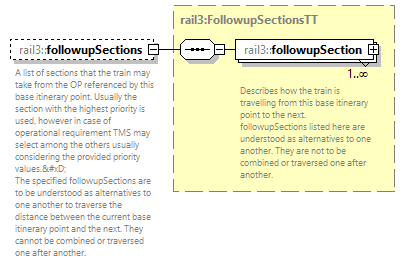 | ||||||
| namespace | https://www.railml.org/schemas/3.2 | ||||||
| type | rail3:FollowupSectionsTT | ||||||
| properties |
| ||||||
| children | rail3:followupSection | ||||||
| annotation |
| ||||||
| source | <xs:element name="followupSections" type="rail3:FollowupSectionsTT" minOccurs="0" maxOccurs="1"> <xs:annotation> <xs:documentation>A list of sections that the train may take from the OP referenced by this base itinerary point. Usually the section with the highest priority is used, however in case of operational requirement TMS may select among the others usually considering the provided priority values.
 The specified followupSections are to be understood as alternatives to one another to traverse the distance between the current base itinerary point and the next. They cannot be combined or traversed one after another.</xs:documentation> </xs:annotation> </xs:element> |
element BaseItineraryPoint/trackRef
| diagram | 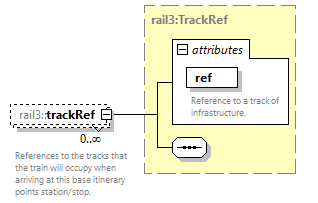 | ||||||||||||||
| namespace | https://www.railml.org/schemas/3.2 | ||||||||||||||
| type | rail3:TrackRef | ||||||||||||||
| properties |
| ||||||||||||||
| attributes |
| ||||||||||||||
| annotation |
| ||||||||||||||
| source | <xs:element name="trackRef" type="rail3:TrackRef" minOccurs="0" maxOccurs="unbounded"> <xs:annotation> <xs:documentation>References to the tracks that the train will occupy when arriving at this base itinerary points station/stop.</xs:documentation> </xs:annotation> </xs:element> |
element BaseItineraryPoint/pass
| diagram | 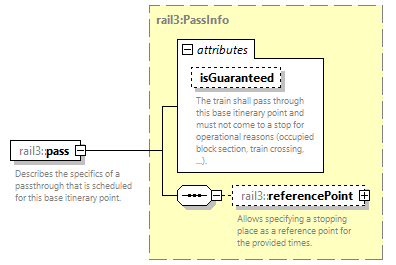 | ||||||||||||||
| namespace | https://www.railml.org/schemas/3.2 | ||||||||||||||
| type | rail3:PassInfo | ||||||||||||||
| properties |
| ||||||||||||||
| children | rail3:referencePoint | ||||||||||||||
| attributes |
| ||||||||||||||
| annotation |
| ||||||||||||||
| source | <xs:element name="pass" type="rail3:PassInfo" minOccurs="1" maxOccurs="1"> <xs:annotation> <xs:documentation>Describes the specifics of a passthrough that is scheduled for this base itinerary point.</xs:documentation> </xs:annotation> </xs:element> |
element BaseItineraryPoint/stop
| diagram | 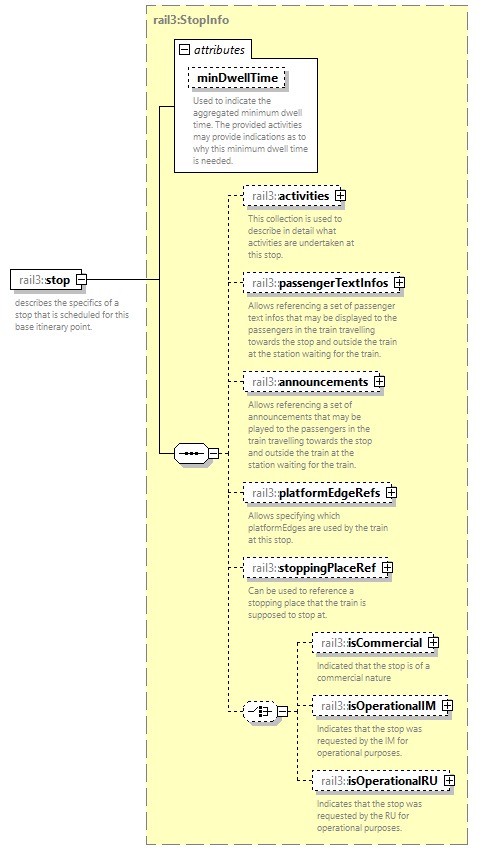 | ||||||||||||||
| namespace | https://www.railml.org/schemas/3.2 | ||||||||||||||
| type | rail3:StopInfo | ||||||||||||||
| properties |
| ||||||||||||||
| children | rail3:activities rail3:passengerTextInfos rail3:announcements rail3:platformEdgeRefs rail3:stoppingPlaceRef rail3:isCommercial rail3:isOperationalIM rail3:isOperationalRU | ||||||||||||||
| attributes |
| ||||||||||||||
| annotation |
| ||||||||||||||
| source | <xs:element name="stop" type="rail3:StopInfo" minOccurs="1" maxOccurs="1"> <xs:annotation> <xs:documentation>describes the specifics of a stop that is scheduled for this base itinerary point.</xs:documentation> </xs:annotation> </xs:element> |
complexType CancellationInfo
| diagram | 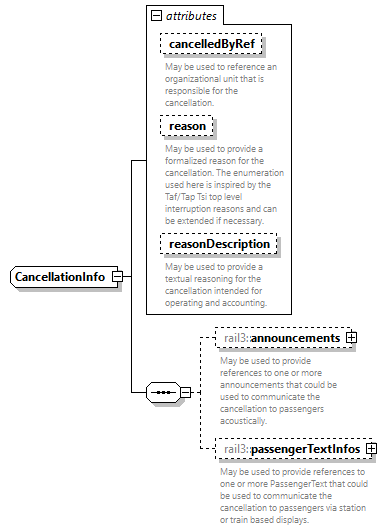 | ||||||||||||||||||||||||||||||
| namespace | https://www.railml.org/schemas/3.2 | ||||||||||||||||||||||||||||||
| children | rail3:announcements rail3:passengerTextInfos | ||||||||||||||||||||||||||||||
| used by |
| ||||||||||||||||||||||||||||||
| attributes |
| ||||||||||||||||||||||||||||||
| source | <xs:complexType name="CancellationInfo"> <xs:sequence> <xs:element name="announcements" type="rail3:AnnouncementRefs" minOccurs="0" maxOccurs="1"> <xs:annotation> <xs:documentation>May be used to provide references to one or more announcements that could be used to communicate the cancellation to passengers acoustically.</xs:documentation> </xs:annotation> </xs:element> <xs:element name="passengerTextInfos" type="rail3:PassengerTextInfoRefs" minOccurs="0" maxOccurs="1"> <xs:annotation> <xs:documentation>May be used to provide references to one or more PassengerText that could be used to communicate the cancellation to passengers via station or train based displays.</xs:documentation> </xs:annotation> </xs:element> </xs:sequence> <xs:attribute name="cancelledByRef" type="rail3:tRef" use="optional"> <xs:annotation> <xs:documentation>May be used to reference an organizational unit that is responsible for the cancellation.</xs:documentation> </xs:annotation> </xs:attribute> <xs:attribute name="reason" type="rail3:InterruptionReasonExt" use="optional"> <xs:annotation> <xs:documentation>May be used to provide a formalized reason for the cancellation. The enumeration used here is inspired by the Taf/Tap Tsi top level interruption reasons and can be extended if necessary.</xs:documentation> </xs:annotation> </xs:attribute> <xs:attribute name="reasonDescription" type="xs:string" use="optional"> <xs:annotation> <xs:documentation>May be used to provide a textual reasoning for the cancellation intended for operating and accounting.</xs:documentation> </xs:annotation> </xs:attribute> </xs:complexType> |
attribute CancellationInfo/@cancelledByRef
| type | rail3:tRef | ||
| properties |
| ||
| annotation |
| ||
| source | <xs:attribute name="cancelledByRef" type="rail3:tRef" use="optional"> <xs:annotation> <xs:documentation>May be used to reference an organizational unit that is responsible for the cancellation.</xs:documentation> </xs:annotation> </xs:attribute> |
attribute CancellationInfo/@reason
| type | rail3:InterruptionReasonExt | ||
| properties |
| ||
| annotation |
| ||
| source | <xs:attribute name="reason" type="rail3:InterruptionReasonExt" use="optional"> <xs:annotation> <xs:documentation>May be used to provide a formalized reason for the cancellation. The enumeration used here is inspired by the Taf/Tap Tsi top level interruption reasons and can be extended if necessary.</xs:documentation> </xs:annotation> </xs:attribute> |
attribute CancellationInfo/@reasonDescription
| type | xs:string | ||
| properties |
| ||
| annotation |
| ||
| source | <xs:attribute name="reasonDescription" type="xs:string" use="optional"> <xs:annotation> <xs:documentation>May be used to provide a textual reasoning for the cancellation intended for operating and accounting.</xs:documentation> </xs:annotation> </xs:attribute> |
element CancellationInfo/announcements
| diagram | 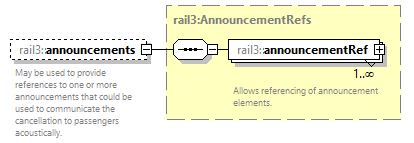 | ||||||
| namespace | https://www.railml.org/schemas/3.2 | ||||||
| type | rail3:AnnouncementRefs | ||||||
| properties |
| ||||||
| children | rail3:announcementRef | ||||||
| annotation |
| ||||||
| source | <xs:element name="announcements" type="rail3:AnnouncementRefs" minOccurs="0" maxOccurs="1"> <xs:annotation> <xs:documentation>May be used to provide references to one or more announcements that could be used to communicate the cancellation to passengers acoustically.</xs:documentation> </xs:annotation> </xs:element> |
element CancellationInfo/passengerTextInfos
| diagram |  | ||||||
| namespace | https://www.railml.org/schemas/3.2 | ||||||
| type | rail3:PassengerTextInfoRefs | ||||||
| properties |
| ||||||
| children | rail3:passengerTextInfoRef | ||||||
| annotation |
| ||||||
| source | <xs:element name="passengerTextInfos" type="rail3:PassengerTextInfoRefs" minOccurs="0" maxOccurs="1"> <xs:annotation> <xs:documentation>May be used to provide references to one or more PassengerText that could be used to communicate the cancellation to passengers via station or train based displays.</xs:documentation> </xs:annotation> </xs:element> |
complexType Categories
| diagram |  | ||
| namespace | https://www.railml.org/schemas/3.2 | ||
| children | rail3:category | ||
| used by |
| ||
| source | <xs:complexType name="Categories"> <xs:sequence> <xs:element name="category" type="rail3:Category" minOccurs="1" maxOccurs="unbounded"> <xs:annotation> <xs:documentation>Allows grouping of trains as well as providing generalized information for trains.</xs:documentation> </xs:annotation> </xs:element> </xs:sequence> </xs:complexType> |
element Categories/category
| diagram | 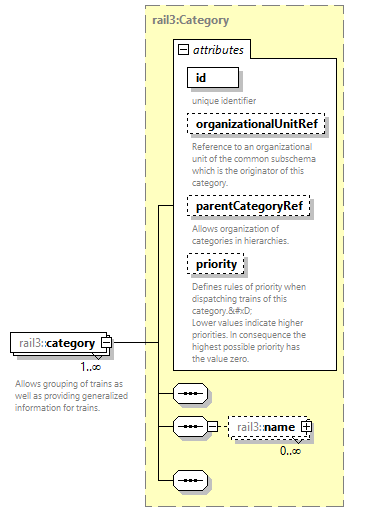 | ||||||||||||||||||||||||||||||||||||||
| namespace | https://www.railml.org/schemas/3.2 | ||||||||||||||||||||||||||||||||||||||
| type | rail3:Category | ||||||||||||||||||||||||||||||||||||||
| properties |
| ||||||||||||||||||||||||||||||||||||||
| children | rail3:name | ||||||||||||||||||||||||||||||||||||||
| attributes |
| ||||||||||||||||||||||||||||||||||||||
| annotation |
| ||||||||||||||||||||||||||||||||||||||
| source | <xs:element name="category" type="rail3:Category" minOccurs="1" maxOccurs="unbounded"> <xs:annotation> <xs:documentation>Allows grouping of trains as well as providing generalized information for trains.</xs:documentation> </xs:annotation> </xs:element> |
complexType Category
| diagram | 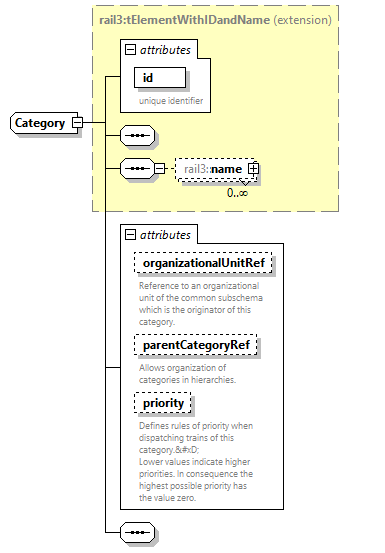 | ||||||||||||||||||||||||||||||||||||||
| namespace | https://www.railml.org/schemas/3.2 | ||||||||||||||||||||||||||||||||||||||
| type | extension of rail3:tElementWithIDandName | ||||||||||||||||||||||||||||||||||||||
| properties |
| ||||||||||||||||||||||||||||||||||||||
| children | rail3:name | ||||||||||||||||||||||||||||||||||||||
| used by |
| ||||||||||||||||||||||||||||||||||||||
| attributes |
| ||||||||||||||||||||||||||||||||||||||
| source | <xs:complexType name="Category"> <xs:complexContent> <xs:extension base="rail3:tElementWithIDandName"> <xs:sequence/> <xs:attribute name="organizationalUnitRef" type="rail3:tRef" use="optional"> <xs:annotation> <xs:documentation>Reference to an organizational unit of the common subschema which is the originator of this category.</xs:documentation> </xs:annotation> </xs:attribute> <xs:attribute name="parentCategoryRef" type="rail3:tRef" use="optional"> <xs:annotation> <xs:documentation>Allows organization of categories in hierarchies.</xs:documentation> </xs:annotation> </xs:attribute> <xs:attribute name="priority" type="rail3:tPriority" use="optional"> <xs:annotation> <xs:documentation>Defines rules of priority when dispatching trains of this category.
 Lower values indicate higher priorities. In consequence the highest possible priority has the value zero.</xs:documentation> </xs:annotation> </xs:attribute> </xs:extension> </xs:complexContent> </xs:complexType> |
attribute Category/@organizationalUnitRef
| type | rail3:tRef | ||
| properties |
| ||
| annotation |
| ||
| source | <xs:attribute name="organizationalUnitRef" type="rail3:tRef" use="optional"> <xs:annotation> <xs:documentation>Reference to an organizational unit of the common subschema which is the originator of this category.</xs:documentation> </xs:annotation> </xs:attribute> |
attribute Category/@parentCategoryRef
| type | rail3:tRef | ||
| properties |
| ||
| annotation |
| ||
| source | <xs:attribute name="parentCategoryRef" type="rail3:tRef" use="optional"> <xs:annotation> <xs:documentation>Allows organization of categories in hierarchies.</xs:documentation> </xs:annotation> </xs:attribute> |
attribute Category/@priority
| type | rail3:tPriority | ||
| properties |
| ||
| annotation |
| ||
| source | <xs:attribute name="priority" type="rail3:tPriority" use="optional"> <xs:annotation> <xs:documentation>Defines rules of priority when dispatching trains of this category.
 Lower values indicate higher priorities. In consequence the highest possible priority has the value zero.</xs:documentation> </xs:annotation> </xs:attribute> |
complexType CategoryRef
| diagram | 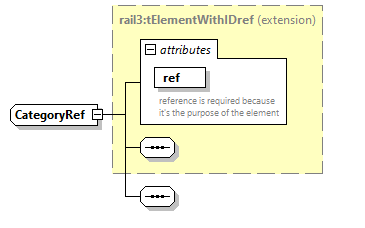 | ||||||||||||||
| namespace | https://www.railml.org/schemas/3.2 | ||||||||||||||
| type | extension of rail3:tElementWithIDref | ||||||||||||||
| properties |
| ||||||||||||||
| used by |
| ||||||||||||||
| attributes |
| ||||||||||||||
| source | <xs:complexType name="CategoryRef"> <xs:complexContent> <xs:extension base="rail3:tElementWithIDref"> <xs:sequence/> </xs:extension> </xs:complexContent> </xs:complexType> |
complexType CategoryRefs
| diagram |  | ||
| namespace | https://www.railml.org/schemas/3.2 | ||
| children | rail3:categoryRef | ||
| used by |
| ||
| source | <xs:complexType name="CategoryRefs"> <xs:sequence> <xs:element name="categoryRef" type="rail3:CategoryRef" minOccurs="1" maxOccurs="unbounded"> <xs:annotation> <xs:documentation>Allows specification of a category reference.</xs:documentation> </xs:annotation> </xs:element> </xs:sequence> </xs:complexType> |
element CategoryRefs/categoryRef
| diagram | 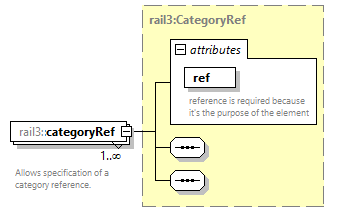 | ||||||||||||||
| namespace | https://www.railml.org/schemas/3.2 | ||||||||||||||
| type | rail3:CategoryRef | ||||||||||||||
| properties |
| ||||||||||||||
| attributes |
| ||||||||||||||
| annotation |
| ||||||||||||||
| source | <xs:element name="categoryRef" type="rail3:CategoryRef" minOccurs="1" maxOccurs="unbounded"> <xs:annotation> <xs:documentation>Allows specification of a category reference.</xs:documentation> </xs:annotation> </xs:element> |
complexType Commercial
| diagram | 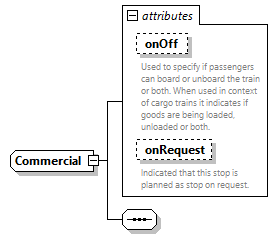 | ||||||||||||||||||||||
| namespace | https://www.railml.org/schemas/3.2 | ||||||||||||||||||||||
| used by |
| ||||||||||||||||||||||
| attributes |
| ||||||||||||||||||||||
| source | <xs:complexType name="Commercial"> <xs:sequence/> <xs:attribute name="onOff" type="rail3:OnOff" use="optional" default="both"> <xs:annotation> <xs:documentation>Used to specify if passengers can board or unboard the train or both. When used in context of cargo trains it indicates if goods are being loaded, unloaded or both.</xs:documentation> </xs:annotation> </xs:attribute> <xs:attribute name="onRequest" type="xs:boolean" use="optional" default="false"> <xs:annotation> <xs:documentation>Indicated that this stop is planned as stop on request.</xs:documentation> </xs:annotation> </xs:attribute> </xs:complexType> |
attribute Commercial/@onOff
| type | rail3:OnOff | ||||||||||||||||||
| properties |
| ||||||||||||||||||
| facets |
| ||||||||||||||||||
| annotation |
| ||||||||||||||||||
| source | <xs:attribute name="onOff" type="rail3:OnOff" use="optional" default="both"> <xs:annotation> <xs:documentation>Used to specify if passengers can board or unboard the train or both. When used in context of cargo trains it indicates if goods are being loaded, unloaded or both.</xs:documentation> </xs:annotation> </xs:attribute> |
attribute Commercial/@onRequest
| type | xs:boolean | ||||
| properties |
| ||||
| annotation |
| ||||
| source | <xs:attribute name="onRequest" type="xs:boolean" use="optional" default="false"> <xs:annotation> <xs:documentation>Indicated that this stop is planned as stop on request.</xs:documentation> </xs:annotation> </xs:attribute> |
complexType CommercialConnection
| diagram | 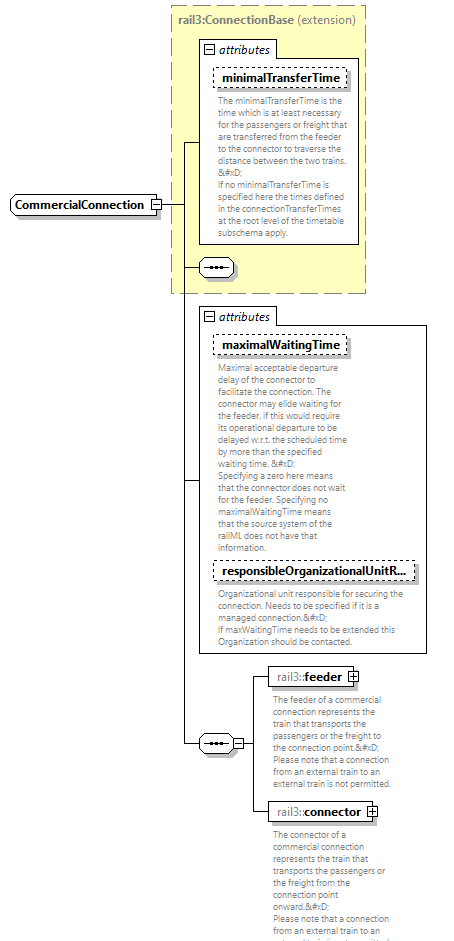 | ||||||||||||||||||||||||||||||
| namespace | https://www.railml.org/schemas/3.2 | ||||||||||||||||||||||||||||||
| type | extension of rail3:ConnectionBase | ||||||||||||||||||||||||||||||
| properties |
| ||||||||||||||||||||||||||||||
| children | rail3:feeder rail3:connector | ||||||||||||||||||||||||||||||
| used by |
| ||||||||||||||||||||||||||||||
| attributes |
| ||||||||||||||||||||||||||||||
| source | <xs:complexType name="CommercialConnection"> <xs:complexContent> <xs:extension base="rail3:ConnectionBase"> <xs:sequence> <xs:element name="feeder" type="rail3:CommercialConnectionFeeder" minOccurs="1" maxOccurs="1"> <xs:annotation> <xs:documentation>The feeder of a commercial connection represents the train that transports the passengers or the freight to the connection point.
 Please note that a connection from an external train to an external train is not permitted.</xs:documentation> </xs:annotation> </xs:element> <xs:element name="connector" type="rail3:CommercialConnectionConnector" minOccurs="1" maxOccurs="1"> <xs:annotation> <xs:documentation>The connector of a commercial connection represents the train that transports the passengers or the freight from the connection point onward.
 Please note that a connection from an external train to an external train is not permitted.</xs:documentation> </xs:annotation> </xs:element> </xs:sequence> <xs:attribute name="maximalWaitingTime" type="xs:duration" use="optional"> <xs:annotation> <xs:documentation>Maximal acceptable departure delay of the connector to facilitate the connection. The connector may elide waiting for the feeder, if this would require its operational departure to be delayed w.r.t. the scheduled time by more than the specified waiting time. 
 Specifying a zero here means that the connector does not wait for the feeder. Specifying no maximalWaitingTime means that the source system of the railML does not have that information.</xs:documentation> </xs:annotation> </xs:attribute> <xs:attribute name="responsibleOrganizationalUnitRef" type="rail3:tRef" use="optional"> <xs:annotation> <xs:documentation>Organizational unit responsible for securing the connection. Needs to be specified if it is a managed connection.
 If maxWaitingTime needs to be extended this Organization should be contacted.</xs:documentation> </xs:annotation> </xs:attribute> </xs:extension> </xs:complexContent> </xs:complexType> |
attribute CommercialConnection/@maximalWaitingTime
| type | xs:duration | ||
| properties |
| ||
| annotation |
| ||
| source | <xs:attribute name="maximalWaitingTime" type="xs:duration" use="optional"> <xs:annotation> <xs:documentation>Maximal acceptable departure delay of the connector to facilitate the connection. The connector may elide waiting for the feeder, if this would require its operational departure to be delayed w.r.t. the scheduled time by more than the specified waiting time. 
 Specifying a zero here means that the connector does not wait for the feeder. Specifying no maximalWaitingTime means that the source system of the railML does not have that information.</xs:documentation> </xs:annotation> </xs:attribute> |
attribute CommercialConnection/@responsibleOrganizationalUnitRef
| type | rail3:tRef | ||
| properties |
| ||
| annotation |
| ||
| source | <xs:attribute name="responsibleOrganizationalUnitRef" type="rail3:tRef" use="optional"> <xs:annotation> <xs:documentation>Organizational unit responsible for securing the connection. Needs to be specified if it is a managed connection.
 If maxWaitingTime needs to be extended this Organization should be contacted.</xs:documentation> </xs:annotation> </xs:attribute> |
element CommercialConnection/feeder
| diagram | 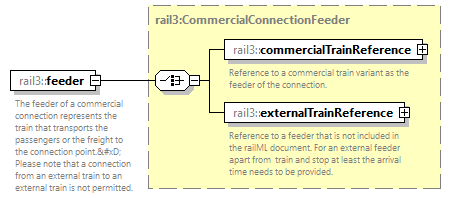 | ||
| namespace | https://www.railml.org/schemas/3.2 | ||
| type | rail3:CommercialConnectionFeeder | ||
| properties |
| ||
| children | rail3:commercialTrainReference rail3:externalTrainReference | ||
| annotation |
| ||
| source | <xs:element name="feeder" type="rail3:CommercialConnectionFeeder" minOccurs="1" maxOccurs="1"> <xs:annotation> <xs:documentation>The feeder of a commercial connection represents the train that transports the passengers or the freight to the connection point.
 Please note that a connection from an external train to an external train is not permitted.</xs:documentation> </xs:annotation> </xs:element> |
element CommercialConnection/connector
| diagram | 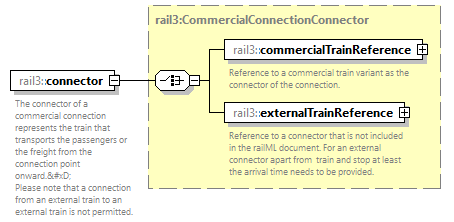 | ||
| namespace | https://www.railml.org/schemas/3.2 | ||
| type | rail3:CommercialConnectionConnector | ||
| properties |
| ||
| children | rail3:commercialTrainReference rail3:externalTrainReference | ||
| annotation |
| ||
| source | <xs:element name="connector" type="rail3:CommercialConnectionConnector" minOccurs="1" maxOccurs="1"> <xs:annotation> <xs:documentation>The connector of a commercial connection represents the train that transports the passengers or the freight from the connection point onward.
 Please note that a connection from an external train to an external train is not permitted.</xs:documentation> </xs:annotation> </xs:element> |
complexType CommercialConnectionConnector
| diagram |  | ||
| namespace | https://www.railml.org/schemas/3.2 | ||
| children | rail3:commercialTrainReference rail3:externalTrainReference | ||
| used by |
| ||
| source | <xs:complexType name="CommercialConnectionConnector"> <xs:choice> <xs:element name="commercialTrainReference" type="rail3:CommercialTrainVariantReference" minOccurs="1" maxOccurs="1"> <xs:annotation> <xs:documentation>Reference to a commercial train variant as the connector of the connection.</xs:documentation> </xs:annotation> </xs:element> <xs:element name="externalTrainReference" type="rail3:ExternalTrainReference" minOccurs="1" maxOccurs="1"> <xs:annotation> <xs:documentation>Reference to a connector that is not included in the railML document. For an external connector apart from train and stop at least the arrival time needs to be provided.</xs:documentation> </xs:annotation> </xs:element> </xs:choice> </xs:complexType> |
element CommercialConnectionConnector/commercialTrainReference
| diagram | 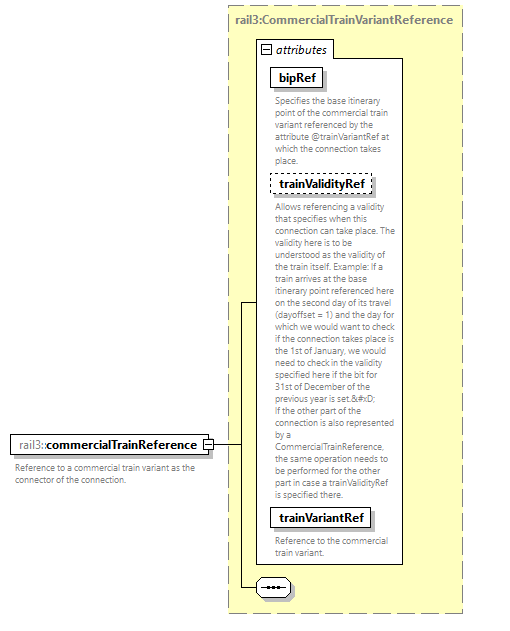 | ||||||||||||||||||||||||||||||
| namespace | https://www.railml.org/schemas/3.2 | ||||||||||||||||||||||||||||||
| type | rail3:CommercialTrainVariantReference | ||||||||||||||||||||||||||||||
| properties |
| ||||||||||||||||||||||||||||||
| attributes |
| ||||||||||||||||||||||||||||||
| annotation |
| ||||||||||||||||||||||||||||||
| source | <xs:element name="commercialTrainReference" type="rail3:CommercialTrainVariantReference" minOccurs="1" maxOccurs="1"> <xs:annotation> <xs:documentation>Reference to a commercial train variant as the connector of the connection.</xs:documentation> </xs:annotation> </xs:element> |
element CommercialConnectionConnector/externalTrainReference
| diagram | 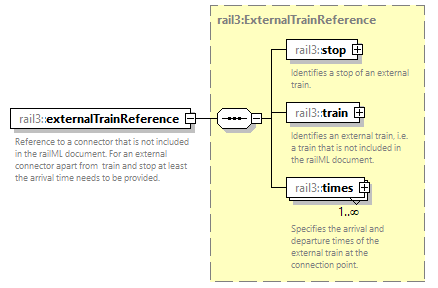 | ||
| namespace | https://www.railml.org/schemas/3.2 | ||
| type | rail3:ExternalTrainReference | ||
| properties |
| ||
| children | rail3:stop rail3:train rail3:times | ||
| annotation |
| ||
| source | <xs:element name="externalTrainReference" type="rail3:ExternalTrainReference" minOccurs="1" maxOccurs="1"> <xs:annotation> <xs:documentation>Reference to a connector that is not included in the railML document. For an external connector apart from train and stop at least the arrival time needs to be provided.</xs:documentation> </xs:annotation> </xs:element> |
complexType CommercialConnectionFeeder
| diagram |  | ||
| namespace | https://www.railml.org/schemas/3.2 | ||
| children | rail3:commercialTrainReference rail3:externalTrainReference | ||
| used by |
| ||
| source | <xs:complexType name="CommercialConnectionFeeder"> <xs:choice> <xs:element name="commercialTrainReference" type="rail3:CommercialTrainVariantReference" minOccurs="1" maxOccurs="1"> <xs:annotation> <xs:documentation>Reference to a commercial train variant as the feeder of the connection.</xs:documentation> </xs:annotation> </xs:element> <xs:element name="externalTrainReference" type="rail3:ExternalTrainReference" minOccurs="1" maxOccurs="1"> <xs:annotation> <xs:documentation>Reference to a feeder that is not included in the railML document. For an external feeder apart from train and stop at least the arrival time needs to be provided.</xs:documentation> </xs:annotation> </xs:element> </xs:choice> </xs:complexType> |
element CommercialConnectionFeeder/commercialTrainReference
| diagram | 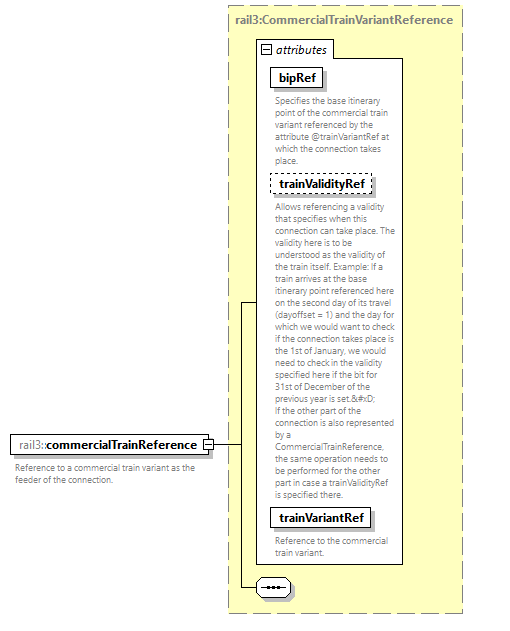 | ||||||||||||||||||||||||||||||
| namespace | https://www.railml.org/schemas/3.2 | ||||||||||||||||||||||||||||||
| type | rail3:CommercialTrainVariantReference | ||||||||||||||||||||||||||||||
| properties |
| ||||||||||||||||||||||||||||||
| attributes |
| ||||||||||||||||||||||||||||||
| annotation |
| ||||||||||||||||||||||||||||||
| source | <xs:element name="commercialTrainReference" type="rail3:CommercialTrainVariantReference" minOccurs="1" maxOccurs="1"> <xs:annotation> <xs:documentation>Reference to a commercial train variant as the feeder of the connection.</xs:documentation> </xs:annotation> </xs:element> |
element CommercialConnectionFeeder/externalTrainReference
| diagram | 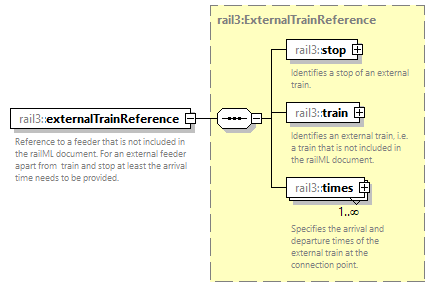 | ||
| namespace | https://www.railml.org/schemas/3.2 | ||
| type | rail3:ExternalTrainReference | ||
| properties |
| ||
| children | rail3:stop rail3:train rail3:times | ||
| annotation |
| ||
| source | <xs:element name="externalTrainReference" type="rail3:ExternalTrainReference" minOccurs="1" maxOccurs="1"> <xs:annotation> <xs:documentation>Reference to a feeder that is not included in the railML document. For an external feeder apart from train and stop at least the arrival time needs to be provided.</xs:documentation> </xs:annotation> </xs:element> |
complexType CommercialConnections
| diagram |  | ||
| namespace | https://www.railml.org/schemas/3.2 | ||
| children | rail3:commercialConnection | ||
| used by |
| ||
| source | <xs:complexType name="CommercialConnections"> <xs:sequence> <xs:element name="commercialConnection" type="rail3:CommercialConnection" minOccurs="1" maxOccurs="unbounded"> <xs:annotation> <xs:documentation>Commercial connections describe a unidirectional relationship between trains that can be used by passengers or goods to transfer from one train to another.</xs:documentation> </xs:annotation> </xs:element> </xs:sequence> </xs:complexType> |
element CommercialConnections/commercialConnection
| diagram | 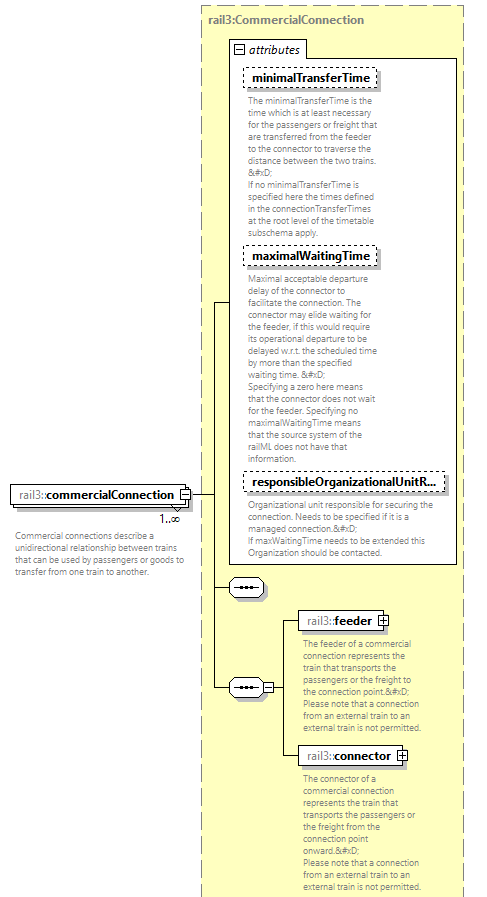 | ||||||||||||||||||||||||||||||
| namespace | https://www.railml.org/schemas/3.2 | ||||||||||||||||||||||||||||||
| type | rail3:CommercialConnection | ||||||||||||||||||||||||||||||
| properties |
| ||||||||||||||||||||||||||||||
| children | rail3:feeder rail3:connector | ||||||||||||||||||||||||||||||
| attributes |
| ||||||||||||||||||||||||||||||
| annotation |
| ||||||||||||||||||||||||||||||
| source | <xs:element name="commercialConnection" type="rail3:CommercialConnection" minOccurs="1" maxOccurs="unbounded"> <xs:annotation> <xs:documentation>Commercial connections describe a unidirectional relationship between trains that can be used by passengers or goods to transfer from one train to another.</xs:documentation> </xs:annotation> </xs:element> |
complexType CommercialScheduling
| diagram | 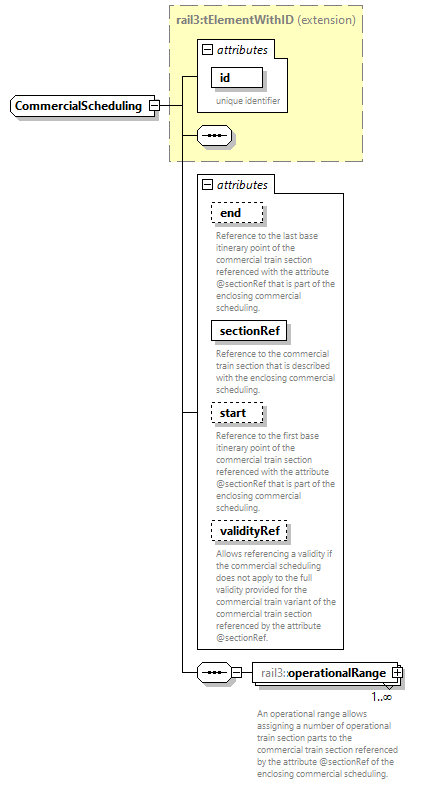 | ||||||||||||||||||||||||||||||||||||||||||||||
| namespace | https://www.railml.org/schemas/3.2 | ||||||||||||||||||||||||||||||||||||||||||||||
| type | extension of rail3:tElementWithID | ||||||||||||||||||||||||||||||||||||||||||||||
| properties |
| ||||||||||||||||||||||||||||||||||||||||||||||
| children | rail3:operationalRange | ||||||||||||||||||||||||||||||||||||||||||||||
| used by |
| ||||||||||||||||||||||||||||||||||||||||||||||
| attributes |
| ||||||||||||||||||||||||||||||||||||||||||||||
| source | <xs:complexType name="CommercialScheduling"> <xs:complexContent> <xs:extension base="rail3:tElementWithID"> <xs:sequence> <xs:element name="operationalRange" type="rail3:OperationalRange" minOccurs="1" maxOccurs="unbounded"> <xs:annotation> <xs:documentation>An operational range allows assigning a number of operational train section parts to the commercial train section referenced by the attribute @sectionRef of the enclosing commercial scheduling.</xs:documentation> </xs:annotation> </xs:element> </xs:sequence> <xs:attribute name="end" type="rail3:tRef" use="optional"> <xs:annotation> <xs:documentation>Reference to the last base itinerary point of the commercial train section referenced with the attribute @sectionRef that is part of the enclosing commercial scheduling.</xs:documentation> </xs:annotation> </xs:attribute> <xs:attribute name="sectionRef" type="rail3:tRef" use="required"> <xs:annotation> <xs:documentation>Reference to the commercial train section that is described with the enclosing commercial scheduling.</xs:documentation> </xs:annotation> </xs:attribute> <xs:attribute name="start" type="rail3:tRef" use="optional"> <xs:annotation> <xs:documentation>Reference to the first base itinerary point of the commercial train section referenced with the attribute @sectionRef that is part of the enclosing commercial scheduling.</xs:documentation> </xs:annotation> </xs:attribute> <xs:attribute name="validityRef" type="rail3:tRef" use="optional"> <xs:annotation> <xs:documentation>Allows referencing a validity if the commercial scheduling does not apply to the full validity provided for the commercial train variant of the commercial train section referenced by the attribute @sectionRef.</xs:documentation> </xs:annotation> </xs:attribute> </xs:extension> </xs:complexContent> </xs:complexType> |
attribute CommercialScheduling/@end
| type | rail3:tRef | ||
| properties |
| ||
| annotation |
| ||
| source | <xs:attribute name="end" type="rail3:tRef" use="optional"> <xs:annotation> <xs:documentation>Reference to the last base itinerary point of the commercial train section referenced with the attribute @sectionRef that is part of the enclosing commercial scheduling.</xs:documentation> </xs:annotation> </xs:attribute> |
attribute CommercialScheduling/@sectionRef
| type | rail3:tRef | ||
| properties |
| ||
| annotation |
| ||
| source | <xs:attribute name="sectionRef" type="rail3:tRef" use="required"> <xs:annotation> <xs:documentation>Reference to the commercial train section that is described with the enclosing commercial scheduling.</xs:documentation> </xs:annotation> </xs:attribute> |
attribute CommercialScheduling/@start
| type | rail3:tRef | ||
| properties |
| ||
| annotation |
| ||
| source | <xs:attribute name="start" type="rail3:tRef" use="optional"> <xs:annotation> <xs:documentation>Reference to the first base itinerary point of the commercial train section referenced with the attribute @sectionRef that is part of the enclosing commercial scheduling.</xs:documentation> </xs:annotation> </xs:attribute> |
attribute CommercialScheduling/@validityRef
| type | rail3:tRef | ||
| properties |
| ||
| annotation |
| ||
| source | <xs:attribute name="validityRef" type="rail3:tRef" use="optional"> <xs:annotation> <xs:documentation>Allows referencing a validity if the commercial scheduling does not apply to the full validity provided for the commercial train variant of the commercial train section referenced by the attribute @sectionRef.</xs:documentation> </xs:annotation> </xs:attribute> |
element CommercialScheduling/operationalRange
| diagram | 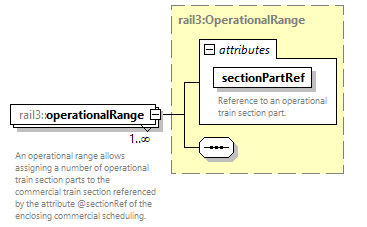 | ||||||||||||||
| namespace | https://www.railml.org/schemas/3.2 | ||||||||||||||
| type | rail3:OperationalRange | ||||||||||||||
| properties |
| ||||||||||||||
| attributes |
| ||||||||||||||
| annotation |
| ||||||||||||||
| source | <xs:element name="operationalRange" type="rail3:OperationalRange" minOccurs="1" maxOccurs="unbounded"> <xs:annotation> <xs:documentation>An operational range allows assigning a number of operational train section parts to the commercial train section referenced by the attribute @sectionRef of the enclosing commercial scheduling.</xs:documentation> </xs:annotation> </xs:element> |
complexType CommercialSchedulings
| diagram |  | ||
| namespace | https://www.railml.org/schemas/3.2 | ||
| children | rail3:commercialScheduling | ||
| used by |
| ||
| source | <xs:complexType name="CommercialSchedulings"> <xs:sequence> <xs:element name="commercialScheduling" type="rail3:CommercialScheduling" minOccurs="1" maxOccurs="unbounded"> <xs:annotation> <xs:documentation>A commercial scheduling maps an operational train or parts of it to a commercial train or parts of it. The sum of all commercial schedulings encodes which operational trains are used to provide the services described with the commercial trains.</xs:documentation> </xs:annotation> </xs:element> </xs:sequence> </xs:complexType> |
element CommercialSchedulings/commercialScheduling
| diagram | 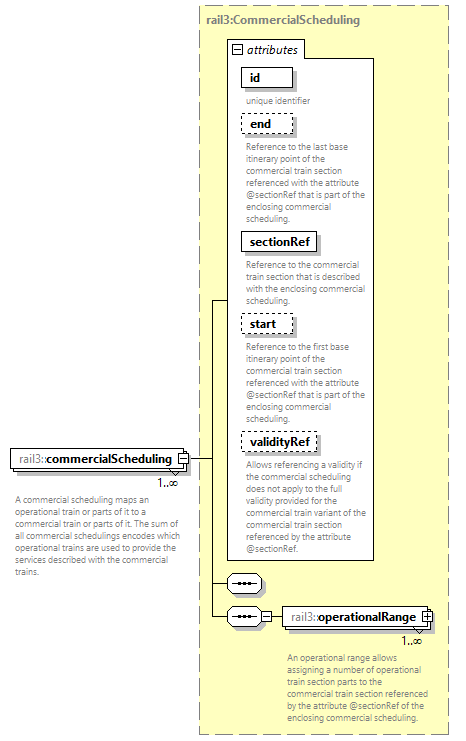 | ||||||||||||||||||||||||||||||||||||||||||||||
| namespace | https://www.railml.org/schemas/3.2 | ||||||||||||||||||||||||||||||||||||||||||||||
| type | rail3:CommercialScheduling | ||||||||||||||||||||||||||||||||||||||||||||||
| properties |
| ||||||||||||||||||||||||||||||||||||||||||||||
| children | rail3:operationalRange | ||||||||||||||||||||||||||||||||||||||||||||||
| attributes |
| ||||||||||||||||||||||||||||||||||||||||||||||
| annotation |
| ||||||||||||||||||||||||||||||||||||||||||||||
| source | <xs:element name="commercialScheduling" type="rail3:CommercialScheduling" minOccurs="1" maxOccurs="unbounded"> <xs:annotation> <xs:documentation>A commercial scheduling maps an operational train or parts of it to a commercial train or parts of it. The sum of all commercial schedulings encodes which operational trains are used to provide the services described with the commercial trains.</xs:documentation> </xs:annotation> </xs:element> |
complexType CommercialTrain
| diagram | 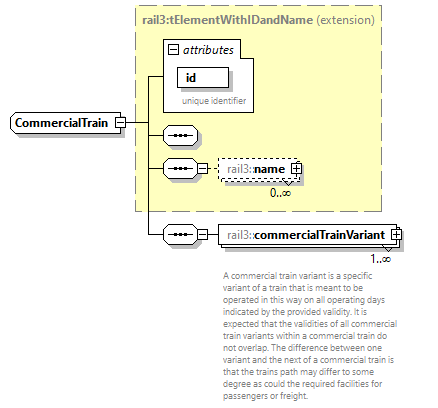 | ||||||||||||||
| namespace | https://www.railml.org/schemas/3.2 | ||||||||||||||
| type | extension of rail3:tElementWithIDandName | ||||||||||||||
| properties |
| ||||||||||||||
| children | rail3:name rail3:commercialTrainVariant | ||||||||||||||
| used by |
| ||||||||||||||
| attributes |
| ||||||||||||||
| source | <xs:complexType name="CommercialTrain"> <xs:complexContent> <xs:extension base="rail3:tElementWithIDandName"> <xs:sequence> <xs:element name="commercialTrainVariant" type="rail3:CommercialTrainVariant" minOccurs="1" maxOccurs="unbounded"> <xs:annotation> <xs:documentation>A commercial train variant is a specific variant of a train that is meant to be operated in this way on all operating days indicated by the provided validity. It is expected that the validities of all commercial train variants within a commercial train do not overlap. The difference between one variant and the next of a commercial train is that the trains path may differ to some degree as could the required facilities for passengers or freight.</xs:documentation> </xs:annotation> </xs:element> </xs:sequence> </xs:extension> </xs:complexContent> </xs:complexType> |
element CommercialTrain/commercialTrainVariant
| diagram | 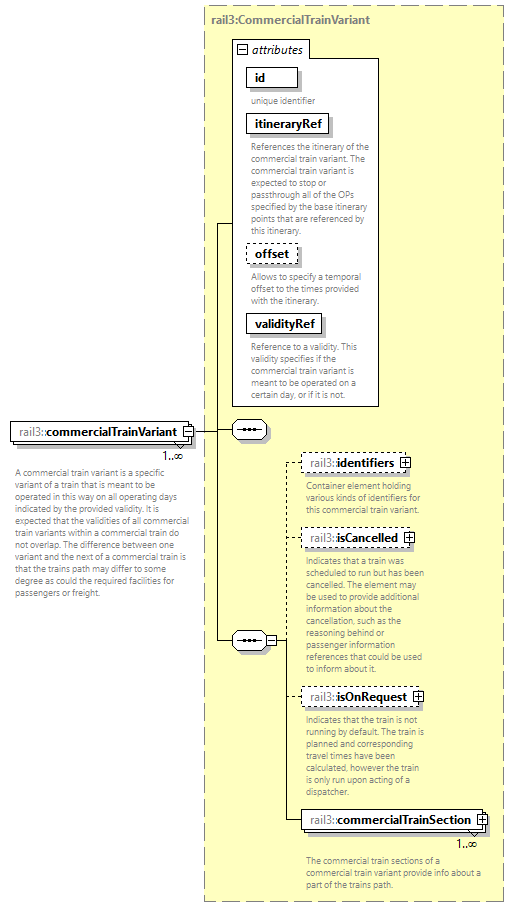 | ||||||||||||||||||||||||||||||||||||||
| namespace | https://www.railml.org/schemas/3.2 | ||||||||||||||||||||||||||||||||||||||
| type | rail3:CommercialTrainVariant | ||||||||||||||||||||||||||||||||||||||
| properties |
| ||||||||||||||||||||||||||||||||||||||
| children | rail3:identifiers rail3:isCancelled rail3:isOnRequest rail3:commercialTrainSection | ||||||||||||||||||||||||||||||||||||||
| attributes |
| ||||||||||||||||||||||||||||||||||||||
| annotation |
| ||||||||||||||||||||||||||||||||||||||
| source | <xs:element name="commercialTrainVariant" type="rail3:CommercialTrainVariant" minOccurs="1" maxOccurs="unbounded"> <xs:annotation> <xs:documentation>A commercial train variant is a specific variant of a train that is meant to be operated in this way on all operating days indicated by the provided validity. It is expected that the validities of all commercial train variants within a commercial train do not overlap. The difference between one variant and the next of a commercial train is that the trains path may differ to some degree as could the required facilities for passengers or freight.</xs:documentation> </xs:annotation> </xs:element> |
complexType CommercialTrains
| diagram | 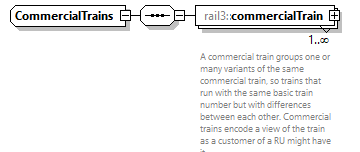 | ||
| namespace | https://www.railml.org/schemas/3.2 | ||
| children | rail3:commercialTrain | ||
| used by |
| ||
| source | <xs:complexType name="CommercialTrains"> <xs:sequence> <xs:element name="commercialTrain" type="rail3:CommercialTrain" minOccurs="1" maxOccurs="unbounded"> <xs:annotation> <xs:documentation>A commercial train groups one or many variants of the same commercial train, so trains that run with the same basic train number but with differences between each other. Commercial trains encode a view of the train as a customer of a RU might have it.</xs:documentation> </xs:annotation> </xs:element> </xs:sequence> </xs:complexType> |
element CommercialTrains/commercialTrain
| diagram | 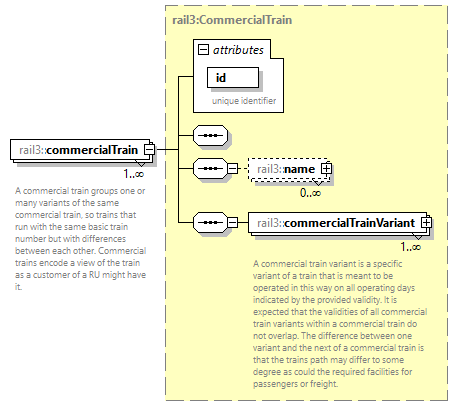 | ||||||||||||||
| namespace | https://www.railml.org/schemas/3.2 | ||||||||||||||
| type | rail3:CommercialTrain | ||||||||||||||
| properties |
| ||||||||||||||
| children | rail3:name rail3:commercialTrainVariant | ||||||||||||||
| attributes |
| ||||||||||||||
| annotation |
| ||||||||||||||
| source | <xs:element name="commercialTrain" type="rail3:CommercialTrain" minOccurs="1" maxOccurs="unbounded"> <xs:annotation> <xs:documentation>A commercial train groups one or many variants of the same commercial train, so trains that run with the same basic train number but with differences between each other. Commercial trains encode a view of the train as a customer of a RU might have it.</xs:documentation> </xs:annotation> </xs:element> |
complexType CommercialTrainSection
| diagram |  | ||||||||||||||||||||||||||||||||||||||||||||||
| namespace | https://www.railml.org/schemas/3.2 | ||||||||||||||||||||||||||||||||||||||||||||||
| type | extension of rail3:tElementWithID | ||||||||||||||||||||||||||||||||||||||||||||||
| properties |
| ||||||||||||||||||||||||||||||||||||||||||||||
| children | rail3:range rail3:isCancelled rail3:isOnRequest rail3:transportServiceRef rail3:categoryRefs rail3:additionalStopInfos rail3:passengerFacilities rail3:freightFacilities | ||||||||||||||||||||||||||||||||||||||||||||||
| used by |
| ||||||||||||||||||||||||||||||||||||||||||||||
| attributes |
| ||||||||||||||||||||||||||||||||||||||||||||||
| source | <xs:complexType name="CommercialTrainSection"> <xs:complexContent> <xs:extension base="rail3:tElementWithID"> <xs:sequence> <xs:element name="range" type="rail3:Range" minOccurs="0" maxOccurs="1"> <xs:annotation> <xs:documentation>Allows specification of a range in order to split the commercial train variant along its path. If not provided it means that the commercial train section spans the whole path of the train.</xs:documentation> </xs:annotation> </xs:element> <xs:element name="isCancelled" type="rail3:CancellationInfo" minOccurs="0" maxOccurs="1"> <xs:annotation> <xs:documentation>Indicates that a train was scheduled to run but has been cancelled. The element may be used to provide additional information about the cancellation, such as the reasoning behind or passenger information references that could be used to inform about it.</xs:documentation> </xs:annotation> </xs:element> <xs:element name="isOnRequest" type="rail3:IsOnRequest" minOccurs="0" maxOccurs="1"> <xs:annotation> <xs:documentation>Indicates that the train is not running by default. The train is planned and corresponding travel times have been calculated, however the train is only run upon acting of a dispatcher.</xs:documentation> </xs:annotation> </xs:element> <xs:element name="transportServiceRef" type="rail3:TransportServiceReference" minOccurs="0" maxOccurs="1"> <xs:annotation> <xs:documentation>Allows referencing a transport service as defined in the root of the timetable sub tree. A transport service groups a number of trains that provide transport on a line of stops. A typical example would be a commuter service known under a specific name (red line in Thailand, S1 in Berlin)
 The transport service reference that can be specified here allows specification of the direction of travel along the line of stops, as well as a textual description of the origin and destination.</xs:documentation> </xs:annotation> </xs:element> <xs:element name="categoryRefs" type="rail3:CategoryRefs" minOccurs="0" maxOccurs="1"> <xs:annotation> <xs:documentation>The categories apply to a section of a commercialTrain. This set of references can be used, for example, to define categories intended for passenger information.</xs:documentation> </xs:annotation> </xs:element> <xs:element name="additionalStopInfos" type="rail3:AdditionalStopInfos" minOccurs="0" maxOccurs="1"> <xs:annotation> <xs:documentation>Allows specifying additional stop infos for any stop of the enclosing section.</xs:documentation> </xs:annotation> </xs:element> <xs:element name="passengerFacilities" type="rail3:PassengerFacilities" minOccurs="0" maxOccurs="1"> <xs:annotation> <xs:documentation>Allows to specify the required facilities for passengers.</xs:documentation> </xs:annotation> </xs:element> <xs:element name="freightFacilities" type="rail3:FreightFacilities" minOccurs="0" maxOccurs="1"> <xs:annotation> <xs:documentation>Allows to specify required facilities for freight transport.</xs:documentation> </xs:annotation> </xs:element> </xs:sequence> <xs:attribute name="ordererRef" type="rail3:tRef" use="optional"> <xs:annotation> <xs:documentation>Reference to the organizational unit that ordered the train</xs:documentation> </xs:annotation> </xs:attribute> <xs:attributeGroup ref="rail3:TypeOfTrain"/> </xs:extension> </xs:complexContent> </xs:complexType> |
attribute CommercialTrainSection/@ordererRef
| type | rail3:tRef | ||
| properties |
| ||
| annotation |
| ||
| source | <xs:attribute name="ordererRef" type="rail3:tRef" use="optional"> <xs:annotation> <xs:documentation>Reference to the organizational unit that ordered the train</xs:documentation> </xs:annotation> </xs:attribute> |
element CommercialTrainSection/range
| diagram | 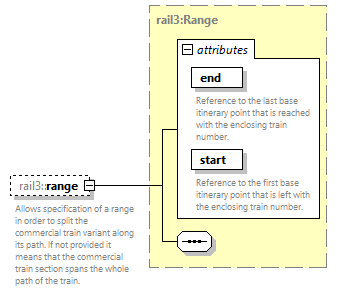 | ||||||||||||||||||||||
| namespace | https://www.railml.org/schemas/3.2 | ||||||||||||||||||||||
| type | rail3:Range | ||||||||||||||||||||||
| properties |
| ||||||||||||||||||||||
| attributes |
| ||||||||||||||||||||||
| annotation |
| ||||||||||||||||||||||
| source | <xs:element name="range" type="rail3:Range" minOccurs="0" maxOccurs="1"> <xs:annotation> <xs:documentation>Allows specification of a range in order to split the commercial train variant along its path. If not provided it means that the commercial train section spans the whole path of the train.</xs:documentation> </xs:annotation> </xs:element> |
element CommercialTrainSection/isCancelled
| diagram | 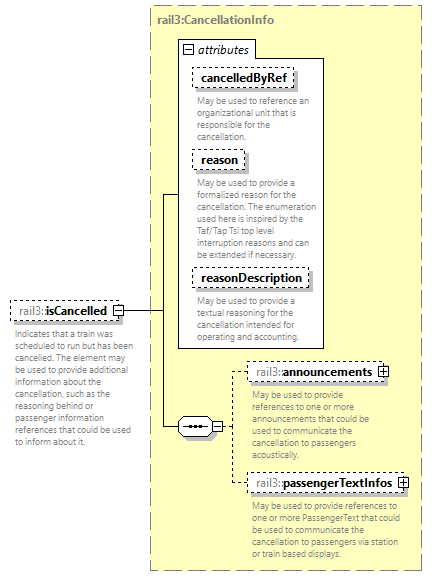 | ||||||||||||||||||||||||||||||
| namespace | https://www.railml.org/schemas/3.2 | ||||||||||||||||||||||||||||||
| type | rail3:CancellationInfo | ||||||||||||||||||||||||||||||
| properties |
| ||||||||||||||||||||||||||||||
| children | rail3:announcements rail3:passengerTextInfos | ||||||||||||||||||||||||||||||
| attributes |
| ||||||||||||||||||||||||||||||
| annotation |
| ||||||||||||||||||||||||||||||
| source | <xs:element name="isCancelled" type="rail3:CancellationInfo" minOccurs="0" maxOccurs="1"> <xs:annotation> <xs:documentation>Indicates that a train was scheduled to run but has been cancelled. The element may be used to provide additional information about the cancellation, such as the reasoning behind or passenger information references that could be used to inform about it.</xs:documentation> </xs:annotation> </xs:element> |
element CommercialTrainSection/isOnRequest
| diagram | 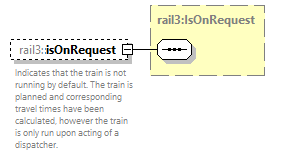 | ||||||
| namespace | https://www.railml.org/schemas/3.2 | ||||||
| type | rail3:IsOnRequest | ||||||
| properties |
| ||||||
| annotation |
| ||||||
| source | <xs:element name="isOnRequest" type="rail3:IsOnRequest" minOccurs="0" maxOccurs="1"> <xs:annotation> <xs:documentation>Indicates that the train is not running by default. The train is planned and corresponding travel times have been calculated, however the train is only run upon acting of a dispatcher.</xs:documentation> </xs:annotation> </xs:element> |
element CommercialTrainSection/transportServiceRef
| diagram | 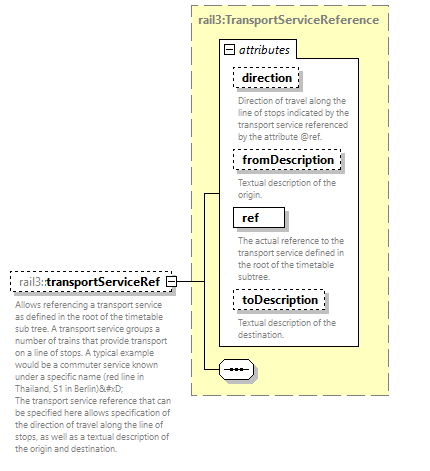 | ||||||||||||||||||||||||||||||||||||||
| namespace | https://www.railml.org/schemas/3.2 | ||||||||||||||||||||||||||||||||||||||
| type | rail3:TransportServiceReference | ||||||||||||||||||||||||||||||||||||||
| properties |
| ||||||||||||||||||||||||||||||||||||||
| attributes |
| ||||||||||||||||||||||||||||||||||||||
| annotation |
| ||||||||||||||||||||||||||||||||||||||
| source | <xs:element name="transportServiceRef" type="rail3:TransportServiceReference" minOccurs="0" maxOccurs="1"> <xs:annotation> <xs:documentation>Allows referencing a transport service as defined in the root of the timetable sub tree. A transport service groups a number of trains that provide transport on a line of stops. A typical example would be a commuter service known under a specific name (red line in Thailand, S1 in Berlin)
 The transport service reference that can be specified here allows specification of the direction of travel along the line of stops, as well as a textual description of the origin and destination.</xs:documentation> </xs:annotation> </xs:element> |
element CommercialTrainSection/categoryRefs
| diagram | 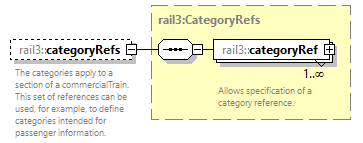 | ||||||
| namespace | https://www.railml.org/schemas/3.2 | ||||||
| type | rail3:CategoryRefs | ||||||
| properties |
| ||||||
| children | rail3:categoryRef | ||||||
| annotation |
| ||||||
| source | <xs:element name="categoryRefs" type="rail3:CategoryRefs" minOccurs="0" maxOccurs="1"> <xs:annotation> <xs:documentation>The categories apply to a section of a commercialTrain. This set of references can be used, for example, to define categories intended for passenger information.</xs:documentation> </xs:annotation> </xs:element> |
element CommercialTrainSection/additionalStopInfos
| diagram |  | ||||||
| namespace | https://www.railml.org/schemas/3.2 | ||||||
| type | rail3:AdditionalStopInfos | ||||||
| properties |
| ||||||
| children | rail3:additionalStopInfo | ||||||
| annotation |
| ||||||
| source | <xs:element name="additionalStopInfos" type="rail3:AdditionalStopInfos" minOccurs="0" maxOccurs="1"> <xs:annotation> <xs:documentation>Allows specifying additional stop infos for any stop of the enclosing section.</xs:documentation> </xs:annotation> </xs:element> |
element CommercialTrainSection/passengerFacilities
| diagram | 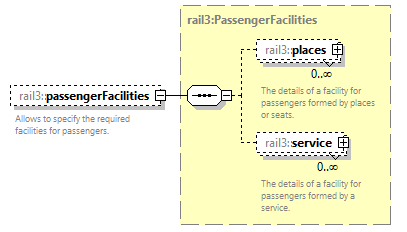 | ||||||
| namespace | https://www.railml.org/schemas/3.2 | ||||||
| type | rail3:PassengerFacilities | ||||||
| properties |
| ||||||
| children | rail3:places rail3:service | ||||||
| annotation |
| ||||||
| source | <xs:element name="passengerFacilities" type="rail3:PassengerFacilities" minOccurs="0" maxOccurs="1"> <xs:annotation> <xs:documentation>Allows to specify the required facilities for passengers.</xs:documentation> </xs:annotation> </xs:element> |
element CommercialTrainSection/freightFacilities
| diagram | 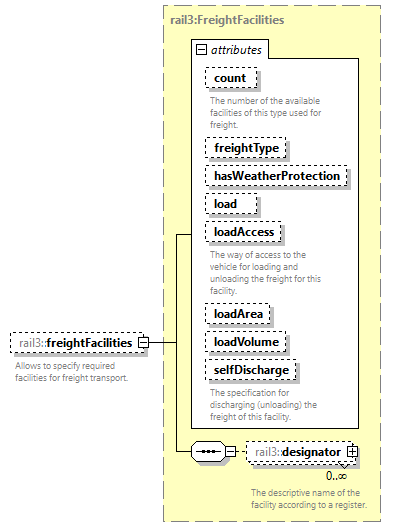 | ||||||||||||||||||||||||||||||||||||||||||||||||||||||||||||
| namespace | https://www.railml.org/schemas/3.2 | ||||||||||||||||||||||||||||||||||||||||||||||||||||||||||||
| type | rail3:FreightFacilities | ||||||||||||||||||||||||||||||||||||||||||||||||||||||||||||
| properties |
| ||||||||||||||||||||||||||||||||||||||||||||||||||||||||||||
| children | rail3:designator | ||||||||||||||||||||||||||||||||||||||||||||||||||||||||||||
| attributes |
| ||||||||||||||||||||||||||||||||||||||||||||||||||||||||||||
| annotation |
| ||||||||||||||||||||||||||||||||||||||||||||||||||||||||||||
| source | <xs:element name="freightFacilities" type="rail3:FreightFacilities" minOccurs="0" maxOccurs="1"> <xs:annotation> <xs:documentation>Allows to specify required facilities for freight transport.</xs:documentation> </xs:annotation> </xs:element> |
complexType CommercialTrainVariant
| diagram | 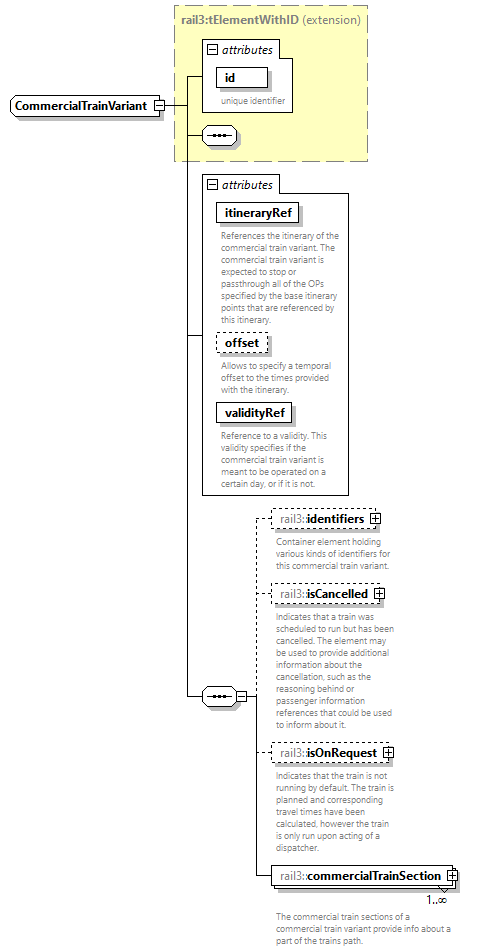 | ||||||||||||||||||||||||||||||||||||||
| namespace | https://www.railml.org/schemas/3.2 | ||||||||||||||||||||||||||||||||||||||
| type | extension of rail3:tElementWithID | ||||||||||||||||||||||||||||||||||||||
| properties |
| ||||||||||||||||||||||||||||||||||||||
| children | rail3:identifiers rail3:isCancelled rail3:isOnRequest rail3:commercialTrainSection | ||||||||||||||||||||||||||||||||||||||
| used by |
| ||||||||||||||||||||||||||||||||||||||
| attributes |
| ||||||||||||||||||||||||||||||||||||||
| source | <xs:complexType name="CommercialTrainVariant"> <xs:complexContent> <xs:extension base="rail3:tElementWithID"> <xs:sequence> <xs:element name="identifiers" type="rail3:Identifiers" minOccurs="0" maxOccurs="1"> <xs:annotation> <xs:documentation>Container element holding various kinds of identifiers for this commercial train variant.</xs:documentation> </xs:annotation> </xs:element> <xs:element name="isCancelled" type="rail3:CancellationInfo" minOccurs="0" maxOccurs="1"> <xs:annotation> <xs:documentation>Indicates that a train was scheduled to run but has been cancelled. The element may be used to provide additional information about the cancellation, such as the reasoning behind or passenger information references that could be used to inform about it.</xs:documentation> </xs:annotation> </xs:element> <xs:element name="isOnRequest" type="rail3:IsOnRequest" minOccurs="0" maxOccurs="1"> <xs:annotation> <xs:documentation>Indicates that the train is not running by default. The train is planned and corresponding travel times have been calculated, however the train is only run upon acting of a dispatcher.</xs:documentation> </xs:annotation> </xs:element> <xs:element name="commercialTrainSection" type="rail3:CommercialTrainSection" minOccurs="1" maxOccurs="unbounded"> <xs:annotation> <xs:documentation>The commercial train sections of a commercial train variant provide info about a part of the trains path.</xs:documentation> </xs:annotation> </xs:element> </xs:sequence> <xs:attribute name="itineraryRef" type="rail3:tRef" use="required"> <xs:annotation> <xs:documentation>References the itinerary of the commercial train variant. The commercial train variant is expected to stop or passthrough all of the OPs specified by the base itinerary points that are referenced by this itinerary.</xs:documentation> </xs:annotation> </xs:attribute> <xs:attribute name="offset" type="xs:duration" use="optional"> <xs:annotation> <xs:documentation>Allows to specify a temporal offset to the times provided with the itinerary.</xs:documentation> </xs:annotation> </xs:attribute> <xs:attribute name="validityRef" type="rail3:tRef" use="required"> <xs:annotation> <xs:documentation>Reference to a validity. This validity specifies if the commercial train variant is meant to be operated on a certain day, or if it is not.</xs:documentation> </xs:annotation> </xs:attribute> </xs:extension> </xs:complexContent> </xs:complexType> |
attribute CommercialTrainVariant/@itineraryRef
| type | rail3:tRef | ||
| properties |
| ||
| annotation |
| ||
| source | <xs:attribute name="itineraryRef" type="rail3:tRef" use="required"> <xs:annotation> <xs:documentation>References the itinerary of the commercial train variant. The commercial train variant is expected to stop or passthrough all of the OPs specified by the base itinerary points that are referenced by this itinerary.</xs:documentation> </xs:annotation> </xs:attribute> |
attribute CommercialTrainVariant/@offset
| type | xs:duration | ||
| properties |
| ||
| annotation |
| ||
| source | <xs:attribute name="offset" type="xs:duration" use="optional"> <xs:annotation> <xs:documentation>Allows to specify a temporal offset to the times provided with the itinerary.</xs:documentation> </xs:annotation> </xs:attribute> |
attribute CommercialTrainVariant/@validityRef
| type | rail3:tRef | ||
| properties |
| ||
| annotation |
| ||
| source | <xs:attribute name="validityRef" type="rail3:tRef" use="required"> <xs:annotation> <xs:documentation>Reference to a validity. This validity specifies if the commercial train variant is meant to be operated on a certain day, or if it is not.</xs:documentation> </xs:annotation> </xs:attribute> |
element CommercialTrainVariant/identifiers
| diagram | 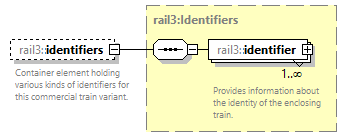 | ||||||
| namespace | https://www.railml.org/schemas/3.2 | ||||||
| type | rail3:Identifiers | ||||||
| properties |
| ||||||
| children | rail3:identifier | ||||||
| annotation |
| ||||||
| source | <xs:element name="identifiers" type="rail3:Identifiers" minOccurs="0" maxOccurs="1"> <xs:annotation> <xs:documentation>Container element holding various kinds of identifiers for this commercial train variant.</xs:documentation> </xs:annotation> </xs:element> |
element CommercialTrainVariant/isCancelled
| diagram | 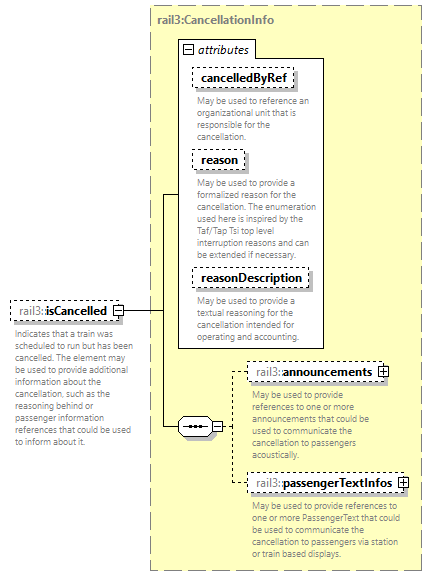 | ||||||||||||||||||||||||||||||
| namespace | https://www.railml.org/schemas/3.2 | ||||||||||||||||||||||||||||||
| type | rail3:CancellationInfo | ||||||||||||||||||||||||||||||
| properties |
| ||||||||||||||||||||||||||||||
| children | rail3:announcements rail3:passengerTextInfos | ||||||||||||||||||||||||||||||
| attributes |
| ||||||||||||||||||||||||||||||
| annotation |
| ||||||||||||||||||||||||||||||
| source | <xs:element name="isCancelled" type="rail3:CancellationInfo" minOccurs="0" maxOccurs="1"> <xs:annotation> <xs:documentation>Indicates that a train was scheduled to run but has been cancelled. The element may be used to provide additional information about the cancellation, such as the reasoning behind or passenger information references that could be used to inform about it.</xs:documentation> </xs:annotation> </xs:element> |
element CommercialTrainVariant/isOnRequest
| diagram | 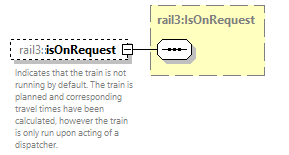 | ||||||
| namespace | https://www.railml.org/schemas/3.2 | ||||||
| type | rail3:IsOnRequest | ||||||
| properties |
| ||||||
| annotation |
| ||||||
| source | <xs:element name="isOnRequest" type="rail3:IsOnRequest" minOccurs="0" maxOccurs="1"> <xs:annotation> <xs:documentation>Indicates that the train is not running by default. The train is planned and corresponding travel times have been calculated, however the train is only run upon acting of a dispatcher.</xs:documentation> </xs:annotation> </xs:element> |
element CommercialTrainVariant/commercialTrainSection
| diagram | 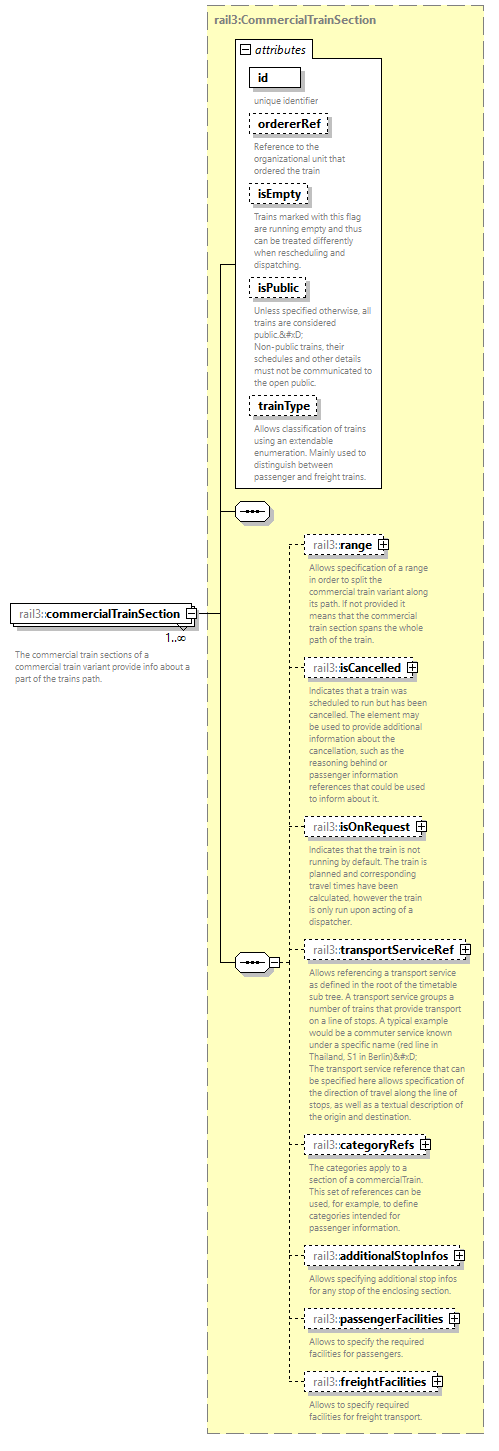 | ||||||||||||||||||||||||||||||||||||||||||||||
| namespace | https://www.railml.org/schemas/3.2 | ||||||||||||||||||||||||||||||||||||||||||||||
| type | rail3:CommercialTrainSection | ||||||||||||||||||||||||||||||||||||||||||||||
| properties |
| ||||||||||||||||||||||||||||||||||||||||||||||
| children | rail3:range rail3:isCancelled rail3:isOnRequest rail3:transportServiceRef rail3:categoryRefs rail3:additionalStopInfos rail3:passengerFacilities rail3:freightFacilities | ||||||||||||||||||||||||||||||||||||||||||||||
| attributes |
| ||||||||||||||||||||||||||||||||||||||||||||||
| annotation |
| ||||||||||||||||||||||||||||||||||||||||||||||
| source | <xs:element name="commercialTrainSection" type="rail3:CommercialTrainSection" minOccurs="1" maxOccurs="unbounded"> <xs:annotation> <xs:documentation>The commercial train sections of a commercial train variant provide info about a part of the trains path.</xs:documentation> </xs:annotation> </xs:element> |
complexType CommercialTrainVariantReference
| diagram | 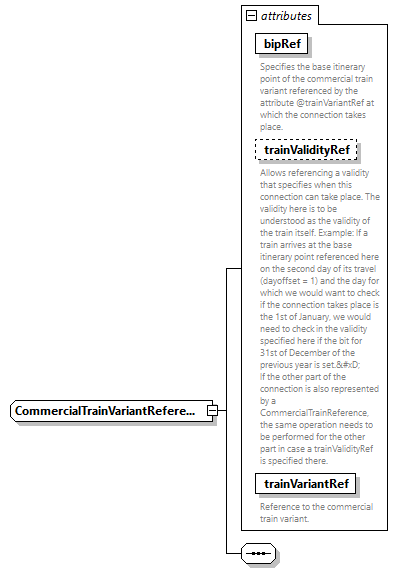 | ||||||||||||||||||||||||||||||
| namespace | https://www.railml.org/schemas/3.2 | ||||||||||||||||||||||||||||||
| used by |
| ||||||||||||||||||||||||||||||
| attributes |
| ||||||||||||||||||||||||||||||
| source | <xs:complexType name="CommercialTrainVariantReference"> <xs:sequence/> <xs:attribute name="bipRef" type="rail3:tRef" use="required"> <xs:annotation> <xs:documentation>Specifies the base itinerary point of the commercial train variant referenced by the attribute @trainVariantRef at which the connection takes place.</xs:documentation> </xs:annotation> </xs:attribute> <xs:attribute name="trainValidityRef" type="rail3:tRef" use="optional"> <xs:annotation> <xs:documentation>Allows referencing a validity that specifies when this connection can take place. The validity here is to be understood as the validity of the train itself. Example: If a train arrives at the base itinerary point referenced here on the second day of its travel (dayoffset = 1) and the day for which we would want to check if the connection takes place is the 1st of January, we would need to check in the validity specified here if the bit for 31st of December of the previous year is set.
 If the other part of the connection is also represented by a CommercialTrainReference, the same operation needs to be performed for the other part in case a trainValidityRef is specified there.</xs:documentation> </xs:annotation> </xs:attribute> <xs:attribute name="trainVariantRef" type="rail3:tRef" use="required"> <xs:annotation> <xs:documentation>Reference to the commercial train variant.</xs:documentation> </xs:annotation> </xs:attribute> </xs:complexType> |
attribute CommercialTrainVariantReference/@bipRef
| type | rail3:tRef | ||
| properties |
| ||
| annotation |
| ||
| source | <xs:attribute name="bipRef" type="rail3:tRef" use="required"> <xs:annotation> <xs:documentation>Specifies the base itinerary point of the commercial train variant referenced by the attribute @trainVariantRef at which the connection takes place.</xs:documentation> </xs:annotation> </xs:attribute> |
attribute CommercialTrainVariantReference/@trainValidityRef
| type | rail3:tRef | ||
| properties |
| ||
| annotation |
| ||
| source | <xs:attribute name="trainValidityRef" type="rail3:tRef" use="optional"> <xs:annotation> <xs:documentation>Allows referencing a validity that specifies when this connection can take place. The validity here is to be understood as the validity of the train itself. Example: If a train arrives at the base itinerary point referenced here on the second day of its travel (dayoffset = 1) and the day for which we would want to check if the connection takes place is the 1st of January, we would need to check in the validity specified here if the bit for 31st of December of the previous year is set.
 If the other part of the connection is also represented by a CommercialTrainReference, the same operation needs to be performed for the other part in case a trainValidityRef is specified there.</xs:documentation> </xs:annotation> </xs:attribute> |
attribute CommercialTrainVariantReference/@trainVariantRef
| type | rail3:tRef | ||
| properties |
| ||
| annotation |
| ||
| source | <xs:attribute name="trainVariantRef" type="rail3:tRef" use="required"> <xs:annotation> <xs:documentation>Reference to the commercial train variant.</xs:documentation> </xs:annotation> </xs:attribute> |
complexType ConnectionBase
| diagram | 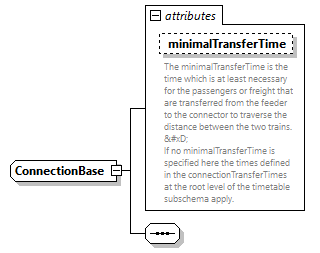 | ||||||||||||||
| namespace | https://www.railml.org/schemas/3.2 | ||||||||||||||
| properties |
| ||||||||||||||
| used by |
| ||||||||||||||
| attributes |
| ||||||||||||||
| source | <xs:complexType name="ConnectionBase" abstract="true"> <xs:sequence/> <xs:attribute name="minimalTransferTime" type="xs:duration" use="optional"> <xs:annotation> <xs:documentation>The minimalTransferTime is the time which is at least necessary for the passengers or freight that are transferred from the feeder to the connector to traverse the distance between the two trains. 
 If no minimalTransferTime is specified here the times defined in the connectionTransferTimes at the root level of the timetable subschema apply. </xs:documentation> </xs:annotation> </xs:attribute> </xs:complexType> |
attribute ConnectionBase/@minimalTransferTime
| type | xs:duration | ||
| properties |
| ||
| annotation |
| ||
| source | <xs:attribute name="minimalTransferTime" type="xs:duration" use="optional"> <xs:annotation> <xs:documentation>The minimalTransferTime is the time which is at least necessary for the passengers or freight that are transferred from the feeder to the connector to traverse the distance between the two trains. 
 If no minimalTransferTime is specified here the times defined in the connectionTransferTimes at the root level of the timetable subschema apply. </xs:documentation> </xs:annotation> </xs:attribute> |
complexType ConnectionTransferTime
| diagram | 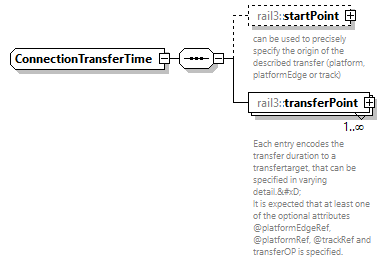 | ||
| namespace | https://www.railml.org/schemas/3.2 | ||
| children | rail3:startPoint rail3:transferPoint | ||
| used by |
| ||
| source | <xs:complexType name="ConnectionTransferTime"> <xs:sequence> <xs:element name="startPoint" type="rail3:LocationInfo" minOccurs="0" maxOccurs="1"> <xs:annotation> <xs:documentation>can be used to precisely specify the origin of the described transfer (platform, platformEdge or track)</xs:documentation> </xs:annotation> </xs:element> <xs:element name="transferPoint" type="rail3:TransferLocation" minOccurs="1" maxOccurs="unbounded"> <xs:annotation> <xs:documentation>Each entry encodes the transfer duration to a transfertarget, that can be specified in varying detail.
 It is expected that at least one of the optional attributes @platformEdgeRef, @platformRef, @trackRef and transferOP is specified.</xs:documentation> </xs:annotation> </xs:element> </xs:sequence> </xs:complexType> |
element ConnectionTransferTime/startPoint
| diagram | 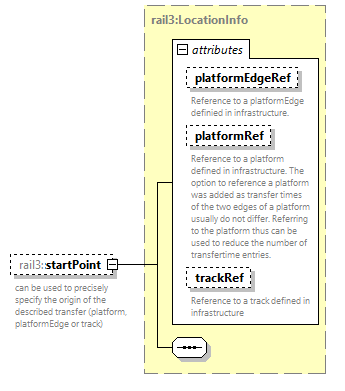 | ||||||||||||||||||||||||||||||
| namespace | https://www.railml.org/schemas/3.2 | ||||||||||||||||||||||||||||||
| type | rail3:LocationInfo | ||||||||||||||||||||||||||||||
| properties |
| ||||||||||||||||||||||||||||||
| attributes |
| ||||||||||||||||||||||||||||||
| annotation |
| ||||||||||||||||||||||||||||||
| source | <xs:element name="startPoint" type="rail3:LocationInfo" minOccurs="0" maxOccurs="1"> <xs:annotation> <xs:documentation>can be used to precisely specify the origin of the described transfer (platform, platformEdge or track)</xs:documentation> </xs:annotation> </xs:element> |
element ConnectionTransferTime/transferPoint
| diagram | 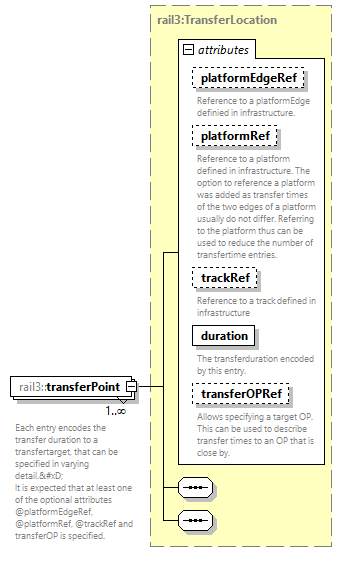 | ||||||||||||||||||||||||||||||||||||||||||||||
| namespace | https://www.railml.org/schemas/3.2 | ||||||||||||||||||||||||||||||||||||||||||||||
| type | rail3:TransferLocation | ||||||||||||||||||||||||||||||||||||||||||||||
| properties |
| ||||||||||||||||||||||||||||||||||||||||||||||
| attributes |
| ||||||||||||||||||||||||||||||||||||||||||||||
| annotation |
| ||||||||||||||||||||||||||||||||||||||||||||||
| source | <xs:element name="transferPoint" type="rail3:TransferLocation" minOccurs="1" maxOccurs="unbounded"> <xs:annotation> <xs:documentation>Each entry encodes the transfer duration to a transfertarget, that can be specified in varying detail.
 It is expected that at least one of the optional attributes @platformEdgeRef, @platformRef, @trackRef and transferOP is specified.</xs:documentation> </xs:annotation> </xs:element> |
complexType ConnectionTransferTimeForOP
| diagram | 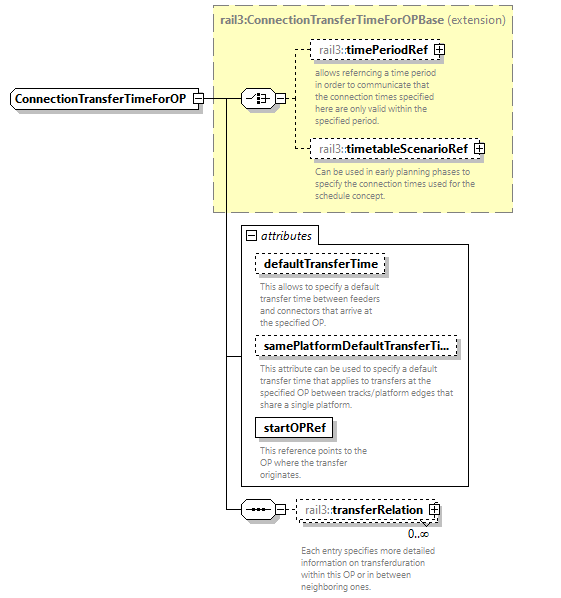 | ||||||||||||||||||||||||||||||
| namespace | https://www.railml.org/schemas/3.2 | ||||||||||||||||||||||||||||||
| type | extension of rail3:ConnectionTransferTimeForOPBase | ||||||||||||||||||||||||||||||
| properties |
| ||||||||||||||||||||||||||||||
| children | rail3:timePeriodRef rail3:timetableScenarioRef rail3:transferRelation | ||||||||||||||||||||||||||||||
| used by |
| ||||||||||||||||||||||||||||||
| attributes |
| ||||||||||||||||||||||||||||||
| source | <xs:complexType name="ConnectionTransferTimeForOP"> <xs:complexContent> <xs:extension base="rail3:ConnectionTransferTimeForOPBase"> <xs:sequence> <xs:element name="transferRelation" type="rail3:ConnectionTransferTime" minOccurs="0" maxOccurs="unbounded"> <xs:annotation> <xs:documentation>Each entry specifies more detailed information on transferduration within this OP or in between neighboring ones.</xs:documentation> </xs:annotation> </xs:element> </xs:sequence> <xs:attribute name="defaultTransferTime" type="xs:duration" use="optional"> <xs:annotation> <xs:documentation>This allows to specify a default transfer time between feeders and connectors that arrive at the specified OP.</xs:documentation> </xs:annotation> </xs:attribute> <xs:attribute name="samePlatformDefaultTransferTime" type="xs:duration" use="optional"> <xs:annotation> <xs:documentation>This attribute can be used to specify a default transfer time that applies to transfers at the specified OP between tracks/platform edges that share a single platform.</xs:documentation> </xs:annotation> </xs:attribute> <xs:attribute name="startOPRef" type="rail3:tRef" use="required"> <xs:annotation> <xs:documentation>This reference points to the OP where the transfer originates. </xs:documentation> </xs:annotation> </xs:attribute> </xs:extension> </xs:complexContent> </xs:complexType> |
attribute ConnectionTransferTimeForOP/@defaultTransferTime
| type | xs:duration | ||
| properties |
| ||
| annotation |
| ||
| source | <xs:attribute name="defaultTransferTime" type="xs:duration" use="optional"> <xs:annotation> <xs:documentation>This allows to specify a default transfer time between feeders and connectors that arrive at the specified OP.</xs:documentation> </xs:annotation> </xs:attribute> |
attribute ConnectionTransferTimeForOP/@samePlatformDefaultTransferTime
| type | xs:duration | ||
| properties |
| ||
| annotation |
| ||
| source | <xs:attribute name="samePlatformDefaultTransferTime" type="xs:duration" use="optional"> <xs:annotation> <xs:documentation>This attribute can be used to specify a default transfer time that applies to transfers at the specified OP between tracks/platform edges that share a single platform.</xs:documentation> </xs:annotation> </xs:attribute> |
attribute ConnectionTransferTimeForOP/@startOPRef
| type | rail3:tRef | ||
| properties |
| ||
| annotation |
| ||
| source | <xs:attribute name="startOPRef" type="rail3:tRef" use="required"> <xs:annotation> <xs:documentation>This reference points to the OP where the transfer originates. </xs:documentation> </xs:annotation> </xs:attribute> |
element ConnectionTransferTimeForOP/transferRelation
| diagram | 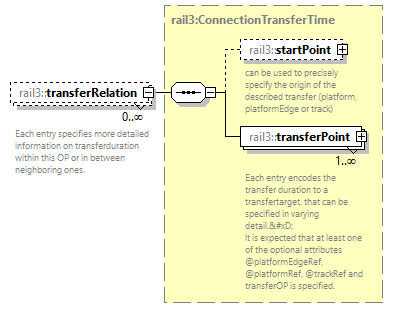 | ||||||
| namespace | https://www.railml.org/schemas/3.2 | ||||||
| type | rail3:ConnectionTransferTime | ||||||
| properties |
| ||||||
| children | rail3:startPoint rail3:transferPoint | ||||||
| annotation |
| ||||||
| source | <xs:element name="transferRelation" type="rail3:ConnectionTransferTime" minOccurs="0" maxOccurs="unbounded"> <xs:annotation> <xs:documentation>Each entry specifies more detailed information on transferduration within this OP or in between neighboring ones.</xs:documentation> </xs:annotation> </xs:element> |
complexType ConnectionTransferTimeForOPBase
| diagram | 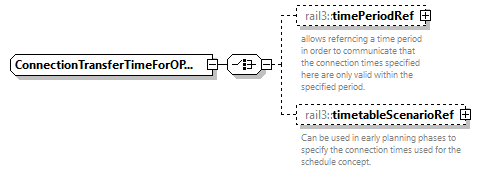 | ||
| namespace | https://www.railml.org/schemas/3.2 | ||
| children | rail3:timePeriodRef rail3:timetableScenarioRef | ||
| used by |
| ||
| source | <xs:complexType name="ConnectionTransferTimeForOPBase"> <xs:choice> <xs:element name="timePeriodRef" type="rail3:tElementWithIDref" minOccurs="0" maxOccurs="1"> <xs:annotation> <xs:documentation>allows referncing a time period in order to communicate that the connection times specified here are only valid within the specified period.</xs:documentation> </xs:annotation> </xs:element> <xs:element name="timetableScenarioRef" type="rail3:tElementWithIDref" minOccurs="0" maxOccurs="1"> <xs:annotation> <xs:documentation>Can be used in early planning phases to specify the connection times used for the schedule concept.</xs:documentation> </xs:annotation> </xs:element> </xs:choice> </xs:complexType> |
element ConnectionTransferTimeForOPBase/timePeriodRef
| diagram | 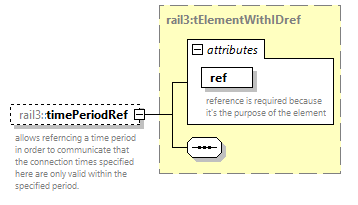 | ||||||||||||||
| namespace | https://www.railml.org/schemas/3.2 | ||||||||||||||
| type | rail3:tElementWithIDref | ||||||||||||||
| properties |
| ||||||||||||||
| attributes |
| ||||||||||||||
| annotation |
| ||||||||||||||
| source | <xs:element name="timePeriodRef" type="rail3:tElementWithIDref" minOccurs="0" maxOccurs="1"> <xs:annotation> <xs:documentation>allows referncing a time period in order to communicate that the connection times specified here are only valid within the specified period.</xs:documentation> </xs:annotation> </xs:element> |
element ConnectionTransferTimeForOPBase/timetableScenarioRef
| diagram | 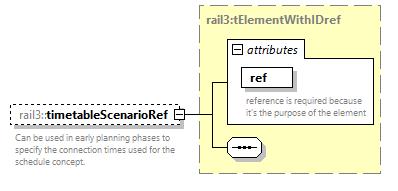 | ||||||||||||||
| namespace | https://www.railml.org/schemas/3.2 | ||||||||||||||
| type | rail3:tElementWithIDref | ||||||||||||||
| properties |
| ||||||||||||||
| attributes |
| ||||||||||||||
| annotation |
| ||||||||||||||
| source | <xs:element name="timetableScenarioRef" type="rail3:tElementWithIDref" minOccurs="0" maxOccurs="1"> <xs:annotation> <xs:documentation>Can be used in early planning phases to specify the connection times used for the schedule concept.</xs:documentation> </xs:annotation> </xs:element> |
complexType ConnectionTransferTimes
| diagram |  | ||
| namespace | https://www.railml.org/schemas/3.2 | ||
| children | rail3:connectionTransferTime | ||
| used by |
| ||
| source | <xs:complexType name="ConnectionTransferTimes"> <xs:sequence> <xs:element name="connectionTransferTime" type="rail3:ConnectionTransferTimeForOP" minOccurs="1" maxOccurs="unbounded"> <xs:annotation> <xs:documentation>Each entry specifies the transfer times for connections that originate from one OP</xs:documentation> </xs:annotation> </xs:element> </xs:sequence> </xs:complexType> |
element ConnectionTransferTimes/connectionTransferTime
| diagram | 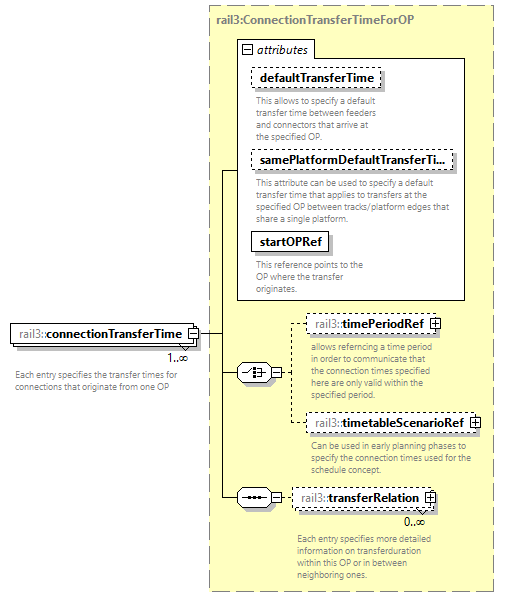 | ||||||||||||||||||||||||||||||
| namespace | https://www.railml.org/schemas/3.2 | ||||||||||||||||||||||||||||||
| type | rail3:ConnectionTransferTimeForOP | ||||||||||||||||||||||||||||||
| properties |
| ||||||||||||||||||||||||||||||
| children | rail3:timePeriodRef rail3:timetableScenarioRef rail3:transferRelation | ||||||||||||||||||||||||||||||
| attributes |
| ||||||||||||||||||||||||||||||
| annotation |
| ||||||||||||||||||||||||||||||
| source | <xs:element name="connectionTransferTime" type="rail3:ConnectionTransferTimeForOP" minOccurs="1" maxOccurs="unbounded"> <xs:annotation> <xs:documentation>Each entry specifies the transfer times for connections that originate from one OP</xs:documentation> </xs:annotation> </xs:element> |
complexType DistanceBasedCalculationRule
| diagram |  | ||||||||||||||||||
| namespace | https://www.railml.org/schemas/3.2 | ||||||||||||||||||
| attributes |
| ||||||||||||||||||
| source | <xs:complexType name="DistanceBasedCalculationRule"> <xs:sequence/> <xs:attribute name="referenceDistanceMeters" type="xs:int" use="optional"/> <xs:attribute name="supplement" type="xs:duration" use="optional"/> </xs:complexType> |
attribute DistanceBasedCalculationRule/@referenceDistanceMeters
| type | xs:int | ||
| properties |
| ||
| source | <xs:attribute name="referenceDistanceMeters" type="xs:int" use="optional"/> |
attribute DistanceBasedCalculationRule/@supplement
| type | xs:duration | ||
| properties |
| ||
| source | <xs:attribute name="supplement" type="xs:duration" use="optional"/> |
complexType ExtendedActivities
| diagram | 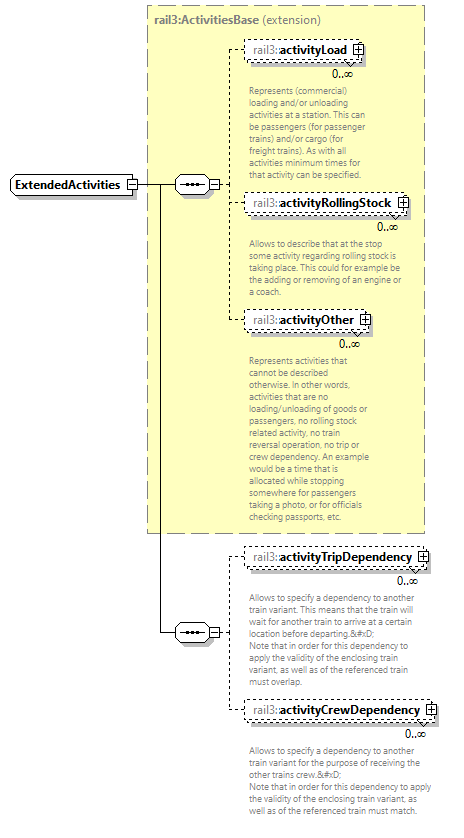 | ||
| namespace | https://www.railml.org/schemas/3.2 | ||
| type | extension of rail3:ActivitiesBase | ||
| properties |
| ||
| children | rail3:activityLoad rail3:activityRollingStock rail3:activityOther rail3:activityTripDependency rail3:activityCrewDependency | ||
| used by |
| ||
| source | <xs:complexType name="ExtendedActivities"> <xs:complexContent> <xs:extension base="rail3:ActivitiesBase"> <xs:sequence> <xs:element name="activityTripDependency" type="rail3:ActivityTripDependency" minOccurs="0" maxOccurs="unbounded"> <xs:annotation> <xs:documentation>Allows to specify a dependency to another train variant. This means that the train will wait for another train to arrive at a certain location before departing.
 Note that in order for this dependency to apply the validity of the enclosing train variant, as well as of the referenced train must overlap.</xs:documentation> </xs:annotation> </xs:element> <xs:element name="activityCrewDependency" type="rail3:ActivityCrewDependency" minOccurs="0" maxOccurs="unbounded"> <xs:annotation> <xs:documentation>Allows to specify a dependency to another train variant for the purpose of receiving the other trains crew.
 Note that in order for this dependency to apply the validity of the enclosing train variant, as well as of the referenced train must match.</xs:documentation> </xs:annotation> </xs:element> </xs:sequence> </xs:extension> </xs:complexContent> </xs:complexType> |
element ExtendedActivities/activityTripDependency
| diagram | 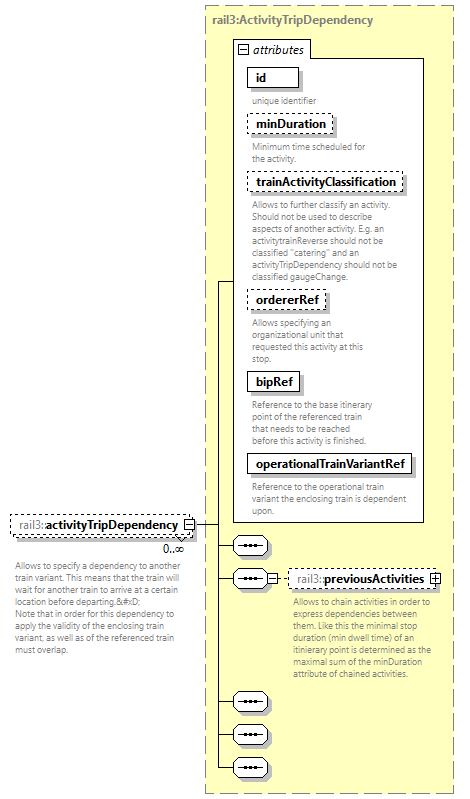 | ||||||||||||||||||||||||||||||||||||||||||||||||||||||
| namespace | https://www.railml.org/schemas/3.2 | ||||||||||||||||||||||||||||||||||||||||||||||||||||||
| type | rail3:ActivityTripDependency | ||||||||||||||||||||||||||||||||||||||||||||||||||||||
| properties |
| ||||||||||||||||||||||||||||||||||||||||||||||||||||||
| children | rail3:previousActivities | ||||||||||||||||||||||||||||||||||||||||||||||||||||||
| attributes |
| ||||||||||||||||||||||||||||||||||||||||||||||||||||||
| annotation |
| ||||||||||||||||||||||||||||||||||||||||||||||||||||||
| source | <xs:element name="activityTripDependency" type="rail3:ActivityTripDependency" minOccurs="0" maxOccurs="unbounded"> <xs:annotation> <xs:documentation>Allows to specify a dependency to another train variant. This means that the train will wait for another train to arrive at a certain location before departing.
 Note that in order for this dependency to apply the validity of the enclosing train variant, as well as of the referenced train must overlap.</xs:documentation> </xs:annotation> </xs:element> |
element ExtendedActivities/activityCrewDependency
| diagram | 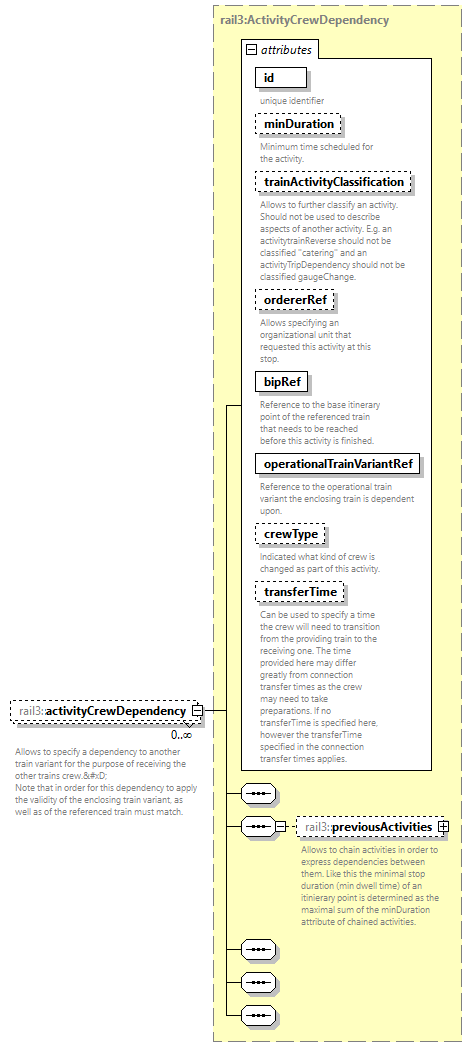 | ||||||||||||||||||||||||||||||||||||||||||||||||||||||||||||||||||||||
| namespace | https://www.railml.org/schemas/3.2 | ||||||||||||||||||||||||||||||||||||||||||||||||||||||||||||||||||||||
| type | rail3:ActivityCrewDependency | ||||||||||||||||||||||||||||||||||||||||||||||||||||||||||||||||||||||
| properties |
| ||||||||||||||||||||||||||||||||||||||||||||||||||||||||||||||||||||||
| children | rail3:previousActivities | ||||||||||||||||||||||||||||||||||||||||||||||||||||||||||||||||||||||
| attributes |
| ||||||||||||||||||||||||||||||||||||||||||||||||||||||||||||||||||||||
| annotation |
| ||||||||||||||||||||||||||||||||||||||||||||||||||||||||||||||||||||||
| source | <xs:element name="activityCrewDependency" type="rail3:ActivityCrewDependency" minOccurs="0" maxOccurs="unbounded"> <xs:annotation> <xs:documentation>Allows to specify a dependency to another train variant for the purpose of receiving the other trains crew.
 Note that in order for this dependency to apply the validity of the enclosing train variant, as well as of the referenced train must match.</xs:documentation> </xs:annotation> </xs:element> |
complexType ExtendedAdditionalStopInfo
| diagram | 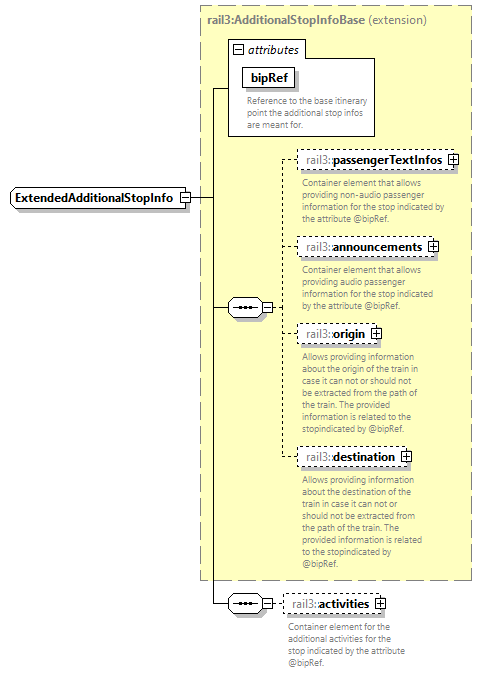 | ||||||||||||||
| namespace | https://www.railml.org/schemas/3.2 | ||||||||||||||
| type | extension of rail3:AdditionalStopInfoBase | ||||||||||||||
| properties |
| ||||||||||||||
| children | rail3:passengerTextInfos rail3:announcements rail3:origin rail3:destination rail3:activities | ||||||||||||||
| used by |
| ||||||||||||||
| attributes |
| ||||||||||||||
| source | <xs:complexType name="ExtendedAdditionalStopInfo"> <xs:complexContent> <xs:extension base="rail3:AdditionalStopInfoBase"> <xs:sequence> <xs:element name="activities" type="rail3:ExtendedActivities" minOccurs="0" maxOccurs="1"> <xs:annotation> <xs:documentation>Container element for the additional activities for the stop indicated by the attribute @bipRef.</xs:documentation> </xs:annotation> </xs:element> </xs:sequence> </xs:extension> </xs:complexContent> </xs:complexType> |
element ExtendedAdditionalStopInfo/activities
| diagram | 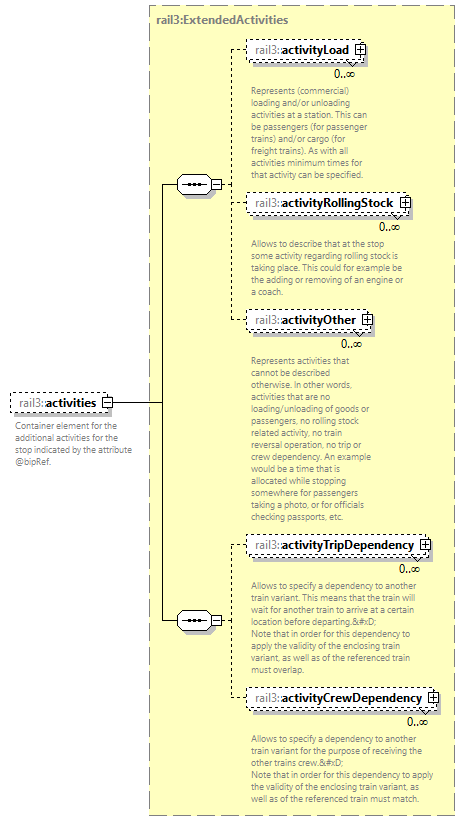 | ||||||
| namespace | https://www.railml.org/schemas/3.2 | ||||||
| type | rail3:ExtendedActivities | ||||||
| properties |
| ||||||
| children | rail3:activityLoad rail3:activityRollingStock rail3:activityOther rail3:activityTripDependency rail3:activityCrewDependency | ||||||
| annotation |
| ||||||
| source | <xs:element name="activities" type="rail3:ExtendedActivities" minOccurs="0" maxOccurs="1"> <xs:annotation> <xs:documentation>Container element for the additional activities for the stop indicated by the attribute @bipRef.</xs:documentation> </xs:annotation> </xs:element> |
complexType ExtendedAdditionalStopInfos
| diagram |  | ||
| namespace | https://www.railml.org/schemas/3.2 | ||
| children | rail3:additionalStopInfo | ||
| used by |
| ||
| source | <xs:complexType name="ExtendedAdditionalStopInfos"> <xs:sequence> <xs:element name="additionalStopInfo" type="rail3:ExtendedAdditionalStopInfo" minOccurs="1" maxOccurs="unbounded"> <xs:annotation> <xs:documentation>Allows specifying additional stop activities for a stop of the enclosed section of the trains path.</xs:documentation> </xs:annotation> </xs:element> </xs:sequence> </xs:complexType> |
element ExtendedAdditionalStopInfos/additionalStopInfo
| diagram | 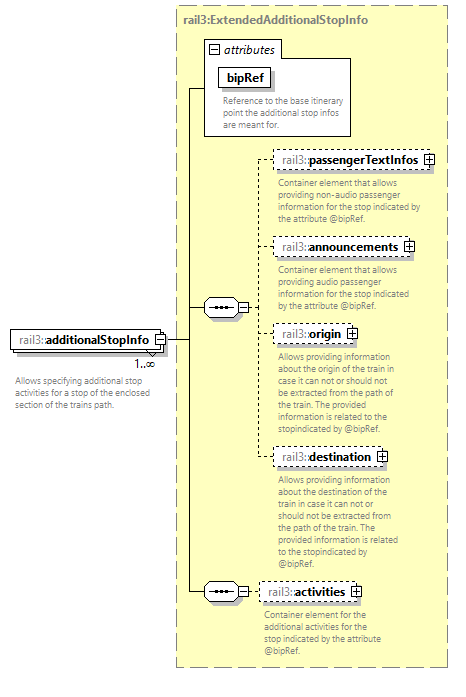 | ||||||||||||||
| namespace | https://www.railml.org/schemas/3.2 | ||||||||||||||
| type | rail3:ExtendedAdditionalStopInfo | ||||||||||||||
| properties |
| ||||||||||||||
| children | rail3:passengerTextInfos rail3:announcements rail3:origin rail3:destination rail3:activities | ||||||||||||||
| attributes |
| ||||||||||||||
| annotation |
| ||||||||||||||
| source | <xs:element name="additionalStopInfo" type="rail3:ExtendedAdditionalStopInfo" minOccurs="1" maxOccurs="unbounded"> <xs:annotation> <xs:documentation>Allows specifying additional stop activities for a stop of the enclosed section of the trains path.</xs:documentation> </xs:annotation> </xs:element> |
complexType ExternalReferenceStop
| diagram |  | ||
| namespace | https://www.railml.org/schemas/3.2 | ||
| children | rail3:locationRef | ||
| used by |
| ||
| source | <xs:complexType name="ExternalReferenceStop"> <xs:sequence> <xs:element name="locationRef" type="rail3:LocationReference" minOccurs="1" maxOccurs="1"> <xs:annotation> <xs:documentation>allows specifying a reference to an op that is defined in infrastructure.</xs:documentation> </xs:annotation> </xs:element> </xs:sequence> </xs:complexType> |
element ExternalReferenceStop/locationRef
| diagram | 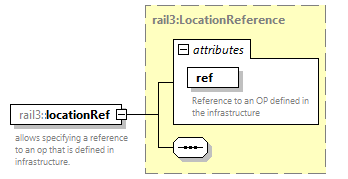 | ||||||||||||||
| namespace | https://www.railml.org/schemas/3.2 | ||||||||||||||
| type | rail3:LocationReference | ||||||||||||||
| properties |
| ||||||||||||||
| attributes |
| ||||||||||||||
| annotation |
| ||||||||||||||
| source | <xs:element name="locationRef" type="rail3:LocationReference" minOccurs="1" maxOccurs="1"> <xs:annotation> <xs:documentation>allows specifying a reference to an op that is defined in infrastructure.</xs:documentation> </xs:annotation> </xs:element> |
complexType ExternalReferenceTrain
| diagram |  | ||
| namespace | https://www.railml.org/schemas/3.2 | ||
| children | rail3:externalTrainNumber rail3:tafTapTsiId | ||
| used by |
| ||
| source | <xs:complexType name="ExternalReferenceTrain"> <xs:sequence> <xs:choice minOccurs="1" maxOccurs="1"> <xs:element name="externalTrainNumber" type="rail3:ExternalTrainNumber" minOccurs="1" maxOccurs="1"> <xs:annotation> <xs:documentation>Used to identify a train that is not included in the railML by its trainNumber.</xs:documentation> </xs:annotation> </xs:element> <xs:element name="tafTapTsiId" type="rail3:TafTapTsiId" minOccurs="1" maxOccurs="1"> <xs:annotation> <xs:documentation>Used to identify a train using its TAF TAP TSI identifyier</xs:documentation> </xs:annotation> </xs:element> </xs:choice> </xs:sequence> </xs:complexType> |
element ExternalReferenceTrain/externalTrainNumber
| diagram | 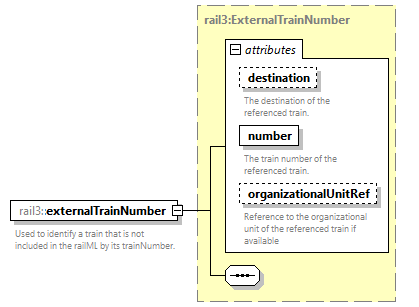 | ||||||||||||||||||||||||||||||
| namespace | https://www.railml.org/schemas/3.2 | ||||||||||||||||||||||||||||||
| type | rail3:ExternalTrainNumber | ||||||||||||||||||||||||||||||
| properties |
| ||||||||||||||||||||||||||||||
| attributes |
| ||||||||||||||||||||||||||||||
| annotation |
| ||||||||||||||||||||||||||||||
| source | <xs:element name="externalTrainNumber" type="rail3:ExternalTrainNumber" minOccurs="1" maxOccurs="1"> <xs:annotation> <xs:documentation>Used to identify a train that is not included in the railML by its trainNumber.</xs:documentation> </xs:annotation> </xs:element> |
element ExternalReferenceTrain/tafTapTsiId
| diagram | 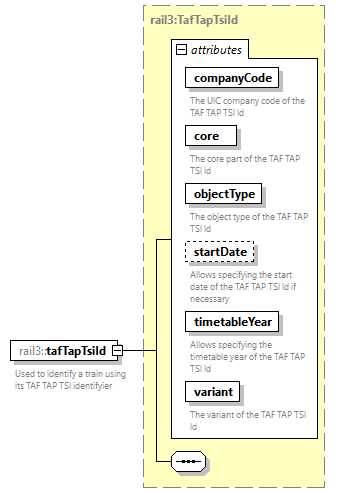 | ||||||||||||||||||||||||||||||||||||||||||||||||||||||
| namespace | https://www.railml.org/schemas/3.2 | ||||||||||||||||||||||||||||||||||||||||||||||||||||||
| type | rail3:TafTapTsiId | ||||||||||||||||||||||||||||||||||||||||||||||||||||||
| properties |
| ||||||||||||||||||||||||||||||||||||||||||||||||||||||
| attributes |
| ||||||||||||||||||||||||||||||||||||||||||||||||||||||
| annotation |
| ||||||||||||||||||||||||||||||||||||||||||||||||||||||
| source | <xs:element name="tafTapTsiId" type="rail3:TafTapTsiId" minOccurs="1" maxOccurs="1"> <xs:annotation> <xs:documentation>Used to identify a train using its TAF TAP TSI identifyier</xs:documentation> </xs:annotation> </xs:element> |
complexType ExternalTrainNumber
| diagram | 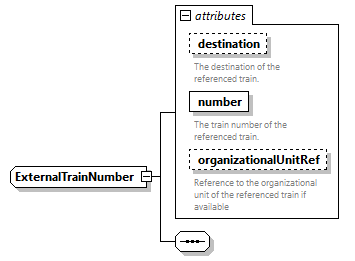 | ||||||||||||||||||||||||||||||
| namespace | https://www.railml.org/schemas/3.2 | ||||||||||||||||||||||||||||||
| used by |
| ||||||||||||||||||||||||||||||
| attributes |
| ||||||||||||||||||||||||||||||
| source | <xs:complexType name="ExternalTrainNumber"> <xs:sequence/> <xs:attribute name="destination" type="xs:string" use="optional"> <xs:annotation> <xs:documentation>The destination of the referenced train.</xs:documentation> </xs:annotation> </xs:attribute> <xs:attribute name="number" type="xs:string" use="required"> <xs:annotation> <xs:documentation>The train number of the referenced train. </xs:documentation> </xs:annotation> </xs:attribute> <xs:attribute name="organizationalUnitRef" type="rail3:tRef" use="optional"> <xs:annotation> <xs:documentation>Reference to the organizational unit of the referenced train if available</xs:documentation> </xs:annotation> </xs:attribute> </xs:complexType> |
attribute ExternalTrainNumber/@destination
| type | xs:string | ||
| properties |
| ||
| annotation |
| ||
| source | <xs:attribute name="destination" type="xs:string" use="optional"> <xs:annotation> <xs:documentation>The destination of the referenced train.</xs:documentation> </xs:annotation> </xs:attribute> |
attribute ExternalTrainNumber/@number
| type | xs:string | ||
| properties |
| ||
| annotation |
| ||
| source | <xs:attribute name="number" type="xs:string" use="required"> <xs:annotation> <xs:documentation>The train number of the referenced train. </xs:documentation> </xs:annotation> </xs:attribute> |
attribute ExternalTrainNumber/@organizationalUnitRef
| type | rail3:tRef | ||
| properties |
| ||
| annotation |
| ||
| source | <xs:attribute name="organizationalUnitRef" type="rail3:tRef" use="optional"> <xs:annotation> <xs:documentation>Reference to the organizational unit of the referenced train if available</xs:documentation> </xs:annotation> </xs:attribute> |
complexType ExternalTrainReference
| diagram | 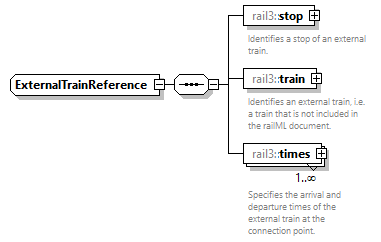 |
| namespace | https://www.railml.org/schemas/3.2 |
| children | rail3:stop rail3:train rail3:times |
| used by | |
| source | <xs:complexType name="ExternalTrainReference"> <xs:sequence> <xs:element name="stop" type="rail3:ExternalReferenceStop" minOccurs="1" maxOccurs="1"> <xs:annotation> <xs:documentation>Identifies a stop of an external train.</xs:documentation> </xs:annotation> </xs:element> <xs:element name="train" type="rail3:ExternalReferenceTrain" minOccurs="1" maxOccurs="1"> <xs:annotation> <xs:documentation>Identifies an external train, i.e. a train that is not included in the railML document.</xs:documentation> </xs:annotation> </xs:element> <xs:element name="times" type="rail3:Times" minOccurs="1" maxOccurs="unbounded"> <xs:annotation> <xs:documentation>Specifies the arrival and departure times of the external train at the connection point.</xs:documentation> </xs:annotation> </xs:element> </xs:sequence> </xs:complexType> |
element ExternalTrainReference/stop
| diagram |  | ||
| namespace | https://www.railml.org/schemas/3.2 | ||
| type | rail3:ExternalReferenceStop | ||
| properties |
| ||
| children | rail3:locationRef | ||
| annotation |
| ||
| source | <xs:element name="stop" type="rail3:ExternalReferenceStop" minOccurs="1" maxOccurs="1"> <xs:annotation> <xs:documentation>Identifies a stop of an external train.</xs:documentation> </xs:annotation> </xs:element> |
element ExternalTrainReference/train
| diagram | 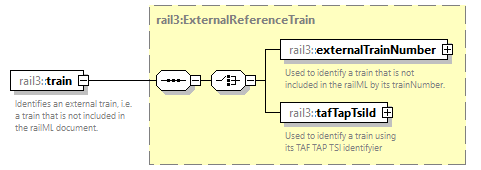 | ||
| namespace | https://www.railml.org/schemas/3.2 | ||
| type | rail3:ExternalReferenceTrain | ||
| properties |
| ||
| children | rail3:externalTrainNumber rail3:tafTapTsiId | ||
| annotation |
| ||
| source | <xs:element name="train" type="rail3:ExternalReferenceTrain" minOccurs="1" maxOccurs="1"> <xs:annotation> <xs:documentation>Identifies an external train, i.e. a train that is not included in the railML document.</xs:documentation> </xs:annotation> </xs:element> |
element ExternalTrainReference/times
| diagram | 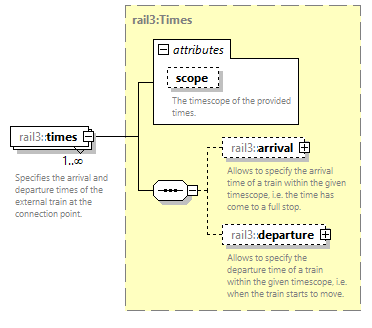 | ||||||||||||||
| namespace | https://www.railml.org/schemas/3.2 | ||||||||||||||
| type | rail3:Times | ||||||||||||||
| properties |
| ||||||||||||||
| children | rail3:arrival rail3:departure | ||||||||||||||
| attributes |
| ||||||||||||||
| annotation |
| ||||||||||||||
| source | <xs:element name="times" type="rail3:Times" minOccurs="1" maxOccurs="unbounded"> <xs:annotation> <xs:documentation>Specifies the arrival and departure times of the external train at the connection point.</xs:documentation> </xs:annotation> </xs:element> |
complexType FollowupSectionsTT
| diagram | 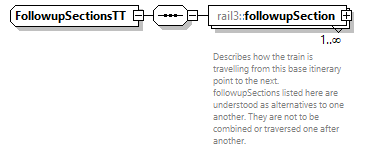 | ||
| namespace | https://www.railml.org/schemas/3.2 | ||
| children | rail3:followupSection | ||
| used by |
| ||
| source | <xs:complexType name="FollowupSectionsTT"> <xs:sequence> <xs:element name="followupSection" type="rail3:FollowupSectionTT" minOccurs="1" maxOccurs="unbounded"> <xs:annotation> <xs:documentation>Describes how the train is travelling from this base itinerary point to the next. followupSections listed here are understood as alternatives to one another. They are not to be combined or traversed one after another.</xs:documentation> </xs:annotation> </xs:element> </xs:sequence> </xs:complexType> |
element FollowupSectionsTT/followupSection
| diagram | 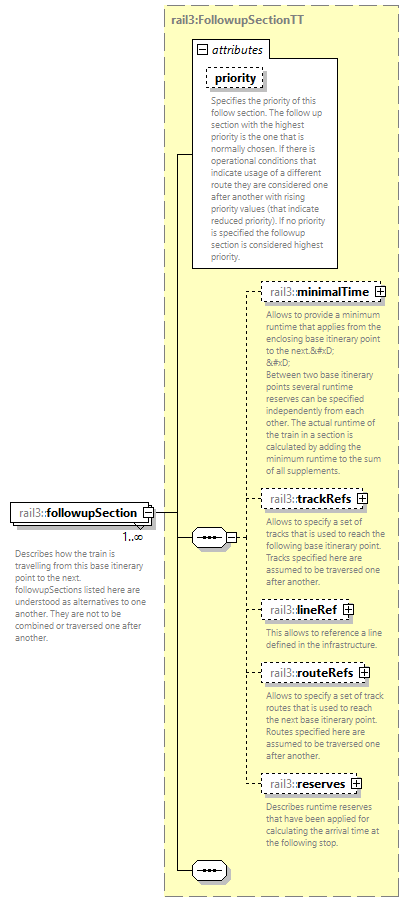 | ||||||||||||||
| namespace | https://www.railml.org/schemas/3.2 | ||||||||||||||
| type | rail3:FollowupSectionTT | ||||||||||||||
| properties |
| ||||||||||||||
| children | rail3:minimalTime rail3:trackRefs rail3:lineRef rail3:routeRefs rail3:reserves | ||||||||||||||
| attributes |
| ||||||||||||||
| annotation |
| ||||||||||||||
| source | <xs:element name="followupSection" type="rail3:FollowupSectionTT" minOccurs="1" maxOccurs="unbounded"> <xs:annotation> <xs:documentation>Describes how the train is travelling from this base itinerary point to the next. followupSections listed here are understood as alternatives to one another. They are not to be combined or traversed one after another.</xs:documentation> </xs:annotation> </xs:element> |
complexType FollowupSectionTT
| diagram | 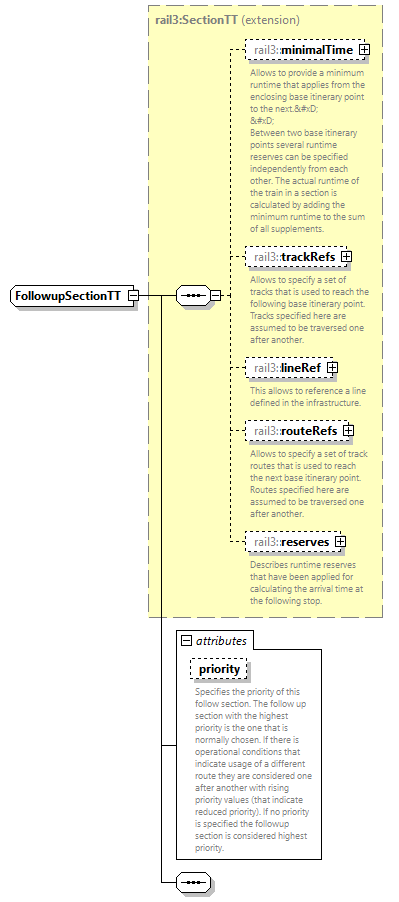 | ||||||||||||||
| namespace | https://www.railml.org/schemas/3.2 | ||||||||||||||
| type | extension of rail3:SectionTT | ||||||||||||||
| properties |
| ||||||||||||||
| children | rail3:minimalTime rail3:trackRefs rail3:lineRef rail3:routeRefs rail3:reserves | ||||||||||||||
| used by |
| ||||||||||||||
| attributes |
| ||||||||||||||
| source | <xs:complexType name="FollowupSectionTT"> <xs:complexContent> <xs:extension base="rail3:SectionTT"> <xs:sequence/> <xs:attribute name="priority" type="rail3:tPriority" use="optional" default="0"> <xs:annotation> <xs:documentation>Specifies the priority of this follow section. The follow up section with the highest priority is the one that is normally chosen. If there is operational conditions that indicate usage of a different route they are considered one after another with rising priority values (that indicate reduced priority). If no priority is specified the followup section is considered highest priority.</xs:documentation> </xs:annotation> </xs:attribute> </xs:extension> </xs:complexContent> </xs:complexType> |
attribute FollowupSectionTT/@priority
| type | rail3:tPriority | ||||
| properties |
| ||||
| annotation |
| ||||
| source | <xs:attribute name="priority" type="rail3:tPriority" use="optional" default="0"> <xs:annotation> <xs:documentation>Specifies the priority of this follow section. The follow up section with the highest priority is the one that is normally chosen. If there is operational conditions that indicate usage of a different route they are considered one after another with rising priority values (that indicate reduced priority). If no priority is specified the followup section is considered highest priority.</xs:documentation> </xs:annotation> </xs:attribute> |
complexType FormationInformation
| diagram | 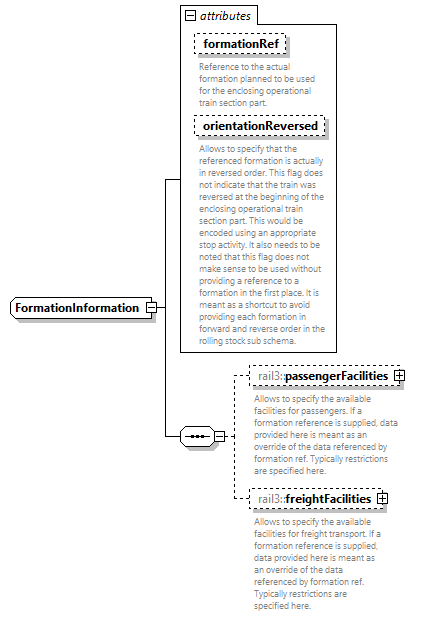 | ||||||||||||||||||||||
| namespace | https://www.railml.org/schemas/3.2 | ||||||||||||||||||||||
| children | rail3:passengerFacilities rail3:freightFacilities | ||||||||||||||||||||||
| used by |
| ||||||||||||||||||||||
| attributes |
| ||||||||||||||||||||||
| source | <xs:complexType name="FormationInformation"> <xs:sequence> <xs:element name="passengerFacilities" type="rail3:PassengerFacilities" minOccurs="0" maxOccurs="1"> <xs:annotation> <xs:documentation>Allows to specify the available facilities for passengers. If a formation reference is supplied, data provided here is meant as an override of the data referenced by formation ref. Typically restrictions are specified here.</xs:documentation> </xs:annotation> </xs:element> <xs:element name="freightFacilities" type="rail3:FreightFacilities" minOccurs="0" maxOccurs="1"> <xs:annotation> <xs:documentation>Allows to specify the available facilities for freight transport. If a formation reference is supplied, data provided here is meant as an override of the data referenced by formation ref. Typically restrictions are specified here.</xs:documentation> </xs:annotation> </xs:element> </xs:sequence> <xs:attribute name="formationRef" type="rail3:tRef" use="optional"> <xs:annotation> <xs:documentation>Reference to the actual formation planned to be used for the enclosing operational train section part.</xs:documentation> </xs:annotation> </xs:attribute> <xs:attribute name="orientationReversed" type="xs:boolean" use="optional" default="false"> <xs:annotation> <xs:documentation>Allows to specify that the referenced formation is actually in reversed order. This flag does not indicate that the train was reversed at the beginning of the enclosing operational train section part. This would be encoded using an appropriate stop activity. It also needs to be noted that this flag does not make sense to be used without providing a reference to a formation in the first place. It is meant as a shortcut to avoid providing each formation in forward and reverse order in the rolling stock sub schema.</xs:documentation> </xs:annotation> </xs:attribute> </xs:complexType> |
attribute FormationInformation/@formationRef
| type | rail3:tRef | ||
| properties |
| ||
| annotation |
| ||
| source | <xs:attribute name="formationRef" type="rail3:tRef" use="optional"> <xs:annotation> <xs:documentation>Reference to the actual formation planned to be used for the enclosing operational train section part.</xs:documentation> </xs:annotation> </xs:attribute> |
attribute FormationInformation/@orientationReversed
| type | xs:boolean | ||||
| properties |
| ||||
| annotation |
| ||||
| source | <xs:attribute name="orientationReversed" type="xs:boolean" use="optional" default="false"> <xs:annotation> <xs:documentation>Allows to specify that the referenced formation is actually in reversed order. This flag does not indicate that the train was reversed at the beginning of the enclosing operational train section part. This would be encoded using an appropriate stop activity. It also needs to be noted that this flag does not make sense to be used without providing a reference to a formation in the first place. It is meant as a shortcut to avoid providing each formation in forward and reverse order in the rolling stock sub schema.</xs:documentation> </xs:annotation> </xs:attribute> |
element FormationInformation/passengerFacilities
| diagram | 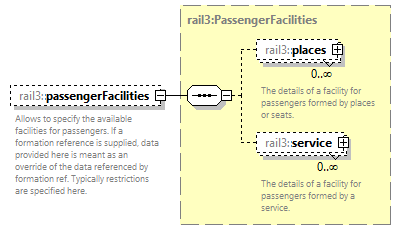 | ||||||
| namespace | https://www.railml.org/schemas/3.2 | ||||||
| type | rail3:PassengerFacilities | ||||||
| properties |
| ||||||
| children | rail3:places rail3:service | ||||||
| annotation |
| ||||||
| source | <xs:element name="passengerFacilities" type="rail3:PassengerFacilities" minOccurs="0" maxOccurs="1"> <xs:annotation> <xs:documentation>Allows to specify the available facilities for passengers. If a formation reference is supplied, data provided here is meant as an override of the data referenced by formation ref. Typically restrictions are specified here.</xs:documentation> </xs:annotation> </xs:element> |
element FormationInformation/freightFacilities
| diagram | 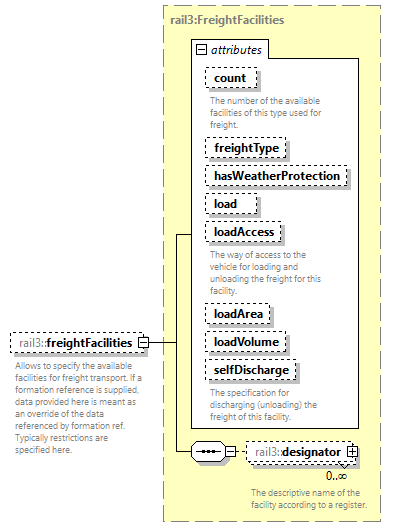 | ||||||||||||||||||||||||||||||||||||||||||||||||||||||||||||
| namespace | https://www.railml.org/schemas/3.2 | ||||||||||||||||||||||||||||||||||||||||||||||||||||||||||||
| type | rail3:FreightFacilities | ||||||||||||||||||||||||||||||||||||||||||||||||||||||||||||
| properties |
| ||||||||||||||||||||||||||||||||||||||||||||||||||||||||||||
| children | rail3:designator | ||||||||||||||||||||||||||||||||||||||||||||||||||||||||||||
| attributes |
| ||||||||||||||||||||||||||||||||||||||||||||||||||||||||||||
| annotation |
| ||||||||||||||||||||||||||||||||||||||||||||||||||||||||||||
| source | <xs:element name="freightFacilities" type="rail3:FreightFacilities" minOccurs="0" maxOccurs="1"> <xs:annotation> <xs:documentation>Allows to specify the available facilities for freight transport. If a formation reference is supplied, data provided here is meant as an override of the data referenced by formation ref. Typically restrictions are specified here.</xs:documentation> </xs:annotation> </xs:element> |
complexType Identifier
| diagram | 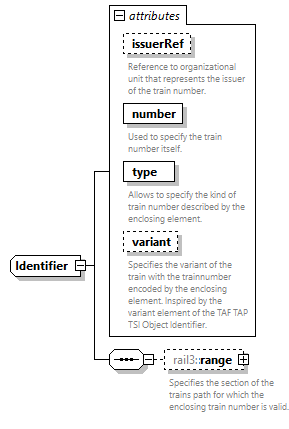 | ||||||||||||||||||||||||||||||||||||||
| namespace | https://www.railml.org/schemas/3.2 | ||||||||||||||||||||||||||||||||||||||
| children | rail3:range | ||||||||||||||||||||||||||||||||||||||
| used by |
| ||||||||||||||||||||||||||||||||||||||
| attributes |
| ||||||||||||||||||||||||||||||||||||||
| source | <xs:complexType name="Identifier"> <xs:sequence> <xs:element name="range" type="rail3:Range" minOccurs="0" maxOccurs="1"> <xs:annotation> <xs:documentation>Specifies the section of the trains path for which the enclosing train number is valid.</xs:documentation> </xs:annotation> </xs:element> </xs:sequence> <xs:attribute name="issuerRef" type="rail3:tRef" use="optional"> <xs:annotation> <xs:documentation>Reference to organizational unit that represents the issuer of the train number.</xs:documentation> </xs:annotation> </xs:attribute> <xs:attribute name="number" type="xs:string" use="required"> <xs:annotation> <xs:documentation>Used to specify the train number itself.</xs:documentation> </xs:annotation> </xs:attribute> <xs:attribute name="type" type="rail3:IdentifierTypeExt" use="required"> <xs:annotation> <xs:documentation>Allows to specify the kind of train number described by the enclosing element.</xs:documentation> </xs:annotation> </xs:attribute> <xs:attribute name="variant" type="xs:string" use="optional"> <xs:annotation> <xs:documentation>Specifies the variant of the train with the trainnumber encoded by the enclosing element. Inspired by the variant element of the TAF TAP TSI Object Identifier.</xs:documentation> </xs:annotation> </xs:attribute> </xs:complexType> |
attribute Identifier/@issuerRef
| type | rail3:tRef | ||
| properties |
| ||
| annotation |
| ||
| source | <xs:attribute name="issuerRef" type="rail3:tRef" use="optional"> <xs:annotation> <xs:documentation>Reference to organizational unit that represents the issuer of the train number.</xs:documentation> </xs:annotation> </xs:attribute> |
attribute Identifier/@number
| type | xs:string | ||
| properties |
| ||
| annotation |
| ||
| source | <xs:attribute name="number" type="xs:string" use="required"> <xs:annotation> <xs:documentation>Used to specify the train number itself.</xs:documentation> </xs:annotation> </xs:attribute> |
attribute Identifier/@type
| type | rail3:IdentifierTypeExt | ||
| properties |
| ||
| annotation |
| ||
| source | <xs:attribute name="type" type="rail3:IdentifierTypeExt" use="required"> <xs:annotation> <xs:documentation>Allows to specify the kind of train number described by the enclosing element.</xs:documentation> </xs:annotation> </xs:attribute> |
attribute Identifier/@variant
| type | xs:string | ||
| properties |
| ||
| annotation |
| ||
| source | <xs:attribute name="variant" type="xs:string" use="optional"> <xs:annotation> <xs:documentation>Specifies the variant of the train with the trainnumber encoded by the enclosing element. Inspired by the variant element of the TAF TAP TSI Object Identifier.</xs:documentation> </xs:annotation> </xs:attribute> |
element Identifier/range
| diagram | 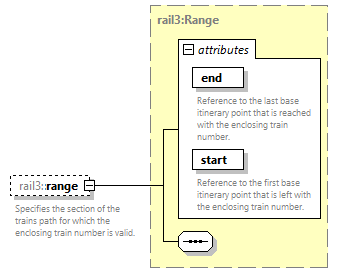 | ||||||||||||||||||||||
| namespace | https://www.railml.org/schemas/3.2 | ||||||||||||||||||||||
| type | rail3:Range | ||||||||||||||||||||||
| properties |
| ||||||||||||||||||||||
| attributes |
| ||||||||||||||||||||||
| annotation |
| ||||||||||||||||||||||
| source | <xs:element name="range" type="rail3:Range" minOccurs="0" maxOccurs="1"> <xs:annotation> <xs:documentation>Specifies the section of the trains path for which the enclosing train number is valid.</xs:documentation> </xs:annotation> </xs:element> |
complexType Identifiers
| diagram |  | ||
| namespace | https://www.railml.org/schemas/3.2 | ||
| children | rail3:identifier | ||
| used by |
| ||
| source | <xs:complexType name="Identifiers"> <xs:sequence> <xs:element name="identifier" type="rail3:Identifier" minOccurs="1" maxOccurs="unbounded"> <xs:annotation> <xs:documentation>Provides information about the identity of the enclosing train.</xs:documentation> </xs:annotation> </xs:element> </xs:sequence> </xs:complexType> |
element Identifiers/identifier
| diagram | 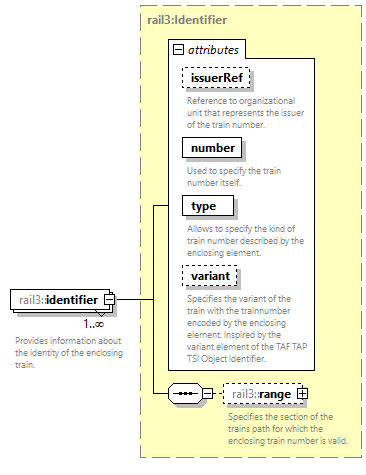 | ||||||||||||||||||||||||||||||||||||||
| namespace | https://www.railml.org/schemas/3.2 | ||||||||||||||||||||||||||||||||||||||
| type | rail3:Identifier | ||||||||||||||||||||||||||||||||||||||
| properties |
| ||||||||||||||||||||||||||||||||||||||
| children | rail3:range | ||||||||||||||||||||||||||||||||||||||
| attributes |
| ||||||||||||||||||||||||||||||||||||||
| annotation |
| ||||||||||||||||||||||||||||||||||||||
| source | <xs:element name="identifier" type="rail3:Identifier" minOccurs="1" maxOccurs="unbounded"> <xs:annotation> <xs:documentation>Provides information about the identity of the enclosing train.</xs:documentation> </xs:annotation> </xs:element> |
complexType IsOnRequest
| diagram |  | ||
| namespace | https://www.railml.org/schemas/3.2 | ||
| used by |
| ||
| source | <xs:complexType name="IsOnRequest"> <xs:sequence/> </xs:complexType> |
complexType ItinerariesTT
| diagram | 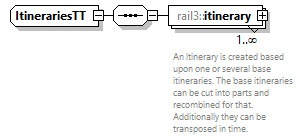 | ||
| namespace | https://www.railml.org/schemas/3.2 | ||
| children | rail3:itinerary | ||
| used by |
| ||
| source | <xs:complexType name="ItinerariesTT"> <xs:sequence> <xs:element name="itinerary" type="rail3:Itinerary" minOccurs="1" maxOccurs="unbounded"> <xs:annotation> <xs:documentation>An Itinerary is created based upon one or several base itineraries. The base itineraries can be cut into parts and recombined for that. Additionally they can be transposed in time.</xs:documentation> </xs:annotation> </xs:element> </xs:sequence> </xs:complexType> |
element ItinerariesTT/itinerary
| diagram | 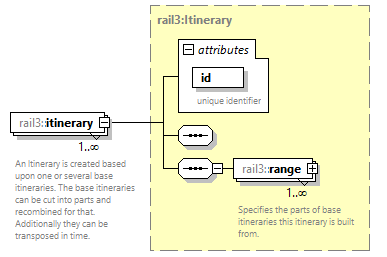 | ||||||||||||||
| namespace | https://www.railml.org/schemas/3.2 | ||||||||||||||
| type | rail3:Itinerary | ||||||||||||||
| properties |
| ||||||||||||||
| children | rail3:range | ||||||||||||||
| attributes |
| ||||||||||||||
| annotation |
| ||||||||||||||
| source | <xs:element name="itinerary" type="rail3:Itinerary" minOccurs="1" maxOccurs="unbounded"> <xs:annotation> <xs:documentation>An Itinerary is created based upon one or several base itineraries. The base itineraries can be cut into parts and recombined for that. Additionally they can be transposed in time.</xs:documentation> </xs:annotation> </xs:element> |
complexType Itinerary
| diagram | 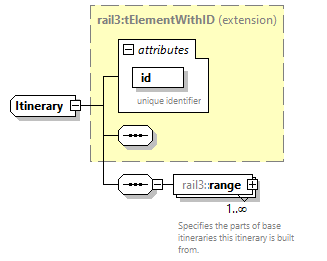 | ||||||||||||||
| namespace | https://www.railml.org/schemas/3.2 | ||||||||||||||
| type | extension of rail3:tElementWithID | ||||||||||||||
| properties |
| ||||||||||||||
| children | rail3:range | ||||||||||||||
| used by |
| ||||||||||||||
| attributes |
| ||||||||||||||
| source | <xs:complexType name="Itinerary"> <xs:complexContent> <xs:extension base="rail3:tElementWithID"> <xs:sequence> <xs:element name="range" type="rail3:ItineraryRange" minOccurs="1" maxOccurs="unbounded"> <xs:annotation> <xs:documentation>Specifies the parts of base itineraries this itinerary is built from.</xs:documentation> </xs:annotation> </xs:element> </xs:sequence> </xs:extension> </xs:complexContent> </xs:complexType> |
element Itinerary/range
| diagram | 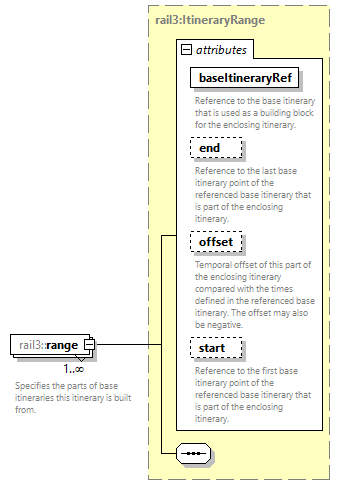 | ||||||||||||||||||||||||||||||||||||||
| namespace | https://www.railml.org/schemas/3.2 | ||||||||||||||||||||||||||||||||||||||
| type | rail3:ItineraryRange | ||||||||||||||||||||||||||||||||||||||
| properties |
| ||||||||||||||||||||||||||||||||||||||
| attributes |
| ||||||||||||||||||||||||||||||||||||||
| annotation |
| ||||||||||||||||||||||||||||||||||||||
| source | <xs:element name="range" type="rail3:ItineraryRange" minOccurs="1" maxOccurs="unbounded"> <xs:annotation> <xs:documentation>Specifies the parts of base itineraries this itinerary is built from.</xs:documentation> </xs:annotation> </xs:element> |
complexType ItineraryRange
| diagram | 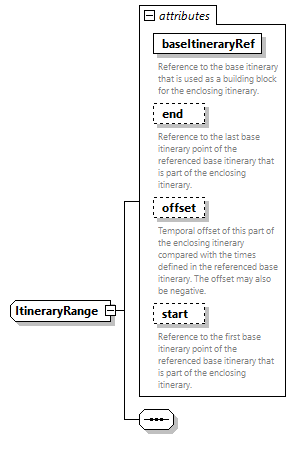 | ||||||||||||||||||||||||||||||||||||||
| namespace | https://www.railml.org/schemas/3.2 | ||||||||||||||||||||||||||||||||||||||
| used by |
| ||||||||||||||||||||||||||||||||||||||
| attributes |
| ||||||||||||||||||||||||||||||||||||||
| source | <xs:complexType name="ItineraryRange"> <xs:sequence/> <xs:attribute name="baseItineraryRef" type="rail3:tRef" use="required"> <xs:annotation> <xs:documentation>Reference to the base itinerary that is used as a building block for the enclosing itinerary.</xs:documentation> </xs:annotation> </xs:attribute> <xs:attribute name="end" type="rail3:tRef" use="optional"> <xs:annotation> <xs:documentation>Reference to the last base itinerary point of the referenced base itinerary that is part of the enclosing itinerary.</xs:documentation> </xs:annotation> </xs:attribute> <xs:attribute name="offset" type="xs:duration" use="optional"> <xs:annotation> <xs:documentation>Temporal offset of this part of the enclosing itinerary compared with the times defined in the referenced base itinerary. The offset may also be negative.</xs:documentation> </xs:annotation> </xs:attribute> <xs:attribute name="start" type="rail3:tRef" use="optional"> <xs:annotation> <xs:documentation>Reference to the first base itinerary point of the referenced base itinerary that is part of the enclosing itinerary.</xs:documentation> </xs:annotation> </xs:attribute> </xs:complexType> |
attribute ItineraryRange/@baseItineraryRef
| type | rail3:tRef | ||
| properties |
| ||
| annotation |
| ||
| source | <xs:attribute name="baseItineraryRef" type="rail3:tRef" use="required"> <xs:annotation> <xs:documentation>Reference to the base itinerary that is used as a building block for the enclosing itinerary.</xs:documentation> </xs:annotation> </xs:attribute> |
attribute ItineraryRange/@end
| type | rail3:tRef | ||
| properties |
| ||
| annotation |
| ||
| source | <xs:attribute name="end" type="rail3:tRef" use="optional"> <xs:annotation> <xs:documentation>Reference to the last base itinerary point of the referenced base itinerary that is part of the enclosing itinerary.</xs:documentation> </xs:annotation> </xs:attribute> |
attribute ItineraryRange/@offset
| type | xs:duration | ||
| properties |
| ||
| annotation |
| ||
| source | <xs:attribute name="offset" type="xs:duration" use="optional"> <xs:annotation> <xs:documentation>Temporal offset of this part of the enclosing itinerary compared with the times defined in the referenced base itinerary. The offset may also be negative.</xs:documentation> </xs:annotation> </xs:attribute> |
attribute ItineraryRange/@start
| type | rail3:tRef | ||
| properties |
| ||
| annotation |
| ||
| source | <xs:attribute name="start" type="rail3:tRef" use="optional"> <xs:annotation> <xs:documentation>Reference to the first base itinerary point of the referenced base itinerary that is part of the enclosing itinerary.</xs:documentation> </xs:annotation> </xs:attribute> |
complexType LineRef
| diagram | 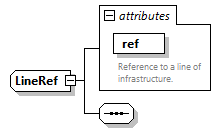 | ||||||||||||||
| namespace | https://www.railml.org/schemas/3.2 | ||||||||||||||
| used by |
| ||||||||||||||
| attributes |
| ||||||||||||||
| source | <xs:complexType name="LineRef"> <xs:sequence/> <xs:attribute name="ref" type="rail3:tRef" use="required"> <xs:annotation> <xs:documentation>Reference to a line of infrastructure.</xs:documentation> </xs:annotation> </xs:attribute> </xs:complexType> |
attribute LineRef/@ref
| type | rail3:tRef | ||
| properties |
| ||
| annotation |
| ||
| source | <xs:attribute name="ref" type="rail3:tRef" use="required"> <xs:annotation> <xs:documentation>Reference to a line of infrastructure.</xs:documentation> </xs:annotation> </xs:attribute> |
complexType LocationInfo
| diagram | 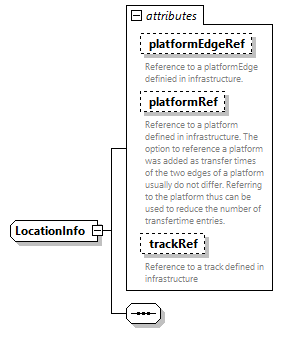 | ||||||||||||||||||||||||||||||
| namespace | https://www.railml.org/schemas/3.2 | ||||||||||||||||||||||||||||||
| used by |
| ||||||||||||||||||||||||||||||
| attributes |
| ||||||||||||||||||||||||||||||
| source | <xs:complexType name="LocationInfo"> <xs:sequence/> <xs:attribute name="platformEdgeRef" type="rail3:tRef" use="optional"> <xs:annotation> <xs:documentation>Reference to a platformEdge definied in infrastructure.</xs:documentation> </xs:annotation> </xs:attribute> <xs:attribute name="platformRef" type="rail3:tRef" use="optional"> <xs:annotation> <xs:documentation>Reference to a platform defined in infrastructure. The option to reference a platform was added as transfer times of the two edges of a platform usually do not differ. Referring to the platform thus can be used to reduce the number of transfertime entries.</xs:documentation> </xs:annotation> </xs:attribute> <xs:attribute name="trackRef" type="rail3:tRef" use="optional"> <xs:annotation> <xs:documentation>Reference to a track defined in infrastructure</xs:documentation> </xs:annotation> </xs:attribute> </xs:complexType> |
attribute LocationInfo/@platformEdgeRef
| type | rail3:tRef | ||
| properties |
| ||
| annotation |
| ||
| source | <xs:attribute name="platformEdgeRef" type="rail3:tRef" use="optional"> <xs:annotation> <xs:documentation>Reference to a platformEdge definied in infrastructure.</xs:documentation> </xs:annotation> </xs:attribute> |
attribute LocationInfo/@platformRef
| type | rail3:tRef | ||
| properties |
| ||
| annotation |
| ||
| source | <xs:attribute name="platformRef" type="rail3:tRef" use="optional"> <xs:annotation> <xs:documentation>Reference to a platform defined in infrastructure. The option to reference a platform was added as transfer times of the two edges of a platform usually do not differ. Referring to the platform thus can be used to reduce the number of transfertime entries.</xs:documentation> </xs:annotation> </xs:attribute> |
attribute LocationInfo/@trackRef
| type | rail3:tRef | ||
| properties |
| ||
| annotation |
| ||
| source | <xs:attribute name="trackRef" type="rail3:tRef" use="optional"> <xs:annotation> <xs:documentation>Reference to a track defined in infrastructure</xs:documentation> </xs:annotation> </xs:attribute> |
complexType LocationReference
| diagram | 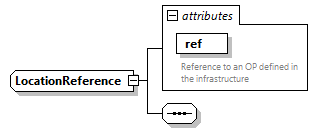 | ||||||||||||||
| namespace | https://www.railml.org/schemas/3.2 | ||||||||||||||
| used by |
| ||||||||||||||
| attributes |
| ||||||||||||||
| source | <xs:complexType name="LocationReference"> <xs:sequence/> <xs:attribute name="ref" type="rail3:tRef" use="required"> <xs:annotation> <xs:documentation>Reference to an OP defined in the infrastructure</xs:documentation> </xs:annotation> </xs:attribute> </xs:complexType> |
attribute LocationReference/@ref
| type | rail3:tRef | ||
| properties |
| ||
| annotation |
| ||
| source | <xs:attribute name="ref" type="rail3:tRef" use="required"> <xs:annotation> <xs:documentation>Reference to an OP defined in the infrastructure</xs:documentation> </xs:annotation> </xs:attribute> |
complexType MediaCategories
| diagram |  | ||
| namespace | https://www.railml.org/schemas/3.2 | ||
| children | rail3:mediaCategory | ||
| used by |
| ||
| source | <xs:complexType name="MediaCategories"> <xs:sequence> <xs:element name="mediaCategory" type="rail3:MediaCategory" minOccurs="1" maxOccurs="unbounded"> <xs:annotation> <xs:documentation>A media category groups passenger information resources.</xs:documentation> </xs:annotation> </xs:element> </xs:sequence> </xs:complexType> |
element MediaCategories/mediaCategory
| diagram | 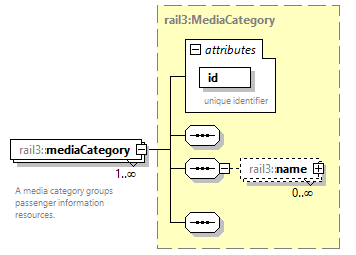 | ||||||||||||||
| namespace | https://www.railml.org/schemas/3.2 | ||||||||||||||
| type | rail3:MediaCategory | ||||||||||||||
| properties |
| ||||||||||||||
| children | rail3:name | ||||||||||||||
| attributes |
| ||||||||||||||
| annotation |
| ||||||||||||||
| source | <xs:element name="mediaCategory" type="rail3:MediaCategory" minOccurs="1" maxOccurs="unbounded"> <xs:annotation> <xs:documentation>A media category groups passenger information resources.</xs:documentation> </xs:annotation> </xs:element> |
complexType MediaCategory
| diagram | 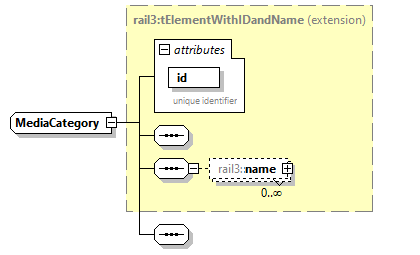 | ||||||||||||||
| namespace | https://www.railml.org/schemas/3.2 | ||||||||||||||
| type | extension of rail3:tElementWithIDandName | ||||||||||||||
| properties |
| ||||||||||||||
| children | rail3:name | ||||||||||||||
| used by |
| ||||||||||||||
| attributes |
| ||||||||||||||
| source | <xs:complexType name="MediaCategory"> <xs:complexContent> <xs:extension base="rail3:tElementWithIDandName"> <xs:sequence/> </xs:extension> </xs:complexContent> </xs:complexType> |
complexType MediaResources
| diagram | 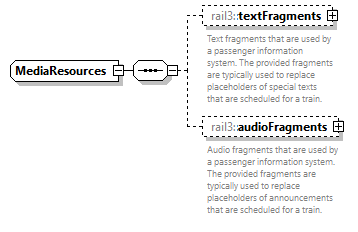 | ||
| namespace | https://www.railml.org/schemas/3.2 | ||
| children | rail3:textFragments rail3:audioFragments | ||
| used by |
| ||
| source | <xs:complexType name="MediaResources"> <xs:sequence> <xs:element name="textFragments" type="rail3:TextFragments" minOccurs="0" maxOccurs="1"> <xs:annotation> <xs:documentation>Text fragments that are used by a passenger information system. The provided fragments are typically used to replace placeholders of special texts that are scheduled for a train.</xs:documentation> </xs:annotation> </xs:element> <xs:element name="audioFragments" type="rail3:AudioFragments" minOccurs="0" maxOccurs="1"> <xs:annotation> <xs:documentation>Audio fragments that are used by a passenger information system. The provided fragments are typically used to replace placeholders of announcements that are scheduled for a train.</xs:documentation> </xs:annotation> </xs:element> </xs:sequence> </xs:complexType> |
element MediaResources/textFragments
| diagram | 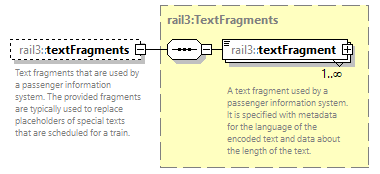 | ||||||
| namespace | https://www.railml.org/schemas/3.2 | ||||||
| type | rail3:TextFragments | ||||||
| properties |
| ||||||
| children | rail3:textFragment | ||||||
| annotation |
| ||||||
| source | <xs:element name="textFragments" type="rail3:TextFragments" minOccurs="0" maxOccurs="1"> <xs:annotation> <xs:documentation>Text fragments that are used by a passenger information system. The provided fragments are typically used to replace placeholders of special texts that are scheduled for a train.</xs:documentation> </xs:annotation> </xs:element> |
element MediaResources/audioFragments
| diagram | 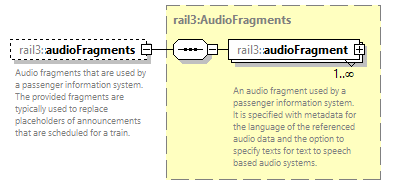 | ||||||
| namespace | https://www.railml.org/schemas/3.2 | ||||||
| type | rail3:AudioFragments | ||||||
| properties |
| ||||||
| children | rail3:audioFragment | ||||||
| annotation |
| ||||||
| source | <xs:element name="audioFragments" type="rail3:AudioFragments" minOccurs="0" maxOccurs="1"> <xs:annotation> <xs:documentation>Audio fragments that are used by a passenger information system. The provided fragments are typically used to replace placeholders of announcements that are scheduled for a train.</xs:documentation> </xs:annotation> </xs:element> |
complexType MinimalTime
| diagram | 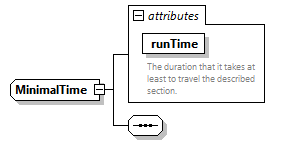 | ||||||||||||||
| namespace | https://www.railml.org/schemas/3.2 | ||||||||||||||
| used by |
| ||||||||||||||
| attributes |
| ||||||||||||||
| source | <xs:complexType name="MinimalTime"> <xs:sequence/> <xs:attribute name="runTime" type="xs:duration" use="required"> <xs:annotation> <xs:documentation>The duration that it takes at least to travel the described section.</xs:documentation> </xs:annotation> </xs:attribute> </xs:complexType> |
attribute MinimalTime/@runTime
| type | xs:duration | ||
| properties |
| ||
| annotation |
| ||
| source | <xs:attribute name="runTime" type="xs:duration" use="required"> <xs:annotation> <xs:documentation>The duration that it takes at least to travel the described section.</xs:documentation> </xs:annotation> </xs:attribute> |
complexType OperatingDayValidity
| diagram | 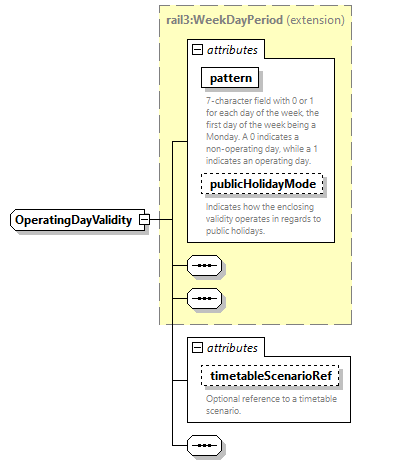 | ||||||||||||||||||||||||||||||
| namespace | https://www.railml.org/schemas/3.2 | ||||||||||||||||||||||||||||||
| type | extension of rail3:WeekDayPeriod | ||||||||||||||||||||||||||||||
| properties |
| ||||||||||||||||||||||||||||||
| used by |
| ||||||||||||||||||||||||||||||
| attributes |
| ||||||||||||||||||||||||||||||
| source | <xs:complexType name="OperatingDayValidity"> <xs:complexContent> <xs:extension base="rail3:WeekDayPeriod"> <xs:sequence/> <xs:attribute name="timetableScenarioRef" type="rail3:tRef" use="optional"> <xs:annotation> <xs:documentation>Optional reference to a timetable scenario.</xs:documentation> </xs:annotation> </xs:attribute> </xs:extension> </xs:complexContent> </xs:complexType> |
attribute OperatingDayValidity/@timetableScenarioRef
| type | rail3:tRef | ||
| properties |
| ||
| annotation |
| ||
| source | <xs:attribute name="timetableScenarioRef" type="rail3:tRef" use="optional"> <xs:annotation> <xs:documentation>Optional reference to a timetable scenario.</xs:documentation> </xs:annotation> </xs:attribute> |
complexType OperationalConnection
| diagram | 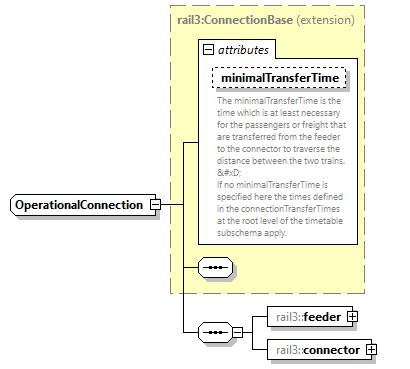 | ||||||||||||||
| namespace | https://www.railml.org/schemas/3.2 | ||||||||||||||
| type | extension of rail3:ConnectionBase | ||||||||||||||
| properties |
| ||||||||||||||
| children | rail3:feeder rail3:connector | ||||||||||||||
| used by |
| ||||||||||||||
| attributes |
| ||||||||||||||
| source | <xs:complexType name="OperationalConnection"> <xs:complexContent> <xs:extension base="rail3:ConnectionBase"> <xs:sequence> <xs:element name="feeder" type="rail3:OperationalConnectionFeeder" minOccurs="1" maxOccurs="1"/> <xs:element name="connector" type="rail3:OperationalConnectionConnector" minOccurs="1" maxOccurs="1"/> </xs:sequence> </xs:extension> </xs:complexContent> </xs:complexType> |
element OperationalConnection/feeder
| diagram | 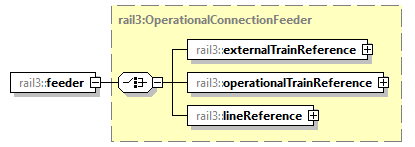 | ||
| namespace | https://www.railml.org/schemas/3.2 | ||
| type | rail3:OperationalConnectionFeeder | ||
| properties |
| ||
| children | rail3:externalTrainReference rail3:operationalTrainReference rail3:lineReference | ||
| source | <xs:element name="feeder" type="rail3:OperationalConnectionFeeder" minOccurs="1" maxOccurs="1"/> |
element OperationalConnection/connector
| diagram | 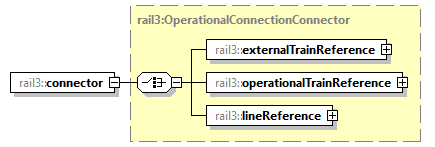 | ||
| namespace | https://www.railml.org/schemas/3.2 | ||
| type | rail3:OperationalConnectionConnector | ||
| properties |
| ||
| children | rail3:externalTrainReference rail3:operationalTrainReference rail3:lineReference | ||
| source | <xs:element name="connector" type="rail3:OperationalConnectionConnector" minOccurs="1" maxOccurs="1"/> |
complexType OperationalConnectionConnector
| diagram |  | ||
| namespace | https://www.railml.org/schemas/3.2 | ||
| children | rail3:externalTrainReference rail3:operationalTrainReference rail3:lineReference | ||
| used by |
| ||
| source | <xs:complexType name="OperationalConnectionConnector"> <xs:choice> <xs:element name="externalTrainReference" type="rail3:ExternalTrainReference" minOccurs="1" maxOccurs="1"/> <xs:element name="operationalTrainReference" type="rail3:OperationalTrainVariantReference" minOccurs="1" maxOccurs="1"/> <xs:element name="lineReference" type="rail3:TransportServiceReference" minOccurs="1" maxOccurs="1"/> </xs:choice> </xs:complexType> |
element OperationalConnectionConnector/externalTrainReference
| diagram | 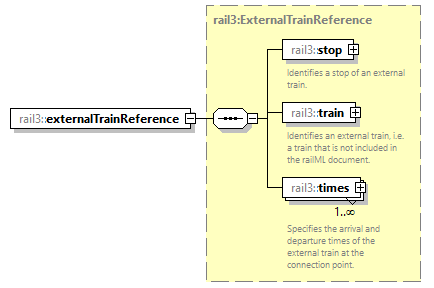 | ||
| namespace | https://www.railml.org/schemas/3.2 | ||
| type | rail3:ExternalTrainReference | ||
| properties |
| ||
| children | rail3:stop rail3:train rail3:times | ||
| source | <xs:element name="externalTrainReference" type="rail3:ExternalTrainReference" minOccurs="1" maxOccurs="1"/> |
element OperationalConnectionConnector/operationalTrainReference
| diagram | 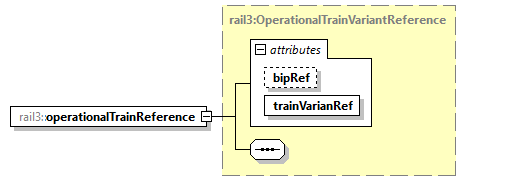 | ||||||||||||||||||
| namespace | https://www.railml.org/schemas/3.2 | ||||||||||||||||||
| type | rail3:OperationalTrainVariantReference | ||||||||||||||||||
| properties |
| ||||||||||||||||||
| attributes |
| ||||||||||||||||||
| source | <xs:element name="operationalTrainReference" type="rail3:OperationalTrainVariantReference" minOccurs="1" maxOccurs="1"/> |
element OperationalConnectionConnector/lineReference
| diagram | 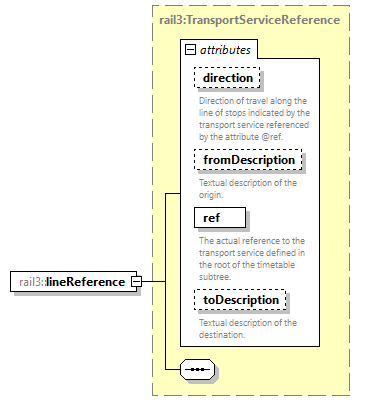 | ||||||||||||||||||||||||||||||||||||||
| namespace | https://www.railml.org/schemas/3.2 | ||||||||||||||||||||||||||||||||||||||
| type | rail3:TransportServiceReference | ||||||||||||||||||||||||||||||||||||||
| properties |
| ||||||||||||||||||||||||||||||||||||||
| attributes |
| ||||||||||||||||||||||||||||||||||||||
| source | <xs:element name="lineReference" type="rail3:TransportServiceReference" minOccurs="1" maxOccurs="1"/> |
complexType OperationalConnectionFeeder
| diagram |  | ||
| namespace | https://www.railml.org/schemas/3.2 | ||
| children | rail3:externalTrainReference rail3:operationalTrainReference rail3:lineReference | ||
| used by |
| ||
| source | <xs:complexType name="OperationalConnectionFeeder"> <xs:choice> <xs:element name="externalTrainReference" type="rail3:ExternalTrainReference" minOccurs="1" maxOccurs="1"/> <xs:element name="operationalTrainReference" type="rail3:OperationalTrainVariantReference" minOccurs="1" maxOccurs="1"/> <xs:element name="lineReference" type="rail3:TransportServiceReference" minOccurs="1" maxOccurs="1"/> </xs:choice> </xs:complexType> |
element OperationalConnectionFeeder/externalTrainReference
| diagram | 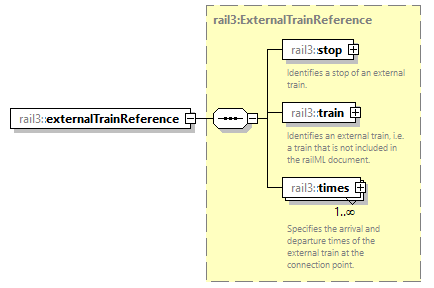 | ||
| namespace | https://www.railml.org/schemas/3.2 | ||
| type | rail3:ExternalTrainReference | ||
| properties |
| ||
| children | rail3:stop rail3:train rail3:times | ||
| source | <xs:element name="externalTrainReference" type="rail3:ExternalTrainReference" minOccurs="1" maxOccurs="1"/> |
element OperationalConnectionFeeder/operationalTrainReference
| diagram | 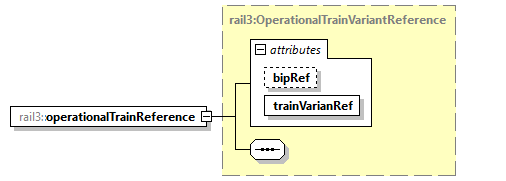 | ||||||||||||||||||
| namespace | https://www.railml.org/schemas/3.2 | ||||||||||||||||||
| type | rail3:OperationalTrainVariantReference | ||||||||||||||||||
| properties |
| ||||||||||||||||||
| attributes |
| ||||||||||||||||||
| source | <xs:element name="operationalTrainReference" type="rail3:OperationalTrainVariantReference" minOccurs="1" maxOccurs="1"/> |
element OperationalConnectionFeeder/lineReference
| diagram | 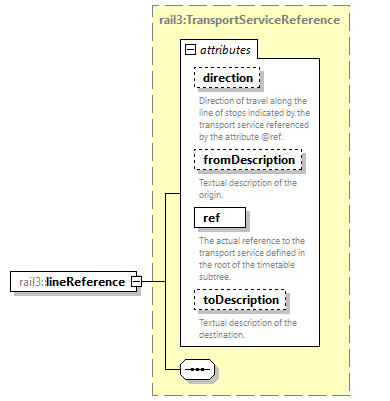 | ||||||||||||||||||||||||||||||||||||||
| namespace | https://www.railml.org/schemas/3.2 | ||||||||||||||||||||||||||||||||||||||
| type | rail3:TransportServiceReference | ||||||||||||||||||||||||||||||||||||||
| properties |
| ||||||||||||||||||||||||||||||||||||||
| attributes |
| ||||||||||||||||||||||||||||||||||||||
| source | <xs:element name="lineReference" type="rail3:TransportServiceReference" minOccurs="1" maxOccurs="1"/> |
complexType OperationalConnections
| diagram |  |
| namespace | https://www.railml.org/schemas/3.2 |
| children | rail3:operationalConnection |
| source | <xs:complexType name="OperationalConnections"> <xs:sequence> <xs:element name="operationalConnection" type="rail3:OperationalConnection" minOccurs="1" maxOccurs="unbounded"/> </xs:sequence> </xs:complexType> |
element OperationalConnections/operationalConnection
| diagram | 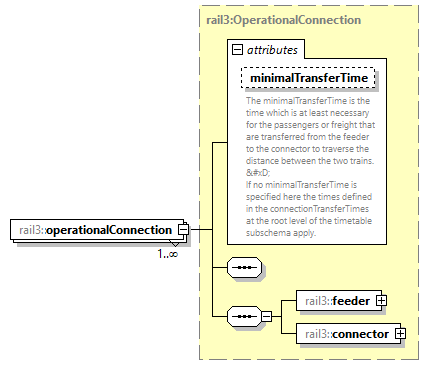 | ||||||||||||||
| namespace | https://www.railml.org/schemas/3.2 | ||||||||||||||
| type | rail3:OperationalConnection | ||||||||||||||
| properties |
| ||||||||||||||
| children | rail3:feeder rail3:connector | ||||||||||||||
| attributes |
| ||||||||||||||
| source | <xs:element name="operationalConnection" type="rail3:OperationalConnection" minOccurs="1" maxOccurs="unbounded"/> |
complexType OperationalIM
| diagram |  | ||
| namespace | https://www.railml.org/schemas/3.2 | ||
| used by |
| ||
| annotation |
| ||
| source | <xs:complexType name="OperationalIM"> <xs:annotation> <xs:documentation>Necessary for operational purposes of the IM</xs:documentation> </xs:annotation> <xs:sequence/> </xs:complexType> |
complexType OperationalRange
| diagram | 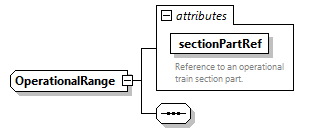 | ||||||||||||||
| namespace | https://www.railml.org/schemas/3.2 | ||||||||||||||
| used by |
| ||||||||||||||
| attributes |
| ||||||||||||||
| source | <xs:complexType name="OperationalRange"> <xs:sequence/> <xs:attribute name="sectionPartRef" type="rail3:tRef" use="required"> <xs:annotation> <xs:documentation>Reference to an operational train section part.</xs:documentation> </xs:annotation> </xs:attribute> </xs:complexType> |
attribute OperationalRange/@sectionPartRef
| type | rail3:tRef | ||
| properties |
| ||
| annotation |
| ||
| source | <xs:attribute name="sectionPartRef" type="rail3:tRef" use="required"> <xs:annotation> <xs:documentation>Reference to an operational train section part.</xs:documentation> </xs:annotation> </xs:attribute> |
complexType OperationalRU
| diagram |  | ||
| namespace | https://www.railml.org/schemas/3.2 | ||
| used by |
| ||
| annotation |
| ||
| source | <xs:complexType name="OperationalRU"> <xs:annotation> <xs:documentation>Necessary for operational purposes of the RU</xs:documentation> </xs:annotation> <xs:sequence/> </xs:complexType> |
complexType OperationalTrain
| diagram | 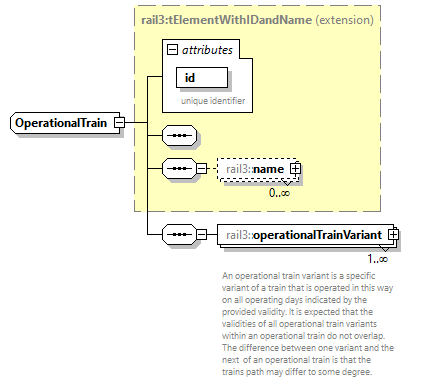 | ||||||||||||||
| namespace | https://www.railml.org/schemas/3.2 | ||||||||||||||
| type | extension of rail3:tElementWithIDandName | ||||||||||||||
| properties |
| ||||||||||||||
| children | rail3:name rail3:operationalTrainVariant | ||||||||||||||
| used by |
| ||||||||||||||
| attributes |
| ||||||||||||||
| source | <xs:complexType name="OperationalTrain"> <xs:complexContent> <xs:extension base="rail3:tElementWithIDandName"> <xs:sequence> <xs:element name="operationalTrainVariant" type="rail3:OperationalTrainVariant" minOccurs="1" maxOccurs="unbounded"> <xs:annotation> <xs:documentation>An operational train variant is a specific variant of a train that is operated in this way on all operating days indicated by the provided validity. It is expected that the validities of all operational train variants within an operational train do not overlap. The difference between one variant and the next of an operational train is that the trains path may differ to some degree.</xs:documentation> </xs:annotation> </xs:element> </xs:sequence> </xs:extension> </xs:complexContent> </xs:complexType> |
element OperationalTrain/operationalTrainVariant
| diagram | 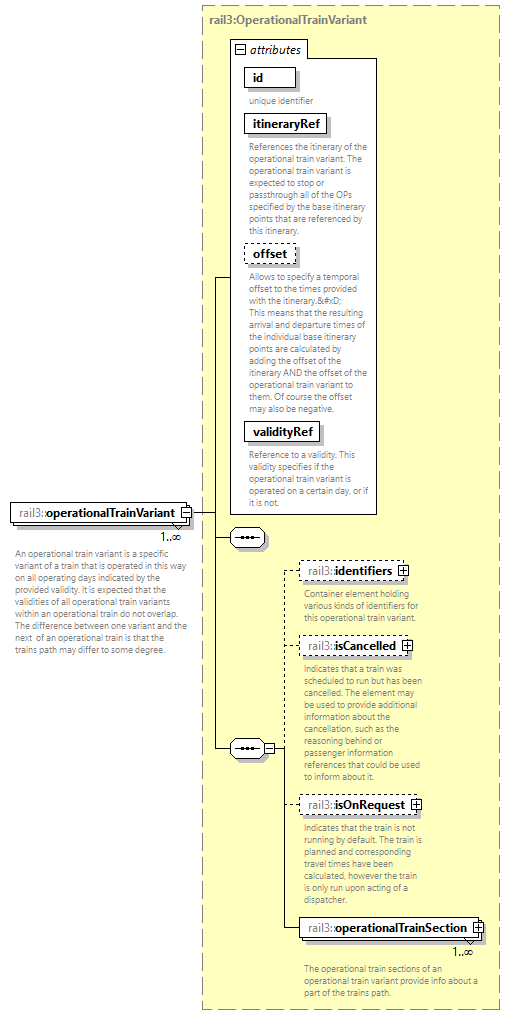 | ||||||||||||||||||||||||||||||||||||||
| namespace | https://www.railml.org/schemas/3.2 | ||||||||||||||||||||||||||||||||||||||
| type | rail3:OperationalTrainVariant | ||||||||||||||||||||||||||||||||||||||
| properties |
| ||||||||||||||||||||||||||||||||||||||
| children | rail3:identifiers rail3:isCancelled rail3:isOnRequest rail3:operationalTrainSection | ||||||||||||||||||||||||||||||||||||||
| attributes |
| ||||||||||||||||||||||||||||||||||||||
| annotation |
| ||||||||||||||||||||||||||||||||||||||
| source | <xs:element name="operationalTrainVariant" type="rail3:OperationalTrainVariant" minOccurs="1" maxOccurs="unbounded"> <xs:annotation> <xs:documentation>An operational train variant is a specific variant of a train that is operated in this way on all operating days indicated by the provided validity. It is expected that the validities of all operational train variants within an operational train do not overlap. The difference between one variant and the next of an operational train is that the trains path may differ to some degree.</xs:documentation> </xs:annotation> </xs:element> |
complexType OperationalTrains
| diagram | 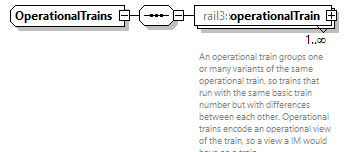 | ||
| namespace | https://www.railml.org/schemas/3.2 | ||
| children | rail3:operationalTrain | ||
| used by |
| ||
| source | <xs:complexType name="OperationalTrains"> <xs:sequence> <xs:element name="operationalTrain" type="rail3:OperationalTrain" minOccurs="1" maxOccurs="unbounded"> <xs:annotation> <xs:documentation>An operational train groups one or many variants of the same operational train, so trains that run with the same basic train number but with differences between each other. Operational trains encode an operational view of the train, so a view a IM would have on a train.</xs:documentation> </xs:annotation> </xs:element> </xs:sequence> </xs:complexType> |
element OperationalTrains/operationalTrain
| diagram | 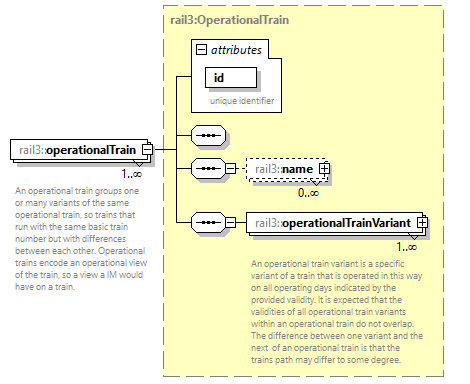 | ||||||||||||||
| namespace | https://www.railml.org/schemas/3.2 | ||||||||||||||
| type | rail3:OperationalTrain | ||||||||||||||
| properties |
| ||||||||||||||
| children | rail3:name rail3:operationalTrainVariant | ||||||||||||||
| attributes |
| ||||||||||||||
| annotation |
| ||||||||||||||
| source | <xs:element name="operationalTrain" type="rail3:OperationalTrain" minOccurs="1" maxOccurs="unbounded"> <xs:annotation> <xs:documentation>An operational train groups one or many variants of the same operational train, so trains that run with the same basic train number but with differences between each other. Operational trains encode an operational view of the train, so a view a IM would have on a train.</xs:documentation> </xs:annotation> </xs:element> |
complexType OperationalTrainSection
| diagram | 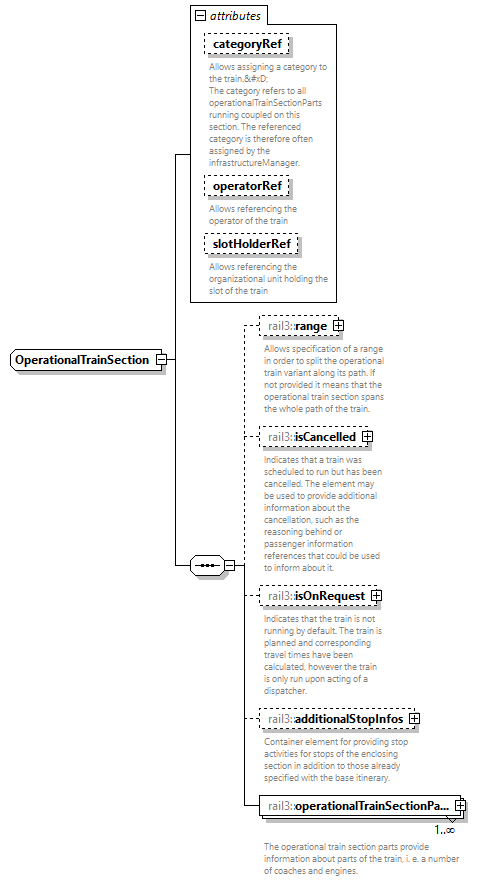 | ||||||||||||||||||||||||||||||
| namespace | https://www.railml.org/schemas/3.2 | ||||||||||||||||||||||||||||||
| children | rail3:range rail3:isCancelled rail3:isOnRequest rail3:additionalStopInfos rail3:operationalTrainSectionPart | ||||||||||||||||||||||||||||||
| used by |
| ||||||||||||||||||||||||||||||
| attributes |
| ||||||||||||||||||||||||||||||
| source | <xs:complexType name="OperationalTrainSection"> <xs:sequence> <xs:element name="range" type="rail3:Range" minOccurs="0" maxOccurs="1"> <xs:annotation> <xs:documentation>Allows specification of a range in order to split the operational train variant along its path. If not provided it means that the operational train section spans the whole path of the train.</xs:documentation> </xs:annotation> </xs:element> <xs:element name="isCancelled" type="rail3:CancellationInfo" minOccurs="0" maxOccurs="1"> <xs:annotation> <xs:documentation>Indicates that a train was scheduled to run but has been cancelled. The element may be used to provide additional information about the cancellation, such as the reasoning behind or passenger information references that could be used to inform about it.</xs:documentation> </xs:annotation> </xs:element> <xs:element name="isOnRequest" type="rail3:IsOnRequest" minOccurs="0" maxOccurs="1"> <xs:annotation> <xs:documentation>Indicates that the train is not running by default. The train is planned and corresponding travel times have been calculated, however the train is only run upon acting of a dispatcher.</xs:documentation> </xs:annotation> </xs:element> <xs:element name="additionalStopInfos" type="rail3:ExtendedAdditionalStopInfos" minOccurs="0" maxOccurs="1"> <xs:annotation> <xs:documentation>Container element for providing stop activities for stops of the enclosing section in addition to those already specified with the base itinerary.</xs:documentation> </xs:annotation> </xs:element> <xs:element name="operationalTrainSectionPart" type="rail3:OperationalTrainSectionPart" minOccurs="1" maxOccurs="unbounded"> <xs:annotation> <xs:documentation>The operational train section parts provide information about parts of the train, i. e. a number of coaches and engines.</xs:documentation> </xs:annotation> </xs:element> </xs:sequence> <xs:attribute name="categoryRef" type="rail3:tRef" use="optional"> <xs:annotation> <xs:documentation>Allows assigning a category to the train.
 The category refers to all operationalTrainSectionParts running coupled on this section. The referenced category is therefore often assigned by the infrastructureManager.</xs:documentation> </xs:annotation> </xs:attribute> <xs:attribute name="operatorRef" type="rail3:tRef" use="optional"> <xs:annotation> <xs:documentation>Allows referencing the operator of the train</xs:documentation> </xs:annotation> </xs:attribute> <xs:attribute name="slotHolderRef" type="rail3:tRef" use="optional"> <xs:annotation> <xs:documentation>Allows referencing the organizational unit holding the slot of the train</xs:documentation> </xs:annotation> </xs:attribute> </xs:complexType> |
attribute OperationalTrainSection/@categoryRef
| type | rail3:tRef | ||
| properties |
| ||
| annotation |
| ||
| source | <xs:attribute name="categoryRef" type="rail3:tRef" use="optional"> <xs:annotation> <xs:documentation>Allows assigning a category to the train.
 The category refers to all operationalTrainSectionParts running coupled on this section. The referenced category is therefore often assigned by the infrastructureManager.</xs:documentation> </xs:annotation> </xs:attribute> |
attribute OperationalTrainSection/@operatorRef
| type | rail3:tRef | ||
| properties |
| ||
| annotation |
| ||
| source | <xs:attribute name="operatorRef" type="rail3:tRef" use="optional"> <xs:annotation> <xs:documentation>Allows referencing the operator of the train</xs:documentation> </xs:annotation> </xs:attribute> |
attribute OperationalTrainSection/@slotHolderRef
| type | rail3:tRef | ||
| properties |
| ||
| annotation |
| ||
| source | <xs:attribute name="slotHolderRef" type="rail3:tRef" use="optional"> <xs:annotation> <xs:documentation>Allows referencing the organizational unit holding the slot of the train</xs:documentation> </xs:annotation> </xs:attribute> |
element OperationalTrainSection/range
| diagram | 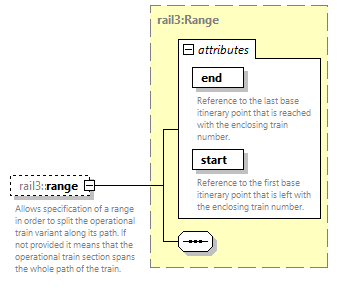 | ||||||||||||||||||||||
| namespace | https://www.railml.org/schemas/3.2 | ||||||||||||||||||||||
| type | rail3:Range | ||||||||||||||||||||||
| properties |
| ||||||||||||||||||||||
| attributes |
| ||||||||||||||||||||||
| annotation |
| ||||||||||||||||||||||
| source | <xs:element name="range" type="rail3:Range" minOccurs="0" maxOccurs="1"> <xs:annotation> <xs:documentation>Allows specification of a range in order to split the operational train variant along its path. If not provided it means that the operational train section spans the whole path of the train.</xs:documentation> </xs:annotation> </xs:element> |
element OperationalTrainSection/isCancelled
| diagram | 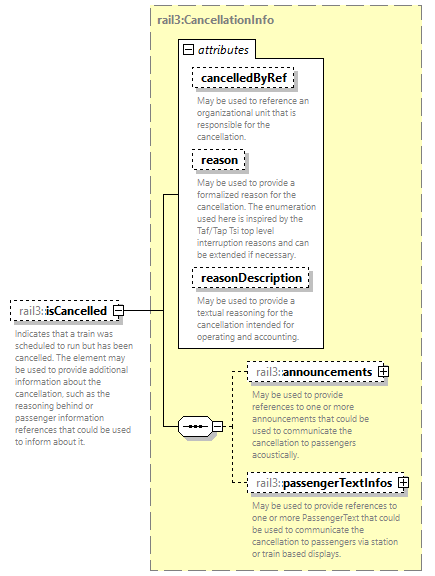 | ||||||||||||||||||||||||||||||
| namespace | https://www.railml.org/schemas/3.2 | ||||||||||||||||||||||||||||||
| type | rail3:CancellationInfo | ||||||||||||||||||||||||||||||
| properties |
| ||||||||||||||||||||||||||||||
| children | rail3:announcements rail3:passengerTextInfos | ||||||||||||||||||||||||||||||
| attributes |
| ||||||||||||||||||||||||||||||
| annotation |
| ||||||||||||||||||||||||||||||
| source | <xs:element name="isCancelled" type="rail3:CancellationInfo" minOccurs="0" maxOccurs="1"> <xs:annotation> <xs:documentation>Indicates that a train was scheduled to run but has been cancelled. The element may be used to provide additional information about the cancellation, such as the reasoning behind or passenger information references that could be used to inform about it.</xs:documentation> </xs:annotation> </xs:element> |
element OperationalTrainSection/isOnRequest
| diagram | 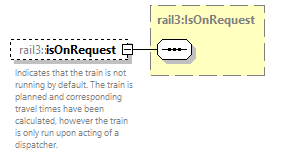 | ||||||
| namespace | https://www.railml.org/schemas/3.2 | ||||||
| type | rail3:IsOnRequest | ||||||
| properties |
| ||||||
| annotation |
| ||||||
| source | <xs:element name="isOnRequest" type="rail3:IsOnRequest" minOccurs="0" maxOccurs="1"> <xs:annotation> <xs:documentation>Indicates that the train is not running by default. The train is planned and corresponding travel times have been calculated, however the train is only run upon acting of a dispatcher.</xs:documentation> </xs:annotation> </xs:element> |
element OperationalTrainSection/additionalStopInfos
| diagram |  | ||||||
| namespace | https://www.railml.org/schemas/3.2 | ||||||
| type | rail3:ExtendedAdditionalStopInfos | ||||||
| properties |
| ||||||
| children | rail3:additionalStopInfo | ||||||
| annotation |
| ||||||
| source | <xs:element name="additionalStopInfos" type="rail3:ExtendedAdditionalStopInfos" minOccurs="0" maxOccurs="1"> <xs:annotation> <xs:documentation>Container element for providing stop activities for stops of the enclosing section in addition to those already specified with the base itinerary.</xs:documentation> </xs:annotation> </xs:element> |
element OperationalTrainSection/operationalTrainSectionPart
| diagram | 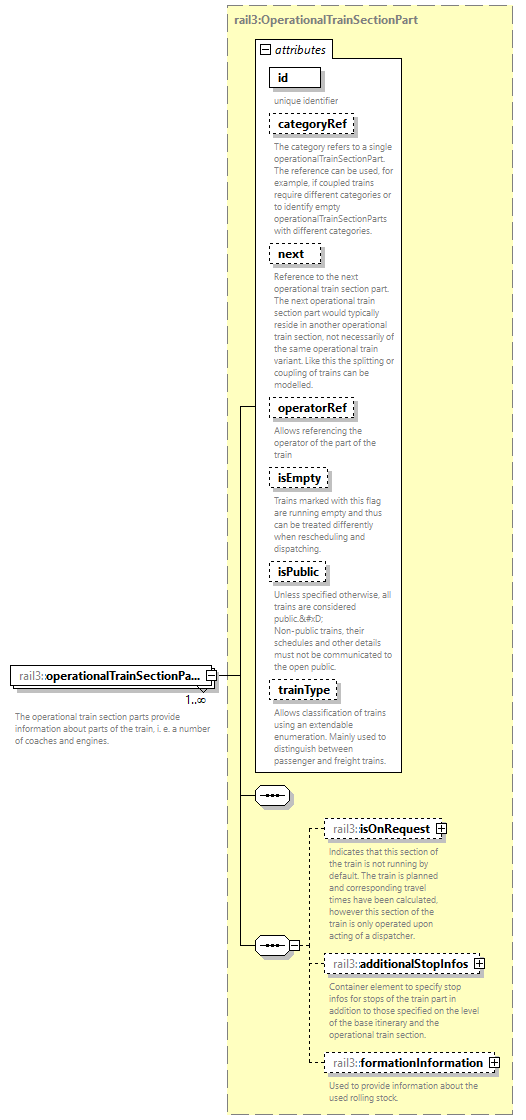 | ||||||||||||||||||||||||||||||||||||||||||||||||||||||||||||||
| namespace | https://www.railml.org/schemas/3.2 | ||||||||||||||||||||||||||||||||||||||||||||||||||||||||||||||
| type | rail3:OperationalTrainSectionPart | ||||||||||||||||||||||||||||||||||||||||||||||||||||||||||||||
| properties |
| ||||||||||||||||||||||||||||||||||||||||||||||||||||||||||||||
| children | rail3:isOnRequest rail3:additionalStopInfos rail3:formationInformation | ||||||||||||||||||||||||||||||||||||||||||||||||||||||||||||||
| attributes |
| ||||||||||||||||||||||||||||||||||||||||||||||||||||||||||||||
| annotation |
| ||||||||||||||||||||||||||||||||||||||||||||||||||||||||||||||
| source | <xs:element name="operationalTrainSectionPart" type="rail3:OperationalTrainSectionPart" minOccurs="1" maxOccurs="unbounded"> <xs:annotation> <xs:documentation>The operational train section parts provide information about parts of the train, i. e. a number of coaches and engines.</xs:documentation> </xs:annotation> </xs:element> |
complexType OperationalTrainSectionPart
| diagram | 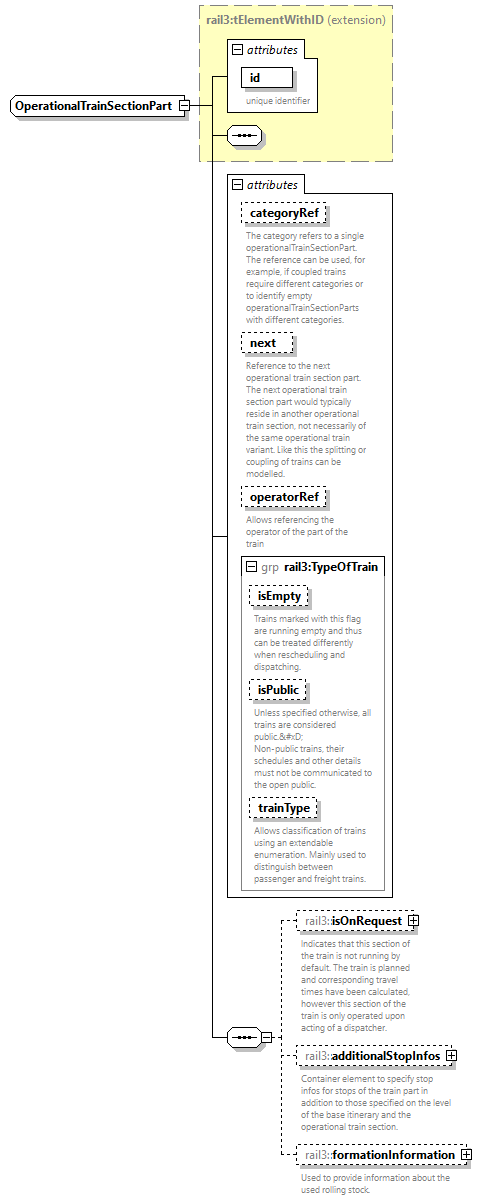 | ||||||||||||||||||||||||||||||||||||||||||||||||||||||||||||||
| namespace | https://www.railml.org/schemas/3.2 | ||||||||||||||||||||||||||||||||||||||||||||||||||||||||||||||
| type | extension of rail3:tElementWithID | ||||||||||||||||||||||||||||||||||||||||||||||||||||||||||||||
| properties |
| ||||||||||||||||||||||||||||||||||||||||||||||||||||||||||||||
| children | rail3:isOnRequest rail3:additionalStopInfos rail3:formationInformation | ||||||||||||||||||||||||||||||||||||||||||||||||||||||||||||||
| used by |
| ||||||||||||||||||||||||||||||||||||||||||||||||||||||||||||||
| attributes |
| ||||||||||||||||||||||||||||||||||||||||||||||||||||||||||||||
| source | <xs:complexType name="OperationalTrainSectionPart"> <xs:complexContent> <xs:extension base="rail3:tElementWithID"> <xs:sequence> <xs:element name="isOnRequest" type="rail3:IsOnRequest" minOccurs="0" maxOccurs="1"> <xs:annotation> <xs:documentation>Indicates that this section of the train is not running by default. The train is planned and corresponding travel times have been calculated, however this section of the train is only operated upon acting of a dispatcher.</xs:documentation> </xs:annotation> </xs:element> <xs:element name="additionalStopInfos" type="rail3:AdditionalStopInfos" minOccurs="0" maxOccurs="1"> <xs:annotation> <xs:documentation>Container element to specify stop infos for stops of the train part in addition to those specified on the level of the base itinerary and the operational train section.</xs:documentation> </xs:annotation> </xs:element> <xs:element name="formationInformation" type="rail3:FormationInformation" minOccurs="0" maxOccurs="1"> <xs:annotation> <xs:documentation>Used to provide information about the used rolling stock.</xs:documentation> </xs:annotation> </xs:element> </xs:sequence> <xs:attribute name="categoryRef" type="rail3:tRef" use="optional"> <xs:annotation> <xs:documentation>The category refers to a single operationalTrainSectionPart. The reference can be used, for example, if coupled trains require different categories or to identify empty operationalTrainSectionParts with different categories.</xs:documentation> </xs:annotation> </xs:attribute> <xs:attribute name="next" type="rail3:tRef" use="optional"> <xs:annotation> <xs:documentation>Reference to the next operational train section part. The next operational train section part would typically reside in another operational train section, not necessarily of the same operational train variant. Like this the splitting or coupling of trains can be modelled.</xs:documentation> </xs:annotation> </xs:attribute> <xs:attribute name="operatorRef" type="rail3:tRef" use="optional"> <xs:annotation> <xs:documentation>Allows referencing the operator of the part of the train</xs:documentation> </xs:annotation> </xs:attribute> <xs:attributeGroup ref="rail3:TypeOfTrain"/> </xs:extension> </xs:complexContent> </xs:complexType> |
attribute OperationalTrainSectionPart/@categoryRef
| type | rail3:tRef | ||
| properties |
| ||
| annotation |
| ||
| source | <xs:attribute name="categoryRef" type="rail3:tRef" use="optional"> <xs:annotation> <xs:documentation>The category refers to a single operationalTrainSectionPart. The reference can be used, for example, if coupled trains require different categories or to identify empty operationalTrainSectionParts with different categories.</xs:documentation> </xs:annotation> </xs:attribute> |
attribute OperationalTrainSectionPart/@next
| type | rail3:tRef | ||
| properties |
| ||
| annotation |
| ||
| source | <xs:attribute name="next" type="rail3:tRef" use="optional"> <xs:annotation> <xs:documentation>Reference to the next operational train section part. The next operational train section part would typically reside in another operational train section, not necessarily of the same operational train variant. Like this the splitting or coupling of trains can be modelled.</xs:documentation> </xs:annotation> </xs:attribute> |
attribute OperationalTrainSectionPart/@operatorRef
| type | rail3:tRef | ||
| properties |
| ||
| annotation |
| ||
| source | <xs:attribute name="operatorRef" type="rail3:tRef" use="optional"> <xs:annotation> <xs:documentation>Allows referencing the operator of the part of the train</xs:documentation> </xs:annotation> </xs:attribute> |
element OperationalTrainSectionPart/isOnRequest
| diagram | 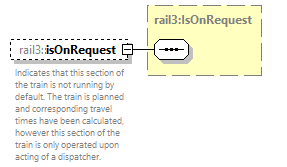 | ||||||
| namespace | https://www.railml.org/schemas/3.2 | ||||||
| type | rail3:IsOnRequest | ||||||
| properties |
| ||||||
| annotation |
| ||||||
| source | <xs:element name="isOnRequest" type="rail3:IsOnRequest" minOccurs="0" maxOccurs="1"> <xs:annotation> <xs:documentation>Indicates that this section of the train is not running by default. The train is planned and corresponding travel times have been calculated, however this section of the train is only operated upon acting of a dispatcher.</xs:documentation> </xs:annotation> </xs:element> |
element OperationalTrainSectionPart/additionalStopInfos
| diagram |  | ||||||
| namespace | https://www.railml.org/schemas/3.2 | ||||||
| type | rail3:AdditionalStopInfos | ||||||
| properties |
| ||||||
| children | rail3:additionalStopInfo | ||||||
| annotation |
| ||||||
| source | <xs:element name="additionalStopInfos" type="rail3:AdditionalStopInfos" minOccurs="0" maxOccurs="1"> <xs:annotation> <xs:documentation>Container element to specify stop infos for stops of the train part in addition to those specified on the level of the base itinerary and the operational train section.</xs:documentation> </xs:annotation> </xs:element> |
element OperationalTrainSectionPart/formationInformation
| diagram | 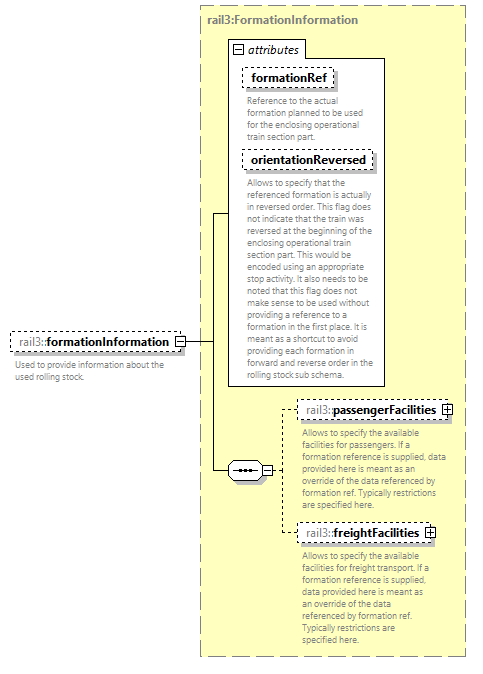 | ||||||||||||||||||||||
| namespace | https://www.railml.org/schemas/3.2 | ||||||||||||||||||||||
| type | rail3:FormationInformation | ||||||||||||||||||||||
| properties |
| ||||||||||||||||||||||
| children | rail3:passengerFacilities rail3:freightFacilities | ||||||||||||||||||||||
| attributes |
| ||||||||||||||||||||||
| annotation |
| ||||||||||||||||||||||
| source | <xs:element name="formationInformation" type="rail3:FormationInformation" minOccurs="0" maxOccurs="1"> <xs:annotation> <xs:documentation>Used to provide information about the used rolling stock.</xs:documentation> </xs:annotation> </xs:element> |
complexType OperationalTrainVariant
| diagram | 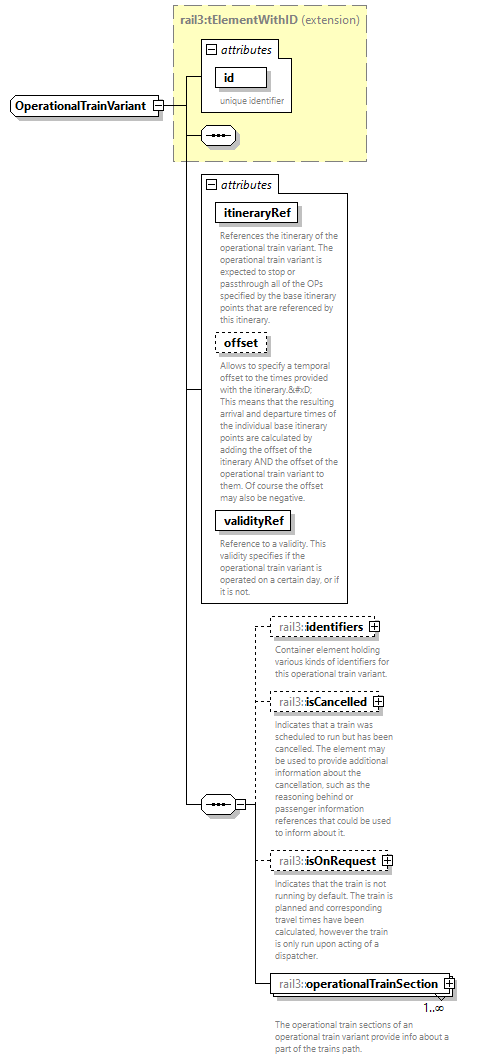 | ||||||||||||||||||||||||||||||||||||||
| namespace | https://www.railml.org/schemas/3.2 | ||||||||||||||||||||||||||||||||||||||
| type | extension of rail3:tElementWithID | ||||||||||||||||||||||||||||||||||||||
| properties |
| ||||||||||||||||||||||||||||||||||||||
| children | rail3:identifiers rail3:isCancelled rail3:isOnRequest rail3:operationalTrainSection | ||||||||||||||||||||||||||||||||||||||
| used by |
| ||||||||||||||||||||||||||||||||||||||
| attributes |
| ||||||||||||||||||||||||||||||||||||||
| source | <xs:complexType name="OperationalTrainVariant"> <xs:complexContent> <xs:extension base="rail3:tElementWithID"> <xs:sequence> <xs:element name="identifiers" type="rail3:Identifiers" minOccurs="0" maxOccurs="1"> <xs:annotation> <xs:documentation>Container element holding various kinds of identifiers for this operational train variant.</xs:documentation> </xs:annotation> </xs:element> <xs:element name="isCancelled" type="rail3:CancellationInfo" minOccurs="0" maxOccurs="1"> <xs:annotation> <xs:documentation>Indicates that a train was scheduled to run but has been cancelled. The element may be used to provide additional information about the cancellation, such as the reasoning behind or passenger information references that could be used to inform about it.</xs:documentation> </xs:annotation> </xs:element> <xs:element name="isOnRequest" type="rail3:IsOnRequest" minOccurs="0" maxOccurs="1"> <xs:annotation> <xs:documentation>Indicates that the train is not running by default. The train is planned and corresponding travel times have been calculated, however the train is only run upon acting of a dispatcher.</xs:documentation> </xs:annotation> </xs:element> <xs:element name="operationalTrainSection" type="rail3:OperationalTrainSection" minOccurs="1" maxOccurs="unbounded"> <xs:annotation> <xs:documentation>The operational train sections of an operational train variant provide info about a part of the trains path.</xs:documentation> </xs:annotation> </xs:element> </xs:sequence> <xs:attribute name="itineraryRef" type="rail3:tRef" use="required"> <xs:annotation> <xs:documentation>References the itinerary of the operational train variant. The operational train variant is expected to stop or passthrough all of the OPs specified by the base itinerary points that are referenced by this itinerary.</xs:documentation> </xs:annotation> </xs:attribute> <xs:attribute name="offset" type="xs:duration" use="optional"> <xs:annotation> <xs:documentation>Allows to specify a temporal offset to the times provided with the itinerary.
 This means that the resulting arrival and departure times of the individual base itinerary points are calculated by adding the offset of the itinerary AND the offset of the operational train variant to them. Of course the offset may also be negative.</xs:documentation> </xs:annotation> </xs:attribute> <xs:attribute name="validityRef" type="rail3:tRef" use="required"> <xs:annotation> <xs:documentation>Reference to a validity. This validity specifies if the operational train variant is operated on a certain day, or if it is not. </xs:documentation> </xs:annotation> </xs:attribute> </xs:extension> </xs:complexContent> </xs:complexType> |
attribute OperationalTrainVariant/@itineraryRef
| type | rail3:tRef | ||
| properties |
| ||
| annotation |
| ||
| source | <xs:attribute name="itineraryRef" type="rail3:tRef" use="required"> <xs:annotation> <xs:documentation>References the itinerary of the operational train variant. The operational train variant is expected to stop or passthrough all of the OPs specified by the base itinerary points that are referenced by this itinerary.</xs:documentation> </xs:annotation> </xs:attribute> |
attribute OperationalTrainVariant/@offset
| type | xs:duration | ||
| properties |
| ||
| annotation |
| ||
| source | <xs:attribute name="offset" type="xs:duration" use="optional"> <xs:annotation> <xs:documentation>Allows to specify a temporal offset to the times provided with the itinerary.
 This means that the resulting arrival and departure times of the individual base itinerary points are calculated by adding the offset of the itinerary AND the offset of the operational train variant to them. Of course the offset may also be negative.</xs:documentation> </xs:annotation> </xs:attribute> |
attribute OperationalTrainVariant/@validityRef
| type | rail3:tRef | ||
| properties |
| ||
| annotation |
| ||
| source | <xs:attribute name="validityRef" type="rail3:tRef" use="required"> <xs:annotation> <xs:documentation>Reference to a validity. This validity specifies if the operational train variant is operated on a certain day, or if it is not. </xs:documentation> </xs:annotation> </xs:attribute> |
element OperationalTrainVariant/identifiers
| diagram | 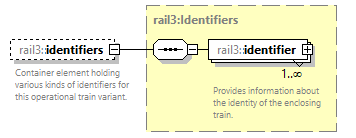 | ||||||
| namespace | https://www.railml.org/schemas/3.2 | ||||||
| type | rail3:Identifiers | ||||||
| properties |
| ||||||
| children | rail3:identifier | ||||||
| annotation |
| ||||||
| source | <xs:element name="identifiers" type="rail3:Identifiers" minOccurs="0" maxOccurs="1"> <xs:annotation> <xs:documentation>Container element holding various kinds of identifiers for this operational train variant.</xs:documentation> </xs:annotation> </xs:element> |
element OperationalTrainVariant/isCancelled
| diagram | 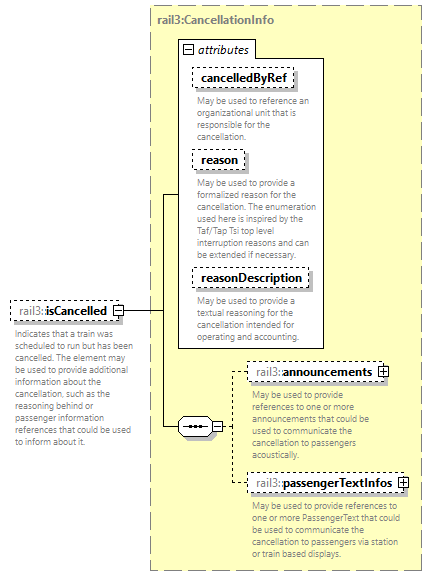 | ||||||||||||||||||||||||||||||
| namespace | https://www.railml.org/schemas/3.2 | ||||||||||||||||||||||||||||||
| type | rail3:CancellationInfo | ||||||||||||||||||||||||||||||
| properties |
| ||||||||||||||||||||||||||||||
| children | rail3:announcements rail3:passengerTextInfos | ||||||||||||||||||||||||||||||
| attributes |
| ||||||||||||||||||||||||||||||
| annotation |
| ||||||||||||||||||||||||||||||
| source | <xs:element name="isCancelled" type="rail3:CancellationInfo" minOccurs="0" maxOccurs="1"> <xs:annotation> <xs:documentation>Indicates that a train was scheduled to run but has been cancelled. The element may be used to provide additional information about the cancellation, such as the reasoning behind or passenger information references that could be used to inform about it.</xs:documentation> </xs:annotation> </xs:element> |
element OperationalTrainVariant/isOnRequest
| diagram | 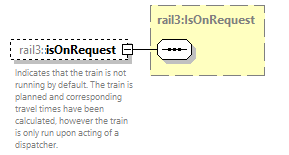 | ||||||
| namespace | https://www.railml.org/schemas/3.2 | ||||||
| type | rail3:IsOnRequest | ||||||
| properties |
| ||||||
| annotation |
| ||||||
| source | <xs:element name="isOnRequest" type="rail3:IsOnRequest" minOccurs="0" maxOccurs="1"> <xs:annotation> <xs:documentation>Indicates that the train is not running by default. The train is planned and corresponding travel times have been calculated, however the train is only run upon acting of a dispatcher.</xs:documentation> </xs:annotation> </xs:element> |
element OperationalTrainVariant/operationalTrainSection
| diagram | 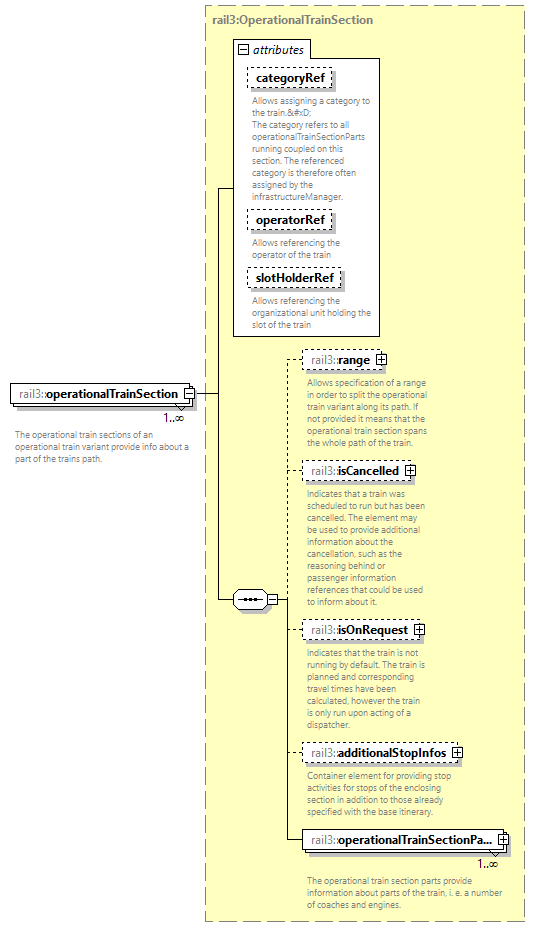 | ||||||||||||||||||||||||||||||
| namespace | https://www.railml.org/schemas/3.2 | ||||||||||||||||||||||||||||||
| type | rail3:OperationalTrainSection | ||||||||||||||||||||||||||||||
| properties |
| ||||||||||||||||||||||||||||||
| children | rail3:range rail3:isCancelled rail3:isOnRequest rail3:additionalStopInfos rail3:operationalTrainSectionPart | ||||||||||||||||||||||||||||||
| attributes |
| ||||||||||||||||||||||||||||||
| annotation |
| ||||||||||||||||||||||||||||||
| source | <xs:element name="operationalTrainSection" type="rail3:OperationalTrainSection" minOccurs="1" maxOccurs="unbounded"> <xs:annotation> <xs:documentation>The operational train sections of an operational train variant provide info about a part of the trains path.</xs:documentation> </xs:annotation> </xs:element> |
complexType OperationalTrainVariantReference
| diagram | 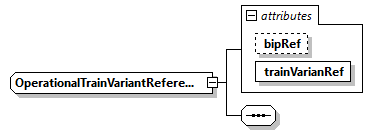 | ||||||||||||||||||
| namespace | https://www.railml.org/schemas/3.2 | ||||||||||||||||||
| used by |
| ||||||||||||||||||
| attributes |
| ||||||||||||||||||
| source | <xs:complexType name="OperationalTrainVariantReference"> <xs:sequence/> <xs:attribute name="bipRef" type="rail3:tRef" use="optional"/> <xs:attribute name="trainVarianRef" type="rail3:tRef" use="required"/> </xs:complexType> |
attribute OperationalTrainVariantReference/@bipRef
| type | rail3:tRef | ||
| properties |
| ||
| source | <xs:attribute name="bipRef" type="rail3:tRef" use="optional"/> |
attribute OperationalTrainVariantReference/@trainVarianRef
| type | rail3:tRef | ||
| properties |
| ||
| source | <xs:attribute name="trainVarianRef" type="rail3:tRef" use="required"/> |
complexType OrderedActivity
| diagram | 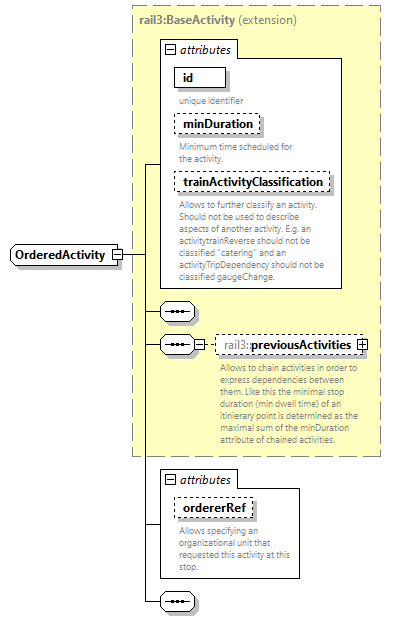 | ||||||||||||||||||||||||||||||||||||||
| namespace | https://www.railml.org/schemas/3.2 | ||||||||||||||||||||||||||||||||||||||
| type | extension of rail3:BaseActivity | ||||||||||||||||||||||||||||||||||||||
| properties |
| ||||||||||||||||||||||||||||||||||||||
| children | rail3:previousActivities | ||||||||||||||||||||||||||||||||||||||
| used by |
| ||||||||||||||||||||||||||||||||||||||
| attributes |
| ||||||||||||||||||||||||||||||||||||||
| source | <xs:complexType name="OrderedActivity"> <xs:complexContent> <xs:extension base="rail3:BaseActivity"> <xs:sequence/> <xs:attribute name="ordererRef" type="rail3:tRef" use="optional"> <xs:annotation> <xs:documentation>Allows specifying an organizational unit that requested this activity at this stop.</xs:documentation> </xs:annotation> </xs:attribute> </xs:extension> </xs:complexContent> </xs:complexType> |
attribute OrderedActivity/@ordererRef
| type | rail3:tRef | ||
| properties |
| ||
| annotation |
| ||
| source | <xs:attribute name="ordererRef" type="rail3:tRef" use="optional"> <xs:annotation> <xs:documentation>Allows specifying an organizational unit that requested this activity at this stop.</xs:documentation> </xs:annotation> </xs:attribute> |
complexType OriginDestinationInfo
| diagram | 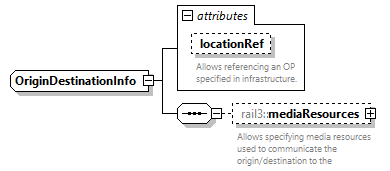 | ||||||||||||||
| namespace | https://www.railml.org/schemas/3.2 | ||||||||||||||
| children | rail3:mediaResources | ||||||||||||||
| used by |
| ||||||||||||||
| attributes |
| ||||||||||||||
| source | <xs:complexType name="OriginDestinationInfo"> <xs:sequence> <xs:element name="mediaResources" type="rail3:MediaResources" minOccurs="0" maxOccurs="1"> <xs:annotation> <xs:documentation>Allows specifying media resources used to communicate the origin/destination to the passengers.</xs:documentation> </xs:annotation> </xs:element> </xs:sequence> <xs:attribute name="locationRef" type="rail3:tRef" use="optional"> <xs:annotation> <xs:documentation>Allows referencing an OP specified in infrastructure.</xs:documentation> </xs:annotation> </xs:attribute> </xs:complexType> |
attribute OriginDestinationInfo/@locationRef
| type | rail3:tRef | ||
| properties |
| ||
| annotation |
| ||
| source | <xs:attribute name="locationRef" type="rail3:tRef" use="optional"> <xs:annotation> <xs:documentation>Allows referencing an OP specified in infrastructure.</xs:documentation> </xs:annotation> </xs:attribute> |
element OriginDestinationInfo/mediaResources
| diagram | 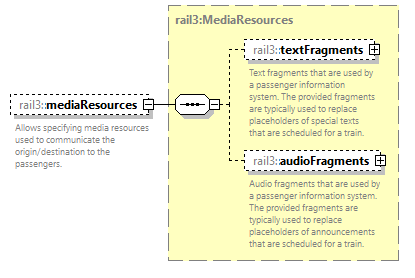 | ||||||
| namespace | https://www.railml.org/schemas/3.2 | ||||||
| type | rail3:MediaResources | ||||||
| properties |
| ||||||
| children | rail3:textFragments rail3:audioFragments | ||||||
| annotation |
| ||||||
| source | <xs:element name="mediaResources" type="rail3:MediaResources" minOccurs="0" maxOccurs="1"> <xs:annotation> <xs:documentation>Allows specifying media resources used to communicate the origin/destination to the passengers.</xs:documentation> </xs:annotation> </xs:element> |
complexType PassengerTextInfo
| diagram | 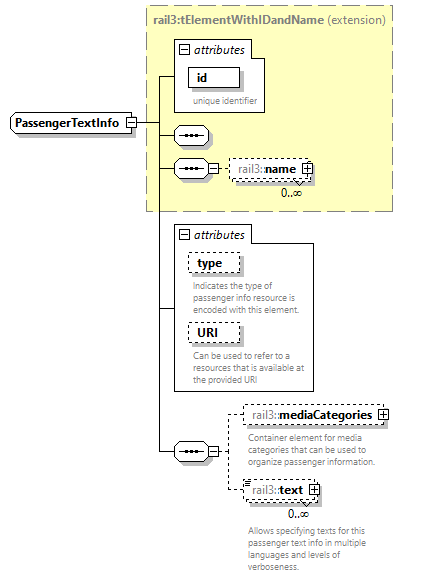 | ||||||||||||||||||||||||||||||
| namespace | https://www.railml.org/schemas/3.2 | ||||||||||||||||||||||||||||||
| type | extension of rail3:tElementWithIDandName | ||||||||||||||||||||||||||||||
| properties |
| ||||||||||||||||||||||||||||||
| children | rail3:name rail3:mediaCategories rail3:text | ||||||||||||||||||||||||||||||
| used by |
| ||||||||||||||||||||||||||||||
| attributes |
| ||||||||||||||||||||||||||||||
| source | <xs:complexType name="PassengerTextInfo"> <xs:complexContent> <xs:extension base="rail3:tElementWithIDandName"> <xs:sequence> <xs:element name="mediaCategories" type="rail3:MediaCategories" minOccurs="0" maxOccurs="1"> <xs:annotation> <xs:documentation>Container element for media categories that can be used to organize passenger information.</xs:documentation> </xs:annotation> </xs:element> <xs:element name="text" type="rail3:TextFragment" minOccurs="0" maxOccurs="unbounded"> <xs:annotation> <xs:documentation>Allows specifying texts for this passenger text info in multiple languages and levels of verboseness.</xs:documentation> </xs:annotation> </xs:element> </xs:sequence> <xs:attribute name="type" type="rail3:PassengerTextInfoType" use="optional" default="text"> <xs:annotation> <xs:documentation>Indicates the type of passenger info resource is encoded with this element.</xs:documentation> </xs:annotation> </xs:attribute> <xs:attribute name="URI" type="xs:anyURI" use="optional"> <xs:annotation> <xs:documentation>Can be used to refer to a resources that is available at the provided URI</xs:documentation> </xs:annotation> </xs:attribute> </xs:extension> </xs:complexContent> </xs:complexType> |
attribute PassengerTextInfo/@type
| type | rail3:PassengerTextInfoType | ||||||||||||||||||
| properties |
| ||||||||||||||||||
| facets |
| ||||||||||||||||||
| annotation |
| ||||||||||||||||||
| source | <xs:attribute name="type" type="rail3:PassengerTextInfoType" use="optional" default="text"> <xs:annotation> <xs:documentation>Indicates the type of passenger info resource is encoded with this element.</xs:documentation> </xs:annotation> </xs:attribute> |
attribute PassengerTextInfo/@URI
| type | xs:anyURI | ||
| properties |
| ||
| annotation |
| ||
| source | <xs:attribute name="URI" type="xs:anyURI" use="optional"> <xs:annotation> <xs:documentation>Can be used to refer to a resources that is available at the provided URI</xs:documentation> </xs:annotation> </xs:attribute> |
element PassengerTextInfo/mediaCategories
| diagram | 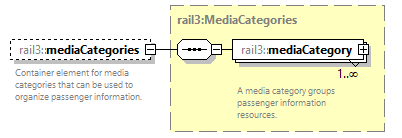 | ||||||
| namespace | https://www.railml.org/schemas/3.2 | ||||||
| type | rail3:MediaCategories | ||||||
| properties |
| ||||||
| children | rail3:mediaCategory | ||||||
| annotation |
| ||||||
| source | <xs:element name="mediaCategories" type="rail3:MediaCategories" minOccurs="0" maxOccurs="1"> <xs:annotation> <xs:documentation>Container element for media categories that can be used to organize passenger information.</xs:documentation> </xs:annotation> </xs:element> |
element PassengerTextInfo/text
| diagram | 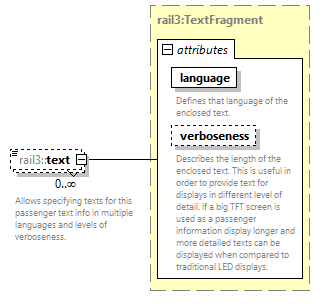 | ||||||||||||||||||||||
| namespace | https://www.railml.org/schemas/3.2 | ||||||||||||||||||||||
| type | rail3:TextFragment | ||||||||||||||||||||||
| properties |
| ||||||||||||||||||||||
| attributes |
| ||||||||||||||||||||||
| annotation |
| ||||||||||||||||||||||
| source | <xs:element name="text" type="rail3:TextFragment" minOccurs="0" maxOccurs="unbounded"> <xs:annotation> <xs:documentation>Allows specifying texts for this passenger text info in multiple languages and levels of verboseness.</xs:documentation> </xs:annotation> </xs:element> |
complexType PassengerTextInfoRef
| diagram | 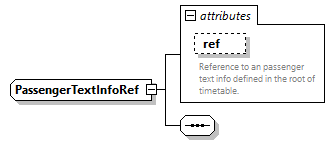 | ||||||||||||||
| namespace | https://www.railml.org/schemas/3.2 | ||||||||||||||
| used by |
| ||||||||||||||
| attributes |
| ||||||||||||||
| source | <xs:complexType name="PassengerTextInfoRef"> <xs:sequence/> <xs:attribute name="ref" type="rail3:tRef" use="optional"> <xs:annotation> <xs:documentation>Reference to an passenger text info defined in the root of timetable.</xs:documentation> </xs:annotation> </xs:attribute> </xs:complexType> |
attribute PassengerTextInfoRef/@ref
| type | rail3:tRef | ||
| properties |
| ||
| annotation |
| ||
| source | <xs:attribute name="ref" type="rail3:tRef" use="optional"> <xs:annotation> <xs:documentation>Reference to an passenger text info defined in the root of timetable.</xs:documentation> </xs:annotation> </xs:attribute> |
complexType PassengerTextInfoRefs
| diagram |  | ||
| namespace | https://www.railml.org/schemas/3.2 | ||
| children | rail3:passengerTextInfoRef | ||
| used by |
| ||
| source | <xs:complexType name="PassengerTextInfoRefs"> <xs:sequence> <xs:element name="passengerTextInfoRef" type="rail3:PassengerTextInfoRef" minOccurs="1" maxOccurs="unbounded"> <xs:annotation> <xs:documentation>Allows referencing of passenger text info elements.</xs:documentation> </xs:annotation> </xs:element> </xs:sequence> </xs:complexType> |
element PassengerTextInfoRefs/passengerTextInfoRef
| diagram | 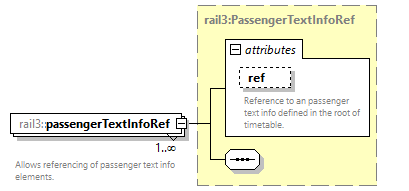 | ||||||||||||||
| namespace | https://www.railml.org/schemas/3.2 | ||||||||||||||
| type | rail3:PassengerTextInfoRef | ||||||||||||||
| properties |
| ||||||||||||||
| attributes |
| ||||||||||||||
| annotation |
| ||||||||||||||
| source | <xs:element name="passengerTextInfoRef" type="rail3:PassengerTextInfoRef" minOccurs="1" maxOccurs="unbounded"> <xs:annotation> <xs:documentation>Allows referencing of passenger text info elements.</xs:documentation> </xs:annotation> </xs:element> |
complexType PassengerTextInfos
| diagram | 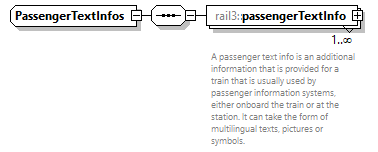 | ||
| namespace | https://www.railml.org/schemas/3.2 | ||
| children | rail3:passengerTextInfo | ||
| used by |
| ||
| source | <xs:complexType name="PassengerTextInfos"> <xs:sequence> <xs:element name="passengerTextInfo" type="rail3:PassengerTextInfo" minOccurs="1" maxOccurs="unbounded"> <xs:annotation> <xs:documentation>A passenger text info is an additional information that is provided for a train that is usually used by passenger information systems, either onboard the train or at the station. It can take the form of multilingual texts, pictures or symbols.</xs:documentation> </xs:annotation> </xs:element> </xs:sequence> </xs:complexType> |
element PassengerTextInfos/passengerTextInfo
| diagram | 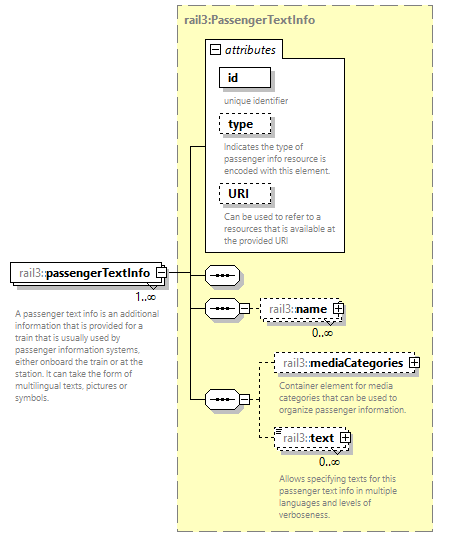 | ||||||||||||||||||||||||||||||
| namespace | https://www.railml.org/schemas/3.2 | ||||||||||||||||||||||||||||||
| type | rail3:PassengerTextInfo | ||||||||||||||||||||||||||||||
| properties |
| ||||||||||||||||||||||||||||||
| children | rail3:name rail3:mediaCategories rail3:text | ||||||||||||||||||||||||||||||
| attributes |
| ||||||||||||||||||||||||||||||
| annotation |
| ||||||||||||||||||||||||||||||
| source | <xs:element name="passengerTextInfo" type="rail3:PassengerTextInfo" minOccurs="1" maxOccurs="unbounded"> <xs:annotation> <xs:documentation>A passenger text info is an additional information that is provided for a train that is usually used by passenger information systems, either onboard the train or at the station. It can take the form of multilingual texts, pictures or symbols.</xs:documentation> </xs:annotation> </xs:element> |
complexType PassInfo
| diagram |  | ||||||||||||||
| namespace | https://www.railml.org/schemas/3.2 | ||||||||||||||
| children | rail3:referencePoint | ||||||||||||||
| used by |
| ||||||||||||||
| attributes |
| ||||||||||||||
| source | <xs:complexType name="PassInfo"> <xs:sequence> <xs:element name="referencePoint" type="rail3:StoppingPlaceRef" minOccurs="0" maxOccurs="1"> <xs:annotation> <xs:documentation>Allows specifying a stopping place as a reference point for the provided times.</xs:documentation> </xs:annotation> </xs:element> </xs:sequence> <xs:attribute name="isGuaranteed" type="xs:boolean" use="optional"> <xs:annotation> <xs:documentation>The train shall pass through this base itinerary point and must not come to a stop for operational reasons (occupied block section, train crossing, ...).</xs:documentation> </xs:annotation> </xs:attribute> </xs:complexType> |
attribute PassInfo/@isGuaranteed
| type | xs:boolean | ||
| properties |
| ||
| annotation |
| ||
| source | <xs:attribute name="isGuaranteed" type="xs:boolean" use="optional"> <xs:annotation> <xs:documentation>The train shall pass through this base itinerary point and must not come to a stop for operational reasons (occupied block section, train crossing, ...).</xs:documentation> </xs:annotation> </xs:attribute> |
element PassInfo/referencePoint
| diagram | 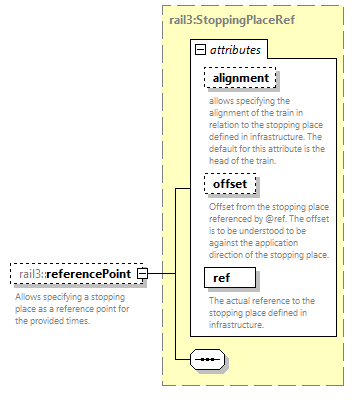 | ||||||||||||||||||||||||||||||
| namespace | https://www.railml.org/schemas/3.2 | ||||||||||||||||||||||||||||||
| type | rail3:StoppingPlaceRef | ||||||||||||||||||||||||||||||
| properties |
| ||||||||||||||||||||||||||||||
| attributes |
| ||||||||||||||||||||||||||||||
| annotation |
| ||||||||||||||||||||||||||||||
| source | <xs:element name="referencePoint" type="rail3:StoppingPlaceRef" minOccurs="0" maxOccurs="1"> <xs:annotation> <xs:documentation>Allows specifying a stopping place as a reference point for the provided times.</xs:documentation> </xs:annotation> </xs:element> |
complexType PlatformEdgeRef
| diagram | 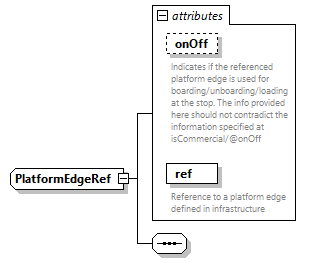 | ||||||||||||||||||||||
| namespace | https://www.railml.org/schemas/3.2 | ||||||||||||||||||||||
| used by |
| ||||||||||||||||||||||
| attributes |
| ||||||||||||||||||||||
| source | <xs:complexType name="PlatformEdgeRef"> <xs:sequence/> <xs:attribute name="onOff" type="rail3:OnOff" use="optional" default="both"> <xs:annotation> <xs:documentation>Indicates if the referenced platform edge is used for boarding/unboarding/loading/unloading at the stop. The info provided here should not contradict the information specified at isCommercial/@onOff</xs:documentation> </xs:annotation> </xs:attribute> <xs:attribute name="ref" type="rail3:tRef" use="required"> <xs:annotation> <xs:documentation>Reference to a platform edge defined in infrastructure</xs:documentation> </xs:annotation> </xs:attribute> </xs:complexType> |
attribute PlatformEdgeRef/@onOff
| type | rail3:OnOff | ||||||||||||||||||
| properties |
| ||||||||||||||||||
| facets |
| ||||||||||||||||||
| annotation |
| ||||||||||||||||||
| source | <xs:attribute name="onOff" type="rail3:OnOff" use="optional" default="both"> <xs:annotation> <xs:documentation>Indicates if the referenced platform edge is used for boarding/unboarding/loading/unloading at the stop. The info provided here should not contradict the information specified at isCommercial/@onOff</xs:documentation> </xs:annotation> </xs:attribute> |
attribute PlatformEdgeRef/@ref
| type | rail3:tRef | ||
| properties |
| ||
| annotation |
| ||
| source | <xs:attribute name="ref" type="rail3:tRef" use="required"> <xs:annotation> <xs:documentation>Reference to a platform edge defined in infrastructure</xs:documentation> </xs:annotation> </xs:attribute> |
complexType PlatformEdgeRefs
| diagram |  | ||
| namespace | https://www.railml.org/schemas/3.2 | ||
| children | rail3:platformEdgeRef | ||
| used by |
| ||
| source | <xs:complexType name="PlatformEdgeRefs"> <xs:sequence> <xs:element name="platformEdgeRef" type="rail3:PlatformEdgeRef" minOccurs="1" maxOccurs="unbounded"> <xs:annotation> <xs:documentation>Allows referencing a platform edge defined in infrastructure.</xs:documentation> </xs:annotation> </xs:element> </xs:sequence> </xs:complexType> |
element PlatformEdgeRefs/platformEdgeRef
| diagram | 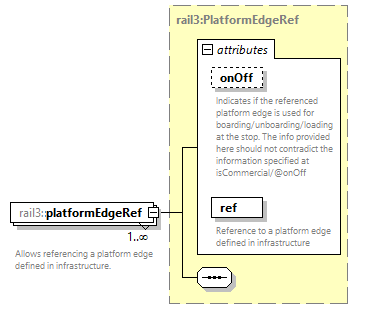 | ||||||||||||||||||||||
| namespace | https://www.railml.org/schemas/3.2 | ||||||||||||||||||||||
| type | rail3:PlatformEdgeRef | ||||||||||||||||||||||
| properties |
| ||||||||||||||||||||||
| attributes |
| ||||||||||||||||||||||
| annotation |
| ||||||||||||||||||||||
| source | <xs:element name="platformEdgeRef" type="rail3:PlatformEdgeRef" minOccurs="1" maxOccurs="unbounded"> <xs:annotation> <xs:documentation>Allows referencing a platform edge defined in infrastructure.</xs:documentation> </xs:annotation> </xs:element> |
complexType PreviousActivities
| diagram |  | ||
| namespace | https://www.railml.org/schemas/3.2 | ||
| children | rail3:activityRef | ||
| used by |
| ||
| source | <xs:complexType name="PreviousActivities"> <xs:sequence> <xs:element name="activityRef" type="rail3:ActivityRef" minOccurs="1" maxOccurs="unbounded"> <xs:annotation> <xs:documentation>Reference to other activities that are scheduled to take place directly before the current one.</xs:documentation> </xs:annotation> </xs:element> </xs:sequence> </xs:complexType> |
element PreviousActivities/activityRef
| diagram | 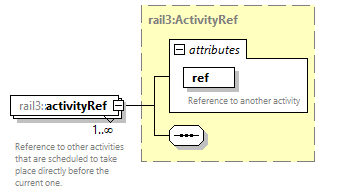 | ||||||||||||||
| namespace | https://www.railml.org/schemas/3.2 | ||||||||||||||
| type | rail3:ActivityRef | ||||||||||||||
| properties |
| ||||||||||||||
| attributes |
| ||||||||||||||
| annotation |
| ||||||||||||||
| source | <xs:element name="activityRef" type="rail3:ActivityRef" minOccurs="1" maxOccurs="unbounded"> <xs:annotation> <xs:documentation>Reference to other activities that are scheduled to take place directly before the current one.</xs:documentation> </xs:annotation> </xs:element> |
complexType Range
| diagram | 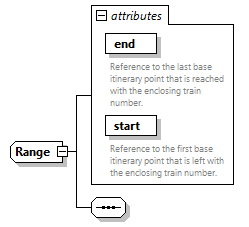 | ||||||||||||||||||||||
| namespace | https://www.railml.org/schemas/3.2 | ||||||||||||||||||||||
| used by |
| ||||||||||||||||||||||
| attributes |
| ||||||||||||||||||||||
| source | <xs:complexType name="Range"> <xs:sequence/> <xs:attribute name="end" type="rail3:tRef" use="required"> <xs:annotation> <xs:documentation>Reference to the last base itinerary point that is reached with the enclosing train number.</xs:documentation> </xs:annotation> </xs:attribute> <xs:attribute name="start" type="rail3:tRef" use="required"> <xs:annotation> <xs:documentation>Reference to the first base itinerary point that is left with the enclosing train number.</xs:documentation> </xs:annotation> </xs:attribute> </xs:complexType> |
attribute Range/@end
| type | rail3:tRef | ||
| properties |
| ||
| annotation |
| ||
| source | <xs:attribute name="end" type="rail3:tRef" use="required"> <xs:annotation> <xs:documentation>Reference to the last base itinerary point that is reached with the enclosing train number.</xs:documentation> </xs:annotation> </xs:attribute> |
attribute Range/@start
| type | rail3:tRef | ||
| properties |
| ||
| annotation |
| ||
| source | <xs:attribute name="start" type="rail3:tRef" use="required"> <xs:annotation> <xs:documentation>Reference to the first base itinerary point that is left with the enclosing train number.</xs:documentation> </xs:annotation> </xs:attribute> |
complexType RouteRef
| diagram | 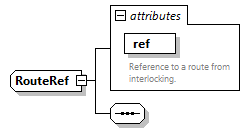 | ||||||||||||||
| namespace | https://www.railml.org/schemas/3.2 | ||||||||||||||
| used by |
| ||||||||||||||
| attributes |
| ||||||||||||||
| source | <xs:complexType name="RouteRef"> <xs:sequence/> <xs:attribute name="ref" type="rail3:tRef" use="required"> <xs:annotation> <xs:documentation>Reference to a route from interlocking.</xs:documentation> </xs:annotation> </xs:attribute> </xs:complexType> |
attribute RouteRef/@ref
| type | rail3:tRef | ||
| properties |
| ||
| annotation |
| ||
| source | <xs:attribute name="ref" type="rail3:tRef" use="required"> <xs:annotation> <xs:documentation>Reference to a route from interlocking.</xs:documentation> </xs:annotation> </xs:attribute> |
complexType RouteRefs
| diagram |  | ||
| namespace | https://www.railml.org/schemas/3.2 | ||
| children | rail3:routeRef | ||
| used by |
| ||
| source | <xs:complexType name="RouteRefs"> <xs:sequence> <xs:element name="routeRef" type="rail3:RouteRef" minOccurs="1" maxOccurs="unbounded"> <xs:annotation> <xs:documentation>Reference to a route from interlocking.</xs:documentation> </xs:annotation> </xs:element> </xs:sequence> </xs:complexType> |
element RouteRefs/routeRef
| diagram | 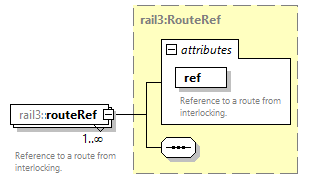 | ||||||||||||||
| namespace | https://www.railml.org/schemas/3.2 | ||||||||||||||
| type | rail3:RouteRef | ||||||||||||||
| properties |
| ||||||||||||||
| attributes |
| ||||||||||||||
| annotation |
| ||||||||||||||
| source | <xs:element name="routeRef" type="rail3:RouteRef" minOccurs="1" maxOccurs="unbounded"> <xs:annotation> <xs:documentation>Reference to a route from interlocking.</xs:documentation> </xs:annotation> </xs:element> |
complexType RuntimeReserve
| diagram | 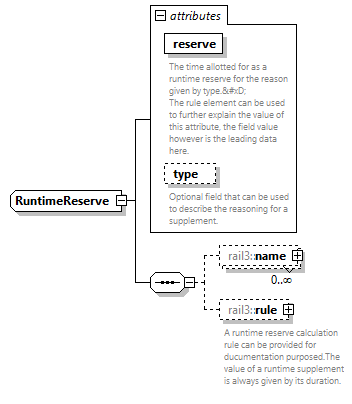 | ||||||||||||||||||||||
| namespace | https://www.railml.org/schemas/3.2 | ||||||||||||||||||||||
| children | rail3:name rail3:rule | ||||||||||||||||||||||
| used by |
| ||||||||||||||||||||||
| attributes |
| ||||||||||||||||||||||
| source | <xs:complexType name="RuntimeReserve"> <xs:sequence> <xs:element name="name" type="rail3:Name" minOccurs="0" maxOccurs="unbounded"/> <xs:element name="rule" type="rail3:RuntimeReserveCalculationRule" minOccurs="0" maxOccurs="1"> <xs:annotation> <xs:documentation>A runtime reserve calculation rule can be provided for ducumentation purposed.The value of a runtime supplement is always given by its duration.</xs:documentation> </xs:annotation> </xs:element> </xs:sequence> <xs:attribute name="reserve" type="xs:duration" use="required"> <xs:annotation> <xs:documentation>The time allotted for as a runtime reserve for the reason given by type.
 The rule element can be used to further explain the value of this attribute, the field value however is the leading data here.</xs:documentation> </xs:annotation> </xs:attribute> <xs:attribute name="type" type="rail3:RuntimeReserveTypeExt" use="optional"> <xs:annotation> <xs:documentation>Optional field that can be used to describe the reasoning for a supplement.</xs:documentation> </xs:annotation> </xs:attribute> </xs:complexType> |
attribute RuntimeReserve/@reserve
| type | xs:duration | ||
| properties |
| ||
| annotation |
| ||
| source | <xs:attribute name="reserve" type="xs:duration" use="required"> <xs:annotation> <xs:documentation>The time allotted for as a runtime reserve for the reason given by type.
 The rule element can be used to further explain the value of this attribute, the field value however is the leading data here.</xs:documentation> </xs:annotation> </xs:attribute> |
attribute RuntimeReserve/@type
| type | rail3:RuntimeReserveTypeExt | ||
| properties |
| ||
| annotation |
| ||
| source | <xs:attribute name="type" type="rail3:RuntimeReserveTypeExt" use="optional"> <xs:annotation> <xs:documentation>Optional field that can be used to describe the reasoning for a supplement.</xs:documentation> </xs:annotation> </xs:attribute> |
element RuntimeReserve/name
| diagram | 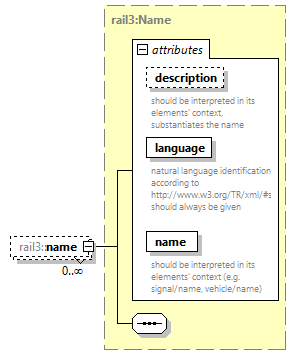 | ||||||||||||||||||||||||||||||
| namespace | https://www.railml.org/schemas/3.2 | ||||||||||||||||||||||||||||||
| type | rail3:Name | ||||||||||||||||||||||||||||||
| properties |
| ||||||||||||||||||||||||||||||
| attributes |
| ||||||||||||||||||||||||||||||
| source | <xs:element name="name" type="rail3:Name" minOccurs="0" maxOccurs="unbounded"/> |
element RuntimeReserve/rule
| diagram | 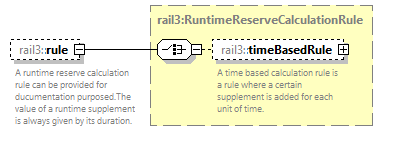 | ||||||
| namespace | https://www.railml.org/schemas/3.2 | ||||||
| type | rail3:RuntimeReserveCalculationRule | ||||||
| properties |
| ||||||
| children | rail3:timeBasedRule | ||||||
| annotation |
| ||||||
| source | <xs:element name="rule" type="rail3:RuntimeReserveCalculationRule" minOccurs="0" maxOccurs="1"> <xs:annotation> <xs:documentation>A runtime reserve calculation rule can be provided for ducumentation purposed.The value of a runtime supplement is always given by its duration.</xs:documentation> </xs:annotation> </xs:element> |
complexType RuntimeReserveCalculationRule
| diagram |  | ||
| namespace | https://www.railml.org/schemas/3.2 | ||
| children | rail3:timeBasedRule | ||
| used by |
| ||
| source | <xs:complexType name="RuntimeReserveCalculationRule"> <xs:choice> <xs:element name="timeBasedRule" type="rail3:TimeBasedCalculationRule" minOccurs="0" maxOccurs="1"> <xs:annotation> <xs:documentation>A time based calculation rule is a rule where a certain supplement is added for each unit of time.</xs:documentation> </xs:annotation> </xs:element> </xs:choice> </xs:complexType> |
element RuntimeReserveCalculationRule/timeBasedRule
| diagram | 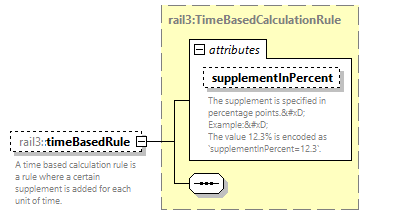 | ||||||||||||||
| namespace | https://www.railml.org/schemas/3.2 | ||||||||||||||
| type | rail3:TimeBasedCalculationRule | ||||||||||||||
| properties |
| ||||||||||||||
| attributes |
| ||||||||||||||
| annotation |
| ||||||||||||||
| source | <xs:element name="timeBasedRule" type="rail3:TimeBasedCalculationRule" minOccurs="0" maxOccurs="1"> <xs:annotation> <xs:documentation>A time based calculation rule is a rule where a certain supplement is added for each unit of time.</xs:documentation> </xs:annotation> </xs:element> |
complexType RuntimeReserves
| diagram | 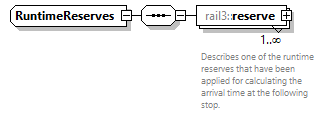 | ||
| namespace | https://www.railml.org/schemas/3.2 | ||
| children | rail3:reserve | ||
| used by |
| ||
| source | <xs:complexType name="RuntimeReserves"> <xs:sequence> <xs:element name="reserve" type="rail3:RuntimeReserve" minOccurs="1" maxOccurs="unbounded"> <xs:annotation> <xs:documentation>Describes one of the runtime reserves that have been applied for calculating the arrival time at the following stop.</xs:documentation> </xs:annotation> </xs:element> </xs:sequence> </xs:complexType> |
element RuntimeReserves/reserve
| diagram | 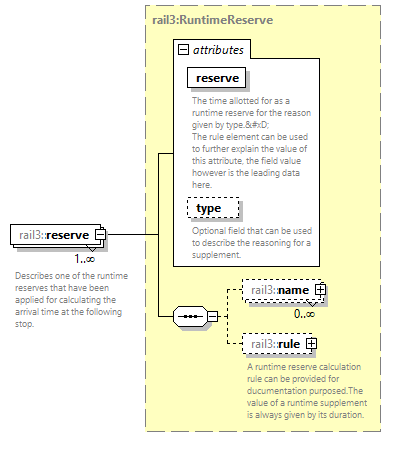 | ||||||||||||||||||||||
| namespace | https://www.railml.org/schemas/3.2 | ||||||||||||||||||||||
| type | rail3:RuntimeReserve | ||||||||||||||||||||||
| properties |
| ||||||||||||||||||||||
| children | rail3:name rail3:rule | ||||||||||||||||||||||
| attributes |
| ||||||||||||||||||||||
| annotation |
| ||||||||||||||||||||||
| source | <xs:element name="reserve" type="rail3:RuntimeReserve" minOccurs="1" maxOccurs="unbounded"> <xs:annotation> <xs:documentation>Describes one of the runtime reserves that have been applied for calculating the arrival time at the following stop.</xs:documentation> </xs:annotation> </xs:element> |
complexType SectionTT
| diagram | 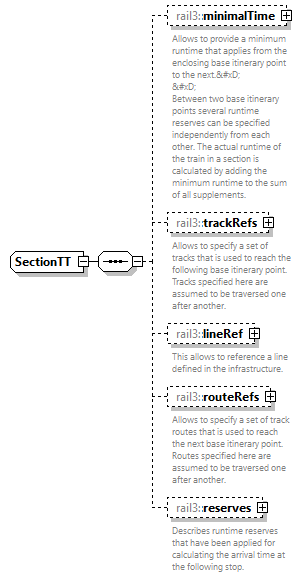 | ||
| namespace | https://www.railml.org/schemas/3.2 | ||
| children | rail3:minimalTime rail3:trackRefs rail3:lineRef rail3:routeRefs rail3:reserves | ||
| used by |
| ||
| source | <xs:complexType name="SectionTT"> <xs:sequence> <xs:element name="minimalTime" type="rail3:MinimalTime" minOccurs="0" maxOccurs="1"> <xs:annotation> <xs:documentation>Allows to provide a minimum runtime that applies from the enclosing base itinerary point to the next.
 
 Between two base itinerary points several runtime reserves can be specified independently from each other. The actual runtime of the train in a section is calculated by adding the minimum runtime to the sum of all supplements.</xs:documentation> </xs:annotation> </xs:element> <xs:element name="trackRefs" type="rail3:TrackRefs" minOccurs="0" maxOccurs="1"> <xs:annotation> <xs:documentation>Allows to specify a set of tracks that is used to reach the following base itinerary point. Tracks specified here are assumed to be traversed one after another.</xs:documentation> </xs:annotation> </xs:element> <xs:element name="lineRef" type="rail3:LineRef" minOccurs="0" maxOccurs="1"> <xs:annotation> <xs:documentation>This allows to reference a line defined in the infrastructure.</xs:documentation> </xs:annotation> </xs:element> <xs:element name="routeRefs" type="rail3:RouteRefs" minOccurs="0" maxOccurs="1"> <xs:annotation> <xs:documentation>Allows to specify a set of track routes that is used to reach the next base itinerary point. Routes specified here are assumed to be traversed one after another.</xs:documentation> </xs:annotation> </xs:element> <xs:element name="reserves" type="rail3:RuntimeReserves" minOccurs="0" maxOccurs="1"> <xs:annotation> <xs:documentation>Describes runtime reserves that have been applied for calculating the arrival time at the following stop.</xs:documentation> </xs:annotation> </xs:element> </xs:sequence> </xs:complexType> |
element SectionTT/minimalTime
| diagram | 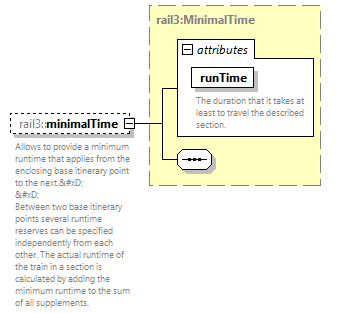 | ||||||||||||||
| namespace | https://www.railml.org/schemas/3.2 | ||||||||||||||
| type | rail3:MinimalTime | ||||||||||||||
| properties |
| ||||||||||||||
| attributes |
| ||||||||||||||
| annotation |
| ||||||||||||||
| source | <xs:element name="minimalTime" type="rail3:MinimalTime" minOccurs="0" maxOccurs="1"> <xs:annotation> <xs:documentation>Allows to provide a minimum runtime that applies from the enclosing base itinerary point to the next.
 
 Between two base itinerary points several runtime reserves can be specified independently from each other. The actual runtime of the train in a section is calculated by adding the minimum runtime to the sum of all supplements.</xs:documentation> </xs:annotation> </xs:element> |
element SectionTT/trackRefs
| diagram | 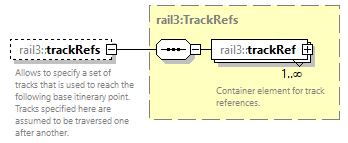 | ||||||
| namespace | https://www.railml.org/schemas/3.2 | ||||||
| type | rail3:TrackRefs | ||||||
| properties |
| ||||||
| children | rail3:trackRef | ||||||
| annotation |
| ||||||
| source | <xs:element name="trackRefs" type="rail3:TrackRefs" minOccurs="0" maxOccurs="1"> <xs:annotation> <xs:documentation>Allows to specify a set of tracks that is used to reach the following base itinerary point. Tracks specified here are assumed to be traversed one after another.</xs:documentation> </xs:annotation> </xs:element> |
element SectionTT/lineRef
| diagram | 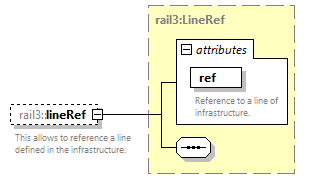 | ||||||||||||||
| namespace | https://www.railml.org/schemas/3.2 | ||||||||||||||
| type | rail3:LineRef | ||||||||||||||
| properties |
| ||||||||||||||
| attributes |
| ||||||||||||||
| annotation |
| ||||||||||||||
| source | <xs:element name="lineRef" type="rail3:LineRef" minOccurs="0" maxOccurs="1"> <xs:annotation> <xs:documentation>This allows to reference a line defined in the infrastructure.</xs:documentation> </xs:annotation> </xs:element> |
element SectionTT/routeRefs
| diagram | 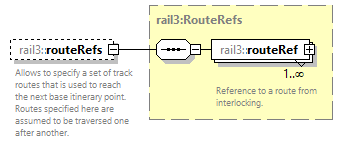 | ||||||
| namespace | https://www.railml.org/schemas/3.2 | ||||||
| type | rail3:RouteRefs | ||||||
| properties |
| ||||||
| children | rail3:routeRef | ||||||
| annotation |
| ||||||
| source | <xs:element name="routeRefs" type="rail3:RouteRefs" minOccurs="0" maxOccurs="1"> <xs:annotation> <xs:documentation>Allows to specify a set of track routes that is used to reach the next base itinerary point. Routes specified here are assumed to be traversed one after another.</xs:documentation> </xs:annotation> </xs:element> |
element SectionTT/reserves
| diagram | 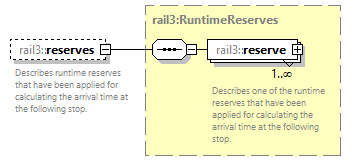 | ||||||
| namespace | https://www.railml.org/schemas/3.2 | ||||||
| type | rail3:RuntimeReserves | ||||||
| properties |
| ||||||
| children | rail3:reserve | ||||||
| annotation |
| ||||||
| source | <xs:element name="reserves" type="rail3:RuntimeReserves" minOccurs="0" maxOccurs="1"> <xs:annotation> <xs:documentation>Describes runtime reserves that have been applied for calculating the arrival time at the following stop.</xs:documentation> </xs:annotation> </xs:element> |
complexType StopInfo
| diagram | 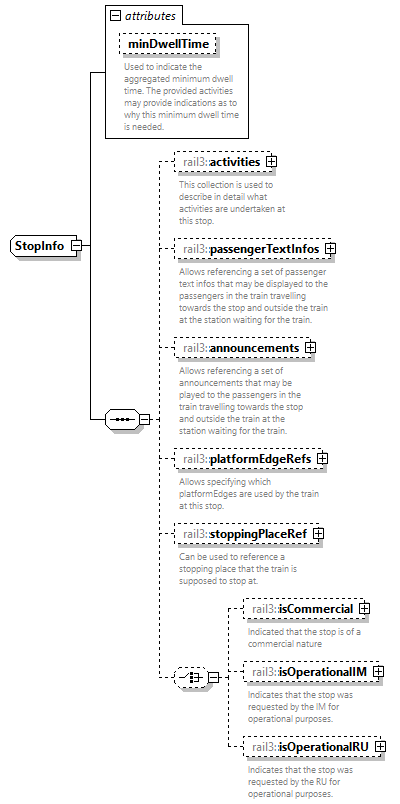 | ||||||||||||||
| namespace | https://www.railml.org/schemas/3.2 | ||||||||||||||
| children | rail3:activities rail3:passengerTextInfos rail3:announcements rail3:platformEdgeRefs rail3:stoppingPlaceRef rail3:isCommercial rail3:isOperationalIM rail3:isOperationalRU | ||||||||||||||
| used by |
| ||||||||||||||
| attributes |
| ||||||||||||||
| source | <xs:complexType name="StopInfo"> <xs:sequence> <xs:element name="activities" type="rail3:Activities" minOccurs="0" maxOccurs="1"> <xs:annotation> <xs:documentation>This collection is used to describe in detail what activities are undertaken at this stop.</xs:documentation> </xs:annotation> </xs:element> <xs:element name="passengerTextInfos" type="rail3:PassengerTextInfoRefs" minOccurs="0" maxOccurs="1"> <xs:annotation> <xs:documentation>Allows referencing a set of passenger text infos that may be displayed to the passengers in the train travelling towards the stop and outside the train at the station waiting for the train.</xs:documentation> </xs:annotation> </xs:element> <xs:element name="announcements" type="rail3:AnnouncementRefs" minOccurs="0" maxOccurs="1"> <xs:annotation> <xs:documentation>Allows referencing a set of announcements that may be played to the passengers in the train travelling towards the stop and outside the train at the station waiting for the train.</xs:documentation> </xs:annotation> </xs:element> <xs:element name="platformEdgeRefs" type="rail3:PlatformEdgeRefs" minOccurs="0" maxOccurs="1"> <xs:annotation> <xs:documentation>Allows specifying which platformEdges are used by the train at this stop.</xs:documentation> </xs:annotation> </xs:element> <xs:element name="stoppingPlaceRef" type="rail3:StoppingPlaceRef" minOccurs="0" maxOccurs="1"> <xs:annotation> <xs:documentation>Can be used to reference a stopping place that the train is supposed to stop at.</xs:documentation> </xs:annotation> </xs:element> <xs:choice minOccurs="0" maxOccurs="1"> <xs:element name="isCommercial" type="rail3:Commercial" minOccurs="0" maxOccurs="1"> <xs:annotation> <xs:documentation>Indicated that the stop is of a commercial nature</xs:documentation> </xs:annotation> </xs:element> <xs:element name="isOperationalIM" type="rail3:OperationalIM" minOccurs="0" maxOccurs="1"> <xs:annotation> <xs:documentation>Indicates that the stop was requested by the IM for operational purposes.</xs:documentation> </xs:annotation> </xs:element> <xs:element name="isOperationalRU" type="rail3:OperationalRU" minOccurs="0" maxOccurs="1"> <xs:annotation> <xs:documentation>Indicates that the stop was requested by the RU for operational purposes.</xs:documentation> </xs:annotation> </xs:element> </xs:choice> </xs:sequence> <xs:attribute name="minDwellTime" type="xs:duration" use="optional"> <xs:annotation> <xs:documentation>Used to indicate the aggregated minimum dwell time. The provided activities may provide indications as to why this minimum dwell time is needed.</xs:documentation> </xs:annotation> </xs:attribute> </xs:complexType> |
attribute StopInfo/@minDwellTime
| type | xs:duration | ||
| properties |
| ||
| annotation |
| ||
| source | <xs:attribute name="minDwellTime" type="xs:duration" use="optional"> <xs:annotation> <xs:documentation>Used to indicate the aggregated minimum dwell time. The provided activities may provide indications as to why this minimum dwell time is needed.</xs:documentation> </xs:annotation> </xs:attribute> |
element StopInfo/activities
| diagram | 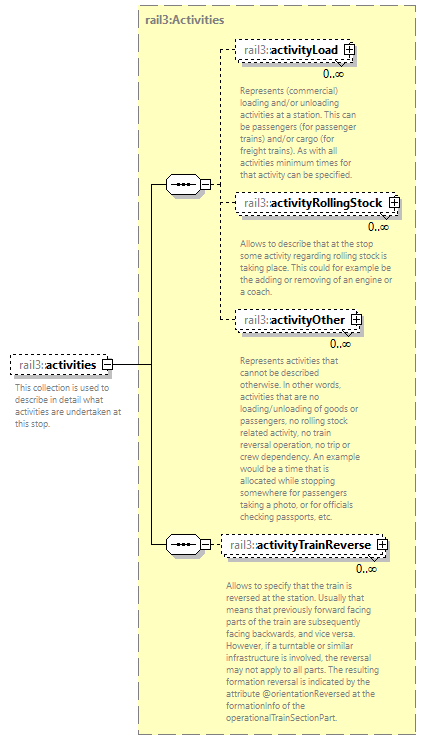 | ||||||
| namespace | https://www.railml.org/schemas/3.2 | ||||||
| type | rail3:Activities | ||||||
| properties |
| ||||||
| children | rail3:activityLoad rail3:activityRollingStock rail3:activityOther rail3:activityTrainReverse | ||||||
| annotation |
| ||||||
| source | <xs:element name="activities" type="rail3:Activities" minOccurs="0" maxOccurs="1"> <xs:annotation> <xs:documentation>This collection is used to describe in detail what activities are undertaken at this stop.</xs:documentation> </xs:annotation> </xs:element> |
element StopInfo/passengerTextInfos
| diagram |  | ||||||
| namespace | https://www.railml.org/schemas/3.2 | ||||||
| type | rail3:PassengerTextInfoRefs | ||||||
| properties |
| ||||||
| children | rail3:passengerTextInfoRef | ||||||
| annotation |
| ||||||
| source | <xs:element name="passengerTextInfos" type="rail3:PassengerTextInfoRefs" minOccurs="0" maxOccurs="1"> <xs:annotation> <xs:documentation>Allows referencing a set of passenger text infos that may be displayed to the passengers in the train travelling towards the stop and outside the train at the station waiting for the train.</xs:documentation> </xs:annotation> </xs:element> |
element StopInfo/announcements
| diagram | 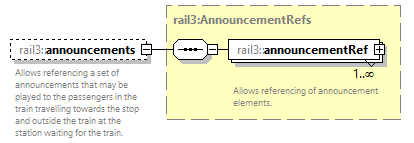 | ||||||
| namespace | https://www.railml.org/schemas/3.2 | ||||||
| type | rail3:AnnouncementRefs | ||||||
| properties |
| ||||||
| children | rail3:announcementRef | ||||||
| annotation |
| ||||||
| source | <xs:element name="announcements" type="rail3:AnnouncementRefs" minOccurs="0" maxOccurs="1"> <xs:annotation> <xs:documentation>Allows referencing a set of announcements that may be played to the passengers in the train travelling towards the stop and outside the train at the station waiting for the train.</xs:documentation> </xs:annotation> </xs:element> |
element StopInfo/platformEdgeRefs
| diagram |  | ||||||
| namespace | https://www.railml.org/schemas/3.2 | ||||||
| type | rail3:PlatformEdgeRefs | ||||||
| properties |
| ||||||
| children | rail3:platformEdgeRef | ||||||
| annotation |
| ||||||
| source | <xs:element name="platformEdgeRefs" type="rail3:PlatformEdgeRefs" minOccurs="0" maxOccurs="1"> <xs:annotation> <xs:documentation>Allows specifying which platformEdges are used by the train at this stop.</xs:documentation> </xs:annotation> </xs:element> |
element StopInfo/stoppingPlaceRef
| diagram | 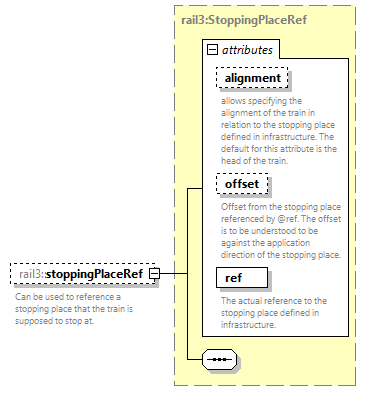 | ||||||||||||||||||||||||||||||
| namespace | https://www.railml.org/schemas/3.2 | ||||||||||||||||||||||||||||||
| type | rail3:StoppingPlaceRef | ||||||||||||||||||||||||||||||
| properties |
| ||||||||||||||||||||||||||||||
| attributes |
| ||||||||||||||||||||||||||||||
| annotation |
| ||||||||||||||||||||||||||||||
| source | <xs:element name="stoppingPlaceRef" type="rail3:StoppingPlaceRef" minOccurs="0" maxOccurs="1"> <xs:annotation> <xs:documentation>Can be used to reference a stopping place that the train is supposed to stop at.</xs:documentation> </xs:annotation> </xs:element> |
element StopInfo/isCommercial
| diagram | 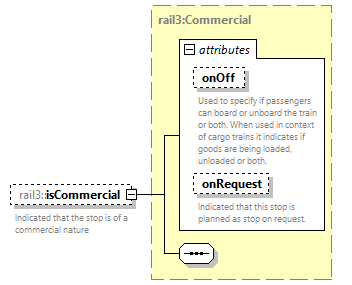 | ||||||||||||||||||||||
| namespace | https://www.railml.org/schemas/3.2 | ||||||||||||||||||||||
| type | rail3:Commercial | ||||||||||||||||||||||
| properties |
| ||||||||||||||||||||||
| attributes |
| ||||||||||||||||||||||
| annotation |
| ||||||||||||||||||||||
| source | <xs:element name="isCommercial" type="rail3:Commercial" minOccurs="0" maxOccurs="1"> <xs:annotation> <xs:documentation>Indicated that the stop is of a commercial nature</xs:documentation> </xs:annotation> </xs:element> |
element StopInfo/isOperationalIM
| diagram | 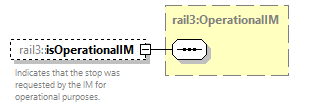 | ||||||
| namespace | https://www.railml.org/schemas/3.2 | ||||||
| type | rail3:OperationalIM | ||||||
| properties |
| ||||||
| annotation |
| ||||||
| source | <xs:element name="isOperationalIM" type="rail3:OperationalIM" minOccurs="0" maxOccurs="1"> <xs:annotation> <xs:documentation>Indicates that the stop was requested by the IM for operational purposes.</xs:documentation> </xs:annotation> </xs:element> |
element StopInfo/isOperationalRU
| diagram | 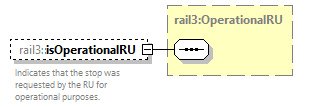 | ||||||
| namespace | https://www.railml.org/schemas/3.2 | ||||||
| type | rail3:OperationalRU | ||||||
| properties |
| ||||||
| annotation |
| ||||||
| source | <xs:element name="isOperationalRU" type="rail3:OperationalRU" minOccurs="0" maxOccurs="1"> <xs:annotation> <xs:documentation>Indicates that the stop was requested by the RU for operational purposes.</xs:documentation> </xs:annotation> </xs:element> |
complexType StoppingPlaceRef
| diagram | 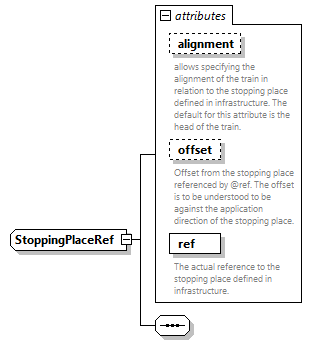 | ||||||||||||||||||||||||||||||
| namespace | https://www.railml.org/schemas/3.2 | ||||||||||||||||||||||||||||||
| used by |
| ||||||||||||||||||||||||||||||
| attributes |
| ||||||||||||||||||||||||||||||
| source | <xs:complexType name="StoppingPlaceRef"> <xs:sequence/> <xs:attribute name="alignment" type="rail3:tTrainRelation" use="optional" default="headOfTrain"> <xs:annotation> <xs:documentation>allows specifying the alignment of the train in relation to the stopping place defined in infrastructure. The default for this attribute is the head of the train.</xs:documentation> </xs:annotation> </xs:attribute> <xs:attribute name="offset" type="rail3:tLengthM" use="optional"> <xs:annotation> <xs:documentation>Offset from the stopping place referenced by @ref. The offset is to be understood to be against the application direction of the stopping place.</xs:documentation> </xs:annotation> </xs:attribute> <xs:attribute name="ref" type="rail3:tRef" use="required"> <xs:annotation> <xs:documentation>The actual reference to the stopping place defined in infrastructure.</xs:documentation> </xs:annotation> </xs:attribute> </xs:complexType> |
attribute StoppingPlaceRef/@alignment
| type | rail3:tTrainRelation | ||||||||||||||||||
| properties |
| ||||||||||||||||||
| facets |
| ||||||||||||||||||
| annotation |
| ||||||||||||||||||
| source | <xs:attribute name="alignment" type="rail3:tTrainRelation" use="optional" default="headOfTrain"> <xs:annotation> <xs:documentation>allows specifying the alignment of the train in relation to the stopping place defined in infrastructure. The default for this attribute is the head of the train.</xs:documentation> </xs:annotation> </xs:attribute> |
attribute StoppingPlaceRef/@offset
| type | rail3:tLengthM | ||
| properties |
| ||
| annotation |
| ||
| source | <xs:attribute name="offset" type="rail3:tLengthM" use="optional"> <xs:annotation> <xs:documentation>Offset from the stopping place referenced by @ref. The offset is to be understood to be against the application direction of the stopping place.</xs:documentation> </xs:annotation> </xs:attribute> |
attribute StoppingPlaceRef/@ref
| type | rail3:tRef | ||
| properties |
| ||
| annotation |
| ||
| source | <xs:attribute name="ref" type="rail3:tRef" use="required"> <xs:annotation> <xs:documentation>The actual reference to the stopping place defined in infrastructure.</xs:documentation> </xs:annotation> </xs:attribute> |
complexType TafTapTsiId
| diagram |  | ||||||||||||||||||||||||||||||||||||||||||||||||||||||
| namespace | https://www.railml.org/schemas/3.2 | ||||||||||||||||||||||||||||||||||||||||||||||||||||||
| used by |
| ||||||||||||||||||||||||||||||||||||||||||||||||||||||
| attributes |
| ||||||||||||||||||||||||||||||||||||||||||||||||||||||
| source | <xs:complexType name="TafTapTsiId"> <xs:sequence/> <xs:attribute name="companyCode" type="xs:int" use="required"> <xs:annotation> <xs:documentation>The UIC company code of the TAF TAP TSI Id</xs:documentation> </xs:annotation> </xs:attribute> <xs:attribute name="core" type="xs:string" use="required"> <xs:annotation> <xs:documentation>The core part of the TAF TAP TSI Id</xs:documentation> </xs:annotation> </xs:attribute> <xs:attribute name="objectType" type="rail3:TafTapTsiObjectType" use="required"> <xs:annotation> <xs:documentation>The object type of the TAF TAP TSI Id</xs:documentation> </xs:annotation> </xs:attribute> <xs:attribute name="startDate" type="xs:date" use="optional"> <xs:annotation> <xs:documentation>Allows specifying the start date of the TAF TAP TSI Id if necessary</xs:documentation> </xs:annotation> </xs:attribute> <xs:attribute name="timetableYear" type="xs:int" use="required"> <xs:annotation> <xs:documentation>Allows specifying the timetable year of the TAF TAP TSI Id</xs:documentation> </xs:annotation> </xs:attribute> <xs:attribute name="variant" type="xs:string" use="required"> <xs:annotation> <xs:documentation>The variant of the TAF TAP TSI Id</xs:documentation> </xs:annotation> </xs:attribute> </xs:complexType> |
attribute TafTapTsiId/@companyCode
| type | xs:int | ||
| properties |
| ||
| annotation |
| ||
| source | <xs:attribute name="companyCode" type="xs:int" use="required"> <xs:annotation> <xs:documentation>The UIC company code of the TAF TAP TSI Id</xs:documentation> </xs:annotation> </xs:attribute> |
attribute TafTapTsiId/@core
| type | xs:string | ||
| properties |
| ||
| annotation |
| ||
| source | <xs:attribute name="core" type="xs:string" use="required"> <xs:annotation> <xs:documentation>The core part of the TAF TAP TSI Id</xs:documentation> </xs:annotation> </xs:attribute> |
attribute TafTapTsiId/@objectType
| type | rail3:TafTapTsiObjectType | |||||||||||||||
| properties |
| |||||||||||||||
| facets |
| |||||||||||||||
| annotation |
| |||||||||||||||
| source | <xs:attribute name="objectType" type="rail3:TafTapTsiObjectType" use="required"> <xs:annotation> <xs:documentation>The object type of the TAF TAP TSI Id</xs:documentation> </xs:annotation> </xs:attribute> |
attribute TafTapTsiId/@startDate
| type | xs:date | ||
| properties |
| ||
| annotation |
| ||
| source | <xs:attribute name="startDate" type="xs:date" use="optional"> <xs:annotation> <xs:documentation>Allows specifying the start date of the TAF TAP TSI Id if necessary</xs:documentation> </xs:annotation> </xs:attribute> |
attribute TafTapTsiId/@timetableYear
| type | xs:int | ||
| properties |
| ||
| annotation |
| ||
| source | <xs:attribute name="timetableYear" type="xs:int" use="required"> <xs:annotation> <xs:documentation>Allows specifying the timetable year of the TAF TAP TSI Id</xs:documentation> </xs:annotation> </xs:attribute> |
attribute TafTapTsiId/@variant
| type | xs:string | ||
| properties |
| ||
| annotation |
| ||
| source | <xs:attribute name="variant" type="xs:string" use="required"> <xs:annotation> <xs:documentation>The variant of the TAF TAP TSI Id</xs:documentation> </xs:annotation> </xs:attribute> |
complexType TextFragment
| diagram | 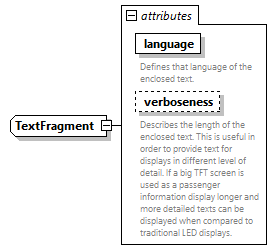 | ||||||||||||||||||||||
| namespace | https://www.railml.org/schemas/3.2 | ||||||||||||||||||||||
| type | extension of xs:string | ||||||||||||||||||||||
| properties |
| ||||||||||||||||||||||
| used by |
| ||||||||||||||||||||||
| attributes |
| ||||||||||||||||||||||
| source | <xs:complexType name="TextFragment"> <xs:simpleContent> <xs:extension base="xs:string"> <xs:attribute name="language" type="xs:language" use="required"> <xs:annotation> <xs:documentation>Defines that language of the enclosed text.</xs:documentation> </xs:annotation> </xs:attribute> <xs:attribute name="verboseness" type="rail3:Verboseness" use="optional"> <xs:annotation> <xs:documentation>Describes the length of the enclosed text. This is useful in order to provide text for displays in different level of detail. If a big TFT screen is used as a passenger information display longer and more detailed texts can be displayed when compared to traditional LED displays.</xs:documentation> </xs:annotation> </xs:attribute> </xs:extension> </xs:simpleContent> </xs:complexType> |
attribute TextFragment/@language
| type | xs:language | ||
| properties |
| ||
| annotation |
| ||
| source | <xs:attribute name="language" type="xs:language" use="required"> <xs:annotation> <xs:documentation>Defines that language of the enclosed text.</xs:documentation> </xs:annotation> </xs:attribute> |
attribute TextFragment/@verboseness
| type | rail3:Verboseness | ||||||||||||||||||
| properties |
| ||||||||||||||||||
| facets |
| ||||||||||||||||||
| annotation |
| ||||||||||||||||||
| source | <xs:attribute name="verboseness" type="rail3:Verboseness" use="optional"> <xs:annotation> <xs:documentation>Describes the length of the enclosed text. This is useful in order to provide text for displays in different level of detail. If a big TFT screen is used as a passenger information display longer and more detailed texts can be displayed when compared to traditional LED displays.</xs:documentation> </xs:annotation> </xs:attribute> |
complexType TextFragments
| diagram | 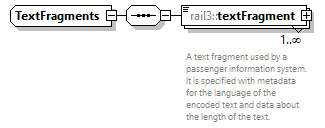 | ||
| namespace | https://www.railml.org/schemas/3.2 | ||
| children | rail3:textFragment | ||
| used by |
| ||
| source | <xs:complexType name="TextFragments"> <xs:sequence> <xs:element name="textFragment" type="rail3:TextFragment" minOccurs="1" maxOccurs="unbounded"> <xs:annotation> <xs:documentation>A text fragment used by a passenger information system. It is specified with metadata for the language of the encoded text and data about the length of the text.</xs:documentation> </xs:annotation> </xs:element> </xs:sequence> </xs:complexType> |
element TextFragments/textFragment
| diagram | 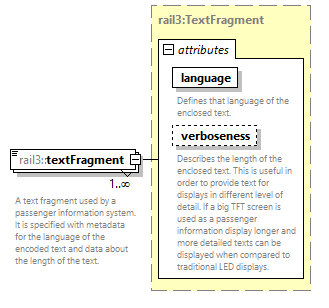 | ||||||||||||||||||||||
| namespace | https://www.railml.org/schemas/3.2 | ||||||||||||||||||||||
| type | rail3:TextFragment | ||||||||||||||||||||||
| properties |
| ||||||||||||||||||||||
| attributes |
| ||||||||||||||||||||||
| annotation |
| ||||||||||||||||||||||
| source | <xs:element name="textFragment" type="rail3:TextFragment" minOccurs="1" maxOccurs="unbounded"> <xs:annotation> <xs:documentation>A text fragment used by a passenger information system. It is specified with metadata for the language of the encoded text and data about the length of the text.</xs:documentation> </xs:annotation> </xs:element> |
complexType Time
| diagram | 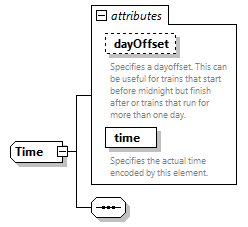 | ||||||||||||||||||||||
| namespace | https://www.railml.org/schemas/3.2 | ||||||||||||||||||||||
| used by |
| ||||||||||||||||||||||
| attributes |
| ||||||||||||||||||||||
| source | <xs:complexType name="Time"> <xs:sequence/> <xs:attribute name="dayOffset" type="rail3:DayOffset" use="optional" default="0"> <xs:annotation> <xs:documentation>Specifies a dayoffset. This can be useful for trains that start before midnight but finish after or trains that run for more than one day.</xs:documentation> </xs:annotation> </xs:attribute> <xs:attribute name="time" type="xs:time" use="required"> <xs:annotation> <xs:documentation>Specifies the actual time encoded by this element.</xs:documentation> </xs:annotation> </xs:attribute> </xs:complexType> |
attribute Time/@dayOffset
| type | rail3:DayOffset | |||||||||
| properties |
| |||||||||
| facets |
| |||||||||
| annotation |
| |||||||||
| source | <xs:attribute name="dayOffset" type="rail3:DayOffset" use="optional" default="0"> <xs:annotation> <xs:documentation>Specifies a dayoffset. This can be useful for trains that start before midnight but finish after or trains that run for more than one day.</xs:documentation> </xs:annotation> </xs:attribute> |
attribute Time/@time
| type | xs:time | ||
| properties |
| ||
| annotation |
| ||
| source | <xs:attribute name="time" type="xs:time" use="required"> <xs:annotation> <xs:documentation>Specifies the actual time encoded by this element.</xs:documentation> </xs:annotation> </xs:attribute> |
complexType TimeBasedCalculationRule
| diagram | 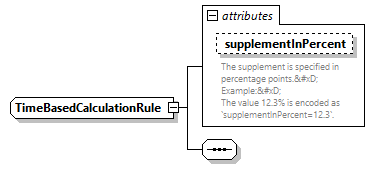 | ||||||||||||||
| namespace | https://www.railml.org/schemas/3.2 | ||||||||||||||
| used by |
| ||||||||||||||
| attributes |
| ||||||||||||||
| source | <xs:complexType name="TimeBasedCalculationRule"> <xs:sequence/> <xs:attribute name="supplementInPercent" type="xs:float" use="optional"> <xs:annotation> <xs:documentation>The supplement is specified in percentage points.
 Example:
 The value 12.3% is encoded as `supplementInPercent=12.3`.</xs:documentation> </xs:annotation> </xs:attribute> </xs:complexType> |
attribute TimeBasedCalculationRule/@supplementInPercent
| type | xs:float | ||
| properties |
| ||
| annotation |
| ||
| source | <xs:attribute name="supplementInPercent" type="xs:float" use="optional"> <xs:annotation> <xs:documentation>The supplement is specified in percentage points.
 Example:
 The value 12.3% is encoded as `supplementInPercent=12.3`.</xs:documentation> </xs:annotation> </xs:attribute> |
complexType Times
| diagram | 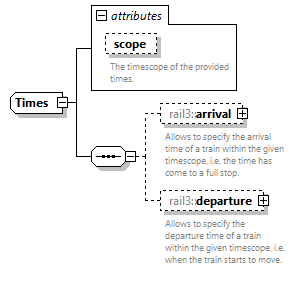 | ||||||||||||||
| namespace | https://www.railml.org/schemas/3.2 | ||||||||||||||
| children | rail3:arrival rail3:departure | ||||||||||||||
| used by |
| ||||||||||||||
| attributes |
| ||||||||||||||
| source | <xs:complexType name="Times"> <xs:sequence> <xs:element name="arrival" type="rail3:Time" form="qualified" minOccurs="0" maxOccurs="1"> <xs:annotation> <xs:documentation>Allows to specify the arrival time of a train within the given timescope, i.e. the time has come to a full stop.</xs:documentation> </xs:annotation> </xs:element> <xs:element name="departure" type="rail3:Time" form="qualified" minOccurs="0" maxOccurs="1"> <xs:annotation> <xs:documentation>Allows to specify the departure time of a train within the given timescope, i.e. when the train starts to move.</xs:documentation> </xs:annotation> </xs:element> </xs:sequence> <xs:attribute name="scope" type="rail3:TimeScopeExt" use="optional"> <xs:annotation> <xs:documentation>The timescope of the provided times.</xs:documentation> </xs:annotation> </xs:attribute> </xs:complexType> |
attribute Times/@scope
| type | rail3:TimeScopeExt | ||
| properties |
| ||
| annotation |
| ||
| source | <xs:attribute name="scope" type="rail3:TimeScopeExt" use="optional"> <xs:annotation> <xs:documentation>The timescope of the provided times.</xs:documentation> </xs:annotation> </xs:attribute> |
element Times/arrival
| diagram | 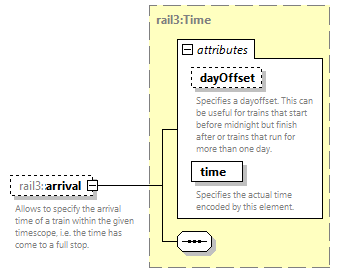 | ||||||||||||||||||||||
| namespace | https://www.railml.org/schemas/3.2 | ||||||||||||||||||||||
| type | rail3:Time | ||||||||||||||||||||||
| properties |
| ||||||||||||||||||||||
| attributes |
| ||||||||||||||||||||||
| annotation |
| ||||||||||||||||||||||
| source | <xs:element name="arrival" type="rail3:Time" form="qualified" minOccurs="0" maxOccurs="1"> <xs:annotation> <xs:documentation>Allows to specify the arrival time of a train within the given timescope, i.e. the time has come to a full stop.</xs:documentation> </xs:annotation> </xs:element> |
element Times/departure
| diagram | 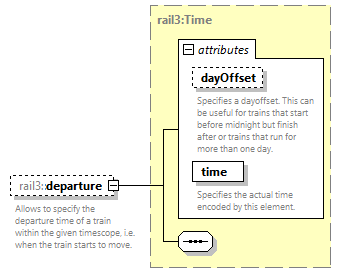 | ||||||||||||||||||||||
| namespace | https://www.railml.org/schemas/3.2 | ||||||||||||||||||||||
| type | rail3:Time | ||||||||||||||||||||||
| properties |
| ||||||||||||||||||||||
| attributes |
| ||||||||||||||||||||||
| annotation |
| ||||||||||||||||||||||
| source | <xs:element name="departure" type="rail3:Time" form="qualified" minOccurs="0" maxOccurs="1"> <xs:annotation> <xs:documentation>Allows to specify the departure time of a train within the given timescope, i.e. when the train starts to move.</xs:documentation> </xs:annotation> </xs:element> |
complexType Timetable
| diagram | 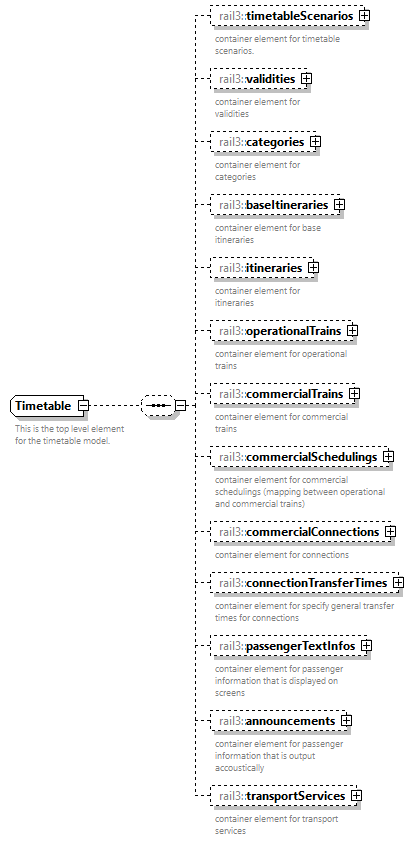 | ||
| namespace | https://www.railml.org/schemas/3.2 | ||
| children | rail3:timetableScenarios rail3:validities rail3:categories rail3:baseItineraries rail3:itineraries rail3:operationalTrains rail3:commercialTrains rail3:commercialSchedulings rail3:commercialConnections rail3:connectionTransferTimes rail3:passengerTextInfos rail3:announcements rail3:transportServices | ||
| used by |
| ||
| annotation |
| ||
| source | <xs:complexType name="Timetable"> <xs:annotation> <xs:documentation>This is the top level element for the timetable model.</xs:documentation> </xs:annotation> <xs:sequence minOccurs="0" maxOccurs="1"> <xs:element name="timetableScenarios" type="rail3:TimetableScenarios" minOccurs="0" maxOccurs="1"> <xs:annotation> <xs:documentation>container element for timetable scenarios.</xs:documentation> </xs:annotation> </xs:element> <xs:element name="validities" type="rail3:Validities" minOccurs="0" maxOccurs="1"> <xs:annotation> <xs:documentation>container element for validities</xs:documentation> </xs:annotation> </xs:element> <xs:element name="categories" type="rail3:Categories" minOccurs="0" maxOccurs="1"> <xs:annotation> <xs:documentation>container element for categories</xs:documentation> </xs:annotation> </xs:element> <xs:element name="baseItineraries" type="rail3:BaseItineraries" minOccurs="0" maxOccurs="1"> <xs:annotation> <xs:documentation>container element for base itineraries</xs:documentation> </xs:annotation> </xs:element> <xs:element name="itineraries" type="rail3:ItinerariesTT" minOccurs="0" maxOccurs="1"> <xs:annotation> <xs:documentation>container element for itineraries</xs:documentation> </xs:annotation> </xs:element> <xs:element name="operationalTrains" type="rail3:OperationalTrains" minOccurs="0" maxOccurs="1"> <xs:annotation> <xs:documentation>container element for operational trains</xs:documentation> </xs:annotation> </xs:element> <xs:element name="commercialTrains" type="rail3:CommercialTrains" minOccurs="0" maxOccurs="1"> <xs:annotation> <xs:documentation>container element for commercial trains</xs:documentation> </xs:annotation> </xs:element> <xs:element name="commercialSchedulings" type="rail3:CommercialSchedulings" minOccurs="0" maxOccurs="1"> <xs:annotation> <xs:documentation>container element for commercial schedulings (mapping between operational and commercial trains)</xs:documentation> </xs:annotation> </xs:element> <xs:element name="commercialConnections" type="rail3:CommercialConnections" minOccurs="0" maxOccurs="1"> <xs:annotation> <xs:documentation>container element for connections</xs:documentation> </xs:annotation> </xs:element> <xs:element name="connectionTransferTimes" type="rail3:ConnectionTransferTimes" minOccurs="0" maxOccurs="1"> <xs:annotation> <xs:documentation>container element for specify general transfer times for connections</xs:documentation> </xs:annotation> </xs:element> <xs:element name="passengerTextInfos" type="rail3:PassengerTextInfos" minOccurs="0" maxOccurs="1"> <xs:annotation> <xs:documentation>container element for passenger information that is displayed on screens</xs:documentation> </xs:annotation> </xs:element> <xs:element name="announcements" type="rail3:Announcements" minOccurs="0" maxOccurs="1"> <xs:annotation> <xs:documentation>container element for passenger information that is output accoustically</xs:documentation> </xs:annotation> </xs:element> <xs:element name="transportServices" type="rail3:TransportServices" minOccurs="0" maxOccurs="1"> <xs:annotation> <xs:documentation>container element for transport services</xs:documentation> </xs:annotation> </xs:element> </xs:sequence> </xs:complexType> |
element Timetable/timetableScenarios
| diagram | 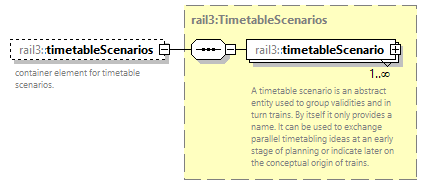 | ||||||
| namespace | https://www.railml.org/schemas/3.2 | ||||||
| type | rail3:TimetableScenarios | ||||||
| properties |
| ||||||
| children | rail3:timetableScenario | ||||||
| annotation |
| ||||||
| source | <xs:element name="timetableScenarios" type="rail3:TimetableScenarios" minOccurs="0" maxOccurs="1"> <xs:annotation> <xs:documentation>container element for timetable scenarios.</xs:documentation> </xs:annotation> </xs:element> |
element Timetable/validities
| diagram | 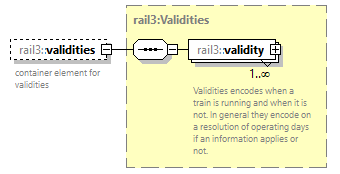 | ||||||
| namespace | https://www.railml.org/schemas/3.2 | ||||||
| type | rail3:Validities | ||||||
| properties |
| ||||||
| children | rail3:validity | ||||||
| annotation |
| ||||||
| source | <xs:element name="validities" type="rail3:Validities" minOccurs="0" maxOccurs="1"> <xs:annotation> <xs:documentation>container element for validities</xs:documentation> </xs:annotation> </xs:element> |
element Timetable/categories
| diagram | 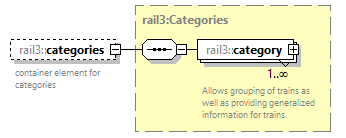 | ||||||
| namespace | https://www.railml.org/schemas/3.2 | ||||||
| type | rail3:Categories | ||||||
| properties |
| ||||||
| children | rail3:category | ||||||
| annotation |
| ||||||
| source | <xs:element name="categories" type="rail3:Categories" minOccurs="0" maxOccurs="1"> <xs:annotation> <xs:documentation>container element for categories</xs:documentation> </xs:annotation> </xs:element> |
element Timetable/baseItineraries
| diagram | 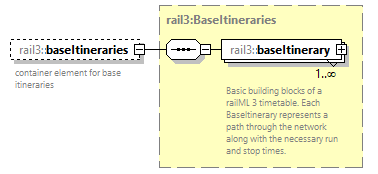 | ||||||
| namespace | https://www.railml.org/schemas/3.2 | ||||||
| type | rail3:BaseItineraries | ||||||
| properties |
| ||||||
| children | rail3:baseItinerary | ||||||
| annotation |
| ||||||
| source | <xs:element name="baseItineraries" type="rail3:BaseItineraries" minOccurs="0" maxOccurs="1"> <xs:annotation> <xs:documentation>container element for base itineraries</xs:documentation> </xs:annotation> </xs:element> |
element Timetable/itineraries
| diagram | 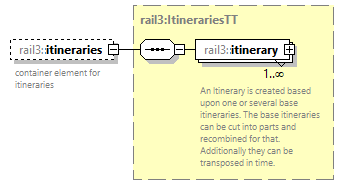 | ||||||
| namespace | https://www.railml.org/schemas/3.2 | ||||||
| type | rail3:ItinerariesTT | ||||||
| properties |
| ||||||
| children | rail3:itinerary | ||||||
| annotation |
| ||||||
| source | <xs:element name="itineraries" type="rail3:ItinerariesTT" minOccurs="0" maxOccurs="1"> <xs:annotation> <xs:documentation>container element for itineraries</xs:documentation> </xs:annotation> </xs:element> |
element Timetable/operationalTrains
| diagram | 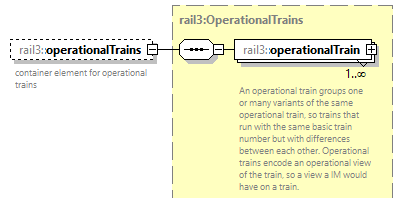 | ||||||
| namespace | https://www.railml.org/schemas/3.2 | ||||||
| type | rail3:OperationalTrains | ||||||
| properties |
| ||||||
| children | rail3:operationalTrain | ||||||
| annotation |
| ||||||
| source | <xs:element name="operationalTrains" type="rail3:OperationalTrains" minOccurs="0" maxOccurs="1"> <xs:annotation> <xs:documentation>container element for operational trains</xs:documentation> </xs:annotation> </xs:element> |
element Timetable/commercialTrains
| diagram | 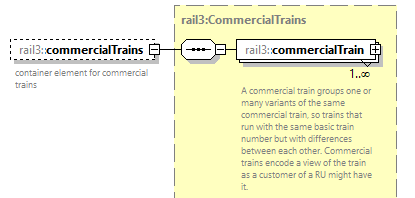 | ||||||
| namespace | https://www.railml.org/schemas/3.2 | ||||||
| type | rail3:CommercialTrains | ||||||
| properties |
| ||||||
| children | rail3:commercialTrain | ||||||
| annotation |
| ||||||
| source | <xs:element name="commercialTrains" type="rail3:CommercialTrains" minOccurs="0" maxOccurs="1"> <xs:annotation> <xs:documentation>container element for commercial trains</xs:documentation> </xs:annotation> </xs:element> |
element Timetable/commercialSchedulings
| diagram | 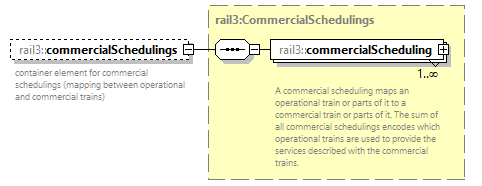 | ||||||
| namespace | https://www.railml.org/schemas/3.2 | ||||||
| type | rail3:CommercialSchedulings | ||||||
| properties |
| ||||||
| children | rail3:commercialScheduling | ||||||
| annotation |
| ||||||
| source | <xs:element name="commercialSchedulings" type="rail3:CommercialSchedulings" minOccurs="0" maxOccurs="1"> <xs:annotation> <xs:documentation>container element for commercial schedulings (mapping between operational and commercial trains)</xs:documentation> </xs:annotation> </xs:element> |
element Timetable/commercialConnections
| diagram |  | ||||||
| namespace | https://www.railml.org/schemas/3.2 | ||||||
| type | rail3:CommercialConnections | ||||||
| properties |
| ||||||
| children | rail3:commercialConnection | ||||||
| annotation |
| ||||||
| source | <xs:element name="commercialConnections" type="rail3:CommercialConnections" minOccurs="0" maxOccurs="1"> <xs:annotation> <xs:documentation>container element for connections</xs:documentation> </xs:annotation> </xs:element> |
element Timetable/connectionTransferTimes
| diagram |  | ||||||
| namespace | https://www.railml.org/schemas/3.2 | ||||||
| type | rail3:ConnectionTransferTimes | ||||||
| properties |
| ||||||
| children | rail3:connectionTransferTime | ||||||
| annotation |
| ||||||
| source | <xs:element name="connectionTransferTimes" type="rail3:ConnectionTransferTimes" minOccurs="0" maxOccurs="1"> <xs:annotation> <xs:documentation>container element for specify general transfer times for connections</xs:documentation> </xs:annotation> </xs:element> |
element Timetable/passengerTextInfos
| diagram |  | ||||||
| namespace | https://www.railml.org/schemas/3.2 | ||||||
| type | rail3:PassengerTextInfos | ||||||
| properties |
| ||||||
| children | rail3:passengerTextInfo | ||||||
| annotation |
| ||||||
| source | <xs:element name="passengerTextInfos" type="rail3:PassengerTextInfos" minOccurs="0" maxOccurs="1"> <xs:annotation> <xs:documentation>container element for passenger information that is displayed on screens</xs:documentation> </xs:annotation> </xs:element> |
element Timetable/announcements
| diagram | 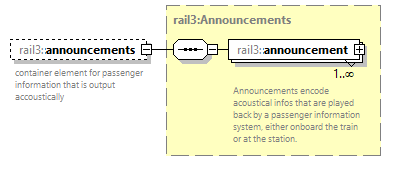 | ||||||
| namespace | https://www.railml.org/schemas/3.2 | ||||||
| type | rail3:Announcements | ||||||
| properties |
| ||||||
| children | rail3:announcement | ||||||
| annotation |
| ||||||
| source | <xs:element name="announcements" type="rail3:Announcements" minOccurs="0" maxOccurs="1"> <xs:annotation> <xs:documentation>container element for passenger information that is output accoustically</xs:documentation> </xs:annotation> </xs:element> |
element Timetable/transportServices
| diagram | 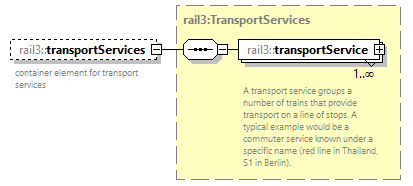 | ||||||
| namespace | https://www.railml.org/schemas/3.2 | ||||||
| type | rail3:TransportServices | ||||||
| properties |
| ||||||
| children | rail3:transportService | ||||||
| annotation |
| ||||||
| source | <xs:element name="transportServices" type="rail3:TransportServices" minOccurs="0" maxOccurs="1"> <xs:annotation> <xs:documentation>container element for transport services</xs:documentation> </xs:annotation> </xs:element> |
complexType TimetableScenario
| diagram | 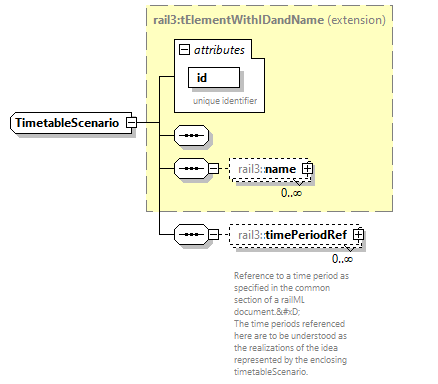 | ||||||||||||||
| namespace | https://www.railml.org/schemas/3.2 | ||||||||||||||
| type | extension of rail3:tElementWithIDandName | ||||||||||||||
| properties |
| ||||||||||||||
| children | rail3:name rail3:timePeriodRef | ||||||||||||||
| used by |
| ||||||||||||||
| attributes |
| ||||||||||||||
| source | <xs:complexType name="TimetableScenario"> <xs:complexContent> <xs:extension base="rail3:tElementWithIDandName"> <xs:sequence> <xs:element name="timePeriodRef" type="rail3:tElementWithIDref" minOccurs="0" maxOccurs="unbounded"> <xs:annotation> <xs:documentation>Reference to a time period as specified in the common section of a railML document.
 The time periods referenced here are to be understood as the realizations of the idea represented by the enclosing timetableScenario.</xs:documentation> </xs:annotation> </xs:element> </xs:sequence> </xs:extension> </xs:complexContent> </xs:complexType> |
element TimetableScenario/timePeriodRef
| diagram | 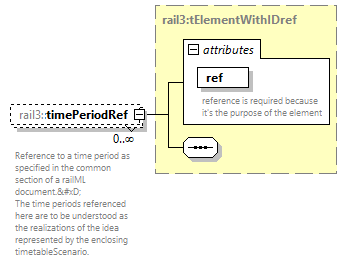 | ||||||||||||||
| namespace | https://www.railml.org/schemas/3.2 | ||||||||||||||
| type | rail3:tElementWithIDref | ||||||||||||||
| properties |
| ||||||||||||||
| attributes |
| ||||||||||||||
| annotation |
| ||||||||||||||
| source | <xs:element name="timePeriodRef" type="rail3:tElementWithIDref" minOccurs="0" maxOccurs="unbounded"> <xs:annotation> <xs:documentation>Reference to a time period as specified in the common section of a railML document.
 The time periods referenced here are to be understood as the realizations of the idea represented by the enclosing timetableScenario.</xs:documentation> </xs:annotation> </xs:element> |
complexType TimetableScenarios
| diagram | 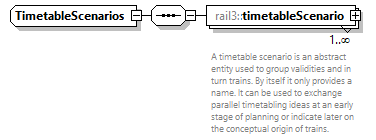 | ||
| namespace | https://www.railml.org/schemas/3.2 | ||
| children | rail3:timetableScenario | ||
| used by |
| ||
| source | <xs:complexType name="TimetableScenarios"> <xs:sequence> <xs:element name="timetableScenario" type="rail3:TimetableScenario" minOccurs="1" maxOccurs="unbounded"> <xs:annotation> <xs:documentation>A timetable scenario is an abstract entity used to group validities and in turn trains. By itself it only provides a name. It can be used to exchange parallel timetabling ideas at an early stage of planning or indicate later on the conceptual origin of trains.</xs:documentation> </xs:annotation> </xs:element> </xs:sequence> </xs:complexType> |
element TimetableScenarios/timetableScenario
| diagram | 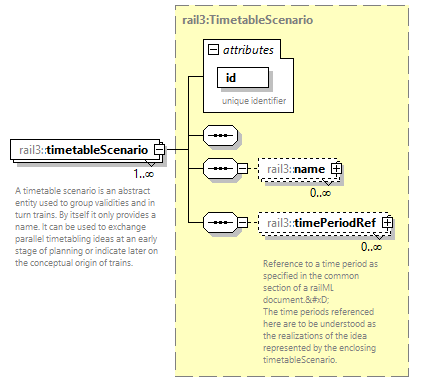 | ||||||||||||||
| namespace | https://www.railml.org/schemas/3.2 | ||||||||||||||
| type | rail3:TimetableScenario | ||||||||||||||
| properties |
| ||||||||||||||
| children | rail3:name rail3:timePeriodRef | ||||||||||||||
| attributes |
| ||||||||||||||
| annotation |
| ||||||||||||||
| source | <xs:element name="timetableScenario" type="rail3:TimetableScenario" minOccurs="1" maxOccurs="unbounded"> <xs:annotation> <xs:documentation>A timetable scenario is an abstract entity used to group validities and in turn trains. By itself it only provides a name. It can be used to exchange parallel timetabling ideas at an early stage of planning or indicate later on the conceptual origin of trains.</xs:documentation> </xs:annotation> </xs:element> |
complexType TrackRef
| diagram | 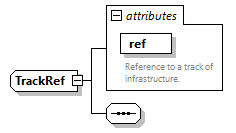 | ||||||||||||||
| namespace | https://www.railml.org/schemas/3.2 | ||||||||||||||
| used by |
| ||||||||||||||
| attributes |
| ||||||||||||||
| source | <xs:complexType name="TrackRef"> <xs:sequence/> <xs:attribute name="ref" type="rail3:tRef" use="required"> <xs:annotation> <xs:documentation>Reference to a track of infrastructure.</xs:documentation> </xs:annotation> </xs:attribute> </xs:complexType> |
attribute TrackRef/@ref
| type | rail3:tRef | ||
| properties |
| ||
| annotation |
| ||
| source | <xs:attribute name="ref" type="rail3:tRef" use="required"> <xs:annotation> <xs:documentation>Reference to a track of infrastructure.</xs:documentation> </xs:annotation> </xs:attribute> |
complexType TrackRefs
| diagram |  | ||
| namespace | https://www.railml.org/schemas/3.2 | ||
| children | rail3:trackRef | ||
| used by |
| ||
| source | <xs:complexType name="TrackRefs"> <xs:sequence> <xs:element name="trackRef" type="rail3:TrackRef" minOccurs="1" maxOccurs="unbounded"> <xs:annotation> <xs:documentation>Container element for track references.</xs:documentation> </xs:annotation> </xs:element> </xs:sequence> </xs:complexType> |
element TrackRefs/trackRef
| diagram | 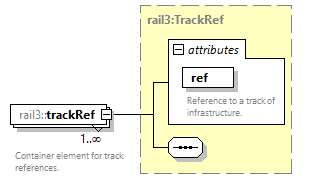 | ||||||||||||||
| namespace | https://www.railml.org/schemas/3.2 | ||||||||||||||
| type | rail3:TrackRef | ||||||||||||||
| properties |
| ||||||||||||||
| attributes |
| ||||||||||||||
| annotation |
| ||||||||||||||
| source | <xs:element name="trackRef" type="rail3:TrackRef" minOccurs="1" maxOccurs="unbounded"> <xs:annotation> <xs:documentation>Container element for track references.</xs:documentation> </xs:annotation> </xs:element> |
complexType TransferLocation
| diagram | 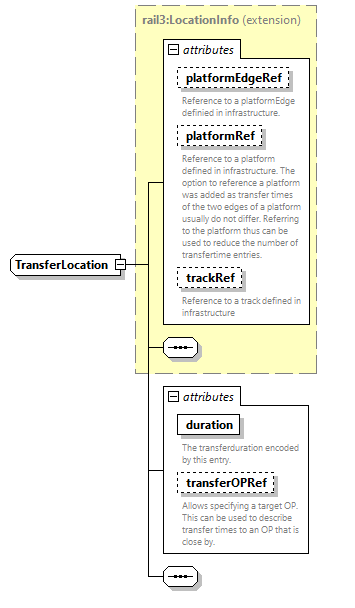 | ||||||||||||||||||||||||||||||||||||||||||||||
| namespace | https://www.railml.org/schemas/3.2 | ||||||||||||||||||||||||||||||||||||||||||||||
| type | extension of rail3:LocationInfo | ||||||||||||||||||||||||||||||||||||||||||||||
| properties |
| ||||||||||||||||||||||||||||||||||||||||||||||
| used by |
| ||||||||||||||||||||||||||||||||||||||||||||||
| attributes |
| ||||||||||||||||||||||||||||||||||||||||||||||
| source | <xs:complexType name="TransferLocation"> <xs:complexContent> <xs:extension base="rail3:LocationInfo"> <xs:sequence/> <xs:attribute name="duration" type="xs:duration" use="required"> <xs:annotation> <xs:documentation>The transferduration encoded by this entry.</xs:documentation> </xs:annotation> </xs:attribute> <xs:attribute name="transferOPRef" type="rail3:tRef" use="optional"> <xs:annotation> <xs:documentation>Allows specifying a target OP. This can be used to describe transfer times to an OP that is close by.</xs:documentation> </xs:annotation> </xs:attribute> </xs:extension> </xs:complexContent> </xs:complexType> |
attribute TransferLocation/@duration
| type | xs:duration | ||
| properties |
| ||
| annotation |
| ||
| source | <xs:attribute name="duration" type="xs:duration" use="required"> <xs:annotation> <xs:documentation>The transferduration encoded by this entry.</xs:documentation> </xs:annotation> </xs:attribute> |
attribute TransferLocation/@transferOPRef
| type | rail3:tRef | ||
| properties |
| ||
| annotation |
| ||
| source | <xs:attribute name="transferOPRef" type="rail3:tRef" use="optional"> <xs:annotation> <xs:documentation>Allows specifying a target OP. This can be used to describe transfer times to an OP that is close by.</xs:documentation> </xs:annotation> </xs:attribute> |
complexType TransportService
| diagram | 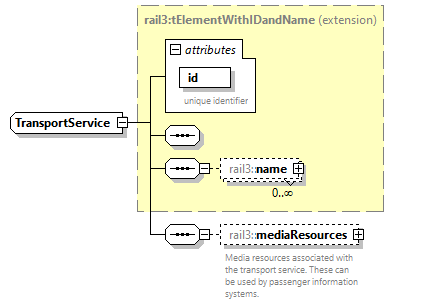 | ||||||||||||||
| namespace | https://www.railml.org/schemas/3.2 | ||||||||||||||
| type | extension of rail3:tElementWithIDandName | ||||||||||||||
| properties |
| ||||||||||||||
| children | rail3:name rail3:mediaResources | ||||||||||||||
| used by |
| ||||||||||||||
| attributes |
| ||||||||||||||
| source | <xs:complexType name="TransportService"> <xs:complexContent> <xs:extension base="rail3:tElementWithIDandName"> <xs:sequence> <xs:element name="mediaResources" type="rail3:MediaResources" minOccurs="0" maxOccurs="1"> <xs:annotation> <xs:documentation>Media resources associated with the transport service. These can be used by passenger information systems.</xs:documentation> </xs:annotation> </xs:element> </xs:sequence> </xs:extension> </xs:complexContent> </xs:complexType> |
element TransportService/mediaResources
| diagram | 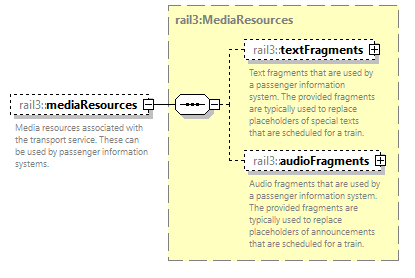 | ||||||
| namespace | https://www.railml.org/schemas/3.2 | ||||||
| type | rail3:MediaResources | ||||||
| properties |
| ||||||
| children | rail3:textFragments rail3:audioFragments | ||||||
| annotation |
| ||||||
| source | <xs:element name="mediaResources" type="rail3:MediaResources" minOccurs="0" maxOccurs="1"> <xs:annotation> <xs:documentation>Media resources associated with the transport service. These can be used by passenger information systems.</xs:documentation> </xs:annotation> </xs:element> |
complexType TransportServiceReference
| diagram | 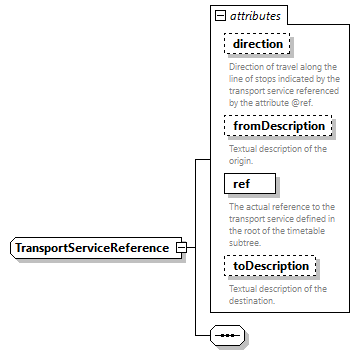 | ||||||||||||||||||||||||||||||||||||||
| namespace | https://www.railml.org/schemas/3.2 | ||||||||||||||||||||||||||||||||||||||
| used by |
| ||||||||||||||||||||||||||||||||||||||
| attributes |
| ||||||||||||||||||||||||||||||||||||||
| source | <xs:complexType name="TransportServiceReference"> <xs:sequence/> <xs:attribute name="direction" type="rail3:Direction" use="optional"> <xs:annotation> <xs:documentation>Direction of travel along the line of stops indicated by the transport service referenced by the attribute @ref.</xs:documentation> </xs:annotation> </xs:attribute> <xs:attribute name="fromDescription" type="xs:string" use="optional"> <xs:annotation> <xs:documentation>Textual description of the origin.</xs:documentation> </xs:annotation> </xs:attribute> <xs:attribute name="ref" type="rail3:tRef" use="required"> <xs:annotation> <xs:documentation>The actual reference to the transport service defined in the root of the timetable subtree.</xs:documentation> </xs:annotation> </xs:attribute> <xs:attribute name="toDescription" type="xs:string" use="optional"> <xs:annotation> <xs:documentation>Textual description of the destination.</xs:documentation> </xs:annotation> </xs:attribute> </xs:complexType> |
attribute TransportServiceReference/@direction
| type | rail3:Direction | |||||||||
| properties |
| |||||||||
| facets |
| |||||||||
| annotation |
| |||||||||
| source | <xs:attribute name="direction" type="rail3:Direction" use="optional"> <xs:annotation> <xs:documentation>Direction of travel along the line of stops indicated by the transport service referenced by the attribute @ref.</xs:documentation> </xs:annotation> </xs:attribute> |
attribute TransportServiceReference/@fromDescription
| type | xs:string | ||
| properties |
| ||
| annotation |
| ||
| source | <xs:attribute name="fromDescription" type="xs:string" use="optional"> <xs:annotation> <xs:documentation>Textual description of the origin.</xs:documentation> </xs:annotation> </xs:attribute> |
attribute TransportServiceReference/@ref
| type | rail3:tRef | ||
| properties |
| ||
| annotation |
| ||
| source | <xs:attribute name="ref" type="rail3:tRef" use="required"> <xs:annotation> <xs:documentation>The actual reference to the transport service defined in the root of the timetable subtree.</xs:documentation> </xs:annotation> </xs:attribute> |
attribute TransportServiceReference/@toDescription
| type | xs:string | ||
| properties |
| ||
| annotation |
| ||
| source | <xs:attribute name="toDescription" type="xs:string" use="optional"> <xs:annotation> <xs:documentation>Textual description of the destination.</xs:documentation> </xs:annotation> </xs:attribute> |
complexType TransportServices
| diagram | 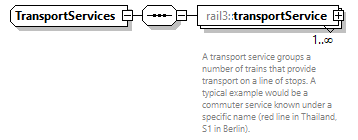 | ||
| namespace | https://www.railml.org/schemas/3.2 | ||
| children | rail3:transportService | ||
| used by |
| ||
| source | <xs:complexType name="TransportServices"> <xs:sequence> <xs:element name="transportService" type="rail3:TransportService" minOccurs="1" maxOccurs="unbounded"> <xs:annotation> <xs:documentation>A transport service groups a number of trains that provide transport on a line of stops. A typical example would be a commuter service known under a specific name (red line in Thailand, S1 in Berlin).</xs:documentation> </xs:annotation> </xs:element> </xs:sequence> </xs:complexType> |
element TransportServices/transportService
| diagram | 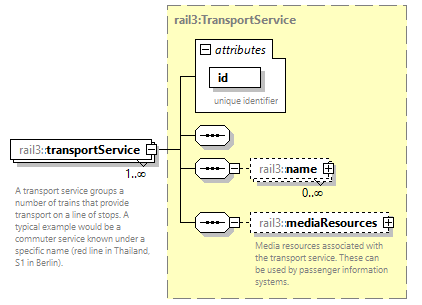 | ||||||||||||||
| namespace | https://www.railml.org/schemas/3.2 | ||||||||||||||
| type | rail3:TransportService | ||||||||||||||
| properties |
| ||||||||||||||
| children | rail3:name rail3:mediaResources | ||||||||||||||
| attributes |
| ||||||||||||||
| annotation |
| ||||||||||||||
| source | <xs:element name="transportService" type="rail3:TransportService" minOccurs="1" maxOccurs="unbounded"> <xs:annotation> <xs:documentation>A transport service groups a number of trains that provide transport on a line of stops. A typical example would be a commuter service known under a specific name (red line in Thailand, S1 in Berlin).</xs:documentation> </xs:annotation> </xs:element> |
complexType Validities
| diagram | 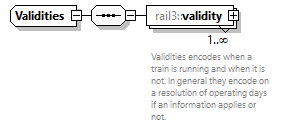 | ||
| namespace | https://www.railml.org/schemas/3.2 | ||
| children | rail3:validity | ||
| used by |
| ||
| source | <xs:complexType name="Validities"> <xs:sequence> <xs:element name="validity" type="rail3:Validity" minOccurs="1" maxOccurs="unbounded"> <xs:annotation> <xs:documentation>Validities encodes when a train is running and when it is not. In general they encode on a resolution of operating days if an information applies or not.</xs:documentation> </xs:annotation> </xs:element> </xs:sequence> </xs:complexType> |
element Validities/validity
| diagram | 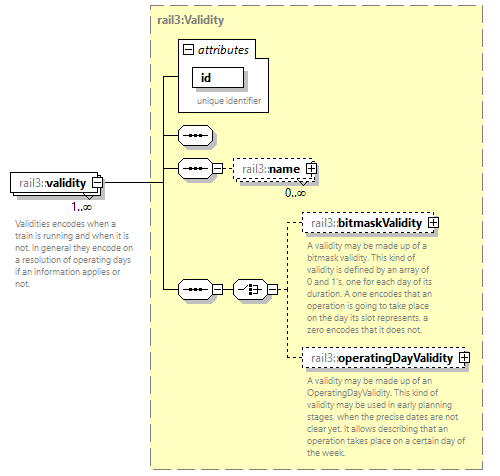 | ||||||||||||||
| namespace | https://www.railml.org/schemas/3.2 | ||||||||||||||
| type | rail3:Validity | ||||||||||||||
| properties |
| ||||||||||||||
| children | rail3:name rail3:bitmaskValidity rail3:operatingDayValidity | ||||||||||||||
| attributes |
| ||||||||||||||
| annotation |
| ||||||||||||||
| source | <xs:element name="validity" type="rail3:Validity" minOccurs="1" maxOccurs="unbounded"> <xs:annotation> <xs:documentation>Validities encodes when a train is running and when it is not. In general they encode on a resolution of operating days if an information applies or not.</xs:documentation> </xs:annotation> </xs:element> |
complexType Validity
| diagram | 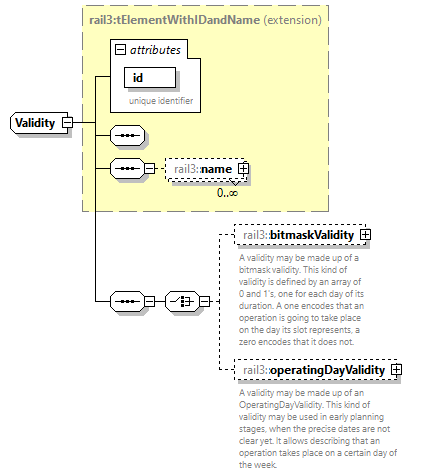 | ||||||||||||||
| namespace | https://www.railml.org/schemas/3.2 | ||||||||||||||
| type | extension of rail3:tElementWithIDandName | ||||||||||||||
| properties |
| ||||||||||||||
| children | rail3:name rail3:bitmaskValidity rail3:operatingDayValidity | ||||||||||||||
| used by |
| ||||||||||||||
| attributes |
| ||||||||||||||
| source | <xs:complexType name="Validity"> <xs:complexContent> <xs:extension base="rail3:tElementWithIDandName"> <xs:sequence> <xs:choice minOccurs="1" maxOccurs="1"> <xs:element name="bitmaskValidity" type="rail3:BitmaskValidity" minOccurs="0" maxOccurs="1"> <xs:annotation> <xs:documentation>A validity may be made up of a bitmask validity. This kind of validity is defined by an array of 0 and 1's, one for each day of its duration. A one encodes that an operation is going to take place on the day its slot represents, a zero encodes that it does not.</xs:documentation> </xs:annotation> </xs:element> <xs:element name="operatingDayValidity" type="rail3:OperatingDayValidity" minOccurs="0" maxOccurs="1"> <xs:annotation> <xs:documentation>A validity may be made up of an OperatingDayValidity. This kind of validity may be used in early planning stages, when the precise dates are not clear yet. It allows describing that an operation takes place on a certain day of the week. </xs:documentation> </xs:annotation> </xs:element> </xs:choice> </xs:sequence> </xs:extension> </xs:complexContent> </xs:complexType> |
element Validity/bitmaskValidity
| diagram | 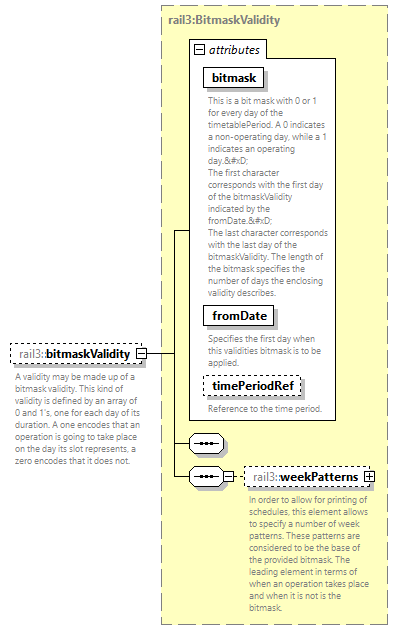 | ||||||||||||||||||||||||||||||
| namespace | https://www.railml.org/schemas/3.2 | ||||||||||||||||||||||||||||||
| type | rail3:BitmaskValidity | ||||||||||||||||||||||||||||||
| properties |
| ||||||||||||||||||||||||||||||
| children | rail3:weekPatterns | ||||||||||||||||||||||||||||||
| attributes |
| ||||||||||||||||||||||||||||||
| annotation |
| ||||||||||||||||||||||||||||||
| source | <xs:element name="bitmaskValidity" type="rail3:BitmaskValidity" minOccurs="0" maxOccurs="1"> <xs:annotation> <xs:documentation>A validity may be made up of a bitmask validity. This kind of validity is defined by an array of 0 and 1's, one for each day of its duration. A one encodes that an operation is going to take place on the day its slot represents, a zero encodes that it does not.</xs:documentation> </xs:annotation> </xs:element> |
element Validity/operatingDayValidity
| diagram | 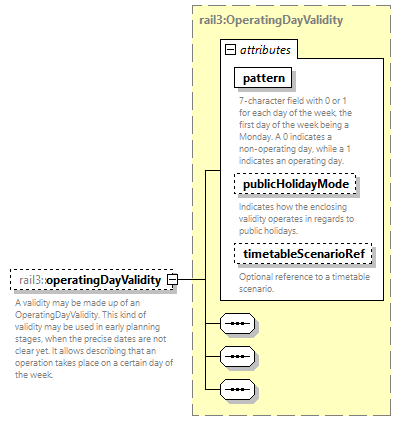 | ||||||||||||||||||||||||||||||
| namespace | https://www.railml.org/schemas/3.2 | ||||||||||||||||||||||||||||||
| type | rail3:OperatingDayValidity | ||||||||||||||||||||||||||||||
| properties |
| ||||||||||||||||||||||||||||||
| attributes |
| ||||||||||||||||||||||||||||||
| annotation |
| ||||||||||||||||||||||||||||||
| source | <xs:element name="operatingDayValidity" type="rail3:OperatingDayValidity" minOccurs="0" maxOccurs="1"> <xs:annotation> <xs:documentation>A validity may be made up of an OperatingDayValidity. This kind of validity may be used in early planning stages, when the precise dates are not clear yet. It allows describing that an operation takes place on a certain day of the week. </xs:documentation> </xs:annotation> </xs:element> |
simpleType CrewType
| namespace | https://www.railml.org/schemas/3.2 | |||||||||||||
| type | restriction of xs:string | |||||||||||||
| properties |
| |||||||||||||
| used by |
| |||||||||||||
| facets |
| |||||||||||||
| source | <xs:simpleType name="CrewType"> <xs:restriction base="xs:string"> <xs:enumeration value="conductor"> <xs:annotation> <xs:documentation>Staff that is in contact with the passengers and for example sells and/or checks tickets.</xs:documentation> </xs:annotation> </xs:enumeration> <xs:enumeration value="engineer"> <xs:annotation> <xs:documentation>Driver of the train</xs:documentation> </xs:annotation> </xs:enumeration> </xs:restriction> </xs:simpleType> |
simpleType CrewTypeExt
| namespace | https://www.railml.org/schemas/3.2 | ||
| type | union of (rail3:CrewType, rail3:tOtherEnumerationValue) | ||
| used by |
| ||
| source | <xs:simpleType name="CrewTypeExt"> <xs:union memberTypes="rail3:CrewType rail3:tOtherEnumerationValue"/> </xs:simpleType> |
simpleType DayOffset
| namespace | https://www.railml.org/schemas/3.2 | |||||||||
| type | restriction of xs:int | |||||||||
| properties |
| |||||||||
| used by |
| |||||||||
| facets |
| |||||||||
| annotation |
| |||||||||
| source | <xs:simpleType name="DayOffset"> <xs:annotation> <xs:documentation>restricted to -7 to +7</xs:documentation> </xs:annotation> <xs:restriction base="xs:int"> <xs:maxInclusive value="7"/> <xs:minInclusive value="-7"/> </xs:restriction> </xs:simpleType> |
simpleType Direction
| namespace | https://www.railml.org/schemas/3.2 | |||||||||
| type | restriction of xs:string | |||||||||
| properties |
| |||||||||
| used by |
| |||||||||
| facets |
| |||||||||
| source | <xs:simpleType name="Direction"> <xs:restriction base="xs:string"> <xs:enumeration value="backward"/> <xs:enumeration value="forward"/> </xs:restriction> </xs:simpleType> |
simpleType IdentifierType
| namespace | https://www.railml.org/schemas/3.2 | ||||||||||||||||||||||||
| type | restriction of xs:string | ||||||||||||||||||||||||
| properties |
| ||||||||||||||||||||||||
| used by |
| ||||||||||||||||||||||||
| facets |
| ||||||||||||||||||||||||
| source | <xs:simpleType name="IdentifierType"> <xs:restriction base="xs:string"> <xs:enumeration value="CommercialTrainNumber"/> <xs:enumeration value="OperationalTrainNumber"/> <xs:enumeration value="TafTapTsiCaseReferenceId"/> <xs:enumeration value="TafTapTsiPathId"/> <xs:enumeration value="TafTapTsiPathRequestId"/> <xs:enumeration value="TafTapTsiRouteId"/> <xs:enumeration value="TafTapTsiTrainId"/> </xs:restriction> </xs:simpleType> |
simpleType IdentifierTypeExt
| namespace | https://www.railml.org/schemas/3.2 | ||
| type | union of (rail3:IdentifierType, rail3:tOtherEnumerationValue) | ||
| used by |
| ||
| source | <xs:simpleType name="IdentifierTypeExt"> <xs:union memberTypes="rail3:IdentifierType rail3:tOtherEnumerationValue"/> </xs:simpleType> |
simpleType InterruptionReason
| namespace | https://www.railml.org/schemas/3.2 | ||||||||||||||||||||||||||||||
| type | restriction of xs:string | ||||||||||||||||||||||||||||||
| properties |
| ||||||||||||||||||||||||||||||
| used by |
| ||||||||||||||||||||||||||||||
| facets |
| ||||||||||||||||||||||||||||||
| source | <xs:simpleType name="InterruptionReason"> <xs:restriction base="xs:string"> <xs:enumeration value="CausesOfOtherIM"/> <xs:enumeration value="CausesOfOtherRU"/> <xs:enumeration value="CivilEngineeringCauses"/> <xs:enumeration value="CommercialCauses"/> <xs:enumeration value="ExternalCauses"/> <xs:enumeration value="InfrastructureInstallations"/> <xs:enumeration value="OperationalPlanning"/> <xs:enumeration value="Rollingstock"/> <xs:enumeration value="SecondaryCauses"/> </xs:restriction> </xs:simpleType> |
simpleType InterruptionReasonExt
| namespace | https://www.railml.org/schemas/3.2 | ||
| type | union of (rail3:InterruptionReason, rail3:tOtherEnumerationValue) | ||
| used by |
| ||
| source | <xs:simpleType name="InterruptionReasonExt"> <xs:union memberTypes="rail3:InterruptionReason rail3:tOtherEnumerationValue"/> </xs:simpleType> |
simpleType OnOff
| namespace | https://www.railml.org/schemas/3.2 | ||||||||||||||||||
| type | restriction of xs:string | ||||||||||||||||||
| properties |
| ||||||||||||||||||
| used by |
| ||||||||||||||||||
| facets |
| ||||||||||||||||||
| source | <xs:simpleType name="OnOff"> <xs:restriction base="xs:string"> <xs:enumeration value="both"> <xs:annotation> <xs:documentation>Allows entering and exiting the train</xs:documentation> </xs:annotation> </xs:enumeration> <xs:enumeration value="off"> <xs:annotation> <xs:documentation>Allows exiting the train</xs:documentation> </xs:annotation> </xs:enumeration> <xs:enumeration value="on"> <xs:annotation> <xs:documentation>Allows entering the train</xs:documentation> </xs:annotation> </xs:enumeration> </xs:restriction> </xs:simpleType> |
simpleType PassengerTextInfoType
| namespace | https://www.railml.org/schemas/3.2 | ||||||||||||||||||
| type | restriction of xs:string | ||||||||||||||||||
| properties |
| ||||||||||||||||||
| used by |
| ||||||||||||||||||
| facets |
| ||||||||||||||||||
| source | <xs:simpleType name="PassengerTextInfoType"> <xs:restriction base="xs:string"> <xs:enumeration value="image"> <xs:annotation> <xs:documentation>Indicates that the passenger text info takes the form of an image</xs:documentation> </xs:annotation> </xs:enumeration> <xs:enumeration value="symbol"> <xs:annotation> <xs:documentation>Indicates that the element is a symbol</xs:documentation> </xs:annotation> </xs:enumeration> <xs:enumeration value="text"> <xs:annotation> <xs:documentation>Indicates that the element is text based.</xs:documentation> </xs:annotation> </xs:enumeration> </xs:restriction> </xs:simpleType> |
simpleType RuntimeReserveType
| namespace | https://www.railml.org/schemas/3.2 | |||||||||||||||||||||||||||
| type | restriction of xs:string | |||||||||||||||||||||||||||
| properties |
| |||||||||||||||||||||||||||
| used by |
| |||||||||||||||||||||||||||
| facets |
| |||||||||||||||||||||||||||
| source | <xs:simpleType name="RuntimeReserveType"> <xs:restriction base="xs:string"> <xs:enumeration value="general"> <xs:annotation> <xs:documentation>General as defined by UIC 451-1:2000</xs:documentation> </xs:annotation> </xs:enumeration> <xs:enumeration value="qualityByInfrastructureManager"/> <xs:enumeration value="qualityByRailwayUndertaking"/> <xs:enumeration value="synchronization"> <xs:annotation> <xs:documentation>Used for synchronizing regular schedules (i.e. trains that run repeatedly during the day - once per hour)</xs:documentation> </xs:annotation> </xs:enumeration> <xs:enumeration value="trackworkByInfrastructureManager"/> <xs:enumeration value="unspecified"> <xs:annotation> <xs:documentation>Can be used if no information about the type of supplement can be provided.</xs:documentation> </xs:annotation> </xs:enumeration> </xs:restriction> </xs:simpleType> |
simpleType RuntimeReserveTypeExt
| namespace | https://www.railml.org/schemas/3.2 | ||
| type | union of (rail3:RuntimeReserveType, rail3:tOtherEnumerationValue) | ||
| used by |
| ||
| source | <xs:simpleType name="RuntimeReserveTypeExt"> <xs:union memberTypes="rail3:RuntimeReserveType rail3:tOtherEnumerationValue"/> </xs:simpleType> |
simpleType TafTapTsiObjectType
| namespace | https://www.railml.org/schemas/3.2 | |||||||||||||||
| type | restriction of xs:string | |||||||||||||||
| properties |
| |||||||||||||||
| used by |
| |||||||||||||||
| facets |
| |||||||||||||||
| source | <xs:simpleType name="TafTapTsiObjectType"> <xs:restriction base="xs:string"> <xs:enumeration value="CR"/> <xs:enumeration value="PA"/> <xs:enumeration value="PR"/> <xs:enumeration value="TR"/> </xs:restriction> </xs:simpleType> |
simpleType TextToSpeechTemplate
| namespace | https://www.railml.org/schemas/3.2 | ||
| type | xs:string | ||
| properties |
| ||
| used by |
| ||
| source | <xs:simpleType name="TextToSpeechTemplate"> <xs:restriction base="xs:string"/> </xs:simpleType> |
simpleType TimeScopeExt
| namespace | https://www.railml.org/schemas/3.2 | ||
| type | union of (rail3:TimesScope, rail3:tOtherEnumerationValue) | ||
| used by |
| ||
| source | <xs:simpleType name="TimeScopeExt"> <xs:union memberTypes="rail3:TimesScope rail3:tOtherEnumerationValue"/> </xs:simpleType> |
simpleType TimesScope
| namespace | https://www.railml.org/schemas/3.2 | |||||||||||||
| type | restriction of xs:string | |||||||||||||
| properties |
| |||||||||||||
| used by |
| |||||||||||||
| facets |
| |||||||||||||
| source | <xs:simpleType name="TimesScope"> <xs:restriction base="xs:string"> <xs:enumeration value="commercial"> <xs:annotation> <xs:documentation>Commercial time (german: verkehrliche Zeit) - If changed the change needs to be communicated as such. This information is intended and relevant for transportation customers/passengers.</xs:documentation> </xs:annotation> </xs:enumeration> <xs:enumeration value="operational"> <xs:annotation> <xs:documentation>Operational time (german: betriebliche Zeit) - This information is intended and relevant for RU/IM operations.</xs:documentation> </xs:annotation> </xs:enumeration> </xs:restriction> </xs:simpleType> |
simpleType TrainActivityClassification
| namespace | https://www.railml.org/schemas/3.2 | ||||||||||||||||||||||||||||||||||||||||||||||||||||||||||||||||||||||||||||||||||||||||||||||||||||||||||||||||||||||||||||||||||||||||||
| type | restriction of xs:string | ||||||||||||||||||||||||||||||||||||||||||||||||||||||||||||||||||||||||||||||||||||||||||||||||||||||||||||||||||||||||||||||||||||||||||
| properties |
| ||||||||||||||||||||||||||||||||||||||||||||||||||||||||||||||||||||||||||||||||||||||||||||||||||||||||||||||||||||||||||||||||||||||||||
| used by |
| ||||||||||||||||||||||||||||||||||||||||||||||||||||||||||||||||||||||||||||||||||||||||||||||||||||||||||||||||||||||||||||||||||||||||||
| facets |
| ||||||||||||||||||||||||||||||||||||||||||||||||||||||||||||||||||||||||||||||||||||||||||||||||||||||||||||||||||||||||||||||||||||||||||
| source | <xs:simpleType name="TrainActivityClassification"> <xs:restriction base="xs:string"> <xs:enumeration value="authorityCheck"> <xs:annotation> <xs:documentation>Stop for purposes of passport or customs check or other authorities</xs:documentation> </xs:annotation> </xs:enumeration> <xs:enumeration value="catering"> <xs:annotation> <xs:documentation>Supply or disposal of passengers or payload, e. g. catering</xs:documentation> </xs:annotation> </xs:enumeration> <xs:enumeration value="collect"> <xs:annotation> <xs:documentation>Couple vehicles / train parts - intended for non-self-propelling train parts. Please consider relation to formations (as far as used)</xs:documentation> </xs:annotation> </xs:enumeration> <xs:enumeration value="crewBreak"> <xs:annotation> <xs:documentation>Stop for engine or train crew to pause</xs:documentation> </xs:annotation> </xs:enumeration> <xs:enumeration value="crewChange"> <xs:annotation> <xs:documentation>Stop to change engine or train crew</xs:documentation> </xs:annotation> </xs:enumeration> <xs:enumeration value="drop"> <xs:annotation> <xs:documentation>Uncouple vehicles / train parts - intended for non-self-propelling train parts. Please consider relation to formations (as far as used)</xs:documentation> </xs:annotation> </xs:enumeration> <xs:enumeration value="engineAttach"> <xs:annotation> <xs:documentation>Receiving of pilot/pushing/double-heading engines - no train coupling</xs:documentation> </xs:annotation> </xs:enumeration> <xs:enumeration value="engineChange"> <xs:annotation> <xs:documentation>Change of engine (no train coupling and sharing / splitting)</xs:documentation> </xs:annotation> </xs:enumeration> <xs:enumeration value="engineDetach"> <xs:annotation> <xs:documentation>Dropping of pilot/pushing/double-heading engines - no train splitting</xs:documentation> </xs:annotation> </xs:enumeration> <xs:enumeration value="gaugeChange"> <xs:annotation> <xs:documentation>Stop caused by a change of gauge (e.g. to change or convert axles)</xs:documentation> </xs:annotation> </xs:enumeration> <xs:enumeration value="join"> <xs:annotation> <xs:documentation>Couple vehicles / train parts - intended for self-propelling train parts. Please consider relation to formations (as far as used)</xs:documentation> </xs:annotation> </xs:enumeration> <xs:enumeration value="misc"> <xs:annotation> <xs:documentation>miscellaneous stop activity</xs:documentation> </xs:annotation> </xs:enumeration> <xs:enumeration value="movementAuthority"> <xs:annotation> <xs:documentation>Stop to receive the permission to proceed into the next route section</xs:documentation> </xs:annotation> </xs:enumeration> <xs:enumeration value="occupation"> <xs:annotation> <xs:documentation>Stop caused by occupation of lines, tracks, blocks incl. crossing without further specification</xs:documentation> </xs:annotation> </xs:enumeration> <xs:enumeration value="occupationBlock"> <xs:annotation> <xs:documentation>Stop caused by occupation of route by another train running ahead</xs:documentation> </xs:annotation> </xs:enumeration> <xs:enumeration value="occupationCrossing"> <xs:annotation> <xs:documentation>Stop caused by occupation of route by an oncoming train</xs:documentation> </xs:annotation> </xs:enumeration> <xs:enumeration value="occupationStation"> <xs:annotation> <xs:documentation>Stop caused by occupation of station track(s)</xs:documentation> </xs:annotation> </xs:enumeration> <xs:enumeration value="photo"> <xs:annotation> <xs:documentation>stop for passengers to take photos</xs:documentation> </xs:annotation> </xs:enumeration> <xs:enumeration value="powerSystemChange"> <xs:annotation> <xs:documentation>Stop caused by a change of power supply (e.g. to change pantograph)</xs:documentation> </xs:annotation> </xs:enumeration> <xs:enumeration value="releaseLine"> <xs:annotation> <xs:documentation>Stop to release the permission to proceed from the previous route section</xs:documentation> </xs:annotation> </xs:enumeration> <xs:enumeration value="runAround"> <xs:annotation> <xs:documentation>Shunting of the engine to the other end of train (normally during change of driving direction). Normally combined with activityTrainReverse</xs:documentation> </xs:annotation> </xs:enumeration> <xs:enumeration value="shunting"> <xs:annotation> <xs:documentation>Shunting movements are planned during stop (may also be used additionally to collect/drop/split/join/staple on demand)</xs:documentation> </xs:annotation> </xs:enumeration> <xs:enumeration value="shuntingPermission"> <xs:annotation> <xs:documentation>Receive and/or release the permission to shunt inside ocp during stop time</xs:documentation> </xs:annotation> </xs:enumeration> <xs:enumeration value="split"> <xs:annotation> <xs:documentation>Uncouple vehicles / train parts - intended for self-propelling train parts. Please consider relation to formations (as far as used)</xs:documentation> </xs:annotation> </xs:enumeration> <xs:enumeration value="staple"> <xs:annotation> <xs:documentation>Notes the necessity of staple track(s) during the stop time</xs:documentation> </xs:annotation> </xs:enumeration> <xs:enumeration value="supplyOrDisposal"> <xs:annotation> <xs:documentation>Supply of vehicles with operating supplies or materials or disposal of waste, including taking water for steam traction or steam heating</xs:documentation> </xs:annotation> </xs:enumeration> <xs:enumeration value="vehicleInspection"> <xs:annotation> <xs:documentation>Stop for technical / technological vehicle inspections</xs:documentation> </xs:annotation> </xs:enumeration> </xs:restriction> </xs:simpleType> |
simpleType TrainActivityClassificationExt
| namespace | https://www.railml.org/schemas/3.2 | ||
| type | union of (rail3:TrainActivityClassification, rail3:tOtherEnumerationValue) | ||
| used by |
| ||
| source | <xs:simpleType name="TrainActivityClassificationExt"> <xs:union memberTypes="rail3:TrainActivityClassification rail3:tOtherEnumerationValue"/> </xs:simpleType> |
simpleType TrainType
| namespace | https://www.railml.org/schemas/3.2 | ||||||||||||
| type | restriction of xs:string | ||||||||||||
| properties |
| ||||||||||||
| used by |
| ||||||||||||
| facets |
| ||||||||||||
| source | <xs:simpleType name="TrainType"> <xs:restriction base="xs:string"> <xs:enumeration value="EngineRun"/> <xs:enumeration value="Goods"/> <xs:enumeration value="Passenger"/> </xs:restriction> </xs:simpleType> |
simpleType TrainTypeExt
| namespace | https://www.railml.org/schemas/3.2 | ||
| type | union of (rail3:TrainType, rail3:tOtherEnumerationValue) | ||
| used by |
| ||
| source | <xs:simpleType name="TrainTypeExt"> <xs:union memberTypes="rail3:TrainType rail3:tOtherEnumerationValue"/> </xs:simpleType> |
simpleType Verboseness
| namespace | https://www.railml.org/schemas/3.2 | ||||||||||||||||||
| type | restriction of xs:string | ||||||||||||||||||
| properties |
| ||||||||||||||||||
| used by |
| ||||||||||||||||||
| facets |
| ||||||||||||||||||
| source | <xs:simpleType name="Verboseness"> <xs:restriction base="xs:string"> <xs:enumeration value="normal"> <xs:annotation> <xs:documentation>Indicates default length/size of the resource</xs:documentation> </xs:annotation> </xs:enumeration> <xs:enumeration value="reduced"> <xs:annotation> <xs:documentation>Indicates reduced length/size of the resource</xs:documentation> </xs:annotation> </xs:enumeration> <xs:enumeration value="verbose"> <xs:annotation> <xs:documentation>Indicates the resource is provided in full length/size.</xs:documentation> </xs:annotation> </xs:enumeration> </xs:restriction> </xs:simpleType> |
simpleType VerbosenessExt
| namespace | https://www.railml.org/schemas/3.2 |
| type | union of (rail3:Verboseness, rail3:tOtherEnumerationValue) |
| source | <xs:simpleType name="VerbosenessExt"> <xs:union memberTypes="rail3:Verboseness rail3:tOtherEnumerationValue"/> </xs:simpleType> |
attributeGroup TypeOfTrain
| namespace | https://www.railml.org/schemas/3.2 | ||||||||||||||||||||||||||||||
| used by |
| ||||||||||||||||||||||||||||||
| attributes |
| ||||||||||||||||||||||||||||||
| source | <xs:attributeGroup name="TypeOfTrain"> <xs:attribute name="isEmpty" type="xs:boolean" use="optional"> <xs:annotation> <xs:documentation>Trains marked with this flag are running empty and thus can be treated differently when rescheduling and dispatching.</xs:documentation> </xs:annotation> </xs:attribute> <xs:attribute name="isPublic" type="xs:boolean" use="optional"> <xs:annotation> <xs:documentation>Unless specified otherwise, all trains are considered public.
 Non-public trains, their schedules and other details must not be communicated to the open public.</xs:documentation> </xs:annotation> </xs:attribute> <xs:attribute name="trainType" type="rail3:TrainTypeExt" use="optional"> <xs:annotation> <xs:documentation>Allows classification of trains using an extendable enumeration. Mainly used to distinguish between passenger and freight trains.</xs:documentation> </xs:annotation> </xs:attribute> </xs:attributeGroup> |
attribute TypeOfTrain/@isEmpty
| type | xs:boolean | ||
| properties |
| ||
| annotation |
| ||
| source | <xs:attribute name="isEmpty" type="xs:boolean" use="optional"> <xs:annotation> <xs:documentation>Trains marked with this flag are running empty and thus can be treated differently when rescheduling and dispatching.</xs:documentation> </xs:annotation> </xs:attribute> |
attribute TypeOfTrain/@isPublic
| type | xs:boolean | ||
| properties |
| ||
| annotation |
| ||
| source | <xs:attribute name="isPublic" type="xs:boolean" use="optional"> <xs:annotation> <xs:documentation>Unless specified otherwise, all trains are considered public.
 Non-public trains, their schedules and other details must not be communicated to the open public.</xs:documentation> </xs:annotation> </xs:attribute> |
attribute TypeOfTrain/@trainType
| type | rail3:TrainTypeExt | ||
| properties |
| ||
| annotation |
| ||
| source | <xs:attribute name="trainType" type="rail3:TrainTypeExt" use="optional"> <xs:annotation> <xs:documentation>Allows classification of trains using an extendable enumeration. Mainly used to distinguish between passenger and freight trains.</xs:documentation> </xs:annotation> </xs:attribute> |
complexType AdministrativeData
| diagram | 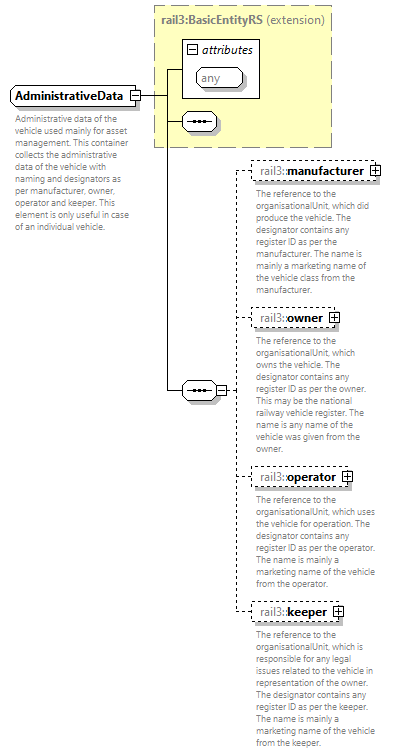 | ||||||
| namespace | https://www.railml.org/schemas/3.2 | ||||||
| type | extension of rail3:BasicEntityRS | ||||||
| properties |
| ||||||
| children | rail3:manufacturer rail3:owner rail3:operator rail3:keeper | ||||||
| used by |
| ||||||
| attributes |
| ||||||
| annotation |
| ||||||
| source | <xs:complexType name="AdministrativeData"> <xs:annotation> <xs:documentation>Administrative data of the vehicle used mainly for asset management. This container collects the administrative data of the vehicle with naming and designators as per manufacturer, owner, operator and keeper. This element is only useful in case of an individual vehicle.</xs:documentation> </xs:annotation> <xs:complexContent> <xs:extension base="rail3:BasicEntityRS"> <xs:sequence> <xs:element name="manufacturer" type="rail3:VehicleManufacturerRS" minOccurs="0" maxOccurs="1"> <xs:annotation> <xs:documentation>The reference to the organisationalUnit, which did produce the vehicle. The designator contains any register ID as per the manufacturer. The name is mainly a marketing name of the vehicle class from the manufacturer.</xs:documentation> </xs:annotation> </xs:element> <xs:element name="owner" type="rail3:VehicleOwnerRS" minOccurs="0" maxOccurs="1"> <xs:annotation> <xs:documentation>The reference to the organisationalUnit, which owns the vehicle. The designator contains any register ID as per the owner. This may be the national railway vehicle register. The name is any name of the vehicle was given from the owner.</xs:documentation> </xs:annotation> </xs:element> <xs:element name="operator" type="rail3:VehicleOperatorRS" minOccurs="0" maxOccurs="1"> <xs:annotation> <xs:documentation>The reference to the organisationalUnit, which uses the vehicle for operation. The designator contains any register ID as per the operator. The name is mainly a marketing name of the vehicle from the operator.</xs:documentation> </xs:annotation> </xs:element> <xs:element name="keeper" type="rail3:VehicleKeeper" minOccurs="0" maxOccurs="1"> <xs:annotation> <xs:documentation>The reference to the organisationalUnit, which is responsible for any legal issues related to the vehicle in representation of the owner. The designator contains any register ID as per the keeper. The name is mainly a marketing name of the vehicle from the keeper.</xs:documentation> </xs:annotation> </xs:element> </xs:sequence> </xs:extension> </xs:complexContent> </xs:complexType> |
element AdministrativeData/manufacturer
| diagram | 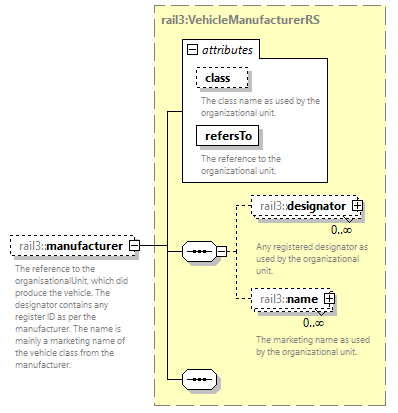 | ||||||||||||||||||||||
| namespace | https://www.railml.org/schemas/3.2 | ||||||||||||||||||||||
| type | rail3:VehicleManufacturerRS | ||||||||||||||||||||||
| properties |
| ||||||||||||||||||||||
| children | rail3:designator rail3:name | ||||||||||||||||||||||
| attributes |
| ||||||||||||||||||||||
| annotation |
| ||||||||||||||||||||||
| source | <xs:element name="manufacturer" type="rail3:VehicleManufacturerRS" minOccurs="0" maxOccurs="1"> <xs:annotation> <xs:documentation>The reference to the organisationalUnit, which did produce the vehicle. The designator contains any register ID as per the manufacturer. The name is mainly a marketing name of the vehicle class from the manufacturer.</xs:documentation> </xs:annotation> </xs:element> |
element AdministrativeData/owner
| diagram | 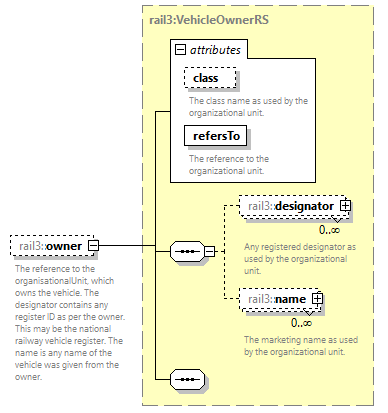 | ||||||||||||||||||||||
| namespace | https://www.railml.org/schemas/3.2 | ||||||||||||||||||||||
| type | rail3:VehicleOwnerRS | ||||||||||||||||||||||
| properties |
| ||||||||||||||||||||||
| children | rail3:designator rail3:name | ||||||||||||||||||||||
| attributes |
| ||||||||||||||||||||||
| annotation |
| ||||||||||||||||||||||
| source | <xs:element name="owner" type="rail3:VehicleOwnerRS" minOccurs="0" maxOccurs="1"> <xs:annotation> <xs:documentation>The reference to the organisationalUnit, which owns the vehicle. The designator contains any register ID as per the owner. This may be the national railway vehicle register. The name is any name of the vehicle was given from the owner.</xs:documentation> </xs:annotation> </xs:element> |
element AdministrativeData/operator
| diagram | 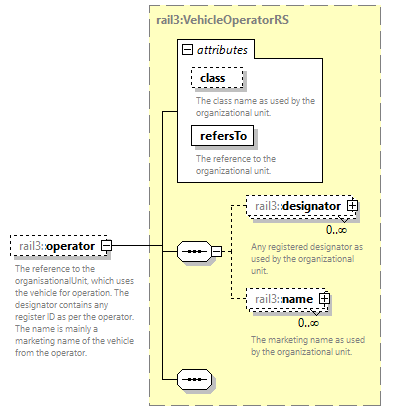 | ||||||||||||||||||||||
| namespace | https://www.railml.org/schemas/3.2 | ||||||||||||||||||||||
| type | rail3:VehicleOperatorRS | ||||||||||||||||||||||
| properties |
| ||||||||||||||||||||||
| children | rail3:designator rail3:name | ||||||||||||||||||||||
| attributes |
| ||||||||||||||||||||||
| annotation |
| ||||||||||||||||||||||
| source | <xs:element name="operator" type="rail3:VehicleOperatorRS" minOccurs="0" maxOccurs="1"> <xs:annotation> <xs:documentation>The reference to the organisationalUnit, which uses the vehicle for operation. The designator contains any register ID as per the operator. The name is mainly a marketing name of the vehicle from the operator.</xs:documentation> </xs:annotation> </xs:element> |
element AdministrativeData/keeper
| diagram | 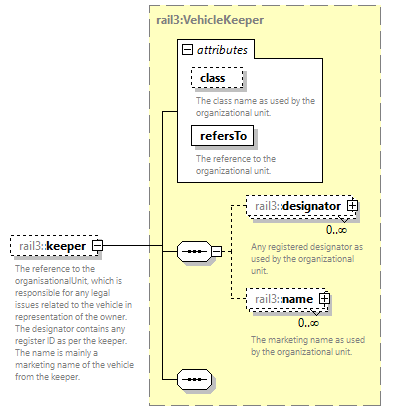 | ||||||||||||||||||||||
| namespace | https://www.railml.org/schemas/3.2 | ||||||||||||||||||||||
| type | rail3:VehicleKeeper | ||||||||||||||||||||||
| properties |
| ||||||||||||||||||||||
| children | rail3:designator rail3:name | ||||||||||||||||||||||
| attributes |
| ||||||||||||||||||||||
| annotation |
| ||||||||||||||||||||||
| source | <xs:element name="keeper" type="rail3:VehicleKeeper" minOccurs="0" maxOccurs="1"> <xs:annotation> <xs:documentation>The reference to the organisationalUnit, which is responsible for any legal issues related to the vehicle in representation of the owner. The designator contains any register ID as per the keeper. The name is mainly a marketing name of the vehicle from the keeper.</xs:documentation> </xs:annotation> </xs:element> |
complexType BasicEntityRS
| diagram | 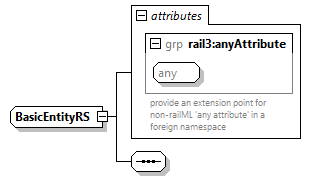 | ||||||
| namespace | https://www.railml.org/schemas/3.2 | ||||||
| used by |
| ||||||
| attributes |
| ||||||
| source | <xs:complexType name="BasicEntityRS"> <xs:sequence/> <xs:attributeGroup ref="rail3:anyAttribute"/> </xs:complexType> |
complexType Brakes
| diagram | 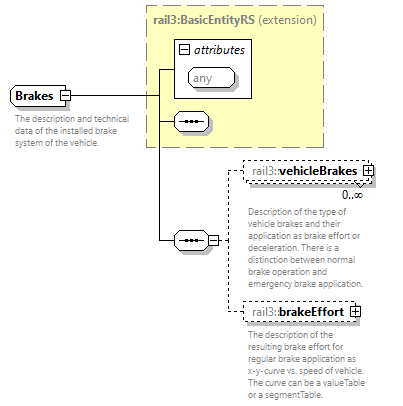 | ||||||
| namespace | https://www.railml.org/schemas/3.2 | ||||||
| type | extension of rail3:BasicEntityRS | ||||||
| properties |
| ||||||
| children | rail3:vehicleBrakes rail3:brakeEffort | ||||||
| used by |
| ||||||
| attributes |
| ||||||
| annotation |
| ||||||
| source | <xs:complexType name="Brakes"> <xs:annotation> <xs:documentation>The description and technical data of the installed brake system of the vehicle.</xs:documentation> </xs:annotation> <xs:complexContent> <xs:extension base="rail3:BasicEntityRS"> <xs:sequence> <xs:element name="vehicleBrakes" type="rail3:tBrakeSystem" minOccurs="0" maxOccurs="unbounded"> <xs:annotation> <xs:documentation>Description of the type of vehicle brakes and their application as brake effort or deceleration. There is a distinction between normal brake operation and emergency brake application.</xs:documentation> </xs:annotation> </xs:element> <xs:element name="brakeEffort" type="rail3:Curve" minOccurs="0" maxOccurs="1"> <xs:annotation> <xs:documentation>The description of the resulting brake effort for regular brake application as x-y-curve vs. speed of vehicle. The curve can be a valueTable or a segmentTable.</xs:documentation> </xs:annotation> </xs:element> </xs:sequence> </xs:extension> </xs:complexContent> </xs:complexType> |
element Brakes/vehicleBrakes
| diagram | 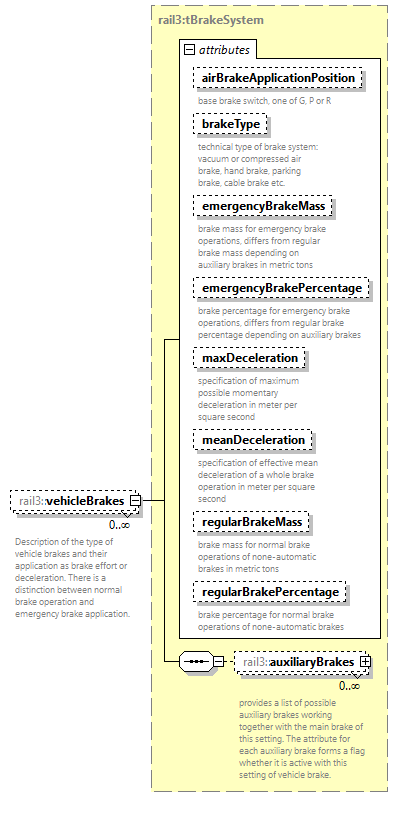 | ||||||||||||||||||||||||||||||||||||||||||||||||||||||||||||||||||||||
| namespace | https://www.railml.org/schemas/3.2 | ||||||||||||||||||||||||||||||||||||||||||||||||||||||||||||||||||||||
| type | rail3:tBrakeSystem | ||||||||||||||||||||||||||||||||||||||||||||||||||||||||||||||||||||||
| properties |
| ||||||||||||||||||||||||||||||||||||||||||||||||||||||||||||||||||||||
| children | rail3:auxiliaryBrakes | ||||||||||||||||||||||||||||||||||||||||||||||||||||||||||||||||||||||
| attributes |
| ||||||||||||||||||||||||||||||||||||||||||||||||||||||||||||||||||||||
| annotation |
| ||||||||||||||||||||||||||||||||||||||||||||||||||||||||||||||||||||||
| source | <xs:element name="vehicleBrakes" type="rail3:tBrakeSystem" minOccurs="0" maxOccurs="unbounded"> <xs:annotation> <xs:documentation>Description of the type of vehicle brakes and their application as brake effort or deceleration. There is a distinction between normal brake operation and emergency brake application.</xs:documentation> </xs:annotation> </xs:element> |
element Brakes/brakeEffort
| diagram | 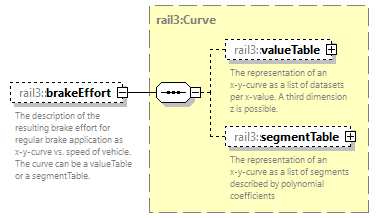 | ||||||
| namespace | https://www.railml.org/schemas/3.2 | ||||||
| type | rail3:Curve | ||||||
| properties |
| ||||||
| children | rail3:valueTable rail3:segmentTable | ||||||
| annotation |
| ||||||
| source | <xs:element name="brakeEffort" type="rail3:Curve" minOccurs="0" maxOccurs="1"> <xs:annotation> <xs:documentation>The description of the resulting brake effort for regular brake application as x-y-curve vs. speed of vehicle. The curve can be a valueTable or a segmentTable.</xs:documentation> </xs:annotation> </xs:element> |
complexType CoeffValue
| diagram | 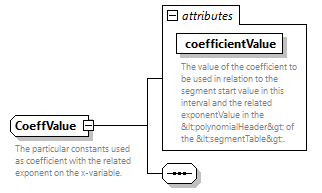 | ||||||||||||||
| namespace | https://www.railml.org/schemas/3.2 | ||||||||||||||
| used by |
| ||||||||||||||
| attributes |
| ||||||||||||||
| annotation |
| ||||||||||||||
| source | <xs:complexType name="CoeffValue"> <xs:annotation> <xs:documentation>The particular constants used as coefficient with the related exponent on the x-variable.</xs:documentation> </xs:annotation> <xs:sequence/> <xs:attribute name="coefficientValue" type="xs:decimal" use="required"> <xs:annotation> <xs:documentation>The value of the coefficient to be used in relation to the segment start value in this interval and the related exponentValue in the <polynomialHeader> of the <segmentTable>.</xs:documentation> </xs:annotation> </xs:attribute> </xs:complexType> |
attribute CoeffValue/@coefficientValue
| type | xs:decimal | ||
| properties |
| ||
| annotation |
| ||
| source | <xs:attribute name="coefficientValue" type="xs:decimal" use="required"> <xs:annotation> <xs:documentation>The value of the coefficient to be used in relation to the segment start value in this interval and the related exponentValue in the <polynomialHeader> of the <segmentTable>.</xs:documentation> </xs:annotation> </xs:attribute> |
complexType ColumnHeader
| diagram | 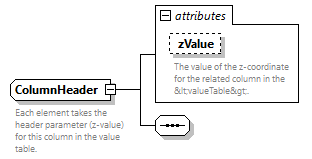 | ||||||||||||||
| namespace | https://www.railml.org/schemas/3.2 | ||||||||||||||
| used by |
| ||||||||||||||
| attributes |
| ||||||||||||||
| annotation |
| ||||||||||||||
| source | <xs:complexType name="ColumnHeader"> <xs:annotation> <xs:documentation>Each element takes the header parameter (z-value) for this column in the value table.</xs:documentation> </xs:annotation> <xs:sequence/> <xs:attribute name="zValue" type="xs:decimal" use="optional"> <xs:annotation> <xs:documentation>The value of the z-coordinate for the related column in the <valueTable>.</xs:documentation> </xs:annotation> </xs:attribute> </xs:complexType> |
attribute ColumnHeader/@zValue
| type | xs:decimal | ||
| properties |
| ||
| annotation |
| ||
| source | <xs:attribute name="zValue" type="xs:decimal" use="optional"> <xs:annotation> <xs:documentation>The value of the z-coordinate for the related column in the <valueTable>.</xs:documentation> </xs:annotation> </xs:attribute> |
complexType Curve
| diagram | 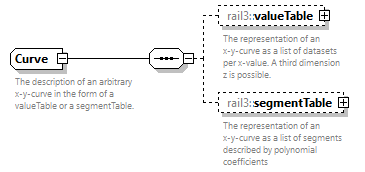 | ||
| namespace | https://www.railml.org/schemas/3.2 | ||
| children | rail3:valueTable rail3:segmentTable | ||
| used by |
| ||
| annotation |
| ||
| source | <xs:complexType name="Curve"> <xs:annotation> <xs:documentation>The description of an arbitrary x-y-curve in the form of a valueTable or a segmentTable.</xs:documentation> </xs:annotation> <xs:sequence> <xs:element name="valueTable" type="rail3:ValueTable" minOccurs="0" maxOccurs="1"> <xs:annotation> <xs:documentation>The representation of an x-y-curve as a list of datasets per x-value. A third dimension z is possible.</xs:documentation> </xs:annotation> </xs:element> <xs:element name="segmentTable" type="rail3:SegmentTable" minOccurs="0" maxOccurs="1"> <xs:annotation> <xs:documentation>The representation of an x-y-curve as a list of segments described by polynomial coefficients</xs:documentation> </xs:annotation> </xs:element> </xs:sequence> </xs:complexType> |
element Curve/valueTable
| diagram | 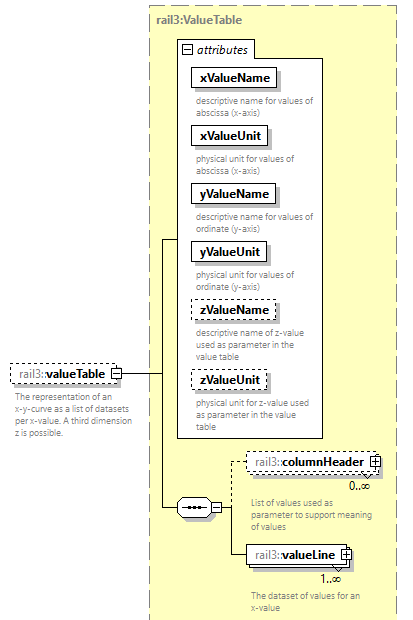 | ||||||||||||||||||||||||||||||||||||||||||||||||||||||
| namespace | https://www.railml.org/schemas/3.2 | ||||||||||||||||||||||||||||||||||||||||||||||||||||||
| type | rail3:ValueTable | ||||||||||||||||||||||||||||||||||||||||||||||||||||||
| properties |
| ||||||||||||||||||||||||||||||||||||||||||||||||||||||
| children | rail3:columnHeader rail3:valueLine | ||||||||||||||||||||||||||||||||||||||||||||||||||||||
| attributes |
| ||||||||||||||||||||||||||||||||||||||||||||||||||||||
| annotation |
| ||||||||||||||||||||||||||||||||||||||||||||||||||||||
| source | <xs:element name="valueTable" type="rail3:ValueTable" minOccurs="0" maxOccurs="1"> <xs:annotation> <xs:documentation>The representation of an x-y-curve as a list of datasets per x-value. A third dimension z is possible.</xs:documentation> </xs:annotation> </xs:element> |
element Curve/segmentTable
| diagram | 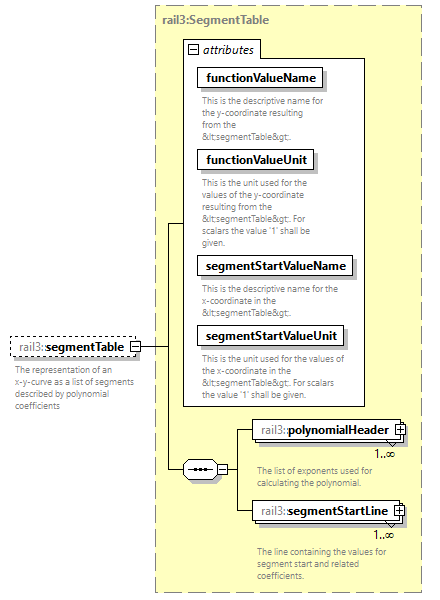 | ||||||||||||||||||||||||||||||||||||||
| namespace | https://www.railml.org/schemas/3.2 | ||||||||||||||||||||||||||||||||||||||
| type | rail3:SegmentTable | ||||||||||||||||||||||||||||||||||||||
| properties |
| ||||||||||||||||||||||||||||||||||||||
| children | rail3:polynomialHeader rail3:segmentStartLine | ||||||||||||||||||||||||||||||||||||||
| attributes |
| ||||||||||||||||||||||||||||||||||||||
| annotation |
| ||||||||||||||||||||||||||||||||||||||
| source | <xs:element name="segmentTable" type="rail3:SegmentTable" minOccurs="0" maxOccurs="1"> <xs:annotation> <xs:documentation>The representation of an x-y-curve as a list of segments described by polynomial coefficients</xs:documentation> </xs:annotation> </xs:element> |
complexType Engine
| diagram | 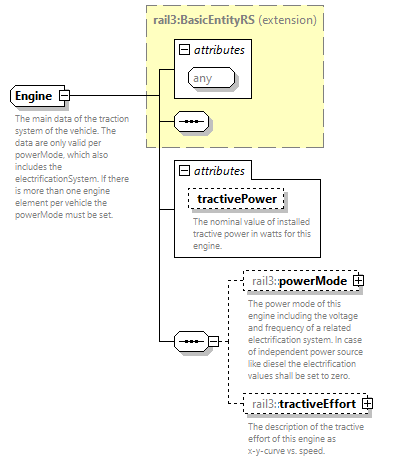 | ||||||||||||||
| namespace | https://www.railml.org/schemas/3.2 | ||||||||||||||
| type | extension of rail3:BasicEntityRS | ||||||||||||||
| properties |
| ||||||||||||||
| children | rail3:powerMode rail3:tractiveEffort | ||||||||||||||
| used by |
| ||||||||||||||
| attributes |
| ||||||||||||||
| annotation |
| ||||||||||||||
| source | <xs:complexType name="Engine"> <xs:annotation> <xs:documentation>The main data of the traction system of the vehicle. The data are only valid per powerMode, which also includes the electrificationSystem. If there is more than one engine element per vehicle the powerMode must be set.</xs:documentation> </xs:annotation> <xs:complexContent> <xs:extension base="rail3:BasicEntityRS"> <xs:sequence> <xs:element name="powerMode" type="rail3:TractionMode" minOccurs="0" maxOccurs="1"> <xs:annotation> <xs:documentation>The power mode of this engine including the voltage and frequency of a related electrification system. In case of independent power source like diesel the electrification values shall be set to zero.</xs:documentation> </xs:annotation> </xs:element> <xs:element name="tractiveEffort" type="rail3:Curve" minOccurs="0" maxOccurs="1"> <xs:annotation> <xs:documentation>The description of the tractive effort of this engine as x-y-curve vs. speed.</xs:documentation> </xs:annotation> </xs:element> </xs:sequence> <xs:attribute name="tractivePower" type="rail3:tPowerWatt" use="optional"> <xs:annotation> <xs:documentation>The nominal value of installed tractive power in watts for this engine.</xs:documentation> </xs:annotation> </xs:attribute> </xs:extension> </xs:complexContent> </xs:complexType> |
attribute Engine/@tractivePower
| type | rail3:tPowerWatt | ||
| properties |
| ||
| annotation |
| ||
| source | <xs:attribute name="tractivePower" type="rail3:tPowerWatt" use="optional"> <xs:annotation> <xs:documentation>The nominal value of installed tractive power in watts for this engine.</xs:documentation> </xs:annotation> </xs:attribute> |
element Engine/powerMode
| diagram | 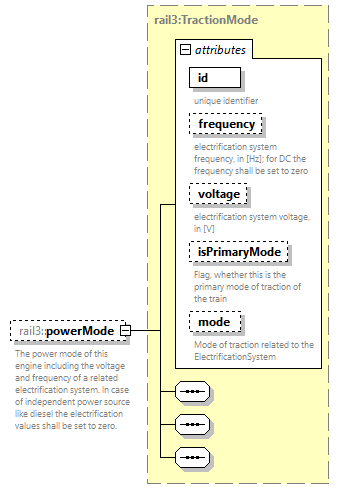 | ||||||||||||||||||||||||||||||||||||||||||||||
| namespace | https://www.railml.org/schemas/3.2 | ||||||||||||||||||||||||||||||||||||||||||||||
| type | rail3:TractionMode | ||||||||||||||||||||||||||||||||||||||||||||||
| properties |
| ||||||||||||||||||||||||||||||||||||||||||||||
| attributes |
| ||||||||||||||||||||||||||||||||||||||||||||||
| annotation |
| ||||||||||||||||||||||||||||||||||||||||||||||
| source | <xs:element name="powerMode" type="rail3:TractionMode" minOccurs="0" maxOccurs="1"> <xs:annotation> <xs:documentation>The power mode of this engine including the voltage and frequency of a related electrification system. In case of independent power source like diesel the electrification values shall be set to zero.</xs:documentation> </xs:annotation> </xs:element> |
element Engine/tractiveEffort
| diagram | 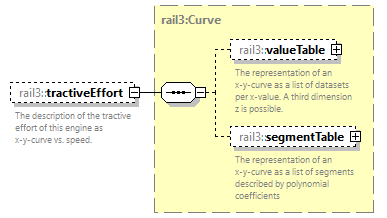 | ||||||
| namespace | https://www.railml.org/schemas/3.2 | ||||||
| type | rail3:Curve | ||||||
| properties |
| ||||||
| children | rail3:valueTable rail3:segmentTable | ||||||
| annotation |
| ||||||
| source | <xs:element name="tractiveEffort" type="rail3:Curve" minOccurs="0" maxOccurs="1"> <xs:annotation> <xs:documentation>The description of the tractive effort of this engine as x-y-curve vs. speed.</xs:documentation> </xs:annotation> </xs:element> |
complexType EntityRSref
| diagram | 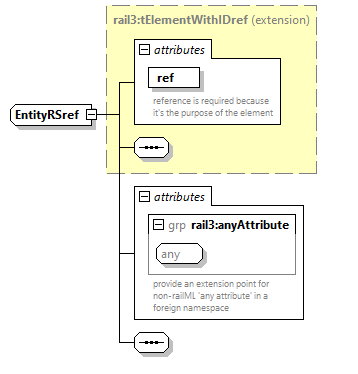 | ||||||||||||||
| namespace | https://www.railml.org/schemas/3.2 | ||||||||||||||
| type | extension of rail3:tElementWithIDref | ||||||||||||||
| properties |
| ||||||||||||||
| attributes |
| ||||||||||||||
| source | <xs:complexType name="EntityRSref"> <xs:complexContent> <xs:extension base="rail3:tElementWithIDref"> <xs:sequence/> <xs:attributeGroup ref="rail3:anyAttribute"/> </xs:extension> </xs:complexContent> </xs:complexType> |
complexType EntityRSwithID
| diagram | 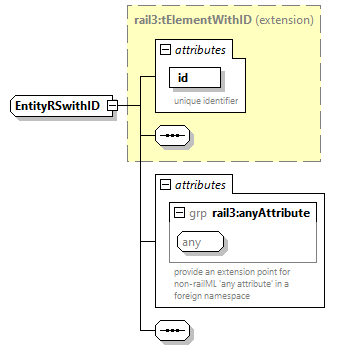 | ||||||||||||||
| namespace | https://www.railml.org/schemas/3.2 | ||||||||||||||
| type | extension of rail3:tElementWithID | ||||||||||||||
| properties |
| ||||||||||||||
| attributes |
| ||||||||||||||
| source | <xs:complexType name="EntityRSwithID"> <xs:complexContent> <xs:extension base="rail3:tElementWithID"> <xs:sequence/> <xs:attributeGroup ref="rail3:anyAttribute"/> </xs:extension> </xs:complexContent> </xs:complexType> |
complexType EntityRSwithIDandDesignator
| diagram | 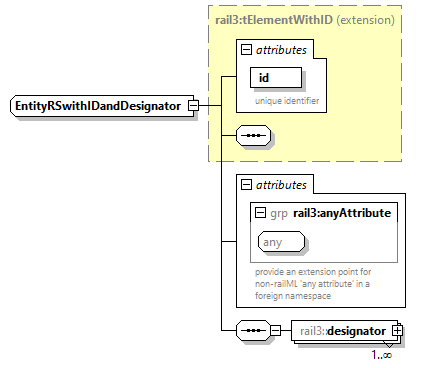 | ||||||||||||||
| namespace | https://www.railml.org/schemas/3.2 | ||||||||||||||
| type | extension of rail3:tElementWithID | ||||||||||||||
| properties |
| ||||||||||||||
| children | rail3:designator | ||||||||||||||
| used by |
| ||||||||||||||
| attributes |
| ||||||||||||||
| source | <xs:complexType name="EntityRSwithIDandDesignator"> <xs:complexContent> <xs:extension base="rail3:tElementWithID"> <xs:sequence> <xs:element name="designator" type="rail3:Designator" minOccurs="1" maxOccurs="unbounded"/> </xs:sequence> <xs:attributeGroup ref="rail3:anyAttribute"/> </xs:extension> </xs:complexContent> </xs:complexType> |
element EntityRSwithIDandDesignator/designator
| diagram | 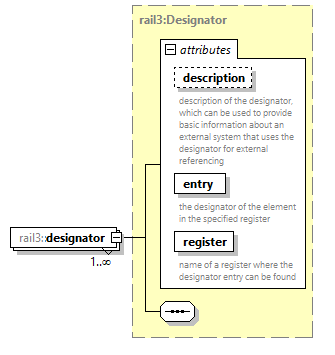 | ||||||||||||||||||||||||||||||
| namespace | https://www.railml.org/schemas/3.2 | ||||||||||||||||||||||||||||||
| type | rail3:Designator | ||||||||||||||||||||||||||||||
| properties |
| ||||||||||||||||||||||||||||||
| attributes |
| ||||||||||||||||||||||||||||||
| source | <xs:element name="designator" type="rail3:Designator" minOccurs="1" maxOccurs="unbounded"/> |
complexType Formation
| diagram |  | ||||||||||||||||||||||||||||||||||||||||||||||||||||||||||||||||||||||||||||||
| namespace | https://www.railml.org/schemas/3.2 | ||||||||||||||||||||||||||||||||||||||||||||||||||||||||||||||||||||||||||||||
| type | extension of rail3:EntityRSwithIDandDesignator | ||||||||||||||||||||||||||||||||||||||||||||||||||||||||||||||||||||||||||||||
| properties |
| ||||||||||||||||||||||||||||||||||||||||||||||||||||||||||||||||||||||||||||||
| children | rail3:designator rail3:trainOrder rail3:trainEngine rail3:trainBrakes rail3:trainResistance | ||||||||||||||||||||||||||||||||||||||||||||||||||||||||||||||||||||||||||||||
| used by |
| ||||||||||||||||||||||||||||||||||||||||||||||||||||||||||||||||||||||||||||||
| attributes |
| ||||||||||||||||||||||||||||||||||||||||||||||||||||||||||||||||||||||||||||||
| annotation |
| ||||||||||||||||||||||||||||||||||||||||||||||||||||||||||||||||||||||||||||||
| source | <xs:complexType name="Formation"> <xs:annotation> <xs:documentation>The formation collects all data of vehicles coupled as train for operation.</xs:documentation> </xs:annotation> <xs:complexContent> <xs:extension base="rail3:EntityRSwithIDandDesignator"> <xs:sequence> <xs:element name="trainOrder" type="rail3:TrainOrder" minOccurs="1" maxOccurs="unbounded"> <xs:annotation> <xs:documentation>This is the reference to the individual vehicles within the formation with their order number to mark the position in the formation. This is considering the standard orientation of the complete formation.</xs:documentation> </xs:annotation> </xs:element> <xs:element name="trainEngine" type="rail3:TrainEngine" minOccurs="0" maxOccurs="unbounded"> <xs:annotation> <xs:documentation>These are the overall data of the traction system within the complete formation in a particular traction mode.</xs:documentation> </xs:annotation> </xs:element> <xs:element name="trainBrakes" type="rail3:tBrakeSystem" minOccurs="0" maxOccurs="unbounded"> <xs:annotation> <xs:documentation>Description of the type of brakes within the formation and their application as brake effort or deceleration. There is a distinction between normal brake operation and emergency brake application.</xs:documentation> </xs:annotation> </xs:element> <xs:element name="trainResistance" type="rail3:Curve" minOccurs="0" maxOccurs="1"> <xs:annotation> <xs:documentation>The resistance value for the entire formation of the train. Dependent on the purpose there are different formulas used for the calculation of speed related values.</xs:documentation> </xs:annotation> </xs:element> </xs:sequence> <xs:attribute name="haulingWeight" type="rail3:tWeightTons" use="optional"> <xs:annotation> <xs:documentation>The complete weight of the formation but without locomotive in metric tons. This is not useful for multiple units.</xs:documentation> </xs:annotation> </xs:attribute> <xs:attribute name="length" type="rail3:tLengthM" use="optional"> <xs:annotation> <xs:documentation>The overall length of the entire formation in metres.</xs:documentation> </xs:annotation> </xs:attribute> <xs:attribute name="maximumAxleLoad" type="rail3:tWeightTons" use="optional"> <xs:annotation> <xs:documentation>The maximum axle load within the formation in metric tons. It is the highest value from any contained vehicle.</xs:documentation> </xs:annotation> </xs:attribute> <xs:attribute name="maximumCantDeficiency" type="rail3:tLengthMM" use="optional"> <xs:annotation> <xs:documentation>The resulting maximum permissible cant deficiency for this formation measured in millimetres. In order to get the cant deficiency class as per UNISIG this would require to combine it with the airBakeApplicationPosition of the trainBrakes.</xs:documentation> </xs:annotation> </xs:attribute> <xs:attribute name="numberOfAxles" type="xs:positiveInteger" use="optional"> <xs:annotation> <xs:documentation>The number of axles of the entire formation.</xs:documentation> </xs:annotation> </xs:attribute> <xs:attribute name="numberOfWagons" type="xs:positiveInteger" use="optional"> <xs:annotation> <xs:documentation>The number of non-powered wagons in the formation. This value is only useful in case of a loco hauled train.</xs:documentation> </xs:annotation> </xs:attribute> <xs:attribute name="speed" type="rail3:tSpeedKmPerHour" use="optional"> <xs:annotation> <xs:documentation>The maximum permissible speed in km/h of the entire formation as limited by the lowest maximum of contained vehicles.</xs:documentation> </xs:annotation> </xs:attribute> <xs:attribute name="totalWeight" type="rail3:tWeightTons" use="optional"> <xs:annotation> <xs:documentation>The complete weight of the formation with payload in metric tons.</xs:documentation> </xs:annotation> </xs:attribute> </xs:extension> </xs:complexContent> </xs:complexType> |
attribute Formation/@haulingWeight
| type | rail3:tWeightTons | ||
| properties |
| ||
| annotation |
| ||
| source | <xs:attribute name="haulingWeight" type="rail3:tWeightTons" use="optional"> <xs:annotation> <xs:documentation>The complete weight of the formation but without locomotive in metric tons. This is not useful for multiple units.</xs:documentation> </xs:annotation> </xs:attribute> |
attribute Formation/@length
| type | rail3:tLengthM | ||
| properties |
| ||
| annotation |
| ||
| source | <xs:attribute name="length" type="rail3:tLengthM" use="optional"> <xs:annotation> <xs:documentation>The overall length of the entire formation in metres.</xs:documentation> </xs:annotation> </xs:attribute> |
attribute Formation/@maximumAxleLoad
| type | rail3:tWeightTons | ||
| properties |
| ||
| annotation |
| ||
| source | <xs:attribute name="maximumAxleLoad" type="rail3:tWeightTons" use="optional"> <xs:annotation> <xs:documentation>The maximum axle load within the formation in metric tons. It is the highest value from any contained vehicle.</xs:documentation> </xs:annotation> </xs:attribute> |
attribute Formation/@maximumCantDeficiency
| type | rail3:tLengthMM | ||
| properties |
| ||
| annotation |
| ||
| source | <xs:attribute name="maximumCantDeficiency" type="rail3:tLengthMM" use="optional"> <xs:annotation> <xs:documentation>The resulting maximum permissible cant deficiency for this formation measured in millimetres. In order to get the cant deficiency class as per UNISIG this would require to combine it with the airBakeApplicationPosition of the trainBrakes.</xs:documentation> </xs:annotation> </xs:attribute> |
attribute Formation/@numberOfAxles
| type | xs:positiveInteger | ||
| properties |
| ||
| annotation |
| ||
| source | <xs:attribute name="numberOfAxles" type="xs:positiveInteger" use="optional"> <xs:annotation> <xs:documentation>The number of axles of the entire formation.</xs:documentation> </xs:annotation> </xs:attribute> |
attribute Formation/@numberOfWagons
| type | xs:positiveInteger | ||
| properties |
| ||
| annotation |
| ||
| source | <xs:attribute name="numberOfWagons" type="xs:positiveInteger" use="optional"> <xs:annotation> <xs:documentation>The number of non-powered wagons in the formation. This value is only useful in case of a loco hauled train.</xs:documentation> </xs:annotation> </xs:attribute> |
attribute Formation/@speed
| type | rail3:tSpeedKmPerHour | ||
| properties |
| ||
| annotation |
| ||
| source | <xs:attribute name="speed" type="rail3:tSpeedKmPerHour" use="optional"> <xs:annotation> <xs:documentation>The maximum permissible speed in km/h of the entire formation as limited by the lowest maximum of contained vehicles.</xs:documentation> </xs:annotation> </xs:attribute> |
attribute Formation/@totalWeight
| type | rail3:tWeightTons | ||
| properties |
| ||
| annotation |
| ||
| source | <xs:attribute name="totalWeight" type="rail3:tWeightTons" use="optional"> <xs:annotation> <xs:documentation>The complete weight of the formation with payload in metric tons.</xs:documentation> </xs:annotation> </xs:attribute> |
element Formation/trainOrder
| diagram | 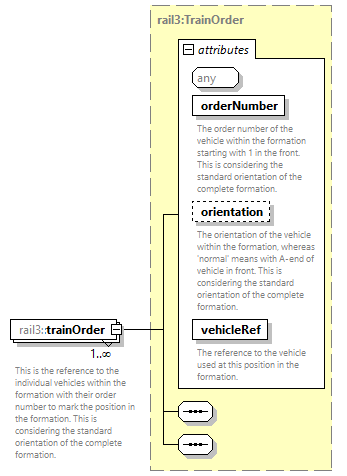 | ||||||||||||||||||||||||||||||
| namespace | https://www.railml.org/schemas/3.2 | ||||||||||||||||||||||||||||||
| type | rail3:TrainOrder | ||||||||||||||||||||||||||||||
| properties |
| ||||||||||||||||||||||||||||||
| attributes |
| ||||||||||||||||||||||||||||||
| annotation |
| ||||||||||||||||||||||||||||||
| source | <xs:element name="trainOrder" type="rail3:TrainOrder" minOccurs="1" maxOccurs="unbounded"> <xs:annotation> <xs:documentation>This is the reference to the individual vehicles within the formation with their order number to mark the position in the formation. This is considering the standard orientation of the complete formation.</xs:documentation> </xs:annotation> </xs:element> |
element Formation/trainEngine
| diagram | 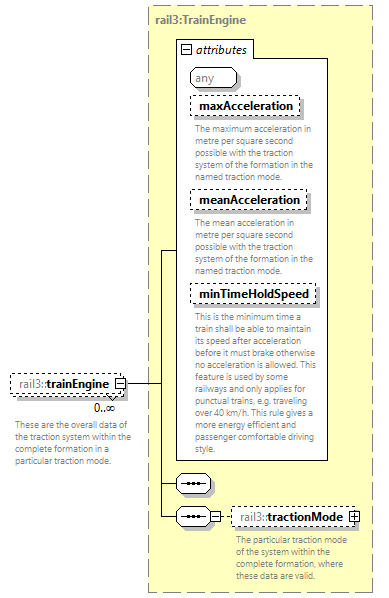 | ||||||||||||||||||||||||||||||
| namespace | https://www.railml.org/schemas/3.2 | ||||||||||||||||||||||||||||||
| type | rail3:TrainEngine | ||||||||||||||||||||||||||||||
| properties |
| ||||||||||||||||||||||||||||||
| children | rail3:tractionMode | ||||||||||||||||||||||||||||||
| attributes |
| ||||||||||||||||||||||||||||||
| annotation |
| ||||||||||||||||||||||||||||||
| source | <xs:element name="trainEngine" type="rail3:TrainEngine" minOccurs="0" maxOccurs="unbounded"> <xs:annotation> <xs:documentation>These are the overall data of the traction system within the complete formation in a particular traction mode.</xs:documentation> </xs:annotation> </xs:element> |
element Formation/trainBrakes
| diagram | 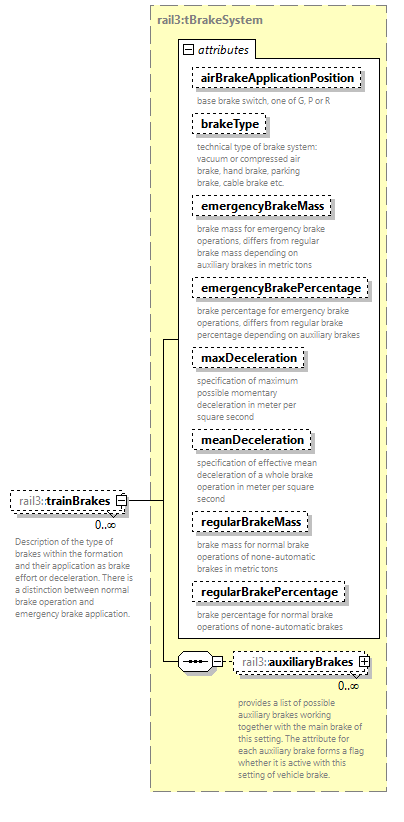 | ||||||||||||||||||||||||||||||||||||||||||||||||||||||||||||||||||||||
| namespace | https://www.railml.org/schemas/3.2 | ||||||||||||||||||||||||||||||||||||||||||||||||||||||||||||||||||||||
| type | rail3:tBrakeSystem | ||||||||||||||||||||||||||||||||||||||||||||||||||||||||||||||||||||||
| properties |
| ||||||||||||||||||||||||||||||||||||||||||||||||||||||||||||||||||||||
| children | rail3:auxiliaryBrakes | ||||||||||||||||||||||||||||||||||||||||||||||||||||||||||||||||||||||
| attributes |
| ||||||||||||||||||||||||||||||||||||||||||||||||||||||||||||||||||||||
| annotation |
| ||||||||||||||||||||||||||||||||||||||||||||||||||||||||||||||||||||||
| source | <xs:element name="trainBrakes" type="rail3:tBrakeSystem" minOccurs="0" maxOccurs="unbounded"> <xs:annotation> <xs:documentation>Description of the type of brakes within the formation and their application as brake effort or deceleration. There is a distinction between normal brake operation and emergency brake application.</xs:documentation> </xs:annotation> </xs:element> |
element Formation/trainResistance
| diagram | 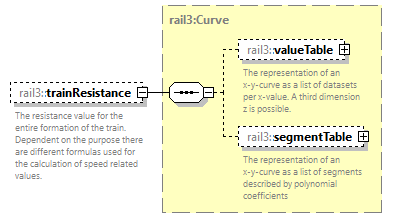 | ||||||
| namespace | https://www.railml.org/schemas/3.2 | ||||||
| type | rail3:Curve | ||||||
| properties |
| ||||||
| children | rail3:valueTable rail3:segmentTable | ||||||
| annotation |
| ||||||
| source | <xs:element name="trainResistance" type="rail3:Curve" minOccurs="0" maxOccurs="1"> <xs:annotation> <xs:documentation>The resistance value for the entire formation of the train. Dependent on the purpose there are different formulas used for the calculation of speed related values.</xs:documentation> </xs:annotation> </xs:element> |
complexType Formations
| diagram |  | ||
| namespace | https://www.railml.org/schemas/3.2 | ||
| children | rail3:formation | ||
| used by |
| ||
| annotation |
| ||
| source | <xs:complexType name="Formations"> <xs:annotation> <xs:documentation>The container for all defined formations of vehicles.</xs:documentation> </xs:annotation> <xs:sequence> <xs:element name="formation" type="rail3:Formation" minOccurs="1" maxOccurs="unbounded"> <xs:annotation> <xs:documentation>The formation collects all data of vehicles coupled as train for operation.</xs:documentation> </xs:annotation> </xs:element> </xs:sequence> </xs:complexType> |
element Formations/formation
| diagram |  | ||||||||||||||||||||||||||||||||||||||||||||||||||||||||||||||||||||||||||||||
| namespace | https://www.railml.org/schemas/3.2 | ||||||||||||||||||||||||||||||||||||||||||||||||||||||||||||||||||||||||||||||
| type | rail3:Formation | ||||||||||||||||||||||||||||||||||||||||||||||||||||||||||||||||||||||||||||||
| properties |
| ||||||||||||||||||||||||||||||||||||||||||||||||||||||||||||||||||||||||||||||
| children | rail3:designator rail3:trainOrder rail3:trainEngine rail3:trainBrakes rail3:trainResistance | ||||||||||||||||||||||||||||||||||||||||||||||||||||||||||||||||||||||||||||||
| attributes |
| ||||||||||||||||||||||||||||||||||||||||||||||||||||||||||||||||||||||||||||||
| annotation |
| ||||||||||||||||||||||||||||||||||||||||||||||||||||||||||||||||||||||||||||||
| source | <xs:element name="formation" type="rail3:Formation" minOccurs="1" maxOccurs="unbounded"> <xs:annotation> <xs:documentation>The formation collects all data of vehicles coupled as train for operation.</xs:documentation> </xs:annotation> </xs:element> |
complexType PolynomialHeader
| diagram | 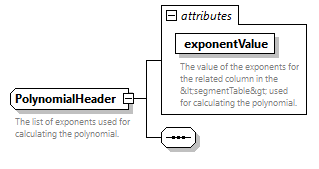 | ||||||||||||||
| namespace | https://www.railml.org/schemas/3.2 | ||||||||||||||
| used by |
| ||||||||||||||
| attributes |
| ||||||||||||||
| annotation |
| ||||||||||||||
| source | <xs:complexType name="PolynomialHeader"> <xs:annotation> <xs:documentation>The list of exponents used for calculating the polynomial.</xs:documentation> </xs:annotation> <xs:sequence/> <xs:attribute name="exponentValue" type="xs:integer" use="required"> <xs:annotation> <xs:documentation>The value of the exponents for the related column in the <segmentTable> used for calculating the polynomial.</xs:documentation> </xs:annotation> </xs:attribute> </xs:complexType> |
attribute PolynomialHeader/@exponentValue
| type | xs:integer | ||
| properties |
| ||
| annotation |
| ||
| source | <xs:attribute name="exponentValue" type="xs:integer" use="required"> <xs:annotation> <xs:documentation>The value of the exponents for the related column in the <segmentTable> used for calculating the polynomial.</xs:documentation> </xs:annotation> </xs:attribute> |
complexType Rollingstock
| diagram | 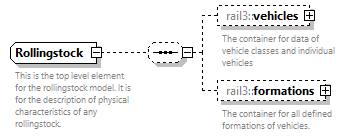 | ||
| namespace | https://www.railml.org/schemas/3.2 | ||
| children | rail3:vehicles rail3:formations | ||
| used by |
| ||
| annotation |
| ||
| source | <xs:complexType name="Rollingstock"> <xs:annotation> <xs:documentation>This is the top level element for the rollingstock model. It is for the description of physical characteristics of any rollingstock.</xs:documentation> </xs:annotation> <xs:sequence minOccurs="0" maxOccurs="1"> <xs:element name="vehicles" type="rail3:Vehicles" minOccurs="0" maxOccurs="1"> <xs:annotation> <xs:documentation>The container for data of vehicle classes and individual vehicles</xs:documentation> </xs:annotation> </xs:element> <xs:element name="formations" type="rail3:Formations" minOccurs="0" maxOccurs="1"> <xs:annotation> <xs:documentation>The container for all defined formations of vehicles.</xs:documentation> </xs:annotation> </xs:element> </xs:sequence> </xs:complexType> |
element Rollingstock/vehicles
| diagram | 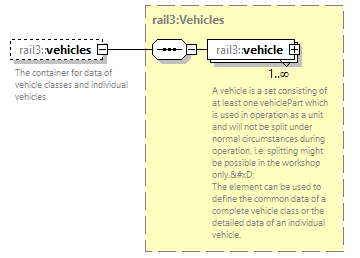 | ||||||
| namespace | https://www.railml.org/schemas/3.2 | ||||||
| type | rail3:Vehicles | ||||||
| properties |
| ||||||
| children | rail3:vehicle | ||||||
| annotation |
| ||||||
| source | <xs:element name="vehicles" type="rail3:Vehicles" minOccurs="0" maxOccurs="1"> <xs:annotation> <xs:documentation>The container for data of vehicle classes and individual vehicles</xs:documentation> </xs:annotation> </xs:element> |
element Rollingstock/formations
| diagram | 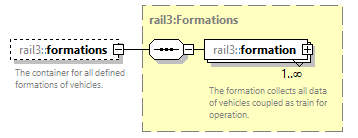 | ||||||
| namespace | https://www.railml.org/schemas/3.2 | ||||||
| type | rail3:Formations | ||||||
| properties |
| ||||||
| children | rail3:formation | ||||||
| annotation |
| ||||||
| source | <xs:element name="formations" type="rail3:Formations" minOccurs="0" maxOccurs="1"> <xs:annotation> <xs:documentation>The container for all defined formations of vehicles.</xs:documentation> </xs:annotation> </xs:element> |
complexType SegmentStartLine
| diagram | 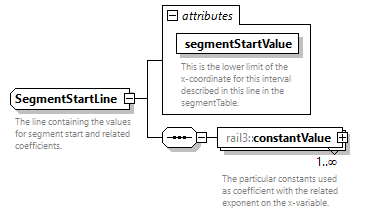 | ||||||||||||||
| namespace | https://www.railml.org/schemas/3.2 | ||||||||||||||
| children | rail3:constantValue | ||||||||||||||
| used by |
| ||||||||||||||
| attributes |
| ||||||||||||||
| annotation |
| ||||||||||||||
| source | <xs:complexType name="SegmentStartLine"> <xs:annotation> <xs:documentation>The line containing the values for segment start and related coefficients.</xs:documentation> </xs:annotation> <xs:sequence> <xs:element name="constantValue" type="rail3:CoeffValue" minOccurs="1" maxOccurs="unbounded"> <xs:annotation> <xs:documentation>The particular constants used as coefficient with the related exponent on the x-variable.</xs:documentation> </xs:annotation> </xs:element> </xs:sequence> <xs:attribute name="segmentStartValue" type="xs:decimal" use="required"> <xs:annotation> <xs:documentation>This is the lower limit of the x-coordinate for this interval described in this line in the segmentTable.</xs:documentation> </xs:annotation> </xs:attribute> </xs:complexType> |
attribute SegmentStartLine/@segmentStartValue
| type | xs:decimal | ||
| properties |
| ||
| annotation |
| ||
| source | <xs:attribute name="segmentStartValue" type="xs:decimal" use="required"> <xs:annotation> <xs:documentation>This is the lower limit of the x-coordinate for this interval described in this line in the segmentTable.</xs:documentation> </xs:annotation> </xs:attribute> |
element SegmentStartLine/constantValue
| diagram | 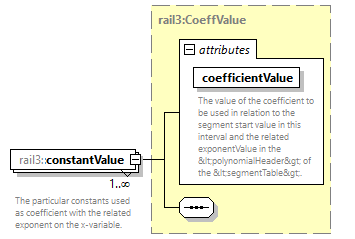 | ||||||||||||||
| namespace | https://www.railml.org/schemas/3.2 | ||||||||||||||
| type | rail3:CoeffValue | ||||||||||||||
| properties |
| ||||||||||||||
| attributes |
| ||||||||||||||
| annotation |
| ||||||||||||||
| source | <xs:element name="constantValue" type="rail3:CoeffValue" minOccurs="1" maxOccurs="unbounded"> <xs:annotation> <xs:documentation>The particular constants used as coefficient with the related exponent on the x-variable.</xs:documentation> </xs:annotation> </xs:element> |
complexType SegmentTable
| diagram | 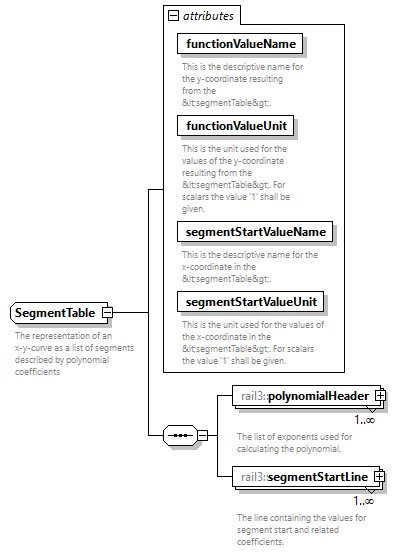 | ||||||||||||||||||||||||||||||||||||||
| namespace | https://www.railml.org/schemas/3.2 | ||||||||||||||||||||||||||||||||||||||
| children | rail3:polynomialHeader rail3:segmentStartLine | ||||||||||||||||||||||||||||||||||||||
| used by |
| ||||||||||||||||||||||||||||||||||||||
| attributes |
| ||||||||||||||||||||||||||||||||||||||
| annotation |
| ||||||||||||||||||||||||||||||||||||||
| source | <xs:complexType name="SegmentTable"> <xs:annotation> <xs:documentation>The representation of an x-y-curve as a list of segments described by polynomial coefficients</xs:documentation> </xs:annotation> <xs:sequence> <xs:element name="polynomialHeader" type="rail3:PolynomialHeader" minOccurs="1" maxOccurs="unbounded"> <xs:annotation> <xs:documentation>The list of exponents used for calculating the polynomial.</xs:documentation> </xs:annotation> </xs:element> <xs:element name="segmentStartLine" type="rail3:SegmentStartLine" minOccurs="1" maxOccurs="unbounded"> <xs:annotation> <xs:documentation>The line containing the values for segment start and related coefficients.</xs:documentation> </xs:annotation> </xs:element> </xs:sequence> <xs:attribute name="functionValueName" type="xs:string" use="required"> <xs:annotation> <xs:documentation>This is the descriptive name for the y-coordinate resulting from the <segmentTable>.</xs:documentation> </xs:annotation> </xs:attribute> <xs:attribute name="functionValueUnit" type="rail3:tUnitNameListExt" use="required"> <xs:annotation> <xs:documentation>This is the unit used for the values of the y-coordinate resulting from the <segmentTable>. For scalars the value '1' shall be given.</xs:documentation> </xs:annotation> </xs:attribute> <xs:attribute name="segmentStartValueName" type="xs:string" use="required"> <xs:annotation> <xs:documentation>This is the descriptive name for the x-coordinate in the <segmentTable>.</xs:documentation> </xs:annotation> </xs:attribute> <xs:attribute name="segmentStartValueUnit" type="rail3:tUnitNameListExt" use="required"> <xs:annotation> <xs:documentation>This is the unit used for the values of the x-coordinate in the <segmentTable>. For scalars the value '1' shall be given.</xs:documentation> </xs:annotation> </xs:attribute> </xs:complexType> |
attribute SegmentTable/@functionValueName
| type | xs:string | ||
| properties |
| ||
| annotation |
| ||
| source | <xs:attribute name="functionValueName" type="xs:string" use="required"> <xs:annotation> <xs:documentation>This is the descriptive name for the y-coordinate resulting from the <segmentTable>.</xs:documentation> </xs:annotation> </xs:attribute> |
attribute SegmentTable/@functionValueUnit
| type | rail3:tUnitNameListExt | ||
| properties |
| ||
| annotation |
| ||
| source | <xs:attribute name="functionValueUnit" type="rail3:tUnitNameListExt" use="required"> <xs:annotation> <xs:documentation>This is the unit used for the values of the y-coordinate resulting from the <segmentTable>. For scalars the value '1' shall be given.</xs:documentation> </xs:annotation> </xs:attribute> |
attribute SegmentTable/@segmentStartValueName
| type | xs:string | ||
| properties |
| ||
| annotation |
| ||
| source | <xs:attribute name="segmentStartValueName" type="xs:string" use="required"> <xs:annotation> <xs:documentation>This is the descriptive name for the x-coordinate in the <segmentTable>.</xs:documentation> </xs:annotation> </xs:attribute> |
attribute SegmentTable/@segmentStartValueUnit
| type | rail3:tUnitNameListExt | ||
| properties |
| ||
| annotation |
| ||
| source | <xs:attribute name="segmentStartValueUnit" type="rail3:tUnitNameListExt" use="required"> <xs:annotation> <xs:documentation>This is the unit used for the values of the x-coordinate in the <segmentTable>. For scalars the value '1' shall be given.</xs:documentation> </xs:annotation> </xs:attribute> |
element SegmentTable/polynomialHeader
| diagram | 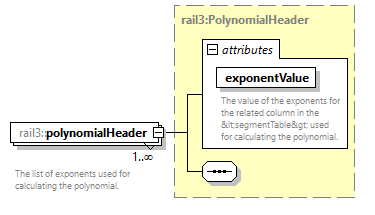 | ||||||||||||||
| namespace | https://www.railml.org/schemas/3.2 | ||||||||||||||
| type | rail3:PolynomialHeader | ||||||||||||||
| properties |
| ||||||||||||||
| attributes |
| ||||||||||||||
| annotation |
| ||||||||||||||
| source | <xs:element name="polynomialHeader" type="rail3:PolynomialHeader" minOccurs="1" maxOccurs="unbounded"> <xs:annotation> <xs:documentation>The list of exponents used for calculating the polynomial.</xs:documentation> </xs:annotation> </xs:element> |
element SegmentTable/segmentStartLine
| diagram | 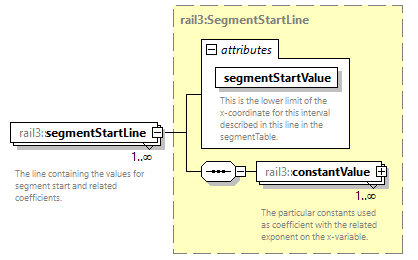 | ||||||||||||||
| namespace | https://www.railml.org/schemas/3.2 | ||||||||||||||
| type | rail3:SegmentStartLine | ||||||||||||||
| properties |
| ||||||||||||||
| children | rail3:constantValue | ||||||||||||||
| attributes |
| ||||||||||||||
| annotation |
| ||||||||||||||
| source | <xs:element name="segmentStartLine" type="rail3:SegmentStartLine" minOccurs="1" maxOccurs="unbounded"> <xs:annotation> <xs:documentation>The line containing the values for segment start and related coefficients.</xs:documentation> </xs:annotation> </xs:element> |
complexType TrainEngine
| diagram | 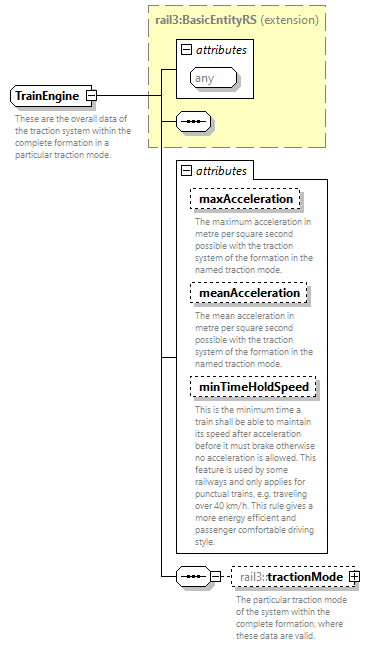 | ||||||||||||||||||||||||||||||
| namespace | https://www.railml.org/schemas/3.2 | ||||||||||||||||||||||||||||||
| type | extension of rail3:BasicEntityRS | ||||||||||||||||||||||||||||||
| properties |
| ||||||||||||||||||||||||||||||
| children | rail3:tractionMode | ||||||||||||||||||||||||||||||
| used by |
| ||||||||||||||||||||||||||||||
| attributes |
| ||||||||||||||||||||||||||||||
| annotation |
| ||||||||||||||||||||||||||||||
| source | <xs:complexType name="TrainEngine"> <xs:annotation> <xs:documentation>These are the overall data of the traction system within the complete formation in a particular traction mode.</xs:documentation> </xs:annotation> <xs:complexContent> <xs:extension base="rail3:BasicEntityRS"> <xs:sequence> <xs:element name="tractionMode" type="rail3:TractionMode" minOccurs="0" maxOccurs="1"> <xs:annotation> <xs:documentation>The particular traction mode of the system within the complete formation, where these data are valid.</xs:documentation> </xs:annotation> </xs:element> </xs:sequence> <xs:attribute name="maxAcceleration" type="rail3:tAccelerationMeterPerSquareSec" use="optional"> <xs:annotation> <xs:documentation>The maximum acceleration in metre per square second possible with the traction system of the formation in the named traction mode.</xs:documentation> </xs:annotation> </xs:attribute> <xs:attribute name="meanAcceleration" type="rail3:tAccelerationMeterPerSquareSec" use="optional"> <xs:annotation> <xs:documentation>The mean acceleration in metre per square second possible with the traction system of the formation in the named traction mode.</xs:documentation> </xs:annotation> </xs:attribute> <xs:attribute name="minTimeHoldSpeed" type="xs:duration" use="optional"> <xs:annotation> <xs:documentation>This is the minimum time a train shall be able to maintain its speed after acceleration before it must brake otherwise no acceleration is allowed. This feature is used by some railways and only applies for punctual trains, e.g. traveling over 40 km/h. This rule gives a more energy efficient and passenger comfortable driving style.</xs:documentation> </xs:annotation> </xs:attribute> </xs:extension> </xs:complexContent> </xs:complexType> |
attribute TrainEngine/@maxAcceleration
| type | rail3:tAccelerationMeterPerSquareSec | ||
| properties |
| ||
| annotation |
| ||
| source | <xs:attribute name="maxAcceleration" type="rail3:tAccelerationMeterPerSquareSec" use="optional"> <xs:annotation> <xs:documentation>The maximum acceleration in metre per square second possible with the traction system of the formation in the named traction mode.</xs:documentation> </xs:annotation> </xs:attribute> |
attribute TrainEngine/@meanAcceleration
| type | rail3:tAccelerationMeterPerSquareSec | ||
| properties |
| ||
| annotation |
| ||
| source | <xs:attribute name="meanAcceleration" type="rail3:tAccelerationMeterPerSquareSec" use="optional"> <xs:annotation> <xs:documentation>The mean acceleration in metre per square second possible with the traction system of the formation in the named traction mode.</xs:documentation> </xs:annotation> </xs:attribute> |
attribute TrainEngine/@minTimeHoldSpeed
| type | xs:duration | ||
| properties |
| ||
| annotation |
| ||
| source | <xs:attribute name="minTimeHoldSpeed" type="xs:duration" use="optional"> <xs:annotation> <xs:documentation>This is the minimum time a train shall be able to maintain its speed after acceleration before it must brake otherwise no acceleration is allowed. This feature is used by some railways and only applies for punctual trains, e.g. traveling over 40 km/h. This rule gives a more energy efficient and passenger comfortable driving style.</xs:documentation> </xs:annotation> </xs:attribute> |
element TrainEngine/tractionMode
| diagram | 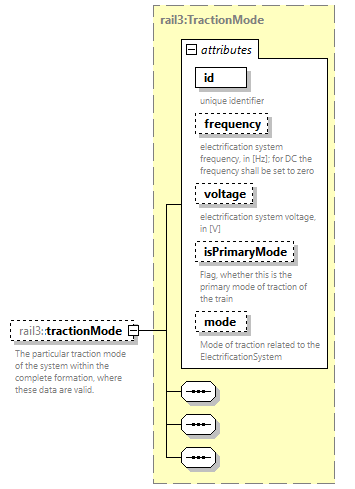 | ||||||||||||||||||||||||||||||||||||||||||||||
| namespace | https://www.railml.org/schemas/3.2 | ||||||||||||||||||||||||||||||||||||||||||||||
| type | rail3:TractionMode | ||||||||||||||||||||||||||||||||||||||||||||||
| properties |
| ||||||||||||||||||||||||||||||||||||||||||||||
| attributes |
| ||||||||||||||||||||||||||||||||||||||||||||||
| annotation |
| ||||||||||||||||||||||||||||||||||||||||||||||
| source | <xs:element name="tractionMode" type="rail3:TractionMode" minOccurs="0" maxOccurs="1"> <xs:annotation> <xs:documentation>The particular traction mode of the system within the complete formation, where these data are valid.</xs:documentation> </xs:annotation> </xs:element> |
complexType TrainOrder
| diagram | 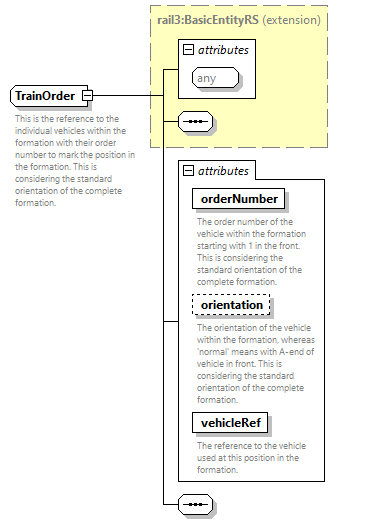 | ||||||||||||||||||||||||||||||
| namespace | https://www.railml.org/schemas/3.2 | ||||||||||||||||||||||||||||||
| type | extension of rail3:BasicEntityRS | ||||||||||||||||||||||||||||||
| properties |
| ||||||||||||||||||||||||||||||
| used by |
| ||||||||||||||||||||||||||||||
| attributes |
| ||||||||||||||||||||||||||||||
| annotation |
| ||||||||||||||||||||||||||||||
| source | <xs:complexType name="TrainOrder"> <xs:annotation> <xs:documentation>This is the reference to the individual vehicles within the formation with their order number to mark the position in the formation. This is considering the standard orientation of the complete formation.</xs:documentation> </xs:annotation> <xs:complexContent> <xs:extension base="rail3:BasicEntityRS"> <xs:sequence/> <xs:attribute name="orderNumber" type="xs:positiveInteger" use="required"> <xs:annotation> <xs:documentation>The order number of the vehicle within the formation starting with 1 in the front. This is considering the standard orientation of the complete formation.</xs:documentation> </xs:annotation> </xs:attribute> <xs:attribute name="orientation" type="rail3:tVehicleOrientation" use="optional"> <xs:annotation> <xs:documentation>The orientation of the vehicle within the formation, whereas 'normal' means with A-end of vehicle in front. This is considering the standard orientation of the complete formation.</xs:documentation> </xs:annotation> </xs:attribute> <xs:attribute name="vehicleRef" type="rail3:tRef" use="required"> <xs:annotation> <xs:documentation>The reference to the vehicle used at this position in the formation.</xs:documentation> </xs:annotation> </xs:attribute> </xs:extension> </xs:complexContent> </xs:complexType> |
attribute TrainOrder/@orderNumber
| type | xs:positiveInteger | ||
| properties |
| ||
| annotation |
| ||
| source | <xs:attribute name="orderNumber" type="xs:positiveInteger" use="required"> <xs:annotation> <xs:documentation>The order number of the vehicle within the formation starting with 1 in the front. This is considering the standard orientation of the complete formation.</xs:documentation> </xs:annotation> </xs:attribute> |
attribute TrainOrder/@orientation
| type | rail3:tVehicleOrientation | |||||||||
| properties |
| |||||||||
| facets |
| |||||||||
| annotation |
| |||||||||
| source | <xs:attribute name="orientation" type="rail3:tVehicleOrientation" use="optional"> <xs:annotation> <xs:documentation>The orientation of the vehicle within the formation, whereas 'normal' means with A-end of vehicle in front. This is considering the standard orientation of the complete formation.</xs:documentation> </xs:annotation> </xs:attribute> |
attribute TrainOrder/@vehicleRef
| type | rail3:tRef | ||
| properties |
| ||
| annotation |
| ||
| source | <xs:attribute name="vehicleRef" type="rail3:tRef" use="required"> <xs:annotation> <xs:documentation>The reference to the vehicle used at this position in the formation.</xs:documentation> </xs:annotation> </xs:attribute> |
complexType Value
| diagram | 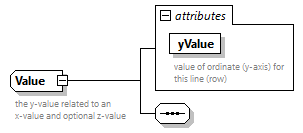 | ||||||||||||||
| namespace | https://www.railml.org/schemas/3.2 | ||||||||||||||
| used by |
| ||||||||||||||
| attributes |
| ||||||||||||||
| annotation |
| ||||||||||||||
| source | <xs:complexType name="Value"> <xs:annotation> <xs:documentation>the y-value related to an x-value and optional z-value</xs:documentation> </xs:annotation> <xs:sequence/> <xs:attribute name="yValue" type="xs:decimal" use="required"> <xs:annotation> <xs:documentation>value of ordinate (y-axis) for this line (row)</xs:documentation> </xs:annotation> </xs:attribute> </xs:complexType> |
attribute Value/@yValue
| type | xs:decimal | ||
| properties |
| ||
| annotation |
| ||
| source | <xs:attribute name="yValue" type="xs:decimal" use="required"> <xs:annotation> <xs:documentation>value of ordinate (y-axis) for this line (row)</xs:documentation> </xs:annotation> </xs:attribute> |
complexType ValueLine
| diagram | 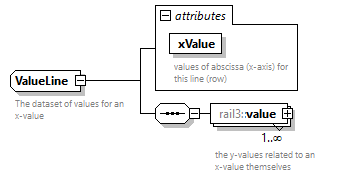 | ||||||||||||||
| namespace | https://www.railml.org/schemas/3.2 | ||||||||||||||
| children | rail3:value | ||||||||||||||
| used by |
| ||||||||||||||
| attributes |
| ||||||||||||||
| annotation |
| ||||||||||||||
| source | <xs:complexType name="ValueLine"> <xs:annotation> <xs:documentation>The dataset of values for an x-value</xs:documentation> </xs:annotation> <xs:sequence> <xs:element name="value" type="rail3:Value" minOccurs="1" maxOccurs="unbounded"> <xs:annotation> <xs:documentation>the y-values related to an x-value themselves</xs:documentation> </xs:annotation> </xs:element> </xs:sequence> <xs:attribute name="xValue" type="xs:decimal" use="required"> <xs:annotation> <xs:documentation>values of abscissa (x-axis) for this line (row)</xs:documentation> </xs:annotation> </xs:attribute> </xs:complexType> |
attribute ValueLine/@xValue
| type | xs:decimal | ||
| properties |
| ||
| annotation |
| ||
| source | <xs:attribute name="xValue" type="xs:decimal" use="required"> <xs:annotation> <xs:documentation>values of abscissa (x-axis) for this line (row)</xs:documentation> </xs:annotation> </xs:attribute> |
element ValueLine/value
| diagram | 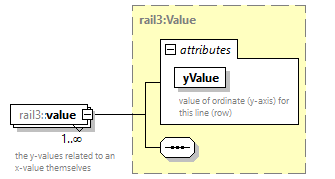 | ||||||||||||||
| namespace | https://www.railml.org/schemas/3.2 | ||||||||||||||
| type | rail3:Value | ||||||||||||||
| properties |
| ||||||||||||||
| attributes |
| ||||||||||||||
| annotation |
| ||||||||||||||
| source | <xs:element name="value" type="rail3:Value" minOccurs="1" maxOccurs="unbounded"> <xs:annotation> <xs:documentation>the y-values related to an x-value themselves</xs:documentation> </xs:annotation> </xs:element> |
complexType ValueTable
| diagram | 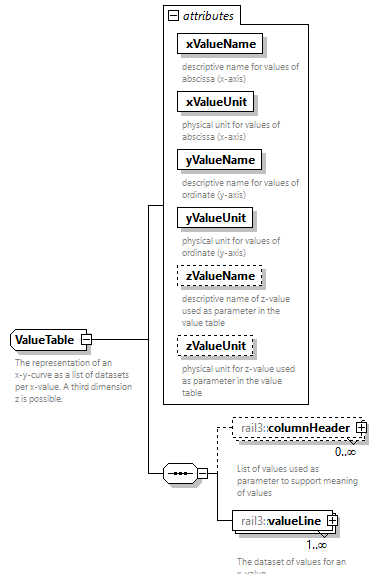 | ||||||||||||||||||||||||||||||||||||||||||||||||||||||
| namespace | https://www.railml.org/schemas/3.2 | ||||||||||||||||||||||||||||||||||||||||||||||||||||||
| children | rail3:columnHeader rail3:valueLine | ||||||||||||||||||||||||||||||||||||||||||||||||||||||
| used by |
| ||||||||||||||||||||||||||||||||||||||||||||||||||||||
| attributes |
| ||||||||||||||||||||||||||||||||||||||||||||||||||||||
| annotation |
| ||||||||||||||||||||||||||||||||||||||||||||||||||||||
| source | <xs:complexType name="ValueTable"> <xs:annotation> <xs:documentation>The representation of an x-y-curve as a list of datasets per x-value. A third dimension z is possible.</xs:documentation> </xs:annotation> <xs:sequence> <xs:element name="columnHeader" type="rail3:ColumnHeader" minOccurs="0" maxOccurs="unbounded"> <xs:annotation> <xs:documentation>List of values used as parameter to support meaning of values</xs:documentation> </xs:annotation> </xs:element> <xs:element name="valueLine" type="rail3:ValueLine" minOccurs="1" maxOccurs="unbounded"> <xs:annotation> <xs:documentation>The dataset of values for an x-value</xs:documentation> </xs:annotation> </xs:element> </xs:sequence> <xs:attribute name="xValueName" type="xs:string" use="required"> <xs:annotation> <xs:documentation>descriptive name for values of abscissa (x-axis)</xs:documentation> </xs:annotation> </xs:attribute> <xs:attribute name="xValueUnit" type="rail3:tUnitNameListExt" use="required"> <xs:annotation> <xs:documentation>physical unit for values of abscissa (x-axis)</xs:documentation> </xs:annotation> </xs:attribute> <xs:attribute name="yValueName" type="xs:string" use="required"> <xs:annotation> <xs:documentation>descriptive name for values of ordinate (y-axis)</xs:documentation> </xs:annotation> </xs:attribute> <xs:attribute name="yValueUnit" type="rail3:tUnitNameListExt" use="required"> <xs:annotation> <xs:documentation>physical unit for values of ordinate (y-axis)</xs:documentation> </xs:annotation> </xs:attribute> <xs:attribute name="zValueName" type="xs:string" use="optional"> <xs:annotation> <xs:documentation>descriptive name of z-value used as parameter in the value table</xs:documentation> </xs:annotation> </xs:attribute> <xs:attribute name="zValueUnit" type="rail3:tUnitNameListExt" use="optional"> <xs:annotation> <xs:documentation>physical unit for z-value used as parameter in the value table</xs:documentation> </xs:annotation> </xs:attribute> </xs:complexType> |
attribute ValueTable/@xValueName
| type | xs:string | ||
| properties |
| ||
| annotation |
| ||
| source | <xs:attribute name="xValueName" type="xs:string" use="required"> <xs:annotation> <xs:documentation>descriptive name for values of abscissa (x-axis)</xs:documentation> </xs:annotation> </xs:attribute> |
attribute ValueTable/@xValueUnit
| type | rail3:tUnitNameListExt | ||
| properties |
| ||
| annotation |
| ||
| source | <xs:attribute name="xValueUnit" type="rail3:tUnitNameListExt" use="required"> <xs:annotation> <xs:documentation>physical unit for values of abscissa (x-axis)</xs:documentation> </xs:annotation> </xs:attribute> |
attribute ValueTable/@yValueName
| type | xs:string | ||
| properties |
| ||
| annotation |
| ||
| source | <xs:attribute name="yValueName" type="xs:string" use="required"> <xs:annotation> <xs:documentation>descriptive name for values of ordinate (y-axis)</xs:documentation> </xs:annotation> </xs:attribute> |
attribute ValueTable/@yValueUnit
| type | rail3:tUnitNameListExt | ||
| properties |
| ||
| annotation |
| ||
| source | <xs:attribute name="yValueUnit" type="rail3:tUnitNameListExt" use="required"> <xs:annotation> <xs:documentation>physical unit for values of ordinate (y-axis)</xs:documentation> </xs:annotation> </xs:attribute> |
attribute ValueTable/@zValueName
| type | xs:string | ||
| properties |
| ||
| annotation |
| ||
| source | <xs:attribute name="zValueName" type="xs:string" use="optional"> <xs:annotation> <xs:documentation>descriptive name of z-value used as parameter in the value table</xs:documentation> </xs:annotation> </xs:attribute> |
attribute ValueTable/@zValueUnit
| type | rail3:tUnitNameListExt | ||
| properties |
| ||
| annotation |
| ||
| source | <xs:attribute name="zValueUnit" type="rail3:tUnitNameListExt" use="optional"> <xs:annotation> <xs:documentation>physical unit for z-value used as parameter in the value table</xs:documentation> </xs:annotation> </xs:attribute> |
element ValueTable/columnHeader
| diagram | 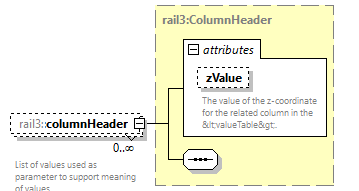 | ||||||||||||||
| namespace | https://www.railml.org/schemas/3.2 | ||||||||||||||
| type | rail3:ColumnHeader | ||||||||||||||
| properties |
| ||||||||||||||
| attributes |
| ||||||||||||||
| annotation |
| ||||||||||||||
| source | <xs:element name="columnHeader" type="rail3:ColumnHeader" minOccurs="0" maxOccurs="unbounded"> <xs:annotation> <xs:documentation>List of values used as parameter to support meaning of values</xs:documentation> </xs:annotation> </xs:element> |
element ValueTable/valueLine
| diagram | 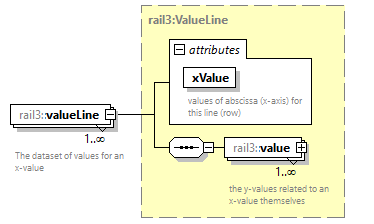 | ||||||||||||||
| namespace | https://www.railml.org/schemas/3.2 | ||||||||||||||
| type | rail3:ValueLine | ||||||||||||||
| properties |
| ||||||||||||||
| children | rail3:value | ||||||||||||||
| attributes |
| ||||||||||||||
| annotation |
| ||||||||||||||
| source | <xs:element name="valueLine" type="rail3:ValueLine" minOccurs="1" maxOccurs="unbounded"> <xs:annotation> <xs:documentation>The dataset of values for an x-value</xs:documentation> </xs:annotation> </xs:element> |
complexType Vehicle
| diagram |  | ||||||||||||||||||||||||||||||||||||||||||||||||||||||||||||||||||||||||||||||||||||||
| namespace | https://www.railml.org/schemas/3.2 | ||||||||||||||||||||||||||||||||||||||||||||||||||||||||||||||||||||||||||||||||||||||
| type | extension of rail3:EntityRSwithIDandDesignator | ||||||||||||||||||||||||||||||||||||||||||||||||||||||||||||||||||||||||||||||||||||||
| properties |
| ||||||||||||||||||||||||||||||||||||||||||||||||||||||||||||||||||||||||||||||||||||||
| children | rail3:designator rail3:vehiclePart rail3:engine rail3:brakes rail3:administrativeData | ||||||||||||||||||||||||||||||||||||||||||||||||||||||||||||||||||||||||||||||||||||||
| used by |
| ||||||||||||||||||||||||||||||||||||||||||||||||||||||||||||||||||||||||||||||||||||||
| attributes |
| ||||||||||||||||||||||||||||||||||||||||||||||||||||||||||||||||||||||||||||||||||||||
| annotation |
| ||||||||||||||||||||||||||||||||||||||||||||||||||||||||||||||||||||||||||||||||||||||
| source | <xs:complexType name="Vehicle"> <xs:annotation> <xs:documentation>A vehicle is a set consisting of at least one vehiclePart which is used in operation as a unit and will not be split under normal circumstances during operation, i.e. splitting might be possible in the workshop only.
 The element can be used to define the common data of a complete vehicle class or the detailed data of an individual vehicle.</xs:documentation> </xs:annotation> <xs:complexContent> <xs:extension base="rail3:EntityRSwithIDandDesignator"> <xs:sequence> <xs:element name="vehiclePart" type="rail3:VehiclePart" minOccurs="0" maxOccurs="unbounded"> <xs:annotation> <xs:documentation>A physical part of the vehicle which has its own body. The parts of a vehicle are connected with some kind of coupling and/or articulation. A vehiclePart can be a segment of an articulated vehicle or a car of multiple unit.</xs:documentation> </xs:annotation> </xs:element> <xs:element name="engine" type="rail3:Engine" minOccurs="0" maxOccurs="unbounded"> <xs:annotation> <xs:documentation>The main data of the traction system of the vehicle. The data are only valid per powerMode, which also includes the electrificationSystem. If there is more than one engine element per vehicle the powerMode must be set.</xs:documentation> </xs:annotation> </xs:element> <xs:element name="brakes" type="rail3:Brakes" minOccurs="0" maxOccurs="unbounded"> <xs:annotation> <xs:documentation>The description and technical data of the installed brake system of the vehicle.</xs:documentation> </xs:annotation> </xs:element> <xs:element name="administrativeData" type="rail3:AdministrativeData" minOccurs="0" maxOccurs="1"> <xs:annotation> <xs:documentation>This is the container for the administrative data of the vehicle with naming and designators as per manufacturer, owner, operator and keeper. This element is only useful in case of an individual vehicle.</xs:documentation> </xs:annotation> </xs:element> </xs:sequence> <xs:attribute name="adhesionWeight" type="rail3:tWeightTons" use="optional"> <xs:annotation> <xs:documentation>The weight of the entire vehicle in metric tons usable for traction.</xs:documentation> </xs:annotation> </xs:attribute> <xs:attribute name="belongsToParent" type="rail3:tRef" use="optional"> <xs:annotation> <xs:documentation>In case of describing an individual vehicle this is the reference to the common data of the vehicle class, which is also a <vehicle> element. The data of an individual vehicle shall supplement or override the common data of the vehicle class.</xs:documentation> </xs:annotation> </xs:attribute> <xs:attribute name="bruttoWeight" type="rail3:tWeightTons" use="optional"> <xs:annotation> <xs:documentation>The total weight of the entire vehicle in metric tons.</xs:documentation> </xs:annotation> </xs:attribute> <xs:attribute name="length" type="rail3:tLengthM" use="optional"> <xs:annotation> <xs:documentation>The overall length of the vehicle in metres.</xs:documentation> </xs:annotation> </xs:attribute> <xs:attribute name="maximumAxleLoad" type="rail3:tWeightTons" use="optional"> <xs:annotation> <xs:documentation>The maximum axle load in metric tons for any axle of the vehicle.</xs:documentation> </xs:annotation> </xs:attribute> <xs:attribute name="nettoWeight" type="rail3:tWeightTons" use="optional"> <xs:annotation> <xs:documentation>The payload of the entire vehicle in metric tons.</xs:documentation> </xs:annotation> </xs:attribute> <xs:attribute name="numberOfAxles" type="xs:positiveInteger" use="optional"> <xs:annotation> <xs:documentation>The total number of axles of this vehicle.</xs:documentation> </xs:annotation> </xs:attribute> <xs:attribute name="speed" type="rail3:tSpeedKmPerHour" use="optional"> <xs:annotation> <xs:documentation>The maximum permissible speed for the vehicle in km/h.</xs:documentation> </xs:annotation> </xs:attribute> <xs:attribute name="tareWeight" type="rail3:tWeightTons" use="optional"> <xs:annotation> <xs:documentation>The tare weight of the entire vehicle in metric tons.</xs:documentation> </xs:annotation> </xs:attribute> </xs:extension> </xs:complexContent> </xs:complexType> |
attribute Vehicle/@adhesionWeight
| type | rail3:tWeightTons | ||
| properties |
| ||
| annotation |
| ||
| source | <xs:attribute name="adhesionWeight" type="rail3:tWeightTons" use="optional"> <xs:annotation> <xs:documentation>The weight of the entire vehicle in metric tons usable for traction.</xs:documentation> </xs:annotation> </xs:attribute> |
attribute Vehicle/@belongsToParent
| type | rail3:tRef | ||
| properties |
| ||
| annotation |
| ||
| source | <xs:attribute name="belongsToParent" type="rail3:tRef" use="optional"> <xs:annotation> <xs:documentation>In case of describing an individual vehicle this is the reference to the common data of the vehicle class, which is also a <vehicle> element. The data of an individual vehicle shall supplement or override the common data of the vehicle class.</xs:documentation> </xs:annotation> </xs:attribute> |
attribute Vehicle/@bruttoWeight
| type | rail3:tWeightTons | ||
| properties |
| ||
| annotation |
| ||
| source | <xs:attribute name="bruttoWeight" type="rail3:tWeightTons" use="optional"> <xs:annotation> <xs:documentation>The total weight of the entire vehicle in metric tons.</xs:documentation> </xs:annotation> </xs:attribute> |
attribute Vehicle/@length
| type | rail3:tLengthM | ||
| properties |
| ||
| annotation |
| ||
| source | <xs:attribute name="length" type="rail3:tLengthM" use="optional"> <xs:annotation> <xs:documentation>The overall length of the vehicle in metres.</xs:documentation> </xs:annotation> </xs:attribute> |
attribute Vehicle/@maximumAxleLoad
| type | rail3:tWeightTons | ||
| properties |
| ||
| annotation |
| ||
| source | <xs:attribute name="maximumAxleLoad" type="rail3:tWeightTons" use="optional"> <xs:annotation> <xs:documentation>The maximum axle load in metric tons for any axle of the vehicle.</xs:documentation> </xs:annotation> </xs:attribute> |
attribute Vehicle/@nettoWeight
| type | rail3:tWeightTons | ||
| properties |
| ||
| annotation |
| ||
| source | <xs:attribute name="nettoWeight" type="rail3:tWeightTons" use="optional"> <xs:annotation> <xs:documentation>The payload of the entire vehicle in metric tons.</xs:documentation> </xs:annotation> </xs:attribute> |
attribute Vehicle/@numberOfAxles
| type | xs:positiveInteger | ||
| properties |
| ||
| annotation |
| ||
| source | <xs:attribute name="numberOfAxles" type="xs:positiveInteger" use="optional"> <xs:annotation> <xs:documentation>The total number of axles of this vehicle.</xs:documentation> </xs:annotation> </xs:attribute> |
attribute Vehicle/@speed
| type | rail3:tSpeedKmPerHour | ||
| properties |
| ||
| annotation |
| ||
| source | <xs:attribute name="speed" type="rail3:tSpeedKmPerHour" use="optional"> <xs:annotation> <xs:documentation>The maximum permissible speed for the vehicle in km/h.</xs:documentation> </xs:annotation> </xs:attribute> |
attribute Vehicle/@tareWeight
| type | rail3:tWeightTons | ||
| properties |
| ||
| annotation |
| ||
| source | <xs:attribute name="tareWeight" type="rail3:tWeightTons" use="optional"> <xs:annotation> <xs:documentation>The tare weight of the entire vehicle in metric tons.</xs:documentation> </xs:annotation> </xs:attribute> |
element Vehicle/vehiclePart
| diagram | 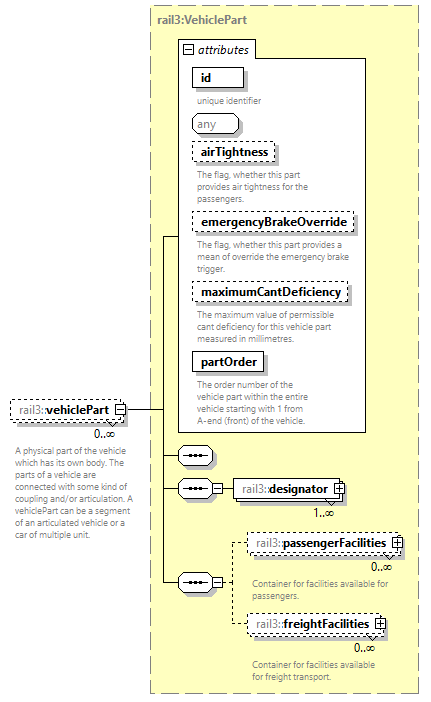 | ||||||||||||||||||||||||||||||||||||||||||||||
| namespace | https://www.railml.org/schemas/3.2 | ||||||||||||||||||||||||||||||||||||||||||||||
| type | rail3:VehiclePart | ||||||||||||||||||||||||||||||||||||||||||||||
| properties |
| ||||||||||||||||||||||||||||||||||||||||||||||
| children | rail3:designator rail3:passengerFacilities rail3:freightFacilities | ||||||||||||||||||||||||||||||||||||||||||||||
| attributes |
| ||||||||||||||||||||||||||||||||||||||||||||||
| annotation |
| ||||||||||||||||||||||||||||||||||||||||||||||
| source | <xs:element name="vehiclePart" type="rail3:VehiclePart" minOccurs="0" maxOccurs="unbounded"> <xs:annotation> <xs:documentation>A physical part of the vehicle which has its own body. The parts of a vehicle are connected with some kind of coupling and/or articulation. A vehiclePart can be a segment of an articulated vehicle or a car of multiple unit.</xs:documentation> </xs:annotation> </xs:element> |
element Vehicle/engine
| diagram | 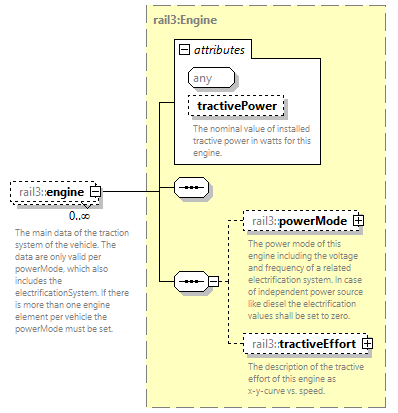 | ||||||||||||||
| namespace | https://www.railml.org/schemas/3.2 | ||||||||||||||
| type | rail3:Engine | ||||||||||||||
| properties |
| ||||||||||||||
| children | rail3:powerMode rail3:tractiveEffort | ||||||||||||||
| attributes |
| ||||||||||||||
| annotation |
| ||||||||||||||
| source | <xs:element name="engine" type="rail3:Engine" minOccurs="0" maxOccurs="unbounded"> <xs:annotation> <xs:documentation>The main data of the traction system of the vehicle. The data are only valid per powerMode, which also includes the electrificationSystem. If there is more than one engine element per vehicle the powerMode must be set.</xs:documentation> </xs:annotation> </xs:element> |
element Vehicle/brakes
| diagram | 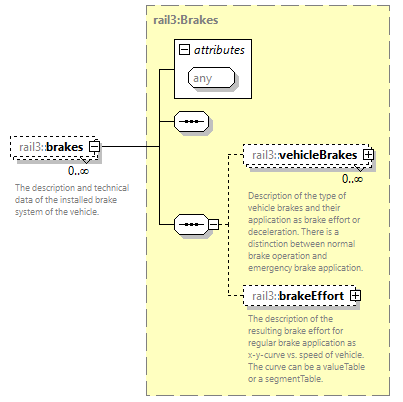 | ||||||
| namespace | https://www.railml.org/schemas/3.2 | ||||||
| type | rail3:Brakes | ||||||
| properties |
| ||||||
| children | rail3:vehicleBrakes rail3:brakeEffort | ||||||
| attributes |
| ||||||
| annotation |
| ||||||
| source | <xs:element name="brakes" type="rail3:Brakes" minOccurs="0" maxOccurs="unbounded"> <xs:annotation> <xs:documentation>The description and technical data of the installed brake system of the vehicle.</xs:documentation> </xs:annotation> </xs:element> |
element Vehicle/administrativeData
| diagram | 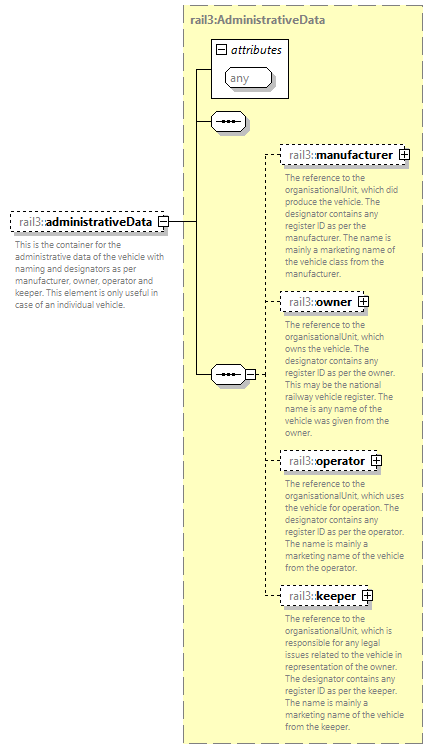 | ||||||
| namespace | https://www.railml.org/schemas/3.2 | ||||||
| type | rail3:AdministrativeData | ||||||
| properties |
| ||||||
| children | rail3:manufacturer rail3:owner rail3:operator rail3:keeper | ||||||
| attributes |
| ||||||
| annotation |
| ||||||
| source | <xs:element name="administrativeData" type="rail3:AdministrativeData" minOccurs="0" maxOccurs="1"> <xs:annotation> <xs:documentation>This is the container for the administrative data of the vehicle with naming and designators as per manufacturer, owner, operator and keeper. This element is only useful in case of an individual vehicle.</xs:documentation> </xs:annotation> </xs:element> |
complexType VehicleAdministration
| diagram | 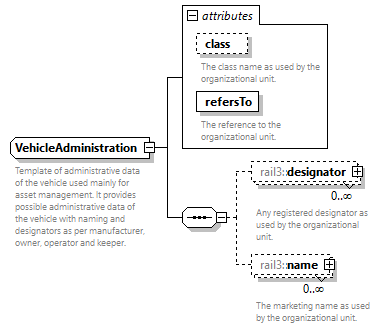 | ||||||||||||||||||||||
| namespace | https://www.railml.org/schemas/3.2 | ||||||||||||||||||||||
| properties |
| ||||||||||||||||||||||
| children | rail3:designator rail3:name | ||||||||||||||||||||||
| used by |
| ||||||||||||||||||||||
| attributes |
| ||||||||||||||||||||||
| annotation |
| ||||||||||||||||||||||
| source | <xs:complexType name="VehicleAdministration" abstract="true"> <xs:annotation> <xs:documentation>Template of administrative data of the vehicle used mainly for asset management. It provides possible administrative data of the vehicle with naming and designators as per manufacturer, owner, operator and keeper.</xs:documentation> </xs:annotation> <xs:sequence> <xs:element name="designator" type="rail3:Designator" minOccurs="0" maxOccurs="unbounded"> <xs:annotation> <xs:documentation>Any registered designator as used by the organizational unit.</xs:documentation> </xs:annotation> </xs:element> <xs:element name="name" type="rail3:Name" minOccurs="0" maxOccurs="unbounded"> <xs:annotation> <xs:documentation>The marketing name as used by the organizational unit.</xs:documentation> </xs:annotation> </xs:element> </xs:sequence> <xs:attribute name="class" type="xs:string" use="optional"> <xs:annotation> <xs:documentation>The class name as used by the organizational unit.</xs:documentation> </xs:annotation> </xs:attribute> <xs:attribute name="refersTo" type="rail3:tRef" use="required"> <xs:annotation> <xs:documentation>The reference to the organizational unit.</xs:documentation> </xs:annotation> </xs:attribute> </xs:complexType> |
attribute VehicleAdministration/@class
| type | xs:string | ||
| properties |
| ||
| annotation |
| ||
| source | <xs:attribute name="class" type="xs:string" use="optional"> <xs:annotation> <xs:documentation>The class name as used by the organizational unit.</xs:documentation> </xs:annotation> </xs:attribute> |
attribute VehicleAdministration/@refersTo
| type | rail3:tRef | ||
| properties |
| ||
| annotation |
| ||
| source | <xs:attribute name="refersTo" type="rail3:tRef" use="required"> <xs:annotation> <xs:documentation>The reference to the organizational unit.</xs:documentation> </xs:annotation> </xs:attribute> |
element VehicleAdministration/designator
| diagram | 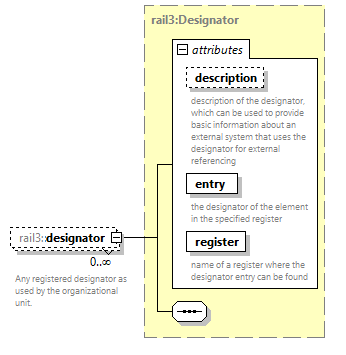 | ||||||||||||||||||||||||||||||
| namespace | https://www.railml.org/schemas/3.2 | ||||||||||||||||||||||||||||||
| type | rail3:Designator | ||||||||||||||||||||||||||||||
| properties |
| ||||||||||||||||||||||||||||||
| attributes |
| ||||||||||||||||||||||||||||||
| annotation |
| ||||||||||||||||||||||||||||||
| source | <xs:element name="designator" type="rail3:Designator" minOccurs="0" maxOccurs="unbounded"> <xs:annotation> <xs:documentation>Any registered designator as used by the organizational unit.</xs:documentation> </xs:annotation> </xs:element> |
element VehicleAdministration/name
| diagram | 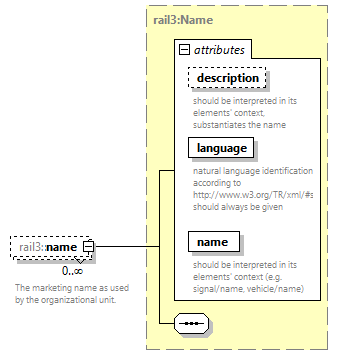 | ||||||||||||||||||||||||||||||
| namespace | https://www.railml.org/schemas/3.2 | ||||||||||||||||||||||||||||||
| type | rail3:Name | ||||||||||||||||||||||||||||||
| properties |
| ||||||||||||||||||||||||||||||
| attributes |
| ||||||||||||||||||||||||||||||
| annotation |
| ||||||||||||||||||||||||||||||
| source | <xs:element name="name" type="rail3:Name" minOccurs="0" maxOccurs="unbounded"> <xs:annotation> <xs:documentation>The marketing name as used by the organizational unit.</xs:documentation> </xs:annotation> </xs:element> |
complexType VehicleKeeper
| diagram | 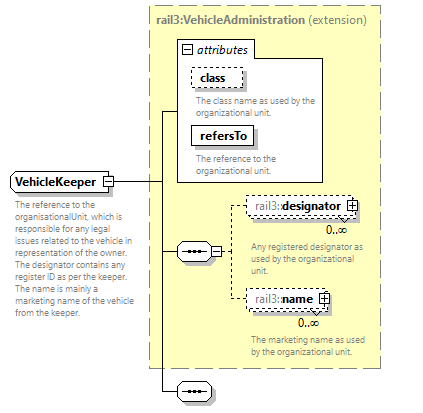 | ||||||||||||||||||||||
| namespace | https://www.railml.org/schemas/3.2 | ||||||||||||||||||||||
| type | extension of rail3:VehicleAdministration | ||||||||||||||||||||||
| properties |
| ||||||||||||||||||||||
| children | rail3:designator rail3:name | ||||||||||||||||||||||
| used by |
| ||||||||||||||||||||||
| attributes |
| ||||||||||||||||||||||
| annotation |
| ||||||||||||||||||||||
| source | <xs:complexType name="VehicleKeeper"> <xs:annotation> <xs:documentation>The reference to the organisationalUnit, which is responsible for any legal issues related to the vehicle in representation of the owner. The designator contains any register ID as per the keeper. The name is mainly a marketing name of the vehicle from the keeper.</xs:documentation> </xs:annotation> <xs:complexContent> <xs:extension base="rail3:VehicleAdministration"> <xs:sequence/> </xs:extension> </xs:complexContent> </xs:complexType> |
complexType VehicleManufacturerRS
| diagram | 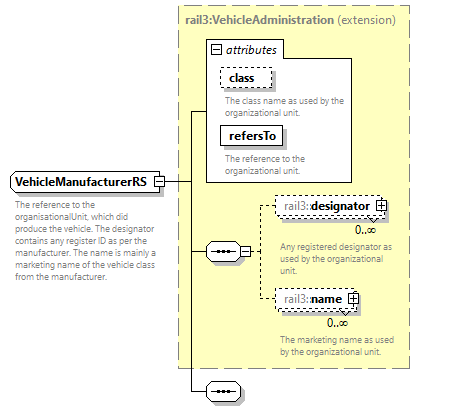 | ||||||||||||||||||||||
| namespace | https://www.railml.org/schemas/3.2 | ||||||||||||||||||||||
| type | extension of rail3:VehicleAdministration | ||||||||||||||||||||||
| properties |
| ||||||||||||||||||||||
| children | rail3:designator rail3:name | ||||||||||||||||||||||
| used by |
| ||||||||||||||||||||||
| attributes |
| ||||||||||||||||||||||
| annotation |
| ||||||||||||||||||||||
| source | <xs:complexType name="VehicleManufacturerRS"> <xs:annotation> <xs:documentation>The reference to the organisationalUnit, which did produce the vehicle. The designator contains any register ID as per the manufacturer. The name is mainly a marketing name of the vehicle class from the manufacturer.</xs:documentation> </xs:annotation> <xs:complexContent> <xs:extension base="rail3:VehicleAdministration"> <xs:sequence/> </xs:extension> </xs:complexContent> </xs:complexType> |
complexType VehicleOperatorRS
| diagram | 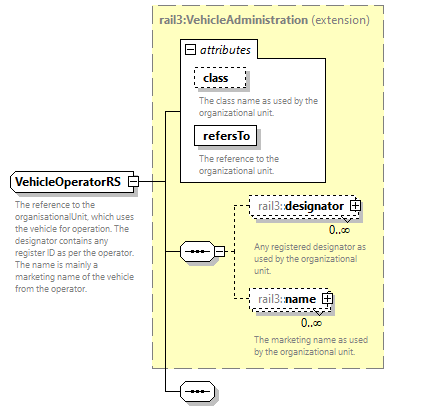 | ||||||||||||||||||||||
| namespace | https://www.railml.org/schemas/3.2 | ||||||||||||||||||||||
| type | extension of rail3:VehicleAdministration | ||||||||||||||||||||||
| properties |
| ||||||||||||||||||||||
| children | rail3:designator rail3:name | ||||||||||||||||||||||
| used by |
| ||||||||||||||||||||||
| attributes |
| ||||||||||||||||||||||
| annotation |
| ||||||||||||||||||||||
| source | <xs:complexType name="VehicleOperatorRS"> <xs:annotation> <xs:documentation>The reference to the organisationalUnit, which uses the vehicle for operation. The designator contains any register ID as per the operator. The name is mainly a marketing name of the vehicle from the operator.</xs:documentation> </xs:annotation> <xs:complexContent> <xs:extension base="rail3:VehicleAdministration"> <xs:sequence/> </xs:extension> </xs:complexContent> </xs:complexType> |
complexType VehicleOwnerRS
| diagram | 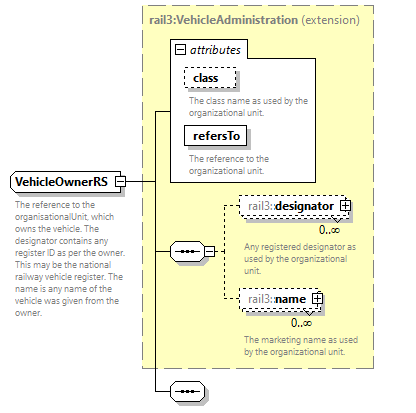 | ||||||||||||||||||||||
| namespace | https://www.railml.org/schemas/3.2 | ||||||||||||||||||||||
| type | extension of rail3:VehicleAdministration | ||||||||||||||||||||||
| properties |
| ||||||||||||||||||||||
| children | rail3:designator rail3:name | ||||||||||||||||||||||
| used by |
| ||||||||||||||||||||||
| attributes |
| ||||||||||||||||||||||
| annotation |
| ||||||||||||||||||||||
| source | <xs:complexType name="VehicleOwnerRS"> <xs:annotation> <xs:documentation>The reference to the organisationalUnit, which owns the vehicle. The designator contains any register ID as per the owner. This may be the national railway vehicle register. The name is any name of the vehicle was given from the owner.</xs:documentation> </xs:annotation> <xs:complexContent> <xs:extension base="rail3:VehicleAdministration"> <xs:sequence/> </xs:extension> </xs:complexContent> </xs:complexType> |
complexType VehiclePart
| diagram | 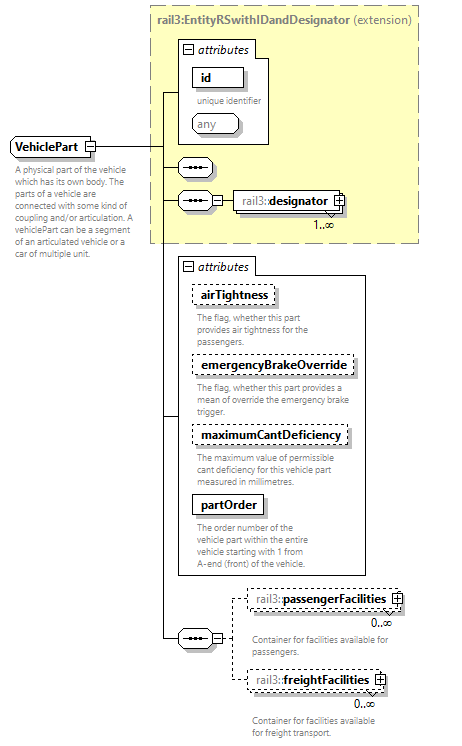 | ||||||||||||||||||||||||||||||||||||||||||||||
| namespace | https://www.railml.org/schemas/3.2 | ||||||||||||||||||||||||||||||||||||||||||||||
| type | extension of rail3:EntityRSwithIDandDesignator | ||||||||||||||||||||||||||||||||||||||||||||||
| properties |
| ||||||||||||||||||||||||||||||||||||||||||||||
| children | rail3:designator rail3:passengerFacilities rail3:freightFacilities | ||||||||||||||||||||||||||||||||||||||||||||||
| used by |
| ||||||||||||||||||||||||||||||||||||||||||||||
| attributes |
| ||||||||||||||||||||||||||||||||||||||||||||||
| annotation |
| ||||||||||||||||||||||||||||||||||||||||||||||
| source | <xs:complexType name="VehiclePart"> <xs:annotation> <xs:documentation>A physical part of the vehicle which has its own body. The parts of a vehicle are connected with some kind of coupling and/or articulation. A vehiclePart can be a segment of an articulated vehicle or a car of multiple unit.</xs:documentation> </xs:annotation> <xs:complexContent> <xs:extension base="rail3:EntityRSwithIDandDesignator"> <xs:sequence> <xs:element name="passengerFacilities" type="rail3:PassengerFacilities" minOccurs="0" maxOccurs="unbounded"> <xs:annotation> <xs:documentation>Container for facilities available for passengers.</xs:documentation> </xs:annotation> </xs:element> <xs:element name="freightFacilities" type="rail3:FreightFacilities" minOccurs="0" maxOccurs="unbounded"> <xs:annotation> <xs:documentation>Container for facilities available for freight transport.</xs:documentation> </xs:annotation> </xs:element> </xs:sequence> <xs:attribute name="airTightness" type="xs:boolean" use="optional"> <xs:annotation> <xs:documentation>The flag, whether this part provides air tightness for the passengers.</xs:documentation> </xs:annotation> </xs:attribute> <xs:attribute name="emergencyBrakeOverride" type="xs:boolean" use="optional"> <xs:annotation> <xs:documentation>The flag, whether this part provides a mean of override the emergency brake trigger.</xs:documentation> </xs:annotation> </xs:attribute> <xs:attribute name="maximumCantDeficiency" type="rail3:tLengthMM" use="optional"> <xs:annotation> <xs:documentation>The maximum value of permissible cant deficiency for this vehicle part measured in millimetres.</xs:documentation> </xs:annotation> </xs:attribute> <xs:attribute name="partOrder" type="xs:positiveInteger" use="required"> <xs:annotation> <xs:documentation>The order number of the vehicle part within the entire vehicle starting with 1 from A-end (front) of the vehicle.</xs:documentation> </xs:annotation> </xs:attribute> </xs:extension> </xs:complexContent> </xs:complexType> |
attribute VehiclePart/@airTightness
| type | xs:boolean | ||
| properties |
| ||
| annotation |
| ||
| source | <xs:attribute name="airTightness" type="xs:boolean" use="optional"> <xs:annotation> <xs:documentation>The flag, whether this part provides air tightness for the passengers.</xs:documentation> </xs:annotation> </xs:attribute> |
attribute VehiclePart/@emergencyBrakeOverride
| type | xs:boolean | ||
| properties |
| ||
| annotation |
| ||
| source | <xs:attribute name="emergencyBrakeOverride" type="xs:boolean" use="optional"> <xs:annotation> <xs:documentation>The flag, whether this part provides a mean of override the emergency brake trigger.</xs:documentation> </xs:annotation> </xs:attribute> |
attribute VehiclePart/@maximumCantDeficiency
| type | rail3:tLengthMM | ||
| properties |
| ||
| annotation |
| ||
| source | <xs:attribute name="maximumCantDeficiency" type="rail3:tLengthMM" use="optional"> <xs:annotation> <xs:documentation>The maximum value of permissible cant deficiency for this vehicle part measured in millimetres.</xs:documentation> </xs:annotation> </xs:attribute> |
attribute VehiclePart/@partOrder
| type | xs:positiveInteger | ||
| properties |
| ||
| annotation |
| ||
| source | <xs:attribute name="partOrder" type="xs:positiveInteger" use="required"> <xs:annotation> <xs:documentation>The order number of the vehicle part within the entire vehicle starting with 1 from A-end (front) of the vehicle.</xs:documentation> </xs:annotation> </xs:attribute> |
element VehiclePart/passengerFacilities
| diagram | 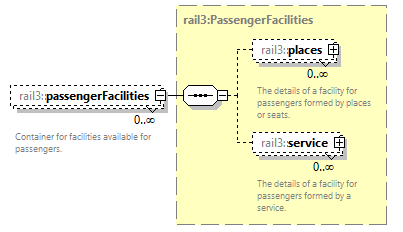 | ||||||
| namespace | https://www.railml.org/schemas/3.2 | ||||||
| type | rail3:PassengerFacilities | ||||||
| properties |
| ||||||
| children | rail3:places rail3:service | ||||||
| annotation |
| ||||||
| source | <xs:element name="passengerFacilities" type="rail3:PassengerFacilities" minOccurs="0" maxOccurs="unbounded"> <xs:annotation> <xs:documentation>Container for facilities available for passengers.</xs:documentation> </xs:annotation> </xs:element> |
element VehiclePart/freightFacilities
| diagram | 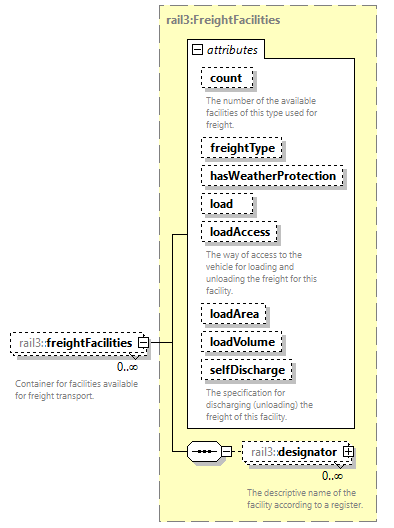 | ||||||||||||||||||||||||||||||||||||||||||||||||||||||||||||
| namespace | https://www.railml.org/schemas/3.2 | ||||||||||||||||||||||||||||||||||||||||||||||||||||||||||||
| type | rail3:FreightFacilities | ||||||||||||||||||||||||||||||||||||||||||||||||||||||||||||
| properties |
| ||||||||||||||||||||||||||||||||||||||||||||||||||||||||||||
| children | rail3:designator | ||||||||||||||||||||||||||||||||||||||||||||||||||||||||||||
| attributes |
| ||||||||||||||||||||||||||||||||||||||||||||||||||||||||||||
| annotation |
| ||||||||||||||||||||||||||||||||||||||||||||||||||||||||||||
| source | <xs:element name="freightFacilities" type="rail3:FreightFacilities" minOccurs="0" maxOccurs="unbounded"> <xs:annotation> <xs:documentation>Container for facilities available for freight transport.</xs:documentation> </xs:annotation> </xs:element> |
complexType Vehicles
| diagram | 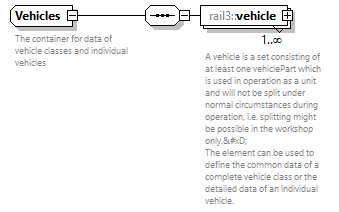 | ||
| namespace | https://www.railml.org/schemas/3.2 | ||
| children | rail3:vehicle | ||
| used by |
| ||
| annotation |
| ||
| source | <xs:complexType name="Vehicles"> <xs:annotation> <xs:documentation>The container for data of vehicle classes and individual vehicles</xs:documentation> </xs:annotation> <xs:sequence> <xs:element name="vehicle" type="rail3:Vehicle" minOccurs="1" maxOccurs="unbounded"> <xs:annotation> <xs:documentation>A vehicle is a set consisting of at least one vehiclePart which is used in operation as a unit and will not be split under normal circumstances during operation, i.e. splitting might be possible in the workshop only.
 The element can be used to define the common data of a complete vehicle class or the detailed data of an individual vehicle.</xs:documentation> </xs:annotation> </xs:element> </xs:sequence> </xs:complexType> |
element Vehicles/vehicle
| diagram |  | ||||||||||||||||||||||||||||||||||||||||||||||||||||||||||||||||||||||||||||||||||||||
| namespace | https://www.railml.org/schemas/3.2 | ||||||||||||||||||||||||||||||||||||||||||||||||||||||||||||||||||||||||||||||||||||||
| type | rail3:Vehicle | ||||||||||||||||||||||||||||||||||||||||||||||||||||||||||||||||||||||||||||||||||||||
| properties |
| ||||||||||||||||||||||||||||||||||||||||||||||||||||||||||||||||||||||||||||||||||||||
| children | rail3:designator rail3:vehiclePart rail3:engine rail3:brakes rail3:administrativeData | ||||||||||||||||||||||||||||||||||||||||||||||||||||||||||||||||||||||||||||||||||||||
| attributes |
| ||||||||||||||||||||||||||||||||||||||||||||||||||||||||||||||||||||||||||||||||||||||
| annotation |
| ||||||||||||||||||||||||||||||||||||||||||||||||||||||||||||||||||||||||||||||||||||||
| source | <xs:element name="vehicle" type="rail3:Vehicle" minOccurs="1" maxOccurs="unbounded"> <xs:annotation> <xs:documentation>A vehicle is a set consisting of at least one vehiclePart which is used in operation as a unit and will not be split under normal circumstances during operation, i.e. splitting might be possible in the workshop only.
 The element can be used to define the common data of a complete vehicle class or the detailed data of an individual vehicle.</xs:documentation> </xs:annotation> </xs:element> |
simpleType tVehicleOrientation
| namespace | https://www.railml.org/schemas/3.2 | |||||||||
| type | restriction of xs:string | |||||||||
| properties |
| |||||||||
| used by |
| |||||||||
| facets |
| |||||||||
| annotation |
| |||||||||
| source | <xs:simpleType name="tVehicleOrientation"> <xs:annotation> <xs:documentation>The orientation of the referenced vehicle within the formation. Normal means vehicle is running with its A-end ahead.</xs:documentation> </xs:annotation> <xs:restriction base="xs:string"> <xs:enumeration value="normal"/> <xs:enumeration value="reverse"/> </xs:restriction> </xs:simpleType> |
complexType ActivationCondition
| diagram | 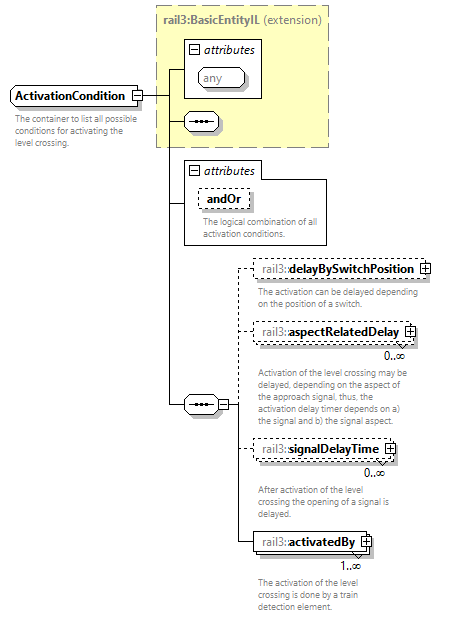 | ||||||||||||||
| namespace | https://www.railml.org/schemas/3.2 | ||||||||||||||
| type | extension of rail3:BasicEntityIL | ||||||||||||||
| properties |
| ||||||||||||||
| children | rail3:delayBySwitchPosition rail3:aspectRelatedDelay rail3:signalDelayTime rail3:activatedBy | ||||||||||||||
| used by |
| ||||||||||||||
| attributes |
| ||||||||||||||
| annotation |
| ||||||||||||||
| source | <xs:complexType name="ActivationCondition"> <xs:annotation> <xs:documentation>The container to list all possible conditions for activating the level crossing.</xs:documentation> </xs:annotation> <xs:complexContent> <xs:extension base="rail3:BasicEntityIL"> <xs:sequence> <xs:element name="delayBySwitchPosition" type="rail3:SwitchRelatedDelay" minOccurs="0" maxOccurs="1"> <xs:annotation> <xs:documentation>The activation can be delayed depending on the position of a switch.</xs:documentation> </xs:annotation> </xs:element> <xs:element name="aspectRelatedDelay" type="rail3:AspectRelatedBarrierDelay" minOccurs="0" maxOccurs="unbounded"> <xs:annotation> <xs:documentation>Activation of the level crossing may be delayed, depending on the aspect of the approach signal, thus, the activation delay timer depends on a) the signal and b) the signal aspect.</xs:documentation> </xs:annotation> </xs:element> <xs:element name="signalDelayTime" type="rail3:SignalDelayTime" minOccurs="0" maxOccurs="unbounded"> <xs:annotation> <xs:documentation>After activation of the level crossing the opening of a signal is delayed.</xs:documentation> </xs:annotation> </xs:element> <xs:element name="activatedBy" type="rail3:ApproachStartingDetector" minOccurs="1" maxOccurs="unbounded"> <xs:annotation> <xs:documentation>The activation of the level crossing is done by a train detection element.</xs:documentation> </xs:annotation> </xs:element> </xs:sequence> <xs:attribute name="andOr" type="rail3:tAndOr" use="optional"> <xs:annotation> <xs:documentation>The logical combination of all activation conditions.</xs:documentation> </xs:annotation> </xs:attribute> </xs:extension> </xs:complexContent> </xs:complexType> |
attribute ActivationCondition/@andOr
| type | rail3:tAndOr | ||||||||||||||||||
| properties |
| ||||||||||||||||||
| facets |
| ||||||||||||||||||
| annotation |
| ||||||||||||||||||
| source | <xs:attribute name="andOr" type="rail3:tAndOr" use="optional"> <xs:annotation> <xs:documentation>The logical combination of all activation conditions.</xs:documentation> </xs:annotation> </xs:attribute> |
element ActivationCondition/delayBySwitchPosition
| diagram | 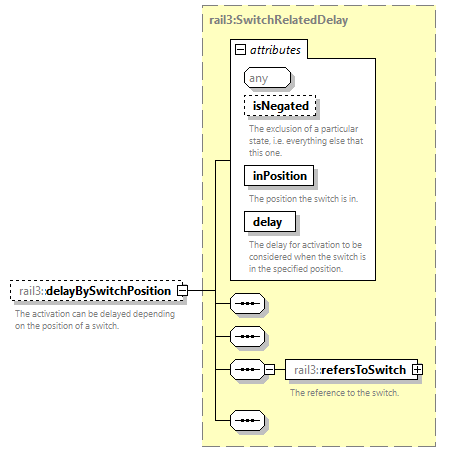 | ||||||||||||||||||||||||||||||
| namespace | https://www.railml.org/schemas/3.2 | ||||||||||||||||||||||||||||||
| type | rail3:SwitchRelatedDelay | ||||||||||||||||||||||||||||||
| properties |
| ||||||||||||||||||||||||||||||
| children | rail3:refersToSwitch | ||||||||||||||||||||||||||||||
| attributes |
| ||||||||||||||||||||||||||||||
| annotation |
| ||||||||||||||||||||||||||||||
| source | <xs:element name="delayBySwitchPosition" type="rail3:SwitchRelatedDelay" minOccurs="0" maxOccurs="1"> <xs:annotation> <xs:documentation>The activation can be delayed depending on the position of a switch.</xs:documentation> </xs:annotation> </xs:element> |
element ActivationCondition/aspectRelatedDelay
| diagram | 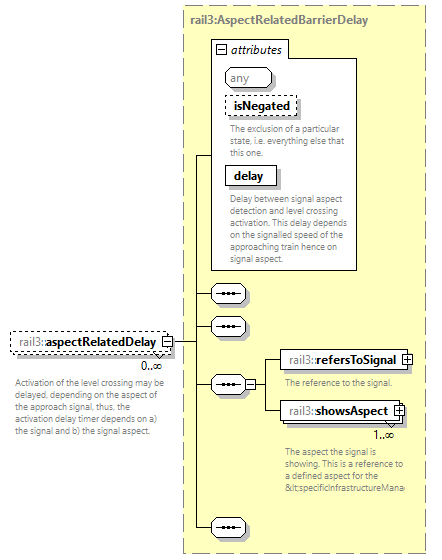 | ||||||||||||||||||||||
| namespace | https://www.railml.org/schemas/3.2 | ||||||||||||||||||||||
| type | rail3:AspectRelatedBarrierDelay | ||||||||||||||||||||||
| properties |
| ||||||||||||||||||||||
| children | rail3:refersToSignal rail3:showsAspect | ||||||||||||||||||||||
| attributes |
| ||||||||||||||||||||||
| annotation |
| ||||||||||||||||||||||
| source | <xs:element name="aspectRelatedDelay" type="rail3:AspectRelatedBarrierDelay" minOccurs="0" maxOccurs="unbounded"> <xs:annotation> <xs:documentation>Activation of the level crossing may be delayed, depending on the aspect of the approach signal, thus, the activation delay timer depends on a) the signal and b) the signal aspect.</xs:documentation> </xs:annotation> </xs:element> |
element ActivationCondition/signalDelayTime
| diagram | 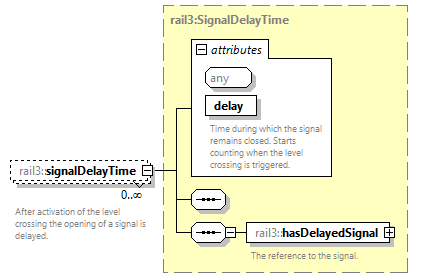 | ||||||||||||||
| namespace | https://www.railml.org/schemas/3.2 | ||||||||||||||
| type | rail3:SignalDelayTime | ||||||||||||||
| properties |
| ||||||||||||||
| children | rail3:hasDelayedSignal | ||||||||||||||
| attributes |
| ||||||||||||||
| annotation |
| ||||||||||||||
| source | <xs:element name="signalDelayTime" type="rail3:SignalDelayTime" minOccurs="0" maxOccurs="unbounded"> <xs:annotation> <xs:documentation>After activation of the level crossing the opening of a signal is delayed.</xs:documentation> </xs:annotation> </xs:element> |
element ActivationCondition/activatedBy
| diagram | 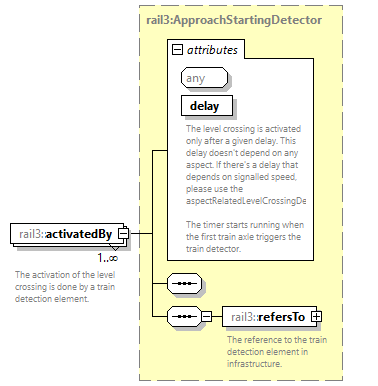 | ||||||||||||||
| namespace | https://www.railml.org/schemas/3.2 | ||||||||||||||
| type | rail3:ApproachStartingDetector | ||||||||||||||
| properties |
| ||||||||||||||
| children | rail3:refersTo | ||||||||||||||
| attributes |
| ||||||||||||||
| annotation |
| ||||||||||||||
| source | <xs:element name="activatedBy" type="rail3:ApproachStartingDetector" minOccurs="1" maxOccurs="unbounded"> <xs:annotation> <xs:documentation>The activation of the level crossing is done by a train detection element.</xs:documentation> </xs:annotation> </xs:element> |
complexType ApproachStartingDetector
| diagram | 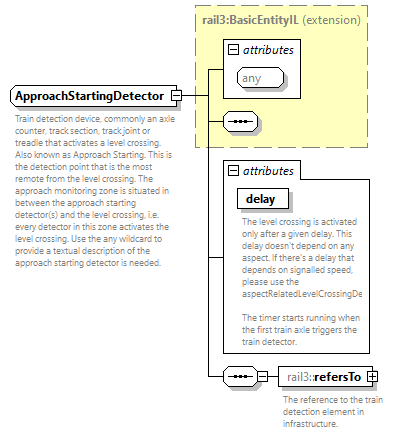 | ||||||||||||||
| namespace | https://www.railml.org/schemas/3.2 | ||||||||||||||
| type | extension of rail3:BasicEntityIL | ||||||||||||||
| properties |
| ||||||||||||||
| children | rail3:refersTo | ||||||||||||||
| used by |
| ||||||||||||||
| attributes |
| ||||||||||||||
| annotation |
| ||||||||||||||
| source | <xs:complexType name="ApproachStartingDetector"> <xs:annotation> <xs:documentation>Train detection device, commonly an axle counter, track section, track joint or treadle that activates a level crossing. Also known as Approach Starting. This is the detection point that is the most remote from the level crossing. The approach monitoring zone is situated in between the approach starting detector(s) and the level crossing, i.e. every detector in this zone activates the level crossing. Use the any wildcard to provide a textual description of the approach starting detector is needed.</xs:documentation> </xs:annotation> <xs:complexContent> <xs:extension base="rail3:BasicEntityIL"> <xs:sequence> <xs:element name="refersTo" type="rail3:EntityILref" minOccurs="1" maxOccurs="1"> <xs:annotation> <xs:documentation>The reference to the train detection element in infrastructure.</xs:documentation> </xs:annotation> </xs:element> </xs:sequence> <xs:attribute name="delay" type="xs:duration" use="required"> <xs:annotation> <xs:documentation>The level crossing is activated only after a given delay. This delay doesn't depend on any aspect. If there's a delay that depends on signalled speed, please use the aspectRelatedLevelCrossingDelay.
 The timer starts running when the first train axle triggers the train detector.</xs:documentation> </xs:annotation> </xs:attribute> </xs:extension> </xs:complexContent> </xs:complexType> |
attribute ApproachStartingDetector/@delay
| type | xs:duration | ||
| properties |
| ||
| annotation |
| ||
| source | <xs:attribute name="delay" type="xs:duration" use="required"> <xs:annotation> <xs:documentation>The level crossing is activated only after a given delay. This delay doesn't depend on any aspect. If there's a delay that depends on signalled speed, please use the aspectRelatedLevelCrossingDelay.
 The timer starts running when the first train axle triggers the train detector.</xs:documentation> </xs:annotation> </xs:attribute> |
element ApproachStartingDetector/refersTo
| diagram | 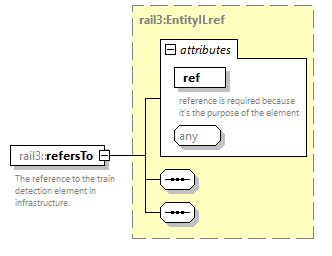 | ||||||||||||||
| namespace | https://www.railml.org/schemas/3.2 | ||||||||||||||
| type | rail3:EntityILref | ||||||||||||||
| properties |
| ||||||||||||||
| attributes |
| ||||||||||||||
| annotation |
| ||||||||||||||
| source | <xs:element name="refersTo" type="rail3:EntityILref" minOccurs="1" maxOccurs="1"> <xs:annotation> <xs:documentation>The reference to the train detection element in infrastructure.</xs:documentation> </xs:annotation> </xs:element> |
complexType AspectRelatedBarrierDelay
| diagram | 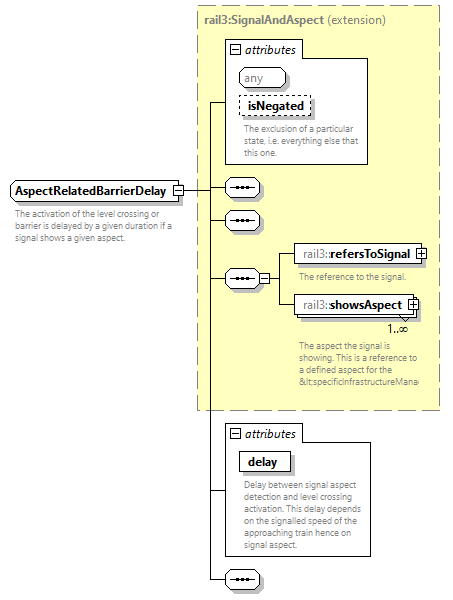 | ||||||||||||||||||||||
| namespace | https://www.railml.org/schemas/3.2 | ||||||||||||||||||||||
| type | extension of rail3:SignalAndAspect | ||||||||||||||||||||||
| properties |
| ||||||||||||||||||||||
| children | rail3:refersToSignal rail3:showsAspect | ||||||||||||||||||||||
| used by |
| ||||||||||||||||||||||
| attributes |
| ||||||||||||||||||||||
| annotation |
| ||||||||||||||||||||||
| source | <xs:complexType name="AspectRelatedBarrierDelay"> <xs:annotation> <xs:documentation>The activation of the level crossing or barrier is delayed by a given duration if a signal shows a given aspect.</xs:documentation> </xs:annotation> <xs:complexContent> <xs:extension base="rail3:SignalAndAspect"> <xs:sequence/> <xs:attribute name="delay" type="xs:duration" use="required"> <xs:annotation> <xs:documentation>Delay between signal aspect detection and level crossing activation. This delay depends on the signalled speed of the approaching train hence on signal aspect.</xs:documentation> </xs:annotation> </xs:attribute> </xs:extension> </xs:complexContent> </xs:complexType> |
attribute AspectRelatedBarrierDelay/@delay
| type | xs:duration | ||
| properties |
| ||
| annotation |
| ||
| source | <xs:attribute name="delay" type="xs:duration" use="required"> <xs:annotation> <xs:documentation>Delay between signal aspect detection and level crossing activation. This delay depends on the signalled speed of the approaching train hence on signal aspect.</xs:documentation> </xs:annotation> </xs:attribute> |
complexType AspectRelation
| diagram | 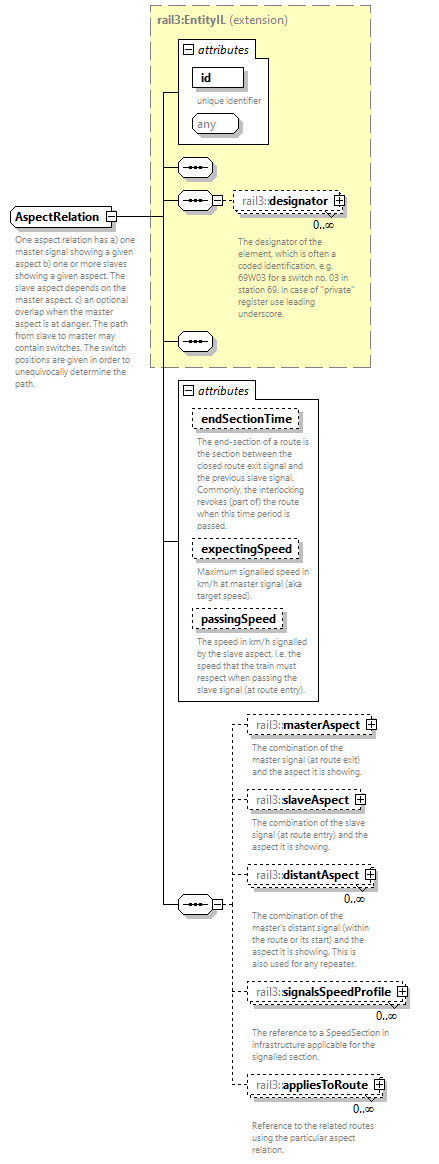 | ||||||||||||||||||||||||||||||||||||||
| namespace | https://www.railml.org/schemas/3.2 | ||||||||||||||||||||||||||||||||||||||
| type | extension of rail3:EntityIL | ||||||||||||||||||||||||||||||||||||||
| properties |
| ||||||||||||||||||||||||||||||||||||||
| children | rail3:designator rail3:masterAspect rail3:slaveAspect rail3:distantAspect rail3:signalsSpeedProfile rail3:appliesToRoute | ||||||||||||||||||||||||||||||||||||||
| used by |
| ||||||||||||||||||||||||||||||||||||||
| attributes |
| ||||||||||||||||||||||||||||||||||||||
| annotation |
| ||||||||||||||||||||||||||||||||||||||
| source | <xs:complexType name="AspectRelation"> <xs:annotation> <xs:documentation>One aspect relation has a) one master signal showing a given aspect b) one or more slaves showing a given aspect. The slave aspect depends on the master aspect. c) an optional overlap when the master aspect is at danger. The path from slave to master may contain switches. The switch positions are given in order to unequivocally determine the path.</xs:documentation> </xs:annotation> <xs:complexContent> <xs:extension base="rail3:EntityIL"> <xs:sequence> <xs:element name="masterAspect" type="rail3:SignalAndAspect" minOccurs="0" maxOccurs="1"> <xs:annotation> <xs:documentation>The combination of the master signal (at route exit) and the aspect it is showing.</xs:documentation> </xs:annotation> </xs:element> <xs:element name="slaveAspect" type="rail3:SignalAndAspect" minOccurs="0" maxOccurs="1"> <xs:annotation> <xs:documentation>The combination of the slave signal (at route entry) and the aspect it is showing.</xs:documentation> </xs:annotation> </xs:element> <xs:element name="distantAspect" type="rail3:SignalAndAspect" minOccurs="0" maxOccurs="unbounded"> <xs:annotation> <xs:documentation>The combination of the master's distant signal (within the route or its start) and the aspect it is showing. This is also used for any repeater.</xs:documentation> </xs:annotation> </xs:element> <xs:element name="signalsSpeedProfile" type="rail3:EntityILref" minOccurs="0" maxOccurs="unbounded"> <xs:annotation> <xs:documentation>The reference to a SpeedSection in infrastructure applicable for the signalled section.</xs:documentation> </xs:annotation> </xs:element> <xs:element name="appliesToRoute" type="rail3:EntityILref" minOccurs="0" maxOccurs="unbounded"> <xs:annotation> <xs:documentation>Reference to the related routes using the particular aspect relation.</xs:documentation> </xs:annotation> </xs:element> </xs:sequence> <xs:attribute name="endSectionTime" type="xs:duration" use="optional"> <xs:annotation> <xs:documentation>The end-section of a route is the section between the closed route exit signal and the previous slave signal. Commonly, the interlocking revokes (part of) the route when this time period is passed.</xs:documentation> </xs:annotation> </xs:attribute> <xs:attribute name="expectingSpeed" type="rail3:tSpeedKmPerHour" use="optional"> <xs:annotation> <xs:documentation>Maximum signalled speed in km/h at master signal (aka target speed).</xs:documentation> </xs:annotation> </xs:attribute> <xs:attribute name="passingSpeed" type="rail3:tSpeedKmPerHour" use="optional"> <xs:annotation> <xs:documentation>The speed in km/h signalled by the slave aspect, i.e. the speed that the train must respect when passing the slave signal (at route entry).</xs:documentation> </xs:annotation> </xs:attribute> </xs:extension> </xs:complexContent> </xs:complexType> |
attribute AspectRelation/@endSectionTime
| type | xs:duration | ||
| properties |
| ||
| annotation |
| ||
| source | <xs:attribute name="endSectionTime" type="xs:duration" use="optional"> <xs:annotation> <xs:documentation>The end-section of a route is the section between the closed route exit signal and the previous slave signal. Commonly, the interlocking revokes (part of) the route when this time period is passed.</xs:documentation> </xs:annotation> </xs:attribute> |
attribute AspectRelation/@expectingSpeed
| type | rail3:tSpeedKmPerHour | ||
| properties |
| ||
| annotation |
| ||
| source | <xs:attribute name="expectingSpeed" type="rail3:tSpeedKmPerHour" use="optional"> <xs:annotation> <xs:documentation>Maximum signalled speed in km/h at master signal (aka target speed).</xs:documentation> </xs:annotation> </xs:attribute> |
attribute AspectRelation/@passingSpeed
| type | rail3:tSpeedKmPerHour | ||
| properties |
| ||
| annotation |
| ||
| source | <xs:attribute name="passingSpeed" type="rail3:tSpeedKmPerHour" use="optional"> <xs:annotation> <xs:documentation>The speed in km/h signalled by the slave aspect, i.e. the speed that the train must respect when passing the slave signal (at route entry).</xs:documentation> </xs:annotation> </xs:attribute> |
element AspectRelation/masterAspect
| diagram | 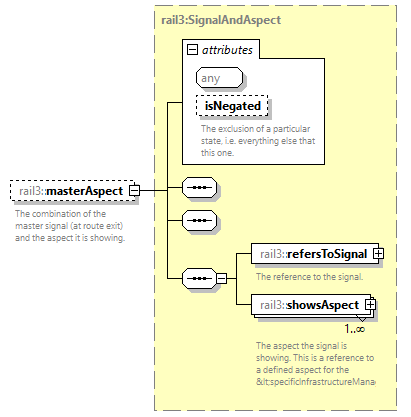 | ||||||||||||||
| namespace | https://www.railml.org/schemas/3.2 | ||||||||||||||
| type | rail3:SignalAndAspect | ||||||||||||||
| properties |
| ||||||||||||||
| children | rail3:refersToSignal rail3:showsAspect | ||||||||||||||
| attributes |
| ||||||||||||||
| annotation |
| ||||||||||||||
| source | <xs:element name="masterAspect" type="rail3:SignalAndAspect" minOccurs="0" maxOccurs="1"> <xs:annotation> <xs:documentation>The combination of the master signal (at route exit) and the aspect it is showing.</xs:documentation> </xs:annotation> </xs:element> |
element AspectRelation/slaveAspect
| diagram | 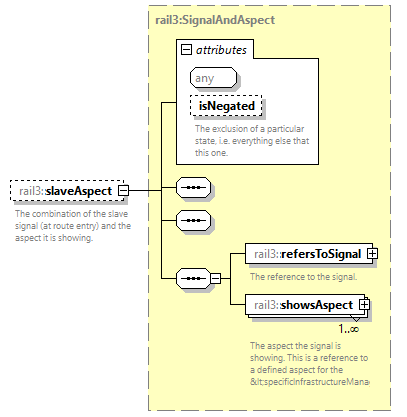 | ||||||||||||||
| namespace | https://www.railml.org/schemas/3.2 | ||||||||||||||
| type | rail3:SignalAndAspect | ||||||||||||||
| properties |
| ||||||||||||||
| children | rail3:refersToSignal rail3:showsAspect | ||||||||||||||
| attributes |
| ||||||||||||||
| annotation |
| ||||||||||||||
| source | <xs:element name="slaveAspect" type="rail3:SignalAndAspect" minOccurs="0" maxOccurs="1"> <xs:annotation> <xs:documentation>The combination of the slave signal (at route entry) and the aspect it is showing.</xs:documentation> </xs:annotation> </xs:element> |
element AspectRelation/distantAspect
| diagram | 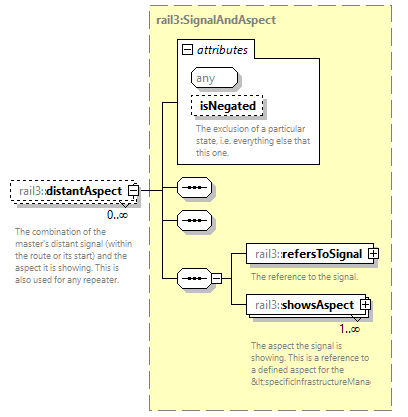 | ||||||||||||||
| namespace | https://www.railml.org/schemas/3.2 | ||||||||||||||
| type | rail3:SignalAndAspect | ||||||||||||||
| properties |
| ||||||||||||||
| children | rail3:refersToSignal rail3:showsAspect | ||||||||||||||
| attributes |
| ||||||||||||||
| annotation |
| ||||||||||||||
| source | <xs:element name="distantAspect" type="rail3:SignalAndAspect" minOccurs="0" maxOccurs="unbounded"> <xs:annotation> <xs:documentation>The combination of the master's distant signal (within the route or its start) and the aspect it is showing. This is also used for any repeater.</xs:documentation> </xs:annotation> </xs:element> |
element AspectRelation/signalsSpeedProfile
| diagram | 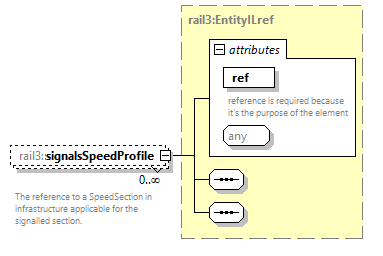 | ||||||||||||||
| namespace | https://www.railml.org/schemas/3.2 | ||||||||||||||
| type | rail3:EntityILref | ||||||||||||||
| properties |
| ||||||||||||||
| attributes |
| ||||||||||||||
| annotation |
| ||||||||||||||
| source | <xs:element name="signalsSpeedProfile" type="rail3:EntityILref" minOccurs="0" maxOccurs="unbounded"> <xs:annotation> <xs:documentation>The reference to a SpeedSection in infrastructure applicable for the signalled section.</xs:documentation> </xs:annotation> </xs:element> |
element AspectRelation/appliesToRoute
| diagram | 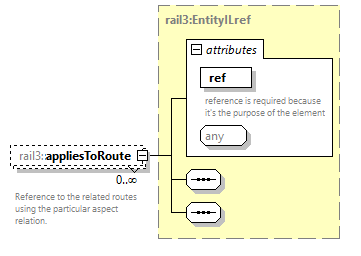 | ||||||||||||||
| namespace | https://www.railml.org/schemas/3.2 | ||||||||||||||
| type | rail3:EntityILref | ||||||||||||||
| properties |
| ||||||||||||||
| attributes |
| ||||||||||||||
| annotation |
| ||||||||||||||
| source | <xs:element name="appliesToRoute" type="rail3:EntityILref" minOccurs="0" maxOccurs="unbounded"> <xs:annotation> <xs:documentation>Reference to the related routes using the particular aspect relation.</xs:documentation> </xs:annotation> </xs:element> |
complexType AssetAndGivenState
| diagram | 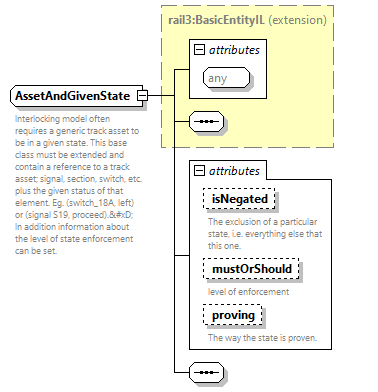 | ||||||||||||||||||||||||||||||
| namespace | https://www.railml.org/schemas/3.2 | ||||||||||||||||||||||||||||||
| type | extension of rail3:BasicEntityIL | ||||||||||||||||||||||||||||||
| properties |
| ||||||||||||||||||||||||||||||
| used by | |||||||||||||||||||||||||||||||
| attributes |
| ||||||||||||||||||||||||||||||
| annotation |
| ||||||||||||||||||||||||||||||
| source | <xs:complexType name="AssetAndGivenState" abstract="true"> <xs:annotation> <xs:documentation>Interlocking model often requires a generic track asset to be in a given state. This base class must be extended and contain a reference to a track asset; signal, section, switch, etc. plus the given status of that element. Eg. (switch_18A, left) or (signal S19, proceed).
 In addition information about the level of state enforcement can be set.</xs:documentation> </xs:annotation> <xs:complexContent> <xs:extension base="rail3:BasicEntityIL"> <xs:sequence/> <xs:attribute name="isNegated" type="xs:boolean" use="optional"> <xs:annotation> <xs:documentation>The exclusion of a particular state, i.e. everything else that this one.</xs:documentation> </xs:annotation> </xs:attribute> <xs:attribute name="mustOrShould" type="rail3:tMustOrShould" use="optional"> <xs:annotation> <xs:documentation>level of enforcement</xs:documentation> </xs:annotation> </xs:attribute> <xs:attribute name="proving" type="rail3:tProving" use="optional"> <xs:annotation> <xs:documentation>The way the state is proven.</xs:documentation> </xs:annotation> </xs:attribute> </xs:extension> </xs:complexContent> </xs:complexType> |
attribute AssetAndGivenState/@isNegated
| type | xs:boolean | ||
| properties |
| ||
| annotation |
| ||
| source | <xs:attribute name="isNegated" type="xs:boolean" use="optional"> <xs:annotation> <xs:documentation>The exclusion of a particular state, i.e. everything else that this one.</xs:documentation> </xs:annotation> </xs:attribute> |
attribute AssetAndGivenState/@mustOrShould
| type | rail3:tMustOrShould | ||||||||||||||||||
| properties |
| ||||||||||||||||||
| facets |
| ||||||||||||||||||
| annotation |
| ||||||||||||||||||
| source | <xs:attribute name="mustOrShould" type="rail3:tMustOrShould" use="optional"> <xs:annotation> <xs:documentation>level of enforcement</xs:documentation> </xs:annotation> </xs:attribute> |
attribute AssetAndGivenState/@proving
| type | rail3:tProving | ||||||||||||||||||
| properties |
| ||||||||||||||||||
| facets |
| ||||||||||||||||||
| annotation |
| ||||||||||||||||||
| source | <xs:attribute name="proving" type="rail3:tProving" use="optional"> <xs:annotation> <xs:documentation>The way the state is proven.</xs:documentation> </xs:annotation> </xs:attribute> |
complexType AssetAndState
| diagram | 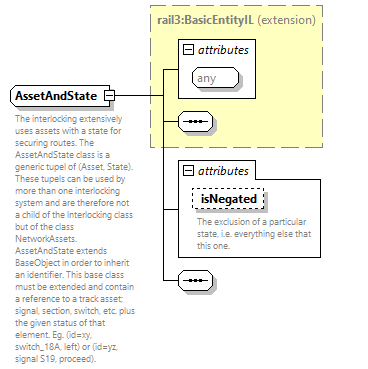 | ||||||||||||||
| namespace | https://www.railml.org/schemas/3.2 | ||||||||||||||
| type | extension of rail3:BasicEntityIL | ||||||||||||||
| properties |
| ||||||||||||||
| used by |
| ||||||||||||||
| attributes |
| ||||||||||||||
| annotation |
| ||||||||||||||
| source | <xs:complexType name="AssetAndState" abstract="true"> <xs:annotation> <xs:documentation>The interlocking extensively uses assets with a state for securing routes. The AssetAndState class is a generic tupel of (Asset, State). These tupels can be used by more than one interlocking system and are therefore not a child of the Interlocking class but of the class NetworkAssets. AssetAndState extends BaseObject in order to inherit an identifier. This base class must be extended and contain a reference to a track asset; signal, section, switch, etc. plus the given status of that element. Eg. (id=xy, switch_18A, left) or (id=yz, signal S19, proceed).</xs:documentation> </xs:annotation> <xs:complexContent> <xs:extension base="rail3:BasicEntityIL"> <xs:sequence/> <xs:attribute name="isNegated" type="xs:boolean" use="optional"> <xs:annotation> <xs:documentation>The exclusion of a particular state, i.e. everything else that this one.</xs:documentation> </xs:annotation> </xs:attribute> </xs:extension> </xs:complexContent> </xs:complexType> |
attribute AssetAndState/@isNegated
| type | xs:boolean | ||
| properties |
| ||
| annotation |
| ||
| source | <xs:attribute name="isNegated" type="xs:boolean" use="optional"> <xs:annotation> <xs:documentation>The exclusion of a particular state, i.e. everything else that this one.</xs:documentation> </xs:annotation> </xs:attribute> |
complexType AssetsForInterlocking
| diagram |  | ||||||||||||||
| namespace | https://www.railml.org/schemas/3.2 | ||||||||||||||
| type | extension of rail3:EntityIL | ||||||||||||||
| properties |
| ||||||||||||||
| children | rail3:designator rail3:tracksIL rail3:endOfTracks rail3:tvdSections rail3:switchesIL rail3:derailersIL rail3:movableCrossings rail3:levelCrossingsIL rail3:keys rail3:keyLocksIL rail3:genericDetectors rail3:movableBridges rail3:tunnelGatesIL rail3:signalIndicators rail3:routeStatusIndicators rail3:stationIndicators rail3:trainNumberFields rail3:signalsIL rail3:interfaces rail3:workZones rail3:localOperationAreas rail3:shuntingZones rail3:permissionZones rail3:routeReleaseGroupsAhead rail3:routeReleaseGroupsRear rail3:routes rail3:conflictingRoutes rail3:routeRelations rail3:combinedRoutes rail3:overlaps rail3:dangerPoints rail3:destinationPoints rail3:powerSuppliesIL | ||||||||||||||
| used by |
| ||||||||||||||
| attributes |
| ||||||||||||||
| annotation |
| ||||||||||||||
| source | <xs:complexType name="AssetsForInterlocking"> <xs:annotation> <xs:documentation>Container for assets used for operation of interlockings and controllers. They represent a more functional/logical view onto the railway network but depending on the hardware as defined in infrastructure domain.
 All assets in one container (asset list) are owned by a single infrastructure manager within the railway network rather than by individual interlocking systems.</xs:documentation> </xs:annotation> <xs:complexContent> <xs:extension base="rail3:EntityIL"> <xs:sequence> <xs:element name="tracksIL" type="rail3:TracksIL" minOccurs="0" maxOccurs="1"> <xs:annotation> <xs:documentation>container for all interlocking track elements</xs:documentation> </xs:annotation> </xs:element> <xs:element name="endOfTracks" type="rail3:EndOfTracks" minOccurs="0" maxOccurs="1"> <xs:annotation> <xs:documentation>Container for all limits in the network known to the interlocking system</xs:documentation> </xs:annotation> </xs:element> <xs:element name="tvdSections" type="rail3:TvdSections" minOccurs="0" maxOccurs="1"> <xs:annotation> <xs:documentation>container for all tvdSection (track vacancy detection) elements</xs:documentation> </xs:annotation> </xs:element> <xs:element name="switchesIL" type="rail3:SwitchesIL" minOccurs="0" maxOccurs="1"> <xs:annotation> <xs:documentation>container for all MovableElements of type SwitchIL</xs:documentation> </xs:annotation> </xs:element> <xs:element name="derailersIL" type="rail3:DerailersIL" minOccurs="0" maxOccurs="1"> <xs:annotation> <xs:documentation>container for all MovableElements of type DerailerIL</xs:documentation> </xs:annotation> </xs:element> <xs:element name="movableCrossings" type="rail3:MovableCrossings" minOccurs="0" maxOccurs="1"> <xs:annotation> <xs:documentation>container for all MovableElements of type MovableCrossing</xs:documentation> </xs:annotation> </xs:element> <xs:element name="levelCrossingsIL" type="rail3:LevelCrossingsIL" minOccurs="0" maxOccurs="1"> <xs:annotation> <xs:documentation>container for all levelCrossingIL elements</xs:documentation> </xs:annotation> </xs:element> <xs:element name="keys" type="rail3:Keys" minOccurs="0" maxOccurs="1"> <xs:annotation> <xs:documentation>container for all key elements</xs:documentation> </xs:annotation> </xs:element> <xs:element name="keyLocksIL" type="rail3:KeyLocksIL" minOccurs="0" maxOccurs="1"> <xs:annotation> <xs:documentation>container for all keyLockIL elements</xs:documentation> </xs:annotation> </xs:element> <xs:element name="genericDetectors" type="rail3:GenericDetectors" minOccurs="0" maxOccurs="1"> <xs:annotation> <xs:documentation>container for all genericDetector elements</xs:documentation> </xs:annotation> </xs:element> <xs:element name="movableBridges" type="rail3:MovableBridges" minOccurs="0" maxOccurs="1"> <xs:annotation> <xs:documentation>container for all movableBridge elements</xs:documentation> </xs:annotation> </xs:element> <xs:element name="tunnelGatesIL" type="rail3:TunnelGatesIL" minOccurs="0" maxOccurs="1"> <xs:annotation> <xs:documentation>container for all tunnelGateIL elements</xs:documentation> </xs:annotation> </xs:element> <xs:element name="signalIndicators" type="rail3:SignalIndicators" minOccurs="0" maxOccurs="1"> <xs:annotation> <xs:documentation>Container for all additional signal indicators appearing on HMI</xs:documentation> </xs:annotation> </xs:element> <xs:element name="routeStatusIndicators" type="rail3:RouteStatusIndicators" minOccurs="0" maxOccurs="1"> <xs:annotation> <xs:documentation>container for virtual logical object used for indication of route status on HMI (route indicators)</xs:documentation> </xs:annotation> </xs:element> <xs:element name="stationIndicators" type="rail3:StationIndicators" minOccurs="0" maxOccurs="1"> <xs:annotation> <xs:documentation>container for virtual logical object used for indication and commanding of station related groups or zones on HMI</xs:documentation> </xs:annotation> </xs:element> <xs:element name="trainNumberFields" type="rail3:TrainNumberFields" minOccurs="0" maxOccurs="1"> <xs:annotation> <xs:documentation>container for all trainNumberField elements for display of train information on HMI</xs:documentation> </xs:annotation> </xs:element> <xs:element name="signalsIL" type="rail3:SignalsIL" minOccurs="0" maxOccurs="1"> <xs:annotation> <xs:documentation>container for all signalIL elements</xs:documentation> </xs:annotation> </xs:element> <xs:element name="interfaces" type="rail3:Interfaces" minOccurs="0" maxOccurs="1"> <xs:annotation> <xs:documentation>container for all dedicated physical interface elements to another signalbox, level crossing or other special device</xs:documentation> </xs:annotation> </xs:element> <xs:element name="workZones" type="rail3:WorkZones" minOccurs="0" maxOccurs="1"> <xs:annotation> <xs:documentation>container for all workZone elements</xs:documentation> </xs:annotation> </xs:element> <xs:element name="localOperationAreas" type="rail3:LocalOperationAreas" minOccurs="0" maxOccurs="1"> <xs:annotation> <xs:documentation>container for all localOperationArea elements</xs:documentation> </xs:annotation> </xs:element> <xs:element name="shuntingZones" type="rail3:ShuntingZones" minOccurs="0" maxOccurs="1"> <xs:annotation> <xs:documentation>container for all shuntingZone elements</xs:documentation> </xs:annotation> </xs:element> <xs:element name="permissionZones" type="rail3:PermissionZones" minOccurs="0" maxOccurs="1"> <xs:annotation> <xs:documentation>container for all permissionZone elements</xs:documentation> </xs:annotation> </xs:element> <xs:element name="routeReleaseGroupsAhead" type="rail3:RouteReleaseGroupsAhead" minOccurs="0" maxOccurs="1"> <xs:annotation> <xs:documentation>container for all routeReleaseGroupAhead elements</xs:documentation> </xs:annotation> </xs:element> <xs:element name="routeReleaseGroupsRear" type="rail3:RouteReleaseGroupsRear" minOccurs="0" maxOccurs="1"> <xs:annotation> <xs:documentation>container for all routeReleaseGroupRear elements</xs:documentation> </xs:annotation> </xs:element> <xs:element name="routes" type="rail3:Routes" minOccurs="0" maxOccurs="1"> <xs:annotation> <xs:documentation>container for all route elements</xs:documentation> </xs:annotation> </xs:element> <xs:element name="conflictingRoutes" type="rail3:ConflictingRoutes" minOccurs="0" maxOccurs="1"> <xs:annotation> <xs:documentation>container for all conflictingRoute elements</xs:documentation> </xs:annotation> </xs:element> <xs:element name="routeRelations" type="rail3:RouteRelations" minOccurs="0" maxOccurs="1"> <xs:annotation> <xs:documentation>container for all routeRelation elements</xs:documentation> </xs:annotation> </xs:element> <xs:element name="combinedRoutes" type="rail3:CombinedRoutes" minOccurs="0" maxOccurs="1"> <xs:annotation> <xs:documentation>container for all combinedRoute elements</xs:documentation> </xs:annotation> </xs:element> <xs:element name="overlaps" type="rail3:Overlaps" minOccurs="0" maxOccurs="1"> <xs:annotation> <xs:documentation>container for all overlap elements</xs:documentation> </xs:annotation> </xs:element> <xs:element name="dangerPoints" type="rail3:DangerPoints" minOccurs="0" maxOccurs="1"> <xs:annotation> <xs:documentation>container for all dangerPoints elements</xs:documentation> </xs:annotation> </xs:element> <xs:element name="destinationPoints" type="rail3:DestinationPoints" minOccurs="0" maxOccurs="1"> <xs:annotation> <xs:documentation>container for all destinationPoint elements</xs:documentation> </xs:annotation> </xs:element> <xs:element name="powerSuppliesIL" type="rail3:PowerSuppliesIL" minOccurs="0" maxOccurs="1"> <xs:annotation> <xs:documentation>container for all powerSupplyIL elements</xs:documentation> </xs:annotation> </xs:element> </xs:sequence> </xs:extension> </xs:complexContent> </xs:complexType> |
element AssetsForInterlocking/tracksIL
| diagram | 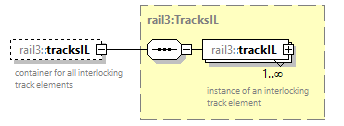 | ||||||
| namespace | https://www.railml.org/schemas/3.2 | ||||||
| type | rail3:TracksIL | ||||||
| properties |
| ||||||
| children | rail3:trackIL | ||||||
| annotation |
| ||||||
| source | <xs:element name="tracksIL" type="rail3:TracksIL" minOccurs="0" maxOccurs="1"> <xs:annotation> <xs:documentation>container for all interlocking track elements</xs:documentation> </xs:annotation> </xs:element> |
element AssetsForInterlocking/endOfTracks
| diagram | 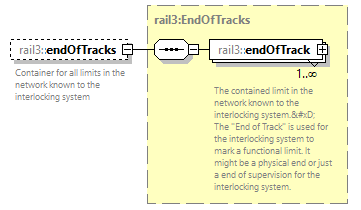 | ||||||
| namespace | https://www.railml.org/schemas/3.2 | ||||||
| type | rail3:EndOfTracks | ||||||
| properties |
| ||||||
| children | rail3:endOfTrack | ||||||
| annotation |
| ||||||
| source | <xs:element name="endOfTracks" type="rail3:EndOfTracks" minOccurs="0" maxOccurs="1"> <xs:annotation> <xs:documentation>Container for all limits in the network known to the interlocking system</xs:documentation> </xs:annotation> </xs:element> |
element AssetsForInterlocking/tvdSections
| diagram | 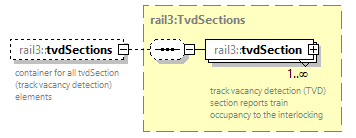 | ||||||
| namespace | https://www.railml.org/schemas/3.2 | ||||||
| type | rail3:TvdSections | ||||||
| properties |
| ||||||
| children | rail3:tvdSection | ||||||
| annotation |
| ||||||
| source | <xs:element name="tvdSections" type="rail3:TvdSections" minOccurs="0" maxOccurs="1"> <xs:annotation> <xs:documentation>container for all tvdSection (track vacancy detection) elements</xs:documentation> </xs:annotation> </xs:element> |
element AssetsForInterlocking/switchesIL
| diagram | 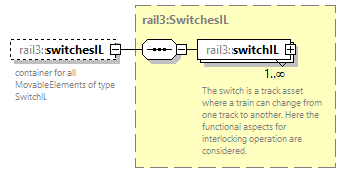 | ||||||
| namespace | https://www.railml.org/schemas/3.2 | ||||||
| type | rail3:SwitchesIL | ||||||
| properties |
| ||||||
| children | rail3:switchIL | ||||||
| annotation |
| ||||||
| source | <xs:element name="switchesIL" type="rail3:SwitchesIL" minOccurs="0" maxOccurs="1"> <xs:annotation> <xs:documentation>container for all MovableElements of type SwitchIL</xs:documentation> </xs:annotation> </xs:element> |
element AssetsForInterlocking/derailersIL
| diagram | 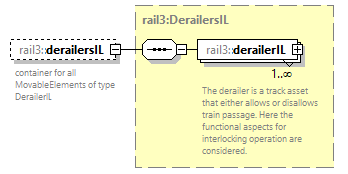 | ||||||
| namespace | https://www.railml.org/schemas/3.2 | ||||||
| type | rail3:DerailersIL | ||||||
| properties |
| ||||||
| children | rail3:derailerIL | ||||||
| annotation |
| ||||||
| source | <xs:element name="derailersIL" type="rail3:DerailersIL" minOccurs="0" maxOccurs="1"> <xs:annotation> <xs:documentation>container for all MovableElements of type DerailerIL</xs:documentation> </xs:annotation> </xs:element> |
element AssetsForInterlocking/movableCrossings
| diagram | 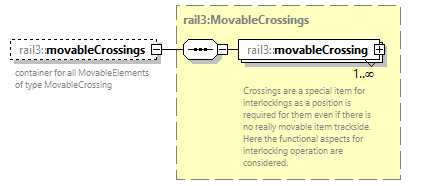 | ||||||
| namespace | https://www.railml.org/schemas/3.2 | ||||||
| type | rail3:MovableCrossings | ||||||
| properties |
| ||||||
| children | rail3:movableCrossing | ||||||
| annotation |
| ||||||
| source | <xs:element name="movableCrossings" type="rail3:MovableCrossings" minOccurs="0" maxOccurs="1"> <xs:annotation> <xs:documentation>container for all MovableElements of type MovableCrossing</xs:documentation> </xs:annotation> </xs:element> |
element AssetsForInterlocking/levelCrossingsIL
| diagram | 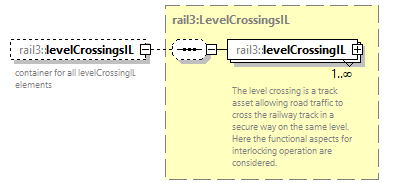 | ||||||
| namespace | https://www.railml.org/schemas/3.2 | ||||||
| type | rail3:LevelCrossingsIL | ||||||
| properties |
| ||||||
| children | rail3:levelCrossingIL | ||||||
| annotation |
| ||||||
| source | <xs:element name="levelCrossingsIL" type="rail3:LevelCrossingsIL" minOccurs="0" maxOccurs="1"> <xs:annotation> <xs:documentation>container for all levelCrossingIL elements</xs:documentation> </xs:annotation> </xs:element> |
element AssetsForInterlocking/keys
| diagram | 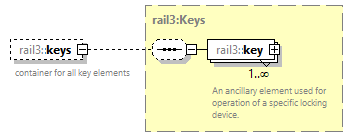 | ||||||
| namespace | https://www.railml.org/schemas/3.2 | ||||||
| type | rail3:Keys | ||||||
| properties |
| ||||||
| children | rail3:key | ||||||
| annotation |
| ||||||
| source | <xs:element name="keys" type="rail3:Keys" minOccurs="0" maxOccurs="1"> <xs:annotation> <xs:documentation>container for all key elements</xs:documentation> </xs:annotation> </xs:element> |
element AssetsForInterlocking/keyLocksIL
| diagram | 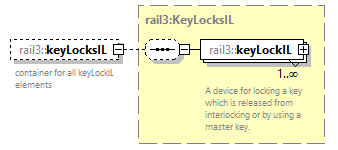 | ||||||
| namespace | https://www.railml.org/schemas/3.2 | ||||||
| type | rail3:KeyLocksIL | ||||||
| properties |
| ||||||
| children | rail3:keyLockIL | ||||||
| annotation |
| ||||||
| source | <xs:element name="keyLocksIL" type="rail3:KeyLocksIL" minOccurs="0" maxOccurs="1"> <xs:annotation> <xs:documentation>container for all keyLockIL elements</xs:documentation> </xs:annotation> </xs:element> |
element AssetsForInterlocking/genericDetectors
| diagram | 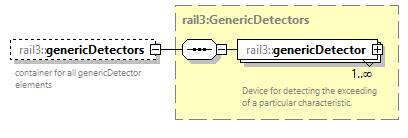 | ||||||
| namespace | https://www.railml.org/schemas/3.2 | ||||||
| type | rail3:GenericDetectors | ||||||
| properties |
| ||||||
| children | rail3:genericDetector | ||||||
| annotation |
| ||||||
| source | <xs:element name="genericDetectors" type="rail3:GenericDetectors" minOccurs="0" maxOccurs="1"> <xs:annotation> <xs:documentation>container for all genericDetector elements</xs:documentation> </xs:annotation> </xs:element> |
element AssetsForInterlocking/movableBridges
| diagram |  | ||||||
| namespace | https://www.railml.org/schemas/3.2 | ||||||
| type | rail3:MovableBridges | ||||||
| properties |
| ||||||
| children | rail3:movableBridge | ||||||
| annotation |
| ||||||
| source | <xs:element name="movableBridges" type="rail3:MovableBridges" minOccurs="0" maxOccurs="1"> <xs:annotation> <xs:documentation>container for all movableBridge elements</xs:documentation> </xs:annotation> </xs:element> |
element AssetsForInterlocking/tunnelGatesIL
| diagram | 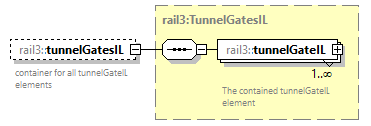 | ||||||
| namespace | https://www.railml.org/schemas/3.2 | ||||||
| type | rail3:TunnelGatesIL | ||||||
| properties |
| ||||||
| children | rail3:tunnelGateIL | ||||||
| annotation |
| ||||||
| source | <xs:element name="tunnelGatesIL" type="rail3:TunnelGatesIL" minOccurs="0" maxOccurs="1"> <xs:annotation> <xs:documentation>container for all tunnelGateIL elements</xs:documentation> </xs:annotation> </xs:element> |
element AssetsForInterlocking/signalIndicators
| diagram | 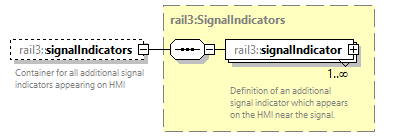 | ||||||
| namespace | https://www.railml.org/schemas/3.2 | ||||||
| type | rail3:SignalIndicators | ||||||
| properties |
| ||||||
| children | rail3:signalIndicator | ||||||
| annotation |
| ||||||
| source | <xs:element name="signalIndicators" type="rail3:SignalIndicators" minOccurs="0" maxOccurs="1"> <xs:annotation> <xs:documentation>Container for all additional signal indicators appearing on HMI</xs:documentation> </xs:annotation> </xs:element> |
element AssetsForInterlocking/routeStatusIndicators
| diagram |  | ||||||
| namespace | https://www.railml.org/schemas/3.2 | ||||||
| type | rail3:RouteStatusIndicators | ||||||
| properties |
| ||||||
| children | rail3:routeStatusIndicator | ||||||
| annotation |
| ||||||
| source | <xs:element name="routeStatusIndicators" type="rail3:RouteStatusIndicators" minOccurs="0" maxOccurs="1"> <xs:annotation> <xs:documentation>container for virtual logical object used for indication of route status on HMI (route indicators)</xs:documentation> </xs:annotation> </xs:element> |
element AssetsForInterlocking/stationIndicators
| diagram | 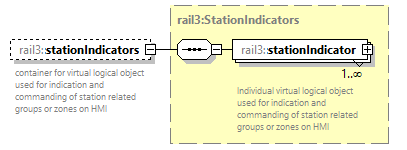 | ||||||
| namespace | https://www.railml.org/schemas/3.2 | ||||||
| type | rail3:StationIndicators | ||||||
| properties |
| ||||||
| children | rail3:stationIndicator | ||||||
| annotation |
| ||||||
| source | <xs:element name="stationIndicators" type="rail3:StationIndicators" minOccurs="0" maxOccurs="1"> <xs:annotation> <xs:documentation>container for virtual logical object used for indication and commanding of station related groups or zones on HMI</xs:documentation> </xs:annotation> </xs:element> |
element AssetsForInterlocking/trainNumberFields
| diagram |  | ||||||
| namespace | https://www.railml.org/schemas/3.2 | ||||||
| type | rail3:TrainNumberFields | ||||||
| properties |
| ||||||
| children | rail3:trainNumberField | ||||||
| annotation |
| ||||||
| source | <xs:element name="trainNumberFields" type="rail3:TrainNumberFields" minOccurs="0" maxOccurs="1"> <xs:annotation> <xs:documentation>container for all trainNumberField elements for display of train information on HMI</xs:documentation> </xs:annotation> </xs:element> |
element AssetsForInterlocking/signalsIL
| diagram | 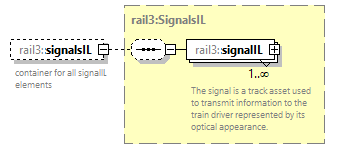 | ||||||
| namespace | https://www.railml.org/schemas/3.2 | ||||||
| type | rail3:SignalsIL | ||||||
| properties |
| ||||||
| children | rail3:signalIL | ||||||
| annotation |
| ||||||
| source | <xs:element name="signalsIL" type="rail3:SignalsIL" minOccurs="0" maxOccurs="1"> <xs:annotation> <xs:documentation>container for all signalIL elements</xs:documentation> </xs:annotation> </xs:element> |
element AssetsForInterlocking/interfaces
| diagram | 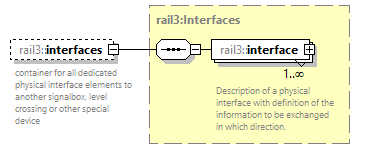 | ||||||
| namespace | https://www.railml.org/schemas/3.2 | ||||||
| type | rail3:Interfaces | ||||||
| properties |
| ||||||
| children | rail3:interface | ||||||
| annotation |
| ||||||
| source | <xs:element name="interfaces" type="rail3:Interfaces" minOccurs="0" maxOccurs="1"> <xs:annotation> <xs:documentation>container for all dedicated physical interface elements to another signalbox, level crossing or other special device</xs:documentation> </xs:annotation> </xs:element> |
element AssetsForInterlocking/workZones
| diagram | 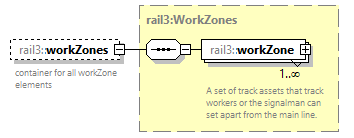 | ||||||
| namespace | https://www.railml.org/schemas/3.2 | ||||||
| type | rail3:WorkZones | ||||||
| properties |
| ||||||
| children | rail3:workZone | ||||||
| annotation |
| ||||||
| source | <xs:element name="workZones" type="rail3:WorkZones" minOccurs="0" maxOccurs="1"> <xs:annotation> <xs:documentation>container for all workZone elements</xs:documentation> </xs:annotation> </xs:element> |
element AssetsForInterlocking/localOperationAreas
| diagram | 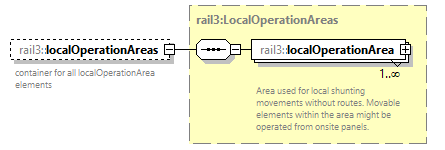 | ||||||
| namespace | https://www.railml.org/schemas/3.2 | ||||||
| type | rail3:LocalOperationAreas | ||||||
| properties |
| ||||||
| children | rail3:localOperationArea | ||||||
| annotation |
| ||||||
| source | <xs:element name="localOperationAreas" type="rail3:LocalOperationAreas" minOccurs="0" maxOccurs="1"> <xs:annotation> <xs:documentation>container for all localOperationArea elements</xs:documentation> </xs:annotation> </xs:element> |
element AssetsForInterlocking/shuntingZones
| diagram |  | ||||||
| namespace | https://www.railml.org/schemas/3.2 | ||||||
| type | rail3:ShuntingZones | ||||||
| properties |
| ||||||
| children | rail3:shuntingZone | ||||||
| annotation |
| ||||||
| source | <xs:element name="shuntingZones" type="rail3:ShuntingZones" minOccurs="0" maxOccurs="1"> <xs:annotation> <xs:documentation>container for all shuntingZone elements</xs:documentation> </xs:annotation> </xs:element> |
element AssetsForInterlocking/permissionZones
| diagram | 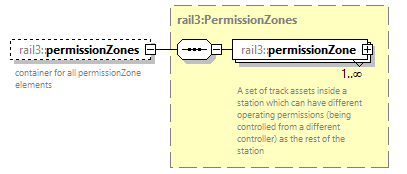 | ||||||
| namespace | https://www.railml.org/schemas/3.2 | ||||||
| type | rail3:PermissionZones | ||||||
| properties |
| ||||||
| children | rail3:permissionZone | ||||||
| annotation |
| ||||||
| source | <xs:element name="permissionZones" type="rail3:PermissionZones" minOccurs="0" maxOccurs="1"> <xs:annotation> <xs:documentation>container for all permissionZone elements</xs:documentation> </xs:annotation> </xs:element> |
element AssetsForInterlocking/routeReleaseGroupsAhead
| diagram |  | ||||||
| namespace | https://www.railml.org/schemas/3.2 | ||||||
| type | rail3:RouteReleaseGroupsAhead | ||||||
| properties |
| ||||||
| children | rail3:routeReleaseGroupAhead | ||||||
| annotation |
| ||||||
| source | <xs:element name="routeReleaseGroupsAhead" type="rail3:RouteReleaseGroupsAhead" minOccurs="0" maxOccurs="1"> <xs:annotation> <xs:documentation>container for all routeReleaseGroupAhead elements</xs:documentation> </xs:annotation> </xs:element> |
element AssetsForInterlocking/routeReleaseGroupsRear
| diagram |  | ||||||
| namespace | https://www.railml.org/schemas/3.2 | ||||||
| type | rail3:RouteReleaseGroupsRear | ||||||
| properties |
| ||||||
| children | rail3:routeReleaseGroupRear | ||||||
| annotation |
| ||||||
| source | <xs:element name="routeReleaseGroupsRear" type="rail3:RouteReleaseGroupsRear" minOccurs="0" maxOccurs="1"> <xs:annotation> <xs:documentation>container for all routeReleaseGroupRear elements</xs:documentation> </xs:annotation> </xs:element> |
element AssetsForInterlocking/routes
| diagram | 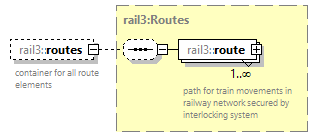 | ||||||
| namespace | https://www.railml.org/schemas/3.2 | ||||||
| type | rail3:Routes | ||||||
| properties |
| ||||||
| children | rail3:route | ||||||
| annotation |
| ||||||
| source | <xs:element name="routes" type="rail3:Routes" minOccurs="0" maxOccurs="1"> <xs:annotation> <xs:documentation>container for all route elements</xs:documentation> </xs:annotation> </xs:element> |
element AssetsForInterlocking/conflictingRoutes
| diagram |  | ||||||
| namespace | https://www.railml.org/schemas/3.2 | ||||||
| type | rail3:ConflictingRoutes | ||||||
| properties |
| ||||||
| children | rail3:conflictingRoute | ||||||
| annotation |
| ||||||
| source | <xs:element name="conflictingRoutes" type="rail3:ConflictingRoutes" minOccurs="0" maxOccurs="1"> <xs:annotation> <xs:documentation>container for all conflictingRoute elements</xs:documentation> </xs:annotation> </xs:element> |
element AssetsForInterlocking/routeRelations
| diagram | 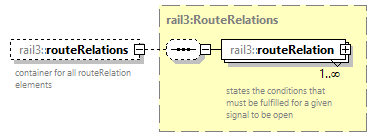 | ||||||
| namespace | https://www.railml.org/schemas/3.2 | ||||||
| type | rail3:RouteRelations | ||||||
| properties |
| ||||||
| children | rail3:routeRelation | ||||||
| annotation |
| ||||||
| source | <xs:element name="routeRelations" type="rail3:RouteRelations" minOccurs="0" maxOccurs="1"> <xs:annotation> <xs:documentation>container for all routeRelation elements</xs:documentation> </xs:annotation> </xs:element> |
element AssetsForInterlocking/combinedRoutes
| diagram | 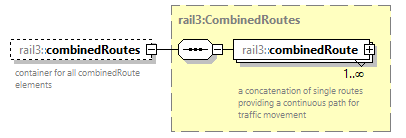 | ||||||
| namespace | https://www.railml.org/schemas/3.2 | ||||||
| type | rail3:CombinedRoutes | ||||||
| properties |
| ||||||
| children | rail3:combinedRoute | ||||||
| annotation |
| ||||||
| source | <xs:element name="combinedRoutes" type="rail3:CombinedRoutes" minOccurs="0" maxOccurs="1"> <xs:annotation> <xs:documentation>container for all combinedRoute elements</xs:documentation> </xs:annotation> </xs:element> |
element AssetsForInterlocking/overlaps
| diagram | 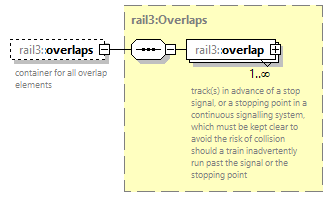 | ||||||
| namespace | https://www.railml.org/schemas/3.2 | ||||||
| type | rail3:Overlaps | ||||||
| properties |
| ||||||
| children | rail3:overlap | ||||||
| annotation |
| ||||||
| source | <xs:element name="overlaps" type="rail3:Overlaps" minOccurs="0" maxOccurs="1"> <xs:annotation> <xs:documentation>container for all overlap elements</xs:documentation> </xs:annotation> </xs:element> |
element AssetsForInterlocking/dangerPoints
| diagram | 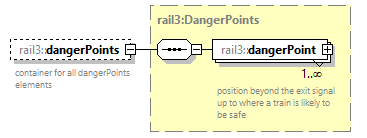 | ||||||
| namespace | https://www.railml.org/schemas/3.2 | ||||||
| type | rail3:DangerPoints | ||||||
| properties |
| ||||||
| children | rail3:dangerPoint | ||||||
| annotation |
| ||||||
| source | <xs:element name="dangerPoints" type="rail3:DangerPoints" minOccurs="0" maxOccurs="1"> <xs:annotation> <xs:documentation>container for all dangerPoints elements</xs:documentation> </xs:annotation> </xs:element> |
element AssetsForInterlocking/destinationPoints
| diagram |  | ||||||
| namespace | https://www.railml.org/schemas/3.2 | ||||||
| type | rail3:DestinationPoints | ||||||
| properties |
| ||||||
| children | rail3:destinationPoint | ||||||
| annotation |
| ||||||
| source | <xs:element name="destinationPoints" type="rail3:DestinationPoints" minOccurs="0" maxOccurs="1"> <xs:annotation> <xs:documentation>container for all destinationPoint elements</xs:documentation> </xs:annotation> </xs:element> |
element AssetsForInterlocking/powerSuppliesIL
| diagram |  | ||||||
| namespace | https://www.railml.org/schemas/3.2 | ||||||
| type | rail3:PowerSuppliesIL | ||||||
| properties |
| ||||||
| children | rail3:powerSupplyIL | ||||||
| annotation |
| ||||||
| source | <xs:element name="powerSuppliesIL" type="rail3:PowerSuppliesIL" minOccurs="0" maxOccurs="1"> <xs:annotation> <xs:documentation>container for all powerSupplyIL elements</xs:documentation> </xs:annotation> </xs:element> |
complexType AssetsForInterlockings
| diagram |  | ||
| namespace | https://www.railml.org/schemas/3.2 | ||
| children | rail3:assetsForInterlocking | ||
| used by |
| ||
| annotation |
| ||
| source | <xs:complexType name="AssetsForInterlockings"> <xs:annotation> <xs:documentation>container for individual lists of assets</xs:documentation> </xs:annotation> <xs:sequence> <xs:element name="assetsForInterlocking" type="rail3:AssetsForInterlocking" minOccurs="1" maxOccurs="unbounded"> <xs:annotation> <xs:documentation>list of various assets which are related to one single infrastructure manager</xs:documentation> </xs:annotation> </xs:element> </xs:sequence> </xs:complexType> |
element AssetsForInterlockings/assetsForInterlocking
complexType BarrierDeactivator
| diagram | 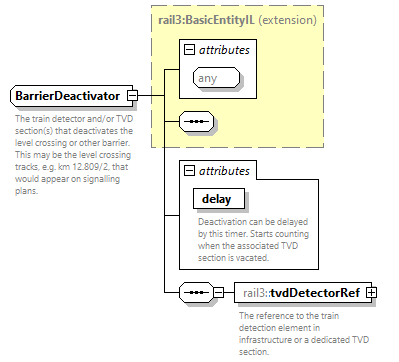 | ||||||||||||||
| namespace | https://www.railml.org/schemas/3.2 | ||||||||||||||
| type | extension of rail3:BasicEntityIL | ||||||||||||||
| properties |
| ||||||||||||||
| children | rail3:tvdDetectorRef | ||||||||||||||
| used by |
| ||||||||||||||
| attributes |
| ||||||||||||||
| annotation |
| ||||||||||||||
| source | <xs:complexType name="BarrierDeactivator"> <xs:annotation> <xs:documentation>The train detector and/or TVD section(s) that deactivates the level crossing or other barrier. This may be the level crossing tracks, e.g. km 12.809/2, that would appear on signalling plans.</xs:documentation> </xs:annotation> <xs:complexContent> <xs:extension base="rail3:BasicEntityIL"> <xs:sequence> <xs:element name="tvdDetectorRef" type="rail3:EntityILref" minOccurs="1" maxOccurs="1"> <xs:annotation> <xs:documentation>The reference to the train detection element in infrastructure or a dedicated TVD section.</xs:documentation> </xs:annotation> </xs:element> </xs:sequence> <xs:attribute name="delay" type="xs:duration" use="required"> <xs:annotation> <xs:documentation>Deactivation can be delayed by this timer. Starts counting when the associated TVD section is vacated.</xs:documentation> </xs:annotation> </xs:attribute> </xs:extension> </xs:complexContent> </xs:complexType> |
attribute BarrierDeactivator/@delay
| type | xs:duration | ||
| properties |
| ||
| annotation |
| ||
| source | <xs:attribute name="delay" type="xs:duration" use="required"> <xs:annotation> <xs:documentation>Deactivation can be delayed by this timer. Starts counting when the associated TVD section is vacated.</xs:documentation> </xs:annotation> </xs:attribute> |
element BarrierDeactivator/tvdDetectorRef
| diagram | 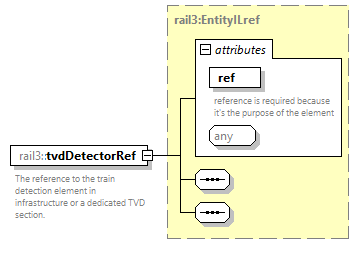 | ||||||||||||||
| namespace | https://www.railml.org/schemas/3.2 | ||||||||||||||
| type | rail3:EntityILref | ||||||||||||||
| properties |
| ||||||||||||||
| attributes |
| ||||||||||||||
| annotation |
| ||||||||||||||
| source | <xs:element name="tvdDetectorRef" type="rail3:EntityILref" minOccurs="1" maxOccurs="1"> <xs:annotation> <xs:documentation>The reference to the train detection element in infrastructure or a dedicated TVD section.</xs:documentation> </xs:annotation> </xs:element> |
complexType BasicEntityIL
| diagram | 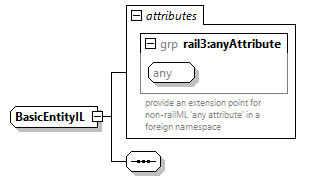 | ||||||
| namespace | https://www.railml.org/schemas/3.2 | ||||||
| used by |
| ||||||
| attributes |
| ||||||
| source | <xs:complexType name="BasicEntityIL"> <xs:sequence/> <xs:attributeGroup ref="rail3:anyAttribute"/> </xs:complexType> |
complexType CodedEntityILref
| diagram | 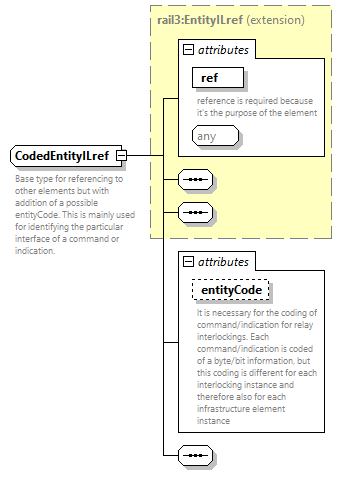 | ||||||||||||||||||||||
| namespace | https://www.railml.org/schemas/3.2 | ||||||||||||||||||||||
| type | extension of rail3:EntityILref | ||||||||||||||||||||||
| properties |
| ||||||||||||||||||||||
| used by |
| ||||||||||||||||||||||
| attributes |
| ||||||||||||||||||||||
| annotation |
| ||||||||||||||||||||||
| source | <xs:complexType name="CodedEntityILref"> <xs:annotation> <xs:documentation>Base type for referencing to other elements but with addition of a possible entityCode. This is mainly used for identifying the particular interface of a command or indication.</xs:documentation> </xs:annotation> <xs:complexContent> <xs:extension base="rail3:EntityILref"> <xs:sequence/> <xs:attribute name="entityCode" type="xs:string" use="optional"> <xs:annotation> <xs:documentation>It is necessary for the coding of command/indication for relay interlockings. Each command/indication is coded of a byte/bit information, but this coding is different for each interlocking instance and therefore also for each infrastructure element instance</xs:documentation> </xs:annotation> </xs:attribute> </xs:extension> </xs:complexContent> </xs:complexType> |
attribute CodedEntityILref/@entityCode
| type | xs:string | ||
| properties |
| ||
| annotation |
| ||
| source | <xs:attribute name="entityCode" type="xs:string" use="optional"> <xs:annotation> <xs:documentation>It is necessary for the coding of command/indication for relay interlockings. Each command/indication is coded of a byte/bit information, but this coding is different for each interlocking instance and therefore also for each infrastructure element instance</xs:documentation> </xs:annotation> </xs:attribute> |
complexType CombinedRoute
| diagram | 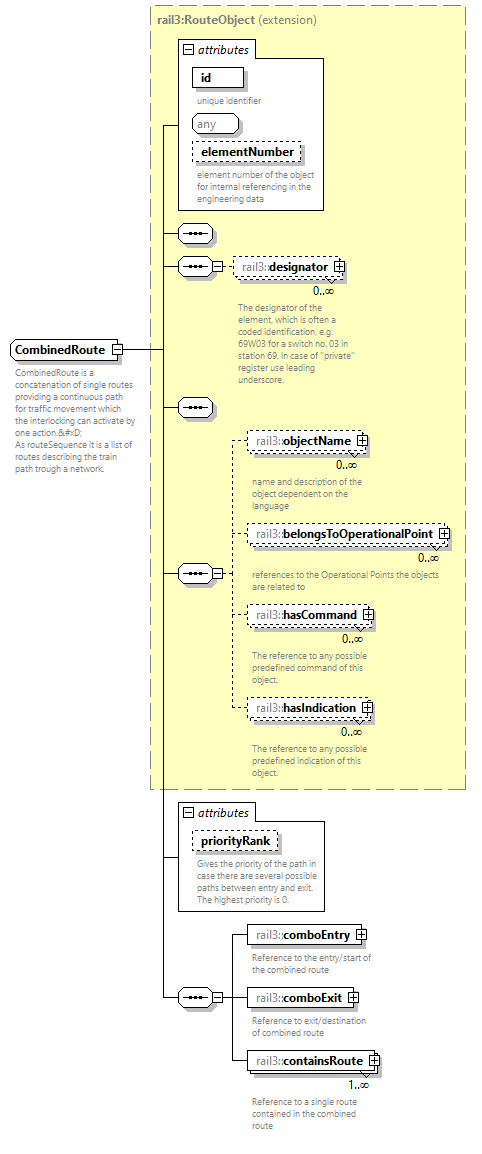 | ||||||||||||||||||||||||||||||
| namespace | https://www.railml.org/schemas/3.2 | ||||||||||||||||||||||||||||||
| type | extension of rail3:RouteObject | ||||||||||||||||||||||||||||||
| properties |
| ||||||||||||||||||||||||||||||
| children | rail3:designator rail3:objectName rail3:belongsToOperationalPoint rail3:hasCommand rail3:hasIndication rail3:comboEntry rail3:comboExit rail3:containsRoute | ||||||||||||||||||||||||||||||
| used by |
| ||||||||||||||||||||||||||||||
| attributes |
| ||||||||||||||||||||||||||||||
| annotation |
| ||||||||||||||||||||||||||||||
| source | <xs:complexType name="CombinedRoute"> <xs:annotation> <xs:documentation>CombinedRoute is a concatenation of single routes providing a continuous path for traffic movement which the interlocking can activate by one action.
 As routeSequence it is a list of routes describing the train path trough a network.</xs:documentation> </xs:annotation> <xs:complexContent> <xs:extension base="rail3:RouteObject"> <xs:sequence> <xs:element name="comboEntry" type="rail3:EntityILref" minOccurs="1" maxOccurs="1"> <xs:annotation> <xs:documentation>Reference to the entry/start of the combined route</xs:documentation> </xs:annotation> </xs:element> <xs:element name="comboExit" type="rail3:EntityILref" minOccurs="1" maxOccurs="1"> <xs:annotation> <xs:documentation>Reference to exit/destination of combined route</xs:documentation> </xs:annotation> </xs:element> <xs:element name="containsRoute" type="rail3:EntityILref" minOccurs="1" maxOccurs="unbounded"> <xs:annotation> <xs:documentation>Reference to a single route contained in the combined route</xs:documentation> </xs:annotation> </xs:element> </xs:sequence> <xs:attribute name="priorityRank" type="rail3:tPriority" use="optional"> <xs:annotation> <xs:documentation>Gives the priority of the path in case there are several possible paths between entry and exit. The highest priority is 0.</xs:documentation> </xs:annotation> </xs:attribute> </xs:extension> </xs:complexContent> </xs:complexType> |
attribute CombinedRoute/@priorityRank
| type | rail3:tPriority | ||
| properties |
| ||
| annotation |
| ||
| source | <xs:attribute name="priorityRank" type="rail3:tPriority" use="optional"> <xs:annotation> <xs:documentation>Gives the priority of the path in case there are several possible paths between entry and exit. The highest priority is 0.</xs:documentation> </xs:annotation> </xs:attribute> |
element CombinedRoute/comboEntry
| diagram | 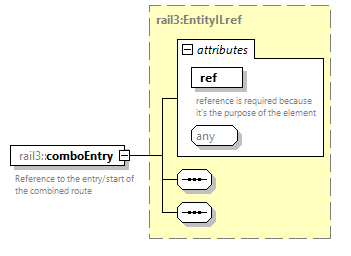 | ||||||||||||||
| namespace | https://www.railml.org/schemas/3.2 | ||||||||||||||
| type | rail3:EntityILref | ||||||||||||||
| properties |
| ||||||||||||||
| attributes |
| ||||||||||||||
| annotation |
| ||||||||||||||
| source | <xs:element name="comboEntry" type="rail3:EntityILref" minOccurs="1" maxOccurs="1"> <xs:annotation> <xs:documentation>Reference to the entry/start of the combined route</xs:documentation> </xs:annotation> </xs:element> |
element CombinedRoute/comboExit
| diagram | 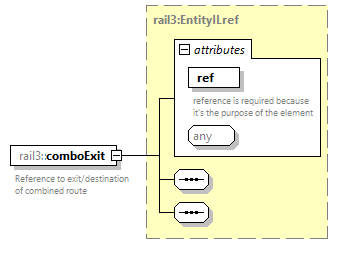 | ||||||||||||||
| namespace | https://www.railml.org/schemas/3.2 | ||||||||||||||
| type | rail3:EntityILref | ||||||||||||||
| properties |
| ||||||||||||||
| attributes |
| ||||||||||||||
| annotation |
| ||||||||||||||
| source | <xs:element name="comboExit" type="rail3:EntityILref" minOccurs="1" maxOccurs="1"> <xs:annotation> <xs:documentation>Reference to exit/destination of combined route</xs:documentation> </xs:annotation> </xs:element> |
element CombinedRoute/containsRoute
| diagram | 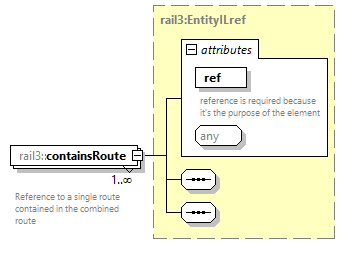 | ||||||||||||||
| namespace | https://www.railml.org/schemas/3.2 | ||||||||||||||
| type | rail3:EntityILref | ||||||||||||||
| properties |
| ||||||||||||||
| attributes |
| ||||||||||||||
| annotation |
| ||||||||||||||
| source | <xs:element name="containsRoute" type="rail3:EntityILref" minOccurs="1" maxOccurs="unbounded"> <xs:annotation> <xs:documentation>Reference to a single route contained in the combined route</xs:documentation> </xs:annotation> </xs:element> |
complexType CombinedRoutes
| diagram |  | ||
| namespace | https://www.railml.org/schemas/3.2 | ||
| children | rail3:combinedRoute | ||
| used by |
| ||
| annotation |
| ||
| source | <xs:complexType name="CombinedRoutes"> <xs:annotation> <xs:documentation>container element for all CombinedRoute elements</xs:documentation> </xs:annotation> <xs:sequence> <xs:element name="combinedRoute" type="rail3:CombinedRoute" minOccurs="1" maxOccurs="unbounded"> <xs:annotation> <xs:documentation>a concatenation of single routes providing a continuous path for traffic movement</xs:documentation> </xs:annotation> </xs:element> </xs:sequence> </xs:complexType> |
element CombinedRoutes/combinedRoute
| diagram | 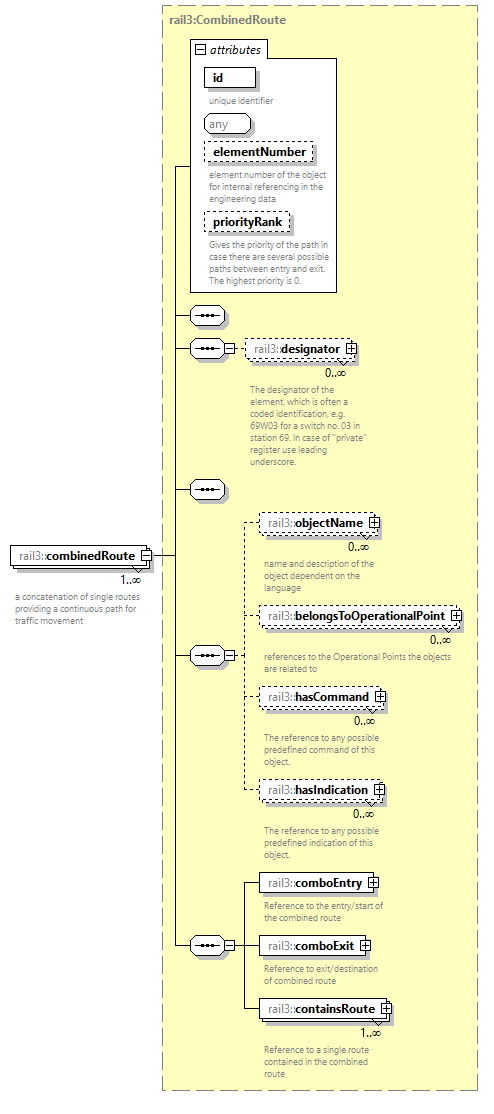 | ||||||||||||||||||||||||||||||
| namespace | https://www.railml.org/schemas/3.2 | ||||||||||||||||||||||||||||||
| type | rail3:CombinedRoute | ||||||||||||||||||||||||||||||
| properties |
| ||||||||||||||||||||||||||||||
| children | rail3:designator rail3:objectName rail3:belongsToOperationalPoint rail3:hasCommand rail3:hasIndication rail3:comboEntry rail3:comboExit rail3:containsRoute | ||||||||||||||||||||||||||||||
| attributes |
| ||||||||||||||||||||||||||||||
| annotation |
| ||||||||||||||||||||||||||||||
| source | <xs:element name="combinedRoute" type="rail3:CombinedRoute" minOccurs="1" maxOccurs="unbounded"> <xs:annotation> <xs:documentation>a concatenation of single routes providing a continuous path for traffic movement</xs:documentation> </xs:annotation> </xs:element> |
complexType CommunicationSettings
| diagram | 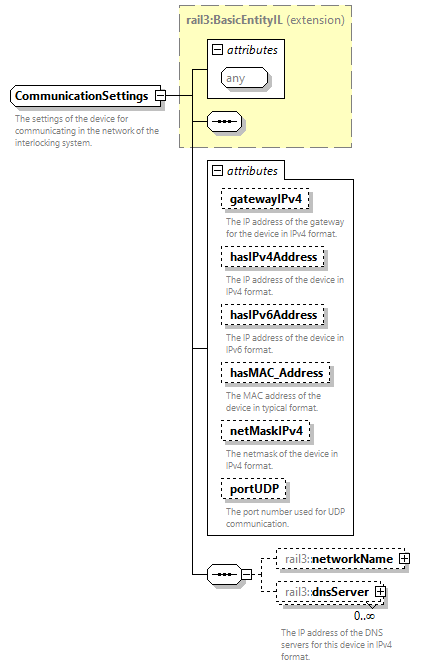 | ||||||||||||||||||||||||||||||||||||||||||||||||||||||
| namespace | https://www.railml.org/schemas/3.2 | ||||||||||||||||||||||||||||||||||||||||||||||||||||||
| type | extension of rail3:BasicEntityIL | ||||||||||||||||||||||||||||||||||||||||||||||||||||||
| properties |
| ||||||||||||||||||||||||||||||||||||||||||||||||||||||
| children | rail3:networkName rail3:dnsServer | ||||||||||||||||||||||||||||||||||||||||||||||||||||||
| used by |
| ||||||||||||||||||||||||||||||||||||||||||||||||||||||
| attributes |
| ||||||||||||||||||||||||||||||||||||||||||||||||||||||
| annotation |
| ||||||||||||||||||||||||||||||||||||||||||||||||||||||
| source | <xs:complexType name="CommunicationSettings"> <xs:annotation> <xs:documentation>The settings of the device for communicating in the network of the interlocking system.</xs:documentation> </xs:annotation> <xs:complexContent> <xs:extension base="rail3:BasicEntityIL"> <xs:sequence> <xs:element name="networkName" type="rail3:Name" minOccurs="0" maxOccurs="1"/> <xs:element name="dnsServer" type="rail3:IPv4AddressEntry" minOccurs="0" maxOccurs="unbounded"> <xs:annotation> <xs:documentation>The IP address of the DNS servers for this device in IPv4 format.</xs:documentation> </xs:annotation> </xs:element> </xs:sequence> <xs:attribute name="gatewayIPv4" type="rail3:IPv4_Address" use="optional"> <xs:annotation> <xs:documentation>The IP address of the gateway for the device in IPv4 format.</xs:documentation> </xs:annotation> </xs:attribute> <xs:attribute name="hasIPv4Address" type="rail3:IPv4_Address" use="optional"> <xs:annotation> <xs:documentation>The IP address of the device in IPv4 format.</xs:documentation> </xs:annotation> </xs:attribute> <xs:attribute name="hasIPv6Address" type="rail3:IPv6_Address" use="optional"> <xs:annotation> <xs:documentation>The IP address of the device in IPv6 format.</xs:documentation> </xs:annotation> </xs:attribute> <xs:attribute name="hasMAC_Address" type="rail3:MAC_Address" use="optional"> <xs:annotation> <xs:documentation>The MAC address of the device in typical format.</xs:documentation> </xs:annotation> </xs:attribute> <xs:attribute name="netMaskIPv4" type="rail3:IPv4_Address" use="optional"> <xs:annotation> <xs:documentation>The netmask of the device in IPv4 format.</xs:documentation> </xs:annotation> </xs:attribute> <xs:attribute name="portUDP" type="xs:positiveInteger" use="optional"> <xs:annotation> <xs:documentation>The port number used for UDP communication.</xs:documentation> </xs:annotation> </xs:attribute> </xs:extension> </xs:complexContent> </xs:complexType> |
attribute CommunicationSettings/@gatewayIPv4
| type | rail3:IPv4_Address | ||||||
| properties |
| ||||||
| facets |
| ||||||
| annotation |
| ||||||
| source | <xs:attribute name="gatewayIPv4" type="rail3:IPv4_Address" use="optional"> <xs:annotation> <xs:documentation>The IP address of the gateway for the device in IPv4 format.</xs:documentation> </xs:annotation> </xs:attribute> |
attribute CommunicationSettings/@hasIPv4Address
| type | rail3:IPv4_Address | ||||||
| properties |
| ||||||
| facets |
| ||||||
| annotation |
| ||||||
| source | <xs:attribute name="hasIPv4Address" type="rail3:IPv4_Address" use="optional"> <xs:annotation> <xs:documentation>The IP address of the device in IPv4 format.</xs:documentation> </xs:annotation> </xs:attribute> |
attribute CommunicationSettings/@hasIPv6Address
| type | rail3:IPv6_Address | ||||||
| properties |
| ||||||
| facets |
| ||||||
| annotation |
| ||||||
| source | <xs:attribute name="hasIPv6Address" type="rail3:IPv6_Address" use="optional"> <xs:annotation> <xs:documentation>The IP address of the device in IPv6 format.</xs:documentation> </xs:annotation> </xs:attribute> |
attribute CommunicationSettings/@hasMAC_Address
| type | rail3:MAC_Address | ||||||
| properties |
| ||||||
| facets |
| ||||||
| annotation |
| ||||||
| source | <xs:attribute name="hasMAC_Address" type="rail3:MAC_Address" use="optional"> <xs:annotation> <xs:documentation>The MAC address of the device in typical format.</xs:documentation> </xs:annotation> </xs:attribute> |
attribute CommunicationSettings/@netMaskIPv4
| type | rail3:IPv4_Address | ||||||
| properties |
| ||||||
| facets |
| ||||||
| annotation |
| ||||||
| source | <xs:attribute name="netMaskIPv4" type="rail3:IPv4_Address" use="optional"> <xs:annotation> <xs:documentation>The netmask of the device in IPv4 format.</xs:documentation> </xs:annotation> </xs:attribute> |
attribute CommunicationSettings/@portUDP
| type | xs:positiveInteger | ||
| properties |
| ||
| annotation |
| ||
| source | <xs:attribute name="portUDP" type="xs:positiveInteger" use="optional"> <xs:annotation> <xs:documentation>The port number used for UDP communication.</xs:documentation> </xs:annotation> </xs:attribute> |
element CommunicationSettings/networkName
| diagram | 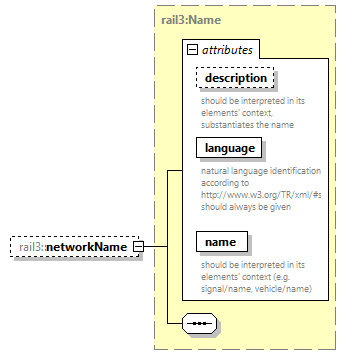 | ||||||||||||||||||||||||||||||
| namespace | https://www.railml.org/schemas/3.2 | ||||||||||||||||||||||||||||||
| type | rail3:Name | ||||||||||||||||||||||||||||||
| properties |
| ||||||||||||||||||||||||||||||
| attributes |
| ||||||||||||||||||||||||||||||
| source | <xs:element name="networkName" type="rail3:Name" minOccurs="0" maxOccurs="1"/> |
element CommunicationSettings/dnsServer
| diagram | 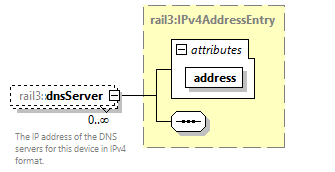 | ||||||||||||
| namespace | https://www.railml.org/schemas/3.2 | ||||||||||||
| type | rail3:IPv4AddressEntry | ||||||||||||
| properties |
| ||||||||||||
| attributes |
| ||||||||||||
| annotation |
| ||||||||||||
| source | <xs:element name="dnsServer" type="rail3:IPv4AddressEntry" minOccurs="0" maxOccurs="unbounded"> <xs:annotation> <xs:documentation>The IP address of the DNS servers for this device in IPv4 format.</xs:documentation> </xs:annotation> </xs:element> |
complexType ComputerNode
| diagram | 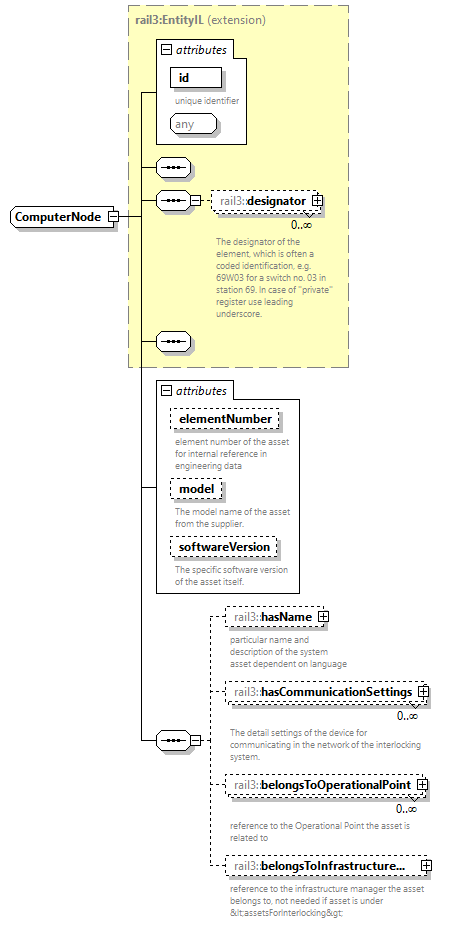 | ||||||||||||||||||||||||||||||||||||||
| namespace | https://www.railml.org/schemas/3.2 | ||||||||||||||||||||||||||||||||||||||
| type | extension of rail3:EntityIL | ||||||||||||||||||||||||||||||||||||||
| properties |
| ||||||||||||||||||||||||||||||||||||||
| children | rail3:designator rail3:hasName rail3:hasCommunicationSettings rail3:belongsToOperationalPoint rail3:belongsToInfrastructureManager | ||||||||||||||||||||||||||||||||||||||
| used by |
| ||||||||||||||||||||||||||||||||||||||
| attributes |
| ||||||||||||||||||||||||||||||||||||||
| source | <xs:complexType name="ComputerNode" abstract="true"> <xs:complexContent> <xs:extension base="rail3:EntityIL"> <xs:sequence> <xs:element name="hasName" type="rail3:Name" minOccurs="0" maxOccurs="1"> <xs:annotation> <xs:documentation>particular name and description of the system asset dependent on language</xs:documentation> </xs:annotation> </xs:element> <xs:element name="hasCommunicationSettings" type="rail3:CommunicationSettings" minOccurs="0" maxOccurs="unbounded"> <xs:annotation> <xs:documentation>The detail settings of the device for communicating in the network of the interlocking system.</xs:documentation> </xs:annotation> </xs:element> <xs:element name="belongsToOperationalPoint" type="rail3:EntityILref" minOccurs="0" maxOccurs="unbounded"> <xs:annotation> <xs:documentation>reference to the Operational Point the asset is related to</xs:documentation> </xs:annotation> </xs:element> <xs:element name="belongsToInfrastructureManager" type="rail3:EntityILref" minOccurs="0" maxOccurs="1"> <xs:annotation> <xs:documentation>reference to the infrastructure manager the asset belongs to, not needed if asset is under <assetsForInterlocking></xs:documentation> </xs:annotation> </xs:element> </xs:sequence> <xs:attribute name="elementNumber" type="xs:nonNegativeInteger" use="optional"> <xs:annotation> <xs:documentation>element number of the asset for internal reference in engineering data</xs:documentation> </xs:annotation> </xs:attribute> <xs:attribute name="model" type="xs:string" use="optional"> <xs:annotation> <xs:documentation>The model name of the asset from the supplier.</xs:documentation> </xs:annotation> </xs:attribute> <xs:attribute name="softwareVersion" type="xs:string" use="optional"> <xs:annotation> <xs:documentation>The specific software version of the asset itself.</xs:documentation> </xs:annotation> </xs:attribute> </xs:extension> </xs:complexContent> </xs:complexType> |
attribute ComputerNode/@elementNumber
| type | xs:nonNegativeInteger | ||
| properties |
| ||
| annotation |
| ||
| source | <xs:attribute name="elementNumber" type="xs:nonNegativeInteger" use="optional"> <xs:annotation> <xs:documentation>element number of the asset for internal reference in engineering data</xs:documentation> </xs:annotation> </xs:attribute> |
attribute ComputerNode/@model
| type | xs:string | ||
| properties |
| ||
| annotation |
| ||
| source | <xs:attribute name="model" type="xs:string" use="optional"> <xs:annotation> <xs:documentation>The model name of the asset from the supplier.</xs:documentation> </xs:annotation> </xs:attribute> |
attribute ComputerNode/@softwareVersion
| type | xs:string | ||
| properties |
| ||
| annotation |
| ||
| source | <xs:attribute name="softwareVersion" type="xs:string" use="optional"> <xs:annotation> <xs:documentation>The specific software version of the asset itself.</xs:documentation> </xs:annotation> </xs:attribute> |
element ComputerNode/hasName
| diagram | 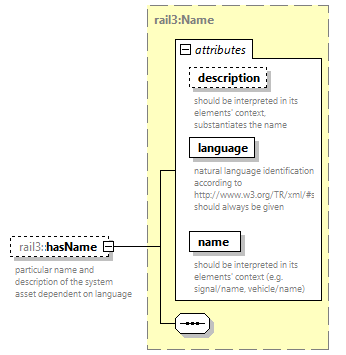 | ||||||||||||||||||||||||||||||
| namespace | https://www.railml.org/schemas/3.2 | ||||||||||||||||||||||||||||||
| type | rail3:Name | ||||||||||||||||||||||||||||||
| properties |
| ||||||||||||||||||||||||||||||
| attributes |
| ||||||||||||||||||||||||||||||
| annotation |
| ||||||||||||||||||||||||||||||
| source | <xs:element name="hasName" type="rail3:Name" minOccurs="0" maxOccurs="1"> <xs:annotation> <xs:documentation>particular name and description of the system asset dependent on language</xs:documentation> </xs:annotation> </xs:element> |
element ComputerNode/hasCommunicationSettings
| diagram | 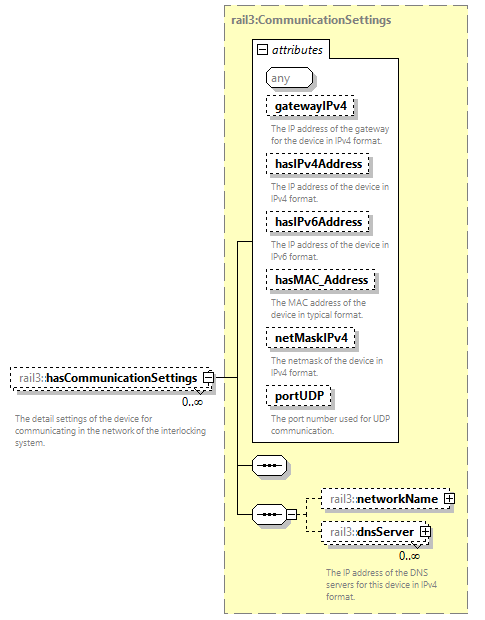 | ||||||||||||||||||||||||||||||||||||||||||||||||||||||
| namespace | https://www.railml.org/schemas/3.2 | ||||||||||||||||||||||||||||||||||||||||||||||||||||||
| type | rail3:CommunicationSettings | ||||||||||||||||||||||||||||||||||||||||||||||||||||||
| properties |
| ||||||||||||||||||||||||||||||||||||||||||||||||||||||
| children | rail3:networkName rail3:dnsServer | ||||||||||||||||||||||||||||||||||||||||||||||||||||||
| attributes |
| ||||||||||||||||||||||||||||||||||||||||||||||||||||||
| annotation |
| ||||||||||||||||||||||||||||||||||||||||||||||||||||||
| source | <xs:element name="hasCommunicationSettings" type="rail3:CommunicationSettings" minOccurs="0" maxOccurs="unbounded"> <xs:annotation> <xs:documentation>The detail settings of the device for communicating in the network of the interlocking system.</xs:documentation> </xs:annotation> </xs:element> |
element ComputerNode/belongsToOperationalPoint
| diagram | 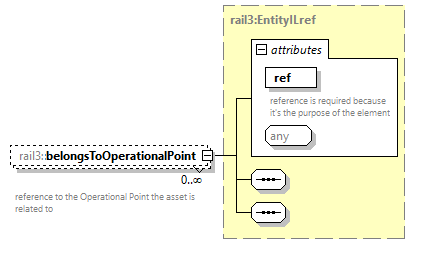 | ||||||||||||||
| namespace | https://www.railml.org/schemas/3.2 | ||||||||||||||
| type | rail3:EntityILref | ||||||||||||||
| properties |
| ||||||||||||||
| attributes |
| ||||||||||||||
| annotation |
| ||||||||||||||
| source | <xs:element name="belongsToOperationalPoint" type="rail3:EntityILref" minOccurs="0" maxOccurs="unbounded"> <xs:annotation> <xs:documentation>reference to the Operational Point the asset is related to</xs:documentation> </xs:annotation> </xs:element> |
element ComputerNode/belongsToInfrastructureManager
| diagram | 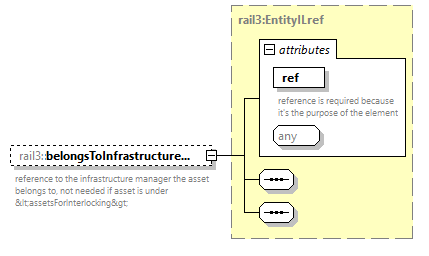 | ||||||||||||||
| namespace | https://www.railml.org/schemas/3.2 | ||||||||||||||
| type | rail3:EntityILref | ||||||||||||||
| properties |
| ||||||||||||||
| attributes |
| ||||||||||||||
| annotation |
| ||||||||||||||
| source | <xs:element name="belongsToInfrastructureManager" type="rail3:EntityILref" minOccurs="0" maxOccurs="1"> <xs:annotation> <xs:documentation>reference to the infrastructure manager the asset belongs to, not needed if asset is under <assetsForInterlocking></xs:documentation> </xs:annotation> </xs:element> |
complexType Configuration
| diagram | 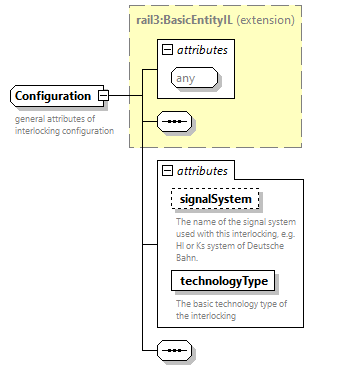 | ||||||||||||||||||||||
| namespace | https://www.railml.org/schemas/3.2 | ||||||||||||||||||||||
| type | extension of rail3:BasicEntityIL | ||||||||||||||||||||||
| properties |
| ||||||||||||||||||||||
| used by |
| ||||||||||||||||||||||
| attributes |
| ||||||||||||||||||||||
| annotation |
| ||||||||||||||||||||||
| source | <xs:complexType name="Configuration"> <xs:annotation> <xs:documentation>general attributes of interlocking configuration</xs:documentation> </xs:annotation> <xs:complexContent> <xs:extension base="rail3:BasicEntityIL"> <xs:sequence/> <xs:attribute name="signalSystem" type="xs:string" use="optional"> <xs:annotation> <xs:documentation>The name of the signal system used with this interlocking, e.g. Hl or Ks system of Deutsche Bahn.</xs:documentation> </xs:annotation> </xs:attribute> <xs:attribute name="technologyType" type="rail3:tIxlTechnologyTypeListExt" use="required"> <xs:annotation> <xs:documentation>The basic technology type of the interlocking</xs:documentation> </xs:annotation> </xs:attribute> </xs:extension> </xs:complexContent> </xs:complexType> |
attribute Configuration/@signalSystem
| type | xs:string | ||
| properties |
| ||
| annotation |
| ||
| source | <xs:attribute name="signalSystem" type="xs:string" use="optional"> <xs:annotation> <xs:documentation>The name of the signal system used with this interlocking, e.g. Hl or Ks system of Deutsche Bahn.</xs:documentation> </xs:annotation> </xs:attribute> |
attribute Configuration/@technologyType
| type | rail3:tIxlTechnologyTypeListExt | ||
| properties |
| ||
| annotation |
| ||
| source | <xs:attribute name="technologyType" type="rail3:tIxlTechnologyTypeListExt" use="required"> <xs:annotation> <xs:documentation>The basic technology type of the interlocking</xs:documentation> </xs:annotation> </xs:attribute> |
complexType ConflictingRoute
| diagram | 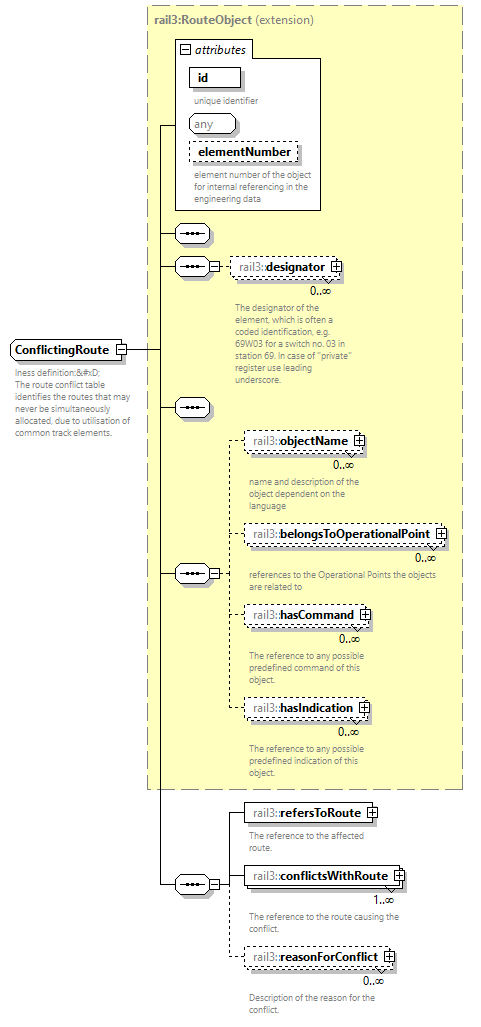 | ||||||||||||||||||||||
| namespace | https://www.railml.org/schemas/3.2 | ||||||||||||||||||||||
| type | extension of rail3:RouteObject | ||||||||||||||||||||||
| properties |
| ||||||||||||||||||||||
| children | rail3:designator rail3:objectName rail3:belongsToOperationalPoint rail3:hasCommand rail3:hasIndication rail3:refersToRoute rail3:conflictsWithRoute rail3:reasonForConflict | ||||||||||||||||||||||
| used by |
| ||||||||||||||||||||||
| attributes |
| ||||||||||||||||||||||
| annotation |
| ||||||||||||||||||||||
| source | <xs:complexType name="ConflictingRoute"> <xs:annotation> <xs:documentation>Iness definition:
 The route conflict table identifies the routes that may never be simultaneously allocated, due to utilisation of common track elements.</xs:documentation> </xs:annotation> <xs:complexContent> <xs:extension base="rail3:RouteObject"> <xs:sequence> <xs:element name="refersToRoute" type="rail3:EntityILref" minOccurs="1" maxOccurs="1"> <xs:annotation> <xs:documentation>The reference to the affected route.</xs:documentation> </xs:annotation> </xs:element> <xs:element name="conflictsWithRoute" type="rail3:EntityILref" minOccurs="1" maxOccurs="unbounded"> <xs:annotation> <xs:documentation>The reference to the route causing the conflict.</xs:documentation> </xs:annotation> </xs:element> <xs:element name="reasonForConflict" type="rail3:ConflictReason" minOccurs="0" maxOccurs="unbounded"> <xs:annotation> <xs:documentation>Description of the reason for the conflict.</xs:documentation> </xs:annotation> </xs:element> </xs:sequence> </xs:extension> </xs:complexContent> </xs:complexType> |
element ConflictingRoute/refersToRoute
| diagram | 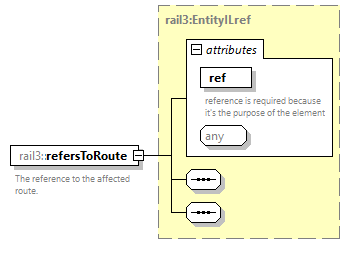 | ||||||||||||||
| namespace | https://www.railml.org/schemas/3.2 | ||||||||||||||
| type | rail3:EntityILref | ||||||||||||||
| properties |
| ||||||||||||||
| attributes |
| ||||||||||||||
| annotation |
| ||||||||||||||
| source | <xs:element name="refersToRoute" type="rail3:EntityILref" minOccurs="1" maxOccurs="1"> <xs:annotation> <xs:documentation>The reference to the affected route.</xs:documentation> </xs:annotation> </xs:element> |
element ConflictingRoute/conflictsWithRoute
| diagram | 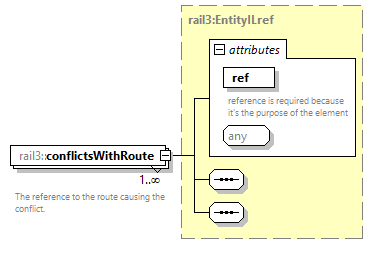 | ||||||||||||||
| namespace | https://www.railml.org/schemas/3.2 | ||||||||||||||
| type | rail3:EntityILref | ||||||||||||||
| properties |
| ||||||||||||||
| attributes |
| ||||||||||||||
| annotation |
| ||||||||||||||
| source | <xs:element name="conflictsWithRoute" type="rail3:EntityILref" minOccurs="1" maxOccurs="unbounded"> <xs:annotation> <xs:documentation>The reference to the route causing the conflict.</xs:documentation> </xs:annotation> </xs:element> |
element ConflictingRoute/reasonForConflict
| diagram | 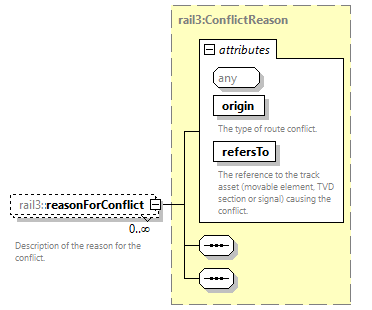 | ||||||||||||||||||||||
| namespace | https://www.railml.org/schemas/3.2 | ||||||||||||||||||||||
| type | rail3:ConflictReason | ||||||||||||||||||||||
| properties |
| ||||||||||||||||||||||
| attributes |
| ||||||||||||||||||||||
| annotation |
| ||||||||||||||||||||||
| source | <xs:element name="reasonForConflict" type="rail3:ConflictReason" minOccurs="0" maxOccurs="unbounded"> <xs:annotation> <xs:documentation>Description of the reason for the conflict.</xs:documentation> </xs:annotation> </xs:element> |
complexType ConflictingRoutes
| diagram |  | ||
| namespace | https://www.railml.org/schemas/3.2 | ||
| children | rail3:conflictingRoute | ||
| used by |
| ||
| annotation |
| ||
| source | <xs:complexType name="ConflictingRoutes"> <xs:annotation> <xs:documentation>container element for all ConflictingRoute elements</xs:documentation> </xs:annotation> <xs:sequence minOccurs="0" maxOccurs="1"> <xs:element name="conflictingRoute" type="rail3:ConflictingRoute" minOccurs="1" maxOccurs="unbounded"> <xs:annotation> <xs:documentation>identifies the routes that may never be simultaneously allocated</xs:documentation> </xs:annotation> </xs:element> </xs:sequence> </xs:complexType> |
element ConflictingRoutes/conflictingRoute
| diagram | 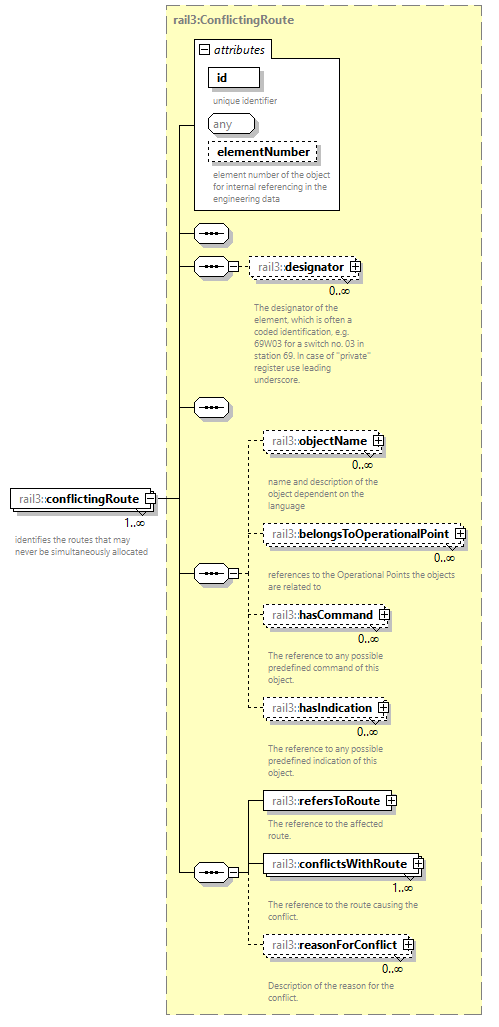 | ||||||||||||||||||||||
| namespace | https://www.railml.org/schemas/3.2 | ||||||||||||||||||||||
| type | rail3:ConflictingRoute | ||||||||||||||||||||||
| properties |
| ||||||||||||||||||||||
| children | rail3:designator rail3:objectName rail3:belongsToOperationalPoint rail3:hasCommand rail3:hasIndication rail3:refersToRoute rail3:conflictsWithRoute rail3:reasonForConflict | ||||||||||||||||||||||
| attributes |
| ||||||||||||||||||||||
| annotation |
| ||||||||||||||||||||||
| source | <xs:element name="conflictingRoute" type="rail3:ConflictingRoute" minOccurs="1" maxOccurs="unbounded"> <xs:annotation> <xs:documentation>identifies the routes that may never be simultaneously allocated</xs:documentation> </xs:annotation> </xs:element> |
complexType ConflictReason
| diagram | 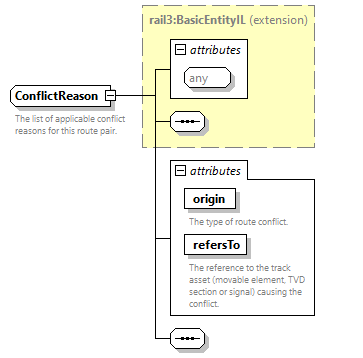 | ||||||||||||||||||||||
| namespace | https://www.railml.org/schemas/3.2 | ||||||||||||||||||||||
| type | extension of rail3:BasicEntityIL | ||||||||||||||||||||||
| properties |
| ||||||||||||||||||||||
| used by |
| ||||||||||||||||||||||
| attributes |
| ||||||||||||||||||||||
| annotation |
| ||||||||||||||||||||||
| source | <xs:complexType name="ConflictReason"> <xs:annotation> <xs:documentation>The list of applicable conflict reasons for this route pair.</xs:documentation> </xs:annotation> <xs:complexContent> <xs:extension base="rail3:BasicEntityIL"> <xs:sequence/> <xs:attribute name="origin" type="rail3:tRouteConflictTypesExt" use="required"> <xs:annotation> <xs:documentation>The type of route conflict.</xs:documentation> </xs:annotation> </xs:attribute> <xs:attribute name="refersTo" type="rail3:tRef" use="required"> <xs:annotation> <xs:documentation>The reference to the track asset (movable element, TVD section or signal) causing the conflict.</xs:documentation> </xs:annotation> </xs:attribute> </xs:extension> </xs:complexContent> </xs:complexType> |
attribute ConflictReason/@origin
| type | rail3:tRouteConflictTypesExt | ||
| properties |
| ||
| annotation |
| ||
| source | <xs:attribute name="origin" type="rail3:tRouteConflictTypesExt" use="required"> <xs:annotation> <xs:documentation>The type of route conflict.</xs:documentation> </xs:annotation> </xs:attribute> |
attribute ConflictReason/@refersTo
| type | rail3:tRef | ||
| properties |
| ||
| annotation |
| ||
| source | <xs:attribute name="refersTo" type="rail3:tRef" use="required"> <xs:annotation> <xs:documentation>The reference to the track asset (movable element, TVD section or signal) causing the conflict.</xs:documentation> </xs:annotation> </xs:attribute> |
complexType ControlledAssets
| diagram | 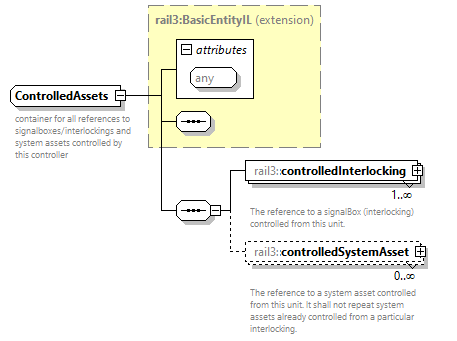 | ||||||
| namespace | https://www.railml.org/schemas/3.2 | ||||||
| type | extension of rail3:BasicEntityIL | ||||||
| properties |
| ||||||
| children | rail3:controlledInterlocking rail3:controlledSystemAsset | ||||||
| used by |
| ||||||
| attributes |
| ||||||
| annotation |
| ||||||
| source | <xs:complexType name="ControlledAssets"> <xs:annotation> <xs:documentation>container for all references to signalboxes/interlockings and system assets controlled by this controller</xs:documentation> </xs:annotation> <xs:complexContent> <xs:extension base="rail3:BasicEntityIL"> <xs:sequence> <xs:element name="controlledInterlocking" type="rail3:ControlledSignalBox" minOccurs="1" maxOccurs="unbounded"> <xs:annotation> <xs:documentation>The reference to a signalBox (interlocking) controlled from this unit.</xs:documentation> </xs:annotation> </xs:element> <xs:element name="controlledSystemAsset" type="rail3:SystemAssetConnectedToIL" minOccurs="0" maxOccurs="unbounded"> <xs:annotation> <xs:documentation>The reference to a system asset controlled from this unit. It shall not repeat system assets already controlled from a particular interlocking.</xs:documentation> </xs:annotation> </xs:element> </xs:sequence> </xs:extension> </xs:complexContent> </xs:complexType> |
element ControlledAssets/controlledInterlocking
| diagram | 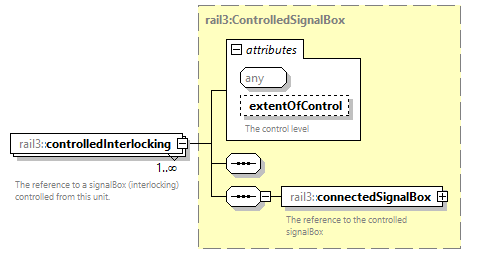 | ||||||||||||||
| namespace | https://www.railml.org/schemas/3.2 | ||||||||||||||
| type | rail3:ControlledSignalBox | ||||||||||||||
| properties |
| ||||||||||||||
| children | rail3:connectedSignalBox | ||||||||||||||
| attributes |
| ||||||||||||||
| annotation |
| ||||||||||||||
| source | <xs:element name="controlledInterlocking" type="rail3:ControlledSignalBox" minOccurs="1" maxOccurs="unbounded"> <xs:annotation> <xs:documentation>The reference to a signalBox (interlocking) controlled from this unit.</xs:documentation> </xs:annotation> </xs:element> |
element ControlledAssets/controlledSystemAsset
| diagram | 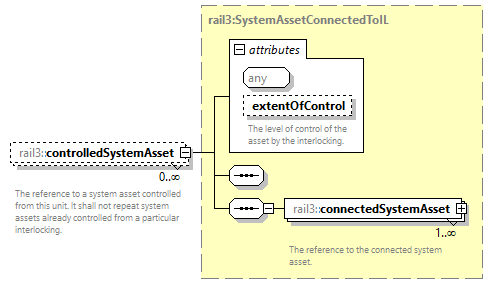 | ||||||||||||||
| namespace | https://www.railml.org/schemas/3.2 | ||||||||||||||
| type | rail3:SystemAssetConnectedToIL | ||||||||||||||
| properties |
| ||||||||||||||
| children | rail3:connectedSystemAsset | ||||||||||||||
| attributes |
| ||||||||||||||
| annotation |
| ||||||||||||||
| source | <xs:element name="controlledSystemAsset" type="rail3:SystemAssetConnectedToIL" minOccurs="0" maxOccurs="unbounded"> <xs:annotation> <xs:documentation>The reference to a system asset controlled from this unit. It shall not repeat system assets already controlled from a particular interlocking.</xs:documentation> </xs:annotation> </xs:element> |
complexType ControlledSignalBox
| diagram | 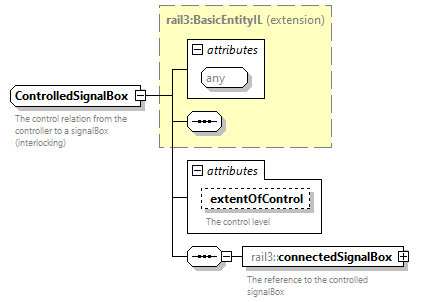 | ||||||||||||||
| namespace | https://www.railml.org/schemas/3.2 | ||||||||||||||
| type | extension of rail3:BasicEntityIL | ||||||||||||||
| properties |
| ||||||||||||||
| children | rail3:connectedSignalBox | ||||||||||||||
| used by |
| ||||||||||||||
| attributes |
| ||||||||||||||
| annotation |
| ||||||||||||||
| source | <xs:complexType name="ControlledSignalBox"> <xs:annotation> <xs:documentation>The control relation from the controller to a signalBox (interlocking)</xs:documentation> </xs:annotation> <xs:complexContent> <xs:extension base="rail3:BasicEntityIL"> <xs:sequence> <xs:element name="connectedSignalBox" type="rail3:EntityILref" minOccurs="1" maxOccurs="1"> <xs:annotation> <xs:documentation>The reference to the controlled signalBox</xs:documentation> </xs:annotation> </xs:element> </xs:sequence> <xs:attribute name="extentOfControl" type="rail3:tExtentOfControl" use="optional"> <xs:annotation> <xs:documentation>The control level</xs:documentation> </xs:annotation> </xs:attribute> </xs:extension> </xs:complexContent> </xs:complexType> |
attribute ControlledSignalBox/@extentOfControl
| type | rail3:tExtentOfControl | |||||||||||||||||||||||
| properties |
| |||||||||||||||||||||||
| facets |
| |||||||||||||||||||||||
| annotation |
| |||||||||||||||||||||||
| source | <xs:attribute name="extentOfControl" type="rail3:tExtentOfControl" use="optional"> <xs:annotation> <xs:documentation>The control level</xs:documentation> </xs:annotation> </xs:attribute> |
element ControlledSignalBox/connectedSignalBox
| diagram | 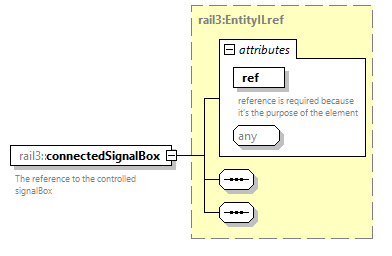 | ||||||||||||||
| namespace | https://www.railml.org/schemas/3.2 | ||||||||||||||
| type | rail3:EntityILref | ||||||||||||||
| properties |
| ||||||||||||||
| attributes |
| ||||||||||||||
| annotation |
| ||||||||||||||
| source | <xs:element name="connectedSignalBox" type="rail3:EntityILref" minOccurs="1" maxOccurs="1"> <xs:annotation> <xs:documentation>The reference to the controlled signalBox</xs:documentation> </xs:annotation> </xs:element> |
complexType Controller
| diagram | 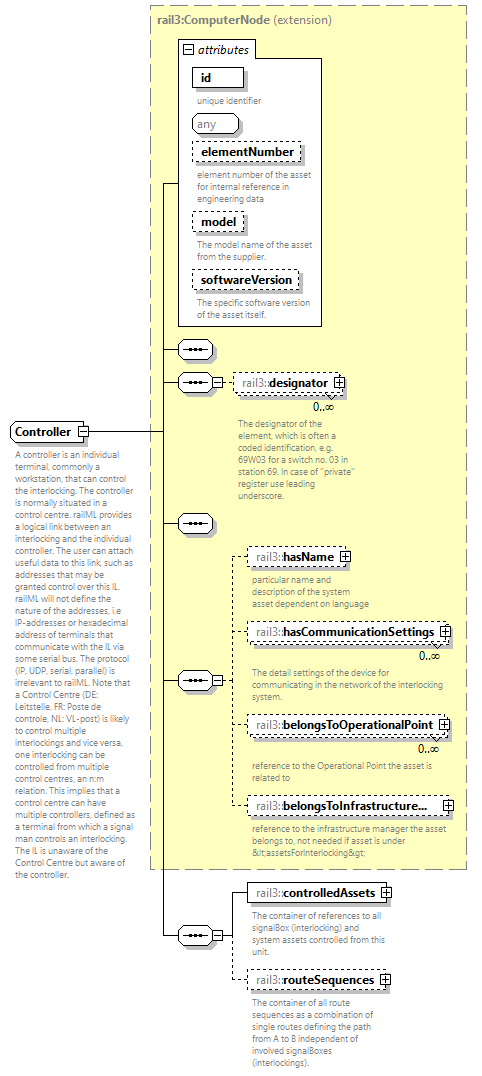 | ||||||||||||||||||||||||||||||||||||||
| namespace | https://www.railml.org/schemas/3.2 | ||||||||||||||||||||||||||||||||||||||
| type | extension of rail3:ComputerNode | ||||||||||||||||||||||||||||||||||||||
| properties |
| ||||||||||||||||||||||||||||||||||||||
| children | rail3:designator rail3:hasName rail3:hasCommunicationSettings rail3:belongsToOperationalPoint rail3:belongsToInfrastructureManager rail3:controlledAssets rail3:routeSequences | ||||||||||||||||||||||||||||||||||||||
| used by |
| ||||||||||||||||||||||||||||||||||||||
| attributes |
| ||||||||||||||||||||||||||||||||||||||
| annotation |
| ||||||||||||||||||||||||||||||||||||||
| source | <xs:complexType name="Controller"> <xs:annotation> <xs:documentation>A controller is an individual terminal, commonly a workstation, that can control the interlocking. The controller is normally situated in a control centre. railML provides a logical link between an interlocking and the individual controller. The user can attach useful data to this link, such as addresses that may be granted control over this IL. railML will not define the nature of the addresses, i.e IP-addresses or hexadecimal address of terminals that communicate with the IL via some serial bus. The protocol (IP, UDP, serial, parallel) is irrelevant to railML. Note that a Control Centre (DE: Leitstelle, FR: Poste de controle, NL: VL-post) is likely to control multiple interlockings and vice versa, one interlocking can be controlled from multiple control centres, an n:m relation. This implies that a control centre can have multiple controllers, defined as a terminal from which a signal man controls an interlocking. The IL is unaware of the Control Centre but aware of the controller.</xs:documentation> </xs:annotation> <xs:complexContent> <xs:extension base="rail3:ComputerNode"> <xs:sequence> <xs:element name="controlledAssets" type="rail3:ControlledAssets" minOccurs="1" maxOccurs="1"> <xs:annotation> <xs:documentation>The container of references to all signalBox (interlocking) and system assets controlled from this unit.</xs:documentation> </xs:annotation> </xs:element> <xs:element name="routeSequences" type="rail3:RouteSequences" minOccurs="0" maxOccurs="1"> <xs:annotation> <xs:documentation>The container of all route sequences as a combination of single routes defining the path from A to B independent of involved signalBoxes (interlockings).</xs:documentation> </xs:annotation> </xs:element> </xs:sequence> </xs:extension> </xs:complexContent> </xs:complexType> |
element Controller/controlledAssets
| diagram | 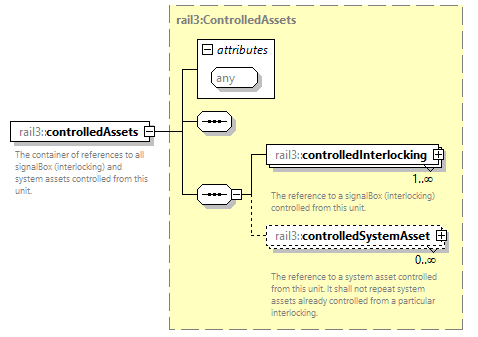 | ||||||
| namespace | https://www.railml.org/schemas/3.2 | ||||||
| type | rail3:ControlledAssets | ||||||
| properties |
| ||||||
| children | rail3:controlledInterlocking rail3:controlledSystemAsset | ||||||
| attributes |
| ||||||
| annotation |
| ||||||
| source | <xs:element name="controlledAssets" type="rail3:ControlledAssets" minOccurs="1" maxOccurs="1"> <xs:annotation> <xs:documentation>The container of references to all signalBox (interlocking) and system assets controlled from this unit.</xs:documentation> </xs:annotation> </xs:element> |
element Controller/routeSequences
| diagram | 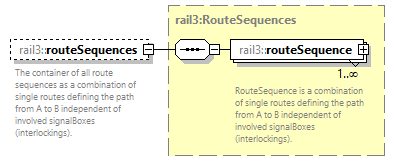 | ||||||
| namespace | https://www.railml.org/schemas/3.2 | ||||||
| type | rail3:RouteSequences | ||||||
| properties |
| ||||||
| children | rail3:routeSequence | ||||||
| annotation |
| ||||||
| source | <xs:element name="routeSequences" type="rail3:RouteSequences" minOccurs="0" maxOccurs="1"> <xs:annotation> <xs:documentation>The container of all route sequences as a combination of single routes defining the path from A to B independent of involved signalBoxes (interlockings).</xs:documentation> </xs:annotation> </xs:element> |
complexType Controllers
| diagram |  | ||
| namespace | https://www.railml.org/schemas/3.2 | ||
| children | rail3:controller | ||
| used by |
| ||
| annotation |
| ||
| source | <xs:complexType name="Controllers"> <xs:annotation> <xs:documentation>container element for all controller elements</xs:documentation> </xs:annotation> <xs:sequence minOccurs="0" maxOccurs="1"> <xs:element name="controller" type="rail3:Controller" minOccurs="1" maxOccurs="unbounded"> <xs:annotation> <xs:documentation>Container with reference to connected interlockings and system assets controlled by this operational terminal.</xs:documentation> </xs:annotation> </xs:element> </xs:sequence> </xs:complexType> |
element Controllers/controller
| diagram | 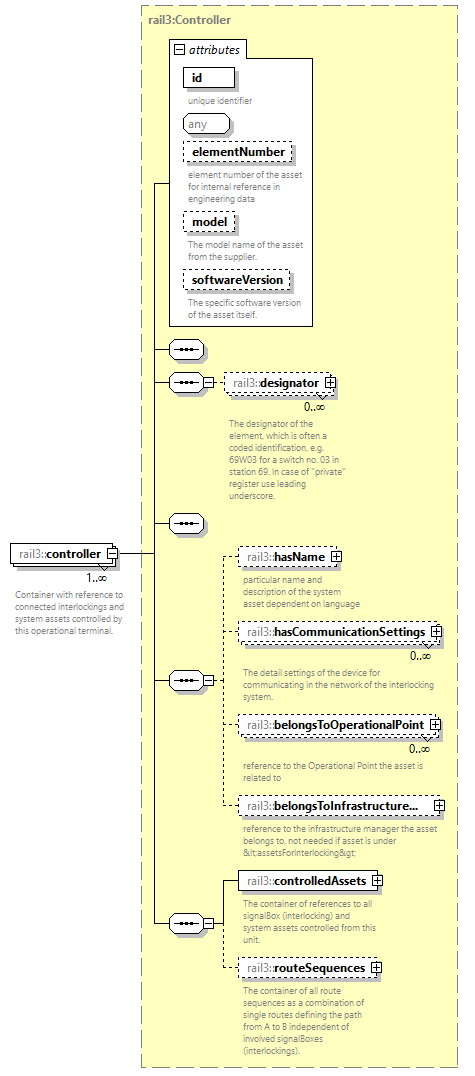 | ||||||||||||||||||||||||||||||||||||||
| namespace | https://www.railml.org/schemas/3.2 | ||||||||||||||||||||||||||||||||||||||
| type | rail3:Controller | ||||||||||||||||||||||||||||||||||||||
| properties |
| ||||||||||||||||||||||||||||||||||||||
| children | rail3:designator rail3:hasName rail3:hasCommunicationSettings rail3:belongsToOperationalPoint rail3:belongsToInfrastructureManager rail3:controlledAssets rail3:routeSequences | ||||||||||||||||||||||||||||||||||||||
| attributes |
| ||||||||||||||||||||||||||||||||||||||
| annotation |
| ||||||||||||||||||||||||||||||||||||||
| source | <xs:element name="controller" type="rail3:Controller" minOccurs="1" maxOccurs="unbounded"> <xs:annotation> <xs:documentation>Container with reference to connected interlockings and system assets controlled by this operational terminal.</xs:documentation> </xs:annotation> </xs:element> |
complexType CrossingAndGivenPosition
| diagram | 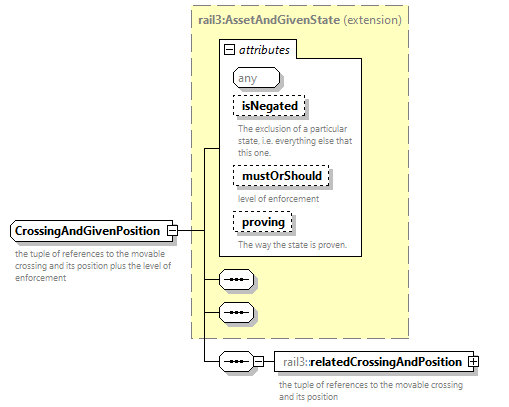 | ||||||||||||||||||||||||||||||
| namespace | https://www.railml.org/schemas/3.2 | ||||||||||||||||||||||||||||||
| type | extension of rail3:AssetAndGivenState | ||||||||||||||||||||||||||||||
| properties |
| ||||||||||||||||||||||||||||||
| children | rail3:relatedCrossingAndPosition | ||||||||||||||||||||||||||||||
| used by |
| ||||||||||||||||||||||||||||||
| attributes |
| ||||||||||||||||||||||||||||||
| annotation |
| ||||||||||||||||||||||||||||||
| source | <xs:complexType name="CrossingAndGivenPosition"> <xs:annotation> <xs:documentation>the tuple of references to the movable crossing and its position plus the level of enforcement</xs:documentation> </xs:annotation> <xs:complexContent> <xs:extension base="rail3:AssetAndGivenState"> <xs:sequence> <xs:element name="relatedCrossingAndPosition" type="rail3:CrossingAndPosition" minOccurs="1" maxOccurs="1"> <xs:annotation> <xs:documentation>the tuple of references to the movable crossing and its position</xs:documentation> </xs:annotation> </xs:element> </xs:sequence> </xs:extension> </xs:complexContent> </xs:complexType> |
element CrossingAndGivenPosition/relatedCrossingAndPosition
| diagram | 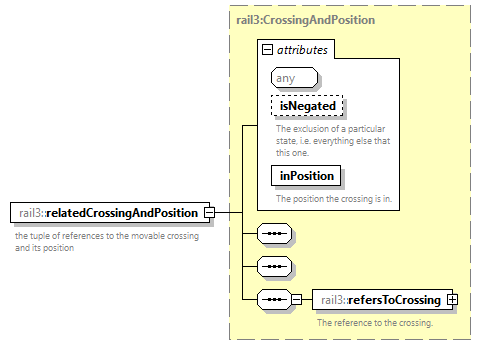 | ||||||||||||||||||||||
| namespace | https://www.railml.org/schemas/3.2 | ||||||||||||||||||||||
| type | rail3:CrossingAndPosition | ||||||||||||||||||||||
| properties |
| ||||||||||||||||||||||
| children | rail3:refersToCrossing | ||||||||||||||||||||||
| attributes |
| ||||||||||||||||||||||
| annotation |
| ||||||||||||||||||||||
| source | <xs:element name="relatedCrossingAndPosition" type="rail3:CrossingAndPosition" minOccurs="1" maxOccurs="1"> <xs:annotation> <xs:documentation>the tuple of references to the movable crossing and its position</xs:documentation> </xs:annotation> </xs:element> |
complexType CrossingAndPosition
| diagram | 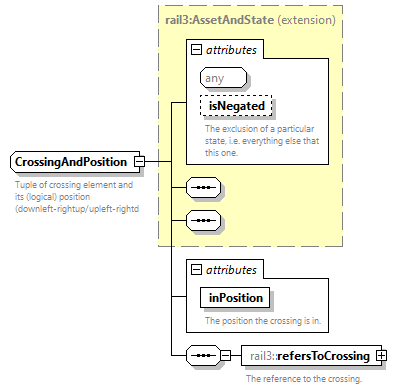 | ||||||||||||||||||||||
| namespace | https://www.railml.org/schemas/3.2 | ||||||||||||||||||||||
| type | extension of rail3:AssetAndState | ||||||||||||||||||||||
| properties |
| ||||||||||||||||||||||
| children | rail3:refersToCrossing | ||||||||||||||||||||||
| used by |
| ||||||||||||||||||||||
| attributes |
| ||||||||||||||||||||||
| annotation |
| ||||||||||||||||||||||
| source | <xs:complexType name="CrossingAndPosition"> <xs:annotation> <xs:documentation>Tuple of crossing element and its (logical) position (downleft-rightup/upleft-rightdown).</xs:documentation> </xs:annotation> <xs:complexContent> <xs:extension base="rail3:AssetAndState"> <xs:sequence> <xs:element name="refersToCrossing" type="rail3:EntityILref" minOccurs="1" maxOccurs="1"> <xs:annotation> <xs:documentation>The reference to the crossing.</xs:documentation> </xs:annotation> </xs:element> </xs:sequence> <xs:attribute name="inPosition" type="rail3:tCrossingPosition" use="required"> <xs:annotation> <xs:documentation>The position the crossing is in.</xs:documentation> </xs:annotation> </xs:attribute> </xs:extension> </xs:complexContent> </xs:complexType> |
attribute CrossingAndPosition/@inPosition
| type | rail3:tCrossingPosition | |||||||||||||
| properties |
| |||||||||||||
| facets |
| |||||||||||||
| annotation |
| |||||||||||||
| source | <xs:attribute name="inPosition" type="rail3:tCrossingPosition" use="required"> <xs:annotation> <xs:documentation>The position the crossing is in.</xs:documentation> </xs:annotation> </xs:attribute> |
element CrossingAndPosition/refersToCrossing
| diagram | 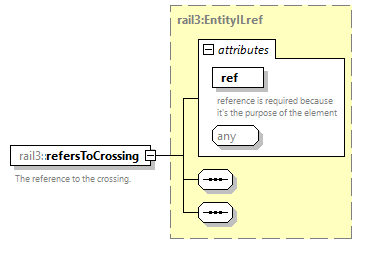 | ||||||||||||||
| namespace | https://www.railml.org/schemas/3.2 | ||||||||||||||
| type | rail3:EntityILref | ||||||||||||||
| properties |
| ||||||||||||||
| attributes |
| ||||||||||||||
| annotation |
| ||||||||||||||
| source | <xs:element name="refersToCrossing" type="rail3:EntityILref" minOccurs="1" maxOccurs="1"> <xs:annotation> <xs:documentation>The reference to the crossing.</xs:documentation> </xs:annotation> </xs:element> |
complexType CrossingInPosition
| diagram | 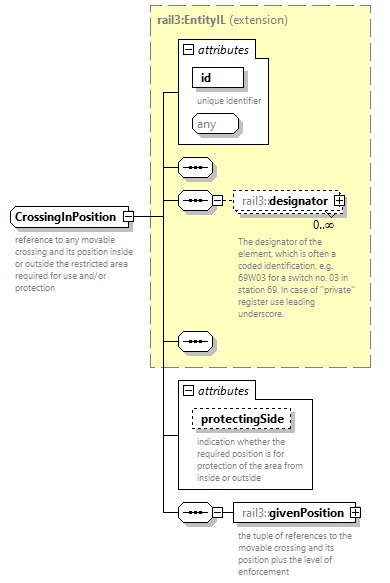 | ||||||||||||||||||||||
| namespace | https://www.railml.org/schemas/3.2 | ||||||||||||||||||||||
| type | extension of rail3:EntityIL | ||||||||||||||||||||||
| properties |
| ||||||||||||||||||||||
| children | rail3:designator rail3:givenPosition | ||||||||||||||||||||||
| used by |
| ||||||||||||||||||||||
| attributes |
| ||||||||||||||||||||||
| annotation |
| ||||||||||||||||||||||
| source | <xs:complexType name="CrossingInPosition"> <xs:annotation> <xs:documentation>reference to any movable crossing and its position inside or outside the restricted area required for use and/or protection</xs:documentation> </xs:annotation> <xs:complexContent> <xs:extension base="rail3:EntityIL"> <xs:sequence> <xs:element name="givenPosition" type="rail3:CrossingAndGivenPosition" minOccurs="1" maxOccurs="1"> <xs:annotation> <xs:documentation>the tuple of references to the movable crossing and its position plus the level of enforcement</xs:documentation> </xs:annotation> </xs:element> </xs:sequence> <xs:attribute name="protectingSide" type="rail3:tProtectingSideList" use="optional"> <xs:annotation> <xs:documentation>indication whether the required position is for protection of the area from inside or outside</xs:documentation> </xs:annotation> </xs:attribute> </xs:extension> </xs:complexContent> </xs:complexType> |
attribute CrossingInPosition/@protectingSide
| type | rail3:tProtectingSideList | ||||||||||||||||||
| properties |
| ||||||||||||||||||
| facets |
| ||||||||||||||||||
| annotation |
| ||||||||||||||||||
| source | <xs:attribute name="protectingSide" type="rail3:tProtectingSideList" use="optional"> <xs:annotation> <xs:documentation>indication whether the required position is for protection of the area from inside or outside</xs:documentation> </xs:annotation> </xs:attribute> |
element CrossingInPosition/givenPosition
| diagram | 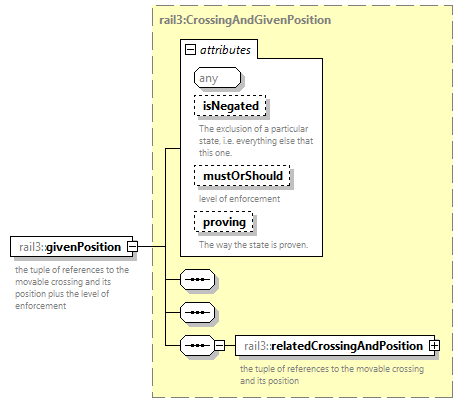 | ||||||||||||||||||||||||||||||
| namespace | https://www.railml.org/schemas/3.2 | ||||||||||||||||||||||||||||||
| type | rail3:CrossingAndGivenPosition | ||||||||||||||||||||||||||||||
| properties |
| ||||||||||||||||||||||||||||||
| children | rail3:relatedCrossingAndPosition | ||||||||||||||||||||||||||||||
| attributes |
| ||||||||||||||||||||||||||||||
| annotation |
| ||||||||||||||||||||||||||||||
| source | <xs:element name="givenPosition" type="rail3:CrossingAndGivenPosition" minOccurs="1" maxOccurs="1"> <xs:annotation> <xs:documentation>the tuple of references to the movable crossing and its position plus the level of enforcement</xs:documentation> </xs:annotation> </xs:element> |
complexType DangerPoint
| diagram | 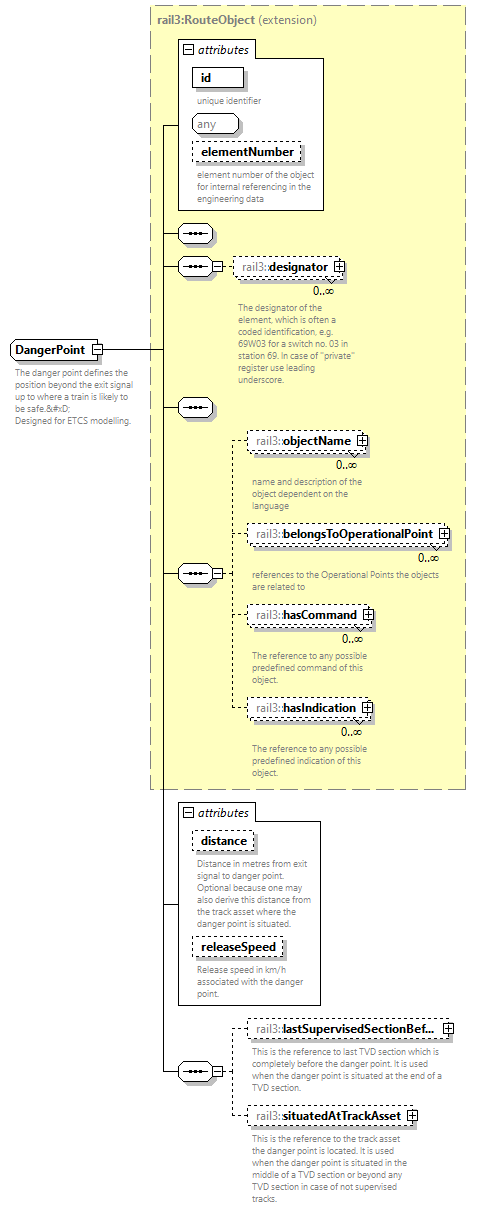 | ||||||||||||||||||||||||||||||||||||||
| namespace | https://www.railml.org/schemas/3.2 | ||||||||||||||||||||||||||||||||||||||
| type | extension of rail3:RouteObject | ||||||||||||||||||||||||||||||||||||||
| properties |
| ||||||||||||||||||||||||||||||||||||||
| children | rail3:designator rail3:objectName rail3:belongsToOperationalPoint rail3:hasCommand rail3:hasIndication rail3:lastSupervisedSectionBeforeDangerPoint rail3:situatedAtTrackAsset | ||||||||||||||||||||||||||||||||||||||
| used by |
| ||||||||||||||||||||||||||||||||||||||
| attributes |
| ||||||||||||||||||||||||||||||||||||||
| annotation |
| ||||||||||||||||||||||||||||||||||||||
| source | <xs:complexType name="DangerPoint"> <xs:annotation> <xs:documentation>The danger point defines the position beyond the exit signal up to where a train is likely to be safe.
 Designed for ETCS modelling.</xs:documentation> </xs:annotation> <xs:complexContent> <xs:extension base="rail3:RouteObject"> <xs:sequence> <xs:element name="lastSupervisedSectionBeforeDangerPoint" type="rail3:EntityILref" minOccurs="0" maxOccurs="1"> <xs:annotation> <xs:documentation>This is the reference to last TVD section which is completely before the danger point. It is used when the danger point is situated at the end of a TVD section.</xs:documentation> </xs:annotation> </xs:element> <xs:element name="situatedAtTrackAsset" type="rail3:EntityILref" minOccurs="0" maxOccurs="1"> <xs:annotation> <xs:documentation>This is the reference to the track asset the danger point is located. It is used when the danger point is situated in the middle of a TVD section or beyond any TVD section in case of not supervised tracks.</xs:documentation> </xs:annotation> </xs:element> </xs:sequence> <xs:attribute name="distance" type="rail3:tLengthM" use="optional"> <xs:annotation> <xs:documentation>Distance in metres from exit signal to danger point. Optional because one may also derive this distance from the track asset where the danger point is situated.</xs:documentation> </xs:annotation> </xs:attribute> <xs:attribute name="releaseSpeed" type="rail3:tSpeedKmPerHour" use="optional"> <xs:annotation> <xs:documentation>Release speed in km/h associated with the danger point.</xs:documentation> </xs:annotation> </xs:attribute> </xs:extension> </xs:complexContent> </xs:complexType> |
attribute DangerPoint/@distance
| type | rail3:tLengthM | ||
| properties |
| ||
| annotation |
| ||
| source | <xs:attribute name="distance" type="rail3:tLengthM" use="optional"> <xs:annotation> <xs:documentation>Distance in metres from exit signal to danger point. Optional because one may also derive this distance from the track asset where the danger point is situated.</xs:documentation> </xs:annotation> </xs:attribute> |
attribute DangerPoint/@releaseSpeed
| type | rail3:tSpeedKmPerHour | ||
| properties |
| ||
| annotation |
| ||
| source | <xs:attribute name="releaseSpeed" type="rail3:tSpeedKmPerHour" use="optional"> <xs:annotation> <xs:documentation>Release speed in km/h associated with the danger point.</xs:documentation> </xs:annotation> </xs:attribute> |
element DangerPoint/lastSupervisedSectionBeforeDangerPoint
| diagram | 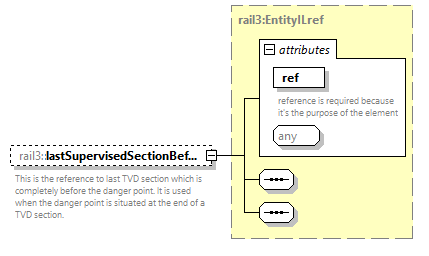 | ||||||||||||||
| namespace | https://www.railml.org/schemas/3.2 | ||||||||||||||
| type | rail3:EntityILref | ||||||||||||||
| properties |
| ||||||||||||||
| attributes |
| ||||||||||||||
| annotation |
| ||||||||||||||
| source | <xs:element name="lastSupervisedSectionBeforeDangerPoint" type="rail3:EntityILref" minOccurs="0" maxOccurs="1"> <xs:annotation> <xs:documentation>This is the reference to last TVD section which is completely before the danger point. It is used when the danger point is situated at the end of a TVD section.</xs:documentation> </xs:annotation> </xs:element> |
element DangerPoint/situatedAtTrackAsset
| diagram | 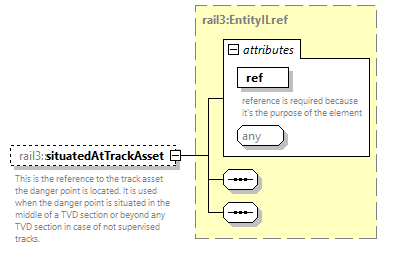 | ||||||||||||||
| namespace | https://www.railml.org/schemas/3.2 | ||||||||||||||
| type | rail3:EntityILref | ||||||||||||||
| properties |
| ||||||||||||||
| attributes |
| ||||||||||||||
| annotation |
| ||||||||||||||
| source | <xs:element name="situatedAtTrackAsset" type="rail3:EntityILref" minOccurs="0" maxOccurs="1"> <xs:annotation> <xs:documentation>This is the reference to the track asset the danger point is located. It is used when the danger point is situated in the middle of a TVD section or beyond any TVD section in case of not supervised tracks.</xs:documentation> </xs:annotation> </xs:element> |
complexType DangerPoints
| diagram |  | ||
| namespace | https://www.railml.org/schemas/3.2 | ||
| children | rail3:dangerPoint | ||
| used by |
| ||
| annotation |
| ||
| source | <xs:complexType name="DangerPoints"> <xs:annotation> <xs:documentation>container element for all DangerPoint elements</xs:documentation> </xs:annotation> <xs:sequence> <xs:element name="dangerPoint" type="rail3:DangerPoint" minOccurs="1" maxOccurs="unbounded"> <xs:annotation> <xs:documentation>position beyond the exit signal up to where a train is likely to be safe</xs:documentation> </xs:annotation> </xs:element> </xs:sequence> </xs:complexType> |
element DangerPoints/dangerPoint
| diagram | 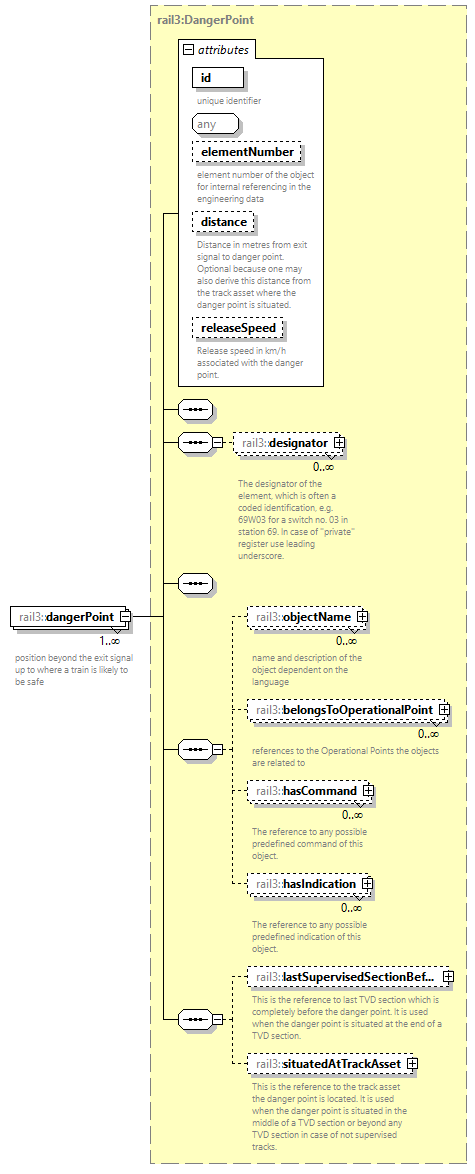 | ||||||||||||||||||||||||||||||||||||||
| namespace | https://www.railml.org/schemas/3.2 | ||||||||||||||||||||||||||||||||||||||
| type | rail3:DangerPoint | ||||||||||||||||||||||||||||||||||||||
| properties |
| ||||||||||||||||||||||||||||||||||||||
| children | rail3:designator rail3:objectName rail3:belongsToOperationalPoint rail3:hasCommand rail3:hasIndication rail3:lastSupervisedSectionBeforeDangerPoint rail3:situatedAtTrackAsset | ||||||||||||||||||||||||||||||||||||||
| attributes |
| ||||||||||||||||||||||||||||||||||||||
| annotation |
| ||||||||||||||||||||||||||||||||||||||
| source | <xs:element name="dangerPoint" type="rail3:DangerPoint" minOccurs="1" maxOccurs="unbounded"> <xs:annotation> <xs:documentation>position beyond the exit signal up to where a train is likely to be safe</xs:documentation> </xs:annotation> </xs:element> |
complexType DerailerAndGivenPosition
| diagram | 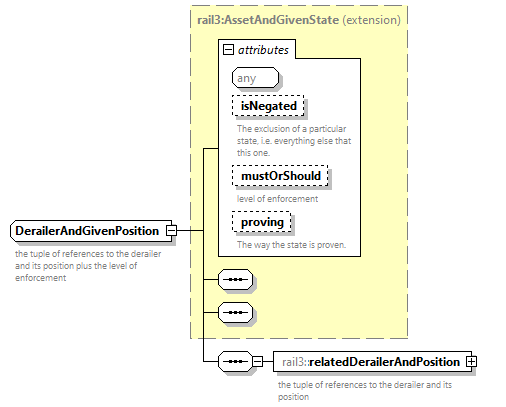 | ||||||||||||||||||||||||||||||
| namespace | https://www.railml.org/schemas/3.2 | ||||||||||||||||||||||||||||||
| type | extension of rail3:AssetAndGivenState | ||||||||||||||||||||||||||||||
| properties |
| ||||||||||||||||||||||||||||||
| children | rail3:relatedDerailerAndPosition | ||||||||||||||||||||||||||||||
| used by |
| ||||||||||||||||||||||||||||||
| attributes |
| ||||||||||||||||||||||||||||||
| annotation |
| ||||||||||||||||||||||||||||||
| source | <xs:complexType name="DerailerAndGivenPosition"> <xs:annotation> <xs:documentation>the tuple of references to the derailer and its position plus the level of enforcement</xs:documentation> </xs:annotation> <xs:complexContent> <xs:extension base="rail3:AssetAndGivenState"> <xs:sequence> <xs:element name="relatedDerailerAndPosition" type="rail3:DerailerAndPosition" minOccurs="1" maxOccurs="1"> <xs:annotation> <xs:documentation>the tuple of references to the derailer and its position</xs:documentation> </xs:annotation> </xs:element> </xs:sequence> </xs:extension> </xs:complexContent> </xs:complexType> |
element DerailerAndGivenPosition/relatedDerailerAndPosition
| diagram | 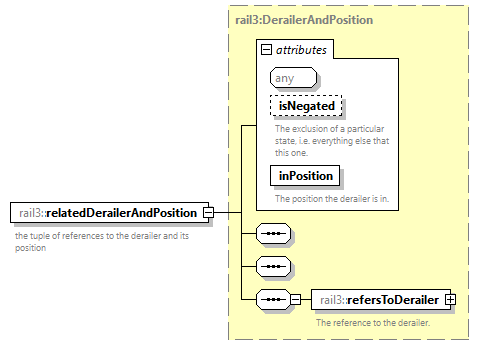 | ||||||||||||||||||||||
| namespace | https://www.railml.org/schemas/3.2 | ||||||||||||||||||||||
| type | rail3:DerailerAndPosition | ||||||||||||||||||||||
| properties |
| ||||||||||||||||||||||
| children | rail3:refersToDerailer | ||||||||||||||||||||||
| attributes |
| ||||||||||||||||||||||
| annotation |
| ||||||||||||||||||||||
| source | <xs:element name="relatedDerailerAndPosition" type="rail3:DerailerAndPosition" minOccurs="1" maxOccurs="1"> <xs:annotation> <xs:documentation>the tuple of references to the derailer and its position</xs:documentation> </xs:annotation> </xs:element> |
complexType DerailerAndPosition
| diagram | 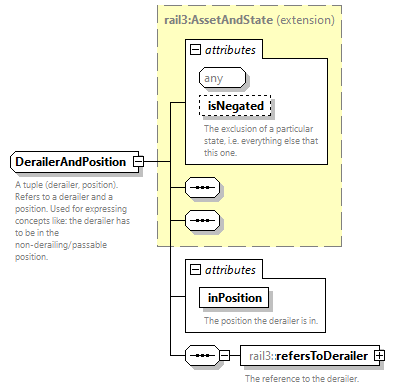 | ||||||||||||||||||||||
| namespace | https://www.railml.org/schemas/3.2 | ||||||||||||||||||||||
| type | extension of rail3:AssetAndState | ||||||||||||||||||||||
| properties |
| ||||||||||||||||||||||
| children | rail3:refersToDerailer | ||||||||||||||||||||||
| used by |
| ||||||||||||||||||||||
| attributes |
| ||||||||||||||||||||||
| annotation |
| ||||||||||||||||||||||
| source | <xs:complexType name="DerailerAndPosition"> <xs:annotation> <xs:documentation>A tuple (derailer, position). Refers to a derailer and a position. Used for expressing concepts like: the derailer has to be in the non-derailing/passable position.</xs:documentation> </xs:annotation> <xs:complexContent> <xs:extension base="rail3:AssetAndState"> <xs:sequence> <xs:element name="refersToDerailer" type="rail3:EntityILref" minOccurs="1" maxOccurs="1"> <xs:annotation> <xs:documentation>The reference to the derailer.</xs:documentation> </xs:annotation> </xs:element> </xs:sequence> <xs:attribute name="inPosition" type="rail3:tDerailingPosition" use="required"> <xs:annotation> <xs:documentation>The position the derailer is in.</xs:documentation> </xs:annotation> </xs:attribute> </xs:extension> </xs:complexContent> </xs:complexType> |
attribute DerailerAndPosition/@inPosition
| type | rail3:tDerailingPosition | |||||||||||||
| properties |
| |||||||||||||
| facets |
| |||||||||||||
| annotation |
| |||||||||||||
| source | <xs:attribute name="inPosition" type="rail3:tDerailingPosition" use="required"> <xs:annotation> <xs:documentation>The position the derailer is in.</xs:documentation> </xs:annotation> </xs:attribute> |
element DerailerAndPosition/refersToDerailer
| diagram | 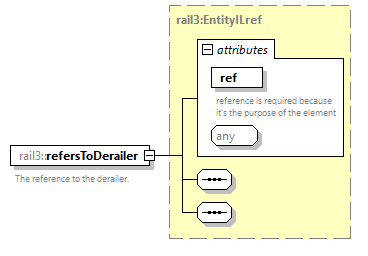 | ||||||||||||||
| namespace | https://www.railml.org/schemas/3.2 | ||||||||||||||
| type | rail3:EntityILref | ||||||||||||||
| properties |
| ||||||||||||||
| attributes |
| ||||||||||||||
| annotation |
| ||||||||||||||
| source | <xs:element name="refersToDerailer" type="rail3:EntityILref" minOccurs="1" maxOccurs="1"> <xs:annotation> <xs:documentation>The reference to the derailer.</xs:documentation> </xs:annotation> </xs:element> |
complexType DerailerIL
| diagram |  | ||||||||||||||||||||||||||||||||||||||||||||||||||||||||||||||||||||||||||||||||||||
| namespace | https://www.railml.org/schemas/3.2 | ||||||||||||||||||||||||||||||||||||||||||||||||||||||||||||||||||||||||||||||||||||
| type | extension of rail3:MovableElement | ||||||||||||||||||||||||||||||||||||||||||||||||||||||||||||||||||||||||||||||||||||
| properties |
| ||||||||||||||||||||||||||||||||||||||||||||||||||||||||||||||||||||||||||||||||||||
| children | rail3:designator rail3:assetName rail3:belongsToOperationalPoint rail3:hasCommand rail3:hasIndication rail3:refersTo rail3:hasGaugeClearanceMarker rail3:hasTvdSection rail3:connectedToPowerSupply rail3:relatedMovableElement rail3:lockedTrack | ||||||||||||||||||||||||||||||||||||||||||||||||||||||||||||||||||||||||||||||||||||
| used by |
| ||||||||||||||||||||||||||||||||||||||||||||||||||||||||||||||||||||||||||||||||||||
| attributes |
| ||||||||||||||||||||||||||||||||||||||||||||||||||||||||||||||||||||||||||||||||||||
| annotation |
| ||||||||||||||||||||||||||||||||||||||||||||||||||||||||||||||||||||||||||||||||||||
| source | <xs:complexType name="DerailerIL"> <xs:annotation> <xs:documentation>The derailer or trap switch is an infrastructure element that either allows or disallows train passage. A derailer typically operates on one rail only; trap switch (points) have similar effect using both rails to literally derail the train for protection purpose. 
 Derailers that are locally and manually controlled are obviously not within the scope of an interlocking as the dispatcher will typically prevent trains from derailing by blocking signals leading towards such a device</xs:documentation> </xs:annotation> <xs:complexContent> <xs:extension base="rail3:MovableElement"> <xs:sequence> <xs:element name="lockedTrack" type="rail3:EntityILref" minOccurs="0" maxOccurs="2"> <xs:annotation> <xs:documentation>The reference to one or two trackIL which are locked by the derailer. These are the tracks beyond the derailer to block any vehicle rolling out from there.</xs:documentation> </xs:annotation> </xs:element> </xs:sequence> <xs:attribute name="preferredPosition" type="rail3:tDerailingPosition" use="optional"> <xs:annotation> <xs:documentation>This is the preferred position of the derailer which it is switched to when not in use.</xs:documentation> </xs:annotation> </xs:attribute> </xs:extension> </xs:complexContent> </xs:complexType> |
attribute DerailerIL/@preferredPosition
| type | rail3:tDerailingPosition | |||||||||||||
| properties |
| |||||||||||||
| facets |
| |||||||||||||
| annotation |
| |||||||||||||
| source | <xs:attribute name="preferredPosition" type="rail3:tDerailingPosition" use="optional"> <xs:annotation> <xs:documentation>This is the preferred position of the derailer which it is switched to when not in use.</xs:documentation> </xs:annotation> </xs:attribute> |
element DerailerIL/lockedTrack
| diagram | 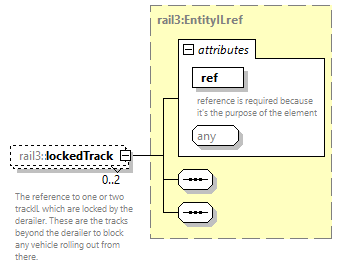 | ||||||||||||||
| namespace | https://www.railml.org/schemas/3.2 | ||||||||||||||
| type | rail3:EntityILref | ||||||||||||||
| properties |
| ||||||||||||||
| attributes |
| ||||||||||||||
| annotation |
| ||||||||||||||
| source | <xs:element name="lockedTrack" type="rail3:EntityILref" minOccurs="0" maxOccurs="2"> <xs:annotation> <xs:documentation>The reference to one or two trackIL which are locked by the derailer. These are the tracks beyond the derailer to block any vehicle rolling out from there.</xs:documentation> </xs:annotation> </xs:element> |
complexType DerailerInPosition
| diagram | 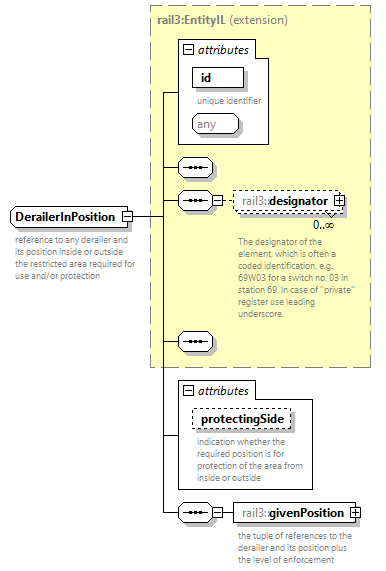 | ||||||||||||||||||||||
| namespace | https://www.railml.org/schemas/3.2 | ||||||||||||||||||||||
| type | extension of rail3:EntityIL | ||||||||||||||||||||||
| properties |
| ||||||||||||||||||||||
| children | rail3:designator rail3:givenPosition | ||||||||||||||||||||||
| used by |
| ||||||||||||||||||||||
| attributes |
| ||||||||||||||||||||||
| annotation |
| ||||||||||||||||||||||
| source | <xs:complexType name="DerailerInPosition"> <xs:annotation> <xs:documentation>reference to any derailer and its position inside or outside the restricted area required for use and/or protection</xs:documentation> </xs:annotation> <xs:complexContent> <xs:extension base="rail3:EntityIL"> <xs:sequence> <xs:element name="givenPosition" type="rail3:DerailerAndGivenPosition" minOccurs="1" maxOccurs="1"> <xs:annotation> <xs:documentation>the tuple of references to the derailer and its position plus the level of enforcement</xs:documentation> </xs:annotation> </xs:element> </xs:sequence> <xs:attribute name="protectingSide" type="rail3:tProtectingSideList" use="optional"> <xs:annotation> <xs:documentation>indication whether the required position is for protection of the area from inside or outside</xs:documentation> </xs:annotation> </xs:attribute> </xs:extension> </xs:complexContent> </xs:complexType> |
attribute DerailerInPosition/@protectingSide
| type | rail3:tProtectingSideList | ||||||||||||||||||
| properties |
| ||||||||||||||||||
| facets |
| ||||||||||||||||||
| annotation |
| ||||||||||||||||||
| source | <xs:attribute name="protectingSide" type="rail3:tProtectingSideList" use="optional"> <xs:annotation> <xs:documentation>indication whether the required position is for protection of the area from inside or outside</xs:documentation> </xs:annotation> </xs:attribute> |
element DerailerInPosition/givenPosition
| diagram | 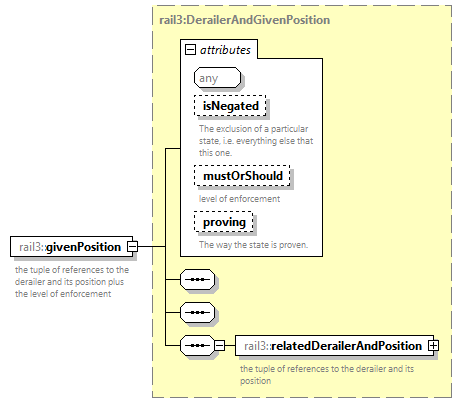 | ||||||||||||||||||||||||||||||
| namespace | https://www.railml.org/schemas/3.2 | ||||||||||||||||||||||||||||||
| type | rail3:DerailerAndGivenPosition | ||||||||||||||||||||||||||||||
| properties |
| ||||||||||||||||||||||||||||||
| children | rail3:relatedDerailerAndPosition | ||||||||||||||||||||||||||||||
| attributes |
| ||||||||||||||||||||||||||||||
| annotation |
| ||||||||||||||||||||||||||||||
| source | <xs:element name="givenPosition" type="rail3:DerailerAndGivenPosition" minOccurs="1" maxOccurs="1"> <xs:annotation> <xs:documentation>the tuple of references to the derailer and its position plus the level of enforcement</xs:documentation> </xs:annotation> </xs:element> |
complexType DerailersIL
| diagram | 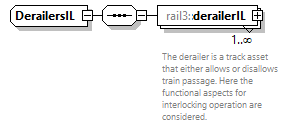 | ||
| namespace | https://www.railml.org/schemas/3.2 | ||
| children | rail3:derailerIL | ||
| used by |
| ||
| source | <xs:complexType name="DerailersIL"> <xs:sequence> <xs:element name="derailerIL" type="rail3:DerailerIL" minOccurs="1" maxOccurs="unbounded"> <xs:annotation> <xs:documentation>The derailer is a track asset that either allows or disallows train passage. Here the functional aspects for interlocking operation are considered.</xs:documentation> </xs:annotation> </xs:element> </xs:sequence> </xs:complexType> |
element DerailersIL/derailerIL
| diagram |  | ||||||||||||||||||||||||||||||||||||||||||||||||||||||||||||||||||||||||||||||||||||
| namespace | https://www.railml.org/schemas/3.2 | ||||||||||||||||||||||||||||||||||||||||||||||||||||||||||||||||||||||||||||||||||||
| type | rail3:DerailerIL | ||||||||||||||||||||||||||||||||||||||||||||||||||||||||||||||||||||||||||||||||||||
| properties |
| ||||||||||||||||||||||||||||||||||||||||||||||||||||||||||||||||||||||||||||||||||||
| children | rail3:designator rail3:assetName rail3:belongsToOperationalPoint rail3:hasCommand rail3:hasIndication rail3:refersTo rail3:hasGaugeClearanceMarker rail3:hasTvdSection rail3:connectedToPowerSupply rail3:relatedMovableElement rail3:lockedTrack | ||||||||||||||||||||||||||||||||||||||||||||||||||||||||||||||||||||||||||||||||||||
| attributes |
| ||||||||||||||||||||||||||||||||||||||||||||||||||||||||||||||||||||||||||||||||||||
| annotation |
| ||||||||||||||||||||||||||||||||||||||||||||||||||||||||||||||||||||||||||||||||||||
| source | <xs:element name="derailerIL" type="rail3:DerailerIL" minOccurs="1" maxOccurs="unbounded"> <xs:annotation> <xs:documentation>The derailer is a track asset that either allows or disallows train passage. Here the functional aspects for interlocking operation are considered.</xs:documentation> </xs:annotation> </xs:element> |
complexType DestinationPoints
| diagram |  | ||
| namespace | https://www.railml.org/schemas/3.2 | ||
| children | rail3:destinationPoint | ||
| used by |
| ||
| annotation |
| ||
| source | <xs:complexType name="DestinationPoints"> <xs:annotation> <xs:documentation>container element for all DestinationPoint elements
 The definition of destination points which are mainly route exits. This allows definition independent of routes.</xs:documentation> </xs:annotation> <xs:sequence> <xs:element name="destinationPoint" type="rail3:RouteExit" minOccurs="1" maxOccurs="unbounded"> <xs:annotation> <xs:documentation>destination point of a secured running path</xs:documentation> </xs:annotation> </xs:element> </xs:sequence> </xs:complexType> |
element DestinationPoints/destinationPoint
| diagram | 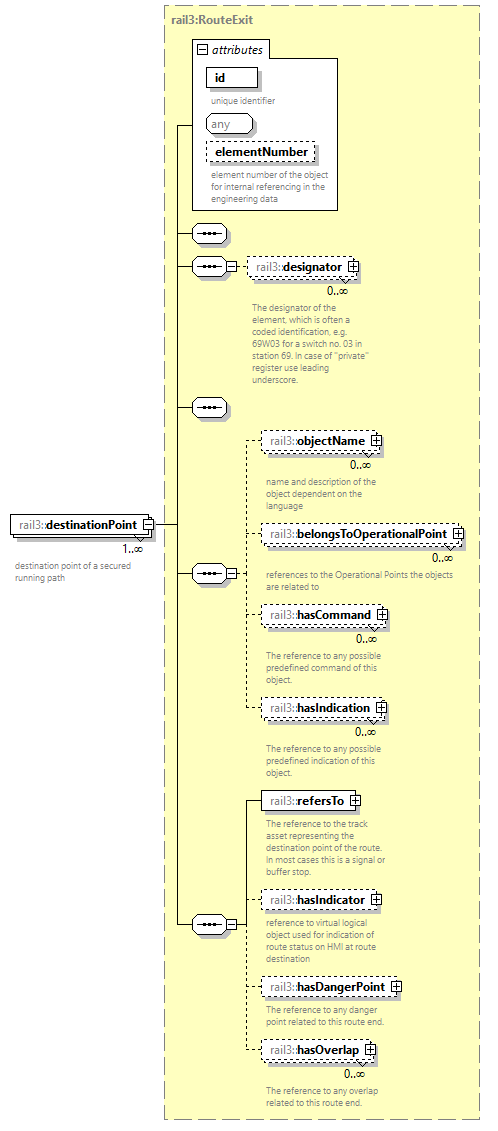 | ||||||||||||||||||||||
| namespace | https://www.railml.org/schemas/3.2 | ||||||||||||||||||||||
| type | rail3:RouteExit | ||||||||||||||||||||||
| properties |
| ||||||||||||||||||||||
| children | rail3:designator rail3:objectName rail3:belongsToOperationalPoint rail3:hasCommand rail3:hasIndication rail3:refersTo rail3:hasIndicator rail3:hasDangerPoint rail3:hasOverlap | ||||||||||||||||||||||
| attributes |
| ||||||||||||||||||||||
| annotation |
| ||||||||||||||||||||||
| source | <xs:element name="destinationPoint" type="rail3:RouteExit" minOccurs="1" maxOccurs="unbounded"> <xs:annotation> <xs:documentation>destination point of a secured running path</xs:documentation> </xs:annotation> </xs:element> |
complexType DetectorAndGivenState
| diagram | 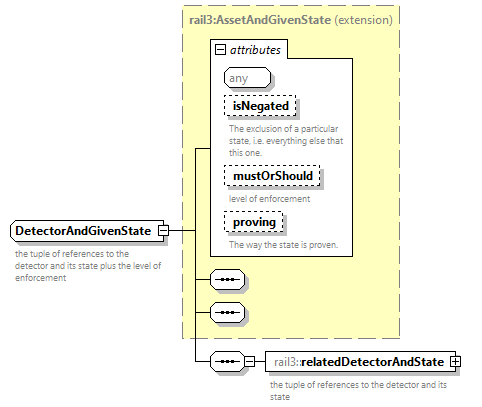 | ||||||||||||||||||||||||||||||
| namespace | https://www.railml.org/schemas/3.2 | ||||||||||||||||||||||||||||||
| type | extension of rail3:AssetAndGivenState | ||||||||||||||||||||||||||||||
| properties |
| ||||||||||||||||||||||||||||||
| children | rail3:relatedDetectorAndState | ||||||||||||||||||||||||||||||
| used by |
| ||||||||||||||||||||||||||||||
| attributes |
| ||||||||||||||||||||||||||||||
| annotation |
| ||||||||||||||||||||||||||||||
| source | <xs:complexType name="DetectorAndGivenState"> <xs:annotation> <xs:documentation>the tuple of references to the detector and its state plus the level of enforcement</xs:documentation> </xs:annotation> <xs:complexContent> <xs:extension base="rail3:AssetAndGivenState"> <xs:sequence> <xs:element name="relatedDetectorAndState" type="rail3:DetectorAndState" minOccurs="1" maxOccurs="1"> <xs:annotation> <xs:documentation>the tuple of references to the detector and its state</xs:documentation> </xs:annotation> </xs:element> </xs:sequence> </xs:extension> </xs:complexContent> </xs:complexType> |
element DetectorAndGivenState/relatedDetectorAndState
| diagram | 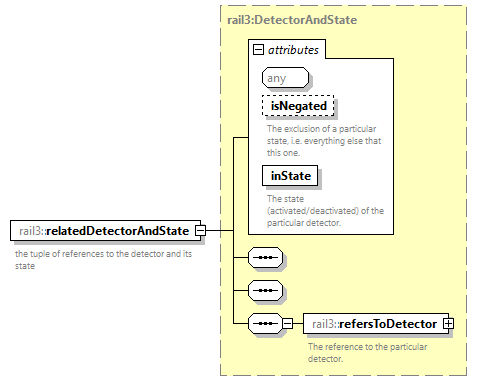 | ||||||||||||||||||||||
| namespace | https://www.railml.org/schemas/3.2 | ||||||||||||||||||||||
| type | rail3:DetectorAndState | ||||||||||||||||||||||
| properties |
| ||||||||||||||||||||||
| children | rail3:refersToDetector | ||||||||||||||||||||||
| attributes |
| ||||||||||||||||||||||
| annotation |
| ||||||||||||||||||||||
| source | <xs:element name="relatedDetectorAndState" type="rail3:DetectorAndState" minOccurs="1" maxOccurs="1"> <xs:annotation> <xs:documentation>the tuple of references to the detector and its state</xs:documentation> </xs:annotation> </xs:element> |
complexType DetectorAndState
| diagram | 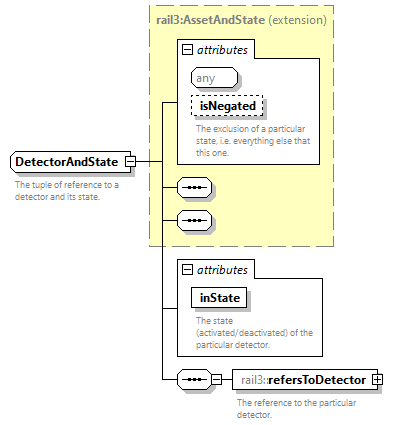 | ||||||||||||||||||||||
| namespace | https://www.railml.org/schemas/3.2 | ||||||||||||||||||||||
| type | extension of rail3:AssetAndState | ||||||||||||||||||||||
| properties |
| ||||||||||||||||||||||
| children | rail3:refersToDetector | ||||||||||||||||||||||
| used by |
| ||||||||||||||||||||||
| attributes |
| ||||||||||||||||||||||
| annotation |
| ||||||||||||||||||||||
| source | <xs:complexType name="DetectorAndState"> <xs:annotation> <xs:documentation>The tuple of reference to a detector and its state.</xs:documentation> </xs:annotation> <xs:complexContent> <xs:extension base="rail3:AssetAndState"> <xs:sequence> <xs:element name="refersToDetector" type="rail3:EntityILref" minOccurs="1" maxOccurs="1"> <xs:annotation> <xs:documentation>The reference to the particular detector.</xs:documentation> </xs:annotation> </xs:element> </xs:sequence> <xs:attribute name="inState" type="rail3:tDetectorStates" use="required"> <xs:annotation> <xs:documentation>The state (activated/deactivated) of the particular detector.</xs:documentation> </xs:annotation> </xs:attribute> </xs:extension> </xs:complexContent> </xs:complexType> |
attribute DetectorAndState/@inState
| type | rail3:tDetectorStates | ||||||||||||||||||
| properties |
| ||||||||||||||||||
| facets |
| ||||||||||||||||||
| annotation |
| ||||||||||||||||||
| source | <xs:attribute name="inState" type="rail3:tDetectorStates" use="required"> <xs:annotation> <xs:documentation>The state (activated/deactivated) of the particular detector.</xs:documentation> </xs:annotation> </xs:attribute> |
element DetectorAndState/refersToDetector
| diagram | 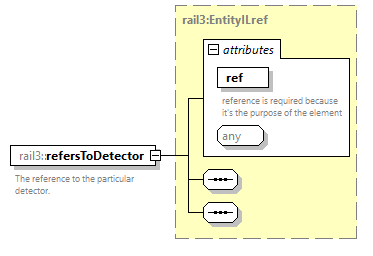 | ||||||||||||||
| namespace | https://www.railml.org/schemas/3.2 | ||||||||||||||
| type | rail3:EntityILref | ||||||||||||||
| properties |
| ||||||||||||||
| attributes |
| ||||||||||||||
| annotation |
| ||||||||||||||
| source | <xs:element name="refersToDetector" type="rail3:EntityILref" minOccurs="1" maxOccurs="1"> <xs:annotation> <xs:documentation>The reference to the particular detector.</xs:documentation> </xs:annotation> </xs:element> |
complexType DetectorInState
| diagram | 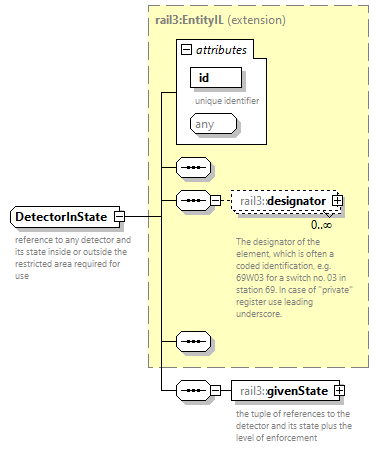 | ||||||||||||||
| namespace | https://www.railml.org/schemas/3.2 | ||||||||||||||
| type | extension of rail3:EntityIL | ||||||||||||||
| properties |
| ||||||||||||||
| children | rail3:designator rail3:givenState | ||||||||||||||
| used by |
| ||||||||||||||
| attributes |
| ||||||||||||||
| annotation |
| ||||||||||||||
| source | <xs:complexType name="DetectorInState"> <xs:annotation> <xs:documentation>reference to any detector and its state inside or outside the restricted area required for use</xs:documentation> </xs:annotation> <xs:complexContent> <xs:extension base="rail3:EntityIL"> <xs:sequence> <xs:element name="givenState" type="rail3:DetectorAndGivenState" minOccurs="1" maxOccurs="1"> <xs:annotation> <xs:documentation>the tuple of references to the detector and its state plus the level of enforcement</xs:documentation> </xs:annotation> </xs:element> </xs:sequence> </xs:extension> </xs:complexContent> </xs:complexType> |
element DetectorInState/givenState
| diagram | 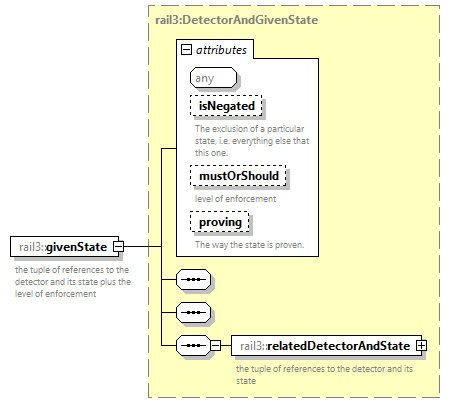 | ||||||||||||||||||||||||||||||
| namespace | https://www.railml.org/schemas/3.2 | ||||||||||||||||||||||||||||||
| type | rail3:DetectorAndGivenState | ||||||||||||||||||||||||||||||
| properties |
| ||||||||||||||||||||||||||||||
| children | rail3:relatedDetectorAndState | ||||||||||||||||||||||||||||||
| attributes |
| ||||||||||||||||||||||||||||||
| annotation |
| ||||||||||||||||||||||||||||||
| source | <xs:element name="givenState" type="rail3:DetectorAndGivenState" minOccurs="1" maxOccurs="1"> <xs:annotation> <xs:documentation>the tuple of references to the detector and its state plus the level of enforcement</xs:documentation> </xs:annotation> </xs:element> |
complexType DetectorTypes
| diagram | 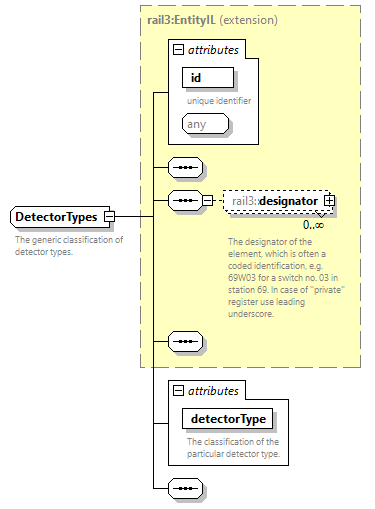 | ||||||||||||||||||||||
| namespace | https://www.railml.org/schemas/3.2 | ||||||||||||||||||||||
| type | extension of rail3:EntityIL | ||||||||||||||||||||||
| properties |
| ||||||||||||||||||||||
| children | rail3:designator | ||||||||||||||||||||||
| used by |
| ||||||||||||||||||||||
| attributes |
| ||||||||||||||||||||||
| annotation |
| ||||||||||||||||||||||
| source | <xs:complexType name="DetectorTypes"> <xs:annotation> <xs:documentation>The generic classification of detector types.</xs:documentation> </xs:annotation> <xs:complexContent> <xs:extension base="rail3:EntityIL"> <xs:sequence/> <xs:attribute name="detectorType" type="rail3:tDetectorTypeListExt" use="required"> <xs:annotation> <xs:documentation>The classification of the particular detector type.</xs:documentation> </xs:annotation> </xs:attribute> </xs:extension> </xs:complexContent> </xs:complexType> |
attribute DetectorTypes/@detectorType
| type | rail3:tDetectorTypeListExt | ||
| properties |
| ||
| annotation |
| ||
| source | <xs:attribute name="detectorType" type="rail3:tDetectorTypeListExt" use="required"> <xs:annotation> <xs:documentation>The classification of the particular detector type.</xs:documentation> </xs:annotation> </xs:attribute> |
complexType ElementGroup
| diagram |  | ||||||||||||||||||||||||||||||
| namespace | https://www.railml.org/schemas/3.2 | ||||||||||||||||||||||||||||||
| type | extension of rail3:TrackAsset | ||||||||||||||||||||||||||||||
| properties |
| ||||||||||||||||||||||||||||||
| children | rail3:designator rail3:assetName rail3:belongsToOperationalPoint rail3:hasCommand rail3:hasIndication rail3:groupType rail3:refersToMember rail3:hasStationIndicator rail3:refersToInfrastructureElement | ||||||||||||||||||||||||||||||
| used by |
| ||||||||||||||||||||||||||||||
| attributes |
| ||||||||||||||||||||||||||||||
| annotation |
| ||||||||||||||||||||||||||||||
| source | <xs:complexType name="ElementGroup"> <xs:annotation> <xs:documentation>For operational purpose of the interlocking some elements are grouped together. This allows e.g. commanding them with only one command.</xs:documentation> </xs:annotation> <xs:complexContent> <xs:extension base="rail3:TrackAsset"> <xs:sequence> <xs:element name="groupType" type="rail3:EntityILref" minOccurs="1" maxOccurs="1"> <xs:annotation> <xs:documentation>The reference to the Infrastructure Manager specific element group type.</xs:documentation> </xs:annotation> </xs:element> <xs:element name="refersToMember" type="rail3:EntityILref" minOccurs="0" maxOccurs="unbounded"> <xs:annotation> <xs:documentation>The reference to the member element within this group. The member list may be omitted when the referred infrastructure element describes the group/area, e.g. referring to electrificationSection in IS with groupType="catenary".</xs:documentation> </xs:annotation> </xs:element> <xs:element name="hasStationIndicator" type="rail3:EntityILref" minOccurs="0" maxOccurs="1"> <xs:annotation> <xs:documentation>reference to the indicator used for showing its status and for commanding</xs:documentation> </xs:annotation> </xs:element> <xs:element name="refersToInfrastructureElement" type="rail3:EntityILref" minOccurs="0" maxOccurs="unbounded"> <xs:annotation> <xs:documentation>The reference to an element in infrastructure describing the group/area. In that case the member list may be omitted, e.g. referring to electrificationSection in IS with groupType="catenary".</xs:documentation> </xs:annotation> </xs:element> </xs:sequence> <xs:attribute name="belongsToParent" type="rail3:tRef" use="optional"> <xs:annotation> <xs:documentation>The reference to another ElementGroup used as parent for grouping them together.
 
 - if some information exists in parent and child, then information in child overwrites it in child
 
 -if some information exists only in parent, then child inherits this information from parent</xs:documentation> </xs:annotation> </xs:attribute> </xs:extension> </xs:complexContent> </xs:complexType> |
attribute ElementGroup/@belongsToParent
| type | rail3:tRef | ||
| properties |
| ||
| annotation |
| ||
| source | <xs:attribute name="belongsToParent" type="rail3:tRef" use="optional"> <xs:annotation> <xs:documentation>The reference to another ElementGroup used as parent for grouping them together.
 
 - if some information exists in parent and child, then information in child overwrites it in child
 
 -if some information exists only in parent, then child inherits this information from parent</xs:documentation> </xs:annotation> </xs:attribute> |
element ElementGroup/groupType
| diagram | 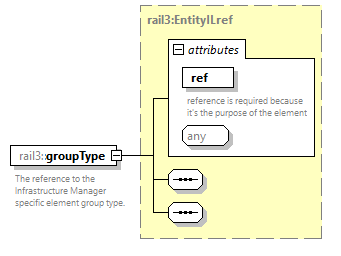 | ||||||||||||||
| namespace | https://www.railml.org/schemas/3.2 | ||||||||||||||
| type | rail3:EntityILref | ||||||||||||||
| properties |
| ||||||||||||||
| attributes |
| ||||||||||||||
| annotation |
| ||||||||||||||
| source | <xs:element name="groupType" type="rail3:EntityILref" minOccurs="1" maxOccurs="1"> <xs:annotation> <xs:documentation>The reference to the Infrastructure Manager specific element group type.</xs:documentation> </xs:annotation> </xs:element> |
element ElementGroup/refersToMember
| diagram | 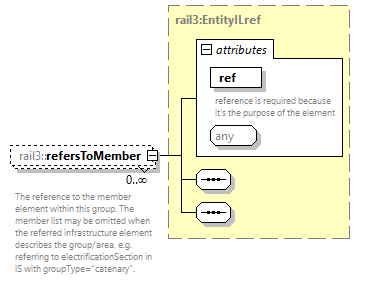 | ||||||||||||||
| namespace | https://www.railml.org/schemas/3.2 | ||||||||||||||
| type | rail3:EntityILref | ||||||||||||||
| properties |
| ||||||||||||||
| attributes |
| ||||||||||||||
| annotation |
| ||||||||||||||
| source | <xs:element name="refersToMember" type="rail3:EntityILref" minOccurs="0" maxOccurs="unbounded"> <xs:annotation> <xs:documentation>The reference to the member element within this group. The member list may be omitted when the referred infrastructure element describes the group/area, e.g. referring to electrificationSection in IS with groupType="catenary".</xs:documentation> </xs:annotation> </xs:element> |
element ElementGroup/hasStationIndicator
| diagram | 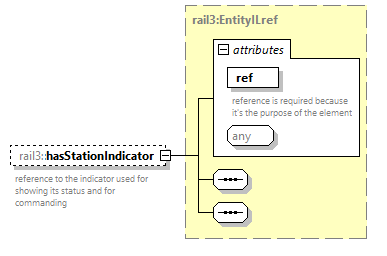 | ||||||||||||||
| namespace | https://www.railml.org/schemas/3.2 | ||||||||||||||
| type | rail3:EntityILref | ||||||||||||||
| properties |
| ||||||||||||||
| attributes |
| ||||||||||||||
| annotation |
| ||||||||||||||
| source | <xs:element name="hasStationIndicator" type="rail3:EntityILref" minOccurs="0" maxOccurs="1"> <xs:annotation> <xs:documentation>reference to the indicator used for showing its status and for commanding</xs:documentation> </xs:annotation> </xs:element> |
element ElementGroup/refersToInfrastructureElement
| diagram | 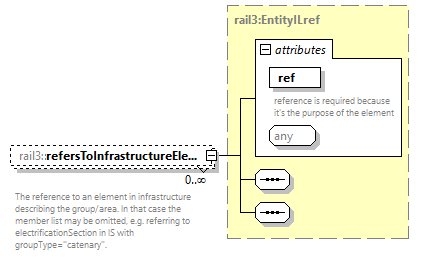 | ||||||||||||||
| namespace | https://www.railml.org/schemas/3.2 | ||||||||||||||
| type | rail3:EntityILref | ||||||||||||||
| properties |
| ||||||||||||||
| attributes |
| ||||||||||||||
| annotation |
| ||||||||||||||
| source | <xs:element name="refersToInfrastructureElement" type="rail3:EntityILref" minOccurs="0" maxOccurs="unbounded"> <xs:annotation> <xs:documentation>The reference to an element in infrastructure describing the group/area. In that case the member list may be omitted, e.g. referring to electrificationSection in IS with groupType="catenary".</xs:documentation> </xs:annotation> </xs:element> |
complexType ElementGroupingTypes
| diagram | 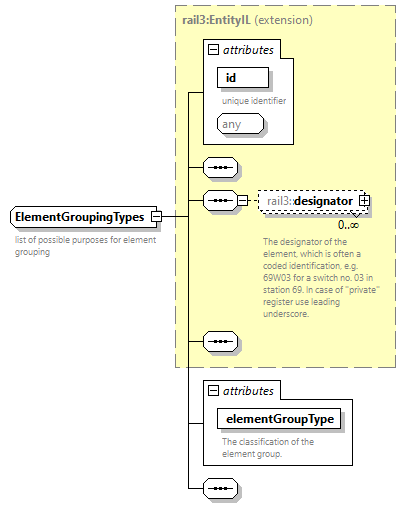 | ||||||||||||||||||||||
| namespace | https://www.railml.org/schemas/3.2 | ||||||||||||||||||||||
| type | extension of rail3:EntityIL | ||||||||||||||||||||||
| properties |
| ||||||||||||||||||||||
| children | rail3:designator | ||||||||||||||||||||||
| used by |
| ||||||||||||||||||||||
| attributes |
| ||||||||||||||||||||||
| annotation |
| ||||||||||||||||||||||
| source | <xs:complexType name="ElementGroupingTypes"> <xs:annotation> <xs:documentation>list of possible purposes for element grouping</xs:documentation> </xs:annotation> <xs:complexContent> <xs:extension base="rail3:EntityIL"> <xs:sequence/> <xs:attribute name="elementGroupType" type="rail3:tGroupingTypesExt" use="required"> <xs:annotation> <xs:documentation>The classification of the element group.</xs:documentation> </xs:annotation> </xs:attribute> </xs:extension> </xs:complexContent> </xs:complexType> |
attribute ElementGroupingTypes/@elementGroupType
| type | rail3:tGroupingTypesExt | ||
| properties |
| ||
| annotation |
| ||
| source | <xs:attribute name="elementGroupType" type="rail3:tGroupingTypesExt" use="required"> <xs:annotation> <xs:documentation>The classification of the element group.</xs:documentation> </xs:annotation> </xs:attribute> |
complexType EndOfTrack
| diagram | 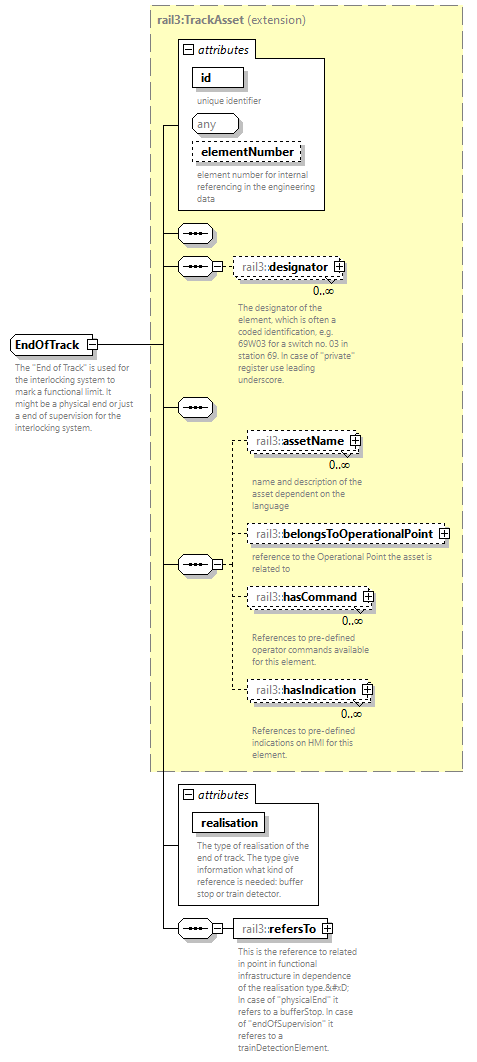 | ||||||||||||||||||||||||||||||
| namespace | https://www.railml.org/schemas/3.2 | ||||||||||||||||||||||||||||||
| type | extension of rail3:TrackAsset | ||||||||||||||||||||||||||||||
| properties |
| ||||||||||||||||||||||||||||||
| children | rail3:designator rail3:assetName rail3:belongsToOperationalPoint rail3:hasCommand rail3:hasIndication rail3:refersTo | ||||||||||||||||||||||||||||||
| used by |
| ||||||||||||||||||||||||||||||
| attributes |
| ||||||||||||||||||||||||||||||
| annotation |
| ||||||||||||||||||||||||||||||
| source | <xs:complexType name="EndOfTrack"> <xs:annotation> <xs:documentation>The "End of Track" is used for the interlocking system to mark a functional limit. It might be a physical end or just a end of supervision for the interlocking system.</xs:documentation> </xs:annotation> <xs:complexContent> <xs:extension base="rail3:TrackAsset"> <xs:sequence> <xs:element name="refersTo" type="rail3:EntityILref" minOccurs="1" maxOccurs="1"> <xs:annotation> <xs:documentation>This is the reference to related in point in functional infrastructure in dependence of the realisation type.
 In case of "physicalEnd" it refers to a bufferStop. In case of "endOfSupervision" it referes to a trainDetectionElement.</xs:documentation> </xs:annotation> </xs:element> </xs:sequence> <xs:attribute name="realisation" type="rail3:EndOfTrackTypeList" use="required"> <xs:annotation> <xs:documentation>The type of realisation of the end of track. The type give information what kind of reference is needed: buffer stop or train detector.</xs:documentation> </xs:annotation> </xs:attribute> </xs:extension> </xs:complexContent> </xs:complexType> |
attribute EndOfTrack/@realisation
| type | rail3:EndOfTrackTypeList | |||||||||
| properties |
| |||||||||
| facets |
| |||||||||
| annotation |
| |||||||||
| source | <xs:attribute name="realisation" type="rail3:EndOfTrackTypeList" use="required"> <xs:annotation> <xs:documentation>The type of realisation of the end of track. The type give information what kind of reference is needed: buffer stop or train detector.</xs:documentation> </xs:annotation> </xs:attribute> |
element EndOfTrack/refersTo
| diagram | 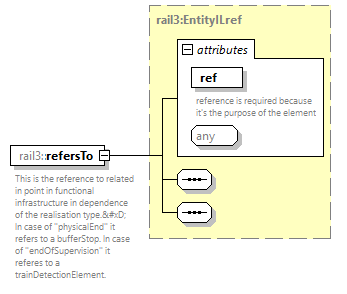 | ||||||||||||||
| namespace | https://www.railml.org/schemas/3.2 | ||||||||||||||
| type | rail3:EntityILref | ||||||||||||||
| properties |
| ||||||||||||||
| attributes |
| ||||||||||||||
| annotation |
| ||||||||||||||
| source | <xs:element name="refersTo" type="rail3:EntityILref" minOccurs="1" maxOccurs="1"> <xs:annotation> <xs:documentation>This is the reference to related in point in functional infrastructure in dependence of the realisation type.
 In case of "physicalEnd" it refers to a bufferStop. In case of "endOfSupervision" it referes to a trainDetectionElement.</xs:documentation> </xs:annotation> </xs:element> |
complexType EndOfTracks
| diagram | 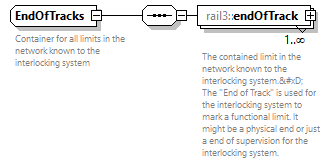 | ||
| namespace | https://www.railml.org/schemas/3.2 | ||
| children | rail3:endOfTrack | ||
| used by |
| ||
| annotation |
| ||
| source | <xs:complexType name="EndOfTracks"> <xs:annotation> <xs:documentation>Container for all limits in the network known to the interlocking system</xs:documentation> </xs:annotation> <xs:sequence> <xs:element name="endOfTrack" type="rail3:EndOfTrack" minOccurs="1" maxOccurs="unbounded"> <xs:annotation> <xs:documentation>The contained limit in the network known to the interlocking system.
 The "End of Track" is used for the interlocking system to mark a functional limit. It might be a physical end or just a end of supervision for the interlocking system.</xs:documentation> </xs:annotation> </xs:element> </xs:sequence> </xs:complexType> |
element EndOfTracks/endOfTrack
| diagram | 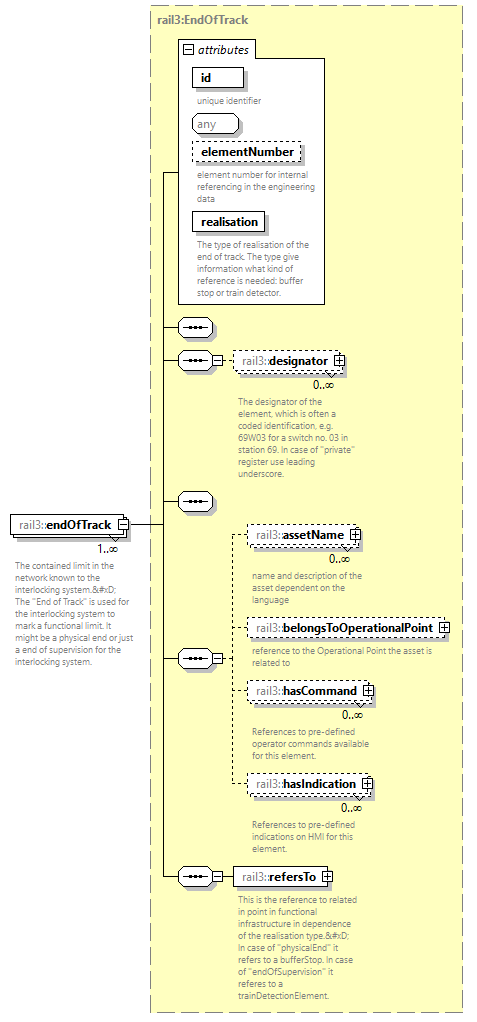 | ||||||||||||||||||||||||||||||
| namespace | https://www.railml.org/schemas/3.2 | ||||||||||||||||||||||||||||||
| type | rail3:EndOfTrack | ||||||||||||||||||||||||||||||
| properties |
| ||||||||||||||||||||||||||||||
| children | rail3:designator rail3:assetName rail3:belongsToOperationalPoint rail3:hasCommand rail3:hasIndication rail3:refersTo | ||||||||||||||||||||||||||||||
| attributes |
| ||||||||||||||||||||||||||||||
| annotation |
| ||||||||||||||||||||||||||||||
| source | <xs:element name="endOfTrack" type="rail3:EndOfTrack" minOccurs="1" maxOccurs="unbounded"> <xs:annotation> <xs:documentation>The contained limit in the network known to the interlocking system.
 The "End of Track" is used for the interlocking system to mark a functional limit. It might be a physical end or just a end of supervision for the interlocking system.</xs:documentation> </xs:annotation> </xs:element> |
complexType EntityIL
| diagram | 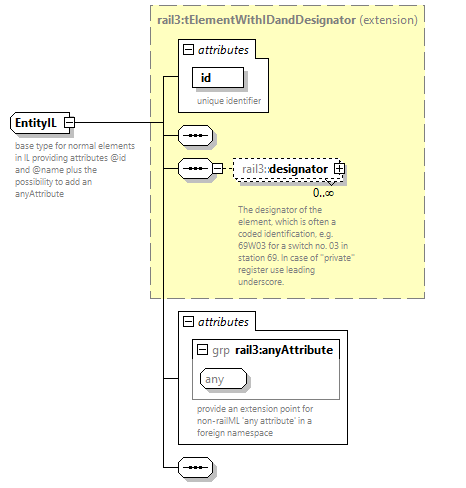 | ||||||||||||||
| namespace | https://www.railml.org/schemas/3.2 | ||||||||||||||
| type | extension of rail3:tElementWithIDandDesignator | ||||||||||||||
| properties |
| ||||||||||||||
| children | rail3:designator | ||||||||||||||
| used by |
| ||||||||||||||
| attributes |
| ||||||||||||||
| annotation |
| ||||||||||||||
| source | <xs:complexType name="EntityIL"> <xs:annotation> <xs:documentation>base type for normal elements in IL providing attributes @id and @name plus the possibility to add an anyAttribute</xs:documentation> </xs:annotation> <xs:complexContent> <xs:extension base="rail3:tElementWithIDandDesignator"> <xs:sequence/> <xs:attributeGroup ref="rail3:anyAttribute"/> </xs:extension> </xs:complexContent> </xs:complexType> |
complexType EntityILref
| diagram | 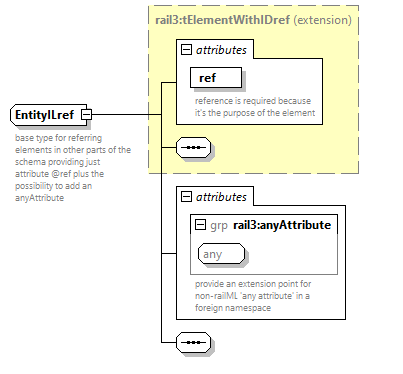 | ||||||||||||||
| namespace | https://www.railml.org/schemas/3.2 | ||||||||||||||
| type | extension of rail3:tElementWithIDref | ||||||||||||||
| properties |
| ||||||||||||||
| used by |
| ||||||||||||||
| attributes |
| ||||||||||||||
| annotation |
| ||||||||||||||
| source | <xs:complexType name="EntityILref"> <xs:annotation> <xs:documentation>base type for referring elements in other parts of the schema providing just attribute @ref plus the possibility to add an anyAttribute</xs:documentation> </xs:annotation> <xs:complexContent> <xs:extension base="rail3:tElementWithIDref"> <xs:sequence/> <xs:attributeGroup ref="rail3:anyAttribute"/> </xs:extension> </xs:complexContent> </xs:complexType> |
complexType EtcsGeneralData
| diagram | 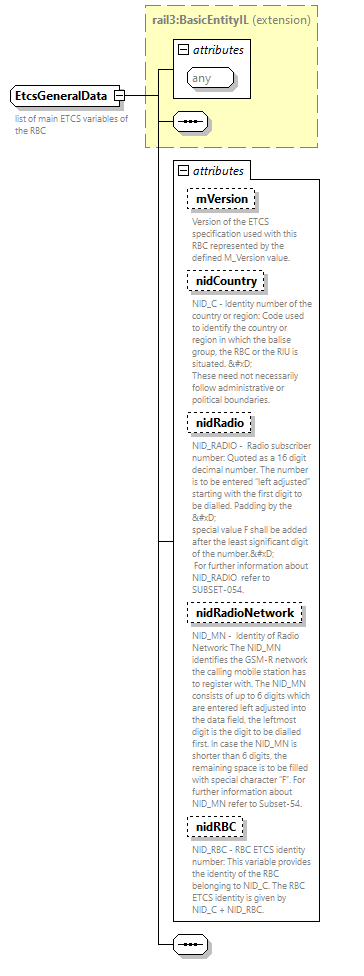 | ||||||||||||||||||||||||||||||||||||||||||||||
| namespace | https://www.railml.org/schemas/3.2 | ||||||||||||||||||||||||||||||||||||||||||||||
| type | extension of rail3:BasicEntityIL | ||||||||||||||||||||||||||||||||||||||||||||||
| properties |
| ||||||||||||||||||||||||||||||||||||||||||||||
| used by |
| ||||||||||||||||||||||||||||||||||||||||||||||
| attributes |
| ||||||||||||||||||||||||||||||||||||||||||||||
| annotation |
| ||||||||||||||||||||||||||||||||||||||||||||||
| source | <xs:complexType name="EtcsGeneralData"> <xs:annotation> <xs:documentation>list of main ETCS variables of the RBC</xs:documentation> </xs:annotation> <xs:complexContent> <xs:extension base="rail3:BasicEntityIL"> <xs:sequence/> <xs:attribute name="mVersion" type="xs:nonNegativeInteger" use="optional"> <xs:annotation> <xs:documentation>Version of the ETCS specification used with this RBC represented by the defined M_Version value.</xs:documentation> </xs:annotation> </xs:attribute> <xs:attribute name="nidCountry" type="xs:nonNegativeInteger" use="optional"> <xs:annotation> <xs:documentation>NID_C - Identity number of the country or region: Code used to identify the country or region in which the balise group, the RBC or the RIU is situated. 
 These need not necessarily follow administrative or political boundaries. </xs:documentation> </xs:annotation> </xs:attribute> <xs:attribute name="nidRadio" type="rail3:tHexaString" use="optional"> <xs:annotation> <xs:documentation>NID_RADIO - Radio subscriber number: Quoted as a 16 digit decimal number. The number is to be entered “left adjusted” starting with the first digit to be dialled. Padding by the 
 special value F shall be added after the least significant digit of the number.
 For further information about NID_RADIO refer to SUBSET-054.</xs:documentation> </xs:annotation> </xs:attribute> <xs:attribute name="nidRadioNetwork" type="rail3:tHexa6String" use="optional"> <xs:annotation> <xs:documentation>NID_MN - Identity of Radio Network: The NID_MN identifies the GSM-R network the calling mobile station has to register with. The NID_MN consists of up to 6 digits which are entered left adjusted into the data field, the leftmost digit is the digit to be dialled first. In case the NID_MN is shorter than 6 digits, the remaining space is to be filled with special character “F”. For further information about NID_MN refer to Subset-54. </xs:documentation> </xs:annotation> </xs:attribute> <xs:attribute name="nidRBC" type="xs:nonNegativeInteger" use="optional"> <xs:annotation> <xs:documentation>NID_RBC - RBC ETCS identity number: This variable provides the identity of the RBC belonging to NID_C. The RBC ETCS identity is given by NID_C + NID_RBC. </xs:documentation> </xs:annotation> </xs:attribute> </xs:extension> </xs:complexContent> </xs:complexType> |
attribute EtcsGeneralData/@mVersion
| type | xs:nonNegativeInteger | ||
| properties |
| ||
| annotation |
| ||
| source | <xs:attribute name="mVersion" type="xs:nonNegativeInteger" use="optional"> <xs:annotation> <xs:documentation>Version of the ETCS specification used with this RBC represented by the defined M_Version value.</xs:documentation> </xs:annotation> </xs:attribute> |
attribute EtcsGeneralData/@nidCountry
| type | xs:nonNegativeInteger | ||
| properties |
| ||
| annotation |
| ||
| source | <xs:attribute name="nidCountry" type="xs:nonNegativeInteger" use="optional"> <xs:annotation> <xs:documentation>NID_C - Identity number of the country or region: Code used to identify the country or region in which the balise group, the RBC or the RIU is situated. 
 These need not necessarily follow administrative or political boundaries. </xs:documentation> </xs:annotation> </xs:attribute> |
attribute EtcsGeneralData/@nidRadio
| type | rail3:tHexaString | ||||||
| properties |
| ||||||
| facets |
| ||||||
| annotation |
| ||||||
| source | <xs:attribute name="nidRadio" type="rail3:tHexaString" use="optional"> <xs:annotation> <xs:documentation>NID_RADIO - Radio subscriber number: Quoted as a 16 digit decimal number. The number is to be entered “left adjusted” starting with the first digit to be dialled. Padding by the 
 special value F shall be added after the least significant digit of the number.
 For further information about NID_RADIO refer to SUBSET-054.</xs:documentation> </xs:annotation> </xs:attribute> |
attribute EtcsGeneralData/@nidRadioNetwork
| type | rail3:tHexa6String | ||||||
| properties |
| ||||||
| facets |
| ||||||
| annotation |
| ||||||
| source | <xs:attribute name="nidRadioNetwork" type="rail3:tHexa6String" use="optional"> <xs:annotation> <xs:documentation>NID_MN - Identity of Radio Network: The NID_MN identifies the GSM-R network the calling mobile station has to register with. The NID_MN consists of up to 6 digits which are entered left adjusted into the data field, the leftmost digit is the digit to be dialled first. In case the NID_MN is shorter than 6 digits, the remaining space is to be filled with special character “F”. For further information about NID_MN refer to Subset-54. </xs:documentation> </xs:annotation> </xs:attribute> |
attribute EtcsGeneralData/@nidRBC
| type | xs:nonNegativeInteger | ||
| properties |
| ||
| annotation |
| ||
| source | <xs:attribute name="nidRBC" type="xs:nonNegativeInteger" use="optional"> <xs:annotation> <xs:documentation>NID_RBC - RBC ETCS identity number: This variable provides the identity of the RBC belonging to NID_C. The RBC ETCS identity is given by NID_C + NID_RBC. </xs:documentation> </xs:annotation> </xs:attribute> |
complexType GenericAspect
| diagram | 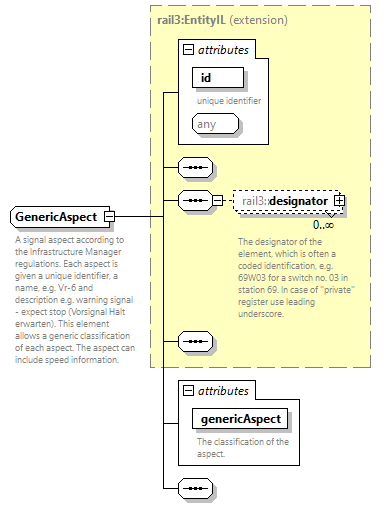 | ||||||||||||||||||||||
| namespace | https://www.railml.org/schemas/3.2 | ||||||||||||||||||||||
| type | extension of rail3:EntityIL | ||||||||||||||||||||||
| properties |
| ||||||||||||||||||||||
| children | rail3:designator | ||||||||||||||||||||||
| used by |
| ||||||||||||||||||||||
| attributes |
| ||||||||||||||||||||||
| annotation |
| ||||||||||||||||||||||
| source | <xs:complexType name="GenericAspect"> <xs:annotation> <xs:documentation>A signal aspect according to the Infrastructure Manager regulations. Each aspect is given a unique identifier, a name, e.g. Vr-6 and description e.g. warning signal - expect stop (Vorsignal Halt erwarten). This element allows a generic classification of each aspect. The aspect can include speed information.</xs:documentation> </xs:annotation> <xs:complexContent> <xs:extension base="rail3:EntityIL"> <xs:sequence/> <xs:attribute name="genericAspect" type="rail3:tGenericAspectList" use="required"> <xs:annotation> <xs:documentation>The classification of the aspect.</xs:documentation> </xs:annotation> </xs:attribute> </xs:extension> </xs:complexContent> </xs:complexType> |
attribute GenericAspect/@genericAspect
| type | rail3:tGenericAspectList | |||||||||||||||||||||||||||||||||||||||||||||||||||||
| properties |
| |||||||||||||||||||||||||||||||||||||||||||||||||||||
| facets |
| |||||||||||||||||||||||||||||||||||||||||||||||||||||
| annotation |
| |||||||||||||||||||||||||||||||||||||||||||||||||||||
| source | <xs:attribute name="genericAspect" type="rail3:tGenericAspectList" use="required"> <xs:annotation> <xs:documentation>The classification of the aspect.</xs:documentation> </xs:annotation> </xs:attribute> |
complexType GenericDetector
| diagram |  | ||||||||||||||||||||||||||||||||||||||||||||||||||||||||||||||||||||||||||||||
| namespace | https://www.railml.org/schemas/3.2 | ||||||||||||||||||||||||||||||||||||||||||||||||||||||||||||||||||||||||||||||
| type | extension of rail3:LogicalDevice | ||||||||||||||||||||||||||||||||||||||||||||||||||||||||||||||||||||||||||||||
| properties |
| ||||||||||||||||||||||||||||||||||||||||||||||||||||||||||||||||||||||||||||||
| children | rail3:designator rail3:assetName rail3:belongsToOperationalPoint rail3:hasCommand rail3:hasIndication rail3:takesControlOf rail3:hasInterface rail3:refersTo rail3:detectorType | ||||||||||||||||||||||||||||||||||||||||||||||||||||||||||||||||||||||||||||||
| used by |
| ||||||||||||||||||||||||||||||||||||||||||||||||||||||||||||||||||||||||||||||
| attributes |
| ||||||||||||||||||||||||||||||||||||||||||||||||||||||||||||||||||||||||||||||
| annotation |
| ||||||||||||||||||||||||||||||||||||||||||||||||||||||||||||||||||||||||||||||
| source | <xs:complexType name="GenericDetector"> <xs:annotation> <xs:documentation>Detectors are devices detecting the exceeding of a particular characteristic and providing an output to the interlocking. Depending on the function it may influence the route signalling.</xs:documentation> </xs:annotation> <xs:complexContent> <xs:extension base="rail3:LogicalDevice"> <xs:sequence> <xs:element name="detectorType" type="rail3:EntityILref" minOccurs="1" maxOccurs="1"> <xs:annotation> <xs:documentation>The reference to the particular detector type.</xs:documentation> </xs:annotation> </xs:element> </xs:sequence> <xs:attribute name="affectsRouteSignalling" type="xs:boolean" use="optional"> <xs:annotation> <xs:documentation>indication whether the signalling of a related route is affected by the detector status</xs:documentation> </xs:annotation> </xs:attribute> <xs:attribute name="allowsPermanentOverride" type="xs:boolean" use="optional"> <xs:annotation> <xs:documentation>The detector output may be permanently overridden by special command.</xs:documentation> </xs:annotation> </xs:attribute> <xs:attribute name="allowsSingleOverride" type="xs:boolean" use="optional"> <xs:annotation> <xs:documentation>The detector output may be overridden once by special command.</xs:documentation> </xs:annotation> </xs:attribute> <xs:attribute name="hasTriggeredSelfTest" type="xs:boolean" use="optional"> <xs:annotation> <xs:documentation>The detector may have a self-test which is to be triggered from the interlocking.</xs:documentation> </xs:annotation> </xs:attribute> <xs:attribute name="selfTestInterval" type="xs:duration" use="optional"> <xs:annotation> <xs:documentation>The interval at which the self-test is running, i.e. automatically initiated or triggered from interlocking.</xs:documentation> </xs:annotation> </xs:attribute> <xs:attribute name="selfTestToleranceTime" type="xs:duration" use="optional"> <xs:annotation> <xs:documentation>The time period for which the detector output shall be tolerated due to running self-test.</xs:documentation> </xs:annotation> </xs:attribute> </xs:extension> </xs:complexContent> </xs:complexType> |
attribute GenericDetector/@affectsRouteSignalling
| type | xs:boolean | ||
| properties |
| ||
| annotation |
| ||
| source | <xs:attribute name="affectsRouteSignalling" type="xs:boolean" use="optional"> <xs:annotation> <xs:documentation>indication whether the signalling of a related route is affected by the detector status</xs:documentation> </xs:annotation> </xs:attribute> |
attribute GenericDetector/@allowsPermanentOverride
| type | xs:boolean | ||
| properties |
| ||
| annotation |
| ||
| source | <xs:attribute name="allowsPermanentOverride" type="xs:boolean" use="optional"> <xs:annotation> <xs:documentation>The detector output may be permanently overridden by special command.</xs:documentation> </xs:annotation> </xs:attribute> |
attribute GenericDetector/@allowsSingleOverride
| type | xs:boolean | ||
| properties |
| ||
| annotation |
| ||
| source | <xs:attribute name="allowsSingleOverride" type="xs:boolean" use="optional"> <xs:annotation> <xs:documentation>The detector output may be overridden once by special command.</xs:documentation> </xs:annotation> </xs:attribute> |
attribute GenericDetector/@hasTriggeredSelfTest
| type | xs:boolean | ||
| properties |
| ||
| annotation |
| ||
| source | <xs:attribute name="hasTriggeredSelfTest" type="xs:boolean" use="optional"> <xs:annotation> <xs:documentation>The detector may have a self-test which is to be triggered from the interlocking.</xs:documentation> </xs:annotation> </xs:attribute> |
attribute GenericDetector/@selfTestInterval
| type | xs:duration | ||
| properties |
| ||
| annotation |
| ||
| source | <xs:attribute name="selfTestInterval" type="xs:duration" use="optional"> <xs:annotation> <xs:documentation>The interval at which the self-test is running, i.e. automatically initiated or triggered from interlocking.</xs:documentation> </xs:annotation> </xs:attribute> |
attribute GenericDetector/@selfTestToleranceTime
| type | xs:duration | ||
| properties |
| ||
| annotation |
| ||
| source | <xs:attribute name="selfTestToleranceTime" type="xs:duration" use="optional"> <xs:annotation> <xs:documentation>The time period for which the detector output shall be tolerated due to running self-test.</xs:documentation> </xs:annotation> </xs:attribute> |
element GenericDetector/detectorType
| diagram | 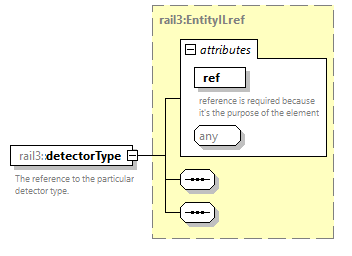 | ||||||||||||||
| namespace | https://www.railml.org/schemas/3.2 | ||||||||||||||
| type | rail3:EntityILref | ||||||||||||||
| properties |
| ||||||||||||||
| attributes |
| ||||||||||||||
| annotation |
| ||||||||||||||
| source | <xs:element name="detectorType" type="rail3:EntityILref" minOccurs="1" maxOccurs="1"> <xs:annotation> <xs:documentation>The reference to the particular detector type.</xs:documentation> </xs:annotation> </xs:element> |
complexType GenericDetectors
| diagram |  | ||
| namespace | https://www.railml.org/schemas/3.2 | ||
| children | rail3:genericDetector | ||
| used by |
| ||
| annotation |
| ||
| source | <xs:complexType name="GenericDetectors"> <xs:annotation> <xs:documentation>contains all GenericDetector elements</xs:documentation> </xs:annotation> <xs:sequence> <xs:element name="genericDetector" type="rail3:GenericDetector" minOccurs="1" maxOccurs="unbounded"> <xs:annotation> <xs:documentation>Device for detecting the exceeding of a particular characteristic.</xs:documentation> </xs:annotation> </xs:element> </xs:sequence> </xs:complexType> |
element GenericDetectors/genericDetector
| diagram |  | ||||||||||||||||||||||||||||||||||||||||||||||||||||||||||||||||||||||||||||||
| namespace | https://www.railml.org/schemas/3.2 | ||||||||||||||||||||||||||||||||||||||||||||||||||||||||||||||||||||||||||||||
| type | rail3:GenericDetector | ||||||||||||||||||||||||||||||||||||||||||||||||||||||||||||||||||||||||||||||
| properties |
| ||||||||||||||||||||||||||||||||||||||||||||||||||||||||||||||||||||||||||||||
| children | rail3:designator rail3:assetName rail3:belongsToOperationalPoint rail3:hasCommand rail3:hasIndication rail3:takesControlOf rail3:hasInterface rail3:refersTo rail3:detectorType | ||||||||||||||||||||||||||||||||||||||||||||||||||||||||||||||||||||||||||||||
| attributes |
| ||||||||||||||||||||||||||||||||||||||||||||||||||||||||||||||||||||||||||||||
| annotation |
| ||||||||||||||||||||||||||||||||||||||||||||||||||||||||||||||||||||||||||||||
| source | <xs:element name="genericDetector" type="rail3:GenericDetector" minOccurs="1" maxOccurs="unbounded"> <xs:annotation> <xs:documentation>Device for detecting the exceeding of a particular characteristic.</xs:documentation> </xs:annotation> </xs:element> |
complexType GenericInfrastructureManager
| diagram | 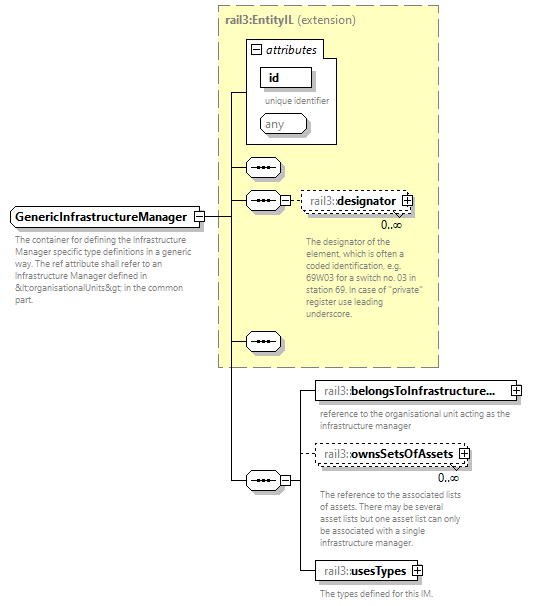 | ||||||||||||||
| namespace | https://www.railml.org/schemas/3.2 | ||||||||||||||
| type | extension of rail3:EntityIL | ||||||||||||||
| properties |
| ||||||||||||||
| children | rail3:designator rail3:belongsToInfrastructureManager rail3:ownsSetsOfAssets rail3:usesTypes | ||||||||||||||
| used by |
| ||||||||||||||
| attributes |
| ||||||||||||||
| annotation |
| ||||||||||||||
| source | <xs:complexType name="GenericInfrastructureManager"> <xs:annotation> <xs:documentation>The container for defining the Infrastructure Manager specific type definitions in a generic way. The ref attribute shall refer to an Infrastructure Manager defined in <organisationalUnits> in the common part.</xs:documentation> </xs:annotation> <xs:complexContent> <xs:extension base="rail3:EntityIL"> <xs:sequence> <xs:element name="belongsToInfrastructureManager" type="rail3:EntityILref" minOccurs="1" maxOccurs="1"> <xs:annotation> <xs:documentation>reference to the organisational unit acting as the infrastructure manager</xs:documentation> </xs:annotation> </xs:element> <xs:element name="ownsSetsOfAssets" type="rail3:EntityILref" minOccurs="0" maxOccurs="unbounded"> <xs:annotation> <xs:documentation>The reference to the associated lists of assets. There may be several asset lists but one asset list can only be associated with a single infrastructure manager.</xs:documentation> </xs:annotation> </xs:element> <xs:element name="usesTypes" type="rail3:GenericTypes" minOccurs="1" maxOccurs="1"> <xs:annotation> <xs:documentation>The types defined for this IM.</xs:documentation> </xs:annotation> </xs:element> </xs:sequence> </xs:extension> </xs:complexContent> </xs:complexType> |
element GenericInfrastructureManager/belongsToInfrastructureManager
| diagram | 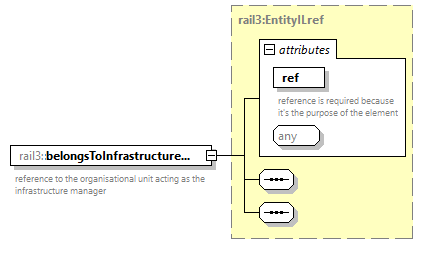 | ||||||||||||||
| namespace | https://www.railml.org/schemas/3.2 | ||||||||||||||
| type | rail3:EntityILref | ||||||||||||||
| properties |
| ||||||||||||||
| attributes |
| ||||||||||||||
| annotation |
| ||||||||||||||
| source | <xs:element name="belongsToInfrastructureManager" type="rail3:EntityILref" minOccurs="1" maxOccurs="1"> <xs:annotation> <xs:documentation>reference to the organisational unit acting as the infrastructure manager</xs:documentation> </xs:annotation> </xs:element> |
element GenericInfrastructureManager/ownsSetsOfAssets
| diagram | 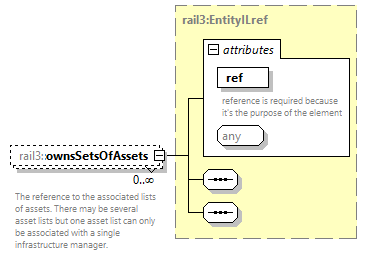 | ||||||||||||||
| namespace | https://www.railml.org/schemas/3.2 | ||||||||||||||
| type | rail3:EntityILref | ||||||||||||||
| properties |
| ||||||||||||||
| attributes |
| ||||||||||||||
| annotation |
| ||||||||||||||
| source | <xs:element name="ownsSetsOfAssets" type="rail3:EntityILref" minOccurs="0" maxOccurs="unbounded"> <xs:annotation> <xs:documentation>The reference to the associated lists of assets. There may be several asset lists but one asset list can only be associated with a single infrastructure manager.</xs:documentation> </xs:annotation> </xs:element> |
element GenericInfrastructureManager/usesTypes
| diagram | 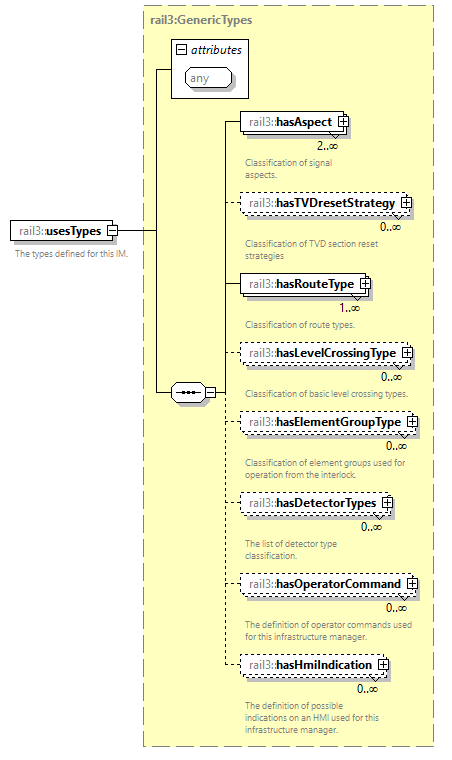 | ||||||
| namespace | https://www.railml.org/schemas/3.2 | ||||||
| type | rail3:GenericTypes | ||||||
| properties |
| ||||||
| children | rail3:hasAspect rail3:hasTVDresetStrategy rail3:hasRouteType rail3:hasLevelCrossingType rail3:hasElementGroupType rail3:hasDetectorTypes rail3:hasOperatorCommand rail3:hasHmiIndication | ||||||
| attributes |
| ||||||
| annotation |
| ||||||
| source | <xs:element name="usesTypes" type="rail3:GenericTypes" minOccurs="1" maxOccurs="1"> <xs:annotation> <xs:documentation>The types defined for this IM.</xs:documentation> </xs:annotation> </xs:element> |
complexType GenericInfrastructureManagers
| diagram |  | ||
| namespace | https://www.railml.org/schemas/3.2 | ||
| children | rail3:specificInfrastructureManager | ||
| used by |
| ||
| annotation |
| ||
| source | <xs:complexType name="GenericInfrastructureManagers"> <xs:annotation> <xs:documentation>container element for all specificInfrastructureManager elements</xs:documentation> </xs:annotation> <xs:sequence minOccurs="0" maxOccurs="1"> <xs:element name="specificInfrastructureManager" type="rail3:GenericInfrastructureManager" minOccurs="1" maxOccurs="unbounded"> <xs:annotation> <xs:documentation>Container with the generic classification of types used by a specific infrastructure manager.</xs:documentation> </xs:annotation> </xs:element> </xs:sequence> </xs:complexType> |
element GenericInfrastructureManagers/specificInfrastructureManager
| diagram | 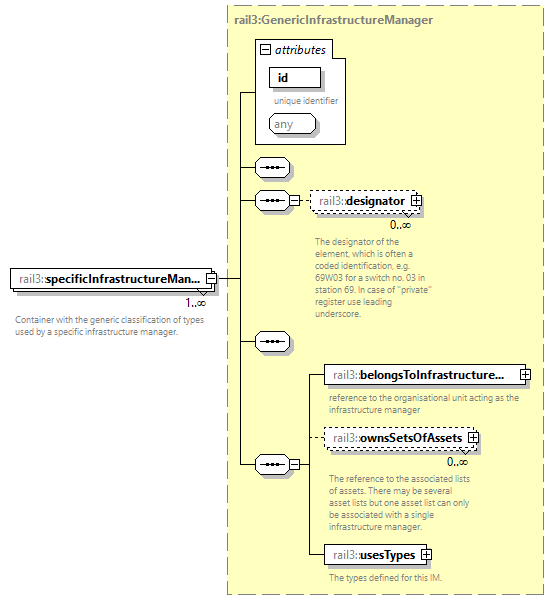 | ||||||||||||||
| namespace | https://www.railml.org/schemas/3.2 | ||||||||||||||
| type | rail3:GenericInfrastructureManager | ||||||||||||||
| properties |
| ||||||||||||||
| children | rail3:designator rail3:belongsToInfrastructureManager rail3:ownsSetsOfAssets rail3:usesTypes | ||||||||||||||
| attributes |
| ||||||||||||||
| annotation |
| ||||||||||||||
| source | <xs:element name="specificInfrastructureManager" type="rail3:GenericInfrastructureManager" minOccurs="1" maxOccurs="unbounded"> <xs:annotation> <xs:documentation>Container with the generic classification of types used by a specific infrastructure manager.</xs:documentation> </xs:annotation> </xs:element> |
complexType GenericResetStrategy
| diagram | 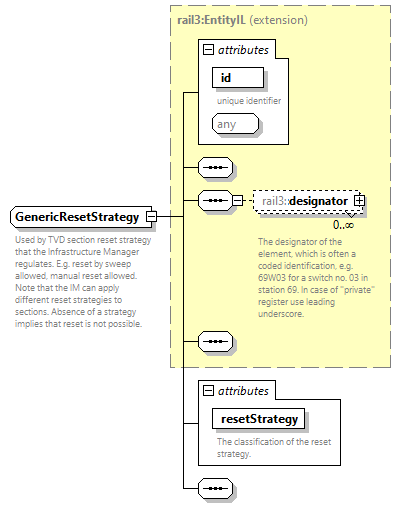 | ||||||||||||||||||||||
| namespace | https://www.railml.org/schemas/3.2 | ||||||||||||||||||||||
| type | extension of rail3:EntityIL | ||||||||||||||||||||||
| properties |
| ||||||||||||||||||||||
| children | rail3:designator | ||||||||||||||||||||||
| used by |
| ||||||||||||||||||||||
| attributes |
| ||||||||||||||||||||||
| annotation |
| ||||||||||||||||||||||
| source | <xs:complexType name="GenericResetStrategy"> <xs:annotation> <xs:documentation>Used by TVD section reset strategy that the Infrastructure Manager regulates. E.g. reset by sweep allowed, manual reset allowed. Note that the IM can apply different reset strategies to sections. Absence of a strategy implies that reset is not possible.</xs:documentation> </xs:annotation> <xs:complexContent> <xs:extension base="rail3:EntityIL"> <xs:sequence/> <xs:attribute name="resetStrategy" type="rail3:tGenericResetStrategyList" use="required"> <xs:annotation> <xs:documentation>The classification of the reset strategy.</xs:documentation> </xs:annotation> </xs:attribute> </xs:extension> </xs:complexContent> </xs:complexType> |
attribute GenericResetStrategy/@resetStrategy
| type | rail3:tGenericResetStrategyList | ||||||||||||||||||||||||||||
| properties |
| ||||||||||||||||||||||||||||
| facets |
| ||||||||||||||||||||||||||||
| annotation |
| ||||||||||||||||||||||||||||
| source | <xs:attribute name="resetStrategy" type="rail3:tGenericResetStrategyList" use="required"> <xs:annotation> <xs:documentation>The classification of the reset strategy.</xs:documentation> </xs:annotation> </xs:attribute> |
complexType GenericRouteType
| diagram | 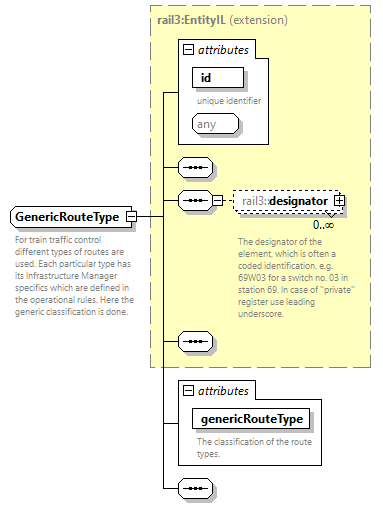 | ||||||||||||||||||||||
| namespace | https://www.railml.org/schemas/3.2 | ||||||||||||||||||||||
| type | extension of rail3:EntityIL | ||||||||||||||||||||||
| properties |
| ||||||||||||||||||||||
| children | rail3:designator | ||||||||||||||||||||||
| used by |
| ||||||||||||||||||||||
| attributes |
| ||||||||||||||||||||||
| annotation |
| ||||||||||||||||||||||
| source | <xs:complexType name="GenericRouteType"> <xs:annotation> <xs:documentation>For train traffic control different types of routes are used. Each particular type has its Infrastructure Manager specifics which are defined in the operational rules. Here the generic classification is done.</xs:documentation> </xs:annotation> <xs:complexContent> <xs:extension base="rail3:EntityIL"> <xs:sequence/> <xs:attribute name="genericRouteType" type="rail3:tGenericRouteTypeExt" use="required"> <xs:annotation> <xs:documentation>The classification of the route types.</xs:documentation> </xs:annotation> </xs:attribute> </xs:extension> </xs:complexContent> </xs:complexType> |
attribute GenericRouteType/@genericRouteType
| type | rail3:tGenericRouteTypeExt | ||
| properties |
| ||
| annotation |
| ||
| source | <xs:attribute name="genericRouteType" type="rail3:tGenericRouteTypeExt" use="required"> <xs:annotation> <xs:documentation>The classification of the route types.</xs:documentation> </xs:annotation> </xs:attribute> |
complexType GenericTypes
| diagram | 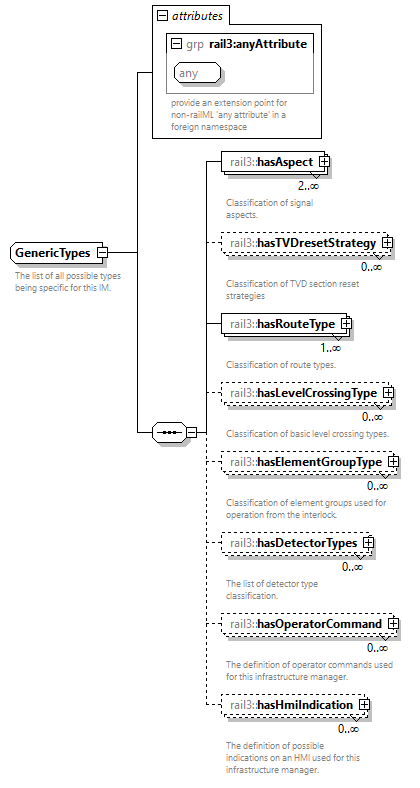 | ||||||
| namespace | https://www.railml.org/schemas/3.2 | ||||||
| children | rail3:hasAspect rail3:hasTVDresetStrategy rail3:hasRouteType rail3:hasLevelCrossingType rail3:hasElementGroupType rail3:hasDetectorTypes rail3:hasOperatorCommand rail3:hasHmiIndication | ||||||
| used by |
| ||||||
| attributes |
| ||||||
| annotation |
| ||||||
| source | <xs:complexType name="GenericTypes"> <xs:annotation> <xs:documentation>The list of all possible types being specific for this IM.</xs:documentation> </xs:annotation> <xs:sequence> <xs:element name="hasAspect" type="rail3:GenericAspect" minOccurs="2" maxOccurs="unbounded"> <xs:annotation> <xs:documentation>Classification of signal aspects.</xs:documentation> </xs:annotation> </xs:element> <xs:element name="hasTVDresetStrategy" type="rail3:GenericResetStrategy" minOccurs="0" maxOccurs="unbounded"> <xs:annotation> <xs:documentation>Classification of TVD section reset strategies</xs:documentation> </xs:annotation> </xs:element> <xs:element name="hasRouteType" type="rail3:GenericRouteType" minOccurs="1" maxOccurs="unbounded"> <xs:annotation> <xs:documentation>Classification of route types.</xs:documentation> </xs:annotation> </xs:element> <xs:element name="hasLevelCrossingType" type="rail3:LevelCrossingTypeList" minOccurs="0" maxOccurs="unbounded"> <xs:annotation> <xs:documentation>Classification of basic level crossing types.</xs:documentation> </xs:annotation> </xs:element> <xs:element name="hasElementGroupType" type="rail3:ElementGroupingTypes" minOccurs="0" maxOccurs="unbounded"> <xs:annotation> <xs:documentation>Classification of element groups used for operation from the interlock.</xs:documentation> </xs:annotation> </xs:element> <xs:element name="hasDetectorTypes" type="rail3:DetectorTypes" minOccurs="0" maxOccurs="unbounded"> <xs:annotation> <xs:documentation>The list of detector type classification.</xs:documentation> </xs:annotation> </xs:element> <xs:element name="hasOperatorCommand" type="rail3:OperatorCommand" minOccurs="0" maxOccurs="unbounded"> <xs:annotation> <xs:documentation>The definition of operator commands used for this infrastructure manager.</xs:documentation> </xs:annotation> </xs:element> <xs:element name="hasHmiIndication" type="rail3:Indication" minOccurs="0" maxOccurs="unbounded"> <xs:annotation> <xs:documentation>The definition of possible indications on an HMI used for this infrastructure manager.</xs:documentation> </xs:annotation> </xs:element> </xs:sequence> <xs:attributeGroup ref="rail3:anyAttribute"/> </xs:complexType> |
element GenericTypes/hasAspect
| diagram | 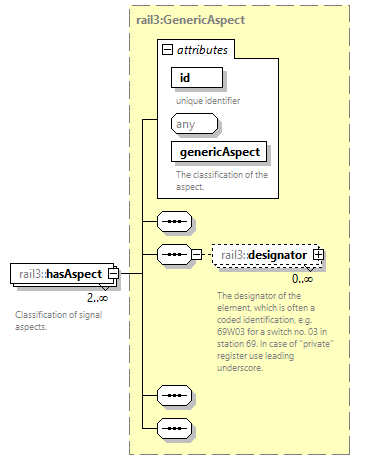 | ||||||||||||||||||||||
| namespace | https://www.railml.org/schemas/3.2 | ||||||||||||||||||||||
| type | rail3:GenericAspect | ||||||||||||||||||||||
| properties |
| ||||||||||||||||||||||
| children | rail3:designator | ||||||||||||||||||||||
| attributes |
| ||||||||||||||||||||||
| annotation |
| ||||||||||||||||||||||
| source | <xs:element name="hasAspect" type="rail3:GenericAspect" minOccurs="2" maxOccurs="unbounded"> <xs:annotation> <xs:documentation>Classification of signal aspects.</xs:documentation> </xs:annotation> </xs:element> |
element GenericTypes/hasTVDresetStrategy
| diagram | 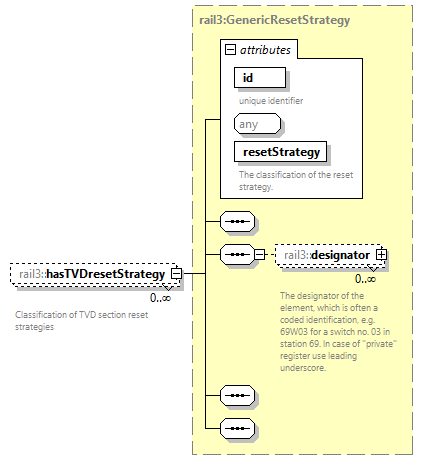 | ||||||||||||||||||||||
| namespace | https://www.railml.org/schemas/3.2 | ||||||||||||||||||||||
| type | rail3:GenericResetStrategy | ||||||||||||||||||||||
| properties |
| ||||||||||||||||||||||
| children | rail3:designator | ||||||||||||||||||||||
| attributes |
| ||||||||||||||||||||||
| annotation |
| ||||||||||||||||||||||
| source | <xs:element name="hasTVDresetStrategy" type="rail3:GenericResetStrategy" minOccurs="0" maxOccurs="unbounded"> <xs:annotation> <xs:documentation>Classification of TVD section reset strategies</xs:documentation> </xs:annotation> </xs:element> |
element GenericTypes/hasRouteType
| diagram | 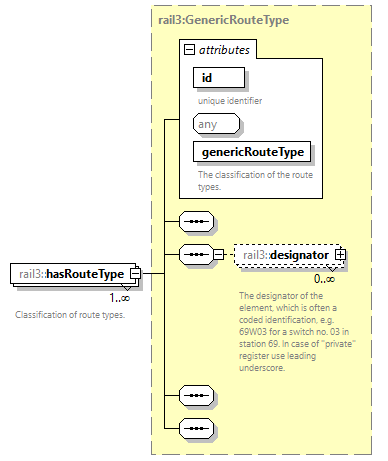 | ||||||||||||||||||||||
| namespace | https://www.railml.org/schemas/3.2 | ||||||||||||||||||||||
| type | rail3:GenericRouteType | ||||||||||||||||||||||
| properties |
| ||||||||||||||||||||||
| children | rail3:designator | ||||||||||||||||||||||
| attributes |
| ||||||||||||||||||||||
| annotation |
| ||||||||||||||||||||||
| source | <xs:element name="hasRouteType" type="rail3:GenericRouteType" minOccurs="1" maxOccurs="unbounded"> <xs:annotation> <xs:documentation>Classification of route types.</xs:documentation> </xs:annotation> </xs:element> |
element GenericTypes/hasLevelCrossingType
| diagram | 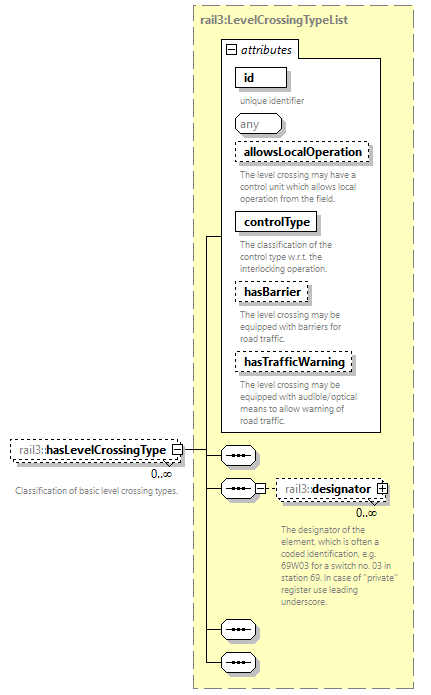 | ||||||||||||||||||||||||||||||||||||||||||||||
| namespace | https://www.railml.org/schemas/3.2 | ||||||||||||||||||||||||||||||||||||||||||||||
| type | rail3:LevelCrossingTypeList | ||||||||||||||||||||||||||||||||||||||||||||||
| properties |
| ||||||||||||||||||||||||||||||||||||||||||||||
| children | rail3:designator | ||||||||||||||||||||||||||||||||||||||||||||||
| attributes |
| ||||||||||||||||||||||||||||||||||||||||||||||
| annotation |
| ||||||||||||||||||||||||||||||||||||||||||||||
| source | <xs:element name="hasLevelCrossingType" type="rail3:LevelCrossingTypeList" minOccurs="0" maxOccurs="unbounded"> <xs:annotation> <xs:documentation>Classification of basic level crossing types.</xs:documentation> </xs:annotation> </xs:element> |
element GenericTypes/hasElementGroupType
| diagram | 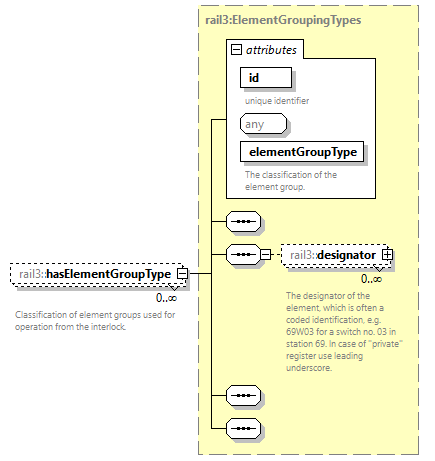 | ||||||||||||||||||||||
| namespace | https://www.railml.org/schemas/3.2 | ||||||||||||||||||||||
| type | rail3:ElementGroupingTypes | ||||||||||||||||||||||
| properties |
| ||||||||||||||||||||||
| children | rail3:designator | ||||||||||||||||||||||
| attributes |
| ||||||||||||||||||||||
| annotation |
| ||||||||||||||||||||||
| source | <xs:element name="hasElementGroupType" type="rail3:ElementGroupingTypes" minOccurs="0" maxOccurs="unbounded"> <xs:annotation> <xs:documentation>Classification of element groups used for operation from the interlock.</xs:documentation> </xs:annotation> </xs:element> |
element GenericTypes/hasDetectorTypes
| diagram | 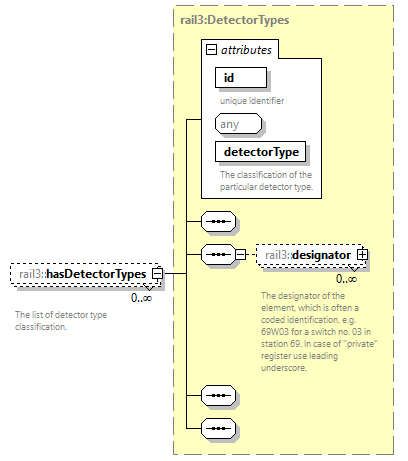 | ||||||||||||||||||||||
| namespace | https://www.railml.org/schemas/3.2 | ||||||||||||||||||||||
| type | rail3:DetectorTypes | ||||||||||||||||||||||
| properties |
| ||||||||||||||||||||||
| children | rail3:designator | ||||||||||||||||||||||
| attributes |
| ||||||||||||||||||||||
| annotation |
| ||||||||||||||||||||||
| source | <xs:element name="hasDetectorTypes" type="rail3:DetectorTypes" minOccurs="0" maxOccurs="unbounded"> <xs:annotation> <xs:documentation>The list of detector type classification.</xs:documentation> </xs:annotation> </xs:element> |
element GenericTypes/hasOperatorCommand
| diagram | 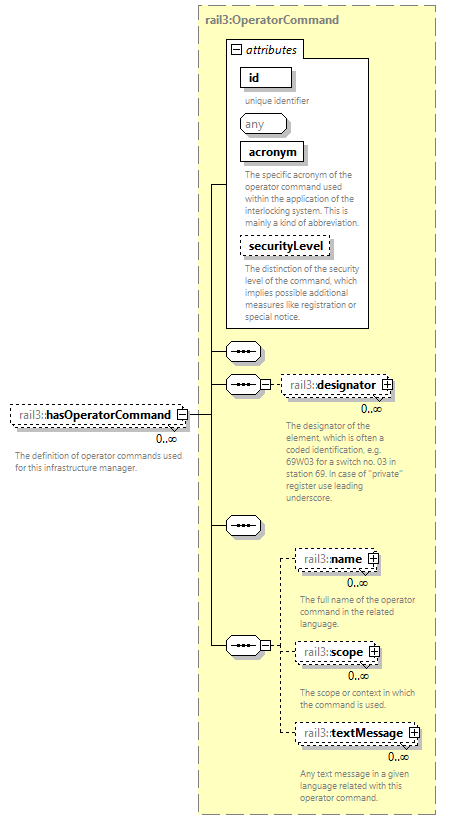 | ||||||||||||||||||||||||||||||
| namespace | https://www.railml.org/schemas/3.2 | ||||||||||||||||||||||||||||||
| type | rail3:OperatorCommand | ||||||||||||||||||||||||||||||
| properties |
| ||||||||||||||||||||||||||||||
| children | rail3:designator rail3:name rail3:scope rail3:textMessage | ||||||||||||||||||||||||||||||
| attributes |
| ||||||||||||||||||||||||||||||
| annotation |
| ||||||||||||||||||||||||||||||
| source | <xs:element name="hasOperatorCommand" type="rail3:OperatorCommand" minOccurs="0" maxOccurs="unbounded"> <xs:annotation> <xs:documentation>The definition of operator commands used for this infrastructure manager.</xs:documentation> </xs:annotation> </xs:element> |
element GenericTypes/hasHmiIndication
| diagram | 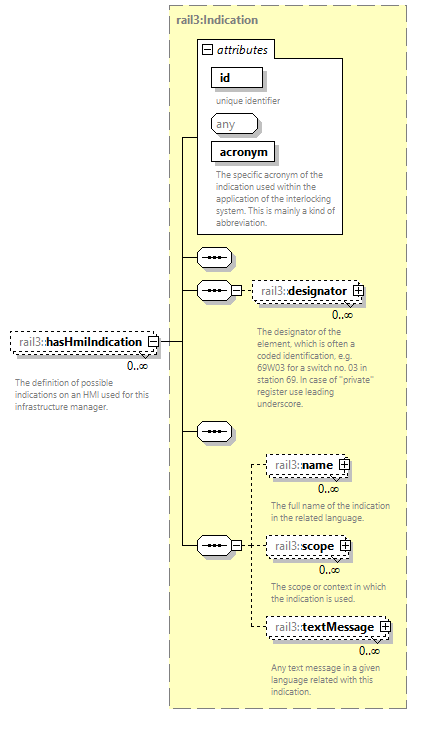 | ||||||||||||||||||||||
| namespace | https://www.railml.org/schemas/3.2 | ||||||||||||||||||||||
| type | rail3:Indication | ||||||||||||||||||||||
| properties |
| ||||||||||||||||||||||
| children | rail3:designator rail3:name rail3:scope rail3:textMessage | ||||||||||||||||||||||
| attributes |
| ||||||||||||||||||||||
| annotation |
| ||||||||||||||||||||||
| source | <xs:element name="hasHmiIndication" type="rail3:Indication" minOccurs="0" maxOccurs="unbounded"> <xs:annotation> <xs:documentation>The definition of possible indications on an HMI used for this infrastructure manager.</xs:documentation> </xs:annotation> </xs:element> |
complexType IndicatingObject
| diagram | 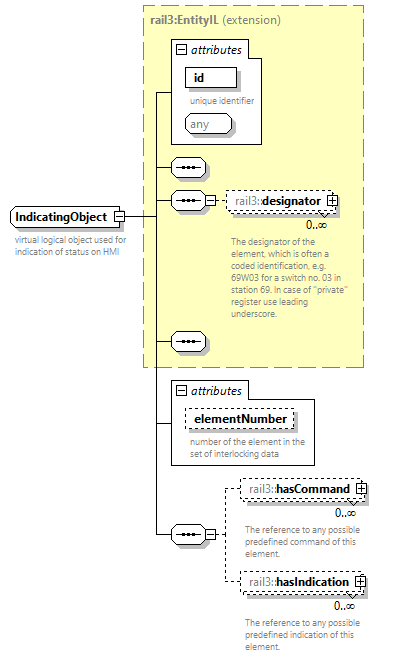 | ||||||||||||||||||||||
| namespace | https://www.railml.org/schemas/3.2 | ||||||||||||||||||||||
| type | extension of rail3:EntityIL | ||||||||||||||||||||||
| properties |
| ||||||||||||||||||||||
| children | rail3:designator rail3:hasCommand rail3:hasIndication | ||||||||||||||||||||||
| used by |
| ||||||||||||||||||||||
| attributes |
| ||||||||||||||||||||||
| annotation |
| ||||||||||||||||||||||
| source | <xs:complexType name="IndicatingObject" abstract="true"> <xs:annotation> <xs:documentation>virtual logical object used for indication of status on HMI</xs:documentation> </xs:annotation> <xs:complexContent> <xs:extension base="rail3:EntityIL"> <xs:sequence> <xs:element name="hasCommand" type="rail3:CodedEntityILref" minOccurs="0" maxOccurs="unbounded"> <xs:annotation> <xs:documentation>The reference to any possible predefined command of this element.</xs:documentation> </xs:annotation> </xs:element> <xs:element name="hasIndication" type="rail3:CodedEntityILref" minOccurs="0" maxOccurs="unbounded"> <xs:annotation> <xs:documentation>The reference to any possible predefined indication of this element.</xs:documentation> </xs:annotation> </xs:element> </xs:sequence> <xs:attribute name="elementNumber" type="xs:nonNegativeInteger" use="optional"> <xs:annotation> <xs:documentation>number of the element in the set of interlocking data</xs:documentation> </xs:annotation> </xs:attribute> </xs:extension> </xs:complexContent> </xs:complexType> |
attribute IndicatingObject/@elementNumber
| type | xs:nonNegativeInteger | ||
| properties |
| ||
| annotation |
| ||
| source | <xs:attribute name="elementNumber" type="xs:nonNegativeInteger" use="optional"> <xs:annotation> <xs:documentation>number of the element in the set of interlocking data</xs:documentation> </xs:annotation> </xs:attribute> |
element IndicatingObject/hasCommand
| diagram | 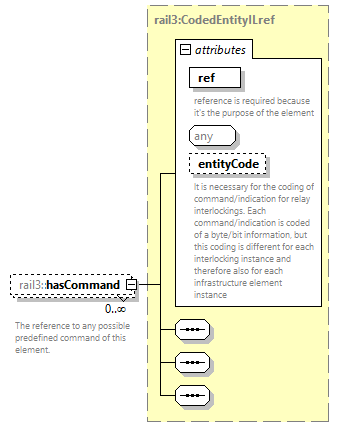 | ||||||||||||||||||||||
| namespace | https://www.railml.org/schemas/3.2 | ||||||||||||||||||||||
| type | rail3:CodedEntityILref | ||||||||||||||||||||||
| properties |
| ||||||||||||||||||||||
| attributes |
| ||||||||||||||||||||||
| annotation |
| ||||||||||||||||||||||
| source | <xs:element name="hasCommand" type="rail3:CodedEntityILref" minOccurs="0" maxOccurs="unbounded"> <xs:annotation> <xs:documentation>The reference to any possible predefined command of this element.</xs:documentation> </xs:annotation> </xs:element> |
element IndicatingObject/hasIndication
| diagram | 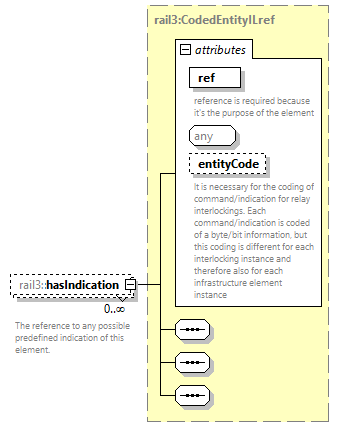 | ||||||||||||||||||||||
| namespace | https://www.railml.org/schemas/3.2 | ||||||||||||||||||||||
| type | rail3:CodedEntityILref | ||||||||||||||||||||||
| properties |
| ||||||||||||||||||||||
| attributes |
| ||||||||||||||||||||||
| annotation |
| ||||||||||||||||||||||
| source | <xs:element name="hasIndication" type="rail3:CodedEntityILref" minOccurs="0" maxOccurs="unbounded"> <xs:annotation> <xs:documentation>The reference to any possible predefined indication of this element.</xs:documentation> </xs:annotation> </xs:element> |
complexType Indication
| diagram | 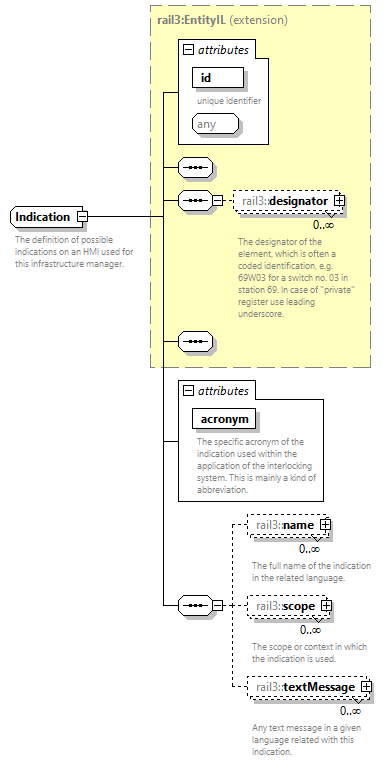 | ||||||||||||||||||||||
| namespace | https://www.railml.org/schemas/3.2 | ||||||||||||||||||||||
| type | extension of rail3:EntityIL | ||||||||||||||||||||||
| properties |
| ||||||||||||||||||||||
| children | rail3:designator rail3:name rail3:scope rail3:textMessage | ||||||||||||||||||||||
| used by |
| ||||||||||||||||||||||
| attributes |
| ||||||||||||||||||||||
| annotation |
| ||||||||||||||||||||||
| source | <xs:complexType name="Indication"> <xs:annotation> <xs:documentation>The definition of possible indications on an HMI used for this infrastructure manager.</xs:documentation> </xs:annotation> <xs:complexContent> <xs:extension base="rail3:EntityIL"> <xs:sequence> <xs:element name="name" type="rail3:Name" minOccurs="0" maxOccurs="unbounded"> <xs:annotation> <xs:documentation>The full name of the indication in the related language.</xs:documentation> </xs:annotation> </xs:element> <xs:element name="scope" type="rail3:Scope" minOccurs="0" maxOccurs="unbounded"> <xs:annotation> <xs:documentation>The scope or context in which the indication is used.</xs:documentation> </xs:annotation> </xs:element> <xs:element name="textMessage" type="rail3:Name" minOccurs="0" maxOccurs="unbounded"> <xs:annotation> <xs:documentation>Any text message in a given language related with this indication.</xs:documentation> </xs:annotation> </xs:element> </xs:sequence> <xs:attribute name="acronym" type="xs:NMTOKEN" use="required"> <xs:annotation> <xs:documentation>The specific acronym of the indication used within the application of the interlocking system. This is mainly a kind of abbreviation.</xs:documentation> </xs:annotation> </xs:attribute> </xs:extension> </xs:complexContent> </xs:complexType> |
attribute Indication/@acronym
| type | xs:NMTOKEN | ||
| properties |
| ||
| annotation |
| ||
| source | <xs:attribute name="acronym" type="xs:NMTOKEN" use="required"> <xs:annotation> <xs:documentation>The specific acronym of the indication used within the application of the interlocking system. This is mainly a kind of abbreviation.</xs:documentation> </xs:annotation> </xs:attribute> |
element Indication/name
| diagram | 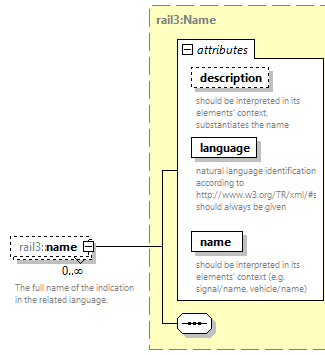 | ||||||||||||||||||||||||||||||
| namespace | https://www.railml.org/schemas/3.2 | ||||||||||||||||||||||||||||||
| type | rail3:Name | ||||||||||||||||||||||||||||||
| properties |
| ||||||||||||||||||||||||||||||
| attributes |
| ||||||||||||||||||||||||||||||
| annotation |
| ||||||||||||||||||||||||||||||
| source | <xs:element name="name" type="rail3:Name" minOccurs="0" maxOccurs="unbounded"> <xs:annotation> <xs:documentation>The full name of the indication in the related language.</xs:documentation> </xs:annotation> </xs:element> |
element Indication/scope
| diagram | 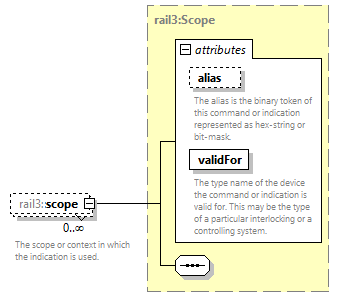 | ||||||||||||||||||||||
| namespace | https://www.railml.org/schemas/3.2 | ||||||||||||||||||||||
| type | rail3:Scope | ||||||||||||||||||||||
| properties |
| ||||||||||||||||||||||
| attributes |
| ||||||||||||||||||||||
| annotation |
| ||||||||||||||||||||||
| source | <xs:element name="scope" type="rail3:Scope" minOccurs="0" maxOccurs="unbounded"> <xs:annotation> <xs:documentation>The scope or context in which the indication is used.</xs:documentation> </xs:annotation> </xs:element> |
element Indication/textMessage
| diagram | 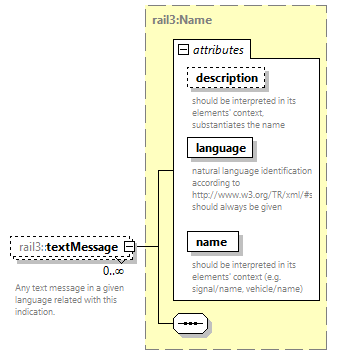 | ||||||||||||||||||||||||||||||
| namespace | https://www.railml.org/schemas/3.2 | ||||||||||||||||||||||||||||||
| type | rail3:Name | ||||||||||||||||||||||||||||||
| properties |
| ||||||||||||||||||||||||||||||
| attributes |
| ||||||||||||||||||||||||||||||
| annotation |
| ||||||||||||||||||||||||||||||
| source | <xs:element name="textMessage" type="rail3:Name" minOccurs="0" maxOccurs="unbounded"> <xs:annotation> <xs:documentation>Any text message in a given language related with this indication.</xs:documentation> </xs:annotation> </xs:element> |
complexType InitStatus
| diagram | 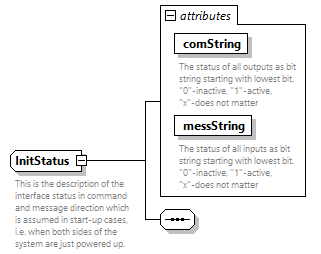 | ||||||||||||||||||||||
| namespace | https://www.railml.org/schemas/3.2 | ||||||||||||||||||||||
| used by |
| ||||||||||||||||||||||
| attributes |
| ||||||||||||||||||||||
| annotation |
| ||||||||||||||||||||||
| source | <xs:complexType name="InitStatus"> <xs:annotation> <xs:documentation>This is the description of the interface status in command and message direction which is assumed in start-up cases, i.e. when both sides of the system are just powered up.</xs:documentation> </xs:annotation> <xs:sequence/> <xs:attribute name="comString" type="rail3:tBitPatternAny" use="required"> <xs:annotation> <xs:documentation>The status of all outputs as bit string starting with lowest bit. "0"-inactive, "1"-active, "x"-does not matter</xs:documentation> </xs:annotation> </xs:attribute> <xs:attribute name="messString" type="rail3:tBitPatternAny" use="required"> <xs:annotation> <xs:documentation>The status of all inputs as bit string starting with lowest bit. "0"-inactive, "1"-active, "x"-does not matter</xs:documentation> </xs:annotation> </xs:attribute> </xs:complexType> |
attribute InitStatus/@comString
| type | rail3:tBitPatternAny | |||||||||
| properties |
| |||||||||
| facets |
| |||||||||
| annotation |
| |||||||||
| source | <xs:attribute name="comString" type="rail3:tBitPatternAny" use="required"> <xs:annotation> <xs:documentation>The status of all outputs as bit string starting with lowest bit. "0"-inactive, "1"-active, "x"-does not matter</xs:documentation> </xs:annotation> </xs:attribute> |
attribute InitStatus/@messString
| type | rail3:tBitPatternAny | |||||||||
| properties |
| |||||||||
| facets |
| |||||||||
| annotation |
| |||||||||
| source | <xs:attribute name="messString" type="rail3:tBitPatternAny" use="required"> <xs:annotation> <xs:documentation>The status of all inputs as bit string starting with lowest bit. "0"-inactive, "1"-active, "x"-does not matter</xs:documentation> </xs:annotation> </xs:attribute> |
complexType InputOutput
| diagram | 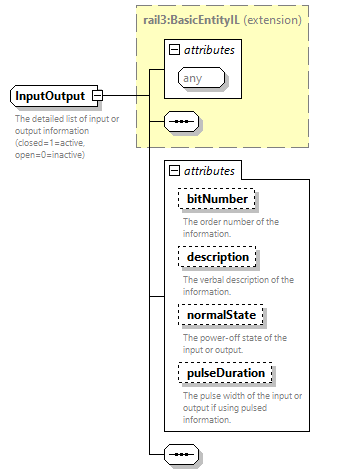 | ||||||||||||||||||||||||||||||||||||||
| namespace | https://www.railml.org/schemas/3.2 | ||||||||||||||||||||||||||||||||||||||
| type | extension of rail3:BasicEntityIL | ||||||||||||||||||||||||||||||||||||||
| properties |
| ||||||||||||||||||||||||||||||||||||||
| used by |
| ||||||||||||||||||||||||||||||||||||||
| attributes |
| ||||||||||||||||||||||||||||||||||||||
| annotation |
| ||||||||||||||||||||||||||||||||||||||
| source | <xs:complexType name="InputOutput"> <xs:annotation> <xs:documentation>The detailed list of input or output information (closed=1=active, open=0=inactive)</xs:documentation> </xs:annotation> <xs:complexContent> <xs:extension base="rail3:BasicEntityIL"> <xs:sequence/> <xs:attribute name="bitNumber" type="xs:nonNegativeInteger" use="optional"> <xs:annotation> <xs:documentation>The order number of the information.</xs:documentation> </xs:annotation> </xs:attribute> <xs:attribute name="description" type="xs:string" use="optional"> <xs:annotation> <xs:documentation>The verbal description of the information.</xs:documentation> </xs:annotation> </xs:attribute> <xs:attribute name="normalState" type="rail3:tContactState" use="optional"> <xs:annotation> <xs:documentation>The power-off state of the input or output.</xs:documentation> </xs:annotation> </xs:attribute> <xs:attribute name="pulseDuration" type="xs:duration" use="optional"> <xs:annotation> <xs:documentation>The pulse width of the input or output if using pulsed information.</xs:documentation> </xs:annotation> </xs:attribute> </xs:extension> </xs:complexContent> </xs:complexType> |
attribute InputOutput/@bitNumber
| type | xs:nonNegativeInteger | ||
| properties |
| ||
| annotation |
| ||
| source | <xs:attribute name="bitNumber" type="xs:nonNegativeInteger" use="optional"> <xs:annotation> <xs:documentation>The order number of the information.</xs:documentation> </xs:annotation> </xs:attribute> |
attribute InputOutput/@description
| type | xs:string | ||
| properties |
| ||
| annotation |
| ||
| source | <xs:attribute name="description" type="xs:string" use="optional"> <xs:annotation> <xs:documentation>The verbal description of the information.</xs:documentation> </xs:annotation> </xs:attribute> |
attribute InputOutput/@normalState
| type | rail3:tContactState | |||||||||||||
| properties |
| |||||||||||||
| facets |
| |||||||||||||
| annotation |
| |||||||||||||
| source | <xs:attribute name="normalState" type="rail3:tContactState" use="optional"> <xs:annotation> <xs:documentation>The power-off state of the input or output.</xs:documentation> </xs:annotation> </xs:attribute> |
attribute InputOutput/@pulseDuration
| type | xs:duration | ||
| properties |
| ||
| annotation |
| ||
| source | <xs:attribute name="pulseDuration" type="xs:duration" use="optional"> <xs:annotation> <xs:documentation>The pulse width of the input or output if using pulsed information.</xs:documentation> </xs:annotation> </xs:attribute> |
complexType Interface
| diagram | 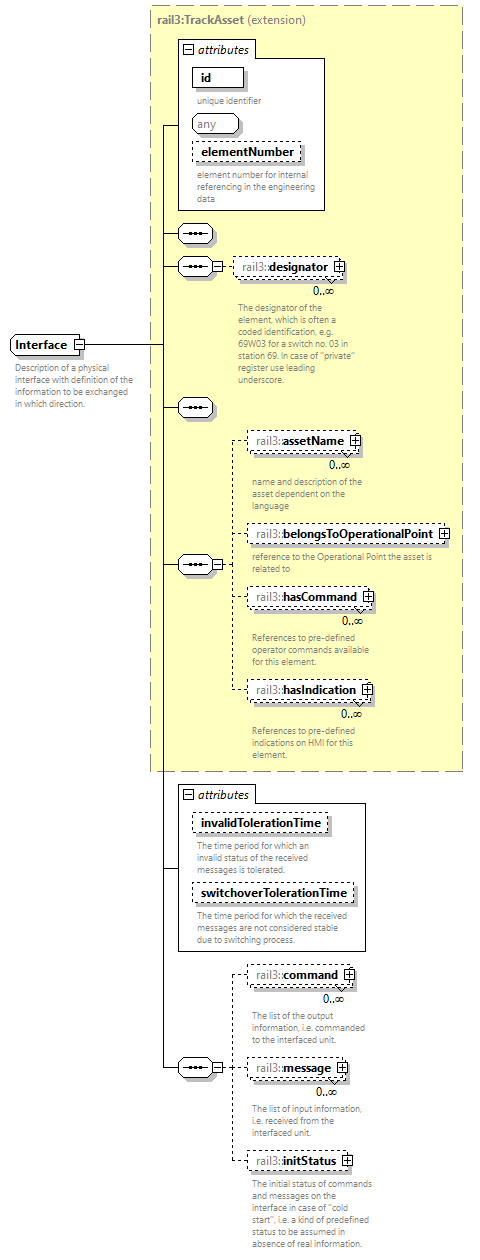 | ||||||||||||||||||||||||||||||||||||||
| namespace | https://www.railml.org/schemas/3.2 | ||||||||||||||||||||||||||||||||||||||
| type | extension of rail3:TrackAsset | ||||||||||||||||||||||||||||||||||||||
| properties |
| ||||||||||||||||||||||||||||||||||||||
| children | rail3:designator rail3:assetName rail3:belongsToOperationalPoint rail3:hasCommand rail3:hasIndication rail3:command rail3:message rail3:initStatus | ||||||||||||||||||||||||||||||||||||||
| used by |
| ||||||||||||||||||||||||||||||||||||||
| attributes |
| ||||||||||||||||||||||||||||||||||||||
| annotation |
| ||||||||||||||||||||||||||||||||||||||
| source | <xs:complexType name="Interface"> <xs:annotation> <xs:documentation>Description of a physical interface with definition of the information to be exchanged in which direction.</xs:documentation> </xs:annotation> <xs:complexContent> <xs:extension base="rail3:TrackAsset"> <xs:sequence> <xs:element name="command" type="rail3:InputOutput" minOccurs="0" maxOccurs="unbounded"> <xs:annotation> <xs:documentation>The list of the output information, i.e. commanded to the interfaced unit.</xs:documentation> </xs:annotation> </xs:element> <xs:element name="message" type="rail3:InputOutput" minOccurs="0" maxOccurs="unbounded"> <xs:annotation> <xs:documentation>The list of input information, i.e. received from the interfaced unit.</xs:documentation> </xs:annotation> </xs:element> <xs:element name="initStatus" type="rail3:InitStatus" minOccurs="0" maxOccurs="1"> <xs:annotation> <xs:documentation>The initial status of commands and messages on the interface in case of "cold start", i.e. a kind of predefined status to be assumed in absence of real information.</xs:documentation> </xs:annotation> </xs:element> </xs:sequence> <xs:attribute name="invalidTolerationTime" type="xs:duration" use="optional"> <xs:annotation> <xs:documentation>The time period for which an invalid status of the received messages is tolerated.</xs:documentation> </xs:annotation> </xs:attribute> <xs:attribute name="switchoverTolerationTime" type="xs:duration" use="optional"> <xs:annotation> <xs:documentation>The time period for which the received messages are not considered stable due to switching process.</xs:documentation> </xs:annotation> </xs:attribute> </xs:extension> </xs:complexContent> </xs:complexType> |
attribute Interface/@invalidTolerationTime
| type | xs:duration | ||
| properties |
| ||
| annotation |
| ||
| source | <xs:attribute name="invalidTolerationTime" type="xs:duration" use="optional"> <xs:annotation> <xs:documentation>The time period for which an invalid status of the received messages is tolerated.</xs:documentation> </xs:annotation> </xs:attribute> |
attribute Interface/@switchoverTolerationTime
| type | xs:duration | ||
| properties |
| ||
| annotation |
| ||
| source | <xs:attribute name="switchoverTolerationTime" type="xs:duration" use="optional"> <xs:annotation> <xs:documentation>The time period for which the received messages are not considered stable due to switching process.</xs:documentation> </xs:annotation> </xs:attribute> |
element Interface/command
| diagram | 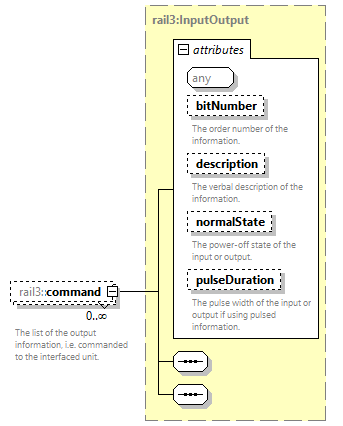 | ||||||||||||||||||||||||||||||||||||||
| namespace | https://www.railml.org/schemas/3.2 | ||||||||||||||||||||||||||||||||||||||
| type | rail3:InputOutput | ||||||||||||||||||||||||||||||||||||||
| properties |
| ||||||||||||||||||||||||||||||||||||||
| attributes |
| ||||||||||||||||||||||||||||||||||||||
| annotation |
| ||||||||||||||||||||||||||||||||||||||
| source | <xs:element name="command" type="rail3:InputOutput" minOccurs="0" maxOccurs="unbounded"> <xs:annotation> <xs:documentation>The list of the output information, i.e. commanded to the interfaced unit.</xs:documentation> </xs:annotation> </xs:element> |
element Interface/message
| diagram | 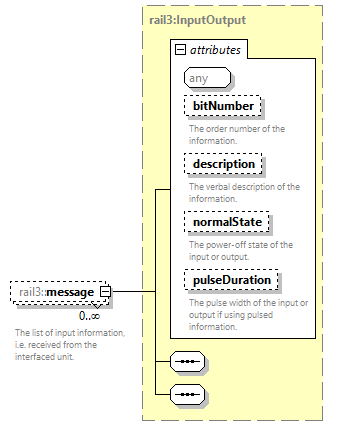 | ||||||||||||||||||||||||||||||||||||||
| namespace | https://www.railml.org/schemas/3.2 | ||||||||||||||||||||||||||||||||||||||
| type | rail3:InputOutput | ||||||||||||||||||||||||||||||||||||||
| properties |
| ||||||||||||||||||||||||||||||||||||||
| attributes |
| ||||||||||||||||||||||||||||||||||||||
| annotation |
| ||||||||||||||||||||||||||||||||||||||
| source | <xs:element name="message" type="rail3:InputOutput" minOccurs="0" maxOccurs="unbounded"> <xs:annotation> <xs:documentation>The list of input information, i.e. received from the interfaced unit.</xs:documentation> </xs:annotation> </xs:element> |
element Interface/initStatus
| diagram | 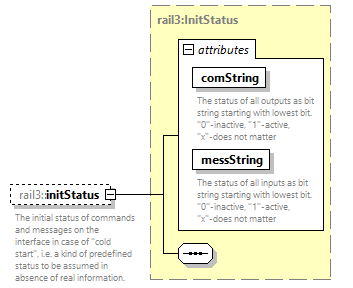 | ||||||||||||||||||||||
| namespace | https://www.railml.org/schemas/3.2 | ||||||||||||||||||||||
| type | rail3:InitStatus | ||||||||||||||||||||||
| properties |
| ||||||||||||||||||||||
| attributes |
| ||||||||||||||||||||||
| annotation |
| ||||||||||||||||||||||
| source | <xs:element name="initStatus" type="rail3:InitStatus" minOccurs="0" maxOccurs="1"> <xs:annotation> <xs:documentation>The initial status of commands and messages on the interface in case of "cold start", i.e. a kind of predefined status to be assumed in absence of real information.</xs:documentation> </xs:annotation> </xs:element> |
complexType Interfaces
| diagram |  | ||
| namespace | https://www.railml.org/schemas/3.2 | ||
| children | rail3:interface | ||
| used by |
| ||
| annotation |
| ||
| source | <xs:complexType name="Interfaces"> <xs:annotation> <xs:documentation>container element for all Interface elements</xs:documentation> </xs:annotation> <xs:sequence> <xs:element name="interface" type="rail3:Interface" minOccurs="1" maxOccurs="unbounded"> <xs:annotation> <xs:documentation>Description of a physical interface with definition of the information to be exchanged in which direction.</xs:documentation> </xs:annotation> </xs:element> </xs:sequence> </xs:complexType> |
element Interfaces/interface
| diagram | 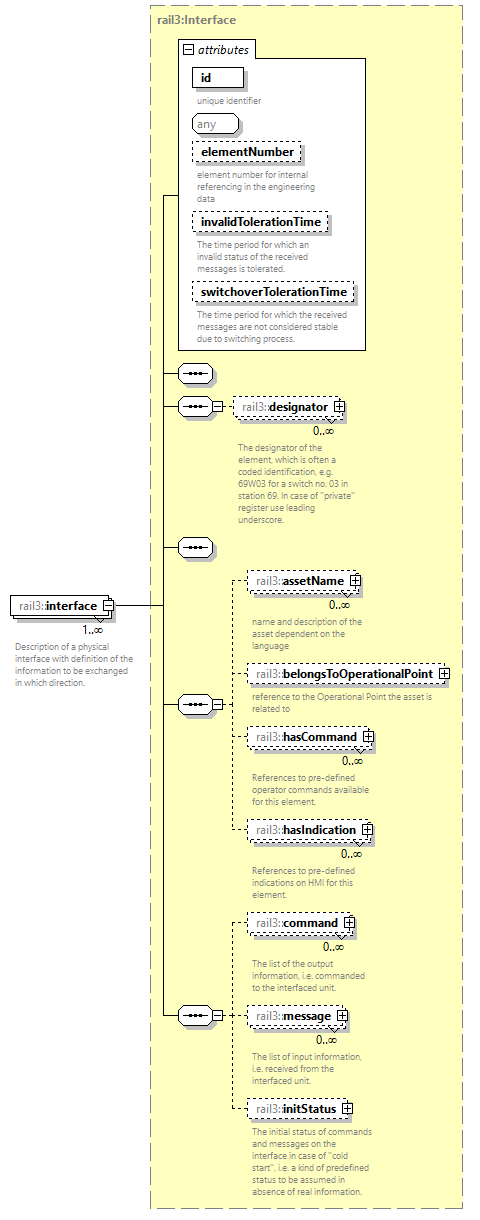 | ||||||||||||||||||||||||||||||||||||||
| namespace | https://www.railml.org/schemas/3.2 | ||||||||||||||||||||||||||||||||||||||
| type | rail3:Interface | ||||||||||||||||||||||||||||||||||||||
| properties |
| ||||||||||||||||||||||||||||||||||||||
| children | rail3:designator rail3:assetName rail3:belongsToOperationalPoint rail3:hasCommand rail3:hasIndication rail3:command rail3:message rail3:initStatus | ||||||||||||||||||||||||||||||||||||||
| attributes |
| ||||||||||||||||||||||||||||||||||||||
| annotation |
| ||||||||||||||||||||||||||||||||||||||
| source | <xs:element name="interface" type="rail3:Interface" minOccurs="1" maxOccurs="unbounded"> <xs:annotation> <xs:documentation>Description of a physical interface with definition of the information to be exchanged in which direction.</xs:documentation> </xs:annotation> </xs:element> |
complexType Interlocking
| diagram | 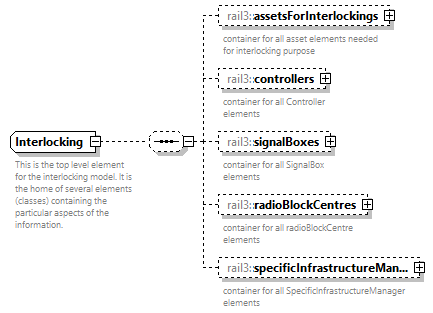 | ||
| namespace | https://www.railml.org/schemas/3.2 | ||
| children | rail3:assetsForInterlockings rail3:controllers rail3:signalBoxes rail3:radioBlockCentres rail3:specificInfrastructureManagers | ||
| used by |
| ||
| annotation |
| ||
| source | <xs:complexType name="Interlocking"> <xs:annotation> <xs:documentation>This is the top level element for the interlocking model. It is the home of several elements (classes) containing the particular aspects of the information.</xs:documentation> </xs:annotation> <xs:sequence minOccurs="0" maxOccurs="1"> <xs:element name="assetsForInterlockings" type="rail3:AssetsForInterlockings" minOccurs="0" maxOccurs="1"> <xs:annotation> <xs:documentation>container for all asset elements needed for interlocking purpose</xs:documentation> </xs:annotation> </xs:element> <xs:element name="controllers" type="rail3:Controllers" minOccurs="0" maxOccurs="1"> <xs:annotation> <xs:documentation>container for all Controller elements</xs:documentation> </xs:annotation> </xs:element> <xs:element name="signalBoxes" type="rail3:SignalBoxes" minOccurs="0" maxOccurs="1"> <xs:annotation> <xs:documentation>container for all SignalBox elements</xs:documentation> </xs:annotation> </xs:element> <xs:element name="radioBlockCentres" type="rail3:RadioBlockCentres" minOccurs="0" maxOccurs="1"> <xs:annotation> <xs:documentation>container for all radioBlockCentre elements</xs:documentation> </xs:annotation> </xs:element> <xs:element name="specificInfrastructureManagers" type="rail3:GenericInfrastructureManagers" minOccurs="0" maxOccurs="1"> <xs:annotation> <xs:documentation>container for all SpecificInfrastructureManager elements</xs:documentation> </xs:annotation> </xs:element> </xs:sequence> </xs:complexType> |
element Interlocking/assetsForInterlockings
| diagram |  | ||||||
| namespace | https://www.railml.org/schemas/3.2 | ||||||
| type | rail3:AssetsForInterlockings | ||||||
| properties |
| ||||||
| children | rail3:assetsForInterlocking | ||||||
| annotation |
| ||||||
| source | <xs:element name="assetsForInterlockings" type="rail3:AssetsForInterlockings" minOccurs="0" maxOccurs="1"> <xs:annotation> <xs:documentation>container for all asset elements needed for interlocking purpose</xs:documentation> </xs:annotation> </xs:element> |
element Interlocking/controllers
| diagram | 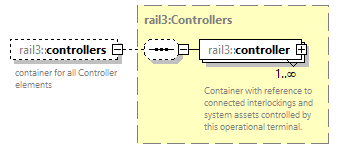 | ||||||
| namespace | https://www.railml.org/schemas/3.2 | ||||||
| type | rail3:Controllers | ||||||
| properties |
| ||||||
| children | rail3:controller | ||||||
| annotation |
| ||||||
| source | <xs:element name="controllers" type="rail3:Controllers" minOccurs="0" maxOccurs="1"> <xs:annotation> <xs:documentation>container for all Controller elements</xs:documentation> </xs:annotation> </xs:element> |
element Interlocking/signalBoxes
| diagram | 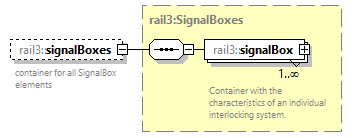 | ||||||
| namespace | https://www.railml.org/schemas/3.2 | ||||||
| type | rail3:SignalBoxes | ||||||
| properties |
| ||||||
| children | rail3:signalBox | ||||||
| annotation |
| ||||||
| source | <xs:element name="signalBoxes" type="rail3:SignalBoxes" minOccurs="0" maxOccurs="1"> <xs:annotation> <xs:documentation>container for all SignalBox elements</xs:documentation> </xs:annotation> </xs:element> |
element Interlocking/radioBlockCentres
| diagram |  | ||||||
| namespace | https://www.railml.org/schemas/3.2 | ||||||
| type | rail3:RadioBlockCentres | ||||||
| properties |
| ||||||
| children | rail3:radioBlockCentre | ||||||
| annotation |
| ||||||
| source | <xs:element name="radioBlockCentres" type="rail3:RadioBlockCentres" minOccurs="0" maxOccurs="1"> <xs:annotation> <xs:documentation>container for all radioBlockCentre elements</xs:documentation> </xs:annotation> </xs:element> |
element Interlocking/specificInfrastructureManagers
| diagram |  | ||||||
| namespace | https://www.railml.org/schemas/3.2 | ||||||
| type | rail3:GenericInfrastructureManagers | ||||||
| properties |
| ||||||
| children | rail3:specificInfrastructureManager | ||||||
| annotation |
| ||||||
| source | <xs:element name="specificInfrastructureManagers" type="rail3:GenericInfrastructureManagers" minOccurs="0" maxOccurs="1"> <xs:annotation> <xs:documentation>container for all SpecificInfrastructureManager elements</xs:documentation> </xs:annotation> </xs:element> |
complexType InterlockingInterface
| diagram | 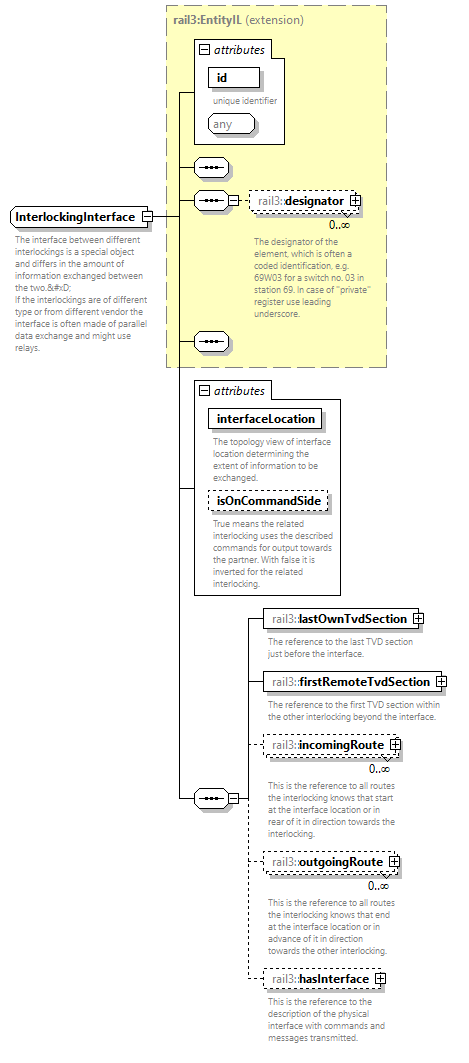 | ||||||||||||||||||||||||||||||
| namespace | https://www.railml.org/schemas/3.2 | ||||||||||||||||||||||||||||||
| type | extension of rail3:EntityIL | ||||||||||||||||||||||||||||||
| properties |
| ||||||||||||||||||||||||||||||
| children | rail3:designator rail3:lastOwnTvdSection rail3:firstRemoteTvdSection rail3:incomingRoute rail3:outgoingRoute rail3:hasInterface | ||||||||||||||||||||||||||||||
| used by |
| ||||||||||||||||||||||||||||||
| attributes |
| ||||||||||||||||||||||||||||||
| annotation |
| ||||||||||||||||||||||||||||||
| source | <xs:complexType name="InterlockingInterface"> <xs:annotation> <xs:documentation>The interface between different interlockings is a special object and differs in the amount of information exchanged between the two.
 If the interlockings are of different type or from different vendor the interface is often made of parallel data exchange and might use relays.</xs:documentation> </xs:annotation> <xs:complexContent> <xs:extension base="rail3:EntityIL"> <xs:sequence> <xs:element name="lastOwnTvdSection" type="rail3:EntityILref" minOccurs="1" maxOccurs="1"> <xs:annotation> <xs:documentation>The reference to the last TVD section just before the interface.</xs:documentation> </xs:annotation> </xs:element> <xs:element name="firstRemoteTvdSection" type="rail3:EntityILref" minOccurs="1" maxOccurs="1"> <xs:annotation> <xs:documentation>The reference to the first TVD section within the other interlocking beyond the interface.</xs:documentation> </xs:annotation> </xs:element> <xs:element name="incomingRoute" type="rail3:EntityILref" minOccurs="0" maxOccurs="unbounded"> <xs:annotation> <xs:documentation>This is the reference to all routes the interlocking knows that start at the interface location or in rear of it in direction towards the interlocking.</xs:documentation> </xs:annotation> </xs:element> <xs:element name="outgoingRoute" type="rail3:EntityILref" minOccurs="0" maxOccurs="unbounded"> <xs:annotation> <xs:documentation>This is the reference to all routes the interlocking knows that end at the interface location or in advance of it in direction towards the other interlocking.</xs:documentation> </xs:annotation> </xs:element> <xs:element name="hasInterface" type="rail3:EntityILref" minOccurs="0" maxOccurs="1"> <xs:annotation> <xs:documentation>This is the reference to the description of the physical interface with commands and messages transmitted.</xs:documentation> </xs:annotation> </xs:element> </xs:sequence> <xs:attribute name="interfaceLocation" type="rail3:tIxlInterfaceLocationTypeList" use="required"> <xs:annotation> <xs:documentation>The topology view of interface location determining the extent of information to be exchanged.</xs:documentation> </xs:annotation> </xs:attribute> <xs:attribute name="isOnCommandSide" type="xs:boolean" use="optional"> <xs:annotation> <xs:documentation>True means the related interlocking uses the described commands for output towards the partner. With false it is inverted for the related interlocking.</xs:documentation> </xs:annotation> </xs:attribute> </xs:extension> </xs:complexContent> </xs:complexType> |
attribute InterlockingInterface/@interfaceLocation
| type | rail3:tIxlInterfaceLocationTypeList | ||||||||||||||||||
| properties |
| ||||||||||||||||||
| facets |
| ||||||||||||||||||
| annotation |
| ||||||||||||||||||
| source | <xs:attribute name="interfaceLocation" type="rail3:tIxlInterfaceLocationTypeList" use="required"> <xs:annotation> <xs:documentation>The topology view of interface location determining the extent of information to be exchanged.</xs:documentation> </xs:annotation> </xs:attribute> |
attribute InterlockingInterface/@isOnCommandSide
| type | xs:boolean | ||
| properties |
| ||
| annotation |
| ||
| source | <xs:attribute name="isOnCommandSide" type="xs:boolean" use="optional"> <xs:annotation> <xs:documentation>True means the related interlocking uses the described commands for output towards the partner. With false it is inverted for the related interlocking.</xs:documentation> </xs:annotation> </xs:attribute> |
element InterlockingInterface/lastOwnTvdSection
| diagram | 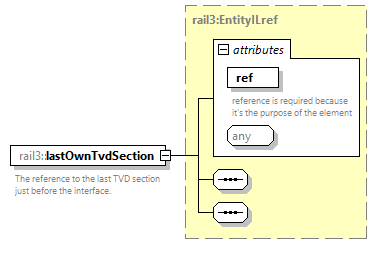 | ||||||||||||||
| namespace | https://www.railml.org/schemas/3.2 | ||||||||||||||
| type | rail3:EntityILref | ||||||||||||||
| properties |
| ||||||||||||||
| attributes |
| ||||||||||||||
| annotation |
| ||||||||||||||
| source | <xs:element name="lastOwnTvdSection" type="rail3:EntityILref" minOccurs="1" maxOccurs="1"> <xs:annotation> <xs:documentation>The reference to the last TVD section just before the interface.</xs:documentation> </xs:annotation> </xs:element> |
element InterlockingInterface/firstRemoteTvdSection
| diagram | 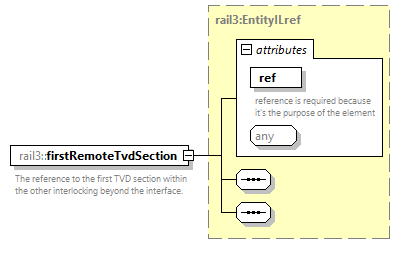 | ||||||||||||||
| namespace | https://www.railml.org/schemas/3.2 | ||||||||||||||
| type | rail3:EntityILref | ||||||||||||||
| properties |
| ||||||||||||||
| attributes |
| ||||||||||||||
| annotation |
| ||||||||||||||
| source | <xs:element name="firstRemoteTvdSection" type="rail3:EntityILref" minOccurs="1" maxOccurs="1"> <xs:annotation> <xs:documentation>The reference to the first TVD section within the other interlocking beyond the interface.</xs:documentation> </xs:annotation> </xs:element> |
element InterlockingInterface/incomingRoute
| diagram | 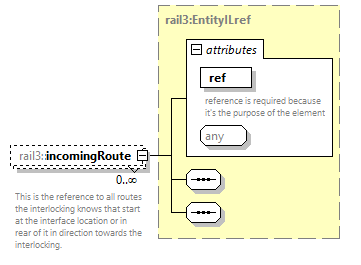 | ||||||||||||||
| namespace | https://www.railml.org/schemas/3.2 | ||||||||||||||
| type | rail3:EntityILref | ||||||||||||||
| properties |
| ||||||||||||||
| attributes |
| ||||||||||||||
| annotation |
| ||||||||||||||
| source | <xs:element name="incomingRoute" type="rail3:EntityILref" minOccurs="0" maxOccurs="unbounded"> <xs:annotation> <xs:documentation>This is the reference to all routes the interlocking knows that start at the interface location or in rear of it in direction towards the interlocking.</xs:documentation> </xs:annotation> </xs:element> |
element InterlockingInterface/outgoingRoute
| diagram | 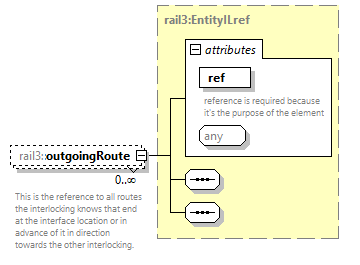 | ||||||||||||||
| namespace | https://www.railml.org/schemas/3.2 | ||||||||||||||
| type | rail3:EntityILref | ||||||||||||||
| properties |
| ||||||||||||||
| attributes |
| ||||||||||||||
| annotation |
| ||||||||||||||
| source | <xs:element name="outgoingRoute" type="rail3:EntityILref" minOccurs="0" maxOccurs="unbounded"> <xs:annotation> <xs:documentation>This is the reference to all routes the interlocking knows that end at the interface location or in advance of it in direction towards the other interlocking.</xs:documentation> </xs:annotation> </xs:element> |
element InterlockingInterface/hasInterface
| diagram |  | ||||||||||||||
| namespace | https://www.railml.org/schemas/3.2 | ||||||||||||||
| type | rail3:EntityILref | ||||||||||||||
| properties |
| ||||||||||||||
| attributes |
| ||||||||||||||
| annotation |
| ||||||||||||||
| source | <xs:element name="hasInterface" type="rail3:EntityILref" minOccurs="0" maxOccurs="1"> <xs:annotation> <xs:documentation>This is the reference to the description of the physical interface with commands and messages transmitted.</xs:documentation> </xs:annotation> </xs:element> |
complexType IPv4AddressEntry
| diagram | 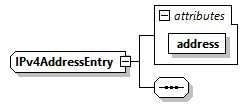 | ||||||||||||
| namespace | https://www.railml.org/schemas/3.2 | ||||||||||||
| used by |
| ||||||||||||
| attributes |
| ||||||||||||
| source | <xs:complexType name="IPv4AddressEntry"> <xs:sequence/> <xs:attribute name="address" type="rail3:IPv4_Address" use="required"/> </xs:complexType> |
attribute IPv4AddressEntry/@address
| type | rail3:IPv4_Address | ||||||
| properties |
| ||||||
| facets |
| ||||||
| source | <xs:attribute name="address" type="rail3:IPv4_Address" use="required"/> |
complexType Key
| diagram | 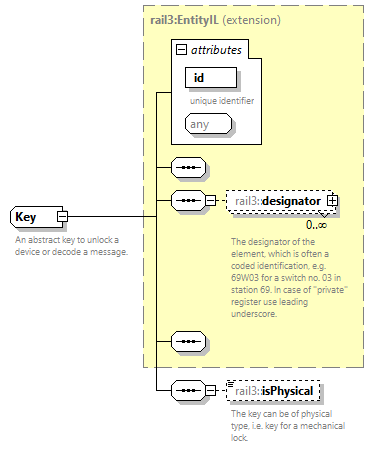 | ||||||||||||||
| namespace | https://www.railml.org/schemas/3.2 | ||||||||||||||
| type | extension of rail3:EntityIL | ||||||||||||||
| properties |
| ||||||||||||||
| children | rail3:designator rail3:isPhysical | ||||||||||||||
| used by |
| ||||||||||||||
| attributes |
| ||||||||||||||
| annotation |
| ||||||||||||||
| source | <xs:complexType name="Key"> <xs:annotation> <xs:documentation>An abstract key to unlock a device or decode a message.</xs:documentation> </xs:annotation> <xs:complexContent> <xs:extension base="rail3:EntityIL"> <xs:sequence> <xs:element name="isPhysical" type="xs:boolean" minOccurs="0" maxOccurs="1"> <xs:annotation> <xs:documentation>The key can be of physical type, i.e. key for a mechanical lock.</xs:documentation> </xs:annotation> </xs:element> </xs:sequence> </xs:extension> </xs:complexContent> </xs:complexType> |
element Key/isPhysical
| diagram |  | ||||||
| namespace | https://www.railml.org/schemas/3.2 | ||||||
| type | xs:boolean | ||||||
| properties |
| ||||||
| annotation |
| ||||||
| source | <xs:element name="isPhysical" type="xs:boolean" minOccurs="0" maxOccurs="1"> <xs:annotation> <xs:documentation>The key can be of physical type, i.e. key for a mechanical lock.</xs:documentation> </xs:annotation> </xs:element> |
complexType KeyLockIL
| diagram |  | ||||||||||||||||||||||||||||||||||||||||||||||||||||||||||||||||||||||
| namespace | https://www.railml.org/schemas/3.2 | ||||||||||||||||||||||||||||||||||||||||||||||||||||||||||||||||||||||
| type | extension of rail3:LogicalDevice | ||||||||||||||||||||||||||||||||||||||||||||||||||||||||||||||||||||||
| properties |
| ||||||||||||||||||||||||||||||||||||||||||||||||||||||||||||||||||||||
| children | rail3:designator rail3:assetName rail3:belongsToOperationalPoint rail3:hasCommand rail3:hasIndication rail3:takesControlOf rail3:hasInterface rail3:refersTo rail3:acceptsKey rail3:hasTvdSection rail3:hasSlaveLock | ||||||||||||||||||||||||||||||||||||||||||||||||||||||||||||||||||||||
| used by |
| ||||||||||||||||||||||||||||||||||||||||||||||||||||||||||||||||||||||
| attributes |
| ||||||||||||||||||||||||||||||||||||||||||||||||||||||||||||||||||||||
| annotation |
| ||||||||||||||||||||||||||||||||||||||||||||||||||||||||||||||||||||||
| source | <xs:complexType name="KeyLockIL"> <xs:annotation> <xs:documentation>A device, also known as key lock (de: Schlüsselschalter) situated near the track. It is used to request local control of a (group of) track assets from the interlocking. Commonly, staff requests local control from the interlocking via this device. Once granted, the key can be removed upon which the (group of) track asset is no longer under interlocking control. In reverse, the interlocking takes back control when the key is inserted and staff acknowledged relinquishing control. Note that the lock is a track asset defined in infrastructure namespace. The interlocking reads the state of the lock and returns permission to remove the key, i.e. levelOfControl=fullControl. A combined lock has a master lock that controls a set of slave locks. Slave locks may have to be released in a well-defined sequence.</xs:documentation> </xs:annotation> <xs:complexContent> <xs:extension base="rail3:LogicalDevice"> <xs:sequence> <xs:element name="acceptsKey" type="rail3:EntityILref" minOccurs="0" maxOccurs="1"> <xs:annotation> <xs:documentation>The reference to the particular key used with this master lock.</xs:documentation> </xs:annotation> </xs:element> <xs:element name="hasTvdSection" type="rail3:EntityILref" minOccurs="0" maxOccurs="1"> <xs:annotation> <xs:documentation>The reference to the TVD section related to this master lock. This is especially used for siding key locks on open line.</xs:documentation> </xs:annotation> </xs:element> <xs:element name="hasSlaveLock" type="rail3:EntityILref" minOccurs="0" maxOccurs="unbounded"> <xs:annotation> <xs:documentation>reference to a dependent KeyReleaseInstrument</xs:documentation> </xs:annotation> </xs:element> </xs:sequence> <xs:attribute name="function" type="rail3:tKeyLockFunctionListExt" use="optional"> <xs:annotation> <xs:documentation>The functional element the keylock is controlling.</xs:documentation> </xs:annotation> </xs:attribute> <xs:attribute name="hasAutomaticKeyLock" type="xs:boolean" use="optional"> <xs:annotation> <xs:documentation>The key may be automatically relocked when returned into the lock. Thus the key can be used only once.</xs:documentation> </xs:annotation> </xs:attribute> <xs:attribute name="hasAutomaticKeyRelease" type="xs:boolean" use="optional"> <xs:annotation> <xs:documentation>The key of a siding on open line may be released automatically when the related TVD section (trigger) becomes occupied.</xs:documentation> </xs:annotation> </xs:attribute> <xs:attribute name="keyAuthoriseTime" type="xs:duration" use="optional"> <xs:annotation> <xs:documentation>The time period the key release is active after commanded by the operator. Afterwards a not removed key will be automatically relocked again.</xs:documentation> </xs:annotation> </xs:attribute> <xs:attribute name="keyRequestTime" type="xs:duration" use="optional"> <xs:annotation> <xs:documentation>The time period a request for key release is indicated to the operator.</xs:documentation> </xs:annotation> </xs:attribute> </xs:extension> </xs:complexContent> </xs:complexType> |
attribute KeyLockIL/@function
| type | rail3:tKeyLockFunctionListExt | ||
| properties |
| ||
| annotation |
| ||
| source | <xs:attribute name="function" type="rail3:tKeyLockFunctionListExt" use="optional"> <xs:annotation> <xs:documentation>The functional element the keylock is controlling.</xs:documentation> </xs:annotation> </xs:attribute> |
attribute KeyLockIL/@hasAutomaticKeyLock
| type | xs:boolean | ||
| properties |
| ||
| annotation |
| ||
| source | <xs:attribute name="hasAutomaticKeyLock" type="xs:boolean" use="optional"> <xs:annotation> <xs:documentation>The key may be automatically relocked when returned into the lock. Thus the key can be used only once.</xs:documentation> </xs:annotation> </xs:attribute> |
attribute KeyLockIL/@hasAutomaticKeyRelease
| type | xs:boolean | ||
| properties |
| ||
| annotation |
| ||
| source | <xs:attribute name="hasAutomaticKeyRelease" type="xs:boolean" use="optional"> <xs:annotation> <xs:documentation>The key of a siding on open line may be released automatically when the related TVD section (trigger) becomes occupied.</xs:documentation> </xs:annotation> </xs:attribute> |
attribute KeyLockIL/@keyAuthoriseTime
| type | xs:duration | ||
| properties |
| ||
| annotation |
| ||
| source | <xs:attribute name="keyAuthoriseTime" type="xs:duration" use="optional"> <xs:annotation> <xs:documentation>The time period the key release is active after commanded by the operator. Afterwards a not removed key will be automatically relocked again.</xs:documentation> </xs:annotation> </xs:attribute> |
attribute KeyLockIL/@keyRequestTime
| type | xs:duration | ||
| properties |
| ||
| annotation |
| ||
| source | <xs:attribute name="keyRequestTime" type="xs:duration" use="optional"> <xs:annotation> <xs:documentation>The time period a request for key release is indicated to the operator.</xs:documentation> </xs:annotation> </xs:attribute> |
element KeyLockIL/acceptsKey
| diagram | 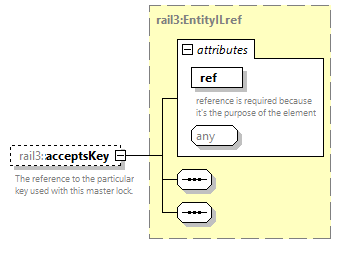 | ||||||||||||||
| namespace | https://www.railml.org/schemas/3.2 | ||||||||||||||
| type | rail3:EntityILref | ||||||||||||||
| properties |
| ||||||||||||||
| attributes |
| ||||||||||||||
| annotation |
| ||||||||||||||
| source | <xs:element name="acceptsKey" type="rail3:EntityILref" minOccurs="0" maxOccurs="1"> <xs:annotation> <xs:documentation>The reference to the particular key used with this master lock.</xs:documentation> </xs:annotation> </xs:element> |
element KeyLockIL/hasTvdSection
| diagram | 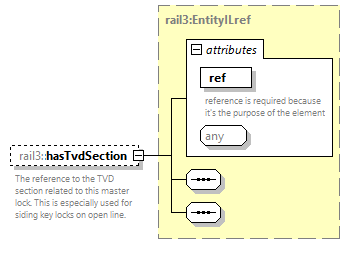 | ||||||||||||||
| namespace | https://www.railml.org/schemas/3.2 | ||||||||||||||
| type | rail3:EntityILref | ||||||||||||||
| properties |
| ||||||||||||||
| attributes |
| ||||||||||||||
| annotation |
| ||||||||||||||
| source | <xs:element name="hasTvdSection" type="rail3:EntityILref" minOccurs="0" maxOccurs="1"> <xs:annotation> <xs:documentation>The reference to the TVD section related to this master lock. This is especially used for siding key locks on open line.</xs:documentation> </xs:annotation> </xs:element> |
element KeyLockIL/hasSlaveLock
| diagram | 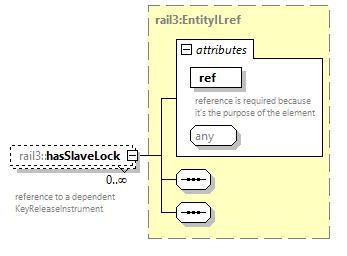 | ||||||||||||||
| namespace | https://www.railml.org/schemas/3.2 | ||||||||||||||
| type | rail3:EntityILref | ||||||||||||||
| properties |
| ||||||||||||||
| attributes |
| ||||||||||||||
| annotation |
| ||||||||||||||
| source | <xs:element name="hasSlaveLock" type="rail3:EntityILref" minOccurs="0" maxOccurs="unbounded"> <xs:annotation> <xs:documentation>reference to a dependent KeyReleaseInstrument</xs:documentation> </xs:annotation> </xs:element> |
complexType KeyLockInState
| diagram | 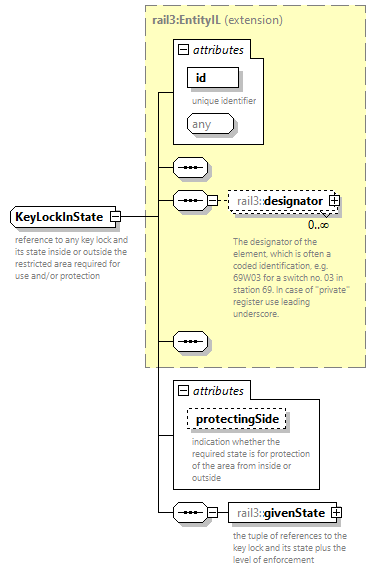 | ||||||||||||||||||||||
| namespace | https://www.railml.org/schemas/3.2 | ||||||||||||||||||||||
| type | extension of rail3:EntityIL | ||||||||||||||||||||||
| properties |
| ||||||||||||||||||||||
| children | rail3:designator rail3:givenState | ||||||||||||||||||||||
| used by |
| ||||||||||||||||||||||
| attributes |
| ||||||||||||||||||||||
| annotation |
| ||||||||||||||||||||||
| source | <xs:complexType name="KeyLockInState"> <xs:annotation> <xs:documentation>reference to any key lock and its state inside or outside the restricted area required for use and/or protection</xs:documentation> </xs:annotation> <xs:complexContent> <xs:extension base="rail3:EntityIL"> <xs:sequence> <xs:element name="givenState" type="rail3:LockAndGivenState" minOccurs="1" maxOccurs="1"> <xs:annotation> <xs:documentation>the tuple of references to the key lock and its state plus the level of enforcement</xs:documentation> </xs:annotation> </xs:element> </xs:sequence> <xs:attribute name="protectingSide" type="rail3:tProtectingSideList" use="optional"> <xs:annotation> <xs:documentation>indication whether the required state is for protection of the area from inside or outside</xs:documentation> </xs:annotation> </xs:attribute> </xs:extension> </xs:complexContent> </xs:complexType> |
attribute KeyLockInState/@protectingSide
| type | rail3:tProtectingSideList | ||||||||||||||||||
| properties |
| ||||||||||||||||||
| facets |
| ||||||||||||||||||
| annotation |
| ||||||||||||||||||
| source | <xs:attribute name="protectingSide" type="rail3:tProtectingSideList" use="optional"> <xs:annotation> <xs:documentation>indication whether the required state is for protection of the area from inside or outside</xs:documentation> </xs:annotation> </xs:attribute> |
element KeyLockInState/givenState
| diagram | 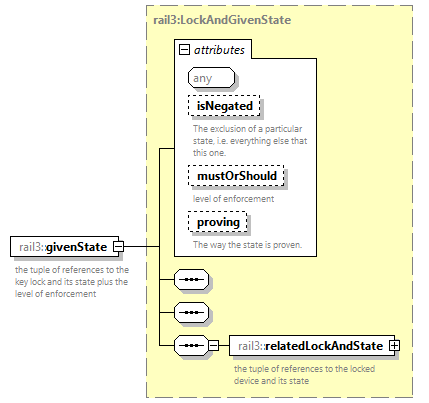 | ||||||||||||||||||||||||||||||
| namespace | https://www.railml.org/schemas/3.2 | ||||||||||||||||||||||||||||||
| type | rail3:LockAndGivenState | ||||||||||||||||||||||||||||||
| properties |
| ||||||||||||||||||||||||||||||
| children | rail3:relatedLockAndState | ||||||||||||||||||||||||||||||
| attributes |
| ||||||||||||||||||||||||||||||
| annotation |
| ||||||||||||||||||||||||||||||
| source | <xs:element name="givenState" type="rail3:LockAndGivenState" minOccurs="1" maxOccurs="1"> <xs:annotation> <xs:documentation>the tuple of references to the key lock and its state plus the level of enforcement</xs:documentation> </xs:annotation> </xs:element> |
complexType KeyLocksIL
| diagram | 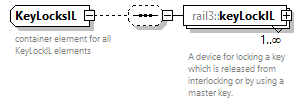 | ||
| namespace | https://www.railml.org/schemas/3.2 | ||
| children | rail3:keyLockIL | ||
| used by |
| ||
| annotation |
| ||
| source | <xs:complexType name="KeyLocksIL"> <xs:annotation> <xs:documentation>container element for all KeyLockIL elements</xs:documentation> </xs:annotation> <xs:sequence minOccurs="0" maxOccurs="1"> <xs:element name="keyLockIL" type="rail3:KeyLockIL" minOccurs="1" maxOccurs="unbounded"> <xs:annotation> <xs:documentation>A device for locking a key which is released from interlocking or by using a master key.</xs:documentation> </xs:annotation> </xs:element> </xs:sequence> </xs:complexType> |
element KeyLocksIL/keyLockIL
| diagram |  | ||||||||||||||||||||||||||||||||||||||||||||||||||||||||||||||||||||||
| namespace | https://www.railml.org/schemas/3.2 | ||||||||||||||||||||||||||||||||||||||||||||||||||||||||||||||||||||||
| type | rail3:KeyLockIL | ||||||||||||||||||||||||||||||||||||||||||||||||||||||||||||||||||||||
| properties |
| ||||||||||||||||||||||||||||||||||||||||||||||||||||||||||||||||||||||
| children | rail3:designator rail3:assetName rail3:belongsToOperationalPoint rail3:hasCommand rail3:hasIndication rail3:takesControlOf rail3:hasInterface rail3:refersTo rail3:acceptsKey rail3:hasTvdSection rail3:hasSlaveLock | ||||||||||||||||||||||||||||||||||||||||||||||||||||||||||||||||||||||
| attributes |
| ||||||||||||||||||||||||||||||||||||||||||||||||||||||||||||||||||||||
| annotation |
| ||||||||||||||||||||||||||||||||||||||||||||||||||||||||||||||||||||||
| source | <xs:element name="keyLockIL" type="rail3:KeyLockIL" minOccurs="1" maxOccurs="unbounded"> <xs:annotation> <xs:documentation>A device for locking a key which is released from interlocking or by using a master key.</xs:documentation> </xs:annotation> </xs:element> |
complexType Keys
| diagram |  | ||
| namespace | https://www.railml.org/schemas/3.2 | ||
| children | rail3:key | ||
| used by |
| ||
| annotation |
| ||
| source | <xs:complexType name="Keys"> <xs:annotation> <xs:documentation>container element for all Key elements</xs:documentation> </xs:annotation> <xs:sequence minOccurs="0" maxOccurs="1"> <xs:element name="key" type="rail3:Key" minOccurs="1" maxOccurs="unbounded"> <xs:annotation> <xs:documentation>An ancillary element used for operation of a specific locking device. </xs:documentation> </xs:annotation> </xs:element> </xs:sequence> </xs:complexType> |
element Keys/key
| diagram | 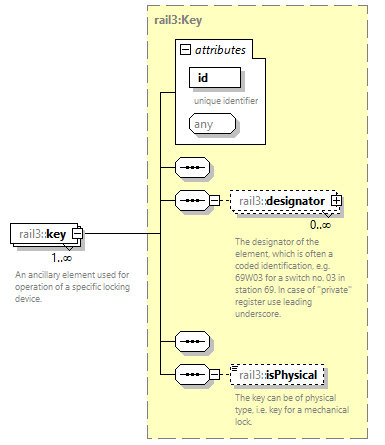 | ||||||||||||||
| namespace | https://www.railml.org/schemas/3.2 | ||||||||||||||
| type | rail3:Key | ||||||||||||||
| properties |
| ||||||||||||||
| children | rail3:designator rail3:isPhysical | ||||||||||||||
| attributes |
| ||||||||||||||
| annotation |
| ||||||||||||||
| source | <xs:element name="key" type="rail3:Key" minOccurs="1" maxOccurs="unbounded"> <xs:annotation> <xs:documentation>An ancillary element used for operation of a specific locking device. </xs:documentation> </xs:annotation> </xs:element> |
complexType LevelCrossingAndGivenState
| diagram | 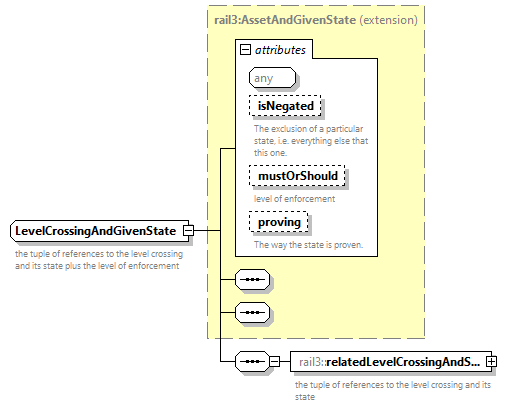 | ||||||||||||||||||||||||||||||
| namespace | https://www.railml.org/schemas/3.2 | ||||||||||||||||||||||||||||||
| type | extension of rail3:AssetAndGivenState | ||||||||||||||||||||||||||||||
| properties |
| ||||||||||||||||||||||||||||||
| children | rail3:relatedLevelCrossingAndState | ||||||||||||||||||||||||||||||
| used by |
| ||||||||||||||||||||||||||||||
| attributes |
| ||||||||||||||||||||||||||||||
| annotation |
| ||||||||||||||||||||||||||||||
| source | <xs:complexType name="LevelCrossingAndGivenState"> <xs:annotation> <xs:documentation>the tuple of references to the level crossing and its state plus the level of enforcement</xs:documentation> </xs:annotation> <xs:complexContent> <xs:extension base="rail3:AssetAndGivenState"> <xs:sequence> <xs:element name="relatedLevelCrossingAndState" type="rail3:LevelCrossingAndState" minOccurs="1" maxOccurs="1"> <xs:annotation> <xs:documentation>the tuple of references to the level crossing and its state</xs:documentation> </xs:annotation> </xs:element> </xs:sequence> </xs:extension> </xs:complexContent> </xs:complexType> |
element LevelCrossingAndGivenState/relatedLevelCrossingAndState
| diagram | 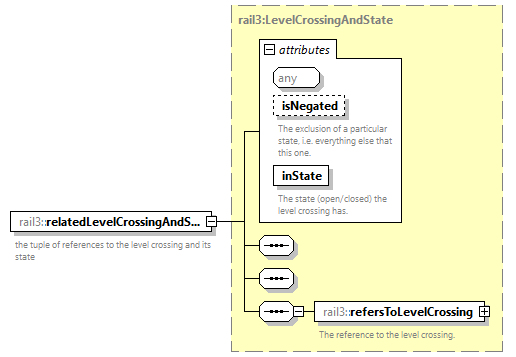 | ||||||||||||||||||||||
| namespace | https://www.railml.org/schemas/3.2 | ||||||||||||||||||||||
| type | rail3:LevelCrossingAndState | ||||||||||||||||||||||
| properties |
| ||||||||||||||||||||||
| children | rail3:refersToLevelCrossing | ||||||||||||||||||||||
| attributes |
| ||||||||||||||||||||||
| annotation |
| ||||||||||||||||||||||
| source | <xs:element name="relatedLevelCrossingAndState" type="rail3:LevelCrossingAndState" minOccurs="1" maxOccurs="1"> <xs:annotation> <xs:documentation>the tuple of references to the level crossing and its state</xs:documentation> </xs:annotation> </xs:element> |
complexType LevelCrossingAndState
| diagram | 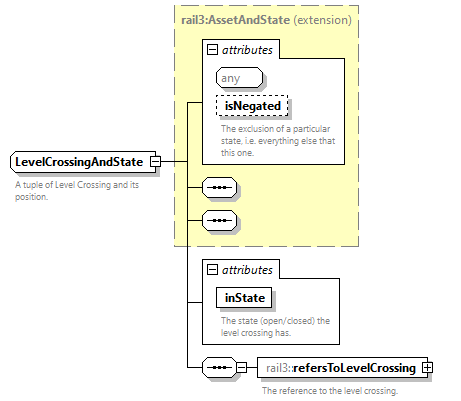 | ||||||||||||||||||||||
| namespace | https://www.railml.org/schemas/3.2 | ||||||||||||||||||||||
| type | extension of rail3:AssetAndState | ||||||||||||||||||||||
| properties |
| ||||||||||||||||||||||
| children | rail3:refersToLevelCrossing | ||||||||||||||||||||||
| used by |
| ||||||||||||||||||||||
| attributes |
| ||||||||||||||||||||||
| annotation |
| ||||||||||||||||||||||
| source | <xs:complexType name="LevelCrossingAndState"> <xs:annotation> <xs:documentation>A tuple of Level Crossing and its position.</xs:documentation> </xs:annotation> <xs:complexContent> <xs:extension base="rail3:AssetAndState"> <xs:sequence> <xs:element name="refersToLevelCrossing" type="rail3:EntityILref" minOccurs="1" maxOccurs="1"> <xs:annotation> <xs:documentation>The reference to the level crossing.</xs:documentation> </xs:annotation> </xs:element> </xs:sequence> <xs:attribute name="inState" type="rail3:tLevelCrossingState" use="required"> <xs:annotation> <xs:documentation>The state (open/closed) the level crossing has.</xs:documentation> </xs:annotation> </xs:attribute> </xs:extension> </xs:complexContent> </xs:complexType> |
attribute LevelCrossingAndState/@inState
| type | rail3:tLevelCrossingState | ||||||||||||||||||
| properties |
| ||||||||||||||||||
| facets |
| ||||||||||||||||||
| annotation |
| ||||||||||||||||||
| source | <xs:attribute name="inState" type="rail3:tLevelCrossingState" use="required"> <xs:annotation> <xs:documentation>The state (open/closed) the level crossing has.</xs:documentation> </xs:annotation> </xs:attribute> |
element LevelCrossingAndState/refersToLevelCrossing
| diagram | 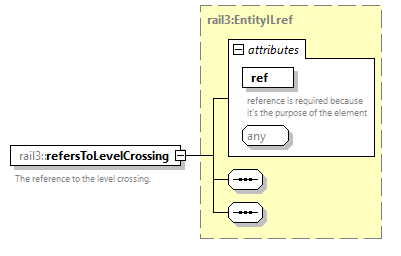 | ||||||||||||||
| namespace | https://www.railml.org/schemas/3.2 | ||||||||||||||
| type | rail3:EntityILref | ||||||||||||||
| properties |
| ||||||||||||||
| attributes |
| ||||||||||||||
| annotation |
| ||||||||||||||
| source | <xs:element name="refersToLevelCrossing" type="rail3:EntityILref" minOccurs="1" maxOccurs="1"> <xs:annotation> <xs:documentation>The reference to the level crossing.</xs:documentation> </xs:annotation> </xs:element> |
complexType LevelCrossingIL
| diagram |  | ||||||||||||||||||||||||||||||||||||||||||||||||||||||||||||||||||||||||||||||
| namespace | https://www.railml.org/schemas/3.2 | ||||||||||||||||||||||||||||||||||||||||||||||||||||||||||||||||||||||||||||||
| type | extension of rail3:TrackAsset | ||||||||||||||||||||||||||||||||||||||||||||||||||||||||||||||||||||||||||||||
| properties |
| ||||||||||||||||||||||||||||||||||||||||||||||||||||||||||||||||||||||||||||||
| children | rail3:designator rail3:assetName rail3:belongsToOperationalPoint rail3:hasCommand rail3:hasIndication rail3:hasInterface rail3:isLevelCrossingType rail3:refersTo rail3:deactivatedBy rail3:activationCondition rail3:hasTvdSection rail3:hasLevelCrossingTrack | ||||||||||||||||||||||||||||||||||||||||||||||||||||||||||||||||||||||||||||||
| used by |
| ||||||||||||||||||||||||||||||||||||||||||||||||||||||||||||||||||||||||||||||
| attributes |
| ||||||||||||||||||||||||||||||||||||||||||||||||||||||||||||||||||||||||||||||
| annotation |
| ||||||||||||||||||||||||||||||||||||||||||||||||||||||||||||||||||||||||||||||
| source | <xs:complexType name="LevelCrossingIL"> <xs:annotation> <xs:documentation>A level crossing (LX) is activated, i.e. requested to close for road traffic, upon train approach. This happens when the train crosses a detection point, i.e. an insulated track joint, axle counter or treadle. These approach detectors are commonly referred to as Approach Starting (AS).</xs:documentation> </xs:annotation> <xs:complexContent> <xs:extension base="rail3:TrackAsset"> <xs:sequence> <xs:element name="hasInterface" type="rail3:EntityILref" minOccurs="0" maxOccurs="1"> <xs:annotation> <xs:documentation>Reference to physical description of level crossing interface with list of commands to the field and notifications from the field</xs:documentation> </xs:annotation> </xs:element> <xs:element name="isLevelCrossingType" type="rail3:EntityILref" minOccurs="1" maxOccurs="1"> <xs:annotation> <xs:documentation>Reference to the basic type of level crossing. It refers to a basic configuration of a level crossing for this IM.</xs:documentation> </xs:annotation> </xs:element> <xs:element name="refersTo" type="rail3:EntityILref" minOccurs="1" maxOccurs="1"> <xs:annotation> <xs:documentation>The reference to the physical level crossing in infrastructure.</xs:documentation> </xs:annotation> </xs:element> <xs:element name="deactivatedBy" type="rail3:BarrierDeactivator" minOccurs="0" maxOccurs="unbounded"> <xs:annotation> <xs:documentation>The description of deactivation conditions for this level crossing.</xs:documentation> </xs:annotation> </xs:element> <xs:element name="activationCondition" type="rail3:ActivationCondition" minOccurs="0" maxOccurs="unbounded"> <xs:annotation> <xs:documentation>Description of the possible activation conditions of this level crossing.</xs:documentation> </xs:annotation> </xs:element> <xs:element name="hasTvdSection" type="rail3:EntityILref" minOccurs="0" maxOccurs="unbounded"> <xs:annotation> <xs:documentation>The reference to the TVD section(s) directly at the level crossing</xs:documentation> </xs:annotation> </xs:element> <xs:element name="hasLevelCrossingTrack" type="rail3:EntityILref" minOccurs="0" maxOccurs="unbounded"> <xs:annotation> <xs:documentation>Reference to the track elements (TrackIL) which are used to indicate the level crossing status related to this track.</xs:documentation> </xs:annotation> </xs:element> </xs:sequence> <xs:attribute name="constantWarningTime" type="xs:duration" use="optional"> <xs:annotation> <xs:documentation>A level crossing must cause as little as possible hindering to train as well as road traffic. Therefore, the level crossing must close as late as safely possible. The optimal delay, known as constant warning time, between activation and closing is possible when the train speed and position are known.</xs:documentation> </xs:annotation> </xs:attribute> <xs:attribute name="maximumClosedTime" type="xs:duration" use="optional"> <xs:annotation> <xs:documentation>This is the time span after a message to the operator is triggered because a level crossing being closed for too long time can be considered as unsafe. In such cases the road drivers and pedestrians might try to cross the railway line illegally.</xs:documentation> </xs:annotation> </xs:attribute> <xs:attribute name="minimumOpenTime" type="xs:duration" use="optional"> <xs:annotation> <xs:documentation>This is the time the level crossing has to be open before it is allowed to close again. This is to ensure a certain capacity for the crossing road traffic.</xs:documentation> </xs:annotation> </xs:attribute> <xs:attribute name="preferredPosition" type="rail3:tLevelCrossingState" use="optional"> <xs:annotation> <xs:documentation>This is the state of level crossing under normal conditions, i.e. when not in use. For most level crossings this would be the open state.</xs:documentation> </xs:annotation> </xs:attribute> <xs:attribute name="requiresStopBeforeUnprotectedLevelCrossing" type="xs:boolean" use="optional"> <xs:annotation> <xs:documentation>Flag to define whether any train needs to stop in front of the level crossing in case it is unprotected. Only afterwards it can proceed according the value in speedRestriction.</xs:documentation> </xs:annotation> </xs:attribute> <xs:attribute name="typicalTimeToClose" type="xs:duration" use="required"> <xs:annotation> <xs:documentation>Average time between the time a train detector notes an approaching train and the moment the level crossing is closed to road traffic, i.e. the moment that the interlocking can lock a route across the level crossing. This equates to the time it takes to close the barrier (if present). Should be set to 0 if no barrier is configured. Useful for simulation.</xs:documentation> </xs:annotation> </xs:attribute> <xs:attribute name="typicalTimeToOpen" type="xs:duration" use="optional"> <xs:annotation> <xs:documentation>Average time between the time the deactivation is triggered and the moment the level crossing is open to road traffic, i.e. the moment that the level crossing reports open state. This equates to the time it takes to open the barrier (if present) and to deactivate road signals. Useful for simulation and timetable calculations.</xs:documentation> </xs:annotation> </xs:attribute> </xs:extension> </xs:complexContent> </xs:complexType> |
attribute LevelCrossingIL/@constantWarningTime
| type | xs:duration | ||
| properties |
| ||
| annotation |
| ||
| source | <xs:attribute name="constantWarningTime" type="xs:duration" use="optional"> <xs:annotation> <xs:documentation>A level crossing must cause as little as possible hindering to train as well as road traffic. Therefore, the level crossing must close as late as safely possible. The optimal delay, known as constant warning time, between activation and closing is possible when the train speed and position are known.</xs:documentation> </xs:annotation> </xs:attribute> |
attribute LevelCrossingIL/@maximumClosedTime
| type | xs:duration | ||
| properties |
| ||
| annotation |
| ||
| source | <xs:attribute name="maximumClosedTime" type="xs:duration" use="optional"> <xs:annotation> <xs:documentation>This is the time span after a message to the operator is triggered because a level crossing being closed for too long time can be considered as unsafe. In such cases the road drivers and pedestrians might try to cross the railway line illegally.</xs:documentation> </xs:annotation> </xs:attribute> |
attribute LevelCrossingIL/@minimumOpenTime
| type | xs:duration | ||
| properties |
| ||
| annotation |
| ||
| source | <xs:attribute name="minimumOpenTime" type="xs:duration" use="optional"> <xs:annotation> <xs:documentation>This is the time the level crossing has to be open before it is allowed to close again. This is to ensure a certain capacity for the crossing road traffic.</xs:documentation> </xs:annotation> </xs:attribute> |
attribute LevelCrossingIL/@preferredPosition
| type | rail3:tLevelCrossingState | ||||||||||||||||||
| properties |
| ||||||||||||||||||
| facets |
| ||||||||||||||||||
| annotation |
| ||||||||||||||||||
| source | <xs:attribute name="preferredPosition" type="rail3:tLevelCrossingState" use="optional"> <xs:annotation> <xs:documentation>This is the state of level crossing under normal conditions, i.e. when not in use. For most level crossings this would be the open state.</xs:documentation> </xs:annotation> </xs:attribute> |
attribute LevelCrossingIL/@requiresStopBeforeUnprotectedLevelCrossing
| type | xs:boolean | ||
| properties |
| ||
| annotation |
| ||
| source | <xs:attribute name="requiresStopBeforeUnprotectedLevelCrossing" type="xs:boolean" use="optional"> <xs:annotation> <xs:documentation>Flag to define whether any train needs to stop in front of the level crossing in case it is unprotected. Only afterwards it can proceed according the value in speedRestriction.</xs:documentation> </xs:annotation> </xs:attribute> |
attribute LevelCrossingIL/@typicalTimeToClose
| type | xs:duration | ||
| properties |
| ||
| annotation |
| ||
| source | <xs:attribute name="typicalTimeToClose" type="xs:duration" use="required"> <xs:annotation> <xs:documentation>Average time between the time a train detector notes an approaching train and the moment the level crossing is closed to road traffic, i.e. the moment that the interlocking can lock a route across the level crossing. This equates to the time it takes to close the barrier (if present). Should be set to 0 if no barrier is configured. Useful for simulation.</xs:documentation> </xs:annotation> </xs:attribute> |
attribute LevelCrossingIL/@typicalTimeToOpen
| type | xs:duration | ||
| properties |
| ||
| annotation |
| ||
| source | <xs:attribute name="typicalTimeToOpen" type="xs:duration" use="optional"> <xs:annotation> <xs:documentation>Average time between the time the deactivation is triggered and the moment the level crossing is open to road traffic, i.e. the moment that the level crossing reports open state. This equates to the time it takes to open the barrier (if present) and to deactivate road signals. Useful for simulation and timetable calculations.</xs:documentation> </xs:annotation> </xs:attribute> |
element LevelCrossingIL/hasInterface
| diagram | 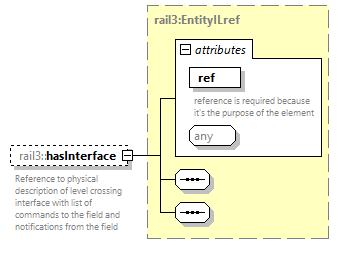 | ||||||||||||||
| namespace | https://www.railml.org/schemas/3.2 | ||||||||||||||
| type | rail3:EntityILref | ||||||||||||||
| properties |
| ||||||||||||||
| attributes |
| ||||||||||||||
| annotation |
| ||||||||||||||
| source | <xs:element name="hasInterface" type="rail3:EntityILref" minOccurs="0" maxOccurs="1"> <xs:annotation> <xs:documentation>Reference to physical description of level crossing interface with list of commands to the field and notifications from the field</xs:documentation> </xs:annotation> </xs:element> |
element LevelCrossingIL/isLevelCrossingType
| diagram | 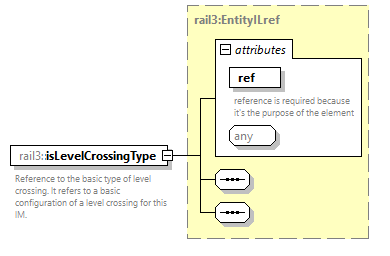 | ||||||||||||||
| namespace | https://www.railml.org/schemas/3.2 | ||||||||||||||
| type | rail3:EntityILref | ||||||||||||||
| properties |
| ||||||||||||||
| attributes |
| ||||||||||||||
| annotation |
| ||||||||||||||
| source | <xs:element name="isLevelCrossingType" type="rail3:EntityILref" minOccurs="1" maxOccurs="1"> <xs:annotation> <xs:documentation>Reference to the basic type of level crossing. It refers to a basic configuration of a level crossing for this IM.</xs:documentation> </xs:annotation> </xs:element> |
element LevelCrossingIL/refersTo
| diagram |  | ||||||||||||||
| namespace | https://www.railml.org/schemas/3.2 | ||||||||||||||
| type | rail3:EntityILref | ||||||||||||||
| properties |
| ||||||||||||||
| attributes |
| ||||||||||||||
| annotation |
| ||||||||||||||
| source | <xs:element name="refersTo" type="rail3:EntityILref" minOccurs="1" maxOccurs="1"> <xs:annotation> <xs:documentation>The reference to the physical level crossing in infrastructure.</xs:documentation> </xs:annotation> </xs:element> |
element LevelCrossingIL/deactivatedBy
| diagram | 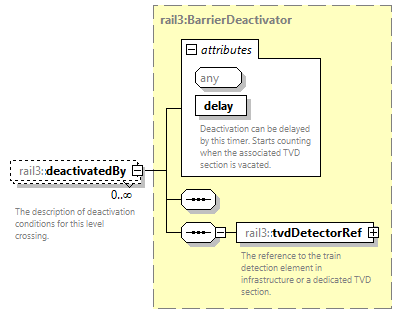 | ||||||||||||||
| namespace | https://www.railml.org/schemas/3.2 | ||||||||||||||
| type | rail3:BarrierDeactivator | ||||||||||||||
| properties |
| ||||||||||||||
| children | rail3:tvdDetectorRef | ||||||||||||||
| attributes |
| ||||||||||||||
| annotation |
| ||||||||||||||
| source | <xs:element name="deactivatedBy" type="rail3:BarrierDeactivator" minOccurs="0" maxOccurs="unbounded"> <xs:annotation> <xs:documentation>The description of deactivation conditions for this level crossing.</xs:documentation> </xs:annotation> </xs:element> |
element LevelCrossingIL/activationCondition
| diagram | 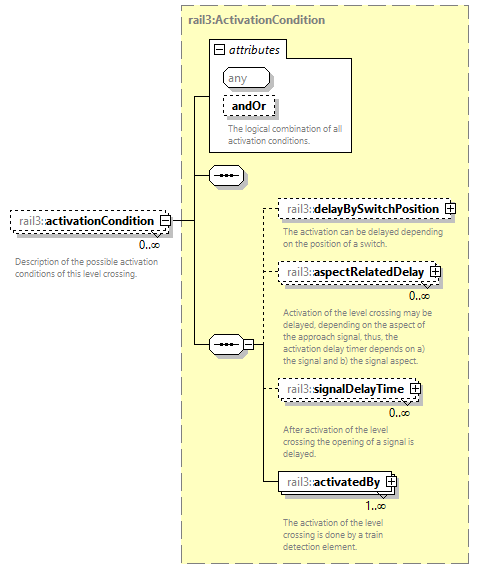 | ||||||||||||||
| namespace | https://www.railml.org/schemas/3.2 | ||||||||||||||
| type | rail3:ActivationCondition | ||||||||||||||
| properties |
| ||||||||||||||
| children | rail3:delayBySwitchPosition rail3:aspectRelatedDelay rail3:signalDelayTime rail3:activatedBy | ||||||||||||||
| attributes |
| ||||||||||||||
| annotation |
| ||||||||||||||
| source | <xs:element name="activationCondition" type="rail3:ActivationCondition" minOccurs="0" maxOccurs="unbounded"> <xs:annotation> <xs:documentation>Description of the possible activation conditions of this level crossing.</xs:documentation> </xs:annotation> </xs:element> |
element LevelCrossingIL/hasTvdSection
| diagram | 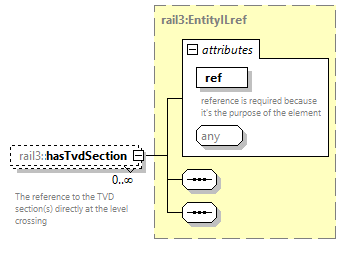 | ||||||||||||||
| namespace | https://www.railml.org/schemas/3.2 | ||||||||||||||
| type | rail3:EntityILref | ||||||||||||||
| properties |
| ||||||||||||||
| attributes |
| ||||||||||||||
| annotation |
| ||||||||||||||
| source | <xs:element name="hasTvdSection" type="rail3:EntityILref" minOccurs="0" maxOccurs="unbounded"> <xs:annotation> <xs:documentation>The reference to the TVD section(s) directly at the level crossing</xs:documentation> </xs:annotation> </xs:element> |
element LevelCrossingIL/hasLevelCrossingTrack
| diagram | 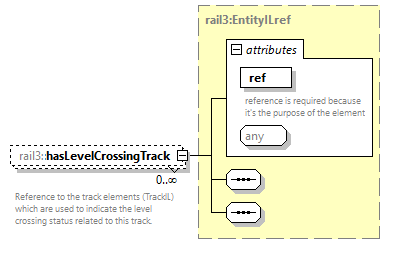 | ||||||||||||||
| namespace | https://www.railml.org/schemas/3.2 | ||||||||||||||
| type | rail3:EntityILref | ||||||||||||||
| properties |
| ||||||||||||||
| attributes |
| ||||||||||||||
| annotation |
| ||||||||||||||
| source | <xs:element name="hasLevelCrossingTrack" type="rail3:EntityILref" minOccurs="0" maxOccurs="unbounded"> <xs:annotation> <xs:documentation>Reference to the track elements (TrackIL) which are used to indicate the level crossing status related to this track.</xs:documentation> </xs:annotation> </xs:element> |
complexType LevelCrossingInState
| diagram | 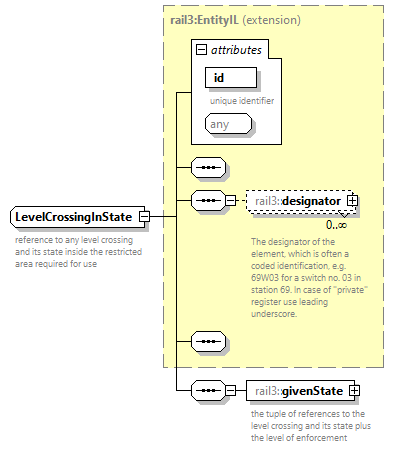 | ||||||||||||||
| namespace | https://www.railml.org/schemas/3.2 | ||||||||||||||
| type | extension of rail3:EntityIL | ||||||||||||||
| properties |
| ||||||||||||||
| children | rail3:designator rail3:givenState | ||||||||||||||
| used by |
| ||||||||||||||
| attributes |
| ||||||||||||||
| annotation |
| ||||||||||||||
| source | <xs:complexType name="LevelCrossingInState"> <xs:annotation> <xs:documentation>reference to any level crossing and its state inside the restricted area required for use</xs:documentation> </xs:annotation> <xs:complexContent> <xs:extension base="rail3:EntityIL"> <xs:sequence> <xs:element name="givenState" type="rail3:LevelCrossingAndGivenState" minOccurs="1" maxOccurs="1"> <xs:annotation> <xs:documentation>the tuple of references to the level crossing and its state plus the level of enforcement</xs:documentation> </xs:annotation> </xs:element> </xs:sequence> </xs:extension> </xs:complexContent> </xs:complexType> |
element LevelCrossingInState/givenState
| diagram | 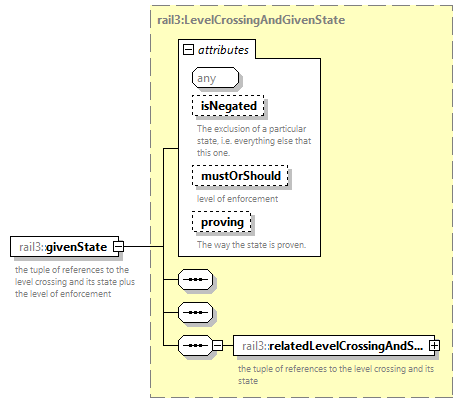 | ||||||||||||||||||||||||||||||
| namespace | https://www.railml.org/schemas/3.2 | ||||||||||||||||||||||||||||||
| type | rail3:LevelCrossingAndGivenState | ||||||||||||||||||||||||||||||
| properties |
| ||||||||||||||||||||||||||||||
| children | rail3:relatedLevelCrossingAndState | ||||||||||||||||||||||||||||||
| attributes |
| ||||||||||||||||||||||||||||||
| annotation |
| ||||||||||||||||||||||||||||||
| source | <xs:element name="givenState" type="rail3:LevelCrossingAndGivenState" minOccurs="1" maxOccurs="1"> <xs:annotation> <xs:documentation>the tuple of references to the level crossing and its state plus the level of enforcement</xs:documentation> </xs:annotation> </xs:element> |
complexType LevelCrossingsIL
| diagram | 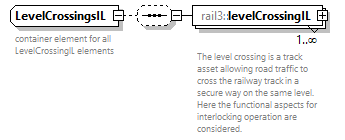 | ||
| namespace | https://www.railml.org/schemas/3.2 | ||
| children | rail3:levelCrossingIL | ||
| used by |
| ||
| annotation |
| ||
| source | <xs:complexType name="LevelCrossingsIL"> <xs:annotation> <xs:documentation>container element for all LevelCrossingIL elements</xs:documentation> </xs:annotation> <xs:sequence minOccurs="0" maxOccurs="1"> <xs:element name="levelCrossingIL" type="rail3:LevelCrossingIL" minOccurs="1" maxOccurs="unbounded"> <xs:annotation> <xs:documentation>The level crossing is a track asset allowing road traffic to cross the railway track in a secure way on the same level. Here the functional aspects for interlocking operation are considered.</xs:documentation> </xs:annotation> </xs:element> </xs:sequence> </xs:complexType> |
element LevelCrossingsIL/levelCrossingIL
| diagram |  | ||||||||||||||||||||||||||||||||||||||||||||||||||||||||||||||||||||||||||||||
| namespace | https://www.railml.org/schemas/3.2 | ||||||||||||||||||||||||||||||||||||||||||||||||||||||||||||||||||||||||||||||
| type | rail3:LevelCrossingIL | ||||||||||||||||||||||||||||||||||||||||||||||||||||||||||||||||||||||||||||||
| properties |
| ||||||||||||||||||||||||||||||||||||||||||||||||||||||||||||||||||||||||||||||
| children | rail3:designator rail3:assetName rail3:belongsToOperationalPoint rail3:hasCommand rail3:hasIndication rail3:hasInterface rail3:isLevelCrossingType rail3:refersTo rail3:deactivatedBy rail3:activationCondition rail3:hasTvdSection rail3:hasLevelCrossingTrack | ||||||||||||||||||||||||||||||||||||||||||||||||||||||||||||||||||||||||||||||
| attributes |
| ||||||||||||||||||||||||||||||||||||||||||||||||||||||||||||||||||||||||||||||
| annotation |
| ||||||||||||||||||||||||||||||||||||||||||||||||||||||||||||||||||||||||||||||
| source | <xs:element name="levelCrossingIL" type="rail3:LevelCrossingIL" minOccurs="1" maxOccurs="unbounded"> <xs:annotation> <xs:documentation>The level crossing is a track asset allowing road traffic to cross the railway track in a secure way on the same level. Here the functional aspects for interlocking operation are considered.</xs:documentation> </xs:annotation> </xs:element> |
complexType LevelCrossingTypeList
| diagram | 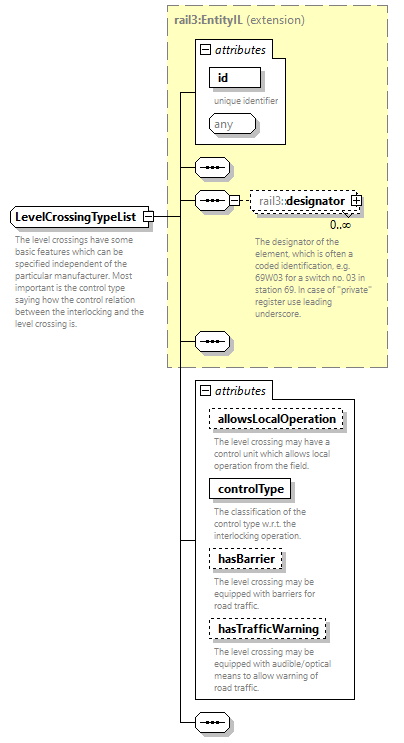 | ||||||||||||||||||||||||||||||||||||||||||||||
| namespace | https://www.railml.org/schemas/3.2 | ||||||||||||||||||||||||||||||||||||||||||||||
| type | extension of rail3:EntityIL | ||||||||||||||||||||||||||||||||||||||||||||||
| properties |
| ||||||||||||||||||||||||||||||||||||||||||||||
| children | rail3:designator | ||||||||||||||||||||||||||||||||||||||||||||||
| used by |
| ||||||||||||||||||||||||||||||||||||||||||||||
| attributes |
| ||||||||||||||||||||||||||||||||||||||||||||||
| annotation |
| ||||||||||||||||||||||||||||||||||||||||||||||
| source | <xs:complexType name="LevelCrossingTypeList"> <xs:annotation> <xs:documentation>The level crossings have some basic features which can be specified independent of the particular manufacturer. Most important is the control type saying how the control relation between the interlocking and the level crossing is.</xs:documentation> </xs:annotation> <xs:complexContent> <xs:extension base="rail3:EntityIL"> <xs:sequence/> <xs:attribute name="allowsLocalOperation" type="xs:boolean" use="optional"> <xs:annotation> <xs:documentation>The level crossing may have a control unit which allows local operation from the field.</xs:documentation> </xs:annotation> </xs:attribute> <xs:attribute name="controlType" type="rail3:tLevelCrossingControlTypes" use="required"> <xs:annotation> <xs:documentation>The classification of the control type w.r.t. the interlocking operation.</xs:documentation> </xs:annotation> </xs:attribute> <xs:attribute name="hasBarrier" type="xs:boolean" use="optional"> <xs:annotation> <xs:documentation>The level crossing may be equipped with barriers for road traffic.</xs:documentation> </xs:annotation> </xs:attribute> <xs:attribute name="hasTrafficWarning" type="xs:boolean" use="optional"> <xs:annotation> <xs:documentation>The level crossing may be equipped with audible/optical means to allow warning of road traffic.</xs:documentation> </xs:annotation> </xs:attribute> </xs:extension> </xs:complexContent> </xs:complexType> |
attribute LevelCrossingTypeList/@allowsLocalOperation
| type | xs:boolean | ||
| properties |
| ||
| annotation |
| ||
| source | <xs:attribute name="allowsLocalOperation" type="xs:boolean" use="optional"> <xs:annotation> <xs:documentation>The level crossing may have a control unit which allows local operation from the field.</xs:documentation> </xs:annotation> </xs:attribute> |
attribute LevelCrossingTypeList/@controlType
| type | rail3:tLevelCrossingControlTypes | ||||||||||||||||||
| properties |
| ||||||||||||||||||
| facets |
| ||||||||||||||||||
| annotation |
| ||||||||||||||||||
| source | <xs:attribute name="controlType" type="rail3:tLevelCrossingControlTypes" use="required"> <xs:annotation> <xs:documentation>The classification of the control type w.r.t. the interlocking operation.</xs:documentation> </xs:annotation> </xs:attribute> |
attribute LevelCrossingTypeList/@hasBarrier
| type | xs:boolean | ||
| properties |
| ||
| annotation |
| ||
| source | <xs:attribute name="hasBarrier" type="xs:boolean" use="optional"> <xs:annotation> <xs:documentation>The level crossing may be equipped with barriers for road traffic.</xs:documentation> </xs:annotation> </xs:attribute> |
attribute LevelCrossingTypeList/@hasTrafficWarning
| type | xs:boolean | ||
| properties |
| ||
| annotation |
| ||
| source | <xs:attribute name="hasTrafficWarning" type="xs:boolean" use="optional"> <xs:annotation> <xs:documentation>The level crossing may be equipped with audible/optical means to allow warning of road traffic.</xs:documentation> </xs:annotation> </xs:attribute> |
complexType LocalOperationArea
| diagram |  | ||||||||||||||||||||||||||||||
| namespace | https://www.railml.org/schemas/3.2 | ||||||||||||||||||||||||||||||
| type | extension of rail3:RestrictedArea | ||||||||||||||||||||||||||||||
| properties |
| ||||||||||||||||||||||||||||||
| children | rail3:designator rail3:assetName rail3:belongsToOperationalPoint rail3:hasCommand rail3:hasIndication rail3:isLimitedBy rail3:trackAssetInArea rail3:deactivationKey rail3:switchInPosition rail3:derailerInPosition rail3:crossingInPosition rail3:detectorInState rail3:signalWithAspect rail3:keyLockInState rail3:levelCrossingInState rail3:releasedForLocalOperation | ||||||||||||||||||||||||||||||
| used by |
| ||||||||||||||||||||||||||||||
| attributes |
| ||||||||||||||||||||||||||||||
| annotation |
| ||||||||||||||||||||||||||||||
| source | <xs:complexType name="LocalOperationArea"> <xs:annotation> <xs:documentation>Area used for local shunting movements without routes. Movable elements within the area might be operated from onsite panels. These areas are predefined for parts of a station.</xs:documentation> </xs:annotation> <xs:complexContent> <xs:extension base="rail3:RestrictedArea"> <xs:sequence> <xs:element name="deactivationKey" type="rail3:EntityILref" minOccurs="0" maxOccurs="unbounded"> <xs:annotation> <xs:documentation>reference to any physical device (key or button) used for deactivate the local operation area after use</xs:documentation> </xs:annotation> </xs:element> <xs:element name="switchInPosition" type="rail3:SwitchInPosition" minOccurs="0" maxOccurs="unbounded"> <xs:annotation> <xs:documentation>reference to any switch and its position inside or outside the local operation area required for use and/or protection</xs:documentation> </xs:annotation> </xs:element> <xs:element name="derailerInPosition" type="rail3:DerailerInPosition" minOccurs="0" maxOccurs="unbounded"> <xs:annotation> <xs:documentation>reference to any derailer and its position inside or outside the local operation area required for use and/or protection</xs:documentation> </xs:annotation> </xs:element> <xs:element name="crossingInPosition" type="rail3:CrossingInPosition" minOccurs="0" maxOccurs="unbounded"> <xs:annotation> <xs:documentation>reference to any movable crossing and its position inside or outside the local operation area required for use and/or protection</xs:documentation> </xs:annotation> </xs:element> <xs:element name="detectorInState" type="rail3:DetectorInState" minOccurs="0" maxOccurs="unbounded"> <xs:annotation> <xs:documentation>reference to any detector and its state inside or outside the local operation area required for use</xs:documentation> </xs:annotation> </xs:element> <xs:element name="signalWithAspect" type="rail3:SignalWithAspect" minOccurs="0" maxOccurs="unbounded"> <xs:annotation> <xs:documentation>reference to any signal and its aspect inside or outside the local operation area required for use and/or protection</xs:documentation> </xs:annotation> </xs:element> <xs:element name="keyLockInState" type="rail3:KeyLockInState" minOccurs="0" maxOccurs="unbounded"> <xs:annotation> <xs:documentation>reference to any key lock and its state inside or outside the local operation area required for use and/or protection</xs:documentation> </xs:annotation> </xs:element> <xs:element name="levelCrossingInState" type="rail3:LevelCrossingInState" minOccurs="0" maxOccurs="unbounded"> <xs:annotation> <xs:documentation>reference to any level crossing and its state inside the local operation area required for use</xs:documentation> </xs:annotation> </xs:element> <xs:element name="releasedForLocalOperation" type="rail3:EntityILref" minOccurs="0" maxOccurs="unbounded"> <xs:annotation> <xs:documentation>reference to any switchable element (keylock, switch, derailer, level crossing etc.), which is released for local operation, when the local operation area is active</xs:documentation> </xs:annotation> </xs:element> </xs:sequence> </xs:extension> </xs:complexContent> </xs:complexType> |
element LocalOperationArea/deactivationKey
| diagram | 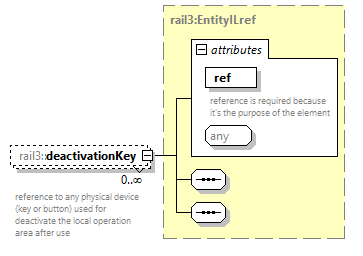 | ||||||||||||||
| namespace | https://www.railml.org/schemas/3.2 | ||||||||||||||
| type | rail3:EntityILref | ||||||||||||||
| properties |
| ||||||||||||||
| attributes |
| ||||||||||||||
| annotation |
| ||||||||||||||
| source | <xs:element name="deactivationKey" type="rail3:EntityILref" minOccurs="0" maxOccurs="unbounded"> <xs:annotation> <xs:documentation>reference to any physical device (key or button) used for deactivate the local operation area after use</xs:documentation> </xs:annotation> </xs:element> |
element LocalOperationArea/switchInPosition
| diagram | 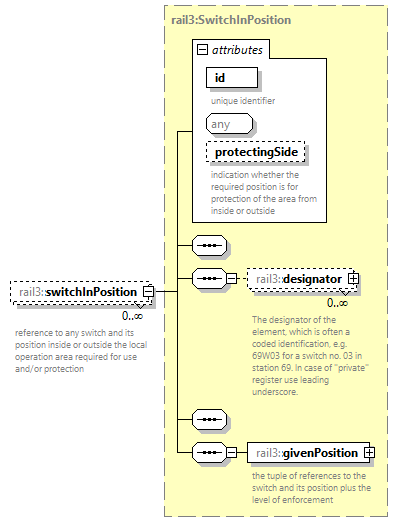 | ||||||||||||||||||||||
| namespace | https://www.railml.org/schemas/3.2 | ||||||||||||||||||||||
| type | rail3:SwitchInPosition | ||||||||||||||||||||||
| properties |
| ||||||||||||||||||||||
| children | rail3:designator rail3:givenPosition | ||||||||||||||||||||||
| attributes |
| ||||||||||||||||||||||
| annotation |
| ||||||||||||||||||||||
| source | <xs:element name="switchInPosition" type="rail3:SwitchInPosition" minOccurs="0" maxOccurs="unbounded"> <xs:annotation> <xs:documentation>reference to any switch and its position inside or outside the local operation area required for use and/or protection</xs:documentation> </xs:annotation> </xs:element> |
element LocalOperationArea/derailerInPosition
| diagram | 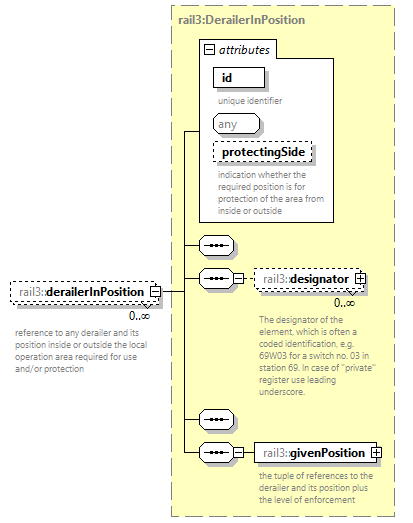 | ||||||||||||||||||||||
| namespace | https://www.railml.org/schemas/3.2 | ||||||||||||||||||||||
| type | rail3:DerailerInPosition | ||||||||||||||||||||||
| properties |
| ||||||||||||||||||||||
| children | rail3:designator rail3:givenPosition | ||||||||||||||||||||||
| attributes |
| ||||||||||||||||||||||
| annotation |
| ||||||||||||||||||||||
| source | <xs:element name="derailerInPosition" type="rail3:DerailerInPosition" minOccurs="0" maxOccurs="unbounded"> <xs:annotation> <xs:documentation>reference to any derailer and its position inside or outside the local operation area required for use and/or protection</xs:documentation> </xs:annotation> </xs:element> |
element LocalOperationArea/crossingInPosition
| diagram | 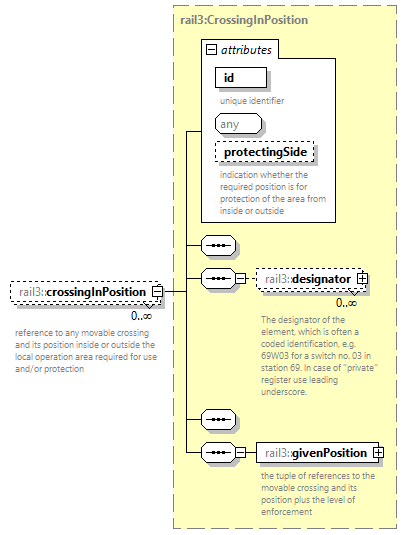 | ||||||||||||||||||||||
| namespace | https://www.railml.org/schemas/3.2 | ||||||||||||||||||||||
| type | rail3:CrossingInPosition | ||||||||||||||||||||||
| properties |
| ||||||||||||||||||||||
| children | rail3:designator rail3:givenPosition | ||||||||||||||||||||||
| attributes |
| ||||||||||||||||||||||
| annotation |
| ||||||||||||||||||||||
| source | <xs:element name="crossingInPosition" type="rail3:CrossingInPosition" minOccurs="0" maxOccurs="unbounded"> <xs:annotation> <xs:documentation>reference to any movable crossing and its position inside or outside the local operation area required for use and/or protection</xs:documentation> </xs:annotation> </xs:element> |
element LocalOperationArea/detectorInState
| diagram | 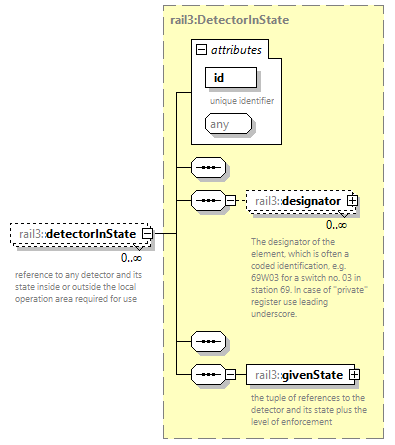 | ||||||||||||||
| namespace | https://www.railml.org/schemas/3.2 | ||||||||||||||
| type | rail3:DetectorInState | ||||||||||||||
| properties |
| ||||||||||||||
| children | rail3:designator rail3:givenState | ||||||||||||||
| attributes |
| ||||||||||||||
| annotation |
| ||||||||||||||
| source | <xs:element name="detectorInState" type="rail3:DetectorInState" minOccurs="0" maxOccurs="unbounded"> <xs:annotation> <xs:documentation>reference to any detector and its state inside or outside the local operation area required for use</xs:documentation> </xs:annotation> </xs:element> |
element LocalOperationArea/signalWithAspect
| diagram | 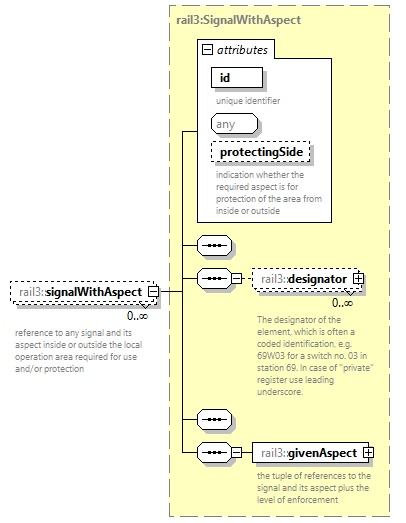 | ||||||||||||||||||||||
| namespace | https://www.railml.org/schemas/3.2 | ||||||||||||||||||||||
| type | rail3:SignalWithAspect | ||||||||||||||||||||||
| properties |
| ||||||||||||||||||||||
| children | rail3:designator rail3:givenAspect | ||||||||||||||||||||||
| attributes |
| ||||||||||||||||||||||
| annotation |
| ||||||||||||||||||||||
| source | <xs:element name="signalWithAspect" type="rail3:SignalWithAspect" minOccurs="0" maxOccurs="unbounded"> <xs:annotation> <xs:documentation>reference to any signal and its aspect inside or outside the local operation area required for use and/or protection</xs:documentation> </xs:annotation> </xs:element> |
element LocalOperationArea/keyLockInState
| diagram | 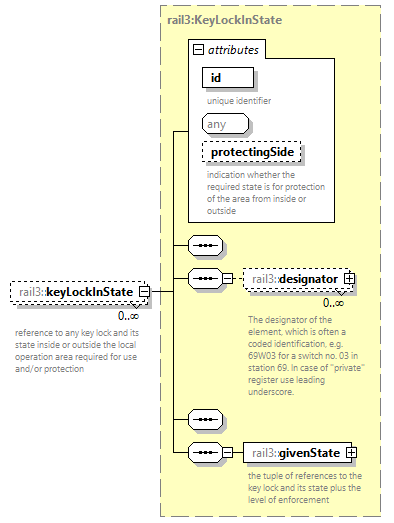 | ||||||||||||||||||||||
| namespace | https://www.railml.org/schemas/3.2 | ||||||||||||||||||||||
| type | rail3:KeyLockInState | ||||||||||||||||||||||
| properties |
| ||||||||||||||||||||||
| children | rail3:designator rail3:givenState | ||||||||||||||||||||||
| attributes |
| ||||||||||||||||||||||
| annotation |
| ||||||||||||||||||||||
| source | <xs:element name="keyLockInState" type="rail3:KeyLockInState" minOccurs="0" maxOccurs="unbounded"> <xs:annotation> <xs:documentation>reference to any key lock and its state inside or outside the local operation area required for use and/or protection</xs:documentation> </xs:annotation> </xs:element> |
element LocalOperationArea/levelCrossingInState
| diagram | 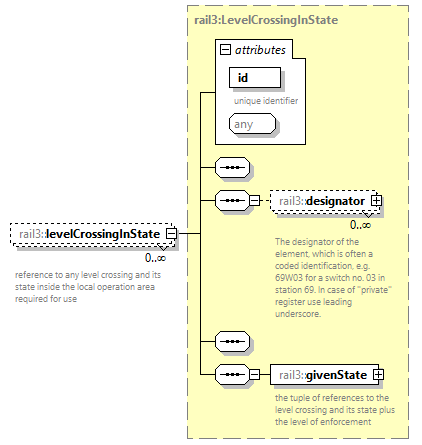 | ||||||||||||||
| namespace | https://www.railml.org/schemas/3.2 | ||||||||||||||
| type | rail3:LevelCrossingInState | ||||||||||||||
| properties |
| ||||||||||||||
| children | rail3:designator rail3:givenState | ||||||||||||||
| attributes |
| ||||||||||||||
| annotation |
| ||||||||||||||
| source | <xs:element name="levelCrossingInState" type="rail3:LevelCrossingInState" minOccurs="0" maxOccurs="unbounded"> <xs:annotation> <xs:documentation>reference to any level crossing and its state inside the local operation area required for use</xs:documentation> </xs:annotation> </xs:element> |
element LocalOperationArea/releasedForLocalOperation
| diagram | 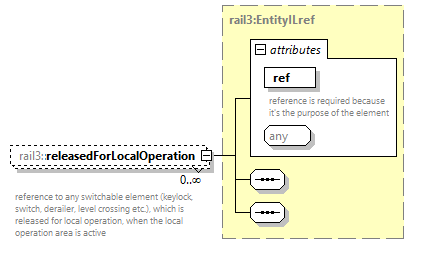 | ||||||||||||||
| namespace | https://www.railml.org/schemas/3.2 | ||||||||||||||
| type | rail3:EntityILref | ||||||||||||||
| properties |
| ||||||||||||||
| attributes |
| ||||||||||||||
| annotation |
| ||||||||||||||
| source | <xs:element name="releasedForLocalOperation" type="rail3:EntityILref" minOccurs="0" maxOccurs="unbounded"> <xs:annotation> <xs:documentation>reference to any switchable element (keylock, switch, derailer, level crossing etc.), which is released for local operation, when the local operation area is active</xs:documentation> </xs:annotation> </xs:element> |
complexType LocalOperationAreas
| diagram |  | ||
| namespace | https://www.railml.org/schemas/3.2 | ||
| children | rail3:localOperationArea | ||
| used by |
| ||
| source | <xs:complexType name="LocalOperationAreas"> <xs:sequence> <xs:element name="localOperationArea" type="rail3:LocalOperationArea" minOccurs="1" maxOccurs="unbounded"> <xs:annotation> <xs:documentation>Area used for local shunting movements without routes. Movable elements within the area might be operated from onsite panels.</xs:documentation> </xs:annotation> </xs:element> </xs:sequence> </xs:complexType> |
element LocalOperationAreas/localOperationArea
| diagram |  | ||||||||||||||||||||||||||||||
| namespace | https://www.railml.org/schemas/3.2 | ||||||||||||||||||||||||||||||
| type | rail3:LocalOperationArea | ||||||||||||||||||||||||||||||
| properties |
| ||||||||||||||||||||||||||||||
| children | rail3:designator rail3:assetName rail3:belongsToOperationalPoint rail3:hasCommand rail3:hasIndication rail3:isLimitedBy rail3:trackAssetInArea rail3:deactivationKey rail3:switchInPosition rail3:derailerInPosition rail3:crossingInPosition rail3:detectorInState rail3:signalWithAspect rail3:keyLockInState rail3:levelCrossingInState rail3:releasedForLocalOperation | ||||||||||||||||||||||||||||||
| attributes |
| ||||||||||||||||||||||||||||||
| annotation |
| ||||||||||||||||||||||||||||||
| source | <xs:element name="localOperationArea" type="rail3:LocalOperationArea" minOccurs="1" maxOccurs="unbounded"> <xs:annotation> <xs:documentation>Area used for local shunting movements without routes. Movable elements within the area might be operated from onsite panels.</xs:documentation> </xs:annotation> </xs:element> |
complexType LockAndGivenState
| diagram | 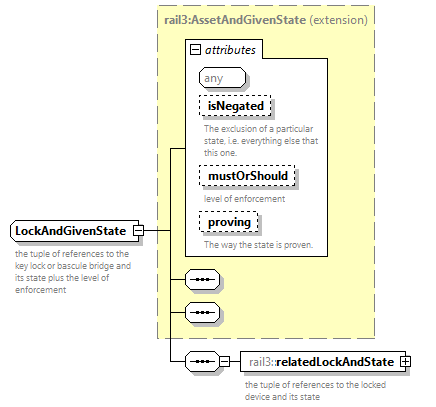 | ||||||||||||||||||||||||||||||
| namespace | https://www.railml.org/schemas/3.2 | ||||||||||||||||||||||||||||||
| type | extension of rail3:AssetAndGivenState | ||||||||||||||||||||||||||||||
| properties |
| ||||||||||||||||||||||||||||||
| children | rail3:relatedLockAndState | ||||||||||||||||||||||||||||||
| used by |
| ||||||||||||||||||||||||||||||
| attributes |
| ||||||||||||||||||||||||||||||
| annotation |
| ||||||||||||||||||||||||||||||
| source | <xs:complexType name="LockAndGivenState"> <xs:annotation> <xs:documentation>the tuple of references to the key lock or bascule bridge and its state plus the level of enforcement</xs:documentation> </xs:annotation> <xs:complexContent> <xs:extension base="rail3:AssetAndGivenState"> <xs:sequence> <xs:element name="relatedLockAndState" type="rail3:LockAndState" minOccurs="1" maxOccurs="1"> <xs:annotation> <xs:documentation>the tuple of references to the locked device and its state</xs:documentation> </xs:annotation> </xs:element> </xs:sequence> </xs:extension> </xs:complexContent> </xs:complexType> |
element LockAndGivenState/relatedLockAndState
| diagram | 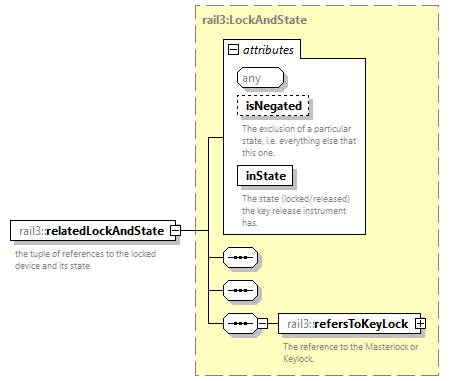 | ||||||||||||||||||||||
| namespace | https://www.railml.org/schemas/3.2 | ||||||||||||||||||||||
| type | rail3:LockAndState | ||||||||||||||||||||||
| properties |
| ||||||||||||||||||||||
| children | rail3:refersToKeyLock | ||||||||||||||||||||||
| attributes |
| ||||||||||||||||||||||
| annotation |
| ||||||||||||||||||||||
| source | <xs:element name="relatedLockAndState" type="rail3:LockAndState" minOccurs="1" maxOccurs="1"> <xs:annotation> <xs:documentation>the tuple of references to the locked device and its state</xs:documentation> </xs:annotation> </xs:element> |
complexType LockAndState
| diagram | 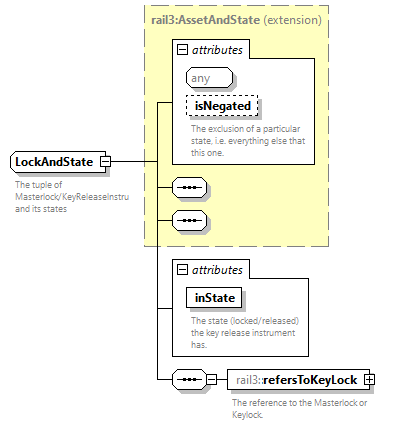 | ||||||||||||||||||||||
| namespace | https://www.railml.org/schemas/3.2 | ||||||||||||||||||||||
| type | extension of rail3:AssetAndState | ||||||||||||||||||||||
| properties |
| ||||||||||||||||||||||
| children | rail3:refersToKeyLock | ||||||||||||||||||||||
| used by |
| ||||||||||||||||||||||
| attributes |
| ||||||||||||||||||||||
| annotation |
| ||||||||||||||||||||||
| source | <xs:complexType name="LockAndState"> <xs:annotation> <xs:documentation>The tuple of Masterlock/KeyReleaseInstrument and its states</xs:documentation> </xs:annotation> <xs:complexContent> <xs:extension base="rail3:AssetAndState"> <xs:sequence> <xs:element name="refersToKeyLock" type="rail3:EntityILref" minOccurs="1" maxOccurs="1"> <xs:annotation> <xs:documentation>The reference to the Masterlock or Keylock.</xs:documentation> </xs:annotation> </xs:element> </xs:sequence> <xs:attribute name="inState" type="rail3:tLockState" use="required"> <xs:annotation> <xs:documentation>The state (locked/released) the key release instrument has.</xs:documentation> </xs:annotation> </xs:attribute> </xs:extension> </xs:complexContent> </xs:complexType> |
attribute LockAndState/@inState
| type | rail3:tLockState | |||||||||||||
| properties |
| |||||||||||||
| facets |
| |||||||||||||
| annotation |
| |||||||||||||
| source | <xs:attribute name="inState" type="rail3:tLockState" use="required"> <xs:annotation> <xs:documentation>The state (locked/released) the key release instrument has.</xs:documentation> </xs:annotation> </xs:attribute> |
element LockAndState/refersToKeyLock
| diagram | 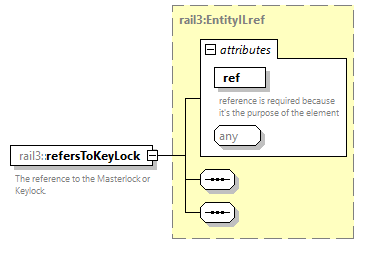 | ||||||||||||||
| namespace | https://www.railml.org/schemas/3.2 | ||||||||||||||
| type | rail3:EntityILref | ||||||||||||||
| properties |
| ||||||||||||||
| attributes |
| ||||||||||||||
| annotation |
| ||||||||||||||
| source | <xs:element name="refersToKeyLock" type="rail3:EntityILref" minOccurs="1" maxOccurs="1"> <xs:annotation> <xs:documentation>The reference to the Masterlock or Keylock.</xs:documentation> </xs:annotation> </xs:element> |
complexType LogicalDevice
| diagram | 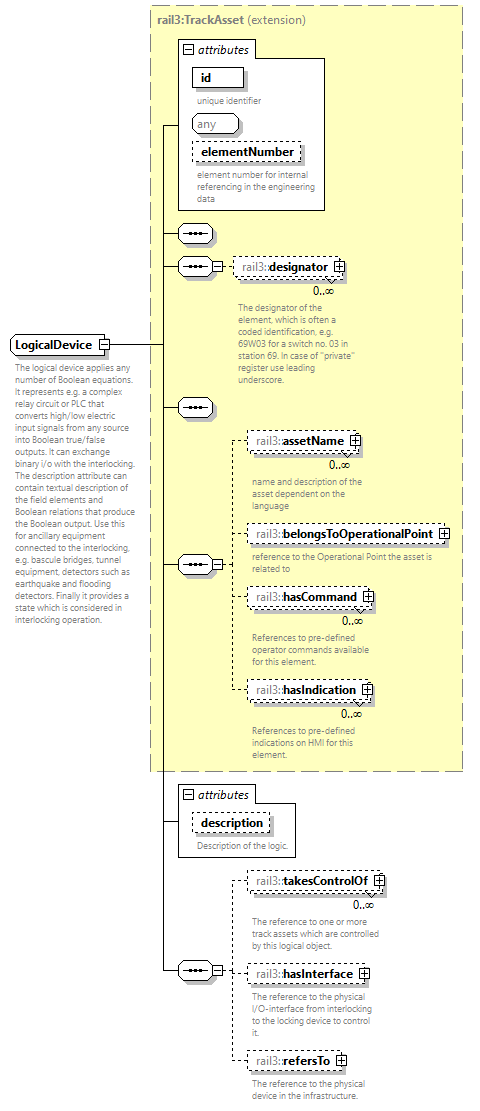 | ||||||||||||||||||||||||||||||
| namespace | https://www.railml.org/schemas/3.2 | ||||||||||||||||||||||||||||||
| type | extension of rail3:TrackAsset | ||||||||||||||||||||||||||||||
| properties |
| ||||||||||||||||||||||||||||||
| children | rail3:designator rail3:assetName rail3:belongsToOperationalPoint rail3:hasCommand rail3:hasIndication rail3:takesControlOf rail3:hasInterface rail3:refersTo | ||||||||||||||||||||||||||||||
| used by |
| ||||||||||||||||||||||||||||||
| attributes |
| ||||||||||||||||||||||||||||||
| annotation |
| ||||||||||||||||||||||||||||||
| source | <xs:complexType name="LogicalDevice" abstract="true"> <xs:annotation> <xs:documentation>The logical device applies any number of Boolean equations. It represents e.g. a complex relay circuit or PLC that converts high/low electric input signals from any source into Boolean true/false outputs. It can exchange binary i/o with the interlocking. The description attribute can contain textual description of the field elements and Boolean relations that produce the Boolean output. Use this for ancillary equipment connected to the interlocking, e.g. bascule bridges, tunnel equipment, detectors such as earthquake and flooding detectors. Finally it provides a state which is considered in interlocking operation.</xs:documentation> </xs:annotation> <xs:complexContent> <xs:extension base="rail3:TrackAsset"> <xs:sequence> <xs:element name="takesControlOf" type="rail3:EntityILref" minOccurs="0" maxOccurs="unbounded"> <xs:annotation> <xs:documentation>The reference to one or more track assets which are controlled by this logical object.</xs:documentation> </xs:annotation> </xs:element> <xs:element name="hasInterface" type="rail3:EntityILref" minOccurs="0" maxOccurs="1"> <xs:annotation> <xs:documentation>The reference to the physical I/O-interface from interlocking to the locking device to control it.</xs:documentation> </xs:annotation> </xs:element> <xs:element name="refersTo" type="rail3:EntityILref" minOccurs="0" maxOccurs="1"> <xs:annotation> <xs:documentation>The reference to the physical device in the infrastructure.</xs:documentation> </xs:annotation> </xs:element> </xs:sequence> <xs:attribute name="description" type="xs:string" use="optional"> <xs:annotation> <xs:documentation>Description of the logic.</xs:documentation> </xs:annotation> </xs:attribute> </xs:extension> </xs:complexContent> </xs:complexType> |
attribute LogicalDevice/@description
| type | xs:string | ||
| properties |
| ||
| annotation |
| ||
| source | <xs:attribute name="description" type="xs:string" use="optional"> <xs:annotation> <xs:documentation>Description of the logic.</xs:documentation> </xs:annotation> </xs:attribute> |
element LogicalDevice/takesControlOf
| diagram | 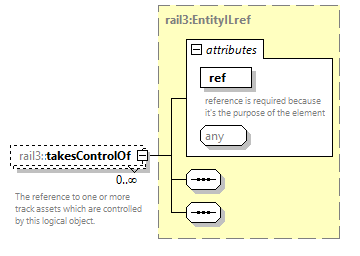 | ||||||||||||||
| namespace | https://www.railml.org/schemas/3.2 | ||||||||||||||
| type | rail3:EntityILref | ||||||||||||||
| properties |
| ||||||||||||||
| attributes |
| ||||||||||||||
| annotation |
| ||||||||||||||
| source | <xs:element name="takesControlOf" type="rail3:EntityILref" minOccurs="0" maxOccurs="unbounded"> <xs:annotation> <xs:documentation>The reference to one or more track assets which are controlled by this logical object.</xs:documentation> </xs:annotation> </xs:element> |
element LogicalDevice/hasInterface
| diagram | 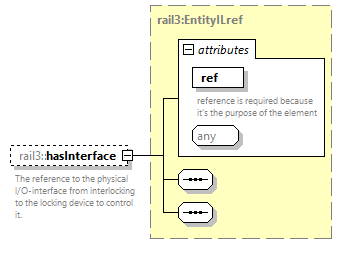 | ||||||||||||||
| namespace | https://www.railml.org/schemas/3.2 | ||||||||||||||
| type | rail3:EntityILref | ||||||||||||||
| properties |
| ||||||||||||||
| attributes |
| ||||||||||||||
| annotation |
| ||||||||||||||
| source | <xs:element name="hasInterface" type="rail3:EntityILref" minOccurs="0" maxOccurs="1"> <xs:annotation> <xs:documentation>The reference to the physical I/O-interface from interlocking to the locking device to control it.</xs:documentation> </xs:annotation> </xs:element> |
element LogicalDevice/refersTo
| diagram | 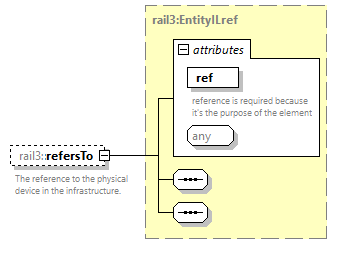 | ||||||||||||||
| namespace | https://www.railml.org/schemas/3.2 | ||||||||||||||
| type | rail3:EntityILref | ||||||||||||||
| properties |
| ||||||||||||||
| attributes |
| ||||||||||||||
| annotation |
| ||||||||||||||
| source | <xs:element name="refersTo" type="rail3:EntityILref" minOccurs="0" maxOccurs="1"> <xs:annotation> <xs:documentation>The reference to the physical device in the infrastructure.</xs:documentation> </xs:annotation> </xs:element> |
complexType MovableBridge
| diagram | 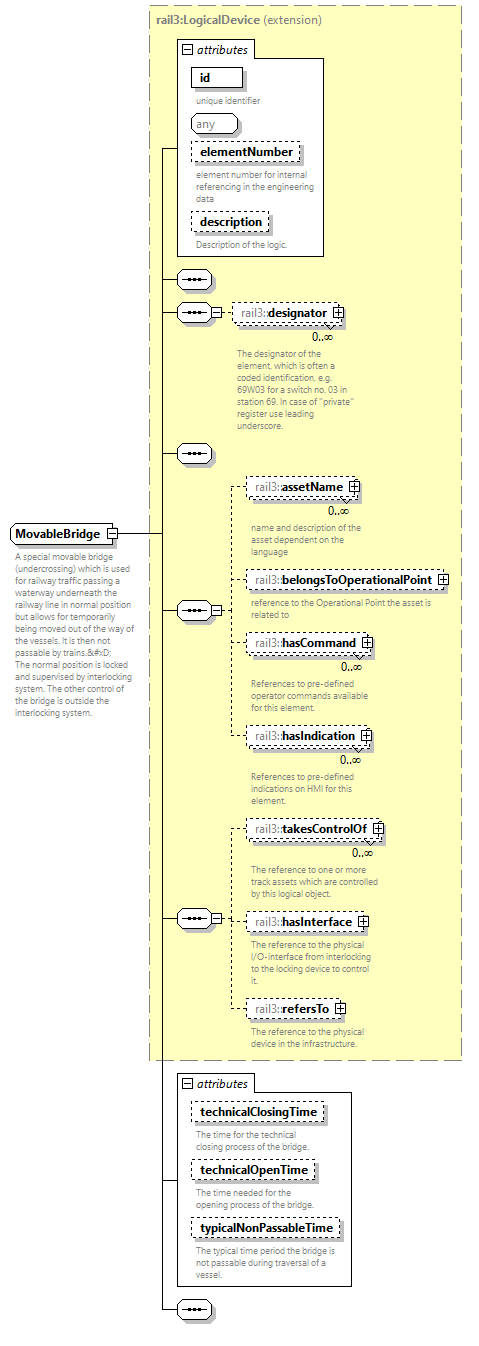 | ||||||||||||||||||||||||||||||||||||||||||||||||||||||
| namespace | https://www.railml.org/schemas/3.2 | ||||||||||||||||||||||||||||||||||||||||||||||||||||||
| type | extension of rail3:LogicalDevice | ||||||||||||||||||||||||||||||||||||||||||||||||||||||
| properties |
| ||||||||||||||||||||||||||||||||||||||||||||||||||||||
| children | rail3:designator rail3:assetName rail3:belongsToOperationalPoint rail3:hasCommand rail3:hasIndication rail3:takesControlOf rail3:hasInterface rail3:refersTo | ||||||||||||||||||||||||||||||||||||||||||||||||||||||
| used by |
| ||||||||||||||||||||||||||||||||||||||||||||||||||||||
| attributes |
| ||||||||||||||||||||||||||||||||||||||||||||||||||||||
| annotation |
| ||||||||||||||||||||||||||||||||||||||||||||||||||||||
| source | <xs:complexType name="MovableBridge"> <xs:annotation> <xs:documentation>A special movable bridge (undercrossing) which is used for railway traffic passing a waterway underneath the railway line in normal position but allows for temporarily being moved out of the way of the vessels. It is then not passable by trains.
 The normal position is locked and supervised by interlocking system. The other control of the bridge is outside the interlocking system.</xs:documentation> </xs:annotation> <xs:complexContent> <xs:extension base="rail3:LogicalDevice"> <xs:sequence/> <xs:attribute name="technicalClosingTime" type="xs:duration" use="optional"> <xs:annotation> <xs:documentation>The time for the technical closing process of the bridge.</xs:documentation> </xs:annotation> </xs:attribute> <xs:attribute name="technicalOpenTime" type="xs:duration" use="optional"> <xs:annotation> <xs:documentation>The time needed for the opening process of the bridge.</xs:documentation> </xs:annotation> </xs:attribute> <xs:attribute name="typicalNonPassableTime" type="xs:duration" use="optional"> <xs:annotation> <xs:documentation>The typical time period the bridge is not passable during traversal of a vessel.</xs:documentation> </xs:annotation> </xs:attribute> </xs:extension> </xs:complexContent> </xs:complexType> |
attribute MovableBridge/@technicalClosingTime
| type | xs:duration | ||
| properties |
| ||
| annotation |
| ||
| source | <xs:attribute name="technicalClosingTime" type="xs:duration" use="optional"> <xs:annotation> <xs:documentation>The time for the technical closing process of the bridge.</xs:documentation> </xs:annotation> </xs:attribute> |
attribute MovableBridge/@technicalOpenTime
| type | xs:duration | ||
| properties |
| ||
| annotation |
| ||
| source | <xs:attribute name="technicalOpenTime" type="xs:duration" use="optional"> <xs:annotation> <xs:documentation>The time needed for the opening process of the bridge.</xs:documentation> </xs:annotation> </xs:attribute> |
attribute MovableBridge/@typicalNonPassableTime
| type | xs:duration | ||
| properties |
| ||
| annotation |
| ||
| source | <xs:attribute name="typicalNonPassableTime" type="xs:duration" use="optional"> <xs:annotation> <xs:documentation>The typical time period the bridge is not passable during traversal of a vessel.</xs:documentation> </xs:annotation> </xs:attribute> |
complexType MovableBridges
| diagram |  | ||
| namespace | https://www.railml.org/schemas/3.2 | ||
| children | rail3:movableBridge | ||
| used by |
| ||
| annotation |
| ||
| source | <xs:complexType name="MovableBridges"> <xs:annotation> <xs:documentation>container for all basculeBridge elements</xs:documentation> </xs:annotation> <xs:sequence> <xs:element name="movableBridge" type="rail3:MovableBridge" minOccurs="1" maxOccurs="unbounded"> <xs:annotation> <xs:documentation>The contained basculeBridge element</xs:documentation> </xs:annotation> </xs:element> </xs:sequence> </xs:complexType> |
element MovableBridges/movableBridge
| diagram | 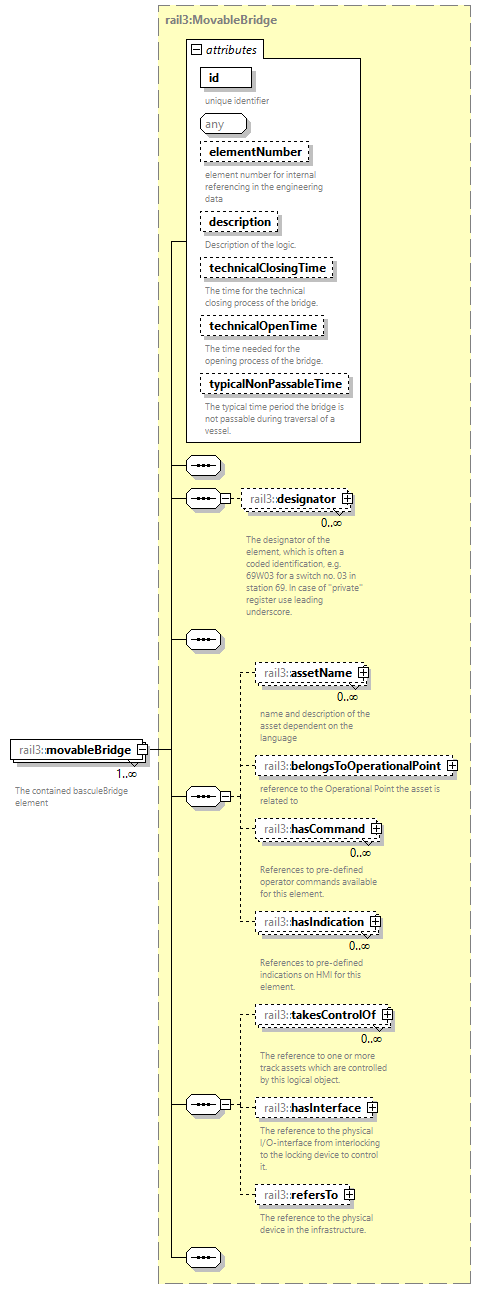 | ||||||||||||||||||||||||||||||||||||||||||||||||||||||
| namespace | https://www.railml.org/schemas/3.2 | ||||||||||||||||||||||||||||||||||||||||||||||||||||||
| type | rail3:MovableBridge | ||||||||||||||||||||||||||||||||||||||||||||||||||||||
| properties |
| ||||||||||||||||||||||||||||||||||||||||||||||||||||||
| children | rail3:designator rail3:assetName rail3:belongsToOperationalPoint rail3:hasCommand rail3:hasIndication rail3:takesControlOf rail3:hasInterface rail3:refersTo | ||||||||||||||||||||||||||||||||||||||||||||||||||||||
| attributes |
| ||||||||||||||||||||||||||||||||||||||||||||||||||||||
| annotation |
| ||||||||||||||||||||||||||||||||||||||||||||||||||||||
| source | <xs:element name="movableBridge" type="rail3:MovableBridge" minOccurs="1" maxOccurs="unbounded"> <xs:annotation> <xs:documentation>The contained basculeBridge element</xs:documentation> </xs:annotation> </xs:element> |
complexType MovableCrossing
| diagram |  | ||||||||||||||||||||||||||||||||||||||||||||||||||||||||||||||||||||||||||||||||||||
| namespace | https://www.railml.org/schemas/3.2 | ||||||||||||||||||||||||||||||||||||||||||||||||||||||||||||||||||||||||||||||||||||
| type | extension of rail3:MovableElement | ||||||||||||||||||||||||||||||||||||||||||||||||||||||||||||||||||||||||||||||||||||
| properties |
| ||||||||||||||||||||||||||||||||||||||||||||||||||||||||||||||||||||||||||||||||||||
| children | rail3:designator rail3:assetName rail3:belongsToOperationalPoint rail3:hasCommand rail3:hasIndication rail3:refersTo rail3:hasGaugeClearanceMarker rail3:hasTvdSection rail3:connectedToPowerSupply rail3:relatedMovableElement rail3:branchUpLeft rail3:branchUpRight rail3:branchDownLeft rail3:branchDownRight rail3:hasFoulingTrainDetectors | ||||||||||||||||||||||||||||||||||||||||||||||||||||||||||||||||||||||||||||||||||||
| used by |
| ||||||||||||||||||||||||||||||||||||||||||||||||||||||||||||||||||||||||||||||||||||
| attributes |
| ||||||||||||||||||||||||||||||||||||||||||||||||||||||||||||||||||||||||||||||||||||
| annotation |
| ||||||||||||||||||||||||||||||||||||||||||||||||||||||||||||||||||||||||||||||||||||
| source | <xs:complexType name="MovableCrossing"> <xs:annotation> <xs:documentation>Crossings are a special item for interlockings as a position is required for them even if there is no really movable item trackside.
 Some crossings, especially high speed ones, have a movable frog to close the gap at the crossing (UK: movable nose crossing, DE: Herzstück mit beweglicher Spitze, NL: kruising met beweegbaar puntstuk). Unlike a switch, such a movable frog will not send the train left or right but it does guide the train. Thus the position is essential for avoiding derailment. Do not confound this class with ordinary double or single slip switches. The latter are regarded as two back-to-back switches.</xs:documentation> </xs:annotation> <xs:complexContent> <xs:extension base="rail3:MovableElement"> <xs:sequence> <xs:element name="branchUpLeft" type="rail3:EntityILref" minOccurs="1" maxOccurs="1"> <xs:annotation> <xs:documentation>Referral to the physical track that connects from upper left side to the crossing.</xs:documentation> </xs:annotation> </xs:element> <xs:element name="branchUpRight" type="rail3:EntityILref" minOccurs="1" maxOccurs="1"> <xs:annotation> <xs:documentation>Referral to the physical track that connects from upper right side to the crossing.</xs:documentation> </xs:annotation> </xs:element> <xs:element name="branchDownLeft" type="rail3:EntityILref" minOccurs="1" maxOccurs="1"> <xs:annotation> <xs:documentation>Referral to the physical track that connects from lower left side to the crossing.</xs:documentation> </xs:annotation> </xs:element> <xs:element name="branchDownRight" type="rail3:EntityILref" minOccurs="1" maxOccurs="1"> <xs:annotation> <xs:documentation>Referral to the physical track that connects from lower right side to the crossing.</xs:documentation> </xs:annotation> </xs:element> <xs:element name="hasFoulingTrainDetectors" type="rail3:EntityILref" minOccurs="0" maxOccurs="unbounded"> <xs:annotation> <xs:documentation>This is the reference to the train detectors delimiting the TVD section of this crossing, which are too close and cannot guarantee a clear gauge of the set track.</xs:documentation> </xs:annotation> </xs:element> </xs:sequence> <xs:attribute name="preferredPosition" type="rail3:tCrossingPosition" use="optional"> <xs:annotation> <xs:documentation>This is the preferred position of the crossing which it is switched to when not in use.</xs:documentation> </xs:annotation> </xs:attribute> </xs:extension> </xs:complexContent> </xs:complexType> |
attribute MovableCrossing/@preferredPosition
| type | rail3:tCrossingPosition | |||||||||||||
| properties |
| |||||||||||||
| facets |
| |||||||||||||
| annotation |
| |||||||||||||
| source | <xs:attribute name="preferredPosition" type="rail3:tCrossingPosition" use="optional"> <xs:annotation> <xs:documentation>This is the preferred position of the crossing which it is switched to when not in use.</xs:documentation> </xs:annotation> </xs:attribute> |
element MovableCrossing/branchUpLeft
| diagram | 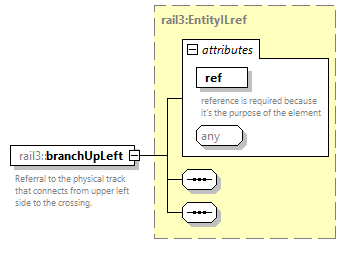 | ||||||||||||||
| namespace | https://www.railml.org/schemas/3.2 | ||||||||||||||
| type | rail3:EntityILref | ||||||||||||||
| properties |
| ||||||||||||||
| attributes |
| ||||||||||||||
| annotation |
| ||||||||||||||
| source | <xs:element name="branchUpLeft" type="rail3:EntityILref" minOccurs="1" maxOccurs="1"> <xs:annotation> <xs:documentation>Referral to the physical track that connects from upper left side to the crossing.</xs:documentation> </xs:annotation> </xs:element> |
element MovableCrossing/branchUpRight
| diagram | 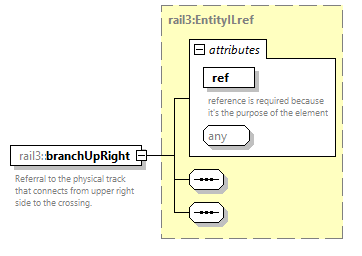 | ||||||||||||||
| namespace | https://www.railml.org/schemas/3.2 | ||||||||||||||
| type | rail3:EntityILref | ||||||||||||||
| properties |
| ||||||||||||||
| attributes |
| ||||||||||||||
| annotation |
| ||||||||||||||
| source | <xs:element name="branchUpRight" type="rail3:EntityILref" minOccurs="1" maxOccurs="1"> <xs:annotation> <xs:documentation>Referral to the physical track that connects from upper right side to the crossing.</xs:documentation> </xs:annotation> </xs:element> |
element MovableCrossing/branchDownLeft
| diagram | 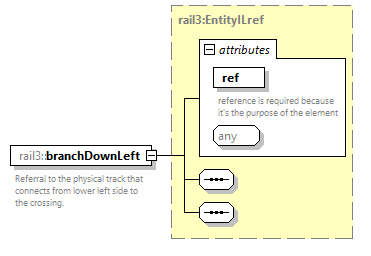 | ||||||||||||||
| namespace | https://www.railml.org/schemas/3.2 | ||||||||||||||
| type | rail3:EntityILref | ||||||||||||||
| properties |
| ||||||||||||||
| attributes |
| ||||||||||||||
| annotation |
| ||||||||||||||
| source | <xs:element name="branchDownLeft" type="rail3:EntityILref" minOccurs="1" maxOccurs="1"> <xs:annotation> <xs:documentation>Referral to the physical track that connects from lower left side to the crossing.</xs:documentation> </xs:annotation> </xs:element> |
element MovableCrossing/branchDownRight
| diagram | 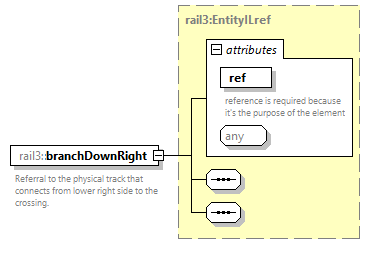 | ||||||||||||||
| namespace | https://www.railml.org/schemas/3.2 | ||||||||||||||
| type | rail3:EntityILref | ||||||||||||||
| properties |
| ||||||||||||||
| attributes |
| ||||||||||||||
| annotation |
| ||||||||||||||
| source | <xs:element name="branchDownRight" type="rail3:EntityILref" minOccurs="1" maxOccurs="1"> <xs:annotation> <xs:documentation>Referral to the physical track that connects from lower right side to the crossing.</xs:documentation> </xs:annotation> </xs:element> |
element MovableCrossing/hasFoulingTrainDetectors
| diagram | 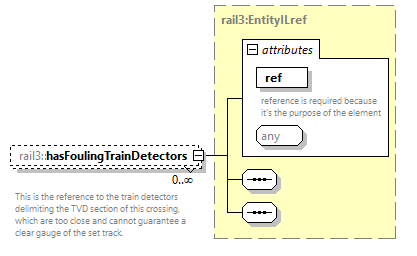 | ||||||||||||||
| namespace | https://www.railml.org/schemas/3.2 | ||||||||||||||
| type | rail3:EntityILref | ||||||||||||||
| properties |
| ||||||||||||||
| attributes |
| ||||||||||||||
| annotation |
| ||||||||||||||
| source | <xs:element name="hasFoulingTrainDetectors" type="rail3:EntityILref" minOccurs="0" maxOccurs="unbounded"> <xs:annotation> <xs:documentation>This is the reference to the train detectors delimiting the TVD section of this crossing, which are too close and cannot guarantee a clear gauge of the set track.</xs:documentation> </xs:annotation> </xs:element> |
complexType MovableCrossings
| diagram | 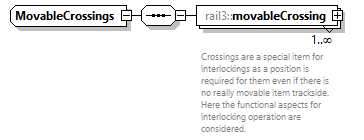 | ||
| namespace | https://www.railml.org/schemas/3.2 | ||
| children | rail3:movableCrossing | ||
| used by |
| ||
| source | <xs:complexType name="MovableCrossings"> <xs:sequence> <xs:element name="movableCrossing" type="rail3:MovableCrossing" minOccurs="1" maxOccurs="unbounded"> <xs:annotation> <xs:documentation>Crossings are a special item for interlockings as a position is required for them even if there is no really movable item trackside. Here the functional aspects for interlocking operation are considered.</xs:documentation> </xs:annotation> </xs:element> </xs:sequence> </xs:complexType> |
element MovableCrossings/movableCrossing
| diagram |  | ||||||||||||||||||||||||||||||||||||||||||||||||||||||||||||||||||||||||||||||||||||
| namespace | https://www.railml.org/schemas/3.2 | ||||||||||||||||||||||||||||||||||||||||||||||||||||||||||||||||||||||||||||||||||||
| type | rail3:MovableCrossing | ||||||||||||||||||||||||||||||||||||||||||||||||||||||||||||||||||||||||||||||||||||
| properties |
| ||||||||||||||||||||||||||||||||||||||||||||||||||||||||||||||||||||||||||||||||||||
| children | rail3:designator rail3:assetName rail3:belongsToOperationalPoint rail3:hasCommand rail3:hasIndication rail3:refersTo rail3:hasGaugeClearanceMarker rail3:hasTvdSection rail3:connectedToPowerSupply rail3:relatedMovableElement rail3:branchUpLeft rail3:branchUpRight rail3:branchDownLeft rail3:branchDownRight rail3:hasFoulingTrainDetectors | ||||||||||||||||||||||||||||||||||||||||||||||||||||||||||||||||||||||||||||||||||||
| attributes |
| ||||||||||||||||||||||||||||||||||||||||||||||||||||||||||||||||||||||||||||||||||||
| annotation |
| ||||||||||||||||||||||||||||||||||||||||||||||||||||||||||||||||||||||||||||||||||||
| source | <xs:element name="movableCrossing" type="rail3:MovableCrossing" minOccurs="1" maxOccurs="unbounded"> <xs:annotation> <xs:documentation>Crossings are a special item for interlockings as a position is required for them even if there is no really movable item trackside. Here the functional aspects for interlocking operation are considered.</xs:documentation> </xs:annotation> </xs:element> |
complexType MovableElement
| diagram |  | ||||||||||||||||||||||||||||||||||||||||||||||||||||||||||||||||||||||||||||
| namespace | https://www.railml.org/schemas/3.2 | ||||||||||||||||||||||||||||||||||||||||||||||||||||||||||||||||||||||||||||
| type | extension of rail3:TrackAsset | ||||||||||||||||||||||||||||||||||||||||||||||||||||||||||||||||||||||||||||
| properties |
| ||||||||||||||||||||||||||||||||||||||||||||||||||||||||||||||||||||||||||||
| children | rail3:designator rail3:assetName rail3:belongsToOperationalPoint rail3:hasCommand rail3:hasIndication rail3:refersTo rail3:hasGaugeClearanceMarker rail3:hasTvdSection rail3:connectedToPowerSupply rail3:relatedMovableElement | ||||||||||||||||||||||||||||||||||||||||||||||||||||||||||||||||||||||||||||
| used by |
| ||||||||||||||||||||||||||||||||||||||||||||||||||||||||||||||||||||||||||||
| attributes |
| ||||||||||||||||||||||||||||||||||||||||||||||||||||||||||||||||||||||||||||
| annotation |
| ||||||||||||||||||||||||||||||||||||||||||||||||||||||||||||||||||||||||||||
| source | <xs:complexType name="MovableElement" abstract="true"> <xs:annotation> <xs:documentation>Abstract element defining the attributes common to movable elements. The movable element refers to TrackAsset, thus creating a link to the IS namespace.</xs:documentation> </xs:annotation> <xs:complexContent> <xs:extension base="rail3:TrackAsset"> <xs:sequence> <xs:element name="refersTo" type="rail3:EntityILref" minOccurs="1" maxOccurs="2"> <xs:annotation> <xs:documentation>Reference to the physical movable element in the infrastructure.
 Only in case of derailer there may be a second reference to an infrastructure object (derailer over two tracks).</xs:documentation> </xs:annotation> </xs:element> <xs:element name="hasGaugeClearanceMarker" type="rail3:EntityILref" minOccurs="0" maxOccurs="2"> <xs:annotation> <xs:documentation>the reference to any gauge clearance marker in infrastructure, i.e. <trainDetectionElement> with @type="clearancePoint"</xs:documentation> </xs:annotation> </xs:element> <xs:element name="hasTvdSection" type="rail3:EntityILref" minOccurs="0" maxOccurs="1"> <xs:annotation> <xs:documentation>Reference to the underlying TVD section of the movable element</xs:documentation> </xs:annotation> </xs:element> <xs:element name="connectedToPowerSupply" type="rail3:EntityILref" minOccurs="0" maxOccurs="1"> <xs:annotation> <xs:documentation>relation to power supply for controlling the number of simultaneously switched switch actuators</xs:documentation> </xs:annotation> </xs:element> <xs:element name="relatedMovableElement" type="rail3:EntityILref" minOccurs="0" maxOccurs="1"> <xs:annotation> <xs:documentation>reference to other movable element in case of single/double slip switch or coupled switch</xs:documentation> </xs:annotation> </xs:element> </xs:sequence> <xs:attribute name="isKeyLocked" type="xs:boolean" use="optional"> <xs:annotation> <xs:documentation>One of boolean true or false. True means that the switch is clamped either mechanically or by any electric or electronic means. The interlocking shall never attempt to throw a clamped switch.</xs:documentation> </xs:annotation> </xs:attribute> <xs:attribute name="localOperated" type="rail3:tLocalOperationListExt" use="optional"/> <xs:attribute name="maxThrowTime" type="xs:duration" use="optional"> <xs:annotation> <xs:documentation>Maximum time in milliseconds during which the IL can drive the element. If it has not reached end-position before this timer expires, the interlocking stops throwing as to prevent damage.</xs:documentation> </xs:annotation> </xs:attribute> <xs:attribute name="numberOfBladeSwitchActuators" type="xs:nonNegativeInteger" use="optional"> <xs:annotation> <xs:documentation>number of switch actuators controlled from interlocking to throw the switch blades, 0 means no direct operation from the interlocking</xs:documentation> </xs:annotation> </xs:attribute> <xs:attribute name="numberOfFrogSwitchActuators" type="xs:nonNegativeInteger" use="optional"> <xs:annotation> <xs:documentation>number of switch actuators controlled from interlocking to throw the frog nose(s), 0 means no movable frog</xs:documentation> </xs:annotation> </xs:attribute> <xs:attribute name="returnsToPreferredPosition" type="xs:boolean" use="optional"> <xs:annotation> <xs:documentation>The automatic normalisation attribute is closely related to the preferred position. Whether or not the IL returns the element to its preferred position depends on this parameter. E.g. a derailer that is modelled as ... preferredPosition=engaged autoNormalisation=true ... will return to its engaged position when released. A switch modelled as preferredPosition=right autoNormalisation=false... will not automatically return to the right position when released. This combination of attributes is useful for geographical interlockings that automatically determine the preferred routes given the preferred position of intervening switches.</xs:documentation> </xs:annotation> </xs:attribute> <xs:attribute name="typicalThrowTime" type="xs:duration" use="optional"> <xs:annotation> <xs:documentation>typical throw time is the average time it takes between the moment the IL receives the call and the element reaches the new position. Switch throwing adds a delay to route setting that is of great interest to the use case simulation. For this purpose, we add an attribute typicalThrowTime that allows capacity planners to estimate the influence of slow throwing switches on train traffic. Note that this excludes controller (OCS) processing time and communication between controller (OCS) and interlocking.</xs:documentation> </xs:annotation> </xs:attribute> </xs:extension> </xs:complexContent> </xs:complexType> |
attribute MovableElement/@isKeyLocked
| type | xs:boolean | ||
| properties |
| ||
| annotation |
| ||
| source | <xs:attribute name="isKeyLocked" type="xs:boolean" use="optional"> <xs:annotation> <xs:documentation>One of boolean true or false. True means that the switch is clamped either mechanically or by any electric or electronic means. The interlocking shall never attempt to throw a clamped switch.</xs:documentation> </xs:annotation> </xs:attribute> |
attribute MovableElement/@localOperated
| type | rail3:tLocalOperationListExt | ||
| properties |
| ||
| source | <xs:attribute name="localOperated" type="rail3:tLocalOperationListExt" use="optional"/> |
attribute MovableElement/@maxThrowTime
| type | xs:duration | ||
| properties |
| ||
| annotation |
| ||
| source | <xs:attribute name="maxThrowTime" type="xs:duration" use="optional"> <xs:annotation> <xs:documentation>Maximum time in milliseconds during which the IL can drive the element. If it has not reached end-position before this timer expires, the interlocking stops throwing as to prevent damage.</xs:documentation> </xs:annotation> </xs:attribute> |
attribute MovableElement/@numberOfBladeSwitchActuators
| type | xs:nonNegativeInteger | ||
| properties |
| ||
| annotation |
| ||
| source | <xs:attribute name="numberOfBladeSwitchActuators" type="xs:nonNegativeInteger" use="optional"> <xs:annotation> <xs:documentation>number of switch actuators controlled from interlocking to throw the switch blades, 0 means no direct operation from the interlocking</xs:documentation> </xs:annotation> </xs:attribute> |
attribute MovableElement/@numberOfFrogSwitchActuators
| type | xs:nonNegativeInteger | ||
| properties |
| ||
| annotation |
| ||
| source | <xs:attribute name="numberOfFrogSwitchActuators" type="xs:nonNegativeInteger" use="optional"> <xs:annotation> <xs:documentation>number of switch actuators controlled from interlocking to throw the frog nose(s), 0 means no movable frog</xs:documentation> </xs:annotation> </xs:attribute> |
attribute MovableElement/@returnsToPreferredPosition
| type | xs:boolean | ||
| properties |
| ||
| annotation |
| ||
| source | <xs:attribute name="returnsToPreferredPosition" type="xs:boolean" use="optional"> <xs:annotation> <xs:documentation>The automatic normalisation attribute is closely related to the preferred position. Whether or not the IL returns the element to its preferred position depends on this parameter. E.g. a derailer that is modelled as ... preferredPosition=engaged autoNormalisation=true ... will return to its engaged position when released. A switch modelled as preferredPosition=right autoNormalisation=false... will not automatically return to the right position when released. This combination of attributes is useful for geographical interlockings that automatically determine the preferred routes given the preferred position of intervening switches.</xs:documentation> </xs:annotation> </xs:attribute> |
attribute MovableElement/@typicalThrowTime
| type | xs:duration | ||
| properties |
| ||
| annotation |
| ||
| source | <xs:attribute name="typicalThrowTime" type="xs:duration" use="optional"> <xs:annotation> <xs:documentation>typical throw time is the average time it takes between the moment the IL receives the call and the element reaches the new position. Switch throwing adds a delay to route setting that is of great interest to the use case simulation. For this purpose, we add an attribute typicalThrowTime that allows capacity planners to estimate the influence of slow throwing switches on train traffic. Note that this excludes controller (OCS) processing time and communication between controller (OCS) and interlocking.</xs:documentation> </xs:annotation> </xs:attribute> |
element MovableElement/refersTo
| diagram | 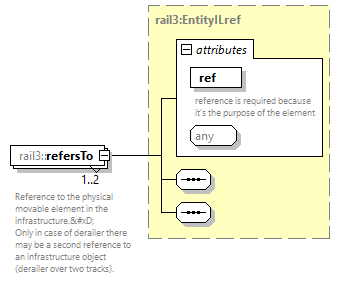 | ||||||||||||||
| namespace | https://www.railml.org/schemas/3.2 | ||||||||||||||
| type | rail3:EntityILref | ||||||||||||||
| properties |
| ||||||||||||||
| attributes |
| ||||||||||||||
| annotation |
| ||||||||||||||
| source | <xs:element name="refersTo" type="rail3:EntityILref" minOccurs="1" maxOccurs="2"> <xs:annotation> <xs:documentation>Reference to the physical movable element in the infrastructure.
 Only in case of derailer there may be a second reference to an infrastructure object (derailer over two tracks).</xs:documentation> </xs:annotation> </xs:element> |
element MovableElement/hasGaugeClearanceMarker
| diagram | 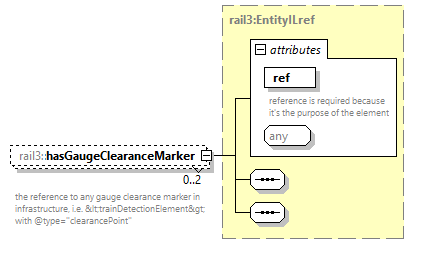 | ||||||||||||||
| namespace | https://www.railml.org/schemas/3.2 | ||||||||||||||
| type | rail3:EntityILref | ||||||||||||||
| properties |
| ||||||||||||||
| attributes |
| ||||||||||||||
| annotation |
| ||||||||||||||
| source | <xs:element name="hasGaugeClearanceMarker" type="rail3:EntityILref" minOccurs="0" maxOccurs="2"> <xs:annotation> <xs:documentation>the reference to any gauge clearance marker in infrastructure, i.e. <trainDetectionElement> with @type="clearancePoint"</xs:documentation> </xs:annotation> </xs:element> |
element MovableElement/hasTvdSection
| diagram | 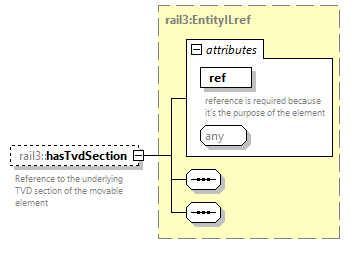 | ||||||||||||||
| namespace | https://www.railml.org/schemas/3.2 | ||||||||||||||
| type | rail3:EntityILref | ||||||||||||||
| properties |
| ||||||||||||||
| attributes |
| ||||||||||||||
| annotation |
| ||||||||||||||
| source | <xs:element name="hasTvdSection" type="rail3:EntityILref" minOccurs="0" maxOccurs="1"> <xs:annotation> <xs:documentation>Reference to the underlying TVD section of the movable element</xs:documentation> </xs:annotation> </xs:element> |
element MovableElement/connectedToPowerSupply
| diagram | 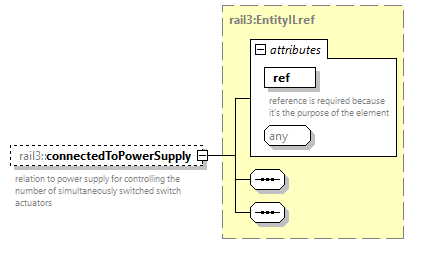 | ||||||||||||||
| namespace | https://www.railml.org/schemas/3.2 | ||||||||||||||
| type | rail3:EntityILref | ||||||||||||||
| properties |
| ||||||||||||||
| attributes |
| ||||||||||||||
| annotation |
| ||||||||||||||
| source | <xs:element name="connectedToPowerSupply" type="rail3:EntityILref" minOccurs="0" maxOccurs="1"> <xs:annotation> <xs:documentation>relation to power supply for controlling the number of simultaneously switched switch actuators</xs:documentation> </xs:annotation> </xs:element> |
element MovableElement/relatedMovableElement
| diagram | 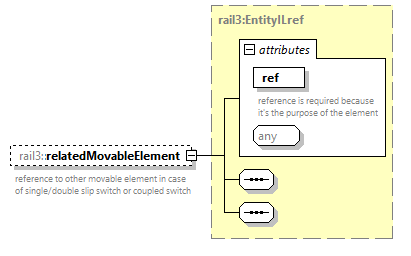 | ||||||||||||||
| namespace | https://www.railml.org/schemas/3.2 | ||||||||||||||
| type | rail3:EntityILref | ||||||||||||||
| properties |
| ||||||||||||||
| attributes |
| ||||||||||||||
| annotation |
| ||||||||||||||
| source | <xs:element name="relatedMovableElement" type="rail3:EntityILref" minOccurs="0" maxOccurs="1"> <xs:annotation> <xs:documentation>reference to other movable element in case of single/double slip switch or coupled switch</xs:documentation> </xs:annotation> </xs:element> |
complexType OperatorCommand
| diagram | 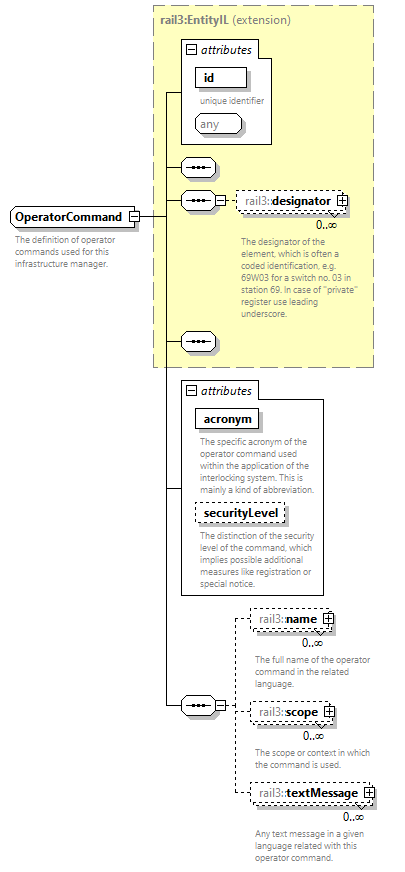 | ||||||||||||||||||||||||||||||
| namespace | https://www.railml.org/schemas/3.2 | ||||||||||||||||||||||||||||||
| type | extension of rail3:EntityIL | ||||||||||||||||||||||||||||||
| properties |
| ||||||||||||||||||||||||||||||
| children | rail3:designator rail3:name rail3:scope rail3:textMessage | ||||||||||||||||||||||||||||||
| used by |
| ||||||||||||||||||||||||||||||
| attributes |
| ||||||||||||||||||||||||||||||
| annotation |
| ||||||||||||||||||||||||||||||
| source | <xs:complexType name="OperatorCommand"> <xs:annotation> <xs:documentation>The definition of operator commands used for this infrastructure manager.</xs:documentation> </xs:annotation> <xs:complexContent> <xs:extension base="rail3:EntityIL"> <xs:sequence> <xs:element name="name" type="rail3:Name" minOccurs="0" maxOccurs="unbounded"> <xs:annotation> <xs:documentation>The full name of the operator command in the related language.</xs:documentation> </xs:annotation> </xs:element> <xs:element name="scope" type="rail3:Scope" minOccurs="0" maxOccurs="unbounded"> <xs:annotation> <xs:documentation>The scope or context in which the command is used.</xs:documentation> </xs:annotation> </xs:element> <xs:element name="textMessage" type="rail3:Name" minOccurs="0" maxOccurs="unbounded"> <xs:annotation> <xs:documentation>Any text message in a given language related with this operator command.</xs:documentation> </xs:annotation> </xs:element> </xs:sequence> <xs:attribute name="acronym" type="xs:NMTOKEN" use="required"> <xs:annotation> <xs:documentation>The specific acronym of the operator command used within the application of the interlocking system. This is mainly a kind of abbreviation.</xs:documentation> </xs:annotation> </xs:attribute> <xs:attribute name="securityLevel" type="rail3:tSecurityLevelListExt" use="optional"> <xs:annotation> <xs:documentation>The distinction of the security level of the command, which implies possible additional measures like registration or special notice.</xs:documentation> </xs:annotation> </xs:attribute> </xs:extension> </xs:complexContent> </xs:complexType> |
attribute OperatorCommand/@acronym
| type | xs:NMTOKEN | ||
| properties |
| ||
| annotation |
| ||
| source | <xs:attribute name="acronym" type="xs:NMTOKEN" use="required"> <xs:annotation> <xs:documentation>The specific acronym of the operator command used within the application of the interlocking system. This is mainly a kind of abbreviation.</xs:documentation> </xs:annotation> </xs:attribute> |
attribute OperatorCommand/@securityLevel
| type | rail3:tSecurityLevelListExt | ||
| properties |
| ||
| annotation |
| ||
| source | <xs:attribute name="securityLevel" type="rail3:tSecurityLevelListExt" use="optional"> <xs:annotation> <xs:documentation>The distinction of the security level of the command, which implies possible additional measures like registration or special notice.</xs:documentation> </xs:annotation> </xs:attribute> |
element OperatorCommand/name
| diagram | 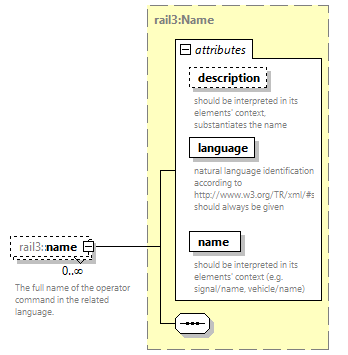 | ||||||||||||||||||||||||||||||
| namespace | https://www.railml.org/schemas/3.2 | ||||||||||||||||||||||||||||||
| type | rail3:Name | ||||||||||||||||||||||||||||||
| properties |
| ||||||||||||||||||||||||||||||
| attributes |
| ||||||||||||||||||||||||||||||
| annotation |
| ||||||||||||||||||||||||||||||
| source | <xs:element name="name" type="rail3:Name" minOccurs="0" maxOccurs="unbounded"> <xs:annotation> <xs:documentation>The full name of the operator command in the related language.</xs:documentation> </xs:annotation> </xs:element> |
element OperatorCommand/scope
| diagram | 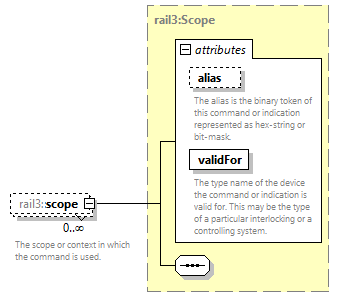 | ||||||||||||||||||||||
| namespace | https://www.railml.org/schemas/3.2 | ||||||||||||||||||||||
| type | rail3:Scope | ||||||||||||||||||||||
| properties |
| ||||||||||||||||||||||
| attributes |
| ||||||||||||||||||||||
| annotation |
| ||||||||||||||||||||||
| source | <xs:element name="scope" type="rail3:Scope" minOccurs="0" maxOccurs="unbounded"> <xs:annotation> <xs:documentation>The scope or context in which the command is used.</xs:documentation> </xs:annotation> </xs:element> |
element OperatorCommand/textMessage
| diagram | 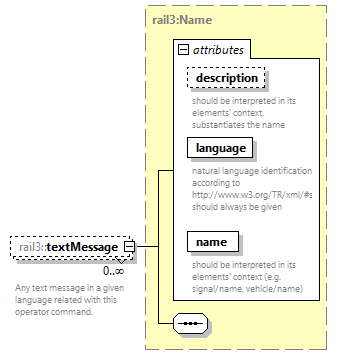 | ||||||||||||||||||||||||||||||
| namespace | https://www.railml.org/schemas/3.2 | ||||||||||||||||||||||||||||||
| type | rail3:Name | ||||||||||||||||||||||||||||||
| properties |
| ||||||||||||||||||||||||||||||
| attributes |
| ||||||||||||||||||||||||||||||
| annotation |
| ||||||||||||||||||||||||||||||
| source | <xs:element name="textMessage" type="rail3:Name" minOccurs="0" maxOccurs="unbounded"> <xs:annotation> <xs:documentation>Any text message in a given language related with this operator command.</xs:documentation> </xs:annotation> </xs:element> |
complexType Overlap
| diagram |  | ||||||||||||||||||||||||||||||||||||||||||||||||||||||
| namespace | https://www.railml.org/schemas/3.2 | ||||||||||||||||||||||||||||||||||||||||||||||||||||||
| type | extension of rail3:RouteObject | ||||||||||||||||||||||||||||||||||||||||||||||||||||||
| properties |
| ||||||||||||||||||||||||||||||||||||||||||||||||||||||
| children | rail3:designator rail3:objectName rail3:belongsToOperationalPoint rail3:hasCommand rail3:hasIndication rail3:activeForApproachRoute rail3:relatedToTrackAsset rail3:requiresSwitchInPosition rail3:requiresLevelCrossingInState rail3:hasTvdSection rail3:isLimitedBy rail3:overlapRelease rail3:additionalRelation | ||||||||||||||||||||||||||||||||||||||||||||||||||||||
| used by |
| ||||||||||||||||||||||||||||||||||||||||||||||||||||||
| attributes |
| ||||||||||||||||||||||||||||||||||||||||||||||||||||||
| annotation |
| ||||||||||||||||||||||||||||||||||||||||||||||||||||||
| source | <xs:complexType name="Overlap"> <xs:annotation> <xs:documentation>INESS (INtegrated European Signalling System) definition: A defined section of track in advance of a stop signal, or a stopping point in a continuous signalling system, which must be kept clear to avoid the risk of collision should a train inadvertently run past the signal or the stopping point.
 Many IMs require overlap beyond active routes to protect from overshoot. One or more sections beyond the exit signal are locked out from use by other routes. The overlap is delimited by train detectors. Facing switches in the overlap are locked, otherwise, use the swinging overlap. Trailing switches in the overlap may normally not locked. Note that there is no need to explicitly identify the switches in the overlap because they can be derived from the begin and endpoints of the overlap.
 The overlap can be released if the RBC deems that an approaching train is slow enough such that overshoot is unlikely.
 Trains other than the one for which the route-overlap is locked may be attributed a permitted speed in the overlap. If the value is set to 0 it is not possible to set a route through the overlap. Compare this variable with the release speed that applies to the train that is being released beyond the danger point.</xs:documentation> </xs:annotation> <xs:complexContent> <xs:extension base="rail3:RouteObject"> <xs:sequence> <xs:element name="activeForApproachRoute" type="rail3:EntityILref" minOccurs="0" maxOccurs="unbounded"> <xs:annotation> <xs:documentation>The reference to the related route using the overlap.</xs:documentation> </xs:annotation> </xs:element> <xs:element name="relatedToTrackAsset" type="rail3:EntityILref" minOccurs="0" maxOccurs="1"> <xs:annotation> <xs:documentation>Alternatively to a specific route a reference to a track asset the overlap is related to can be given. This can be a destination signal of a route or any other suitable object.</xs:documentation> </xs:annotation> </xs:element> <xs:element name="requiresSwitchInPosition" type="rail3:SwitchAndGivenPosition" minOccurs="0" maxOccurs="unbounded"> <xs:annotation> <xs:documentation>The reference to any switch in the overlap required to be in a particular position and its position.</xs:documentation> </xs:annotation> </xs:element> <xs:element name="requiresLevelCrossingInState" type="rail3:LevelCrossingAndGivenState" minOccurs="0" maxOccurs="unbounded"> <xs:annotation> <xs:documentation>The reference to any level crossing in the overlap required to be in a particular state and its state.</xs:documentation> </xs:annotation> </xs:element> <xs:element name="hasTvdSection" type="rail3:EntityILref" minOccurs="0" maxOccurs="unbounded"> <xs:annotation> <xs:documentation>The reference to any TVD section(s) within the path of the overlap.</xs:documentation> </xs:annotation> </xs:element> <xs:element name="isLimitedBy" type="rail3:EntityILref" minOccurs="0" maxOccurs="unbounded"> <xs:annotation> <xs:documentation>References to track assets limiting the overlap. It may be used in conjunction to attribute length.</xs:documentation> </xs:annotation> </xs:element> <xs:element name="overlapRelease" type="rail3:OverlapRelease" minOccurs="0" maxOccurs="1"> <xs:annotation> <xs:documentation>Overlap is set in lockstep with the route. The interlocking releases the overlap when it is safe to presume that an approaching train will not overrun a closed destination signal. When the train occupied the last section (or destination area), an overlap release timer starts running. The timer value is defined by operational rules and the approaching speed. Upon expiry, the interlocking releases the overlap. Overlap is released together with the route or after expiration of the release timer. Overlap is released after a defined time in a timer that starts from a timerTriggerPoint.</xs:documentation> </xs:annotation> </xs:element> <xs:element name="additionalRelation" type="rail3:RelationReference" minOccurs="0" maxOccurs="unbounded"> <xs:annotation> <xs:documentation>reference to additional route relations specific for this overlap, e.g. flank protection</xs:documentation> </xs:annotation> </xs:element> </xs:sequence> <xs:attribute name="length" type="rail3:tLengthM" use="optional"> <xs:annotation> <xs:documentation>Alternatively to a particular limit the length of the overlap in metres can be given.</xs:documentation> </xs:annotation> </xs:attribute> <xs:attribute name="overlapSpeed" type="rail3:tSpeedKmPerHour" use="optional"> <xs:annotation> <xs:documentation>Maximum speed in the overlap in km/h for other trains than the one using the related route.</xs:documentation> </xs:annotation> </xs:attribute> <xs:attribute name="overlapValidityTime" type="xs:duration" use="optional"> <xs:annotation> <xs:documentation>The overlap validity time is the time that the train assumes the overlap to be locked. This is the ETCS validity time T_OL.</xs:documentation> </xs:annotation> </xs:attribute> <xs:attribute name="releaseSpeed" type="rail3:tSpeedKmPerHour" use="optional"> <xs:annotation> <xs:documentation>Release speed in km/h associated with the overlap</xs:documentation> </xs:annotation> </xs:attribute> </xs:extension> </xs:complexContent> </xs:complexType> |
attribute Overlap/@length
| type | rail3:tLengthM | ||
| properties |
| ||
| annotation |
| ||
| source | <xs:attribute name="length" type="rail3:tLengthM" use="optional"> <xs:annotation> <xs:documentation>Alternatively to a particular limit the length of the overlap in metres can be given.</xs:documentation> </xs:annotation> </xs:attribute> |
attribute Overlap/@overlapSpeed
| type | rail3:tSpeedKmPerHour | ||
| properties |
| ||
| annotation |
| ||
| source | <xs:attribute name="overlapSpeed" type="rail3:tSpeedKmPerHour" use="optional"> <xs:annotation> <xs:documentation>Maximum speed in the overlap in km/h for other trains than the one using the related route.</xs:documentation> </xs:annotation> </xs:attribute> |
attribute Overlap/@overlapValidityTime
| type | xs:duration | ||
| properties |
| ||
| annotation |
| ||
| source | <xs:attribute name="overlapValidityTime" type="xs:duration" use="optional"> <xs:annotation> <xs:documentation>The overlap validity time is the time that the train assumes the overlap to be locked. This is the ETCS validity time T_OL.</xs:documentation> </xs:annotation> </xs:attribute> |
attribute Overlap/@releaseSpeed
| type | rail3:tSpeedKmPerHour | ||
| properties |
| ||
| annotation |
| ||
| source | <xs:attribute name="releaseSpeed" type="rail3:tSpeedKmPerHour" use="optional"> <xs:annotation> <xs:documentation>Release speed in km/h associated with the overlap</xs:documentation> </xs:annotation> </xs:attribute> |
element Overlap/activeForApproachRoute
| diagram | 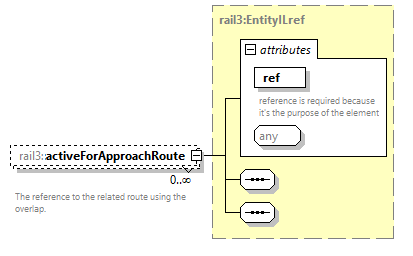 | ||||||||||||||
| namespace | https://www.railml.org/schemas/3.2 | ||||||||||||||
| type | rail3:EntityILref | ||||||||||||||
| properties |
| ||||||||||||||
| attributes |
| ||||||||||||||
| annotation |
| ||||||||||||||
| source | <xs:element name="activeForApproachRoute" type="rail3:EntityILref" minOccurs="0" maxOccurs="unbounded"> <xs:annotation> <xs:documentation>The reference to the related route using the overlap.</xs:documentation> </xs:annotation> </xs:element> |
element Overlap/relatedToTrackAsset
| diagram | 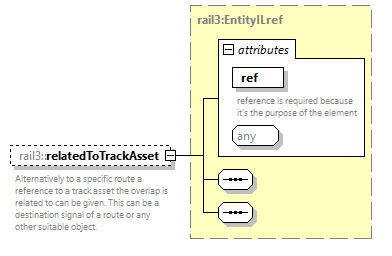 | ||||||||||||||
| namespace | https://www.railml.org/schemas/3.2 | ||||||||||||||
| type | rail3:EntityILref | ||||||||||||||
| properties |
| ||||||||||||||
| attributes |
| ||||||||||||||
| annotation |
| ||||||||||||||
| source | <xs:element name="relatedToTrackAsset" type="rail3:EntityILref" minOccurs="0" maxOccurs="1"> <xs:annotation> <xs:documentation>Alternatively to a specific route a reference to a track asset the overlap is related to can be given. This can be a destination signal of a route or any other suitable object.</xs:documentation> </xs:annotation> </xs:element> |
element Overlap/requiresSwitchInPosition
| diagram | 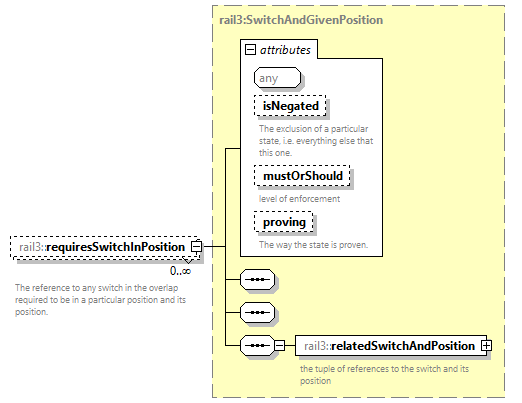 | ||||||||||||||||||||||||||||||
| namespace | https://www.railml.org/schemas/3.2 | ||||||||||||||||||||||||||||||
| type | rail3:SwitchAndGivenPosition | ||||||||||||||||||||||||||||||
| properties |
| ||||||||||||||||||||||||||||||
| children | rail3:relatedSwitchAndPosition | ||||||||||||||||||||||||||||||
| attributes |
| ||||||||||||||||||||||||||||||
| annotation |
| ||||||||||||||||||||||||||||||
| source | <xs:element name="requiresSwitchInPosition" type="rail3:SwitchAndGivenPosition" minOccurs="0" maxOccurs="unbounded"> <xs:annotation> <xs:documentation>The reference to any switch in the overlap required to be in a particular position and its position.</xs:documentation> </xs:annotation> </xs:element> |
element Overlap/requiresLevelCrossingInState
| diagram | 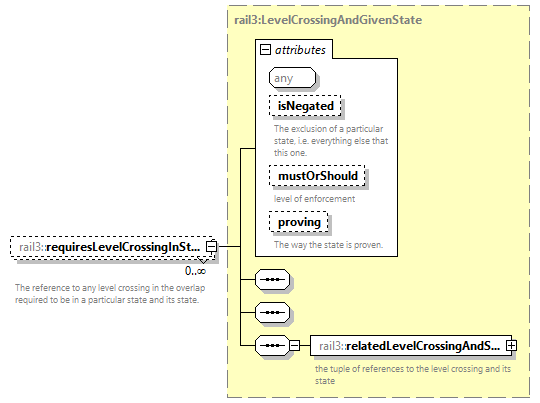 | ||||||||||||||||||||||||||||||
| namespace | https://www.railml.org/schemas/3.2 | ||||||||||||||||||||||||||||||
| type | rail3:LevelCrossingAndGivenState | ||||||||||||||||||||||||||||||
| properties |
| ||||||||||||||||||||||||||||||
| children | rail3:relatedLevelCrossingAndState | ||||||||||||||||||||||||||||||
| attributes |
| ||||||||||||||||||||||||||||||
| annotation |
| ||||||||||||||||||||||||||||||
| source | <xs:element name="requiresLevelCrossingInState" type="rail3:LevelCrossingAndGivenState" minOccurs="0" maxOccurs="unbounded"> <xs:annotation> <xs:documentation>The reference to any level crossing in the overlap required to be in a particular state and its state.</xs:documentation> </xs:annotation> </xs:element> |
element Overlap/hasTvdSection
| diagram | 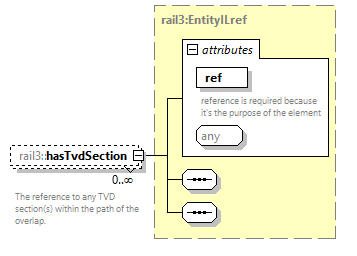 | ||||||||||||||
| namespace | https://www.railml.org/schemas/3.2 | ||||||||||||||
| type | rail3:EntityILref | ||||||||||||||
| properties |
| ||||||||||||||
| attributes |
| ||||||||||||||
| annotation |
| ||||||||||||||
| source | <xs:element name="hasTvdSection" type="rail3:EntityILref" minOccurs="0" maxOccurs="unbounded"> <xs:annotation> <xs:documentation>The reference to any TVD section(s) within the path of the overlap.</xs:documentation> </xs:annotation> </xs:element> |
element Overlap/isLimitedBy
| diagram | 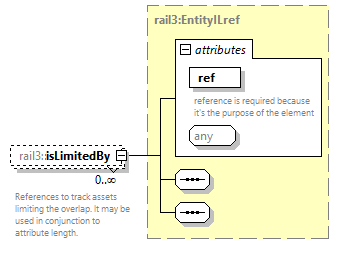 | ||||||||||||||
| namespace | https://www.railml.org/schemas/3.2 | ||||||||||||||
| type | rail3:EntityILref | ||||||||||||||
| properties |
| ||||||||||||||
| attributes |
| ||||||||||||||
| annotation |
| ||||||||||||||
| source | <xs:element name="isLimitedBy" type="rail3:EntityILref" minOccurs="0" maxOccurs="unbounded"> <xs:annotation> <xs:documentation>References to track assets limiting the overlap. It may be used in conjunction to attribute length.</xs:documentation> </xs:annotation> </xs:element> |
element Overlap/overlapRelease
| diagram | 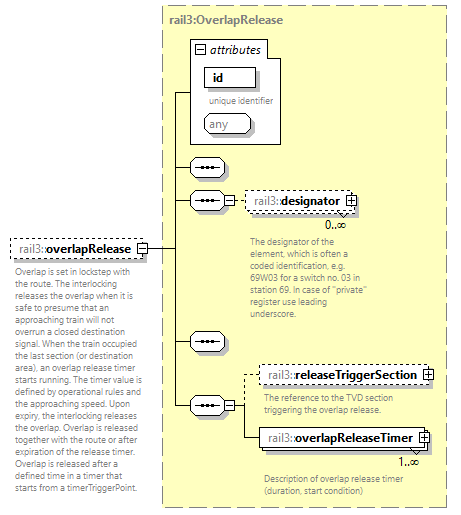 | ||||||||||||||
| namespace | https://www.railml.org/schemas/3.2 | ||||||||||||||
| type | rail3:OverlapRelease | ||||||||||||||
| properties |
| ||||||||||||||
| children | rail3:designator rail3:releaseTriggerSection rail3:overlapReleaseTimer | ||||||||||||||
| attributes |
| ||||||||||||||
| annotation |
| ||||||||||||||
| source | <xs:element name="overlapRelease" type="rail3:OverlapRelease" minOccurs="0" maxOccurs="1"> <xs:annotation> <xs:documentation>Overlap is set in lockstep with the route. The interlocking releases the overlap when it is safe to presume that an approaching train will not overrun a closed destination signal. When the train occupied the last section (or destination area), an overlap release timer starts running. The timer value is defined by operational rules and the approaching speed. Upon expiry, the interlocking releases the overlap. Overlap is released together with the route or after expiration of the release timer. Overlap is released after a defined time in a timer that starts from a timerTriggerPoint.</xs:documentation> </xs:annotation> </xs:element> |
element Overlap/additionalRelation
| diagram | 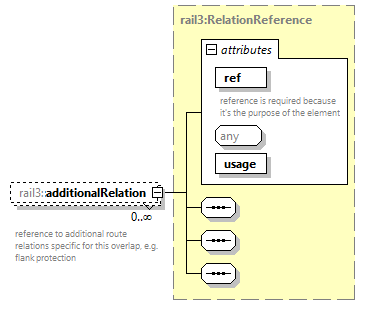 | ||||||||||||||||||||
| namespace | https://www.railml.org/schemas/3.2 | ||||||||||||||||||||
| type | rail3:RelationReference | ||||||||||||||||||||
| properties |
| ||||||||||||||||||||
| attributes |
| ||||||||||||||||||||
| annotation |
| ||||||||||||||||||||
| source | <xs:element name="additionalRelation" type="rail3:RelationReference" minOccurs="0" maxOccurs="unbounded"> <xs:annotation> <xs:documentation>reference to additional route relations specific for this overlap, e.g. flank protection</xs:documentation> </xs:annotation> </xs:element> |
complexType OverlapRelease
| diagram | 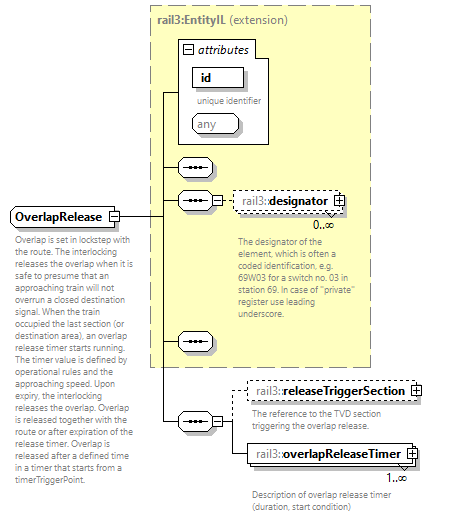 | ||||||||||||||
| namespace | https://www.railml.org/schemas/3.2 | ||||||||||||||
| type | extension of rail3:EntityIL | ||||||||||||||
| properties |
| ||||||||||||||
| children | rail3:designator rail3:releaseTriggerSection rail3:overlapReleaseTimer | ||||||||||||||
| used by |
| ||||||||||||||
| attributes |
| ||||||||||||||
| annotation |
| ||||||||||||||
| source | <xs:complexType name="OverlapRelease"> <xs:annotation> <xs:documentation>Overlap is set in lockstep with the route. The interlocking releases the overlap when it is safe to presume that an approaching train will not overrun a closed destination signal. When the train occupied the last section (or destination area), an overlap release timer starts running. The timer value is defined by operational rules and the approaching speed. Upon expiry, the interlocking releases the overlap. Overlap is released together with the route or after expiration of the release timer. Overlap is released after a defined time in a timer that starts from a timerTriggerPoint.</xs:documentation> </xs:annotation> <xs:complexContent> <xs:extension base="rail3:EntityIL"> <xs:sequence> <xs:element name="releaseTriggerSection" type="rail3:EntityILref" minOccurs="0" maxOccurs="1"> <xs:annotation> <xs:documentation>The reference to the TVD section triggering the overlap release.</xs:documentation> </xs:annotation> </xs:element> <xs:element name="overlapReleaseTimer" type="rail3:OverlapReleaseTimer" minOccurs="1" maxOccurs="unbounded"> <xs:annotation> <xs:documentation>Description of overlap release timer (duration, start condition)</xs:documentation> </xs:annotation> </xs:element> </xs:sequence> </xs:extension> </xs:complexContent> </xs:complexType> |
element OverlapRelease/releaseTriggerSection
| diagram | 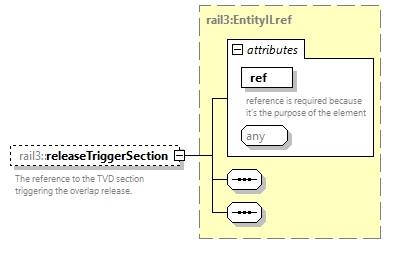 | ||||||||||||||
| namespace | https://www.railml.org/schemas/3.2 | ||||||||||||||
| type | rail3:EntityILref | ||||||||||||||
| properties |
| ||||||||||||||
| attributes |
| ||||||||||||||
| annotation |
| ||||||||||||||
| source | <xs:element name="releaseTriggerSection" type="rail3:EntityILref" minOccurs="0" maxOccurs="1"> <xs:annotation> <xs:documentation>The reference to the TVD section triggering the overlap release.</xs:documentation> </xs:annotation> </xs:element> |
element OverlapRelease/overlapReleaseTimer
| diagram | 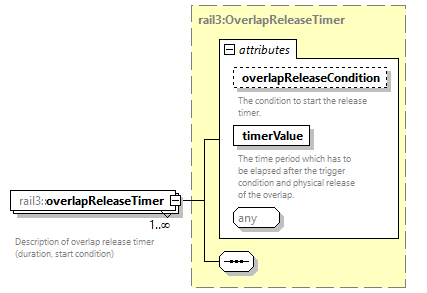 | ||||||||||||||||||||||
| namespace | https://www.railml.org/schemas/3.2 | ||||||||||||||||||||||
| type | rail3:OverlapReleaseTimer | ||||||||||||||||||||||
| properties |
| ||||||||||||||||||||||
| attributes |
| ||||||||||||||||||||||
| annotation |
| ||||||||||||||||||||||
| source | <xs:element name="overlapReleaseTimer" type="rail3:OverlapReleaseTimer" minOccurs="1" maxOccurs="unbounded"> <xs:annotation> <xs:documentation>Description of overlap release timer (duration, start condition)</xs:documentation> </xs:annotation> </xs:element> |
complexType OverlapReleaseTimer
| diagram | 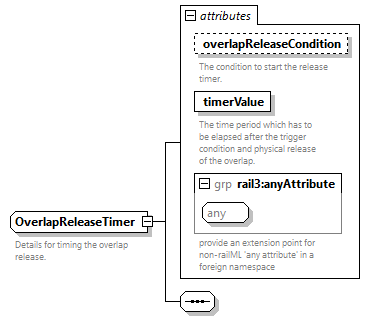 | ||||||||||||||||||||||
| namespace | https://www.railml.org/schemas/3.2 | ||||||||||||||||||||||
| used by |
| ||||||||||||||||||||||
| attributes |
| ||||||||||||||||||||||
| annotation |
| ||||||||||||||||||||||
| source | <xs:complexType name="OverlapReleaseTimer"> <xs:annotation> <xs:documentation>Details for timing the overlap release.</xs:documentation> </xs:annotation> <xs:sequence/> <xs:attribute name="overlapReleaseCondition" type="rail3:tOverlapReleaseCondition" use="optional"> <xs:annotation> <xs:documentation>The condition to start the release timer.</xs:documentation> </xs:annotation> </xs:attribute> <xs:attribute name="timerValue" type="xs:duration" use="required"> <xs:annotation> <xs:documentation>The time period which has to be elapsed after the trigger condition and physical release of the overlap.</xs:documentation> </xs:annotation> </xs:attribute> <xs:attributeGroup ref="rail3:anyAttribute"/> </xs:complexType> |
attribute OverlapReleaseTimer/@overlapReleaseCondition
| type | rail3:tOverlapReleaseCondition | ||||||||||||||||||
| properties |
| ||||||||||||||||||
| facets |
| ||||||||||||||||||
| annotation |
| ||||||||||||||||||
| source | <xs:attribute name="overlapReleaseCondition" type="rail3:tOverlapReleaseCondition" use="optional"> <xs:annotation> <xs:documentation>The condition to start the release timer.</xs:documentation> </xs:annotation> </xs:attribute> |
attribute OverlapReleaseTimer/@timerValue
| type | xs:duration | ||
| properties |
| ||
| annotation |
| ||
| source | <xs:attribute name="timerValue" type="xs:duration" use="required"> <xs:annotation> <xs:documentation>The time period which has to be elapsed after the trigger condition and physical release of the overlap.</xs:documentation> </xs:annotation> </xs:attribute> |
complexType Overlaps
| diagram | 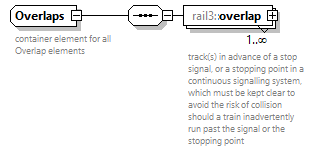 | ||
| namespace | https://www.railml.org/schemas/3.2 | ||
| children | rail3:overlap | ||
| used by |
| ||
| annotation |
| ||
| source | <xs:complexType name="Overlaps"> <xs:annotation> <xs:documentation>container element for all Overlap elements</xs:documentation> </xs:annotation> <xs:sequence> <xs:element name="overlap" type="rail3:Overlap" minOccurs="1" maxOccurs="unbounded"> <xs:annotation> <xs:documentation>track(s) in advance of a stop signal, or a stopping point in a continuous signalling system, which must be kept clear to avoid the risk of collision should a train inadvertently run past the signal or the stopping point</xs:documentation> </xs:annotation> </xs:element> </xs:sequence> </xs:complexType> |
element Overlaps/overlap
| diagram |  | ||||||||||||||||||||||||||||||||||||||||||||||||||||||
| namespace | https://www.railml.org/schemas/3.2 | ||||||||||||||||||||||||||||||||||||||||||||||||||||||
| type | rail3:Overlap | ||||||||||||||||||||||||||||||||||||||||||||||||||||||
| properties |
| ||||||||||||||||||||||||||||||||||||||||||||||||||||||
| children | rail3:designator rail3:objectName rail3:belongsToOperationalPoint rail3:hasCommand rail3:hasIndication rail3:activeForApproachRoute rail3:relatedToTrackAsset rail3:requiresSwitchInPosition rail3:requiresLevelCrossingInState rail3:hasTvdSection rail3:isLimitedBy rail3:overlapRelease rail3:additionalRelation | ||||||||||||||||||||||||||||||||||||||||||||||||||||||
| attributes |
| ||||||||||||||||||||||||||||||||||||||||||||||||||||||
| annotation |
| ||||||||||||||||||||||||||||||||||||||||||||||||||||||
| source | <xs:element name="overlap" type="rail3:Overlap" minOccurs="1" maxOccurs="unbounded"> <xs:annotation> <xs:documentation>track(s) in advance of a stop signal, or a stopping point in a continuous signalling system, which must be kept clear to avoid the risk of collision should a train inadvertently run past the signal or the stopping point</xs:documentation> </xs:annotation> </xs:element> |
complexType PartialRoute
| diagram | 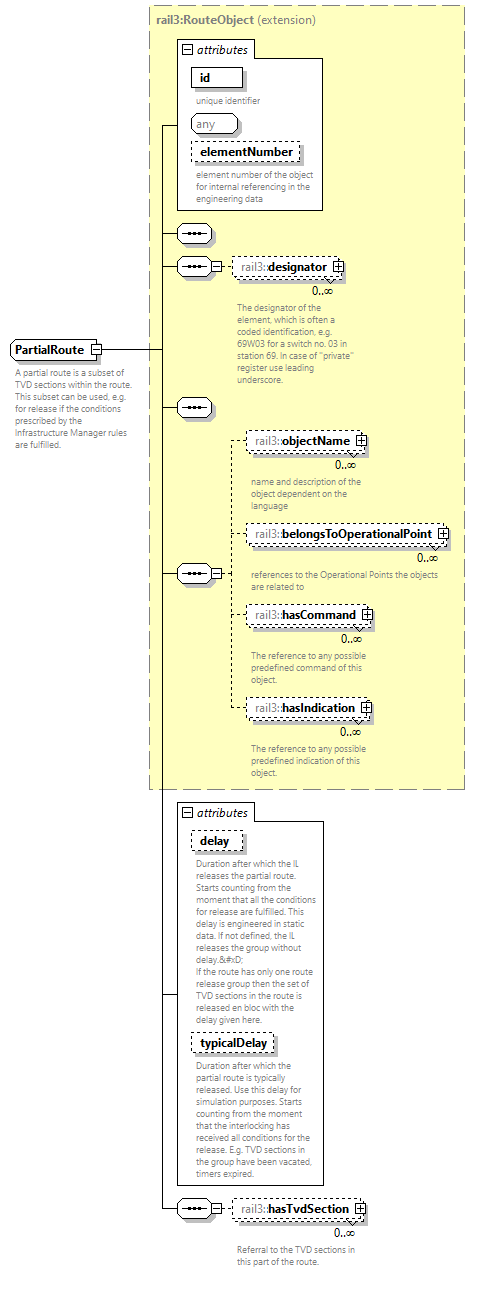 | ||||||||||||||||||||||||||||||||||||||
| namespace | https://www.railml.org/schemas/3.2 | ||||||||||||||||||||||||||||||||||||||
| type | extension of rail3:RouteObject | ||||||||||||||||||||||||||||||||||||||
| properties |
| ||||||||||||||||||||||||||||||||||||||
| children | rail3:designator rail3:objectName rail3:belongsToOperationalPoint rail3:hasCommand rail3:hasIndication rail3:hasTvdSection | ||||||||||||||||||||||||||||||||||||||
| used by |
| ||||||||||||||||||||||||||||||||||||||
| attributes |
| ||||||||||||||||||||||||||||||||||||||
| annotation |
| ||||||||||||||||||||||||||||||||||||||
| source | <xs:complexType name="PartialRoute" abstract="true"> <xs:annotation> <xs:documentation>A partial route is a subset of TVD sections within the route. This subset can be used, e.g. for release if the conditions prescribed by the Infrastructure Manager rules are fulfilled.</xs:documentation> </xs:annotation> <xs:complexContent> <xs:extension base="rail3:RouteObject"> <xs:sequence> <xs:element name="hasTvdSection" type="rail3:EntityILref" minOccurs="0" maxOccurs="unbounded"> <xs:annotation> <xs:documentation>Referral to the TVD sections in this part of the route.</xs:documentation> </xs:annotation> </xs:element> </xs:sequence> <xs:attribute name="delay" type="xs:duration" use="optional"> <xs:annotation> <xs:documentation>Duration after which the IL releases the partial route. Starts counting from the moment that all the conditions for release are fulfilled. This delay is engineered in static data. If not defined, the IL releases the group without delay.
 If the route has only one route release group then the set of TVD sections in the route is released en bloc with the delay given here.</xs:documentation> </xs:annotation> </xs:attribute> <xs:attribute name="typicalDelay" type="xs:duration" use="optional"> <xs:annotation> <xs:documentation>Duration after which the partial route is typically released. Use this delay for simulation purposes. Starts counting from the moment that the interlocking has received all conditions for the release. E.g. TVD sections in the group have been vacated, timers expired.</xs:documentation> </xs:annotation> </xs:attribute> </xs:extension> </xs:complexContent> </xs:complexType> |
attribute PartialRoute/@delay
| type | xs:duration | ||
| properties |
| ||
| annotation |
| ||
| source | <xs:attribute name="delay" type="xs:duration" use="optional"> <xs:annotation> <xs:documentation>Duration after which the IL releases the partial route. Starts counting from the moment that all the conditions for release are fulfilled. This delay is engineered in static data. If not defined, the IL releases the group without delay.
 If the route has only one route release group then the set of TVD sections in the route is released en bloc with the delay given here.</xs:documentation> </xs:annotation> </xs:attribute> |
attribute PartialRoute/@typicalDelay
| type | xs:duration | ||
| properties |
| ||
| annotation |
| ||
| source | <xs:attribute name="typicalDelay" type="xs:duration" use="optional"> <xs:annotation> <xs:documentation>Duration after which the partial route is typically released. Use this delay for simulation purposes. Starts counting from the moment that the interlocking has received all conditions for the release. E.g. TVD sections in the group have been vacated, timers expired.</xs:documentation> </xs:annotation> </xs:attribute> |
element PartialRoute/hasTvdSection
| diagram | 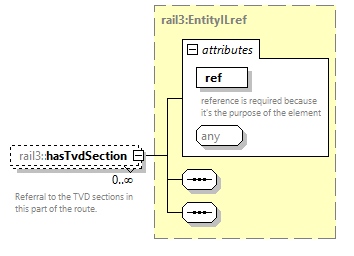 | ||||||||||||||
| namespace | https://www.railml.org/schemas/3.2 | ||||||||||||||
| type | rail3:EntityILref | ||||||||||||||
| properties |
| ||||||||||||||
| attributes |
| ||||||||||||||
| annotation |
| ||||||||||||||
| source | <xs:element name="hasTvdSection" type="rail3:EntityILref" minOccurs="0" maxOccurs="unbounded"> <xs:annotation> <xs:documentation>Referral to the TVD sections in this part of the route.</xs:documentation> </xs:annotation> </xs:element> |
complexType PermissionZone
| diagram | 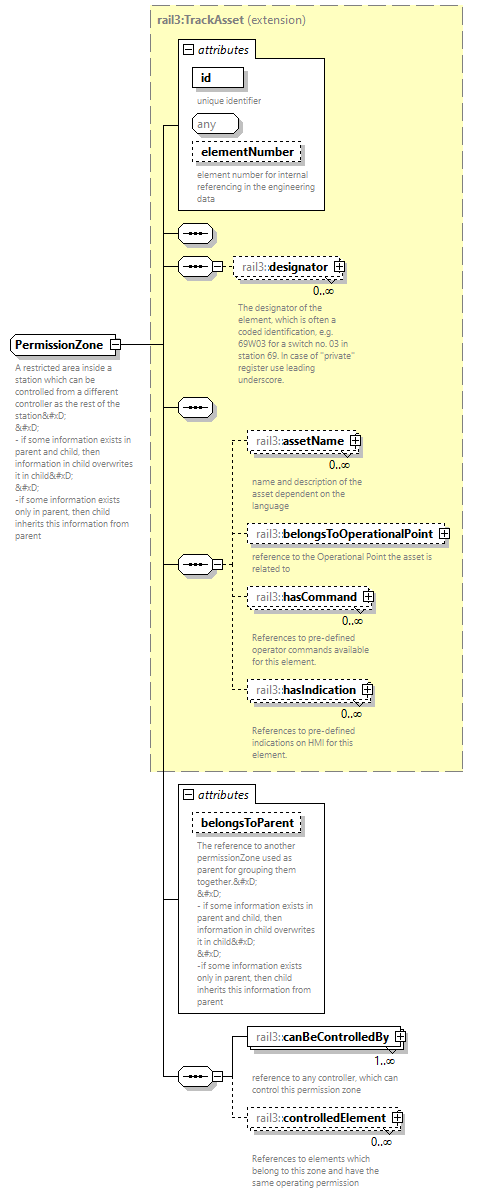 | ||||||||||||||||||||||||||||||
| namespace | https://www.railml.org/schemas/3.2 | ||||||||||||||||||||||||||||||
| type | extension of rail3:TrackAsset | ||||||||||||||||||||||||||||||
| properties |
| ||||||||||||||||||||||||||||||
| children | rail3:designator rail3:assetName rail3:belongsToOperationalPoint rail3:hasCommand rail3:hasIndication rail3:canBeControlledBy rail3:controlledElement | ||||||||||||||||||||||||||||||
| used by |
| ||||||||||||||||||||||||||||||
| attributes |
| ||||||||||||||||||||||||||||||
| annotation |
| ||||||||||||||||||||||||||||||
| source | <xs:complexType name="PermissionZone"> <xs:annotation> <xs:documentation>A restricted area inside a station which can be controlled from a different controller as the rest of the station
 
 - if some information exists in parent and child, then information in child overwrites it in child
 
 -if some information exists only in parent, then child inherits this information from parent</xs:documentation> </xs:annotation> <xs:complexContent> <xs:extension base="rail3:TrackAsset"> <xs:sequence> <xs:element name="canBeControlledBy" type="rail3:EntityILref" minOccurs="1" maxOccurs="unbounded"> <xs:annotation> <xs:documentation>reference to any controller, which can control this permission zone</xs:documentation> </xs:annotation> </xs:element> <xs:element name="controlledElement" type="rail3:EntityILref" minOccurs="0" maxOccurs="unbounded"> <xs:annotation> <xs:documentation>References to elements which belong to this zone and have the same operating permission</xs:documentation> </xs:annotation> </xs:element> </xs:sequence> <xs:attribute name="belongsToParent" type="rail3:tRef" use="optional"> <xs:annotation> <xs:documentation>The reference to another permissionZone used as parent for grouping them together.
 
 - if some information exists in parent and child, then information in child overwrites it in child
 
 -if some information exists only in parent, then child inherits this information from parent</xs:documentation> </xs:annotation> </xs:attribute> </xs:extension> </xs:complexContent> </xs:complexType> |
attribute PermissionZone/@belongsToParent
| type | rail3:tRef | ||
| properties |
| ||
| annotation |
| ||
| source | <xs:attribute name="belongsToParent" type="rail3:tRef" use="optional"> <xs:annotation> <xs:documentation>The reference to another permissionZone used as parent for grouping them together.
 
 - if some information exists in parent and child, then information in child overwrites it in child
 
 -if some information exists only in parent, then child inherits this information from parent</xs:documentation> </xs:annotation> </xs:attribute> |
element PermissionZone/canBeControlledBy
| diagram | 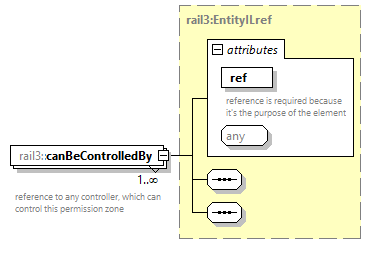 | ||||||||||||||
| namespace | https://www.railml.org/schemas/3.2 | ||||||||||||||
| type | rail3:EntityILref | ||||||||||||||
| properties |
| ||||||||||||||
| attributes |
| ||||||||||||||
| annotation |
| ||||||||||||||
| source | <xs:element name="canBeControlledBy" type="rail3:EntityILref" minOccurs="1" maxOccurs="unbounded"> <xs:annotation> <xs:documentation>reference to any controller, which can control this permission zone</xs:documentation> </xs:annotation> </xs:element> |
element PermissionZone/controlledElement
| diagram | 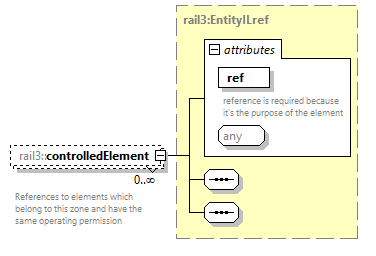 | ||||||||||||||
| namespace | https://www.railml.org/schemas/3.2 | ||||||||||||||
| type | rail3:EntityILref | ||||||||||||||
| properties |
| ||||||||||||||
| attributes |
| ||||||||||||||
| annotation |
| ||||||||||||||
| source | <xs:element name="controlledElement" type="rail3:EntityILref" minOccurs="0" maxOccurs="unbounded"> <xs:annotation> <xs:documentation>References to elements which belong to this zone and have the same operating permission</xs:documentation> </xs:annotation> </xs:element> |
complexType PermissionZones
| diagram | 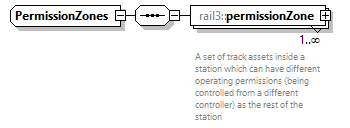 | ||
| namespace | https://www.railml.org/schemas/3.2 | ||
| children | rail3:permissionZone | ||
| used by |
| ||
| source | <xs:complexType name="PermissionZones"> <xs:sequence> <xs:element name="permissionZone" type="rail3:PermissionZone" minOccurs="1" maxOccurs="unbounded"> <xs:annotation> <xs:documentation>A set of track assets inside a station which can have different operating permissions (being controlled from a different controller) as the rest of the station</xs:documentation> </xs:annotation> </xs:element> </xs:sequence> </xs:complexType> |
element PermissionZones/permissionZone
| diagram | 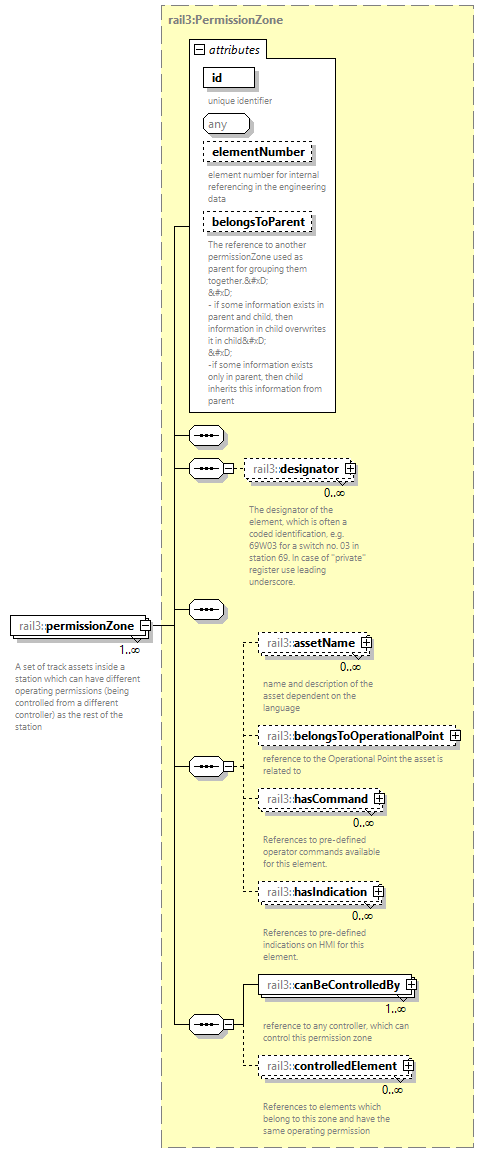 | ||||||||||||||||||||||||||||||
| namespace | https://www.railml.org/schemas/3.2 | ||||||||||||||||||||||||||||||
| type | rail3:PermissionZone | ||||||||||||||||||||||||||||||
| properties |
| ||||||||||||||||||||||||||||||
| children | rail3:designator rail3:assetName rail3:belongsToOperationalPoint rail3:hasCommand rail3:hasIndication rail3:canBeControlledBy rail3:controlledElement | ||||||||||||||||||||||||||||||
| attributes |
| ||||||||||||||||||||||||||||||
| annotation |
| ||||||||||||||||||||||||||||||
| source | <xs:element name="permissionZone" type="rail3:PermissionZone" minOccurs="1" maxOccurs="unbounded"> <xs:annotation> <xs:documentation>A set of track assets inside a station which can have different operating permissions (being controlled from a different controller) as the rest of the station</xs:documentation> </xs:annotation> </xs:element> |
complexType PowerSuppliesIL
| diagram |  | ||
| namespace | https://www.railml.org/schemas/3.2 | ||
| children | rail3:powerSupplyIL | ||
| used by |
| ||
| annotation |
| ||
| source | <xs:complexType name="PowerSuppliesIL"> <xs:annotation> <xs:documentation>container element for all PowerSupplyIL elements</xs:documentation> </xs:annotation> <xs:sequence minOccurs="0" maxOccurs="1"> <xs:element name="powerSupplyIL" type="rail3:PowerSupplyIL" minOccurs="1" maxOccurs="unbounded"> <xs:annotation> <xs:documentation>specific features of power supply used for interlocking</xs:documentation> </xs:annotation> </xs:element> </xs:sequence> </xs:complexType> |
element PowerSuppliesIL/powerSupplyIL
| diagram | 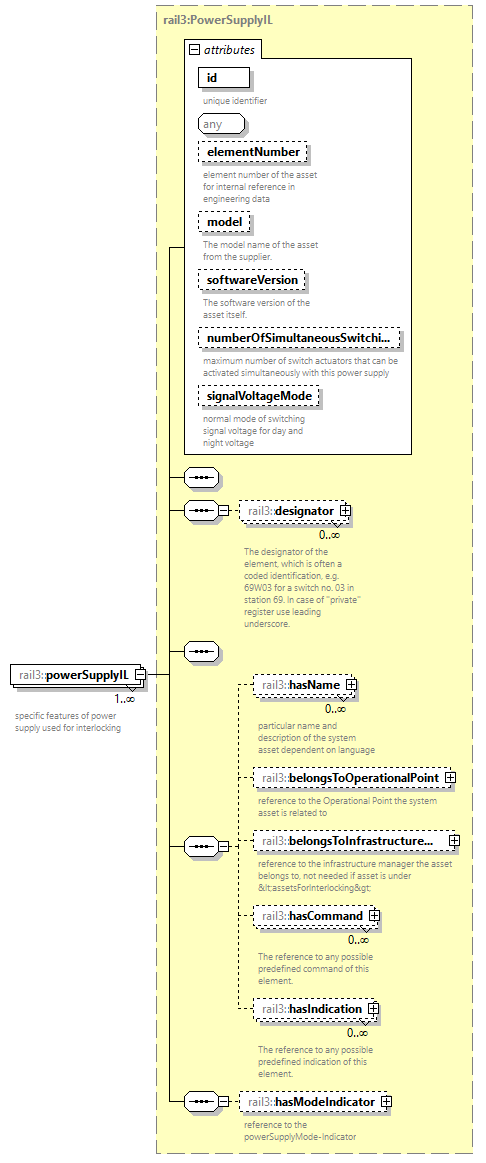 | ||||||||||||||||||||||||||||||||||||||||||||||||||||||
| namespace | https://www.railml.org/schemas/3.2 | ||||||||||||||||||||||||||||||||||||||||||||||||||||||
| type | rail3:PowerSupplyIL | ||||||||||||||||||||||||||||||||||||||||||||||||||||||
| properties |
| ||||||||||||||||||||||||||||||||||||||||||||||||||||||
| children | rail3:designator rail3:hasName rail3:belongsToOperationalPoint rail3:belongsToInfrastructureManager rail3:hasCommand rail3:hasIndication rail3:hasModeIndicator | ||||||||||||||||||||||||||||||||||||||||||||||||||||||
| attributes |
| ||||||||||||||||||||||||||||||||||||||||||||||||||||||
| annotation |
| ||||||||||||||||||||||||||||||||||||||||||||||||||||||
| source | <xs:element name="powerSupplyIL" type="rail3:PowerSupplyIL" minOccurs="1" maxOccurs="unbounded"> <xs:annotation> <xs:documentation>specific features of power supply used for interlocking</xs:documentation> </xs:annotation> </xs:element> |
complexType PowerSupplyIL
| diagram | 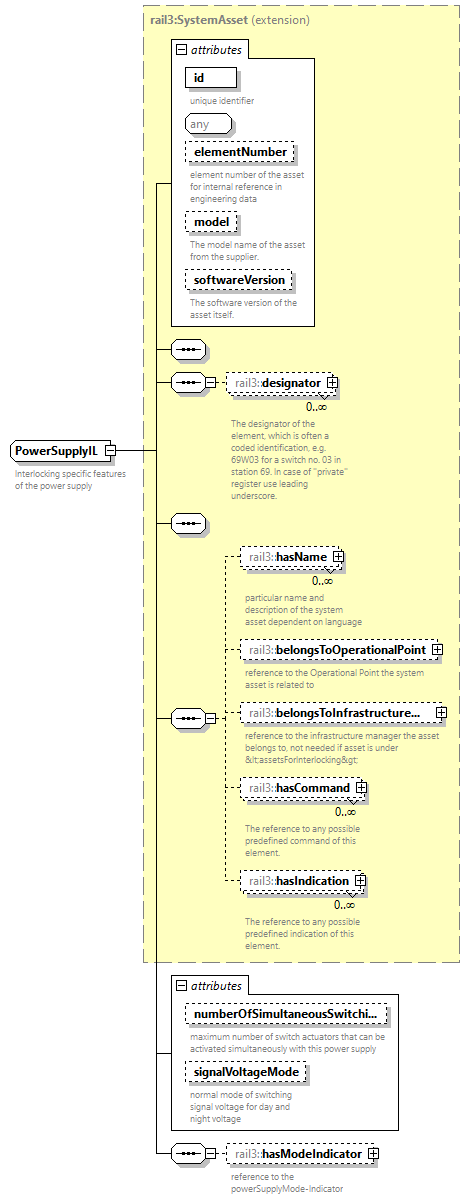 | ||||||||||||||||||||||||||||||||||||||||||||||||||||||
| namespace | https://www.railml.org/schemas/3.2 | ||||||||||||||||||||||||||||||||||||||||||||||||||||||
| type | extension of rail3:SystemAsset | ||||||||||||||||||||||||||||||||||||||||||||||||||||||
| properties |
| ||||||||||||||||||||||||||||||||||||||||||||||||||||||
| children | rail3:designator rail3:hasName rail3:belongsToOperationalPoint rail3:belongsToInfrastructureManager rail3:hasCommand rail3:hasIndication rail3:hasModeIndicator | ||||||||||||||||||||||||||||||||||||||||||||||||||||||
| used by |
| ||||||||||||||||||||||||||||||||||||||||||||||||||||||
| attributes |
| ||||||||||||||||||||||||||||||||||||||||||||||||||||||
| annotation |
| ||||||||||||||||||||||||||||||||||||||||||||||||||||||
| source | <xs:complexType name="PowerSupplyIL"> <xs:annotation> <xs:documentation>Interlocking specific features of the power supply</xs:documentation> </xs:annotation> <xs:complexContent> <xs:extension base="rail3:SystemAsset"> <xs:sequence> <xs:element name="hasModeIndicator" type="rail3:EntityILref" minOccurs="0" maxOccurs="1"> <xs:annotation> <xs:documentation>reference to the powerSupplyMode-Indicator</xs:documentation> </xs:annotation> </xs:element> </xs:sequence> <xs:attribute name="numberOfSimultaneousSwitchingActuators" type="xs:nonNegativeInteger" use="optional"> <xs:annotation> <xs:documentation>maximum number of switch actuators that can be activated simultaneously with this power supply</xs:documentation> </xs:annotation> </xs:attribute> <xs:attribute name="signalVoltageMode" type="rail3:tSignalVoltageModes" use="optional"> <xs:annotation> <xs:documentation>normal mode of switching signal voltage for day and night voltage</xs:documentation> </xs:annotation> </xs:attribute> </xs:extension> </xs:complexContent> </xs:complexType> |
attribute PowerSupplyIL/@numberOfSimultaneousSwitchingActuators
| type | xs:nonNegativeInteger | ||
| properties |
| ||
| annotation |
| ||
| source | <xs:attribute name="numberOfSimultaneousSwitchingActuators" type="xs:nonNegativeInteger" use="optional"> <xs:annotation> <xs:documentation>maximum number of switch actuators that can be activated simultaneously with this power supply</xs:documentation> </xs:annotation> </xs:attribute> |
attribute PowerSupplyIL/@signalVoltageMode
| type | rail3:tSignalVoltageModes | |||||||||||||||||||||||
| properties |
| |||||||||||||||||||||||
| facets |
| |||||||||||||||||||||||
| annotation |
| |||||||||||||||||||||||
| source | <xs:attribute name="signalVoltageMode" type="rail3:tSignalVoltageModes" use="optional"> <xs:annotation> <xs:documentation>normal mode of switching signal voltage for day and night voltage</xs:documentation> </xs:annotation> </xs:attribute> |
element PowerSupplyIL/hasModeIndicator
| diagram | 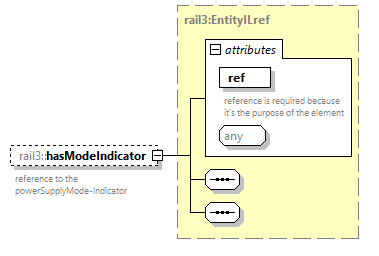 | ||||||||||||||
| namespace | https://www.railml.org/schemas/3.2 | ||||||||||||||
| type | rail3:EntityILref | ||||||||||||||
| properties |
| ||||||||||||||
| attributes |
| ||||||||||||||
| annotation |
| ||||||||||||||
| source | <xs:element name="hasModeIndicator" type="rail3:EntityILref" minOccurs="0" maxOccurs="1"> <xs:annotation> <xs:documentation>reference to the powerSupplyMode-Indicator</xs:documentation> </xs:annotation> </xs:element> |
complexType RadioBlockCentre
| diagram | 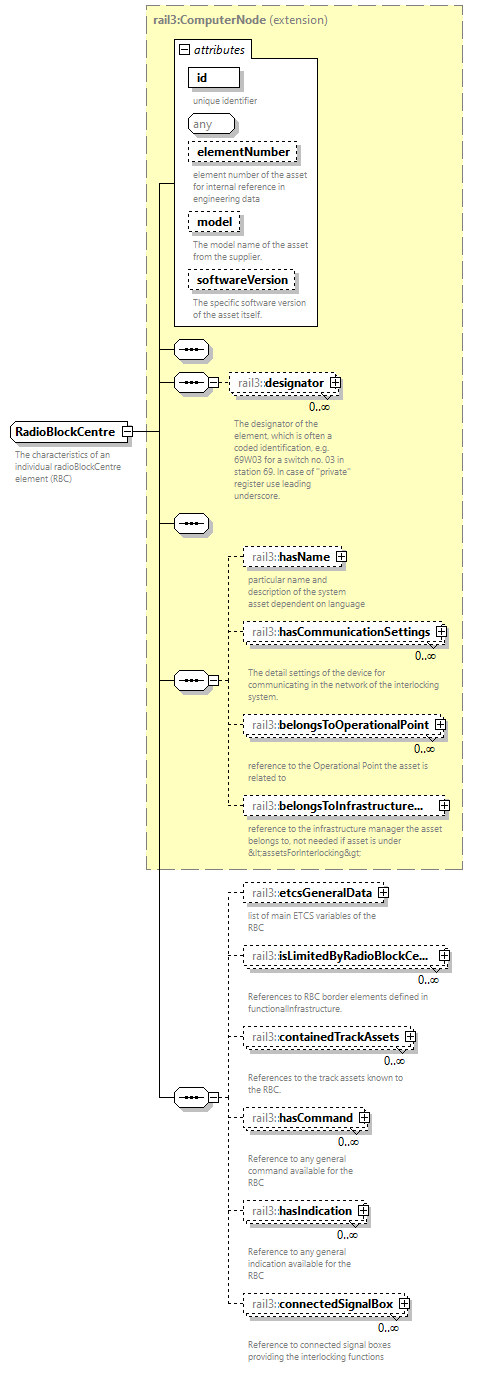 | ||||||||||||||||||||||||||||||||||||||
| namespace | https://www.railml.org/schemas/3.2 | ||||||||||||||||||||||||||||||||||||||
| type | extension of rail3:ComputerNode | ||||||||||||||||||||||||||||||||||||||
| properties |
| ||||||||||||||||||||||||||||||||||||||
| children | rail3:designator rail3:hasName rail3:hasCommunicationSettings rail3:belongsToOperationalPoint rail3:belongsToInfrastructureManager rail3:etcsGeneralData rail3:isLimitedByRadioBlockCentreBorder rail3:containedTrackAssets rail3:hasCommand rail3:hasIndication rail3:connectedSignalBox | ||||||||||||||||||||||||||||||||||||||
| used by |
| ||||||||||||||||||||||||||||||||||||||
| attributes |
| ||||||||||||||||||||||||||||||||||||||
| annotation |
| ||||||||||||||||||||||||||||||||||||||
| source | <xs:complexType name="RadioBlockCentre"> <xs:annotation> <xs:documentation>The characteristics of an individual radioBlockCentre element (RBC)</xs:documentation> </xs:annotation> <xs:complexContent> <xs:extension base="rail3:ComputerNode"> <xs:sequence> <xs:element name="etcsGeneralData" type="rail3:EtcsGeneralData" minOccurs="0" maxOccurs="1"> <xs:annotation> <xs:documentation>list of main ETCS variables of the RBC</xs:documentation> </xs:annotation> </xs:element> <xs:element name="isLimitedByRadioBlockCentreBorder" type="rail3:EntityILref" minOccurs="0" maxOccurs="unbounded"> <xs:annotation> <xs:documentation>References to RBC border elements defined in functionalInfrastructure.</xs:documentation> </xs:annotation> </xs:element> <xs:element name="containedTrackAssets" type="rail3:EntityILref" minOccurs="0" maxOccurs="unbounded"> <xs:annotation> <xs:documentation>References to the track assets known to the RBC.</xs:documentation> </xs:annotation> </xs:element> <xs:element name="hasCommand" type="rail3:CodedEntityILref" minOccurs="0" maxOccurs="unbounded"> <xs:annotation> <xs:documentation>Reference to any general command available for the RBC</xs:documentation> </xs:annotation> </xs:element> <xs:element name="hasIndication" type="rail3:CodedEntityILref" minOccurs="0" maxOccurs="unbounded"> <xs:annotation> <xs:documentation>Reference to any general indication available for the RBC</xs:documentation> </xs:annotation> </xs:element> <xs:element name="connectedSignalBox" type="rail3:EntityILref" minOccurs="0" maxOccurs="unbounded"> <xs:annotation> <xs:documentation>Reference to connected signal boxes providing the interlocking functions</xs:documentation> </xs:annotation> </xs:element> </xs:sequence> </xs:extension> </xs:complexContent> </xs:complexType> |
element RadioBlockCentre/etcsGeneralData
| diagram | 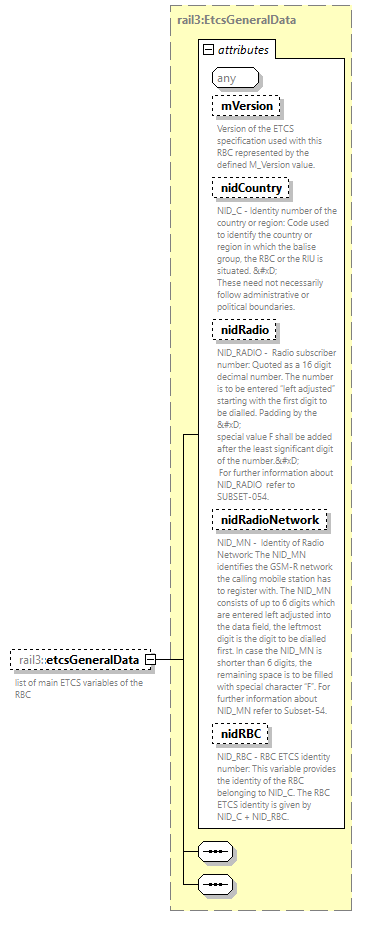 | ||||||||||||||||||||||||||||||||||||||||||||||
| namespace | https://www.railml.org/schemas/3.2 | ||||||||||||||||||||||||||||||||||||||||||||||
| type | rail3:EtcsGeneralData | ||||||||||||||||||||||||||||||||||||||||||||||
| properties |
| ||||||||||||||||||||||||||||||||||||||||||||||
| attributes |
| ||||||||||||||||||||||||||||||||||||||||||||||
| annotation |
| ||||||||||||||||||||||||||||||||||||||||||||||
| source | <xs:element name="etcsGeneralData" type="rail3:EtcsGeneralData" minOccurs="0" maxOccurs="1"> <xs:annotation> <xs:documentation>list of main ETCS variables of the RBC</xs:documentation> </xs:annotation> </xs:element> |
element RadioBlockCentre/isLimitedByRadioBlockCentreBorder
| diagram | 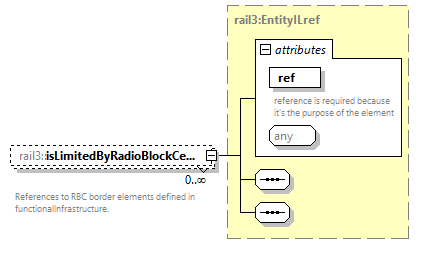 | ||||||||||||||
| namespace | https://www.railml.org/schemas/3.2 | ||||||||||||||
| type | rail3:EntityILref | ||||||||||||||
| properties |
| ||||||||||||||
| attributes |
| ||||||||||||||
| annotation |
| ||||||||||||||
| source | <xs:element name="isLimitedByRadioBlockCentreBorder" type="rail3:EntityILref" minOccurs="0" maxOccurs="unbounded"> <xs:annotation> <xs:documentation>References to RBC border elements defined in functionalInfrastructure.</xs:documentation> </xs:annotation> </xs:element> |
element RadioBlockCentre/containedTrackAssets
| diagram | 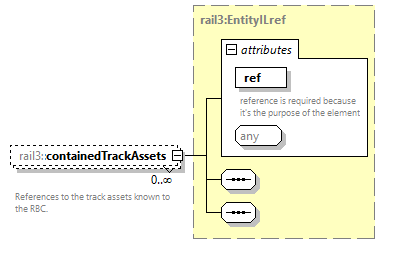 | ||||||||||||||
| namespace | https://www.railml.org/schemas/3.2 | ||||||||||||||
| type | rail3:EntityILref | ||||||||||||||
| properties |
| ||||||||||||||
| attributes |
| ||||||||||||||
| annotation |
| ||||||||||||||
| source | <xs:element name="containedTrackAssets" type="rail3:EntityILref" minOccurs="0" maxOccurs="unbounded"> <xs:annotation> <xs:documentation>References to the track assets known to the RBC.</xs:documentation> </xs:annotation> </xs:element> |
element RadioBlockCentre/hasCommand
| diagram | 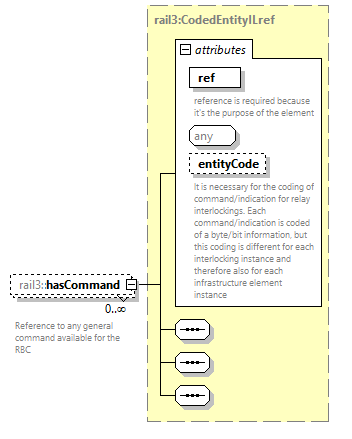 | ||||||||||||||||||||||
| namespace | https://www.railml.org/schemas/3.2 | ||||||||||||||||||||||
| type | rail3:CodedEntityILref | ||||||||||||||||||||||
| properties |
| ||||||||||||||||||||||
| attributes |
| ||||||||||||||||||||||
| annotation |
| ||||||||||||||||||||||
| source | <xs:element name="hasCommand" type="rail3:CodedEntityILref" minOccurs="0" maxOccurs="unbounded"> <xs:annotation> <xs:documentation>Reference to any general command available for the RBC</xs:documentation> </xs:annotation> </xs:element> |
element RadioBlockCentre/hasIndication
| diagram | 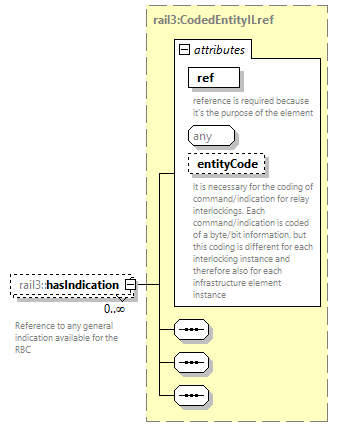 | ||||||||||||||||||||||
| namespace | https://www.railml.org/schemas/3.2 | ||||||||||||||||||||||
| type | rail3:CodedEntityILref | ||||||||||||||||||||||
| properties |
| ||||||||||||||||||||||
| attributes |
| ||||||||||||||||||||||
| annotation |
| ||||||||||||||||||||||
| source | <xs:element name="hasIndication" type="rail3:CodedEntityILref" minOccurs="0" maxOccurs="unbounded"> <xs:annotation> <xs:documentation>Reference to any general indication available for the RBC</xs:documentation> </xs:annotation> </xs:element> |
element RadioBlockCentre/connectedSignalBox
| diagram | 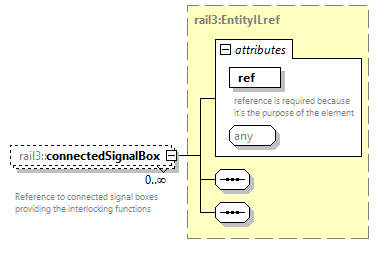 | ||||||||||||||
| namespace | https://www.railml.org/schemas/3.2 | ||||||||||||||
| type | rail3:EntityILref | ||||||||||||||
| properties |
| ||||||||||||||
| attributes |
| ||||||||||||||
| annotation |
| ||||||||||||||
| source | <xs:element name="connectedSignalBox" type="rail3:EntityILref" minOccurs="0" maxOccurs="unbounded"> <xs:annotation> <xs:documentation>Reference to connected signal boxes providing the interlocking functions</xs:documentation> </xs:annotation> </xs:element> |
complexType RadioBlockCentres
| diagram |  | ||
| namespace | https://www.railml.org/schemas/3.2 | ||
| children | rail3:radioBlockCentre | ||
| used by |
| ||
| annotation |
| ||
| source | <xs:complexType name="RadioBlockCentres"> <xs:annotation> <xs:documentation>container for all radioBlockCenter elements</xs:documentation> </xs:annotation> <xs:sequence> <xs:element name="radioBlockCentre" type="rail3:RadioBlockCentre" minOccurs="1" maxOccurs="unbounded"> <xs:annotation> <xs:documentation>Container with the characteristics of an individual radioBlockCenter element</xs:documentation> </xs:annotation> </xs:element> </xs:sequence> </xs:complexType> |
element RadioBlockCentres/radioBlockCentre
| diagram | 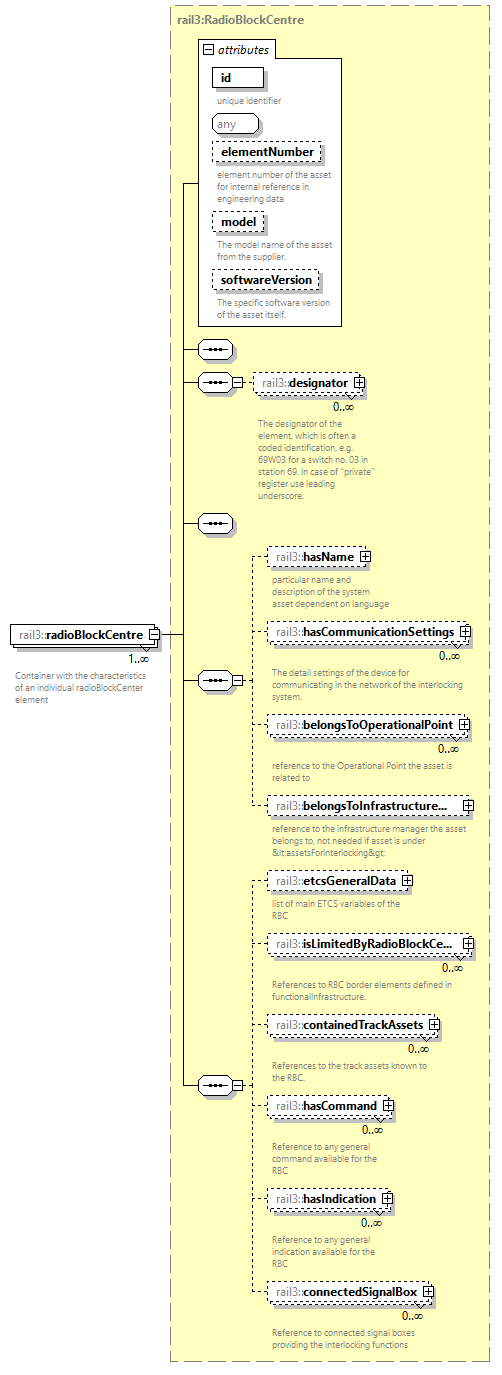 | ||||||||||||||||||||||||||||||||||||||
| namespace | https://www.railml.org/schemas/3.2 | ||||||||||||||||||||||||||||||||||||||
| type | rail3:RadioBlockCentre | ||||||||||||||||||||||||||||||||||||||
| properties |
| ||||||||||||||||||||||||||||||||||||||
| children | rail3:designator rail3:hasName rail3:hasCommunicationSettings rail3:belongsToOperationalPoint rail3:belongsToInfrastructureManager rail3:etcsGeneralData rail3:isLimitedByRadioBlockCentreBorder rail3:containedTrackAssets rail3:hasCommand rail3:hasIndication rail3:connectedSignalBox | ||||||||||||||||||||||||||||||||||||||
| attributes |
| ||||||||||||||||||||||||||||||||||||||
| annotation |
| ||||||||||||||||||||||||||||||||||||||
| source | <xs:element name="radioBlockCentre" type="rail3:RadioBlockCentre" minOccurs="1" maxOccurs="unbounded"> <xs:annotation> <xs:documentation>Container with the characteristics of an individual radioBlockCenter element</xs:documentation> </xs:annotation> </xs:element> |
complexType RelationReference
| diagram | 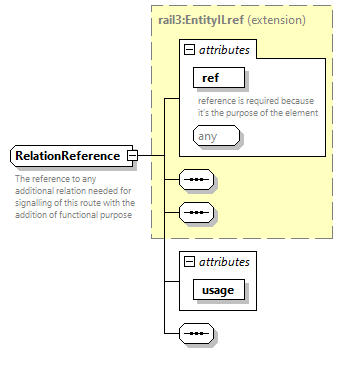 | ||||||||||||||||||||
| namespace | https://www.railml.org/schemas/3.2 | ||||||||||||||||||||
| type | extension of rail3:EntityILref | ||||||||||||||||||||
| properties |
| ||||||||||||||||||||
| used by |
| ||||||||||||||||||||
| attributes |
| ||||||||||||||||||||
| annotation |
| ||||||||||||||||||||
| source | <xs:complexType name="RelationReference"> <xs:annotation> <xs:documentation>The reference to any additional relation needed for signalling of this route with the addition of functional purpose</xs:documentation> </xs:annotation> <xs:complexContent> <xs:extension base="rail3:EntityILref"> <xs:sequence/> <xs:attribute name="usage" type="rail3:tRelationUsageListExt" use="required"/> </xs:extension> </xs:complexContent> </xs:complexType> |
attribute RelationReference/@usage
| type | rail3:tRelationUsageListExt | ||
| properties |
| ||
| source | <xs:attribute name="usage" type="rail3:tRelationUsageListExt" use="required"/> |
complexType RepeaterSignal
| diagram | 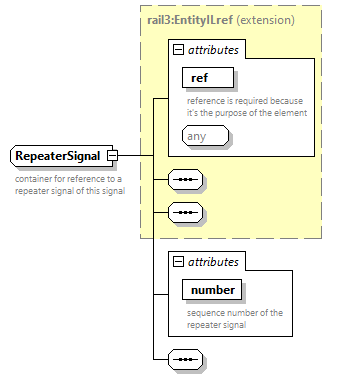 | ||||||||||||||||||||||
| namespace | https://www.railml.org/schemas/3.2 | ||||||||||||||||||||||
| type | extension of rail3:EntityILref | ||||||||||||||||||||||
| properties |
| ||||||||||||||||||||||
| used by |
| ||||||||||||||||||||||
| attributes |
| ||||||||||||||||||||||
| annotation |
| ||||||||||||||||||||||
| source | <xs:complexType name="RepeaterSignal"> <xs:annotation> <xs:documentation>container for reference to a repeater signal of this signal</xs:documentation> </xs:annotation> <xs:complexContent> <xs:extension base="rail3:EntityILref"> <xs:sequence/> <xs:attribute name="number" type="xs:nonNegativeInteger" use="required"> <xs:annotation> <xs:documentation>sequence number of the repeater signal</xs:documentation> </xs:annotation> </xs:attribute> </xs:extension> </xs:complexContent> </xs:complexType> |
attribute RepeaterSignal/@number
| type | xs:nonNegativeInteger | ||
| properties |
| ||
| annotation |
| ||
| source | <xs:attribute name="number" type="xs:nonNegativeInteger" use="required"> <xs:annotation> <xs:documentation>sequence number of the repeater signal</xs:documentation> </xs:annotation> </xs:attribute> |
complexType RestrictedArea
| diagram | 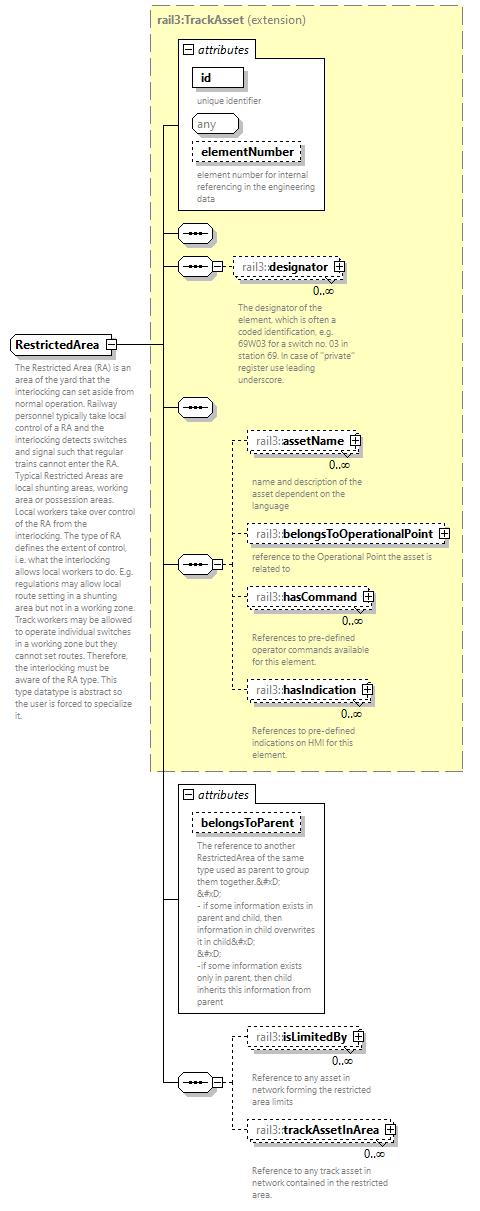 | ||||||||||||||||||||||||||||||
| namespace | https://www.railml.org/schemas/3.2 | ||||||||||||||||||||||||||||||
| type | extension of rail3:TrackAsset | ||||||||||||||||||||||||||||||
| properties |
| ||||||||||||||||||||||||||||||
| children | rail3:designator rail3:assetName rail3:belongsToOperationalPoint rail3:hasCommand rail3:hasIndication rail3:isLimitedBy rail3:trackAssetInArea | ||||||||||||||||||||||||||||||
| used by |
| ||||||||||||||||||||||||||||||
| attributes |
| ||||||||||||||||||||||||||||||
| annotation |
| ||||||||||||||||||||||||||||||
| source | <xs:complexType name="RestrictedArea" abstract="true"> <xs:annotation> <xs:documentation>The Restricted Area (RA) is an area of the yard that the interlocking can set aside from normal operation. Railway personnel typically take local control of a RA and the interlocking detects switches and signal such that regular trains cannot enter the RA. Typical Restricted Areas are local shunting areas, working area or possession areas. Local workers take over control of the RA from the interlocking. The type of RA defines the extent of control, i.e. what the interlocking allows local workers to do. E.g. regulations may allow local route setting in a shunting area but not in a working zone. Track workers may be allowed to operate individual switches in a working zone but they cannot set routes. Therefore, the interlocking must be aware of the RA type. This type datatype is abstract so the user is forced to specialize it.</xs:documentation> </xs:annotation> <xs:complexContent> <xs:extension base="rail3:TrackAsset"> <xs:sequence> <xs:element name="isLimitedBy" type="rail3:EntityILref" minOccurs="0" maxOccurs="unbounded"> <xs:annotation> <xs:documentation>Reference to any asset in network forming the restricted area limits</xs:documentation> </xs:annotation> </xs:element> <xs:element name="trackAssetInArea" type="rail3:EntityILref" minOccurs="0" maxOccurs="unbounded"> <xs:annotation> <xs:documentation>Reference to any track asset in network contained in the restricted area.</xs:documentation> </xs:annotation> </xs:element> </xs:sequence> <xs:attribute name="belongsToParent" type="rail3:tRef" use="optional"> <xs:annotation> <xs:documentation>The reference to another RestrictedArea of the same type used as parent to group them together.
 
 - if some information exists in parent and child, then information in child overwrites it in child
 
 -if some information exists only in parent, then child inherits this information from parent</xs:documentation> </xs:annotation> </xs:attribute> </xs:extension> </xs:complexContent> </xs:complexType> |
attribute RestrictedArea/@belongsToParent
| type | rail3:tRef | ||
| properties |
| ||
| annotation |
| ||
| source | <xs:attribute name="belongsToParent" type="rail3:tRef" use="optional"> <xs:annotation> <xs:documentation>The reference to another RestrictedArea of the same type used as parent to group them together.
 
 - if some information exists in parent and child, then information in child overwrites it in child
 
 -if some information exists only in parent, then child inherits this information from parent</xs:documentation> </xs:annotation> </xs:attribute> |
element RestrictedArea/isLimitedBy
| diagram | 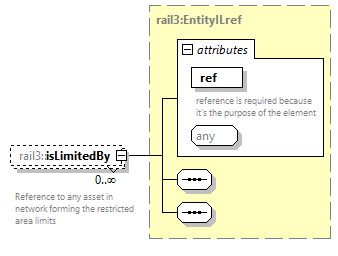 | ||||||||||||||
| namespace | https://www.railml.org/schemas/3.2 | ||||||||||||||
| type | rail3:EntityILref | ||||||||||||||
| properties |
| ||||||||||||||
| attributes |
| ||||||||||||||
| annotation |
| ||||||||||||||
| source | <xs:element name="isLimitedBy" type="rail3:EntityILref" minOccurs="0" maxOccurs="unbounded"> <xs:annotation> <xs:documentation>Reference to any asset in network forming the restricted area limits</xs:documentation> </xs:annotation> </xs:element> |
element RestrictedArea/trackAssetInArea
| diagram | 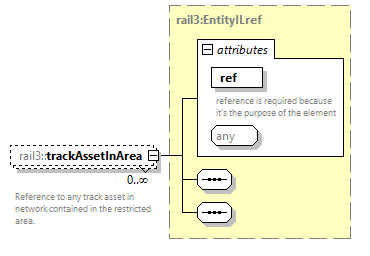 | ||||||||||||||
| namespace | https://www.railml.org/schemas/3.2 | ||||||||||||||
| type | rail3:EntityILref | ||||||||||||||
| properties |
| ||||||||||||||
| attributes |
| ||||||||||||||
| annotation |
| ||||||||||||||
| source | <xs:element name="trackAssetInArea" type="rail3:EntityILref" minOccurs="0" maxOccurs="unbounded"> <xs:annotation> <xs:documentation>Reference to any track asset in network contained in the restricted area.</xs:documentation> </xs:annotation> </xs:element> |
complexType Route
| diagram |  | ||||||||||||||||||||||||||||||||||||||||||||||||||||||||||||||||||||||||||||||
| namespace | https://www.railml.org/schemas/3.2 | ||||||||||||||||||||||||||||||||||||||||||||||||||||||||||||||||||||||||||||||
| type | extension of rail3:RouteObject | ||||||||||||||||||||||||||||||||||||||||||||||||||||||||||||||||||||||||||||||
| properties |
| ||||||||||||||||||||||||||||||||||||||||||||||||||||||||||||||||||||||||||||||
| children | rail3:designator rail3:objectName rail3:belongsToOperationalPoint rail3:hasCommand rail3:hasIndication rail3:handlesRouteType rail3:routeActivationSection rail3:facingSwitchInPosition rail3:trailingSwitchInPosition rail3:hasTvdSection rail3:routeEntry rail3:intermediateCodePoint rail3:hasReleaseGroup rail3:switchPositionInDepartureTrack rail3:routeExit rail3:additionalRelation | ||||||||||||||||||||||||||||||||||||||||||||||||||||||||||||||||||||||||||||||
| used by |
| ||||||||||||||||||||||||||||||||||||||||||||||||||||||||||||||||||||||||||||||
| attributes |
| ||||||||||||||||||||||||||||||||||||||||||||||||||||||||||||||||||||||||||||||
| annotation |
| ||||||||||||||||||||||||||||||||||||||||||||||||||||||||||||||||||||||||||||||
| source | <xs:complexType name="Route"> <xs:annotation> <xs:documentation>We define a route as an entry- and exit plus the positions of intermediate switches. If there are no switches in the route, no switch positions can be defined. If one or more switches are encountered en route, either facing or trailing, the positions of these switches must be given. There can be multiple routes from entry to exit depending on the positions of the intermediate switches. The user is free to create different routes with the same entry,exit and same switch positions that differ only by the classifier. This allows one to distinguish for example a traction-route from no-traction-route</xs:documentation> </xs:annotation> <xs:complexContent> <xs:extension base="rail3:RouteObject"> <xs:sequence> <xs:element name="handlesRouteType" type="rail3:EntityILref" minOccurs="0" maxOccurs="unbounded"> <xs:annotation> <xs:documentation>The reference to the Infrastructure Manager specific route type. This implies particular characteristics of the route dependent on the Infrastructure Manager operational rules.</xs:documentation> </xs:annotation> </xs:element> <xs:element name="routeActivationSection" type="rail3:RouteActivationSection" minOccurs="0" maxOccurs="unbounded"> <xs:annotation> <xs:documentation>Description of the route activation, i.e. automatic setting or locking when the route entry is approached.</xs:documentation> </xs:annotation> </xs:element> <xs:element name="facingSwitchInPosition" type="rail3:SwitchAndPosition" minOccurs="0" maxOccurs="unbounded"> <xs:annotation> <xs:documentation>The tuple for each facing switch in the running path to unambiguously define the route containing the reference to the switch and its position.</xs:documentation> </xs:annotation> </xs:element> <xs:element name="trailingSwitchInPosition" type="rail3:SwitchAndPosition" minOccurs="0" maxOccurs="unbounded"> <xs:annotation> <xs:documentation>The tuple for each trailing switch in the running path to supporting definition of the route containing the reference to the switch and its position.</xs:documentation> </xs:annotation> </xs:element> <xs:element name="hasTvdSection" type="rail3:EntityILref" minOccurs="0" maxOccurs="unbounded"> <xs:annotation> <xs:documentation>The reference to TVD section(s) within the running path of the route.</xs:documentation> </xs:annotation> </xs:element> <xs:element name="routeEntry" type="rail3:RouteEntry" minOccurs="1" maxOccurs="1"> <xs:annotation> <xs:documentation>Description of the start point of the route. This is normally a signal.</xs:documentation> </xs:annotation> </xs:element> <xs:element name="intermediateCodePoint" type="rail3:EntityILref" minOccurs="0" maxOccurs="unbounded"> <xs:annotation> <xs:documentation>Reference to TrackIL or SwitchIL element between Entry and Exit in order to define the running path.</xs:documentation> </xs:annotation> </xs:element> <xs:element name="hasReleaseGroup" type="rail3:EntityILref" minOccurs="0" maxOccurs="unbounded"> <xs:annotation> <xs:documentation>The references to any partial routes which are to be released together within a group.</xs:documentation> </xs:annotation> </xs:element> <xs:element name="switchPositionInDepartureTrack" type="rail3:SwitchAndPosition" minOccurs="0" maxOccurs="unbounded"> <xs:annotation> <xs:documentation>The tuple for any switch in the track in rear of the start signal required for this route containing the reference to the switch and its position.</xs:documentation> </xs:annotation> </xs:element> <xs:element name="routeExit" type="rail3:RouteExit" minOccurs="1" maxOccurs="1"> <xs:annotation> <xs:documentation>Description of the route destination point. In most cases the route destination is a signal or a buffer stop. </xs:documentation> </xs:annotation> </xs:element> <xs:element name="additionalRelation" type="rail3:RelationReference" minOccurs="0" maxOccurs="unbounded"> <xs:annotation> <xs:documentation>reference to any additional relation needed for signalling of this route with the addition of functional purpose</xs:documentation> </xs:annotation> </xs:element> </xs:sequence> <xs:attribute name="approachReleaseDelay" type="xs:duration" use="optional"> <xs:annotation> <xs:documentation>The delay between the request from signalman to release an already approached (definitely locked) route and the real release of associated elements of the route.</xs:documentation> </xs:annotation> </xs:attribute> <xs:attribute name="locksAutomatically" type="xs:boolean" use="optional"> <xs:annotation> <xs:documentation>If true, the interlocking locks this route automatically and immediately after it was cleared. The operator has to intervene if he wishes to call another route. Automatikfahrstrasse in German, trace automatique in French. Note that this functionality is often part of the control system in which case this attribute should be omitted.</xs:documentation> </xs:annotation> </xs:attribute> <xs:attribute name="priorityRank" type="rail3:tPriority" use="optional"> <xs:annotation> <xs:documentation>Gives the priority of the route path in case there are several possible paths between entry and exit. The highest priority is 0.</xs:documentation> </xs:annotation> </xs:attribute> <xs:attribute name="proceedAspectDelay" type="xs:duration" use="optional"> <xs:annotation> <xs:documentation>The delay for the signal before it will change from closed to any proceed aspect.</xs:documentation> </xs:annotation> </xs:attribute> <xs:attribute name="processingDelay" type="xs:duration" use="optional"> <xs:annotation> <xs:documentation>The delay in seconds between the moment the interlocking receives the route call and the moment the route the interlocking reports back that the route is locked, i.e. the processing time for setting that route.</xs:documentation> </xs:annotation> </xs:attribute> <xs:attribute name="residualRouteReleaseDelay" type="xs:duration" use="optional"> <xs:annotation> <xs:documentation>The delay after commanding the release of the remaining route parts until the route elements are finally released.</xs:documentation> </xs:annotation> </xs:attribute> <xs:attribute name="signalClosureDelay" type="xs:duration" use="optional"> <xs:annotation> <xs:documentation>The delay for the signal after the conditions for proceed aspect are removed and the physical closure of the signal.</xs:documentation> </xs:annotation> </xs:attribute> </xs:extension> </xs:complexContent> </xs:complexType> |
attribute Route/@approachReleaseDelay
| type | xs:duration | ||
| properties |
| ||
| annotation |
| ||
| source | <xs:attribute name="approachReleaseDelay" type="xs:duration" use="optional"> <xs:annotation> <xs:documentation>The delay between the request from signalman to release an already approached (definitely locked) route and the real release of associated elements of the route.</xs:documentation> </xs:annotation> </xs:attribute> |
attribute Route/@locksAutomatically
| type | xs:boolean | ||
| properties |
| ||
| annotation |
| ||
| source | <xs:attribute name="locksAutomatically" type="xs:boolean" use="optional"> <xs:annotation> <xs:documentation>If true, the interlocking locks this route automatically and immediately after it was cleared. The operator has to intervene if he wishes to call another route. Automatikfahrstrasse in German, trace automatique in French. Note that this functionality is often part of the control system in which case this attribute should be omitted.</xs:documentation> </xs:annotation> </xs:attribute> |
attribute Route/@priorityRank
| type | rail3:tPriority | ||
| properties |
| ||
| annotation |
| ||
| source | <xs:attribute name="priorityRank" type="rail3:tPriority" use="optional"> <xs:annotation> <xs:documentation>Gives the priority of the route path in case there are several possible paths between entry and exit. The highest priority is 0.</xs:documentation> </xs:annotation> </xs:attribute> |
attribute Route/@proceedAspectDelay
| type | xs:duration | ||
| properties |
| ||
| annotation |
| ||
| source | <xs:attribute name="proceedAspectDelay" type="xs:duration" use="optional"> <xs:annotation> <xs:documentation>The delay for the signal before it will change from closed to any proceed aspect.</xs:documentation> </xs:annotation> </xs:attribute> |
attribute Route/@processingDelay
| type | xs:duration | ||
| properties |
| ||
| annotation |
| ||
| source | <xs:attribute name="processingDelay" type="xs:duration" use="optional"> <xs:annotation> <xs:documentation>The delay in seconds between the moment the interlocking receives the route call and the moment the route the interlocking reports back that the route is locked, i.e. the processing time for setting that route.</xs:documentation> </xs:annotation> </xs:attribute> |
attribute Route/@residualRouteReleaseDelay
| type | xs:duration | ||
| properties |
| ||
| annotation |
| ||
| source | <xs:attribute name="residualRouteReleaseDelay" type="xs:duration" use="optional"> <xs:annotation> <xs:documentation>The delay after commanding the release of the remaining route parts until the route elements are finally released.</xs:documentation> </xs:annotation> </xs:attribute> |
attribute Route/@signalClosureDelay
| type | xs:duration | ||
| properties |
| ||
| annotation |
| ||
| source | <xs:attribute name="signalClosureDelay" type="xs:duration" use="optional"> <xs:annotation> <xs:documentation>The delay for the signal after the conditions for proceed aspect are removed and the physical closure of the signal.</xs:documentation> </xs:annotation> </xs:attribute> |
element Route/handlesRouteType
| diagram | 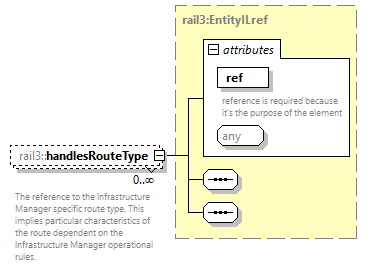 | ||||||||||||||
| namespace | https://www.railml.org/schemas/3.2 | ||||||||||||||
| type | rail3:EntityILref | ||||||||||||||
| properties |
| ||||||||||||||
| attributes |
| ||||||||||||||
| annotation |
| ||||||||||||||
| source | <xs:element name="handlesRouteType" type="rail3:EntityILref" minOccurs="0" maxOccurs="unbounded"> <xs:annotation> <xs:documentation>The reference to the Infrastructure Manager specific route type. This implies particular characteristics of the route dependent on the Infrastructure Manager operational rules.</xs:documentation> </xs:annotation> </xs:element> |
element Route/routeActivationSection
| diagram | 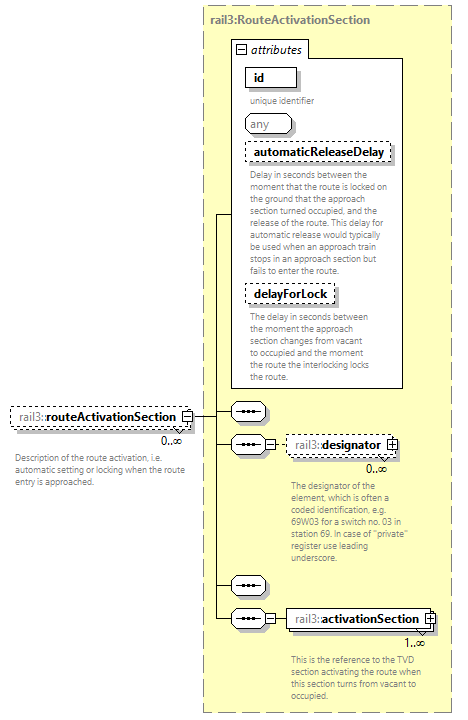 | ||||||||||||||||||||||||||||||
| namespace | https://www.railml.org/schemas/3.2 | ||||||||||||||||||||||||||||||
| type | rail3:RouteActivationSection | ||||||||||||||||||||||||||||||
| properties |
| ||||||||||||||||||||||||||||||
| children | rail3:designator rail3:activationSection | ||||||||||||||||||||||||||||||
| attributes |
| ||||||||||||||||||||||||||||||
| annotation |
| ||||||||||||||||||||||||||||||
| source | <xs:element name="routeActivationSection" type="rail3:RouteActivationSection" minOccurs="0" maxOccurs="unbounded"> <xs:annotation> <xs:documentation>Description of the route activation, i.e. automatic setting or locking when the route entry is approached.</xs:documentation> </xs:annotation> </xs:element> |
element Route/facingSwitchInPosition
| diagram | 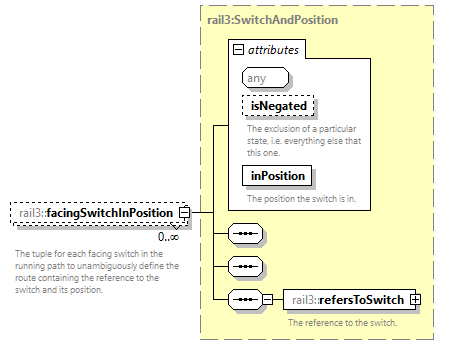 | ||||||||||||||||||||||
| namespace | https://www.railml.org/schemas/3.2 | ||||||||||||||||||||||
| type | rail3:SwitchAndPosition | ||||||||||||||||||||||
| properties |
| ||||||||||||||||||||||
| children | rail3:refersToSwitch | ||||||||||||||||||||||
| attributes |
| ||||||||||||||||||||||
| annotation |
| ||||||||||||||||||||||
| source | <xs:element name="facingSwitchInPosition" type="rail3:SwitchAndPosition" minOccurs="0" maxOccurs="unbounded"> <xs:annotation> <xs:documentation>The tuple for each facing switch in the running path to unambiguously define the route containing the reference to the switch and its position.</xs:documentation> </xs:annotation> </xs:element> |
element Route/trailingSwitchInPosition
| diagram | 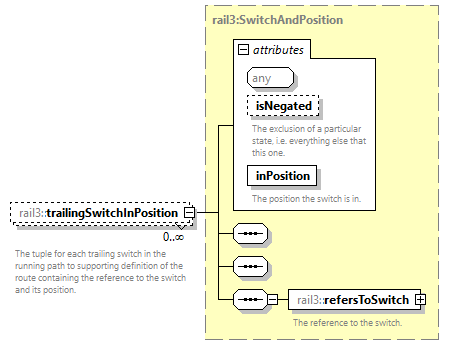 | ||||||||||||||||||||||
| namespace | https://www.railml.org/schemas/3.2 | ||||||||||||||||||||||
| type | rail3:SwitchAndPosition | ||||||||||||||||||||||
| properties |
| ||||||||||||||||||||||
| children | rail3:refersToSwitch | ||||||||||||||||||||||
| attributes |
| ||||||||||||||||||||||
| annotation |
| ||||||||||||||||||||||
| source | <xs:element name="trailingSwitchInPosition" type="rail3:SwitchAndPosition" minOccurs="0" maxOccurs="unbounded"> <xs:annotation> <xs:documentation>The tuple for each trailing switch in the running path to supporting definition of the route containing the reference to the switch and its position.</xs:documentation> </xs:annotation> </xs:element> |
element Route/hasTvdSection
| diagram | 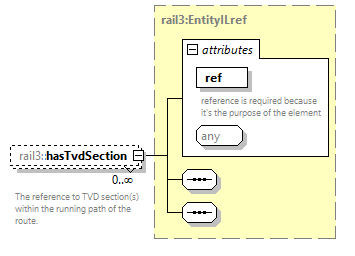 | ||||||||||||||
| namespace | https://www.railml.org/schemas/3.2 | ||||||||||||||
| type | rail3:EntityILref | ||||||||||||||
| properties |
| ||||||||||||||
| attributes |
| ||||||||||||||
| annotation |
| ||||||||||||||
| source | <xs:element name="hasTvdSection" type="rail3:EntityILref" minOccurs="0" maxOccurs="unbounded"> <xs:annotation> <xs:documentation>The reference to TVD section(s) within the running path of the route.</xs:documentation> </xs:annotation> </xs:element> |
element Route/routeEntry
| diagram | 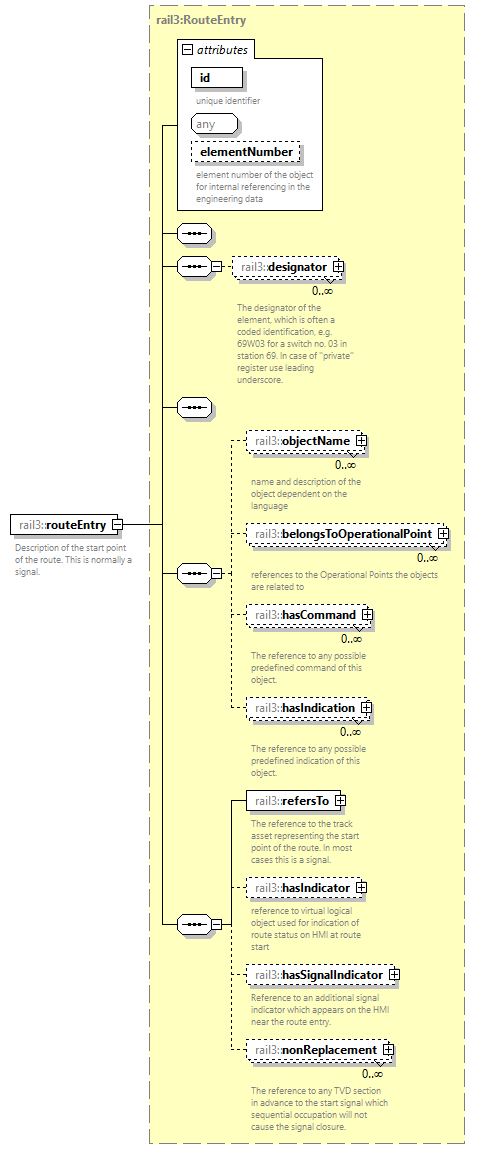 | ||||||||||||||||||||||
| namespace | https://www.railml.org/schemas/3.2 | ||||||||||||||||||||||
| type | rail3:RouteEntry | ||||||||||||||||||||||
| properties |
| ||||||||||||||||||||||
| children | rail3:designator rail3:objectName rail3:belongsToOperationalPoint rail3:hasCommand rail3:hasIndication rail3:refersTo rail3:hasIndicator rail3:hasSignalIndicator rail3:nonReplacement | ||||||||||||||||||||||
| attributes |
| ||||||||||||||||||||||
| annotation |
| ||||||||||||||||||||||
| source | <xs:element name="routeEntry" type="rail3:RouteEntry" minOccurs="1" maxOccurs="1"> <xs:annotation> <xs:documentation>Description of the start point of the route. This is normally a signal.</xs:documentation> </xs:annotation> </xs:element> |
element Route/intermediateCodePoint
| diagram | 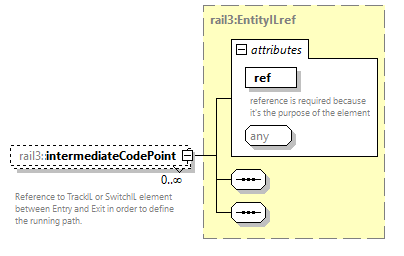 | ||||||||||||||
| namespace | https://www.railml.org/schemas/3.2 | ||||||||||||||
| type | rail3:EntityILref | ||||||||||||||
| properties |
| ||||||||||||||
| attributes |
| ||||||||||||||
| annotation |
| ||||||||||||||
| source | <xs:element name="intermediateCodePoint" type="rail3:EntityILref" minOccurs="0" maxOccurs="unbounded"> <xs:annotation> <xs:documentation>Reference to TrackIL or SwitchIL element between Entry and Exit in order to define the running path.</xs:documentation> </xs:annotation> </xs:element> |
element Route/hasReleaseGroup
| diagram | 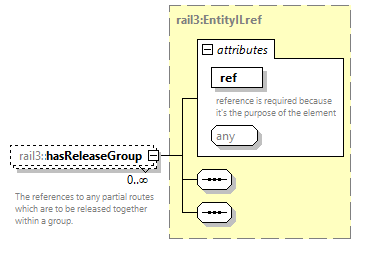 | ||||||||||||||
| namespace | https://www.railml.org/schemas/3.2 | ||||||||||||||
| type | rail3:EntityILref | ||||||||||||||
| properties |
| ||||||||||||||
| attributes |
| ||||||||||||||
| annotation |
| ||||||||||||||
| source | <xs:element name="hasReleaseGroup" type="rail3:EntityILref" minOccurs="0" maxOccurs="unbounded"> <xs:annotation> <xs:documentation>The references to any partial routes which are to be released together within a group.</xs:documentation> </xs:annotation> </xs:element> |
element Route/switchPositionInDepartureTrack
| diagram | 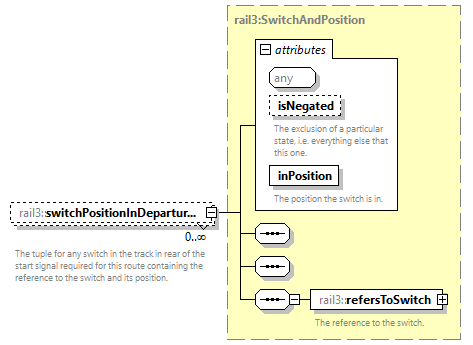 | ||||||||||||||||||||||
| namespace | https://www.railml.org/schemas/3.2 | ||||||||||||||||||||||
| type | rail3:SwitchAndPosition | ||||||||||||||||||||||
| properties |
| ||||||||||||||||||||||
| children | rail3:refersToSwitch | ||||||||||||||||||||||
| attributes |
| ||||||||||||||||||||||
| annotation |
| ||||||||||||||||||||||
| source | <xs:element name="switchPositionInDepartureTrack" type="rail3:SwitchAndPosition" minOccurs="0" maxOccurs="unbounded"> <xs:annotation> <xs:documentation>The tuple for any switch in the track in rear of the start signal required for this route containing the reference to the switch and its position.</xs:documentation> </xs:annotation> </xs:element> |
element Route/routeExit
| diagram | 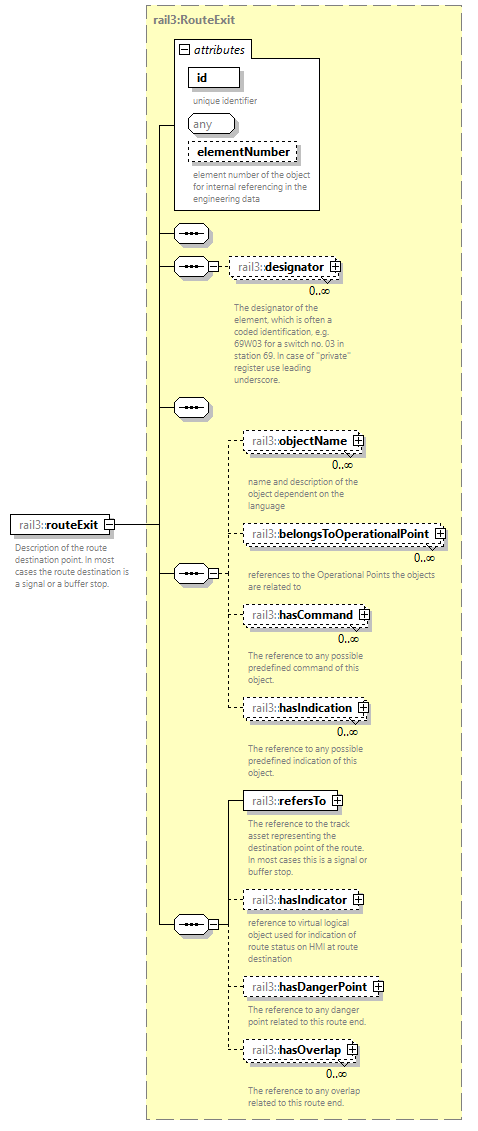 | ||||||||||||||||||||||
| namespace | https://www.railml.org/schemas/3.2 | ||||||||||||||||||||||
| type | rail3:RouteExit | ||||||||||||||||||||||
| properties |
| ||||||||||||||||||||||
| children | rail3:designator rail3:objectName rail3:belongsToOperationalPoint rail3:hasCommand rail3:hasIndication rail3:refersTo rail3:hasIndicator rail3:hasDangerPoint rail3:hasOverlap | ||||||||||||||||||||||
| attributes |
| ||||||||||||||||||||||
| annotation |
| ||||||||||||||||||||||
| source | <xs:element name="routeExit" type="rail3:RouteExit" minOccurs="1" maxOccurs="1"> <xs:annotation> <xs:documentation>Description of the route destination point. In most cases the route destination is a signal or a buffer stop. </xs:documentation> </xs:annotation> </xs:element> |
element Route/additionalRelation
| diagram | 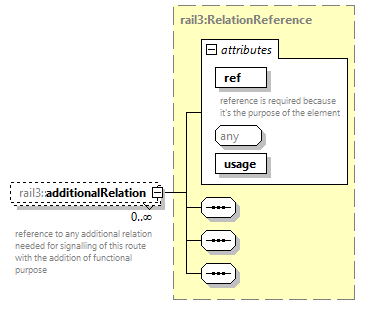 | ||||||||||||||||||||
| namespace | https://www.railml.org/schemas/3.2 | ||||||||||||||||||||
| type | rail3:RelationReference | ||||||||||||||||||||
| properties |
| ||||||||||||||||||||
| attributes |
| ||||||||||||||||||||
| annotation |
| ||||||||||||||||||||
| source | <xs:element name="additionalRelation" type="rail3:RelationReference" minOccurs="0" maxOccurs="unbounded"> <xs:annotation> <xs:documentation>reference to any additional relation needed for signalling of this route with the addition of functional purpose</xs:documentation> </xs:annotation> </xs:element> |
complexType RouteActivationSection
| diagram | 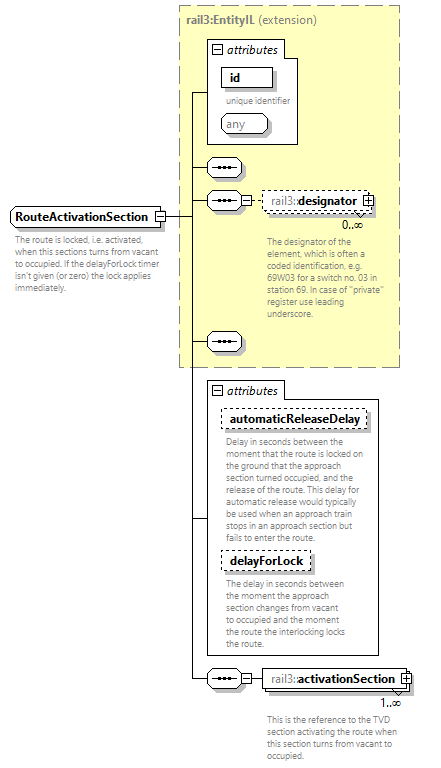 | ||||||||||||||||||||||||||||||
| namespace | https://www.railml.org/schemas/3.2 | ||||||||||||||||||||||||||||||
| type | extension of rail3:EntityIL | ||||||||||||||||||||||||||||||
| properties |
| ||||||||||||||||||||||||||||||
| children | rail3:designator rail3:activationSection | ||||||||||||||||||||||||||||||
| used by |
| ||||||||||||||||||||||||||||||
| attributes |
| ||||||||||||||||||||||||||||||
| annotation |
| ||||||||||||||||||||||||||||||
| source | <xs:complexType name="RouteActivationSection"> <xs:annotation> <xs:documentation>The route is locked, i.e. activated, when this sections turns from vacant to occupied. If the delayForLock timer isn't given (or zero) the lock applies immediately.</xs:documentation> </xs:annotation> <xs:complexContent> <xs:extension base="rail3:EntityIL"> <xs:sequence> <xs:element name="activationSection" type="rail3:EntityILref" minOccurs="1" maxOccurs="unbounded"> <xs:annotation> <xs:documentation>This is the reference to the TVD section activating the route when this section turns from vacant to occupied.</xs:documentation> </xs:annotation> </xs:element> </xs:sequence> <xs:attribute name="automaticReleaseDelay" type="xs:duration" use="optional"> <xs:annotation> <xs:documentation>Delay in seconds between the moment that the route is locked on the ground that the approach section turned occupied, and the release of the route. This delay for automatic release would typically be used when an approach train stops in an approach section but fails to enter the route.</xs:documentation> </xs:annotation> </xs:attribute> <xs:attribute name="delayForLock" type="xs:duration" use="optional"> <xs:annotation> <xs:documentation>The delay in seconds between the moment the approach section changes from vacant to occupied and the moment the route the interlocking locks the route.</xs:documentation> </xs:annotation> </xs:attribute> </xs:extension> </xs:complexContent> </xs:complexType> |
attribute RouteActivationSection/@automaticReleaseDelay
| type | xs:duration | ||
| properties |
| ||
| annotation |
| ||
| source | <xs:attribute name="automaticReleaseDelay" type="xs:duration" use="optional"> <xs:annotation> <xs:documentation>Delay in seconds between the moment that the route is locked on the ground that the approach section turned occupied, and the release of the route. This delay for automatic release would typically be used when an approach train stops in an approach section but fails to enter the route.</xs:documentation> </xs:annotation> </xs:attribute> |
attribute RouteActivationSection/@delayForLock
| type | xs:duration | ||
| properties |
| ||
| annotation |
| ||
| source | <xs:attribute name="delayForLock" type="xs:duration" use="optional"> <xs:annotation> <xs:documentation>The delay in seconds between the moment the approach section changes from vacant to occupied and the moment the route the interlocking locks the route.</xs:documentation> </xs:annotation> </xs:attribute> |
element RouteActivationSection/activationSection
| diagram | 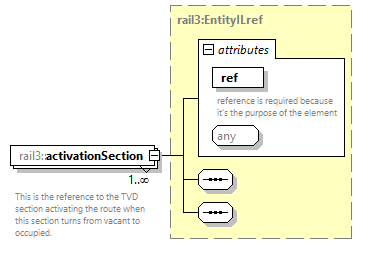 | ||||||||||||||
| namespace | https://www.railml.org/schemas/3.2 | ||||||||||||||
| type | rail3:EntityILref | ||||||||||||||
| properties |
| ||||||||||||||
| attributes |
| ||||||||||||||
| annotation |
| ||||||||||||||
| source | <xs:element name="activationSection" type="rail3:EntityILref" minOccurs="1" maxOccurs="unbounded"> <xs:annotation> <xs:documentation>This is the reference to the TVD section activating the route when this section turns from vacant to occupied.</xs:documentation> </xs:annotation> </xs:element> |
complexType RouteEntry
| diagram | 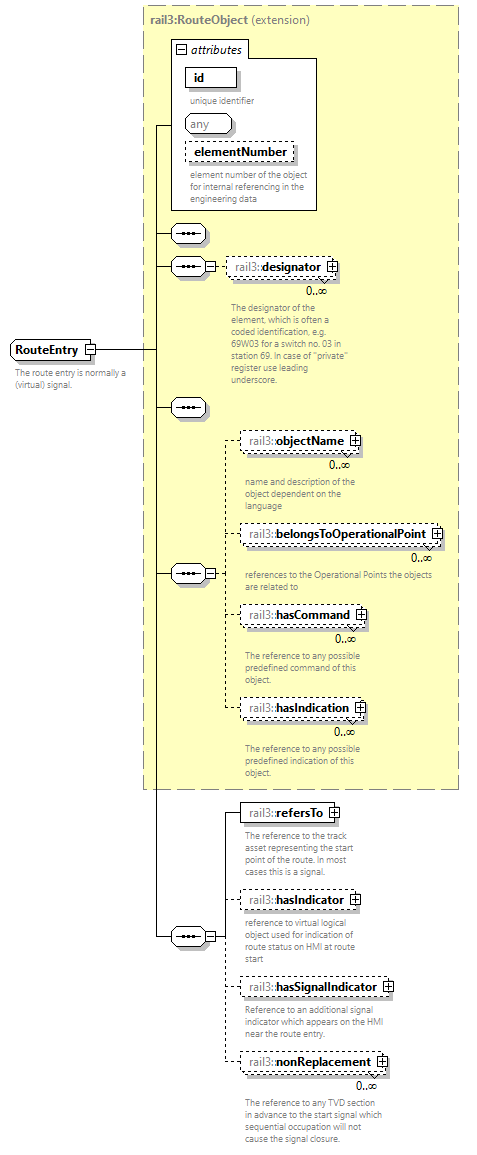 | ||||||||||||||||||||||
| namespace | https://www.railml.org/schemas/3.2 | ||||||||||||||||||||||
| type | extension of rail3:RouteObject | ||||||||||||||||||||||
| properties |
| ||||||||||||||||||||||
| children | rail3:designator rail3:objectName rail3:belongsToOperationalPoint rail3:hasCommand rail3:hasIndication rail3:refersTo rail3:hasIndicator rail3:hasSignalIndicator rail3:nonReplacement | ||||||||||||||||||||||
| used by |
| ||||||||||||||||||||||
| attributes |
| ||||||||||||||||||||||
| annotation |
| ||||||||||||||||||||||
| source | <xs:complexType name="RouteEntry"> <xs:annotation> <xs:documentation>The route entry is normally a (virtual) signal.</xs:documentation> </xs:annotation> <xs:complexContent> <xs:extension base="rail3:RouteObject"> <xs:sequence> <xs:element name="refersTo" type="rail3:EntityILref" minOccurs="1" maxOccurs="1"> <xs:annotation> <xs:documentation>The reference to the track asset representing the start point of the route. In most cases this is a signal.</xs:documentation> </xs:annotation> </xs:element> <xs:element name="hasIndicator" type="rail3:EntityILref" minOccurs="0" maxOccurs="1"> <xs:annotation> <xs:documentation>reference to virtual logical object used for indication of route status on HMI at route start</xs:documentation> </xs:annotation> </xs:element> <xs:element name="hasSignalIndicator" type="rail3:EntityILref" minOccurs="0" maxOccurs="1"> <xs:annotation> <xs:documentation>Reference to an additional signal indicator which appears on the HMI near the route entry.</xs:documentation> </xs:annotation> </xs:element> <xs:element name="nonReplacement" type="rail3:EntityILref" minOccurs="0" maxOccurs="unbounded"> <xs:annotation> <xs:documentation>The reference to any TVD section in advance to the start signal which sequential occupation will not cause the signal closure.</xs:documentation> </xs:annotation> </xs:element> </xs:sequence> </xs:extension> </xs:complexContent> </xs:complexType> |
element RouteEntry/refersTo
| diagram | 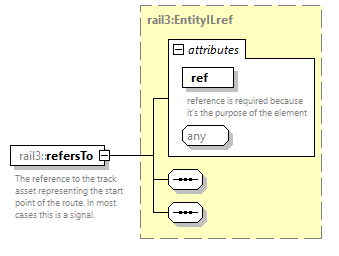 | ||||||||||||||
| namespace | https://www.railml.org/schemas/3.2 | ||||||||||||||
| type | rail3:EntityILref | ||||||||||||||
| properties |
| ||||||||||||||
| attributes |
| ||||||||||||||
| annotation |
| ||||||||||||||
| source | <xs:element name="refersTo" type="rail3:EntityILref" minOccurs="1" maxOccurs="1"> <xs:annotation> <xs:documentation>The reference to the track asset representing the start point of the route. In most cases this is a signal.</xs:documentation> </xs:annotation> </xs:element> |
element RouteEntry/hasIndicator
| diagram | 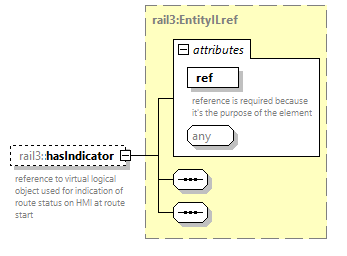 | ||||||||||||||
| namespace | https://www.railml.org/schemas/3.2 | ||||||||||||||
| type | rail3:EntityILref | ||||||||||||||
| properties |
| ||||||||||||||
| attributes |
| ||||||||||||||
| annotation |
| ||||||||||||||
| source | <xs:element name="hasIndicator" type="rail3:EntityILref" minOccurs="0" maxOccurs="1"> <xs:annotation> <xs:documentation>reference to virtual logical object used for indication of route status on HMI at route start</xs:documentation> </xs:annotation> </xs:element> |
element RouteEntry/hasSignalIndicator
| diagram | 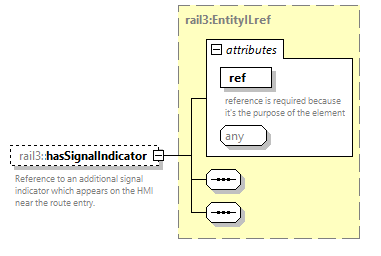 | ||||||||||||||
| namespace | https://www.railml.org/schemas/3.2 | ||||||||||||||
| type | rail3:EntityILref | ||||||||||||||
| properties |
| ||||||||||||||
| attributes |
| ||||||||||||||
| annotation |
| ||||||||||||||
| source | <xs:element name="hasSignalIndicator" type="rail3:EntityILref" minOccurs="0" maxOccurs="1"> <xs:annotation> <xs:documentation>Reference to an additional signal indicator which appears on the HMI near the route entry.</xs:documentation> </xs:annotation> </xs:element> |
element RouteEntry/nonReplacement
| diagram | 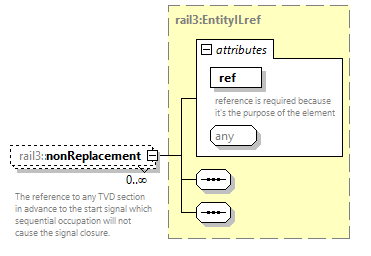 | ||||||||||||||
| namespace | https://www.railml.org/schemas/3.2 | ||||||||||||||
| type | rail3:EntityILref | ||||||||||||||
| properties |
| ||||||||||||||
| attributes |
| ||||||||||||||
| annotation |
| ||||||||||||||
| source | <xs:element name="nonReplacement" type="rail3:EntityILref" minOccurs="0" maxOccurs="unbounded"> <xs:annotation> <xs:documentation>The reference to any TVD section in advance to the start signal which sequential occupation will not cause the signal closure.</xs:documentation> </xs:annotation> </xs:element> |
complexType RouteExit
| diagram | 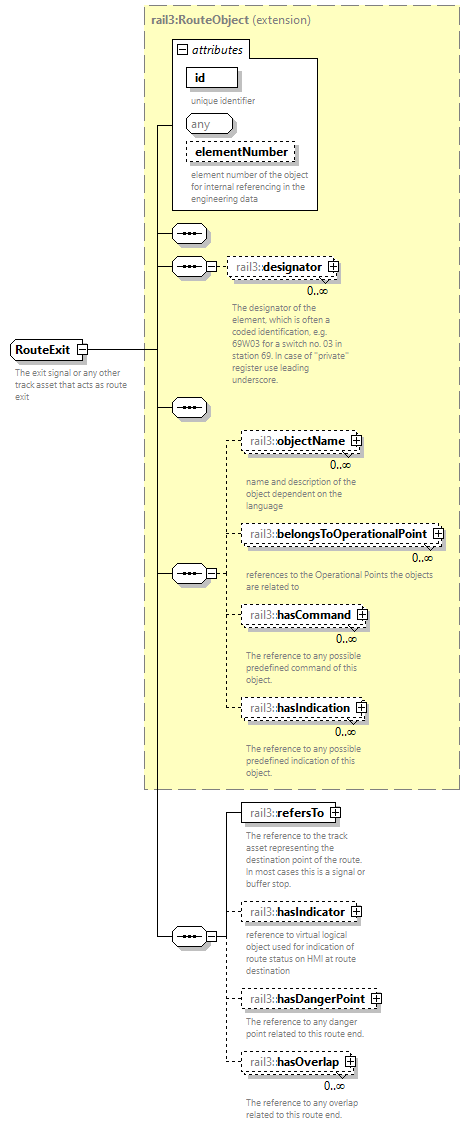 | ||||||||||||||||||||||
| namespace | https://www.railml.org/schemas/3.2 | ||||||||||||||||||||||
| type | extension of rail3:RouteObject | ||||||||||||||||||||||
| properties |
| ||||||||||||||||||||||
| children | rail3:designator rail3:objectName rail3:belongsToOperationalPoint rail3:hasCommand rail3:hasIndication rail3:refersTo rail3:hasIndicator rail3:hasDangerPoint rail3:hasOverlap | ||||||||||||||||||||||
| used by |
| ||||||||||||||||||||||
| attributes |
| ||||||||||||||||||||||
| annotation |
| ||||||||||||||||||||||
| source | <xs:complexType name="RouteExit"> <xs:annotation> <xs:documentation>The exit signal or any other track asset that acts as route exit</xs:documentation> </xs:annotation> <xs:complexContent> <xs:extension base="rail3:RouteObject"> <xs:sequence> <xs:element name="refersTo" type="rail3:EntityILref" minOccurs="1" maxOccurs="1"> <xs:annotation> <xs:documentation>The reference to the track asset representing the destination point of the route. In most cases this is a signal or buffer stop.</xs:documentation> </xs:annotation> </xs:element> <xs:element name="hasIndicator" type="rail3:EntityILref" minOccurs="0" maxOccurs="1"> <xs:annotation> <xs:documentation>reference to virtual logical object used for indication of route status on HMI at route destination</xs:documentation> </xs:annotation> </xs:element> <xs:element name="hasDangerPoint" type="rail3:EntityILref" minOccurs="0" maxOccurs="1"> <xs:annotation> <xs:documentation>The reference to any danger point related to this route end.</xs:documentation> </xs:annotation> </xs:element> <xs:element name="hasOverlap" type="rail3:EntityILref" minOccurs="0" maxOccurs="unbounded"> <xs:annotation> <xs:documentation>The reference to any overlap related to this route end.</xs:documentation> </xs:annotation> </xs:element> </xs:sequence> </xs:extension> </xs:complexContent> </xs:complexType> |
element RouteExit/refersTo
| diagram | 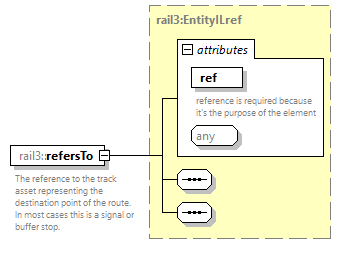 | ||||||||||||||
| namespace | https://www.railml.org/schemas/3.2 | ||||||||||||||
| type | rail3:EntityILref | ||||||||||||||
| properties |
| ||||||||||||||
| attributes |
| ||||||||||||||
| annotation |
| ||||||||||||||
| source | <xs:element name="refersTo" type="rail3:EntityILref" minOccurs="1" maxOccurs="1"> <xs:annotation> <xs:documentation>The reference to the track asset representing the destination point of the route. In most cases this is a signal or buffer stop.</xs:documentation> </xs:annotation> </xs:element> |
element RouteExit/hasIndicator
| diagram | 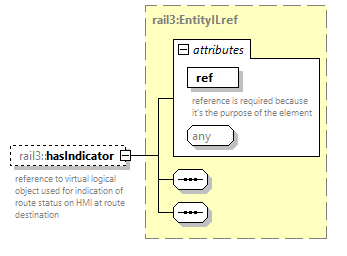 | ||||||||||||||
| namespace | https://www.railml.org/schemas/3.2 | ||||||||||||||
| type | rail3:EntityILref | ||||||||||||||
| properties |
| ||||||||||||||
| attributes |
| ||||||||||||||
| annotation |
| ||||||||||||||
| source | <xs:element name="hasIndicator" type="rail3:EntityILref" minOccurs="0" maxOccurs="1"> <xs:annotation> <xs:documentation>reference to virtual logical object used for indication of route status on HMI at route destination</xs:documentation> </xs:annotation> </xs:element> |
element RouteExit/hasDangerPoint
| diagram | 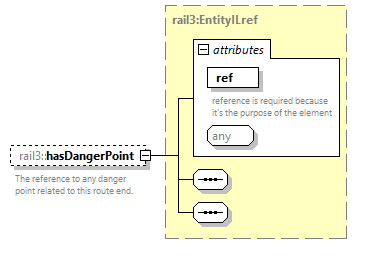 | ||||||||||||||
| namespace | https://www.railml.org/schemas/3.2 | ||||||||||||||
| type | rail3:EntityILref | ||||||||||||||
| properties |
| ||||||||||||||
| attributes |
| ||||||||||||||
| annotation |
| ||||||||||||||
| source | <xs:element name="hasDangerPoint" type="rail3:EntityILref" minOccurs="0" maxOccurs="1"> <xs:annotation> <xs:documentation>The reference to any danger point related to this route end.</xs:documentation> </xs:annotation> </xs:element> |
element RouteExit/hasOverlap
| diagram | 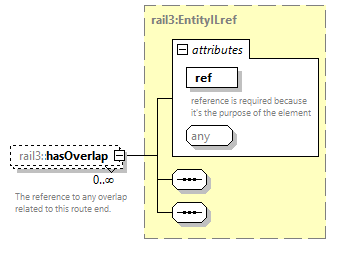 | ||||||||||||||
| namespace | https://www.railml.org/schemas/3.2 | ||||||||||||||
| type | rail3:EntityILref | ||||||||||||||
| properties |
| ||||||||||||||
| attributes |
| ||||||||||||||
| annotation |
| ||||||||||||||
| source | <xs:element name="hasOverlap" type="rail3:EntityILref" minOccurs="0" maxOccurs="unbounded"> <xs:annotation> <xs:documentation>The reference to any overlap related to this route end.</xs:documentation> </xs:annotation> </xs:element> |
complexType RouteObject
| diagram | 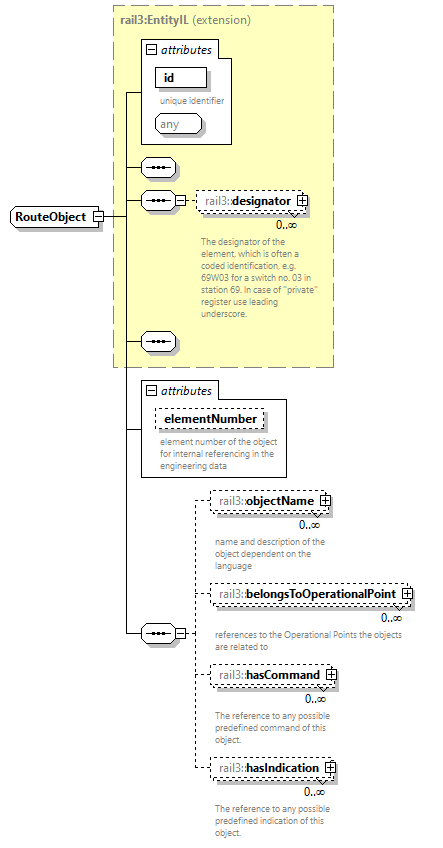 | ||||||||||||||||||||||
| namespace | https://www.railml.org/schemas/3.2 | ||||||||||||||||||||||
| type | extension of rail3:EntityIL | ||||||||||||||||||||||
| properties |
| ||||||||||||||||||||||
| children | rail3:designator rail3:objectName rail3:belongsToOperationalPoint rail3:hasCommand rail3:hasIndication | ||||||||||||||||||||||
| used by |
| ||||||||||||||||||||||
| attributes |
| ||||||||||||||||||||||
| source | <xs:complexType name="RouteObject"> <xs:complexContent> <xs:extension base="rail3:EntityIL"> <xs:sequence> <xs:element name="objectName" type="rail3:Name" minOccurs="0" maxOccurs="unbounded"> <xs:annotation> <xs:documentation>name and description of the object dependent on the language</xs:documentation> </xs:annotation> </xs:element> <xs:element name="belongsToOperationalPoint" type="rail3:EntityILref" minOccurs="0" maxOccurs="unbounded"> <xs:annotation> <xs:documentation>references to the Operational Points the objects are related to</xs:documentation> </xs:annotation> </xs:element> <xs:element name="hasCommand" type="rail3:CodedEntityILref" minOccurs="0" maxOccurs="unbounded"> <xs:annotation> <xs:documentation>The reference to any possible predefined command of this object.</xs:documentation> </xs:annotation> </xs:element> <xs:element name="hasIndication" type="rail3:CodedEntityILref" minOccurs="0" maxOccurs="unbounded"> <xs:annotation> <xs:documentation>The reference to any possible predefined indication of this object.</xs:documentation> </xs:annotation> </xs:element> </xs:sequence> <xs:attribute name="elementNumber" type="xs:nonNegativeInteger" use="optional"> <xs:annotation> <xs:documentation>element number of the object for internal referencing in the engineering data</xs:documentation> </xs:annotation> </xs:attribute> </xs:extension> </xs:complexContent> </xs:complexType> |
attribute RouteObject/@elementNumber
| type | xs:nonNegativeInteger | ||
| properties |
| ||
| annotation |
| ||
| source | <xs:attribute name="elementNumber" type="xs:nonNegativeInteger" use="optional"> <xs:annotation> <xs:documentation>element number of the object for internal referencing in the engineering data</xs:documentation> </xs:annotation> </xs:attribute> |
element RouteObject/objectName
| diagram | 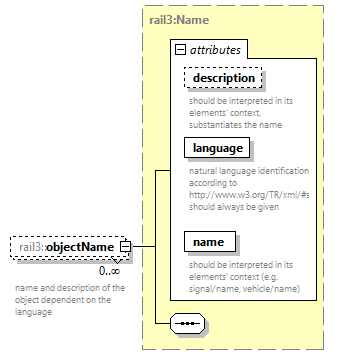 | ||||||||||||||||||||||||||||||
| namespace | https://www.railml.org/schemas/3.2 | ||||||||||||||||||||||||||||||
| type | rail3:Name | ||||||||||||||||||||||||||||||
| properties |
| ||||||||||||||||||||||||||||||
| attributes |
| ||||||||||||||||||||||||||||||
| annotation |
| ||||||||||||||||||||||||||||||
| source | <xs:element name="objectName" type="rail3:Name" minOccurs="0" maxOccurs="unbounded"> <xs:annotation> <xs:documentation>name and description of the object dependent on the language</xs:documentation> </xs:annotation> </xs:element> |
element RouteObject/belongsToOperationalPoint
| diagram | 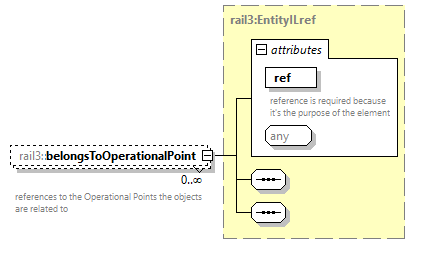 | ||||||||||||||
| namespace | https://www.railml.org/schemas/3.2 | ||||||||||||||
| type | rail3:EntityILref | ||||||||||||||
| properties |
| ||||||||||||||
| attributes |
| ||||||||||||||
| annotation |
| ||||||||||||||
| source | <xs:element name="belongsToOperationalPoint" type="rail3:EntityILref" minOccurs="0" maxOccurs="unbounded"> <xs:annotation> <xs:documentation>references to the Operational Points the objects are related to</xs:documentation> </xs:annotation> </xs:element> |
element RouteObject/hasCommand
| diagram | 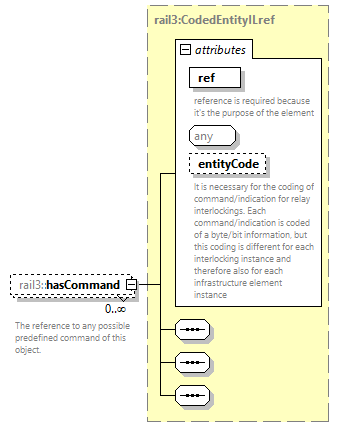 | ||||||||||||||||||||||
| namespace | https://www.railml.org/schemas/3.2 | ||||||||||||||||||||||
| type | rail3:CodedEntityILref | ||||||||||||||||||||||
| properties |
| ||||||||||||||||||||||
| attributes |
| ||||||||||||||||||||||
| annotation |
| ||||||||||||||||||||||
| source | <xs:element name="hasCommand" type="rail3:CodedEntityILref" minOccurs="0" maxOccurs="unbounded"> <xs:annotation> <xs:documentation>The reference to any possible predefined command of this object.</xs:documentation> </xs:annotation> </xs:element> |
element RouteObject/hasIndication
| diagram | 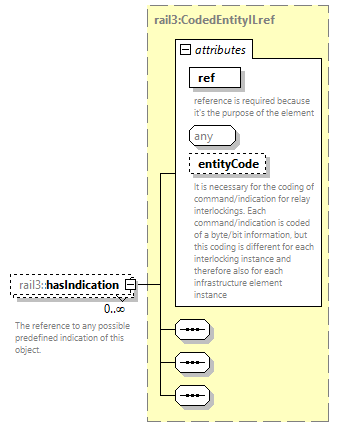 | ||||||||||||||||||||||
| namespace | https://www.railml.org/schemas/3.2 | ||||||||||||||||||||||
| type | rail3:CodedEntityILref | ||||||||||||||||||||||
| properties |
| ||||||||||||||||||||||
| attributes |
| ||||||||||||||||||||||
| annotation |
| ||||||||||||||||||||||
| source | <xs:element name="hasIndication" type="rail3:CodedEntityILref" minOccurs="0" maxOccurs="unbounded"> <xs:annotation> <xs:documentation>The reference to any possible predefined indication of this object.</xs:documentation> </xs:annotation> </xs:element> |
complexType RouteRelation
| diagram |  | ||||||||||||||||||||||
| namespace | https://www.railml.org/schemas/3.2 | ||||||||||||||||||||||
| type | extension of rail3:RouteObject | ||||||||||||||||||||||
| properties |
| ||||||||||||||||||||||
| children | rail3:designator rail3:objectName rail3:belongsToOperationalPoint rail3:hasCommand rail3:hasIndication rail3:requiredSwitchPosition rail3:requiredDerailerPosition rail3:requiredCrossingPosition rail3:requiredDetectorState rail3:requiredSignalAspect rail3:requiredSectionState rail3:requiredKeyLockState rail3:requiredLevelCrossingState rail3:requiredTunnelGateState | ||||||||||||||||||||||
| used by |
| ||||||||||||||||||||||
| attributes |
| ||||||||||||||||||||||
| annotation |
| ||||||||||||||||||||||
| source | <xs:complexType name="RouteRelation"> <xs:annotation> <xs:documentation>A route relation states the conditions that must be fulfilled for a given signal to be open. Note that these relations may well be captured in a control table. Therefore, the use is optional.</xs:documentation> </xs:annotation> <xs:complexContent> <xs:extension base="rail3:RouteObject"> <xs:sequence> <xs:element name="requiredSwitchPosition" type="rail3:SwitchAndGivenPosition" minOccurs="0" maxOccurs="unbounded"> <xs:annotation> <xs:documentation>References to a particular switch and its required position to fulfil the route relation</xs:documentation> </xs:annotation> </xs:element> <xs:element name="requiredDerailerPosition" type="rail3:DerailerAndGivenPosition" minOccurs="0" maxOccurs="unbounded"> <xs:annotation> <xs:documentation>References to a particular derailer and its required position to fulfil the route relation</xs:documentation> </xs:annotation> </xs:element> <xs:element name="requiredCrossingPosition" type="rail3:CrossingAndGivenPosition" minOccurs="0" maxOccurs="unbounded"> <xs:annotation> <xs:documentation>References to a particular movable crossing and its required position to fulfil the route relation</xs:documentation> </xs:annotation> </xs:element> <xs:element name="requiredDetectorState" type="rail3:DetectorAndGivenState" minOccurs="0" maxOccurs="unbounded"> <xs:annotation> <xs:documentation>References to a particular detector and its required state to fulfil the route relation</xs:documentation> </xs:annotation> </xs:element> <xs:element name="requiredSignalAspect" type="rail3:SignalAndGivenAspect" minOccurs="0" maxOccurs="unbounded"> <xs:annotation> <xs:documentation>References to a particular signal and its required aspect to fulfil the route relation</xs:documentation> </xs:annotation> </xs:element> <xs:element name="requiredSectionState" type="rail3:SectionAndGivenVacancy" minOccurs="0" maxOccurs="unbounded"> <xs:annotation> <xs:documentation>References to a particular TVD section and its required state to fulfil the route relation</xs:documentation> </xs:annotation> </xs:element> <xs:element name="requiredKeyLockState" type="rail3:LockAndGivenState" minOccurs="0" maxOccurs="unbounded"> <xs:annotation> <xs:documentation>References to a particular key lock or bascule bridge and its required state to fulfil the route relation</xs:documentation> </xs:annotation> </xs:element> <xs:element name="requiredLevelCrossingState" type="rail3:LevelCrossingAndGivenState" minOccurs="0" maxOccurs="unbounded"> <xs:annotation> <xs:documentation>References to a particular level crossing and its required state to fulfil the route relation</xs:documentation> </xs:annotation> </xs:element> <xs:element name="requiredTunnelGateState" type="rail3:TunnelGateAndGivenState" minOccurs="0" maxOccurs="unbounded"> <xs:annotation> <xs:documentation>References to a particular tunnel gate and its required state to fulfil the route relation</xs:documentation> </xs:annotation> </xs:element> </xs:sequence> </xs:extension> </xs:complexContent> </xs:complexType> |
element RouteRelation/requiredSwitchPosition
| diagram | 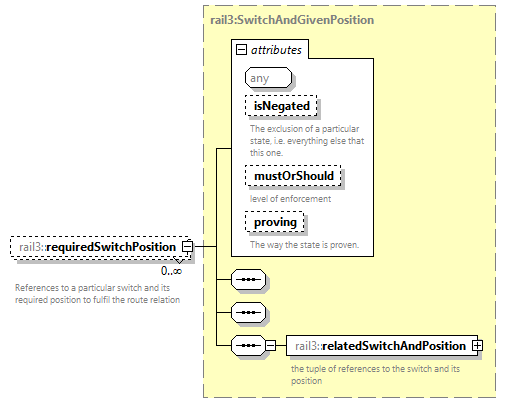 | ||||||||||||||||||||||||||||||
| namespace | https://www.railml.org/schemas/3.2 | ||||||||||||||||||||||||||||||
| type | rail3:SwitchAndGivenPosition | ||||||||||||||||||||||||||||||
| properties |
| ||||||||||||||||||||||||||||||
| children | rail3:relatedSwitchAndPosition | ||||||||||||||||||||||||||||||
| attributes |
| ||||||||||||||||||||||||||||||
| annotation |
| ||||||||||||||||||||||||||||||
| source | <xs:element name="requiredSwitchPosition" type="rail3:SwitchAndGivenPosition" minOccurs="0" maxOccurs="unbounded"> <xs:annotation> <xs:documentation>References to a particular switch and its required position to fulfil the route relation</xs:documentation> </xs:annotation> </xs:element> |
element RouteRelation/requiredDerailerPosition
| diagram | 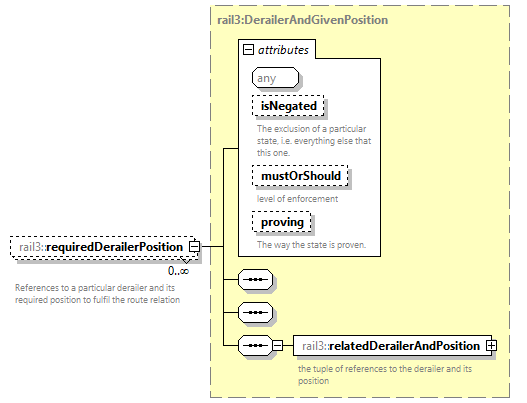 | ||||||||||||||||||||||||||||||
| namespace | https://www.railml.org/schemas/3.2 | ||||||||||||||||||||||||||||||
| type | rail3:DerailerAndGivenPosition | ||||||||||||||||||||||||||||||
| properties |
| ||||||||||||||||||||||||||||||
| children | rail3:relatedDerailerAndPosition | ||||||||||||||||||||||||||||||
| attributes |
| ||||||||||||||||||||||||||||||
| annotation |
| ||||||||||||||||||||||||||||||
| source | <xs:element name="requiredDerailerPosition" type="rail3:DerailerAndGivenPosition" minOccurs="0" maxOccurs="unbounded"> <xs:annotation> <xs:documentation>References to a particular derailer and its required position to fulfil the route relation</xs:documentation> </xs:annotation> </xs:element> |
element RouteRelation/requiredCrossingPosition
| diagram | 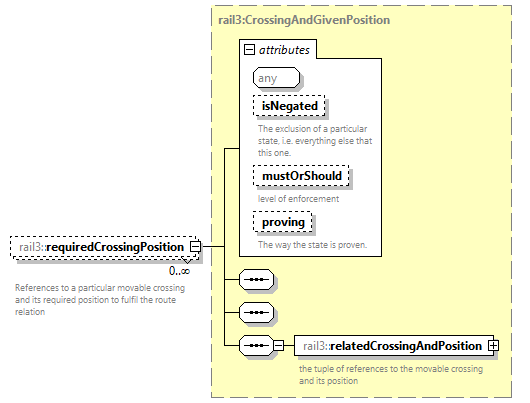 | ||||||||||||||||||||||||||||||
| namespace | https://www.railml.org/schemas/3.2 | ||||||||||||||||||||||||||||||
| type | rail3:CrossingAndGivenPosition | ||||||||||||||||||||||||||||||
| properties |
| ||||||||||||||||||||||||||||||
| children | rail3:relatedCrossingAndPosition | ||||||||||||||||||||||||||||||
| attributes |
| ||||||||||||||||||||||||||||||
| annotation |
| ||||||||||||||||||||||||||||||
| source | <xs:element name="requiredCrossingPosition" type="rail3:CrossingAndGivenPosition" minOccurs="0" maxOccurs="unbounded"> <xs:annotation> <xs:documentation>References to a particular movable crossing and its required position to fulfil the route relation</xs:documentation> </xs:annotation> </xs:element> |
element RouteRelation/requiredDetectorState
| diagram | 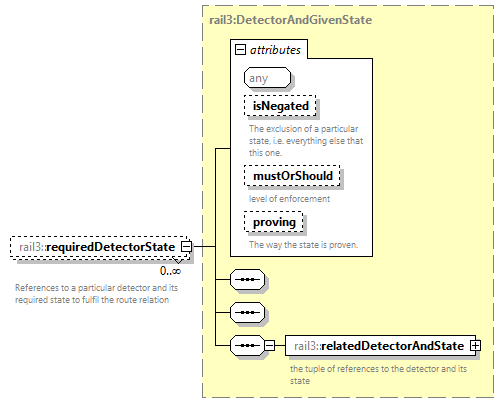 | ||||||||||||||||||||||||||||||
| namespace | https://www.railml.org/schemas/3.2 | ||||||||||||||||||||||||||||||
| type | rail3:DetectorAndGivenState | ||||||||||||||||||||||||||||||
| properties |
| ||||||||||||||||||||||||||||||
| children | rail3:relatedDetectorAndState | ||||||||||||||||||||||||||||||
| attributes |
| ||||||||||||||||||||||||||||||
| annotation |
| ||||||||||||||||||||||||||||||
| source | <xs:element name="requiredDetectorState" type="rail3:DetectorAndGivenState" minOccurs="0" maxOccurs="unbounded"> <xs:annotation> <xs:documentation>References to a particular detector and its required state to fulfil the route relation</xs:documentation> </xs:annotation> </xs:element> |
element RouteRelation/requiredSignalAspect
| diagram | 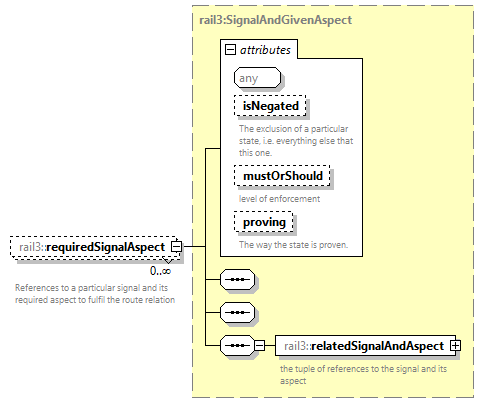 | ||||||||||||||||||||||||||||||
| namespace | https://www.railml.org/schemas/3.2 | ||||||||||||||||||||||||||||||
| type | rail3:SignalAndGivenAspect | ||||||||||||||||||||||||||||||
| properties |
| ||||||||||||||||||||||||||||||
| children | rail3:relatedSignalAndAspect | ||||||||||||||||||||||||||||||
| attributes |
| ||||||||||||||||||||||||||||||
| annotation |
| ||||||||||||||||||||||||||||||
| source | <xs:element name="requiredSignalAspect" type="rail3:SignalAndGivenAspect" minOccurs="0" maxOccurs="unbounded"> <xs:annotation> <xs:documentation>References to a particular signal and its required aspect to fulfil the route relation</xs:documentation> </xs:annotation> </xs:element> |
element RouteRelation/requiredSectionState
| diagram | 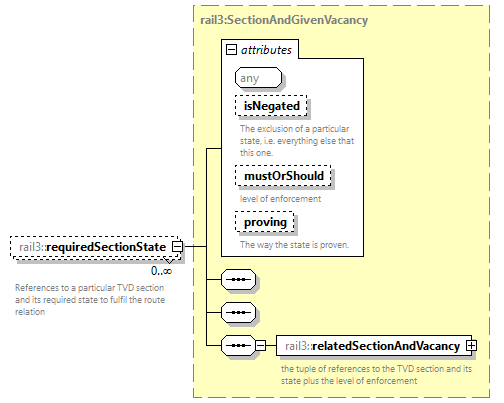 | ||||||||||||||||||||||||||||||
| namespace | https://www.railml.org/schemas/3.2 | ||||||||||||||||||||||||||||||
| type | rail3:SectionAndGivenVacancy | ||||||||||||||||||||||||||||||
| properties |
| ||||||||||||||||||||||||||||||
| children | rail3:relatedSectionAndVacancy | ||||||||||||||||||||||||||||||
| attributes |
| ||||||||||||||||||||||||||||||
| annotation |
| ||||||||||||||||||||||||||||||
| source | <xs:element name="requiredSectionState" type="rail3:SectionAndGivenVacancy" minOccurs="0" maxOccurs="unbounded"> <xs:annotation> <xs:documentation>References to a particular TVD section and its required state to fulfil the route relation</xs:documentation> </xs:annotation> </xs:element> |
element RouteRelation/requiredKeyLockState
| diagram | 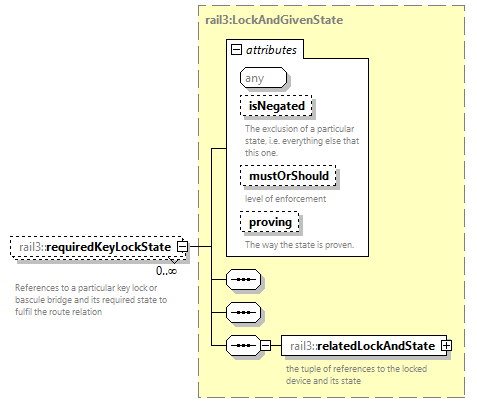 | ||||||||||||||||||||||||||||||
| namespace | https://www.railml.org/schemas/3.2 | ||||||||||||||||||||||||||||||
| type | rail3:LockAndGivenState | ||||||||||||||||||||||||||||||
| properties |
| ||||||||||||||||||||||||||||||
| children | rail3:relatedLockAndState | ||||||||||||||||||||||||||||||
| attributes |
| ||||||||||||||||||||||||||||||
| annotation |
| ||||||||||||||||||||||||||||||
| source | <xs:element name="requiredKeyLockState" type="rail3:LockAndGivenState" minOccurs="0" maxOccurs="unbounded"> <xs:annotation> <xs:documentation>References to a particular key lock or bascule bridge and its required state to fulfil the route relation</xs:documentation> </xs:annotation> </xs:element> |
element RouteRelation/requiredLevelCrossingState
| diagram | 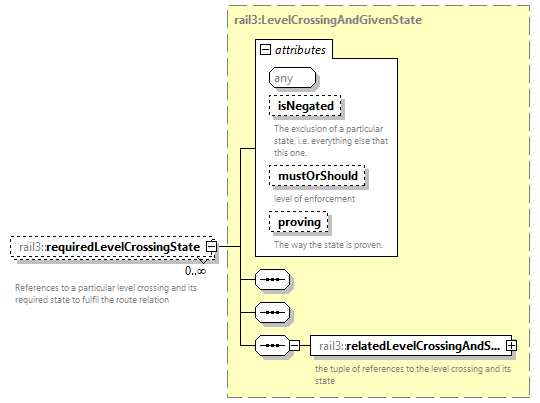 | ||||||||||||||||||||||||||||||
| namespace | https://www.railml.org/schemas/3.2 | ||||||||||||||||||||||||||||||
| type | rail3:LevelCrossingAndGivenState | ||||||||||||||||||||||||||||||
| properties |
| ||||||||||||||||||||||||||||||
| children | rail3:relatedLevelCrossingAndState | ||||||||||||||||||||||||||||||
| attributes |
| ||||||||||||||||||||||||||||||
| annotation |
| ||||||||||||||||||||||||||||||
| source | <xs:element name="requiredLevelCrossingState" type="rail3:LevelCrossingAndGivenState" minOccurs="0" maxOccurs="unbounded"> <xs:annotation> <xs:documentation>References to a particular level crossing and its required state to fulfil the route relation</xs:documentation> </xs:annotation> </xs:element> |
element RouteRelation/requiredTunnelGateState
| diagram | 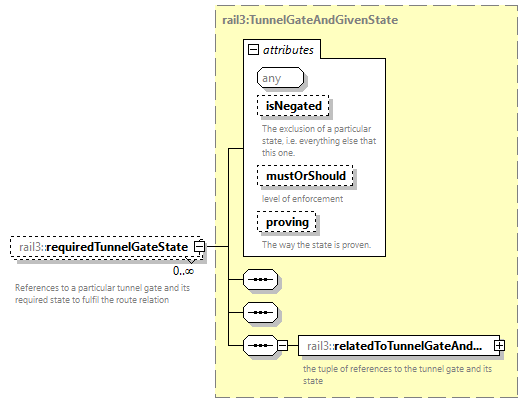 | ||||||||||||||||||||||||||||||
| namespace | https://www.railml.org/schemas/3.2 | ||||||||||||||||||||||||||||||
| type | rail3:TunnelGateAndGivenState | ||||||||||||||||||||||||||||||
| properties |
| ||||||||||||||||||||||||||||||
| children | rail3:relatedToTunnelGateAndState | ||||||||||||||||||||||||||||||
| attributes |
| ||||||||||||||||||||||||||||||
| annotation |
| ||||||||||||||||||||||||||||||
| source | <xs:element name="requiredTunnelGateState" type="rail3:TunnelGateAndGivenState" minOccurs="0" maxOccurs="unbounded"> <xs:annotation> <xs:documentation>References to a particular tunnel gate and its required state to fulfil the route relation</xs:documentation> </xs:annotation> </xs:element> |
complexType RouteRelations
| diagram |  | ||
| namespace | https://www.railml.org/schemas/3.2 | ||
| children | rail3:routeRelation | ||
| used by |
| ||
| annotation |
| ||
| source | <xs:complexType name="RouteRelations"> <xs:annotation> <xs:documentation>container element for all RouteRelation elements</xs:documentation> </xs:annotation> <xs:sequence minOccurs="0" maxOccurs="1"> <xs:element name="routeRelation" type="rail3:RouteRelation" minOccurs="1" maxOccurs="unbounded"> <xs:annotation> <xs:documentation>states the conditions that must be fulfilled for a given signal to be open</xs:documentation> </xs:annotation> </xs:element> </xs:sequence> </xs:complexType> |
element RouteRelations/routeRelation
| diagram |  | ||||||||||||||||||||||
| namespace | https://www.railml.org/schemas/3.2 | ||||||||||||||||||||||
| type | rail3:RouteRelation | ||||||||||||||||||||||
| properties |
| ||||||||||||||||||||||
| children | rail3:designator rail3:objectName rail3:belongsToOperationalPoint rail3:hasCommand rail3:hasIndication rail3:requiredSwitchPosition rail3:requiredDerailerPosition rail3:requiredCrossingPosition rail3:requiredDetectorState rail3:requiredSignalAspect rail3:requiredSectionState rail3:requiredKeyLockState rail3:requiredLevelCrossingState rail3:requiredTunnelGateState | ||||||||||||||||||||||
| attributes |
| ||||||||||||||||||||||
| annotation |
| ||||||||||||||||||||||
| source | <xs:element name="routeRelation" type="rail3:RouteRelation" minOccurs="1" maxOccurs="unbounded"> <xs:annotation> <xs:documentation>states the conditions that must be fulfilled for a given signal to be open</xs:documentation> </xs:annotation> </xs:element> |
complexType RouteReleaseGroupAhead
| diagram | 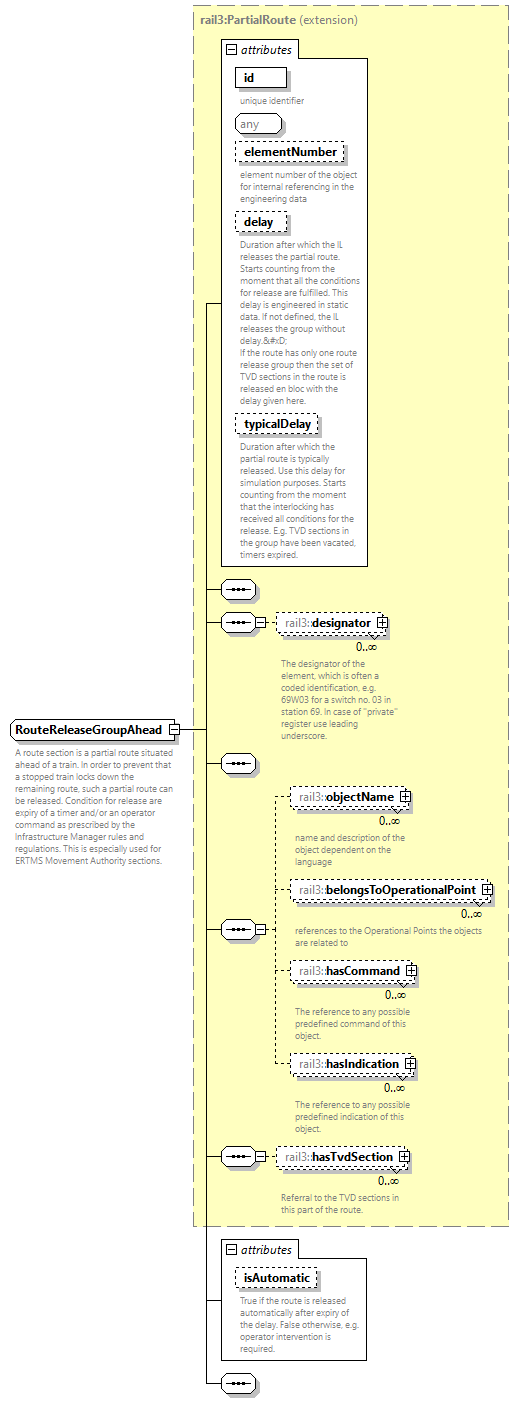 | ||||||||||||||||||||||||||||||||||||||||||||||
| namespace | https://www.railml.org/schemas/3.2 | ||||||||||||||||||||||||||||||||||||||||||||||
| type | extension of rail3:PartialRoute | ||||||||||||||||||||||||||||||||||||||||||||||
| properties |
| ||||||||||||||||||||||||||||||||||||||||||||||
| children | rail3:designator rail3:objectName rail3:belongsToOperationalPoint rail3:hasCommand rail3:hasIndication rail3:hasTvdSection | ||||||||||||||||||||||||||||||||||||||||||||||
| used by |
| ||||||||||||||||||||||||||||||||||||||||||||||
| attributes |
| ||||||||||||||||||||||||||||||||||||||||||||||
| annotation |
| ||||||||||||||||||||||||||||||||||||||||||||||
| source | <xs:complexType name="RouteReleaseGroupAhead"> <xs:annotation> <xs:documentation>A route section is a partial route situated ahead of a train. In order to prevent that a stopped train locks down the remaining route, such a partial route can be released. Condition for release are expiry of a timer and/or an operator command as prescribed by the Infrastructure Manager rules and regulations. This is especially used for ERTMS Movement Authority sections.</xs:documentation> </xs:annotation> <xs:complexContent> <xs:extension base="rail3:PartialRoute"> <xs:sequence/> <xs:attribute name="isAutomatic" type="xs:boolean" use="optional"> <xs:annotation> <xs:documentation>True if the route is released automatically after expiry of the delay. False otherwise, e.g. operator intervention is required.</xs:documentation> </xs:annotation> </xs:attribute> </xs:extension> </xs:complexContent> </xs:complexType> |
attribute RouteReleaseGroupAhead/@isAutomatic
| type | xs:boolean | ||
| properties |
| ||
| annotation |
| ||
| source | <xs:attribute name="isAutomatic" type="xs:boolean" use="optional"> <xs:annotation> <xs:documentation>True if the route is released automatically after expiry of the delay. False otherwise, e.g. operator intervention is required.</xs:documentation> </xs:annotation> </xs:attribute> |
complexType RouteReleaseGroupRear
| diagram | 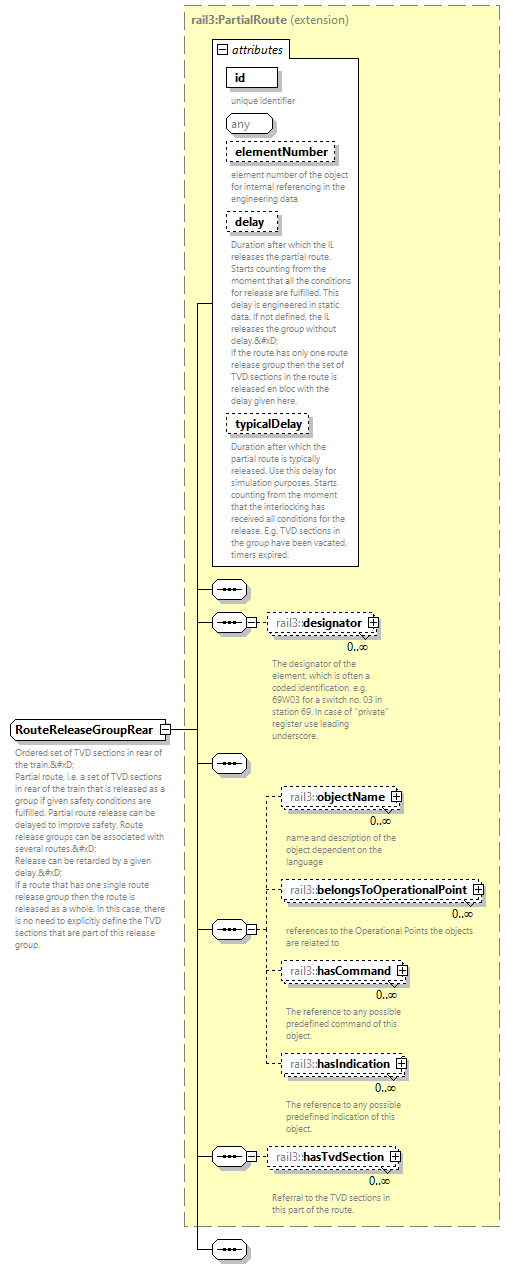 | ||||||||||||||||||||||||||||||||||||||
| namespace | https://www.railml.org/schemas/3.2 | ||||||||||||||||||||||||||||||||||||||
| type | extension of rail3:PartialRoute | ||||||||||||||||||||||||||||||||||||||
| properties |
| ||||||||||||||||||||||||||||||||||||||
| children | rail3:designator rail3:objectName rail3:belongsToOperationalPoint rail3:hasCommand rail3:hasIndication rail3:hasTvdSection | ||||||||||||||||||||||||||||||||||||||
| used by |
| ||||||||||||||||||||||||||||||||||||||
| attributes |
| ||||||||||||||||||||||||||||||||||||||
| annotation |
| ||||||||||||||||||||||||||||||||||||||
| source | <xs:complexType name="RouteReleaseGroupRear"> <xs:annotation> <xs:documentation>Ordered set of TVD sections in rear of the train.
 Partial route, i.e. a set of TVD sections in rear of the train that is released as a group if given safety conditions are fulfilled. Partial route release can be delayed to improve safety. Route release groups can be associated with several routes.
 Release can be retarded by a given delay.
 If a route that has one single route release group then the route is released as a whole. In this case, there is no need to explicitly define the TVD sections that are part of this release group.</xs:documentation> </xs:annotation> <xs:complexContent> <xs:extension base="rail3:PartialRoute"> <xs:sequence/> </xs:extension> </xs:complexContent> </xs:complexType> |
complexType RouteReleaseGroupsAhead
| diagram |  | ||
| namespace | https://www.railml.org/schemas/3.2 | ||
| children | rail3:routeReleaseGroupAhead | ||
| used by |
| ||
| source | <xs:complexType name="RouteReleaseGroupsAhead"> <xs:sequence> <xs:element name="routeReleaseGroupAhead" type="rail3:RouteReleaseGroupAhead" minOccurs="1" maxOccurs="unbounded"> <xs:annotation> <xs:documentation>One or more TVD sections as part of the route which can be released in a group ahead of the train in standstill.</xs:documentation> </xs:annotation> </xs:element> </xs:sequence> </xs:complexType> |
element RouteReleaseGroupsAhead/routeReleaseGroupAhead
| diagram | 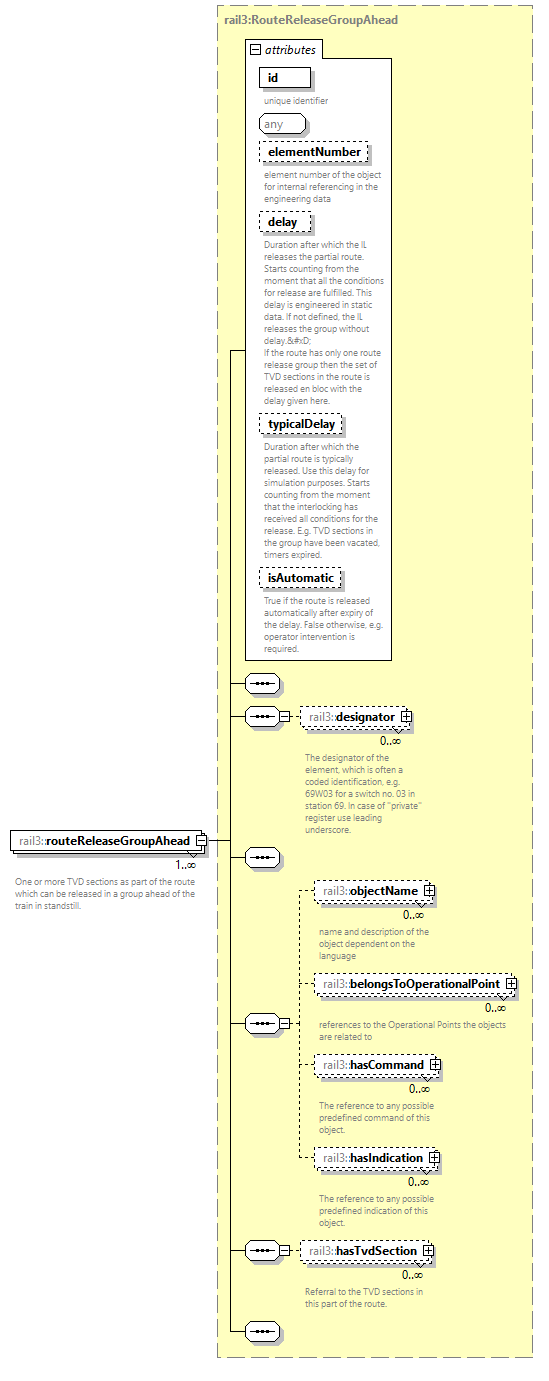 | ||||||||||||||||||||||||||||||||||||||||||||||
| namespace | https://www.railml.org/schemas/3.2 | ||||||||||||||||||||||||||||||||||||||||||||||
| type | rail3:RouteReleaseGroupAhead | ||||||||||||||||||||||||||||||||||||||||||||||
| properties |
| ||||||||||||||||||||||||||||||||||||||||||||||
| children | rail3:designator rail3:objectName rail3:belongsToOperationalPoint rail3:hasCommand rail3:hasIndication rail3:hasTvdSection | ||||||||||||||||||||||||||||||||||||||||||||||
| attributes |
| ||||||||||||||||||||||||||||||||||||||||||||||
| annotation |
| ||||||||||||||||||||||||||||||||||||||||||||||
| source | <xs:element name="routeReleaseGroupAhead" type="rail3:RouteReleaseGroupAhead" minOccurs="1" maxOccurs="unbounded"> <xs:annotation> <xs:documentation>One or more TVD sections as part of the route which can be released in a group ahead of the train in standstill.</xs:documentation> </xs:annotation> </xs:element> |
complexType RouteReleaseGroupsRear
| diagram |  | ||
| namespace | https://www.railml.org/schemas/3.2 | ||
| children | rail3:routeReleaseGroupRear | ||
| used by |
| ||
| source | <xs:complexType name="RouteReleaseGroupsRear"> <xs:sequence> <xs:element name="routeReleaseGroupRear" type="rail3:RouteReleaseGroupRear" minOccurs="1" maxOccurs="unbounded"> <xs:annotation> <xs:documentation>One or more TVD sections as part of the route which can be released in a group in rear of passing train.</xs:documentation> </xs:annotation> </xs:element> </xs:sequence> </xs:complexType> |
element RouteReleaseGroupsRear/routeReleaseGroupRear
| diagram | 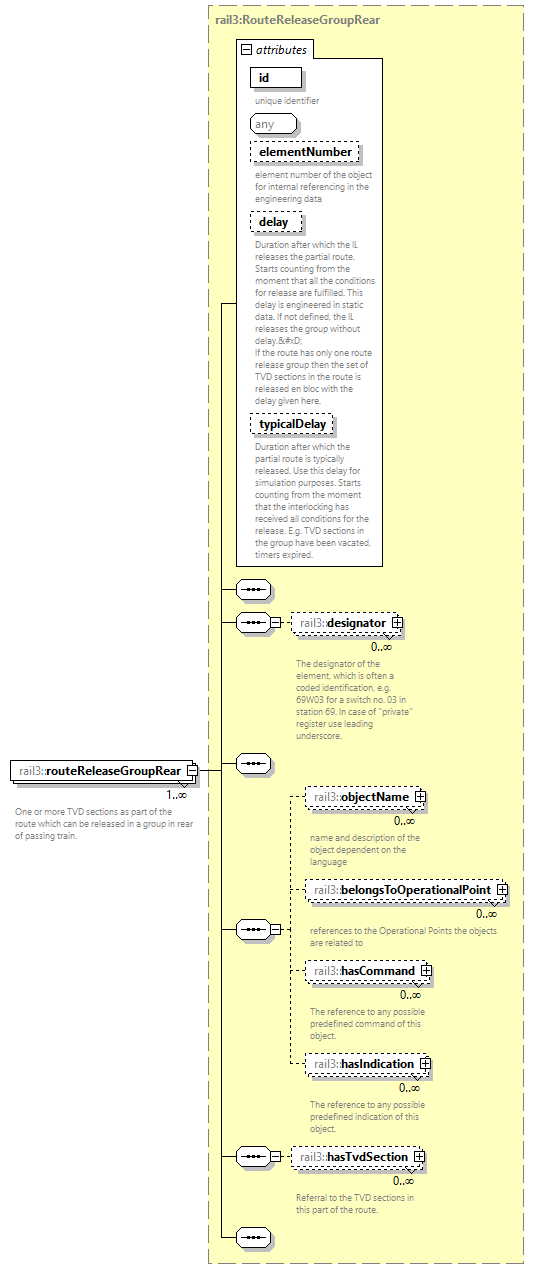 | ||||||||||||||||||||||||||||||||||||||
| namespace | https://www.railml.org/schemas/3.2 | ||||||||||||||||||||||||||||||||||||||
| type | rail3:RouteReleaseGroupRear | ||||||||||||||||||||||||||||||||||||||
| properties |
| ||||||||||||||||||||||||||||||||||||||
| children | rail3:designator rail3:objectName rail3:belongsToOperationalPoint rail3:hasCommand rail3:hasIndication rail3:hasTvdSection | ||||||||||||||||||||||||||||||||||||||
| attributes |
| ||||||||||||||||||||||||||||||||||||||
| annotation |
| ||||||||||||||||||||||||||||||||||||||
| source | <xs:element name="routeReleaseGroupRear" type="rail3:RouteReleaseGroupRear" minOccurs="1" maxOccurs="unbounded"> <xs:annotation> <xs:documentation>One or more TVD sections as part of the route which can be released in a group in rear of passing train.</xs:documentation> </xs:annotation> </xs:element> |
complexType Routes
| diagram |  | ||
| namespace | https://www.railml.org/schemas/3.2 | ||
| children | rail3:route | ||
| used by |
| ||
| annotation |
| ||
| source | <xs:complexType name="Routes"> <xs:annotation> <xs:documentation>container element for all Route elements</xs:documentation> </xs:annotation> <xs:sequence minOccurs="0" maxOccurs="1"> <xs:element name="route" type="rail3:Route" minOccurs="1" maxOccurs="unbounded"> <xs:annotation> <xs:documentation>path for train movements in railway network secured by interlocking system</xs:documentation> </xs:annotation> </xs:element> </xs:sequence> </xs:complexType> |
element Routes/route
| diagram |  | ||||||||||||||||||||||||||||||||||||||||||||||||||||||||||||||||||||||||||||||
| namespace | https://www.railml.org/schemas/3.2 | ||||||||||||||||||||||||||||||||||||||||||||||||||||||||||||||||||||||||||||||
| type | rail3:Route | ||||||||||||||||||||||||||||||||||||||||||||||||||||||||||||||||||||||||||||||
| properties |
| ||||||||||||||||||||||||||||||||||||||||||||||||||||||||||||||||||||||||||||||
| children | rail3:designator rail3:objectName rail3:belongsToOperationalPoint rail3:hasCommand rail3:hasIndication rail3:handlesRouteType rail3:routeActivationSection rail3:facingSwitchInPosition rail3:trailingSwitchInPosition rail3:hasTvdSection rail3:routeEntry rail3:intermediateCodePoint rail3:hasReleaseGroup rail3:switchPositionInDepartureTrack rail3:routeExit rail3:additionalRelation | ||||||||||||||||||||||||||||||||||||||||||||||||||||||||||||||||||||||||||||||
| attributes |
| ||||||||||||||||||||||||||||||||||||||||||||||||||||||||||||||||||||||||||||||
| annotation |
| ||||||||||||||||||||||||||||||||||||||||||||||||||||||||||||||||||||||||||||||
| source | <xs:element name="route" type="rail3:Route" minOccurs="1" maxOccurs="unbounded"> <xs:annotation> <xs:documentation>path for train movements in railway network secured by interlocking system</xs:documentation> </xs:annotation> </xs:element> |
complexType RouteSequences
| diagram | 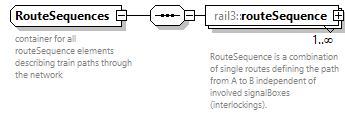 | ||
| namespace | https://www.railml.org/schemas/3.2 | ||
| children | rail3:routeSequence | ||
| used by |
| ||
| annotation |
| ||
| source | <xs:complexType name="RouteSequences"> <xs:annotation> <xs:documentation>container for all routeSequence elements describing train paths through the network</xs:documentation> </xs:annotation> <xs:sequence> <xs:element name="routeSequence" type="rail3:CombinedRoute" minOccurs="1" maxOccurs="unbounded"> <xs:annotation> <xs:documentation>RouteSequence is a combination of single routes defining the path from A to B independent of involved signalBoxes (interlockings).</xs:documentation> </xs:annotation> </xs:element> </xs:sequence> </xs:complexType> |
element RouteSequences/routeSequence
| diagram | 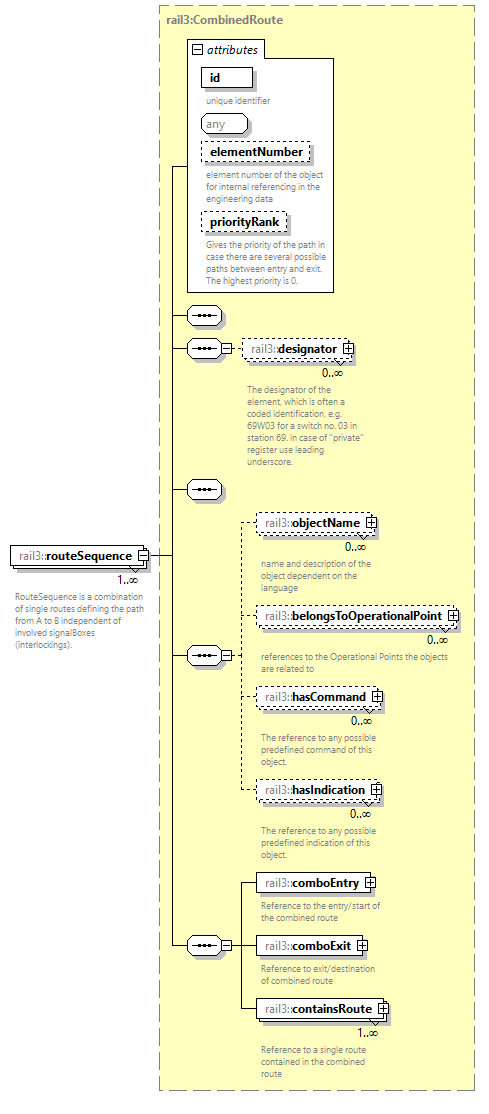 | ||||||||||||||||||||||||||||||
| namespace | https://www.railml.org/schemas/3.2 | ||||||||||||||||||||||||||||||
| type | rail3:CombinedRoute | ||||||||||||||||||||||||||||||
| properties |
| ||||||||||||||||||||||||||||||
| children | rail3:designator rail3:objectName rail3:belongsToOperationalPoint rail3:hasCommand rail3:hasIndication rail3:comboEntry rail3:comboExit rail3:containsRoute | ||||||||||||||||||||||||||||||
| attributes |
| ||||||||||||||||||||||||||||||
| annotation |
| ||||||||||||||||||||||||||||||
| source | <xs:element name="routeSequence" type="rail3:CombinedRoute" minOccurs="1" maxOccurs="unbounded"> <xs:annotation> <xs:documentation>RouteSequence is a combination of single routes defining the path from A to B independent of involved signalBoxes (interlockings).</xs:documentation> </xs:annotation> </xs:element> |
complexType RouteStatusIndicator
| diagram | 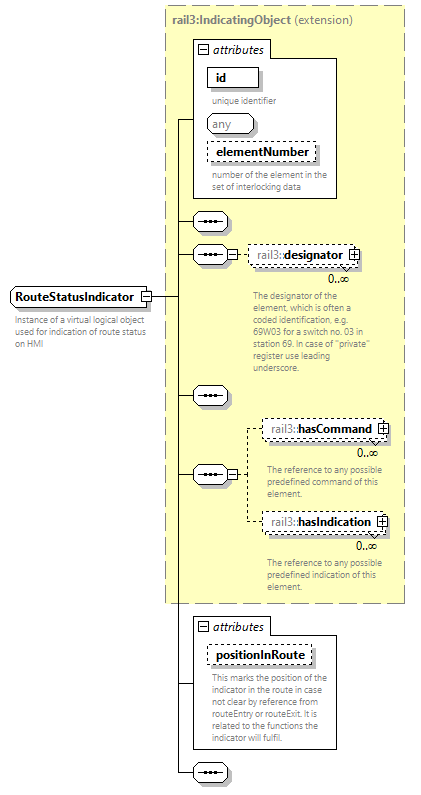 | ||||||||||||||||||||||||||||||
| namespace | https://www.railml.org/schemas/3.2 | ||||||||||||||||||||||||||||||
| type | extension of rail3:IndicatingObject | ||||||||||||||||||||||||||||||
| properties |
| ||||||||||||||||||||||||||||||
| children | rail3:designator rail3:hasCommand rail3:hasIndication | ||||||||||||||||||||||||||||||
| used by |
| ||||||||||||||||||||||||||||||
| attributes |
| ||||||||||||||||||||||||||||||
| annotation |
| ||||||||||||||||||||||||||||||
| source | <xs:complexType name="RouteStatusIndicator"> <xs:annotation> <xs:documentation>Instance of a virtual logical object used for indication of route status on HMI</xs:documentation> </xs:annotation> <xs:complexContent> <xs:extension base="rail3:IndicatingObject"> <xs:sequence/> <xs:attribute name="positionInRoute" type="rail3:tIndicatorPositionList" use="optional"> <xs:annotation> <xs:documentation>This marks the position of the indicator in the route in case not clear by reference from routeEntry or routeExit. It is related to the functions the indicator will fulfil.</xs:documentation> </xs:annotation> </xs:attribute> </xs:extension> </xs:complexContent> </xs:complexType> |
attribute RouteStatusIndicator/@positionInRoute
| type | rail3:tIndicatorPositionList | |||||||||||||
| properties |
| |||||||||||||
| facets |
| |||||||||||||
| annotation |
| |||||||||||||
| source | <xs:attribute name="positionInRoute" type="rail3:tIndicatorPositionList" use="optional"> <xs:annotation> <xs:documentation>This marks the position of the indicator in the route in case not clear by reference from routeEntry or routeExit. It is related to the functions the indicator will fulfil.</xs:documentation> </xs:annotation> </xs:attribute> |
complexType RouteStatusIndicators
| diagram |  | ||
| namespace | https://www.railml.org/schemas/3.2 | ||
| children | rail3:routeStatusIndicator | ||
| used by |
| ||
| annotation |
| ||
| source | <xs:complexType name="RouteStatusIndicators"> <xs:annotation> <xs:documentation>container for virtual logical object used for indication of route status on HMI</xs:documentation> </xs:annotation> <xs:sequence> <xs:element name="routeStatusIndicator" type="rail3:RouteStatusIndicator" minOccurs="1" maxOccurs="unbounded"> <xs:annotation> <xs:documentation>virtual logical object used for indication of route status on HMI</xs:documentation> </xs:annotation> </xs:element> </xs:sequence> </xs:complexType> |
element RouteStatusIndicators/routeStatusIndicator
| diagram | 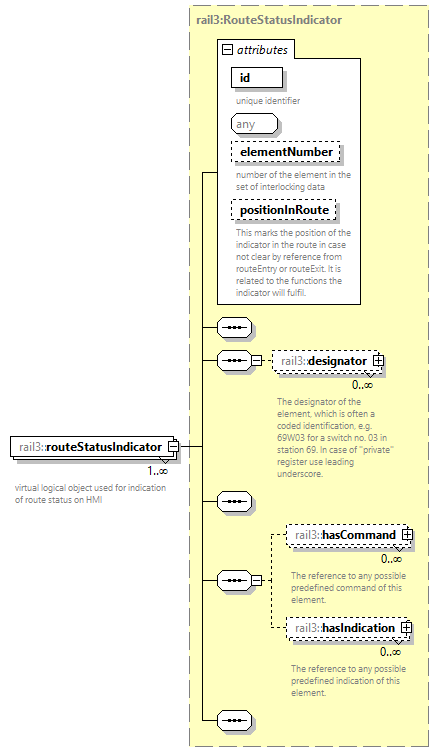 | ||||||||||||||||||||||||||||||
| namespace | https://www.railml.org/schemas/3.2 | ||||||||||||||||||||||||||||||
| type | rail3:RouteStatusIndicator | ||||||||||||||||||||||||||||||
| properties |
| ||||||||||||||||||||||||||||||
| children | rail3:designator rail3:hasCommand rail3:hasIndication | ||||||||||||||||||||||||||||||
| attributes |
| ||||||||||||||||||||||||||||||
| annotation |
| ||||||||||||||||||||||||||||||
| source | <xs:element name="routeStatusIndicator" type="rail3:RouteStatusIndicator" minOccurs="1" maxOccurs="unbounded"> <xs:annotation> <xs:documentation>virtual logical object used for indication of route status on HMI</xs:documentation> </xs:annotation> </xs:element> |
complexType Scope
| diagram | 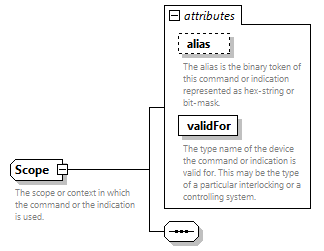 | ||||||||||||||||||||||
| namespace | https://www.railml.org/schemas/3.2 | ||||||||||||||||||||||
| used by |
| ||||||||||||||||||||||
| attributes |
| ||||||||||||||||||||||
| annotation |
| ||||||||||||||||||||||
| source | <xs:complexType name="Scope"> <xs:annotation> <xs:documentation>The scope or context in which the command or the indication is used.</xs:documentation> </xs:annotation> <xs:sequence/> <xs:attribute name="alias" type="rail3:tAliasString" use="optional"> <xs:annotation> <xs:documentation>The alias is the binary token of this command or indication represented as hex-string or bit-mask.</xs:documentation> </xs:annotation> </xs:attribute> <xs:attribute name="validFor" type="xs:string" use="required"> <xs:annotation> <xs:documentation>The type name of the device the command or indication is valid for. This may be the type of a particular interlocking or a controlling system.</xs:documentation> </xs:annotation> </xs:attribute> </xs:complexType> |
attribute Scope/@alias
| type | rail3:tAliasString | ||
| properties |
| ||
| annotation |
| ||
| source | <xs:attribute name="alias" type="rail3:tAliasString" use="optional"> <xs:annotation> <xs:documentation>The alias is the binary token of this command or indication represented as hex-string or bit-mask.</xs:documentation> </xs:annotation> </xs:attribute> |
attribute Scope/@validFor
| type | xs:string | ||
| properties |
| ||
| annotation |
| ||
| source | <xs:attribute name="validFor" type="xs:string" use="required"> <xs:annotation> <xs:documentation>The type name of the device the command or indication is valid for. This may be the type of a particular interlocking or a controlling system.</xs:documentation> </xs:annotation> </xs:attribute> |
complexType SectionAndGivenVacancy
| diagram | 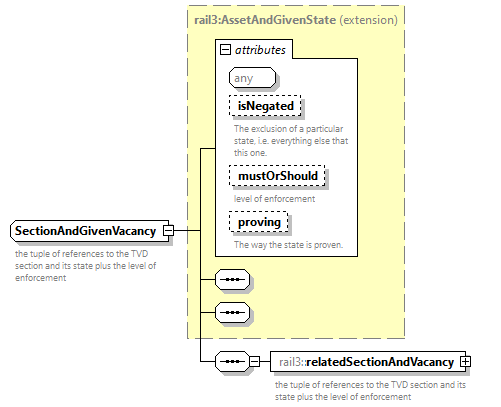 | ||||||||||||||||||||||||||||||
| namespace | https://www.railml.org/schemas/3.2 | ||||||||||||||||||||||||||||||
| type | extension of rail3:AssetAndGivenState | ||||||||||||||||||||||||||||||
| properties |
| ||||||||||||||||||||||||||||||
| children | rail3:relatedSectionAndVacancy | ||||||||||||||||||||||||||||||
| used by |
| ||||||||||||||||||||||||||||||
| attributes |
| ||||||||||||||||||||||||||||||
| annotation |
| ||||||||||||||||||||||||||||||
| source | <xs:complexType name="SectionAndGivenVacancy"> <xs:annotation> <xs:documentation>the tuple of references to the TVD section and its state plus the level of enforcement</xs:documentation> </xs:annotation> <xs:complexContent> <xs:extension base="rail3:AssetAndGivenState"> <xs:sequence> <xs:element name="relatedSectionAndVacancy" type="rail3:SectionAndVacancy" minOccurs="1" maxOccurs="1"> <xs:annotation> <xs:documentation>the tuple of references to the TVD section and its state plus the level of enforcement</xs:documentation> </xs:annotation> </xs:element> </xs:sequence> </xs:extension> </xs:complexContent> </xs:complexType> |
element SectionAndGivenVacancy/relatedSectionAndVacancy
| diagram | 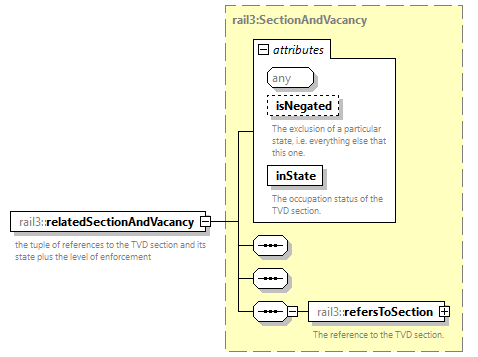 | ||||||||||||||||||||||
| namespace | https://www.railml.org/schemas/3.2 | ||||||||||||||||||||||
| type | rail3:SectionAndVacancy | ||||||||||||||||||||||
| properties |
| ||||||||||||||||||||||
| children | rail3:refersToSection | ||||||||||||||||||||||
| attributes |
| ||||||||||||||||||||||
| annotation |
| ||||||||||||||||||||||
| source | <xs:element name="relatedSectionAndVacancy" type="rail3:SectionAndVacancy" minOccurs="1" maxOccurs="1"> <xs:annotation> <xs:documentation>the tuple of references to the TVD section and its state plus the level of enforcement</xs:documentation> </xs:annotation> </xs:element> |
complexType SectionAndVacancy
| diagram | 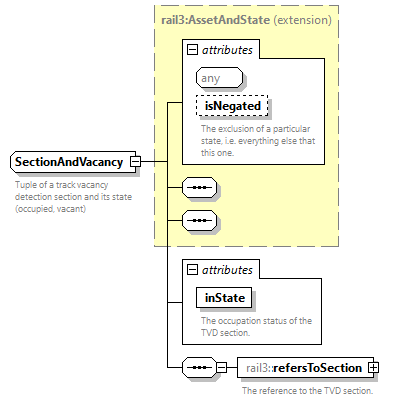 | ||||||||||||||||||||||
| namespace | https://www.railml.org/schemas/3.2 | ||||||||||||||||||||||
| type | extension of rail3:AssetAndState | ||||||||||||||||||||||
| properties |
| ||||||||||||||||||||||
| children | rail3:refersToSection | ||||||||||||||||||||||
| used by |
| ||||||||||||||||||||||
| attributes |
| ||||||||||||||||||||||
| annotation |
| ||||||||||||||||||||||
| source | <xs:complexType name="SectionAndVacancy"> <xs:annotation> <xs:documentation>Tuple of a track vacancy detection section and its state (occupied, vacant)</xs:documentation> </xs:annotation> <xs:complexContent> <xs:extension base="rail3:AssetAndState"> <xs:sequence> <xs:element name="refersToSection" type="rail3:EntityILref" minOccurs="1" maxOccurs="1"> <xs:annotation> <xs:documentation>The reference to the TVD section.</xs:documentation> </xs:annotation> </xs:element> </xs:sequence> <xs:attribute name="inState" type="rail3:tSectionVacancy" use="required"> <xs:annotation> <xs:documentation>The occupation status of the TVD section.</xs:documentation> </xs:annotation> </xs:attribute> </xs:extension> </xs:complexContent> </xs:complexType> |
attribute SectionAndVacancy/@inState
| type | rail3:tSectionVacancy | ||||||||||||||||||
| properties |
| ||||||||||||||||||
| facets |
| ||||||||||||||||||
| annotation |
| ||||||||||||||||||
| source | <xs:attribute name="inState" type="rail3:tSectionVacancy" use="required"> <xs:annotation> <xs:documentation>The occupation status of the TVD section.</xs:documentation> </xs:annotation> </xs:attribute> |
element SectionAndVacancy/refersToSection
| diagram | 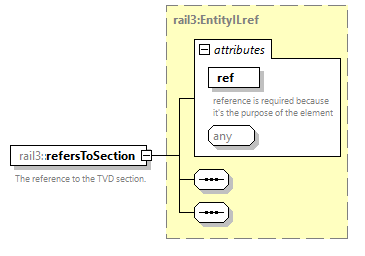 | ||||||||||||||
| namespace | https://www.railml.org/schemas/3.2 | ||||||||||||||
| type | rail3:EntityILref | ||||||||||||||
| properties |
| ||||||||||||||
| attributes |
| ||||||||||||||
| annotation |
| ||||||||||||||
| source | <xs:element name="refersToSection" type="rail3:EntityILref" minOccurs="1" maxOccurs="1"> <xs:annotation> <xs:documentation>The reference to the TVD section.</xs:documentation> </xs:annotation> </xs:element> |
complexType ShuntingZone
| diagram | 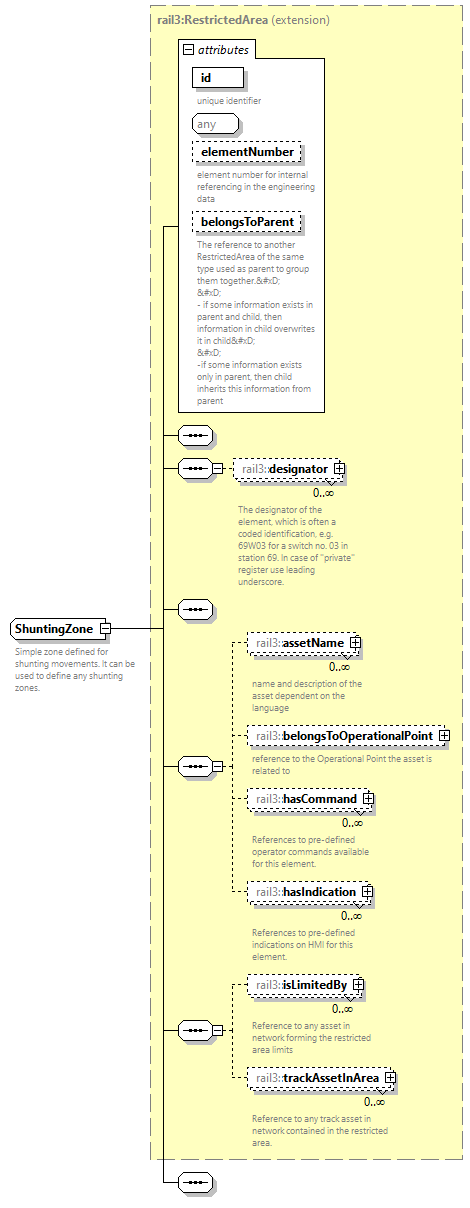 | ||||||||||||||||||||||||||||||
| namespace | https://www.railml.org/schemas/3.2 | ||||||||||||||||||||||||||||||
| type | extension of rail3:RestrictedArea | ||||||||||||||||||||||||||||||
| properties |
| ||||||||||||||||||||||||||||||
| children | rail3:designator rail3:assetName rail3:belongsToOperationalPoint rail3:hasCommand rail3:hasIndication rail3:isLimitedBy rail3:trackAssetInArea | ||||||||||||||||||||||||||||||
| used by |
| ||||||||||||||||||||||||||||||
| attributes |
| ||||||||||||||||||||||||||||||
| annotation |
| ||||||||||||||||||||||||||||||
| source | <xs:complexType name="ShuntingZone"> <xs:annotation> <xs:documentation>Simple zone defined for shunting movements. It can be used to define any shunting zones.</xs:documentation> </xs:annotation> <xs:complexContent> <xs:extension base="rail3:RestrictedArea"> <xs:sequence/> </xs:extension> </xs:complexContent> </xs:complexType> |
complexType ShuntingZones
| diagram |  | ||
| namespace | https://www.railml.org/schemas/3.2 | ||
| children | rail3:shuntingZone | ||
| used by |
| ||
| source | <xs:complexType name="ShuntingZones"> <xs:sequence> <xs:element name="shuntingZone" type="rail3:ShuntingZone" minOccurs="1" maxOccurs="unbounded"> <xs:annotation> <xs:documentation>Simple zone defined for shunting movements.</xs:documentation> </xs:annotation> </xs:element> </xs:sequence> </xs:complexType> |
element ShuntingZones/shuntingZone
| diagram | 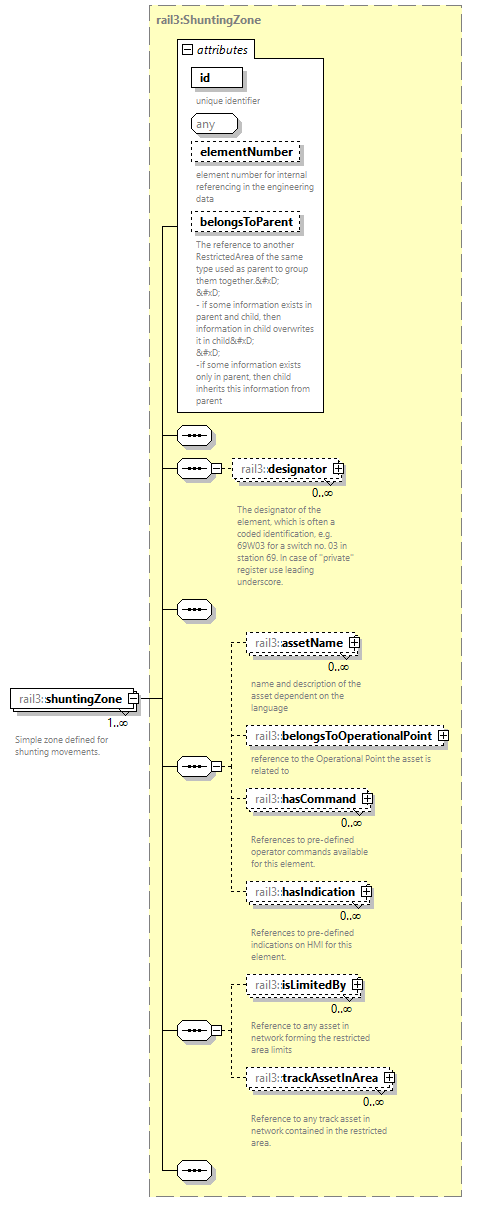 | ||||||||||||||||||||||||||||||
| namespace | https://www.railml.org/schemas/3.2 | ||||||||||||||||||||||||||||||
| type | rail3:ShuntingZone | ||||||||||||||||||||||||||||||
| properties |
| ||||||||||||||||||||||||||||||
| children | rail3:designator rail3:assetName rail3:belongsToOperationalPoint rail3:hasCommand rail3:hasIndication rail3:isLimitedBy rail3:trackAssetInArea | ||||||||||||||||||||||||||||||
| attributes |
| ||||||||||||||||||||||||||||||
| annotation |
| ||||||||||||||||||||||||||||||
| source | <xs:element name="shuntingZone" type="rail3:ShuntingZone" minOccurs="1" maxOccurs="unbounded"> <xs:annotation> <xs:documentation>Simple zone defined for shunting movements.</xs:documentation> </xs:annotation> </xs:element> |
complexType SignalAndAspect
| diagram | 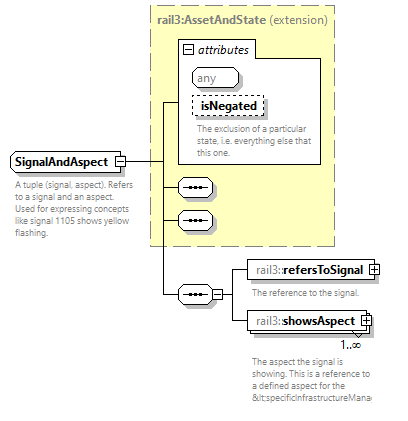 | ||||||||||||||
| namespace | https://www.railml.org/schemas/3.2 | ||||||||||||||
| type | extension of rail3:AssetAndState | ||||||||||||||
| properties |
| ||||||||||||||
| children | rail3:refersToSignal rail3:showsAspect | ||||||||||||||
| used by |
| ||||||||||||||
| attributes |
| ||||||||||||||
| annotation |
| ||||||||||||||
| source | <xs:complexType name="SignalAndAspect"> <xs:annotation> <xs:documentation>A tuple (signal, aspect). Refers to a signal and an aspect. Used for expressing concepts like signal 1105 shows yellow flashing.</xs:documentation> </xs:annotation> <xs:complexContent> <xs:extension base="rail3:AssetAndState"> <xs:sequence> <xs:element name="refersToSignal" type="rail3:EntityILref" minOccurs="1" maxOccurs="1"> <xs:annotation> <xs:documentation>The reference to the signal.</xs:documentation> </xs:annotation> </xs:element> <xs:element name="showsAspect" type="rail3:EntityILref" minOccurs="1" maxOccurs="unbounded"> <xs:annotation> <xs:documentation>The aspect the signal is showing. This is a reference to a defined aspect for the <specificInfrastructureManager>.</xs:documentation> </xs:annotation> </xs:element> </xs:sequence> </xs:extension> </xs:complexContent> </xs:complexType> |
element SignalAndAspect/refersToSignal
| diagram | 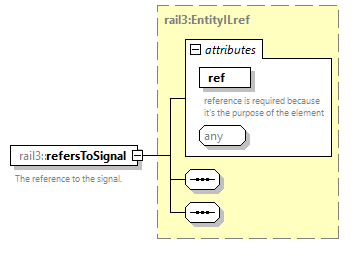 | ||||||||||||||
| namespace | https://www.railml.org/schemas/3.2 | ||||||||||||||
| type | rail3:EntityILref | ||||||||||||||
| properties |
| ||||||||||||||
| attributes |
| ||||||||||||||
| annotation |
| ||||||||||||||
| source | <xs:element name="refersToSignal" type="rail3:EntityILref" minOccurs="1" maxOccurs="1"> <xs:annotation> <xs:documentation>The reference to the signal.</xs:documentation> </xs:annotation> </xs:element> |
element SignalAndAspect/showsAspect
| diagram | 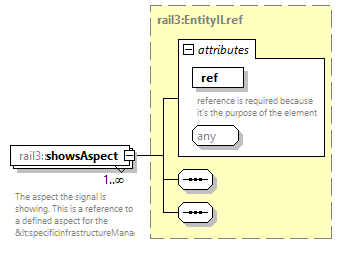 | ||||||||||||||
| namespace | https://www.railml.org/schemas/3.2 | ||||||||||||||
| type | rail3:EntityILref | ||||||||||||||
| properties |
| ||||||||||||||
| attributes |
| ||||||||||||||
| annotation |
| ||||||||||||||
| source | <xs:element name="showsAspect" type="rail3:EntityILref" minOccurs="1" maxOccurs="unbounded"> <xs:annotation> <xs:documentation>The aspect the signal is showing. This is a reference to a defined aspect for the <specificInfrastructureManager>.</xs:documentation> </xs:annotation> </xs:element> |
complexType SignalAndGivenAspect
| diagram | 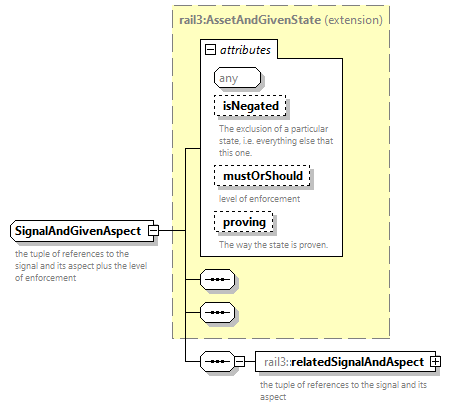 | ||||||||||||||||||||||||||||||
| namespace | https://www.railml.org/schemas/3.2 | ||||||||||||||||||||||||||||||
| type | extension of rail3:AssetAndGivenState | ||||||||||||||||||||||||||||||
| properties |
| ||||||||||||||||||||||||||||||
| children | rail3:relatedSignalAndAspect | ||||||||||||||||||||||||||||||
| used by |
| ||||||||||||||||||||||||||||||
| attributes |
| ||||||||||||||||||||||||||||||
| annotation |
| ||||||||||||||||||||||||||||||
| source | <xs:complexType name="SignalAndGivenAspect"> <xs:annotation> <xs:documentation>the tuple of references to the signal and its aspect plus the level of enforcement</xs:documentation> </xs:annotation> <xs:complexContent> <xs:extension base="rail3:AssetAndGivenState"> <xs:sequence> <xs:element name="relatedSignalAndAspect" type="rail3:SignalAndAspect" minOccurs="1" maxOccurs="1"> <xs:annotation> <xs:documentation>the tuple of references to the signal and its aspect</xs:documentation> </xs:annotation> </xs:element> </xs:sequence> </xs:extension> </xs:complexContent> </xs:complexType> |
element SignalAndGivenAspect/relatedSignalAndAspect
| diagram | 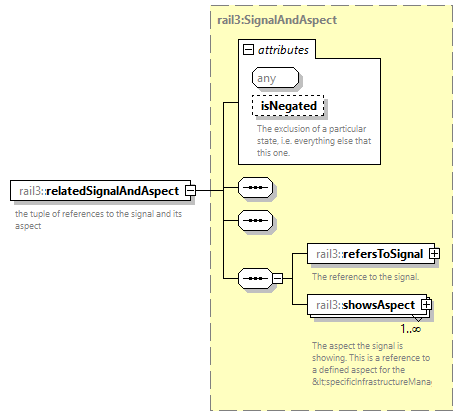 | ||||||||||||||
| namespace | https://www.railml.org/schemas/3.2 | ||||||||||||||
| type | rail3:SignalAndAspect | ||||||||||||||
| properties |
| ||||||||||||||
| children | rail3:refersToSignal rail3:showsAspect | ||||||||||||||
| attributes |
| ||||||||||||||
| annotation |
| ||||||||||||||
| source | <xs:element name="relatedSignalAndAspect" type="rail3:SignalAndAspect" minOccurs="1" maxOccurs="1"> <xs:annotation> <xs:documentation>the tuple of references to the signal and its aspect</xs:documentation> </xs:annotation> </xs:element> |
complexType SignalBox
| diagram |  | ||||||||||||||||||||||||||||||||||||||
| namespace | https://www.railml.org/schemas/3.2 | ||||||||||||||||||||||||||||||||||||||
| type | extension of rail3:ComputerNode | ||||||||||||||||||||||||||||||||||||||
| properties |
| ||||||||||||||||||||||||||||||||||||||
| children | rail3:designator rail3:hasName rail3:hasCommunicationSettings rail3:belongsToOperationalPoint rail3:belongsToInfrastructureManager rail3:controlsSystemAsset rail3:controlsTrackAsset rail3:controlsRoute rail3:controlsCombinedRoute rail3:controlsInterface rail3:controlledBy rail3:implementsSignalplan rail3:implementsElementGroup rail3:hasPermissionZone rail3:hasConflictingRoutes rail3:hasConfiguration rail3:hasCommand rail3:hasIndication rail3:connectedToRadioBlockCentre | ||||||||||||||||||||||||||||||||||||||
| used by |
| ||||||||||||||||||||||||||||||||||||||
| attributes |
| ||||||||||||||||||||||||||||||||||||||
| annotation |
| ||||||||||||||||||||||||||||||||||||||
| source | <xs:complexType name="SignalBox"> <xs:annotation> <xs:documentation>The SignalBox (single interlocking) is a vital and fail-safe system. It accepts commands from operation control systems and reads the status of field elements. The interlocking controls a set of track assets and system assets to safely guide and control train movement. This logic reflects the railway rules and regulations.
 Interlocking logic may be implemented in terms of mechanically interlocking bars, relay circuitry or computer programs. 
 This is the master class that must be instantiated for a specific interlocking system that controls a specific yard.</xs:documentation> </xs:annotation> <xs:complexContent> <xs:extension base="rail3:ComputerNode"> <xs:sequence> <xs:element name="controlsSystemAsset" type="rail3:SystemAssetConnectedToIL" minOccurs="0" maxOccurs="unbounded"> <xs:annotation> <xs:documentation>The references to the system assets the interlocking controls</xs:documentation> </xs:annotation> </xs:element> <xs:element name="controlsTrackAsset" type="rail3:TrackAssetConnectedToIL" minOccurs="0" maxOccurs="unbounded"> <xs:annotation> <xs:documentation>The interlocking carries a list of (references to) track assets that this interlocking controls. The controlled object has an attribute indicating the Level of Control which is most often ‘full control’. Track assets that aren't controlled by the interlocking, e.g. field controlled level crossing or open track elements can be tagged with levelOfControl='none'. </xs:documentation> </xs:annotation> </xs:element> <xs:element name="controlsRoute" type="rail3:EntityILref" minOccurs="0" maxOccurs="unbounded"> <xs:annotation> <xs:documentation>The reference to the routes the interlocking controls</xs:documentation> </xs:annotation> </xs:element> <xs:element name="controlsCombinedRoute" type="rail3:EntityILref" minOccurs="0" maxOccurs="unbounded"> <xs:annotation> <xs:documentation>The reference to the combined routes the interlocking controls</xs:documentation> </xs:annotation> </xs:element> <xs:element name="controlsInterface" type="rail3:InterlockingInterface" minOccurs="0" maxOccurs="unbounded"> <xs:annotation> <xs:documentation>The references to the interfaces to other interlockings</xs:documentation> </xs:annotation> </xs:element> <xs:element name="controlledBy" type="rail3:EntityILref" minOccurs="0" maxOccurs="unbounded"> <xs:annotation> <xs:documentation>The references to the controllers which can control this interlocking</xs:documentation> </xs:annotation> </xs:element> <xs:element name="implementsSignalplan" type="rail3:SignalPlan" minOccurs="0" maxOccurs="unbounded"> <xs:annotation> <xs:documentation>The references to the signal plans the interlocking uses</xs:documentation> </xs:annotation> </xs:element> <xs:element name="implementsElementGroup" type="rail3:ElementGroup" minOccurs="0" maxOccurs="unbounded"> <xs:annotation> <xs:documentation>The references to the element groups which are configured for this interlocking</xs:documentation> </xs:annotation> </xs:element> <xs:element name="hasPermissionZone" type="rail3:EntityILref" minOccurs="0" maxOccurs="unbounded"> <xs:annotation> <xs:documentation>The reference to any permission zone within the area controlled by this interlocking.</xs:documentation> </xs:annotation> </xs:element> <xs:element name="hasConflictingRoutes" type="rail3:EntityILref" minOccurs="0" maxOccurs="unbounded"> <xs:annotation> <xs:documentation>The references to the conflicting routes the interlocking knows</xs:documentation> </xs:annotation> </xs:element> <xs:element name="hasConfiguration" type="rail3:Configuration" minOccurs="0" maxOccurs="unbounded"> <xs:annotation> <xs:documentation>Basic information of the interlocking configuration</xs:documentation> </xs:annotation> </xs:element> <xs:element name="hasCommand" type="rail3:CodedEntityILref" minOccurs="0" maxOccurs="unbounded"> <xs:annotation> <xs:documentation>References to pre-defined operator commands available for this element.</xs:documentation> </xs:annotation> </xs:element> <xs:element name="hasIndication" type="rail3:CodedEntityILref" minOccurs="0" maxOccurs="unbounded"> <xs:annotation> <xs:documentation>References to pre-defined indications available for this element.</xs:documentation> </xs:annotation> </xs:element> <xs:element name="connectedToRadioBlockCentre" type="rail3:EntityILref" minOccurs="0" maxOccurs="unbounded"> <xs:annotation> <xs:documentation>Reference to any radioBlockCenter this signalBox is connected to.</xs:documentation> </xs:annotation> </xs:element> </xs:sequence> </xs:extension> </xs:complexContent> </xs:complexType> |
element SignalBox/controlsSystemAsset
| diagram | 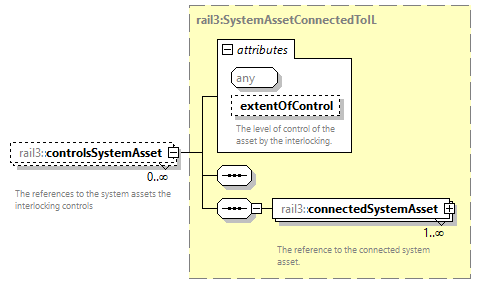 | ||||||||||||||
| namespace | https://www.railml.org/schemas/3.2 | ||||||||||||||
| type | rail3:SystemAssetConnectedToIL | ||||||||||||||
| properties |
| ||||||||||||||
| children | rail3:connectedSystemAsset | ||||||||||||||
| attributes |
| ||||||||||||||
| annotation |
| ||||||||||||||
| source | <xs:element name="controlsSystemAsset" type="rail3:SystemAssetConnectedToIL" minOccurs="0" maxOccurs="unbounded"> <xs:annotation> <xs:documentation>The references to the system assets the interlocking controls</xs:documentation> </xs:annotation> </xs:element> |
element SignalBox/controlsTrackAsset
| diagram | 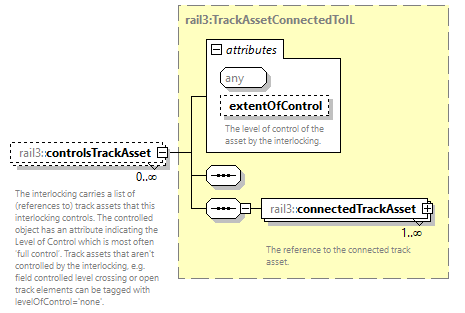 | ||||||||||||||
| namespace | https://www.railml.org/schemas/3.2 | ||||||||||||||
| type | rail3:TrackAssetConnectedToIL | ||||||||||||||
| properties |
| ||||||||||||||
| children | rail3:connectedTrackAsset | ||||||||||||||
| attributes |
| ||||||||||||||
| annotation |
| ||||||||||||||
| source | <xs:element name="controlsTrackAsset" type="rail3:TrackAssetConnectedToIL" minOccurs="0" maxOccurs="unbounded"> <xs:annotation> <xs:documentation>The interlocking carries a list of (references to) track assets that this interlocking controls. The controlled object has an attribute indicating the Level of Control which is most often ‘full control’. Track assets that aren't controlled by the interlocking, e.g. field controlled level crossing or open track elements can be tagged with levelOfControl='none'. </xs:documentation> </xs:annotation> </xs:element> |
element SignalBox/controlsRoute
| diagram | 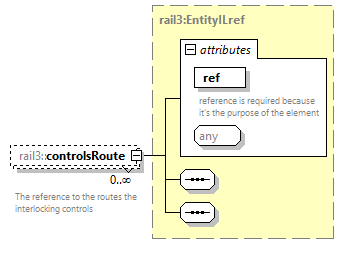 | ||||||||||||||
| namespace | https://www.railml.org/schemas/3.2 | ||||||||||||||
| type | rail3:EntityILref | ||||||||||||||
| properties |
| ||||||||||||||
| attributes |
| ||||||||||||||
| annotation |
| ||||||||||||||
| source | <xs:element name="controlsRoute" type="rail3:EntityILref" minOccurs="0" maxOccurs="unbounded"> <xs:annotation> <xs:documentation>The reference to the routes the interlocking controls</xs:documentation> </xs:annotation> </xs:element> |
element SignalBox/controlsCombinedRoute
| diagram | 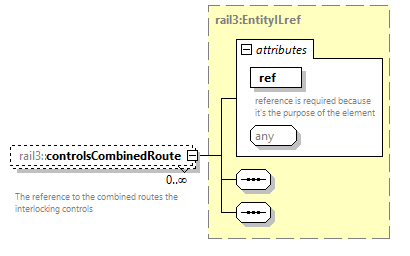 | ||||||||||||||
| namespace | https://www.railml.org/schemas/3.2 | ||||||||||||||
| type | rail3:EntityILref | ||||||||||||||
| properties |
| ||||||||||||||
| attributes |
| ||||||||||||||
| annotation |
| ||||||||||||||
| source | <xs:element name="controlsCombinedRoute" type="rail3:EntityILref" minOccurs="0" maxOccurs="unbounded"> <xs:annotation> <xs:documentation>The reference to the combined routes the interlocking controls</xs:documentation> </xs:annotation> </xs:element> |
element SignalBox/controlsInterface
| diagram | 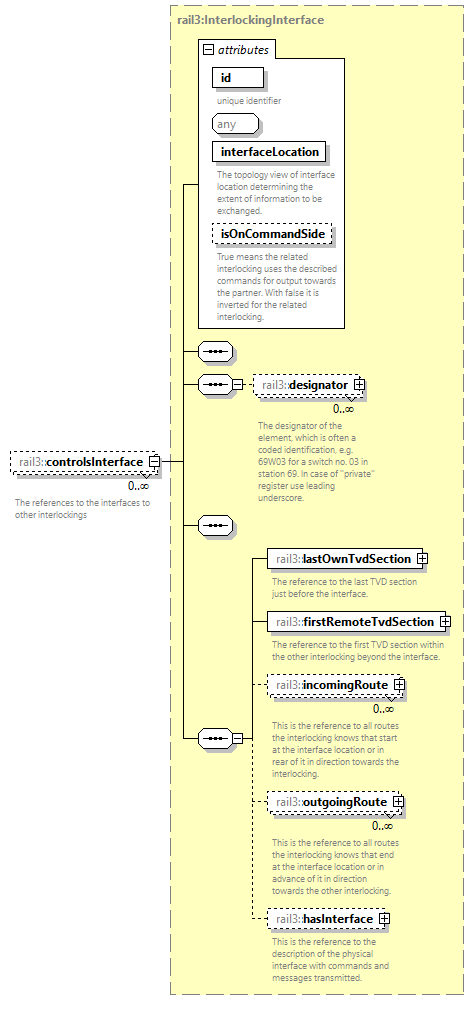 | ||||||||||||||||||||||||||||||
| namespace | https://www.railml.org/schemas/3.2 | ||||||||||||||||||||||||||||||
| type | rail3:InterlockingInterface | ||||||||||||||||||||||||||||||
| properties |
| ||||||||||||||||||||||||||||||
| children | rail3:designator rail3:lastOwnTvdSection rail3:firstRemoteTvdSection rail3:incomingRoute rail3:outgoingRoute rail3:hasInterface | ||||||||||||||||||||||||||||||
| attributes |
| ||||||||||||||||||||||||||||||
| annotation |
| ||||||||||||||||||||||||||||||
| source | <xs:element name="controlsInterface" type="rail3:InterlockingInterface" minOccurs="0" maxOccurs="unbounded"> <xs:annotation> <xs:documentation>The references to the interfaces to other interlockings</xs:documentation> </xs:annotation> </xs:element> |
element SignalBox/controlledBy
| diagram | 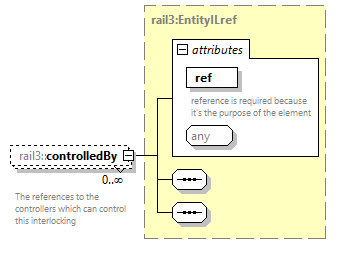 | ||||||||||||||
| namespace | https://www.railml.org/schemas/3.2 | ||||||||||||||
| type | rail3:EntityILref | ||||||||||||||
| properties |
| ||||||||||||||
| attributes |
| ||||||||||||||
| annotation |
| ||||||||||||||
| source | <xs:element name="controlledBy" type="rail3:EntityILref" minOccurs="0" maxOccurs="unbounded"> <xs:annotation> <xs:documentation>The references to the controllers which can control this interlocking</xs:documentation> </xs:annotation> </xs:element> |
element SignalBox/implementsSignalplan
| diagram | 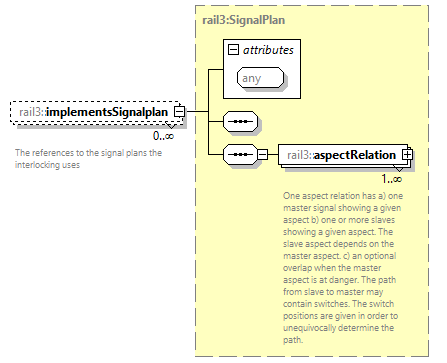 | ||||||
| namespace | https://www.railml.org/schemas/3.2 | ||||||
| type | rail3:SignalPlan | ||||||
| properties |
| ||||||
| children | rail3:aspectRelation | ||||||
| attributes |
| ||||||
| annotation |
| ||||||
| source | <xs:element name="implementsSignalplan" type="rail3:SignalPlan" minOccurs="0" maxOccurs="unbounded"> <xs:annotation> <xs:documentation>The references to the signal plans the interlocking uses</xs:documentation> </xs:annotation> </xs:element> |
element SignalBox/implementsElementGroup
| diagram | 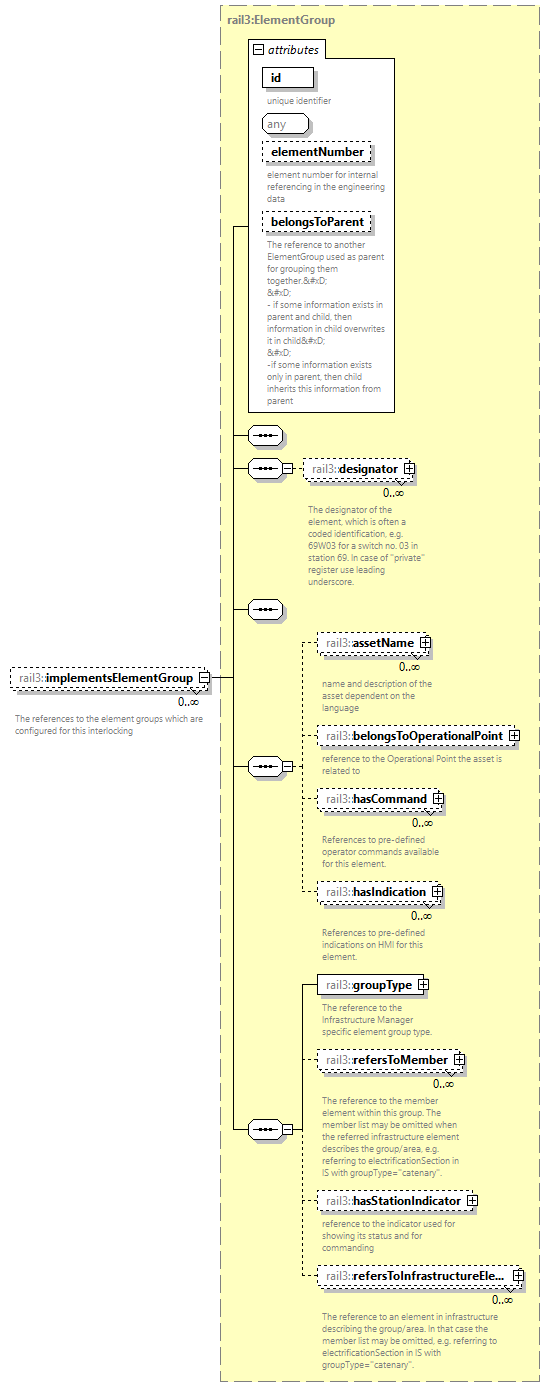 | ||||||||||||||||||||||||||||||
| namespace | https://www.railml.org/schemas/3.2 | ||||||||||||||||||||||||||||||
| type | rail3:ElementGroup | ||||||||||||||||||||||||||||||
| properties |
| ||||||||||||||||||||||||||||||
| children | rail3:designator rail3:assetName rail3:belongsToOperationalPoint rail3:hasCommand rail3:hasIndication rail3:groupType rail3:refersToMember rail3:hasStationIndicator rail3:refersToInfrastructureElement | ||||||||||||||||||||||||||||||
| attributes |
| ||||||||||||||||||||||||||||||
| annotation |
| ||||||||||||||||||||||||||||||
| source | <xs:element name="implementsElementGroup" type="rail3:ElementGroup" minOccurs="0" maxOccurs="unbounded"> <xs:annotation> <xs:documentation>The references to the element groups which are configured for this interlocking</xs:documentation> </xs:annotation> </xs:element> |
element SignalBox/hasPermissionZone
| diagram | 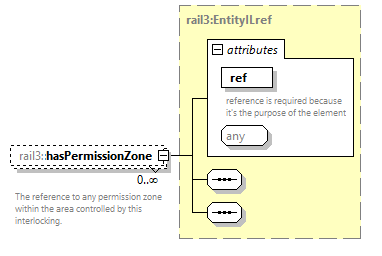 | ||||||||||||||
| namespace | https://www.railml.org/schemas/3.2 | ||||||||||||||
| type | rail3:EntityILref | ||||||||||||||
| properties |
| ||||||||||||||
| attributes |
| ||||||||||||||
| annotation |
| ||||||||||||||
| source | <xs:element name="hasPermissionZone" type="rail3:EntityILref" minOccurs="0" maxOccurs="unbounded"> <xs:annotation> <xs:documentation>The reference to any permission zone within the area controlled by this interlocking.</xs:documentation> </xs:annotation> </xs:element> |
element SignalBox/hasConflictingRoutes
| diagram | 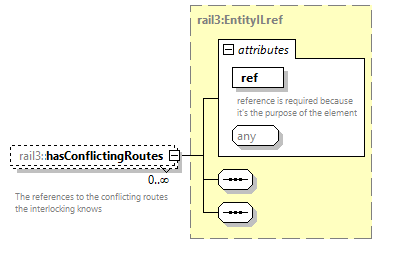 | ||||||||||||||
| namespace | https://www.railml.org/schemas/3.2 | ||||||||||||||
| type | rail3:EntityILref | ||||||||||||||
| properties |
| ||||||||||||||
| attributes |
| ||||||||||||||
| annotation |
| ||||||||||||||
| source | <xs:element name="hasConflictingRoutes" type="rail3:EntityILref" minOccurs="0" maxOccurs="unbounded"> <xs:annotation> <xs:documentation>The references to the conflicting routes the interlocking knows</xs:documentation> </xs:annotation> </xs:element> |
element SignalBox/hasConfiguration
| diagram | 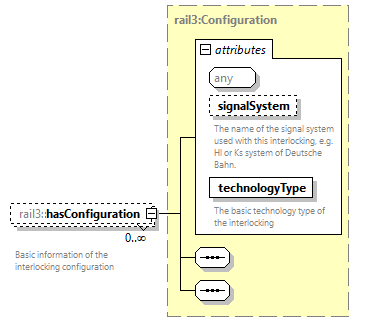 | ||||||||||||||||||||||
| namespace | https://www.railml.org/schemas/3.2 | ||||||||||||||||||||||
| type | rail3:Configuration | ||||||||||||||||||||||
| properties |
| ||||||||||||||||||||||
| attributes |
| ||||||||||||||||||||||
| annotation |
| ||||||||||||||||||||||
| source | <xs:element name="hasConfiguration" type="rail3:Configuration" minOccurs="0" maxOccurs="unbounded"> <xs:annotation> <xs:documentation>Basic information of the interlocking configuration</xs:documentation> </xs:annotation> </xs:element> |
element SignalBox/hasCommand
| diagram | 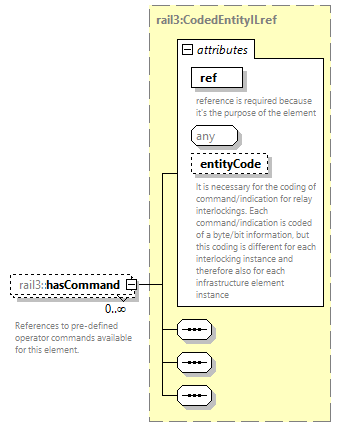 | ||||||||||||||||||||||
| namespace | https://www.railml.org/schemas/3.2 | ||||||||||||||||||||||
| type | rail3:CodedEntityILref | ||||||||||||||||||||||
| properties |
| ||||||||||||||||||||||
| attributes |
| ||||||||||||||||||||||
| annotation |
| ||||||||||||||||||||||
| source | <xs:element name="hasCommand" type="rail3:CodedEntityILref" minOccurs="0" maxOccurs="unbounded"> <xs:annotation> <xs:documentation>References to pre-defined operator commands available for this element.</xs:documentation> </xs:annotation> </xs:element> |
element SignalBox/hasIndication
| diagram | 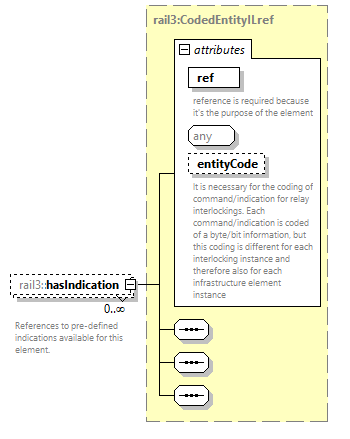 | ||||||||||||||||||||||
| namespace | https://www.railml.org/schemas/3.2 | ||||||||||||||||||||||
| type | rail3:CodedEntityILref | ||||||||||||||||||||||
| properties |
| ||||||||||||||||||||||
| attributes |
| ||||||||||||||||||||||
| annotation |
| ||||||||||||||||||||||
| source | <xs:element name="hasIndication" type="rail3:CodedEntityILref" minOccurs="0" maxOccurs="unbounded"> <xs:annotation> <xs:documentation>References to pre-defined indications available for this element.</xs:documentation> </xs:annotation> </xs:element> |
element SignalBox/connectedToRadioBlockCentre
| diagram | 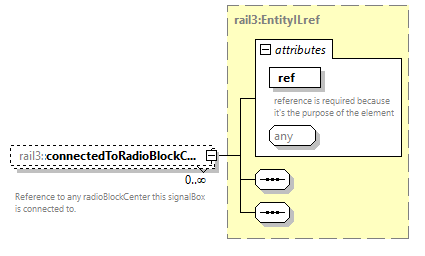 | ||||||||||||||
| namespace | https://www.railml.org/schemas/3.2 | ||||||||||||||
| type | rail3:EntityILref | ||||||||||||||
| properties |
| ||||||||||||||
| attributes |
| ||||||||||||||
| annotation |
| ||||||||||||||
| source | <xs:element name="connectedToRadioBlockCentre" type="rail3:EntityILref" minOccurs="0" maxOccurs="unbounded"> <xs:annotation> <xs:documentation>Reference to any radioBlockCenter this signalBox is connected to.</xs:documentation> </xs:annotation> </xs:element> |
complexType SignalBoxes
| diagram |  | ||
| namespace | https://www.railml.org/schemas/3.2 | ||
| children | rail3:signalBox | ||
| used by |
| ||
| annotation |
| ||
| source | <xs:complexType name="SignalBoxes"> <xs:annotation> <xs:documentation>container element for all signalBox elements</xs:documentation> </xs:annotation> <xs:sequence> <xs:element name="signalBox" type="rail3:SignalBox" minOccurs="1" maxOccurs="unbounded"> <xs:annotation> <xs:documentation>Container with the characteristics of an individual interlocking system.</xs:documentation> </xs:annotation> </xs:element> </xs:sequence> </xs:complexType> |
element SignalBoxes/signalBox
| diagram |  | ||||||||||||||||||||||||||||||||||||||
| namespace | https://www.railml.org/schemas/3.2 | ||||||||||||||||||||||||||||||||||||||
| type | rail3:SignalBox | ||||||||||||||||||||||||||||||||||||||
| properties |
| ||||||||||||||||||||||||||||||||||||||
| children | rail3:designator rail3:hasName rail3:hasCommunicationSettings rail3:belongsToOperationalPoint rail3:belongsToInfrastructureManager rail3:controlsSystemAsset rail3:controlsTrackAsset rail3:controlsRoute rail3:controlsCombinedRoute rail3:controlsInterface rail3:controlledBy rail3:implementsSignalplan rail3:implementsElementGroup rail3:hasPermissionZone rail3:hasConflictingRoutes rail3:hasConfiguration rail3:hasCommand rail3:hasIndication rail3:connectedToRadioBlockCentre | ||||||||||||||||||||||||||||||||||||||
| attributes |
| ||||||||||||||||||||||||||||||||||||||
| annotation |
| ||||||||||||||||||||||||||||||||||||||
| source | <xs:element name="signalBox" type="rail3:SignalBox" minOccurs="1" maxOccurs="unbounded"> <xs:annotation> <xs:documentation>Container with the characteristics of an individual interlocking system.</xs:documentation> </xs:annotation> </xs:element> |
complexType SignalDelayTime
| diagram | 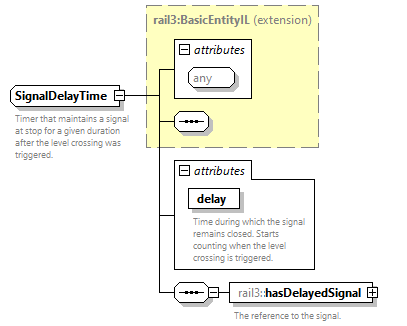 | ||||||||||||||
| namespace | https://www.railml.org/schemas/3.2 | ||||||||||||||
| type | extension of rail3:BasicEntityIL | ||||||||||||||
| properties |
| ||||||||||||||
| children | rail3:hasDelayedSignal | ||||||||||||||
| used by |
| ||||||||||||||
| attributes |
| ||||||||||||||
| annotation |
| ||||||||||||||
| source | <xs:complexType name="SignalDelayTime"> <xs:annotation> <xs:documentation>Timer that maintains a signal at stop for a given duration after the level crossing was triggered.</xs:documentation> </xs:annotation> <xs:complexContent> <xs:extension base="rail3:BasicEntityIL"> <xs:sequence> <xs:element name="hasDelayedSignal" type="rail3:EntityILref" minOccurs="1" maxOccurs="1"> <xs:annotation> <xs:documentation>The reference to the signal.</xs:documentation> </xs:annotation> </xs:element> </xs:sequence> <xs:attribute name="delay" type="xs:duration" use="required"> <xs:annotation> <xs:documentation>Time during which the signal remains closed. Starts counting when the level crossing is triggered.</xs:documentation> </xs:annotation> </xs:attribute> </xs:extension> </xs:complexContent> </xs:complexType> |
attribute SignalDelayTime/@delay
| type | xs:duration | ||
| properties |
| ||
| annotation |
| ||
| source | <xs:attribute name="delay" type="xs:duration" use="required"> <xs:annotation> <xs:documentation>Time during which the signal remains closed. Starts counting when the level crossing is triggered.</xs:documentation> </xs:annotation> </xs:attribute> |
element SignalDelayTime/hasDelayedSignal
| diagram | 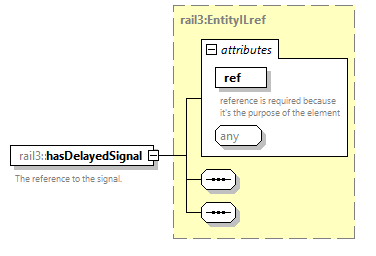 | ||||||||||||||
| namespace | https://www.railml.org/schemas/3.2 | ||||||||||||||
| type | rail3:EntityILref | ||||||||||||||
| properties |
| ||||||||||||||
| attributes |
| ||||||||||||||
| annotation |
| ||||||||||||||
| source | <xs:element name="hasDelayedSignal" type="rail3:EntityILref" minOccurs="1" maxOccurs="1"> <xs:annotation> <xs:documentation>The reference to the signal.</xs:documentation> </xs:annotation> </xs:element> |
complexType SignalIL
| diagram |  | ||||||||||||||||||||||||||||||||||||||||||||||||||||||||||||||||||||||||||||||||||||||||||||||
| namespace | https://www.railml.org/schemas/3.2 | ||||||||||||||||||||||||||||||||||||||||||||||||||||||||||||||||||||||||||||||||||||||||||||||
| type | extension of rail3:TrackAsset | ||||||||||||||||||||||||||||||||||||||||||||||||||||||||||||||||||||||||||||||||||||||||||||||
| properties |
| ||||||||||||||||||||||||||||||||||||||||||||||||||||||||||||||||||||||||||||||||||||||||||||||
| children | rail3:designator rail3:assetName rail3:belongsToOperationalPoint rail3:hasCommand rail3:hasIndication rail3:refersTo rail3:protectsBlockExit rail3:hasRepeater rail3:hasIndicator | ||||||||||||||||||||||||||||||||||||||||||||||||||||||||||||||||||||||||||||||||||||||||||||||
| used by |
| ||||||||||||||||||||||||||||||||||||||||||||||||||||||||||||||||||||||||||||||||||||||||||||||
| attributes |
| ||||||||||||||||||||||||||||||||||||||||||||||||||||||||||||||||||||||||||||||||||||||||||||||
| annotation |
| ||||||||||||||||||||||||||||||||||||||||||||||||||||||||||||||||||||||||||||||||||||||||||||||
| source | <xs:complexType name="SignalIL"> <xs:annotation> <xs:documentation>A signal has an identity attribute, a reference to a signal or sign defined in the RTM scheme. A sign (or ETCS markerboard) indicating a speed change may well be modelled as a signal because the interlocking is likely to issue a different speed code at that sign</xs:documentation> </xs:annotation> <xs:complexContent> <xs:extension base="rail3:TrackAsset"> <xs:sequence> <xs:element name="refersTo" type="rail3:EntityILref" minOccurs="0" maxOccurs="1"> <xs:annotation> <xs:documentation>The reference to the physical trackside signal.</xs:documentation> </xs:annotation> </xs:element> <xs:element name="protectsBlockExit" type="rail3:EntityILref" minOccurs="0" maxOccurs="unbounded"> <xs:annotation> <xs:documentation>reference to the train detection element delimiting station and open block line, which can be reached from this signal by exit route</xs:documentation> </xs:annotation> </xs:element> <xs:element name="hasRepeater" type="rail3:RepeaterSignal" minOccurs="0" maxOccurs="unbounded"> <xs:annotation> <xs:documentation>reference to any repeater signal associated with this signal</xs:documentation> </xs:annotation> </xs:element> <xs:element name="hasIndicator" type="rail3:EntityILref" minOccurs="0" maxOccurs="unbounded"> <xs:annotation> <xs:documentation>reference to virtual logical object used for indication of route status on HMI (route indicators)</xs:documentation> </xs:annotation> </xs:element> </xs:sequence> <xs:attribute name="approachSpeed" type="rail3:tSpeedKmPerHour" use="optional"> <xs:annotation> <xs:documentation>The maximum speed in km/h with which a train can approach the signal. This matches the Ka of the previous (=upstream) signal or speed sign. This is suitable for defining the line speed profile.</xs:documentation> </xs:annotation> </xs:attribute> <xs:attribute name="callOnAspectTime" type="xs:duration" use="optional"> <xs:annotation> <xs:documentation>time for duration to show call-on aspect on this signal</xs:documentation> </xs:annotation> </xs:attribute> <xs:attribute name="function" type="rail3:tSignalFunctionListExt" use="optional"> <xs:annotation> <xs:documentation>Function of the signal for usage by the interlocking. This is in addition to signalType in infrastructure.</xs:documentation> </xs:annotation> </xs:attribute> <xs:attribute name="isNotWired" type="xs:boolean" use="optional"> <xs:annotation> <xs:documentation>Often, users label signals virtual. A virtual signal can be a dummy-signal that is a software object in the interlocking but has no physical trackside presence. Such virtual signals can be useful for modelling speed steps; there need not be a physical signal but the interlocking enforces a different speed at the position of the virtual signal. The other way round, stand-alone boards that are not wired to the interlocking can be labelled virtual. Such stand-alone signals are of interest to simulations because when they affect driver behaviour thus influence train runs.</xs:documentation> </xs:annotation> </xs:attribute> <xs:attribute name="malfunctionSpeed" type="rail3:tSpeedKmPerHour" use="optional"> <xs:annotation> <xs:documentation>This constant indicates the maximum speed in km/h with which a train may travel past a failed signal. The malfunctioning signal cannot be opened.</xs:documentation> </xs:annotation> </xs:attribute> <xs:attribute name="passingSpeed" type="rail3:tSpeedKmPerHour" use="optional"> <xs:annotation> <xs:documentation>Maximum speed in km/h beyond the signal. This is suitable for defining the line speed profile.</xs:documentation> </xs:annotation> </xs:attribute> <xs:attribute name="releaseDelay" type="xs:duration" use="optional"> <xs:annotation> <xs:documentation>Time to elapse between receiving the revocation command and before route release.</xs:documentation> </xs:annotation> </xs:attribute> <xs:attribute name="releaseSpeed" type="rail3:tSpeedKmPerHour" use="optional"> <xs:annotation> <xs:documentation>Release speed in km/h from controlled braking curve.</xs:documentation> </xs:annotation> </xs:attribute> <xs:attribute name="sightDistance" type="rail3:tLengthM" use="optional"> <xs:annotation> <xs:documentation>The distance in metres the signal is visible in advance by the train driver. This might influence reaction times on changing aspects for simulation.</xs:documentation> </xs:annotation> </xs:attribute> </xs:extension> </xs:complexContent> </xs:complexType> |
attribute SignalIL/@approachSpeed
| type | rail3:tSpeedKmPerHour | ||
| properties |
| ||
| annotation |
| ||
| source | <xs:attribute name="approachSpeed" type="rail3:tSpeedKmPerHour" use="optional"> <xs:annotation> <xs:documentation>The maximum speed in km/h with which a train can approach the signal. This matches the Ka of the previous (=upstream) signal or speed sign. This is suitable for defining the line speed profile.</xs:documentation> </xs:annotation> </xs:attribute> |
attribute SignalIL/@callOnAspectTime
| type | xs:duration | ||
| properties |
| ||
| annotation |
| ||
| source | <xs:attribute name="callOnAspectTime" type="xs:duration" use="optional"> <xs:annotation> <xs:documentation>time for duration to show call-on aspect on this signal</xs:documentation> </xs:annotation> </xs:attribute> |
attribute SignalIL/@function
| type | rail3:tSignalFunctionListExt | ||
| properties |
| ||
| annotation |
| ||
| source | <xs:attribute name="function" type="rail3:tSignalFunctionListExt" use="optional"> <xs:annotation> <xs:documentation>Function of the signal for usage by the interlocking. This is in addition to signalType in infrastructure.</xs:documentation> </xs:annotation> </xs:attribute> |
attribute SignalIL/@isNotWired
| type | xs:boolean | ||
| properties |
| ||
| annotation |
| ||
| source | <xs:attribute name="isNotWired" type="xs:boolean" use="optional"> <xs:annotation> <xs:documentation>Often, users label signals virtual. A virtual signal can be a dummy-signal that is a software object in the interlocking but has no physical trackside presence. Such virtual signals can be useful for modelling speed steps; there need not be a physical signal but the interlocking enforces a different speed at the position of the virtual signal. The other way round, stand-alone boards that are not wired to the interlocking can be labelled virtual. Such stand-alone signals are of interest to simulations because when they affect driver behaviour thus influence train runs.</xs:documentation> </xs:annotation> </xs:attribute> |
attribute SignalIL/@malfunctionSpeed
| type | rail3:tSpeedKmPerHour | ||
| properties |
| ||
| annotation |
| ||
| source | <xs:attribute name="malfunctionSpeed" type="rail3:tSpeedKmPerHour" use="optional"> <xs:annotation> <xs:documentation>This constant indicates the maximum speed in km/h with which a train may travel past a failed signal. The malfunctioning signal cannot be opened.</xs:documentation> </xs:annotation> </xs:attribute> |
attribute SignalIL/@passingSpeed
| type | rail3:tSpeedKmPerHour | ||
| properties |
| ||
| annotation |
| ||
| source | <xs:attribute name="passingSpeed" type="rail3:tSpeedKmPerHour" use="optional"> <xs:annotation> <xs:documentation>Maximum speed in km/h beyond the signal. This is suitable for defining the line speed profile.</xs:documentation> </xs:annotation> </xs:attribute> |
attribute SignalIL/@releaseDelay
| type | xs:duration | ||
| properties |
| ||
| annotation |
| ||
| source | <xs:attribute name="releaseDelay" type="xs:duration" use="optional"> <xs:annotation> <xs:documentation>Time to elapse between receiving the revocation command and before route release.</xs:documentation> </xs:annotation> </xs:attribute> |
attribute SignalIL/@releaseSpeed
| type | rail3:tSpeedKmPerHour | ||
| properties |
| ||
| annotation |
| ||
| source | <xs:attribute name="releaseSpeed" type="rail3:tSpeedKmPerHour" use="optional"> <xs:annotation> <xs:documentation>Release speed in km/h from controlled braking curve.</xs:documentation> </xs:annotation> </xs:attribute> |
attribute SignalIL/@sightDistance
| type | rail3:tLengthM | ||
| properties |
| ||
| annotation |
| ||
| source | <xs:attribute name="sightDistance" type="rail3:tLengthM" use="optional"> <xs:annotation> <xs:documentation>The distance in metres the signal is visible in advance by the train driver. This might influence reaction times on changing aspects for simulation.</xs:documentation> </xs:annotation> </xs:attribute> |
element SignalIL/refersTo
| diagram | 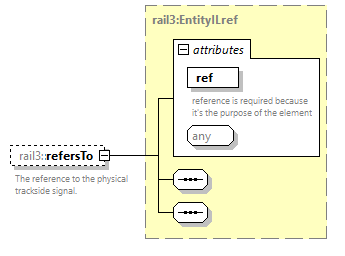 | ||||||||||||||
| namespace | https://www.railml.org/schemas/3.2 | ||||||||||||||
| type | rail3:EntityILref | ||||||||||||||
| properties |
| ||||||||||||||
| attributes |
| ||||||||||||||
| annotation |
| ||||||||||||||
| source | <xs:element name="refersTo" type="rail3:EntityILref" minOccurs="0" maxOccurs="1"> <xs:annotation> <xs:documentation>The reference to the physical trackside signal.</xs:documentation> </xs:annotation> </xs:element> |
element SignalIL/protectsBlockExit
| diagram | 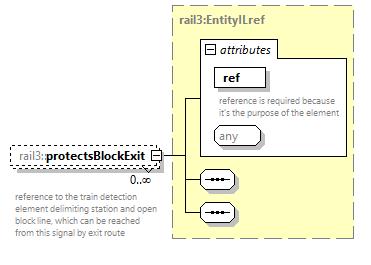 | ||||||||||||||
| namespace | https://www.railml.org/schemas/3.2 | ||||||||||||||
| type | rail3:EntityILref | ||||||||||||||
| properties |
| ||||||||||||||
| attributes |
| ||||||||||||||
| annotation |
| ||||||||||||||
| source | <xs:element name="protectsBlockExit" type="rail3:EntityILref" minOccurs="0" maxOccurs="unbounded"> <xs:annotation> <xs:documentation>reference to the train detection element delimiting station and open block line, which can be reached from this signal by exit route</xs:documentation> </xs:annotation> </xs:element> |
element SignalIL/hasRepeater
| diagram | 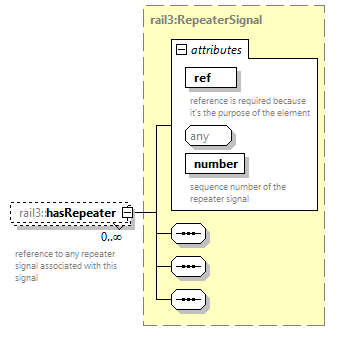 | ||||||||||||||||||||||
| namespace | https://www.railml.org/schemas/3.2 | ||||||||||||||||||||||
| type | rail3:RepeaterSignal | ||||||||||||||||||||||
| properties |
| ||||||||||||||||||||||
| attributes |
| ||||||||||||||||||||||
| annotation |
| ||||||||||||||||||||||
| source | <xs:element name="hasRepeater" type="rail3:RepeaterSignal" minOccurs="0" maxOccurs="unbounded"> <xs:annotation> <xs:documentation>reference to any repeater signal associated with this signal</xs:documentation> </xs:annotation> </xs:element> |
element SignalIL/hasIndicator
| diagram | 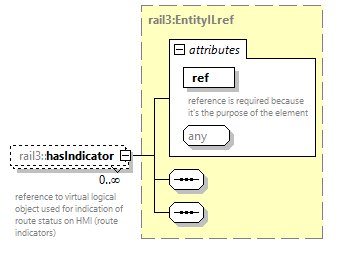 | ||||||||||||||
| namespace | https://www.railml.org/schemas/3.2 | ||||||||||||||
| type | rail3:EntityILref | ||||||||||||||
| properties |
| ||||||||||||||
| attributes |
| ||||||||||||||
| annotation |
| ||||||||||||||
| source | <xs:element name="hasIndicator" type="rail3:EntityILref" minOccurs="0" maxOccurs="unbounded"> <xs:annotation> <xs:documentation>reference to virtual logical object used for indication of route status on HMI (route indicators)</xs:documentation> </xs:annotation> </xs:element> |
complexType SignalIndicator
| diagram | 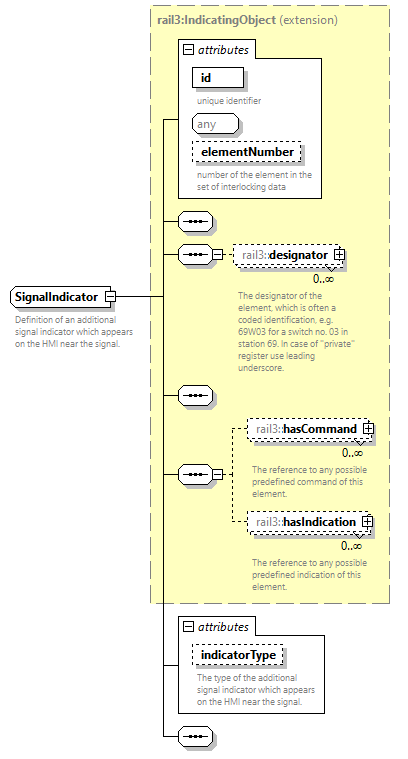 | ||||||||||||||||||||||||||||||
| namespace | https://www.railml.org/schemas/3.2 | ||||||||||||||||||||||||||||||
| type | extension of rail3:IndicatingObject | ||||||||||||||||||||||||||||||
| properties |
| ||||||||||||||||||||||||||||||
| children | rail3:designator rail3:hasCommand rail3:hasIndication | ||||||||||||||||||||||||||||||
| used by |
| ||||||||||||||||||||||||||||||
| attributes |
| ||||||||||||||||||||||||||||||
| annotation |
| ||||||||||||||||||||||||||||||
| source | <xs:complexType name="SignalIndicator"> <xs:annotation> <xs:documentation>Definition of an additional signal indicator which appears on the HMI near the signal.</xs:documentation> </xs:annotation> <xs:complexContent> <xs:extension base="rail3:IndicatingObject"> <xs:sequence/> <xs:attribute name="indicatorType" type="rail3:tSignalIndicatorsListExt" use="optional"> <xs:annotation> <xs:documentation>The type of the additional signal indicator which appears on the HMI near the signal.</xs:documentation> </xs:annotation> </xs:attribute> </xs:extension> </xs:complexContent> </xs:complexType> |
attribute SignalIndicator/@indicatorType
| type | rail3:tSignalIndicatorsListExt | ||
| properties |
| ||
| annotation |
| ||
| source | <xs:attribute name="indicatorType" type="rail3:tSignalIndicatorsListExt" use="optional"> <xs:annotation> <xs:documentation>The type of the additional signal indicator which appears on the HMI near the signal.</xs:documentation> </xs:annotation> </xs:attribute> |
complexType SignalIndicators
| diagram |  | ||
| namespace | https://www.railml.org/schemas/3.2 | ||
| children | rail3:signalIndicator | ||
| used by |
| ||
| annotation |
| ||
| source | <xs:complexType name="SignalIndicators"> <xs:annotation> <xs:documentation>Container for additional signal indicators which appears on the HMI near the signal.</xs:documentation> </xs:annotation> <xs:sequence> <xs:element name="signalIndicator" type="rail3:SignalIndicator" minOccurs="1" maxOccurs="unbounded"> <xs:annotation> <xs:documentation>Definition of an additional signal indicator which appears on the HMI near the signal.</xs:documentation> </xs:annotation> </xs:element> </xs:sequence> </xs:complexType> |
element SignalIndicators/signalIndicator
| diagram | 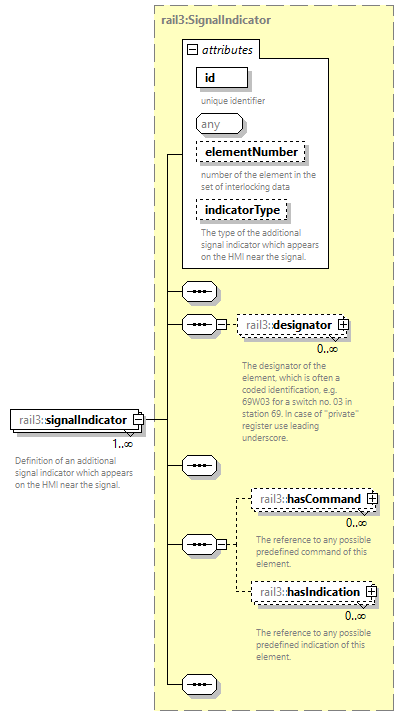 | ||||||||||||||||||||||||||||||
| namespace | https://www.railml.org/schemas/3.2 | ||||||||||||||||||||||||||||||
| type | rail3:SignalIndicator | ||||||||||||||||||||||||||||||
| properties |
| ||||||||||||||||||||||||||||||
| children | rail3:designator rail3:hasCommand rail3:hasIndication | ||||||||||||||||||||||||||||||
| attributes |
| ||||||||||||||||||||||||||||||
| annotation |
| ||||||||||||||||||||||||||||||
| source | <xs:element name="signalIndicator" type="rail3:SignalIndicator" minOccurs="1" maxOccurs="unbounded"> <xs:annotation> <xs:documentation>Definition of an additional signal indicator which appears on the HMI near the signal.</xs:documentation> </xs:annotation> </xs:element> |
complexType SignalPlan
| diagram | 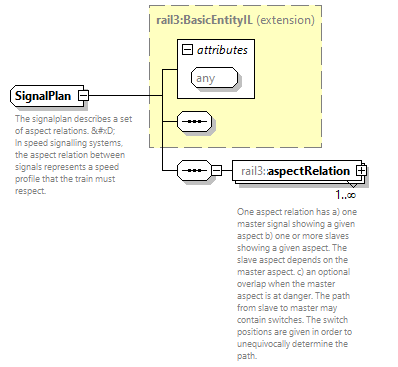 | ||||||
| namespace | https://www.railml.org/schemas/3.2 | ||||||
| type | extension of rail3:BasicEntityIL | ||||||
| properties |
| ||||||
| children | rail3:aspectRelation | ||||||
| used by |
| ||||||
| attributes |
| ||||||
| annotation |
| ||||||
| source | <xs:complexType name="SignalPlan"> <xs:annotation> <xs:documentation>The signalplan describes a set of aspect relations. 
 In speed signalling systems, the aspect relation between signals represents a speed profile that the train must respect.</xs:documentation> </xs:annotation> <xs:complexContent> <xs:extension base="rail3:BasicEntityIL"> <xs:sequence> <xs:element name="aspectRelation" type="rail3:AspectRelation" minOccurs="1" maxOccurs="unbounded"> <xs:annotation> <xs:documentation>One aspect relation has a) one master signal showing a given aspect b) one or more slaves showing a given aspect. The slave aspect depends on the master aspect. c) an optional overlap when the master aspect is at danger. The path from slave to master may contain switches. The switch positions are given in order to unequivocally determine the path.</xs:documentation> </xs:annotation> </xs:element> </xs:sequence> </xs:extension> </xs:complexContent> </xs:complexType> |
element SignalPlan/aspectRelation
| diagram | 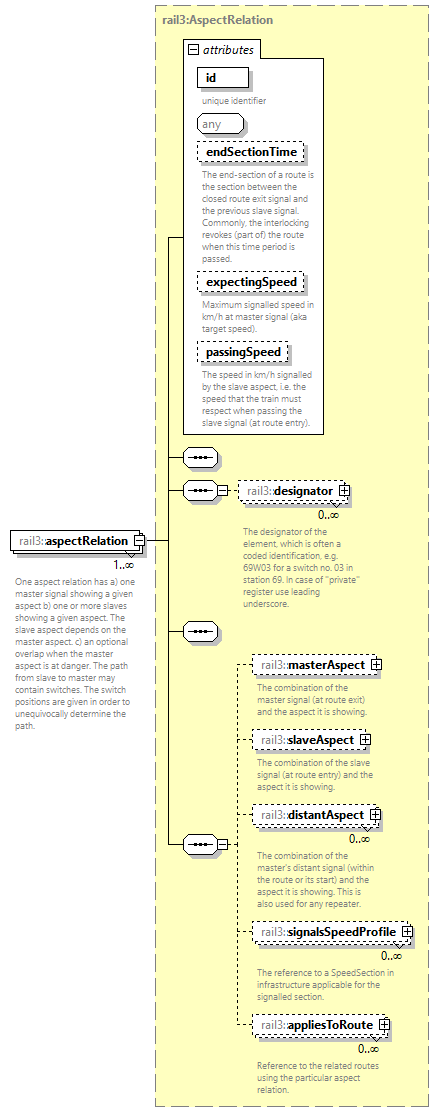 | ||||||||||||||||||||||||||||||||||||||
| namespace | https://www.railml.org/schemas/3.2 | ||||||||||||||||||||||||||||||||||||||
| type | rail3:AspectRelation | ||||||||||||||||||||||||||||||||||||||
| properties |
| ||||||||||||||||||||||||||||||||||||||
| children | rail3:designator rail3:masterAspect rail3:slaveAspect rail3:distantAspect rail3:signalsSpeedProfile rail3:appliesToRoute | ||||||||||||||||||||||||||||||||||||||
| attributes |
| ||||||||||||||||||||||||||||||||||||||
| annotation |
| ||||||||||||||||||||||||||||||||||||||
| source | <xs:element name="aspectRelation" type="rail3:AspectRelation" minOccurs="1" maxOccurs="unbounded"> <xs:annotation> <xs:documentation>One aspect relation has a) one master signal showing a given aspect b) one or more slaves showing a given aspect. The slave aspect depends on the master aspect. c) an optional overlap when the master aspect is at danger. The path from slave to master may contain switches. The switch positions are given in order to unequivocally determine the path.</xs:documentation> </xs:annotation> </xs:element> |
complexType SignalsIL
| diagram |  | ||
| namespace | https://www.railml.org/schemas/3.2 | ||
| children | rail3:signalIL | ||
| used by |
| ||
| annotation |
| ||
| source | <xs:complexType name="SignalsIL"> <xs:annotation> <xs:documentation>container element for all SignalIL elements</xs:documentation> </xs:annotation> <xs:sequence minOccurs="0" maxOccurs="1"> <xs:element name="signalIL" type="rail3:SignalIL" minOccurs="1" maxOccurs="unbounded"> <xs:annotation> <xs:documentation>The signal is a track asset used to transmit information to the train driver represented by its optical appearance.</xs:documentation> </xs:annotation> </xs:element> </xs:sequence> </xs:complexType> |
element SignalsIL/signalIL
| diagram |  | ||||||||||||||||||||||||||||||||||||||||||||||||||||||||||||||||||||||||||||||||||||||||||||||
| namespace | https://www.railml.org/schemas/3.2 | ||||||||||||||||||||||||||||||||||||||||||||||||||||||||||||||||||||||||||||||||||||||||||||||
| type | rail3:SignalIL | ||||||||||||||||||||||||||||||||||||||||||||||||||||||||||||||||||||||||||||||||||||||||||||||
| properties |
| ||||||||||||||||||||||||||||||||||||||||||||||||||||||||||||||||||||||||||||||||||||||||||||||
| children | rail3:designator rail3:assetName rail3:belongsToOperationalPoint rail3:hasCommand rail3:hasIndication rail3:refersTo rail3:protectsBlockExit rail3:hasRepeater rail3:hasIndicator | ||||||||||||||||||||||||||||||||||||||||||||||||||||||||||||||||||||||||||||||||||||||||||||||
| attributes |
| ||||||||||||||||||||||||||||||||||||||||||||||||||||||||||||||||||||||||||||||||||||||||||||||
| annotation |
| ||||||||||||||||||||||||||||||||||||||||||||||||||||||||||||||||||||||||||||||||||||||||||||||
| source | <xs:element name="signalIL" type="rail3:SignalIL" minOccurs="1" maxOccurs="unbounded"> <xs:annotation> <xs:documentation>The signal is a track asset used to transmit information to the train driver represented by its optical appearance.</xs:documentation> </xs:annotation> </xs:element> |
complexType SignalWithAspect
| diagram | 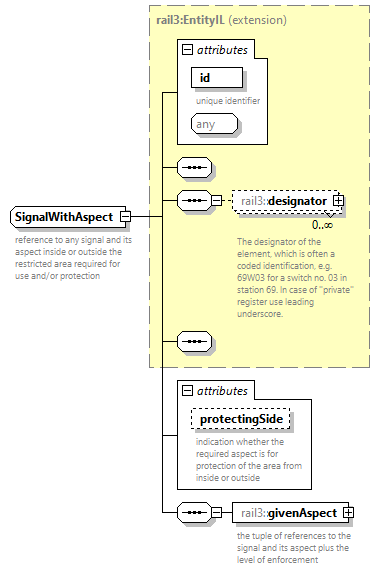 | ||||||||||||||||||||||
| namespace | https://www.railml.org/schemas/3.2 | ||||||||||||||||||||||
| type | extension of rail3:EntityIL | ||||||||||||||||||||||
| properties |
| ||||||||||||||||||||||
| children | rail3:designator rail3:givenAspect | ||||||||||||||||||||||
| used by |
| ||||||||||||||||||||||
| attributes |
| ||||||||||||||||||||||
| annotation |
| ||||||||||||||||||||||
| source | <xs:complexType name="SignalWithAspect"> <xs:annotation> <xs:documentation>reference to any signal and its aspect inside or outside the restricted area required for use and/or protection</xs:documentation> </xs:annotation> <xs:complexContent> <xs:extension base="rail3:EntityIL"> <xs:sequence> <xs:element name="givenAspect" type="rail3:SignalAndGivenAspect" minOccurs="1" maxOccurs="1"> <xs:annotation> <xs:documentation>the tuple of references to the signal and its aspect plus the level of enforcement</xs:documentation> </xs:annotation> </xs:element> </xs:sequence> <xs:attribute name="protectingSide" type="rail3:tProtectingSideList" use="optional"> <xs:annotation> <xs:documentation>indication whether the required aspect is for protection of the area from inside or outside</xs:documentation> </xs:annotation> </xs:attribute> </xs:extension> </xs:complexContent> </xs:complexType> |
attribute SignalWithAspect/@protectingSide
| type | rail3:tProtectingSideList | ||||||||||||||||||
| properties |
| ||||||||||||||||||
| facets |
| ||||||||||||||||||
| annotation |
| ||||||||||||||||||
| source | <xs:attribute name="protectingSide" type="rail3:tProtectingSideList" use="optional"> <xs:annotation> <xs:documentation>indication whether the required aspect is for protection of the area from inside or outside</xs:documentation> </xs:annotation> </xs:attribute> |
element SignalWithAspect/givenAspect
| diagram | 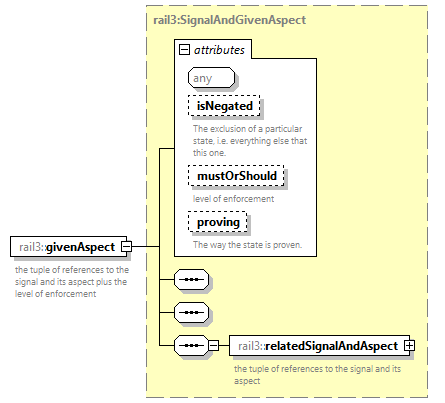 | ||||||||||||||||||||||||||||||
| namespace | https://www.railml.org/schemas/3.2 | ||||||||||||||||||||||||||||||
| type | rail3:SignalAndGivenAspect | ||||||||||||||||||||||||||||||
| properties |
| ||||||||||||||||||||||||||||||
| children | rail3:relatedSignalAndAspect | ||||||||||||||||||||||||||||||
| attributes |
| ||||||||||||||||||||||||||||||
| annotation |
| ||||||||||||||||||||||||||||||
| source | <xs:element name="givenAspect" type="rail3:SignalAndGivenAspect" minOccurs="1" maxOccurs="1"> <xs:annotation> <xs:documentation>the tuple of references to the signal and its aspect plus the level of enforcement</xs:documentation> </xs:annotation> </xs:element> |
complexType StationIndicator
| diagram | 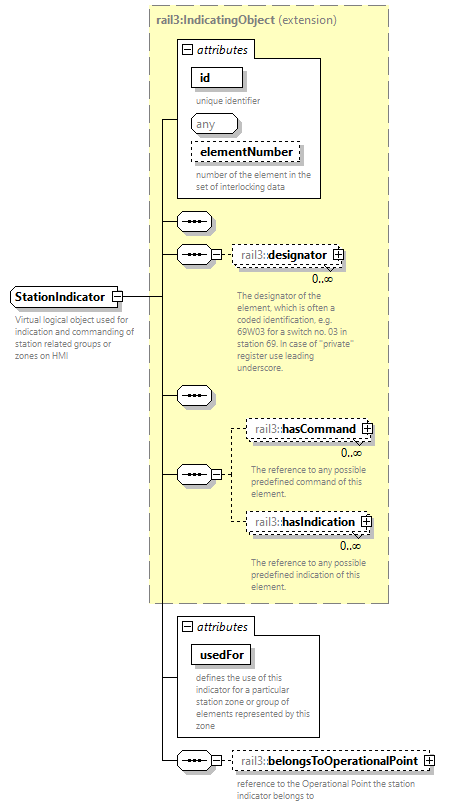 | ||||||||||||||||||||||||||||||
| namespace | https://www.railml.org/schemas/3.2 | ||||||||||||||||||||||||||||||
| type | extension of rail3:IndicatingObject | ||||||||||||||||||||||||||||||
| properties |
| ||||||||||||||||||||||||||||||
| children | rail3:designator rail3:hasCommand rail3:hasIndication rail3:belongsToOperationalPoint | ||||||||||||||||||||||||||||||
| used by |
| ||||||||||||||||||||||||||||||
| attributes |
| ||||||||||||||||||||||||||||||
| annotation |
| ||||||||||||||||||||||||||||||
| source | <xs:complexType name="StationIndicator"> <xs:annotation> <xs:documentation>Virtual logical object used for indication and commanding of station related groups or zones on HMI</xs:documentation> </xs:annotation> <xs:complexContent> <xs:extension base="rail3:IndicatingObject"> <xs:sequence> <xs:element name="belongsToOperationalPoint" type="rail3:EntityILref" minOccurs="0" maxOccurs="1"> <xs:annotation> <xs:documentation>reference to the Operational Point the station indicator belongs to</xs:documentation> </xs:annotation> </xs:element> </xs:sequence> <xs:attribute name="usedFor" type="rail3:tStationZonesListExt" use="required"> <xs:annotation> <xs:documentation>defines the use of this indicator for a particular station zone or group of elements represented by this zone</xs:documentation> </xs:annotation> </xs:attribute> </xs:extension> </xs:complexContent> </xs:complexType> |
attribute StationIndicator/@usedFor
| type | rail3:tStationZonesListExt | ||
| properties |
| ||
| annotation |
| ||
| source | <xs:attribute name="usedFor" type="rail3:tStationZonesListExt" use="required"> <xs:annotation> <xs:documentation>defines the use of this indicator for a particular station zone or group of elements represented by this zone</xs:documentation> </xs:annotation> </xs:attribute> |
element StationIndicator/belongsToOperationalPoint
| diagram | 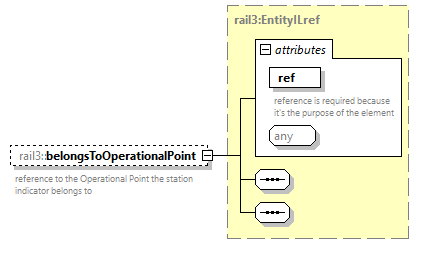 | ||||||||||||||
| namespace | https://www.railml.org/schemas/3.2 | ||||||||||||||
| type | rail3:EntityILref | ||||||||||||||
| properties |
| ||||||||||||||
| attributes |
| ||||||||||||||
| annotation |
| ||||||||||||||
| source | <xs:element name="belongsToOperationalPoint" type="rail3:EntityILref" minOccurs="0" maxOccurs="1"> <xs:annotation> <xs:documentation>reference to the Operational Point the station indicator belongs to</xs:documentation> </xs:annotation> </xs:element> |
complexType StationIndicators
| diagram |  | ||
| namespace | https://www.railml.org/schemas/3.2 | ||
| children | rail3:stationIndicator | ||
| used by |
| ||
| annotation |
| ||
| source | <xs:complexType name="StationIndicators"> <xs:annotation> <xs:documentation>container for virtual logical object used for indication and commanding of station related groups or zones on HMI</xs:documentation> </xs:annotation> <xs:sequence> <xs:element name="stationIndicator" type="rail3:StationIndicator" minOccurs="1" maxOccurs="unbounded"> <xs:annotation> <xs:documentation>Individual virtual logical object used for indication and commanding of station related groups or zones on HMI</xs:documentation> </xs:annotation> </xs:element> </xs:sequence> </xs:complexType> |
element StationIndicators/stationIndicator
| diagram | 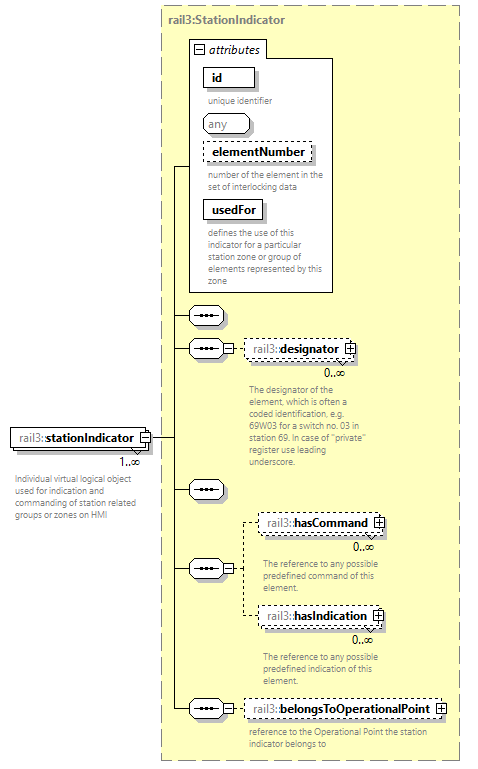 | ||||||||||||||||||||||||||||||
| namespace | https://www.railml.org/schemas/3.2 | ||||||||||||||||||||||||||||||
| type | rail3:StationIndicator | ||||||||||||||||||||||||||||||
| properties |
| ||||||||||||||||||||||||||||||
| children | rail3:designator rail3:hasCommand rail3:hasIndication rail3:belongsToOperationalPoint | ||||||||||||||||||||||||||||||
| attributes |
| ||||||||||||||||||||||||||||||
| annotation |
| ||||||||||||||||||||||||||||||
| source | <xs:element name="stationIndicator" type="rail3:StationIndicator" minOccurs="1" maxOccurs="unbounded"> <xs:annotation> <xs:documentation>Individual virtual logical object used for indication and commanding of station related groups or zones on HMI</xs:documentation> </xs:annotation> </xs:element> |
complexType SwitchAndGivenPosition
| diagram | 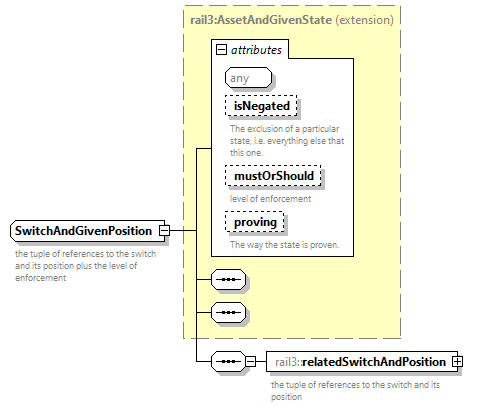 | ||||||||||||||||||||||||||||||
| namespace | https://www.railml.org/schemas/3.2 | ||||||||||||||||||||||||||||||
| type | extension of rail3:AssetAndGivenState | ||||||||||||||||||||||||||||||
| properties |
| ||||||||||||||||||||||||||||||
| children | rail3:relatedSwitchAndPosition | ||||||||||||||||||||||||||||||
| used by |
| ||||||||||||||||||||||||||||||
| attributes |
| ||||||||||||||||||||||||||||||
| annotation |
| ||||||||||||||||||||||||||||||
| source | <xs:complexType name="SwitchAndGivenPosition"> <xs:annotation> <xs:documentation>the tuple of references to the switch and its position plus the level of enforcement</xs:documentation> </xs:annotation> <xs:complexContent> <xs:extension base="rail3:AssetAndGivenState"> <xs:sequence> <xs:element name="relatedSwitchAndPosition" type="rail3:SwitchAndPosition" minOccurs="1" maxOccurs="1"> <xs:annotation> <xs:documentation>the tuple of references to the switch and its position</xs:documentation> </xs:annotation> </xs:element> </xs:sequence> </xs:extension> </xs:complexContent> </xs:complexType> |
element SwitchAndGivenPosition/relatedSwitchAndPosition
| diagram | 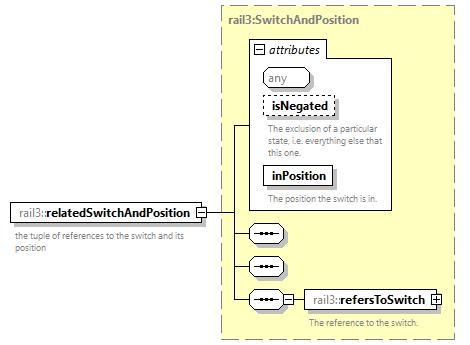 | ||||||||||||||||||||||
| namespace | https://www.railml.org/schemas/3.2 | ||||||||||||||||||||||
| type | rail3:SwitchAndPosition | ||||||||||||||||||||||
| properties |
| ||||||||||||||||||||||
| children | rail3:refersToSwitch | ||||||||||||||||||||||
| attributes |
| ||||||||||||||||||||||
| annotation |
| ||||||||||||||||||||||
| source | <xs:element name="relatedSwitchAndPosition" type="rail3:SwitchAndPosition" minOccurs="1" maxOccurs="1"> <xs:annotation> <xs:documentation>the tuple of references to the switch and its position</xs:documentation> </xs:annotation> </xs:element> |
complexType SwitchAndPosition
| diagram | 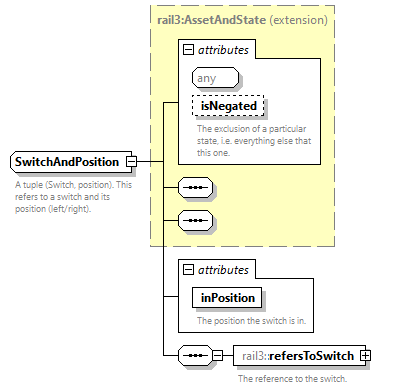 | ||||||||||||||||||||||
| namespace | https://www.railml.org/schemas/3.2 | ||||||||||||||||||||||
| type | extension of rail3:AssetAndState | ||||||||||||||||||||||
| properties |
| ||||||||||||||||||||||
| children | rail3:refersToSwitch | ||||||||||||||||||||||
| used by |
| ||||||||||||||||||||||
| attributes |
| ||||||||||||||||||||||
| annotation |
| ||||||||||||||||||||||
| source | <xs:complexType name="SwitchAndPosition"> <xs:annotation> <xs:documentation>A tuple (Switch, position). This refers to a switch and its position (left/right).</xs:documentation> </xs:annotation> <xs:complexContent> <xs:extension base="rail3:AssetAndState"> <xs:sequence> <xs:element name="refersToSwitch" type="rail3:EntityILref" minOccurs="1" maxOccurs="1"> <xs:annotation> <xs:documentation>The reference to the switch.</xs:documentation> </xs:annotation> </xs:element> </xs:sequence> <xs:attribute name="inPosition" type="rail3:tSwitchPosition" use="required"> <xs:annotation> <xs:documentation>The position the switch is in.</xs:documentation> </xs:annotation> </xs:attribute> </xs:extension> </xs:complexContent> </xs:complexType> |
attribute SwitchAndPosition/@inPosition
| type | rail3:tSwitchPosition | |||||||||||||
| properties |
| |||||||||||||
| facets |
| |||||||||||||
| annotation |
| |||||||||||||
| source | <xs:attribute name="inPosition" type="rail3:tSwitchPosition" use="required"> <xs:annotation> <xs:documentation>The position the switch is in.</xs:documentation> </xs:annotation> </xs:attribute> |
element SwitchAndPosition/refersToSwitch
| diagram | 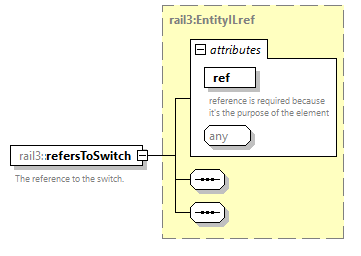 | ||||||||||||||
| namespace | https://www.railml.org/schemas/3.2 | ||||||||||||||
| type | rail3:EntityILref | ||||||||||||||
| properties |
| ||||||||||||||
| attributes |
| ||||||||||||||
| annotation |
| ||||||||||||||
| source | <xs:element name="refersToSwitch" type="rail3:EntityILref" minOccurs="1" maxOccurs="1"> <xs:annotation> <xs:documentation>The reference to the switch.</xs:documentation> </xs:annotation> </xs:element> |
complexType SwitchesIL
| diagram | 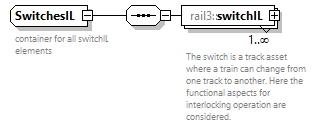 | ||
| namespace | https://www.railml.org/schemas/3.2 | ||
| children | rail3:switchIL | ||
| used by |
| ||
| annotation |
| ||
| source | <xs:complexType name="SwitchesIL"> <xs:annotation> <xs:documentation>container for all switchIL elements</xs:documentation> </xs:annotation> <xs:sequence> <xs:element name="switchIL" type="rail3:SwitchIL" minOccurs="1" maxOccurs="unbounded"> <xs:annotation> <xs:documentation>The switch is a track asset where a train can change from one track to another. Here the functional aspects for interlocking operation are considered.</xs:documentation> </xs:annotation> </xs:element> </xs:sequence> </xs:complexType> |
element SwitchesIL/switchIL
| diagram |  | ||||||||||||||||||||||||||||||||||||||||||||||||||||||||||||||||||||||||||||||||||||
| namespace | https://www.railml.org/schemas/3.2 | ||||||||||||||||||||||||||||||||||||||||||||||||||||||||||||||||||||||||||||||||||||
| type | rail3:SwitchIL | ||||||||||||||||||||||||||||||||||||||||||||||||||||||||||||||||||||||||||||||||||||
| properties |
| ||||||||||||||||||||||||||||||||||||||||||||||||||||||||||||||||||||||||||||||||||||
| children | rail3:designator rail3:assetName rail3:belongsToOperationalPoint rail3:hasCommand rail3:hasIndication rail3:refersTo rail3:hasGaugeClearanceMarker rail3:hasTvdSection rail3:connectedToPowerSupply rail3:relatedMovableElement rail3:hasFoulingTrainDetectors rail3:branchLeft rail3:branchRight rail3:branchTip rail3:hasPositionRestriction | ||||||||||||||||||||||||||||||||||||||||||||||||||||||||||||||||||||||||||||||||||||
| attributes |
| ||||||||||||||||||||||||||||||||||||||||||||||||||||||||||||||||||||||||||||||||||||
| annotation |
| ||||||||||||||||||||||||||||||||||||||||||||||||||||||||||||||||||||||||||||||||||||
| source | <xs:element name="switchIL" type="rail3:SwitchIL" minOccurs="1" maxOccurs="unbounded"> <xs:annotation> <xs:documentation>The switch is a track asset where a train can change from one track to another. Here the functional aspects for interlocking operation are considered.</xs:documentation> </xs:annotation> </xs:element> |
complexType SwitchIL
| diagram |  | ||||||||||||||||||||||||||||||||||||||||||||||||||||||||||||||||||||||||||||||||||||
| namespace | https://www.railml.org/schemas/3.2 | ||||||||||||||||||||||||||||||||||||||||||||||||||||||||||||||||||||||||||||||||||||
| type | extension of rail3:MovableElement | ||||||||||||||||||||||||||||||||||||||||||||||||||||||||||||||||||||||||||||||||||||
| properties |
| ||||||||||||||||||||||||||||||||||||||||||||||||||||||||||||||||||||||||||||||||||||
| children | rail3:designator rail3:assetName rail3:belongsToOperationalPoint rail3:hasCommand rail3:hasIndication rail3:refersTo rail3:hasGaugeClearanceMarker rail3:hasTvdSection rail3:connectedToPowerSupply rail3:relatedMovableElement rail3:hasFoulingTrainDetectors rail3:branchLeft rail3:branchRight rail3:branchTip rail3:hasPositionRestriction | ||||||||||||||||||||||||||||||||||||||||||||||||||||||||||||||||||||||||||||||||||||
| used by |
| ||||||||||||||||||||||||||||||||||||||||||||||||||||||||||||||||||||||||||||||||||||
| attributes |
| ||||||||||||||||||||||||||||||||||||||||||||||||||||||||||||||||||||||||||||||||||||
| annotation |
| ||||||||||||||||||||||||||||||||||||||||||||||||||||||||||||||||||||||||||||||||||||
| source | <xs:complexType name="SwitchIL"> <xs:annotation> <xs:documentation>Extends the infrastructure::switch for IXL purposes. The graph model from RailTopoModel allows the definition of connections between tracks. Thus, one can include or exclude connections between tracks. The name SwitchIL is chosen to reconcile US nomenclature and to avoid a naming conflict with infrastructure domain.</xs:documentation> </xs:annotation> <xs:complexContent> <xs:extension base="rail3:MovableElement"> <xs:sequence> <xs:element name="hasFoulingTrainDetectors" type="rail3:EntityILref" minOccurs="0" maxOccurs="unbounded"> <xs:annotation> <xs:documentation>This is the reference to any train detection device in infrastructure which is located to close to the switch, i.e. the gauge of the switch is not clear when the associated neighbouring TVD section is occupied.</xs:documentation> </xs:annotation> </xs:element> <xs:element name="branchLeft" type="rail3:EntityILref" minOccurs="1" maxOccurs="1"> <xs:annotation> <xs:documentation>This is the reference to the underlying track section in infrastructure of the left branch.</xs:documentation> </xs:annotation> </xs:element> <xs:element name="branchRight" type="rail3:EntityILref" minOccurs="1" maxOccurs="1"> <xs:annotation> <xs:documentation>This is the reference to the underlying track section in infrastructure of the right branch.</xs:documentation> </xs:annotation> </xs:element> <xs:element name="branchTip" type="rail3:EntityILref" minOccurs="0" maxOccurs="1"> <xs:annotation> <xs:documentation>This is the reference to the underlying track section in infrastructure of the tip branch. Especially in case of switch crossing this element is not used.</xs:documentation> </xs:annotation> </xs:element> <xs:element name="hasPositionRestriction" type="rail3:SwitchPositionRestriction" minOccurs="0" maxOccurs="1"> <xs:annotation> <xs:documentation>It defines the position the related element shall have when the switch is to be switched in the given position.</xs:documentation> </xs:annotation> </xs:element> </xs:sequence> <xs:attribute name="preferredPosition" type="rail3:tSwitchPosition" use="optional"> <xs:annotation> <xs:documentation>This is the preferred position of the switch which it is switched to when not in use or in case of both positions required for flank protection.</xs:documentation> </xs:annotation> </xs:attribute> </xs:extension> </xs:complexContent> </xs:complexType> |
attribute SwitchIL/@preferredPosition
| type | rail3:tSwitchPosition | |||||||||||||
| properties |
| |||||||||||||
| facets |
| |||||||||||||
| annotation |
| |||||||||||||
| source | <xs:attribute name="preferredPosition" type="rail3:tSwitchPosition" use="optional"> <xs:annotation> <xs:documentation>This is the preferred position of the switch which it is switched to when not in use or in case of both positions required for flank protection.</xs:documentation> </xs:annotation> </xs:attribute> |
element SwitchIL/hasFoulingTrainDetectors
| diagram | 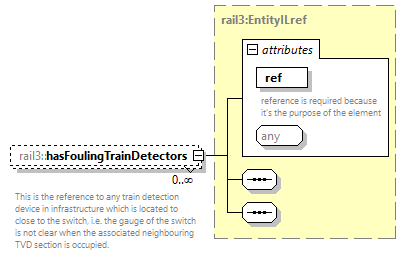 | ||||||||||||||
| namespace | https://www.railml.org/schemas/3.2 | ||||||||||||||
| type | rail3:EntityILref | ||||||||||||||
| properties |
| ||||||||||||||
| attributes |
| ||||||||||||||
| annotation |
| ||||||||||||||
| source | <xs:element name="hasFoulingTrainDetectors" type="rail3:EntityILref" minOccurs="0" maxOccurs="unbounded"> <xs:annotation> <xs:documentation>This is the reference to any train detection device in infrastructure which is located to close to the switch, i.e. the gauge of the switch is not clear when the associated neighbouring TVD section is occupied.</xs:documentation> </xs:annotation> </xs:element> |
element SwitchIL/branchLeft
| diagram | 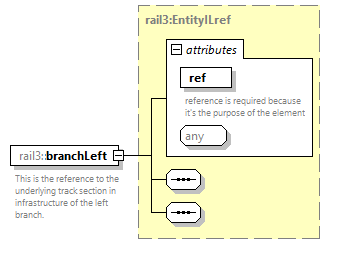 | ||||||||||||||
| namespace | https://www.railml.org/schemas/3.2 | ||||||||||||||
| type | rail3:EntityILref | ||||||||||||||
| properties |
| ||||||||||||||
| attributes |
| ||||||||||||||
| annotation |
| ||||||||||||||
| source | <xs:element name="branchLeft" type="rail3:EntityILref" minOccurs="1" maxOccurs="1"> <xs:annotation> <xs:documentation>This is the reference to the underlying track section in infrastructure of the left branch.</xs:documentation> </xs:annotation> </xs:element> |
element SwitchIL/branchRight
| diagram | 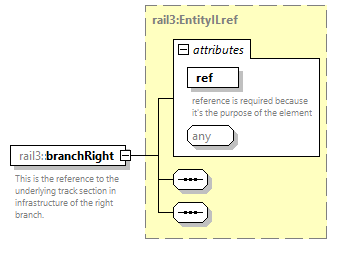 | ||||||||||||||
| namespace | https://www.railml.org/schemas/3.2 | ||||||||||||||
| type | rail3:EntityILref | ||||||||||||||
| properties |
| ||||||||||||||
| attributes |
| ||||||||||||||
| annotation |
| ||||||||||||||
| source | <xs:element name="branchRight" type="rail3:EntityILref" minOccurs="1" maxOccurs="1"> <xs:annotation> <xs:documentation>This is the reference to the underlying track section in infrastructure of the right branch.</xs:documentation> </xs:annotation> </xs:element> |
element SwitchIL/branchTip
| diagram | 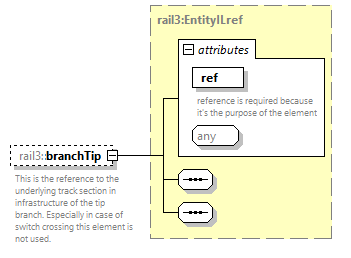 | ||||||||||||||
| namespace | https://www.railml.org/schemas/3.2 | ||||||||||||||
| type | rail3:EntityILref | ||||||||||||||
| properties |
| ||||||||||||||
| attributes |
| ||||||||||||||
| annotation |
| ||||||||||||||
| source | <xs:element name="branchTip" type="rail3:EntityILref" minOccurs="0" maxOccurs="1"> <xs:annotation> <xs:documentation>This is the reference to the underlying track section in infrastructure of the tip branch. Especially in case of switch crossing this element is not used.</xs:documentation> </xs:annotation> </xs:element> |
element SwitchIL/hasPositionRestriction
| diagram | 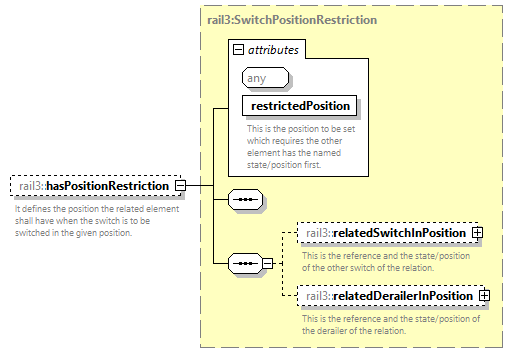 | ||||||||||||||
| namespace | https://www.railml.org/schemas/3.2 | ||||||||||||||
| type | rail3:SwitchPositionRestriction | ||||||||||||||
| properties |
| ||||||||||||||
| children | rail3:relatedSwitchInPosition rail3:relatedDerailerInPosition | ||||||||||||||
| attributes |
| ||||||||||||||
| annotation |
| ||||||||||||||
| source | <xs:element name="hasPositionRestriction" type="rail3:SwitchPositionRestriction" minOccurs="0" maxOccurs="1"> <xs:annotation> <xs:documentation>It defines the position the related element shall have when the switch is to be switched in the given position.</xs:documentation> </xs:annotation> </xs:element> |
complexType SwitchInPosition
| diagram | 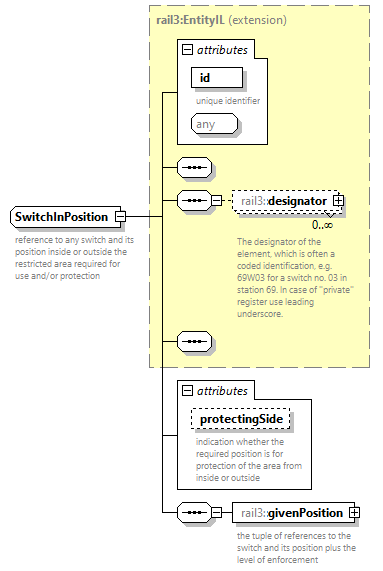 | ||||||||||||||||||||||
| namespace | https://www.railml.org/schemas/3.2 | ||||||||||||||||||||||
| type | extension of rail3:EntityIL | ||||||||||||||||||||||
| properties |
| ||||||||||||||||||||||
| children | rail3:designator rail3:givenPosition | ||||||||||||||||||||||
| used by |
| ||||||||||||||||||||||
| attributes |
| ||||||||||||||||||||||
| annotation |
| ||||||||||||||||||||||
| source | <xs:complexType name="SwitchInPosition"> <xs:annotation> <xs:documentation>reference to any switch and its position inside or outside the restricted area required for use and/or protection</xs:documentation> </xs:annotation> <xs:complexContent> <xs:extension base="rail3:EntityIL"> <xs:sequence> <xs:element name="givenPosition" type="rail3:SwitchAndGivenPosition" minOccurs="1" maxOccurs="1"> <xs:annotation> <xs:documentation>the tuple of references to the switch and its position plus the level of enforcement</xs:documentation> </xs:annotation> </xs:element> </xs:sequence> <xs:attribute name="protectingSide" type="rail3:tProtectingSideList" use="optional"> <xs:annotation> <xs:documentation>indication whether the required position is for protection of the area from inside or outside</xs:documentation> </xs:annotation> </xs:attribute> </xs:extension> </xs:complexContent> </xs:complexType> |
attribute SwitchInPosition/@protectingSide
| type | rail3:tProtectingSideList | ||||||||||||||||||
| properties |
| ||||||||||||||||||
| facets |
| ||||||||||||||||||
| annotation |
| ||||||||||||||||||
| source | <xs:attribute name="protectingSide" type="rail3:tProtectingSideList" use="optional"> <xs:annotation> <xs:documentation>indication whether the required position is for protection of the area from inside or outside</xs:documentation> </xs:annotation> </xs:attribute> |
element SwitchInPosition/givenPosition
| diagram | 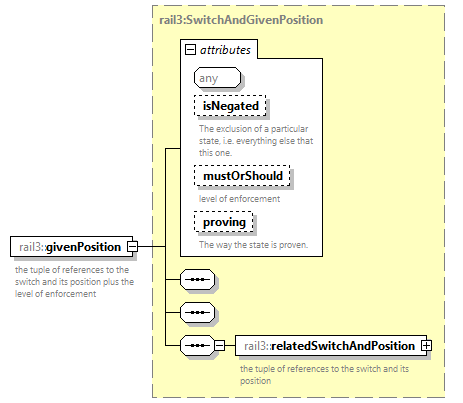 | ||||||||||||||||||||||||||||||
| namespace | https://www.railml.org/schemas/3.2 | ||||||||||||||||||||||||||||||
| type | rail3:SwitchAndGivenPosition | ||||||||||||||||||||||||||||||
| properties |
| ||||||||||||||||||||||||||||||
| children | rail3:relatedSwitchAndPosition | ||||||||||||||||||||||||||||||
| attributes |
| ||||||||||||||||||||||||||||||
| annotation |
| ||||||||||||||||||||||||||||||
| source | <xs:element name="givenPosition" type="rail3:SwitchAndGivenPosition" minOccurs="1" maxOccurs="1"> <xs:annotation> <xs:documentation>the tuple of references to the switch and its position plus the level of enforcement</xs:documentation> </xs:annotation> </xs:element> |
complexType SwitchPositionRestriction
| diagram | 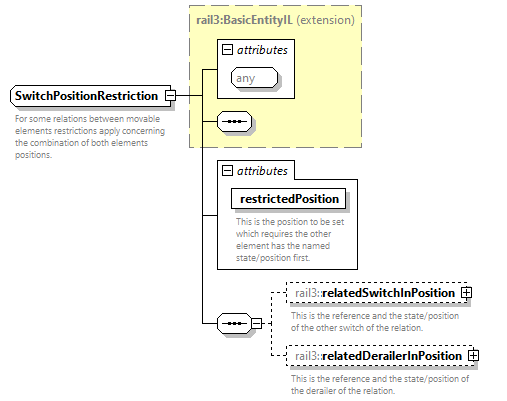 | ||||||||||||||
| namespace | https://www.railml.org/schemas/3.2 | ||||||||||||||
| type | extension of rail3:BasicEntityIL | ||||||||||||||
| properties |
| ||||||||||||||
| children | rail3:relatedSwitchInPosition rail3:relatedDerailerInPosition | ||||||||||||||
| used by |
| ||||||||||||||
| attributes |
| ||||||||||||||
| annotation |
| ||||||||||||||
| source | <xs:complexType name="SwitchPositionRestriction"> <xs:annotation> <xs:documentation>For some relations between movable elements restrictions apply concerning the combination of both elements positions.</xs:documentation> </xs:annotation> <xs:complexContent> <xs:extension base="rail3:BasicEntityIL"> <xs:sequence> <xs:element name="relatedSwitchInPosition" type="rail3:SwitchAndPosition" minOccurs="0" maxOccurs="1"> <xs:annotation> <xs:documentation>This is the reference and the state/position of the other switch of the relation.</xs:documentation> </xs:annotation> </xs:element> <xs:element name="relatedDerailerInPosition" type="rail3:DerailerAndPosition" minOccurs="0" maxOccurs="1"> <xs:annotation> <xs:documentation>This is the reference and the state/position of the derailer of the relation.</xs:documentation> </xs:annotation> </xs:element> </xs:sequence> <xs:attribute name="restrictedPosition" type="rail3:tSwitchPosition" use="required"> <xs:annotation> <xs:documentation>This is the position to be set which requires the other element has the named state/position first.</xs:documentation> </xs:annotation> </xs:attribute> </xs:extension> </xs:complexContent> </xs:complexType> |
attribute SwitchPositionRestriction/@restrictedPosition
| type | rail3:tSwitchPosition | |||||||||||||
| properties |
| |||||||||||||
| facets |
| |||||||||||||
| annotation |
| |||||||||||||
| source | <xs:attribute name="restrictedPosition" type="rail3:tSwitchPosition" use="required"> <xs:annotation> <xs:documentation>This is the position to be set which requires the other element has the named state/position first.</xs:documentation> </xs:annotation> </xs:attribute> |
element SwitchPositionRestriction/relatedSwitchInPosition
| diagram | 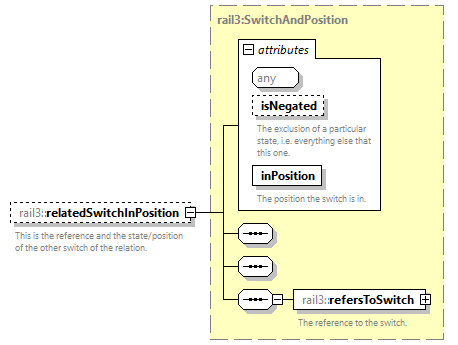 | ||||||||||||||||||||||
| namespace | https://www.railml.org/schemas/3.2 | ||||||||||||||||||||||
| type | rail3:SwitchAndPosition | ||||||||||||||||||||||
| properties |
| ||||||||||||||||||||||
| children | rail3:refersToSwitch | ||||||||||||||||||||||
| attributes |
| ||||||||||||||||||||||
| annotation |
| ||||||||||||||||||||||
| source | <xs:element name="relatedSwitchInPosition" type="rail3:SwitchAndPosition" minOccurs="0" maxOccurs="1"> <xs:annotation> <xs:documentation>This is the reference and the state/position of the other switch of the relation.</xs:documentation> </xs:annotation> </xs:element> |
element SwitchPositionRestriction/relatedDerailerInPosition
| diagram | 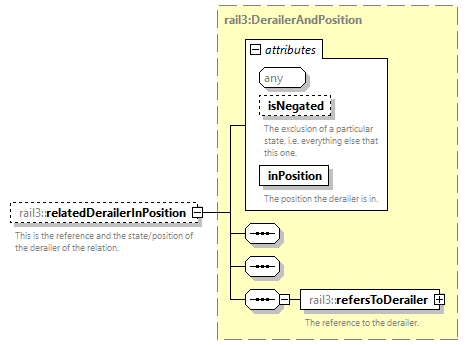 | ||||||||||||||||||||||
| namespace | https://www.railml.org/schemas/3.2 | ||||||||||||||||||||||
| type | rail3:DerailerAndPosition | ||||||||||||||||||||||
| properties |
| ||||||||||||||||||||||
| children | rail3:refersToDerailer | ||||||||||||||||||||||
| attributes |
| ||||||||||||||||||||||
| annotation |
| ||||||||||||||||||||||
| source | <xs:element name="relatedDerailerInPosition" type="rail3:DerailerAndPosition" minOccurs="0" maxOccurs="1"> <xs:annotation> <xs:documentation>This is the reference and the state/position of the derailer of the relation.</xs:documentation> </xs:annotation> </xs:element> |
complexType SwitchRelatedDelay
| diagram | 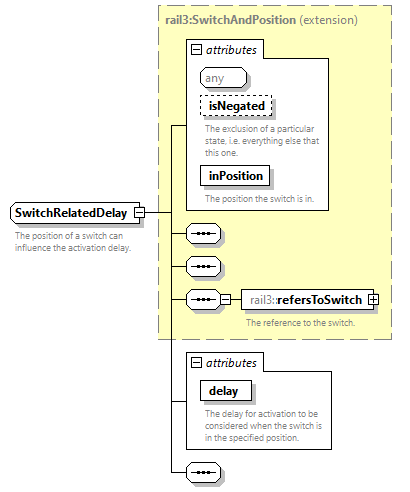 | ||||||||||||||||||||||||||||||
| namespace | https://www.railml.org/schemas/3.2 | ||||||||||||||||||||||||||||||
| type | extension of rail3:SwitchAndPosition | ||||||||||||||||||||||||||||||
| properties |
| ||||||||||||||||||||||||||||||
| children | rail3:refersToSwitch | ||||||||||||||||||||||||||||||
| used by |
| ||||||||||||||||||||||||||||||
| attributes |
| ||||||||||||||||||||||||||||||
| annotation |
| ||||||||||||||||||||||||||||||
| source | <xs:complexType name="SwitchRelatedDelay"> <xs:annotation> <xs:documentation>The position of a switch can influence the activation delay.</xs:documentation> </xs:annotation> <xs:complexContent> <xs:extension base="rail3:SwitchAndPosition"> <xs:sequence/> <xs:attribute name="delay" type="xs:duration" use="required"> <xs:annotation> <xs:documentation>The delay for activation to be considered when the switch is in the specified position.</xs:documentation> </xs:annotation> </xs:attribute> </xs:extension> </xs:complexContent> </xs:complexType> |
attribute SwitchRelatedDelay/@delay
| type | xs:duration | ||
| properties |
| ||
| annotation |
| ||
| source | <xs:attribute name="delay" type="xs:duration" use="required"> <xs:annotation> <xs:documentation>The delay for activation to be considered when the switch is in the specified position.</xs:documentation> </xs:annotation> </xs:attribute> |
complexType SystemAsset
| diagram | 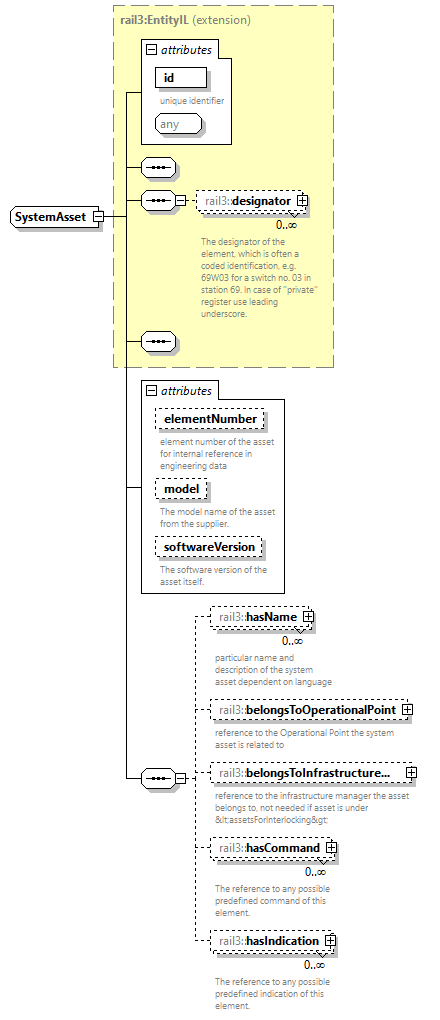 | ||||||||||||||||||||||||||||||||||||||
| namespace | https://www.railml.org/schemas/3.2 | ||||||||||||||||||||||||||||||||||||||
| type | extension of rail3:EntityIL | ||||||||||||||||||||||||||||||||||||||
| properties |
| ||||||||||||||||||||||||||||||||||||||
| children | rail3:designator rail3:hasName rail3:belongsToOperationalPoint rail3:belongsToInfrastructureManager rail3:hasCommand rail3:hasIndication | ||||||||||||||||||||||||||||||||||||||
| used by |
| ||||||||||||||||||||||||||||||||||||||
| attributes |
| ||||||||||||||||||||||||||||||||||||||
| source | <xs:complexType name="SystemAsset"> <xs:complexContent> <xs:extension base="rail3:EntityIL"> <xs:sequence> <xs:element name="hasName" type="rail3:Name" minOccurs="0" maxOccurs="unbounded"> <xs:annotation> <xs:documentation>particular name and description of the system asset dependent on language</xs:documentation> </xs:annotation> </xs:element> <xs:element name="belongsToOperationalPoint" type="rail3:EntityILref" minOccurs="0" maxOccurs="1"> <xs:annotation> <xs:documentation>reference to the Operational Point the system asset is related to</xs:documentation> </xs:annotation> </xs:element> <xs:element name="belongsToInfrastructureManager" type="rail3:EntityILref" minOccurs="0" maxOccurs="1"> <xs:annotation> <xs:documentation>reference to the infrastructure manager the asset belongs to, not needed if asset is under <assetsForInterlocking></xs:documentation> </xs:annotation> </xs:element> <xs:element name="hasCommand" type="rail3:CodedEntityILref" minOccurs="0" maxOccurs="unbounded"> <xs:annotation> <xs:documentation>The reference to any possible predefined command of this element.</xs:documentation> </xs:annotation> </xs:element> <xs:element name="hasIndication" type="rail3:CodedEntityILref" minOccurs="0" maxOccurs="unbounded"> <xs:annotation> <xs:documentation>The reference to any possible predefined indication of this element.</xs:documentation> </xs:annotation> </xs:element> </xs:sequence> <xs:attribute name="elementNumber" type="xs:nonNegativeInteger" use="optional"> <xs:annotation> <xs:documentation>element number of the asset for internal reference in engineering data</xs:documentation> </xs:annotation> </xs:attribute> <xs:attribute name="model" type="xs:string" use="optional"> <xs:annotation> <xs:documentation>The model name of the asset from the supplier.</xs:documentation> </xs:annotation> </xs:attribute> <xs:attribute name="softwareVersion" type="xs:string" use="optional"> <xs:annotation> <xs:documentation>The software version of the asset itself.</xs:documentation> </xs:annotation> </xs:attribute> </xs:extension> </xs:complexContent> </xs:complexType> |
attribute SystemAsset/@elementNumber
| type | xs:nonNegativeInteger | ||
| properties |
| ||
| annotation |
| ||
| source | <xs:attribute name="elementNumber" type="xs:nonNegativeInteger" use="optional"> <xs:annotation> <xs:documentation>element number of the asset for internal reference in engineering data</xs:documentation> </xs:annotation> </xs:attribute> |
attribute SystemAsset/@model
| type | xs:string | ||
| properties |
| ||
| annotation |
| ||
| source | <xs:attribute name="model" type="xs:string" use="optional"> <xs:annotation> <xs:documentation>The model name of the asset from the supplier.</xs:documentation> </xs:annotation> </xs:attribute> |
attribute SystemAsset/@softwareVersion
| type | xs:string | ||
| properties |
| ||
| annotation |
| ||
| source | <xs:attribute name="softwareVersion" type="xs:string" use="optional"> <xs:annotation> <xs:documentation>The software version of the asset itself.</xs:documentation> </xs:annotation> </xs:attribute> |
element SystemAsset/hasName
| diagram | 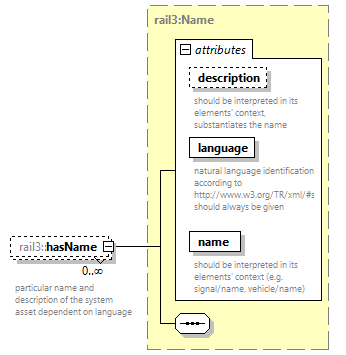 | ||||||||||||||||||||||||||||||
| namespace | https://www.railml.org/schemas/3.2 | ||||||||||||||||||||||||||||||
| type | rail3:Name | ||||||||||||||||||||||||||||||
| properties |
| ||||||||||||||||||||||||||||||
| attributes |
| ||||||||||||||||||||||||||||||
| annotation |
| ||||||||||||||||||||||||||||||
| source | <xs:element name="hasName" type="rail3:Name" minOccurs="0" maxOccurs="unbounded"> <xs:annotation> <xs:documentation>particular name and description of the system asset dependent on language</xs:documentation> </xs:annotation> </xs:element> |
element SystemAsset/belongsToOperationalPoint
| diagram | 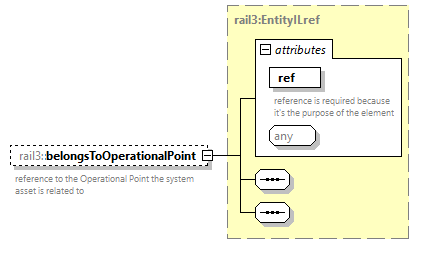 | ||||||||||||||
| namespace | https://www.railml.org/schemas/3.2 | ||||||||||||||
| type | rail3:EntityILref | ||||||||||||||
| properties |
| ||||||||||||||
| attributes |
| ||||||||||||||
| annotation |
| ||||||||||||||
| source | <xs:element name="belongsToOperationalPoint" type="rail3:EntityILref" minOccurs="0" maxOccurs="1"> <xs:annotation> <xs:documentation>reference to the Operational Point the system asset is related to</xs:documentation> </xs:annotation> </xs:element> |
element SystemAsset/belongsToInfrastructureManager
| diagram | 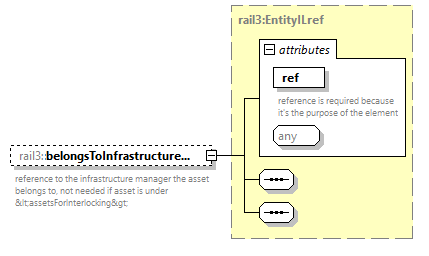 | ||||||||||||||
| namespace | https://www.railml.org/schemas/3.2 | ||||||||||||||
| type | rail3:EntityILref | ||||||||||||||
| properties |
| ||||||||||||||
| attributes |
| ||||||||||||||
| annotation |
| ||||||||||||||
| source | <xs:element name="belongsToInfrastructureManager" type="rail3:EntityILref" minOccurs="0" maxOccurs="1"> <xs:annotation> <xs:documentation>reference to the infrastructure manager the asset belongs to, not needed if asset is under <assetsForInterlocking></xs:documentation> </xs:annotation> </xs:element> |
element SystemAsset/hasCommand
| diagram | 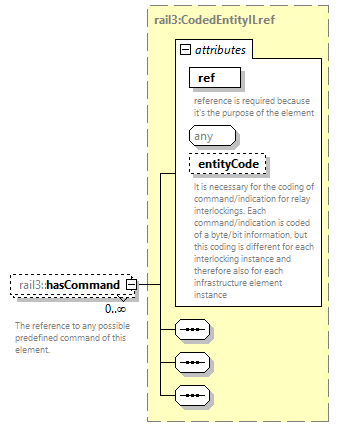 | ||||||||||||||||||||||
| namespace | https://www.railml.org/schemas/3.2 | ||||||||||||||||||||||
| type | rail3:CodedEntityILref | ||||||||||||||||||||||
| properties |
| ||||||||||||||||||||||
| attributes |
| ||||||||||||||||||||||
| annotation |
| ||||||||||||||||||||||
| source | <xs:element name="hasCommand" type="rail3:CodedEntityILref" minOccurs="0" maxOccurs="unbounded"> <xs:annotation> <xs:documentation>The reference to any possible predefined command of this element.</xs:documentation> </xs:annotation> </xs:element> |
element SystemAsset/hasIndication
| diagram | 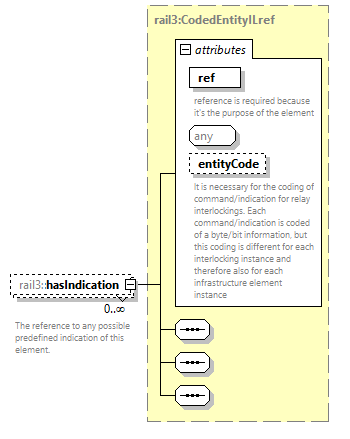 | ||||||||||||||||||||||
| namespace | https://www.railml.org/schemas/3.2 | ||||||||||||||||||||||
| type | rail3:CodedEntityILref | ||||||||||||||||||||||
| properties |
| ||||||||||||||||||||||
| attributes |
| ||||||||||||||||||||||
| annotation |
| ||||||||||||||||||||||
| source | <xs:element name="hasIndication" type="rail3:CodedEntityILref" minOccurs="0" maxOccurs="unbounded"> <xs:annotation> <xs:documentation>The reference to any possible predefined indication of this element.</xs:documentation> </xs:annotation> </xs:element> |
complexType SystemAssetConnectedToIL
| diagram | 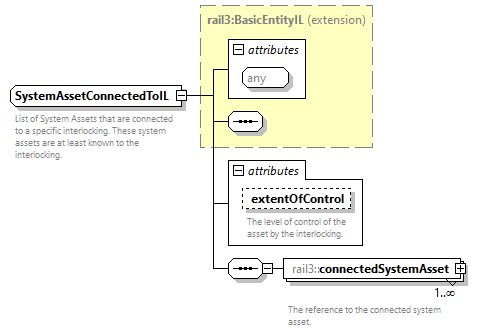 | ||||||||||||||
| namespace | https://www.railml.org/schemas/3.2 | ||||||||||||||
| type | extension of rail3:BasicEntityIL | ||||||||||||||
| properties |
| ||||||||||||||
| children | rail3:connectedSystemAsset | ||||||||||||||
| used by |
| ||||||||||||||
| attributes |
| ||||||||||||||
| annotation |
| ||||||||||||||
| source | <xs:complexType name="SystemAssetConnectedToIL"> <xs:annotation> <xs:documentation>List of System Assets that are connected to a specific interlocking. These system assets are at least known to the interlocking.</xs:documentation> </xs:annotation> <xs:complexContent> <xs:extension base="rail3:BasicEntityIL"> <xs:sequence> <xs:element name="connectedSystemAsset" type="rail3:EntityILref" minOccurs="1" maxOccurs="unbounded"> <xs:annotation> <xs:documentation>The reference to the connected system asset.</xs:documentation> </xs:annotation> </xs:element> </xs:sequence> <xs:attribute name="extentOfControl" type="rail3:tExtentOfControl" use="optional"> <xs:annotation> <xs:documentation>The level of control of the asset by the interlocking.</xs:documentation> </xs:annotation> </xs:attribute> </xs:extension> </xs:complexContent> </xs:complexType> |
attribute SystemAssetConnectedToIL/@extentOfControl
| type | rail3:tExtentOfControl | |||||||||||||||||||||||
| properties |
| |||||||||||||||||||||||
| facets |
| |||||||||||||||||||||||
| annotation |
| |||||||||||||||||||||||
| source | <xs:attribute name="extentOfControl" type="rail3:tExtentOfControl" use="optional"> <xs:annotation> <xs:documentation>The level of control of the asset by the interlocking.</xs:documentation> </xs:annotation> </xs:attribute> |
element SystemAssetConnectedToIL/connectedSystemAsset
| diagram | 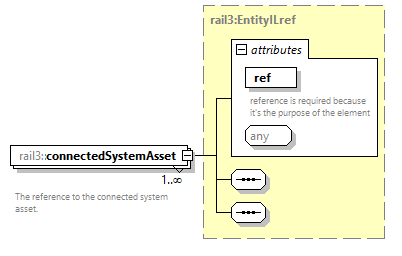 | ||||||||||||||
| namespace | https://www.railml.org/schemas/3.2 | ||||||||||||||
| type | rail3:EntityILref | ||||||||||||||
| properties |
| ||||||||||||||
| attributes |
| ||||||||||||||
| annotation |
| ||||||||||||||
| source | <xs:element name="connectedSystemAsset" type="rail3:EntityILref" minOccurs="1" maxOccurs="unbounded"> <xs:annotation> <xs:documentation>The reference to the connected system asset.</xs:documentation> </xs:annotation> </xs:element> |
complexType tElementWithIDandDesignator
| diagram | 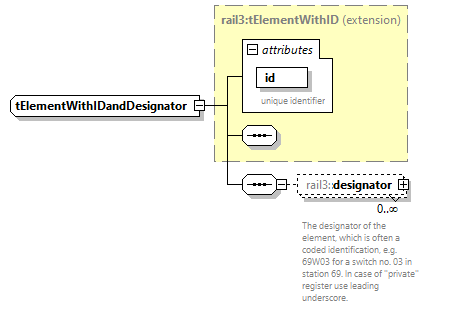 | ||||||||||||||
| namespace | https://www.railml.org/schemas/3.2 | ||||||||||||||
| type | extension of rail3:tElementWithID | ||||||||||||||
| properties |
| ||||||||||||||
| children | rail3:designator | ||||||||||||||
| used by |
| ||||||||||||||
| attributes |
| ||||||||||||||
| source | <xs:complexType name="tElementWithIDandDesignator"> <xs:complexContent> <xs:extension base="rail3:tElementWithID"> <xs:sequence> <xs:element name="designator" type="rail3:Designator" minOccurs="0" maxOccurs="unbounded"> <xs:annotation> <xs:documentation>The designator of the element, which is often a coded identification, e.g. 69W03 for a switch no. 03 in station 69. In case of "private" register use leading underscore.</xs:documentation> </xs:annotation> </xs:element> </xs:sequence> </xs:extension> </xs:complexContent> </xs:complexType> |
element tElementWithIDandDesignator/designator
| diagram | 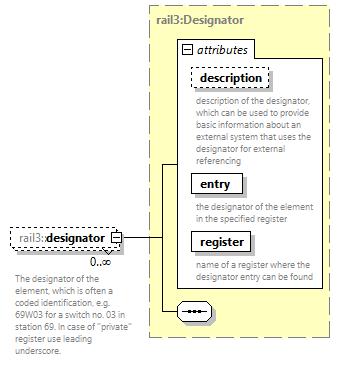 | ||||||||||||||||||||||||||||||
| namespace | https://www.railml.org/schemas/3.2 | ||||||||||||||||||||||||||||||
| type | rail3:Designator | ||||||||||||||||||||||||||||||
| properties |
| ||||||||||||||||||||||||||||||
| attributes |
| ||||||||||||||||||||||||||||||
| annotation |
| ||||||||||||||||||||||||||||||
| source | <xs:element name="designator" type="rail3:Designator" minOccurs="0" maxOccurs="unbounded"> <xs:annotation> <xs:documentation>The designator of the element, which is often a coded identification, e.g. 69W03 for a switch no. 03 in station 69. In case of "private" register use leading underscore.</xs:documentation> </xs:annotation> </xs:element> |
complexType TrackAsset
| diagram | 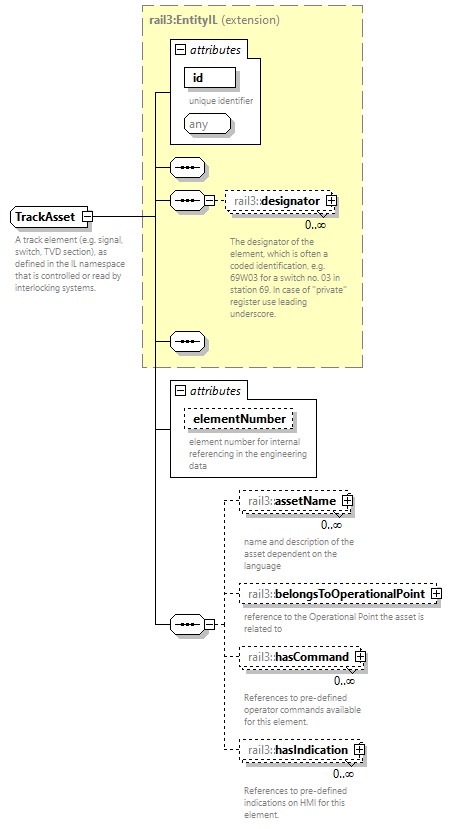 | ||||||||||||||||||||||
| namespace | https://www.railml.org/schemas/3.2 | ||||||||||||||||||||||
| type | extension of rail3:EntityIL | ||||||||||||||||||||||
| properties |
| ||||||||||||||||||||||
| children | rail3:designator rail3:assetName rail3:belongsToOperationalPoint rail3:hasCommand rail3:hasIndication | ||||||||||||||||||||||
| used by |
| ||||||||||||||||||||||
| attributes |
| ||||||||||||||||||||||
| annotation |
| ||||||||||||||||||||||
| source | <xs:complexType name="TrackAsset"> <xs:annotation> <xs:documentation>A track element (e.g. signal, switch, TVD section), as defined in the IL namespace that is controlled or read by interlocking systems.</xs:documentation> </xs:annotation> <xs:complexContent> <xs:extension base="rail3:EntityIL"> <xs:sequence> <xs:element name="assetName" type="rail3:Name" minOccurs="0" maxOccurs="unbounded"> <xs:annotation> <xs:documentation>name and description of the asset dependent on the language</xs:documentation> </xs:annotation> </xs:element> <xs:element name="belongsToOperationalPoint" type="rail3:EntityILref" minOccurs="0" maxOccurs="1"> <xs:annotation> <xs:documentation>reference to the Operational Point the asset is related to</xs:documentation> </xs:annotation> </xs:element> <xs:element name="hasCommand" type="rail3:CodedEntityILref" minOccurs="0" maxOccurs="unbounded"> <xs:annotation> <xs:documentation>References to pre-defined operator commands available for this element.</xs:documentation> </xs:annotation> </xs:element> <xs:element name="hasIndication" type="rail3:CodedEntityILref" minOccurs="0" maxOccurs="unbounded"> <xs:annotation> <xs:documentation>References to pre-defined indications on HMI for this element.</xs:documentation> </xs:annotation> </xs:element> </xs:sequence> <xs:attribute name="elementNumber" type="xs:nonNegativeInteger" use="optional"> <xs:annotation> <xs:documentation>element number for internal referencing in the engineering data</xs:documentation> </xs:annotation> </xs:attribute> </xs:extension> </xs:complexContent> </xs:complexType> |
attribute TrackAsset/@elementNumber
| type | xs:nonNegativeInteger | ||
| properties |
| ||
| annotation |
| ||
| source | <xs:attribute name="elementNumber" type="xs:nonNegativeInteger" use="optional"> <xs:annotation> <xs:documentation>element number for internal referencing in the engineering data</xs:documentation> </xs:annotation> </xs:attribute> |
element TrackAsset/assetName
| diagram | 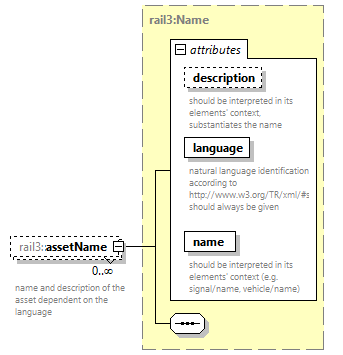 | ||||||||||||||||||||||||||||||
| namespace | https://www.railml.org/schemas/3.2 | ||||||||||||||||||||||||||||||
| type | rail3:Name | ||||||||||||||||||||||||||||||
| properties |
| ||||||||||||||||||||||||||||||
| attributes |
| ||||||||||||||||||||||||||||||
| annotation |
| ||||||||||||||||||||||||||||||
| source | <xs:element name="assetName" type="rail3:Name" minOccurs="0" maxOccurs="unbounded"> <xs:annotation> <xs:documentation>name and description of the asset dependent on the language</xs:documentation> </xs:annotation> </xs:element> |
element TrackAsset/belongsToOperationalPoint
| diagram | 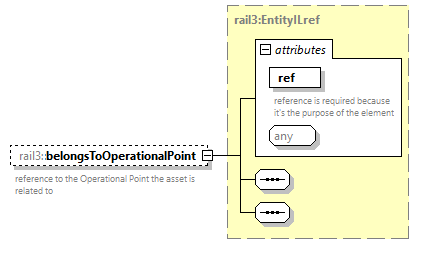 | ||||||||||||||
| namespace | https://www.railml.org/schemas/3.2 | ||||||||||||||
| type | rail3:EntityILref | ||||||||||||||
| properties |
| ||||||||||||||
| attributes |
| ||||||||||||||
| annotation |
| ||||||||||||||
| source | <xs:element name="belongsToOperationalPoint" type="rail3:EntityILref" minOccurs="0" maxOccurs="1"> <xs:annotation> <xs:documentation>reference to the Operational Point the asset is related to</xs:documentation> </xs:annotation> </xs:element> |
element TrackAsset/hasCommand
| diagram | 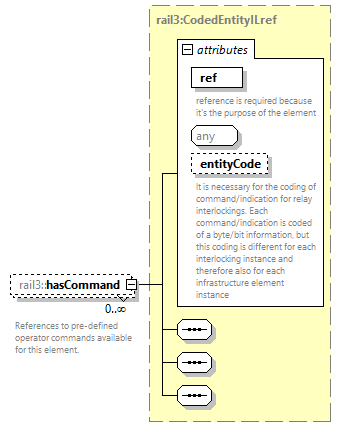 | ||||||||||||||||||||||
| namespace | https://www.railml.org/schemas/3.2 | ||||||||||||||||||||||
| type | rail3:CodedEntityILref | ||||||||||||||||||||||
| properties |
| ||||||||||||||||||||||
| attributes |
| ||||||||||||||||||||||
| annotation |
| ||||||||||||||||||||||
| source | <xs:element name="hasCommand" type="rail3:CodedEntityILref" minOccurs="0" maxOccurs="unbounded"> <xs:annotation> <xs:documentation>References to pre-defined operator commands available for this element.</xs:documentation> </xs:annotation> </xs:element> |
element TrackAsset/hasIndication
| diagram | 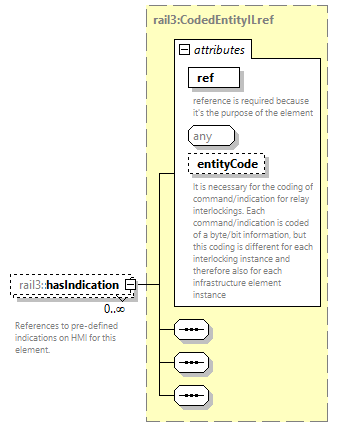 | ||||||||||||||||||||||
| namespace | https://www.railml.org/schemas/3.2 | ||||||||||||||||||||||
| type | rail3:CodedEntityILref | ||||||||||||||||||||||
| properties |
| ||||||||||||||||||||||
| attributes |
| ||||||||||||||||||||||
| annotation |
| ||||||||||||||||||||||
| source | <xs:element name="hasIndication" type="rail3:CodedEntityILref" minOccurs="0" maxOccurs="unbounded"> <xs:annotation> <xs:documentation>References to pre-defined indications on HMI for this element.</xs:documentation> </xs:annotation> </xs:element> |
complexType TrackAssetConnectedToIL
| diagram | 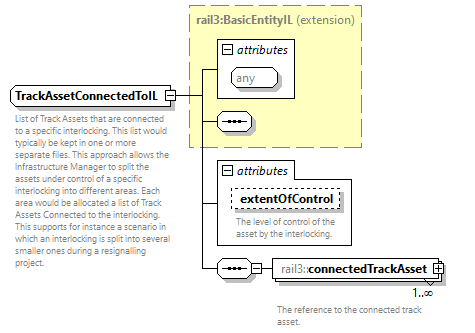 | ||||||||||||||
| namespace | https://www.railml.org/schemas/3.2 | ||||||||||||||
| type | extension of rail3:BasicEntityIL | ||||||||||||||
| properties |
| ||||||||||||||
| children | rail3:connectedTrackAsset | ||||||||||||||
| used by |
| ||||||||||||||
| attributes |
| ||||||||||||||
| annotation |
| ||||||||||||||
| source | <xs:complexType name="TrackAssetConnectedToIL"> <xs:annotation> <xs:documentation>List of Track Assets that are connected to a specific interlocking. This list would typically be kept in one or more separate files. This approach allows the Infrastructure Manager to split the assets under control of a specific interlocking into different areas. Each area would be allocated a list of Track Assets Connected to the interlocking. This supports for instance a scenario in which an interlocking is split into several smaller ones during a resignalling project.</xs:documentation> </xs:annotation> <xs:complexContent> <xs:extension base="rail3:BasicEntityIL"> <xs:sequence> <xs:element name="connectedTrackAsset" type="rail3:EntityILref" minOccurs="1" maxOccurs="unbounded"> <xs:annotation> <xs:documentation>The reference to the connected track asset.</xs:documentation> </xs:annotation> </xs:element> </xs:sequence> <xs:attribute name="extentOfControl" type="rail3:tExtentOfControl" use="optional"> <xs:annotation> <xs:documentation>The level of control of the asset by the interlocking.</xs:documentation> </xs:annotation> </xs:attribute> </xs:extension> </xs:complexContent> </xs:complexType> |
attribute TrackAssetConnectedToIL/@extentOfControl
| type | rail3:tExtentOfControl | |||||||||||||||||||||||
| properties |
| |||||||||||||||||||||||
| facets |
| |||||||||||||||||||||||
| annotation |
| |||||||||||||||||||||||
| source | <xs:attribute name="extentOfControl" type="rail3:tExtentOfControl" use="optional"> <xs:annotation> <xs:documentation>The level of control of the asset by the interlocking.</xs:documentation> </xs:annotation> </xs:attribute> |
element TrackAssetConnectedToIL/connectedTrackAsset
| diagram | 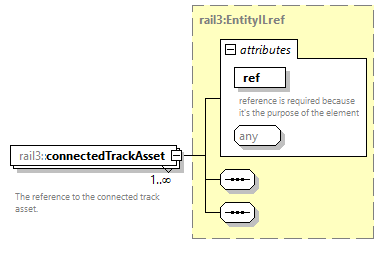 | ||||||||||||||
| namespace | https://www.railml.org/schemas/3.2 | ||||||||||||||
| type | rail3:EntityILref | ||||||||||||||
| properties |
| ||||||||||||||
| attributes |
| ||||||||||||||
| annotation |
| ||||||||||||||
| source | <xs:element name="connectedTrackAsset" type="rail3:EntityILref" minOccurs="1" maxOccurs="unbounded"> <xs:annotation> <xs:documentation>The reference to the connected track asset.</xs:documentation> </xs:annotation> </xs:element> |
complexType TrackIL
| diagram | 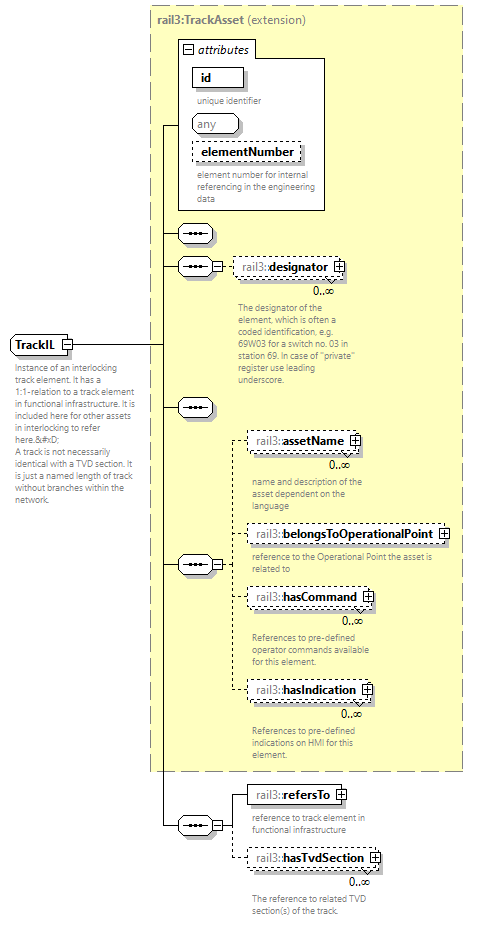 | ||||||||||||||||||||||
| namespace | https://www.railml.org/schemas/3.2 | ||||||||||||||||||||||
| type | extension of rail3:TrackAsset | ||||||||||||||||||||||
| properties |
| ||||||||||||||||||||||
| children | rail3:designator rail3:assetName rail3:belongsToOperationalPoint rail3:hasCommand rail3:hasIndication rail3:refersTo rail3:hasTvdSection | ||||||||||||||||||||||
| used by |
| ||||||||||||||||||||||
| attributes |
| ||||||||||||||||||||||
| annotation |
| ||||||||||||||||||||||
| source | <xs:complexType name="TrackIL"> <xs:annotation> <xs:documentation>Instance of an interlocking track element. It has a 1:1-relation to a track element in functional infrastructure. It is included here for other assets in interlocking to refer here.
 A track is not necessarily identical with a TVD section. It is just a named length of track without branches within the network.</xs:documentation> </xs:annotation> <xs:complexContent> <xs:extension base="rail3:TrackAsset"> <xs:sequence> <xs:element name="refersTo" type="rail3:EntityILref" minOccurs="1" maxOccurs="1"> <xs:annotation> <xs:documentation>reference to track element in functional infrastructure</xs:documentation> </xs:annotation> </xs:element> <xs:element name="hasTvdSection" type="rail3:EntityILref" minOccurs="0" maxOccurs="unbounded"> <xs:annotation> <xs:documentation>The reference to related TVD section(s) of the track.</xs:documentation> </xs:annotation> </xs:element> </xs:sequence> </xs:extension> </xs:complexContent> </xs:complexType> |
element TrackIL/refersTo
| diagram | 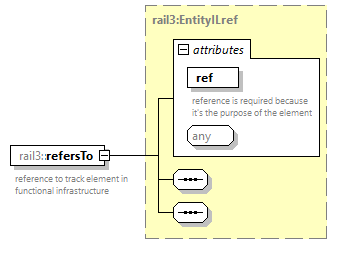 | ||||||||||||||
| namespace | https://www.railml.org/schemas/3.2 | ||||||||||||||
| type | rail3:EntityILref | ||||||||||||||
| properties |
| ||||||||||||||
| attributes |
| ||||||||||||||
| annotation |
| ||||||||||||||
| source | <xs:element name="refersTo" type="rail3:EntityILref" minOccurs="1" maxOccurs="1"> <xs:annotation> <xs:documentation>reference to track element in functional infrastructure</xs:documentation> </xs:annotation> </xs:element> |
element TrackIL/hasTvdSection
| diagram | 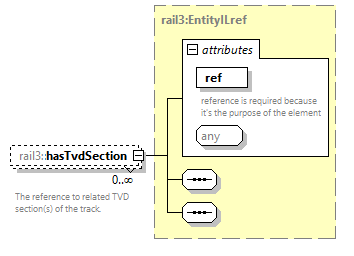 | ||||||||||||||
| namespace | https://www.railml.org/schemas/3.2 | ||||||||||||||
| type | rail3:EntityILref | ||||||||||||||
| properties |
| ||||||||||||||
| attributes |
| ||||||||||||||
| annotation |
| ||||||||||||||
| source | <xs:element name="hasTvdSection" type="rail3:EntityILref" minOccurs="0" maxOccurs="unbounded"> <xs:annotation> <xs:documentation>The reference to related TVD section(s) of the track.</xs:documentation> </xs:annotation> </xs:element> |
complexType TracksIL
| diagram |  | ||
| namespace | https://www.railml.org/schemas/3.2 | ||
| children | rail3:trackIL | ||
| used by |
| ||
| annotation |
| ||
| source | <xs:complexType name="TracksIL"> <xs:annotation> <xs:documentation>container for all track elements in IL part</xs:documentation> </xs:annotation> <xs:sequence> <xs:element name="trackIL" type="rail3:TrackIL" minOccurs="1" maxOccurs="unbounded"> <xs:annotation> <xs:documentation>instance of an interlocking track element</xs:documentation> </xs:annotation> </xs:element> </xs:sequence> </xs:complexType> |
element TracksIL/trackIL
| diagram | 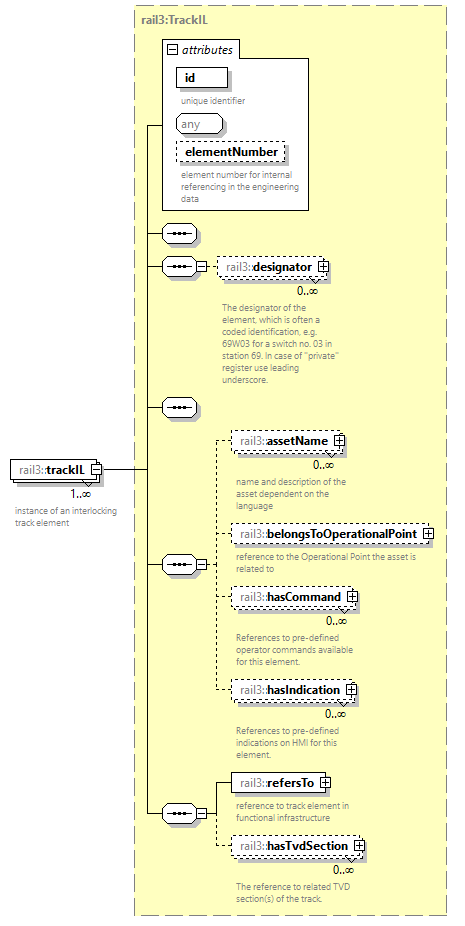 | ||||||||||||||||||||||
| namespace | https://www.railml.org/schemas/3.2 | ||||||||||||||||||||||
| type | rail3:TrackIL | ||||||||||||||||||||||
| properties |
| ||||||||||||||||||||||
| children | rail3:designator rail3:assetName rail3:belongsToOperationalPoint rail3:hasCommand rail3:hasIndication rail3:refersTo rail3:hasTvdSection | ||||||||||||||||||||||
| attributes |
| ||||||||||||||||||||||
| annotation |
| ||||||||||||||||||||||
| source | <xs:element name="trackIL" type="rail3:TrackIL" minOccurs="1" maxOccurs="unbounded"> <xs:annotation> <xs:documentation>instance of an interlocking track element</xs:documentation> </xs:annotation> </xs:element> |
complexType TrainNumberField
| diagram | 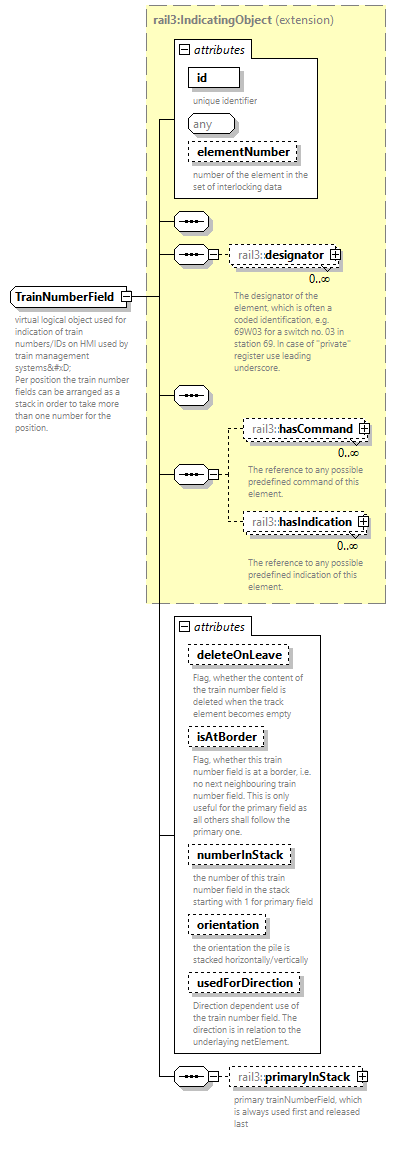 | ||||||||||||||||||||||||||||||||||||||||||||||||||||||||||||||
| namespace | https://www.railml.org/schemas/3.2 | ||||||||||||||||||||||||||||||||||||||||||||||||||||||||||||||
| type | extension of rail3:IndicatingObject | ||||||||||||||||||||||||||||||||||||||||||||||||||||||||||||||
| properties |
| ||||||||||||||||||||||||||||||||||||||||||||||||||||||||||||||
| children | rail3:designator rail3:hasCommand rail3:hasIndication rail3:primaryInStack | ||||||||||||||||||||||||||||||||||||||||||||||||||||||||||||||
| used by |
| ||||||||||||||||||||||||||||||||||||||||||||||||||||||||||||||
| attributes |
| ||||||||||||||||||||||||||||||||||||||||||||||||||||||||||||||
| annotation |
| ||||||||||||||||||||||||||||||||||||||||||||||||||||||||||||||
| source | <xs:complexType name="TrainNumberField"> <xs:annotation> <xs:documentation>virtual logical object used for indication of train numbers/IDs on HMI used by train management systems
 Per position the train number fields can be arranged as a stack in order to take more than one number for the position.</xs:documentation> </xs:annotation> <xs:complexContent> <xs:extension base="rail3:IndicatingObject"> <xs:sequence> <xs:element name="primaryInStack" type="rail3:tElementWithIDref" minOccurs="0" maxOccurs="1"> <xs:annotation> <xs:documentation>primary trainNumberField, which is always used first and released last</xs:documentation> </xs:annotation> </xs:element> </xs:sequence> <xs:attribute name="deleteOnLeave" type="xs:boolean" use="optional"> <xs:annotation> <xs:documentation>Flag, whether the content of the train number field is deleted when the track element becomes empty</xs:documentation> </xs:annotation> </xs:attribute> <xs:attribute name="isAtBorder" type="xs:boolean" use="optional"> <xs:annotation> <xs:documentation>Flag, whether this train number field is at a border, i.e. no next neighbouring train number field. This is only useful for the primary field as all others shall follow the primary one.</xs:documentation> </xs:annotation> </xs:attribute> <xs:attribute name="numberInStack" type="xs:positiveInteger" use="optional"> <xs:annotation> <xs:documentation>the number of this train number field in the stack starting with 1 for primary field</xs:documentation> </xs:annotation> </xs:attribute> <xs:attribute name="orientation" type="rail3:tStackOrientation" use="optional"> <xs:annotation> <xs:documentation>the orientation the pile is stacked horizontally/vertically</xs:documentation> </xs:annotation> </xs:attribute> <xs:attribute name="usedForDirection" type="rail3:tExtendedDirection" use="optional"> <xs:annotation> <xs:documentation>Direction dependent use of the train number field. The direction is in relation to the underlaying netElement.</xs:documentation> </xs:annotation> </xs:attribute> </xs:extension> </xs:complexContent> </xs:complexType> |
attribute TrainNumberField/@deleteOnLeave
| type | xs:boolean | ||
| properties |
| ||
| annotation |
| ||
| source | <xs:attribute name="deleteOnLeave" type="xs:boolean" use="optional"> <xs:annotation> <xs:documentation>Flag, whether the content of the train number field is deleted when the track element becomes empty</xs:documentation> </xs:annotation> </xs:attribute> |
attribute TrainNumberField/@isAtBorder
| type | xs:boolean | ||
| properties |
| ||
| annotation |
| ||
| source | <xs:attribute name="isAtBorder" type="xs:boolean" use="optional"> <xs:annotation> <xs:documentation>Flag, whether this train number field is at a border, i.e. no next neighbouring train number field. This is only useful for the primary field as all others shall follow the primary one.</xs:documentation> </xs:annotation> </xs:attribute> |
attribute TrainNumberField/@numberInStack
| type | xs:positiveInteger | ||
| properties |
| ||
| annotation |
| ||
| source | <xs:attribute name="numberInStack" type="xs:positiveInteger" use="optional"> <xs:annotation> <xs:documentation>the number of this train number field in the stack starting with 1 for primary field</xs:documentation> </xs:annotation> </xs:attribute> |
attribute TrainNumberField/@orientation
| type | rail3:tStackOrientation | |||||||||||||
| properties |
| |||||||||||||
| facets |
| |||||||||||||
| annotation |
| |||||||||||||
| source | <xs:attribute name="orientation" type="rail3:tStackOrientation" use="optional"> <xs:annotation> <xs:documentation>the orientation the pile is stacked horizontally/vertically</xs:documentation> </xs:annotation> </xs:attribute> |
attribute TrainNumberField/@usedForDirection
| type | rail3:tExtendedDirection | ||||||||||||
| properties |
| ||||||||||||
| facets |
| ||||||||||||
| annotation |
| ||||||||||||
| source | <xs:attribute name="usedForDirection" type="rail3:tExtendedDirection" use="optional"> <xs:annotation> <xs:documentation>Direction dependent use of the train number field. The direction is in relation to the underlaying netElement.</xs:documentation> </xs:annotation> </xs:attribute> |
element TrainNumberField/primaryInStack
| diagram | 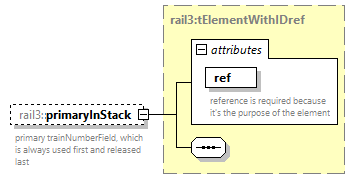 | ||||||||||||||
| namespace | https://www.railml.org/schemas/3.2 | ||||||||||||||
| type | rail3:tElementWithIDref | ||||||||||||||
| properties |
| ||||||||||||||
| attributes |
| ||||||||||||||
| annotation |
| ||||||||||||||
| source | <xs:element name="primaryInStack" type="rail3:tElementWithIDref" minOccurs="0" maxOccurs="1"> <xs:annotation> <xs:documentation>primary trainNumberField, which is always used first and released last</xs:documentation> </xs:annotation> </xs:element> |
complexType TrainNumberFieldRef
| diagram | 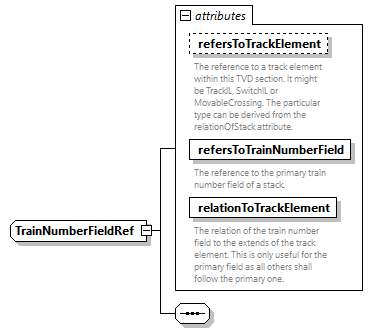 | ||||||||||||||||||||||||||||||
| namespace | https://www.railml.org/schemas/3.2 | ||||||||||||||||||||||||||||||
| used by |
| ||||||||||||||||||||||||||||||
| attributes |
| ||||||||||||||||||||||||||||||
| source | <xs:complexType name="TrainNumberFieldRef"> <xs:sequence/> <xs:attribute name="refersToTrackElement" type="rail3:tRef" use="optional"> <xs:annotation> <xs:documentation>The reference to a track element within this TVD section. It might be TrackIL, SwitchIL or MovableCrossing. The particular type can be derived from the relationOfStack attribute.</xs:documentation> </xs:annotation> </xs:attribute> <xs:attribute name="refersToTrainNumberField" type="rail3:tRef" use="required"> <xs:annotation> <xs:documentation>The reference to the primary train number field of a stack.</xs:documentation> </xs:annotation> </xs:attribute> <xs:attribute name="relationToTrackElement" type="rail3:tStackRelation" use="required"> <xs:annotation> <xs:documentation>The relation of the train number field to the extends of the track element. This is only useful for the primary field as all others shall follow the primary one.</xs:documentation> </xs:annotation> </xs:attribute> </xs:complexType> |
attribute TrainNumberFieldRef/@refersToTrackElement
| type | rail3:tRef | ||
| properties |
| ||
| annotation |
| ||
| source | <xs:attribute name="refersToTrackElement" type="rail3:tRef" use="optional"> <xs:annotation> <xs:documentation>The reference to a track element within this TVD section. It might be TrackIL, SwitchIL or MovableCrossing. The particular type can be derived from the relationOfStack attribute.</xs:documentation> </xs:annotation> </xs:attribute> |
attribute TrainNumberFieldRef/@refersToTrainNumberField
| type | rail3:tRef | ||
| properties |
| ||
| annotation |
| ||
| source | <xs:attribute name="refersToTrainNumberField" type="rail3:tRef" use="required"> <xs:annotation> <xs:documentation>The reference to the primary train number field of a stack.</xs:documentation> </xs:annotation> </xs:attribute> |
attribute TrainNumberFieldRef/@relationToTrackElement
| type | rail3:tStackRelation | |||||||||||||||||||||||||||||||||||||||||||
| properties |
| |||||||||||||||||||||||||||||||||||||||||||
| facets |
| |||||||||||||||||||||||||||||||||||||||||||
| annotation |
| |||||||||||||||||||||||||||||||||||||||||||
| source | <xs:attribute name="relationToTrackElement" type="rail3:tStackRelation" use="required"> <xs:annotation> <xs:documentation>The relation of the train number field to the extends of the track element. This is only useful for the primary field as all others shall follow the primary one.</xs:documentation> </xs:annotation> </xs:attribute> |
complexType TrainNumberFields
| diagram |  | ||
| namespace | https://www.railml.org/schemas/3.2 | ||
| children | rail3:trainNumberField | ||
| used by |
| ||
| annotation |
| ||
| source | <xs:complexType name="TrainNumberFields"> <xs:annotation> <xs:documentation>container for virtual logical object used for indication of train numbers/IDs on HMI</xs:documentation> </xs:annotation> <xs:sequence> <xs:element name="trainNumberField" type="rail3:TrainNumberField" minOccurs="1" maxOccurs="unbounded"> <xs:annotation> <xs:documentation>virtual logical object used for indication of train numbers/IDs on HMI</xs:documentation> </xs:annotation> </xs:element> </xs:sequence> </xs:complexType> |
element TrainNumberFields/trainNumberField
| diagram | 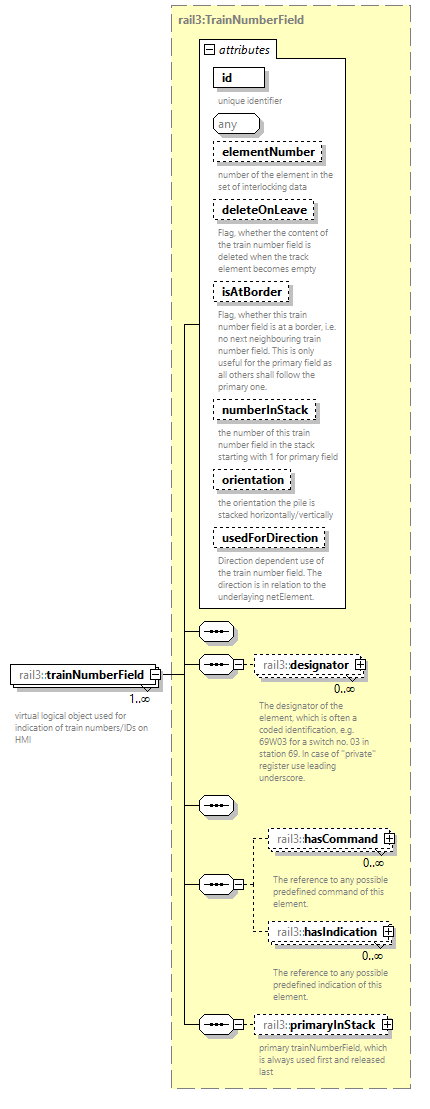 | ||||||||||||||||||||||||||||||||||||||||||||||||||||||||||||||
| namespace | https://www.railml.org/schemas/3.2 | ||||||||||||||||||||||||||||||||||||||||||||||||||||||||||||||
| type | rail3:TrainNumberField | ||||||||||||||||||||||||||||||||||||||||||||||||||||||||||||||
| properties |
| ||||||||||||||||||||||||||||||||||||||||||||||||||||||||||||||
| children | rail3:designator rail3:hasCommand rail3:hasIndication rail3:primaryInStack | ||||||||||||||||||||||||||||||||||||||||||||||||||||||||||||||
| attributes |
| ||||||||||||||||||||||||||||||||||||||||||||||||||||||||||||||
| annotation |
| ||||||||||||||||||||||||||||||||||||||||||||||||||||||||||||||
| source | <xs:element name="trainNumberField" type="rail3:TrainNumberField" minOccurs="1" maxOccurs="unbounded"> <xs:annotation> <xs:documentation>virtual logical object used for indication of train numbers/IDs on HMI</xs:documentation> </xs:annotation> </xs:element> |
complexType TunnelGateAndGivenState
| diagram | 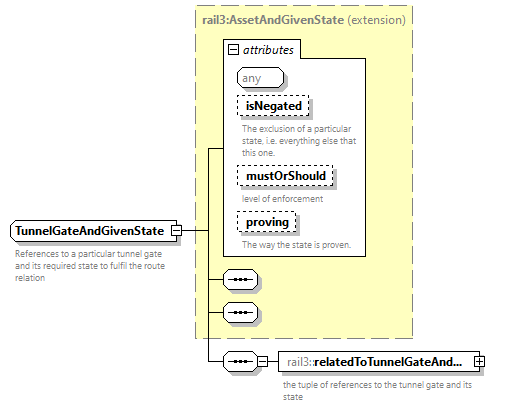 | ||||||||||||||||||||||||||||||
| namespace | https://www.railml.org/schemas/3.2 | ||||||||||||||||||||||||||||||
| type | extension of rail3:AssetAndGivenState | ||||||||||||||||||||||||||||||
| properties |
| ||||||||||||||||||||||||||||||
| children | rail3:relatedToTunnelGateAndState | ||||||||||||||||||||||||||||||
| used by |
| ||||||||||||||||||||||||||||||
| attributes |
| ||||||||||||||||||||||||||||||
| annotation |
| ||||||||||||||||||||||||||||||
| source | <xs:complexType name="TunnelGateAndGivenState"> <xs:annotation> <xs:documentation>References to a particular tunnel gate and its required state to fulfil the route relation</xs:documentation> </xs:annotation> <xs:complexContent> <xs:extension base="rail3:AssetAndGivenState"> <xs:sequence> <xs:element name="relatedToTunnelGateAndState" type="rail3:TunnelGateState" minOccurs="1" maxOccurs="1"> <xs:annotation> <xs:documentation>the tuple of references to the tunnel gate and its state</xs:documentation> </xs:annotation> </xs:element> </xs:sequence> </xs:extension> </xs:complexContent> </xs:complexType> |
element TunnelGateAndGivenState/relatedToTunnelGateAndState
| diagram | 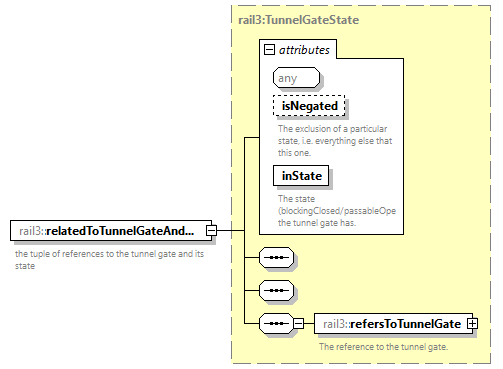 | ||||||||||||||||||||||
| namespace | https://www.railml.org/schemas/3.2 | ||||||||||||||||||||||
| type | rail3:TunnelGateState | ||||||||||||||||||||||
| properties |
| ||||||||||||||||||||||
| children | rail3:refersToTunnelGate | ||||||||||||||||||||||
| attributes |
| ||||||||||||||||||||||
| annotation |
| ||||||||||||||||||||||
| source | <xs:element name="relatedToTunnelGateAndState" type="rail3:TunnelGateState" minOccurs="1" maxOccurs="1"> <xs:annotation> <xs:documentation>the tuple of references to the tunnel gate and its state</xs:documentation> </xs:annotation> </xs:element> |
complexType TunnelGateIL
| diagram |  | ||||||||||||||||||||||||||||||||||||||
| namespace | https://www.railml.org/schemas/3.2 | ||||||||||||||||||||||||||||||||||||||
| type | extension of rail3:TrackAsset | ||||||||||||||||||||||||||||||||||||||
| properties |
| ||||||||||||||||||||||||||||||||||||||
| children | rail3:designator rail3:assetName rail3:belongsToOperationalPoint rail3:hasCommand rail3:hasIndication rail3:refersTo rail3:hasInterface rail3:deactivatedBy rail3:activationCondition rail3:hasTvdSection rail3:hasGateSection | ||||||||||||||||||||||||||||||||||||||
| used by |
| ||||||||||||||||||||||||||||||||||||||
| attributes |
| ||||||||||||||||||||||||||||||||||||||
| annotation |
| ||||||||||||||||||||||||||||||||||||||
| source | <xs:complexType name="TunnelGateIL"> <xs:annotation> <xs:documentation>The tunnel gate is covering a tunnel portal from bad weather conditions like icing. It thus prevents train traffic in blockedClosed position. Dependent on train approach the gate is moved to passableOpen position. The gate movements and positions are controlled by the interlocking system in similar manner like a level crossing.</xs:documentation> </xs:annotation> <xs:complexContent> <xs:extension base="rail3:TrackAsset"> <xs:sequence> <xs:element name="refersTo" type="rail3:EntityILref" minOccurs="1" maxOccurs="1"> <xs:annotation> <xs:documentation>The reference to tunnelGateIS in functionalInfrastructure.</xs:documentation> </xs:annotation> </xs:element> <xs:element name="hasInterface" type="rail3:EntityILref" minOccurs="0" maxOccurs="1"> <xs:annotation> <xs:documentation>The reference to the physical interface used to control the tunnel gate.</xs:documentation> </xs:annotation> </xs:element> <xs:element name="deactivatedBy" type="rail3:BarrierDeactivator" minOccurs="0" maxOccurs="unbounded"> <xs:annotation> <xs:documentation>The list of elements triggering the deactivation (closing into blocked position) of the tunnel gate.</xs:documentation> </xs:annotation> </xs:element> <xs:element name="activationCondition" type="rail3:ActivationCondition" minOccurs="0" maxOccurs="unbounded"> <xs:annotation> <xs:documentation>The conditions for activation (opening into passable position) of the tunnel gate.</xs:documentation> </xs:annotation> </xs:element> <xs:element name="hasTvdSection" type="rail3:EntityILref" minOccurs="0" maxOccurs="unbounded"> <xs:annotation> <xs:documentation>The reference to the TVD sections at the tunnel gate.</xs:documentation> </xs:annotation> </xs:element> <xs:element name="hasGateSection" type="rail3:EntityILref" minOccurs="0" maxOccurs="unbounded"> <xs:annotation> <xs:documentation>The reference to any trackIL elements at the tunnel gate. They are used to collect the activation and deactivation triggers.</xs:documentation> </xs:annotation> </xs:element> </xs:sequence> <xs:attribute name="preferredPosition" type="rail3:tGateStateList" use="optional"> <xs:annotation> <xs:documentation>The preferred position of the tunnel gate. For route dependent gates this would be the blocking position.</xs:documentation> </xs:annotation> </xs:attribute> <xs:attribute name="typicalTimeToOpen" type="xs:duration" use="optional"> <xs:annotation> <xs:documentation>The typical time required to open the tunnel gate, i.e. the time to bring the gate from blocking into the supervised open/passable position.</xs:documentation> </xs:annotation> </xs:attribute> </xs:extension> </xs:complexContent> </xs:complexType> |
attribute TunnelGateIL/@preferredPosition
| type | rail3:tGateStateList | ||||||||||||||||||
| properties |
| ||||||||||||||||||
| facets |
| ||||||||||||||||||
| annotation |
| ||||||||||||||||||
| source | <xs:attribute name="preferredPosition" type="rail3:tGateStateList" use="optional"> <xs:annotation> <xs:documentation>The preferred position of the tunnel gate. For route dependent gates this would be the blocking position.</xs:documentation> </xs:annotation> </xs:attribute> |
attribute TunnelGateIL/@typicalTimeToOpen
| type | xs:duration | ||
| properties |
| ||
| annotation |
| ||
| source | <xs:attribute name="typicalTimeToOpen" type="xs:duration" use="optional"> <xs:annotation> <xs:documentation>The typical time required to open the tunnel gate, i.e. the time to bring the gate from blocking into the supervised open/passable position.</xs:documentation> </xs:annotation> </xs:attribute> |
element TunnelGateIL/refersTo
| diagram | 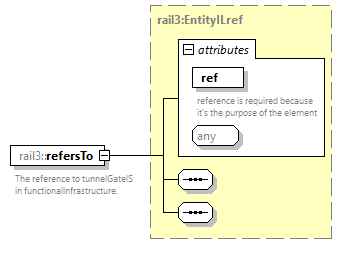 | ||||||||||||||
| namespace | https://www.railml.org/schemas/3.2 | ||||||||||||||
| type | rail3:EntityILref | ||||||||||||||
| properties |
| ||||||||||||||
| attributes |
| ||||||||||||||
| annotation |
| ||||||||||||||
| source | <xs:element name="refersTo" type="rail3:EntityILref" minOccurs="1" maxOccurs="1"> <xs:annotation> <xs:documentation>The reference to tunnelGateIS in functionalInfrastructure.</xs:documentation> </xs:annotation> </xs:element> |
element TunnelGateIL/hasInterface
| diagram | 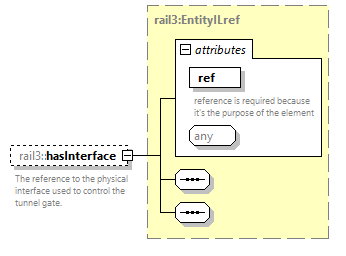 | ||||||||||||||
| namespace | https://www.railml.org/schemas/3.2 | ||||||||||||||
| type | rail3:EntityILref | ||||||||||||||
| properties |
| ||||||||||||||
| attributes |
| ||||||||||||||
| annotation |
| ||||||||||||||
| source | <xs:element name="hasInterface" type="rail3:EntityILref" minOccurs="0" maxOccurs="1"> <xs:annotation> <xs:documentation>The reference to the physical interface used to control the tunnel gate.</xs:documentation> </xs:annotation> </xs:element> |
element TunnelGateIL/deactivatedBy
| diagram | 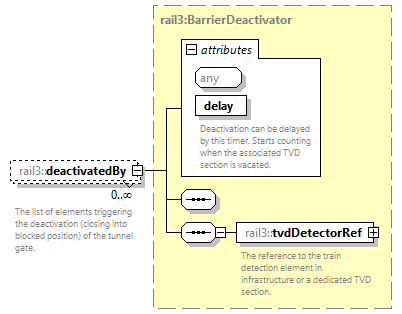 | ||||||||||||||
| namespace | https://www.railml.org/schemas/3.2 | ||||||||||||||
| type | rail3:BarrierDeactivator | ||||||||||||||
| properties |
| ||||||||||||||
| children | rail3:tvdDetectorRef | ||||||||||||||
| attributes |
| ||||||||||||||
| annotation |
| ||||||||||||||
| source | <xs:element name="deactivatedBy" type="rail3:BarrierDeactivator" minOccurs="0" maxOccurs="unbounded"> <xs:annotation> <xs:documentation>The list of elements triggering the deactivation (closing into blocked position) of the tunnel gate.</xs:documentation> </xs:annotation> </xs:element> |
element TunnelGateIL/activationCondition
| diagram | 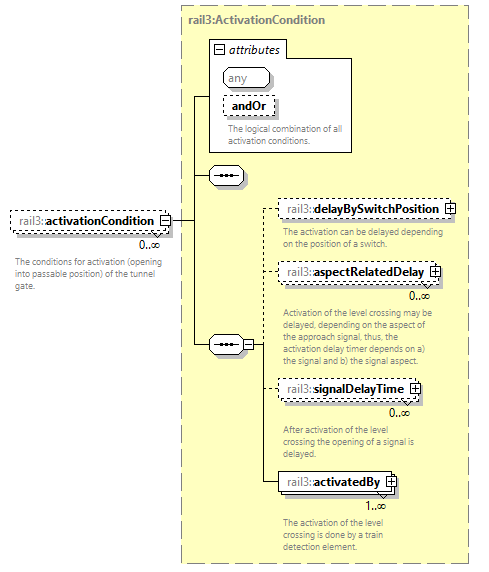 | ||||||||||||||
| namespace | https://www.railml.org/schemas/3.2 | ||||||||||||||
| type | rail3:ActivationCondition | ||||||||||||||
| properties |
| ||||||||||||||
| children | rail3:delayBySwitchPosition rail3:aspectRelatedDelay rail3:signalDelayTime rail3:activatedBy | ||||||||||||||
| attributes |
| ||||||||||||||
| annotation |
| ||||||||||||||
| source | <xs:element name="activationCondition" type="rail3:ActivationCondition" minOccurs="0" maxOccurs="unbounded"> <xs:annotation> <xs:documentation>The conditions for activation (opening into passable position) of the tunnel gate.</xs:documentation> </xs:annotation> </xs:element> |
element TunnelGateIL/hasTvdSection
| diagram | 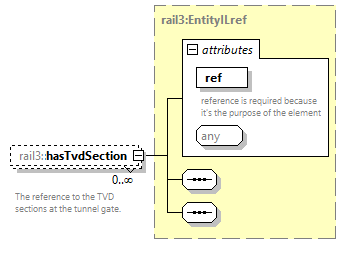 | ||||||||||||||
| namespace | https://www.railml.org/schemas/3.2 | ||||||||||||||
| type | rail3:EntityILref | ||||||||||||||
| properties |
| ||||||||||||||
| attributes |
| ||||||||||||||
| annotation |
| ||||||||||||||
| source | <xs:element name="hasTvdSection" type="rail3:EntityILref" minOccurs="0" maxOccurs="unbounded"> <xs:annotation> <xs:documentation>The reference to the TVD sections at the tunnel gate.</xs:documentation> </xs:annotation> </xs:element> |
element TunnelGateIL/hasGateSection
| diagram | 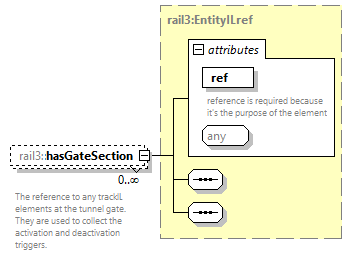 | ||||||||||||||
| namespace | https://www.railml.org/schemas/3.2 | ||||||||||||||
| type | rail3:EntityILref | ||||||||||||||
| properties |
| ||||||||||||||
| attributes |
| ||||||||||||||
| annotation |
| ||||||||||||||
| source | <xs:element name="hasGateSection" type="rail3:EntityILref" minOccurs="0" maxOccurs="unbounded"> <xs:annotation> <xs:documentation>The reference to any trackIL elements at the tunnel gate. They are used to collect the activation and deactivation triggers.</xs:documentation> </xs:annotation> </xs:element> |
complexType TunnelGatesIL
| diagram |  | ||
| namespace | https://www.railml.org/schemas/3.2 | ||
| children | rail3:tunnelGateIL | ||
| used by |
| ||
| annotation |
| ||
| source | <xs:complexType name="TunnelGatesIL"> <xs:annotation> <xs:documentation>contains all tunnelGateIL elements</xs:documentation> </xs:annotation> <xs:sequence> <xs:element name="tunnelGateIL" type="rail3:TunnelGateIL" minOccurs="1" maxOccurs="unbounded"> <xs:annotation> <xs:documentation>The contained tunnelGateIL element</xs:documentation> </xs:annotation> </xs:element> </xs:sequence> </xs:complexType> |
element TunnelGatesIL/tunnelGateIL
| diagram |  | ||||||||||||||||||||||||||||||||||||||
| namespace | https://www.railml.org/schemas/3.2 | ||||||||||||||||||||||||||||||||||||||
| type | rail3:TunnelGateIL | ||||||||||||||||||||||||||||||||||||||
| properties |
| ||||||||||||||||||||||||||||||||||||||
| children | rail3:designator rail3:assetName rail3:belongsToOperationalPoint rail3:hasCommand rail3:hasIndication rail3:refersTo rail3:hasInterface rail3:deactivatedBy rail3:activationCondition rail3:hasTvdSection rail3:hasGateSection | ||||||||||||||||||||||||||||||||||||||
| attributes |
| ||||||||||||||||||||||||||||||||||||||
| annotation |
| ||||||||||||||||||||||||||||||||||||||
| source | <xs:element name="tunnelGateIL" type="rail3:TunnelGateIL" minOccurs="1" maxOccurs="unbounded"> <xs:annotation> <xs:documentation>The contained tunnelGateIL element</xs:documentation> </xs:annotation> </xs:element> |
complexType TunnelGateState
| diagram | 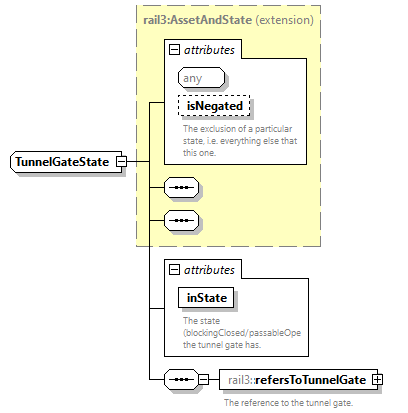 | ||||||||||||||||||||||
| namespace | https://www.railml.org/schemas/3.2 | ||||||||||||||||||||||
| type | extension of rail3:AssetAndState | ||||||||||||||||||||||
| properties |
| ||||||||||||||||||||||
| children | rail3:refersToTunnelGate | ||||||||||||||||||||||
| used by |
| ||||||||||||||||||||||
| attributes |
| ||||||||||||||||||||||
| source | <xs:complexType name="TunnelGateState"> <xs:complexContent> <xs:extension base="rail3:AssetAndState"> <xs:sequence> <xs:element name="refersToTunnelGate" type="rail3:EntityILref" minOccurs="1" maxOccurs="1"> <xs:annotation> <xs:documentation>The reference to the tunnel gate.</xs:documentation> </xs:annotation> </xs:element> </xs:sequence> <xs:attribute name="inState" type="rail3:tGateStateList" use="required"> <xs:annotation> <xs:documentation>The state (blockingClosed/passableOpen) the tunnel gate has.</xs:documentation> </xs:annotation> </xs:attribute> </xs:extension> </xs:complexContent> </xs:complexType> |
attribute TunnelGateState/@inState
| type | rail3:tGateStateList | ||||||||||||||||||
| properties |
| ||||||||||||||||||
| facets |
| ||||||||||||||||||
| annotation |
| ||||||||||||||||||
| source | <xs:attribute name="inState" type="rail3:tGateStateList" use="required"> <xs:annotation> <xs:documentation>The state (blockingClosed/passableOpen) the tunnel gate has.</xs:documentation> </xs:annotation> </xs:attribute> |
element TunnelGateState/refersToTunnelGate
| diagram | 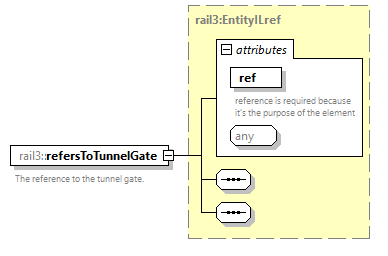 | ||||||||||||||
| namespace | https://www.railml.org/schemas/3.2 | ||||||||||||||
| type | rail3:EntityILref | ||||||||||||||
| properties |
| ||||||||||||||
| attributes |
| ||||||||||||||
| annotation |
| ||||||||||||||
| source | <xs:element name="refersToTunnelGate" type="rail3:EntityILref" minOccurs="1" maxOccurs="1"> <xs:annotation> <xs:documentation>The reference to the tunnel gate.</xs:documentation> </xs:annotation> </xs:element> |
complexType TvdSection
| diagram |  | ||||||||||||||||||||||||||||||||||||||||||||||||||||||||||||||
| namespace | https://www.railml.org/schemas/3.2 | ||||||||||||||||||||||||||||||||||||||||||||||||||||||||||||||
| type | extension of rail3:TrackAsset | ||||||||||||||||||||||||||||||||||||||||||||||||||||||||||||||
| properties |
| ||||||||||||||||||||||||||||||||||||||||||||||||||||||||||||||
| children | rail3:designator rail3:assetName rail3:belongsToOperationalPoint rail3:hasCommand rail3:hasIndication rail3:hasDemarcatingBufferstop rail3:hasExitSignal rail3:hasDemarcatingTraindetector rail3:hasResetStrategy rail3:hasTrainNumberField rail3:hasTrackElement | ||||||||||||||||||||||||||||||||||||||||||||||||||||||||||||||
| used by |
| ||||||||||||||||||||||||||||||||||||||||||||||||||||||||||||||
| attributes |
| ||||||||||||||||||||||||||||||||||||||||||||||||||||||||||||||
| annotation |
| ||||||||||||||||||||||||||||||||||||||||||||||||||||||||||||||
| source | <xs:complexType name="TvdSection"> <xs:annotation> <xs:documentation>A track vacancy detection (TVD) section reports train occupancy to the interlocking. This is a logical unit characterised by the delimiters of the section. Typically, a section is delimited by two insulated track joints or axle counters at the extremities. Sections with a switch or a crossing can have several such limits.</xs:documentation> </xs:annotation> <xs:complexContent> <xs:extension base="rail3:TrackAsset"> <xs:sequence> <xs:element name="hasDemarcatingBufferstop" type="rail3:EntityILref" minOccurs="0" maxOccurs="2"> <xs:annotation> <xs:documentation>Reference to physical track ends, e.g. buffer stop, as limit of the section.</xs:documentation> </xs:annotation> </xs:element> <xs:element name="hasExitSignal" type="rail3:EntityILref" minOccurs="0" maxOccurs="2"> <xs:annotation> <xs:documentation>Reference to delimiting signals for leaving the TVD section.</xs:documentation> </xs:annotation> </xs:element> <xs:element name="hasDemarcatingTraindetector" type="rail3:EntityILref" minOccurs="0" maxOccurs="unbounded"> <xs:annotation> <xs:documentation>Reference to the physical train detection points, e.g. axle counter point, insulated rail joint, used as limit of the section.</xs:documentation> </xs:annotation> </xs:element> <xs:element name="hasResetStrategy" type="rail3:EntityILref" minOccurs="0" maxOccurs="1"> <xs:annotation> <xs:documentation>Reference to the Infrastructure Manager specific reset strategy for this TVD section.</xs:documentation> </xs:annotation> </xs:element> <xs:element name="hasTrainNumberField" type="rail3:TrainNumberFieldRef" minOccurs="0" maxOccurs="unbounded"> <xs:annotation> <xs:documentation>Reference to the train number field(s) for this TVD section</xs:documentation> </xs:annotation> </xs:element> <xs:element name="hasTrackElement" type="rail3:EntityILref" minOccurs="0" maxOccurs="unbounded"> <xs:annotation> <xs:documentation>reference to any track asset (trackIL, switchIL, derailerIL, movableCrossing) in IL part</xs:documentation> </xs:annotation> </xs:element> </xs:sequence> <xs:attribute name="frequency" type="rail3:tFrequencyHertz" use="optional"> <xs:annotation> <xs:documentation>The frequency in Hertz used for the TVD section in case of a track circuit. Shall be zero for direct current.</xs:documentation> </xs:annotation> </xs:attribute> <xs:attribute name="isBerthingTrack" type="xs:boolean" use="optional"> <xs:annotation> <xs:documentation>True, if this section is part of a berthing track, i.e. track where trains may halt and change direction. Typically, an Interlocking assures that trains progress from section to section in an ordered sequence (aka. two/three phase release). This check would fail when a train changes direction. If this attribute is true, the interlocking doesn't carry out this check for this section.</xs:documentation> </xs:annotation> </xs:attribute> <xs:attribute name="partialRouteReleaseDelay" type="xs:duration" use="optional"> <xs:annotation> <xs:documentation>Delay time after which the section may be released for use in a new route</xs:documentation> </xs:annotation> </xs:attribute> <xs:attribute name="residualRouteCancellationDelay" type="xs:duration" use="optional"> <xs:annotation> <xs:documentation>The delay after which the interlocking may clear a partial route left by an unusual train run. The timer starts running when the interlocking accepts the signal man request to clear the section (DE: Restfahrstrasse auflösen) or when the interlocking algorithm detects that the train has set back (automatic route release).</xs:documentation> </xs:annotation> </xs:attribute> <xs:attribute name="technology" type="rail3:tTvdSectionTechnologyTypeExt" use="optional"> <xs:annotation> <xs:documentation>The technology used for the TVD section to detect the presence or absence of rail vehicles. </xs:documentation> </xs:annotation> </xs:attribute> </xs:extension> </xs:complexContent> </xs:complexType> |
attribute TvdSection/@frequency
| type | rail3:tFrequencyHertz | |||||||||
| properties |
| |||||||||
| facets |
| |||||||||
| annotation |
| |||||||||
| source | <xs:attribute name="frequency" type="rail3:tFrequencyHertz" use="optional"> <xs:annotation> <xs:documentation>The frequency in Hertz used for the TVD section in case of a track circuit. Shall be zero for direct current.</xs:documentation> </xs:annotation> </xs:attribute> |
attribute TvdSection/@isBerthingTrack
| type | xs:boolean | ||
| properties |
| ||
| annotation |
| ||
| source | <xs:attribute name="isBerthingTrack" type="xs:boolean" use="optional"> <xs:annotation> <xs:documentation>True, if this section is part of a berthing track, i.e. track where trains may halt and change direction. Typically, an Interlocking assures that trains progress from section to section in an ordered sequence (aka. two/three phase release). This check would fail when a train changes direction. If this attribute is true, the interlocking doesn't carry out this check for this section.</xs:documentation> </xs:annotation> </xs:attribute> |
attribute TvdSection/@partialRouteReleaseDelay
| type | xs:duration | ||
| properties |
| ||
| annotation |
| ||
| source | <xs:attribute name="partialRouteReleaseDelay" type="xs:duration" use="optional"> <xs:annotation> <xs:documentation>Delay time after which the section may be released for use in a new route</xs:documentation> </xs:annotation> </xs:attribute> |
attribute TvdSection/@residualRouteCancellationDelay
| type | xs:duration | ||
| properties |
| ||
| annotation |
| ||
| source | <xs:attribute name="residualRouteCancellationDelay" type="xs:duration" use="optional"> <xs:annotation> <xs:documentation>The delay after which the interlocking may clear a partial route left by an unusual train run. The timer starts running when the interlocking accepts the signal man request to clear the section (DE: Restfahrstrasse auflösen) or when the interlocking algorithm detects that the train has set back (automatic route release).</xs:documentation> </xs:annotation> </xs:attribute> |
attribute TvdSection/@technology
| type | rail3:tTvdSectionTechnologyTypeExt | ||
| properties |
| ||
| annotation |
| ||
| source | <xs:attribute name="technology" type="rail3:tTvdSectionTechnologyTypeExt" use="optional"> <xs:annotation> <xs:documentation>The technology used for the TVD section to detect the presence or absence of rail vehicles. </xs:documentation> </xs:annotation> </xs:attribute> |
element TvdSection/hasDemarcatingBufferstop
| diagram | 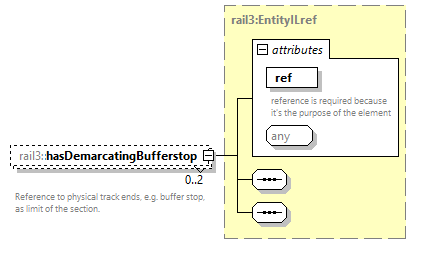 | ||||||||||||||
| namespace | https://www.railml.org/schemas/3.2 | ||||||||||||||
| type | rail3:EntityILref | ||||||||||||||
| properties |
| ||||||||||||||
| attributes |
| ||||||||||||||
| annotation |
| ||||||||||||||
| source | <xs:element name="hasDemarcatingBufferstop" type="rail3:EntityILref" minOccurs="0" maxOccurs="2"> <xs:annotation> <xs:documentation>Reference to physical track ends, e.g. buffer stop, as limit of the section.</xs:documentation> </xs:annotation> </xs:element> |
element TvdSection/hasExitSignal
| diagram | 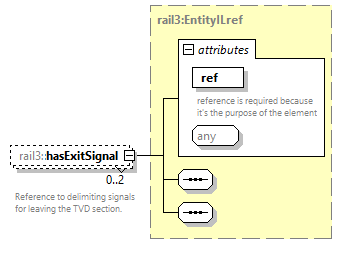 | ||||||||||||||
| namespace | https://www.railml.org/schemas/3.2 | ||||||||||||||
| type | rail3:EntityILref | ||||||||||||||
| properties |
| ||||||||||||||
| attributes |
| ||||||||||||||
| annotation |
| ||||||||||||||
| source | <xs:element name="hasExitSignal" type="rail3:EntityILref" minOccurs="0" maxOccurs="2"> <xs:annotation> <xs:documentation>Reference to delimiting signals for leaving the TVD section.</xs:documentation> </xs:annotation> </xs:element> |
element TvdSection/hasDemarcatingTraindetector
| diagram | 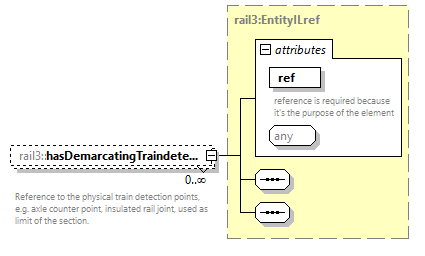 | ||||||||||||||
| namespace | https://www.railml.org/schemas/3.2 | ||||||||||||||
| type | rail3:EntityILref | ||||||||||||||
| properties |
| ||||||||||||||
| attributes |
| ||||||||||||||
| annotation |
| ||||||||||||||
| source | <xs:element name="hasDemarcatingTraindetector" type="rail3:EntityILref" minOccurs="0" maxOccurs="unbounded"> <xs:annotation> <xs:documentation>Reference to the physical train detection points, e.g. axle counter point, insulated rail joint, used as limit of the section.</xs:documentation> </xs:annotation> </xs:element> |
element TvdSection/hasResetStrategy
| diagram | 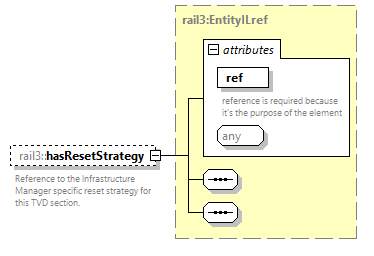 | ||||||||||||||
| namespace | https://www.railml.org/schemas/3.2 | ||||||||||||||
| type | rail3:EntityILref | ||||||||||||||
| properties |
| ||||||||||||||
| attributes |
| ||||||||||||||
| annotation |
| ||||||||||||||
| source | <xs:element name="hasResetStrategy" type="rail3:EntityILref" minOccurs="0" maxOccurs="1"> <xs:annotation> <xs:documentation>Reference to the Infrastructure Manager specific reset strategy for this TVD section.</xs:documentation> </xs:annotation> </xs:element> |
element TvdSection/hasTrainNumberField
| diagram | 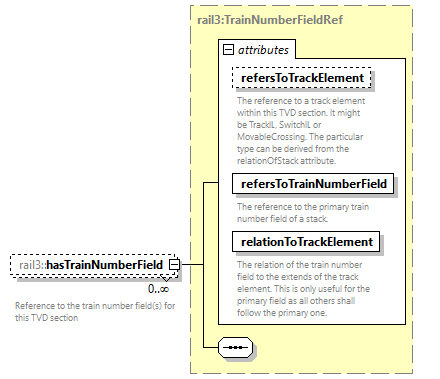 | ||||||||||||||||||||||||||||||
| namespace | https://www.railml.org/schemas/3.2 | ||||||||||||||||||||||||||||||
| type | rail3:TrainNumberFieldRef | ||||||||||||||||||||||||||||||
| properties |
| ||||||||||||||||||||||||||||||
| attributes |
| ||||||||||||||||||||||||||||||
| annotation |
| ||||||||||||||||||||||||||||||
| source | <xs:element name="hasTrainNumberField" type="rail3:TrainNumberFieldRef" minOccurs="0" maxOccurs="unbounded"> <xs:annotation> <xs:documentation>Reference to the train number field(s) for this TVD section</xs:documentation> </xs:annotation> </xs:element> |
element TvdSection/hasTrackElement
| diagram | 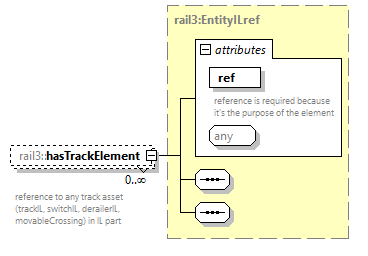 | ||||||||||||||
| namespace | https://www.railml.org/schemas/3.2 | ||||||||||||||
| type | rail3:EntityILref | ||||||||||||||
| properties |
| ||||||||||||||
| attributes |
| ||||||||||||||
| annotation |
| ||||||||||||||
| source | <xs:element name="hasTrackElement" type="rail3:EntityILref" minOccurs="0" maxOccurs="unbounded"> <xs:annotation> <xs:documentation>reference to any track asset (trackIL, switchIL, derailerIL, movableCrossing) in IL part</xs:documentation> </xs:annotation> </xs:element> |
complexType TvdSections
| diagram |  | ||
| namespace | https://www.railml.org/schemas/3.2 | ||
| children | rail3:tvdSection | ||
| used by |
| ||
| annotation |
| ||
| source | <xs:complexType name="TvdSections"> <xs:annotation> <xs:documentation>container element for all TvdSection elements</xs:documentation> </xs:annotation> <xs:sequence minOccurs="0" maxOccurs="1"> <xs:element name="tvdSection" type="rail3:TvdSection" minOccurs="1" maxOccurs="unbounded"> <xs:annotation> <xs:documentation>track vacancy detection (TVD) section reports train occupancy to the interlocking</xs:documentation> </xs:annotation> </xs:element> </xs:sequence> </xs:complexType> |
element TvdSections/tvdSection
| diagram |  | ||||||||||||||||||||||||||||||||||||||||||||||||||||||||||||||
| namespace | https://www.railml.org/schemas/3.2 | ||||||||||||||||||||||||||||||||||||||||||||||||||||||||||||||
| type | rail3:TvdSection | ||||||||||||||||||||||||||||||||||||||||||||||||||||||||||||||
| properties |
| ||||||||||||||||||||||||||||||||||||||||||||||||||||||||||||||
| children | rail3:designator rail3:assetName rail3:belongsToOperationalPoint rail3:hasCommand rail3:hasIndication rail3:hasDemarcatingBufferstop rail3:hasExitSignal rail3:hasDemarcatingTraindetector rail3:hasResetStrategy rail3:hasTrainNumberField rail3:hasTrackElement | ||||||||||||||||||||||||||||||||||||||||||||||||||||||||||||||
| attributes |
| ||||||||||||||||||||||||||||||||||||||||||||||||||||||||||||||
| annotation |
| ||||||||||||||||||||||||||||||||||||||||||||||||||||||||||||||
| source | <xs:element name="tvdSection" type="rail3:TvdSection" minOccurs="1" maxOccurs="unbounded"> <xs:annotation> <xs:documentation>track vacancy detection (TVD) section reports train occupancy to the interlocking</xs:documentation> </xs:annotation> </xs:element> |
complexType WorkZone
| diagram |  | ||||||||||||||||||||||||||||||
| namespace | https://www.railml.org/schemas/3.2 | ||||||||||||||||||||||||||||||
| type | extension of rail3:RestrictedArea | ||||||||||||||||||||||||||||||
| properties |
| ||||||||||||||||||||||||||||||
| children | rail3:designator rail3:assetName rail3:belongsToOperationalPoint rail3:hasCommand rail3:hasIndication rail3:isLimitedBy rail3:trackAssetInArea rail3:activationLock rail3:switchInPosition rail3:derailerInPosition rail3:crossingInPosition rail3:detectorInState rail3:signalWithAspect rail3:keyLockInState rail3:levelCrossingInState rail3:releasedForLocalOperation | ||||||||||||||||||||||||||||||
| used by |
| ||||||||||||||||||||||||||||||
| attributes |
| ||||||||||||||||||||||||||||||
| annotation |
| ||||||||||||||||||||||||||||||
| source | <xs:complexType name="WorkZone"> <xs:annotation> <xs:documentation>A set of track assets that track workers or the signalman can set apart from the main line. When taken, it is impossible to call regular routes into this work zone.</xs:documentation> </xs:annotation> <xs:complexContent> <xs:extension base="rail3:RestrictedArea"> <xs:sequence> <xs:element name="activationLock" type="rail3:EntityILref" minOccurs="0" maxOccurs="unbounded"> <xs:annotation> <xs:documentation>reference to any locking device used for activation and deactivation of the work zone</xs:documentation> </xs:annotation> </xs:element> <xs:element name="switchInPosition" type="rail3:SwitchInPosition" minOccurs="0" maxOccurs="unbounded"> <xs:annotation> <xs:documentation>reference to any switch and its position inside or outside the work zone required for use and/or protection</xs:documentation> </xs:annotation> </xs:element> <xs:element name="derailerInPosition" type="rail3:DerailerInPosition" minOccurs="0" maxOccurs="unbounded"> <xs:annotation> <xs:documentation>reference to any derailer and its position inside or outside the work zone required for use and/or protection</xs:documentation> </xs:annotation> </xs:element> <xs:element name="crossingInPosition" type="rail3:CrossingInPosition" minOccurs="0" maxOccurs="unbounded"> <xs:annotation> <xs:documentation>reference to any movable crossing and its position inside or outside the work zone required for use and/or protection</xs:documentation> </xs:annotation> </xs:element> <xs:element name="detectorInState" type="rail3:DetectorInState" minOccurs="0" maxOccurs="unbounded"> <xs:annotation> <xs:documentation>reference to any detector and its state inside or outside the work zone required for use</xs:documentation> </xs:annotation> </xs:element> <xs:element name="signalWithAspect" type="rail3:SignalWithAspect" minOccurs="0" maxOccurs="unbounded"> <xs:annotation> <xs:documentation>reference to any signal and its aspect inside or outside the work zone required for use and/or protection</xs:documentation> </xs:annotation> </xs:element> <xs:element name="keyLockInState" type="rail3:KeyLockInState" minOccurs="0" maxOccurs="unbounded"> <xs:annotation> <xs:documentation>reference to any key log and its state inside or outside the work zone required for use and/or protection</xs:documentation> </xs:annotation> </xs:element> <xs:element name="levelCrossingInState" type="rail3:LevelCrossingInState" minOccurs="0" maxOccurs="unbounded"> <xs:annotation> <xs:documentation>reference to any level crossing and its state inside the work zone required for use</xs:documentation> </xs:annotation> </xs:element> <xs:element name="releasedForLocalOperation" type="rail3:EntityILref" minOccurs="0" maxOccurs="unbounded"> <xs:annotation> <xs:documentation>reference to any switchable element (keylock, switch, derailer, level crossing etc.), which is released for local operation, when the work zone is active</xs:documentation> </xs:annotation> </xs:element> </xs:sequence> </xs:extension> </xs:complexContent> </xs:complexType> |
element WorkZone/activationLock
| diagram | 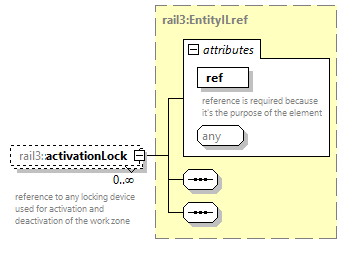 | ||||||||||||||
| namespace | https://www.railml.org/schemas/3.2 | ||||||||||||||
| type | rail3:EntityILref | ||||||||||||||
| properties |
| ||||||||||||||
| attributes |
| ||||||||||||||
| annotation |
| ||||||||||||||
| source | <xs:element name="activationLock" type="rail3:EntityILref" minOccurs="0" maxOccurs="unbounded"> <xs:annotation> <xs:documentation>reference to any locking device used for activation and deactivation of the work zone</xs:documentation> </xs:annotation> </xs:element> |
element WorkZone/switchInPosition
| diagram | 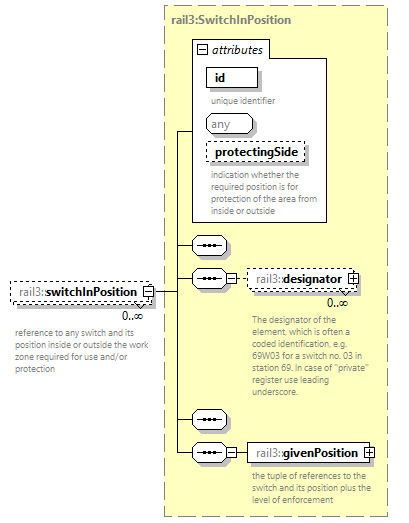 | ||||||||||||||||||||||
| namespace | https://www.railml.org/schemas/3.2 | ||||||||||||||||||||||
| type | rail3:SwitchInPosition | ||||||||||||||||||||||
| properties |
| ||||||||||||||||||||||
| children | rail3:designator rail3:givenPosition | ||||||||||||||||||||||
| attributes |
| ||||||||||||||||||||||
| annotation |
| ||||||||||||||||||||||
| source | <xs:element name="switchInPosition" type="rail3:SwitchInPosition" minOccurs="0" maxOccurs="unbounded"> <xs:annotation> <xs:documentation>reference to any switch and its position inside or outside the work zone required for use and/or protection</xs:documentation> </xs:annotation> </xs:element> |
element WorkZone/derailerInPosition
| diagram | 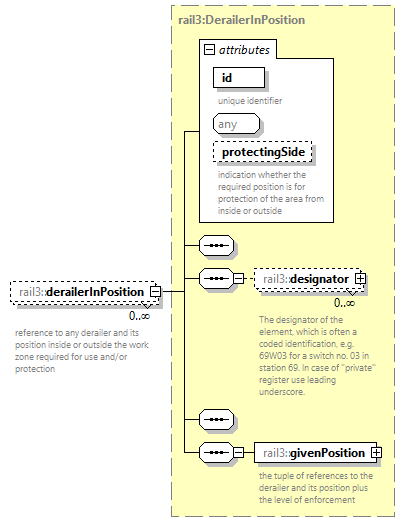 | ||||||||||||||||||||||
| namespace | https://www.railml.org/schemas/3.2 | ||||||||||||||||||||||
| type | rail3:DerailerInPosition | ||||||||||||||||||||||
| properties |
| ||||||||||||||||||||||
| children | rail3:designator rail3:givenPosition | ||||||||||||||||||||||
| attributes |
| ||||||||||||||||||||||
| annotation |
| ||||||||||||||||||||||
| source | <xs:element name="derailerInPosition" type="rail3:DerailerInPosition" minOccurs="0" maxOccurs="unbounded"> <xs:annotation> <xs:documentation>reference to any derailer and its position inside or outside the work zone required for use and/or protection</xs:documentation> </xs:annotation> </xs:element> |
element WorkZone/crossingInPosition
| diagram | 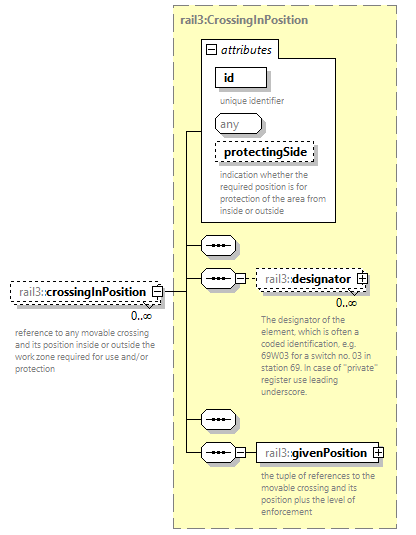 | ||||||||||||||||||||||
| namespace | https://www.railml.org/schemas/3.2 | ||||||||||||||||||||||
| type | rail3:CrossingInPosition | ||||||||||||||||||||||
| properties |
| ||||||||||||||||||||||
| children | rail3:designator rail3:givenPosition | ||||||||||||||||||||||
| attributes |
| ||||||||||||||||||||||
| annotation |
| ||||||||||||||||||||||
| source | <xs:element name="crossingInPosition" type="rail3:CrossingInPosition" minOccurs="0" maxOccurs="unbounded"> <xs:annotation> <xs:documentation>reference to any movable crossing and its position inside or outside the work zone required for use and/or protection</xs:documentation> </xs:annotation> </xs:element> |
element WorkZone/detectorInState
| diagram | 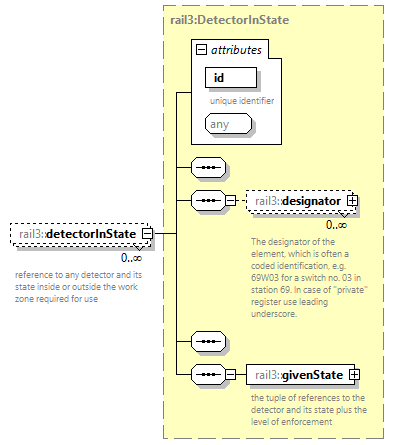 | ||||||||||||||
| namespace | https://www.railml.org/schemas/3.2 | ||||||||||||||
| type | rail3:DetectorInState | ||||||||||||||
| properties |
| ||||||||||||||
| children | rail3:designator rail3:givenState | ||||||||||||||
| attributes |
| ||||||||||||||
| annotation |
| ||||||||||||||
| source | <xs:element name="detectorInState" type="rail3:DetectorInState" minOccurs="0" maxOccurs="unbounded"> <xs:annotation> <xs:documentation>reference to any detector and its state inside or outside the work zone required for use</xs:documentation> </xs:annotation> </xs:element> |
element WorkZone/signalWithAspect
| diagram | 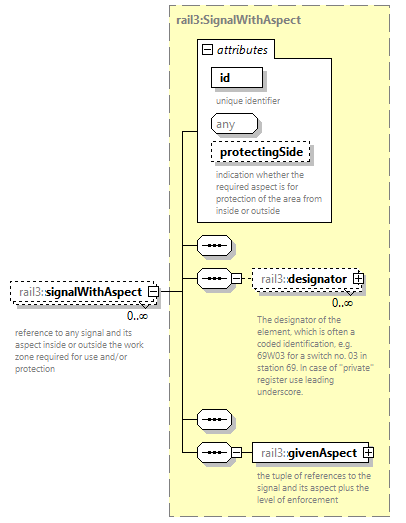 | ||||||||||||||||||||||
| namespace | https://www.railml.org/schemas/3.2 | ||||||||||||||||||||||
| type | rail3:SignalWithAspect | ||||||||||||||||||||||
| properties |
| ||||||||||||||||||||||
| children | rail3:designator rail3:givenAspect | ||||||||||||||||||||||
| attributes |
| ||||||||||||||||||||||
| annotation |
| ||||||||||||||||||||||
| source | <xs:element name="signalWithAspect" type="rail3:SignalWithAspect" minOccurs="0" maxOccurs="unbounded"> <xs:annotation> <xs:documentation>reference to any signal and its aspect inside or outside the work zone required for use and/or protection</xs:documentation> </xs:annotation> </xs:element> |
element WorkZone/keyLockInState
| diagram | 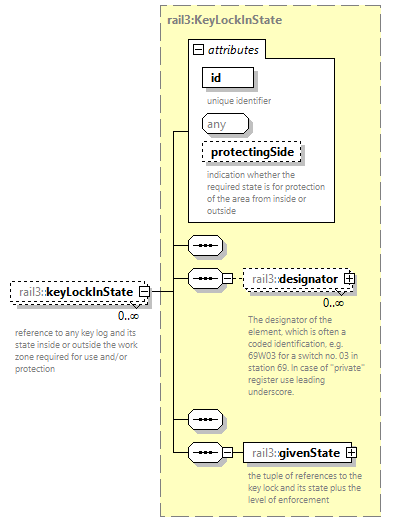 | ||||||||||||||||||||||
| namespace | https://www.railml.org/schemas/3.2 | ||||||||||||||||||||||
| type | rail3:KeyLockInState | ||||||||||||||||||||||
| properties |
| ||||||||||||||||||||||
| children | rail3:designator rail3:givenState | ||||||||||||||||||||||
| attributes |
| ||||||||||||||||||||||
| annotation |
| ||||||||||||||||||||||
| source | <xs:element name="keyLockInState" type="rail3:KeyLockInState" minOccurs="0" maxOccurs="unbounded"> <xs:annotation> <xs:documentation>reference to any key log and its state inside or outside the work zone required for use and/or protection</xs:documentation> </xs:annotation> </xs:element> |
element WorkZone/levelCrossingInState
| diagram | 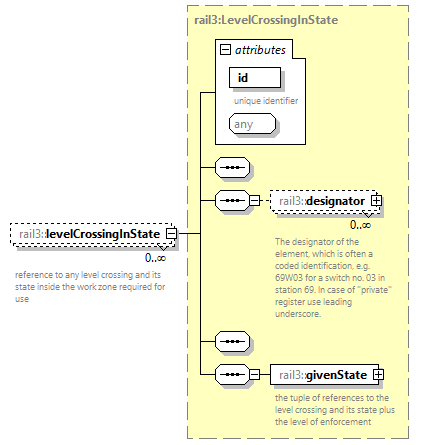 | ||||||||||||||
| namespace | https://www.railml.org/schemas/3.2 | ||||||||||||||
| type | rail3:LevelCrossingInState | ||||||||||||||
| properties |
| ||||||||||||||
| children | rail3:designator rail3:givenState | ||||||||||||||
| attributes |
| ||||||||||||||
| annotation |
| ||||||||||||||
| source | <xs:element name="levelCrossingInState" type="rail3:LevelCrossingInState" minOccurs="0" maxOccurs="unbounded"> <xs:annotation> <xs:documentation>reference to any level crossing and its state inside the work zone required for use</xs:documentation> </xs:annotation> </xs:element> |
element WorkZone/releasedForLocalOperation
| diagram | 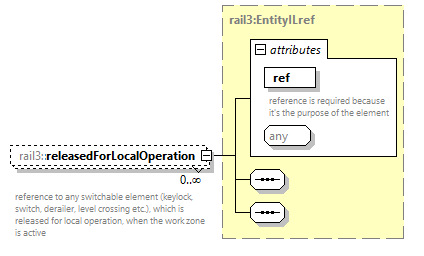 | ||||||||||||||
| namespace | https://www.railml.org/schemas/3.2 | ||||||||||||||
| type | rail3:EntityILref | ||||||||||||||
| properties |
| ||||||||||||||
| attributes |
| ||||||||||||||
| annotation |
| ||||||||||||||
| source | <xs:element name="releasedForLocalOperation" type="rail3:EntityILref" minOccurs="0" maxOccurs="unbounded"> <xs:annotation> <xs:documentation>reference to any switchable element (keylock, switch, derailer, level crossing etc.), which is released for local operation, when the work zone is active</xs:documentation> </xs:annotation> </xs:element> |
complexType WorkZones
| diagram |  | ||
| namespace | https://www.railml.org/schemas/3.2 | ||
| children | rail3:workZone | ||
| used by |
| ||
| source | <xs:complexType name="WorkZones"> <xs:sequence> <xs:element name="workZone" type="rail3:WorkZone" minOccurs="1" maxOccurs="unbounded"> <xs:annotation> <xs:documentation>A set of track assets that track workers or the signalman can set apart from the main line.</xs:documentation> </xs:annotation> </xs:element> </xs:sequence> </xs:complexType> |
element WorkZones/workZone
| diagram |  | ||||||||||||||||||||||||||||||
| namespace | https://www.railml.org/schemas/3.2 | ||||||||||||||||||||||||||||||
| type | rail3:WorkZone | ||||||||||||||||||||||||||||||
| properties |
| ||||||||||||||||||||||||||||||
| children | rail3:designator rail3:assetName rail3:belongsToOperationalPoint rail3:hasCommand rail3:hasIndication rail3:isLimitedBy rail3:trackAssetInArea rail3:activationLock rail3:switchInPosition rail3:derailerInPosition rail3:crossingInPosition rail3:detectorInState rail3:signalWithAspect rail3:keyLockInState rail3:levelCrossingInState rail3:releasedForLocalOperation | ||||||||||||||||||||||||||||||
| attributes |
| ||||||||||||||||||||||||||||||
| annotation |
| ||||||||||||||||||||||||||||||
| source | <xs:element name="workZone" type="rail3:WorkZone" minOccurs="1" maxOccurs="unbounded"> <xs:annotation> <xs:documentation>A set of track assets that track workers or the signalman can set apart from the main line.</xs:documentation> </xs:annotation> </xs:element> |
simpleType EndOfTrackTypeList
| namespace | https://www.railml.org/schemas/3.2 | |||||||||
| type | restriction of xs:string | |||||||||
| properties |
| |||||||||
| used by |
| |||||||||
| facets |
| |||||||||
| annotation |
| |||||||||
| source | <xs:simpleType name="EndOfTrackTypeList"> <xs:annotation> <xs:documentation>The list of possible supervision limits for the interlocking.</xs:documentation> </xs:annotation> <xs:restriction base="xs:string"> <xs:enumeration value="endOfSupervision"/> <xs:enumeration value="physicalEnd"/> </xs:restriction> </xs:simpleType> |
simpleType IPAddress
| namespace | https://www.railml.org/schemas/3.2 | ||
| type | union of (rail3:IPv4_Address, rail3:IPv6_Address, rail3:tOtherEnumerationValue) | ||
| annotation |
| ||
| source | <xs:simpleType name="IPAddress"> <xs:annotation> <xs:documentation>Contains the IP address in IPv4 or IPv6 format.</xs:documentation> </xs:annotation> <xs:union memberTypes="rail3:IPv4_Address rail3:IPv6_Address rail3:tOtherEnumerationValue"/> </xs:simpleType> |
simpleType IPv4_Address
| namespace | https://www.railml.org/schemas/3.2 | ||||||
| type | restriction of xs:string | ||||||
| properties |
| ||||||
| used by |
| ||||||
| facets |
| ||||||
| annotation |
| ||||||
| source | <xs:simpleType name="IPv4_Address"> <xs:annotation> <xs:documentation>IPv4 address string, e.g. "192.168.213.196"</xs:documentation> </xs:annotation> <xs:restriction base="xs:string"> <xs:pattern value="([0-9]+(\.|$)){4}"/> </xs:restriction> </xs:simpleType> |
simpleType IPv6_Address
| namespace | https://www.railml.org/schemas/3.2 | ||||||
| type | restriction of xs:string | ||||||
| properties |
| ||||||
| used by |
| ||||||
| facets |
| ||||||
| annotation |
| ||||||
| source | <xs:simpleType name="IPv6_Address"> <xs:annotation> <xs:documentation>IPv6 address string</xs:documentation> </xs:annotation> <xs:restriction base="xs:string"> <xs:pattern value="([A-Fa-f0-9]{1,4}::?){1,7}[A-Fa-f0-9]{1,4}"/> </xs:restriction> </xs:simpleType> |
simpleType MAC_Address
| namespace | https://www.railml.org/schemas/3.2 | ||||||
| type | restriction of xs:string | ||||||
| properties |
| ||||||
| used by |
| ||||||
| facets |
| ||||||
| annotation |
| ||||||
| source | <xs:simpleType name="MAC_Address"> <xs:annotation> <xs:documentation>MAC address string</xs:documentation> </xs:annotation> <xs:restriction base="xs:string"> <xs:pattern value="[a-fA-F0-9]{2}(:[a-fA-F0-9]{2}){5}"/> </xs:restriction> </xs:simpleType> |
simpleType tAliasString
| namespace | https://www.railml.org/schemas/3.2 | ||
| type | union of (rail3:tHexaString, rail3:tBitmaskAny) | ||
| used by |
| ||
| source | <xs:simpleType name="tAliasString"> <xs:union memberTypes="rail3:tHexaString rail3:tBitmaskAny"/> </xs:simpleType> |
simpleType tAndOr
| namespace | https://www.railml.org/schemas/3.2 | ||||||||||||||||||
| type | restriction of xs:string | ||||||||||||||||||
| properties |
| ||||||||||||||||||
| used by |
| ||||||||||||||||||
| facets |
| ||||||||||||||||||
| annotation |
| ||||||||||||||||||
| source | <xs:simpleType name="tAndOr"> <xs:annotation> <xs:documentation>List of boolean operators for use in constructing boolean conditions.
 Used for concatenating boolean conditions by means of AND/OR. </xs:documentation> </xs:annotation> <xs:restriction base="xs:string"> <xs:enumeration value="AND"> <xs:annotation> <xs:documentation>boolean operator for „AND“ combination of two conditions</xs:documentation> </xs:annotation> </xs:enumeration> <xs:enumeration value="OR"> <xs:annotation> <xs:documentation>boolean operator for „OR“ combination of two conditions</xs:documentation> </xs:annotation> </xs:enumeration> <xs:enumeration value="XOR"> <xs:annotation> <xs:documentation>boolean operator for „XOR“ combination of two conditions</xs:documentation> </xs:annotation> </xs:enumeration> </xs:restriction> </xs:simpleType> |
simpleType tBitPatternAny
| namespace | https://www.railml.org/schemas/3.2 | |||||||||
| type | restriction of xs:string | |||||||||
| properties |
| |||||||||
| used by |
| |||||||||
| facets |
| |||||||||
| annotation |
| |||||||||
| source | <xs:simpleType name="tBitPatternAny"> <xs:annotation> <xs:documentation>string made of "0", "1" or "x" to describe a bit pattern</xs:documentation> </xs:annotation> <xs:restriction base="xs:string"> <xs:minLength value="1"/> <xs:pattern value="[0-1x]*"/> </xs:restriction> </xs:simpleType> |
simpleType tContactState
| namespace | https://www.railml.org/schemas/3.2 | |||||||||||||
| type | restriction of xs:string | |||||||||||||
| properties |
| |||||||||||||
| used by |
| |||||||||||||
| facets |
| |||||||||||||
| annotation |
| |||||||||||||
| source | <xs:simpleType name="tContactState"> <xs:annotation> <xs:documentation>possible states of a contact, bit or command</xs:documentation> </xs:annotation> <xs:restriction base="xs:string"> <xs:enumeration value="closed"> <xs:annotation> <xs:documentation>Contact state „closed“ or equal to bit state „1“</xs:documentation> </xs:annotation> </xs:enumeration> <xs:enumeration value="open"> <xs:annotation> <xs:documentation>Contact state „open“ or equal to bit state „0“</xs:documentation> </xs:annotation> </xs:enumeration> </xs:restriction> </xs:simpleType> |
simpleType tCrossingPosition
| namespace | https://www.railml.org/schemas/3.2 | |||||||||||||
| type | restriction of xs:string | |||||||||||||
| properties |
| |||||||||||||
| used by |
| |||||||||||||
| facets |
| |||||||||||||
| annotation |
| |||||||||||||
| source | <xs:simpleType name="tCrossingPosition"> <xs:annotation> <xs:documentation>typical positions of crossings</xs:documentation> </xs:annotation> <xs:restriction base="xs:string"> <xs:enumeration value="downleft-rightup"> <xs:annotation> <xs:documentation>Description of a logical position of a simple crossing within a route path from the lower left to upper right</xs:documentation> </xs:annotation> </xs:enumeration> <xs:enumeration value="upleft-rightdown"> <xs:annotation> <xs:documentation>Description of a logical position of a simple crossing within a route path from the upper left to lower right</xs:documentation> </xs:annotation> </xs:enumeration> </xs:restriction> </xs:simpleType> |
simpleType tDerailingPosition
| namespace | https://www.railml.org/schemas/3.2 | |||||||||||||
| type | restriction of xs:string | |||||||||||||
| properties |
| |||||||||||||
| used by |
| |||||||||||||
| facets |
| |||||||||||||
| annotation |
| |||||||||||||
| source | <xs:simpleType name="tDerailingPosition"> <xs:annotation> <xs:documentation>typical positions of a derailing device</xs:documentation> </xs:annotation> <xs:restriction base="xs:string"> <xs:enumeration value="derailingPosition"> <xs:annotation> <xs:documentation>The derailer is engaged and no vehicle can pass it without getting purposely guided off the running rails.</xs:documentation> </xs:annotation> </xs:enumeration> <xs:enumeration value="passablePosition"> <xs:annotation> <xs:documentation>The derailer is retreated and can be passed by any vehicle.</xs:documentation> </xs:annotation> </xs:enumeration> </xs:restriction> </xs:simpleType> |
simpleType tDetectorStates
| namespace | https://www.railml.org/schemas/3.2 | ||||||||||||||||||
| type | restriction of xs:string | ||||||||||||||||||
| properties |
| ||||||||||||||||||
| used by |
| ||||||||||||||||||
| facets |
| ||||||||||||||||||
| annotation |
| ||||||||||||||||||
| source | <xs:simpleType name="tDetectorStates"> <xs:annotation> <xs:documentation>The list of possible detector states.</xs:documentation> </xs:annotation> <xs:restriction base="xs:string"> <xs:enumeration value="activated"> <xs:annotation> <xs:documentation>state of an triggered detector</xs:documentation> </xs:annotation> </xs:enumeration> <xs:enumeration value="deactivated"> <xs:annotation> <xs:documentation>state of an untriggered detector</xs:documentation> </xs:annotation> </xs:enumeration> <xs:enumeration value="inactive"> <xs:annotation> <xs:documentation>state of a detector not available for triggering</xs:documentation> </xs:annotation> </xs:enumeration> </xs:restriction> </xs:simpleType> |
simpleType tDetectorTypeList
| namespace | https://www.railml.org/schemas/3.2 | |||||||||||||||||||||||||||||||||||||||||||||||||||||||||||||||
| type | restriction of xs:string | |||||||||||||||||||||||||||||||||||||||||||||||||||||||||||||||
| properties |
| |||||||||||||||||||||||||||||||||||||||||||||||||||||||||||||||
| used by |
| |||||||||||||||||||||||||||||||||||||||||||||||||||||||||||||||
| facets |
| |||||||||||||||||||||||||||||||||||||||||||||||||||||||||||||||
| annotation |
| |||||||||||||||||||||||||||||||||||||||||||||||||||||||||||||||
| source | <xs:simpleType name="tDetectorTypeList"> <xs:annotation> <xs:documentation>The list of possible detector types.</xs:documentation> </xs:annotation> <xs:restriction base="xs:string"> <xs:enumeration value="avalanche"> <xs:annotation> <xs:documentation>The detector detects avalanches, which may endanger the railway traffic.</xs:documentation> </xs:annotation> </xs:enumeration> <xs:enumeration value="cranks"> <xs:annotation> <xs:documentation>The detector detects the presence of cranks for switch actuators at their normal storage location, e.g. in a special cabinet at the stationmaster.</xs:documentation> </xs:annotation> </xs:enumeration> <xs:enumeration value="derailment"> <xs:annotation> <xs:documentation>The detector detects any derailed railway vehicle. It is often used in rear of tunnels or bridges to reduce the damages by derailed vehicles.</xs:documentation> </xs:annotation> </xs:enumeration> <xs:enumeration value="doors"> <xs:annotation> <xs:documentation>The detector monitors the closed position of entry doors of equipment rooms</xs:documentation> </xs:annotation> </xs:enumeration> <xs:enumeration value="fire"> <xs:annotation> <xs:documentation>The detector detects fire or smoke in equipment cabinets or rooms.</xs:documentation> </xs:annotation> </xs:enumeration> <xs:enumeration value="flatWheel"> <xs:annotation> <xs:documentation>The detector detects any flat wheel of a railway vehicle</xs:documentation> </xs:annotation> </xs:enumeration> <xs:enumeration value="gas"> <xs:annotation> <xs:documentation>The detector detects the excessive concentration of a particular gas in the vicinity</xs:documentation> </xs:annotation> </xs:enumeration> <xs:enumeration value="hotWheelBox"> <xs:annotation> <xs:documentation>The detector detects any hot axle box of railway vehicles.</xs:documentation> </xs:annotation> </xs:enumeration> <xs:enumeration value="intrusion"> <xs:annotation> <xs:documentation>The detector monitors the access doors to any equipment cabinet or room in order to detect unauthorised access.</xs:documentation> </xs:annotation> </xs:enumeration> <xs:enumeration value="landSlide"> <xs:annotation> <xs:documentation>The detector detects landslides or rockfalls, which may endanger the railway traffic.</xs:documentation> </xs:annotation> </xs:enumeration> <xs:enumeration value="loadingGauge"> <xs:annotation> <xs:documentation>The detector detects any railway vehicle exceeding the loading gauge due to replaced goods or similar.</xs:documentation> </xs:annotation> </xs:enumeration> <xs:enumeration value="weighing"> <xs:annotation> <xs:documentation>The detector checks the axle load of any railway vehicle against a pre-set limit.</xs:documentation> </xs:annotation> </xs:enumeration> </xs:restriction> </xs:simpleType> |
simpleType tDetectorTypeListExt
| namespace | https://www.railml.org/schemas/3.2 | ||
| type | union of (rail3:tDetectorTypeList, rail3:tOtherEnumerationValue) | ||
| used by |
| ||
| annotation |
| ||
| source | <xs:simpleType name="tDetectorTypeListExt"> <xs:annotation> <xs:documentation>The possible list of detector base types with extension point.</xs:documentation> </xs:annotation> <xs:union memberTypes="rail3:tDetectorTypeList rail3:tOtherEnumerationValue"/> </xs:simpleType> |
simpleType tExtentOfControl
| namespace | https://www.railml.org/schemas/3.2 | |||||||||||||||||||||||
| type | restriction of xs:string | |||||||||||||||||||||||
| properties |
| |||||||||||||||||||||||
| used by |
| |||||||||||||||||||||||
| facets |
| |||||||||||||||||||||||
| annotation |
| |||||||||||||||||||||||
| source | <xs:simpleType name="tExtentOfControl"> <xs:annotation> <xs:documentation>The Extent of Control is one of full control, steering only, notification only or none.
 Full control implies that the IL controls the element AND reads the element feedback to check the execution of the control. 
 Notification only means that the IL only reads the status of the object in terms of switch position left, controlled or boolean 1 or derailer engaged.
 Steering only means that the IL emits the control signal without checking for feedback.
 Note that LoC=none suggests that the IL has no relation at all with the track asset, indicating a modelling error that merits further investigation and/or explanation.</xs:documentation> </xs:annotation> <xs:restriction base="xs:string"> <xs:enumeration value="fullControl"> <xs:annotation> <xs:documentation>The control of an element is in both directions, i.e. sending commands and receiving element status</xs:documentation> </xs:annotation> </xs:enumeration> <xs:enumeration value="none"> <xs:annotation> <xs:documentation>There is no control at all, i.e. the element is static</xs:documentation> </xs:annotation> </xs:enumeration> <xs:enumeration value="notificationOnly"> <xs:annotation> <xs:documentation>The control of an element allows only for receiving the element status</xs:documentation> </xs:annotation> </xs:enumeration> <xs:enumeration value="steeringOnly"> <xs:annotation> <xs:documentation>The control of an element allows only for sending commands</xs:documentation> </xs:annotation> </xs:enumeration> </xs:restriction> </xs:simpleType> |
simpleType tGateStateList
| namespace | https://www.railml.org/schemas/3.2 | ||||||||||||||||||
| type | restriction of xs:string | ||||||||||||||||||
| properties |
| ||||||||||||||||||
| used by |
| ||||||||||||||||||
| facets |
| ||||||||||||||||||
| annotation |
| ||||||||||||||||||
| source | <xs:simpleType name="tGateStateList"> <xs:annotation> <xs:documentation>The list of possible states of a (tunnel) gate.</xs:documentation> </xs:annotation> <xs:restriction base="xs:string"> <xs:enumeration value="blockingClosed"> <xs:annotation> <xs:documentation>The gate is in a closed position, which blocks the railway traffic through it.</xs:documentation> </xs:annotation> </xs:enumeration> <xs:enumeration value="passableOpen"> <xs:annotation> <xs:documentation>The gate is in an open position, which allows the passage of railway traffic through it.</xs:documentation> </xs:annotation> </xs:enumeration> <xs:enumeration value="unknown"> <xs:annotation> <xs:documentation>The gate position is not known</xs:documentation> </xs:annotation> </xs:enumeration> </xs:restriction> </xs:simpleType> |
simpleType tGenericAspectList
| namespace | https://www.railml.org/schemas/3.2 | |||||||||||||||||||||||||||||||||||||||||||||||||||||
| type | restriction of xs:string | |||||||||||||||||||||||||||||||||||||||||||||||||||||
| properties |
| |||||||||||||||||||||||||||||||||||||||||||||||||||||
| used by |
| |||||||||||||||||||||||||||||||||||||||||||||||||||||
| facets |
| |||||||||||||||||||||||||||||||||||||||||||||||||||||
| annotation |
| |||||||||||||||||||||||||||||||||||||||||||||||||||||
| source | <xs:simpleType name="tGenericAspectList"> <xs:annotation> <xs:documentation>list of possible generic signal aspects (generic meaning)</xs:documentation> </xs:annotation> <xs:restriction base="xs:string"> <xs:enumeration value="callOn"> <xs:annotation> <xs:documentation>This is used for any auxiliary aspect with the meaning “Pass at reduced speed with clear visibility over the route ahead” because the signal cannot be cleared normally. In most cases such aspect is used with a special call-on route.</xs:documentation> </xs:annotation> </xs:enumeration> <xs:enumeration value="caution"> <xs:annotation> <xs:documentation>This is used for an announcing aspect/slave aspect with the meaning “expect Stop” at next signal.</xs:documentation> </xs:annotation> </xs:enumeration> <xs:enumeration value="closed"> <xs:annotation> <xs:documentation>This is used for any aspect with the meaning “Stop here”.</xs:documentation> </xs:annotation> </xs:enumeration> <xs:enumeration value="combinedProceed"> <xs:annotation> <xs:documentation>This is used for any proceed aspect where the master and the slave aspect is combined within one single aspect like this were common in OSShD networks. Of course, this applies only to proceed aspects as with the signal closed no slave aspect is given.</xs:documentation> </xs:annotation> </xs:enumeration> <xs:enumeration value="informative"> <xs:annotation> <xs:documentation>In contrast to supplementary aspects they are giving pure information without any consequences neither to the main aspect nor the train traffic. A failure of this aspect would not affect the main aspect. An example for an informative aspect is any aspect from a direction indicator. It can be also a speed indication if it is relaxing the speed information of the main aspect.</xs:documentation> </xs:annotation> </xs:enumeration> <xs:enumeration value="limitedProceed"> <xs:annotation> <xs:documentation>This is used for any aspect indicating the allowance to continue running with restricted speed. This is typically used for diverging routes or ones with reduced braking distance. In addition this main aspect might be combined with a speed indicator restricting or relaxing the allowed speed against the main aspect.</xs:documentation> </xs:annotation> </xs:enumeration> <xs:enumeration value="proceed"> <xs:annotation> <xs:documentation>This is used for any aspect indicating the allowance to continue running without any speed restrictions, i.e. proceed with line speed. However, such aspect can be combined on a signal with a speed indicator restricting the allowed speed against the main aspect.</xs:documentation> </xs:annotation> </xs:enumeration> <xs:enumeration value="restriction"> <xs:annotation> <xs:documentation>This aspect gives an additional restriction to the main aspect. A failure of such aspect will affect the main aspect of the signal. An example would be a speed indicator restricting the main proceed aspect.</xs:documentation> </xs:annotation> </xs:enumeration> <xs:enumeration value="supplementary"> <xs:annotation> <xs:documentation>These are any additional signal aspects which are combined with the main aspect without causing a restriction or giving pure information. Such combination shall be supervised by the interlocking and a failure will affect the main aspect as well. A good example is an additional indicator announcing the change onto the wrong track, i.e. line track normally used in the opposite direction.</xs:documentation> </xs:annotation> </xs:enumeration> <xs:enumeration value="warning"> <xs:annotation> <xs:documentation>This is used for an announcing aspect/slave aspect with the meaning “expect any kind of proceed” at next signal.</xs:documentation> </xs:annotation> </xs:enumeration> </xs:restriction> </xs:simpleType> |
simpleType tGenericResetStrategyList
| namespace | https://www.railml.org/schemas/3.2 | ||||||||||||||||||||||||||||
| type | restriction of xs:string | ||||||||||||||||||||||||||||
| properties |
| ||||||||||||||||||||||||||||
| used by |
| ||||||||||||||||||||||||||||
| facets |
| ||||||||||||||||||||||||||||
| annotation |
| ||||||||||||||||||||||||||||
| source | <xs:simpleType name="tGenericResetStrategyList"> <xs:annotation> <xs:documentation>list of generic strategies for resetting a TVD section</xs:documentation> </xs:annotation> <xs:restriction base="xs:string"> <xs:enumeration value="conditionalReset"> <xs:annotation> <xs:documentation>The section will only be reset, if some conditions are fulfilled. In case of several variants one can include the condition information in the &lt;designator&gt; of the reset strategy. Such conditions can be that the TVD section must be failed or the last counting action of delimiting detection points was “in”.</xs:documentation> </xs:annotation> </xs:enumeration> <xs:enumeration value="procedure"> <xs:annotation> <xs:documentation>This is a placeholder for any other procedure to reset a TVD section.</xs:documentation> </xs:annotation> </xs:enumeration> <xs:enumeration value="sweepRunWithConfirmation"> <xs:annotation> <xs:documentation>Here a sweep run is also requested. However, after the notification of the correct occupation and clearance sequence the operator needs to confirm the result by command before the section is reset within the interlocking.</xs:documentation> </xs:annotation> </xs:enumeration> <xs:enumeration value="sweepRunWithoutConfirmation"> <xs:annotation> <xs:documentation>Especially for axle counter sections a sweep run (de: Bügelfahrt) can be requested. Although the TVD section reset takes place, with receipt of the operator command to the axle counter unit the interlocking keeps it logically failed until a correct occupation and clearance sequence from a passing train is notified from the axle counter. In this case the section is reset immediately without any further operator action.</xs:documentation> </xs:annotation> </xs:enumeration> <xs:enumeration value="unconditionalReset"> <xs:annotation> <xs:documentation>The section will be reset on command without any conditions, i.e. after the reset command was accepted by the interlocking system the TVD section is set to clear/vacant status.</xs:documentation> </xs:annotation> </xs:enumeration> </xs:restriction> </xs:simpleType> |
simpleType tGenericRouteTypeExt
| namespace | https://www.railml.org/schemas/3.2 | ||
| type | union of (rail3:tGenericRouteTypeList, rail3:tOtherEnumerationValue) | ||
| used by |
| ||
| annotation |
| ||
| source | <xs:simpleType name="tGenericRouteTypeExt"> <xs:annotation> <xs:documentation>The list of possible route types with extension point.</xs:documentation> </xs:annotation> <xs:union memberTypes="rail3:tGenericRouteTypeList rail3:tOtherEnumerationValue"/> </xs:simpleType> |
simpleType tGenericRouteTypeList
| namespace | https://www.railml.org/schemas/3.2 | ||||||||||||||||||||||||||||||||||||||||||||||||
| type | restriction of xs:string | ||||||||||||||||||||||||||||||||||||||||||||||||
| properties |
| ||||||||||||||||||||||||||||||||||||||||||||||||
| used by |
| ||||||||||||||||||||||||||||||||||||||||||||||||
| facets |
| ||||||||||||||||||||||||||||||||||||||||||||||||
| annotation |
| ||||||||||||||||||||||||||||||||||||||||||||||||
| source | <xs:simpleType name="tGenericRouteTypeList"> <xs:annotation> <xs:documentation>list of possible generic route types</xs:documentation> </xs:annotation> <xs:restriction base="xs:string"> <xs:enumeration value="auxilliary"> <xs:annotation> <xs:documentation>The route type is used for auxiliary purpose as part of a complete route (from signal to signal). Often it marks a route part at the interface between two signalboxes (block interface) or the interface between a station and open line (line interface).</xs:documentation> </xs:annotation> </xs:enumeration> <xs:enumeration value="block"> <xs:annotation> <xs:documentation>This route type is used only on open line. These routes are often automatically handled by the interlocking.</xs:documentation> </xs:annotation> </xs:enumeration> <xs:enumeration value="callOn"> <xs:annotation> <xs:documentation>This is a special route type for situations, where the interlocking cannot fully secure the route for a train but safety is established by operator rules.</xs:documentation> </xs:annotation> </xs:enumeration> <xs:enumeration value="nonElectrified"> <xs:annotation> <xs:documentation>This is the route type for securing the path of the trains in the standard way but allows the running path to be without electrification, i.e. it shall be used for diesel or battery trains only.</xs:documentation> </xs:annotation> </xs:enumeration> <xs:enumeration value="normal"> <xs:annotation> <xs:documentation>This is the route type for securing the path of the trains in the standard way</xs:documentation> </xs:annotation> </xs:enumeration> <xs:enumeration value="occupied"> <xs:annotation> <xs:documentation>The route leads to an already occupied TVD section, i.e. the destination tracks must be occupied</xs:documentation> </xs:annotation> </xs:enumeration> <xs:enumeration value="shunting"> <xs:annotation> <xs:documentation>Such routes are typically used for splitting or merging formations of railway vehicles with a reduced amount of safety as the train movement is performed on low speed under responsibility of the driver. Parts of the running path can be occupied</xs:documentation> </xs:annotation> </xs:enumeration> <xs:enumeration value="siding"> <xs:annotation> <xs:documentation>This special route type is used for exit routes with destination of a siding on open line (de: Ausweichanschlussstelle). It is used for automatic release of the key lock associated with the siding.</xs:documentation> </xs:annotation> </xs:enumeration> <xs:enumeration value="tunnel"> <xs:annotation> <xs:documentation>The route leads to a tunnel section, which has restrictions w.r.t. vehicle acceptance, i.e. the vehicles shall be equipped with emergency brake cancellation</xs:documentation> </xs:annotation> </xs:enumeration> </xs:restriction> </xs:simpleType> |
simpleType tGroupingTypes
| namespace | https://www.railml.org/schemas/3.2 | |||||||||||||||||||||||||||||||||||||||||||
| type | restriction of xs:string | |||||||||||||||||||||||||||||||||||||||||||
| properties |
| |||||||||||||||||||||||||||||||||||||||||||
| used by |
| |||||||||||||||||||||||||||||||||||||||||||
| facets |
| |||||||||||||||||||||||||||||||||||||||||||
| annotation |
| |||||||||||||||||||||||||||||||||||||||||||
| source | <xs:simpleType name="tGroupingTypes"> <xs:annotation> <xs:documentation>list of possible generic element groups</xs:documentation> </xs:annotation> <xs:restriction base="xs:string"> <xs:enumeration value="automaticRouteSetting"> <xs:annotation> <xs:documentation>Group of signals for activating and deactivating the ARS mode for all elements within the group.</xs:documentation> </xs:annotation> </xs:enumeration> <xs:enumeration value="automaticTrainRouting"> <xs:annotation> <xs:documentation>Group of signals for activating and deactivating the ATR mode for all elements within the group.</xs:documentation> </xs:annotation> </xs:enumeration> <xs:enumeration value="callOn"> <xs:annotation> <xs:documentation>Group of signals for which the activation of call-on aspect is allowed simultaneously. This is used if no particular routes are required for call-on aspect.</xs:documentation> </xs:annotation> </xs:enumeration> <xs:enumeration value="catenary"> <xs:annotation> <xs:documentation>Group of elements which are related to one electrical section of catenary. Although the catenary switch status is normally not commanded from the interlocking, its status may be indicated and considered in interlocking. The related elements shall be reference to TVD sections as representation of track sections, switches etc.</xs:documentation> </xs:annotation> </xs:enumeration> <xs:enumeration value="elementBlocking"> <xs:annotation> <xs:documentation>Group of same type elements that can be blocked or unblocked from operation, e.g. signals.</xs:documentation> </xs:annotation> </xs:enumeration> <xs:enumeration value="emergencyStop"> <xs:annotation> <xs:documentation>Group of signals which can be commanded to stop with one special command</xs:documentation> </xs:annotation> </xs:enumeration> <xs:enumeration value="switchHeating"> <xs:annotation> <xs:documentation>Group of switches for which the switch heating devices are controlled together</xs:documentation> </xs:annotation> </xs:enumeration> <xs:enumeration value="switchStaggering"> <xs:annotation> <xs:documentation>Group of switches for which the switch staggering is activated or deactivated together. The switch staggering allows the automatic switching of switches if requested by any route.</xs:documentation> </xs:annotation> </xs:enumeration> </xs:restriction> </xs:simpleType> |
simpleType tGroupingTypesExt
| namespace | https://www.railml.org/schemas/3.2 | ||
| type | union of (rail3:tGroupingTypes, rail3:tOtherEnumerationValue) | ||
| used by |
| ||
| annotation |
| ||
| source | <xs:simpleType name="tGroupingTypesExt"> <xs:annotation> <xs:documentation>The list of possible element group types with extension point.</xs:documentation> </xs:annotation> <xs:union memberTypes="rail3:tGroupingTypes rail3:tOtherEnumerationValue"/> </xs:simpleType> |
simpleType tHexa6String
| namespace | https://www.railml.org/schemas/3.2 | ||||||
| type | restriction of xs:string | ||||||
| properties |
| ||||||
| used by |
| ||||||
| facets |
| ||||||
| annotation |
| ||||||
| source | <xs:simpleType name="tHexa6String"> <xs:annotation> <xs:documentation>A hexadecimal string starting with "0x" and 6 hexdigits</xs:documentation> </xs:annotation> <xs:restriction base="xs:string"> <xs:pattern value="0x[0-9A-Fa-f]{6}"/> </xs:restriction> </xs:simpleType> |
simpleType tHexaString
| namespace | https://www.railml.org/schemas/3.2 | ||||||
| type | restriction of xs:string | ||||||
| properties |
| ||||||
| used by |
| ||||||
| facets |
| ||||||
| annotation |
| ||||||
| source | <xs:simpleType name="tHexaString"> <xs:annotation> <xs:documentation>A hexadecimal string starting with "0x" and unlimited hexdigits</xs:documentation> </xs:annotation> <xs:restriction base="xs:string"> <xs:pattern value="0x[0-9A-Fa-f]+|[0-9]"/> </xs:restriction> </xs:simpleType> |
simpleType tIndicatorPositionList
| namespace | https://www.railml.org/schemas/3.2 | |||||||||||||
| type | restriction of xs:string | |||||||||||||
| properties |
| |||||||||||||
| used by |
| |||||||||||||
| facets |
| |||||||||||||
| annotation |
| |||||||||||||
| source | <xs:simpleType name="tIndicatorPositionList"> <xs:annotation> <xs:documentation>The list of possible positions of a route status indicator within the route.</xs:documentation> </xs:annotation> <xs:restriction base="xs:string"> <xs:enumeration value="end"> <xs:annotation> <xs:documentation>indicator is located at the end of the route path</xs:documentation> </xs:annotation> </xs:enumeration> <xs:enumeration value="start"> <xs:annotation> <xs:documentation>indicator is located at the start of the route path</xs:documentation> </xs:annotation> </xs:enumeration> </xs:restriction> </xs:simpleType> |
simpleType tIxlInterfaceLocationTypeList
| namespace | https://www.railml.org/schemas/3.2 | ||||||||||||||||||
| type | restriction of xs:string | ||||||||||||||||||
| properties |
| ||||||||||||||||||
| used by |
| ||||||||||||||||||
| facets |
| ||||||||||||||||||
| annotation |
| ||||||||||||||||||
| source | <xs:simpleType name="tIxlInterfaceLocationTypeList"> <xs:annotation> <xs:documentation>The list of possible locations of an interface between two signal boxes.</xs:documentation> </xs:annotation> <xs:restriction base="xs:string"> <xs:enumeration value="atStationBorder"> <xs:annotation> <xs:documentation>The interface between two signal box control areas is located at the station border.</xs:documentation> </xs:annotation> </xs:enumeration> <xs:enumeration value="inStation"> <xs:annotation> <xs:documentation>The interface between two signal box control areas is located within the station.</xs:documentation> </xs:annotation> </xs:enumeration> <xs:enumeration value="onOpenLine"> <xs:annotation> <xs:documentation>The interface between two signal box control areas is located on the open line between two stations.</xs:documentation> </xs:annotation> </xs:enumeration> </xs:restriction> </xs:simpleType> |
simpleType tIxlTechnologyTypeList
| namespace | https://www.railml.org/schemas/3.2 | |||||||||||||||||||||||||||||||||
| type | restriction of xs:string | |||||||||||||||||||||||||||||||||
| properties |
| |||||||||||||||||||||||||||||||||
| used by |
| |||||||||||||||||||||||||||||||||
| facets |
| |||||||||||||||||||||||||||||||||
| annotation |
| |||||||||||||||||||||||||||||||||
| source | <xs:simpleType name="tIxlTechnologyTypeList"> <xs:annotation> <xs:documentation>The list of possible technology types of an interlocking (signalbox)</xs:documentation> </xs:annotation> <xs:restriction base="xs:string"> <xs:enumeration value="digital"> <xs:annotation> <xs:documentation>The signal box/interlocking is operated by digital technology (de: DSTW).</xs:documentation> </xs:annotation> </xs:enumeration> <xs:enumeration value="electromechanical"> <xs:annotation> <xs:documentation>The signal box/interlocking is operated by electromechanical devices.</xs:documentation> </xs:annotation> </xs:enumeration> <xs:enumeration value="electronic"> <xs:annotation> <xs:documentation>The signal box/interlocking is operated by electronic equipment (de: ESTW).</xs:documentation> </xs:annotation> </xs:enumeration> <xs:enumeration value="manual"> <xs:annotation> <xs:documentation>The signal box/interlocking is operated manually without any or limited technical support.</xs:documentation> </xs:annotation> </xs:enumeration> <xs:enumeration value="mechanical"> <xs:annotation> <xs:documentation>The signal box/interlocking is operated by mechanical devices.</xs:documentation> </xs:annotation> </xs:enumeration> <xs:enumeration value="relay"> <xs:annotation> <xs:documentation>The signal box/interlocking is operated with relay technology.</xs:documentation> </xs:annotation> </xs:enumeration> </xs:restriction> </xs:simpleType> |
simpleType tIxlTechnologyTypeListExt
| namespace | https://www.railml.org/schemas/3.2 | ||
| type | union of (rail3:tIxlTechnologyTypeList, rail3:tOtherEnumerationValue) | ||
| used by |
| ||
| annotation |
| ||
| source | <xs:simpleType name="tIxlTechnologyTypeListExt"> <xs:annotation> <xs:documentation>The list of possible interlocking technologies with extension point.</xs:documentation> </xs:annotation> <xs:union memberTypes="rail3:tIxlTechnologyTypeList rail3:tOtherEnumerationValue"/> </xs:simpleType> |
simpleType tKeyLockFunctionList
| namespace | https://www.railml.org/schemas/3.2 | ||||||||||||||||||
| type | restriction of xs:string | ||||||||||||||||||
| properties |
| ||||||||||||||||||
| used by |
| ||||||||||||||||||
| facets |
| ||||||||||||||||||
| annotation |
| ||||||||||||||||||
| source | <xs:simpleType name="tKeyLockFunctionList"> <xs:annotation> <xs:documentation>The list of possible usage of a keylock.</xs:documentation> </xs:annotation> <xs:restriction base="xs:string"> <xs:enumeration value="handThrownSwitch"> <xs:annotation> <xs:documentation>The key lock is used to control the position of a manually operated switch within a station</xs:documentation> </xs:annotation> </xs:enumeration> <xs:enumeration value="sidingProtection"> <xs:annotation> <xs:documentation>The key lock is used to control the position of a manually operated switch used to enter a siding from the open line.</xs:documentation> </xs:annotation> </xs:enumeration> <xs:enumeration value="workZone"> <xs:annotation> <xs:documentation>The key lock is used to control the status of a work zone.</xs:documentation> </xs:annotation> </xs:enumeration> </xs:restriction> </xs:simpleType> |
simpleType tKeyLockFunctionListExt
| namespace | https://www.railml.org/schemas/3.2 | ||
| type | union of (rail3:tKeyLockFunctionList, rail3:tOtherEnumerationValue) | ||
| used by |
| ||
| source | <xs:simpleType name="tKeyLockFunctionListExt"> <xs:union memberTypes="rail3:tKeyLockFunctionList rail3:tOtherEnumerationValue"/> </xs:simpleType> |
simpleType tLevelCrossingControlTypes
| namespace | https://www.railml.org/schemas/3.2 | ||||||||||||||||||
| type | restriction of xs:string | ||||||||||||||||||
| properties |
| ||||||||||||||||||
| used by |
| ||||||||||||||||||
| facets |
| ||||||||||||||||||
| annotation |
| ||||||||||||||||||
| source | <xs:simpleType name="tLevelCrossingControlTypes"> <xs:annotation> <xs:documentation>list of possible types for controlling a level crossing w.r.t. interlocking operation</xs:documentation> </xs:annotation> <xs:restriction base="xs:string"> <xs:enumeration value="autonomous"> <xs:annotation> <xs:documentation>The level crossing is acting autonomously from interlocking in terms of activation and deactivation. It gives only feedback of its state to the interlocking. This is normally the way of control for level crossings on the open block line not in proximity of stations or operational control points.</xs:documentation> </xs:annotation> </xs:enumeration> <xs:enumeration value="fullControlled"> <xs:annotation> <xs:documentation>The level crossing is activated and deactivated only from interlocking independently of the direction. This is the case for level crossings within stations. The level crossing is activated by route setting and deactivated when the underlying TVD section is released from route.</xs:documentation> </xs:annotation> </xs:enumeration> <xs:enumeration value="halfControlled"> <xs:annotation> <xs:documentation>The level crossing is at least activated from interlocking only for one direction. Deactivation for this direction may be also commanded from interlocking. The remaining functions are autonomous. This applies normally for level crossings on open block line but in proximity of a station. Then the exit direction from the station is controlled from the interlocking.</xs:documentation> </xs:annotation> </xs:enumeration> </xs:restriction> </xs:simpleType> |
simpleType tLevelCrossingState
| namespace | https://www.railml.org/schemas/3.2 | ||||||||||||||||||
| type | restriction of xs:string | ||||||||||||||||||
| properties |
| ||||||||||||||||||
| used by |
| ||||||||||||||||||
| facets |
| ||||||||||||||||||
| annotation |
| ||||||||||||||||||
| source | <xs:simpleType name="tLevelCrossingState"> <xs:annotation> <xs:documentation>typical states of level crossings</xs:documentation> </xs:annotation> <xs:restriction base="xs:string"> <xs:enumeration value="closed"> <xs:annotation> <xs:documentation>position of the level crossing when the safe passage by railway traffic is allowed.</xs:documentation> </xs:annotation> </xs:enumeration> <xs:enumeration value="open"> <xs:annotation> <xs:documentation>position of the level crossing when the crossing of track(s) is safe for road traffic.</xs:documentation> </xs:annotation> </xs:enumeration> <xs:enumeration value="unknown"> <xs:annotation> <xs:documentation>position of the level crossing is not known</xs:documentation> </xs:annotation> </xs:enumeration> </xs:restriction> </xs:simpleType> |
simpleType tLocalOperationList
| namespace | https://www.railml.org/schemas/3.2 | ||||||||||||||||||
| type | restriction of xs:string | ||||||||||||||||||
| properties |
| ||||||||||||||||||
| used by |
| ||||||||||||||||||
| facets |
| ||||||||||||||||||
| source | <xs:simpleType name="tLocalOperationList"> <xs:restriction base="xs:string"> <xs:enumeration value="electrical"> <xs:annotation> <xs:documentation>For the local operation an electrical drive is used.</xs:documentation> </xs:annotation> </xs:enumeration> <xs:enumeration value="mechanical"> <xs:annotation> <xs:documentation>The local operation is made by means of mechanics, e.g. lever with counterweight.</xs:documentation> </xs:annotation> </xs:enumeration> <xs:enumeration value="none"> <xs:annotation> <xs:documentation>There is no possibility of local operation of this device.</xs:documentation> </xs:annotation> </xs:enumeration> </xs:restriction> </xs:simpleType> |
simpleType tLocalOperationListExt
| namespace | https://www.railml.org/schemas/3.2 | ||
| type | union of (rail3:tLocalOperationList, rail3:tOtherEnumerationValue) | ||
| used by |
| ||
| source | <xs:simpleType name="tLocalOperationListExt"> <xs:union memberTypes="rail3:tLocalOperationList rail3:tOtherEnumerationValue"/> </xs:simpleType> |
simpleType tLockState
| namespace | https://www.railml.org/schemas/3.2 | |||||||||||||
| type | restriction of xs:string | |||||||||||||
| properties |
| |||||||||||||
| used by |
| |||||||||||||
| facets |
| |||||||||||||
| annotation |
| |||||||||||||
| source | <xs:simpleType name="tLockState"> <xs:annotation> <xs:documentation>typical states of locking instruments (Masterlock, KeyReleaseInstrument)</xs:documentation> </xs:annotation> <xs:restriction base="xs:string"> <xs:enumeration value="locked"> <xs:annotation> <xs:documentation>The related element is in a locked stated, i.e. secured in its position for safe railway operation</xs:documentation> </xs:annotation> </xs:enumeration> <xs:enumeration value="released"> <xs:annotation> <xs:documentation>The related element is not in a locked state.</xs:documentation> </xs:annotation> </xs:enumeration> </xs:restriction> </xs:simpleType> |
simpleType tMustOrShould
| namespace | https://www.railml.org/schemas/3.2 | ||||||||||||||||||
| type | restriction of xs:string | ||||||||||||||||||
| properties |
| ||||||||||||||||||
| used by |
| ||||||||||||||||||
| facets |
| ||||||||||||||||||
| annotation |
| ||||||||||||||||||
| source | <xs:simpleType name="tMustOrShould"> <xs:annotation> <xs:documentation>Use this to distinguish hard or soft required states. E.g a called-for switch should be in the given position whilst a flank protection switch must be in the given position.
 The interlocking normally controls an element into a required position. The enforce-policy expresses what the interlocking must do with the element.
 enforce=must means that the condition is fulfilled only when the element acquires the given status, enforce=should means that this given status is the preferred status but no conditio sine qua non, finally enforce=none means that the interlocking is not given a desired status; in other words the IL can ignore the given status.</xs:documentation> </xs:annotation> <xs:restriction base="xs:string"> <xs:enumeration value="must"> <xs:annotation> <xs:documentation>flag, that the given state of an element is mandatory</xs:documentation> </xs:annotation> </xs:enumeration> <xs:enumeration value="none"> <xs:annotation> <xs:documentation>flag, that the given state of an element is neither “must” nor “should”</xs:documentation> </xs:annotation> </xs:enumeration> <xs:enumeration value="should"> <xs:annotation> <xs:documentation>flag, that the given state of an element is desired but not mandatory</xs:documentation> </xs:annotation> </xs:enumeration> </xs:restriction> </xs:simpleType> |
simpleType tOverlapReleaseCondition
| namespace | https://www.railml.org/schemas/3.2 | ||||||||||||||||||
| type | restriction of xs:string | ||||||||||||||||||
| properties |
| ||||||||||||||||||
| used by |
| ||||||||||||||||||
| facets |
| ||||||||||||||||||
| annotation |
| ||||||||||||||||||
| source | <xs:simpleType name="tOverlapReleaseCondition"> <xs:annotation> <xs:documentation>The list of possible conditions for release of the overlap.</xs:documentation> </xs:annotation> <xs:restriction base="xs:string"> <xs:enumeration value="startTimerAfterVacating"> <xs:annotation> <xs:documentation>The release timer is triggered when the trigger section becomes clear after sequential occupation. Typically this refers to the section before the last one, i.e. the train has completely entered the last route section.</xs:documentation> </xs:annotation> </xs:enumeration> <xs:enumeration value="startTimerUponOccupation"> <xs:annotation> <xs:documentation>The release timer is triggered when the trigger section becomes sequentially occupied. Typically this refers to the last section of the route.</xs:documentation> </xs:annotation> </xs:enumeration> <xs:enumeration value="trainInitiatedTrigger"> <xs:annotation> <xs:documentation>The release timer is triggered when the train has reported its halt.</xs:documentation> </xs:annotation> </xs:enumeration> </xs:restriction> </xs:simpleType> |
simpleType tProtectingSideList
| namespace | https://www.railml.org/schemas/3.2 | ||||||||||||||||||
| type | restriction of xs:string | ||||||||||||||||||
| properties |
| ||||||||||||||||||
| used by |
| ||||||||||||||||||
| facets |
| ||||||||||||||||||
| annotation |
| ||||||||||||||||||
| source | <xs:simpleType name="tProtectingSideList"> <xs:annotation> <xs:documentation>list of protection positions related to the area</xs:documentation> </xs:annotation> <xs:restriction base="xs:string"> <xs:enumeration value="inside"> <xs:annotation> <xs:documentation>the protection of the related element is effective against railway traffic from the inside of an area</xs:documentation> </xs:annotation> </xs:enumeration> <xs:enumeration value="none"> <xs:annotation> <xs:documentation>the related element gives no protection at all</xs:documentation> </xs:annotation> </xs:enumeration> <xs:enumeration value="outside"> <xs:annotation> <xs:documentation>the protection of the related element is effective against railway traffic from the outside of an area</xs:documentation> </xs:annotation> </xs:enumeration> </xs:restriction> </xs:simpleType> |
simpleType tProving
| namespace | https://www.railml.org/schemas/3.2 | ||||||||||||||||||
| type | restriction of xs:string | ||||||||||||||||||
| properties |
| ||||||||||||||||||
| used by |
| ||||||||||||||||||
| facets |
| ||||||||||||||||||
| annotation |
| ||||||||||||||||||
| source | <xs:simpleType name="tProving"> <xs:annotation> <xs:documentation>The list of proving ways.</xs:documentation> </xs:annotation> <xs:restriction base="xs:string"> <xs:enumeration value="continuously"> <xs:annotation> <xs:documentation>the status/position of a related element is continuously checked</xs:documentation> </xs:annotation> </xs:enumeration> <xs:enumeration value="oneOff"> <xs:annotation> <xs:documentation>the status/position of a related element is only checked at the beginning</xs:documentation> </xs:annotation> </xs:enumeration> <xs:enumeration value="staffAcknowledged"> <xs:annotation> <xs:documentation>the status/position of a related element is only checked by staff without any technical support</xs:documentation> </xs:annotation> </xs:enumeration> </xs:restriction> </xs:simpleType> |
simpleType tRelationUsageList
| namespace | https://www.railml.org/schemas/3.2 | ||||||||||||||||||||||||||||
| type | restriction of xs:string | ||||||||||||||||||||||||||||
| properties |
| ||||||||||||||||||||||||||||
| used by |
| ||||||||||||||||||||||||||||
| facets |
| ||||||||||||||||||||||||||||
| annotation |
| ||||||||||||||||||||||||||||
| source | <xs:simpleType name="tRelationUsageList"> <xs:annotation> <xs:documentation>The list of functional purposes of any route relation.</xs:documentation> </xs:annotation> <xs:restriction base="xs:string"> <xs:enumeration value="asOppositeSignal"> <xs:annotation> <xs:documentation>the relation marks a signal in opposite direction for the route</xs:documentation> </xs:annotation> </xs:enumeration> <xs:enumeration value="inFlankProtection"> <xs:annotation> <xs:documentation>the relation marks a related element as used for flank protection of the route</xs:documentation> </xs:annotation> </xs:enumeration> <xs:enumeration value="inHeadProtection"> <xs:annotation> <xs:documentation>the relation marks a related element as used for head protection of the route, i.e. against railway traffic towards the route exit from opposite direction</xs:documentation> </xs:annotation> </xs:enumeration> <xs:enumeration value="inOverlapProtection"> <xs:annotation> <xs:documentation>the relation marks a related element as used for protection of the overlap</xs:documentation> </xs:annotation> </xs:enumeration> <xs:enumeration value="inRunningPath"> <xs:annotation> <xs:documentation>the relation marks a related element as used for an additional condition of the route</xs:documentation> </xs:annotation> </xs:enumeration> </xs:restriction> </xs:simpleType> |
simpleType tRelationUsageListExt
| namespace | https://www.railml.org/schemas/3.2 | ||
| type | union of (rail3:tRelationUsageList, rail3:tOtherEnumerationValue) | ||
| used by |
| ||
| annotation |
| ||
| source | <xs:simpleType name="tRelationUsageListExt"> <xs:annotation> <xs:documentation>The extendable list of functional purposes of any route relation.</xs:documentation> </xs:annotation> <xs:union memberTypes="rail3:tRelationUsageList rail3:tOtherEnumerationValue"/> </xs:simpleType> |
simpleType tRouteConflictTypes
| namespace | https://www.railml.org/schemas/3.2 | ||||||||||||||||||||||||||||
| type | restriction of xs:string | ||||||||||||||||||||||||||||
| properties |
| ||||||||||||||||||||||||||||
| used by |
| ||||||||||||||||||||||||||||
| facets |
| ||||||||||||||||||||||||||||
| annotation |
| ||||||||||||||||||||||||||||
| source | <xs:simpleType name="tRouteConflictTypes"> <xs:annotation> <xs:documentation>The list of possible conflict reasons for two routes.</xs:documentation> </xs:annotation> <xs:restriction base="xs:string"> <xs:enumeration value="conflictingHeadProtection"> <xs:annotation> <xs:documentation>This value is used in case any signal that shall provide flank/head protection to either route is used as route destination for the other route, which is excluded to be simultaneously.</xs:documentation> </xs:annotation> </xs:enumeration> <xs:enumeration value="conflictingOverlap"> <xs:annotation> <xs:documentation>This value is set in case of the overlap of either route causes the conflict.</xs:documentation> </xs:annotation> </xs:enumeration> <xs:enumeration value="conflictingStatus"> <xs:annotation> <xs:documentation>This value is used in case the status of any element like logical device or signal is not in accordance with the needs of the route because of the conflicting route.</xs:documentation> </xs:annotation> </xs:enumeration> <xs:enumeration value="conflictingSwitchPosition"> <xs:annotation> <xs:documentation>This value is used in case any movable element, not only switches, required by the route needs another position then the conflicting route.</xs:documentation> </xs:annotation> </xs:enumeration> <xs:enumeration value="overlappingTVDsection"> <xs:annotation> <xs:documentation>This value is used in case of any TVD section of the route is also used by the conflicting one.</xs:documentation> </xs:annotation> </xs:enumeration> </xs:restriction> </xs:simpleType> |
simpleType tRouteConflictTypesExt
| namespace | https://www.railml.org/schemas/3.2 | ||
| type | union of (rail3:tRouteConflictTypes, rail3:tOtherEnumerationValue) | ||
| used by |
| ||
| source | <xs:simpleType name="tRouteConflictTypesExt"> <xs:union memberTypes="rail3:tRouteConflictTypes rail3:tOtherEnumerationValue"/> </xs:simpleType> |
simpleType tSectionVacancy
| namespace | https://www.railml.org/schemas/3.2 | ||||||||||||||||||
| type | restriction of xs:string | ||||||||||||||||||
| properties |
| ||||||||||||||||||
| used by |
| ||||||||||||||||||
| facets |
| ||||||||||||||||||
| annotation |
| ||||||||||||||||||
| source | <xs:simpleType name="tSectionVacancy"> <xs:annotation> <xs:documentation>typical states of TVD sections</xs:documentation> </xs:annotation> <xs:restriction base="xs:string"> <xs:enumeration value="occupied"> <xs:annotation> <xs:documentation>state when the TVD section is occupied by a railway vehicle</xs:documentation> </xs:annotation> </xs:enumeration> <xs:enumeration value="unknown"> <xs:annotation> <xs:documentation>vacancy state of the TVD section is not known</xs:documentation> </xs:annotation> </xs:enumeration> <xs:enumeration value="vacant"> <xs:annotation> <xs:documentation>state when the TVD section is clear of any railway vehicle</xs:documentation> </xs:annotation> </xs:enumeration> </xs:restriction> </xs:simpleType> |
simpleType tSecurityLevelList
| namespace | https://www.railml.org/schemas/3.2 | |||||||||||||
| type | restriction of xs:string | |||||||||||||
| properties |
| |||||||||||||
| used by |
| |||||||||||||
| facets |
| |||||||||||||
| annotation |
| |||||||||||||
| source | <xs:simpleType name="tSecurityLevelList"> <xs:annotation> <xs:documentation>The list of possible command levels w.r.t. to safety operation.</xs:documentation> </xs:annotation> <xs:restriction base="xs:string"> <xs:enumeration value="normal"> <xs:annotation> <xs:documentation>used for normal operator commands</xs:documentation> </xs:annotation> </xs:enumeration> <xs:enumeration value="vital"> <xs:annotation> <xs:documentation>used for special operator commands where safety mechanisms of the interlocking are intentionally overridden</xs:documentation> </xs:annotation> </xs:enumeration> </xs:restriction> </xs:simpleType> |
simpleType tSecurityLevelListExt
| namespace | https://www.railml.org/schemas/3.2 | ||
| type | union of (rail3:tSecurityLevelList, rail3:tOtherEnumerationValue) | ||
| used by |
| ||
| source | <xs:simpleType name="tSecurityLevelListExt"> <xs:union memberTypes="rail3:tSecurityLevelList rail3:tOtherEnumerationValue"/> </xs:simpleType> |
simpleType tSignalFunctionList
| namespace | https://www.railml.org/schemas/3.2 | ||||||||||||||||||||||||||||||||||||||||||||||||||||||||||||||||||||||||||||||
| type | restriction of xs:string | ||||||||||||||||||||||||||||||||||||||||||||||||||||||||||||||||||||||||||||||
| properties |
| ||||||||||||||||||||||||||||||||||||||||||||||||||||||||||||||||||||||||||||||
| used by |
| ||||||||||||||||||||||||||||||||||||||||||||||||||||||||||||||||||||||||||||||
| facets |
| ||||||||||||||||||||||||||||||||||||||||||||||||||||||||||||||||||||||||||||||
| annotation |
| ||||||||||||||||||||||||||||||||||||||||||||||||||||||||||||||||||||||||||||||
| source | <xs:simpleType name="tSignalFunctionList"> <xs:annotation> <xs:documentation>List of possible signal functions</xs:documentation> </xs:annotation> <xs:restriction base="xs:string"> <xs:enumeration value="barrage"> <xs:annotation> <xs:documentation>The barrage signal is a special protection signal forming an artificial obstruction &&(de:Sperrsignal). In most cases it is not really a main signal. Examples are the extra protection of level crossings or the case of the destination (berthing) track in a station, when it is divided in two parts, to protect the first train from the following one entering this track.</xs:documentation> </xs:annotation> </xs:enumeration> <xs:enumeration value="block"> <xs:annotation> <xs:documentation>The block signal is used on open line at the start of a block route.</xs:documentation> </xs:annotation> </xs:enumeration> <xs:enumeration value="blockInterface"> <xs:annotation> <xs:documentation>This signal is in most cases a virtual signal used to transfer the actual signalling aspect across the interface between two adjoining signal box areas where a block route crosses this border.</xs:documentation> </xs:annotation> </xs:enumeration> <xs:enumeration value="distant"> <xs:annotation> <xs:documentation>The distant signal is announcing the actual aspect of the related main signal. It is positioned in the normal braking distance in rear of the related main signal.</xs:documentation> </xs:annotation> </xs:enumeration> <xs:enumeration value="entry"> <xs:annotation> <xs:documentation>The entry signal is the main signal protecting the entrance of a station from the open line.</xs:documentation> </xs:annotation> </xs:enumeration> <xs:enumeration value="exit"> <xs:annotation> <xs:documentation>The exit signal is the start of a route from within a station onto the open line.</xs:documentation> </xs:annotation> </xs:enumeration> <xs:enumeration value="group"> <xs:annotation> <xs:documentation>The group signal is used within several routes that start not at a main signal as the common main signal. This signal is typically used for exits from a yard where the individual tracks have shunting signals only.</xs:documentation> </xs:annotation> </xs:enumeration> <xs:enumeration value="intermediate"> <xs:annotation> <xs:documentation>The intermediate signal is a main signal within a station neither used for entry nor exit routes.</xs:documentation> </xs:annotation> </xs:enumeration> <xs:enumeration value="intermediateStop"> <xs:annotation> <xs:documentation>This is a special intermediate signal that is used for marking the stopping place. It is used with long berthing tracks in station where the platform is not close to the exit signal.</xs:documentation> </xs:annotation> </xs:enumeration> <xs:enumeration value="junction"> <xs:annotation> <xs:documentation>The junction signal is used at railway junctions, i.e. where route starts towards different railway lines. It shows a different aspect for each set route path depending on the targeted railway line. It is used in path dependent signalling systems.</xs:documentation> </xs:annotation> </xs:enumeration> <xs:enumeration value="lineInterface"> <xs:annotation> <xs:documentation>This signal is in most cases a virtual signal used to transfer the actual signalling aspect across the interface between the open line and the station route. It is used to concatenate the two parts of a route - exit route within the station and first block route until the first block signal.</xs:documentation> </xs:annotation> </xs:enumeration> <xs:enumeration value="main"> <xs:annotation> <xs:documentation>The main signal is a normal signal for train traffic protection which is neither used as block, entry, exit nor intermediate signal. This is the more general function in case no specific one can be used.</xs:documentation> </xs:annotation> </xs:enumeration> <xs:enumeration value="main+shunting"> <xs:annotation> <xs:documentation>The signal is a combination of main and shunting signal, but “main” is too unspecific.</xs:documentation> </xs:annotation> </xs:enumeration> <xs:enumeration value="repeater"> <xs:annotation> <xs:documentation>The repeater signal just repeats the aspect of the related signal. Dependent on the IM the related signal can be of different type like main, distant or shunting signal.</xs:documentation> </xs:annotation> </xs:enumeration> <xs:enumeration value="shunting"> <xs:annotation> <xs:documentation>The shunting signal is mainly used in routes for shunting purpose or as indicator for local operation modus. Sometimes the shunting signal is included as intermediate signal in normal train routes.</xs:documentation> </xs:annotation> </xs:enumeration> </xs:restriction> </xs:simpleType> |
simpleType tSignalFunctionListExt
| namespace | https://www.railml.org/schemas/3.2 | ||
| type | union of (rail3:tSignalFunctionList, rail3:tOtherEnumerationValue) | ||
| used by |
| ||
| source | <xs:simpleType name="tSignalFunctionListExt"> <xs:union memberTypes="rail3:tSignalFunctionList rail3:tOtherEnumerationValue"/> </xs:simpleType> |
simpleType tSignalIndicatorsList
| namespace | https://www.railml.org/schemas/3.2 | |||||||||||
| type | restriction of xs:string | |||||||||||
| properties |
| |||||||||||
| used by |
| |||||||||||
| facets |
| |||||||||||
| annotation |
| |||||||||||
| source | <xs:simpleType name="tSignalIndicatorsList"> <xs:annotation> <xs:documentation>The list of possible signal indicators shown on the HMI independent of the related signal.</xs:documentation> </xs:annotation> <xs:restriction base="xs:string"> <xs:enumeration value="cautiousDriving"> <xs:annotation> <xs:documentation>type of the additional signal indicator which is shown on HMI as separate element</xs:documentation> </xs:annotation> </xs:enumeration> <xs:enumeration value="other"/> </xs:restriction> </xs:simpleType> |
simpleType tSignalIndicatorsListExt
| namespace | https://www.railml.org/schemas/3.2 | ||
| type | union of (rail3:tSignalIndicatorsList, rail3:tOtherEnumerationValue) | ||
| used by |
| ||
| source | <xs:simpleType name="tSignalIndicatorsListExt"> <xs:union memberTypes="rail3:tSignalIndicatorsList rail3:tOtherEnumerationValue"/> </xs:simpleType> |
simpleType tSignalVoltageModes
| namespace | https://www.railml.org/schemas/3.2 | |||||||||||||||||||||||
| type | restriction of xs:string | |||||||||||||||||||||||
| properties |
| |||||||||||||||||||||||
| used by |
| |||||||||||||||||||||||
| facets |
| |||||||||||||||||||||||
| annotation |
| |||||||||||||||||||||||
| source | <xs:simpleType name="tSignalVoltageModes"> <xs:annotation> <xs:documentation>The list of possible modes for the control of signal voltage.</xs:documentation> </xs:annotation> <xs:restriction base="xs:string"> <xs:enumeration value="automatic"> <xs:annotation> <xs:documentation>the switchover between the signal voltage levels (day/night) is done automatically</xs:documentation> </xs:annotation> </xs:enumeration> <xs:enumeration value="manual"> <xs:annotation> <xs:documentation>the switchover between the signal voltage levels (day/night) is done manually</xs:documentation> </xs:annotation> </xs:enumeration> <xs:enumeration value="nightOnly"> <xs:annotation> <xs:documentation>the signal voltage level is kept on night voltage</xs:documentation> </xs:annotation> </xs:enumeration> <xs:enumeration value="none"> <xs:annotation> <xs:documentation>no steering of signal voltage levels</xs:documentation> </xs:annotation> </xs:enumeration> </xs:restriction> </xs:simpleType> |
simpleType tStackOrientation
| namespace | https://www.railml.org/schemas/3.2 | |||||||||||||
| type | restriction of xs:string | |||||||||||||
| properties |
| |||||||||||||
| used by |
| |||||||||||||
| facets |
| |||||||||||||
| annotation |
| |||||||||||||
| source | <xs:simpleType name="tStackOrientation"> <xs:annotation> <xs:documentation>Ways of arranging the stack of train number fields</xs:documentation> </xs:annotation> <xs:restriction base="xs:string"> <xs:enumeration value="horizontal"> <xs:annotation> <xs:documentation>the stack of train number fields is orientated on HMI in horizontal manner</xs:documentation> </xs:annotation> </xs:enumeration> <xs:enumeration value="vertical"> <xs:annotation> <xs:documentation>the stack of train number fields is orientated on HMI in vertical manner</xs:documentation> </xs:annotation> </xs:enumeration> </xs:restriction> </xs:simpleType> |
simpleType tStackRelation
| namespace | https://www.railml.org/schemas/3.2 | |||||||||||||||||||||||||||||||||||||||||||
| type | restriction of xs:string | |||||||||||||||||||||||||||||||||||||||||||
| properties |
| |||||||||||||||||||||||||||||||||||||||||||
| used by |
| |||||||||||||||||||||||||||||||||||||||||||
| facets |
| |||||||||||||||||||||||||||||||||||||||||||
| annotation |
| |||||||||||||||||||||||||||||||||||||||||||
| source | <xs:simpleType name="tStackRelation"> <xs:annotation> <xs:documentation>Ways the stack of train number fields is related to the extends of a track element (switch, crossing or track). It defines the type of track element which the train number field stack refers to.</xs:documentation> </xs:annotation> <xs:restriction base="xs:string"> <xs:enumeration value="centerOfTrack"> <xs:annotation> <xs:documentation>the stack of train number fields is related to the centre of a track</xs:documentation> </xs:annotation> </xs:enumeration> <xs:enumeration value="downLeftBranchOfCrossing"> <xs:annotation> <xs:documentation>the stack of train number fields is related to branch of a crossing at the down left end</xs:documentation> </xs:annotation> </xs:enumeration> <xs:enumeration value="downRightBranchOfCrossing"> <xs:annotation> <xs:documentation>the stack of train number fields is related to branch of a crossing at the down right end</xs:documentation> </xs:annotation> </xs:enumeration> <xs:enumeration value="leftBranchOfSwitch"> <xs:annotation> <xs:documentation>the stack of train number fields is related to the left branch of a switch</xs:documentation> </xs:annotation> </xs:enumeration> <xs:enumeration value="rightBranchOfSwitch"> <xs:annotation> <xs:documentation>the stack of train number fields is related to the right branch of a switch</xs:documentation> </xs:annotation> </xs:enumeration> <xs:enumeration value="tipOfSwitch"> <xs:annotation> <xs:documentation>the stack of train number fields is related to the tip of a switch</xs:documentation> </xs:annotation> </xs:enumeration> <xs:enumeration value="upLeftBranchOfCrossing"> <xs:annotation> <xs:documentation>the stack of train number fields is related to branch of a crossing at the down left end</xs:documentation> </xs:annotation> </xs:enumeration> <xs:enumeration value="upRightBranchOfCrossing"> <xs:annotation> <xs:documentation>the stack of train number fields is related to branch of a crossing at the down left end</xs:documentation> </xs:annotation> </xs:enumeration> </xs:restriction> </xs:simpleType> |
simpleType tStationZonesList
| namespace | https://www.railml.org/schemas/3.2 | |||||||||||||||||||||||||||||||||||||||||||||||||||||||||||||||||||||||||||||||||||||||||||||||||||||||
| type | restriction of xs:string | |||||||||||||||||||||||||||||||||||||||||||||||||||||||||||||||||||||||||||||||||||||||||||||||||||||||
| properties |
| |||||||||||||||||||||||||||||||||||||||||||||||||||||||||||||||||||||||||||||||||||||||||||||||||||||||
| used by |
| |||||||||||||||||||||||||||||||||||||||||||||||||||||||||||||||||||||||||||||||||||||||||||||||||||||||
| facets |
| |||||||||||||||||||||||||||||||||||||||||||||||||||||||||||||||||||||||||||||||||||||||||||||||||||||||
| annotation |
| |||||||||||||||||||||||||||||||||||||||||||||||||||||||||||||||||||||||||||||||||||||||||||||||||||||||
| source | <xs:simpleType name="tStationZonesList"> <xs:annotation> <xs:documentation>The list of possible station zones defined for operation.</xs:documentation> </xs:annotation> <xs:restriction base="xs:string"> <xs:enumeration value="automaticRouteSetting"> <xs:annotation> <xs:documentation>defined operational zone for enabling/disabling of automatic route setting mode</xs:documentation> </xs:annotation> </xs:enumeration> <xs:enumeration value="automaticTrainRouting"> <xs:annotation> <xs:documentation>defined operational zone for enabling/disabling of automatic train routing mode</xs:documentation> </xs:annotation> </xs:enumeration> <xs:enumeration value="catenary"> <xs:annotation> <xs:documentation>control of a collection of catenary sections</xs:documentation> </xs:annotation> </xs:enumeration> <xs:enumeration value="doorAlarm"> <xs:annotation> <xs:documentation>control of a collection of door/intrusion detectors</xs:documentation> </xs:annotation> </xs:enumeration> <xs:enumeration value="emergencyStopGroup"> <xs:annotation> <xs:documentation>control of a collection of signals applicable for emergency stop command</xs:documentation> </xs:annotation> </xs:enumeration> <xs:enumeration value="errors"> <xs:annotation> <xs:documentation>control of element error indicators</xs:documentation> </xs:annotation> </xs:enumeration> <xs:enumeration value="fireAlarm"> <xs:annotation> <xs:documentation>control of a collection of fire detectors</xs:documentation> </xs:annotation> </xs:enumeration> <xs:enumeration value="handCrank"> <xs:annotation> <xs:documentation>control of a collection of hand cranks</xs:documentation> </xs:annotation> </xs:enumeration> <xs:enumeration value="inhibitionCheck"> <xs:annotation> <xs:documentation>control of inhibition status a collection of elements</xs:documentation> </xs:annotation> </xs:enumeration> <xs:enumeration value="keylockIndicator"> <xs:annotation> <xs:documentation>control of a collection of key locks</xs:documentation> </xs:annotation> </xs:enumeration> <xs:enumeration value="operatingArea"> <xs:annotation> <xs:documentation>control of predefined area within a station to operate from different operator places</xs:documentation> </xs:annotation> </xs:enumeration> <xs:enumeration value="operatingGroup"> <xs:annotation> <xs:documentation>control of a collection of operating areas</xs:documentation> </xs:annotation> </xs:enumeration> <xs:enumeration value="operatingMode"> <xs:annotation> <xs:documentation>control of operating permissions for an operating area – centrally/locally operated</xs:documentation> </xs:annotation> </xs:enumeration> <xs:enumeration value="overallOperatingMode"> <xs:annotation> <xs:documentation>control of operating permissions for all operating areas of the related signal box/interlocking – centrally/locally operated</xs:documentation> </xs:annotation> </xs:enumeration> <xs:enumeration value="powerSupplyMode"> <xs:annotation> <xs:documentation>control of power supply for signal voltage levels</xs:documentation> </xs:annotation> </xs:enumeration> <xs:enumeration value="switchHeating"> <xs:annotation> <xs:documentation>control of a collection of switch heating devices</xs:documentation> </xs:annotation> </xs:enumeration> <xs:enumeration value="switchHeatingTemperatureSensor"> <xs:annotation> <xs:documentation>control of a collection of switch heating temperature sensors</xs:documentation> </xs:annotation> </xs:enumeration> <xs:enumeration value="switchPositionIndicator"> <xs:annotation> <xs:documentation>control of a collection of switch position indicators</xs:documentation> </xs:annotation> </xs:enumeration> <xs:enumeration value="switchStaggering"> <xs:annotation> <xs:documentation>control of a switch staggering group</xs:documentation> </xs:annotation> </xs:enumeration> <xs:enumeration value="temperatureAlarm"> <xs:annotation> <xs:documentation>control of a collection of temperature detection</xs:documentation> </xs:annotation> </xs:enumeration> </xs:restriction> </xs:simpleType> |
simpleType tStationZonesListExt
| namespace | https://www.railml.org/schemas/3.2 | ||
| type | union of (rail3:tStationZonesList, rail3:tOtherEnumerationValue) | ||
| used by |
| ||
| source | <xs:simpleType name="tStationZonesListExt"> <xs:union memberTypes="rail3:tStationZonesList rail3:tOtherEnumerationValue"/> </xs:simpleType> |
simpleType tSwitchPosition
| namespace | https://www.railml.org/schemas/3.2 | |||||||||||||
| type | restriction of xs:string | |||||||||||||
| properties |
| |||||||||||||
| used by |
| |||||||||||||
| facets |
| |||||||||||||
| annotation |
| |||||||||||||
| source | <xs:simpleType name="tSwitchPosition"> <xs:annotation> <xs:documentation>typical positions of a point/switch</xs:documentation> </xs:annotation> <xs:restriction base="xs:string"> <xs:enumeration value="left"> <xs:annotation> <xs:documentation>position of a switch for use of left branch</xs:documentation> </xs:annotation> </xs:enumeration> <xs:enumeration value="right"> <xs:annotation> <xs:documentation>position of a switch for use of right branch</xs:documentation> </xs:annotation> </xs:enumeration> </xs:restriction> </xs:simpleType> |
simpleType tTvdSectionTechnologyType
| namespace | https://www.railml.org/schemas/3.2 | |||||||||||||
| type | restriction of xs:string | |||||||||||||
| properties |
| |||||||||||||
| used by |
| |||||||||||||
| facets |
| |||||||||||||
| annotation |
| |||||||||||||
| source | <xs:simpleType name="tTvdSectionTechnologyType"> <xs:annotation> <xs:documentation>The list of possible technology used for track vacancy detection.</xs:documentation> </xs:annotation> <xs:restriction base="xs:string"> <xs:enumeration value="axleCounter"> <xs:annotation> <xs:documentation>The TVD section is formed by axel counter detection points.</xs:documentation> </xs:annotation> </xs:enumeration> <xs:enumeration value="trackCircuit"> <xs:annotation> <xs:documentation>The TVD section is using track circuit equipment with insulated rail joints or virtual ones as delimiters.</xs:documentation> </xs:annotation> </xs:enumeration> </xs:restriction> </xs:simpleType> |
simpleType tTvdSectionTechnologyTypeExt
| namespace | https://www.railml.org/schemas/3.2 | ||
| type | union of (rail3:tTvdSectionTechnologyType, rail3:tOtherEnumerationValue) | ||
| used by |
| ||
| source | <xs:simpleType name="tTvdSectionTechnologyTypeExt"> <xs:union memberTypes="rail3:tTvdSectionTechnologyType rail3:tOtherEnumerationValue"/> </xs:simpleType> |
complexType Balise
| diagram |  | ||||||||||||||||||||||||||||||||||||||||||||||||||||||||||||||||||||||
| namespace | https://www.railml.org/schemas/3.2 | ||||||||||||||||||||||||||||||||||||||||||||||||||||||||||||||||||||||
| type | extension of rail3:FunctionalInfrastructureEntity | ||||||||||||||||||||||||||||||||||||||||||||||||||||||||||||||||||||||
| properties |
| ||||||||||||||||||||||||||||||||||||||||||||||||||||||||||||||||||||||
| children | rail3:name rail3:isValid rail3:areaLocation rail3:linearLocation rail3:spotLocation rail3:gmlLocations rail3:networkLocation rail3:designator rail3:external rail3:typeDesignator rail3:isEurobalise | ||||||||||||||||||||||||||||||||||||||||||||||||||||||||||||||||||||||
| used by |
| ||||||||||||||||||||||||||||||||||||||||||||||||||||||||||||||||||||||
| attributes |
| ||||||||||||||||||||||||||||||||||||||||||||||||||||||||||||||||||||||
| annotation |
| ||||||||||||||||||||||||||||||||||||||||||||||||||||||||||||||||||||||
| source | <xs:complexType name="Balise"> <xs:annotation> <xs:documentation>defines a single balise and its attributes. A balise is an electronic beacon or transponder placed between the rails of a railway as part of an Automatic Train Protection (ATP) system.</xs:documentation> </xs:annotation> <xs:complexContent> <xs:extension base="rail3:FunctionalInfrastructureEntity"> <xs:sequence> <xs:element name="isEurobalise" type="rail3:BaliseEurobalise" minOccurs="0" maxOccurs="1"> <xs:annotation> <xs:documentation>use this child element to specify that the balise is a Eurobalise</xs:documentation> </xs:annotation> </xs:element> </xs:sequence> <xs:attribute name="baliseGroupType" type="rail3:tBaliseGroupTypeExt" use="optional"> <xs:annotation> <xs:documentation>DEPRECATED with railML 3.2;
 type of balise group: fixed, transparent or infill</xs:documentation> </xs:annotation> </xs:attribute> <xs:attribute name="basedOnTemplate" type="rail3:tRef" use="optional"> <xs:annotation> <xs:documentation>reference to a generic balise</xs:documentation> </xs:annotation> </xs:attribute> <xs:attribute name="belongsToBaliseGroup" type="rail3:tRef" use="optional"> <xs:annotation> <xs:documentation>reference to the balise group that this balise belongs to</xs:documentation> </xs:annotation> </xs:attribute> <xs:attribute name="belongsToParent" type="rail3:tRef" use="optional"> <xs:annotation> <xs:documentation>DEPRECATED with railML 3.2;
 reference to the (one and only) parent balise
 
 
 - if some information exists in parent and child, then information in child overwrites it in child
 
 - if some information exists only in parent, then child inherits this information from parent</xs:documentation> </xs:annotation> </xs:attribute> <xs:attribute name="distanceToPredecessorBaliseWithinGroup" type="rail3:tLengthM" use="optional"> <xs:annotation> <xs:documentation>distance to predecessor balise in balise group in meters</xs:documentation> </xs:annotation> </xs:attribute> <xs:attribute name="isBaliseGroup" type="xs:boolean" use="optional"> <xs:annotation> <xs:documentation>DEPRECATED with railML 3.2, use BaliseGroup instead;
 indicate whether the <balise> represents a balise group</xs:documentation> </xs:annotation> </xs:attribute> <xs:attribute name="type" type="rail3:tBaliseType" use="optional"> <xs:annotation> <xs:documentation>type of balise: fixed or controlled</xs:documentation> </xs:annotation> </xs:attribute> </xs:extension> </xs:complexContent> </xs:complexType> |
attribute Balise/@baliseGroupType
| type | rail3:tBaliseGroupTypeExt | ||
| properties |
| ||
| annotation |
| ||
| source | <xs:attribute name="baliseGroupType" type="rail3:tBaliseGroupTypeExt" use="optional"> <xs:annotation> <xs:documentation>DEPRECATED with railML 3.2;
 type of balise group: fixed, transparent or infill</xs:documentation> </xs:annotation> </xs:attribute> |
attribute Balise/@basedOnTemplate
| type | rail3:tRef | ||
| properties |
| ||
| annotation |
| ||
| source | <xs:attribute name="basedOnTemplate" type="rail3:tRef" use="optional"> <xs:annotation> <xs:documentation>reference to a generic balise</xs:documentation> </xs:annotation> </xs:attribute> |
attribute Balise/@belongsToBaliseGroup
| type | rail3:tRef | ||
| properties |
| ||
| annotation |
| ||
| source | <xs:attribute name="belongsToBaliseGroup" type="rail3:tRef" use="optional"> <xs:annotation> <xs:documentation>reference to the balise group that this balise belongs to</xs:documentation> </xs:annotation> </xs:attribute> |
attribute Balise/@belongsToParent
| type | rail3:tRef | ||
| properties |
| ||
| annotation |
| ||
| source | <xs:attribute name="belongsToParent" type="rail3:tRef" use="optional"> <xs:annotation> <xs:documentation>DEPRECATED with railML 3.2;
 reference to the (one and only) parent balise
 
 
 - if some information exists in parent and child, then information in child overwrites it in child
 
 - if some information exists only in parent, then child inherits this information from parent</xs:documentation> </xs:annotation> </xs:attribute> |
attribute Balise/@distanceToPredecessorBaliseWithinGroup
| type | rail3:tLengthM | ||
| properties |
| ||
| annotation |
| ||
| source | <xs:attribute name="distanceToPredecessorBaliseWithinGroup" type="rail3:tLengthM" use="optional"> <xs:annotation> <xs:documentation>distance to predecessor balise in balise group in meters</xs:documentation> </xs:annotation> </xs:attribute> |
attribute Balise/@isBaliseGroup
| type | xs:boolean | ||
| properties |
| ||
| annotation |
| ||
| source | <xs:attribute name="isBaliseGroup" type="xs:boolean" use="optional"> <xs:annotation> <xs:documentation>DEPRECATED with railML 3.2, use BaliseGroup instead;
 indicate whether the <balise> represents a balise group</xs:documentation> </xs:annotation> </xs:attribute> |
attribute Balise/@type
| type | rail3:tBaliseType | ||||||||||||||||||
| properties |
| ||||||||||||||||||
| facets |
| ||||||||||||||||||
| annotation |
| ||||||||||||||||||
| source | <xs:attribute name="type" type="rail3:tBaliseType" use="optional"> <xs:annotation> <xs:documentation>type of balise: fixed or controlled</xs:documentation> </xs:annotation> </xs:attribute> |
element Balise/isEurobalise
| diagram | 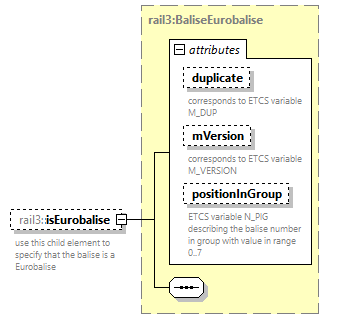 | ||||||||||||||||||||||||||||||
| namespace | https://www.railml.org/schemas/3.2 | ||||||||||||||||||||||||||||||
| type | rail3:BaliseEurobalise | ||||||||||||||||||||||||||||||
| properties |
| ||||||||||||||||||||||||||||||
| attributes |
| ||||||||||||||||||||||||||||||
| annotation |
| ||||||||||||||||||||||||||||||
| source | <xs:element name="isEurobalise" type="rail3:BaliseEurobalise" minOccurs="0" maxOccurs="1"> <xs:annotation> <xs:documentation>use this child element to specify that the balise is a Eurobalise</xs:documentation> </xs:annotation> </xs:element> |
complexType BaliseEurobalise
| diagram | 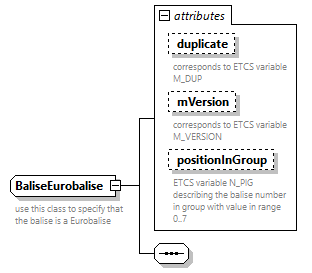 | ||||||||||||||||||||||||||||||
| namespace | https://www.railml.org/schemas/3.2 | ||||||||||||||||||||||||||||||
| used by |
| ||||||||||||||||||||||||||||||
| attributes |
| ||||||||||||||||||||||||||||||
| annotation |
| ||||||||||||||||||||||||||||||
| source | <xs:complexType name="BaliseEurobalise"> <xs:annotation> <xs:documentation>use this class to specify that the balise is a Eurobalise</xs:documentation> </xs:annotation> <xs:sequence/> <xs:attribute name="duplicate" type="rail3:tBaliseDuplicate" use="optional"> <xs:annotation> <xs:documentation>corresponds to ETCS variable M_DUP</xs:documentation> </xs:annotation> </xs:attribute> <xs:attribute name="mVersion" type="xs:nonNegativeInteger" use="optional"> <xs:annotation> <xs:documentation>corresponds to ETCS variable M_VERSION</xs:documentation> </xs:annotation> </xs:attribute> <xs:attribute name="positionInGroup" type="xs:integer" use="optional"> <xs:annotation> <xs:documentation>ETCS variable N_PIG describing the balise number in group with value in range 0..7</xs:documentation> </xs:annotation> </xs:attribute> </xs:complexType> |
attribute BaliseEurobalise/@duplicate
| type | rail3:tBaliseDuplicate | ||||||||||||
| properties |
| ||||||||||||
| facets |
| ||||||||||||
| annotation |
| ||||||||||||
| source | <xs:attribute name="duplicate" type="rail3:tBaliseDuplicate" use="optional"> <xs:annotation> <xs:documentation>corresponds to ETCS variable M_DUP</xs:documentation> </xs:annotation> </xs:attribute> |
attribute BaliseEurobalise/@mVersion
| type | xs:nonNegativeInteger | ||
| properties |
| ||
| annotation |
| ||
| source | <xs:attribute name="mVersion" type="xs:nonNegativeInteger" use="optional"> <xs:annotation> <xs:documentation>corresponds to ETCS variable M_VERSION</xs:documentation> </xs:annotation> </xs:attribute> |
attribute BaliseEurobalise/@positionInGroup
| type | xs:integer | ||
| properties |
| ||
| annotation |
| ||
| source | <xs:attribute name="positionInGroup" type="xs:integer" use="optional"> <xs:annotation> <xs:documentation>ETCS variable N_PIG describing the balise number in group with value in range 0..7</xs:documentation> </xs:annotation> </xs:attribute> |
complexType BaliseGroup
| diagram |  | ||||||||||||||||||||||||||||||||||||||
| namespace | https://www.railml.org/schemas/3.2 | ||||||||||||||||||||||||||||||||||||||
| type | extension of rail3:FunctionalInfrastructureEntity | ||||||||||||||||||||||||||||||||||||||
| properties |
| ||||||||||||||||||||||||||||||||||||||
| children | rail3:name rail3:isValid rail3:areaLocation rail3:linearLocation rail3:spotLocation rail3:gmlLocations rail3:networkLocation rail3:designator rail3:external rail3:typeDesignator rail3:applicationType rail3:connectedWithInfrastructureElement rail3:functionalType rail3:isEurobaliseGroup | ||||||||||||||||||||||||||||||||||||||
| used by |
| ||||||||||||||||||||||||||||||||||||||
| attributes |
| ||||||||||||||||||||||||||||||||||||||
| annotation |
| ||||||||||||||||||||||||||||||||||||||
| source | <xs:complexType name="BaliseGroup"> <xs:annotation> <xs:documentation>One or more balises which are treated as having the same reference location on the track. The telegrams transmitted by all the balises of a group form a track-to-train message [ERTMS/ETCS Glossary of Terms and Abbreviations].</xs:documentation> </xs:annotation> <xs:complexContent> <xs:extension base="rail3:FunctionalInfrastructureEntity"> <xs:sequence> <xs:element name="applicationType" type="rail3:BaliseGroupApplicationType" minOccurs="1" maxOccurs="unbounded"> <xs:annotation> <xs:documentation>train protection system of this balise group</xs:documentation> </xs:annotation> </xs:element> <xs:element name="connectedWithInfrastructureElement" type="rail3:BaliseGroupConnection" minOccurs="0" maxOccurs="unbounded"> <xs:annotation> <xs:documentation>specify an infrastructure element that is linked with this balise group: signal, levelTransition, radioBlockCenterBorder, switch, bufferStop</xs:documentation> </xs:annotation> </xs:element> <xs:element name="functionalType" type="rail3:BaliseGroupFunctionalType" minOccurs="0" maxOccurs="unbounded"/> <xs:element name="isEurobaliseGroup" type="rail3:BaliseGroupEurobalise" minOccurs="0" maxOccurs="1"> <xs:annotation> <xs:documentation>use this child element to specify that the BaliseGroup is a Eurobalise BaliseGroup</xs:documentation> </xs:annotation> </xs:element> </xs:sequence> <xs:attribute name="coverage" type="rail3:tBaliseGroupCoverage" use="optional"> <xs:annotation> <xs:documentation>specifies the balise group coverage as being 'physical', 'virtual', 'both' or 'none'.</xs:documentation> </xs:annotation> </xs:attribute> <xs:attribute name="mileageDirection" type="rail3:tMileageDirection" use="optional"> <xs:annotation> <xs:documentation>specifies the orientation of the balise group in reference to the mileage / kilometer chainage</xs:documentation> </xs:annotation> </xs:attribute> <xs:attribute name="numberOfBalisesInGroup" type="xs:integer" use="optional"> <xs:annotation> <xs:documentation>for Eurobalises this attribute corresponds to the ETCS variable N_TOTAL incremented by 1</xs:documentation> </xs:annotation> </xs:attribute> </xs:extension> </xs:complexContent> </xs:complexType> |
attribute BaliseGroup/@coverage
| type | rail3:tBaliseGroupCoverage | |||||||||||||||
| properties |
| |||||||||||||||
| facets |
| |||||||||||||||
| annotation |
| |||||||||||||||
| source | <xs:attribute name="coverage" type="rail3:tBaliseGroupCoverage" use="optional"> <xs:annotation> <xs:documentation>specifies the balise group coverage as being 'physical', 'virtual', 'both' or 'none'.</xs:documentation> </xs:annotation> </xs:attribute> |
attribute BaliseGroup/@mileageDirection
| type | rail3:tMileageDirection | |||||||||||||
| properties |
| |||||||||||||
| facets |
| |||||||||||||
| annotation |
| |||||||||||||
| source | <xs:attribute name="mileageDirection" type="rail3:tMileageDirection" use="optional"> <xs:annotation> <xs:documentation>specifies the orientation of the balise group in reference to the mileage / kilometer chainage</xs:documentation> </xs:annotation> </xs:attribute> |
attribute BaliseGroup/@numberOfBalisesInGroup
| type | xs:integer | ||
| properties |
| ||
| annotation |
| ||
| source | <xs:attribute name="numberOfBalisesInGroup" type="xs:integer" use="optional"> <xs:annotation> <xs:documentation>for Eurobalises this attribute corresponds to the ETCS variable N_TOTAL incremented by 1</xs:documentation> </xs:annotation> </xs:attribute> |
element BaliseGroup/applicationType
| diagram | 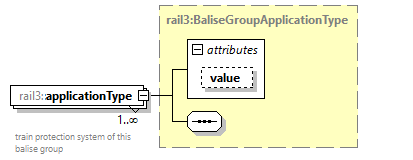 | ||||||||||||
| namespace | https://www.railml.org/schemas/3.2 | ||||||||||||
| type | rail3:BaliseGroupApplicationType | ||||||||||||
| properties |
| ||||||||||||
| attributes |
| ||||||||||||
| annotation |
| ||||||||||||
| source | <xs:element name="applicationType" type="rail3:BaliseGroupApplicationType" minOccurs="1" maxOccurs="unbounded"> <xs:annotation> <xs:documentation>train protection system of this balise group</xs:documentation> </xs:annotation> </xs:element> |
element BaliseGroup/connectedWithInfrastructureElement
| diagram | 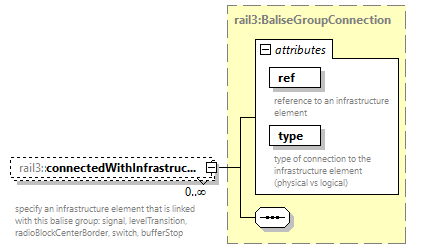 | ||||||||||||||||||||||
| namespace | https://www.railml.org/schemas/3.2 | ||||||||||||||||||||||
| type | rail3:BaliseGroupConnection | ||||||||||||||||||||||
| properties |
| ||||||||||||||||||||||
| attributes |
| ||||||||||||||||||||||
| annotation |
| ||||||||||||||||||||||
| source | <xs:element name="connectedWithInfrastructureElement" type="rail3:BaliseGroupConnection" minOccurs="0" maxOccurs="unbounded"> <xs:annotation> <xs:documentation>specify an infrastructure element that is linked with this balise group: signal, levelTransition, radioBlockCenterBorder, switch, bufferStop</xs:documentation> </xs:annotation> </xs:element> |
element BaliseGroup/functionalType
| diagram | 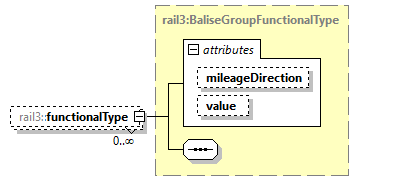 | ||||||||||||||||||
| namespace | https://www.railml.org/schemas/3.2 | ||||||||||||||||||
| type | rail3:BaliseGroupFunctionalType | ||||||||||||||||||
| properties |
| ||||||||||||||||||
| attributes |
| ||||||||||||||||||
| source | <xs:element name="functionalType" type="rail3:BaliseGroupFunctionalType" minOccurs="0" maxOccurs="unbounded"/> |
element BaliseGroup/isEurobaliseGroup
| diagram | 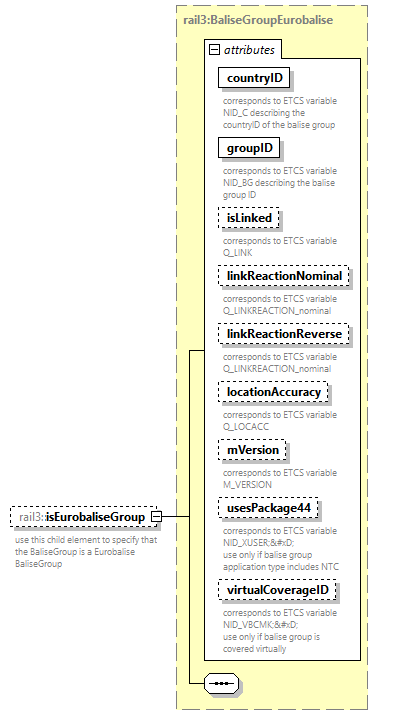 | ||||||||||||||||||||||||||||||||||||||||||||||||||||||||||||||||||||||||||||||
| namespace | https://www.railml.org/schemas/3.2 | ||||||||||||||||||||||||||||||||||||||||||||||||||||||||||||||||||||||||||||||
| type | rail3:BaliseGroupEurobalise | ||||||||||||||||||||||||||||||||||||||||||||||||||||||||||||||||||||||||||||||
| properties |
| ||||||||||||||||||||||||||||||||||||||||||||||||||||||||||||||||||||||||||||||
| attributes |
| ||||||||||||||||||||||||||||||||||||||||||||||||||||||||||||||||||||||||||||||
| annotation |
| ||||||||||||||||||||||||||||||||||||||||||||||||||||||||||||||||||||||||||||||
| source | <xs:element name="isEurobaliseGroup" type="rail3:BaliseGroupEurobalise" minOccurs="0" maxOccurs="1"> <xs:annotation> <xs:documentation>use this child element to specify that the BaliseGroup is a Eurobalise BaliseGroup</xs:documentation> </xs:annotation> </xs:element> |
complexType BaliseGroupApplicationType
| diagram | 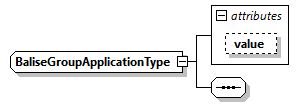 | ||||||||||||
| namespace | https://www.railml.org/schemas/3.2 | ||||||||||||
| used by |
| ||||||||||||
| attributes |
| ||||||||||||
| source | <xs:complexType name="BaliseGroupApplicationType"> <xs:sequence/> <xs:attribute name="value" type="rail3:tBaliseGroupApplicationTypeExt" use="optional"/> </xs:complexType> |
attribute BaliseGroupApplicationType/@value
| type | rail3:tBaliseGroupApplicationTypeExt | ||
| properties |
| ||
| source | <xs:attribute name="value" type="rail3:tBaliseGroupApplicationTypeExt" use="optional"/> |
complexType BaliseGroupConnection
| diagram | 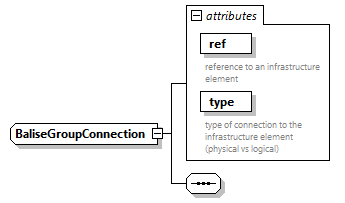 | ||||||||||||||||||||||
| namespace | https://www.railml.org/schemas/3.2 | ||||||||||||||||||||||
| used by |
| ||||||||||||||||||||||
| attributes |
| ||||||||||||||||||||||
| source | <xs:complexType name="BaliseGroupConnection"> <xs:sequence/> <xs:attribute name="ref" type="rail3:tRef" use="required"> <xs:annotation> <xs:documentation>reference to an infrastructure element</xs:documentation> </xs:annotation> </xs:attribute> <xs:attribute name="type" type="rail3:tBaliseGroupConnectionType" use="required"> <xs:annotation> <xs:documentation>type of connection to the infrastructure element (physical vs logical)</xs:documentation> </xs:annotation> </xs:attribute> </xs:complexType> |
attribute BaliseGroupConnection/@ref
| type | rail3:tRef | ||
| properties |
| ||
| annotation |
| ||
| source | <xs:attribute name="ref" type="rail3:tRef" use="required"> <xs:annotation> <xs:documentation>reference to an infrastructure element</xs:documentation> </xs:annotation> </xs:attribute> |
attribute BaliseGroupConnection/@type
| type | rail3:tBaliseGroupConnectionType | |||||||||
| properties |
| |||||||||
| facets |
| |||||||||
| annotation |
| |||||||||
| source | <xs:attribute name="type" type="rail3:tBaliseGroupConnectionType" use="required"> <xs:annotation> <xs:documentation>type of connection to the infrastructure element (physical vs logical)</xs:documentation> </xs:annotation> </xs:attribute> |
complexType BaliseGroupEurobalise
| diagram | 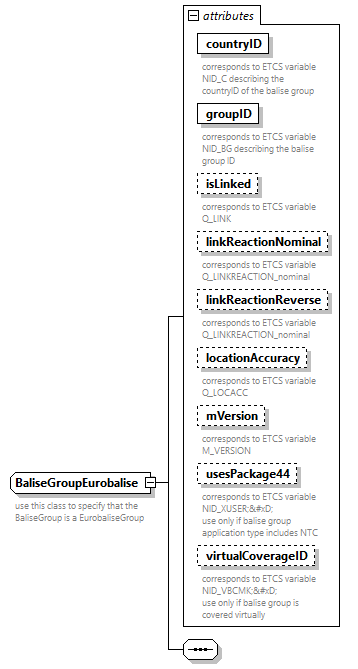 | ||||||||||||||||||||||||||||||||||||||||||||||||||||||||||||||||||||||||||||||
| namespace | https://www.railml.org/schemas/3.2 | ||||||||||||||||||||||||||||||||||||||||||||||||||||||||||||||||||||||||||||||
| used by |
| ||||||||||||||||||||||||||||||||||||||||||||||||||||||||||||||||||||||||||||||
| attributes |
| ||||||||||||||||||||||||||||||||||||||||||||||||||||||||||||||||||||||||||||||
| annotation |
| ||||||||||||||||||||||||||||||||||||||||||||||||||||||||||||||||||||||||||||||
| source | <xs:complexType name="BaliseGroupEurobalise"> <xs:annotation> <xs:documentation>use this class to specify that the BaliseGroup is a EurobaliseGroup</xs:documentation> </xs:annotation> <xs:sequence/> <xs:attribute name="countryID" type="xs:integer" use="required"> <xs:annotation> <xs:documentation>corresponds to ETCS variable NID_C describing the countryID of the balise group</xs:documentation> </xs:annotation> </xs:attribute> <xs:attribute name="groupID" type="xs:integer" use="required"> <xs:annotation> <xs:documentation>corresponds to ETCS variable NID_BG describing the balise group ID</xs:documentation> </xs:annotation> </xs:attribute> <xs:attribute name="isLinked" type="xs:boolean" use="optional"> <xs:annotation> <xs:documentation>corresponds to ETCS variable Q_LINK</xs:documentation> </xs:annotation> </xs:attribute> <xs:attribute name="linkReactionNominal" type="rail3:tBaliseGroupLinkReaction" use="optional"> <xs:annotation> <xs:documentation>corresponds to ETCS variable Q_LINKREACTION_nominal</xs:documentation> </xs:annotation> </xs:attribute> <xs:attribute name="linkReactionReverse" type="rail3:tBaliseGroupLinkReaction" use="optional"> <xs:annotation> <xs:documentation>corresponds to ETCS variable Q_LINKREACTION_nominal</xs:documentation> </xs:annotation> </xs:attribute> <xs:attribute name="locationAccuracy" type="rail3:tLengthM" use="optional"> <xs:annotation> <xs:documentation>corresponds to ETCS variable Q_LOCACC</xs:documentation> </xs:annotation> </xs:attribute> <xs:attribute name="mVersion" type="xs:nonNegativeInteger" use="optional"> <xs:annotation> <xs:documentation>corresponds to ETCS variable M_VERSION</xs:documentation> </xs:annotation> </xs:attribute> <xs:attribute name="usesPackage44" type="xs:integer" use="optional"> <xs:annotation> <xs:documentation>corresponds to ETCS variable NID_XUSER;
 use only if balise group application type includes NTC</xs:documentation> </xs:annotation> </xs:attribute> <xs:attribute name="virtualCoverageID" type="xs:integer" use="optional"> <xs:annotation> <xs:documentation>corresponds to ETCS variable NID_VBCMK;
 use only if balise group is covered virtually</xs:documentation> </xs:annotation> </xs:attribute> </xs:complexType> |
attribute BaliseGroupEurobalise/@countryID
| type | xs:integer | ||
| properties |
| ||
| annotation |
| ||
| source | <xs:attribute name="countryID" type="xs:integer" use="required"> <xs:annotation> <xs:documentation>corresponds to ETCS variable NID_C describing the countryID of the balise group</xs:documentation> </xs:annotation> </xs:attribute> |
attribute BaliseGroupEurobalise/@groupID
| type | xs:integer | ||
| properties |
| ||
| annotation |
| ||
| source | <xs:attribute name="groupID" type="xs:integer" use="required"> <xs:annotation> <xs:documentation>corresponds to ETCS variable NID_BG describing the balise group ID</xs:documentation> </xs:annotation> </xs:attribute> |
attribute BaliseGroupEurobalise/@isLinked
| type | xs:boolean | ||
| properties |
| ||
| annotation |
| ||
| source | <xs:attribute name="isLinked" type="xs:boolean" use="optional"> <xs:annotation> <xs:documentation>corresponds to ETCS variable Q_LINK</xs:documentation> </xs:annotation> </xs:attribute> |
attribute BaliseGroupEurobalise/@linkReactionNominal
| type | rail3:tBaliseGroupLinkReaction | ||||||||||||
| properties |
| ||||||||||||
| facets |
| ||||||||||||
| annotation |
| ||||||||||||
| source | <xs:attribute name="linkReactionNominal" type="rail3:tBaliseGroupLinkReaction" use="optional"> <xs:annotation> <xs:documentation>corresponds to ETCS variable Q_LINKREACTION_nominal</xs:documentation> </xs:annotation> </xs:attribute> |
attribute BaliseGroupEurobalise/@linkReactionReverse
| type | rail3:tBaliseGroupLinkReaction | ||||||||||||
| properties |
| ||||||||||||
| facets |
| ||||||||||||
| annotation |
| ||||||||||||
| source | <xs:attribute name="linkReactionReverse" type="rail3:tBaliseGroupLinkReaction" use="optional"> <xs:annotation> <xs:documentation>corresponds to ETCS variable Q_LINKREACTION_nominal</xs:documentation> </xs:annotation> </xs:attribute> |
attribute BaliseGroupEurobalise/@locationAccuracy
| type | rail3:tLengthM | ||
| properties |
| ||
| annotation |
| ||
| source | <xs:attribute name="locationAccuracy" type="rail3:tLengthM" use="optional"> <xs:annotation> <xs:documentation>corresponds to ETCS variable Q_LOCACC</xs:documentation> </xs:annotation> </xs:attribute> |
attribute BaliseGroupEurobalise/@mVersion
| type | xs:nonNegativeInteger | ||
| properties |
| ||
| annotation |
| ||
| source | <xs:attribute name="mVersion" type="xs:nonNegativeInteger" use="optional"> <xs:annotation> <xs:documentation>corresponds to ETCS variable M_VERSION</xs:documentation> </xs:annotation> </xs:attribute> |
attribute BaliseGroupEurobalise/@usesPackage44
| type | xs:integer | ||
| properties |
| ||
| annotation |
| ||
| source | <xs:attribute name="usesPackage44" type="xs:integer" use="optional"> <xs:annotation> <xs:documentation>corresponds to ETCS variable NID_XUSER;
 use only if balise group application type includes NTC</xs:documentation> </xs:annotation> </xs:attribute> |
attribute BaliseGroupEurobalise/@virtualCoverageID
| type | xs:integer | ||
| properties |
| ||
| annotation |
| ||
| source | <xs:attribute name="virtualCoverageID" type="xs:integer" use="optional"> <xs:annotation> <xs:documentation>corresponds to ETCS variable NID_VBCMK;
 use only if balise group is covered virtually</xs:documentation> </xs:annotation> </xs:attribute> |
complexType BaliseGroupFunctionalType
| diagram | 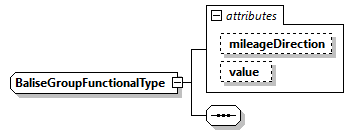 | ||||||||||||||||||
| namespace | https://www.railml.org/schemas/3.2 | ||||||||||||||||||
| used by |
| ||||||||||||||||||
| attributes |
| ||||||||||||||||||
| source | <xs:complexType name="BaliseGroupFunctionalType"> <xs:sequence/> <xs:attribute name="mileageDirection" type="rail3:tMileageDirection" use="optional"/> <xs:attribute name="value" type="rail3:tBaliseGroupFunctionalTypeExt" use="optional"/> </xs:complexType> |
attribute BaliseGroupFunctionalType/@mileageDirection
| type | rail3:tMileageDirection | |||||||||||||
| properties |
| |||||||||||||
| facets |
| |||||||||||||
| source | <xs:attribute name="mileageDirection" type="rail3:tMileageDirection" use="optional"/> |
attribute BaliseGroupFunctionalType/@value
| type | rail3:tBaliseGroupFunctionalTypeExt | ||
| properties |
| ||
| source | <xs:attribute name="value" type="rail3:tBaliseGroupFunctionalTypeExt" use="optional"/> |
complexType BaliseGroups
| diagram | 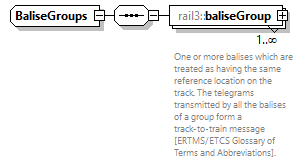 | ||
| namespace | https://www.railml.org/schemas/3.2 | ||
| children | rail3:baliseGroup | ||
| used by |
| ||
| source | <xs:complexType name="BaliseGroups"> <xs:sequence> <xs:element name="baliseGroup" type="rail3:BaliseGroup" minOccurs="1" maxOccurs="unbounded"> <xs:annotation> <xs:documentation>One or more balises which are treated as having the same reference location on the track. The telegrams transmitted by all the balises of a group form a track-to-train message [ERTMS/ETCS Glossary of Terms and Abbreviations].</xs:documentation> </xs:annotation> </xs:element> </xs:sequence> </xs:complexType> |
element BaliseGroups/baliseGroup
| diagram |  | ||||||||||||||||||||||||||||||||||||||
| namespace | https://www.railml.org/schemas/3.2 | ||||||||||||||||||||||||||||||||||||||
| type | rail3:BaliseGroup | ||||||||||||||||||||||||||||||||||||||
| properties |
| ||||||||||||||||||||||||||||||||||||||
| children | rail3:name rail3:isValid rail3:areaLocation rail3:linearLocation rail3:spotLocation rail3:gmlLocations rail3:networkLocation rail3:designator rail3:external rail3:typeDesignator rail3:applicationType rail3:connectedWithInfrastructureElement rail3:functionalType rail3:isEurobaliseGroup | ||||||||||||||||||||||||||||||||||||||
| attributes |
| ||||||||||||||||||||||||||||||||||||||
| annotation |
| ||||||||||||||||||||||||||||||||||||||
| source | <xs:element name="baliseGroup" type="rail3:BaliseGroup" minOccurs="1" maxOccurs="unbounded"> <xs:annotation> <xs:documentation>One or more balises which are treated as having the same reference location on the track. The telegrams transmitted by all the balises of a group form a track-to-train message [ERTMS/ETCS Glossary of Terms and Abbreviations].</xs:documentation> </xs:annotation> </xs:element> |
complexType Balises
| diagram | 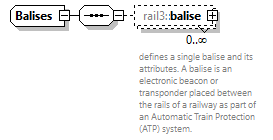 | ||
| namespace | https://www.railml.org/schemas/3.2 | ||
| children | rail3:balise | ||
| used by |
| ||
| source | <xs:complexType name="Balises"> <xs:sequence> <xs:element name="balise" type="rail3:Balise" minOccurs="0" maxOccurs="unbounded"> <xs:annotation> <xs:documentation>defines a single balise and its attributes. A balise is an electronic beacon or transponder placed between the rails of a railway as part of an Automatic Train Protection (ATP) system.</xs:documentation> </xs:annotation> </xs:element> </xs:sequence> </xs:complexType> |
element Balises/balise
| diagram |  | ||||||||||||||||||||||||||||||||||||||||||||||||||||||||||||||||||||||
| namespace | https://www.railml.org/schemas/3.2 | ||||||||||||||||||||||||||||||||||||||||||||||||||||||||||||||||||||||
| type | rail3:Balise | ||||||||||||||||||||||||||||||||||||||||||||||||||||||||||||||||||||||
| properties |
| ||||||||||||||||||||||||||||||||||||||||||||||||||||||||||||||||||||||
| children | rail3:name rail3:isValid rail3:areaLocation rail3:linearLocation rail3:spotLocation rail3:gmlLocations rail3:networkLocation rail3:designator rail3:external rail3:typeDesignator rail3:isEurobalise | ||||||||||||||||||||||||||||||||||||||||||||||||||||||||||||||||||||||
| attributes |
| ||||||||||||||||||||||||||||||||||||||||||||||||||||||||||||||||||||||
| annotation |
| ||||||||||||||||||||||||||||||||||||||||||||||||||||||||||||||||||||||
| source | <xs:element name="balise" type="rail3:Balise" minOccurs="0" maxOccurs="unbounded"> <xs:annotation> <xs:documentation>defines a single balise and its attributes. A balise is an electronic beacon or transponder placed between the rails of a railway as part of an Automatic Train Protection (ATP) system.</xs:documentation> </xs:annotation> </xs:element> |
complexType Border
| diagram | 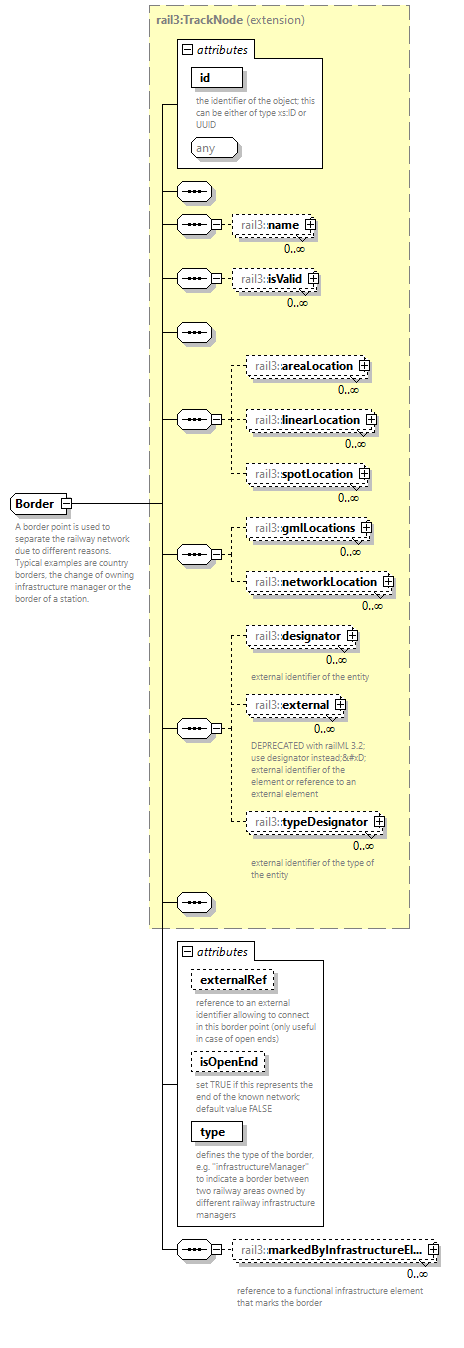 | ||||||||||||||||||||||||||||||||||||||
| namespace | https://www.railml.org/schemas/3.2 | ||||||||||||||||||||||||||||||||||||||
| type | extension of rail3:TrackNode | ||||||||||||||||||||||||||||||||||||||
| properties |
| ||||||||||||||||||||||||||||||||||||||
| children | rail3:name rail3:isValid rail3:areaLocation rail3:linearLocation rail3:spotLocation rail3:gmlLocations rail3:networkLocation rail3:designator rail3:external rail3:typeDesignator rail3:markedByInfrastructureElement | ||||||||||||||||||||||||||||||||||||||
| used by |
| ||||||||||||||||||||||||||||||||||||||
| attributes |
| ||||||||||||||||||||||||||||||||||||||
| annotation |
| ||||||||||||||||||||||||||||||||||||||
| source | <xs:complexType name="Border"> <xs:annotation> <xs:documentation>A border point is used to separate the railway network due to different reasons. Typical examples are country borders, the change of owning infrastructure manager or the border of a station.</xs:documentation> </xs:annotation> <xs:complexContent> <xs:extension base="rail3:TrackNode"> <xs:sequence> <xs:element name="markedByInfrastructureElement" type="rail3:tElementWithIDref" minOccurs="0" maxOccurs="unbounded"> <xs:annotation> <xs:documentation>reference to a functional infrastructure element that marks the border</xs:documentation> </xs:annotation> </xs:element> </xs:sequence> <xs:attribute name="externalRef" type="xs:string" use="optional"> <xs:annotation> <xs:documentation>reference to an external identifier allowing to connect in this border point (only useful in case of open ends)</xs:documentation> </xs:annotation> </xs:attribute> <xs:attribute name="isOpenEnd" type="xs:boolean" use="optional"> <xs:annotation> <xs:documentation>set TRUE if this represents the end of the known network; default value FALSE</xs:documentation> </xs:annotation> </xs:attribute> <xs:attribute name="type" type="rail3:tBorderTypeExt" use="required"> <xs:annotation> <xs:documentation>defines the type of the border, e.g. "infrastructureManager" to indicate a border between two railway areas owned by different railway infrastructure managers</xs:documentation> </xs:annotation> </xs:attribute> </xs:extension> </xs:complexContent> </xs:complexType> |
attribute Border/@externalRef
| type | xs:string | ||
| properties |
| ||
| annotation |
| ||
| source | <xs:attribute name="externalRef" type="xs:string" use="optional"> <xs:annotation> <xs:documentation>reference to an external identifier allowing to connect in this border point (only useful in case of open ends)</xs:documentation> </xs:annotation> </xs:attribute> |
attribute Border/@isOpenEnd
| type | xs:boolean | ||
| properties |
| ||
| annotation |
| ||
| source | <xs:attribute name="isOpenEnd" type="xs:boolean" use="optional"> <xs:annotation> <xs:documentation>set TRUE if this represents the end of the known network; default value FALSE</xs:documentation> </xs:annotation> </xs:attribute> |
attribute Border/@type
| type | rail3:tBorderTypeExt | ||
| properties |
| ||
| annotation |
| ||
| source | <xs:attribute name="type" type="rail3:tBorderTypeExt" use="required"> <xs:annotation> <xs:documentation>defines the type of the border, e.g. "infrastructureManager" to indicate a border between two railway areas owned by different railway infrastructure managers</xs:documentation> </xs:annotation> </xs:attribute> |
element Border/markedByInfrastructureElement
| diagram | 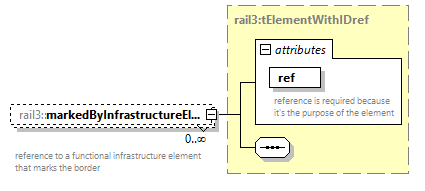 | ||||||||||||||
| namespace | https://www.railml.org/schemas/3.2 | ||||||||||||||
| type | rail3:tElementWithIDref | ||||||||||||||
| properties |
| ||||||||||||||
| attributes |
| ||||||||||||||
| annotation |
| ||||||||||||||
| source | <xs:element name="markedByInfrastructureElement" type="rail3:tElementWithIDref" minOccurs="0" maxOccurs="unbounded"> <xs:annotation> <xs:documentation>reference to a functional infrastructure element that marks the border</xs:documentation> </xs:annotation> </xs:element> |
complexType Borders
| diagram |  | ||
| namespace | https://www.railml.org/schemas/3.2 | ||
| children | rail3:border | ||
| used by |
| ||
| source | <xs:complexType name="Borders"> <xs:sequence> <xs:element name="border" type="rail3:Border" minOccurs="1" maxOccurs="unbounded"/> </xs:sequence> </xs:complexType> |
element Borders/border
| diagram |  | ||||||||||||||||||||||||||||||||||||||
| namespace | https://www.railml.org/schemas/3.2 | ||||||||||||||||||||||||||||||||||||||
| type | rail3:Border | ||||||||||||||||||||||||||||||||||||||
| properties |
| ||||||||||||||||||||||||||||||||||||||
| children | rail3:name rail3:isValid rail3:areaLocation rail3:linearLocation rail3:spotLocation rail3:gmlLocations rail3:networkLocation rail3:designator rail3:external rail3:typeDesignator rail3:markedByInfrastructureElement | ||||||||||||||||||||||||||||||||||||||
| attributes |
| ||||||||||||||||||||||||||||||||||||||
| source | <xs:element name="border" type="rail3:Border" minOccurs="1" maxOccurs="unbounded"/> |
complexType BufferStop
| diagram | 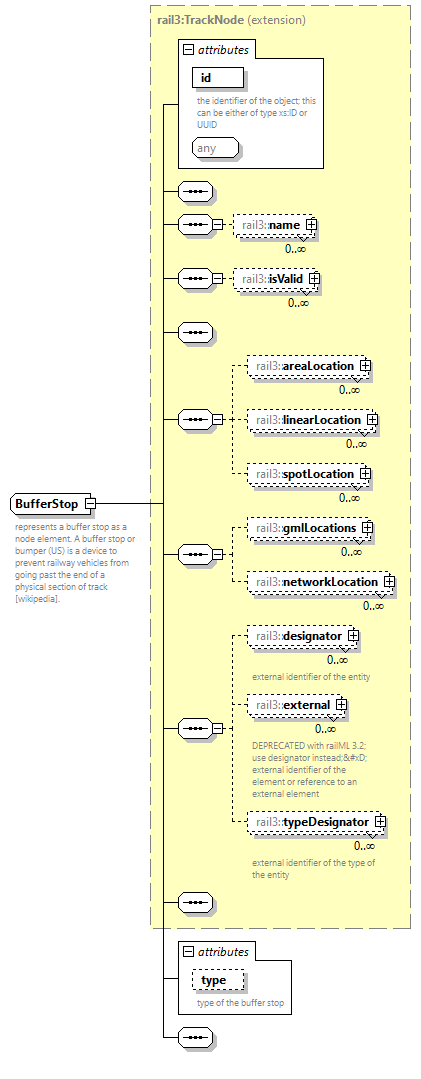 | ||||||||||||||||||||||
| namespace | https://www.railml.org/schemas/3.2 | ||||||||||||||||||||||
| type | extension of rail3:TrackNode | ||||||||||||||||||||||
| properties |
| ||||||||||||||||||||||
| children | rail3:name rail3:isValid rail3:areaLocation rail3:linearLocation rail3:spotLocation rail3:gmlLocations rail3:networkLocation rail3:designator rail3:external rail3:typeDesignator | ||||||||||||||||||||||
| used by |
| ||||||||||||||||||||||
| attributes |
| ||||||||||||||||||||||
| annotation |
| ||||||||||||||||||||||
| source | <xs:complexType name="BufferStop"> <xs:annotation> <xs:documentation>represents a buffer stop as a node element. A buffer stop or bumper (US) is a device to prevent railway vehicles from going past the end of a physical section of track [wikipedia].</xs:documentation> </xs:annotation> <xs:complexContent> <xs:extension base="rail3:TrackNode"> <xs:sequence/> <xs:attribute name="type" type="rail3:tBufferStopType" use="optional"> <xs:annotation> <xs:documentation>type of the buffer stop</xs:documentation> </xs:annotation> </xs:attribute> </xs:extension> </xs:complexContent> </xs:complexType> |
attribute BufferStop/@type
| type | rail3:tBufferStopType | |||||||||||||||
| properties |
| |||||||||||||||
| facets |
| |||||||||||||||
| annotation |
| |||||||||||||||
| source | <xs:attribute name="type" type="rail3:tBufferStopType" use="optional"> <xs:annotation> <xs:documentation>type of the buffer stop</xs:documentation> </xs:annotation> </xs:attribute> |
complexType BufferStops
| diagram | 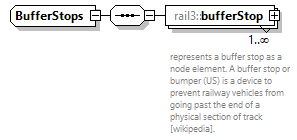 | ||
| namespace | https://www.railml.org/schemas/3.2 | ||
| children | rail3:bufferStop | ||
| used by |
| ||
| source | <xs:complexType name="BufferStops"> <xs:sequence> <xs:element name="bufferStop" type="rail3:BufferStop" minOccurs="1" maxOccurs="unbounded"> <xs:annotation> <xs:documentation>represents a buffer stop as a node element. A buffer stop or bumper (US) is a device to prevent railway vehicles from going past the end of a physical section of track [wikipedia].</xs:documentation> </xs:annotation> </xs:element> </xs:sequence> </xs:complexType> |
element BufferStops/bufferStop
| diagram | 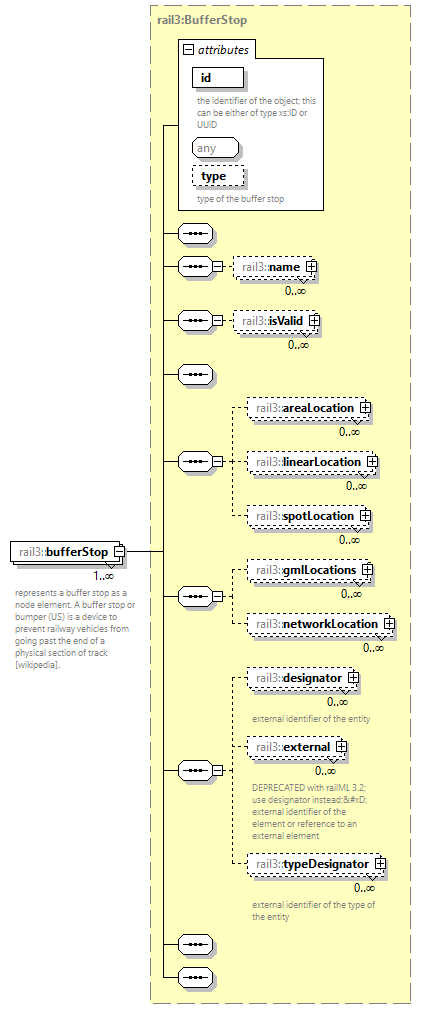 | ||||||||||||||||||||||
| namespace | https://www.railml.org/schemas/3.2 | ||||||||||||||||||||||
| type | rail3:BufferStop | ||||||||||||||||||||||
| properties |
| ||||||||||||||||||||||
| children | rail3:name rail3:isValid rail3:areaLocation rail3:linearLocation rail3:spotLocation rail3:gmlLocations rail3:networkLocation rail3:designator rail3:external rail3:typeDesignator | ||||||||||||||||||||||
| attributes |
| ||||||||||||||||||||||
| annotation |
| ||||||||||||||||||||||
| source | <xs:element name="bufferStop" type="rail3:BufferStop" minOccurs="1" maxOccurs="unbounded"> <xs:annotation> <xs:documentation>represents a buffer stop as a node element. A buffer stop or bumper (US) is a device to prevent railway vehicles from going past the end of a physical section of track [wikipedia].</xs:documentation> </xs:annotation> </xs:element> |
complexType Circle
| diagram | 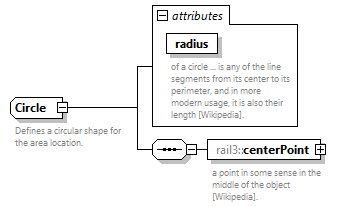 | ||||||||||||||
| namespace | https://www.railml.org/schemas/3.2 | ||||||||||||||
| children | rail3:centerPoint | ||||||||||||||
| used by |
| ||||||||||||||
| attributes |
| ||||||||||||||
| annotation |
| ||||||||||||||
| source | <xs:complexType name="Circle"> <xs:annotation> <xs:documentation>Defines a circular shape for the area location.</xs:documentation> </xs:annotation> <xs:sequence> <xs:element name="centerPoint" type="rail3:PointTypeCoordinate" minOccurs="1" maxOccurs="1"> <xs:annotation> <xs:documentation>a point in some sense in the middle of the object [Wikipedia].</xs:documentation> </xs:annotation> </xs:element> </xs:sequence> <xs:attribute name="radius" type="rail3:tLengthM" use="required"> <xs:annotation> <xs:documentation>of a circle ... is any of the line segments from its center to its perimeter, and in more modern usage, it is also their length [Wikipedia].</xs:documentation> </xs:annotation> </xs:attribute> </xs:complexType> |
attribute Circle/@radius
| type | rail3:tLengthM | ||
| properties |
| ||
| annotation |
| ||
| source | <xs:attribute name="radius" type="rail3:tLengthM" use="required"> <xs:annotation> <xs:documentation>of a circle ... is any of the line segments from its center to its perimeter, and in more modern usage, it is also their length [Wikipedia].</xs:documentation> </xs:annotation> </xs:attribute> |
element Circle/centerPoint
| diagram | 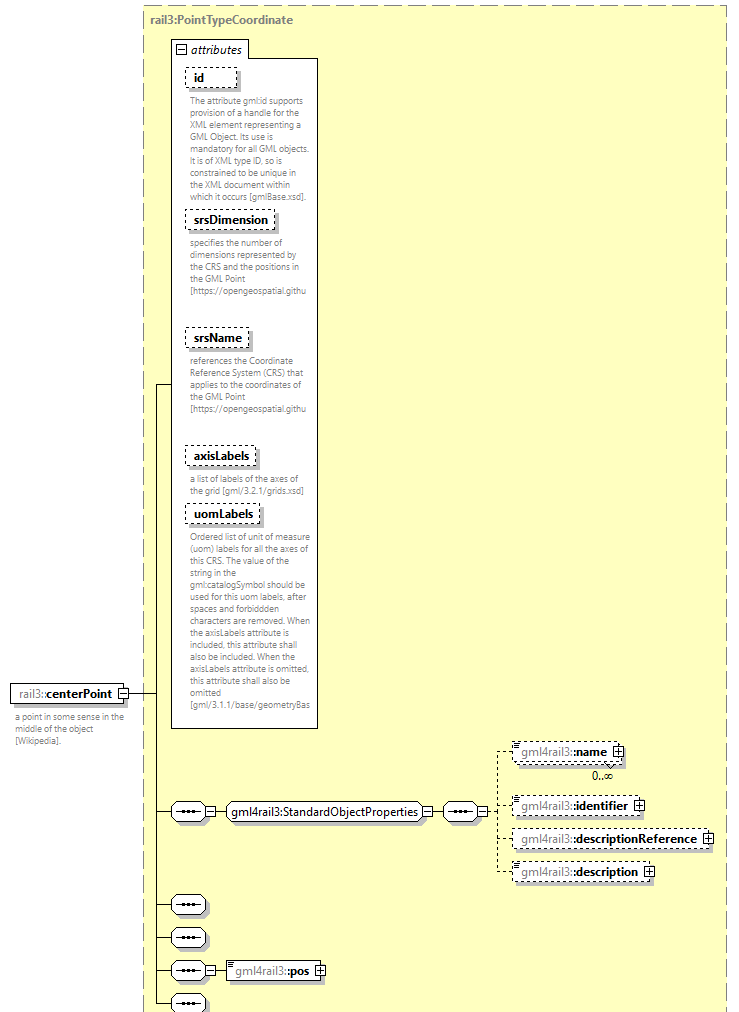 | ||||||||||||||||||||||||||||||||||||||||||||||
| namespace | https://www.railml.org/schemas/3.2 | ||||||||||||||||||||||||||||||||||||||||||||||
| type | rail3:PointTypeCoordinate | ||||||||||||||||||||||||||||||||||||||||||||||
| properties |
| ||||||||||||||||||||||||||||||||||||||||||||||
| children | gml4rail3:name gml4rail3:identifier gml4rail3:descriptionReference gml4rail3:description gml4rail3:pos | ||||||||||||||||||||||||||||||||||||||||||||||
| attributes |
| ||||||||||||||||||||||||||||||||||||||||||||||
| annotation |
| ||||||||||||||||||||||||||||||||||||||||||||||
| source | <xs:element name="centerPoint" type="rail3:PointTypeCoordinate" minOccurs="1" maxOccurs="1"> <xs:annotation> <xs:documentation>a point in some sense in the middle of the object [Wikipedia].</xs:documentation> </xs:annotation> </xs:element> |
complexType ContactWire
| diagram | 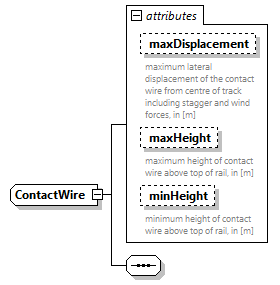 | ||||||||||||||||||||||||||||||
| namespace | https://www.railml.org/schemas/3.2 | ||||||||||||||||||||||||||||||
| used by |
| ||||||||||||||||||||||||||||||
| attributes |
| ||||||||||||||||||||||||||||||
| source | <xs:complexType name="ContactWire"> <xs:sequence/> <xs:attribute name="maxDisplacement" type="rail3:tLengthM" use="optional"> <xs:annotation> <xs:documentation>maximum lateral displacement of the contact wire from centre of track including stagger and wind forces, in [m]</xs:documentation> </xs:annotation> </xs:attribute> <xs:attribute name="maxHeight" type="rail3:tLengthM" use="optional"> <xs:annotation> <xs:documentation>maximum height of contact wire above top of rail, in [m]</xs:documentation> </xs:annotation> </xs:attribute> <xs:attribute name="minHeight" type="rail3:tLengthM" use="optional"> <xs:annotation> <xs:documentation>minimum height of contact wire above top of rail, in [m]</xs:documentation> </xs:annotation> </xs:attribute> </xs:complexType> |
attribute ContactWire/@maxDisplacement
| type | rail3:tLengthM | ||
| properties |
| ||
| annotation |
| ||
| source | <xs:attribute name="maxDisplacement" type="rail3:tLengthM" use="optional"> <xs:annotation> <xs:documentation>maximum lateral displacement of the contact wire from centre of track including stagger and wind forces, in [m]</xs:documentation> </xs:annotation> </xs:attribute> |
attribute ContactWire/@maxHeight
| type | rail3:tLengthM | ||
| properties |
| ||
| annotation |
| ||
| source | <xs:attribute name="maxHeight" type="rail3:tLengthM" use="optional"> <xs:annotation> <xs:documentation>maximum height of contact wire above top of rail, in [m]</xs:documentation> </xs:annotation> </xs:attribute> |
attribute ContactWire/@minHeight
| type | rail3:tLengthM | ||
| properties |
| ||
| annotation |
| ||
| source | <xs:attribute name="minHeight" type="rail3:tLengthM" use="optional"> <xs:annotation> <xs:documentation>minimum height of contact wire above top of rail, in [m]</xs:documentation> </xs:annotation> </xs:attribute> |
complexType CrossedElement
| diagram | 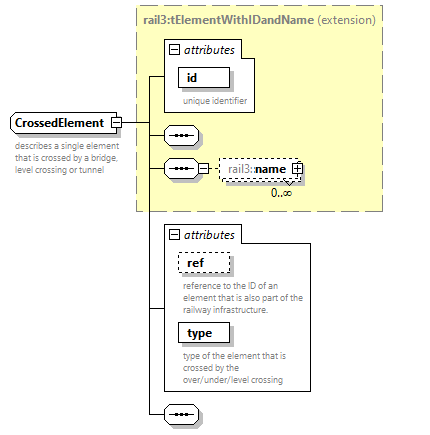 | ||||||||||||||||||||||||||||||
| namespace | https://www.railml.org/schemas/3.2 | ||||||||||||||||||||||||||||||
| type | extension of rail3:tElementWithIDandName | ||||||||||||||||||||||||||||||
| properties |
| ||||||||||||||||||||||||||||||
| children | rail3:name | ||||||||||||||||||||||||||||||
| used by |
| ||||||||||||||||||||||||||||||
| attributes |
| ||||||||||||||||||||||||||||||
| annotation |
| ||||||||||||||||||||||||||||||
| source | <xs:complexType name="CrossedElement"> <xs:annotation> <xs:documentation>describes a single element that is crossed by a bridge, level crossing or tunnel</xs:documentation> </xs:annotation> <xs:complexContent> <xs:extension base="rail3:tElementWithIDandName"> <xs:sequence/> <xs:attribute name="ref" type="rail3:tRef" use="optional"> <xs:annotation> <xs:documentation>reference to the ID of an element that is also part of the railway infrastructure.</xs:documentation> </xs:annotation> </xs:attribute> <xs:attribute name="type" type="rail3:tCrossedElementTypeExt" use="required"> <xs:annotation> <xs:documentation>type of the element that is crossed by the over/under/level crossing</xs:documentation> </xs:annotation> </xs:attribute> </xs:extension> </xs:complexContent> </xs:complexType> |
attribute CrossedElement/@ref
| type | rail3:tRef | ||
| properties |
| ||
| annotation |
| ||
| source | <xs:attribute name="ref" type="rail3:tRef" use="optional"> <xs:annotation> <xs:documentation>reference to the ID of an element that is also part of the railway infrastructure.</xs:documentation> </xs:annotation> </xs:attribute> |
attribute CrossedElement/@type
| type | rail3:tCrossedElementTypeExt | ||
| properties |
| ||
| annotation |
| ||
| source | <xs:attribute name="type" type="rail3:tCrossedElementTypeExt" use="required"> <xs:annotation> <xs:documentation>type of the element that is crossed by the over/under/level crossing</xs:documentation> </xs:annotation> </xs:attribute> |
complexType Crossing
| diagram | 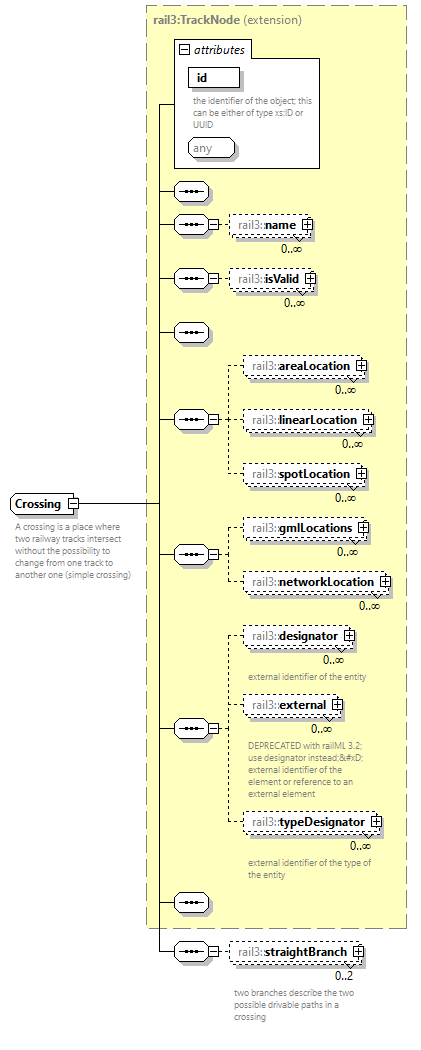 | ||||||||||||||
| namespace | https://www.railml.org/schemas/3.2 | ||||||||||||||
| type | extension of rail3:TrackNode | ||||||||||||||
| properties |
| ||||||||||||||
| children | rail3:name rail3:isValid rail3:areaLocation rail3:linearLocation rail3:spotLocation rail3:gmlLocations rail3:networkLocation rail3:designator rail3:external rail3:typeDesignator rail3:straightBranch | ||||||||||||||
| used by |
| ||||||||||||||
| attributes |
| ||||||||||||||
| annotation |
| ||||||||||||||
| source | <xs:complexType name="Crossing"> <xs:annotation> <xs:documentation>A crossing is a place where two railway tracks intersect without the possibility to change from one track to another one (simple crossing)</xs:documentation> </xs:annotation> <xs:complexContent> <xs:extension base="rail3:TrackNode"> <xs:sequence> <xs:element name="straightBranch" type="rail3:SwitchCrossingBranch" minOccurs="0" maxOccurs="2"> <xs:annotation> <xs:documentation>two branches describe the two possible drivable paths in a crossing</xs:documentation> </xs:annotation> </xs:element> </xs:sequence> </xs:extension> </xs:complexContent> </xs:complexType> |
element Crossing/straightBranch
| diagram | 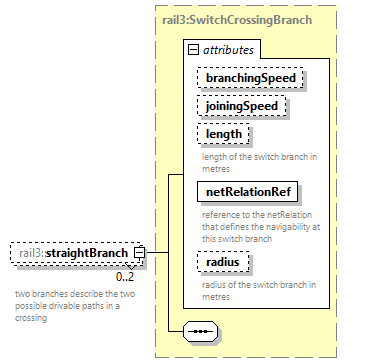 | ||||||||||||||||||||||||||||||||||||||||||
| namespace | https://www.railml.org/schemas/3.2 | ||||||||||||||||||||||||||||||||||||||||||
| type | rail3:SwitchCrossingBranch | ||||||||||||||||||||||||||||||||||||||||||
| properties |
| ||||||||||||||||||||||||||||||||||||||||||
| attributes |
| ||||||||||||||||||||||||||||||||||||||||||
| annotation |
| ||||||||||||||||||||||||||||||||||||||||||
| source | <xs:element name="straightBranch" type="rail3:SwitchCrossingBranch" minOccurs="0" maxOccurs="2"> <xs:annotation> <xs:documentation>two branches describe the two possible drivable paths in a crossing</xs:documentation> </xs:annotation> </xs:element> |
complexType Crossings
| diagram |  | ||
| namespace | https://www.railml.org/schemas/3.2 | ||
| children | rail3:crossing | ||
| used by |
| ||
| source | <xs:complexType name="Crossings"> <xs:sequence> <xs:element name="crossing" type="rail3:Crossing" minOccurs="1" maxOccurs="unbounded"/> </xs:sequence> </xs:complexType> |
element Crossings/crossing
| diagram | 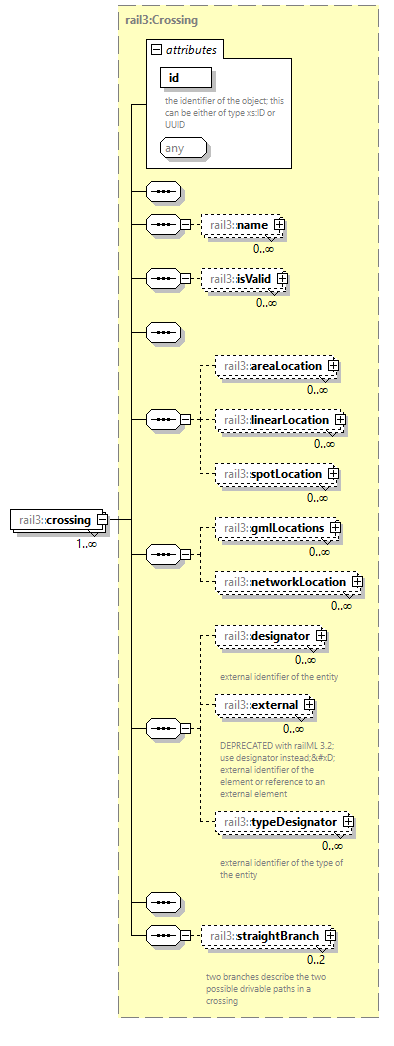 | ||||||||||||||
| namespace | https://www.railml.org/schemas/3.2 | ||||||||||||||
| type | rail3:Crossing | ||||||||||||||
| properties |
| ||||||||||||||
| children | rail3:name rail3:isValid rail3:areaLocation rail3:linearLocation rail3:spotLocation rail3:gmlLocations rail3:networkLocation rail3:designator rail3:external rail3:typeDesignator rail3:straightBranch | ||||||||||||||
| attributes |
| ||||||||||||||
| source | <xs:element name="crossing" type="rail3:Crossing" minOccurs="1" maxOccurs="unbounded"/> |
complexType DerailerIS
| diagram | 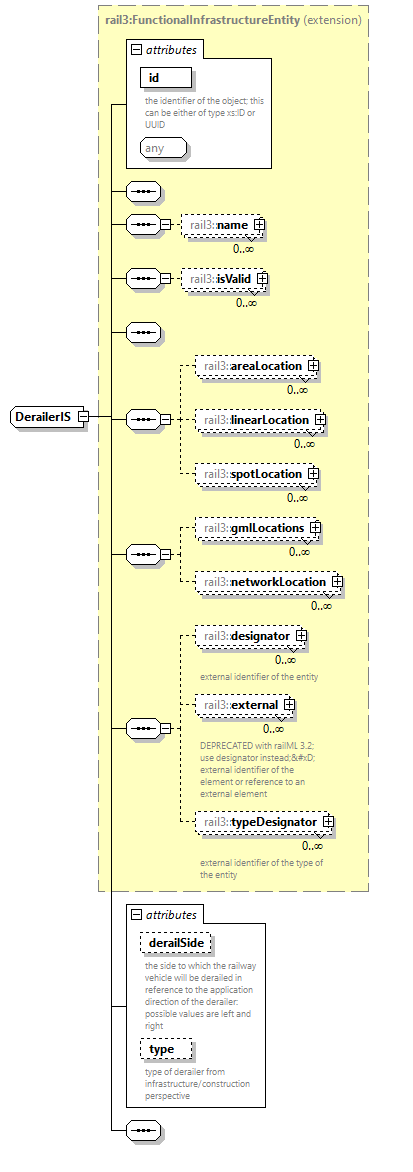 | ||||||||||||||||||||||||||||||
| namespace | https://www.railml.org/schemas/3.2 | ||||||||||||||||||||||||||||||
| type | extension of rail3:FunctionalInfrastructureEntity | ||||||||||||||||||||||||||||||
| properties |
| ||||||||||||||||||||||||||||||
| children | rail3:name rail3:isValid rail3:areaLocation rail3:linearLocation rail3:spotLocation rail3:gmlLocations rail3:networkLocation rail3:designator rail3:external rail3:typeDesignator | ||||||||||||||||||||||||||||||
| used by |
| ||||||||||||||||||||||||||||||
| attributes |
| ||||||||||||||||||||||||||||||
| source | <xs:complexType name="DerailerIS"> <xs:complexContent> <xs:extension base="rail3:FunctionalInfrastructureEntity"> <xs:sequence/> <xs:attribute name="derailSide" type="rail3:tSide" use="optional"> <xs:annotation> <xs:documentation>the side to which the railway vehicle will be derailed in reference to the application direction of the derailer: possible values are left and right</xs:documentation> </xs:annotation> </xs:attribute> <xs:attribute name="type" type="rail3:tDerailerType" use="optional"> <xs:annotation> <xs:documentation>type of derailer from infrastructure/construction perspective</xs:documentation> </xs:annotation> </xs:attribute> </xs:extension> </xs:complexContent> </xs:complexType> |
attribute DerailerIS/@derailSide
| type | rail3:tSide | |||||||||
| properties |
| |||||||||
| facets |
| |||||||||
| annotation |
| |||||||||
| source | <xs:attribute name="derailSide" type="rail3:tSide" use="optional"> <xs:annotation> <xs:documentation>the side to which the railway vehicle will be derailed in reference to the application direction of the derailer: possible values are left and right</xs:documentation> </xs:annotation> </xs:attribute> |
attribute DerailerIS/@type
| type | rail3:tDerailerType | |||||||||||||
| properties |
| |||||||||||||
| facets |
| |||||||||||||
| annotation |
| |||||||||||||
| source | <xs:attribute name="type" type="rail3:tDerailerType" use="optional"> <xs:annotation> <xs:documentation>type of derailer from infrastructure/construction perspective</xs:documentation> </xs:annotation> </xs:attribute> |
complexType DerailersIS
| diagram | 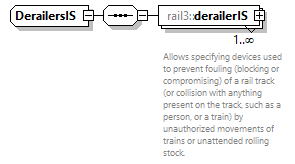 | ||
| namespace | https://www.railml.org/schemas/3.2 | ||
| children | rail3:derailerIS | ||
| used by |
| ||
| source | <xs:complexType name="DerailersIS"> <xs:sequence> <xs:element name="derailerIS" type="rail3:DerailerIS" minOccurs="1" maxOccurs="unbounded"> <xs:annotation> <xs:documentation>Allows specifying devices used to prevent fouling (blocking or compromising) of a rail track (or collision with anything present on the track, such as a person, or a train) by unauthorized movements of trains or unattended rolling stock.</xs:documentation> </xs:annotation> </xs:element> </xs:sequence> </xs:complexType> |
element DerailersIS/derailerIS
| diagram | 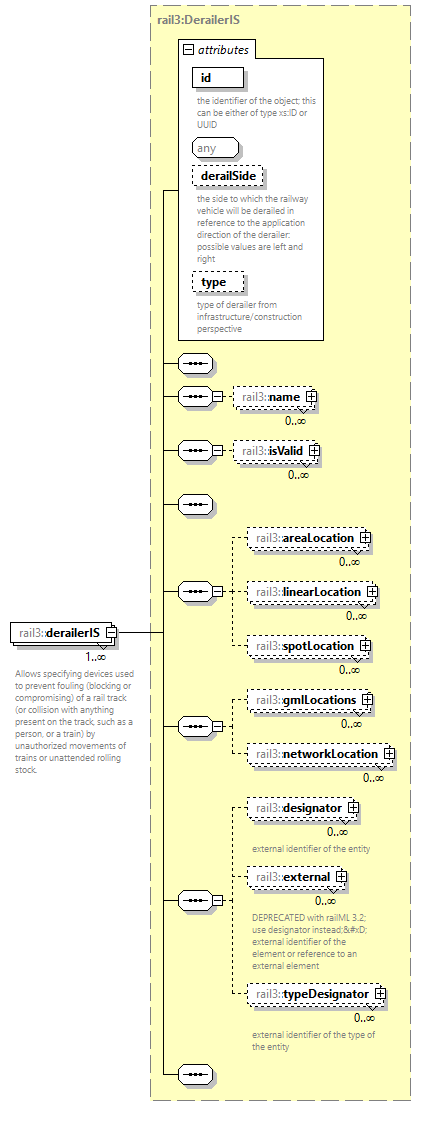 | ||||||||||||||||||||||||||||||
| namespace | https://www.railml.org/schemas/3.2 | ||||||||||||||||||||||||||||||
| type | rail3:DerailerIS | ||||||||||||||||||||||||||||||
| properties |
| ||||||||||||||||||||||||||||||
| children | rail3:name rail3:isValid rail3:areaLocation rail3:linearLocation rail3:spotLocation rail3:gmlLocations rail3:networkLocation rail3:designator rail3:external rail3:typeDesignator | ||||||||||||||||||||||||||||||
| attributes |
| ||||||||||||||||||||||||||||||
| annotation |
| ||||||||||||||||||||||||||||||
| source | <xs:element name="derailerIS" type="rail3:DerailerIS" minOccurs="1" maxOccurs="unbounded"> <xs:annotation> <xs:documentation>Allows specifying devices used to prevent fouling (blocking or compromising) of a rail track (or collision with anything present on the track, such as a person, or a train) by unauthorized movements of trains or unattended rolling stock.</xs:documentation> </xs:annotation> </xs:element> |
complexType Detector
| diagram | 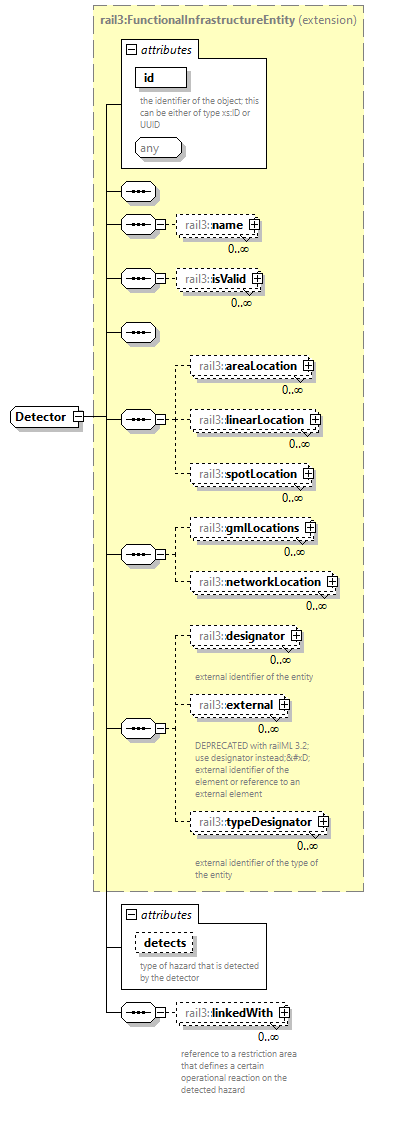 | ||||||||||||||||||||||
| namespace | https://www.railml.org/schemas/3.2 | ||||||||||||||||||||||
| type | extension of rail3:FunctionalInfrastructureEntity | ||||||||||||||||||||||
| properties |
| ||||||||||||||||||||||
| children | rail3:name rail3:isValid rail3:areaLocation rail3:linearLocation rail3:spotLocation rail3:gmlLocations rail3:networkLocation rail3:designator rail3:external rail3:typeDesignator rail3:linkedWith | ||||||||||||||||||||||
| used by |
| ||||||||||||||||||||||
| attributes |
| ||||||||||||||||||||||
| source | <xs:complexType name="Detector"> <xs:complexContent> <xs:extension base="rail3:FunctionalInfrastructureEntity"> <xs:sequence> <xs:element name="linkedWith" type="rail3:tElementWithIDref" minOccurs="0" maxOccurs="unbounded"> <xs:annotation> <xs:documentation>reference to a restriction area that defines a certain operational reaction on the detected hazard</xs:documentation> </xs:annotation> </xs:element> </xs:sequence> <xs:attribute name="detects" type="rail3:tHazardTypesExt" use="optional"> <xs:annotation> <xs:documentation>type of hazard that is detected by the detector</xs:documentation> </xs:annotation> </xs:attribute> </xs:extension> </xs:complexContent> </xs:complexType> |
attribute Detector/@detects
| type | rail3:tHazardTypesExt | ||
| properties |
| ||
| annotation |
| ||
| source | <xs:attribute name="detects" type="rail3:tHazardTypesExt" use="optional"> <xs:annotation> <xs:documentation>type of hazard that is detected by the detector</xs:documentation> </xs:annotation> </xs:attribute> |
element Detector/linkedWith
| diagram | 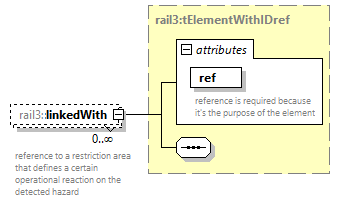 | ||||||||||||||
| namespace | https://www.railml.org/schemas/3.2 | ||||||||||||||
| type | rail3:tElementWithIDref | ||||||||||||||
| properties |
| ||||||||||||||
| attributes |
| ||||||||||||||
| annotation |
| ||||||||||||||
| source | <xs:element name="linkedWith" type="rail3:tElementWithIDref" minOccurs="0" maxOccurs="unbounded"> <xs:annotation> <xs:documentation>reference to a restriction area that defines a certain operational reaction on the detected hazard</xs:documentation> </xs:annotation> </xs:element> |
complexType Detectors
| diagram |  | ||
| namespace | https://www.railml.org/schemas/3.2 | ||
| children | rail3:detector | ||
| used by |
| ||
| source | <xs:complexType name="Detectors"> <xs:sequence> <xs:element name="detector" type="rail3:Detector" minOccurs="1" maxOccurs="unbounded"/> </xs:sequence> </xs:complexType> |
element Detectors/detector
| diagram | 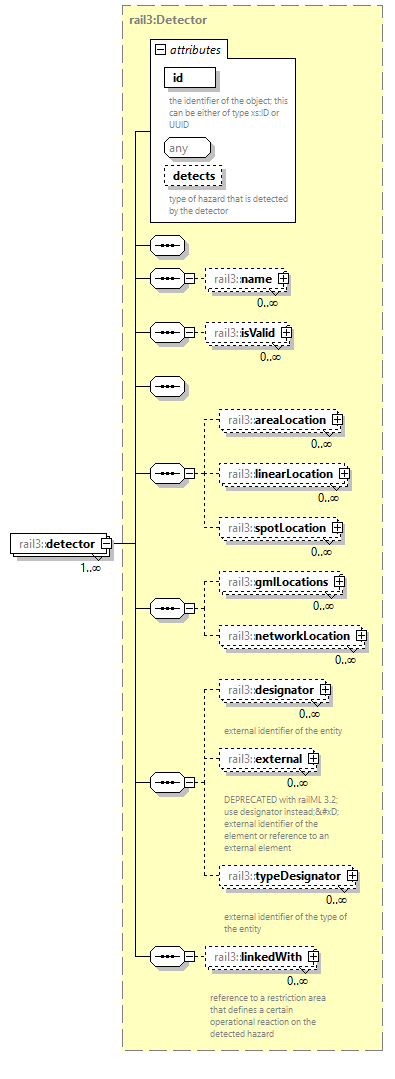 | ||||||||||||||||||||||
| namespace | https://www.railml.org/schemas/3.2 | ||||||||||||||||||||||
| type | rail3:Detector | ||||||||||||||||||||||
| properties |
| ||||||||||||||||||||||
| children | rail3:name rail3:isValid rail3:areaLocation rail3:linearLocation rail3:spotLocation rail3:gmlLocations rail3:networkLocation rail3:designator rail3:external rail3:typeDesignator rail3:linkedWith | ||||||||||||||||||||||
| attributes |
| ||||||||||||||||||||||
| source | <xs:element name="detector" type="rail3:Detector" minOccurs="1" maxOccurs="unbounded"/> |
complexType ElectrificationEtcs
| diagram | 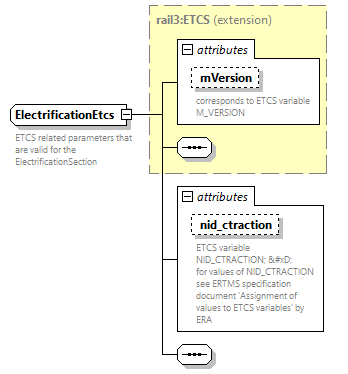 | ||||||||||||||||||||||
| namespace | https://www.railml.org/schemas/3.2 | ||||||||||||||||||||||
| type | extension of rail3:ETCS | ||||||||||||||||||||||
| properties |
| ||||||||||||||||||||||
| used by |
| ||||||||||||||||||||||
| attributes |
| ||||||||||||||||||||||
| annotation |
| ||||||||||||||||||||||
| source | <xs:complexType name="ElectrificationEtcs"> <xs:annotation> <xs:documentation>ETCS related parameters that are valid for the ElectrificationSection</xs:documentation> </xs:annotation> <xs:complexContent> <xs:extension base="rail3:ETCS"> <xs:sequence/> <xs:attribute name="nid_ctraction" type="xs:nonNegativeInteger" use="optional"> <xs:annotation> <xs:documentation>ETCS variable NID_CTRACTION; 
 for values of NID_CTRACTION see ERTMS specification document 'Assignment of values to ETCS variables' by ERA</xs:documentation> </xs:annotation> </xs:attribute> </xs:extension> </xs:complexContent> </xs:complexType> |
attribute ElectrificationEtcs/@nid_ctraction
| type | xs:nonNegativeInteger | ||
| properties |
| ||
| annotation |
| ||
| source | <xs:attribute name="nid_ctraction" type="xs:nonNegativeInteger" use="optional"> <xs:annotation> <xs:documentation>ETCS variable NID_CTRACTION; 
 for values of NID_CTRACTION see ERTMS specification document 'Assignment of values to ETCS variables' by ERA</xs:documentation> </xs:annotation> </xs:attribute> |
complexType Electrifications
| diagram |  | ||
| namespace | https://www.railml.org/schemas/3.2 | ||
| children | rail3:electrificationSection | ||
| used by |
| ||
| annotation |
| ||
| source | <xs:complexType name="Electrifications"> <xs:annotation> <xs:documentation>umbrella element for all electrification elements</xs:documentation> </xs:annotation> <xs:sequence> <xs:element name="electrificationSection" type="rail3:ElectrificationSection" minOccurs="1" maxOccurs="unbounded"> <xs:annotation> <xs:documentation>locates part of a track where given system of Used to describe sections of electric power for the propulsion of railway transport is applied</xs:documentation> </xs:annotation> </xs:element> </xs:sequence> </xs:complexType> |
element Electrifications/electrificationSection
| diagram |  | ||||||||||||||||||||||||||||||||||||||
| namespace | https://www.railml.org/schemas/3.2 | ||||||||||||||||||||||||||||||||||||||
| type | rail3:ElectrificationSection | ||||||||||||||||||||||||||||||||||||||
| properties |
| ||||||||||||||||||||||||||||||||||||||
| children | rail3:name rail3:isValid rail3:areaLocation rail3:linearLocation rail3:spotLocation rail3:gmlLocations rail3:networkLocation rail3:designator rail3:external rail3:typeDesignator rail3:electrificationSystemRef rail3:energyCatenary rail3:energyPantograph rail3:energyRollingstock rail3:etcsElectrification rail3:hasContactWire rail3:pantographSpacing rail3:phaseSeparationSection rail3:systemSeparationSection | ||||||||||||||||||||||||||||||||||||||
| attributes |
| ||||||||||||||||||||||||||||||||||||||
| annotation |
| ||||||||||||||||||||||||||||||||||||||
| source | <xs:element name="electrificationSection" type="rail3:ElectrificationSection" minOccurs="1" maxOccurs="unbounded"> <xs:annotation> <xs:documentation>locates part of a track where given system of Used to describe sections of electric power for the propulsion of railway transport is applied</xs:documentation> </xs:annotation> </xs:element> |
complexType ElectrificationSection
| diagram |  | ||||||||||||||||||||||||||||||||||||||
| namespace | https://www.railml.org/schemas/3.2 | ||||||||||||||||||||||||||||||||||||||
| type | extension of rail3:FunctionalInfrastructureEntity | ||||||||||||||||||||||||||||||||||||||
| properties |
| ||||||||||||||||||||||||||||||||||||||
| children | rail3:name rail3:isValid rail3:areaLocation rail3:linearLocation rail3:spotLocation rail3:gmlLocations rail3:networkLocation rail3:designator rail3:external rail3:typeDesignator rail3:electrificationSystemRef rail3:energyCatenary rail3:energyPantograph rail3:energyRollingstock rail3:etcsElectrification rail3:hasContactWire rail3:pantographSpacing rail3:phaseSeparationSection rail3:systemSeparationSection | ||||||||||||||||||||||||||||||||||||||
| used by |
| ||||||||||||||||||||||||||||||||||||||
| attributes |
| ||||||||||||||||||||||||||||||||||||||
| annotation |
| ||||||||||||||||||||||||||||||||||||||
| source | <xs:complexType name="ElectrificationSection"> <xs:annotation> <xs:documentation>locates part of a track where given system of electric power for the propulsion of railway transport is applied</xs:documentation> </xs:annotation> <xs:complexContent> <xs:extension base="rail3:FunctionalInfrastructureEntity"> <xs:sequence> <xs:element name="electrificationSystemRef" type="rail3:tElementWithIDref" minOccurs="0" maxOccurs="1"> <xs:annotation> <xs:documentation>reference to the electrification system</xs:documentation> </xs:annotation> </xs:element> <xs:element name="energyCatenary" type="rail3:EnergyCatenary" minOccurs="0" maxOccurs="1"> <xs:annotation> <xs:documentation>child element summarizing the catenary energy parameters</xs:documentation> </xs:annotation> </xs:element> <xs:element name="energyPantograph" type="rail3:EnergyPantograph" minOccurs="0" maxOccurs="1"> <xs:annotation> <xs:documentation>child element summarizing the pantograph energy parameters</xs:documentation> </xs:annotation> </xs:element> <xs:element name="energyRollingstock" type="rail3:EnergyRollingstock" minOccurs="0" maxOccurs="1"> <xs:annotation> <xs:documentation>child element summarizing the rollingstock energy parameters</xs:documentation> </xs:annotation> </xs:element> <xs:element name="etcsElectrification" type="rail3:ElectrificationEtcs" minOccurs="0" maxOccurs="1"> <xs:annotation> <xs:documentation>child element summarizing the ETCS related parameters and variables of the ElectrificationSection</xs:documentation> </xs:annotation> </xs:element> <xs:element name="hasContactWire" type="rail3:ContactWire" minOccurs="0" maxOccurs="1"> <xs:annotation> <xs:documentation>child element summarizing the construction details of the contact wire</xs:documentation> </xs:annotation> </xs:element> <xs:element name="pantographSpacing" type="rail3:PantographSpacing" minOccurs="0" maxOccurs="unbounded"> <xs:annotation> <xs:documentation>child element summarizing the pantograph spacing parameters</xs:documentation> </xs:annotation> </xs:element> <xs:element name="phaseSeparationSection" type="rail3:PhaseSeparationSection" minOccurs="0" maxOccurs="unbounded"> <xs:annotation> <xs:documentation>child element summarizing the phase separation parameters</xs:documentation> </xs:annotation> </xs:element> <xs:element name="systemSeparationSection" type="rail3:SystemSeparationSection" minOccurs="0" maxOccurs="unbounded"> <xs:annotation> <xs:documentation>child element summarizing the electrification system separation parameters</xs:documentation> </xs:annotation> </xs:element> </xs:sequence> <xs:attribute name="belongsToParent" type="rail3:tRef" use="optional"> <xs:annotation> <xs:documentation>reference to the (one and only) parent electrification section
 
 - if some information exists in parent and child, then information in child overwrites it in child
 
 - if some information exists only in parent, then child inherits this information from parent</xs:documentation> </xs:annotation> </xs:attribute> <xs:attribute name="contactLineType" type="rail3:tContactLineType" use="required"> <xs:annotation> <xs:documentation>type of the installed contact line (most common: overhead)</xs:documentation> </xs:annotation> </xs:attribute> <xs:attribute name="isInsulatedSection" type="xs:boolean" use="optional"> <xs:annotation> <xs:documentation>set true if the described electrification section is an insulated section</xs:documentation> </xs:annotation> </xs:attribute> </xs:extension> </xs:complexContent> </xs:complexType> |
attribute ElectrificationSection/@belongsToParent
| type | rail3:tRef | ||
| properties |
| ||
| annotation |
| ||
| source | <xs:attribute name="belongsToParent" type="rail3:tRef" use="optional"> <xs:annotation> <xs:documentation>reference to the (one and only) parent electrification section
 
 - if some information exists in parent and child, then information in child overwrites it in child
 
 - if some information exists only in parent, then child inherits this information from parent</xs:documentation> </xs:annotation> </xs:attribute> |
attribute ElectrificationSection/@contactLineType
| type | rail3:tContactLineType | |||||||||||||||||||||
| properties |
| |||||||||||||||||||||
| facets |
| |||||||||||||||||||||
| annotation |
| |||||||||||||||||||||
| source | <xs:attribute name="contactLineType" type="rail3:tContactLineType" use="required"> <xs:annotation> <xs:documentation>type of the installed contact line (most common: overhead)</xs:documentation> </xs:annotation> </xs:attribute> |
attribute ElectrificationSection/@isInsulatedSection
| type | xs:boolean | ||
| properties |
| ||
| annotation |
| ||
| source | <xs:attribute name="isInsulatedSection" type="xs:boolean" use="optional"> <xs:annotation> <xs:documentation>set true if the described electrification section is an insulated section</xs:documentation> </xs:annotation> </xs:attribute> |
element ElectrificationSection/electrificationSystemRef
| diagram | 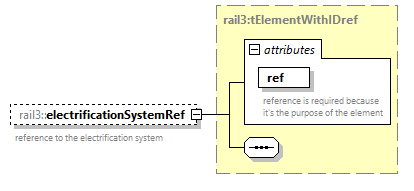 | ||||||||||||||
| namespace | https://www.railml.org/schemas/3.2 | ||||||||||||||
| type | rail3:tElementWithIDref | ||||||||||||||
| properties |
| ||||||||||||||
| attributes |
| ||||||||||||||
| annotation |
| ||||||||||||||
| source | <xs:element name="electrificationSystemRef" type="rail3:tElementWithIDref" minOccurs="0" maxOccurs="1"> <xs:annotation> <xs:documentation>reference to the electrification system</xs:documentation> </xs:annotation> </xs:element> |
element ElectrificationSection/energyCatenary
| diagram | 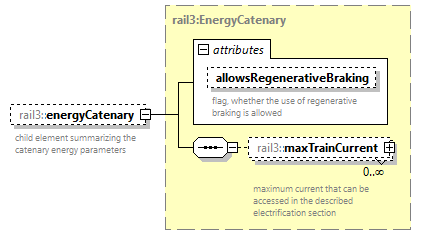 | ||||||||||||||
| namespace | https://www.railml.org/schemas/3.2 | ||||||||||||||
| type | rail3:EnergyCatenary | ||||||||||||||
| properties |
| ||||||||||||||
| children | rail3:maxTrainCurrent | ||||||||||||||
| attributes |
| ||||||||||||||
| annotation |
| ||||||||||||||
| source | <xs:element name="energyCatenary" type="rail3:EnergyCatenary" minOccurs="0" maxOccurs="1"> <xs:annotation> <xs:documentation>child element summarizing the catenary energy parameters</xs:documentation> </xs:annotation> </xs:element> |
element ElectrificationSection/energyPantograph
| diagram | 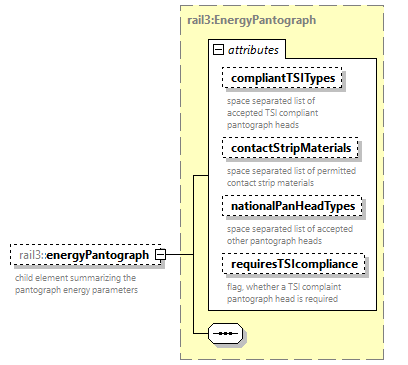 | ||||||||||||||||||||||||||||||||||||||
| namespace | https://www.railml.org/schemas/3.2 | ||||||||||||||||||||||||||||||||||||||
| type | rail3:EnergyPantograph | ||||||||||||||||||||||||||||||||||||||
| properties |
| ||||||||||||||||||||||||||||||||||||||
| attributes |
| ||||||||||||||||||||||||||||||||||||||
| annotation |
| ||||||||||||||||||||||||||||||||||||||
| source | <xs:element name="energyPantograph" type="rail3:EnergyPantograph" minOccurs="0" maxOccurs="1"> <xs:annotation> <xs:documentation>child element summarizing the pantograph energy parameters</xs:documentation> </xs:annotation> </xs:element> |
element ElectrificationSection/energyRollingstock
| diagram | 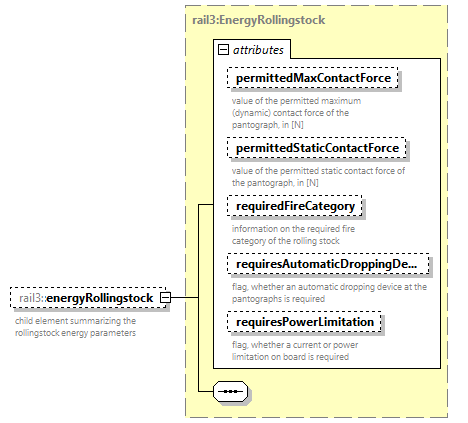 | ||||||||||||||||||||||||||||||||||||||||||||||
| namespace | https://www.railml.org/schemas/3.2 | ||||||||||||||||||||||||||||||||||||||||||||||
| type | rail3:EnergyRollingstock | ||||||||||||||||||||||||||||||||||||||||||||||
| properties |
| ||||||||||||||||||||||||||||||||||||||||||||||
| attributes |
| ||||||||||||||||||||||||||||||||||||||||||||||
| annotation |
| ||||||||||||||||||||||||||||||||||||||||||||||
| source | <xs:element name="energyRollingstock" type="rail3:EnergyRollingstock" minOccurs="0" maxOccurs="1"> <xs:annotation> <xs:documentation>child element summarizing the rollingstock energy parameters</xs:documentation> </xs:annotation> </xs:element> |
element ElectrificationSection/etcsElectrification
| diagram | 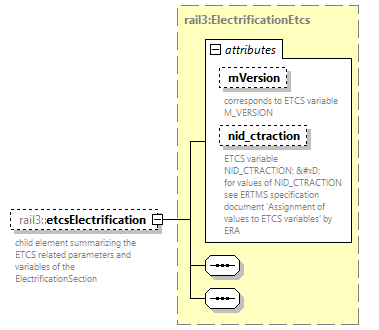 | ||||||||||||||||||||||
| namespace | https://www.railml.org/schemas/3.2 | ||||||||||||||||||||||
| type | rail3:ElectrificationEtcs | ||||||||||||||||||||||
| properties |
| ||||||||||||||||||||||
| attributes |
| ||||||||||||||||||||||
| annotation |
| ||||||||||||||||||||||
| source | <xs:element name="etcsElectrification" type="rail3:ElectrificationEtcs" minOccurs="0" maxOccurs="1"> <xs:annotation> <xs:documentation>child element summarizing the ETCS related parameters and variables of the ElectrificationSection</xs:documentation> </xs:annotation> </xs:element> |
element ElectrificationSection/hasContactWire
| diagram | 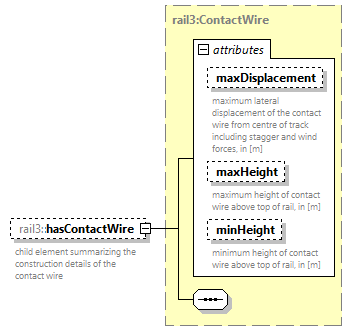 | ||||||||||||||||||||||||||||||
| namespace | https://www.railml.org/schemas/3.2 | ||||||||||||||||||||||||||||||
| type | rail3:ContactWire | ||||||||||||||||||||||||||||||
| properties |
| ||||||||||||||||||||||||||||||
| attributes |
| ||||||||||||||||||||||||||||||
| annotation |
| ||||||||||||||||||||||||||||||
| source | <xs:element name="hasContactWire" type="rail3:ContactWire" minOccurs="0" maxOccurs="1"> <xs:annotation> <xs:documentation>child element summarizing the construction details of the contact wire</xs:documentation> </xs:annotation> </xs:element> |
element ElectrificationSection/pantographSpacing
| diagram | 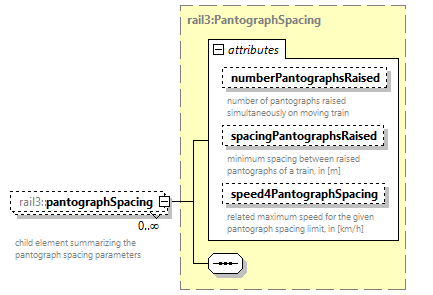 | ||||||||||||||||||||||||||||||
| namespace | https://www.railml.org/schemas/3.2 | ||||||||||||||||||||||||||||||
| type | rail3:PantographSpacing | ||||||||||||||||||||||||||||||
| properties |
| ||||||||||||||||||||||||||||||
| attributes |
| ||||||||||||||||||||||||||||||
| annotation |
| ||||||||||||||||||||||||||||||
| source | <xs:element name="pantographSpacing" type="rail3:PantographSpacing" minOccurs="0" maxOccurs="unbounded"> <xs:annotation> <xs:documentation>child element summarizing the pantograph spacing parameters</xs:documentation> </xs:annotation> </xs:element> |
element ElectrificationSection/phaseSeparationSection
| diagram | 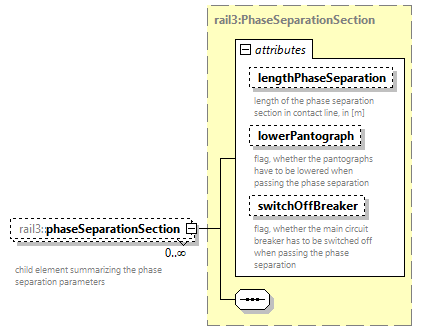 | ||||||||||||||||||||||||||||||
| namespace | https://www.railml.org/schemas/3.2 | ||||||||||||||||||||||||||||||
| type | rail3:PhaseSeparationSection | ||||||||||||||||||||||||||||||
| properties |
| ||||||||||||||||||||||||||||||
| attributes |
| ||||||||||||||||||||||||||||||
| annotation |
| ||||||||||||||||||||||||||||||
| source | <xs:element name="phaseSeparationSection" type="rail3:PhaseSeparationSection" minOccurs="0" maxOccurs="unbounded"> <xs:annotation> <xs:documentation>child element summarizing the phase separation parameters</xs:documentation> </xs:annotation> </xs:element> |
element ElectrificationSection/systemSeparationSection
| diagram | 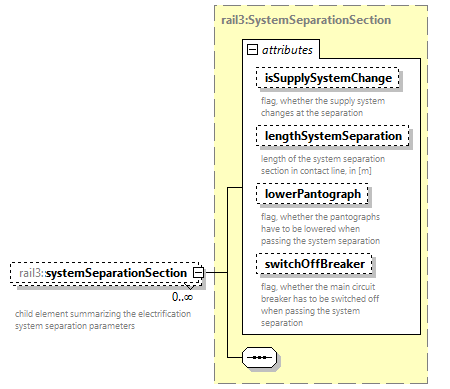 | ||||||||||||||||||||||||||||||||||||||
| namespace | https://www.railml.org/schemas/3.2 | ||||||||||||||||||||||||||||||||||||||
| type | rail3:SystemSeparationSection | ||||||||||||||||||||||||||||||||||||||
| properties |
| ||||||||||||||||||||||||||||||||||||||
| attributes |
| ||||||||||||||||||||||||||||||||||||||
| annotation |
| ||||||||||||||||||||||||||||||||||||||
| source | <xs:element name="systemSeparationSection" type="rail3:SystemSeparationSection" minOccurs="0" maxOccurs="unbounded"> <xs:annotation> <xs:documentation>child element summarizing the electrification system separation parameters</xs:documentation> </xs:annotation> </xs:element> |
complexType ElementState
| diagram | 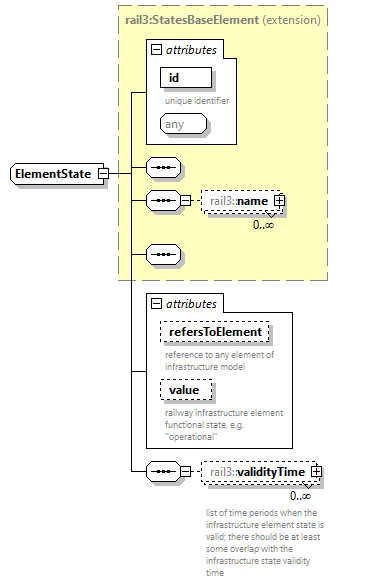 | ||||||||||||||||||||||||||||||
| namespace | https://www.railml.org/schemas/3.2 | ||||||||||||||||||||||||||||||
| type | extension of rail3:StatesBaseElement | ||||||||||||||||||||||||||||||
| properties |
| ||||||||||||||||||||||||||||||
| children | rail3:name rail3:validityTime | ||||||||||||||||||||||||||||||
| used by |
| ||||||||||||||||||||||||||||||
| attributes |
| ||||||||||||||||||||||||||||||
| source | <xs:complexType name="ElementState"> <xs:complexContent> <xs:extension base="rail3:StatesBaseElement"> <xs:sequence> <xs:element name="validityTime" type="rail3:Period" minOccurs="0" maxOccurs="unbounded"> <xs:annotation> <xs:documentation>list of time periods when the infrastructure element state is valid; there should be at least some overlap with the infrastructure state validity time</xs:documentation> </xs:annotation> </xs:element> </xs:sequence> <xs:attribute name="refersToElement" type="rail3:tRef" use="optional"> <xs:annotation> <xs:documentation>reference to any element of infrastructure model</xs:documentation> </xs:annotation> </xs:attribute> <xs:attribute name="value" type="rail3:tInfrastructureStateExt" use="optional"> <xs:annotation> <xs:documentation>railway infrastructure element functional state, e.g. "operational"</xs:documentation> </xs:annotation> </xs:attribute> </xs:extension> </xs:complexContent> </xs:complexType> |
attribute ElementState/@refersToElement
| type | rail3:tRef | ||
| properties |
| ||
| annotation |
| ||
| source | <xs:attribute name="refersToElement" type="rail3:tRef" use="optional"> <xs:annotation> <xs:documentation>reference to any element of infrastructure model</xs:documentation> </xs:annotation> </xs:attribute> |
attribute ElementState/@value
| type | rail3:tInfrastructureStateExt | ||
| properties |
| ||
| annotation |
| ||
| source | <xs:attribute name="value" type="rail3:tInfrastructureStateExt" use="optional"> <xs:annotation> <xs:documentation>railway infrastructure element functional state, e.g. "operational"</xs:documentation> </xs:annotation> </xs:attribute> |
element ElementState/validityTime
| diagram | 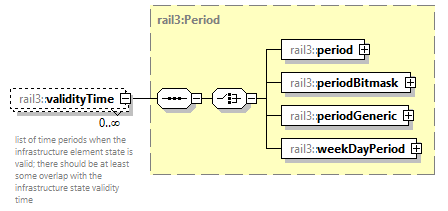 | ||||||
| namespace | https://www.railml.org/schemas/3.2 | ||||||
| type | rail3:Period | ||||||
| properties |
| ||||||
| children | rail3:period rail3:periodBitmask rail3:periodGeneric rail3:weekDayPeriod | ||||||
| annotation |
| ||||||
| source | <xs:element name="validityTime" type="rail3:Period" minOccurs="0" maxOccurs="unbounded"> <xs:annotation> <xs:documentation>list of time periods when the infrastructure element state is valid; there should be at least some overlap with the infrastructure state validity time</xs:documentation> </xs:annotation> </xs:element> |
complexType EnergyCatenary
| diagram | 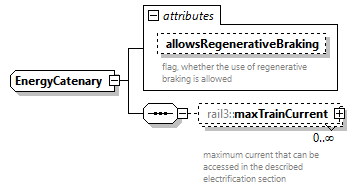 | ||||||||||||||
| namespace | https://www.railml.org/schemas/3.2 | ||||||||||||||
| children | rail3:maxTrainCurrent | ||||||||||||||
| used by |
| ||||||||||||||
| attributes |
| ||||||||||||||
| source | <xs:complexType name="EnergyCatenary"> <xs:sequence> <xs:element name="maxTrainCurrent" type="rail3:MaxTrainCurrent" minOccurs="0" maxOccurs="unbounded"> <xs:annotation> <xs:documentation>maximum current that can be accessed in the described electrification section</xs:documentation> </xs:annotation> </xs:element> </xs:sequence> <xs:attribute name="allowsRegenerativeBraking" type="xs:boolean" use="optional"> <xs:annotation> <xs:documentation>flag, whether the use of regenerative braking is allowed</xs:documentation> </xs:annotation> </xs:attribute> </xs:complexType> |
attribute EnergyCatenary/@allowsRegenerativeBraking
| type | xs:boolean | ||
| properties |
| ||
| annotation |
| ||
| source | <xs:attribute name="allowsRegenerativeBraking" type="xs:boolean" use="optional"> <xs:annotation> <xs:documentation>flag, whether the use of regenerative braking is allowed</xs:documentation> </xs:annotation> </xs:attribute> |
element EnergyCatenary/maxTrainCurrent
| diagram | 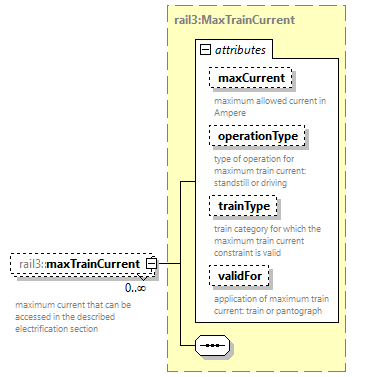 | ||||||||||||||||||||||||||||||||||||||
| namespace | https://www.railml.org/schemas/3.2 | ||||||||||||||||||||||||||||||||||||||
| type | rail3:MaxTrainCurrent | ||||||||||||||||||||||||||||||||||||||
| properties |
| ||||||||||||||||||||||||||||||||||||||
| attributes |
| ||||||||||||||||||||||||||||||||||||||
| annotation |
| ||||||||||||||||||||||||||||||||||||||
| source | <xs:element name="maxTrainCurrent" type="rail3:MaxTrainCurrent" minOccurs="0" maxOccurs="unbounded"> <xs:annotation> <xs:documentation>maximum current that can be accessed in the described electrification section</xs:documentation> </xs:annotation> </xs:element> |
complexType EnergyPantograph
| diagram | 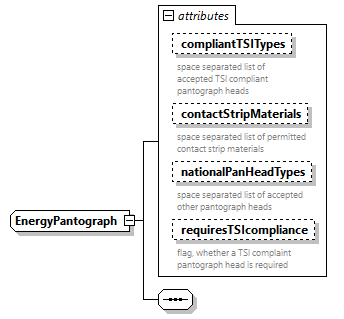 | ||||||||||||||||||||||||||||||||||||||
| namespace | https://www.railml.org/schemas/3.2 | ||||||||||||||||||||||||||||||||||||||
| used by |
| ||||||||||||||||||||||||||||||||||||||
| attributes |
| ||||||||||||||||||||||||||||||||||||||
| source | <xs:complexType name="EnergyPantograph"> <xs:sequence/> <xs:attribute name="compliantTSITypes" type="rail3:tTSIPantoHeadTypeList" use="optional"> <xs:annotation> <xs:documentation>space separated list of accepted TSI compliant pantograph heads</xs:documentation> </xs:annotation> </xs:attribute> <xs:attribute name="contactStripMaterials" type="rail3:tContactStripMaterialList" use="optional"> <xs:annotation> <xs:documentation>space separated list of permitted contact strip materials</xs:documentation> </xs:annotation> </xs:attribute> <xs:attribute name="nationalPanHeadTypes" type="rail3:tPantoHeadTypeList" use="optional"> <xs:annotation> <xs:documentation>space separated list of accepted other pantograph heads</xs:documentation> </xs:annotation> </xs:attribute> <xs:attribute name="requiresTSIcompliance" type="xs:boolean" use="optional"> <xs:annotation> <xs:documentation>flag, whether a TSI complaint pantograph head is required</xs:documentation> </xs:annotation> </xs:attribute> </xs:complexType> |
attribute EnergyPantograph/@compliantTSITypes
| type | rail3:tTSIPantoHeadTypeList | ||
| properties |
| ||
| annotation |
| ||
| source | <xs:attribute name="compliantTSITypes" type="rail3:tTSIPantoHeadTypeList" use="optional"> <xs:annotation> <xs:documentation>space separated list of accepted TSI compliant pantograph heads</xs:documentation> </xs:annotation> </xs:attribute> |
attribute EnergyPantograph/@contactStripMaterials
| type | rail3:tContactStripMaterialList | ||
| properties |
| ||
| annotation |
| ||
| source | <xs:attribute name="contactStripMaterials" type="rail3:tContactStripMaterialList" use="optional"> <xs:annotation> <xs:documentation>space separated list of permitted contact strip materials</xs:documentation> </xs:annotation> </xs:attribute> |
attribute EnergyPantograph/@nationalPanHeadTypes
| type | rail3:tPantoHeadTypeList | ||
| properties |
| ||
| annotation |
| ||
| source | <xs:attribute name="nationalPanHeadTypes" type="rail3:tPantoHeadTypeList" use="optional"> <xs:annotation> <xs:documentation>space separated list of accepted other pantograph heads</xs:documentation> </xs:annotation> </xs:attribute> |
attribute EnergyPantograph/@requiresTSIcompliance
| type | xs:boolean | ||
| properties |
| ||
| annotation |
| ||
| source | <xs:attribute name="requiresTSIcompliance" type="xs:boolean" use="optional"> <xs:annotation> <xs:documentation>flag, whether a TSI complaint pantograph head is required</xs:documentation> </xs:annotation> </xs:attribute> |
complexType EnergyRollingstock
| diagram | 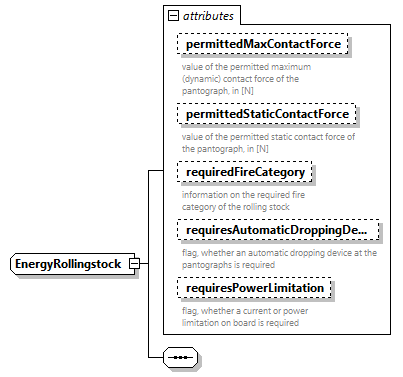 | ||||||||||||||||||||||||||||||||||||||||||||||
| namespace | https://www.railml.org/schemas/3.2 | ||||||||||||||||||||||||||||||||||||||||||||||
| used by |
| ||||||||||||||||||||||||||||||||||||||||||||||
| attributes |
| ||||||||||||||||||||||||||||||||||||||||||||||
| source | <xs:complexType name="EnergyRollingstock"> <xs:sequence/> <xs:attribute name="permittedMaxContactForce" type="rail3:tForceN" use="optional"> <xs:annotation> <xs:documentation>value of the permitted maximum (dynamic) contact force of the pantograph, in [N]</xs:documentation> </xs:annotation> </xs:attribute> <xs:attribute name="permittedStaticContactForce" type="rail3:tForceN" use="optional"> <xs:annotation> <xs:documentation>value of the permitted static contact force of the pantograph, in [N]</xs:documentation> </xs:annotation> </xs:attribute> <xs:attribute name="requiredFireCategory" type="rail3:tRSFireCategoryType" use="optional"> <xs:annotation> <xs:documentation>information on the required fire category of the rolling stock</xs:documentation> </xs:annotation> </xs:attribute> <xs:attribute name="requiresAutomaticDroppingDevice" type="xs:boolean" use="optional"> <xs:annotation> <xs:documentation>flag, whether an automatic dropping device at the pantographs is required</xs:documentation> </xs:annotation> </xs:attribute> <xs:attribute name="requiresPowerLimitation" type="xs:boolean" use="optional"> <xs:annotation> <xs:documentation>flag, whether a current or power limitation on board is required</xs:documentation> </xs:annotation> </xs:attribute> </xs:complexType> |
attribute EnergyRollingstock/@permittedMaxContactForce
| type | rail3:tForceN | ||
| properties |
| ||
| annotation |
| ||
| source | <xs:attribute name="permittedMaxContactForce" type="rail3:tForceN" use="optional"> <xs:annotation> <xs:documentation>value of the permitted maximum (dynamic) contact force of the pantograph, in [N]</xs:documentation> </xs:annotation> </xs:attribute> |
attribute EnergyRollingstock/@permittedStaticContactForce
| type | rail3:tForceN | ||
| properties |
| ||
| annotation |
| ||
| source | <xs:attribute name="permittedStaticContactForce" type="rail3:tForceN" use="optional"> <xs:annotation> <xs:documentation>value of the permitted static contact force of the pantograph, in [N]</xs:documentation> </xs:annotation> </xs:attribute> |
attribute EnergyRollingstock/@requiredFireCategory
| type | rail3:tRSFireCategoryType | ||||||||||||
| properties |
| ||||||||||||
| facets |
| ||||||||||||
| annotation |
| ||||||||||||
| source | <xs:attribute name="requiredFireCategory" type="rail3:tRSFireCategoryType" use="optional"> <xs:annotation> <xs:documentation>information on the required fire category of the rolling stock</xs:documentation> </xs:annotation> </xs:attribute> |
attribute EnergyRollingstock/@requiresAutomaticDroppingDevice
| type | xs:boolean | ||
| properties |
| ||
| annotation |
| ||
| source | <xs:attribute name="requiresAutomaticDroppingDevice" type="xs:boolean" use="optional"> <xs:annotation> <xs:documentation>flag, whether an automatic dropping device at the pantographs is required</xs:documentation> </xs:annotation> </xs:attribute> |
attribute EnergyRollingstock/@requiresPowerLimitation
| type | xs:boolean | ||
| properties |
| ||
| annotation |
| ||
| source | <xs:attribute name="requiresPowerLimitation" type="xs:boolean" use="optional"> <xs:annotation> <xs:documentation>flag, whether a current or power limitation on board is required</xs:documentation> </xs:annotation> </xs:attribute> |
complexType EntityIS
| diagram | 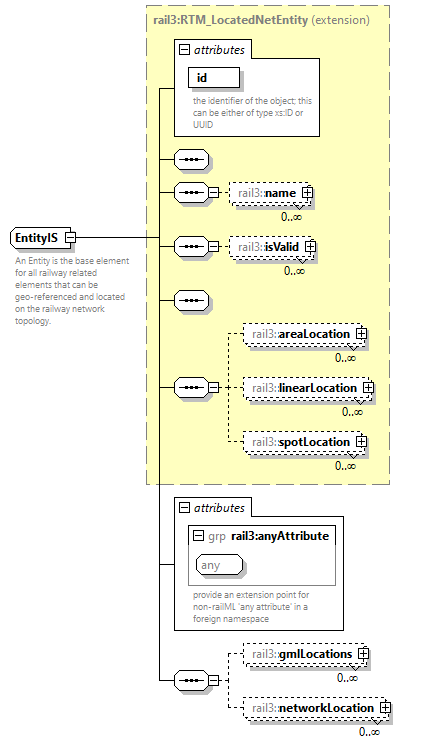 | ||||||||||||||
| namespace | https://www.railml.org/schemas/3.2 | ||||||||||||||
| type | extension of rail3:RTM_LocatedNetEntity | ||||||||||||||
| properties |
| ||||||||||||||
| children | rail3:name rail3:isValid rail3:areaLocation rail3:linearLocation rail3:spotLocation rail3:gmlLocations rail3:networkLocation | ||||||||||||||
| used by |
| ||||||||||||||
| attributes |
| ||||||||||||||
| annotation |
| ||||||||||||||
| source | <xs:complexType name="EntityIS" abstract="true"> <xs:annotation> <xs:documentation>An Entity is the base element for all railway related elements that can be geo-referenced and located on the railway network topology.</xs:documentation> </xs:annotation> <xs:complexContent> <xs:extension base="rail3:RTM_LocatedNetEntity"> <xs:sequence> <xs:element name="gmlLocations" type="rail3:GmlLocations" minOccurs="0" maxOccurs="unbounded"/> <xs:element name="networkLocation" type="rail3:LocationNetwork" minOccurs="0" maxOccurs="unbounded"/> </xs:sequence> <xs:attributeGroup ref="rail3:anyAttribute"/> </xs:extension> </xs:complexContent> </xs:complexType> |
element EntityIS/gmlLocations
| diagram | 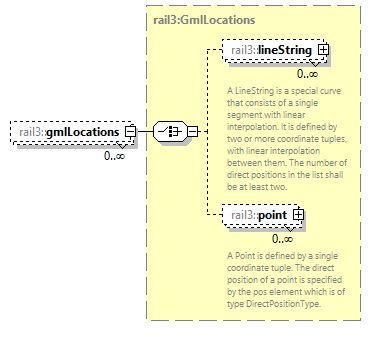 | ||||||
| namespace | https://www.railml.org/schemas/3.2 | ||||||
| type | rail3:GmlLocations | ||||||
| properties |
| ||||||
| children | rail3:lineString rail3:point | ||||||
| source | <xs:element name="gmlLocations" type="rail3:GmlLocations" minOccurs="0" maxOccurs="unbounded"/> |
element EntityIS/networkLocation
| diagram | 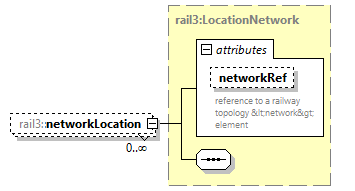 | ||||||||||||||
| namespace | https://www.railml.org/schemas/3.2 | ||||||||||||||
| type | rail3:LocationNetwork | ||||||||||||||
| properties |
| ||||||||||||||
| attributes |
| ||||||||||||||
| source | <xs:element name="networkLocation" type="rail3:LocationNetwork" minOccurs="0" maxOccurs="unbounded"/> |
complexType ETCS
| diagram | 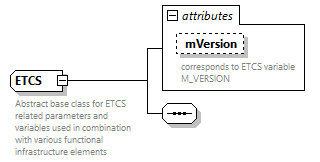 | ||||||||||||||
| namespace | https://www.railml.org/schemas/3.2 | ||||||||||||||
| properties |
| ||||||||||||||
| used by |
| ||||||||||||||
| attributes |
| ||||||||||||||
| annotation |
| ||||||||||||||
| source | <xs:complexType name="ETCS" abstract="true"> <xs:annotation> <xs:documentation>Abstract base class for ETCS related parameters and variables used in combination with various functional infrastructure elements</xs:documentation> </xs:annotation> <xs:sequence/> <xs:attribute name="mVersion" type="xs:nonNegativeInteger" use="optional"> <xs:annotation> <xs:documentation>corresponds to ETCS variable M_VERSION</xs:documentation> </xs:annotation> </xs:attribute> </xs:complexType> |
attribute ETCS/@mVersion
| type | xs:nonNegativeInteger | ||
| properties |
| ||
| annotation |
| ||
| source | <xs:attribute name="mVersion" type="xs:nonNegativeInteger" use="optional"> <xs:annotation> <xs:documentation>corresponds to ETCS variable M_VERSION</xs:documentation> </xs:annotation> </xs:attribute> |
complexType EtcsArea
| diagram | 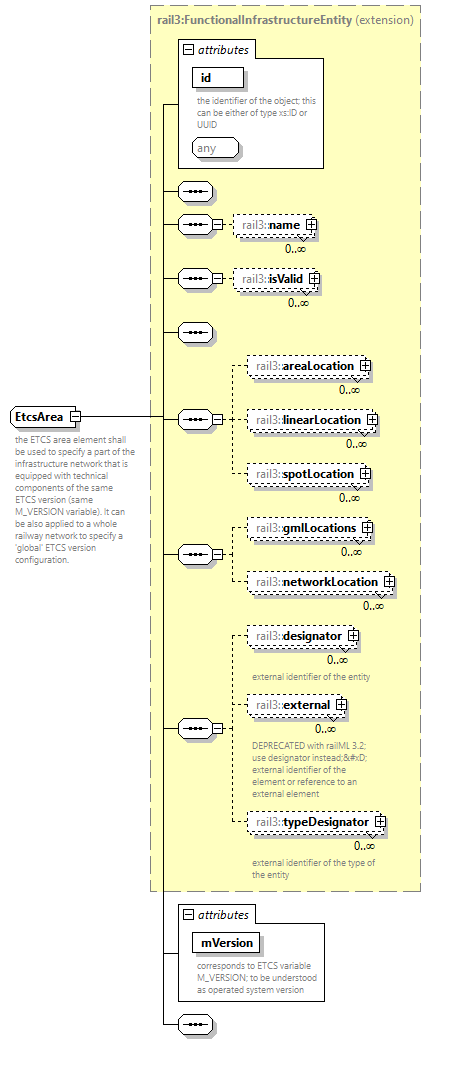 | ||||||||||||||||||||||
| namespace | https://www.railml.org/schemas/3.2 | ||||||||||||||||||||||
| type | extension of rail3:FunctionalInfrastructureEntity | ||||||||||||||||||||||
| properties |
| ||||||||||||||||||||||
| children | rail3:name rail3:isValid rail3:areaLocation rail3:linearLocation rail3:spotLocation rail3:gmlLocations rail3:networkLocation rail3:designator rail3:external rail3:typeDesignator | ||||||||||||||||||||||
| used by |
| ||||||||||||||||||||||
| attributes |
| ||||||||||||||||||||||
| annotation |
| ||||||||||||||||||||||
| source | <xs:complexType name="EtcsArea"> <xs:annotation> <xs:documentation>the ETCS area element shall be used to specify a part of the infrastructure network that is equipped with technical components of the same ETCS version (same M_VERSION variable). It can be also applied to a whole railway network to specify a 'global' ETCS version configuration.</xs:documentation> </xs:annotation> <xs:complexContent> <xs:extension base="rail3:FunctionalInfrastructureEntity"> <xs:sequence/> <xs:attribute name="mVersion" type="xs:nonNegativeInteger" use="required"> <xs:annotation> <xs:documentation>corresponds to ETCS variable M_VERSION; to be understood as operated system version</xs:documentation> </xs:annotation> </xs:attribute> </xs:extension> </xs:complexContent> </xs:complexType> |
attribute EtcsArea/@mVersion
| type | xs:nonNegativeInteger | ||
| properties |
| ||
| annotation |
| ||
| source | <xs:attribute name="mVersion" type="xs:nonNegativeInteger" use="required"> <xs:annotation> <xs:documentation>corresponds to ETCS variable M_VERSION; to be understood as operated system version</xs:documentation> </xs:annotation> </xs:attribute> |
complexType EtcsAreas
| diagram | 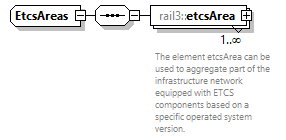 | ||
| namespace | https://www.railml.org/schemas/3.2 | ||
| children | rail3:etcsArea | ||
| used by |
| ||
| source | <xs:complexType name="EtcsAreas"> <xs:sequence> <xs:element name="etcsArea" type="rail3:EtcsArea" minOccurs="1" maxOccurs="unbounded"> <xs:annotation> <xs:documentation>The element etcsArea can be used to aggregate part of the infrastructure network equipped with ETCS components based on a specific operated system version.</xs:documentation> </xs:annotation> </xs:element> </xs:sequence> </xs:complexType> |
element EtcsAreas/etcsArea
| diagram | 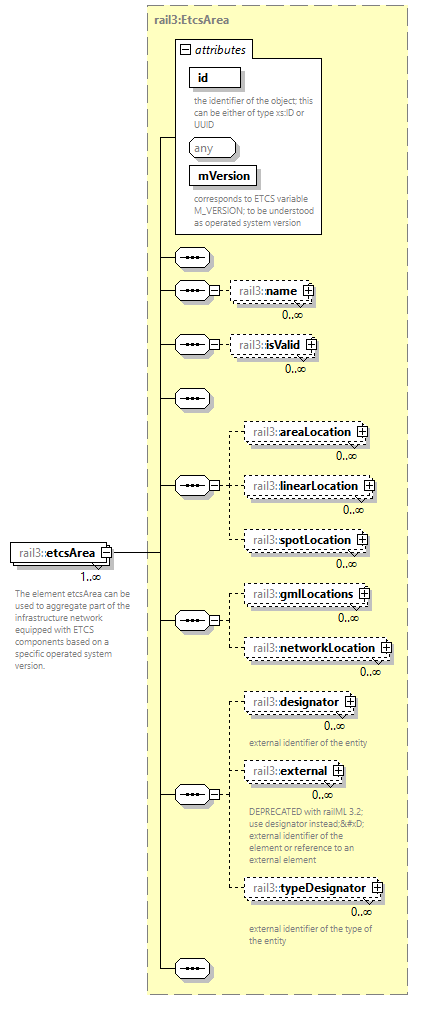 | ||||||||||||||||||||||
| namespace | https://www.railml.org/schemas/3.2 | ||||||||||||||||||||||
| type | rail3:EtcsArea | ||||||||||||||||||||||
| properties |
| ||||||||||||||||||||||
| children | rail3:name rail3:isValid rail3:areaLocation rail3:linearLocation rail3:spotLocation rail3:gmlLocations rail3:networkLocation rail3:designator rail3:external rail3:typeDesignator | ||||||||||||||||||||||
| attributes |
| ||||||||||||||||||||||
| annotation |
| ||||||||||||||||||||||
| source | <xs:element name="etcsArea" type="rail3:EtcsArea" minOccurs="1" maxOccurs="unbounded"> <xs:annotation> <xs:documentation>The element etcsArea can be used to aggregate part of the infrastructure network equipped with ETCS components based on a specific operated system version.</xs:documentation> </xs:annotation> </xs:element> |
complexType EtcsLevelTransition
| diagram | 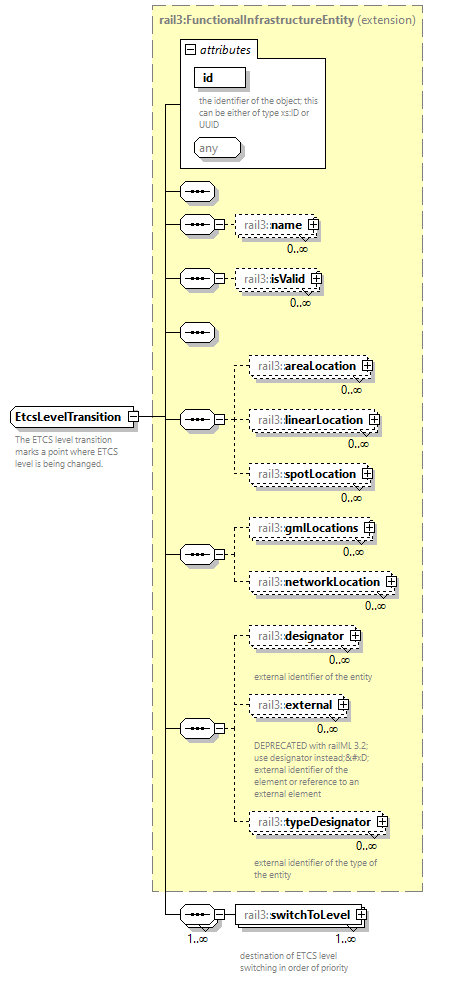 | ||||||||||||||
| namespace | https://www.railml.org/schemas/3.2 | ||||||||||||||
| type | extension of rail3:FunctionalInfrastructureEntity | ||||||||||||||
| properties |
| ||||||||||||||
| children | rail3:name rail3:isValid rail3:areaLocation rail3:linearLocation rail3:spotLocation rail3:gmlLocations rail3:networkLocation rail3:designator rail3:external rail3:typeDesignator rail3:switchToLevel | ||||||||||||||
| used by |
| ||||||||||||||
| attributes |
| ||||||||||||||
| annotation |
| ||||||||||||||
| source | <xs:complexType name="EtcsLevelTransition"> <xs:annotation> <xs:documentation>The ETCS level transition marks a point where ETCS level is being changed.</xs:documentation> </xs:annotation> <xs:complexContent> <xs:extension base="rail3:FunctionalInfrastructureEntity"> <xs:sequence minOccurs="1" maxOccurs="unbounded"> <xs:element name="switchToLevel" type="rail3:EtcsLevelTransitionDestination" minOccurs="1" maxOccurs="unbounded"> <xs:annotation> <xs:documentation>destination of ETCS level switching in order of priority</xs:documentation> </xs:annotation> </xs:element> </xs:sequence> </xs:extension> </xs:complexContent> </xs:complexType> |
element EtcsLevelTransition/switchToLevel
| diagram | 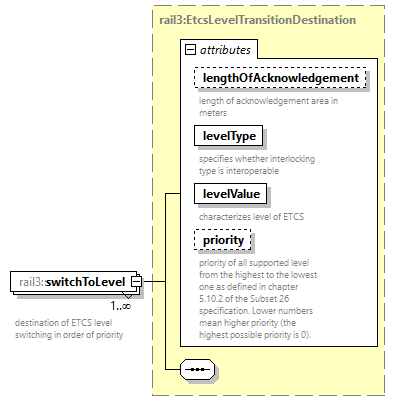 | ||||||||||||||||||||||||||||||||||||||
| namespace | https://www.railml.org/schemas/3.2 | ||||||||||||||||||||||||||||||||||||||
| type | rail3:EtcsLevelTransitionDestination | ||||||||||||||||||||||||||||||||||||||
| properties |
| ||||||||||||||||||||||||||||||||||||||
| attributes |
| ||||||||||||||||||||||||||||||||||||||
| annotation |
| ||||||||||||||||||||||||||||||||||||||
| source | <xs:element name="switchToLevel" type="rail3:EtcsLevelTransitionDestination" minOccurs="1" maxOccurs="unbounded"> <xs:annotation> <xs:documentation>destination of ETCS level switching in order of priority</xs:documentation> </xs:annotation> </xs:element> |
complexType EtcsLevelTransitionDestination
| diagram | 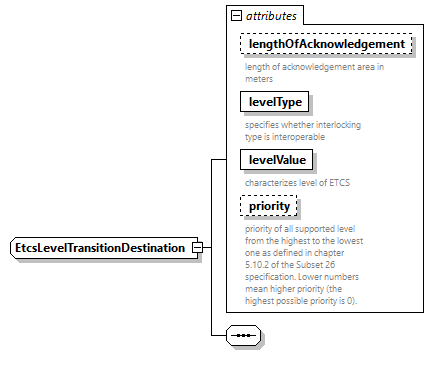 | ||||||||||||||||||||||||||||||||||||||
| namespace | https://www.railml.org/schemas/3.2 | ||||||||||||||||||||||||||||||||||||||
| used by |
| ||||||||||||||||||||||||||||||||||||||
| attributes |
| ||||||||||||||||||||||||||||||||||||||
| source | <xs:complexType name="EtcsLevelTransitionDestination"> <xs:sequence/> <xs:attribute name="lengthOfAcknowledgement" type="rail3:tLengthM" use="optional"> <xs:annotation> <xs:documentation>length of acknowledgement area in meters</xs:documentation> </xs:annotation> </xs:attribute> <xs:attribute name="levelType" type="rail3:EtcsLevelTypeExt" use="required"> <xs:annotation> <xs:documentation>specifies whether interlocking type is interoperable</xs:documentation> </xs:annotation> </xs:attribute> <xs:attribute name="levelValue" type="xs:positiveInteger" use="required"> <xs:annotation> <xs:documentation>characterizes level of ETCS</xs:documentation> </xs:annotation> </xs:attribute> <xs:attribute name="priority" type="rail3:tPriority" use="optional"> <xs:annotation> <xs:documentation>priority of all supported level from the highest to the lowest one as defined in chapter 5.10.2 of the Subset 26 specification. Lower numbers mean higher priority (the highest possible priority is 0).</xs:documentation> </xs:annotation> </xs:attribute> </xs:complexType> |
attribute EtcsLevelTransitionDestination/@lengthOfAcknowledgement
| type | rail3:tLengthM | ||
| properties |
| ||
| annotation |
| ||
| source | <xs:attribute name="lengthOfAcknowledgement" type="rail3:tLengthM" use="optional"> <xs:annotation> <xs:documentation>length of acknowledgement area in meters</xs:documentation> </xs:annotation> </xs:attribute> |
attribute EtcsLevelTransitionDestination/@levelType
| type | rail3:EtcsLevelTypeExt | ||
| properties |
| ||
| annotation |
| ||
| source | <xs:attribute name="levelType" type="rail3:EtcsLevelTypeExt" use="required"> <xs:annotation> <xs:documentation>specifies whether interlocking type is interoperable</xs:documentation> </xs:annotation> </xs:attribute> |
attribute EtcsLevelTransitionDestination/@levelValue
| type | xs:positiveInteger | ||
| properties |
| ||
| annotation |
| ||
| source | <xs:attribute name="levelValue" type="xs:positiveInteger" use="required"> <xs:annotation> <xs:documentation>characterizes level of ETCS</xs:documentation> </xs:annotation> </xs:attribute> |
attribute EtcsLevelTransitionDestination/@priority
| type | rail3:tPriority | ||
| properties |
| ||
| annotation |
| ||
| source | <xs:attribute name="priority" type="rail3:tPriority" use="optional"> <xs:annotation> <xs:documentation>priority of all supported level from the highest to the lowest one as defined in chapter 5.10.2 of the Subset 26 specification. Lower numbers mean higher priority (the highest possible priority is 0).</xs:documentation> </xs:annotation> </xs:attribute> |
complexType EtcsLevelTransitions
| diagram |  | ||
| namespace | https://www.railml.org/schemas/3.2 | ||
| children | rail3:etcsLevelTransition | ||
| used by |
| ||
| source | <xs:complexType name="EtcsLevelTransitions"> <xs:sequence> <xs:element name="etcsLevelTransition" type="rail3:EtcsLevelTransition" minOccurs="1" maxOccurs="unbounded"> <xs:annotation> <xs:documentation>The ETCS level transition marks a point where ETCS level is being changed.</xs:documentation> </xs:annotation> </xs:element> </xs:sequence> </xs:complexType> |
element EtcsLevelTransitions/etcsLevelTransition
| diagram | 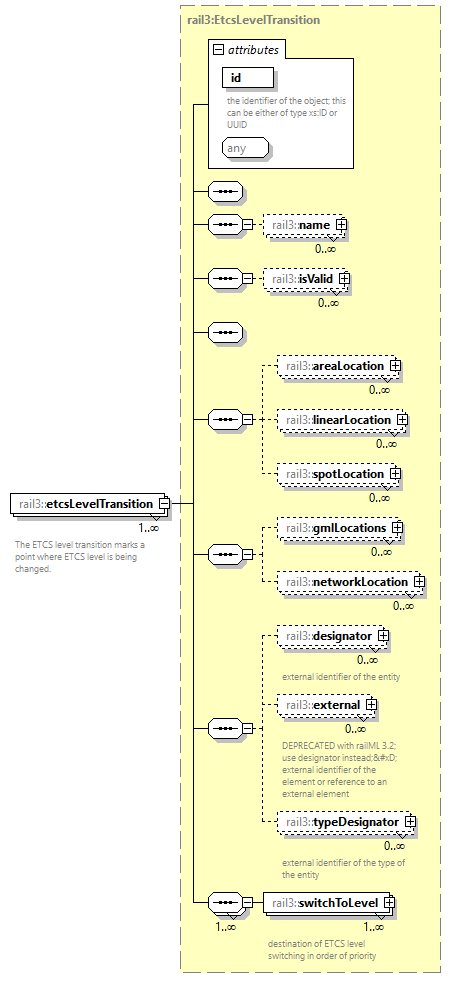 | ||||||||||||||
| namespace | https://www.railml.org/schemas/3.2 | ||||||||||||||
| type | rail3:EtcsLevelTransition | ||||||||||||||
| properties |
| ||||||||||||||
| children | rail3:name rail3:isValid rail3:areaLocation rail3:linearLocation rail3:spotLocation rail3:gmlLocations rail3:networkLocation rail3:designator rail3:external rail3:typeDesignator rail3:switchToLevel | ||||||||||||||
| attributes |
| ||||||||||||||
| annotation |
| ||||||||||||||
| source | <xs:element name="etcsLevelTransition" type="rail3:EtcsLevelTransition" minOccurs="1" maxOccurs="unbounded"> <xs:annotation> <xs:documentation>The ETCS level transition marks a point where ETCS level is being changed.</xs:documentation> </xs:annotation> </xs:element> |
complexType FunctionalInfrastructure
| diagram |  | ||
| namespace | https://www.railml.org/schemas/3.2 | ||
| children | rail3:balises rail3:baliseGroups rail3:borders rail3:bufferStops rail3:crossings rail3:derailersIS rail3:detectors rail3:electrifications rail3:etcsAreas rail3:etcsLevelTransitions rail3:keyLocksIS rail3:levelCrossingsIS rail3:lines rail3:loadingGauges rail3:operationalPoints rail3:overCrossings rail3:platforms rail3:platformEdges rail3:radioBlockCentreBorders rail3:restrictionAreas rail3:serviceSections rail3:signalsIS rail3:speeds rail3:stoppingPlaces rail3:switchesIS rail3:tracks rail3:trackBeds rail3:trackGauges rail3:trainDetectionElements rail3:trainProtectionElements rail3:trainRadios rail3:underCrossings rail3:weightLimits rail3:mileageChanges rail3:tunnelGatesIS | ||
| used by |
| ||
| annotation |
| ||
| source | <xs:complexType name="FunctionalInfrastructure"> <xs:annotation> <xs:documentation>This is the top level element for railML3 functional infrastructure model.</xs:documentation> </xs:annotation> <xs:sequence> <xs:element name="balises" type="rail3:Balises" minOccurs="0" maxOccurs="1"> <xs:annotation> <xs:documentation>container element for all balise elements</xs:documentation> </xs:annotation> </xs:element> <xs:element name="baliseGroups" type="rail3:BaliseGroups" minOccurs="0" maxOccurs="1"> <xs:annotation> <xs:documentation>container element for all balise group elements</xs:documentation> </xs:annotation> </xs:element> <xs:element name="borders" type="rail3:Borders" minOccurs="0" maxOccurs="1"> <xs:annotation> <xs:documentation>container element for all border elements</xs:documentation> </xs:annotation> </xs:element> <xs:element name="bufferStops" type="rail3:BufferStops" minOccurs="0" maxOccurs="1"> <xs:annotation> <xs:documentation>container element for all bufferStop elements</xs:documentation> </xs:annotation> </xs:element> <xs:element name="crossings" type="rail3:Crossings" minOccurs="0" maxOccurs="1"> <xs:annotation> <xs:documentation>container element for all crossing elements</xs:documentation> </xs:annotation> </xs:element> <xs:element name="derailersIS" type="rail3:DerailersIS" minOccurs="0" maxOccurs="1"> <xs:annotation> <xs:documentation>container element for all derailer elements</xs:documentation> </xs:annotation> </xs:element> <xs:element name="detectors" type="rail3:Detectors" minOccurs="0" maxOccurs="1"> <xs:annotation> <xs:documentation>container element for all (external hazard) detectors</xs:documentation> </xs:annotation> </xs:element> <xs:element name="electrifications" type="rail3:Electrifications" minOccurs="0" maxOccurs="1"> <xs:annotation> <xs:documentation>container element for all electrification elements incl. electrification system components</xs:documentation> </xs:annotation> </xs:element> <xs:element name="etcsAreas" type="rail3:EtcsAreas" minOccurs="0" maxOccurs="1"> <xs:annotation> <xs:documentation>container element for all ETCS area elements</xs:documentation> </xs:annotation> </xs:element> <xs:element name="etcsLevelTransitions" type="rail3:EtcsLevelTransitions" minOccurs="0" maxOccurs="1"> <xs:annotation> <xs:documentation>container element for all ETCS level transition elements</xs:documentation> </xs:annotation> </xs:element> <xs:element name="keyLocksIS" type="rail3:KeyLocksIS" minOccurs="0" maxOccurs="1"> <xs:annotation> <xs:documentation>container element for all keyLock elements</xs:documentation> </xs:annotation> </xs:element> <xs:element name="levelCrossingsIS" type="rail3:LevelCrossingsIS" minOccurs="0" maxOccurs="1"> <xs:annotation> <xs:documentation>container element for all levelCrossing elements</xs:documentation> </xs:annotation> </xs:element> <xs:element name="lines" type="rail3:Lines" minOccurs="0" maxOccurs="1"> <xs:annotation> <xs:documentation>container element for all line (section) elements</xs:documentation> </xs:annotation> </xs:element> <xs:element name="loadingGauges" type="rail3:LoadingGauges" minOccurs="0" maxOccurs="1"> <xs:annotation> <xs:documentation>container element for all loadingGauge elements</xs:documentation> </xs:annotation> </xs:element> <xs:element name="operationalPoints" type="rail3:OperationalPoints" minOccurs="0" maxOccurs="1"> <xs:annotation> <xs:documentation>container element for all operationalPoint elements</xs:documentation> </xs:annotation> </xs:element> <xs:element name="overCrossings" type="rail3:OverCrossings" minOccurs="0" maxOccurs="1"> <xs:annotation> <xs:documentation>container element for all overCrossing elements</xs:documentation> </xs:annotation> </xs:element> <xs:element name="platforms" type="rail3:Platforms" minOccurs="0" maxOccurs="1"> <xs:annotation> <xs:documentation>container element for all platform elements</xs:documentation> </xs:annotation> </xs:element> <xs:element name="platformEdges" type="rail3:PlatformEdges" minOccurs="0" maxOccurs="1"> <xs:annotation> <xs:documentation>container element for all platform edge elements</xs:documentation> </xs:annotation> </xs:element> <xs:element name="radioBlockCentreBorders" type="rail3:RbcBorders" minOccurs="0" maxOccurs="1"> <xs:annotation> <xs:documentation>container element for all rbcBorder elements</xs:documentation> </xs:annotation> </xs:element> <xs:element name="restrictionAreas" type="rail3:RestrictionAreas" minOccurs="0" maxOccurs="1"> <xs:annotation> <xs:documentation>container element for all restrictionArea elements</xs:documentation> </xs:annotation> </xs:element> <xs:element name="serviceSections" type="rail3:ServiceSections" minOccurs="0" maxOccurs="1"> <xs:annotation> <xs:documentation>container element for all serviceSection elements</xs:documentation> </xs:annotation> </xs:element> <xs:element name="signalsIS" type="rail3:SignalsIS" minOccurs="0" maxOccurs="1"> <xs:annotation> <xs:documentation>container element for all signal (and panel) elements</xs:documentation> </xs:annotation> </xs:element> <xs:element name="speeds" type="rail3:Speeds" minOccurs="0" maxOccurs="1"> <xs:annotation> <xs:documentation>container element for all line/track speed related elements</xs:documentation> </xs:annotation> </xs:element> <xs:element name="stoppingPlaces" type="rail3:StoppingPlaces" minOccurs="0" maxOccurs="1"> <xs:annotation> <xs:documentation>container element for all stoppingPlace elements</xs:documentation> </xs:annotation> </xs:element> <xs:element name="switchesIS" type="rail3:SwitchesIS" minOccurs="0" maxOccurs="1"> <xs:annotation> <xs:documentation>container element for all switch elements</xs:documentation> </xs:annotation> </xs:element> <xs:element name="tracks" type="rail3:Tracks" minOccurs="0" maxOccurs="1"> <xs:annotation> <xs:documentation>container element for all track elements</xs:documentation> </xs:annotation> </xs:element> <xs:element name="trackBeds" type="rail3:TrackBeds" minOccurs="0" maxOccurs="1"> <xs:annotation> <xs:documentation>container element for all trackBed elements</xs:documentation> </xs:annotation> </xs:element> <xs:element name="trackGauges" type="rail3:TrackGauges" minOccurs="0" maxOccurs="1"> <xs:annotation> <xs:documentation>container element for all trackGauge elements</xs:documentation> </xs:annotation> </xs:element> <xs:element name="trainDetectionElements" type="rail3:TrainDetectionElements" minOccurs="0" maxOccurs="1"> <xs:annotation> <xs:documentation>container element for all trainDetectionElement elements</xs:documentation> </xs:annotation> </xs:element> <xs:element name="trainProtectionElements" type="rail3:TrainProtectionElements" minOccurs="0" maxOccurs="1"> <xs:annotation> <xs:documentation>container element for all trainProtectionElement elements;
 Do not use trainProtectionElements for modelling ETCS based train protection systems and elements, but use dedicated elements (balise and baliseGroup) for this.</xs:documentation> </xs:annotation> </xs:element> <xs:element name="trainRadios" type="rail3:TrainRadios" minOccurs="0" maxOccurs="1"> <xs:annotation> <xs:documentation>container element for all trainRadio elements</xs:documentation> </xs:annotation> </xs:element> <xs:element name="underCrossings" type="rail3:UnderCrossings" minOccurs="0" maxOccurs="1"> <xs:annotation> <xs:documentation>container element for all underCrossing elements</xs:documentation> </xs:annotation> </xs:element> <xs:element name="weightLimits" type="rail3:WeightLimits" minOccurs="0" maxOccurs="1"> <xs:annotation> <xs:documentation>container element for all weightLimit (axle load, meterload) elements</xs:documentation> </xs:annotation> </xs:element> <xs:element name="mileageChanges" type="rail3:MileageChanges" minOccurs="0" maxOccurs="1"> <xs:annotation> <xs:documentation>container element for all mileage changes</xs:documentation> </xs:annotation> </xs:element> <xs:element name="tunnelGatesIS" type="rail3:TunnelGatesIS" minOccurs="0" maxOccurs="1"/> </xs:sequence> </xs:complexType> |
element FunctionalInfrastructure/balises
| diagram | 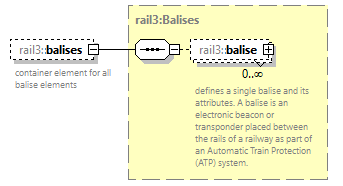 | ||||||
| namespace | https://www.railml.org/schemas/3.2 | ||||||
| type | rail3:Balises | ||||||
| properties |
| ||||||
| children | rail3:balise | ||||||
| annotation |
| ||||||
| source | <xs:element name="balises" type="rail3:Balises" minOccurs="0" maxOccurs="1"> <xs:annotation> <xs:documentation>container element for all balise elements</xs:documentation> </xs:annotation> </xs:element> |
element FunctionalInfrastructure/baliseGroups
| diagram | 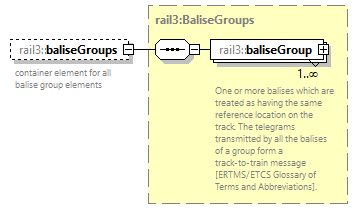 | ||||||
| namespace | https://www.railml.org/schemas/3.2 | ||||||
| type | rail3:BaliseGroups | ||||||
| properties |
| ||||||
| children | rail3:baliseGroup | ||||||
| annotation |
| ||||||
| source | <xs:element name="baliseGroups" type="rail3:BaliseGroups" minOccurs="0" maxOccurs="1"> <xs:annotation> <xs:documentation>container element for all balise group elements</xs:documentation> </xs:annotation> </xs:element> |
element FunctionalInfrastructure/borders
| diagram |  | ||||||
| namespace | https://www.railml.org/schemas/3.2 | ||||||
| type | rail3:Borders | ||||||
| properties |
| ||||||
| children | rail3:border | ||||||
| annotation |
| ||||||
| source | <xs:element name="borders" type="rail3:Borders" minOccurs="0" maxOccurs="1"> <xs:annotation> <xs:documentation>container element for all border elements</xs:documentation> </xs:annotation> </xs:element> |
element FunctionalInfrastructure/bufferStops
| diagram | 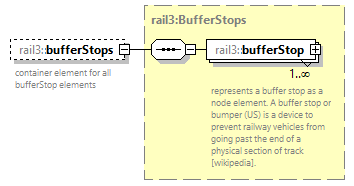 | ||||||
| namespace | https://www.railml.org/schemas/3.2 | ||||||
| type | rail3:BufferStops | ||||||
| properties |
| ||||||
| children | rail3:bufferStop | ||||||
| annotation |
| ||||||
| source | <xs:element name="bufferStops" type="rail3:BufferStops" minOccurs="0" maxOccurs="1"> <xs:annotation> <xs:documentation>container element for all bufferStop elements</xs:documentation> </xs:annotation> </xs:element> |
element FunctionalInfrastructure/crossings
| diagram |  | ||||||
| namespace | https://www.railml.org/schemas/3.2 | ||||||
| type | rail3:Crossings | ||||||
| properties |
| ||||||
| children | rail3:crossing | ||||||
| annotation |
| ||||||
| source | <xs:element name="crossings" type="rail3:Crossings" minOccurs="0" maxOccurs="1"> <xs:annotation> <xs:documentation>container element for all crossing elements</xs:documentation> </xs:annotation> </xs:element> |
element FunctionalInfrastructure/derailersIS
| diagram | 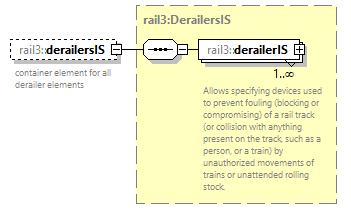 | ||||||
| namespace | https://www.railml.org/schemas/3.2 | ||||||
| type | rail3:DerailersIS | ||||||
| properties |
| ||||||
| children | rail3:derailerIS | ||||||
| annotation |
| ||||||
| source | <xs:element name="derailersIS" type="rail3:DerailersIS" minOccurs="0" maxOccurs="1"> <xs:annotation> <xs:documentation>container element for all derailer elements</xs:documentation> </xs:annotation> </xs:element> |
element FunctionalInfrastructure/detectors
| diagram |  | ||||||
| namespace | https://www.railml.org/schemas/3.2 | ||||||
| type | rail3:Detectors | ||||||
| properties |
| ||||||
| children | rail3:detector | ||||||
| annotation |
| ||||||
| source | <xs:element name="detectors" type="rail3:Detectors" minOccurs="0" maxOccurs="1"> <xs:annotation> <xs:documentation>container element for all (external hazard) detectors</xs:documentation> </xs:annotation> </xs:element> |
element FunctionalInfrastructure/electrifications
| diagram | 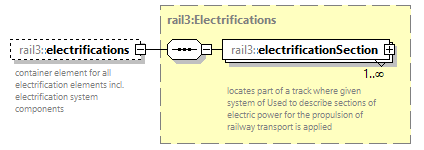 | ||||||
| namespace | https://www.railml.org/schemas/3.2 | ||||||
| type | rail3:Electrifications | ||||||
| properties |
| ||||||
| children | rail3:electrificationSection | ||||||
| annotation |
| ||||||
| source | <xs:element name="electrifications" type="rail3:Electrifications" minOccurs="0" maxOccurs="1"> <xs:annotation> <xs:documentation>container element for all electrification elements incl. electrification system components</xs:documentation> </xs:annotation> </xs:element> |
element FunctionalInfrastructure/etcsAreas
| diagram | 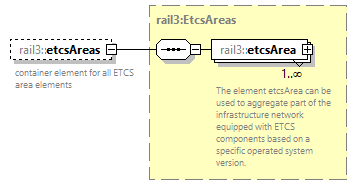 | ||||||
| namespace | https://www.railml.org/schemas/3.2 | ||||||
| type | rail3:EtcsAreas | ||||||
| properties |
| ||||||
| children | rail3:etcsArea | ||||||
| annotation |
| ||||||
| source | <xs:element name="etcsAreas" type="rail3:EtcsAreas" minOccurs="0" maxOccurs="1"> <xs:annotation> <xs:documentation>container element for all ETCS area elements</xs:documentation> </xs:annotation> </xs:element> |
element FunctionalInfrastructure/etcsLevelTransitions
| diagram |  | ||||||
| namespace | https://www.railml.org/schemas/3.2 | ||||||
| type | rail3:EtcsLevelTransitions | ||||||
| properties |
| ||||||
| children | rail3:etcsLevelTransition | ||||||
| annotation |
| ||||||
| source | <xs:element name="etcsLevelTransitions" type="rail3:EtcsLevelTransitions" minOccurs="0" maxOccurs="1"> <xs:annotation> <xs:documentation>container element for all ETCS level transition elements</xs:documentation> </xs:annotation> </xs:element> |
element FunctionalInfrastructure/keyLocksIS
| diagram | 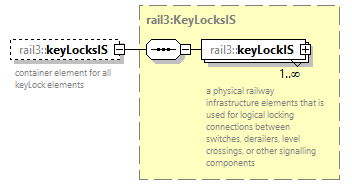 | ||||||
| namespace | https://www.railml.org/schemas/3.2 | ||||||
| type | rail3:KeyLocksIS | ||||||
| properties |
| ||||||
| children | rail3:keyLockIS | ||||||
| annotation |
| ||||||
| source | <xs:element name="keyLocksIS" type="rail3:KeyLocksIS" minOccurs="0" maxOccurs="1"> <xs:annotation> <xs:documentation>container element for all keyLock elements</xs:documentation> </xs:annotation> </xs:element> |
element FunctionalInfrastructure/levelCrossingsIS
| diagram | 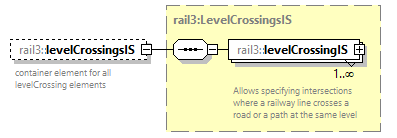 | ||||||
| namespace | https://www.railml.org/schemas/3.2 | ||||||
| type | rail3:LevelCrossingsIS | ||||||
| properties |
| ||||||
| children | rail3:levelCrossingIS | ||||||
| annotation |
| ||||||
| source | <xs:element name="levelCrossingsIS" type="rail3:LevelCrossingsIS" minOccurs="0" maxOccurs="1"> <xs:annotation> <xs:documentation>container element for all levelCrossing elements</xs:documentation> </xs:annotation> </xs:element> |
element FunctionalInfrastructure/lines
| diagram |  | ||||||
| namespace | https://www.railml.org/schemas/3.2 | ||||||
| type | rail3:Lines | ||||||
| properties |
| ||||||
| children | rail3:line | ||||||
| annotation |
| ||||||
| source | <xs:element name="lines" type="rail3:Lines" minOccurs="0" maxOccurs="1"> <xs:annotation> <xs:documentation>container element for all line (section) elements</xs:documentation> </xs:annotation> </xs:element> |
element FunctionalInfrastructure/loadingGauges
| diagram | 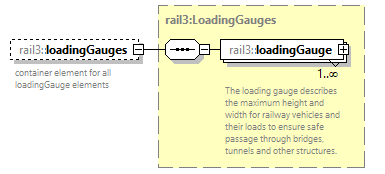 | ||||||
| namespace | https://www.railml.org/schemas/3.2 | ||||||
| type | rail3:LoadingGauges | ||||||
| properties |
| ||||||
| children | rail3:loadingGauge | ||||||
| annotation |
| ||||||
| source | <xs:element name="loadingGauges" type="rail3:LoadingGauges" minOccurs="0" maxOccurs="1"> <xs:annotation> <xs:documentation>container element for all loadingGauge elements</xs:documentation> </xs:annotation> </xs:element> |
element FunctionalInfrastructure/operationalPoints
| diagram |  | ||||||
| namespace | https://www.railml.org/schemas/3.2 | ||||||
| type | rail3:OperationalPoints | ||||||
| properties |
| ||||||
| children | rail3:operationalPoint | ||||||
| annotation |
| ||||||
| source | <xs:element name="operationalPoints" type="rail3:OperationalPoints" minOccurs="0" maxOccurs="1"> <xs:annotation> <xs:documentation>container element for all operationalPoint elements</xs:documentation> </xs:annotation> </xs:element> |
element FunctionalInfrastructure/overCrossings
| diagram |  | ||||||
| namespace | https://www.railml.org/schemas/3.2 | ||||||
| type | rail3:OverCrossings | ||||||
| properties |
| ||||||
| children | rail3:overCrossing | ||||||
| annotation |
| ||||||
| source | <xs:element name="overCrossings" type="rail3:OverCrossings" minOccurs="0" maxOccurs="1"> <xs:annotation> <xs:documentation>container element for all overCrossing elements</xs:documentation> </xs:annotation> </xs:element> |
element FunctionalInfrastructure/platforms
| diagram | 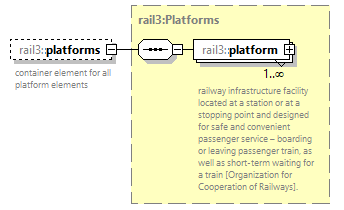 | ||||||
| namespace | https://www.railml.org/schemas/3.2 | ||||||
| type | rail3:Platforms | ||||||
| properties |
| ||||||
| children | rail3:platform | ||||||
| annotation |
| ||||||
| source | <xs:element name="platforms" type="rail3:Platforms" minOccurs="0" maxOccurs="1"> <xs:annotation> <xs:documentation>container element for all platform elements</xs:documentation> </xs:annotation> </xs:element> |
element FunctionalInfrastructure/platformEdges
| diagram | 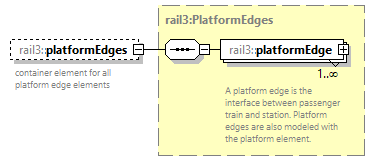 | ||||||
| namespace | https://www.railml.org/schemas/3.2 | ||||||
| type | rail3:PlatformEdges | ||||||
| properties |
| ||||||
| children | rail3:platformEdge | ||||||
| annotation |
| ||||||
| source | <xs:element name="platformEdges" type="rail3:PlatformEdges" minOccurs="0" maxOccurs="1"> <xs:annotation> <xs:documentation>container element for all platform edge elements</xs:documentation> </xs:annotation> </xs:element> |
element FunctionalInfrastructure/radioBlockCentreBorders
| diagram |  | ||||||
| namespace | https://www.railml.org/schemas/3.2 | ||||||
| type | rail3:RbcBorders | ||||||
| properties |
| ||||||
| children | rail3:radioBlockCentreBorder | ||||||
| annotation |
| ||||||
| source | <xs:element name="radioBlockCentreBorders" type="rail3:RbcBorders" minOccurs="0" maxOccurs="1"> <xs:annotation> <xs:documentation>container element for all rbcBorder elements</xs:documentation> </xs:annotation> </xs:element> |
element FunctionalInfrastructure/restrictionAreas
| diagram |  | ||||||
| namespace | https://www.railml.org/schemas/3.2 | ||||||
| type | rail3:RestrictionAreas | ||||||
| properties |
| ||||||
| children | rail3:restrictionArea | ||||||
| annotation |
| ||||||
| source | <xs:element name="restrictionAreas" type="rail3:RestrictionAreas" minOccurs="0" maxOccurs="1"> <xs:annotation> <xs:documentation>container element for all restrictionArea elements</xs:documentation> </xs:annotation> </xs:element> |
element FunctionalInfrastructure/serviceSections
| diagram |  | ||||||
| namespace | https://www.railml.org/schemas/3.2 | ||||||
| type | rail3:ServiceSections | ||||||
| properties |
| ||||||
| children | rail3:serviceSection | ||||||
| annotation |
| ||||||
| source | <xs:element name="serviceSections" type="rail3:ServiceSections" minOccurs="0" maxOccurs="1"> <xs:annotation> <xs:documentation>container element for all serviceSection elements</xs:documentation> </xs:annotation> </xs:element> |
element FunctionalInfrastructure/signalsIS
| diagram | 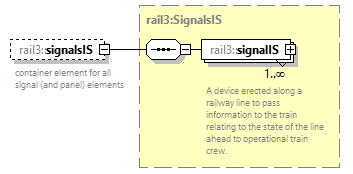 | ||||||
| namespace | https://www.railml.org/schemas/3.2 | ||||||
| type | rail3:SignalsIS | ||||||
| properties |
| ||||||
| children | rail3:signalIS | ||||||
| annotation |
| ||||||
| source | <xs:element name="signalsIS" type="rail3:SignalsIS" minOccurs="0" maxOccurs="1"> <xs:annotation> <xs:documentation>container element for all signal (and panel) elements</xs:documentation> </xs:annotation> </xs:element> |
element FunctionalInfrastructure/speeds
| diagram | 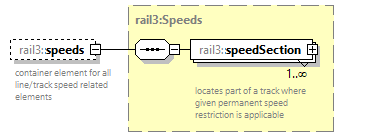 | ||||||
| namespace | https://www.railml.org/schemas/3.2 | ||||||
| type | rail3:Speeds | ||||||
| properties |
| ||||||
| children | rail3:speedSection | ||||||
| annotation |
| ||||||
| source | <xs:element name="speeds" type="rail3:Speeds" minOccurs="0" maxOccurs="1"> <xs:annotation> <xs:documentation>container element for all line/track speed related elements</xs:documentation> </xs:annotation> </xs:element> |
element FunctionalInfrastructure/stoppingPlaces
| diagram |  | ||||||
| namespace | https://www.railml.org/schemas/3.2 | ||||||
| type | rail3:StoppingPlaces | ||||||
| properties |
| ||||||
| children | rail3:stoppingPlace | ||||||
| annotation |
| ||||||
| source | <xs:element name="stoppingPlaces" type="rail3:StoppingPlaces" minOccurs="0" maxOccurs="1"> <xs:annotation> <xs:documentation>container element for all stoppingPlace elements</xs:documentation> </xs:annotation> </xs:element> |
element FunctionalInfrastructure/switchesIS
| diagram | 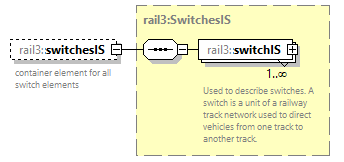 | ||||||
| namespace | https://www.railml.org/schemas/3.2 | ||||||
| type | rail3:SwitchesIS | ||||||
| properties |
| ||||||
| children | rail3:switchIS | ||||||
| annotation |
| ||||||
| source | <xs:element name="switchesIS" type="rail3:SwitchesIS" minOccurs="0" maxOccurs="1"> <xs:annotation> <xs:documentation>container element for all switch elements</xs:documentation> </xs:annotation> </xs:element> |
element FunctionalInfrastructure/tracks
| diagram | 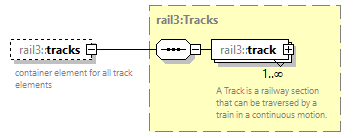 | ||||||
| namespace | https://www.railml.org/schemas/3.2 | ||||||
| type | rail3:Tracks | ||||||
| properties |
| ||||||
| children | rail3:track | ||||||
| annotation |
| ||||||
| source | <xs:element name="tracks" type="rail3:Tracks" minOccurs="0" maxOccurs="1"> <xs:annotation> <xs:documentation>container element for all track elements</xs:documentation> </xs:annotation> </xs:element> |
element FunctionalInfrastructure/trackBeds
| diagram |  | ||||||
| namespace | https://www.railml.org/schemas/3.2 | ||||||
| type | rail3:TrackBeds | ||||||
| properties |
| ||||||
| children | rail3:trackBed | ||||||
| annotation |
| ||||||
| source | <xs:element name="trackBeds" type="rail3:TrackBeds" minOccurs="0" maxOccurs="1"> <xs:annotation> <xs:documentation>container element for all trackBed elements</xs:documentation> </xs:annotation> </xs:element> |
element FunctionalInfrastructure/trackGauges
| diagram | 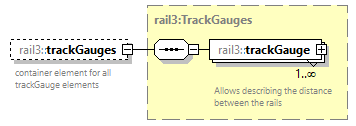 | ||||||
| namespace | https://www.railml.org/schemas/3.2 | ||||||
| type | rail3:TrackGauges | ||||||
| properties |
| ||||||
| children | rail3:trackGauge | ||||||
| annotation |
| ||||||
| source | <xs:element name="trackGauges" type="rail3:TrackGauges" minOccurs="0" maxOccurs="1"> <xs:annotation> <xs:documentation>container element for all trackGauge elements</xs:documentation> </xs:annotation> </xs:element> |
element FunctionalInfrastructure/trainDetectionElements
| diagram |  | ||||||
| namespace | https://www.railml.org/schemas/3.2 | ||||||
| type | rail3:TrainDetectionElements | ||||||
| properties |
| ||||||
| children | rail3:trainDetectionElement | ||||||
| annotation |
| ||||||
| source | <xs:element name="trainDetectionElements" type="rail3:TrainDetectionElements" minOccurs="0" maxOccurs="1"> <xs:annotation> <xs:documentation>container element for all trainDetectionElement elements</xs:documentation> </xs:annotation> </xs:element> |
element FunctionalInfrastructure/trainProtectionElements
| diagram |  | ||||||
| namespace | https://www.railml.org/schemas/3.2 | ||||||
| type | rail3:TrainProtectionElements | ||||||
| properties |
| ||||||
| children | rail3:trainProtectionElement | ||||||
| annotation |
| ||||||
| source | <xs:element name="trainProtectionElements" type="rail3:TrainProtectionElements" minOccurs="0" maxOccurs="1"> <xs:annotation> <xs:documentation>container element for all trainProtectionElement elements;
 Do not use trainProtectionElements for modelling ETCS based train protection systems and elements, but use dedicated elements (balise and baliseGroup) for this.</xs:documentation> </xs:annotation> </xs:element> |
element FunctionalInfrastructure/trainRadios
| diagram |  | ||||||
| namespace | https://www.railml.org/schemas/3.2 | ||||||
| type | rail3:TrainRadios | ||||||
| properties |
| ||||||
| children | rail3:trainRadio | ||||||
| annotation |
| ||||||
| source | <xs:element name="trainRadios" type="rail3:TrainRadios" minOccurs="0" maxOccurs="1"> <xs:annotation> <xs:documentation>container element for all trainRadio elements</xs:documentation> </xs:annotation> </xs:element> |
element FunctionalInfrastructure/underCrossings
| diagram |  | ||||||
| namespace | https://www.railml.org/schemas/3.2 | ||||||
| type | rail3:UnderCrossings | ||||||
| properties |
| ||||||
| children | rail3:underCrossing | ||||||
| annotation |
| ||||||
| source | <xs:element name="underCrossings" type="rail3:UnderCrossings" minOccurs="0" maxOccurs="1"> <xs:annotation> <xs:documentation>container element for all underCrossing elements</xs:documentation> </xs:annotation> </xs:element> |
element FunctionalInfrastructure/weightLimits
| diagram |  | ||||||
| namespace | https://www.railml.org/schemas/3.2 | ||||||
| type | rail3:WeightLimits | ||||||
| properties |
| ||||||
| children | rail3:weightLimit | ||||||
| annotation |
| ||||||
| source | <xs:element name="weightLimits" type="rail3:WeightLimits" minOccurs="0" maxOccurs="1"> <xs:annotation> <xs:documentation>container element for all weightLimit (axle load, meterload) elements</xs:documentation> </xs:annotation> </xs:element> |
element FunctionalInfrastructure/mileageChanges
| diagram |  | ||||||
| namespace | https://www.railml.org/schemas/3.2 | ||||||
| type | rail3:MileageChanges | ||||||
| properties |
| ||||||
| children | rail3:mileageChange | ||||||
| annotation |
| ||||||
| source | <xs:element name="mileageChanges" type="rail3:MileageChanges" minOccurs="0" maxOccurs="1"> <xs:annotation> <xs:documentation>container element for all mileage changes</xs:documentation> </xs:annotation> </xs:element> |
element FunctionalInfrastructure/tunnelGatesIS
| diagram |  | ||||||
| namespace | https://www.railml.org/schemas/3.2 | ||||||
| type | rail3:TunnelGatesIS | ||||||
| properties |
| ||||||
| children | rail3:tunnelGateIS | ||||||
| source | <xs:element name="tunnelGatesIS" type="rail3:TunnelGatesIS" minOccurs="0" maxOccurs="1"/> |
complexType FunctionalInfrastructureElementReference
| diagram |  | ||||||||||||
| namespace | https://www.railml.org/schemas/3.2 | ||||||||||||
| used by |
| ||||||||||||
| attributes |
| ||||||||||||
| source | <xs:complexType name="FunctionalInfrastructureElementReference"> <xs:sequence/> <xs:attribute name="ref" type="rail3:tRef" use="optional"/> </xs:complexType> |
attribute FunctionalInfrastructureElementReference/@ref
| type | rail3:tRef | ||
| properties |
| ||
| source | <xs:attribute name="ref" type="rail3:tRef" use="optional"/> |
complexType FunctionalInfrastructureEntity
| diagram | 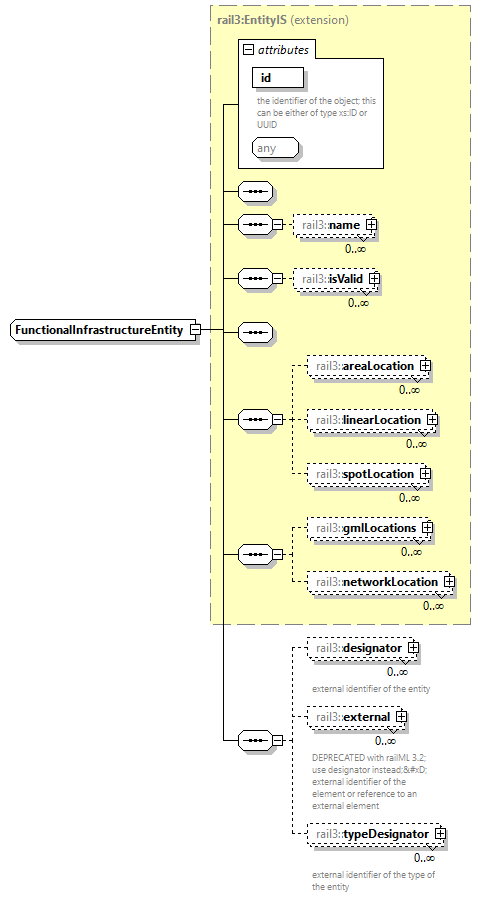 | ||||||||||||||
| namespace | https://www.railml.org/schemas/3.2 | ||||||||||||||
| type | extension of rail3:EntityIS | ||||||||||||||
| properties |
| ||||||||||||||
| children | rail3:name rail3:isValid rail3:areaLocation rail3:linearLocation rail3:spotLocation rail3:gmlLocations rail3:networkLocation rail3:designator rail3:external rail3:typeDesignator | ||||||||||||||
| used by |
| ||||||||||||||
| attributes |
| ||||||||||||||
| source | <xs:complexType name="FunctionalInfrastructureEntity" abstract="true"> <xs:complexContent> <xs:extension base="rail3:EntityIS"> <xs:sequence> <xs:element name="designator" type="rail3:Designator" minOccurs="0" maxOccurs="unbounded"> <xs:annotation> <xs:documentation>external identifier of the entity</xs:documentation> </xs:annotation> </xs:element> <xs:element name="external" type="rail3:External" minOccurs="0" maxOccurs="unbounded"> <xs:annotation> <xs:documentation>DEPRECATED with railML 3.2; use designator instead;
 external identifier of the element or reference to an external element</xs:documentation> </xs:annotation> </xs:element> <xs:element name="typeDesignator" type="rail3:TypeDesignator" minOccurs="0" maxOccurs="unbounded"> <xs:annotation> <xs:documentation>external identifier of the type of the entity</xs:documentation> </xs:annotation> </xs:element> </xs:sequence> </xs:extension> </xs:complexContent> </xs:complexType> |
element FunctionalInfrastructureEntity/designator
| diagram | 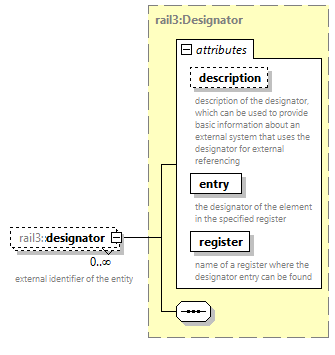 | ||||||||||||||||||||||||||||||
| namespace | https://www.railml.org/schemas/3.2 | ||||||||||||||||||||||||||||||
| type | rail3:Designator | ||||||||||||||||||||||||||||||
| properties |
| ||||||||||||||||||||||||||||||
| attributes |
| ||||||||||||||||||||||||||||||
| annotation |
| ||||||||||||||||||||||||||||||
| source | <xs:element name="designator" type="rail3:Designator" minOccurs="0" maxOccurs="unbounded"> <xs:annotation> <xs:documentation>external identifier of the entity</xs:documentation> </xs:annotation> </xs:element> |
element FunctionalInfrastructureEntity/external
| diagram | 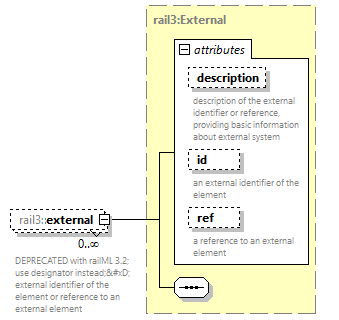 | ||||||||||||||||||||||||||||||
| namespace | https://www.railml.org/schemas/3.2 | ||||||||||||||||||||||||||||||
| type | rail3:External | ||||||||||||||||||||||||||||||
| properties |
| ||||||||||||||||||||||||||||||
| attributes |
| ||||||||||||||||||||||||||||||
| annotation |
| ||||||||||||||||||||||||||||||
| source | <xs:element name="external" type="rail3:External" minOccurs="0" maxOccurs="unbounded"> <xs:annotation> <xs:documentation>DEPRECATED with railML 3.2; use designator instead;
 external identifier of the element or reference to an external element</xs:documentation> </xs:annotation> </xs:element> |
element FunctionalInfrastructureEntity/typeDesignator
| diagram | 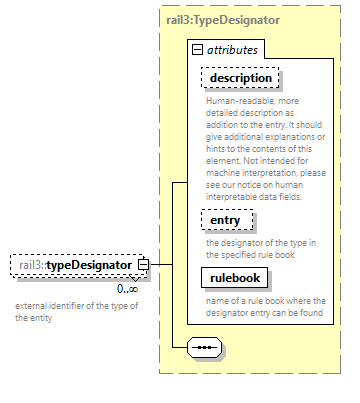 | ||||||||||||||||||||||||||||||
| namespace | https://www.railml.org/schemas/3.2 | ||||||||||||||||||||||||||||||
| type | rail3:TypeDesignator | ||||||||||||||||||||||||||||||
| properties |
| ||||||||||||||||||||||||||||||
| attributes |
| ||||||||||||||||||||||||||||||
| annotation |
| ||||||||||||||||||||||||||||||
| source | <xs:element name="typeDesignator" type="rail3:TypeDesignator" minOccurs="0" maxOccurs="unbounded"> <xs:annotation> <xs:documentation>external identifier of the type of the entity</xs:documentation> </xs:annotation> </xs:element> |
complexType GenericArea
| diagram | 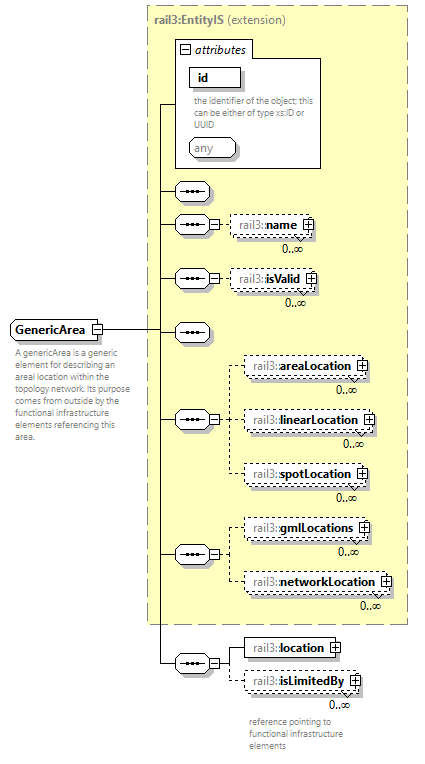 | ||||||||||||||
| namespace | https://www.railml.org/schemas/3.2 | ||||||||||||||
| type | extension of rail3:EntityIS | ||||||||||||||
| properties |
| ||||||||||||||
| children | rail3:name rail3:isValid rail3:areaLocation rail3:linearLocation rail3:spotLocation rail3:gmlLocations rail3:networkLocation rail3:location rail3:isLimitedBy | ||||||||||||||
| used by |
| ||||||||||||||
| attributes |
| ||||||||||||||
| annotation |
| ||||||||||||||
| source | <xs:complexType name="GenericArea"> <xs:annotation> <xs:documentation>A genericArea is a generic element for describing an areal location within the topology network. Its purpose comes from outside by the functional infrastructure elements referencing this area.</xs:documentation> </xs:annotation> <xs:complexContent> <xs:extension base="rail3:EntityIS"> <xs:sequence> <xs:element name="location" type="rail3:Location" minOccurs="1" maxOccurs="1"/> <xs:element name="isLimitedBy" type="rail3:FunctionalInfrastructureElementReference" minOccurs="0" maxOccurs="unbounded"> <xs:annotation> <xs:documentation>reference pointing to functional infrastructure elements</xs:documentation> </xs:annotation> </xs:element> </xs:sequence> </xs:extension> </xs:complexContent> </xs:complexType> |
element GenericArea/location
| diagram | 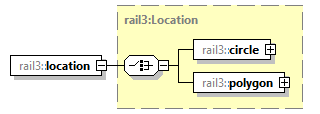 | ||
| namespace | https://www.railml.org/schemas/3.2 | ||
| type | rail3:Location | ||
| properties |
| ||
| children | rail3:circle rail3:polygon | ||
| source | <xs:element name="location" type="rail3:Location" minOccurs="1" maxOccurs="1"/> |
element GenericArea/isLimitedBy
| diagram | 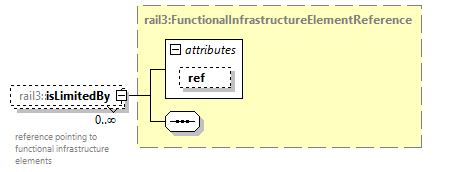 | ||||||||||||
| namespace | https://www.railml.org/schemas/3.2 | ||||||||||||
| type | rail3:FunctionalInfrastructureElementReference | ||||||||||||
| properties |
| ||||||||||||
| attributes |
| ||||||||||||
| annotation |
| ||||||||||||
| source | <xs:element name="isLimitedBy" type="rail3:FunctionalInfrastructureElementReference" minOccurs="0" maxOccurs="unbounded"> <xs:annotation> <xs:documentation>reference pointing to functional infrastructure elements</xs:documentation> </xs:annotation> </xs:element> |
complexType GenericLocations
| diagram |  | ||
| namespace | https://www.railml.org/schemas/3.2 | ||
| children | rail3:genericArea | ||
| used by |
| ||
| source | <xs:complexType name="GenericLocations"> <xs:sequence> <xs:element name="genericArea" type="rail3:GenericArea" minOccurs="0" maxOccurs="unbounded"/> </xs:sequence> </xs:complexType> |
element GenericLocations/genericArea
| diagram | 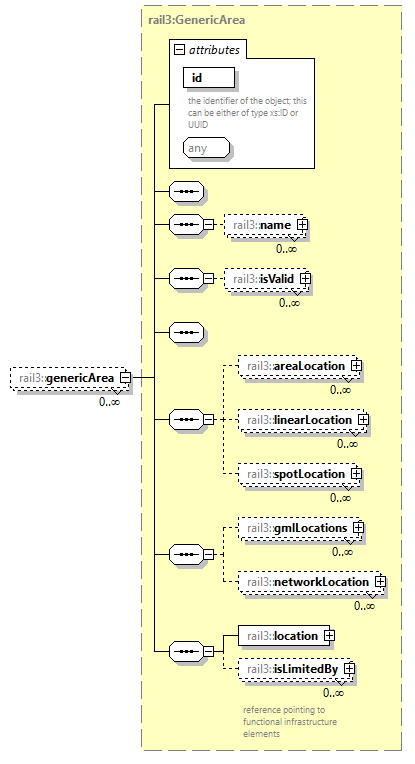 | ||||||||||||||
| namespace | https://www.railml.org/schemas/3.2 | ||||||||||||||
| type | rail3:GenericArea | ||||||||||||||
| properties |
| ||||||||||||||
| children | rail3:name rail3:isValid rail3:areaLocation rail3:linearLocation rail3:spotLocation rail3:gmlLocations rail3:networkLocation rail3:location rail3:isLimitedBy | ||||||||||||||
| attributes |
| ||||||||||||||
| source | <xs:element name="genericArea" type="rail3:GenericArea" minOccurs="0" maxOccurs="unbounded"/> |
complexType Geometry
| diagram | 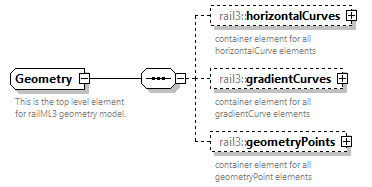 | ||
| namespace | https://www.railml.org/schemas/3.2 | ||
| children | rail3:horizontalCurves rail3:gradientCurves rail3:geometryPoints | ||
| used by |
| ||
| annotation |
| ||
| source | <xs:complexType name="Geometry"> <xs:annotation> <xs:documentation>This is the top level element for railML3 geometry model.</xs:documentation> </xs:annotation> <xs:sequence> <xs:element name="horizontalCurves" type="rail3:HorizontalCurves" minOccurs="0" maxOccurs="1"> <xs:annotation> <xs:documentation>container element for all horizontalCurve elements</xs:documentation> </xs:annotation> </xs:element> <xs:element name="gradientCurves" type="rail3:GradientCurves" minOccurs="0" maxOccurs="1"> <xs:annotation> <xs:documentation>container element for all gradientCurve elements</xs:documentation> </xs:annotation> </xs:element> <xs:element name="geometryPoints" type="rail3:GeometryPoints" minOccurs="0" maxOccurs="1"> <xs:annotation> <xs:documentation>container element for all geometryPoint elements</xs:documentation> </xs:annotation> </xs:element> </xs:sequence> </xs:complexType> |
element Geometry/horizontalCurves
| diagram |  | ||||||
| namespace | https://www.railml.org/schemas/3.2 | ||||||
| type | rail3:HorizontalCurves | ||||||
| properties |
| ||||||
| children | rail3:horizontalCurve | ||||||
| annotation |
| ||||||
| source | <xs:element name="horizontalCurves" type="rail3:HorizontalCurves" minOccurs="0" maxOccurs="1"> <xs:annotation> <xs:documentation>container element for all horizontalCurve elements</xs:documentation> </xs:annotation> </xs:element> |
element Geometry/gradientCurves
| diagram |  | ||||||
| namespace | https://www.railml.org/schemas/3.2 | ||||||
| type | rail3:GradientCurves | ||||||
| properties |
| ||||||
| children | rail3:gradientCurve | ||||||
| annotation |
| ||||||
| source | <xs:element name="gradientCurves" type="rail3:GradientCurves" minOccurs="0" maxOccurs="1"> <xs:annotation> <xs:documentation>container element for all gradientCurve elements</xs:documentation> </xs:annotation> </xs:element> |
element Geometry/geometryPoints
| diagram |  | ||||||
| namespace | https://www.railml.org/schemas/3.2 | ||||||
| type | rail3:GeometryPoints | ||||||
| properties |
| ||||||
| children | rail3:geometryPoint | ||||||
| annotation |
| ||||||
| source | <xs:element name="geometryPoints" type="rail3:GeometryPoints" minOccurs="0" maxOccurs="1"> <xs:annotation> <xs:documentation>container element for all geometryPoint elements</xs:documentation> </xs:annotation> </xs:element> |
complexType GeometryCurve
| diagram | 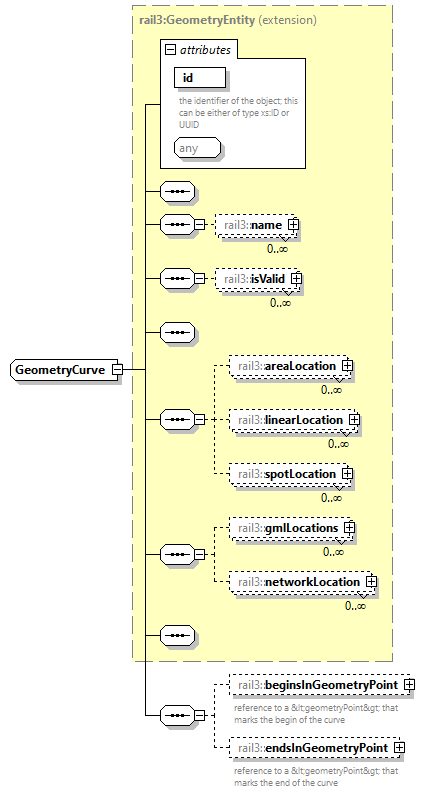 | ||||||||||||||
| namespace | https://www.railml.org/schemas/3.2 | ||||||||||||||
| type | extension of rail3:GeometryEntity | ||||||||||||||
| properties |
| ||||||||||||||
| children | rail3:name rail3:isValid rail3:areaLocation rail3:linearLocation rail3:spotLocation rail3:gmlLocations rail3:networkLocation rail3:beginsInGeometryPoint rail3:endsInGeometryPoint | ||||||||||||||
| used by |
| ||||||||||||||
| attributes |
| ||||||||||||||
| source | <xs:complexType name="GeometryCurve" abstract="true"> <xs:complexContent> <xs:extension base="rail3:GeometryEntity"> <xs:sequence> <xs:element name="beginsInGeometryPoint" type="rail3:tElementWithIDref" minOccurs="0" maxOccurs="1"> <xs:annotation> <xs:documentation>reference to a <geometryPoint> that marks the begin of the curve</xs:documentation> </xs:annotation> </xs:element> <xs:element name="endsInGeometryPoint" type="rail3:tElementWithIDref" minOccurs="0" maxOccurs="1"> <xs:annotation> <xs:documentation>reference to a <geometryPoint> that marks the end of the curve</xs:documentation> </xs:annotation> </xs:element> </xs:sequence> </xs:extension> </xs:complexContent> </xs:complexType> |
element GeometryCurve/beginsInGeometryPoint
| diagram | 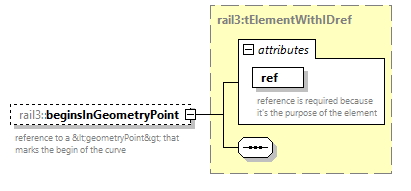 | ||||||||||||||
| namespace | https://www.railml.org/schemas/3.2 | ||||||||||||||
| type | rail3:tElementWithIDref | ||||||||||||||
| properties |
| ||||||||||||||
| attributes |
| ||||||||||||||
| annotation |
| ||||||||||||||
| source | <xs:element name="beginsInGeometryPoint" type="rail3:tElementWithIDref" minOccurs="0" maxOccurs="1"> <xs:annotation> <xs:documentation>reference to a <geometryPoint> that marks the begin of the curve</xs:documentation> </xs:annotation> </xs:element> |
element GeometryCurve/endsInGeometryPoint
| diagram | 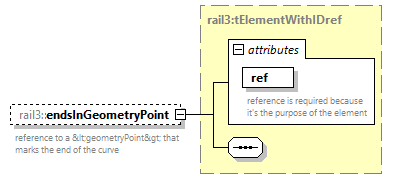 | ||||||||||||||
| namespace | https://www.railml.org/schemas/3.2 | ||||||||||||||
| type | rail3:tElementWithIDref | ||||||||||||||
| properties |
| ||||||||||||||
| attributes |
| ||||||||||||||
| annotation |
| ||||||||||||||
| source | <xs:element name="endsInGeometryPoint" type="rail3:tElementWithIDref" minOccurs="0" maxOccurs="1"> <xs:annotation> <xs:documentation>reference to a <geometryPoint> that marks the end of the curve</xs:documentation> </xs:annotation> </xs:element> |
complexType GeometryEntity
| diagram | 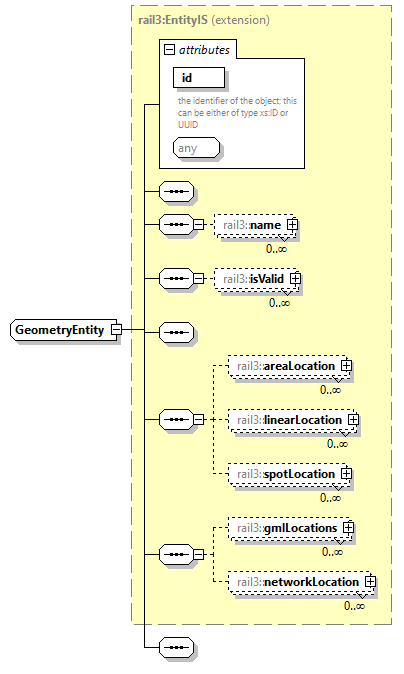 | ||||||||||||||
| namespace | https://www.railml.org/schemas/3.2 | ||||||||||||||
| type | extension of rail3:EntityIS | ||||||||||||||
| properties |
| ||||||||||||||
| children | rail3:name rail3:isValid rail3:areaLocation rail3:linearLocation rail3:spotLocation rail3:gmlLocations rail3:networkLocation | ||||||||||||||
| used by |
| ||||||||||||||
| attributes |
| ||||||||||||||
| source | <xs:complexType name="GeometryEntity" abstract="true"> <xs:complexContent> <xs:extension base="rail3:EntityIS"> <xs:sequence/> </xs:extension> </xs:complexContent> </xs:complexType> |
complexType GeometryPoint
| diagram | 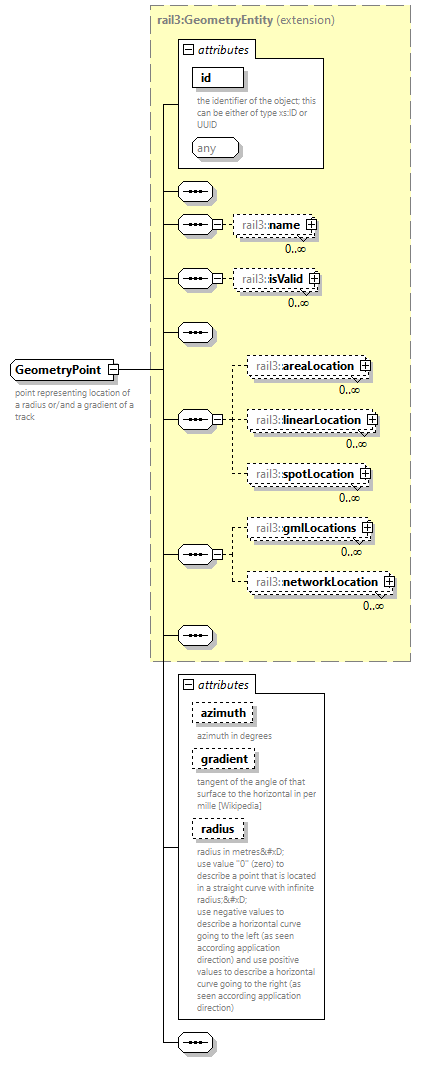 | ||||||||||||||||||||||||||||||||||||||
| namespace | https://www.railml.org/schemas/3.2 | ||||||||||||||||||||||||||||||||||||||
| type | extension of rail3:GeometryEntity | ||||||||||||||||||||||||||||||||||||||
| properties |
| ||||||||||||||||||||||||||||||||||||||
| children | rail3:name rail3:isValid rail3:areaLocation rail3:linearLocation rail3:spotLocation rail3:gmlLocations rail3:networkLocation | ||||||||||||||||||||||||||||||||||||||
| used by |
| ||||||||||||||||||||||||||||||||||||||
| attributes |
| ||||||||||||||||||||||||||||||||||||||
| annotation |
| ||||||||||||||||||||||||||||||||||||||
| source | <xs:complexType name="GeometryPoint"> <xs:annotation> <xs:documentation>point representing location of a radius or/and a gradient of a track</xs:documentation> </xs:annotation> <xs:complexContent> <xs:extension base="rail3:GeometryEntity"> <xs:sequence/> <xs:attribute name="azimuth" type="rail3:tAngleDeg" use="optional"> <xs:annotation> <xs:documentation>azimuth in degrees</xs:documentation> </xs:annotation> </xs:attribute> <xs:attribute name="gradient" type="rail3:tGradientPerMille" use="optional"> <xs:annotation> <xs:documentation>tangent of the angle of that surface to the horizontal in per mille [Wikipedia]</xs:documentation> </xs:annotation> </xs:attribute> <xs:attribute name="radius" type="rail3:tLengthM" use="optional"> <xs:annotation> <xs:documentation>radius in metres
 use value "0" (zero) to describe a point that is located in a straight curve with infinite radius;
 use negative values to describe a horizontal curve going to the left (as seen according application direction) and use positive values to describe a horizontal curve going to the right (as seen according application direction)</xs:documentation> </xs:annotation> </xs:attribute> </xs:extension> </xs:complexContent> </xs:complexType> |
attribute GeometryPoint/@azimuth
| type | rail3:tAngleDeg | ||
| properties |
| ||
| annotation |
| ||
| source | <xs:attribute name="azimuth" type="rail3:tAngleDeg" use="optional"> <xs:annotation> <xs:documentation>azimuth in degrees</xs:documentation> </xs:annotation> </xs:attribute> |
attribute GeometryPoint/@gradient
| type | rail3:tGradientPerMille | ||
| properties |
| ||
| annotation |
| ||
| source | <xs:attribute name="gradient" type="rail3:tGradientPerMille" use="optional"> <xs:annotation> <xs:documentation>tangent of the angle of that surface to the horizontal in per mille [Wikipedia]</xs:documentation> </xs:annotation> </xs:attribute> |
attribute GeometryPoint/@radius
| type | rail3:tLengthM | ||
| properties |
| ||
| annotation |
| ||
| source | <xs:attribute name="radius" type="rail3:tLengthM" use="optional"> <xs:annotation> <xs:documentation>radius in metres
 use value "0" (zero) to describe a point that is located in a straight curve with infinite radius;
 use negative values to describe a horizontal curve going to the left (as seen according application direction) and use positive values to describe a horizontal curve going to the right (as seen according application direction)</xs:documentation> </xs:annotation> </xs:attribute> |
complexType GeometryPoints
| diagram |  | ||
| namespace | https://www.railml.org/schemas/3.2 | ||
| children | rail3:geometryPoint | ||
| used by |
| ||
| source | <xs:complexType name="GeometryPoints"> <xs:sequence> <xs:element name="geometryPoint" type="rail3:GeometryPoint" minOccurs="1" maxOccurs="unbounded"/> </xs:sequence> </xs:complexType> |
element GeometryPoints/geometryPoint
| diagram | 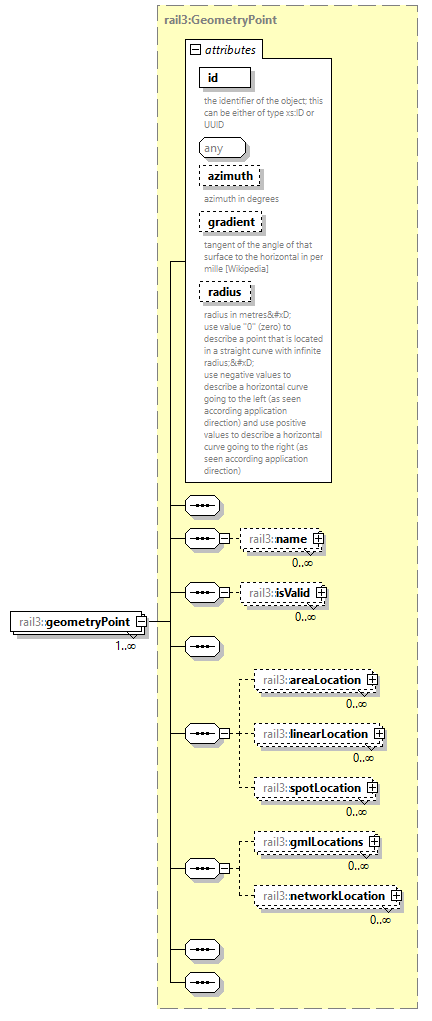 | ||||||||||||||||||||||||||||||||||||||
| namespace | https://www.railml.org/schemas/3.2 | ||||||||||||||||||||||||||||||||||||||
| type | rail3:GeometryPoint | ||||||||||||||||||||||||||||||||||||||
| properties |
| ||||||||||||||||||||||||||||||||||||||
| children | rail3:name rail3:isValid rail3:areaLocation rail3:linearLocation rail3:spotLocation rail3:gmlLocations rail3:networkLocation | ||||||||||||||||||||||||||||||||||||||
| attributes |
| ||||||||||||||||||||||||||||||||||||||
| source | <xs:element name="geometryPoint" type="rail3:GeometryPoint" minOccurs="1" maxOccurs="unbounded"/> |
complexType GmlLocations
| diagram | 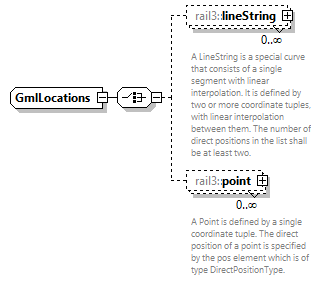 | ||
| namespace | https://www.railml.org/schemas/3.2 | ||
| children | rail3:lineString rail3:point | ||
| used by |
| ||
| source | <xs:complexType name="GmlLocations"> <xs:choice> <xs:element name="lineString" type="rail3:LineTypeCoordinate" minOccurs="0" maxOccurs="unbounded"> <xs:annotation> <xs:documentation>A LineString is a special curve that consists of a single segment with linear interpolation. It is defined by two or more coordinate tuples, with linear interpolation between them. The number of direct positions in the list shall be at least two.</xs:documentation> </xs:annotation> </xs:element> <xs:element name="point" type="rail3:PointTypeCoordinate" minOccurs="0" maxOccurs="unbounded"> <xs:annotation> <xs:documentation>A Point is defined by a single coordinate tuple. The direct position of a point is specified by the pos element which is of type DirectPositionType.</xs:documentation> </xs:annotation> </xs:element> </xs:choice> </xs:complexType> |
element GmlLocations/lineString
| diagram | 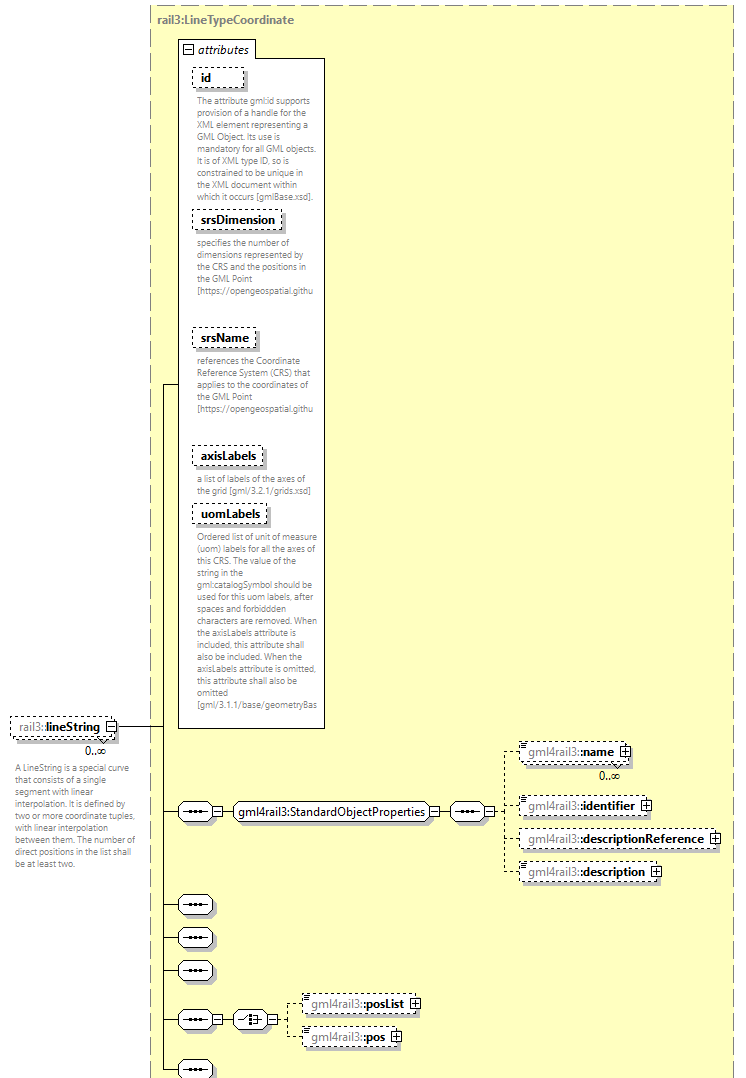 | ||||||||||||||||||||||||||||||||||||||||||||||
| namespace | https://www.railml.org/schemas/3.2 | ||||||||||||||||||||||||||||||||||||||||||||||
| type | rail3:LineTypeCoordinate | ||||||||||||||||||||||||||||||||||||||||||||||
| properties |
| ||||||||||||||||||||||||||||||||||||||||||||||
| children | gml4rail3:name gml4rail3:identifier gml4rail3:descriptionReference gml4rail3:description gml4rail3:posList gml4rail3:pos | ||||||||||||||||||||||||||||||||||||||||||||||
| attributes |
| ||||||||||||||||||||||||||||||||||||||||||||||
| annotation |
| ||||||||||||||||||||||||||||||||||||||||||||||
| source | <xs:element name="lineString" type="rail3:LineTypeCoordinate" minOccurs="0" maxOccurs="unbounded"> <xs:annotation> <xs:documentation>A LineString is a special curve that consists of a single segment with linear interpolation. It is defined by two or more coordinate tuples, with linear interpolation between them. The number of direct positions in the list shall be at least two.</xs:documentation> </xs:annotation> </xs:element> |
element GmlLocations/point
| diagram | 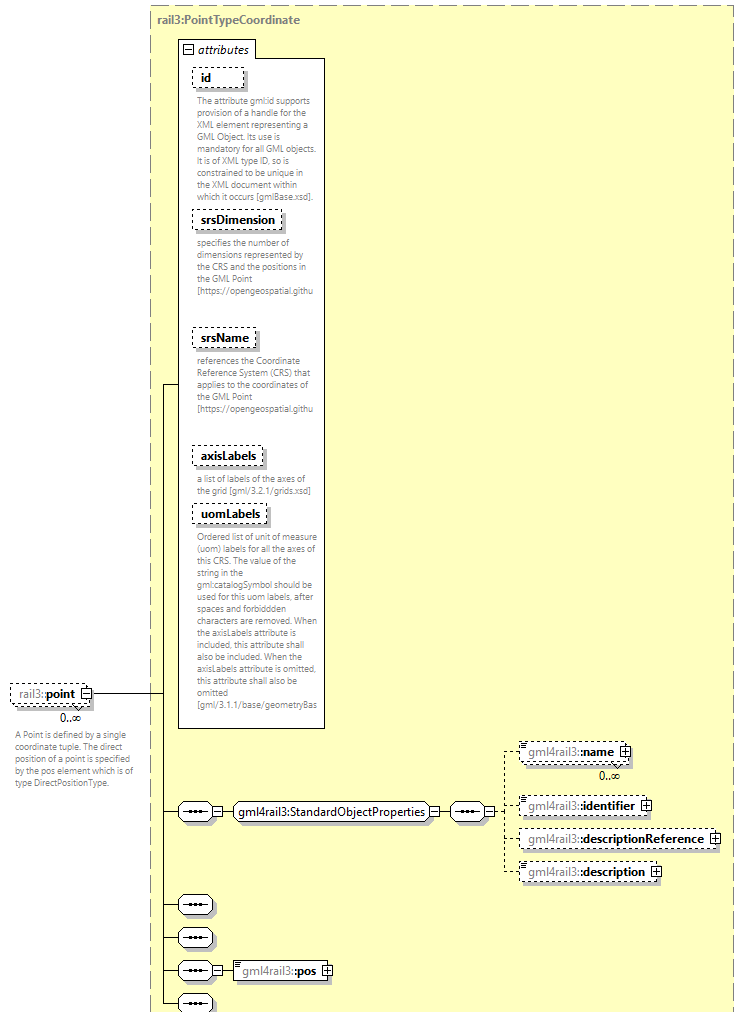 | ||||||||||||||||||||||||||||||||||||||||||||||
| namespace | https://www.railml.org/schemas/3.2 | ||||||||||||||||||||||||||||||||||||||||||||||
| type | rail3:PointTypeCoordinate | ||||||||||||||||||||||||||||||||||||||||||||||
| properties |
| ||||||||||||||||||||||||||||||||||||||||||||||
| children | gml4rail3:name gml4rail3:identifier gml4rail3:descriptionReference gml4rail3:description gml4rail3:pos | ||||||||||||||||||||||||||||||||||||||||||||||
| attributes |
| ||||||||||||||||||||||||||||||||||||||||||||||
| annotation |
| ||||||||||||||||||||||||||||||||||||||||||||||
| source | <xs:element name="point" type="rail3:PointTypeCoordinate" minOccurs="0" maxOccurs="unbounded"> <xs:annotation> <xs:documentation>A Point is defined by a single coordinate tuple. The direct position of a point is specified by the pos element which is of type DirectPositionType.</xs:documentation> </xs:annotation> </xs:element> |
complexType GradientCurve
| diagram |  | ||||||||||||||||||||||||||||||||||||||||||||||||||||||
| namespace | https://www.railml.org/schemas/3.2 | ||||||||||||||||||||||||||||||||||||||||||||||||||||||
| type | extension of rail3:GeometryCurve | ||||||||||||||||||||||||||||||||||||||||||||||||||||||
| properties |
| ||||||||||||||||||||||||||||||||||||||||||||||||||||||
| children | rail3:name rail3:isValid rail3:areaLocation rail3:linearLocation rail3:spotLocation rail3:gmlLocations rail3:networkLocation rail3:beginsInGeometryPoint rail3:endsInGeometryPoint | ||||||||||||||||||||||||||||||||||||||||||||||||||||||
| used by |
| ||||||||||||||||||||||||||||||||||||||||||||||||||||||
| attributes |
| ||||||||||||||||||||||||||||||||||||||||||||||||||||||
| annotation |
| ||||||||||||||||||||||||||||||||||||||||||||||||||||||
| source | <xs:complexType name="GradientCurve"> <xs:annotation> <xs:documentation>vertical alignment of railway track</xs:documentation> </xs:annotation> <xs:complexContent> <xs:extension base="rail3:GeometryCurve"> <xs:sequence/> <xs:attribute name="curveType" type="rail3:tGradientCurveType" use="required"> <xs:annotation> <xs:documentation>type of vertical curve, e.g. arc or straight</xs:documentation> </xs:annotation> </xs:attribute> <xs:attribute name="deltaGradient" type="rail3:tGradientPerMille" use="optional"> <xs:annotation> <xs:documentation>change of gradient of the gradient curve in per mille;
 use this attribute if the gradient value of the gradient curve is not constant, but changing;
 the delta gradient shall be calculated as difference of gradient at the end and gradient at the beginning of the gradient curve</xs:documentation> </xs:annotation> </xs:attribute> <xs:attribute name="gradient" type="rail3:tGradientPerMille" use="optional"> <xs:annotation> <xs:documentation>constant gradient of the gradient curve in per mille;
 positive values indicate an upward slope (rise), negative values indicate a downward slope (fall)</xs:documentation> </xs:annotation> </xs:attribute> <xs:attribute name="length" type="rail3:tLengthM" use="optional"> <xs:annotation> <xs:documentation>length of the gradient curve in metres;
 use this attribute in particular to define the arc length</xs:documentation> </xs:annotation> </xs:attribute> <xs:attribute name="radius" type="rail3:tLengthM" use="optional"> <xs:annotation> <xs:documentation>radius of the gradient curve in metres;
 use negative values to describe the arc curve of a valley and use positive values to describe the arc curve of a hill</xs:documentation> </xs:annotation> </xs:attribute> </xs:extension> </xs:complexContent> </xs:complexType> |
attribute GradientCurve/@curveType
| type | rail3:tGradientCurveType | ||||||||||||||||||
| properties |
| ||||||||||||||||||
| facets |
| ||||||||||||||||||
| annotation |
| ||||||||||||||||||
| source | <xs:attribute name="curveType" type="rail3:tGradientCurveType" use="required"> <xs:annotation> <xs:documentation>type of vertical curve, e.g. arc or straight</xs:documentation> </xs:annotation> </xs:attribute> |
attribute GradientCurve/@deltaGradient
| type | rail3:tGradientPerMille | ||
| properties |
| ||
| annotation |
| ||
| source | <xs:attribute name="deltaGradient" type="rail3:tGradientPerMille" use="optional"> <xs:annotation> <xs:documentation>change of gradient of the gradient curve in per mille;
 use this attribute if the gradient value of the gradient curve is not constant, but changing;
 the delta gradient shall be calculated as difference of gradient at the end and gradient at the beginning of the gradient curve</xs:documentation> </xs:annotation> </xs:attribute> |
attribute GradientCurve/@gradient
| type | rail3:tGradientPerMille | ||
| properties |
| ||
| annotation |
| ||
| source | <xs:attribute name="gradient" type="rail3:tGradientPerMille" use="optional"> <xs:annotation> <xs:documentation>constant gradient of the gradient curve in per mille;
 positive values indicate an upward slope (rise), negative values indicate a downward slope (fall)</xs:documentation> </xs:annotation> </xs:attribute> |
attribute GradientCurve/@length
| type | rail3:tLengthM | ||
| properties |
| ||
| annotation |
| ||
| source | <xs:attribute name="length" type="rail3:tLengthM" use="optional"> <xs:annotation> <xs:documentation>length of the gradient curve in metres;
 use this attribute in particular to define the arc length</xs:documentation> </xs:annotation> </xs:attribute> |
attribute GradientCurve/@radius
| type | rail3:tLengthM | ||
| properties |
| ||
| annotation |
| ||
| source | <xs:attribute name="radius" type="rail3:tLengthM" use="optional"> <xs:annotation> <xs:documentation>radius of the gradient curve in metres;
 use negative values to describe the arc curve of a valley and use positive values to describe the arc curve of a hill</xs:documentation> </xs:annotation> </xs:attribute> |
complexType GradientCurves
| diagram |  | ||
| namespace | https://www.railml.org/schemas/3.2 | ||
| children | rail3:gradientCurve | ||
| used by |
| ||
| source | <xs:complexType name="GradientCurves"> <xs:sequence> <xs:element name="gradientCurve" type="rail3:GradientCurve" minOccurs="1" maxOccurs="unbounded"/> </xs:sequence> </xs:complexType> |
element GradientCurves/gradientCurve
| diagram | 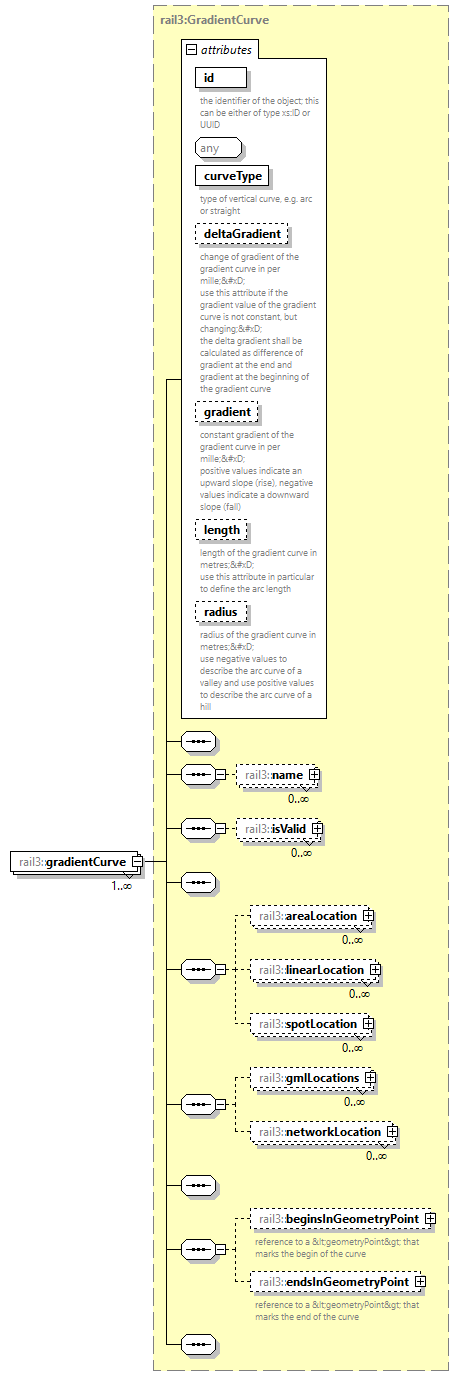 | ||||||||||||||||||||||||||||||||||||||||||||||||||||||
| namespace | https://www.railml.org/schemas/3.2 | ||||||||||||||||||||||||||||||||||||||||||||||||||||||
| type | rail3:GradientCurve | ||||||||||||||||||||||||||||||||||||||||||||||||||||||
| properties |
| ||||||||||||||||||||||||||||||||||||||||||||||||||||||
| children | rail3:name rail3:isValid rail3:areaLocation rail3:linearLocation rail3:spotLocation rail3:gmlLocations rail3:networkLocation rail3:beginsInGeometryPoint rail3:endsInGeometryPoint | ||||||||||||||||||||||||||||||||||||||||||||||||||||||
| attributes |
| ||||||||||||||||||||||||||||||||||||||||||||||||||||||
| source | <xs:element name="gradientCurve" type="rail3:GradientCurve" minOccurs="1" maxOccurs="unbounded"/> |
complexType HorizontalCurve
| diagram |  | ||||||||||||||||||||||||||||||||||||||||||||||||||||||
| namespace | https://www.railml.org/schemas/3.2 | ||||||||||||||||||||||||||||||||||||||||||||||||||||||
| type | extension of rail3:GeometryCurve | ||||||||||||||||||||||||||||||||||||||||||||||||||||||
| properties |
| ||||||||||||||||||||||||||||||||||||||||||||||||||||||
| children | rail3:name rail3:isValid rail3:areaLocation rail3:linearLocation rail3:spotLocation rail3:gmlLocations rail3:networkLocation rail3:beginsInGeometryPoint rail3:endsInGeometryPoint | ||||||||||||||||||||||||||||||||||||||||||||||||||||||
| used by |
| ||||||||||||||||||||||||||||||||||||||||||||||||||||||
| attributes |
| ||||||||||||||||||||||||||||||||||||||||||||||||||||||
| source | <xs:complexType name="HorizontalCurve"> <xs:complexContent> <xs:extension base="rail3:GeometryCurve"> <xs:sequence/> <xs:attribute name="azimuth" type="rail3:tAngleDeg" use="optional"> <xs:annotation> <xs:documentation>constant azimuth (direction angle) of the horizontal curve in degrees;
 Direction "north" has an azimuth of 0 degrees, "east" 90, "south" 180 and "west" 270 degrees.</xs:documentation> </xs:annotation> </xs:attribute> <xs:attribute name="curveType" type="rail3:tHorizontalCurveTypeExt" use="required"> <xs:annotation> <xs:documentation>type of the horizontal curve, e.g. arc or clothoide or straight</xs:documentation> </xs:annotation> </xs:attribute> <xs:attribute name="deltaAzimuth" type="rail3:tAngleDeg" use="optional"> <xs:annotation> <xs:documentation>change of azimuth of the horizontal curve in degrees;
 use this attribute if the azimuth of the horizontal curve is not constant, but changing;
 delta azimuth shall be calculated as difference of azimuth value at the end and the azimuth value at the beginning of the horizontal curve.</xs:documentation> </xs:annotation> </xs:attribute> <xs:attribute name="length" type="rail3:tLengthM" use="optional"> <xs:annotation> <xs:documentation>length of the horizontal curve in metres;
 for arcs and transition curves (e.g. clothoides) this attribute defines the arc length</xs:documentation> </xs:annotation> </xs:attribute> <xs:attribute name="radius" type="rail3:tLengthM" use="optional"> <xs:annotation> <xs:documentation>radius of the horizontal curve in meters;
 use value "0" (zero) to describe straight curves with infinite radius;
 use negative values to describe a horizontal curve going to the left (as seen from begin of curve) and use positive values to describe a horizontal curve going to the right (as seen from begin of curve)</xs:documentation> </xs:annotation> </xs:attribute> </xs:extension> </xs:complexContent> </xs:complexType> |
attribute HorizontalCurve/@azimuth
| type | rail3:tAngleDeg | ||
| properties |
| ||
| annotation |
| ||
| source | <xs:attribute name="azimuth" type="rail3:tAngleDeg" use="optional"> <xs:annotation> <xs:documentation>constant azimuth (direction angle) of the horizontal curve in degrees;
 Direction "north" has an azimuth of 0 degrees, "east" 90, "south" 180 and "west" 270 degrees.</xs:documentation> </xs:annotation> </xs:attribute> |
attribute HorizontalCurve/@curveType
| type | rail3:tHorizontalCurveTypeExt | ||
| properties |
| ||
| annotation |
| ||
| source | <xs:attribute name="curveType" type="rail3:tHorizontalCurveTypeExt" use="required"> <xs:annotation> <xs:documentation>type of the horizontal curve, e.g. arc or clothoide or straight</xs:documentation> </xs:annotation> </xs:attribute> |
attribute HorizontalCurve/@deltaAzimuth
| type | rail3:tAngleDeg | ||
| properties |
| ||
| annotation |
| ||
| source | <xs:attribute name="deltaAzimuth" type="rail3:tAngleDeg" use="optional"> <xs:annotation> <xs:documentation>change of azimuth of the horizontal curve in degrees;
 use this attribute if the azimuth of the horizontal curve is not constant, but changing;
 delta azimuth shall be calculated as difference of azimuth value at the end and the azimuth value at the beginning of the horizontal curve.</xs:documentation> </xs:annotation> </xs:attribute> |
attribute HorizontalCurve/@length
| type | rail3:tLengthM | ||
| properties |
| ||
| annotation |
| ||
| source | <xs:attribute name="length" type="rail3:tLengthM" use="optional"> <xs:annotation> <xs:documentation>length of the horizontal curve in metres;
 for arcs and transition curves (e.g. clothoides) this attribute defines the arc length</xs:documentation> </xs:annotation> </xs:attribute> |
attribute HorizontalCurve/@radius
| type | rail3:tLengthM | ||
| properties |
| ||
| annotation |
| ||
| source | <xs:attribute name="radius" type="rail3:tLengthM" use="optional"> <xs:annotation> <xs:documentation>radius of the horizontal curve in meters;
 use value "0" (zero) to describe straight curves with infinite radius;
 use negative values to describe a horizontal curve going to the left (as seen from begin of curve) and use positive values to describe a horizontal curve going to the right (as seen from begin of curve)</xs:documentation> </xs:annotation> </xs:attribute> |
complexType HorizontalCurves
| diagram |  | ||
| namespace | https://www.railml.org/schemas/3.2 | ||
| children | rail3:horizontalCurve | ||
| used by |
| ||
| source | <xs:complexType name="HorizontalCurves"> <xs:sequence> <xs:element name="horizontalCurve" type="rail3:HorizontalCurve" minOccurs="1" maxOccurs="unbounded"/> </xs:sequence> </xs:complexType> |
element HorizontalCurves/horizontalCurve
| diagram |  | ||||||||||||||||||||||||||||||||||||||||||||||||||||||
| namespace | https://www.railml.org/schemas/3.2 | ||||||||||||||||||||||||||||||||||||||||||||||||||||||
| type | rail3:HorizontalCurve | ||||||||||||||||||||||||||||||||||||||||||||||||||||||
| properties |
| ||||||||||||||||||||||||||||||||||||||||||||||||||||||
| children | rail3:name rail3:isValid rail3:areaLocation rail3:linearLocation rail3:spotLocation rail3:gmlLocations rail3:networkLocation rail3:beginsInGeometryPoint rail3:endsInGeometryPoint | ||||||||||||||||||||||||||||||||||||||||||||||||||||||
| attributes |
| ||||||||||||||||||||||||||||||||||||||||||||||||||||||
| source | <xs:element name="horizontalCurve" type="rail3:HorizontalCurve" minOccurs="1" maxOccurs="unbounded"/> |
complexType Infrastructure
| diagram | 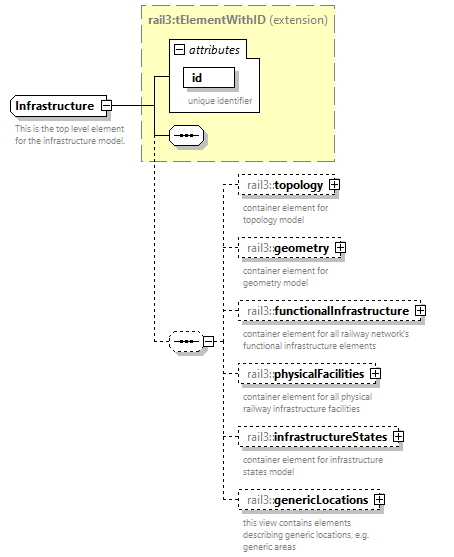 | ||||||||||||||
| namespace | https://www.railml.org/schemas/3.2 | ||||||||||||||
| type | extension of rail3:tElementWithID | ||||||||||||||
| properties |
| ||||||||||||||
| children | rail3:topology rail3:geometry rail3:functionalInfrastructure rail3:physicalFacilities rail3:infrastructureStates rail3:genericLocations | ||||||||||||||
| used by |
| ||||||||||||||
| attributes |
| ||||||||||||||
| annotation |
| ||||||||||||||
| source | <xs:complexType name="Infrastructure"> <xs:annotation> <xs:documentation>This is the top level element for the infrastructure model.</xs:documentation> </xs:annotation> <xs:complexContent> <xs:extension base="rail3:tElementWithID"> <xs:sequence minOccurs="0" maxOccurs="1"> <xs:element name="topology" type="rail3:Topology" minOccurs="0" maxOccurs="1"> <xs:annotation> <xs:documentation>container element for topology model</xs:documentation> </xs:annotation> </xs:element> <xs:element name="geometry" type="rail3:Geometry" minOccurs="0" maxOccurs="1"> <xs:annotation> <xs:documentation>container element for geometry model</xs:documentation> </xs:annotation> </xs:element> <xs:element name="functionalInfrastructure" type="rail3:FunctionalInfrastructure" minOccurs="0" maxOccurs="1"> <xs:annotation> <xs:documentation>container element for all railway network's functional infrastructure elements</xs:documentation> </xs:annotation> </xs:element> <xs:element name="physicalFacilities" type="rail3:PhysicalFacilities" minOccurs="0" maxOccurs="1"> <xs:annotation> <xs:documentation>container element for all physical railway infrastructure facilities</xs:documentation> </xs:annotation> </xs:element> <xs:element name="infrastructureStates" type="rail3:InfrastructureStates" minOccurs="0" maxOccurs="1"> <xs:annotation> <xs:documentation>container element for infrastructure states model</xs:documentation> </xs:annotation> </xs:element> <xs:element name="genericLocations" type="rail3:GenericLocations" minOccurs="0" maxOccurs="1"> <xs:annotation> <xs:documentation>this view contains elements describing generic locations, e.g. generic areas</xs:documentation> </xs:annotation> </xs:element> </xs:sequence> </xs:extension> </xs:complexContent> </xs:complexType> |
element Infrastructure/topology
| diagram | 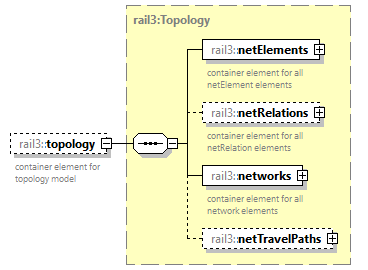 | ||||||
| namespace | https://www.railml.org/schemas/3.2 | ||||||
| type | rail3:Topology | ||||||
| properties |
| ||||||
| children | rail3:netElements rail3:netRelations rail3:networks rail3:netTravelPaths | ||||||
| annotation |
| ||||||
| source | <xs:element name="topology" type="rail3:Topology" minOccurs="0" maxOccurs="1"> <xs:annotation> <xs:documentation>container element for topology model</xs:documentation> </xs:annotation> </xs:element> |
element Infrastructure/geometry
| diagram | 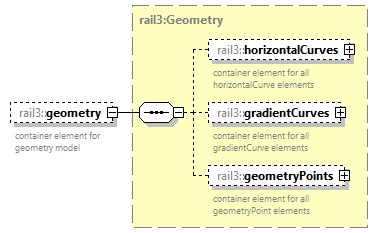 | ||||||
| namespace | https://www.railml.org/schemas/3.2 | ||||||
| type | rail3:Geometry | ||||||
| properties |
| ||||||
| children | rail3:horizontalCurves rail3:gradientCurves rail3:geometryPoints | ||||||
| annotation |
| ||||||
| source | <xs:element name="geometry" type="rail3:Geometry" minOccurs="0" maxOccurs="1"> <xs:annotation> <xs:documentation>container element for geometry model</xs:documentation> </xs:annotation> </xs:element> |
element Infrastructure/functionalInfrastructure
| diagram |  | ||||||
| namespace | https://www.railml.org/schemas/3.2 | ||||||
| type | rail3:FunctionalInfrastructure | ||||||
| properties |
| ||||||
| children | rail3:balises rail3:baliseGroups rail3:borders rail3:bufferStops rail3:crossings rail3:derailersIS rail3:detectors rail3:electrifications rail3:etcsAreas rail3:etcsLevelTransitions rail3:keyLocksIS rail3:levelCrossingsIS rail3:lines rail3:loadingGauges rail3:operationalPoints rail3:overCrossings rail3:platforms rail3:platformEdges rail3:radioBlockCentreBorders rail3:restrictionAreas rail3:serviceSections rail3:signalsIS rail3:speeds rail3:stoppingPlaces rail3:switchesIS rail3:tracks rail3:trackBeds rail3:trackGauges rail3:trainDetectionElements rail3:trainProtectionElements rail3:trainRadios rail3:underCrossings rail3:weightLimits rail3:mileageChanges rail3:tunnelGatesIS | ||||||
| annotation |
| ||||||
| source | <xs:element name="functionalInfrastructure" type="rail3:FunctionalInfrastructure" minOccurs="0" maxOccurs="1"> <xs:annotation> <xs:documentation>container element for all railway network's functional infrastructure elements</xs:documentation> </xs:annotation> </xs:element> |
element Infrastructure/physicalFacilities
| diagram |  | ||||||
| namespace | https://www.railml.org/schemas/3.2 | ||||||
| type | rail3:PhysicalFacilities | ||||||
| properties |
| ||||||
| annotation |
| ||||||
| source | <xs:element name="physicalFacilities" type="rail3:PhysicalFacilities" minOccurs="0" maxOccurs="1"> <xs:annotation> <xs:documentation>container element for all physical railway infrastructure facilities</xs:documentation> </xs:annotation> </xs:element> |
element Infrastructure/infrastructureStates
| diagram |  | ||||||
| namespace | https://www.railml.org/schemas/3.2 | ||||||
| type | rail3:InfrastructureStates | ||||||
| properties |
| ||||||
| children | rail3:infrastructureState | ||||||
| annotation |
| ||||||
| source | <xs:element name="infrastructureStates" type="rail3:InfrastructureStates" minOccurs="0" maxOccurs="1"> <xs:annotation> <xs:documentation>container element for infrastructure states model</xs:documentation> </xs:annotation> </xs:element> |
element Infrastructure/genericLocations
| diagram |  | ||||||
| namespace | https://www.railml.org/schemas/3.2 | ||||||
| type | rail3:GenericLocations | ||||||
| properties |
| ||||||
| children | rail3:genericArea | ||||||
| annotation |
| ||||||
| source | <xs:element name="genericLocations" type="rail3:GenericLocations" minOccurs="0" maxOccurs="1"> <xs:annotation> <xs:documentation>this view contains elements describing generic locations, e.g. generic areas</xs:documentation> </xs:annotation> </xs:element> |
complexType InfrastructureState
| diagram | 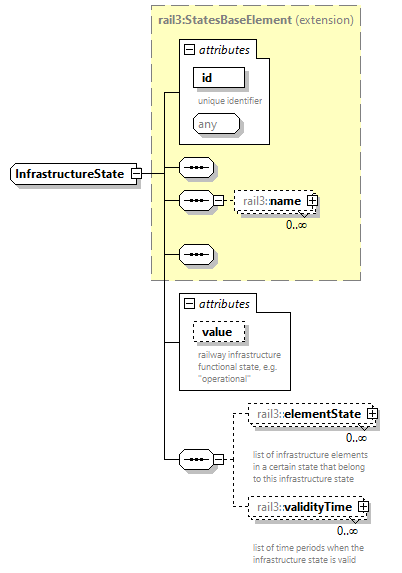 | ||||||||||||||||||||||
| namespace | https://www.railml.org/schemas/3.2 | ||||||||||||||||||||||
| type | extension of rail3:StatesBaseElement | ||||||||||||||||||||||
| properties |
| ||||||||||||||||||||||
| children | rail3:name rail3:elementState rail3:validityTime | ||||||||||||||||||||||
| used by |
| ||||||||||||||||||||||
| attributes |
| ||||||||||||||||||||||
| source | <xs:complexType name="InfrastructureState"> <xs:complexContent> <xs:extension base="rail3:StatesBaseElement"> <xs:sequence> <xs:element name="elementState" type="rail3:ElementState" minOccurs="0" maxOccurs="unbounded"> <xs:annotation> <xs:documentation>list of infrastructure elements in a certain state that belong to this infrastructure state</xs:documentation> </xs:annotation> </xs:element> <xs:element name="validityTime" type="rail3:Period" minOccurs="0" maxOccurs="unbounded"> <xs:annotation> <xs:documentation>list of time periods when the infrastructure state is valid</xs:documentation> </xs:annotation> </xs:element> </xs:sequence> <xs:attribute name="value" type="rail3:tInfrastructureStateExt" use="optional"> <xs:annotation> <xs:documentation>railway infrastructure functional state, e.g. "operational"</xs:documentation> </xs:annotation> </xs:attribute> </xs:extension> </xs:complexContent> </xs:complexType> |
attribute InfrastructureState/@value
| type | rail3:tInfrastructureStateExt | ||
| properties |
| ||
| annotation |
| ||
| source | <xs:attribute name="value" type="rail3:tInfrastructureStateExt" use="optional"> <xs:annotation> <xs:documentation>railway infrastructure functional state, e.g. "operational"</xs:documentation> </xs:annotation> </xs:attribute> |
element InfrastructureState/elementState
| diagram | 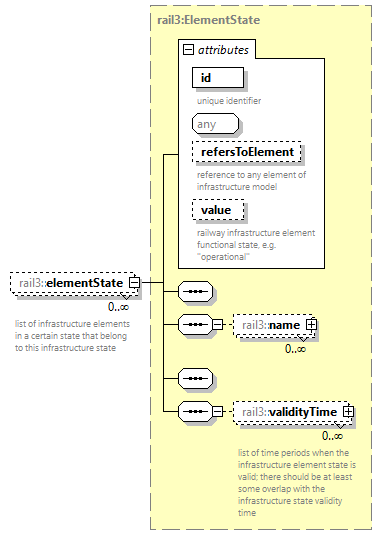 | ||||||||||||||||||||||||||||||
| namespace | https://www.railml.org/schemas/3.2 | ||||||||||||||||||||||||||||||
| type | rail3:ElementState | ||||||||||||||||||||||||||||||
| properties |
| ||||||||||||||||||||||||||||||
| children | rail3:name rail3:validityTime | ||||||||||||||||||||||||||||||
| attributes |
| ||||||||||||||||||||||||||||||
| annotation |
| ||||||||||||||||||||||||||||||
| source | <xs:element name="elementState" type="rail3:ElementState" minOccurs="0" maxOccurs="unbounded"> <xs:annotation> <xs:documentation>list of infrastructure elements in a certain state that belong to this infrastructure state</xs:documentation> </xs:annotation> </xs:element> |
element InfrastructureState/validityTime
| diagram | 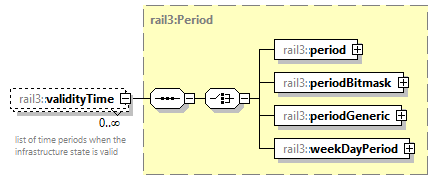 | ||||||
| namespace | https://www.railml.org/schemas/3.2 | ||||||
| type | rail3:Period | ||||||
| properties |
| ||||||
| children | rail3:period rail3:periodBitmask rail3:periodGeneric rail3:weekDayPeriod | ||||||
| annotation |
| ||||||
| source | <xs:element name="validityTime" type="rail3:Period" minOccurs="0" maxOccurs="unbounded"> <xs:annotation> <xs:documentation>list of time periods when the infrastructure state is valid</xs:documentation> </xs:annotation> </xs:element> |
complexType InfrastructureStates
| diagram |  | ||
| namespace | https://www.railml.org/schemas/3.2 | ||
| children | rail3:infrastructureState | ||
| used by |
| ||
| source | <xs:complexType name="InfrastructureStates"> <xs:sequence> <xs:element name="infrastructureState" type="rail3:InfrastructureState" minOccurs="1" maxOccurs="unbounded"> <xs:annotation> <xs:documentation>state of (a part of) the functional infrastructure regarding its availability and usability</xs:documentation> </xs:annotation> </xs:element> </xs:sequence> </xs:complexType> |
element InfrastructureStates/infrastructureState
| diagram | 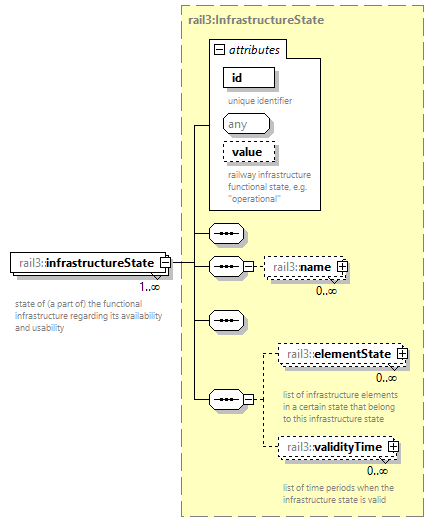 | ||||||||||||||||||||||
| namespace | https://www.railml.org/schemas/3.2 | ||||||||||||||||||||||
| type | rail3:InfrastructureState | ||||||||||||||||||||||
| properties |
| ||||||||||||||||||||||
| children | rail3:name rail3:elementState rail3:validityTime | ||||||||||||||||||||||
| attributes |
| ||||||||||||||||||||||
| annotation |
| ||||||||||||||||||||||
| source | <xs:element name="infrastructureState" type="rail3:InfrastructureState" minOccurs="1" maxOccurs="unbounded"> <xs:annotation> <xs:documentation>state of (a part of) the functional infrastructure regarding its availability and usability</xs:documentation> </xs:annotation> </xs:element> |
complexType KeyLockIS
| diagram | 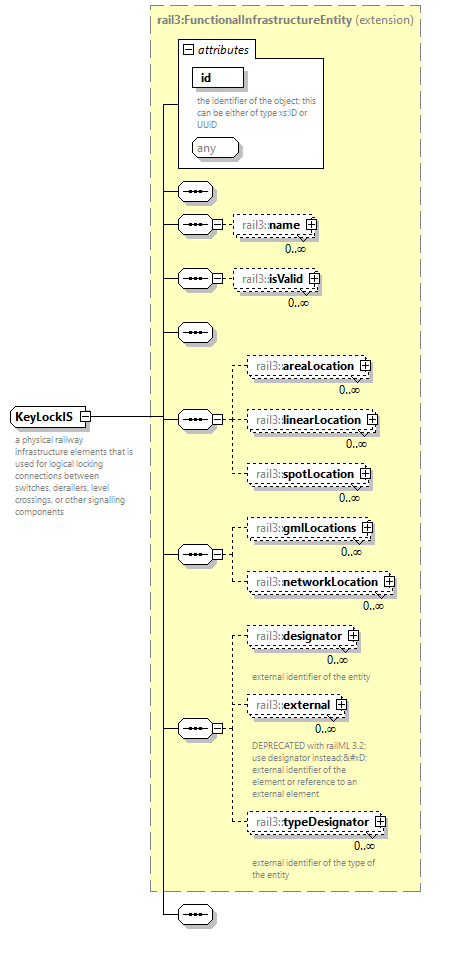 | ||||||||||||||
| namespace | https://www.railml.org/schemas/3.2 | ||||||||||||||
| type | extension of rail3:FunctionalInfrastructureEntity | ||||||||||||||
| properties |
| ||||||||||||||
| children | rail3:name rail3:isValid rail3:areaLocation rail3:linearLocation rail3:spotLocation rail3:gmlLocations rail3:networkLocation rail3:designator rail3:external rail3:typeDesignator | ||||||||||||||
| used by |
| ||||||||||||||
| attributes |
| ||||||||||||||
| annotation |
| ||||||||||||||
| source | <xs:complexType name="KeyLockIS"> <xs:annotation> <xs:documentation>a physical railway infrastructure elements that is used for logical locking connections between switches, derailers, level crossings, or other signalling components</xs:documentation> </xs:annotation> <xs:complexContent> <xs:extension base="rail3:FunctionalInfrastructureEntity"> <xs:sequence/> </xs:extension> </xs:complexContent> </xs:complexType> |
complexType KeyLocksIS
| diagram | 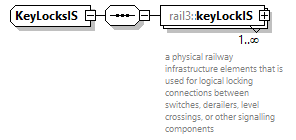 | ||
| namespace | https://www.railml.org/schemas/3.2 | ||
| children | rail3:keyLockIS | ||
| used by |
| ||
| source | <xs:complexType name="KeyLocksIS"> <xs:sequence> <xs:element name="keyLockIS" type="rail3:KeyLockIS" minOccurs="1" maxOccurs="unbounded"> <xs:annotation> <xs:documentation>a physical railway infrastructure elements that is used for logical locking connections between switches, derailers, level crossings, or other signalling components</xs:documentation> </xs:annotation> </xs:element> </xs:sequence> </xs:complexType> |
element KeyLocksIS/keyLockIS
| diagram | 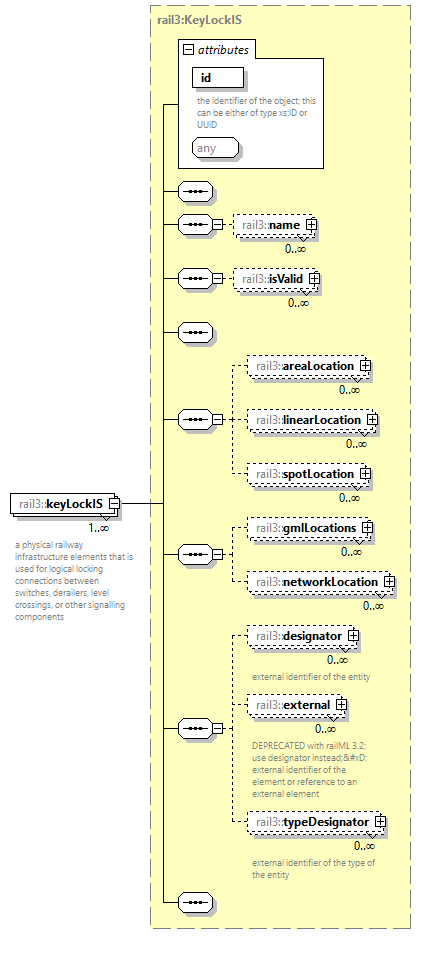 | ||||||||||||||
| namespace | https://www.railml.org/schemas/3.2 | ||||||||||||||
| type | rail3:KeyLockIS | ||||||||||||||
| properties |
| ||||||||||||||
| children | rail3:name rail3:isValid rail3:areaLocation rail3:linearLocation rail3:spotLocation rail3:gmlLocations rail3:networkLocation rail3:designator rail3:external rail3:typeDesignator | ||||||||||||||
| attributes |
| ||||||||||||||
| annotation |
| ||||||||||||||
| source | <xs:element name="keyLockIS" type="rail3:KeyLockIS" minOccurs="1" maxOccurs="unbounded"> <xs:annotation> <xs:documentation>a physical railway infrastructure elements that is used for logical locking connections between switches, derailers, level crossings, or other signalling components</xs:documentation> </xs:annotation> </xs:element> |
complexType Length
| diagram | 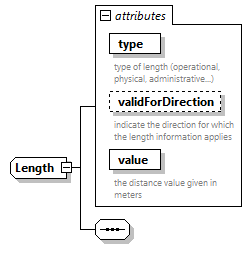 | ||||||||||||||||||||||||||||||
| namespace | https://www.railml.org/schemas/3.2 | ||||||||||||||||||||||||||||||
| used by |
| ||||||||||||||||||||||||||||||
| attributes |
| ||||||||||||||||||||||||||||||
| source | <xs:complexType name="Length"> <xs:sequence/> <xs:attribute name="type" type="rail3:tLengthTypeExt" use="required"> <xs:annotation> <xs:documentation>type of length (operational, physical, administrative...)</xs:documentation> </xs:annotation> </xs:attribute> <xs:attribute name="validForDirection" type="rail3:tExtendedDirection" use="optional"> <xs:annotation> <xs:documentation>indicate the direction for which the length information applies</xs:documentation> </xs:annotation> </xs:attribute> <xs:attribute name="value" type="rail3:tLengthM" use="required"> <xs:annotation> <xs:documentation>the distance value given in meters</xs:documentation> </xs:annotation> </xs:attribute> </xs:complexType> |
attribute Length/@type
| type | rail3:tLengthTypeExt | ||
| properties |
| ||
| annotation |
| ||
| source | <xs:attribute name="type" type="rail3:tLengthTypeExt" use="required"> <xs:annotation> <xs:documentation>type of length (operational, physical, administrative...)</xs:documentation> </xs:annotation> </xs:attribute> |
attribute Length/@validForDirection
| type | rail3:tExtendedDirection | ||||||||||||
| properties |
| ||||||||||||
| facets |
| ||||||||||||
| annotation |
| ||||||||||||
| source | <xs:attribute name="validForDirection" type="rail3:tExtendedDirection" use="optional"> <xs:annotation> <xs:documentation>indicate the direction for which the length information applies</xs:documentation> </xs:annotation> </xs:attribute> |
attribute Length/@value
| type | rail3:tLengthM | ||
| properties |
| ||
| annotation |
| ||
| source | <xs:attribute name="value" type="rail3:tLengthM" use="required"> <xs:annotation> <xs:documentation>the distance value given in meters</xs:documentation> </xs:annotation> </xs:attribute> |
complexType LevelCrossingEtcs
| diagram | 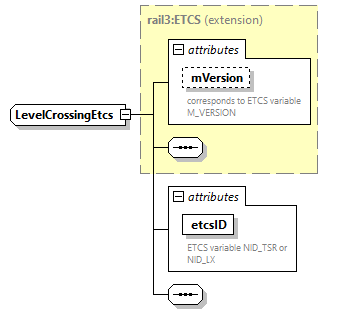 | ||||||||||||||||||||||
| namespace | https://www.railml.org/schemas/3.2 | ||||||||||||||||||||||
| type | extension of rail3:ETCS | ||||||||||||||||||||||
| properties |
| ||||||||||||||||||||||
| used by |
| ||||||||||||||||||||||
| attributes |
| ||||||||||||||||||||||
| source | <xs:complexType name="LevelCrossingEtcs"> <xs:complexContent> <xs:extension base="rail3:ETCS"> <xs:sequence/> <xs:attribute name="etcsID" type="xs:nonNegativeInteger" use="required"> <xs:annotation> <xs:documentation>ETCS variable NID_TSR or NID_LX</xs:documentation> </xs:annotation> </xs:attribute> </xs:extension> </xs:complexContent> </xs:complexType> |
attribute LevelCrossingEtcs/@etcsID
| type | xs:nonNegativeInteger | ||
| properties |
| ||
| annotation |
| ||
| source | <xs:attribute name="etcsID" type="xs:nonNegativeInteger" use="required"> <xs:annotation> <xs:documentation>ETCS variable NID_TSR or NID_LX</xs:documentation> </xs:annotation> </xs:attribute> |
complexType LevelCrossingIS
| diagram |  | ||||||||||||||||||||||||||||||||||||||||||||||||||||||||||||||||||||||
| namespace | https://www.railml.org/schemas/3.2 | ||||||||||||||||||||||||||||||||||||||||||||||||||||||||||||||||||||||
| type | extension of rail3:XCrossing | ||||||||||||||||||||||||||||||||||||||||||||||||||||||||||||||||||||||
| properties |
| ||||||||||||||||||||||||||||||||||||||||||||||||||||||||||||||||||||||
| children | rail3:name rail3:isValid rail3:areaLocation rail3:linearLocation rail3:spotLocation rail3:gmlLocations rail3:networkLocation rail3:designator rail3:external rail3:typeDesignator rail3:crossesElement rail3:etcsLevelCrossing rail3:linkedSpeedSection rail3:protection | ||||||||||||||||||||||||||||||||||||||||||||||||||||||||||||||||||||||
| used by |
| ||||||||||||||||||||||||||||||||||||||||||||||||||||||||||||||||||||||
| attributes |
| ||||||||||||||||||||||||||||||||||||||||||||||||||||||||||||||||||||||
| source | <xs:complexType name="LevelCrossingIS"> <xs:complexContent> <xs:extension base="rail3:XCrossing"> <xs:sequence> <xs:element name="etcsLevelCrossing" type="rail3:LevelCrossingEtcs" minOccurs="0" maxOccurs="1"> <xs:annotation> <xs:documentation>container element for all ETCS related information of a level crossing</xs:documentation> </xs:annotation> </xs:element> <xs:element name="linkedSpeedSection" type="rail3:tElementWithIDref" minOccurs="0" maxOccurs="unbounded"> <xs:annotation> <xs:documentation>reference to a speed section that defines the allowed passing speed when LX is in unprotected mode</xs:documentation> </xs:annotation> </xs:element> <xs:element name="protection" type="rail3:LevelCrossingProtection" minOccurs="0" maxOccurs="1"> <xs:annotation> <xs:documentation>summary of technical protection of the level crossing</xs:documentation> </xs:annotation> </xs:element> </xs:sequence> <xs:attribute name="activation" type="rail3:tLevelCrossingActivation" use="optional"> <xs:annotation> <xs:documentation>describes how the level crossing is being activated;
 missing attribute means that the information is not known</xs:documentation> </xs:annotation> </xs:attribute> <xs:attribute name="basedOnTemplate" type="rail3:tRef" use="optional"> <xs:annotation> <xs:documentation>reference to a template level crossing</xs:documentation> </xs:annotation> </xs:attribute> <xs:attribute name="belongsToParent" type="rail3:tRef" use="optional"> <xs:annotation> <xs:documentation>reference to the (one and only) parent level crossing
 
 - if some information exists in parent and child, then information in child overwrites it in child
 
 - if some information exists only in parent, then child inherits this information from parent</xs:documentation> </xs:annotation> </xs:attribute> <xs:attribute name="lengthOfStoppingAreaBeforeLevelCrossing" type="rail3:tLengthM" use="optional"> <xs:annotation> <xs:documentation>distance between the stopping point in front of a level crossing and the level crossing itself, in meters</xs:documentation> </xs:annotation> </xs:attribute> <xs:attribute name="obstacleDetection" type="rail3:tLevelCrossingObstacleDetection" use="optional"> <xs:annotation> <xs:documentation>obstacle detection: automatic (technical system, e.g. radar) or manual (e.g. by operator);
 missing attribute means that the information is not known</xs:documentation> </xs:annotation> </xs:attribute> <xs:attribute name="opensOnDemand" type="xs:boolean" use="optional"> <xs:annotation> <xs:documentation>set TRUE if the level crossing is closed for road users by default and gates are only opened on demand;
 missing attribute means that the information is not known</xs:documentation> </xs:annotation> </xs:attribute> <xs:attribute name="supervision" type="rail3:tLevelCrossingSupervision" use="optional"> <xs:annotation> <xs:documentation>describes how the state of the level crossing is being supervised;
 missing attribute means that the information is not known</xs:documentation> </xs:annotation> </xs:attribute> </xs:extension> </xs:complexContent> </xs:complexType> |
attribute LevelCrossingIS/@activation
| type | rail3:tLevelCrossingActivation | ||||||||||||||||||||||||||||
| properties |
| ||||||||||||||||||||||||||||
| facets |
| ||||||||||||||||||||||||||||
| annotation |
| ||||||||||||||||||||||||||||
| source | <xs:attribute name="activation" type="rail3:tLevelCrossingActivation" use="optional"> <xs:annotation> <xs:documentation>describes how the level crossing is being activated;
 missing attribute means that the information is not known</xs:documentation> </xs:annotation> </xs:attribute> |
attribute LevelCrossingIS/@basedOnTemplate
| type | rail3:tRef | ||
| properties |
| ||
| annotation |
| ||
| source | <xs:attribute name="basedOnTemplate" type="rail3:tRef" use="optional"> <xs:annotation> <xs:documentation>reference to a template level crossing</xs:documentation> </xs:annotation> </xs:attribute> |
attribute LevelCrossingIS/@belongsToParent
| type | rail3:tRef | ||
| properties |
| ||
| annotation |
| ||
| source | <xs:attribute name="belongsToParent" type="rail3:tRef" use="optional"> <xs:annotation> <xs:documentation>reference to the (one and only) parent level crossing
 
 - if some information exists in parent and child, then information in child overwrites it in child
 
 - if some information exists only in parent, then child inherits this information from parent</xs:documentation> </xs:annotation> </xs:attribute> |
attribute LevelCrossingIS/@lengthOfStoppingAreaBeforeLevelCrossing
| type | rail3:tLengthM | ||
| properties |
| ||
| annotation |
| ||
| source | <xs:attribute name="lengthOfStoppingAreaBeforeLevelCrossing" type="rail3:tLengthM" use="optional"> <xs:annotation> <xs:documentation>distance between the stopping point in front of a level crossing and the level crossing itself, in meters</xs:documentation> </xs:annotation> </xs:attribute> |
attribute LevelCrossingIS/@obstacleDetection
| type | rail3:tLevelCrossingObstacleDetection | ||||||||||||||||||
| properties |
| ||||||||||||||||||
| facets |
| ||||||||||||||||||
| annotation |
| ||||||||||||||||||
| source | <xs:attribute name="obstacleDetection" type="rail3:tLevelCrossingObstacleDetection" use="optional"> <xs:annotation> <xs:documentation>obstacle detection: automatic (technical system, e.g. radar) or manual (e.g. by operator);
 missing attribute means that the information is not known</xs:documentation> </xs:annotation> </xs:attribute> |
attribute LevelCrossingIS/@opensOnDemand
| type | xs:boolean | ||
| properties |
| ||
| annotation |
| ||
| source | <xs:attribute name="opensOnDemand" type="xs:boolean" use="optional"> <xs:annotation> <xs:documentation>set TRUE if the level crossing is closed for road users by default and gates are only opened on demand;
 missing attribute means that the information is not known</xs:documentation> </xs:annotation> </xs:attribute> |
attribute LevelCrossingIS/@supervision
| type | rail3:tLevelCrossingSupervision | |||||||||||||||||||||||
| properties |
| |||||||||||||||||||||||
| facets |
| |||||||||||||||||||||||
| annotation |
| |||||||||||||||||||||||
| source | <xs:attribute name="supervision" type="rail3:tLevelCrossingSupervision" use="optional"> <xs:annotation> <xs:documentation>describes how the state of the level crossing is being supervised;
 missing attribute means that the information is not known</xs:documentation> </xs:annotation> </xs:attribute> |
element LevelCrossingIS/etcsLevelCrossing
| diagram | 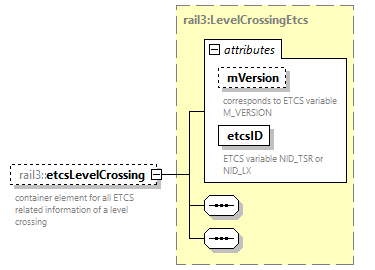 | ||||||||||||||||||||||
| namespace | https://www.railml.org/schemas/3.2 | ||||||||||||||||||||||
| type | rail3:LevelCrossingEtcs | ||||||||||||||||||||||
| properties |
| ||||||||||||||||||||||
| attributes |
| ||||||||||||||||||||||
| annotation |
| ||||||||||||||||||||||
| source | <xs:element name="etcsLevelCrossing" type="rail3:LevelCrossingEtcs" minOccurs="0" maxOccurs="1"> <xs:annotation> <xs:documentation>container element for all ETCS related information of a level crossing</xs:documentation> </xs:annotation> </xs:element> |
element LevelCrossingIS/linkedSpeedSection
| diagram | 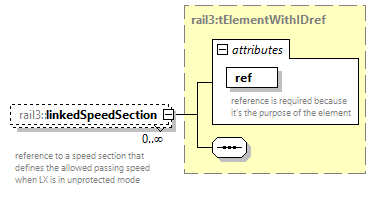 | ||||||||||||||
| namespace | https://www.railml.org/schemas/3.2 | ||||||||||||||
| type | rail3:tElementWithIDref | ||||||||||||||
| properties |
| ||||||||||||||
| attributes |
| ||||||||||||||
| annotation |
| ||||||||||||||
| source | <xs:element name="linkedSpeedSection" type="rail3:tElementWithIDref" minOccurs="0" maxOccurs="unbounded"> <xs:annotation> <xs:documentation>reference to a speed section that defines the allowed passing speed when LX is in unprotected mode</xs:documentation> </xs:annotation> </xs:element> |
element LevelCrossingIS/protection
| diagram | 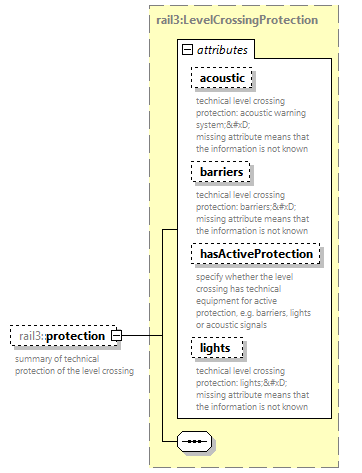 | ||||||||||||||||||||||||||||||||||||||
| namespace | https://www.railml.org/schemas/3.2 | ||||||||||||||||||||||||||||||||||||||
| type | rail3:LevelCrossingProtection | ||||||||||||||||||||||||||||||||||||||
| properties |
| ||||||||||||||||||||||||||||||||||||||
| attributes |
| ||||||||||||||||||||||||||||||||||||||
| annotation |
| ||||||||||||||||||||||||||||||||||||||
| source | <xs:element name="protection" type="rail3:LevelCrossingProtection" minOccurs="0" maxOccurs="1"> <xs:annotation> <xs:documentation>summary of technical protection of the level crossing</xs:documentation> </xs:annotation> </xs:element> |
complexType LevelCrossingProtection
| diagram | 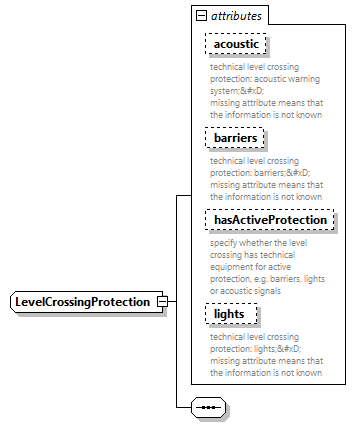 | ||||||||||||||||||||||||||||||||||||||
| namespace | https://www.railml.org/schemas/3.2 | ||||||||||||||||||||||||||||||||||||||
| used by |
| ||||||||||||||||||||||||||||||||||||||
| attributes |
| ||||||||||||||||||||||||||||||||||||||
| source | <xs:complexType name="LevelCrossingProtection"> <xs:sequence/> <xs:attribute name="acoustic" type="rail3:tLevelCrossingProtectionAcousticExt" use="optional"> <xs:annotation> <xs:documentation>technical level crossing protection: acoustic warning system;
 missing attribute means that the information is not known</xs:documentation> </xs:annotation> </xs:attribute> <xs:attribute name="barriers" type="rail3:tLevelCrossingProtectionBarrierExt" use="optional"> <xs:annotation> <xs:documentation>technical level crossing protection: barriers;
 missing attribute means that the information is not known</xs:documentation> </xs:annotation> </xs:attribute> <xs:attribute name="hasActiveProtection" type="xs:boolean" use="optional"> <xs:annotation> <xs:documentation>specify whether the level crossing has technical equipment for active protection, e.g. barriers, lights or acoustic signals</xs:documentation> </xs:annotation> </xs:attribute> <xs:attribute name="lights" type="rail3:tLevelCrossingProtectionLightsExt" use="optional"> <xs:annotation> <xs:documentation>technical level crossing protection: lights;
 missing attribute means that the information is not known</xs:documentation> </xs:annotation> </xs:attribute> </xs:complexType> |
attribute LevelCrossingProtection/@acoustic
| type | rail3:tLevelCrossingProtectionAcousticExt | ||
| properties |
| ||
| annotation |
| ||
| source | <xs:attribute name="acoustic" type="rail3:tLevelCrossingProtectionAcousticExt" use="optional"> <xs:annotation> <xs:documentation>technical level crossing protection: acoustic warning system;
 missing attribute means that the information is not known</xs:documentation> </xs:annotation> </xs:attribute> |
attribute LevelCrossingProtection/@barriers
| type | rail3:tLevelCrossingProtectionBarrierExt | ||
| properties |
| ||
| annotation |
| ||
| source | <xs:attribute name="barriers" type="rail3:tLevelCrossingProtectionBarrierExt" use="optional"> <xs:annotation> <xs:documentation>technical level crossing protection: barriers;
 missing attribute means that the information is not known</xs:documentation> </xs:annotation> </xs:attribute> |
attribute LevelCrossingProtection/@hasActiveProtection
| type | xs:boolean | ||
| properties |
| ||
| annotation |
| ||
| source | <xs:attribute name="hasActiveProtection" type="xs:boolean" use="optional"> <xs:annotation> <xs:documentation>specify whether the level crossing has technical equipment for active protection, e.g. barriers, lights or acoustic signals</xs:documentation> </xs:annotation> </xs:attribute> |
attribute LevelCrossingProtection/@lights
| type | rail3:tLevelCrossingProtectionLightsExt | ||
| properties |
| ||
| annotation |
| ||
| source | <xs:attribute name="lights" type="rail3:tLevelCrossingProtectionLightsExt" use="optional"> <xs:annotation> <xs:documentation>technical level crossing protection: lights;
 missing attribute means that the information is not known</xs:documentation> </xs:annotation> </xs:attribute> |
complexType LevelCrossingsIS
| diagram |  | ||
| namespace | https://www.railml.org/schemas/3.2 | ||
| children | rail3:levelCrossingIS | ||
| used by |
| ||
| source | <xs:complexType name="LevelCrossingsIS"> <xs:sequence> <xs:element name="levelCrossingIS" type="rail3:LevelCrossingIS" minOccurs="1" maxOccurs="unbounded"> <xs:annotation> <xs:documentation>Allows specifying intersections where a railway line crosses a road or a path at the same level</xs:documentation> </xs:annotation> </xs:element> </xs:sequence> </xs:complexType> |
element LevelCrossingsIS/levelCrossingIS
| diagram |  | ||||||||||||||||||||||||||||||||||||||||||||||||||||||||||||||||||||||
| namespace | https://www.railml.org/schemas/3.2 | ||||||||||||||||||||||||||||||||||||||||||||||||||||||||||||||||||||||
| type | rail3:LevelCrossingIS | ||||||||||||||||||||||||||||||||||||||||||||||||||||||||||||||||||||||
| properties |
| ||||||||||||||||||||||||||||||||||||||||||||||||||||||||||||||||||||||
| children | rail3:name rail3:isValid rail3:areaLocation rail3:linearLocation rail3:spotLocation rail3:gmlLocations rail3:networkLocation rail3:designator rail3:external rail3:typeDesignator rail3:crossesElement rail3:etcsLevelCrossing rail3:linkedSpeedSection rail3:protection | ||||||||||||||||||||||||||||||||||||||||||||||||||||||||||||||||||||||
| attributes |
| ||||||||||||||||||||||||||||||||||||||||||||||||||||||||||||||||||||||
| annotation |
| ||||||||||||||||||||||||||||||||||||||||||||||||||||||||||||||||||||||
| source | <xs:element name="levelCrossingIS" type="rail3:LevelCrossingIS" minOccurs="1" maxOccurs="unbounded"> <xs:annotation> <xs:documentation>Allows specifying intersections where a railway line crosses a road or a path at the same level</xs:documentation> </xs:annotation> </xs:element> |
complexType Line
| diagram |  | ||||||||||||||||||||||||||||||||||||||||||||||||||||||
| namespace | https://www.railml.org/schemas/3.2 | ||||||||||||||||||||||||||||||||||||||||||||||||||||||
| type | extension of rail3:FunctionalInfrastructureEntity | ||||||||||||||||||||||||||||||||||||||||||||||||||||||
| properties |
| ||||||||||||||||||||||||||||||||||||||||||||||||||||||
| children | rail3:name rail3:isValid rail3:areaLocation rail3:linearLocation rail3:spotLocation rail3:gmlLocations rail3:networkLocation rail3:designator rail3:external rail3:typeDesignator rail3:beginsInOP rail3:endsInOP rail3:length rail3:lineTrafficCode rail3:lineCombinedTransportCode rail3:lineLayout rail3:linePerformance rail3:lineOperation | ||||||||||||||||||||||||||||||||||||||||||||||||||||||
| used by |
| ||||||||||||||||||||||||||||||||||||||||||||||||||||||
| attributes |
| ||||||||||||||||||||||||||||||||||||||||||||||||||||||
| annotation |
| ||||||||||||||||||||||||||||||||||||||||||||||||||||||
| source | <xs:complexType name="Line"> <xs:annotation> <xs:documentation>A line is a sequence of one or more line sections forming a route, which connects operational points and which may consist of several tracks used for regular railway operation.</xs:documentation> </xs:annotation> <xs:complexContent> <xs:extension base="rail3:FunctionalInfrastructureEntity"> <xs:sequence> <xs:element name="beginsInOP" type="rail3:tElementWithIDref" minOccurs="0" maxOccurs="1"> <xs:annotation> <xs:documentation>reference to the operational point where the line (section) begins</xs:documentation> </xs:annotation> </xs:element> <xs:element name="endsInOP" type="rail3:tElementWithIDref" minOccurs="0" maxOccurs="1"> <xs:annotation> <xs:documentation>reference to the operational point where the line (section) ends</xs:documentation> </xs:annotation> </xs:element> <xs:element name="length" type="rail3:Length" minOccurs="0" maxOccurs="unbounded"> <xs:annotation> <xs:documentation>length of the line (section)</xs:documentation> </xs:annotation> </xs:element> <xs:element name="lineTrafficCode" type="rail3:LineTrafficCode" minOccurs="0" maxOccurs="unbounded"> <xs:annotation> <xs:documentation>TSI category of line as defined in TSI INF section 4.2.1; There should be one code for each type of traffic (passenger, freight) allowed on that line</xs:documentation> </xs:annotation> </xs:element> <xs:element name="lineCombinedTransportCode" type="rail3:LineCombinedTransportCode" minOccurs="0" maxOccurs="unbounded"> <xs:annotation> <xs:documentation>standard combined transport profile number as defined in UIC Code 596-6</xs:documentation> </xs:annotation> </xs:element> <xs:element name="lineLayout" type="rail3:LineLayout" minOccurs="0" maxOccurs="1"> <xs:annotation> <xs:documentation>child element summarizing the line layout parameters</xs:documentation> </xs:annotation> </xs:element> <xs:element name="linePerformance" type="rail3:LinePerformance" minOccurs="0" maxOccurs="1"> <xs:annotation> <xs:documentation>child element summarizing the line performance parameters</xs:documentation> </xs:annotation> </xs:element> <xs:element name="lineOperation" type="rail3:LineOperation" minOccurs="0" maxOccurs="1"> <xs:annotation> <xs:documentation>Allows describing the mode of operation for the line </xs:documentation> </xs:annotation> </xs:element> </xs:sequence> <xs:attribute name="basedOnTemplate" type="rail3:tRef" use="optional"> <xs:annotation> <xs:documentation>reference to a generic line (section)</xs:documentation> </xs:annotation> </xs:attribute> <xs:attribute name="belongsToParent" type="rail3:tRef" use="optional"> <xs:annotation> <xs:documentation>reference to the (one and only) parent line (section)
 
 - if some information exists in parent and child, then information in child overwrites it in child
 
 - if some information exists only in parent, then child inherits this information from parent</xs:documentation> </xs:annotation> </xs:attribute> <xs:attribute name="infrastructureManagerRef" type="rail3:tRef" use="optional"> <xs:annotation> <xs:documentation>reference to the infrastructure manager who owns the line (section) (see common/organizationalUnits)</xs:documentation> </xs:annotation> </xs:attribute> <xs:attribute name="lineCategory" type="rail3:tLineCategoryExt" use="optional"> <xs:annotation> <xs:documentation>the category of the line according to the EU regulation EN 15528 (A, B1, B2, C2, ..., E5; other national values are also possible)</xs:documentation> </xs:annotation> </xs:attribute> <xs:attribute name="lineType" type="rail3:tLineType" use="optional"> <xs:annotation> <xs:documentation>this attribute is for distinguishing between main line and branch lines</xs:documentation> </xs:annotation> </xs:attribute> </xs:extension> </xs:complexContent> </xs:complexType> |
attribute Line/@basedOnTemplate
| type | rail3:tRef | ||
| properties |
| ||
| annotation |
| ||
| source | <xs:attribute name="basedOnTemplate" type="rail3:tRef" use="optional"> <xs:annotation> <xs:documentation>reference to a generic line (section)</xs:documentation> </xs:annotation> </xs:attribute> |
attribute Line/@belongsToParent
| type | rail3:tRef | ||
| properties |
| ||
| annotation |
| ||
| source | <xs:attribute name="belongsToParent" type="rail3:tRef" use="optional"> <xs:annotation> <xs:documentation>reference to the (one and only) parent line (section)
 
 - if some information exists in parent and child, then information in child overwrites it in child
 
 - if some information exists only in parent, then child inherits this information from parent</xs:documentation> </xs:annotation> </xs:attribute> |
attribute Line/@infrastructureManagerRef
| type | rail3:tRef | ||
| properties |
| ||
| annotation |
| ||
| source | <xs:attribute name="infrastructureManagerRef" type="rail3:tRef" use="optional"> <xs:annotation> <xs:documentation>reference to the infrastructure manager who owns the line (section) (see common/organizationalUnits)</xs:documentation> </xs:annotation> </xs:attribute> |
attribute Line/@lineCategory
| type | rail3:tLineCategoryExt | ||
| properties |
| ||
| annotation |
| ||
| source | <xs:attribute name="lineCategory" type="rail3:tLineCategoryExt" use="optional"> <xs:annotation> <xs:documentation>the category of the line according to the EU regulation EN 15528 (A, B1, B2, C2, ..., E5; other national values are also possible)</xs:documentation> </xs:annotation> </xs:attribute> |
attribute Line/@lineType
| type | rail3:tLineType | |||||||||||||
| properties |
| |||||||||||||
| facets |
| |||||||||||||
| annotation |
| |||||||||||||
| source | <xs:attribute name="lineType" type="rail3:tLineType" use="optional"> <xs:annotation> <xs:documentation>this attribute is for distinguishing between main line and branch lines</xs:documentation> </xs:annotation> </xs:attribute> |
element Line/beginsInOP
| diagram | 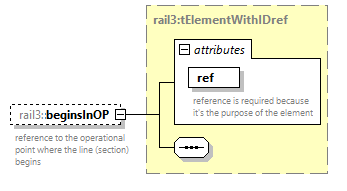 | ||||||||||||||
| namespace | https://www.railml.org/schemas/3.2 | ||||||||||||||
| type | rail3:tElementWithIDref | ||||||||||||||
| properties |
| ||||||||||||||
| attributes |
| ||||||||||||||
| annotation |
| ||||||||||||||
| source | <xs:element name="beginsInOP" type="rail3:tElementWithIDref" minOccurs="0" maxOccurs="1"> <xs:annotation> <xs:documentation>reference to the operational point where the line (section) begins</xs:documentation> </xs:annotation> </xs:element> |
element Line/endsInOP
| diagram | 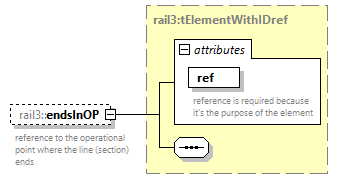 | ||||||||||||||
| namespace | https://www.railml.org/schemas/3.2 | ||||||||||||||
| type | rail3:tElementWithIDref | ||||||||||||||
| properties |
| ||||||||||||||
| attributes |
| ||||||||||||||
| annotation |
| ||||||||||||||
| source | <xs:element name="endsInOP" type="rail3:tElementWithIDref" minOccurs="0" maxOccurs="1"> <xs:annotation> <xs:documentation>reference to the operational point where the line (section) ends</xs:documentation> </xs:annotation> </xs:element> |
element Line/length
| diagram | 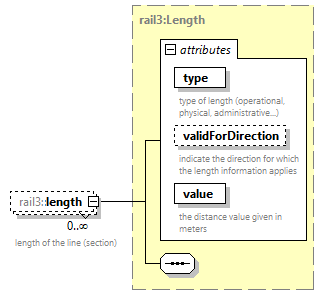 | ||||||||||||||||||||||||||||||
| namespace | https://www.railml.org/schemas/3.2 | ||||||||||||||||||||||||||||||
| type | rail3:Length | ||||||||||||||||||||||||||||||
| properties |
| ||||||||||||||||||||||||||||||
| attributes |
| ||||||||||||||||||||||||||||||
| annotation |
| ||||||||||||||||||||||||||||||
| source | <xs:element name="length" type="rail3:Length" minOccurs="0" maxOccurs="unbounded"> <xs:annotation> <xs:documentation>length of the line (section)</xs:documentation> </xs:annotation> </xs:element> |
element Line/lineTrafficCode
| diagram | 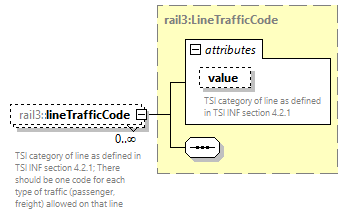 | ||||||||||||||
| namespace | https://www.railml.org/schemas/3.2 | ||||||||||||||
| type | rail3:LineTrafficCode | ||||||||||||||
| properties |
| ||||||||||||||
| attributes |
| ||||||||||||||
| annotation |
| ||||||||||||||
| source | <xs:element name="lineTrafficCode" type="rail3:LineTrafficCode" minOccurs="0" maxOccurs="unbounded"> <xs:annotation> <xs:documentation>TSI category of line as defined in TSI INF section 4.2.1; There should be one code for each type of traffic (passenger, freight) allowed on that line</xs:documentation> </xs:annotation> </xs:element> |
element Line/lineCombinedTransportCode
| diagram | 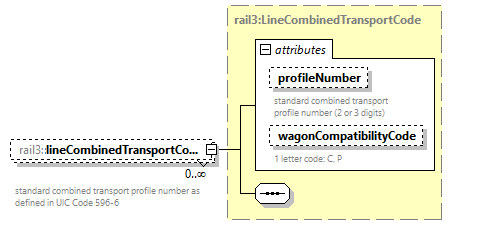 | ||||||||||||||||||||||
| namespace | https://www.railml.org/schemas/3.2 | ||||||||||||||||||||||
| type | rail3:LineCombinedTransportCode | ||||||||||||||||||||||
| properties |
| ||||||||||||||||||||||
| attributes |
| ||||||||||||||||||||||
| annotation |
| ||||||||||||||||||||||
| source | <xs:element name="lineCombinedTransportCode" type="rail3:LineCombinedTransportCode" minOccurs="0" maxOccurs="unbounded"> <xs:annotation> <xs:documentation>standard combined transport profile number as defined in UIC Code 596-6</xs:documentation> </xs:annotation> </xs:element> |
element Line/lineLayout
| diagram | 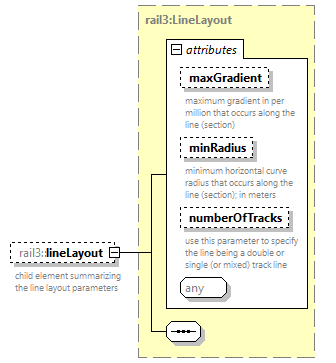 | ||||||||||||||||||||||||||||||
| namespace | https://www.railml.org/schemas/3.2 | ||||||||||||||||||||||||||||||
| type | rail3:LineLayout | ||||||||||||||||||||||||||||||
| properties |
| ||||||||||||||||||||||||||||||
| attributes |
| ||||||||||||||||||||||||||||||
| annotation |
| ||||||||||||||||||||||||||||||
| source | <xs:element name="lineLayout" type="rail3:LineLayout" minOccurs="0" maxOccurs="1"> <xs:annotation> <xs:documentation>child element summarizing the line layout parameters</xs:documentation> </xs:annotation> </xs:element> |
element Line/linePerformance
| diagram | 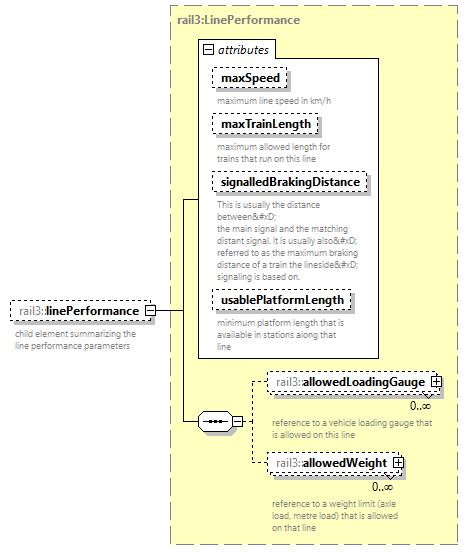 | ||||||||||||||||||||||||||||||||||||||
| namespace | https://www.railml.org/schemas/3.2 | ||||||||||||||||||||||||||||||||||||||
| type | rail3:LinePerformance | ||||||||||||||||||||||||||||||||||||||
| properties |
| ||||||||||||||||||||||||||||||||||||||
| children | rail3:allowedLoadingGauge rail3:allowedWeight | ||||||||||||||||||||||||||||||||||||||
| attributes |
| ||||||||||||||||||||||||||||||||||||||
| annotation |
| ||||||||||||||||||||||||||||||||||||||
| source | <xs:element name="linePerformance" type="rail3:LinePerformance" minOccurs="0" maxOccurs="1"> <xs:annotation> <xs:documentation>child element summarizing the line performance parameters</xs:documentation> </xs:annotation> </xs:element> |
element Line/lineOperation
| diagram | 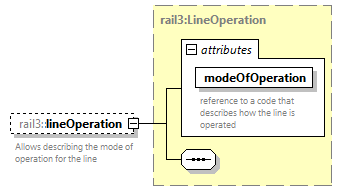 | ||||||||||||||
| namespace | https://www.railml.org/schemas/3.2 | ||||||||||||||
| type | rail3:LineOperation | ||||||||||||||
| properties |
| ||||||||||||||
| attributes |
| ||||||||||||||
| annotation |
| ||||||||||||||
| source | <xs:element name="lineOperation" type="rail3:LineOperation" minOccurs="0" maxOccurs="1"> <xs:annotation> <xs:documentation>Allows describing the mode of operation for the line </xs:documentation> </xs:annotation> </xs:element> |
complexType LineCombinedTransportCode
| diagram | 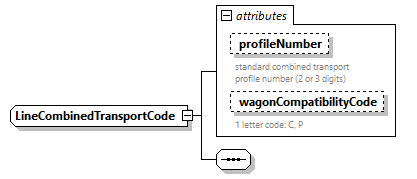 | ||||||||||||||||||||||
| namespace | https://www.railml.org/schemas/3.2 | ||||||||||||||||||||||
| used by |
| ||||||||||||||||||||||
| attributes |
| ||||||||||||||||||||||
| source | <xs:complexType name="LineCombinedTransportCode"> <xs:sequence/> <xs:attribute name="profileNumber" type="xs:integer" use="optional"> <xs:annotation> <xs:documentation>standard combined transport profile number (2 or 3 digits)</xs:documentation> </xs:annotation> </xs:attribute> <xs:attribute name="wagonCompatibilityCode" type="xs:string" use="optional"> <xs:annotation> <xs:documentation>1 letter code: C, P</xs:documentation> </xs:annotation> </xs:attribute> </xs:complexType> |
attribute LineCombinedTransportCode/@profileNumber
| type | xs:integer | ||
| properties |
| ||
| annotation |
| ||
| source | <xs:attribute name="profileNumber" type="xs:integer" use="optional"> <xs:annotation> <xs:documentation>standard combined transport profile number (2 or 3 digits)</xs:documentation> </xs:annotation> </xs:attribute> |
attribute LineCombinedTransportCode/@wagonCompatibilityCode
| type | xs:string | ||
| properties |
| ||
| annotation |
| ||
| source | <xs:attribute name="wagonCompatibilityCode" type="xs:string" use="optional"> <xs:annotation> <xs:documentation>1 letter code: C, P</xs:documentation> </xs:annotation> </xs:attribute> |
complexType LineLayout
| diagram | 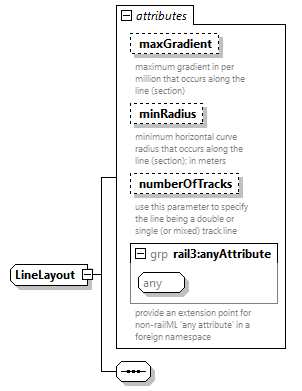 | ||||||||||||||||||||||||||||||
| namespace | https://www.railml.org/schemas/3.2 | ||||||||||||||||||||||||||||||
| used by |
| ||||||||||||||||||||||||||||||
| attributes |
| ||||||||||||||||||||||||||||||
| source | <xs:complexType name="LineLayout"> <xs:sequence/> <xs:attribute name="maxGradient" type="rail3:tGradientPerMille" use="optional"> <xs:annotation> <xs:documentation>maximum gradient in per million that occurs along the line (section)</xs:documentation> </xs:annotation> </xs:attribute> <xs:attribute name="minRadius" type="rail3:tLengthM" use="optional"> <xs:annotation> <xs:documentation>minimum horizontal curve radius that occurs along the line (section); in meters</xs:documentation> </xs:annotation> </xs:attribute> <xs:attribute name="numberOfTracks" type="rail3:tNumberOfTracks" use="optional"> <xs:annotation> <xs:documentation>use this parameter to specify the line being a double or single (or mixed) track line</xs:documentation> </xs:annotation> </xs:attribute> <xs:attributeGroup ref="rail3:anyAttribute"/> </xs:complexType> |
attribute LineLayout/@maxGradient
| type | rail3:tGradientPerMille | ||
| properties |
| ||
| annotation |
| ||
| source | <xs:attribute name="maxGradient" type="rail3:tGradientPerMille" use="optional"> <xs:annotation> <xs:documentation>maximum gradient in per million that occurs along the line (section)</xs:documentation> </xs:annotation> </xs:attribute> |
attribute LineLayout/@minRadius
| type | rail3:tLengthM | ||
| properties |
| ||
| annotation |
| ||
| source | <xs:attribute name="minRadius" type="rail3:tLengthM" use="optional"> <xs:annotation> <xs:documentation>minimum horizontal curve radius that occurs along the line (section); in meters</xs:documentation> </xs:annotation> </xs:attribute> |
attribute LineLayout/@numberOfTracks
| type | rail3:tNumberOfTracks | |||||||||||||||||||||||
| properties |
| |||||||||||||||||||||||
| facets |
| |||||||||||||||||||||||
| annotation |
| |||||||||||||||||||||||
| source | <xs:attribute name="numberOfTracks" type="rail3:tNumberOfTracks" use="optional"> <xs:annotation> <xs:documentation>use this parameter to specify the line being a double or single (or mixed) track line</xs:documentation> </xs:annotation> </xs:attribute> |
complexType LineOperation
| diagram | 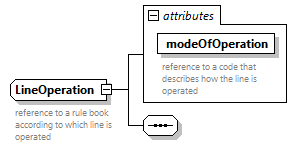 | ||||||||||||||
| namespace | https://www.railml.org/schemas/3.2 | ||||||||||||||
| used by |
| ||||||||||||||
| attributes |
| ||||||||||||||
| annotation |
| ||||||||||||||
| source | <xs:complexType name="LineOperation"> <xs:annotation> <xs:documentation>reference to a rule book according to which line is operated</xs:documentation> </xs:annotation> <xs:sequence/> <xs:attribute name="modeOfOperation" type="rail3:tLineOperationModeExt" use="required"> <xs:annotation> <xs:documentation>reference to a code that describes how the line is operated</xs:documentation> </xs:annotation> </xs:attribute> </xs:complexType> |
attribute LineOperation/@modeOfOperation
| type | rail3:tLineOperationModeExt | ||
| properties |
| ||
| annotation |
| ||
| source | <xs:attribute name="modeOfOperation" type="rail3:tLineOperationModeExt" use="required"> <xs:annotation> <xs:documentation>reference to a code that describes how the line is operated</xs:documentation> </xs:annotation> </xs:attribute> |
complexType LinePerformance
| diagram | 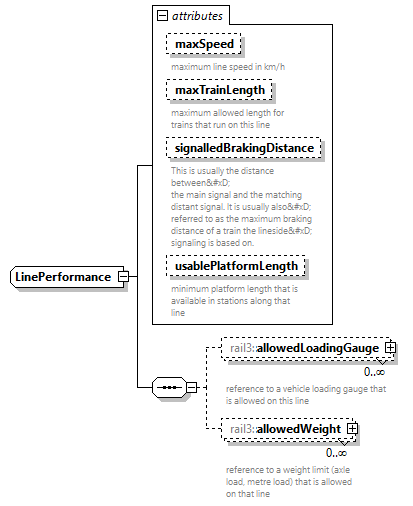 | ||||||||||||||||||||||||||||||||||||||
| namespace | https://www.railml.org/schemas/3.2 | ||||||||||||||||||||||||||||||||||||||
| children | rail3:allowedLoadingGauge rail3:allowedWeight | ||||||||||||||||||||||||||||||||||||||
| used by |
| ||||||||||||||||||||||||||||||||||||||
| attributes |
| ||||||||||||||||||||||||||||||||||||||
| source | <xs:complexType name="LinePerformance"> <xs:sequence> <xs:element name="allowedLoadingGauge" type="rail3:tElementWithIDref" minOccurs="0" maxOccurs="unbounded"> <xs:annotation> <xs:documentation>reference to a vehicle loading gauge that is allowed on this line</xs:documentation> </xs:annotation> </xs:element> <xs:element name="allowedWeight" type="rail3:tElementWithIDref" minOccurs="0" maxOccurs="unbounded"> <xs:annotation> <xs:documentation>reference to a weight limit (axle load, metre load) that is allowed on that line</xs:documentation> </xs:annotation> </xs:element> </xs:sequence> <xs:attribute name="maxSpeed" type="rail3:tSpeedKmPerHour" use="optional"> <xs:annotation> <xs:documentation>maximum line speed in km/h</xs:documentation> </xs:annotation> </xs:attribute> <xs:attribute name="maxTrainLength" type="rail3:tLengthM" use="optional"> <xs:annotation> <xs:documentation>maximum allowed length for trains that run on this line</xs:documentation> </xs:annotation> </xs:attribute> <xs:attribute name="signalledBrakingDistance" type="rail3:tLengthM" use="optional"> <xs:annotation> <xs:documentation>This is usually the distance between
 the main signal and the matching distant signal. It is usually also
 referred to as the maximum braking distance of a train the lineside
 signaling is based on. </xs:documentation> </xs:annotation> </xs:attribute> <xs:attribute name="usablePlatformLength" type="rail3:tLengthM" use="optional"> <xs:annotation> <xs:documentation>minimum platform length that is available in stations along that line</xs:documentation> </xs:annotation> </xs:attribute> </xs:complexType> |
attribute LinePerformance/@maxSpeed
| type | rail3:tSpeedKmPerHour | ||
| properties |
| ||
| annotation |
| ||
| source | <xs:attribute name="maxSpeed" type="rail3:tSpeedKmPerHour" use="optional"> <xs:annotation> <xs:documentation>maximum line speed in km/h</xs:documentation> </xs:annotation> </xs:attribute> |
attribute LinePerformance/@maxTrainLength
| type | rail3:tLengthM | ||
| properties |
| ||
| annotation |
| ||
| source | <xs:attribute name="maxTrainLength" type="rail3:tLengthM" use="optional"> <xs:annotation> <xs:documentation>maximum allowed length for trains that run on this line</xs:documentation> </xs:annotation> </xs:attribute> |
attribute LinePerformance/@signalledBrakingDistance
| type | rail3:tLengthM | ||
| properties |
| ||
| annotation |
| ||
| source | <xs:attribute name="signalledBrakingDistance" type="rail3:tLengthM" use="optional"> <xs:annotation> <xs:documentation>This is usually the distance between
 the main signal and the matching distant signal. It is usually also
 referred to as the maximum braking distance of a train the lineside
 signaling is based on. </xs:documentation> </xs:annotation> </xs:attribute> |
attribute LinePerformance/@usablePlatformLength
| type | rail3:tLengthM | ||
| properties |
| ||
| annotation |
| ||
| source | <xs:attribute name="usablePlatformLength" type="rail3:tLengthM" use="optional"> <xs:annotation> <xs:documentation>minimum platform length that is available in stations along that line</xs:documentation> </xs:annotation> </xs:attribute> |
element LinePerformance/allowedLoadingGauge
| diagram | 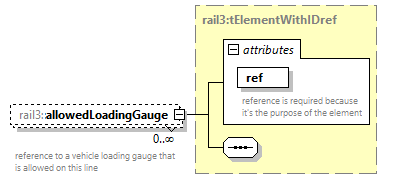 | ||||||||||||||
| namespace | https://www.railml.org/schemas/3.2 | ||||||||||||||
| type | rail3:tElementWithIDref | ||||||||||||||
| properties |
| ||||||||||||||
| attributes |
| ||||||||||||||
| annotation |
| ||||||||||||||
| source | <xs:element name="allowedLoadingGauge" type="rail3:tElementWithIDref" minOccurs="0" maxOccurs="unbounded"> <xs:annotation> <xs:documentation>reference to a vehicle loading gauge that is allowed on this line</xs:documentation> </xs:annotation> </xs:element> |
element LinePerformance/allowedWeight
| diagram | 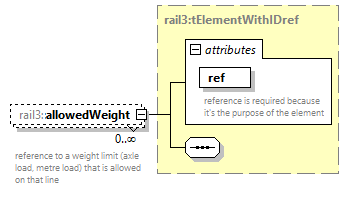 | ||||||||||||||
| namespace | https://www.railml.org/schemas/3.2 | ||||||||||||||
| type | rail3:tElementWithIDref | ||||||||||||||
| properties |
| ||||||||||||||
| attributes |
| ||||||||||||||
| annotation |
| ||||||||||||||
| source | <xs:element name="allowedWeight" type="rail3:tElementWithIDref" minOccurs="0" maxOccurs="unbounded"> <xs:annotation> <xs:documentation>reference to a weight limit (axle load, metre load) that is allowed on that line</xs:documentation> </xs:annotation> </xs:element> |
complexType Lines
| diagram |  | ||
| namespace | https://www.railml.org/schemas/3.2 | ||
| children | rail3:line | ||
| used by |
| ||
| source | <xs:complexType name="Lines"> <xs:sequence> <xs:element name="line" type="rail3:Line" minOccurs="1" maxOccurs="unbounded"/> </xs:sequence> </xs:complexType> |
element Lines/line
| diagram |  | ||||||||||||||||||||||||||||||||||||||||||||||||||||||
| namespace | https://www.railml.org/schemas/3.2 | ||||||||||||||||||||||||||||||||||||||||||||||||||||||
| type | rail3:Line | ||||||||||||||||||||||||||||||||||||||||||||||||||||||
| properties |
| ||||||||||||||||||||||||||||||||||||||||||||||||||||||
| children | rail3:name rail3:isValid rail3:areaLocation rail3:linearLocation rail3:spotLocation rail3:gmlLocations rail3:networkLocation rail3:designator rail3:external rail3:typeDesignator rail3:beginsInOP rail3:endsInOP rail3:length rail3:lineTrafficCode rail3:lineCombinedTransportCode rail3:lineLayout rail3:linePerformance rail3:lineOperation | ||||||||||||||||||||||||||||||||||||||||||||||||||||||
| attributes |
| ||||||||||||||||||||||||||||||||||||||||||||||||||||||
| source | <xs:element name="line" type="rail3:Line" minOccurs="1" maxOccurs="unbounded"/> |
complexType LineTrafficCode
| diagram | 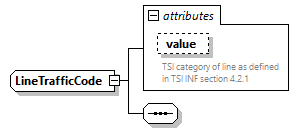 | ||||||||||||||
| namespace | https://www.railml.org/schemas/3.2 | ||||||||||||||
| used by |
| ||||||||||||||
| attributes |
| ||||||||||||||
| source | <xs:complexType name="LineTrafficCode"> <xs:sequence/> <xs:attribute name="value" type="rail3:tLineTrafficCodeExt" use="optional"> <xs:annotation> <xs:documentation>TSI category of line as defined in TSI INF section 4.2.1</xs:documentation> </xs:annotation> </xs:attribute> </xs:complexType> |
attribute LineTrafficCode/@value
| type | rail3:tLineTrafficCodeExt | ||
| properties |
| ||
| annotation |
| ||
| source | <xs:attribute name="value" type="rail3:tLineTrafficCodeExt" use="optional"> <xs:annotation> <xs:documentation>TSI category of line as defined in TSI INF section 4.2.1</xs:documentation> </xs:annotation> </xs:attribute> |
complexType LineTypeCoordinate
| diagram | 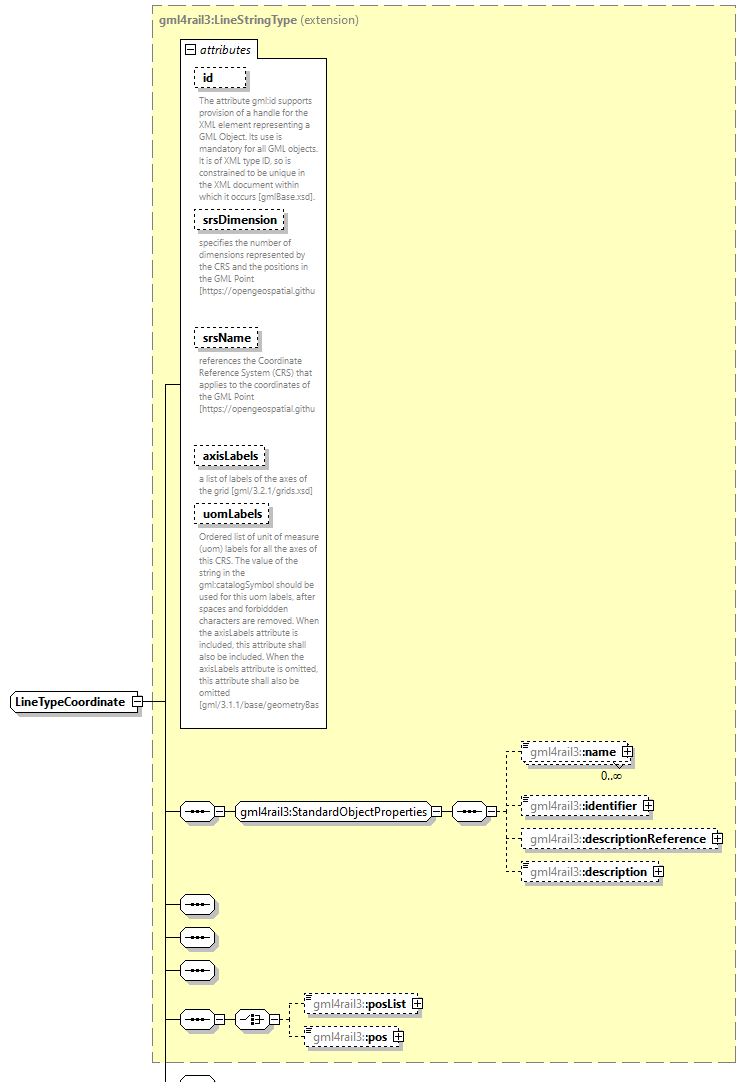 | ||||||||||||||||||||||||||||||||||||||||||||||
| namespace | https://www.railml.org/schemas/3.2 | ||||||||||||||||||||||||||||||||||||||||||||||
| type | extension of gml4rail3:LineStringType | ||||||||||||||||||||||||||||||||||||||||||||||
| properties |
| ||||||||||||||||||||||||||||||||||||||||||||||
| children | gml4rail3:name gml4rail3:identifier gml4rail3:descriptionReference gml4rail3:description gml4rail3:posList gml4rail3:pos | ||||||||||||||||||||||||||||||||||||||||||||||
| used by |
| ||||||||||||||||||||||||||||||||||||||||||||||
| attributes |
| ||||||||||||||||||||||||||||||||||||||||||||||
| source | <xs:complexType name="LineTypeCoordinate"> <xs:complexContent> <xs:extension base="gml4rail3:LineStringType"> <xs:sequence/> </xs:extension> </xs:complexContent> </xs:complexType> |
complexType LoadingGauge
| diagram | 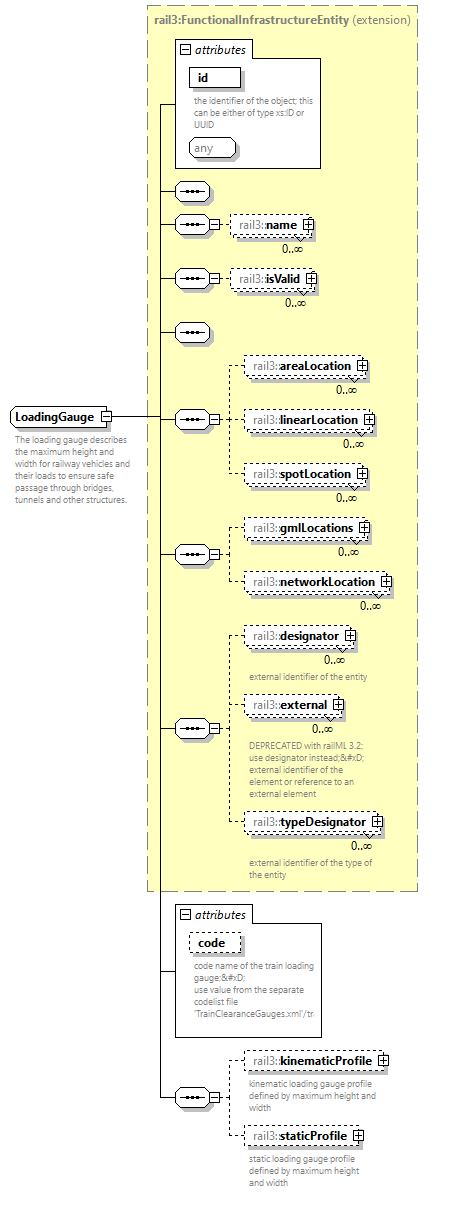 | ||||||||||||||||||||||
| namespace | https://www.railml.org/schemas/3.2 | ||||||||||||||||||||||
| type | extension of rail3:FunctionalInfrastructureEntity | ||||||||||||||||||||||
| properties |
| ||||||||||||||||||||||
| children | rail3:name rail3:isValid rail3:areaLocation rail3:linearLocation rail3:spotLocation rail3:gmlLocations rail3:networkLocation rail3:designator rail3:external rail3:typeDesignator rail3:kinematicProfile rail3:staticProfile | ||||||||||||||||||||||
| used by |
| ||||||||||||||||||||||
| attributes |
| ||||||||||||||||||||||
| annotation |
| ||||||||||||||||||||||
| source | <xs:complexType name="LoadingGauge"> <xs:annotation> <xs:documentation>The loading gauge describes the maximum height and width for railway vehicles and their loads to ensure safe passage through bridges, tunnels and other structures.</xs:documentation> </xs:annotation> <xs:complexContent> <xs:extension base="rail3:FunctionalInfrastructureEntity"> <xs:sequence> <xs:element name="kinematicProfile" type="rail3:LoadingGaugeProfile" minOccurs="0" maxOccurs="1"> <xs:annotation> <xs:documentation>kinematic loading gauge profile defined by maximum height and width</xs:documentation> </xs:annotation> </xs:element> <xs:element name="staticProfile" type="rail3:LoadingGaugeProfile" minOccurs="0" maxOccurs="1"> <xs:annotation> <xs:documentation>static loading gauge profile defined by maximum height and width</xs:documentation> </xs:annotation> </xs:element> </xs:sequence> <xs:attribute name="code" type="xs:string" use="optional"> <xs:annotation> <xs:documentation>code name of the train loading gauge;
 use value from the separate codelist file 'TrainClearanceGauges.xml'/trainClearanceGauge</xs:documentation> </xs:annotation> </xs:attribute> </xs:extension> </xs:complexContent> </xs:complexType> |
attribute LoadingGauge/@code
| type | xs:string | ||
| properties |
| ||
| annotation |
| ||
| source | <xs:attribute name="code" type="xs:string" use="optional"> <xs:annotation> <xs:documentation>code name of the train loading gauge;
 use value from the separate codelist file 'TrainClearanceGauges.xml'/trainClearanceGauge</xs:documentation> </xs:annotation> </xs:attribute> |
element LoadingGauge/kinematicProfile
| diagram | 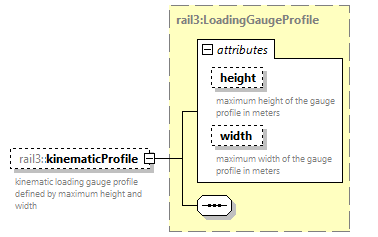 | ||||||||||||||||||||||
| namespace | https://www.railml.org/schemas/3.2 | ||||||||||||||||||||||
| type | rail3:LoadingGaugeProfile | ||||||||||||||||||||||
| properties |
| ||||||||||||||||||||||
| attributes |
| ||||||||||||||||||||||
| annotation |
| ||||||||||||||||||||||
| source | <xs:element name="kinematicProfile" type="rail3:LoadingGaugeProfile" minOccurs="0" maxOccurs="1"> <xs:annotation> <xs:documentation>kinematic loading gauge profile defined by maximum height and width</xs:documentation> </xs:annotation> </xs:element> |
element LoadingGauge/staticProfile
| diagram | 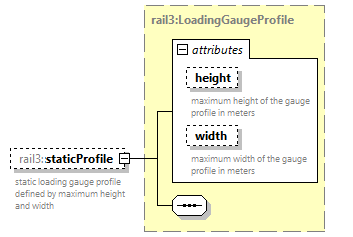 | ||||||||||||||||||||||
| namespace | https://www.railml.org/schemas/3.2 | ||||||||||||||||||||||
| type | rail3:LoadingGaugeProfile | ||||||||||||||||||||||
| properties |
| ||||||||||||||||||||||
| attributes |
| ||||||||||||||||||||||
| annotation |
| ||||||||||||||||||||||
| source | <xs:element name="staticProfile" type="rail3:LoadingGaugeProfile" minOccurs="0" maxOccurs="1"> <xs:annotation> <xs:documentation>static loading gauge profile defined by maximum height and width</xs:documentation> </xs:annotation> </xs:element> |
complexType LoadingGaugeProfile
| diagram | 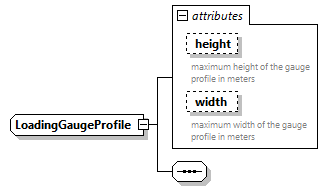 | ||||||||||||||||||||||
| namespace | https://www.railml.org/schemas/3.2 | ||||||||||||||||||||||
| used by |
| ||||||||||||||||||||||
| attributes |
| ||||||||||||||||||||||
| source | <xs:complexType name="LoadingGaugeProfile"> <xs:sequence/> <xs:attribute name="height" type="rail3:tLengthM" use="optional"> <xs:annotation> <xs:documentation>maximum height of the gauge profile in meters</xs:documentation> </xs:annotation> </xs:attribute> <xs:attribute name="width" type="rail3:tLengthM" use="optional"> <xs:annotation> <xs:documentation>maximum width of the gauge profile in meters</xs:documentation> </xs:annotation> </xs:attribute> </xs:complexType> |
attribute LoadingGaugeProfile/@height
| type | rail3:tLengthM | ||
| properties |
| ||
| annotation |
| ||
| source | <xs:attribute name="height" type="rail3:tLengthM" use="optional"> <xs:annotation> <xs:documentation>maximum height of the gauge profile in meters</xs:documentation> </xs:annotation> </xs:attribute> |
attribute LoadingGaugeProfile/@width
| type | rail3:tLengthM | ||
| properties |
| ||
| annotation |
| ||
| source | <xs:attribute name="width" type="rail3:tLengthM" use="optional"> <xs:annotation> <xs:documentation>maximum width of the gauge profile in meters</xs:documentation> </xs:annotation> </xs:attribute> |
complexType LoadingGauges
| diagram | 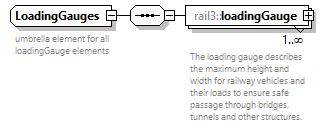 | ||
| namespace | https://www.railml.org/schemas/3.2 | ||
| children | rail3:loadingGauge | ||
| used by |
| ||
| annotation |
| ||
| source | <xs:complexType name="LoadingGauges"> <xs:annotation> <xs:documentation>umbrella element for all loadingGauge elements</xs:documentation> </xs:annotation> <xs:sequence> <xs:element name="loadingGauge" type="rail3:LoadingGauge" minOccurs="1" maxOccurs="unbounded"> <xs:annotation> <xs:documentation>The loading gauge describes the maximum height and width for railway vehicles and their loads to ensure safe passage through bridges, tunnels and other structures.</xs:documentation> </xs:annotation> </xs:element> </xs:sequence> </xs:complexType> |
element LoadingGauges/loadingGauge
| diagram | 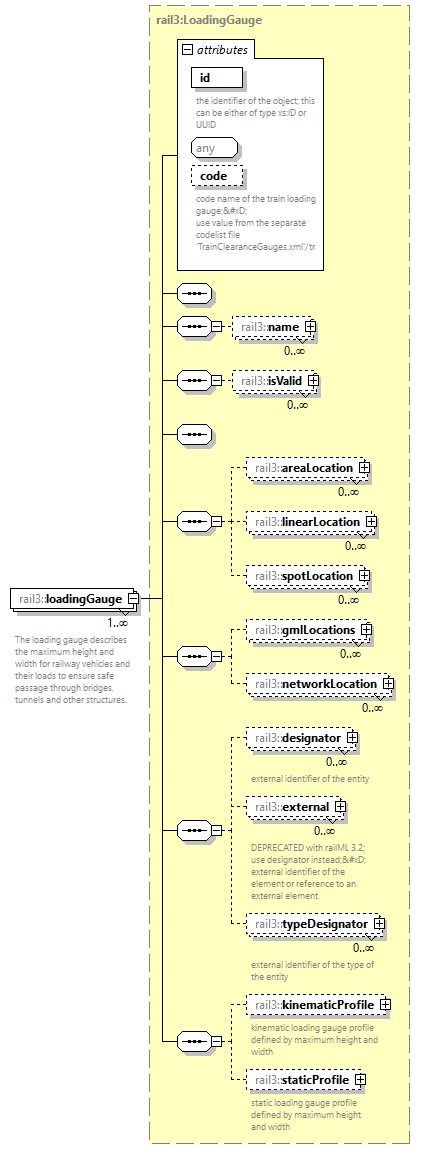 | ||||||||||||||||||||||
| namespace | https://www.railml.org/schemas/3.2 | ||||||||||||||||||||||
| type | rail3:LoadingGauge | ||||||||||||||||||||||
| properties |
| ||||||||||||||||||||||
| children | rail3:name rail3:isValid rail3:areaLocation rail3:linearLocation rail3:spotLocation rail3:gmlLocations rail3:networkLocation rail3:designator rail3:external rail3:typeDesignator rail3:kinematicProfile rail3:staticProfile | ||||||||||||||||||||||
| attributes |
| ||||||||||||||||||||||
| annotation |
| ||||||||||||||||||||||
| source | <xs:element name="loadingGauge" type="rail3:LoadingGauge" minOccurs="1" maxOccurs="unbounded"> <xs:annotation> <xs:documentation>The loading gauge describes the maximum height and width for railway vehicles and their loads to ensure safe passage through bridges, tunnels and other structures.</xs:documentation> </xs:annotation> </xs:element> |
complexType Location
| diagram |  | ||
| namespace | https://www.railml.org/schemas/3.2 | ||
| children | rail3:circle rail3:polygon | ||
| used by |
| ||
| annotation |
| ||
| source | <xs:complexType name="Location"> <xs:annotation> <xs:documentation>RTM independent reference system</xs:documentation> </xs:annotation> <xs:choice> <xs:element name="circle" type="rail3:Circle" minOccurs="1" maxOccurs="1"/> <xs:element name="polygon" type="rail3:Polygon" minOccurs="1" maxOccurs="1"/> </xs:choice> </xs:complexType> |
element Location/circle
| diagram | 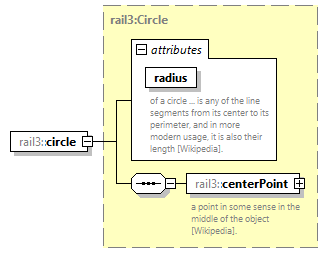 | ||||||||||||||
| namespace | https://www.railml.org/schemas/3.2 | ||||||||||||||
| type | rail3:Circle | ||||||||||||||
| properties |
| ||||||||||||||
| children | rail3:centerPoint | ||||||||||||||
| attributes |
| ||||||||||||||
| source | <xs:element name="circle" type="rail3:Circle" minOccurs="1" maxOccurs="1"/> |
element Location/polygon
| diagram | 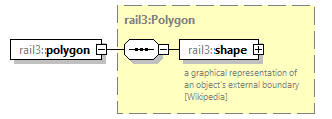 | ||
| namespace | https://www.railml.org/schemas/3.2 | ||
| type | rail3:Polygon | ||
| properties |
| ||
| children | rail3:shape | ||
| source | <xs:element name="polygon" type="rail3:Polygon" minOccurs="1" maxOccurs="1"/> |
complexType LocationNetwork
| diagram | 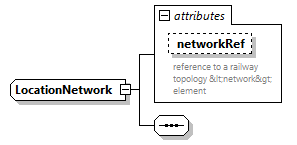 | ||||||||||||||
| namespace | https://www.railml.org/schemas/3.2 | ||||||||||||||
| used by |
| ||||||||||||||
| attributes |
| ||||||||||||||
| source | <xs:complexType name="LocationNetwork"> <xs:sequence/> <xs:attribute name="networkRef" type="rail3:tRef" use="optional"> <xs:annotation> <xs:documentation>reference to a railway topology <network> element</xs:documentation> </xs:annotation> </xs:attribute> </xs:complexType> |
attribute LocationNetwork/@networkRef
| type | rail3:tRef | ||
| properties |
| ||
| annotation |
| ||
| source | <xs:attribute name="networkRef" type="rail3:tRef" use="optional"> <xs:annotation> <xs:documentation>reference to a railway topology <network> element</xs:documentation> </xs:annotation> </xs:attribute> |
complexType MaxTrainCurrent
| diagram | 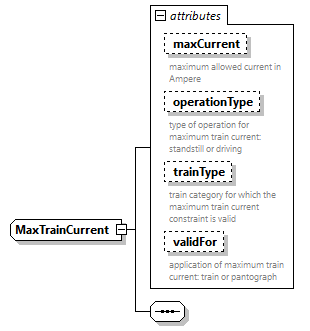 | ||||||||||||||||||||||||||||||||||||||
| namespace | https://www.railml.org/schemas/3.2 | ||||||||||||||||||||||||||||||||||||||
| used by |
| ||||||||||||||||||||||||||||||||||||||
| attributes |
| ||||||||||||||||||||||||||||||||||||||
| source | <xs:complexType name="MaxTrainCurrent"> <xs:sequence/> <xs:attribute name="maxCurrent" type="rail3:tCurrentAmpere" use="optional"> <xs:annotation> <xs:documentation>maximum allowed current in Ampere</xs:documentation> </xs:annotation> </xs:attribute> <xs:attribute name="operationType" type="xs:int" use="optional"> <xs:annotation> <xs:documentation>type of operation for maximum train current: standstill or driving</xs:documentation> </xs:annotation> </xs:attribute> <xs:attribute name="trainType" type="rail3:tOperationalTrainType" use="optional"> <xs:annotation> <xs:documentation>train category for which the maximum train current constraint is valid</xs:documentation> </xs:annotation> </xs:attribute> <xs:attribute name="validFor" type="xs:int" use="optional"> <xs:annotation> <xs:documentation>application of maximum train current: train or pantograph</xs:documentation> </xs:annotation> </xs:attribute> </xs:complexType> |
attribute MaxTrainCurrent/@maxCurrent
| type | rail3:tCurrentAmpere | ||
| properties |
| ||
| annotation |
| ||
| source | <xs:attribute name="maxCurrent" type="rail3:tCurrentAmpere" use="optional"> <xs:annotation> <xs:documentation>maximum allowed current in Ampere</xs:documentation> </xs:annotation> </xs:attribute> |
attribute MaxTrainCurrent/@operationType
| type | xs:int | ||
| properties |
| ||
| annotation |
| ||
| source | <xs:attribute name="operationType" type="xs:int" use="optional"> <xs:annotation> <xs:documentation>type of operation for maximum train current: standstill or driving</xs:documentation> </xs:annotation> </xs:attribute> |
attribute MaxTrainCurrent/@trainType
| type | rail3:tOperationalTrainType | |||||||||||||||
| properties |
| |||||||||||||||
| facets |
| |||||||||||||||
| annotation |
| |||||||||||||||
| source | <xs:attribute name="trainType" type="rail3:tOperationalTrainType" use="optional"> <xs:annotation> <xs:documentation>train category for which the maximum train current constraint is valid</xs:documentation> </xs:annotation> </xs:attribute> |
attribute MaxTrainCurrent/@validFor
| type | xs:int | ||
| properties |
| ||
| annotation |
| ||
| source | <xs:attribute name="validFor" type="xs:int" use="optional"> <xs:annotation> <xs:documentation>application of maximum train current: train or pantograph</xs:documentation> </xs:annotation> </xs:attribute> |
complexType MileageChange
| diagram | 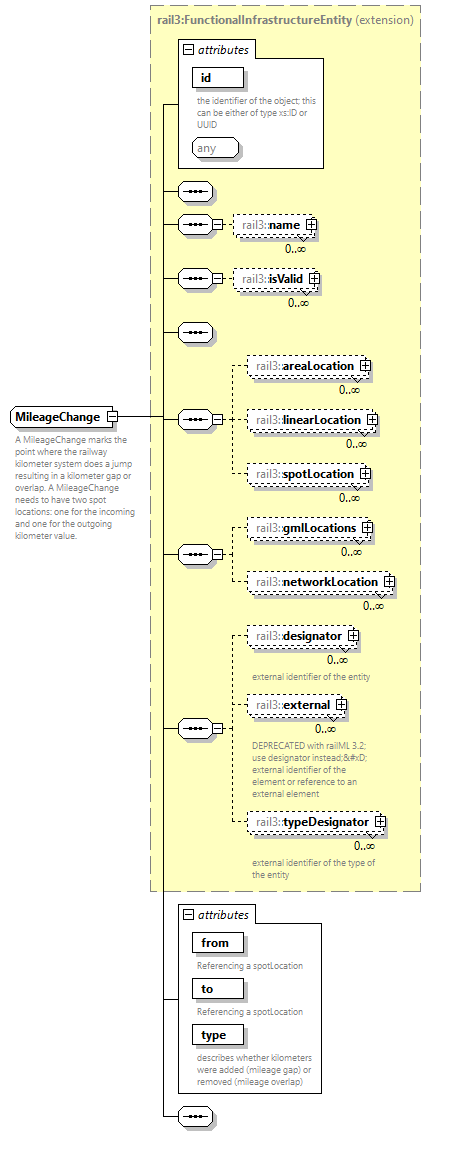 | ||||||||||||||||||||||||||||||||||||||
| namespace | https://www.railml.org/schemas/3.2 | ||||||||||||||||||||||||||||||||||||||
| type | extension of rail3:FunctionalInfrastructureEntity | ||||||||||||||||||||||||||||||||||||||
| properties |
| ||||||||||||||||||||||||||||||||||||||
| children | rail3:name rail3:isValid rail3:areaLocation rail3:linearLocation rail3:spotLocation rail3:gmlLocations rail3:networkLocation rail3:designator rail3:external rail3:typeDesignator | ||||||||||||||||||||||||||||||||||||||
| used by |
| ||||||||||||||||||||||||||||||||||||||
| attributes |
| ||||||||||||||||||||||||||||||||||||||
| annotation |
| ||||||||||||||||||||||||||||||||||||||
| source | <xs:complexType name="MileageChange"> <xs:annotation> <xs:documentation>A MileageChange marks the point where the railway kilometer system does a jump resulting in a kilometer gap or overlap. A MileageChange needs to have two spot locations: one for the incoming and one for the outgoing kilometer value.</xs:documentation> </xs:annotation> <xs:complexContent> <xs:extension base="rail3:FunctionalInfrastructureEntity"> <xs:sequence/> <xs:attribute name="from" type="rail3:tRef" use="required"> <xs:annotation> <xs:documentation>Referencing a spotLocation</xs:documentation> </xs:annotation> </xs:attribute> <xs:attribute name="to" type="rail3:tRef" use="required"> <xs:annotation> <xs:documentation>Referencing a spotLocation</xs:documentation> </xs:annotation> </xs:attribute> <xs:attribute name="type" type="rail3:MileageChangeType" use="required"> <xs:annotation> <xs:documentation>describes whether kilometers were added (mileage gap) or removed (mileage overlap)</xs:documentation> </xs:annotation> </xs:attribute> </xs:extension> </xs:complexContent> </xs:complexType> |
attribute MileageChange/@from
| type | rail3:tRef | ||
| properties |
| ||
| annotation |
| ||
| source | <xs:attribute name="from" type="rail3:tRef" use="required"> <xs:annotation> <xs:documentation>Referencing a spotLocation</xs:documentation> </xs:annotation> </xs:attribute> |
attribute MileageChange/@to
| type | rail3:tRef | ||
| properties |
| ||
| annotation |
| ||
| source | <xs:attribute name="to" type="rail3:tRef" use="required"> <xs:annotation> <xs:documentation>Referencing a spotLocation</xs:documentation> </xs:annotation> </xs:attribute> |
attribute MileageChange/@type
| type | rail3:MileageChangeType | |||||||||||||
| properties |
| |||||||||||||
| facets |
| |||||||||||||
| annotation |
| |||||||||||||
| source | <xs:attribute name="type" type="rail3:MileageChangeType" use="required"> <xs:annotation> <xs:documentation>describes whether kilometers were added (mileage gap) or removed (mileage overlap)</xs:documentation> </xs:annotation> </xs:attribute> |
complexType MileageChanges
| diagram |  | ||
| namespace | https://www.railml.org/schemas/3.2 | ||
| children | rail3:mileageChange | ||
| used by |
| ||
| source | <xs:complexType name="MileageChanges"> <xs:sequence> <xs:element name="mileageChange" type="rail3:MileageChange" minOccurs="1" maxOccurs="unbounded"/> </xs:sequence> </xs:complexType> |
element MileageChanges/mileageChange
| diagram | 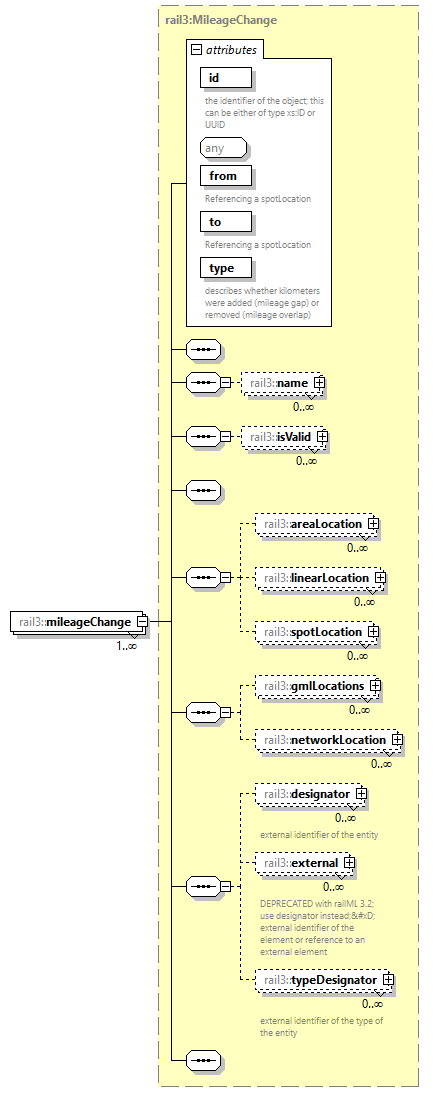 | ||||||||||||||||||||||||||||||||||||||
| namespace | https://www.railml.org/schemas/3.2 | ||||||||||||||||||||||||||||||||||||||
| type | rail3:MileageChange | ||||||||||||||||||||||||||||||||||||||
| properties |
| ||||||||||||||||||||||||||||||||||||||
| children | rail3:name rail3:isValid rail3:areaLocation rail3:linearLocation rail3:spotLocation rail3:gmlLocations rail3:networkLocation rail3:designator rail3:external rail3:typeDesignator | ||||||||||||||||||||||||||||||||||||||
| attributes |
| ||||||||||||||||||||||||||||||||||||||
| source | <xs:element name="mileageChange" type="rail3:MileageChange" minOccurs="1" maxOccurs="unbounded"/> |
complexType NetElement
| diagram | 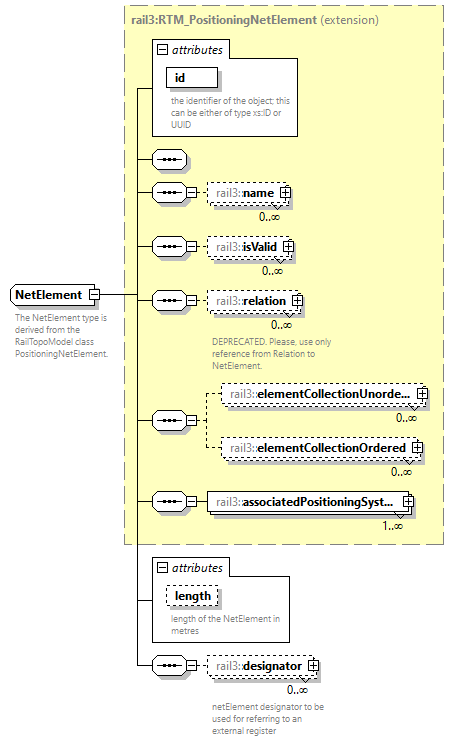 | ||||||||||||||||||||||
| namespace | https://www.railml.org/schemas/3.2 | ||||||||||||||||||||||
| type | extension of rail3:RTM_PositioningNetElement | ||||||||||||||||||||||
| properties |
| ||||||||||||||||||||||
| children | rail3:name rail3:isValid rail3:relation rail3:elementCollectionUnordered rail3:elementCollectionOrdered rail3:associatedPositioningSystem rail3:designator | ||||||||||||||||||||||
| used by |
| ||||||||||||||||||||||
| attributes |
| ||||||||||||||||||||||
| annotation |
| ||||||||||||||||||||||
| source | <xs:complexType name="NetElement"> <xs:annotation> <xs:documentation>The NetElement type is derived from the RailTopoModel class PositioningNetElement.</xs:documentation> </xs:annotation> <xs:complexContent> <xs:extension base="rail3:RTM_PositioningNetElement"> <xs:sequence> <xs:element name="designator" type="rail3:Designator" minOccurs="0" maxOccurs="unbounded"> <xs:annotation> <xs:documentation>netElement designator to be used for referring to an external register</xs:documentation> </xs:annotation> </xs:element> </xs:sequence> <xs:attribute name="length" type="rail3:tLengthM" use="optional"> <xs:annotation> <xs:documentation>length of the NetElement in metres</xs:documentation> </xs:annotation> </xs:attribute> </xs:extension> </xs:complexContent> </xs:complexType> |
attribute NetElement/@length
| type | rail3:tLengthM | ||
| properties |
| ||
| annotation |
| ||
| source | <xs:attribute name="length" type="rail3:tLengthM" use="optional"> <xs:annotation> <xs:documentation>length of the NetElement in metres</xs:documentation> </xs:annotation> </xs:attribute> |
element NetElement/designator
| diagram | 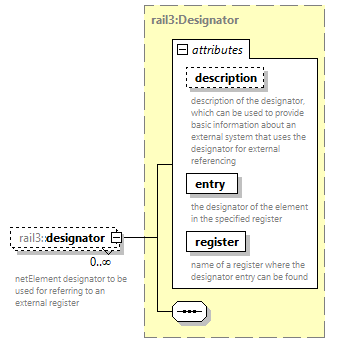 | ||||||||||||||||||||||||||||||
| namespace | https://www.railml.org/schemas/3.2 | ||||||||||||||||||||||||||||||
| type | rail3:Designator | ||||||||||||||||||||||||||||||
| properties |
| ||||||||||||||||||||||||||||||
| attributes |
| ||||||||||||||||||||||||||||||
| annotation |
| ||||||||||||||||||||||||||||||
| source | <xs:element name="designator" type="rail3:Designator" minOccurs="0" maxOccurs="unbounded"> <xs:annotation> <xs:documentation>netElement designator to be used for referring to an external register</xs:documentation> </xs:annotation> </xs:element> |
complexType NetElementRef
| diagram | 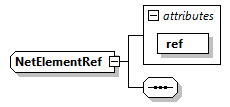 | ||||||||||||
| namespace | https://www.railml.org/schemas/3.2 | ||||||||||||
| used by |
| ||||||||||||
| attributes |
| ||||||||||||
| source | <xs:complexType name="NetElementRef"> <xs:sequence/> <xs:attribute name="ref" type="rail3:tRef" use="required"/> </xs:complexType> |
attribute NetElementRef/@ref
| type | rail3:tRef | ||
| properties |
| ||
| source | <xs:attribute name="ref" type="rail3:tRef" use="required"/> |
complexType NetElements
| diagram |  | ||
| namespace | https://www.railml.org/schemas/3.2 | ||
| children | rail3:netElement | ||
| used by |
| ||
| source | <xs:complexType name="NetElements"> <xs:sequence> <xs:element name="netElement" type="rail3:NetElement" minOccurs="1" maxOccurs="unbounded"/> </xs:sequence> </xs:complexType> |
element NetElements/netElement
| diagram | 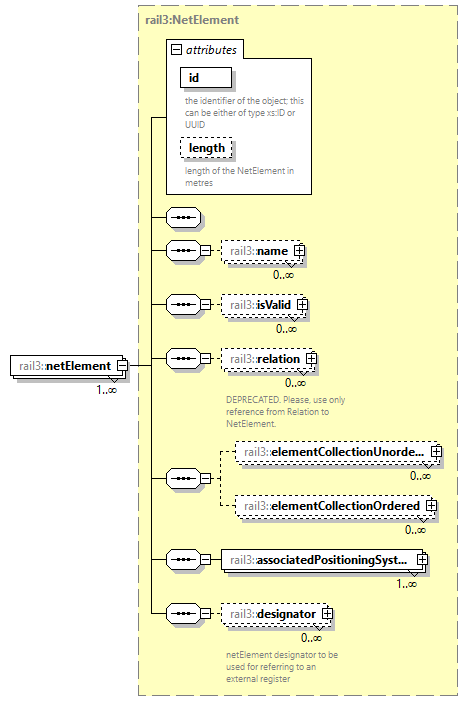 | ||||||||||||||||||||||
| namespace | https://www.railml.org/schemas/3.2 | ||||||||||||||||||||||
| type | rail3:NetElement | ||||||||||||||||||||||
| properties |
| ||||||||||||||||||||||
| children | rail3:name rail3:isValid rail3:relation rail3:elementCollectionUnordered rail3:elementCollectionOrdered rail3:associatedPositioningSystem rail3:designator | ||||||||||||||||||||||
| attributes |
| ||||||||||||||||||||||
| source | <xs:element name="netElement" type="rail3:NetElement" minOccurs="1" maxOccurs="unbounded"/> |
complexType NetRelation
| diagram | 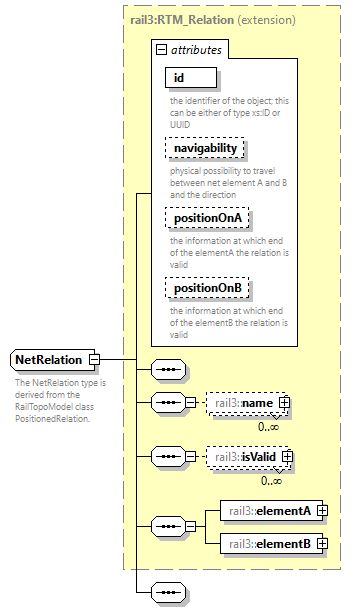 | ||||||||||||||||||||||||||||||||||||||
| namespace | https://www.railml.org/schemas/3.2 | ||||||||||||||||||||||||||||||||||||||
| type | extension of rail3:RTM_Relation | ||||||||||||||||||||||||||||||||||||||
| properties |
| ||||||||||||||||||||||||||||||||||||||
| children | rail3:name rail3:isValid rail3:elementA rail3:elementB | ||||||||||||||||||||||||||||||||||||||
| used by |
| ||||||||||||||||||||||||||||||||||||||
| attributes |
| ||||||||||||||||||||||||||||||||||||||
| annotation |
| ||||||||||||||||||||||||||||||||||||||
| source | <xs:complexType name="NetRelation"> <xs:annotation> <xs:documentation>The NetRelation type is derived from the RailTopoModel class PositionedRelation.</xs:documentation> </xs:annotation> <xs:complexContent> <xs:extension base="rail3:RTM_Relation"> <xs:sequence/> </xs:extension> </xs:complexContent> </xs:complexType> |
complexType NetRelations
| diagram |  | ||
| namespace | https://www.railml.org/schemas/3.2 | ||
| children | rail3:netRelation | ||
| used by |
| ||
| source | <xs:complexType name="NetRelations"> <xs:sequence> <xs:element name="netRelation" type="rail3:NetRelation" minOccurs="1" maxOccurs="unbounded"/> </xs:sequence> </xs:complexType> |
element NetRelations/netRelation
| diagram | 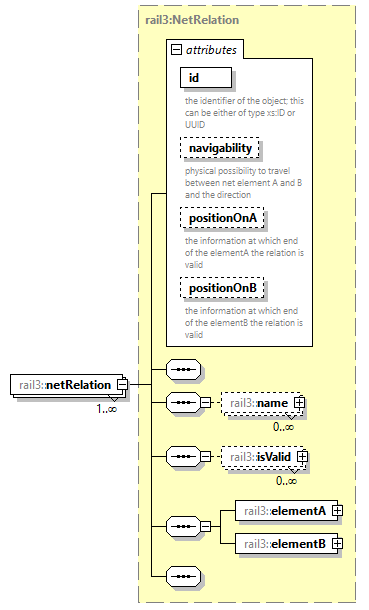 | ||||||||||||||||||||||||||||||||||||||
| namespace | https://www.railml.org/schemas/3.2 | ||||||||||||||||||||||||||||||||||||||
| type | rail3:NetRelation | ||||||||||||||||||||||||||||||||||||||
| properties |
| ||||||||||||||||||||||||||||||||||||||
| children | rail3:name rail3:isValid rail3:elementA rail3:elementB | ||||||||||||||||||||||||||||||||||||||
| attributes |
| ||||||||||||||||||||||||||||||||||||||
| source | <xs:element name="netRelation" type="rail3:NetRelation" minOccurs="1" maxOccurs="unbounded"/> |
complexType NetTravelPath
| diagram | 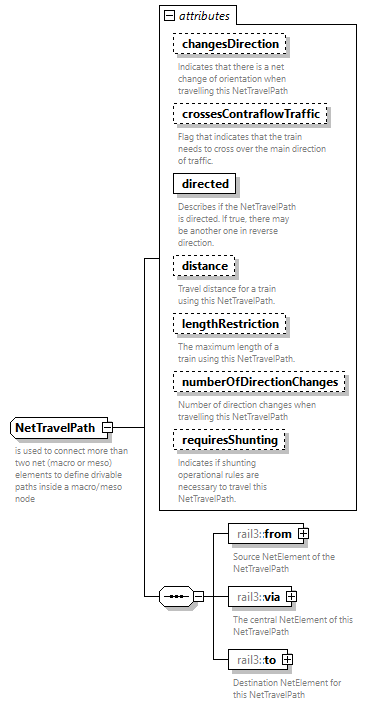 | ||||||||||||||||||||||||||||||||||||||||||||||||||||||||||||||
| namespace | https://www.railml.org/schemas/3.2 | ||||||||||||||||||||||||||||||||||||||||||||||||||||||||||||||
| children | rail3:from rail3:via rail3:to | ||||||||||||||||||||||||||||||||||||||||||||||||||||||||||||||
| used by |
| ||||||||||||||||||||||||||||||||||||||||||||||||||||||||||||||
| attributes |
| ||||||||||||||||||||||||||||||||||||||||||||||||||||||||||||||
| annotation |
| ||||||||||||||||||||||||||||||||||||||||||||||||||||||||||||||
| source | <xs:complexType name="NetTravelPath"> <xs:annotation> <xs:documentation>is used to connect more than two net (macro or meso) elements to define drivable paths inside a macro/meso node</xs:documentation> </xs:annotation> <xs:sequence> <xs:element name="from" type="rail3:NetElementRef" minOccurs="1" maxOccurs="1"> <xs:annotation> <xs:documentation>Source NetElement of the NetTravelPath</xs:documentation> </xs:annotation> </xs:element> <xs:element name="via" type="rail3:NetElementRef" minOccurs="1" maxOccurs="1"> <xs:annotation> <xs:documentation>The central NetElement of this NetTravelPath</xs:documentation> </xs:annotation> </xs:element> <xs:element name="to" type="rail3:NetElementRef" minOccurs="1" maxOccurs="1"> <xs:annotation> <xs:documentation>Destination NetElement for this NetTravelPath</xs:documentation> </xs:annotation> </xs:element> </xs:sequence> <xs:attribute name="changesDirection" type="xs:boolean" use="optional"> <xs:annotation> <xs:documentation>Indicates that there is a net change of orientation when travelling this NetTravelPath</xs:documentation> </xs:annotation> </xs:attribute> <xs:attribute name="crossesContraflowTraffic" type="xs:boolean" use="optional"> <xs:annotation> <xs:documentation>Flag that indicates that the train needs to cross over the main direction of traffic.</xs:documentation> </xs:annotation> </xs:attribute> <xs:attribute name="directed" type="xs:boolean" use="required"> <xs:annotation> <xs:documentation>Describes if the NetTravelPath is directed. If true, there may be another one in reverse direction.</xs:documentation> </xs:annotation> </xs:attribute> <xs:attribute name="distance" type="rail3:tLengthM" use="optional"> <xs:annotation> <xs:documentation>Travel distance for a train using this NetTravelPath.</xs:documentation> </xs:annotation> </xs:attribute> <xs:attribute name="lengthRestriction" type="xs:boolean" use="optional"> <xs:annotation> <xs:documentation>The maximum length of a train using this NetTravelPath.</xs:documentation> </xs:annotation> </xs:attribute> <xs:attribute name="numberOfDirectionChanges" type="xs:nonNegativeInteger" use="optional"> <xs:annotation> <xs:documentation>Number of direction changes when travelling this NetTravelPath</xs:documentation> </xs:annotation> </xs:attribute> <xs:attribute name="requiresShunting" type="xs:boolean" use="optional"> <xs:annotation> <xs:documentation>Indicates if shunting operational rules are necessary to travel this NetTravelPath.</xs:documentation> </xs:annotation> </xs:attribute> </xs:complexType> |
attribute NetTravelPath/@changesDirection
| type | xs:boolean | ||
| properties |
| ||
| annotation |
| ||
| source | <xs:attribute name="changesDirection" type="xs:boolean" use="optional"> <xs:annotation> <xs:documentation>Indicates that there is a net change of orientation when travelling this NetTravelPath</xs:documentation> </xs:annotation> </xs:attribute> |
attribute NetTravelPath/@crossesContraflowTraffic
| type | xs:boolean | ||
| properties |
| ||
| annotation |
| ||
| source | <xs:attribute name="crossesContraflowTraffic" type="xs:boolean" use="optional"> <xs:annotation> <xs:documentation>Flag that indicates that the train needs to cross over the main direction of traffic.</xs:documentation> </xs:annotation> </xs:attribute> |
attribute NetTravelPath/@directed
| type | xs:boolean | ||
| properties |
| ||
| annotation |
| ||
| source | <xs:attribute name="directed" type="xs:boolean" use="required"> <xs:annotation> <xs:documentation>Describes if the NetTravelPath is directed. If true, there may be another one in reverse direction.</xs:documentation> </xs:annotation> </xs:attribute> |
attribute NetTravelPath/@distance
| type | rail3:tLengthM | ||
| properties |
| ||
| annotation |
| ||
| source | <xs:attribute name="distance" type="rail3:tLengthM" use="optional"> <xs:annotation> <xs:documentation>Travel distance for a train using this NetTravelPath.</xs:documentation> </xs:annotation> </xs:attribute> |
attribute NetTravelPath/@lengthRestriction
| type | xs:boolean | ||
| properties |
| ||
| annotation |
| ||
| source | <xs:attribute name="lengthRestriction" type="xs:boolean" use="optional"> <xs:annotation> <xs:documentation>The maximum length of a train using this NetTravelPath.</xs:documentation> </xs:annotation> </xs:attribute> |
attribute NetTravelPath/@numberOfDirectionChanges
| type | xs:nonNegativeInteger | ||
| properties |
| ||
| annotation |
| ||
| source | <xs:attribute name="numberOfDirectionChanges" type="xs:nonNegativeInteger" use="optional"> <xs:annotation> <xs:documentation>Number of direction changes when travelling this NetTravelPath</xs:documentation> </xs:annotation> </xs:attribute> |
attribute NetTravelPath/@requiresShunting
| type | xs:boolean | ||
| properties |
| ||
| annotation |
| ||
| source | <xs:attribute name="requiresShunting" type="xs:boolean" use="optional"> <xs:annotation> <xs:documentation>Indicates if shunting operational rules are necessary to travel this NetTravelPath.</xs:documentation> </xs:annotation> </xs:attribute> |
element NetTravelPath/from
| diagram | 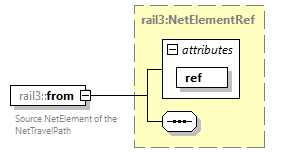 | ||||||||||||
| namespace | https://www.railml.org/schemas/3.2 | ||||||||||||
| type | rail3:NetElementRef | ||||||||||||
| properties |
| ||||||||||||
| attributes |
| ||||||||||||
| annotation |
| ||||||||||||
| source | <xs:element name="from" type="rail3:NetElementRef" minOccurs="1" maxOccurs="1"> <xs:annotation> <xs:documentation>Source NetElement of the NetTravelPath</xs:documentation> </xs:annotation> </xs:element> |
element NetTravelPath/via
| diagram | 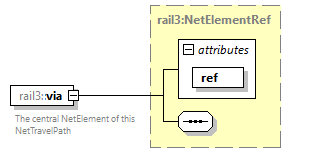 | ||||||||||||
| namespace | https://www.railml.org/schemas/3.2 | ||||||||||||
| type | rail3:NetElementRef | ||||||||||||
| properties |
| ||||||||||||
| attributes |
| ||||||||||||
| annotation |
| ||||||||||||
| source | <xs:element name="via" type="rail3:NetElementRef" minOccurs="1" maxOccurs="1"> <xs:annotation> <xs:documentation>The central NetElement of this NetTravelPath</xs:documentation> </xs:annotation> </xs:element> |
element NetTravelPath/to
| diagram | 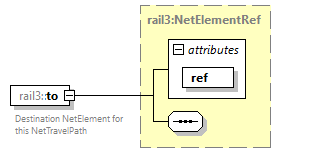 | ||||||||||||
| namespace | https://www.railml.org/schemas/3.2 | ||||||||||||
| type | rail3:NetElementRef | ||||||||||||
| properties |
| ||||||||||||
| attributes |
| ||||||||||||
| annotation |
| ||||||||||||
| source | <xs:element name="to" type="rail3:NetElementRef" minOccurs="1" maxOccurs="1"> <xs:annotation> <xs:documentation>Destination NetElement for this NetTravelPath</xs:documentation> </xs:annotation> </xs:element> |
complexType NetTravelPaths
| diagram |  | ||
| namespace | https://www.railml.org/schemas/3.2 | ||
| children | rail3:netTravelPath | ||
| used by |
| ||
| source | <xs:complexType name="NetTravelPaths"> <xs:sequence> <xs:element name="netTravelPath" type="rail3:NetTravelPath" minOccurs="1" maxOccurs="unbounded"/> </xs:sequence> </xs:complexType> |
element NetTravelPaths/netTravelPath
| diagram | 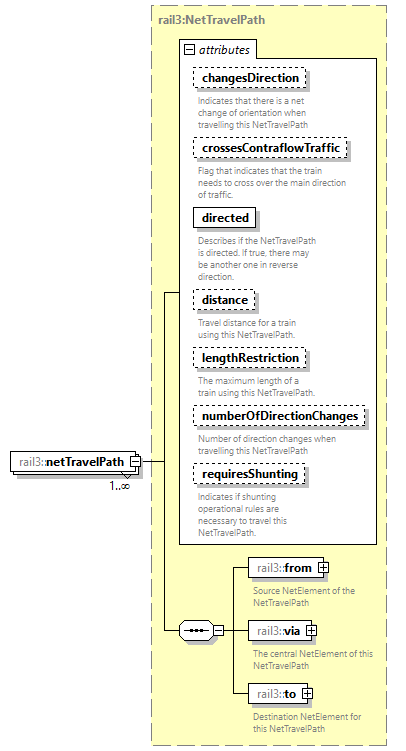 | ||||||||||||||||||||||||||||||||||||||||||||||||||||||||||||||
| namespace | https://www.railml.org/schemas/3.2 | ||||||||||||||||||||||||||||||||||||||||||||||||||||||||||||||
| type | rail3:NetTravelPath | ||||||||||||||||||||||||||||||||||||||||||||||||||||||||||||||
| properties |
| ||||||||||||||||||||||||||||||||||||||||||||||||||||||||||||||
| children | rail3:from rail3:via rail3:to | ||||||||||||||||||||||||||||||||||||||||||||||||||||||||||||||
| attributes |
| ||||||||||||||||||||||||||||||||||||||||||||||||||||||||||||||
| source | <xs:element name="netTravelPath" type="rail3:NetTravelPath" minOccurs="1" maxOccurs="unbounded"/> |
complexType Network
| diagram | 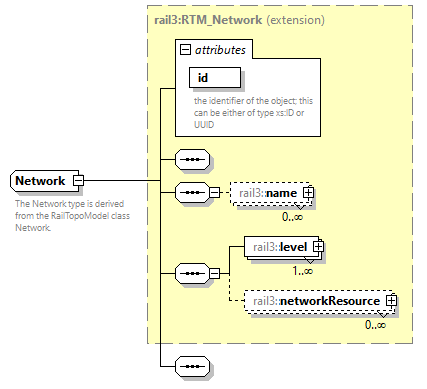 | ||||||||||||||
| namespace | https://www.railml.org/schemas/3.2 | ||||||||||||||
| type | extension of rail3:RTM_Network | ||||||||||||||
| properties |
| ||||||||||||||
| children | rail3:name rail3:level rail3:networkResource | ||||||||||||||
| used by |
| ||||||||||||||
| attributes |
| ||||||||||||||
| annotation |
| ||||||||||||||
| source | <xs:complexType name="Network"> <xs:annotation> <xs:documentation>The Network type is derived from the RailTopoModel class Network.</xs:documentation> </xs:annotation> <xs:complexContent> <xs:extension base="rail3:RTM_Network"> <xs:sequence/> </xs:extension> </xs:complexContent> </xs:complexType> |
complexType Networks
| diagram |  | ||
| namespace | https://www.railml.org/schemas/3.2 | ||
| children | rail3:network | ||
| used by |
| ||
| source | <xs:complexType name="Networks"> <xs:sequence> <xs:element name="network" type="rail3:Network" minOccurs="1" maxOccurs="unbounded"/> </xs:sequence> </xs:complexType> |
element Networks/network
| diagram | 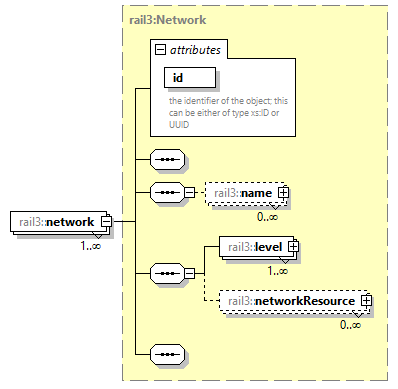 | ||||||||||||||
| namespace | https://www.railml.org/schemas/3.2 | ||||||||||||||
| type | rail3:Network | ||||||||||||||
| properties |
| ||||||||||||||
| children | rail3:name rail3:level rail3:networkResource | ||||||||||||||
| attributes |
| ||||||||||||||
| source | <xs:element name="network" type="rail3:Network" minOccurs="1" maxOccurs="unbounded"/> |
complexType OpenEnd
| diagram | 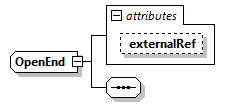 | ||||||||||||
| namespace | https://www.railml.org/schemas/3.2 | ||||||||||||
| attributes |
| ||||||||||||
| source | <xs:complexType name="OpenEnd"> <xs:sequence/> <xs:attribute name="externalRef" type="xs:string" use="optional"/> </xs:complexType> |
attribute OpenEnd/@externalRef
| type | xs:string | ||
| properties |
| ||
| source | <xs:attribute name="externalRef" type="xs:string" use="optional"/> |
complexType OpEquipment
| diagram | 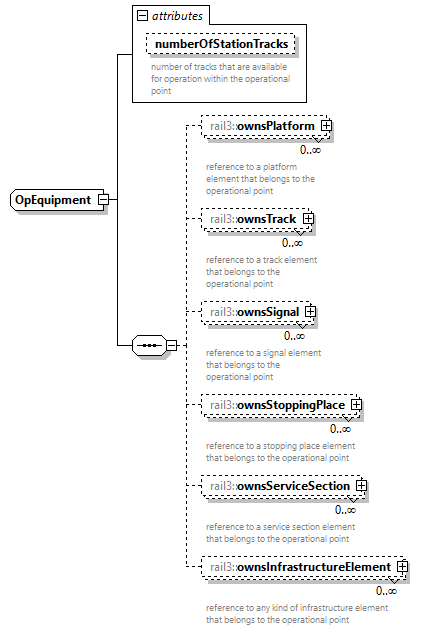 | ||||||||||||||
| namespace | https://www.railml.org/schemas/3.2 | ||||||||||||||
| children | rail3:ownsPlatform rail3:ownsTrack rail3:ownsSignal rail3:ownsStoppingPlace rail3:ownsServiceSection rail3:ownsInfrastructureElement | ||||||||||||||
| used by |
| ||||||||||||||
| attributes |
| ||||||||||||||
| source | <xs:complexType name="OpEquipment"> <xs:sequence> <xs:element name="ownsPlatform" type="rail3:tElementWithIDref" minOccurs="0" maxOccurs="unbounded"> <xs:annotation> <xs:documentation>reference to a platform element that belongs to the operational point</xs:documentation> </xs:annotation> </xs:element> <xs:element name="ownsTrack" type="rail3:tElementWithIDref" minOccurs="0" maxOccurs="unbounded"> <xs:annotation> <xs:documentation>reference to a track element that belongs to the operational point</xs:documentation> </xs:annotation> </xs:element> <xs:element name="ownsSignal" type="rail3:tElementWithIDref" minOccurs="0" maxOccurs="unbounded"> <xs:annotation> <xs:documentation>reference to a signal element that belongs to the operational point</xs:documentation> </xs:annotation> </xs:element> <xs:element name="ownsStoppingPlace" type="rail3:tElementWithIDref" minOccurs="0" maxOccurs="unbounded"> <xs:annotation> <xs:documentation>reference to a stopping place element that belongs to the operational point</xs:documentation> </xs:annotation> </xs:element> <xs:element name="ownsServiceSection" type="rail3:tElementWithIDref" minOccurs="0" maxOccurs="unbounded"> <xs:annotation> <xs:documentation>reference to a service section element that belongs to the operational point</xs:documentation> </xs:annotation> </xs:element> <xs:element name="ownsInfrastructureElement" type="rail3:tElementWithIDref" minOccurs="0" maxOccurs="unbounded"> <xs:annotation> <xs:documentation>reference to any kind of infrastructure element that belongs to the operational point</xs:documentation> </xs:annotation> </xs:element> </xs:sequence> <xs:attribute name="numberOfStationTracks" type="xs:positiveInteger" use="optional"> <xs:annotation> <xs:documentation>number of tracks that are available for operation within the operational point</xs:documentation> </xs:annotation> </xs:attribute> </xs:complexType> |
attribute OpEquipment/@numberOfStationTracks
| type | xs:positiveInteger | ||
| properties |
| ||
| annotation |
| ||
| source | <xs:attribute name="numberOfStationTracks" type="xs:positiveInteger" use="optional"> <xs:annotation> <xs:documentation>number of tracks that are available for operation within the operational point</xs:documentation> </xs:annotation> </xs:attribute> |
element OpEquipment/ownsPlatform
| diagram | 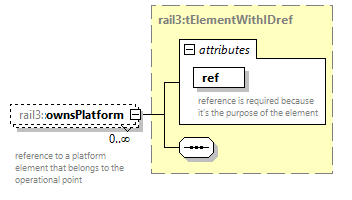 | ||||||||||||||
| namespace | https://www.railml.org/schemas/3.2 | ||||||||||||||
| type | rail3:tElementWithIDref | ||||||||||||||
| properties |
| ||||||||||||||
| attributes |
| ||||||||||||||
| annotation |
| ||||||||||||||
| source | <xs:element name="ownsPlatform" type="rail3:tElementWithIDref" minOccurs="0" maxOccurs="unbounded"> <xs:annotation> <xs:documentation>reference to a platform element that belongs to the operational point</xs:documentation> </xs:annotation> </xs:element> |
element OpEquipment/ownsTrack
| diagram | 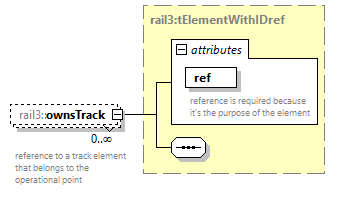 | ||||||||||||||
| namespace | https://www.railml.org/schemas/3.2 | ||||||||||||||
| type | rail3:tElementWithIDref | ||||||||||||||
| properties |
| ||||||||||||||
| attributes |
| ||||||||||||||
| annotation |
| ||||||||||||||
| source | <xs:element name="ownsTrack" type="rail3:tElementWithIDref" minOccurs="0" maxOccurs="unbounded"> <xs:annotation> <xs:documentation>reference to a track element that belongs to the operational point</xs:documentation> </xs:annotation> </xs:element> |
element OpEquipment/ownsSignal
| diagram | 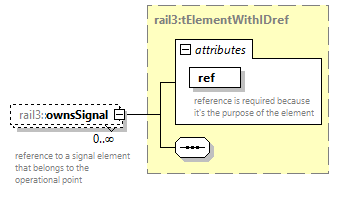 | ||||||||||||||
| namespace | https://www.railml.org/schemas/3.2 | ||||||||||||||
| type | rail3:tElementWithIDref | ||||||||||||||
| properties |
| ||||||||||||||
| attributes |
| ||||||||||||||
| annotation |
| ||||||||||||||
| source | <xs:element name="ownsSignal" type="rail3:tElementWithIDref" minOccurs="0" maxOccurs="unbounded"> <xs:annotation> <xs:documentation>reference to a signal element that belongs to the operational point</xs:documentation> </xs:annotation> </xs:element> |
element OpEquipment/ownsStoppingPlace
| diagram | 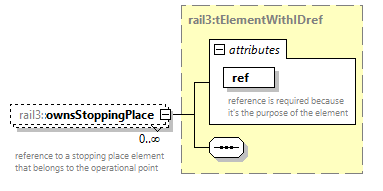 | ||||||||||||||
| namespace | https://www.railml.org/schemas/3.2 | ||||||||||||||
| type | rail3:tElementWithIDref | ||||||||||||||
| properties |
| ||||||||||||||
| attributes |
| ||||||||||||||
| annotation |
| ||||||||||||||
| source | <xs:element name="ownsStoppingPlace" type="rail3:tElementWithIDref" minOccurs="0" maxOccurs="unbounded"> <xs:annotation> <xs:documentation>reference to a stopping place element that belongs to the operational point</xs:documentation> </xs:annotation> </xs:element> |
element OpEquipment/ownsServiceSection
| diagram | 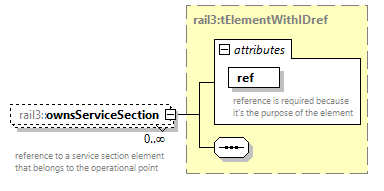 | ||||||||||||||
| namespace | https://www.railml.org/schemas/3.2 | ||||||||||||||
| type | rail3:tElementWithIDref | ||||||||||||||
| properties |
| ||||||||||||||
| attributes |
| ||||||||||||||
| annotation |
| ||||||||||||||
| source | <xs:element name="ownsServiceSection" type="rail3:tElementWithIDref" minOccurs="0" maxOccurs="unbounded"> <xs:annotation> <xs:documentation>reference to a service section element that belongs to the operational point</xs:documentation> </xs:annotation> </xs:element> |
element OpEquipment/ownsInfrastructureElement
| diagram | 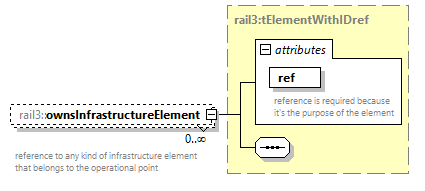 | ||||||||||||||
| namespace | https://www.railml.org/schemas/3.2 | ||||||||||||||
| type | rail3:tElementWithIDref | ||||||||||||||
| properties |
| ||||||||||||||
| attributes |
| ||||||||||||||
| annotation |
| ||||||||||||||
| source | <xs:element name="ownsInfrastructureElement" type="rail3:tElementWithIDref" minOccurs="0" maxOccurs="unbounded"> <xs:annotation> <xs:documentation>reference to any kind of infrastructure element that belongs to the operational point</xs:documentation> </xs:annotation> </xs:element> |
complexType OperationalPoint
| diagram |  | ||||||||||||||||||||||||||||||||||||||
| namespace | https://www.railml.org/schemas/3.2 | ||||||||||||||||||||||||||||||||||||||
| type | extension of rail3:FunctionalInfrastructureEntity | ||||||||||||||||||||||||||||||||||||||
| properties |
| ||||||||||||||||||||||||||||||||||||||
| children | rail3:name rail3:isValid rail3:areaLocation rail3:linearLocation rail3:spotLocation rail3:gmlLocations rail3:networkLocation rail3:designator rail3:external rail3:typeDesignator rail3:infrastructureManagerRef rail3:connectedToLine rail3:limitedByBorder rail3:opEquipment rail3:opOperations | ||||||||||||||||||||||||||||||||||||||
| used by |
| ||||||||||||||||||||||||||||||||||||||
| attributes |
| ||||||||||||||||||||||||||||||||||||||
| annotation |
| ||||||||||||||||||||||||||||||||||||||
| source | <xs:complexType name="OperationalPoint"> <xs:annotation> <xs:documentation>The OperationalPoint defines a point in the railway network that is essential for railway operation. Typical examples for railway operational points are stations, block signals or stopping points. Operational points allow an interaction between the railway operator and the train driver.</xs:documentation> </xs:annotation> <xs:complexContent> <xs:extension base="rail3:FunctionalInfrastructureEntity"> <xs:sequence> <xs:element name="infrastructureManagerRef" type="rail3:tElementWithIDref" minOccurs="0" maxOccurs="unbounded"/> <xs:element name="connectedToLine" type="rail3:tElementWithIDref" minOccurs="0" maxOccurs="unbounded"> <xs:annotation> <xs:documentation>reference to a railway line (section) that is connected with this operational point</xs:documentation> </xs:annotation> </xs:element> <xs:element name="limitedByBorder" type="rail3:tElementWithIDref" minOccurs="0" maxOccurs="unbounded"> <xs:annotation> <xs:documentation>reference to a border element that delimits the operational point</xs:documentation> </xs:annotation> </xs:element> <xs:element name="opEquipment" type="rail3:OpEquipment" minOccurs="0" maxOccurs="1"> <xs:annotation> <xs:documentation>child element summarizing the equipment of the operational point</xs:documentation> </xs:annotation> </xs:element> <xs:element name="opOperations" type="rail3:OpOperations" minOccurs="0" maxOccurs="1"> <xs:annotation> <xs:documentation>child element summarizing the operational aspects of the operational point</xs:documentation> </xs:annotation> </xs:element> </xs:sequence> <xs:attribute name="basedOnTemplate" type="rail3:tRef" use="optional"> <xs:annotation> <xs:documentation>references a generic operational point</xs:documentation> </xs:annotation> </xs:attribute> <xs:attribute name="belongsToParent" type="rail3:tRef" use="optional"> <xs:annotation> <xs:documentation>references the one and only parent operational point of this operational point
 
 - if some information exists in parent and child, then information in child overwrites it in child
 
 - if some information exists only in parent, then child inherits this information from parent</xs:documentation> </xs:annotation> </xs:attribute> <xs:attribute name="timezone" type="xs:string" use="optional"> <xs:annotation> <xs:documentation>the timezone of the operational point as defined in the tz database, e.g. "Europe/Berlin"</xs:documentation> </xs:annotation> </xs:attribute> </xs:extension> </xs:complexContent> </xs:complexType> |
attribute OperationalPoint/@basedOnTemplate
| type | rail3:tRef | ||
| properties |
| ||
| annotation |
| ||
| source | <xs:attribute name="basedOnTemplate" type="rail3:tRef" use="optional"> <xs:annotation> <xs:documentation>references a generic operational point</xs:documentation> </xs:annotation> </xs:attribute> |
attribute OperationalPoint/@belongsToParent
| type | rail3:tRef | ||
| properties |
| ||
| annotation |
| ||
| source | <xs:attribute name="belongsToParent" type="rail3:tRef" use="optional"> <xs:annotation> <xs:documentation>references the one and only parent operational point of this operational point
 
 - if some information exists in parent and child, then information in child overwrites it in child
 
 - if some information exists only in parent, then child inherits this information from parent</xs:documentation> </xs:annotation> </xs:attribute> |
attribute OperationalPoint/@timezone
| type | xs:string | ||
| properties |
| ||
| annotation |
| ||
| source | <xs:attribute name="timezone" type="xs:string" use="optional"> <xs:annotation> <xs:documentation>the timezone of the operational point as defined in the tz database, e.g. "Europe/Berlin"</xs:documentation> </xs:annotation> </xs:attribute> |
element OperationalPoint/infrastructureManagerRef
| diagram | 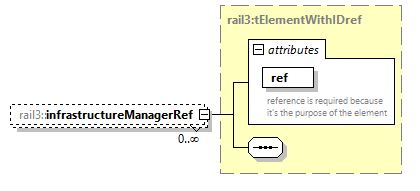 | ||||||||||||||
| namespace | https://www.railml.org/schemas/3.2 | ||||||||||||||
| type | rail3:tElementWithIDref | ||||||||||||||
| properties |
| ||||||||||||||
| attributes |
| ||||||||||||||
| source | <xs:element name="infrastructureManagerRef" type="rail3:tElementWithIDref" minOccurs="0" maxOccurs="unbounded"/> |
element OperationalPoint/connectedToLine
| diagram | 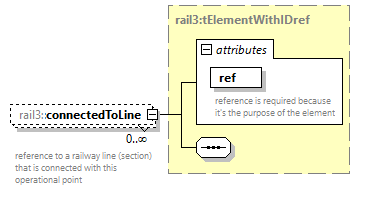 | ||||||||||||||
| namespace | https://www.railml.org/schemas/3.2 | ||||||||||||||
| type | rail3:tElementWithIDref | ||||||||||||||
| properties |
| ||||||||||||||
| attributes |
| ||||||||||||||
| annotation |
| ||||||||||||||
| source | <xs:element name="connectedToLine" type="rail3:tElementWithIDref" minOccurs="0" maxOccurs="unbounded"> <xs:annotation> <xs:documentation>reference to a railway line (section) that is connected with this operational point</xs:documentation> </xs:annotation> </xs:element> |
element OperationalPoint/limitedByBorder
| diagram | 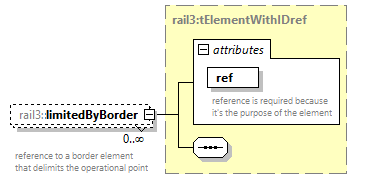 | ||||||||||||||
| namespace | https://www.railml.org/schemas/3.2 | ||||||||||||||
| type | rail3:tElementWithIDref | ||||||||||||||
| properties |
| ||||||||||||||
| attributes |
| ||||||||||||||
| annotation |
| ||||||||||||||
| source | <xs:element name="limitedByBorder" type="rail3:tElementWithIDref" minOccurs="0" maxOccurs="unbounded"> <xs:annotation> <xs:documentation>reference to a border element that delimits the operational point</xs:documentation> </xs:annotation> </xs:element> |
element OperationalPoint/opEquipment
| diagram | 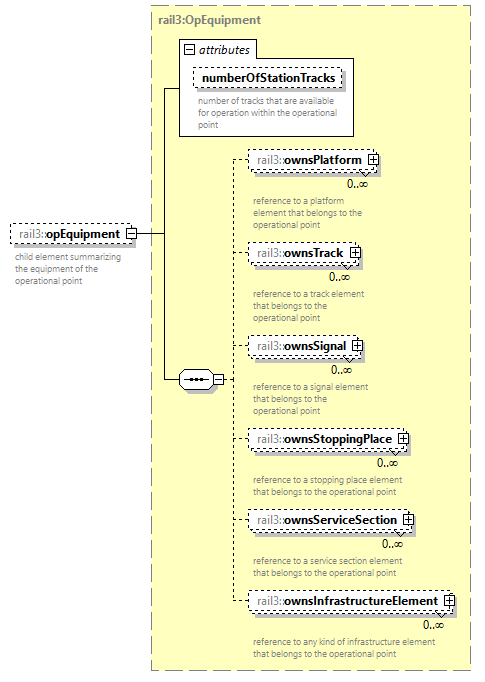 | ||||||||||||||
| namespace | https://www.railml.org/schemas/3.2 | ||||||||||||||
| type | rail3:OpEquipment | ||||||||||||||
| properties |
| ||||||||||||||
| children | rail3:ownsPlatform rail3:ownsTrack rail3:ownsSignal rail3:ownsStoppingPlace rail3:ownsServiceSection rail3:ownsInfrastructureElement | ||||||||||||||
| attributes |
| ||||||||||||||
| annotation |
| ||||||||||||||
| source | <xs:element name="opEquipment" type="rail3:OpEquipment" minOccurs="0" maxOccurs="1"> <xs:annotation> <xs:documentation>child element summarizing the equipment of the operational point</xs:documentation> </xs:annotation> </xs:element> |
element OperationalPoint/opOperations
| diagram |  | ||||||
| namespace | https://www.railml.org/schemas/3.2 | ||||||
| type | rail3:OpOperations | ||||||
| properties |
| ||||||
| children | rail3:opOperation | ||||||
| annotation |
| ||||||
| source | <xs:element name="opOperations" type="rail3:OpOperations" minOccurs="0" maxOccurs="1"> <xs:annotation> <xs:documentation>child element summarizing the operational aspects of the operational point</xs:documentation> </xs:annotation> </xs:element> |
complexType OperationalPoints
| diagram |  | ||
| namespace | https://www.railml.org/schemas/3.2 | ||
| children | rail3:operationalPoint | ||
| used by |
| ||
| source | <xs:complexType name="OperationalPoints"> <xs:sequence> <xs:element name="operationalPoint" type="rail3:OperationalPoint" minOccurs="1" maxOccurs="unbounded"/> </xs:sequence> </xs:complexType> |
element OperationalPoints/operationalPoint
| diagram |  | ||||||||||||||||||||||||||||||||||||||
| namespace | https://www.railml.org/schemas/3.2 | ||||||||||||||||||||||||||||||||||||||
| type | rail3:OperationalPoint | ||||||||||||||||||||||||||||||||||||||
| properties |
| ||||||||||||||||||||||||||||||||||||||
| children | rail3:name rail3:isValid rail3:areaLocation rail3:linearLocation rail3:spotLocation rail3:gmlLocations rail3:networkLocation rail3:designator rail3:external rail3:typeDesignator rail3:infrastructureManagerRef rail3:connectedToLine rail3:limitedByBorder rail3:opEquipment rail3:opOperations | ||||||||||||||||||||||||||||||||||||||
| attributes |
| ||||||||||||||||||||||||||||||||||||||
| source | <xs:element name="operationalPoint" type="rail3:OperationalPoint" minOccurs="1" maxOccurs="unbounded"/> |
complexType OpOperation
| diagram | 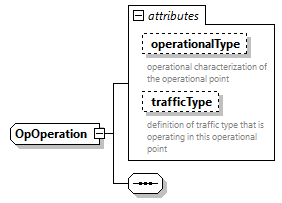 | ||||||||||||||||||||||
| namespace | https://www.railml.org/schemas/3.2 | ||||||||||||||||||||||
| used by |
| ||||||||||||||||||||||
| attributes |
| ||||||||||||||||||||||
| source | <xs:complexType name="OpOperation"> <xs:sequence/> <xs:attribute name="operationalType" type="rail3:tOpOperationalTypeExt" use="optional"> <xs:annotation> <xs:documentation>operational characterization of the operational point</xs:documentation> </xs:annotation> </xs:attribute> <xs:attribute name="trafficType" type="rail3:tOpTrafficTypeExt" use="optional"> <xs:annotation> <xs:documentation>definition of traffic type that is operating in this operational point</xs:documentation> </xs:annotation> </xs:attribute> </xs:complexType> |
attribute OpOperation/@operationalType
| type | rail3:tOpOperationalTypeExt | ||
| properties |
| ||
| annotation |
| ||
| source | <xs:attribute name="operationalType" type="rail3:tOpOperationalTypeExt" use="optional"> <xs:annotation> <xs:documentation>operational characterization of the operational point</xs:documentation> </xs:annotation> </xs:attribute> |
attribute OpOperation/@trafficType
| type | rail3:tOpTrafficTypeExt | ||
| properties |
| ||
| annotation |
| ||
| source | <xs:attribute name="trafficType" type="rail3:tOpTrafficTypeExt" use="optional"> <xs:annotation> <xs:documentation>definition of traffic type that is operating in this operational point</xs:documentation> </xs:annotation> </xs:attribute> |
complexType OpOperations
| diagram |  | ||
| namespace | https://www.railml.org/schemas/3.2 | ||
| children | rail3:opOperation | ||
| used by |
| ||
| source | <xs:complexType name="OpOperations"> <xs:sequence> <xs:element name="opOperation" type="rail3:OpOperation" minOccurs="1" maxOccurs="unbounded"> <xs:annotation> <xs:documentation>railway operation</xs:documentation> </xs:annotation> </xs:element> </xs:sequence> </xs:complexType> |
element OpOperations/opOperation
| diagram | 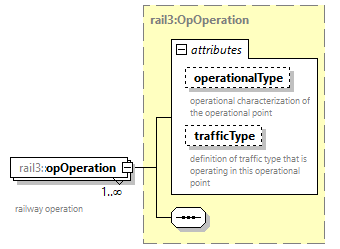 | ||||||||||||||||||||||
| namespace | https://www.railml.org/schemas/3.2 | ||||||||||||||||||||||
| type | rail3:OpOperation | ||||||||||||||||||||||
| properties |
| ||||||||||||||||||||||
| attributes |
| ||||||||||||||||||||||
| annotation |
| ||||||||||||||||||||||
| source | <xs:element name="opOperation" type="rail3:OpOperation" minOccurs="1" maxOccurs="unbounded"> <xs:annotation> <xs:documentation>railway operation</xs:documentation> </xs:annotation> </xs:element> |
complexType OverCrossing
| diagram |  | ||||||||||||||||||||||||||||||||||||||
| namespace | https://www.railml.org/schemas/3.2 | ||||||||||||||||||||||||||||||||||||||
| type | extension of rail3:XCrossing | ||||||||||||||||||||||||||||||||||||||
| properties |
| ||||||||||||||||||||||||||||||||||||||
| children | rail3:name rail3:isValid rail3:areaLocation rail3:linearLocation rail3:spotLocation rail3:gmlLocations rail3:networkLocation rail3:designator rail3:external rail3:typeDesignator rail3:crossesElement rail3:allowedLoadingGauge rail3:length | ||||||||||||||||||||||||||||||||||||||
| used by |
| ||||||||||||||||||||||||||||||||||||||
| attributes |
| ||||||||||||||||||||||||||||||||||||||
| annotation |
| ||||||||||||||||||||||||||||||||||||||
| source | <xs:complexType name="OverCrossing"> <xs:annotation> <xs:documentation>An over crossing describes a crossing, where something crosses over the railway line. From constructional point of view an over crossing can be a bridge or a tunnel.</xs:documentation> </xs:annotation> <xs:complexContent> <xs:extension base="rail3:XCrossing"> <xs:sequence> <xs:element name="allowedLoadingGauge" type="rail3:tElementWithIDref" minOccurs="0" maxOccurs="unbounded"> <xs:annotation> <xs:documentation>reference to train clearance gauge classes that are allowed to pass through the over crossing</xs:documentation> </xs:annotation> </xs:element> <xs:element name="length" type="rail3:Length" minOccurs="0" maxOccurs="unbounded"> <xs:annotation> <xs:documentation>length of the over crossing relative to the railway in metres</xs:documentation> </xs:annotation> </xs:element> </xs:sequence> <xs:attribute name="belongsToParent" type="rail3:tRef" use="optional"> <xs:annotation> <xs:documentation>reference to a parent over crossing
 
 - if some information exists in parent and child, then information in child overwrites it in child
 
 - if some information exists only in parent, then child inherits this information from parent</xs:documentation> </xs:annotation> </xs:attribute> <xs:attribute name="constructionType" type="rail3:tCrossingConstructionTypeExt" use="required"> <xs:annotation> <xs:documentation>construction type of over crossing: bridge or tunnel</xs:documentation> </xs:annotation> </xs:attribute> <xs:attributeGroup ref="rail3:aVerbalConstraint"/> </xs:extension> </xs:complexContent> </xs:complexType> |
attribute OverCrossing/@belongsToParent
| type | rail3:tRef | ||
| properties |
| ||
| annotation |
| ||
| source | <xs:attribute name="belongsToParent" type="rail3:tRef" use="optional"> <xs:annotation> <xs:documentation>reference to a parent over crossing
 
 - if some information exists in parent and child, then information in child overwrites it in child
 
 - if some information exists only in parent, then child inherits this information from parent</xs:documentation> </xs:annotation> </xs:attribute> |
attribute OverCrossing/@constructionType
| type | rail3:tCrossingConstructionTypeExt | ||
| properties |
| ||
| annotation |
| ||
| source | <xs:attribute name="constructionType" type="rail3:tCrossingConstructionTypeExt" use="required"> <xs:annotation> <xs:documentation>construction type of over crossing: bridge or tunnel</xs:documentation> </xs:annotation> </xs:attribute> |
element OverCrossing/allowedLoadingGauge
| diagram | 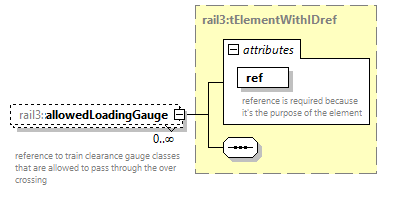 | ||||||||||||||
| namespace | https://www.railml.org/schemas/3.2 | ||||||||||||||
| type | rail3:tElementWithIDref | ||||||||||||||
| properties |
| ||||||||||||||
| attributes |
| ||||||||||||||
| annotation |
| ||||||||||||||
| source | <xs:element name="allowedLoadingGauge" type="rail3:tElementWithIDref" minOccurs="0" maxOccurs="unbounded"> <xs:annotation> <xs:documentation>reference to train clearance gauge classes that are allowed to pass through the over crossing</xs:documentation> </xs:annotation> </xs:element> |
element OverCrossing/length
| diagram | 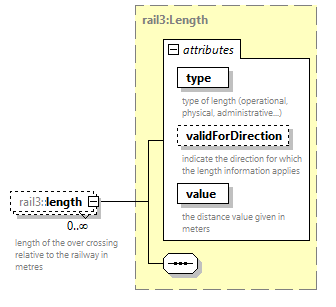 | ||||||||||||||||||||||||||||||
| namespace | https://www.railml.org/schemas/3.2 | ||||||||||||||||||||||||||||||
| type | rail3:Length | ||||||||||||||||||||||||||||||
| properties |
| ||||||||||||||||||||||||||||||
| attributes |
| ||||||||||||||||||||||||||||||
| annotation |
| ||||||||||||||||||||||||||||||
| source | <xs:element name="length" type="rail3:Length" minOccurs="0" maxOccurs="unbounded"> <xs:annotation> <xs:documentation>length of the over crossing relative to the railway in metres</xs:documentation> </xs:annotation> </xs:element> |
complexType OverCrossings
| diagram |  | ||
| namespace | https://www.railml.org/schemas/3.2 | ||
| children | rail3:overCrossing | ||
| used by |
| ||
| source | <xs:complexType name="OverCrossings"> <xs:sequence> <xs:element name="overCrossing" type="rail3:OverCrossing" minOccurs="1" maxOccurs="unbounded"/> </xs:sequence> </xs:complexType> |
element OverCrossings/overCrossing
| diagram |  | ||||||||||||||||||||||||||||||||||||||
| namespace | https://www.railml.org/schemas/3.2 | ||||||||||||||||||||||||||||||||||||||
| type | rail3:OverCrossing | ||||||||||||||||||||||||||||||||||||||
| properties |
| ||||||||||||||||||||||||||||||||||||||
| children | rail3:name rail3:isValid rail3:areaLocation rail3:linearLocation rail3:spotLocation rail3:gmlLocations rail3:networkLocation rail3:designator rail3:external rail3:typeDesignator rail3:crossesElement rail3:allowedLoadingGauge rail3:length | ||||||||||||||||||||||||||||||||||||||
| attributes |
| ||||||||||||||||||||||||||||||||||||||
| source | <xs:element name="overCrossing" type="rail3:OverCrossing" minOccurs="1" maxOccurs="unbounded"/> |
complexType PantographSpacing
| diagram | 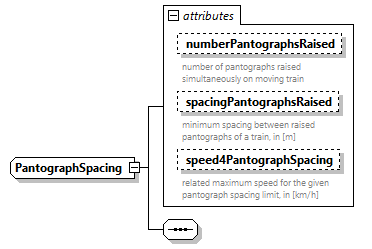 | ||||||||||||||||||||||||||||||
| namespace | https://www.railml.org/schemas/3.2 | ||||||||||||||||||||||||||||||
| used by |
| ||||||||||||||||||||||||||||||
| attributes |
| ||||||||||||||||||||||||||||||
| source | <xs:complexType name="PantographSpacing"> <xs:sequence/> <xs:attribute name="numberPantographsRaised" type="xs:integer" use="optional"> <xs:annotation> <xs:documentation>number of pantographs raised simultaneously on moving train</xs:documentation> </xs:annotation> </xs:attribute> <xs:attribute name="spacingPantographsRaised" type="rail3:tLengthM" use="optional"> <xs:annotation> <xs:documentation>minimum spacing between raised pantographs of a train, in [m]</xs:documentation> </xs:annotation> </xs:attribute> <xs:attribute name="speed4PantographSpacing" type="rail3:tSpeedKmPerHour" use="optional"> <xs:annotation> <xs:documentation>related maximum speed for the given pantograph spacing limit, in [km/h]</xs:documentation> </xs:annotation> </xs:attribute> </xs:complexType> |
attribute PantographSpacing/@numberPantographsRaised
| type | xs:integer | ||
| properties |
| ||
| annotation |
| ||
| source | <xs:attribute name="numberPantographsRaised" type="xs:integer" use="optional"> <xs:annotation> <xs:documentation>number of pantographs raised simultaneously on moving train</xs:documentation> </xs:annotation> </xs:attribute> |
attribute PantographSpacing/@spacingPantographsRaised
| type | rail3:tLengthM | ||
| properties |
| ||
| annotation |
| ||
| source | <xs:attribute name="spacingPantographsRaised" type="rail3:tLengthM" use="optional"> <xs:annotation> <xs:documentation>minimum spacing between raised pantographs of a train, in [m]</xs:documentation> </xs:annotation> </xs:attribute> |
attribute PantographSpacing/@speed4PantographSpacing
| type | rail3:tSpeedKmPerHour | ||
| properties |
| ||
| annotation |
| ||
| source | <xs:attribute name="speed4PantographSpacing" type="rail3:tSpeedKmPerHour" use="optional"> <xs:annotation> <xs:documentation>related maximum speed for the given pantograph spacing limit, in [km/h]</xs:documentation> </xs:annotation> </xs:attribute> |
complexType PhaseSeparationSection
| diagram | 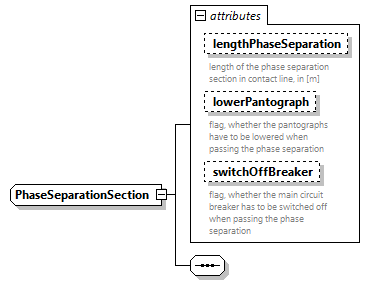 | ||||||||||||||||||||||||||||||
| namespace | https://www.railml.org/schemas/3.2 | ||||||||||||||||||||||||||||||
| used by |
| ||||||||||||||||||||||||||||||
| attributes |
| ||||||||||||||||||||||||||||||
| source | <xs:complexType name="PhaseSeparationSection"> <xs:sequence/> <xs:attribute name="lengthPhaseSeparation" type="rail3:tLengthM" use="optional"> <xs:annotation> <xs:documentation>length of the phase separation section in contact line, in [m]</xs:documentation> </xs:annotation> </xs:attribute> <xs:attribute name="lowerPantograph" type="xs:boolean" use="optional"> <xs:annotation> <xs:documentation>flag, whether the pantographs have to be lowered when passing the phase separation</xs:documentation> </xs:annotation> </xs:attribute> <xs:attribute name="switchOffBreaker" type="xs:boolean" use="optional"> <xs:annotation> <xs:documentation>flag, whether the main circuit breaker has to be switched off when passing the phase separation</xs:documentation> </xs:annotation> </xs:attribute> </xs:complexType> |
attribute PhaseSeparationSection/@lengthPhaseSeparation
| type | rail3:tLengthM | ||
| properties |
| ||
| annotation |
| ||
| source | <xs:attribute name="lengthPhaseSeparation" type="rail3:tLengthM" use="optional"> <xs:annotation> <xs:documentation>length of the phase separation section in contact line, in [m]</xs:documentation> </xs:annotation> </xs:attribute> |
attribute PhaseSeparationSection/@lowerPantograph
| type | xs:boolean | ||
| properties |
| ||
| annotation |
| ||
| source | <xs:attribute name="lowerPantograph" type="xs:boolean" use="optional"> <xs:annotation> <xs:documentation>flag, whether the pantographs have to be lowered when passing the phase separation</xs:documentation> </xs:annotation> </xs:attribute> |
attribute PhaseSeparationSection/@switchOffBreaker
| type | xs:boolean | ||
| properties |
| ||
| annotation |
| ||
| source | <xs:attribute name="switchOffBreaker" type="xs:boolean" use="optional"> <xs:annotation> <xs:documentation>flag, whether the main circuit breaker has to be switched off when passing the phase separation</xs:documentation> </xs:annotation> </xs:attribute> |
complexType PhysicalFacilities
| diagram | 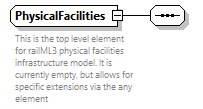 | ||
| namespace | https://www.railml.org/schemas/3.2 | ||
| used by |
| ||
| annotation |
| ||
| source | <xs:complexType name="PhysicalFacilities"> <xs:annotation> <xs:documentation>This is the top level element for railML3 physical facilities infrastructure model. It is currently empty, but allows for specific extensions via the any element</xs:documentation> </xs:annotation> <xs:sequence/> </xs:complexType> |
complexType Platform
| diagram |  | ||||||||||||||||||||||||||||||||||||||
| namespace | https://www.railml.org/schemas/3.2 | ||||||||||||||||||||||||||||||||||||||
| type | extension of rail3:FunctionalInfrastructureEntity | ||||||||||||||||||||||||||||||||||||||
| properties |
| ||||||||||||||||||||||||||||||||||||||
| children | rail3:name rail3:isValid rail3:areaLocation rail3:linearLocation rail3:spotLocation rail3:gmlLocations rail3:networkLocation rail3:designator rail3:external rail3:typeDesignator rail3:ownsPlatformEdge rail3:width rail3:length | ||||||||||||||||||||||||||||||||||||||
| used by |
| ||||||||||||||||||||||||||||||||||||||
| attributes |
| ||||||||||||||||||||||||||||||||||||||
| annotation |
| ||||||||||||||||||||||||||||||||||||||
| source | <xs:complexType name="Platform"> <xs:annotation> <xs:documentation>railway infrastructure facility located at a station or at a stopping point and designed for safe and convenient passenger service – boarding or leaving passenger train, as well as short-term waiting for a train [Organization for Cooperation of Railways].</xs:documentation> </xs:annotation> <xs:complexContent> <xs:extension base="rail3:FunctionalInfrastructureEntity"> <xs:sequence> <xs:element name="ownsPlatformEdge" type="rail3:tElementWithIDref" minOccurs="0" maxOccurs="unbounded"> <xs:annotation> <xs:documentation>reference to platform edge that belongs to this platform</xs:documentation> </xs:annotation> </xs:element> <xs:element name="width" type="rail3:Length" minOccurs="0" maxOccurs="unbounded"> <xs:annotation> <xs:documentation>width of the platform</xs:documentation> </xs:annotation> </xs:element> <xs:element name="length" type="rail3:Length" minOccurs="0" maxOccurs="unbounded"> <xs:annotation> <xs:documentation>DEPRECATED, use element platformEdge instead,
 length of the platform (edge)</xs:documentation> </xs:annotation> </xs:element> </xs:sequence> <xs:attribute name="basedOnTemplate" type="rail3:tRef" use="optional"> <xs:annotation> <xs:documentation>reference to a template platform</xs:documentation> </xs:annotation> </xs:attribute> <xs:attribute name="belongsToParent" type="rail3:tRef" use="optional"> <xs:annotation> <xs:documentation>reference to a parent platform;
 use this attribute for grouping of platforms with different parameters
 
 - if some information exists in parent and child, then information in child overwrites it in child
 
 - if some information exists only in parent, then child inherits this information from parent</xs:documentation> </xs:annotation> </xs:attribute> <xs:attribute name="height" type="rail3:tLengthM" use="optional"> <xs:annotation> <xs:documentation>DEPRECATED, use element platformEdge instead
 the height of the platform edge in metres</xs:documentation> </xs:annotation> </xs:attribute> </xs:extension> </xs:complexContent> </xs:complexType> |
attribute Platform/@basedOnTemplate
| type | rail3:tRef | ||
| properties |
| ||
| annotation |
| ||
| source | <xs:attribute name="basedOnTemplate" type="rail3:tRef" use="optional"> <xs:annotation> <xs:documentation>reference to a template platform</xs:documentation> </xs:annotation> </xs:attribute> |
attribute Platform/@belongsToParent
| type | rail3:tRef | ||
| properties |
| ||
| annotation |
| ||
| source | <xs:attribute name="belongsToParent" type="rail3:tRef" use="optional"> <xs:annotation> <xs:documentation>reference to a parent platform;
 use this attribute for grouping of platforms with different parameters
 
 - if some information exists in parent and child, then information in child overwrites it in child
 
 - if some information exists only in parent, then child inherits this information from parent</xs:documentation> </xs:annotation> </xs:attribute> |
attribute Platform/@height
| type | rail3:tLengthM | ||
| properties |
| ||
| annotation |
| ||
| source | <xs:attribute name="height" type="rail3:tLengthM" use="optional"> <xs:annotation> <xs:documentation>DEPRECATED, use element platformEdge instead
 the height of the platform edge in metres</xs:documentation> </xs:annotation> </xs:attribute> |
element Platform/ownsPlatformEdge
| diagram | 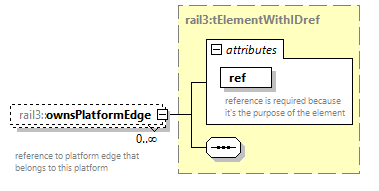 | ||||||||||||||
| namespace | https://www.railml.org/schemas/3.2 | ||||||||||||||
| type | rail3:tElementWithIDref | ||||||||||||||
| properties |
| ||||||||||||||
| attributes |
| ||||||||||||||
| annotation |
| ||||||||||||||
| source | <xs:element name="ownsPlatformEdge" type="rail3:tElementWithIDref" minOccurs="0" maxOccurs="unbounded"> <xs:annotation> <xs:documentation>reference to platform edge that belongs to this platform</xs:documentation> </xs:annotation> </xs:element> |
element Platform/width
| diagram | 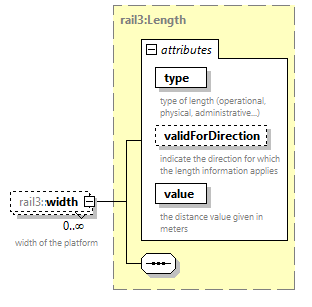 | ||||||||||||||||||||||||||||||
| namespace | https://www.railml.org/schemas/3.2 | ||||||||||||||||||||||||||||||
| type | rail3:Length | ||||||||||||||||||||||||||||||
| properties |
| ||||||||||||||||||||||||||||||
| attributes |
| ||||||||||||||||||||||||||||||
| annotation |
| ||||||||||||||||||||||||||||||
| source | <xs:element name="width" type="rail3:Length" minOccurs="0" maxOccurs="unbounded"> <xs:annotation> <xs:documentation>width of the platform</xs:documentation> </xs:annotation> </xs:element> |
element Platform/length
| diagram | 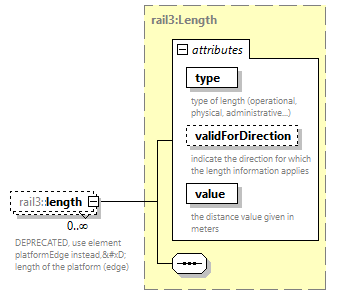 | ||||||||||||||||||||||||||||||
| namespace | https://www.railml.org/schemas/3.2 | ||||||||||||||||||||||||||||||
| type | rail3:Length | ||||||||||||||||||||||||||||||
| properties |
| ||||||||||||||||||||||||||||||
| attributes |
| ||||||||||||||||||||||||||||||
| annotation |
| ||||||||||||||||||||||||||||||
| source | <xs:element name="length" type="rail3:Length" minOccurs="0" maxOccurs="unbounded"> <xs:annotation> <xs:documentation>DEPRECATED, use element platformEdge instead,
 length of the platform (edge)</xs:documentation> </xs:annotation> </xs:element> |
complexType PlatformEdge
| diagram |  | ||||||||||||||||||||||||||||||||||||||
| namespace | https://www.railml.org/schemas/3.2 | ||||||||||||||||||||||||||||||||||||||
| type | extension of rail3:FunctionalInfrastructureEntity | ||||||||||||||||||||||||||||||||||||||
| properties |
| ||||||||||||||||||||||||||||||||||||||
| children | rail3:name rail3:isValid rail3:areaLocation rail3:linearLocation rail3:spotLocation rail3:gmlLocations rail3:networkLocation rail3:designator rail3:external rail3:typeDesignator rail3:length | ||||||||||||||||||||||||||||||||||||||
| used by |
| ||||||||||||||||||||||||||||||||||||||
| attributes |
| ||||||||||||||||||||||||||||||||||||||
| annotation |
| ||||||||||||||||||||||||||||||||||||||
| source | <xs:complexType name="PlatformEdge"> <xs:annotation> <xs:documentation>A platform edge is the interface between passenger train and station. Platform edges are also modeled with the platform element.</xs:documentation> </xs:annotation> <xs:complexContent> <xs:extension base="rail3:FunctionalInfrastructureEntity"> <xs:sequence> <xs:element name="length" type="rail3:Length" minOccurs="0" maxOccurs="unbounded"> <xs:annotation> <xs:documentation>length of the platform edge in meters</xs:documentation> </xs:annotation> </xs:element> </xs:sequence> <xs:attribute name="belongsToParent" type="rail3:tRef" use="optional"> <xs:annotation> <xs:documentation>reference to a parent platform edge,
 use this attribute for grouping of platform edges with different parameters (e.g. different heights)
 
 - if some information exists in parent and child, then information in child overwrites it in child
 
 - if some information exists only in parent, then child inherits this information from parent</xs:documentation> </xs:annotation> </xs:attribute> <xs:attribute name="belongsToPlatform" type="rail3:tRef" use="optional"> <xs:annotation> <xs:documentation>reference to a platform the edge belongs to</xs:documentation> </xs:annotation> </xs:attribute> <xs:attribute name="height" type="rail3:tLengthM" use="optional"> <xs:annotation> <xs:documentation>height of the platform edge in meters</xs:documentation> </xs:annotation> </xs:attribute> </xs:extension> </xs:complexContent> </xs:complexType> |
attribute PlatformEdge/@belongsToParent
| type | rail3:tRef | ||
| properties |
| ||
| annotation |
| ||
| source | <xs:attribute name="belongsToParent" type="rail3:tRef" use="optional"> <xs:annotation> <xs:documentation>reference to a parent platform edge,
 use this attribute for grouping of platform edges with different parameters (e.g. different heights)
 
 - if some information exists in parent and child, then information in child overwrites it in child
 
 - if some information exists only in parent, then child inherits this information from parent</xs:documentation> </xs:annotation> </xs:attribute> |
attribute PlatformEdge/@belongsToPlatform
| type | rail3:tRef | ||
| properties |
| ||
| annotation |
| ||
| source | <xs:attribute name="belongsToPlatform" type="rail3:tRef" use="optional"> <xs:annotation> <xs:documentation>reference to a platform the edge belongs to</xs:documentation> </xs:annotation> </xs:attribute> |
attribute PlatformEdge/@height
| type | rail3:tLengthM | ||
| properties |
| ||
| annotation |
| ||
| source | <xs:attribute name="height" type="rail3:tLengthM" use="optional"> <xs:annotation> <xs:documentation>height of the platform edge in meters</xs:documentation> </xs:annotation> </xs:attribute> |
element PlatformEdge/length
| diagram | 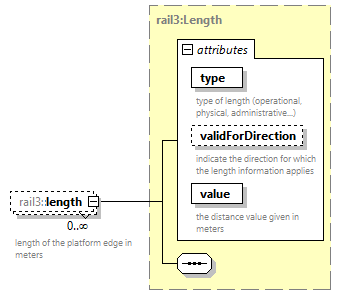 | ||||||||||||||||||||||||||||||
| namespace | https://www.railml.org/schemas/3.2 | ||||||||||||||||||||||||||||||
| type | rail3:Length | ||||||||||||||||||||||||||||||
| properties |
| ||||||||||||||||||||||||||||||
| attributes |
| ||||||||||||||||||||||||||||||
| annotation |
| ||||||||||||||||||||||||||||||
| source | <xs:element name="length" type="rail3:Length" minOccurs="0" maxOccurs="unbounded"> <xs:annotation> <xs:documentation>length of the platform edge in meters</xs:documentation> </xs:annotation> </xs:element> |
complexType PlatformEdges
| diagram | 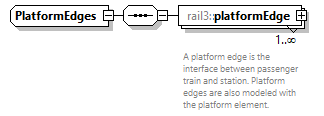 | ||
| namespace | https://www.railml.org/schemas/3.2 | ||
| children | rail3:platformEdge | ||
| used by |
| ||
| source | <xs:complexType name="PlatformEdges"> <xs:sequence> <xs:element name="platformEdge" type="rail3:PlatformEdge" minOccurs="1" maxOccurs="unbounded"> <xs:annotation> <xs:documentation>A platform edge is the interface between passenger train and station. Platform edges are also modeled with the platform element.</xs:documentation> </xs:annotation> </xs:element> </xs:sequence> </xs:complexType> |
element PlatformEdges/platformEdge
| diagram |  | ||||||||||||||||||||||||||||||||||||||
| namespace | https://www.railml.org/schemas/3.2 | ||||||||||||||||||||||||||||||||||||||
| type | rail3:PlatformEdge | ||||||||||||||||||||||||||||||||||||||
| properties |
| ||||||||||||||||||||||||||||||||||||||
| children | rail3:name rail3:isValid rail3:areaLocation rail3:linearLocation rail3:spotLocation rail3:gmlLocations rail3:networkLocation rail3:designator rail3:external rail3:typeDesignator rail3:length | ||||||||||||||||||||||||||||||||||||||
| attributes |
| ||||||||||||||||||||||||||||||||||||||
| annotation |
| ||||||||||||||||||||||||||||||||||||||
| source | <xs:element name="platformEdge" type="rail3:PlatformEdge" minOccurs="1" maxOccurs="unbounded"> <xs:annotation> <xs:documentation>A platform edge is the interface between passenger train and station. Platform edges are also modeled with the platform element.</xs:documentation> </xs:annotation> </xs:element> |
complexType Platforms
| diagram | 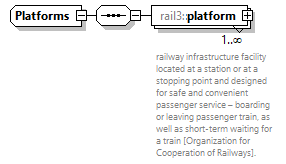 | ||
| namespace | https://www.railml.org/schemas/3.2 | ||
| children | rail3:platform | ||
| used by |
| ||
| source | <xs:complexType name="Platforms"> <xs:sequence> <xs:element name="platform" type="rail3:Platform" minOccurs="1" maxOccurs="unbounded"> <xs:annotation> <xs:documentation>railway infrastructure facility located at a station or at a stopping point and designed for safe and convenient passenger service – boarding or leaving passenger train, as well as short-term waiting for a train [Organization for Cooperation of Railways].</xs:documentation> </xs:annotation> </xs:element> </xs:sequence> </xs:complexType> |
element Platforms/platform
| diagram |  | ||||||||||||||||||||||||||||||||||||||
| namespace | https://www.railml.org/schemas/3.2 | ||||||||||||||||||||||||||||||||||||||
| type | rail3:Platform | ||||||||||||||||||||||||||||||||||||||
| properties |
| ||||||||||||||||||||||||||||||||||||||
| children | rail3:name rail3:isValid rail3:areaLocation rail3:linearLocation rail3:spotLocation rail3:gmlLocations rail3:networkLocation rail3:designator rail3:external rail3:typeDesignator rail3:ownsPlatformEdge rail3:width rail3:length | ||||||||||||||||||||||||||||||||||||||
| attributes |
| ||||||||||||||||||||||||||||||||||||||
| annotation |
| ||||||||||||||||||||||||||||||||||||||
| source | <xs:element name="platform" type="rail3:Platform" minOccurs="1" maxOccurs="unbounded"> <xs:annotation> <xs:documentation>railway infrastructure facility located at a station or at a stopping point and designed for safe and convenient passenger service – boarding or leaving passenger train, as well as short-term waiting for a train [Organization for Cooperation of Railways].</xs:documentation> </xs:annotation> </xs:element> |
complexType PointTypeCoordinate
| diagram | 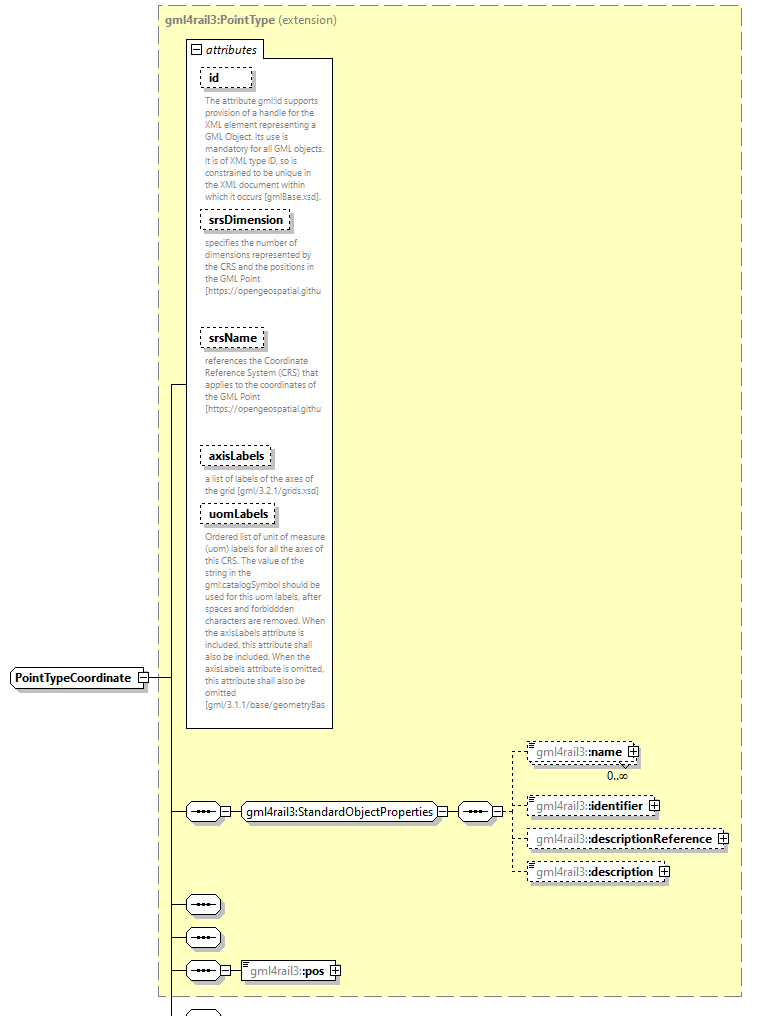 | ||||||||||||||||||||||||||||||||||||||||||||||
| namespace | https://www.railml.org/schemas/3.2 | ||||||||||||||||||||||||||||||||||||||||||||||
| type | extension of gml4rail3:PointType | ||||||||||||||||||||||||||||||||||||||||||||||
| properties |
| ||||||||||||||||||||||||||||||||||||||||||||||
| children | gml4rail3:name gml4rail3:identifier gml4rail3:descriptionReference gml4rail3:description gml4rail3:pos | ||||||||||||||||||||||||||||||||||||||||||||||
| used by |
| ||||||||||||||||||||||||||||||||||||||||||||||
| attributes |
| ||||||||||||||||||||||||||||||||||||||||||||||
| source | <xs:complexType name="PointTypeCoordinate"> <xs:complexContent> <xs:extension base="gml4rail3:PointType"> <xs:sequence/> </xs:extension> </xs:complexContent> </xs:complexType> |
complexType Polygon
| diagram |  | ||
| namespace | https://www.railml.org/schemas/3.2 | ||
| children | rail3:shape | ||
| used by |
| ||
| annotation |
| ||
| source | <xs:complexType name="Polygon"> <xs:annotation> <xs:documentation>Defines a polygon shape for the area location.</xs:documentation> </xs:annotation> <xs:sequence> <xs:element name="shape" type="rail3:LineTypeCoordinate" minOccurs="1" maxOccurs="1"> <xs:annotation> <xs:documentation>a graphical representation of an object's external boundary [Wikipedia]</xs:documentation> </xs:annotation> </xs:element> </xs:sequence> </xs:complexType> |
element Polygon/shape
| diagram | 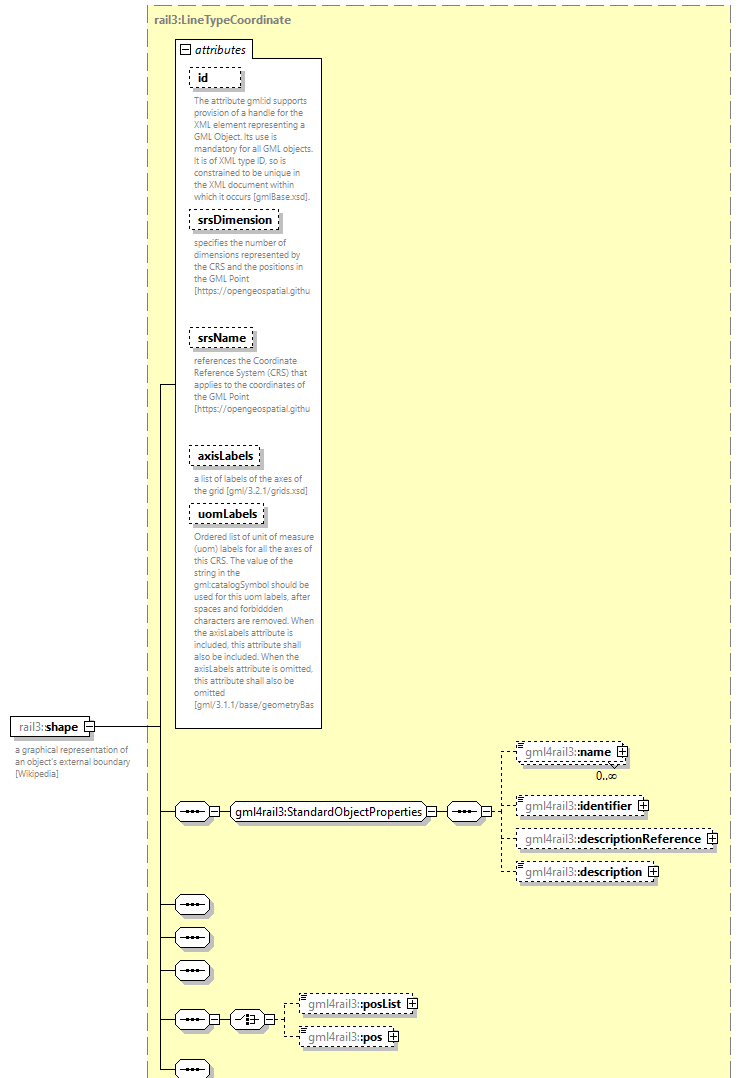 | ||||||||||||||||||||||||||||||||||||||||||||||
| namespace | https://www.railml.org/schemas/3.2 | ||||||||||||||||||||||||||||||||||||||||||||||
| type | rail3:LineTypeCoordinate | ||||||||||||||||||||||||||||||||||||||||||||||
| properties |
| ||||||||||||||||||||||||||||||||||||||||||||||
| children | gml4rail3:name gml4rail3:identifier gml4rail3:descriptionReference gml4rail3:description gml4rail3:posList gml4rail3:pos | ||||||||||||||||||||||||||||||||||||||||||||||
| attributes |
| ||||||||||||||||||||||||||||||||||||||||||||||
| annotation |
| ||||||||||||||||||||||||||||||||||||||||||||||
| source | <xs:element name="shape" type="rail3:LineTypeCoordinate" minOccurs="1" maxOccurs="1"> <xs:annotation> <xs:documentation>a graphical representation of an object's external boundary [Wikipedia]</xs:documentation> </xs:annotation> </xs:element> |
complexType RbcBorder
| diagram | 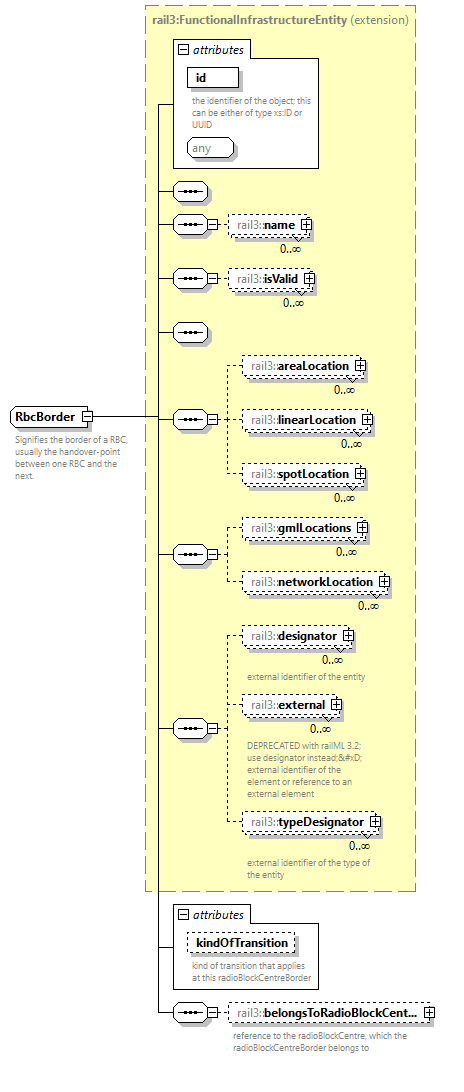 | ||||||||||||||||||||||
| namespace | https://www.railml.org/schemas/3.2 | ||||||||||||||||||||||
| type | extension of rail3:FunctionalInfrastructureEntity | ||||||||||||||||||||||
| properties |
| ||||||||||||||||||||||
| children | rail3:name rail3:isValid rail3:areaLocation rail3:linearLocation rail3:spotLocation rail3:gmlLocations rail3:networkLocation rail3:designator rail3:external rail3:typeDesignator rail3:belongsToRadioBlockCentre | ||||||||||||||||||||||
| used by |
| ||||||||||||||||||||||
| attributes |
| ||||||||||||||||||||||
| annotation |
| ||||||||||||||||||||||
| source | <xs:complexType name="RbcBorder"> <xs:annotation> <xs:documentation>Signifies the border of a RBC, usually the handover-point between one RBC and the next.</xs:documentation> </xs:annotation> <xs:complexContent> <xs:extension base="rail3:FunctionalInfrastructureEntity"> <xs:sequence> <xs:element name="belongsToRadioBlockCentre" type="rail3:tElementWithIDref" minOccurs="0" maxOccurs="1"> <xs:annotation> <xs:documentation>reference to the radioBlockCentre, which the radioBlockCentreBorder belongs to</xs:documentation> </xs:annotation> </xs:element> </xs:sequence> <xs:attribute name="kindOfTransition" type="rail3:tRbcBorderTransitionKind" use="optional"> <xs:annotation> <xs:documentation>kind of transition that applies at this radioBlockCentreBorder</xs:documentation> </xs:annotation> </xs:attribute> </xs:extension> </xs:complexContent> </xs:complexType> |
attribute RbcBorder/@kindOfTransition
| type | rail3:tRbcBorderTransitionKind | |||||||||||||||
| properties |
| |||||||||||||||
| facets |
| |||||||||||||||
| annotation |
| |||||||||||||||
| source | <xs:attribute name="kindOfTransition" type="rail3:tRbcBorderTransitionKind" use="optional"> <xs:annotation> <xs:documentation>kind of transition that applies at this radioBlockCentreBorder</xs:documentation> </xs:annotation> </xs:attribute> |
element RbcBorder/belongsToRadioBlockCentre
| diagram | 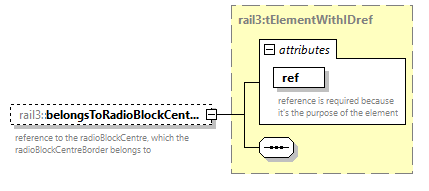 | ||||||||||||||
| namespace | https://www.railml.org/schemas/3.2 | ||||||||||||||
| type | rail3:tElementWithIDref | ||||||||||||||
| properties |
| ||||||||||||||
| attributes |
| ||||||||||||||
| annotation |
| ||||||||||||||
| source | <xs:element name="belongsToRadioBlockCentre" type="rail3:tElementWithIDref" minOccurs="0" maxOccurs="1"> <xs:annotation> <xs:documentation>reference to the radioBlockCentre, which the radioBlockCentreBorder belongs to</xs:documentation> </xs:annotation> </xs:element> |
complexType RbcBorders
| diagram |  | ||
| namespace | https://www.railml.org/schemas/3.2 | ||
| children | rail3:radioBlockCentreBorder | ||
| used by |
| ||
| source | <xs:complexType name="RbcBorders"> <xs:sequence> <xs:element name="radioBlockCentreBorder" type="rail3:RbcBorder" minOccurs="1" maxOccurs="unbounded"/> </xs:sequence> </xs:complexType> |
element RbcBorders/radioBlockCentreBorder
| diagram | 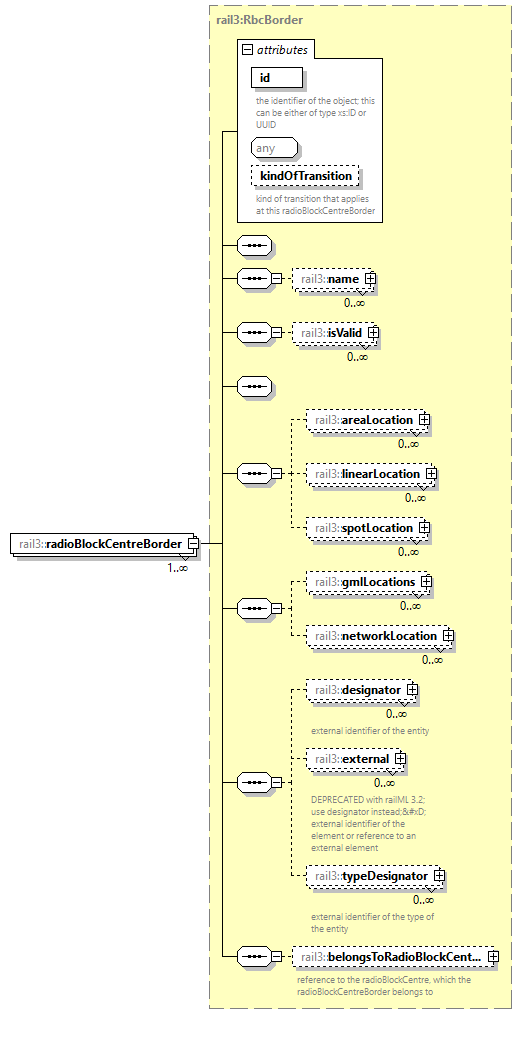 | ||||||||||||||||||||||
| namespace | https://www.railml.org/schemas/3.2 | ||||||||||||||||||||||
| type | rail3:RbcBorder | ||||||||||||||||||||||
| properties |
| ||||||||||||||||||||||
| children | rail3:name rail3:isValid rail3:areaLocation rail3:linearLocation rail3:spotLocation rail3:gmlLocations rail3:networkLocation rail3:designator rail3:external rail3:typeDesignator rail3:belongsToRadioBlockCentre | ||||||||||||||||||||||
| attributes |
| ||||||||||||||||||||||
| source | <xs:element name="radioBlockCentreBorder" type="rail3:RbcBorder" minOccurs="1" maxOccurs="unbounded"/> |
complexType RbcEtcs
| diagram |  |
| namespace | https://www.railml.org/schemas/3.2 |
| source | <xs:complexType name="RbcEtcs"> <xs:sequence/> </xs:complexType> |
complexType RBCs
| diagram |  |
| namespace | https://www.railml.org/schemas/3.2 |
| source | <xs:complexType name="RBCs"> <xs:sequence/> </xs:complexType> |
complexType RestrictionArea
| diagram | 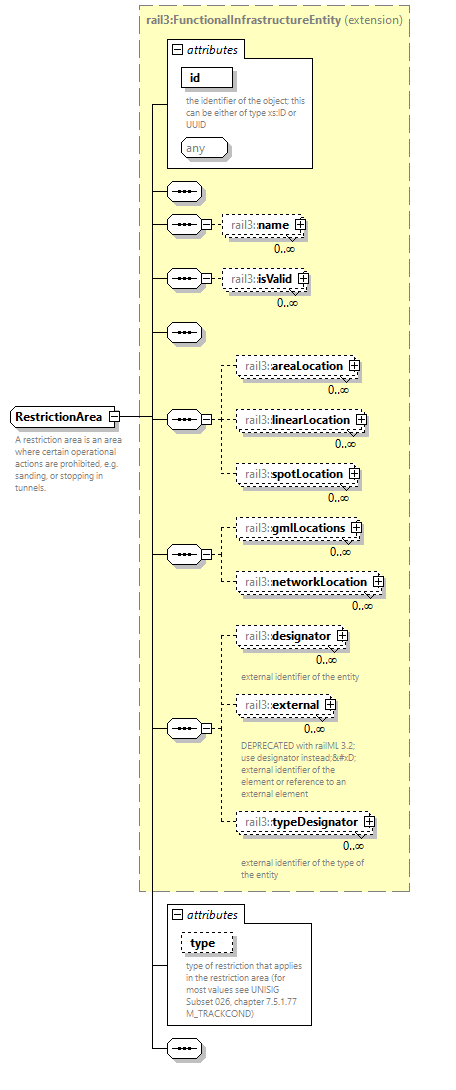 | ||||||||||||||||||||||
| namespace | https://www.railml.org/schemas/3.2 | ||||||||||||||||||||||
| type | extension of rail3:FunctionalInfrastructureEntity | ||||||||||||||||||||||
| properties |
| ||||||||||||||||||||||
| children | rail3:name rail3:isValid rail3:areaLocation rail3:linearLocation rail3:spotLocation rail3:gmlLocations rail3:networkLocation rail3:designator rail3:external rail3:typeDesignator | ||||||||||||||||||||||
| used by |
| ||||||||||||||||||||||
| attributes |
| ||||||||||||||||||||||
| annotation |
| ||||||||||||||||||||||
| source | <xs:complexType name="RestrictionArea"> <xs:annotation> <xs:documentation>A restriction area is an area where certain operational actions are prohibited, e.g. sanding, or stopping in tunnels.</xs:documentation> </xs:annotation> <xs:complexContent> <xs:extension base="rail3:FunctionalInfrastructureEntity"> <xs:sequence/> <xs:attribute name="type" type="rail3:tRestrictionAreaTypeExt" use="optional"> <xs:annotation> <xs:documentation>type of restriction that applies in the restriction area (for most values see UNISIG Subset 026, chapter 7.5.1.77 M_TRACKCOND)</xs:documentation> </xs:annotation> </xs:attribute> </xs:extension> </xs:complexContent> </xs:complexType> |
attribute RestrictionArea/@type
| type | rail3:tRestrictionAreaTypeExt | ||
| properties |
| ||
| annotation |
| ||
| source | <xs:attribute name="type" type="rail3:tRestrictionAreaTypeExt" use="optional"> <xs:annotation> <xs:documentation>type of restriction that applies in the restriction area (for most values see UNISIG Subset 026, chapter 7.5.1.77 M_TRACKCOND)</xs:documentation> </xs:annotation> </xs:attribute> |
complexType RestrictionAreas
| diagram |  | ||
| namespace | https://www.railml.org/schemas/3.2 | ||
| children | rail3:restrictionArea | ||
| used by |
| ||
| source | <xs:complexType name="RestrictionAreas"> <xs:sequence> <xs:element name="restrictionArea" type="rail3:RestrictionArea" minOccurs="1" maxOccurs="unbounded"/> </xs:sequence> </xs:complexType> |
element RestrictionAreas/restrictionArea
| diagram | 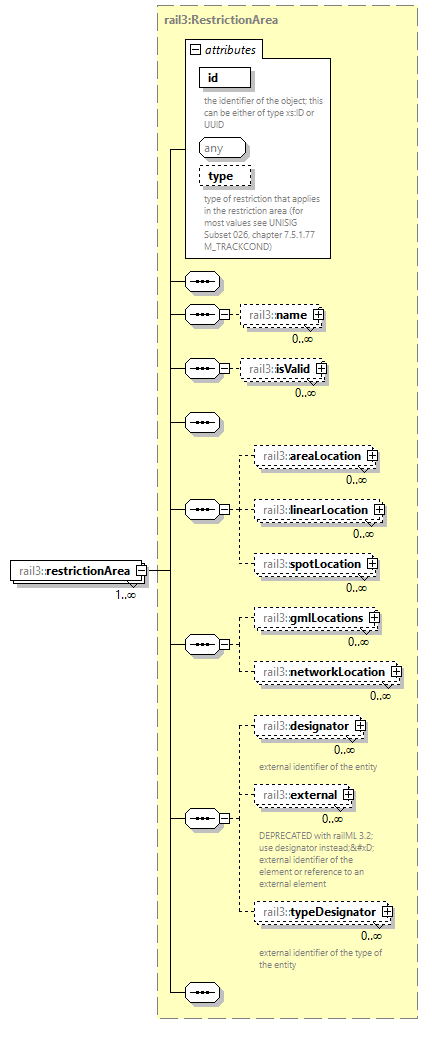 | ||||||||||||||||||||||
| namespace | https://www.railml.org/schemas/3.2 | ||||||||||||||||||||||
| type | rail3:RestrictionArea | ||||||||||||||||||||||
| properties |
| ||||||||||||||||||||||
| children | rail3:name rail3:isValid rail3:areaLocation rail3:linearLocation rail3:spotLocation rail3:gmlLocations rail3:networkLocation rail3:designator rail3:external rail3:typeDesignator | ||||||||||||||||||||||
| attributes |
| ||||||||||||||||||||||
| source | <xs:element name="restrictionArea" type="rail3:RestrictionArea" minOccurs="1" maxOccurs="unbounded"/> |
complexType ServiceSection
| diagram |  | ||||||||||||||||||||||||||||||||||||||||||||||||||||||||||||||||||||||||||||||||||||||||||||||||||||||||||||||||||||||||||||||||||||||||||||||||||||||||||||||||||||||||||||||||||||||||||||||
| namespace | https://www.railml.org/schemas/3.2 | ||||||||||||||||||||||||||||||||||||||||||||||||||||||||||||||||||||||||||||||||||||||||||||||||||||||||||||||||||||||||||||||||||||||||||||||||||||||||||||||||||||||||||||||||||||||||||||||
| type | extension of rail3:FunctionalInfrastructureEntity | ||||||||||||||||||||||||||||||||||||||||||||||||||||||||||||||||||||||||||||||||||||||||||||||||||||||||||||||||||||||||||||||||||||||||||||||||||||||||||||||||||||||||||||||||||||||||||||||
| properties |
| ||||||||||||||||||||||||||||||||||||||||||||||||||||||||||||||||||||||||||||||||||||||||||||||||||||||||||||||||||||||||||||||||||||||||||||||||||||||||||||||||||||||||||||||||||||||||||||||
| children | rail3:name rail3:isValid rail3:areaLocation rail3:linearLocation rail3:spotLocation rail3:gmlLocations rail3:networkLocation rail3:designator rail3:external rail3:typeDesignator | ||||||||||||||||||||||||||||||||||||||||||||||||||||||||||||||||||||||||||||||||||||||||||||||||||||||||||||||||||||||||||||||||||||||||||||||||||||||||||||||||||||||||||||||||||||||||||||||
| used by |
| ||||||||||||||||||||||||||||||||||||||||||||||||||||||||||||||||||||||||||||||||||||||||||||||||||||||||||||||||||||||||||||||||||||||||||||||||||||||||||||||||||||||||||||||||||||||||||||||
| attributes |
| ||||||||||||||||||||||||||||||||||||||||||||||||||||||||||||||||||||||||||||||||||||||||||||||||||||||||||||||||||||||||||||||||||||||||||||||||||||||||||||||||||||||||||||||||||||||||||||||
| annotation |
| ||||||||||||||||||||||||||||||||||||||||||||||||||||||||||||||||||||||||||||||||||||||||||||||||||||||||||||||||||||||||||||||||||||||||||||||||||||||||||||||||||||||||||||||||||||||||||||||
| source | <xs:complexType name="ServiceSection"> <xs:annotation> <xs:documentation>a function that is provided by infrastructure to a train, e.g. cleaning, refueling.</xs:documentation> </xs:annotation> <xs:complexContent> <xs:extension base="rail3:FunctionalInfrastructureEntity"> <xs:sequence/> <xs:attribute name="belongsToParent" type="rail3:tRef" use="optional"> <xs:annotation> <xs:documentation>reference to the (one and only) parent service section
 
 
 - if some information exists in parent and child, then information in child overwrites it in child
 
 - if some information exists only in parent, then child inherits this information from parent</xs:documentation> </xs:annotation> </xs:attribute> <xs:attributeGroup ref="rail3:aServiceSection"/> </xs:extension> </xs:complexContent> </xs:complexType> |
attribute ServiceSection/@belongsToParent
| type | rail3:tRef | ||
| properties |
| ||
| annotation |
| ||
| source | <xs:attribute name="belongsToParent" type="rail3:tRef" use="optional"> <xs:annotation> <xs:documentation>reference to the (one and only) parent service section
 
 
 - if some information exists in parent and child, then information in child overwrites it in child
 
 - if some information exists only in parent, then child inherits this information from parent</xs:documentation> </xs:annotation> </xs:attribute> |
complexType ServiceSections
| diagram |  | ||
| namespace | https://www.railml.org/schemas/3.2 | ||
| children | rail3:serviceSection | ||
| used by |
| ||
| source | <xs:complexType name="ServiceSections"> <xs:sequence> <xs:element name="serviceSection" type="rail3:ServiceSection" minOccurs="1" maxOccurs="unbounded"/> </xs:sequence> </xs:complexType> |
element ServiceSections/serviceSection
| diagram |  | ||||||||||||||||||||||||||||||||||||||||||||||||||||||||||||||||||||||||||||||||||||||||||||||||||||||||||||||||||||||||||||||||||||||||||||||||||||||||||||||||||||||||||||||||||||||||||||||
| namespace | https://www.railml.org/schemas/3.2 | ||||||||||||||||||||||||||||||||||||||||||||||||||||||||||||||||||||||||||||||||||||||||||||||||||||||||||||||||||||||||||||||||||||||||||||||||||||||||||||||||||||||||||||||||||||||||||||||
| type | rail3:ServiceSection | ||||||||||||||||||||||||||||||||||||||||||||||||||||||||||||||||||||||||||||||||||||||||||||||||||||||||||||||||||||||||||||||||||||||||||||||||||||||||||||||||||||||||||||||||||||||||||||||
| properties |
| ||||||||||||||||||||||||||||||||||||||||||||||||||||||||||||||||||||||||||||||||||||||||||||||||||||||||||||||||||||||||||||||||||||||||||||||||||||||||||||||||||||||||||||||||||||||||||||||
| children | rail3:name rail3:isValid rail3:areaLocation rail3:linearLocation rail3:spotLocation rail3:gmlLocations rail3:networkLocation rail3:designator rail3:external rail3:typeDesignator | ||||||||||||||||||||||||||||||||||||||||||||||||||||||||||||||||||||||||||||||||||||||||||||||||||||||||||||||||||||||||||||||||||||||||||||||||||||||||||||||||||||||||||||||||||||||||||||||
| attributes |
| ||||||||||||||||||||||||||||||||||||||||||||||||||||||||||||||||||||||||||||||||||||||||||||||||||||||||||||||||||||||||||||||||||||||||||||||||||||||||||||||||||||||||||||||||||||||||||||||
| source | <xs:element name="serviceSection" type="rail3:ServiceSection" minOccurs="1" maxOccurs="unbounded"/> |
complexType SignalAnnouncement
| diagram | 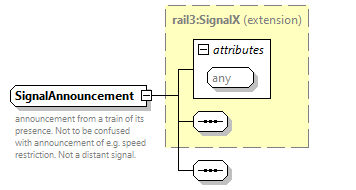 | ||||||
| namespace | https://www.railml.org/schemas/3.2 | ||||||
| type | extension of rail3:SignalX | ||||||
| properties |
| ||||||
| used by |
| ||||||
| attributes |
| ||||||
| annotation |
| ||||||
| source | <xs:complexType name="SignalAnnouncement"> <xs:annotation> <xs:documentation>announcement from a train of its presence. Not to be confused with announcement of e.g. speed restriction. Not a distant signal.</xs:documentation> </xs:annotation> <xs:complexContent> <xs:extension base="rail3:SignalX"> <xs:sequence/> </xs:extension> </xs:complexContent> </xs:complexType> |
complexType SignalCatenary
| diagram | 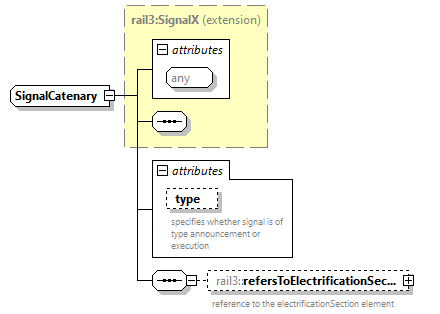 | ||||||||||||||
| namespace | https://www.railml.org/schemas/3.2 | ||||||||||||||
| type | extension of rail3:SignalX | ||||||||||||||
| properties |
| ||||||||||||||
| children | rail3:refersToElectrificationSection | ||||||||||||||
| used by |
| ||||||||||||||
| attributes |
| ||||||||||||||
| source | <xs:complexType name="SignalCatenary"> <xs:complexContent> <xs:extension base="rail3:SignalX"> <xs:sequence> <xs:element name="refersToElectrificationSection" type="rail3:tElementWithIDref" minOccurs="0" maxOccurs="1"> <xs:annotation> <xs:documentation>reference to the electrificationSection element</xs:documentation> </xs:annotation> </xs:element> </xs:sequence> <xs:attribute name="type" type="rail3:tSignalCatenaryType" use="optional"> <xs:annotation> <xs:documentation>specifies whether signal is of type announcement or execution</xs:documentation> </xs:annotation> </xs:attribute> </xs:extension> </xs:complexContent> </xs:complexType> |
attribute SignalCatenary/@type
| type | rail3:tSignalCatenaryType | |||||||||||||
| properties |
| |||||||||||||
| facets |
| |||||||||||||
| annotation |
| |||||||||||||
| source | <xs:attribute name="type" type="rail3:tSignalCatenaryType" use="optional"> <xs:annotation> <xs:documentation>specifies whether signal is of type announcement or execution</xs:documentation> </xs:annotation> </xs:attribute> |
element SignalCatenary/refersToElectrificationSection
| diagram | 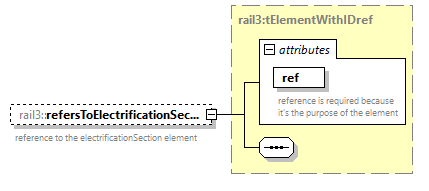 | ||||||||||||||
| namespace | https://www.railml.org/schemas/3.2 | ||||||||||||||
| type | rail3:tElementWithIDref | ||||||||||||||
| properties |
| ||||||||||||||
| attributes |
| ||||||||||||||
| annotation |
| ||||||||||||||
| source | <xs:element name="refersToElectrificationSection" type="rail3:tElementWithIDref" minOccurs="0" maxOccurs="1"> <xs:annotation> <xs:documentation>reference to the electrificationSection element</xs:documentation> </xs:annotation> </xs:element> |
complexType SignalConstruction
| diagram | 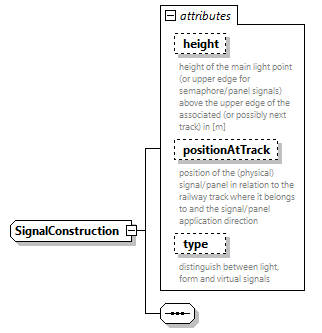 | ||||||||||||||||||||||||||||||
| namespace | https://www.railml.org/schemas/3.2 | ||||||||||||||||||||||||||||||
| used by |
| ||||||||||||||||||||||||||||||
| attributes |
| ||||||||||||||||||||||||||||||
| source | <xs:complexType name="SignalConstruction"> <xs:sequence/> <xs:attribute name="height" type="rail3:tLengthM" use="optional"> <xs:annotation> <xs:documentation>height of the main light point (or upper edge for semaphore/panel signals) above the upper edge of the associated (or possibly next track) in [m]</xs:documentation> </xs:annotation> </xs:attribute> <xs:attribute name="positionAtTrack" type="rail3:tWiderTrackPosition" use="optional"> <xs:annotation> <xs:documentation>position of the (physical) signal/panel in relation to the railway track where it belongs to and the signal/panel application direction</xs:documentation> </xs:annotation> </xs:attribute> <xs:attribute name="type" type="rail3:tSignalConstructionType" use="optional"> <xs:annotation> <xs:documentation>distinguish between light, form and virtual signals</xs:documentation> </xs:annotation> </xs:attribute> </xs:complexType> |
attribute SignalConstruction/@height
| type | rail3:tLengthM | ||
| properties |
| ||
| annotation |
| ||
| source | <xs:attribute name="height" type="rail3:tLengthM" use="optional"> <xs:annotation> <xs:documentation>height of the main light point (or upper edge for semaphore/panel signals) above the upper edge of the associated (or possibly next track) in [m]</xs:documentation> </xs:annotation> </xs:attribute> |
attribute SignalConstruction/@positionAtTrack
| type | rail3:tWiderTrackPosition | ||||||||||||||||||
| properties |
| ||||||||||||||||||
| facets |
| ||||||||||||||||||
| annotation |
| ||||||||||||||||||
| source | <xs:attribute name="positionAtTrack" type="rail3:tWiderTrackPosition" use="optional"> <xs:annotation> <xs:documentation>position of the (physical) signal/panel in relation to the railway track where it belongs to and the signal/panel application direction</xs:documentation> </xs:annotation> </xs:attribute> |
attribute SignalConstruction/@type
| type | rail3:tSignalConstructionType | ||||||||||||||||||||||||||||
| properties |
| ||||||||||||||||||||||||||||
| facets |
| ||||||||||||||||||||||||||||
| annotation |
| ||||||||||||||||||||||||||||
| source | <xs:attribute name="type" type="rail3:tSignalConstructionType" use="optional"> <xs:annotation> <xs:documentation>distinguish between light, form and virtual signals</xs:documentation> </xs:annotation> </xs:attribute> |
complexType SignalDanger
| diagram | 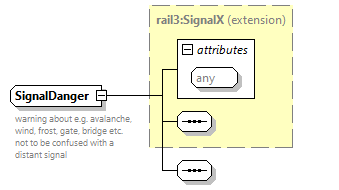 | ||||||
| namespace | https://www.railml.org/schemas/3.2 | ||||||
| type | extension of rail3:SignalX | ||||||
| properties |
| ||||||
| used by |
| ||||||
| attributes |
| ||||||
| annotation |
| ||||||
| source | <xs:complexType name="SignalDanger"> <xs:annotation> <xs:documentation>warning about e.g. avalanche, wind, frost, gate, bridge etc. not to be confused with a distant signal</xs:documentation> </xs:annotation> <xs:complexContent> <xs:extension base="rail3:SignalX"> <xs:sequence/> </xs:extension> </xs:complexContent> </xs:complexType> |
complexType SignalEtcs
| diagram | 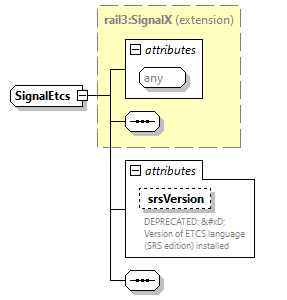 | ||||||||||||||
| namespace | https://www.railml.org/schemas/3.2 | ||||||||||||||
| type | extension of rail3:SignalX | ||||||||||||||
| properties |
| ||||||||||||||
| used by |
| ||||||||||||||
| attributes |
| ||||||||||||||
| source | <xs:complexType name="SignalEtcs"> <xs:complexContent> <xs:extension base="rail3:SignalX"> <xs:sequence/> <xs:attribute name="srsVersion" type="xs:string" use="optional"> <xs:annotation> <xs:documentation>DEPRECATED; 
 Version of ETCS language (SRS edition) installed</xs:documentation> </xs:annotation> </xs:attribute> </xs:extension> </xs:complexContent> </xs:complexType> |
attribute SignalEtcs/@srsVersion
| type | xs:string | ||
| properties |
| ||
| annotation |
| ||
| source | <xs:attribute name="srsVersion" type="xs:string" use="optional"> <xs:annotation> <xs:documentation>DEPRECATED; 
 Version of ETCS language (SRS edition) installed</xs:documentation> </xs:annotation> </xs:attribute> |
complexType SignalInformation
| diagram | 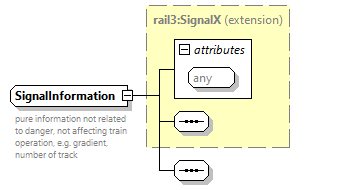 | ||||||
| namespace | https://www.railml.org/schemas/3.2 | ||||||
| type | extension of rail3:SignalX | ||||||
| properties |
| ||||||
| used by |
| ||||||
| attributes |
| ||||||
| annotation |
| ||||||
| source | <xs:complexType name="SignalInformation"> <xs:annotation> <xs:documentation>pure information not related to danger, not affecting train operation, e.g. gradient, number of track</xs:documentation> </xs:annotation> <xs:complexContent> <xs:extension base="rail3:SignalX"> <xs:sequence/> </xs:extension> </xs:complexContent> </xs:complexType> |
complexType SignalIS
| diagram |  | ||||||||||||||||||||||||||||||||||||||
| namespace | https://www.railml.org/schemas/3.2 | ||||||||||||||||||||||||||||||||||||||
| type | extension of rail3:FunctionalInfrastructureEntity | ||||||||||||||||||||||||||||||||||||||
| properties |
| ||||||||||||||||||||||||||||||||||||||
| children | rail3:name rail3:isValid rail3:areaLocation rail3:linearLocation rail3:spotLocation rail3:gmlLocations rail3:networkLocation rail3:designator rail3:external rail3:typeDesignator rail3:isAnnouncementSignal rail3:isCatenarySignal rail3:isDangerSignal rail3:isEtcsSignal rail3:isInformationSignal rail3:isLevelCrossingSignal rail3:isMilepost rail3:isSpeedSignal rail3:isStopPost rail3:isTrainMovementSignal rail3:isTrainRadioSignal rail3:isVehicleEquipmentSignal rail3:connectedWithBaliseGroup rail3:protectedByBaliseGroup rail3:signalConstruction | ||||||||||||||||||||||||||||||||||||||
| used by |
| ||||||||||||||||||||||||||||||||||||||
| attributes |
| ||||||||||||||||||||||||||||||||||||||
| annotation |
| ||||||||||||||||||||||||||||||||||||||
| source | <xs:complexType name="SignalIS"> <xs:annotation> <xs:documentation>A device erected along a railway line to pass information to the train relating to the state of the line ahead to operational train crew.</xs:documentation> </xs:annotation> <xs:complexContent> <xs:extension base="rail3:FunctionalInfrastructureEntity"> <xs:sequence> <xs:element name="isAnnouncementSignal" type="rail3:SignalAnnouncement" minOccurs="0" maxOccurs="1"> <xs:annotation> <xs:documentation>announcement from a train of its presence. Not to be confused with announcement of e.g. speed restriction. Not a distant signal.</xs:documentation> </xs:annotation> </xs:element> <xs:element name="isCatenarySignal" type="rail3:SignalCatenary" minOccurs="0" maxOccurs="1"> <xs:annotation> <xs:documentation>use this child element to specify the catenary signal/sign in more detail</xs:documentation> </xs:annotation> </xs:element> <xs:element name="isDangerSignal" type="rail3:SignalDanger" minOccurs="0" maxOccurs="1"> <xs:annotation> <xs:documentation>warning about e.g. avalanche, wind, frost, gate, bridge etc. not to be confused with a distant signal</xs:documentation> </xs:annotation> </xs:element> <xs:element name="isEtcsSignal" type="rail3:SignalEtcs" minOccurs="0" maxOccurs="1"> <xs:annotation> <xs:documentation>use this child element to specify the ETCS signal in more detail</xs:documentation> </xs:annotation> </xs:element> <xs:element name="isInformationSignal" type="rail3:SignalInformation" minOccurs="0" maxOccurs="1"> <xs:annotation> <xs:documentation>pure information not related to danger, not affecting train operation, e.g. gradient, number of track</xs:documentation> </xs:annotation> </xs:element> <xs:element name="isLevelCrossingSignal" type="rail3:SignalLevelCrossing" minOccurs="0" maxOccurs="1"> <xs:annotation> <xs:documentation>use this child element to specify the level crossing signal in more detail</xs:documentation> </xs:annotation> </xs:element> <xs:element name="isMilepost" type="rail3:SignalMilepost" minOccurs="0" maxOccurs="1"> <xs:annotation> <xs:documentation>use this child element to specify the milepost marker in more detail</xs:documentation> </xs:annotation> </xs:element> <xs:element name="isSpeedSignal" type="rail3:SignalSpeed" minOccurs="0" maxOccurs="1"> <xs:annotation> <xs:documentation>use this child element to specify the speed signal in more detail</xs:documentation> </xs:annotation> </xs:element> <xs:element name="isStopPost" type="rail3:SignalStopPost" minOccurs="0" maxOccurs="1"> <xs:annotation> <xs:documentation>use this child element to specify the stop post in more detail</xs:documentation> </xs:annotation> </xs:element> <xs:element name="isTrainMovementSignal" type="rail3:SignalTrainMovement" minOccurs="0" maxOccurs="1"> <xs:annotation> <xs:documentation>signal for transmitting a command from traffic control to the train driver by optical means for stopping or proceeding, e.g. main signal, distant signal, signal repeater, shunting signal</xs:documentation> </xs:annotation> </xs:element> <xs:element name="isTrainRadioSignal" type="rail3:SignalRadio" minOccurs="0" maxOccurs="1"> <xs:annotation> <xs:documentation>provides instructions on the train radio usage, e.g. GSMR, FRMCS, analogue radio etc.</xs:documentation> </xs:annotation> </xs:element> <xs:element name="isVehicleEquipmentSignal" type="rail3:SignalVehicleEquipment" minOccurs="0" maxOccurs="1"> <xs:annotation> <xs:documentation>shall be used for commanding for action with all the other equipment of a vehicle except when explicitly modeled in railML, e.g. raise of lower snow plow</xs:documentation> </xs:annotation> </xs:element> <xs:element name="connectedWithBaliseGroup" type="rail3:tElementWithIDref" minOccurs="0" maxOccurs="unbounded"> <xs:annotation> <xs:documentation>DEPRECTATED: As of railML 3.2 this attribute is replaced by protectedByBaliseGroup and should not be used anymore.
 reference to a balise (group) that is connected with this signal</xs:documentation> </xs:annotation> </xs:element> <xs:element name="protectedByBaliseGroup" type="rail3:tElementWithIDref" minOccurs="0" maxOccurs="unbounded"> <xs:annotation> <xs:documentation>reference to a balise (group) that is connected with this signal</xs:documentation> </xs:annotation> </xs:element> <xs:element name="signalConstruction" type="rail3:SignalConstruction" minOccurs="0" maxOccurs="1"> <xs:annotation> <xs:documentation>child element for construction details of the (physical) signal</xs:documentation> </xs:annotation> </xs:element> </xs:sequence> <xs:attribute name="basedOnTemplate" type="rail3:tRef" use="optional"> <xs:annotation> <xs:documentation>reference to a generic signal</xs:documentation> </xs:annotation> </xs:attribute> <xs:attribute name="belongsToParent" type="rail3:tRef" use="optional"> <xs:annotation> <xs:documentation>reference to the (one and only) parent signal this signal belongs to
 
 - if some information exists in parent and child, then information in child overwrites it in child
 
 - if some information exists only in parent, then child inherits this information from parent</xs:documentation> </xs:annotation> </xs:attribute> <xs:attribute name="isSwitchable" type="xs:boolean" use="optional"> <xs:annotation> <xs:documentation>set TRUE if the signal is able to show several signal aspects, set FALSE if the signal is a static panel that always shows the same signal aspect</xs:documentation> </xs:annotation> </xs:attribute> </xs:extension> </xs:complexContent> </xs:complexType> |
attribute SignalIS/@basedOnTemplate
| type | rail3:tRef | ||
| properties |
| ||
| annotation |
| ||
| source | <xs:attribute name="basedOnTemplate" type="rail3:tRef" use="optional"> <xs:annotation> <xs:documentation>reference to a generic signal</xs:documentation> </xs:annotation> </xs:attribute> |
attribute SignalIS/@belongsToParent
| type | rail3:tRef | ||
| properties |
| ||
| annotation |
| ||
| source | <xs:attribute name="belongsToParent" type="rail3:tRef" use="optional"> <xs:annotation> <xs:documentation>reference to the (one and only) parent signal this signal belongs to
 
 - if some information exists in parent and child, then information in child overwrites it in child
 
 - if some information exists only in parent, then child inherits this information from parent</xs:documentation> </xs:annotation> </xs:attribute> |
attribute SignalIS/@isSwitchable
| type | xs:boolean | ||
| properties |
| ||
| annotation |
| ||
| source | <xs:attribute name="isSwitchable" type="xs:boolean" use="optional"> <xs:annotation> <xs:documentation>set TRUE if the signal is able to show several signal aspects, set FALSE if the signal is a static panel that always shows the same signal aspect</xs:documentation> </xs:annotation> </xs:attribute> |
element SignalIS/isAnnouncementSignal
| diagram | 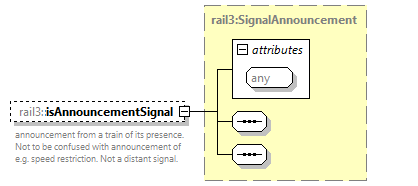 | ||||||
| namespace | https://www.railml.org/schemas/3.2 | ||||||
| type | rail3:SignalAnnouncement | ||||||
| properties |
| ||||||
| attributes |
| ||||||
| annotation |
| ||||||
| source | <xs:element name="isAnnouncementSignal" type="rail3:SignalAnnouncement" minOccurs="0" maxOccurs="1"> <xs:annotation> <xs:documentation>announcement from a train of its presence. Not to be confused with announcement of e.g. speed restriction. Not a distant signal.</xs:documentation> </xs:annotation> </xs:element> |
element SignalIS/isCatenarySignal
| diagram | 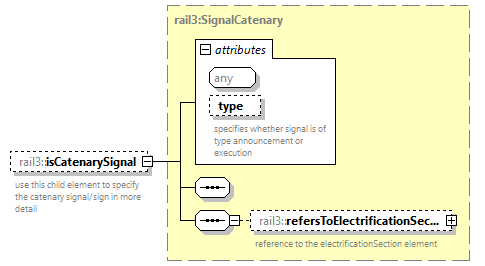 | ||||||||||||||
| namespace | https://www.railml.org/schemas/3.2 | ||||||||||||||
| type | rail3:SignalCatenary | ||||||||||||||
| properties |
| ||||||||||||||
| children | rail3:refersToElectrificationSection | ||||||||||||||
| attributes |
| ||||||||||||||
| annotation |
| ||||||||||||||
| source | <xs:element name="isCatenarySignal" type="rail3:SignalCatenary" minOccurs="0" maxOccurs="1"> <xs:annotation> <xs:documentation>use this child element to specify the catenary signal/sign in more detail</xs:documentation> </xs:annotation> </xs:element> |
element SignalIS/isDangerSignal
| diagram | 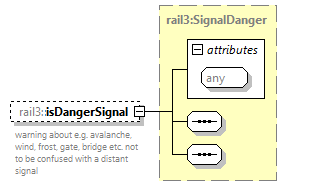 | ||||||
| namespace | https://www.railml.org/schemas/3.2 | ||||||
| type | rail3:SignalDanger | ||||||
| properties |
| ||||||
| attributes |
| ||||||
| annotation |
| ||||||
| source | <xs:element name="isDangerSignal" type="rail3:SignalDanger" minOccurs="0" maxOccurs="1"> <xs:annotation> <xs:documentation>warning about e.g. avalanche, wind, frost, gate, bridge etc. not to be confused with a distant signal</xs:documentation> </xs:annotation> </xs:element> |
element SignalIS/isEtcsSignal
| diagram | 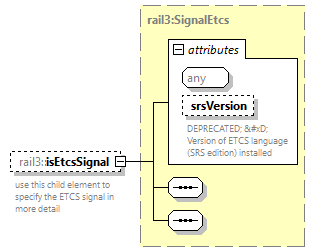 | ||||||||||||||
| namespace | https://www.railml.org/schemas/3.2 | ||||||||||||||
| type | rail3:SignalEtcs | ||||||||||||||
| properties |
| ||||||||||||||
| attributes |
| ||||||||||||||
| annotation |
| ||||||||||||||
| source | <xs:element name="isEtcsSignal" type="rail3:SignalEtcs" minOccurs="0" maxOccurs="1"> <xs:annotation> <xs:documentation>use this child element to specify the ETCS signal in more detail</xs:documentation> </xs:annotation> </xs:element> |
element SignalIS/isInformationSignal
| diagram |  | ||||||
| namespace | https://www.railml.org/schemas/3.2 | ||||||
| type | rail3:SignalInformation | ||||||
| properties |
| ||||||
| attributes |
| ||||||
| annotation |
| ||||||
| source | <xs:element name="isInformationSignal" type="rail3:SignalInformation" minOccurs="0" maxOccurs="1"> <xs:annotation> <xs:documentation>pure information not related to danger, not affecting train operation, e.g. gradient, number of track</xs:documentation> </xs:annotation> </xs:element> |
element SignalIS/isLevelCrossingSignal
| diagram | 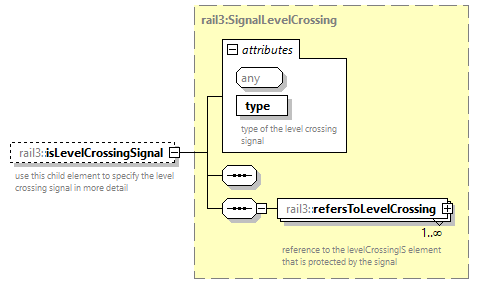 | ||||||||||||||
| namespace | https://www.railml.org/schemas/3.2 | ||||||||||||||
| type | rail3:SignalLevelCrossing | ||||||||||||||
| properties |
| ||||||||||||||
| children | rail3:refersToLevelCrossing | ||||||||||||||
| attributes |
| ||||||||||||||
| annotation |
| ||||||||||||||
| source | <xs:element name="isLevelCrossingSignal" type="rail3:SignalLevelCrossing" minOccurs="0" maxOccurs="1"> <xs:annotation> <xs:documentation>use this child element to specify the level crossing signal in more detail</xs:documentation> </xs:annotation> </xs:element> |
element SignalIS/isMilepost
| diagram | 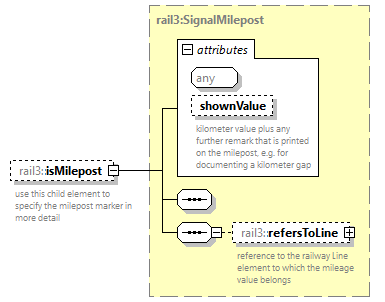 | ||||||||||||||
| namespace | https://www.railml.org/schemas/3.2 | ||||||||||||||
| type | rail3:SignalMilepost | ||||||||||||||
| properties |
| ||||||||||||||
| children | rail3:refersToLine | ||||||||||||||
| attributes |
| ||||||||||||||
| annotation |
| ||||||||||||||
| source | <xs:element name="isMilepost" type="rail3:SignalMilepost" minOccurs="0" maxOccurs="1"> <xs:annotation> <xs:documentation>use this child element to specify the milepost marker in more detail</xs:documentation> </xs:annotation> </xs:element> |
element SignalIS/isSpeedSignal
| diagram | 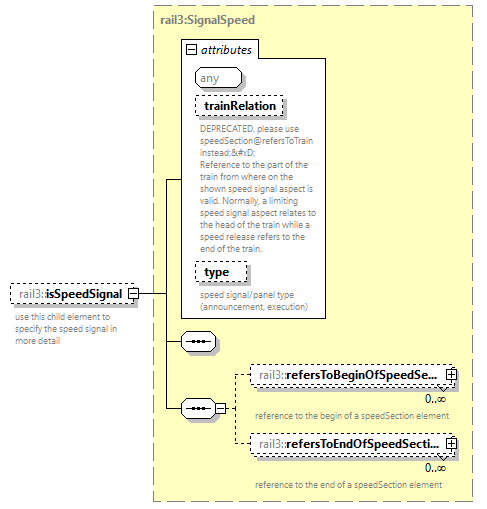 | ||||||||||||||||||||||
| namespace | https://www.railml.org/schemas/3.2 | ||||||||||||||||||||||
| type | rail3:SignalSpeed | ||||||||||||||||||||||
| properties |
| ||||||||||||||||||||||
| children | rail3:refersToBeginOfSpeedSection rail3:refersToEndOfSpeedSection | ||||||||||||||||||||||
| attributes |
| ||||||||||||||||||||||
| annotation |
| ||||||||||||||||||||||
| source | <xs:element name="isSpeedSignal" type="rail3:SignalSpeed" minOccurs="0" maxOccurs="1"> <xs:annotation> <xs:documentation>use this child element to specify the speed signal in more detail</xs:documentation> </xs:annotation> </xs:element> |
element SignalIS/isStopPost
| diagram | 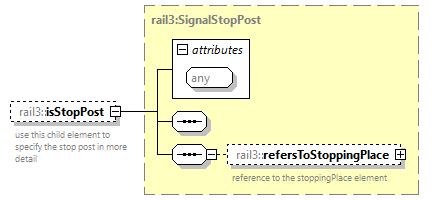 | ||||||
| namespace | https://www.railml.org/schemas/3.2 | ||||||
| type | rail3:SignalStopPost | ||||||
| properties |
| ||||||
| children | rail3:refersToStoppingPlace | ||||||
| attributes |
| ||||||
| annotation |
| ||||||
| source | <xs:element name="isStopPost" type="rail3:SignalStopPost" minOccurs="0" maxOccurs="1"> <xs:annotation> <xs:documentation>use this child element to specify the stop post in more detail</xs:documentation> </xs:annotation> </xs:element> |
element SignalIS/isTrainMovementSignal
| diagram | 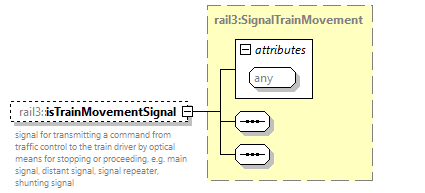 | ||||||
| namespace | https://www.railml.org/schemas/3.2 | ||||||
| type | rail3:SignalTrainMovement | ||||||
| properties |
| ||||||
| attributes |
| ||||||
| annotation |
| ||||||
| source | <xs:element name="isTrainMovementSignal" type="rail3:SignalTrainMovement" minOccurs="0" maxOccurs="1"> <xs:annotation> <xs:documentation>signal for transmitting a command from traffic control to the train driver by optical means for stopping or proceeding, e.g. main signal, distant signal, signal repeater, shunting signal</xs:documentation> </xs:annotation> </xs:element> |
element SignalIS/isTrainRadioSignal
| diagram | 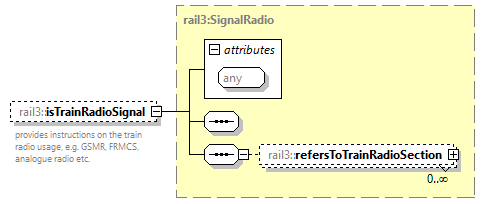 | ||||||
| namespace | https://www.railml.org/schemas/3.2 | ||||||
| type | rail3:SignalRadio | ||||||
| properties |
| ||||||
| children | rail3:refersToTrainRadioSection | ||||||
| attributes |
| ||||||
| annotation |
| ||||||
| source | <xs:element name="isTrainRadioSignal" type="rail3:SignalRadio" minOccurs="0" maxOccurs="1"> <xs:annotation> <xs:documentation>provides instructions on the train radio usage, e.g. GSMR, FRMCS, analogue radio etc.</xs:documentation> </xs:annotation> </xs:element> |
element SignalIS/isVehicleEquipmentSignal
| diagram | 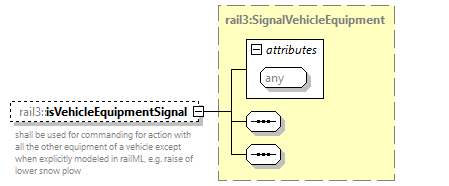 | ||||||
| namespace | https://www.railml.org/schemas/3.2 | ||||||
| type | rail3:SignalVehicleEquipment | ||||||
| properties |
| ||||||
| attributes |
| ||||||
| annotation |
| ||||||
| source | <xs:element name="isVehicleEquipmentSignal" type="rail3:SignalVehicleEquipment" minOccurs="0" maxOccurs="1"> <xs:annotation> <xs:documentation>shall be used for commanding for action with all the other equipment of a vehicle except when explicitly modeled in railML, e.g. raise of lower snow plow</xs:documentation> </xs:annotation> </xs:element> |
element SignalIS/connectedWithBaliseGroup
| diagram | 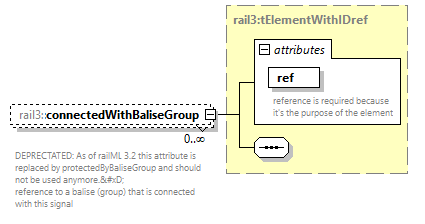 | ||||||||||||||
| namespace | https://www.railml.org/schemas/3.2 | ||||||||||||||
| type | rail3:tElementWithIDref | ||||||||||||||
| properties |
| ||||||||||||||
| attributes |
| ||||||||||||||
| annotation |
| ||||||||||||||
| source | <xs:element name="connectedWithBaliseGroup" type="rail3:tElementWithIDref" minOccurs="0" maxOccurs="unbounded"> <xs:annotation> <xs:documentation>DEPRECTATED: As of railML 3.2 this attribute is replaced by protectedByBaliseGroup and should not be used anymore.
 reference to a balise (group) that is connected with this signal</xs:documentation> </xs:annotation> </xs:element> |
element SignalIS/protectedByBaliseGroup
| diagram | 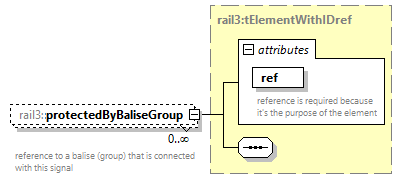 | ||||||||||||||
| namespace | https://www.railml.org/schemas/3.2 | ||||||||||||||
| type | rail3:tElementWithIDref | ||||||||||||||
| properties |
| ||||||||||||||
| attributes |
| ||||||||||||||
| annotation |
| ||||||||||||||
| source | <xs:element name="protectedByBaliseGroup" type="rail3:tElementWithIDref" minOccurs="0" maxOccurs="unbounded"> <xs:annotation> <xs:documentation>reference to a balise (group) that is connected with this signal</xs:documentation> </xs:annotation> </xs:element> |
element SignalIS/signalConstruction
| diagram | 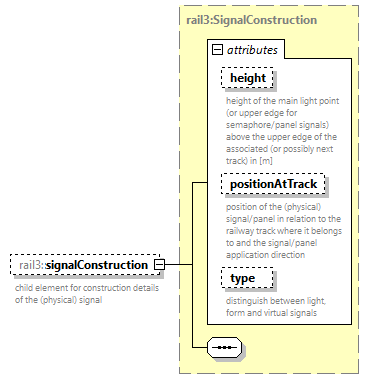 | ||||||||||||||||||||||||||||||
| namespace | https://www.railml.org/schemas/3.2 | ||||||||||||||||||||||||||||||
| type | rail3:SignalConstruction | ||||||||||||||||||||||||||||||
| properties |
| ||||||||||||||||||||||||||||||
| attributes |
| ||||||||||||||||||||||||||||||
| annotation |
| ||||||||||||||||||||||||||||||
| source | <xs:element name="signalConstruction" type="rail3:SignalConstruction" minOccurs="0" maxOccurs="1"> <xs:annotation> <xs:documentation>child element for construction details of the (physical) signal</xs:documentation> </xs:annotation> </xs:element> |
complexType SignalLevelCrossing
| diagram | 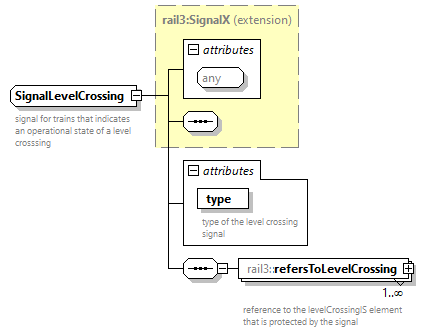 | ||||||||||||||
| namespace | https://www.railml.org/schemas/3.2 | ||||||||||||||
| type | extension of rail3:SignalX | ||||||||||||||
| properties |
| ||||||||||||||
| children | rail3:refersToLevelCrossing | ||||||||||||||
| used by |
| ||||||||||||||
| attributes |
| ||||||||||||||
| annotation |
| ||||||||||||||
| source | <xs:complexType name="SignalLevelCrossing"> <xs:annotation> <xs:documentation>signal for trains that indicates an operational state of a level crosssing</xs:documentation> </xs:annotation> <xs:complexContent> <xs:extension base="rail3:SignalX"> <xs:sequence> <xs:element name="refersToLevelCrossing" type="rail3:tElementWithIDref" minOccurs="1" maxOccurs="unbounded"> <xs:annotation> <xs:documentation>reference to the levelCrossingIS element that is protected by the signal</xs:documentation> </xs:annotation> </xs:element> </xs:sequence> <xs:attribute name="type" type="rail3:tSignalLevelCrossingType" use="required"> <xs:annotation> <xs:documentation>type of the level crossing signal</xs:documentation> </xs:annotation> </xs:attribute> </xs:extension> </xs:complexContent> </xs:complexType> |
attribute SignalLevelCrossing/@type
| type | rail3:tSignalLevelCrossingType | ||||||||||||||||||||||||||||
| properties |
| ||||||||||||||||||||||||||||
| facets |
| ||||||||||||||||||||||||||||
| annotation |
| ||||||||||||||||||||||||||||
| source | <xs:attribute name="type" type="rail3:tSignalLevelCrossingType" use="required"> <xs:annotation> <xs:documentation>type of the level crossing signal</xs:documentation> </xs:annotation> </xs:attribute> |
element SignalLevelCrossing/refersToLevelCrossing
| diagram | 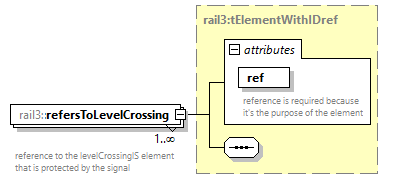 | ||||||||||||||
| namespace | https://www.railml.org/schemas/3.2 | ||||||||||||||
| type | rail3:tElementWithIDref | ||||||||||||||
| properties |
| ||||||||||||||
| attributes |
| ||||||||||||||
| annotation |
| ||||||||||||||
| source | <xs:element name="refersToLevelCrossing" type="rail3:tElementWithIDref" minOccurs="1" maxOccurs="unbounded"> <xs:annotation> <xs:documentation>reference to the levelCrossingIS element that is protected by the signal</xs:documentation> </xs:annotation> </xs:element> |
complexType SignalMilepost
| diagram | 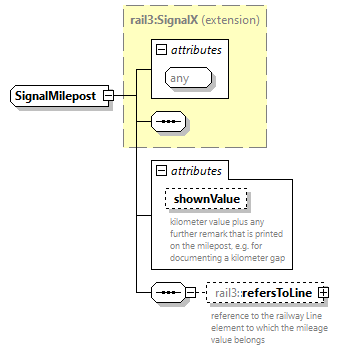 | ||||||||||||||
| namespace | https://www.railml.org/schemas/3.2 | ||||||||||||||
| type | extension of rail3:SignalX | ||||||||||||||
| properties |
| ||||||||||||||
| children | rail3:refersToLine | ||||||||||||||
| used by |
| ||||||||||||||
| attributes |
| ||||||||||||||
| source | <xs:complexType name="SignalMilepost"> <xs:complexContent> <xs:extension base="rail3:SignalX"> <xs:sequence> <xs:element name="refersToLine" type="rail3:tElementWithIDref" minOccurs="0" maxOccurs="1"> <xs:annotation> <xs:documentation>reference to the railway Line element to which the mileage value belongs</xs:documentation> </xs:annotation> </xs:element> </xs:sequence> <xs:attribute name="shownValue" type="xs:string" use="optional"> <xs:annotation> <xs:documentation>kilometer value plus any further remark that is printed on the milepost, e.g. for documenting a kilometer gap</xs:documentation> </xs:annotation> </xs:attribute> </xs:extension> </xs:complexContent> </xs:complexType> |
attribute SignalMilepost/@shownValue
| type | xs:string | ||
| properties |
| ||
| annotation |
| ||
| source | <xs:attribute name="shownValue" type="xs:string" use="optional"> <xs:annotation> <xs:documentation>kilometer value plus any further remark that is printed on the milepost, e.g. for documenting a kilometer gap</xs:documentation> </xs:annotation> </xs:attribute> |
element SignalMilepost/refersToLine
| diagram | 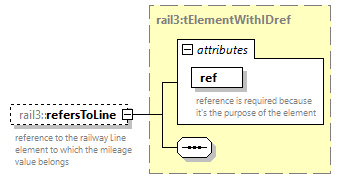 | ||||||||||||||
| namespace | https://www.railml.org/schemas/3.2 | ||||||||||||||
| type | rail3:tElementWithIDref | ||||||||||||||
| properties |
| ||||||||||||||
| attributes |
| ||||||||||||||
| annotation |
| ||||||||||||||
| source | <xs:element name="refersToLine" type="rail3:tElementWithIDref" minOccurs="0" maxOccurs="1"> <xs:annotation> <xs:documentation>reference to the railway Line element to which the mileage value belongs</xs:documentation> </xs:annotation> </xs:element> |
complexType SignalRadio
| diagram | 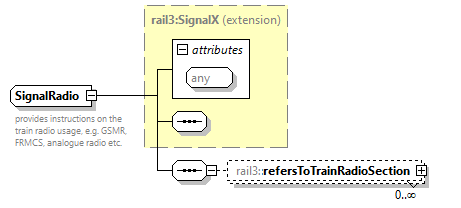 | ||||||
| namespace | https://www.railml.org/schemas/3.2 | ||||||
| type | extension of rail3:SignalX | ||||||
| properties |
| ||||||
| children | rail3:refersToTrainRadioSection | ||||||
| used by |
| ||||||
| attributes |
| ||||||
| annotation |
| ||||||
| source | <xs:complexType name="SignalRadio"> <xs:annotation> <xs:documentation>provides instructions on the train radio usage, e.g. GSMR, FRMCS, analogue radio etc.</xs:documentation> </xs:annotation> <xs:complexContent> <xs:extension base="rail3:SignalX"> <xs:sequence> <xs:element name="refersToTrainRadioSection" type="rail3:tElementWithIDref" minOccurs="0" maxOccurs="unbounded"/> </xs:sequence> </xs:extension> </xs:complexContent> </xs:complexType> |
element SignalRadio/refersToTrainRadioSection
| diagram | 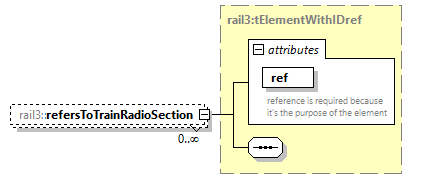 | ||||||||||||||
| namespace | https://www.railml.org/schemas/3.2 | ||||||||||||||
| type | rail3:tElementWithIDref | ||||||||||||||
| properties |
| ||||||||||||||
| attributes |
| ||||||||||||||
| source | <xs:element name="refersToTrainRadioSection" type="rail3:tElementWithIDref" minOccurs="0" maxOccurs="unbounded"/> |
complexType SignalsIS
| diagram | 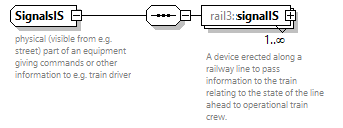 | ||
| namespace | https://www.railml.org/schemas/3.2 | ||
| children | rail3:signalIS | ||
| used by |
| ||
| annotation |
| ||
| source | <xs:complexType name="SignalsIS"> <xs:annotation> <xs:documentation>physical (visible from e.g. street) part of an equipment giving commands or other information to e.g. train driver</xs:documentation> </xs:annotation> <xs:sequence> <xs:element name="signalIS" type="rail3:SignalIS" minOccurs="1" maxOccurs="unbounded"> <xs:annotation> <xs:documentation>A device erected along a railway line to pass information to the train relating to the state of the line ahead to operational train crew.</xs:documentation> </xs:annotation> </xs:element> </xs:sequence> </xs:complexType> |
element SignalsIS/signalIS
| diagram |  | ||||||||||||||||||||||||||||||||||||||
| namespace | https://www.railml.org/schemas/3.2 | ||||||||||||||||||||||||||||||||||||||
| type | rail3:SignalIS | ||||||||||||||||||||||||||||||||||||||
| properties |
| ||||||||||||||||||||||||||||||||||||||
| children | rail3:name rail3:isValid rail3:areaLocation rail3:linearLocation rail3:spotLocation rail3:gmlLocations rail3:networkLocation rail3:designator rail3:external rail3:typeDesignator rail3:isAnnouncementSignal rail3:isCatenarySignal rail3:isDangerSignal rail3:isEtcsSignal rail3:isInformationSignal rail3:isLevelCrossingSignal rail3:isMilepost rail3:isSpeedSignal rail3:isStopPost rail3:isTrainMovementSignal rail3:isTrainRadioSignal rail3:isVehicleEquipmentSignal rail3:connectedWithBaliseGroup rail3:protectedByBaliseGroup rail3:signalConstruction | ||||||||||||||||||||||||||||||||||||||
| attributes |
| ||||||||||||||||||||||||||||||||||||||
| annotation |
| ||||||||||||||||||||||||||||||||||||||
| source | <xs:element name="signalIS" type="rail3:SignalIS" minOccurs="1" maxOccurs="unbounded"> <xs:annotation> <xs:documentation>A device erected along a railway line to pass information to the train relating to the state of the line ahead to operational train crew.</xs:documentation> </xs:annotation> </xs:element> |
complexType SignalSpeed
| diagram | 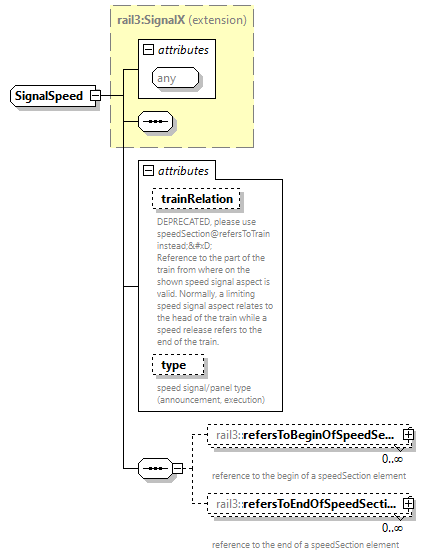 | ||||||||||||||||||||||
| namespace | https://www.railml.org/schemas/3.2 | ||||||||||||||||||||||
| type | extension of rail3:SignalX | ||||||||||||||||||||||
| properties |
| ||||||||||||||||||||||
| children | rail3:refersToBeginOfSpeedSection rail3:refersToEndOfSpeedSection | ||||||||||||||||||||||
| used by |
| ||||||||||||||||||||||
| attributes |
| ||||||||||||||||||||||
| source | <xs:complexType name="SignalSpeed"> <xs:complexContent> <xs:extension base="rail3:SignalX"> <xs:sequence> <xs:element name="refersToBeginOfSpeedSection" type="rail3:tElementWithIDref" minOccurs="0" maxOccurs="unbounded"> <xs:annotation> <xs:documentation>reference to the begin of a speedSection element</xs:documentation> </xs:annotation> </xs:element> <xs:element name="refersToEndOfSpeedSection" type="rail3:tElementWithIDref" minOccurs="0" maxOccurs="unbounded"> <xs:annotation> <xs:documentation>reference to the end of a speedSection element</xs:documentation> </xs:annotation> </xs:element> </xs:sequence> <xs:attribute name="trainRelation" type="rail3:tTrainRelation" use="optional"> <xs:annotation> <xs:documentation>DEPRECATED, please use speedSection@refersToTrain instead;
 Reference to the part of the train from where on the shown speed signal aspect is valid. Normally, a limiting speed signal aspect relates to the head of the train while a speed release refers to the end of the train.</xs:documentation> </xs:annotation> </xs:attribute> <xs:attribute name="type" type="rail3:tSignalSpeedType" use="optional"> <xs:annotation> <xs:documentation>speed signal/panel type (announcement, execution)</xs:documentation> </xs:annotation> </xs:attribute> </xs:extension> </xs:complexContent> </xs:complexType> |
attribute SignalSpeed/@trainRelation
| type | rail3:tTrainRelation | ||||||||||||||||||
| properties |
| ||||||||||||||||||
| facets |
| ||||||||||||||||||
| annotation |
| ||||||||||||||||||
| source | <xs:attribute name="trainRelation" type="rail3:tTrainRelation" use="optional"> <xs:annotation> <xs:documentation>DEPRECATED, please use speedSection@refersToTrain instead;
 Reference to the part of the train from where on the shown speed signal aspect is valid. Normally, a limiting speed signal aspect relates to the head of the train while a speed release refers to the end of the train.</xs:documentation> </xs:annotation> </xs:attribute> |
attribute SignalSpeed/@type
| type | rail3:tSignalSpeedType | |||||||||||||
| properties |
| |||||||||||||
| facets |
| |||||||||||||
| annotation |
| |||||||||||||
| source | <xs:attribute name="type" type="rail3:tSignalSpeedType" use="optional"> <xs:annotation> <xs:documentation>speed signal/panel type (announcement, execution)</xs:documentation> </xs:annotation> </xs:attribute> |
element SignalSpeed/refersToBeginOfSpeedSection
| diagram | 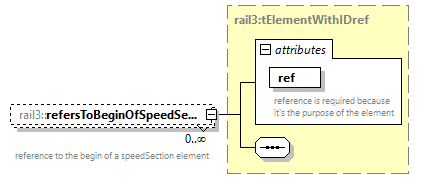 | ||||||||||||||
| namespace | https://www.railml.org/schemas/3.2 | ||||||||||||||
| type | rail3:tElementWithIDref | ||||||||||||||
| properties |
| ||||||||||||||
| attributes |
| ||||||||||||||
| annotation |
| ||||||||||||||
| source | <xs:element name="refersToBeginOfSpeedSection" type="rail3:tElementWithIDref" minOccurs="0" maxOccurs="unbounded"> <xs:annotation> <xs:documentation>reference to the begin of a speedSection element</xs:documentation> </xs:annotation> </xs:element> |
element SignalSpeed/refersToEndOfSpeedSection
| diagram | 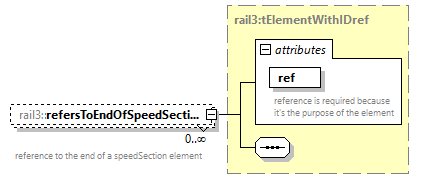 | ||||||||||||||
| namespace | https://www.railml.org/schemas/3.2 | ||||||||||||||
| type | rail3:tElementWithIDref | ||||||||||||||
| properties |
| ||||||||||||||
| attributes |
| ||||||||||||||
| annotation |
| ||||||||||||||
| source | <xs:element name="refersToEndOfSpeedSection" type="rail3:tElementWithIDref" minOccurs="0" maxOccurs="unbounded"> <xs:annotation> <xs:documentation>reference to the end of a speedSection element</xs:documentation> </xs:annotation> </xs:element> |
complexType SignalStopPost
| diagram | 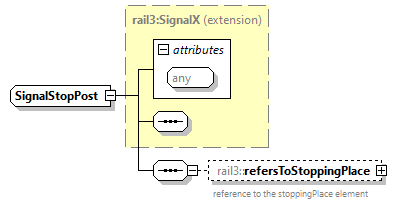 | ||||||
| namespace | https://www.railml.org/schemas/3.2 | ||||||
| type | extension of rail3:SignalX | ||||||
| properties |
| ||||||
| children | rail3:refersToStoppingPlace | ||||||
| used by |
| ||||||
| attributes |
| ||||||
| source | <xs:complexType name="SignalStopPost"> <xs:complexContent> <xs:extension base="rail3:SignalX"> <xs:sequence> <xs:element name="refersToStoppingPlace" type="rail3:tElementWithIDref" minOccurs="0" maxOccurs="1"> <xs:annotation> <xs:documentation>reference to the stoppingPlace element</xs:documentation> </xs:annotation> </xs:element> </xs:sequence> </xs:extension> </xs:complexContent> </xs:complexType> |
element SignalStopPost/refersToStoppingPlace
| diagram | 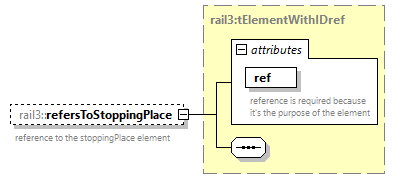 | ||||||||||||||
| namespace | https://www.railml.org/schemas/3.2 | ||||||||||||||
| type | rail3:tElementWithIDref | ||||||||||||||
| properties |
| ||||||||||||||
| attributes |
| ||||||||||||||
| annotation |
| ||||||||||||||
| source | <xs:element name="refersToStoppingPlace" type="rail3:tElementWithIDref" minOccurs="0" maxOccurs="1"> <xs:annotation> <xs:documentation>reference to the stoppingPlace element</xs:documentation> </xs:annotation> </xs:element> |
complexType SignalTrainMovement
| diagram | 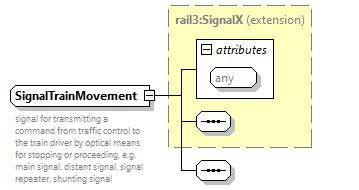 | ||||||
| namespace | https://www.railml.org/schemas/3.2 | ||||||
| type | extension of rail3:SignalX | ||||||
| properties |
| ||||||
| used by |
| ||||||
| attributes |
| ||||||
| annotation |
| ||||||
| source | <xs:complexType name="SignalTrainMovement"> <xs:annotation> <xs:documentation>signal for transmitting a command from traffic control to the train driver by optical means for stopping or proceeding, e.g. main signal, distant signal, signal repeater, shunting signal</xs:documentation> </xs:annotation> <xs:complexContent> <xs:extension base="rail3:SignalX"> <xs:sequence/> </xs:extension> </xs:complexContent> </xs:complexType> |
complexType SignalVehicleEquipment
| diagram | 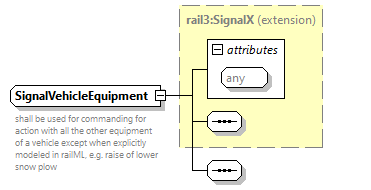 | ||||||
| namespace | https://www.railml.org/schemas/3.2 | ||||||
| type | extension of rail3:SignalX | ||||||
| properties |
| ||||||
| used by |
| ||||||
| attributes |
| ||||||
| annotation |
| ||||||
| source | <xs:complexType name="SignalVehicleEquipment"> <xs:annotation> <xs:documentation>shall be used for commanding for action with all the other equipment of a vehicle except when explicitly modeled in railML, e.g. raise of lower snow plow</xs:documentation> </xs:annotation> <xs:complexContent> <xs:extension base="rail3:SignalX"> <xs:sequence/> </xs:extension> </xs:complexContent> </xs:complexType> |
complexType SignalX
| diagram | 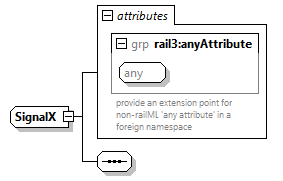 | ||||||
| namespace | https://www.railml.org/schemas/3.2 | ||||||
| properties |
| ||||||
| used by |
| ||||||
| attributes |
| ||||||
| source | <xs:complexType name="SignalX" abstract="true"> <xs:sequence/> <xs:attributeGroup ref="rail3:anyAttribute"/> </xs:complexType> |
complexType Speeds
| diagram |  | ||
| namespace | https://www.railml.org/schemas/3.2 | ||
| children | rail3:speedSection | ||
| used by |
| ||
| source | <xs:complexType name="Speeds"> <xs:sequence> <xs:element name="speedSection" type="rail3:SpeedSection" minOccurs="1" maxOccurs="unbounded"> <xs:annotation> <xs:documentation>locates part of a track where given permanent speed restriction is applicable</xs:documentation> </xs:annotation> </xs:element> </xs:sequence> </xs:complexType> |
element Speeds/speedSection
| diagram |  | ||||||||||||||||||||||||||||||||||||||||||||||
| namespace | https://www.railml.org/schemas/3.2 | ||||||||||||||||||||||||||||||||||||||||||||||
| type | rail3:SpeedSection | ||||||||||||||||||||||||||||||||||||||||||||||
| properties |
| ||||||||||||||||||||||||||||||||||||||||||||||
| children | rail3:name rail3:isValid rail3:areaLocation rail3:linearLocation rail3:spotLocation rail3:gmlLocations rail3:networkLocation rail3:designator rail3:external rail3:typeDesignator rail3:validForSpeedProfile | ||||||||||||||||||||||||||||||||||||||||||||||
| attributes |
| ||||||||||||||||||||||||||||||||||||||||||||||
| annotation |
| ||||||||||||||||||||||||||||||||||||||||||||||
| source | <xs:element name="speedSection" type="rail3:SpeedSection" minOccurs="1" maxOccurs="unbounded"> <xs:annotation> <xs:documentation>locates part of a track where given permanent speed restriction is applicable</xs:documentation> </xs:annotation> </xs:element> |
complexType SpeedSection
| diagram |  | ||||||||||||||||||||||||||||||||||||||||||||||
| namespace | https://www.railml.org/schemas/3.2 | ||||||||||||||||||||||||||||||||||||||||||||||
| type | extension of rail3:FunctionalInfrastructureEntity | ||||||||||||||||||||||||||||||||||||||||||||||
| properties |
| ||||||||||||||||||||||||||||||||||||||||||||||
| children | rail3:name rail3:isValid rail3:areaLocation rail3:linearLocation rail3:spotLocation rail3:gmlLocations rail3:networkLocation rail3:designator rail3:external rail3:typeDesignator rail3:validForSpeedProfile | ||||||||||||||||||||||||||||||||||||||||||||||
| used by |
| ||||||||||||||||||||||||||||||||||||||||||||||
| attributes |
| ||||||||||||||||||||||||||||||||||||||||||||||
| annotation |
| ||||||||||||||||||||||||||||||||||||||||||||||
| source | <xs:complexType name="SpeedSection"> <xs:annotation> <xs:documentation>locates part of a track where given permanent speed restriction is applicable</xs:documentation> </xs:annotation> <xs:complexContent> <xs:extension base="rail3:FunctionalInfrastructureEntity"> <xs:sequence> <xs:element name="validForSpeedProfile" type="rail3:tElementWithIDref" minOccurs="0" maxOccurs="unbounded"> <xs:annotation> <xs:documentation>reference the <speedProfile> element(s) for which the <speedSection> shall be valid</xs:documentation> </xs:annotation> </xs:element> </xs:sequence> <xs:attribute name="isSignalized" type="xs:boolean" use="optional"> <xs:annotation> <xs:documentation>indicates whether the speed aspect is shown next to the track by a signal or panel (true) or only in the "driver's timetable" (false)</xs:documentation> </xs:annotation> </xs:attribute> <xs:attribute name="isTemporary" type="xs:boolean" use="optional"> <xs:annotation> <xs:documentation>boolean value to indicate whether the speed section is temporary</xs:documentation> </xs:annotation> </xs:attribute> <xs:attribute name="maxSpeed" type="rail3:tVMax" use="optional"> <xs:annotation> <xs:documentation>maximum permitted speed in the speed section, in [km/h]</xs:documentation> </xs:annotation> </xs:attribute> <xs:attribute name="refersToTrain" type="rail3:tTrainRelation" use="optional"> <xs:annotation> <xs:documentation>Reference to the part of the train from where on the speed aspect is valid. Normally, a limiting speed signal aspect relates to the head of the train while a speed release refers to the end of the train. In ETCS this is usually refered to as Q_FRONT</xs:documentation> </xs:annotation> </xs:attribute> </xs:extension> </xs:complexContent> </xs:complexType> |
attribute SpeedSection/@isSignalized
| type | xs:boolean | ||
| properties |
| ||
| annotation |
| ||
| source | <xs:attribute name="isSignalized" type="xs:boolean" use="optional"> <xs:annotation> <xs:documentation>indicates whether the speed aspect is shown next to the track by a signal or panel (true) or only in the "driver's timetable" (false)</xs:documentation> </xs:annotation> </xs:attribute> |
attribute SpeedSection/@isTemporary
| type | xs:boolean | ||
| properties |
| ||
| annotation |
| ||
| source | <xs:attribute name="isTemporary" type="xs:boolean" use="optional"> <xs:annotation> <xs:documentation>boolean value to indicate whether the speed section is temporary</xs:documentation> </xs:annotation> </xs:attribute> |
attribute SpeedSection/@maxSpeed
| type | rail3:tVMax | ||
| properties |
| ||
| annotation |
| ||
| source | <xs:attribute name="maxSpeed" type="rail3:tVMax" use="optional"> <xs:annotation> <xs:documentation>maximum permitted speed in the speed section, in [km/h]</xs:documentation> </xs:annotation> </xs:attribute> |
attribute SpeedSection/@refersToTrain
| type | rail3:tTrainRelation | ||||||||||||||||||
| properties |
| ||||||||||||||||||
| facets |
| ||||||||||||||||||
| annotation |
| ||||||||||||||||||
| source | <xs:attribute name="refersToTrain" type="rail3:tTrainRelation" use="optional"> <xs:annotation> <xs:documentation>Reference to the part of the train from where on the speed aspect is valid. Normally, a limiting speed signal aspect relates to the head of the train while a speed release refers to the end of the train. In ETCS this is usually refered to as Q_FRONT</xs:documentation> </xs:annotation> </xs:attribute> |
element SpeedSection/validForSpeedProfile
| diagram | 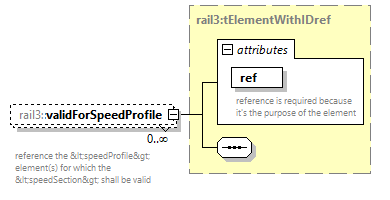 | ||||||||||||||
| namespace | https://www.railml.org/schemas/3.2 | ||||||||||||||
| type | rail3:tElementWithIDref | ||||||||||||||
| properties |
| ||||||||||||||
| attributes |
| ||||||||||||||
| annotation |
| ||||||||||||||
| source | <xs:element name="validForSpeedProfile" type="rail3:tElementWithIDref" minOccurs="0" maxOccurs="unbounded"> <xs:annotation> <xs:documentation>reference the <speedProfile> element(s) for which the <speedSection> shall be valid</xs:documentation> </xs:annotation> </xs:element> |
complexType StatesBaseElement
| diagram | 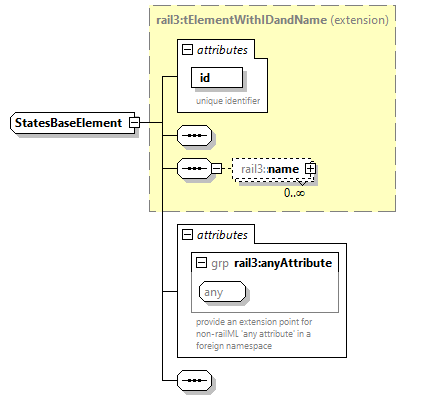 | ||||||||||||||
| namespace | https://www.railml.org/schemas/3.2 | ||||||||||||||
| type | extension of rail3:tElementWithIDandName | ||||||||||||||
| properties |
| ||||||||||||||
| children | rail3:name | ||||||||||||||
| used by |
| ||||||||||||||
| attributes |
| ||||||||||||||
| source | <xs:complexType name="StatesBaseElement"> <xs:complexContent> <xs:extension base="rail3:tElementWithIDandName"> <xs:sequence/> <xs:attributeGroup ref="rail3:anyAttribute"/> </xs:extension> </xs:complexContent> </xs:complexType> |
complexType StoppingPlace
| diagram |  | ||||||||||||||||||||||||||||||||||||||||||||||||||||||||||||||||||||||
| namespace | https://www.railml.org/schemas/3.2 | ||||||||||||||||||||||||||||||||||||||||||||||||||||||||||||||||||||||
| type | extension of rail3:FunctionalInfrastructureEntity | ||||||||||||||||||||||||||||||||||||||||||||||||||||||||||||||||||||||
| properties |
| ||||||||||||||||||||||||||||||||||||||||||||||||||||||||||||||||||||||
| children | rail3:name rail3:isValid rail3:areaLocation rail3:linearLocation rail3:spotLocation rail3:gmlLocations rail3:networkLocation rail3:designator rail3:external rail3:typeDesignator rail3:allowsUsageOfPlatformEdge rail3:validForTrainMovement | ||||||||||||||||||||||||||||||||||||||||||||||||||||||||||||||||||||||
| used by |
| ||||||||||||||||||||||||||||||||||||||||||||||||||||||||||||||||||||||
| attributes |
| ||||||||||||||||||||||||||||||||||||||||||||||||||||||||||||||||||||||
| annotation |
| ||||||||||||||||||||||||||||||||||||||||||||||||||||||||||||||||||||||
| source | <xs:complexType name="StoppingPlace"> <xs:annotation> <xs:documentation>mark a position on a track, where a train, which fulfills certain criteria, needs to stop in order to change passengers or because of other operational rules.</xs:documentation> </xs:annotation> <xs:complexContent> <xs:extension base="rail3:FunctionalInfrastructureEntity"> <xs:sequence> <xs:element name="allowsUsageOfPlatformEdge" type="rail3:tElementWithIDref" minOccurs="0" maxOccurs="unbounded"> <xs:annotation> <xs:documentation>reference the platform edges linked with this stopping place</xs:documentation> </xs:annotation> </xs:element> <xs:element name="validForTrainMovement" type="rail3:TrainMovement" minOccurs="0" maxOccurs="unbounded"> <xs:annotation> <xs:documentation>specify the train movement types for which the stopping place is valid (freight trains, passenger trains, ...)</xs:documentation> </xs:annotation> </xs:element> </xs:sequence> <xs:attributeGroup ref="rail3:aStoppingPlace"/> </xs:extension> </xs:complexContent> </xs:complexType> |
element StoppingPlace/allowsUsageOfPlatformEdge
| diagram | 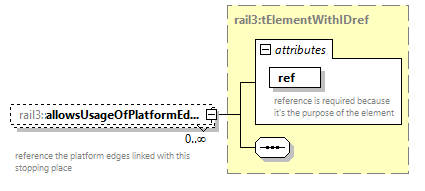 | ||||||||||||||
| namespace | https://www.railml.org/schemas/3.2 | ||||||||||||||
| type | rail3:tElementWithIDref | ||||||||||||||
| properties |
| ||||||||||||||
| attributes |
| ||||||||||||||
| annotation |
| ||||||||||||||
| source | <xs:element name="allowsUsageOfPlatformEdge" type="rail3:tElementWithIDref" minOccurs="0" maxOccurs="unbounded"> <xs:annotation> <xs:documentation>reference the platform edges linked with this stopping place</xs:documentation> </xs:annotation> </xs:element> |
element StoppingPlace/validForTrainMovement
| diagram | 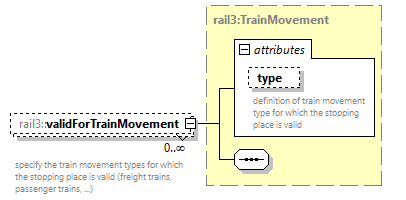 | ||||||||||||||
| namespace | https://www.railml.org/schemas/3.2 | ||||||||||||||
| type | rail3:TrainMovement | ||||||||||||||
| properties |
| ||||||||||||||
| attributes |
| ||||||||||||||
| annotation |
| ||||||||||||||
| source | <xs:element name="validForTrainMovement" type="rail3:TrainMovement" minOccurs="0" maxOccurs="unbounded"> <xs:annotation> <xs:documentation>specify the train movement types for which the stopping place is valid (freight trains, passenger trains, ...)</xs:documentation> </xs:annotation> </xs:element> |
complexType StoppingPlaces
| diagram |  | ||
| namespace | https://www.railml.org/schemas/3.2 | ||
| children | rail3:stoppingPlace | ||
| used by |
| ||
| source | <xs:complexType name="StoppingPlaces"> <xs:sequence> <xs:element name="stoppingPlace" type="rail3:StoppingPlace" minOccurs="1" maxOccurs="unbounded"/> </xs:sequence> </xs:complexType> |
element StoppingPlaces/stoppingPlace
| diagram |  | ||||||||||||||||||||||||||||||||||||||||||||||||||||||||||||||||||||||
| namespace | https://www.railml.org/schemas/3.2 | ||||||||||||||||||||||||||||||||||||||||||||||||||||||||||||||||||||||
| type | rail3:StoppingPlace | ||||||||||||||||||||||||||||||||||||||||||||||||||||||||||||||||||||||
| properties |
| ||||||||||||||||||||||||||||||||||||||||||||||||||||||||||||||||||||||
| children | rail3:name rail3:isValid rail3:areaLocation rail3:linearLocation rail3:spotLocation rail3:gmlLocations rail3:networkLocation rail3:designator rail3:external rail3:typeDesignator rail3:allowsUsageOfPlatformEdge rail3:validForTrainMovement | ||||||||||||||||||||||||||||||||||||||||||||||||||||||||||||||||||||||
| attributes |
| ||||||||||||||||||||||||||||||||||||||||||||||||||||||||||||||||||||||
| source | <xs:element name="stoppingPlace" type="rail3:StoppingPlace" minOccurs="1" maxOccurs="unbounded"/> |
complexType SwitchCrossingBranch
| diagram | 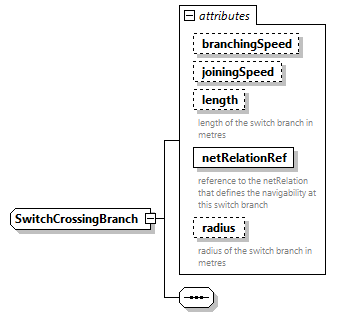 | ||||||||||||||||||||||||||||||||||||||||||
| namespace | https://www.railml.org/schemas/3.2 | ||||||||||||||||||||||||||||||||||||||||||
| used by |
| ||||||||||||||||||||||||||||||||||||||||||
| attributes |
| ||||||||||||||||||||||||||||||||||||||||||
| source | <xs:complexType name="SwitchCrossingBranch"> <xs:sequence/> <xs:attribute name="branchingSpeed" type="rail3:tSpeedKmPerHour" use="optional"/> <xs:attribute name="joiningSpeed" type="rail3:tSpeedKmPerHour" use="optional"/> <xs:attribute name="length" type="rail3:tLengthM" use="optional"> <xs:annotation> <xs:documentation>length of the switch branch in metres</xs:documentation> </xs:annotation> </xs:attribute> <xs:attribute name="netRelationRef" type="rail3:tRef" use="required"> <xs:annotation> <xs:documentation>reference to the netRelation that defines the navigability at this switch branch</xs:documentation> </xs:annotation> </xs:attribute> <xs:attribute name="radius" type="rail3:tLengthM" use="optional"> <xs:annotation> <xs:documentation>radius of the switch branch in metres</xs:documentation> </xs:annotation> </xs:attribute> </xs:complexType> |
attribute SwitchCrossingBranch/@branchingSpeed
| type | rail3:tSpeedKmPerHour | ||
| properties |
| ||
| source | <xs:attribute name="branchingSpeed" type="rail3:tSpeedKmPerHour" use="optional"/> |
attribute SwitchCrossingBranch/@joiningSpeed
| type | rail3:tSpeedKmPerHour | ||
| properties |
| ||
| source | <xs:attribute name="joiningSpeed" type="rail3:tSpeedKmPerHour" use="optional"/> |
attribute SwitchCrossingBranch/@length
| type | rail3:tLengthM | ||
| properties |
| ||
| annotation |
| ||
| source | <xs:attribute name="length" type="rail3:tLengthM" use="optional"> <xs:annotation> <xs:documentation>length of the switch branch in metres</xs:documentation> </xs:annotation> </xs:attribute> |
attribute SwitchCrossingBranch/@netRelationRef
| type | rail3:tRef | ||
| properties |
| ||
| annotation |
| ||
| source | <xs:attribute name="netRelationRef" type="rail3:tRef" use="required"> <xs:annotation> <xs:documentation>reference to the netRelation that defines the navigability at this switch branch</xs:documentation> </xs:annotation> </xs:attribute> |
attribute SwitchCrossingBranch/@radius
| type | rail3:tLengthM | ||
| properties |
| ||
| annotation |
| ||
| source | <xs:attribute name="radius" type="rail3:tLengthM" use="optional"> <xs:annotation> <xs:documentation>radius of the switch branch in metres</xs:documentation> </xs:annotation> </xs:attribute> |
complexType SwitchesIS
| diagram | 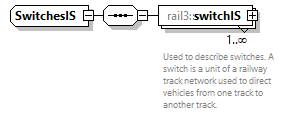 | ||
| namespace | https://www.railml.org/schemas/3.2 | ||
| children | rail3:switchIS | ||
| used by |
| ||
| source | <xs:complexType name="SwitchesIS"> <xs:sequence> <xs:element name="switchIS" type="rail3:SwitchIS" minOccurs="1" maxOccurs="unbounded"> <xs:annotation> <xs:documentation>Used to describe switches. A switch is a unit of a railway track network used to direct vehicles from one track to another track.</xs:documentation> </xs:annotation> </xs:element> </xs:sequence> </xs:complexType> |
element SwitchesIS/switchIS
| diagram |  | ||||||||||||||||||||||||||||||||||||||||||||||||||||||
| namespace | https://www.railml.org/schemas/3.2 | ||||||||||||||||||||||||||||||||||||||||||||||||||||||
| type | rail3:SwitchIS | ||||||||||||||||||||||||||||||||||||||||||||||||||||||
| properties |
| ||||||||||||||||||||||||||||||||||||||||||||||||||||||
| children | rail3:name rail3:isValid rail3:areaLocation rail3:linearLocation rail3:spotLocation rail3:gmlLocations rail3:networkLocation rail3:designator rail3:external rail3:typeDesignator rail3:leftBranch rail3:rightBranch rail3:straightBranch rail3:turningBranch rail3:locationReference | ||||||||||||||||||||||||||||||||||||||||||||||||||||||
| attributes |
| ||||||||||||||||||||||||||||||||||||||||||||||||||||||
| annotation |
| ||||||||||||||||||||||||||||||||||||||||||||||||||||||
| source | <xs:element name="switchIS" type="rail3:SwitchIS" minOccurs="1" maxOccurs="unbounded"> <xs:annotation> <xs:documentation>Used to describe switches. A switch is a unit of a railway track network used to direct vehicles from one track to another track.</xs:documentation> </xs:annotation> </xs:element> |
complexType SwitchIS
| diagram |  | ||||||||||||||||||||||||||||||||||||||||||||||||||||||
| namespace | https://www.railml.org/schemas/3.2 | ||||||||||||||||||||||||||||||||||||||||||||||||||||||
| type | extension of rail3:TrackNode | ||||||||||||||||||||||||||||||||||||||||||||||||||||||
| properties |
| ||||||||||||||||||||||||||||||||||||||||||||||||||||||
| children | rail3:name rail3:isValid rail3:areaLocation rail3:linearLocation rail3:spotLocation rail3:gmlLocations rail3:networkLocation rail3:designator rail3:external rail3:typeDesignator rail3:leftBranch rail3:rightBranch rail3:straightBranch rail3:turningBranch rail3:locationReference | ||||||||||||||||||||||||||||||||||||||||||||||||||||||
| used by |
| ||||||||||||||||||||||||||||||||||||||||||||||||||||||
| attributes |
| ||||||||||||||||||||||||||||||||||||||||||||||||||||||
| annotation |
| ||||||||||||||||||||||||||||||||||||||||||||||||||||||
| source | <xs:complexType name="SwitchIS"> <xs:annotation> <xs:documentation>a unit of railway track network used to direct vehicles from one track to another track.</xs:documentation> </xs:annotation> <xs:complexContent> <xs:extension base="rail3:TrackNode"> <xs:sequence> <xs:element name="leftBranch" type="rail3:SwitchCrossingBranch" minOccurs="0" maxOccurs="1"> <xs:annotation> <xs:documentation>left branch of the switch as seen from switch begin (application direction)</xs:documentation> </xs:annotation> </xs:element> <xs:element name="rightBranch" type="rail3:SwitchCrossingBranch" minOccurs="0" maxOccurs="1"> <xs:annotation> <xs:documentation>right branch of the switch as seen from switch begin (application direction)</xs:documentation> </xs:annotation> </xs:element> <xs:element name="straightBranch" type="rail3:SwitchCrossingBranch" minOccurs="0" maxOccurs="2"> <xs:annotation> <xs:documentation>only for switch crossings: straight branch</xs:documentation> </xs:annotation> </xs:element> <xs:element name="turningBranch" type="rail3:SwitchCrossingBranch" minOccurs="0" maxOccurs="2"> <xs:annotation> <xs:documentation>only for switch crossings: turning branch</xs:documentation> </xs:annotation> </xs:element> <xs:element name="locationReference" type="rail3:SwitchLocationReference" minOccurs="0" maxOccurs="1"> <xs:annotation> <xs:documentation>Defines the reference location of the switch along with the switch tangent length. Needs to be specified only if positioning of the switch in the topology is realized by a spot location.</xs:documentation> </xs:annotation> </xs:element> </xs:sequence> <xs:attribute name="basedOnTemplate" type="rail3:tRef" use="optional"> <xs:annotation> <xs:documentation>reference to a generic switch</xs:documentation> </xs:annotation> </xs:attribute> <xs:attribute name="belongsToParent" type="rail3:tRef" use="optional"> <xs:annotation> <xs:documentation>reference to the one an only parent switch of this switch (to be used at switch crossings)
 
 - if some information exists in parent and child, then information in child overwrites it in child
 
 - if some information exists only in parent, then child inherits this information from parent</xs:documentation> </xs:annotation> </xs:attribute> <xs:attribute name="branchCourse" type="rail3:tCourse" use="optional"> <xs:annotation> <xs:documentation>defines the switch branching track route (as seen from begin of switch, application direction)</xs:documentation> </xs:annotation> </xs:attribute> <xs:attribute name="continueCourse" type="rail3:tCourse" use="optional"> <xs:annotation> <xs:documentation>defines the switch main track route (as seen from begin of switch, application direction)</xs:documentation> </xs:annotation> </xs:attribute> <xs:attribute name="type" type="rail3:tSwitchType" use="optional"> <xs:annotation> <xs:documentation>type of the switch</xs:documentation> </xs:annotation> </xs:attribute> </xs:extension> </xs:complexContent> </xs:complexType> |
attribute SwitchIS/@basedOnTemplate
| type | rail3:tRef | ||
| properties |
| ||
| annotation |
| ||
| source | <xs:attribute name="basedOnTemplate" type="rail3:tRef" use="optional"> <xs:annotation> <xs:documentation>reference to a generic switch</xs:documentation> </xs:annotation> </xs:attribute> |
attribute SwitchIS/@belongsToParent
| type | rail3:tRef | ||
| properties |
| ||
| annotation |
| ||
| source | <xs:attribute name="belongsToParent" type="rail3:tRef" use="optional"> <xs:annotation> <xs:documentation>reference to the one an only parent switch of this switch (to be used at switch crossings)
 
 - if some information exists in parent and child, then information in child overwrites it in child
 
 - if some information exists only in parent, then child inherits this information from parent</xs:documentation> </xs:annotation> </xs:attribute> |
attribute SwitchIS/@branchCourse
| type | rail3:tCourse | |||||||||
| properties |
| |||||||||
| facets |
| |||||||||
| annotation |
| |||||||||
| source | <xs:attribute name="branchCourse" type="rail3:tCourse" use="optional"> <xs:annotation> <xs:documentation>defines the switch branching track route (as seen from begin of switch, application direction)</xs:documentation> </xs:annotation> </xs:attribute> |
attribute SwitchIS/@continueCourse
| type | rail3:tCourse | |||||||||
| properties |
| |||||||||
| facets |
| |||||||||
| annotation |
| |||||||||
| source | <xs:attribute name="continueCourse" type="rail3:tCourse" use="optional"> <xs:annotation> <xs:documentation>defines the switch main track route (as seen from begin of switch, application direction)</xs:documentation> </xs:annotation> </xs:attribute> |
attribute SwitchIS/@type
| type | rail3:tSwitchType | |||||||||||||||||||||||||||
| properties |
| |||||||||||||||||||||||||||
| facets |
| |||||||||||||||||||||||||||
| annotation |
| |||||||||||||||||||||||||||
| source | <xs:attribute name="type" type="rail3:tSwitchType" use="optional"> <xs:annotation> <xs:documentation>type of the switch</xs:documentation> </xs:annotation> </xs:attribute> |
element SwitchIS/leftBranch
| diagram | 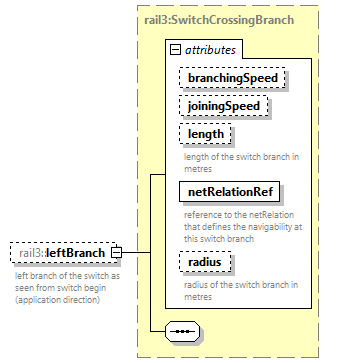 | ||||||||||||||||||||||||||||||||||||||||||
| namespace | https://www.railml.org/schemas/3.2 | ||||||||||||||||||||||||||||||||||||||||||
| type | rail3:SwitchCrossingBranch | ||||||||||||||||||||||||||||||||||||||||||
| properties |
| ||||||||||||||||||||||||||||||||||||||||||
| attributes |
| ||||||||||||||||||||||||||||||||||||||||||
| annotation |
| ||||||||||||||||||||||||||||||||||||||||||
| source | <xs:element name="leftBranch" type="rail3:SwitchCrossingBranch" minOccurs="0" maxOccurs="1"> <xs:annotation> <xs:documentation>left branch of the switch as seen from switch begin (application direction)</xs:documentation> </xs:annotation> </xs:element> |
element SwitchIS/rightBranch
| diagram | 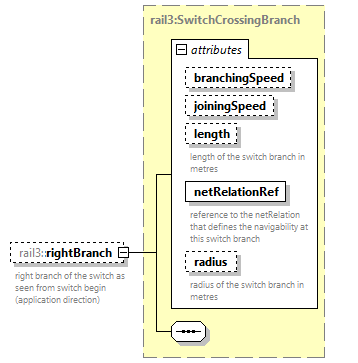 | ||||||||||||||||||||||||||||||||||||||||||
| namespace | https://www.railml.org/schemas/3.2 | ||||||||||||||||||||||||||||||||||||||||||
| type | rail3:SwitchCrossingBranch | ||||||||||||||||||||||||||||||||||||||||||
| properties |
| ||||||||||||||||||||||||||||||||||||||||||
| attributes |
| ||||||||||||||||||||||||||||||||||||||||||
| annotation |
| ||||||||||||||||||||||||||||||||||||||||||
| source | <xs:element name="rightBranch" type="rail3:SwitchCrossingBranch" minOccurs="0" maxOccurs="1"> <xs:annotation> <xs:documentation>right branch of the switch as seen from switch begin (application direction)</xs:documentation> </xs:annotation> </xs:element> |
element SwitchIS/straightBranch
| diagram | 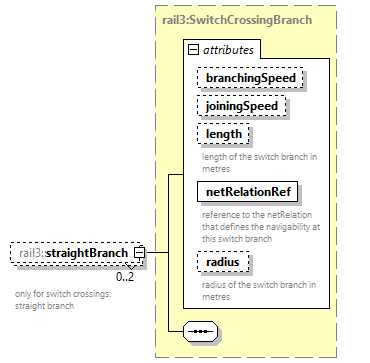 | ||||||||||||||||||||||||||||||||||||||||||
| namespace | https://www.railml.org/schemas/3.2 | ||||||||||||||||||||||||||||||||||||||||||
| type | rail3:SwitchCrossingBranch | ||||||||||||||||||||||||||||||||||||||||||
| properties |
| ||||||||||||||||||||||||||||||||||||||||||
| attributes |
| ||||||||||||||||||||||||||||||||||||||||||
| annotation |
| ||||||||||||||||||||||||||||||||||||||||||
| source | <xs:element name="straightBranch" type="rail3:SwitchCrossingBranch" minOccurs="0" maxOccurs="2"> <xs:annotation> <xs:documentation>only for switch crossings: straight branch</xs:documentation> </xs:annotation> </xs:element> |
element SwitchIS/turningBranch
| diagram | 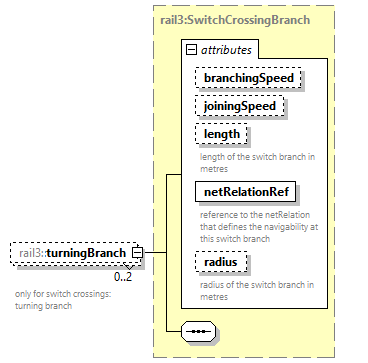 | ||||||||||||||||||||||||||||||||||||||||||
| namespace | https://www.railml.org/schemas/3.2 | ||||||||||||||||||||||||||||||||||||||||||
| type | rail3:SwitchCrossingBranch | ||||||||||||||||||||||||||||||||||||||||||
| properties |
| ||||||||||||||||||||||||||||||||||||||||||
| attributes |
| ||||||||||||||||||||||||||||||||||||||||||
| annotation |
| ||||||||||||||||||||||||||||||||||||||||||
| source | <xs:element name="turningBranch" type="rail3:SwitchCrossingBranch" minOccurs="0" maxOccurs="2"> <xs:annotation> <xs:documentation>only for switch crossings: turning branch</xs:documentation> </xs:annotation> </xs:element> |
element SwitchIS/locationReference
| diagram | 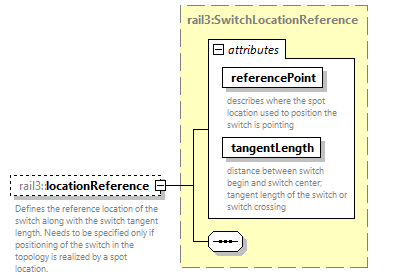 | ||||||||||||||||||||||
| namespace | https://www.railml.org/schemas/3.2 | ||||||||||||||||||||||
| type | rail3:SwitchLocationReference | ||||||||||||||||||||||
| properties |
| ||||||||||||||||||||||
| attributes |
| ||||||||||||||||||||||
| annotation |
| ||||||||||||||||||||||
| source | <xs:element name="locationReference" type="rail3:SwitchLocationReference" minOccurs="0" maxOccurs="1"> <xs:annotation> <xs:documentation>Defines the reference location of the switch along with the switch tangent length. Needs to be specified only if positioning of the switch in the topology is realized by a spot location.</xs:documentation> </xs:annotation> </xs:element> |
complexType SwitchLocationReference
| diagram | 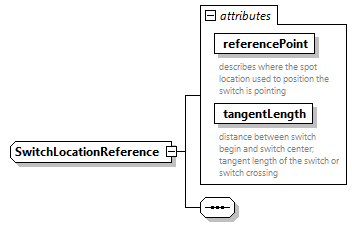 | ||||||||||||||||||||||
| namespace | https://www.railml.org/schemas/3.2 | ||||||||||||||||||||||
| used by |
| ||||||||||||||||||||||
| attributes |
| ||||||||||||||||||||||
| source | <xs:complexType name="SwitchLocationReference"> <xs:sequence/> <xs:attribute name="referencePoint" type="rail3:SwitchReferencePoint" use="required"> <xs:annotation> <xs:documentation>describes where the spot location used to position the switch is pointing</xs:documentation> </xs:annotation> </xs:attribute> <xs:attribute name="tangentLength" type="rail3:tLengthM" use="required"> <xs:annotation> <xs:documentation>distance between switch begin and switch center; tangent length of the switch or switch crossing</xs:documentation> </xs:annotation> </xs:attribute> </xs:complexType> |
attribute SwitchLocationReference/@referencePoint
| type | rail3:SwitchReferencePoint | |||||||||||||
| properties |
| |||||||||||||
| facets |
| |||||||||||||
| annotation |
| |||||||||||||
| source | <xs:attribute name="referencePoint" type="rail3:SwitchReferencePoint" use="required"> <xs:annotation> <xs:documentation>describes where the spot location used to position the switch is pointing</xs:documentation> </xs:annotation> </xs:attribute> |
attribute SwitchLocationReference/@tangentLength
| type | rail3:tLengthM | ||
| properties |
| ||
| annotation |
| ||
| source | <xs:attribute name="tangentLength" type="rail3:tLengthM" use="required"> <xs:annotation> <xs:documentation>distance between switch begin and switch center; tangent length of the switch or switch crossing</xs:documentation> </xs:annotation> </xs:attribute> |
complexType SystemSeparationSection
| diagram | 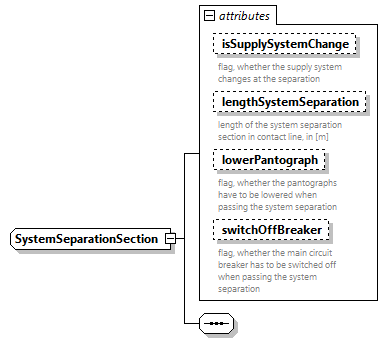 | ||||||||||||||||||||||||||||||||||||||
| namespace | https://www.railml.org/schemas/3.2 | ||||||||||||||||||||||||||||||||||||||
| used by |
| ||||||||||||||||||||||||||||||||||||||
| attributes |
| ||||||||||||||||||||||||||||||||||||||
| source | <xs:complexType name="SystemSeparationSection"> <xs:sequence/> <xs:attribute name="isSupplySystemChange" type="xs:boolean" use="optional"> <xs:annotation> <xs:documentation>flag, whether the supply system changes at the separation</xs:documentation> </xs:annotation> </xs:attribute> <xs:attribute name="lengthSystemSeparation" type="rail3:tLengthM" use="optional"> <xs:annotation> <xs:documentation>length of the system separation section in contact line, in [m]</xs:documentation> </xs:annotation> </xs:attribute> <xs:attribute name="lowerPantograph" type="xs:boolean" use="optional"> <xs:annotation> <xs:documentation>flag, whether the pantographs have to be lowered when passing the system separation</xs:documentation> </xs:annotation> </xs:attribute> <xs:attribute name="switchOffBreaker" type="xs:boolean" use="optional"> <xs:annotation> <xs:documentation>flag, whether the main circuit breaker has to be switched off when passing the system separation</xs:documentation> </xs:annotation> </xs:attribute> </xs:complexType> |
attribute SystemSeparationSection/@isSupplySystemChange
| type | xs:boolean | ||
| properties |
| ||
| annotation |
| ||
| source | <xs:attribute name="isSupplySystemChange" type="xs:boolean" use="optional"> <xs:annotation> <xs:documentation>flag, whether the supply system changes at the separation</xs:documentation> </xs:annotation> </xs:attribute> |
attribute SystemSeparationSection/@lengthSystemSeparation
| type | rail3:tLengthM | ||
| properties |
| ||
| annotation |
| ||
| source | <xs:attribute name="lengthSystemSeparation" type="rail3:tLengthM" use="optional"> <xs:annotation> <xs:documentation>length of the system separation section in contact line, in [m]</xs:documentation> </xs:annotation> </xs:attribute> |
attribute SystemSeparationSection/@lowerPantograph
| type | xs:boolean | ||
| properties |
| ||
| annotation |
| ||
| source | <xs:attribute name="lowerPantograph" type="xs:boolean" use="optional"> <xs:annotation> <xs:documentation>flag, whether the pantographs have to be lowered when passing the system separation</xs:documentation> </xs:annotation> </xs:attribute> |
attribute SystemSeparationSection/@switchOffBreaker
| type | xs:boolean | ||
| properties |
| ||
| annotation |
| ||
| source | <xs:attribute name="switchOffBreaker" type="xs:boolean" use="optional"> <xs:annotation> <xs:documentation>flag, whether the main circuit breaker has to be switched off when passing the system separation</xs:documentation> </xs:annotation> </xs:attribute> |
complexType Topology
| diagram | 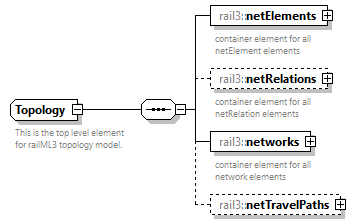 | ||
| namespace | https://www.railml.org/schemas/3.2 | ||
| children | rail3:netElements rail3:netRelations rail3:networks rail3:netTravelPaths | ||
| used by |
| ||
| annotation |
| ||
| source | <xs:complexType name="Topology"> <xs:annotation> <xs:documentation>This is the top level element for railML3 topology model.</xs:documentation> </xs:annotation> <xs:sequence> <xs:element name="netElements" type="rail3:NetElements" minOccurs="1" maxOccurs="1"> <xs:annotation> <xs:documentation>container element for all netElement elements</xs:documentation> </xs:annotation> </xs:element> <xs:element name="netRelations" type="rail3:NetRelations" minOccurs="0" maxOccurs="1"> <xs:annotation> <xs:documentation>container element for all netRelation elements</xs:documentation> </xs:annotation> </xs:element> <xs:element name="networks" type="rail3:Networks" minOccurs="1" maxOccurs="1"> <xs:annotation> <xs:documentation>container element for all network elements</xs:documentation> </xs:annotation> </xs:element> <xs:element name="netTravelPaths" type="rail3:NetTravelPaths" minOccurs="0" maxOccurs="1"/> </xs:sequence> </xs:complexType> |
element Topology/netElements
| diagram |  | ||
| namespace | https://www.railml.org/schemas/3.2 | ||
| type | rail3:NetElements | ||
| properties |
| ||
| children | rail3:netElement | ||
| annotation |
| ||
| source | <xs:element name="netElements" type="rail3:NetElements" minOccurs="1" maxOccurs="1"> <xs:annotation> <xs:documentation>container element for all netElement elements</xs:documentation> </xs:annotation> </xs:element> |
element Topology/netRelations
| diagram |  | ||||||
| namespace | https://www.railml.org/schemas/3.2 | ||||||
| type | rail3:NetRelations | ||||||
| properties |
| ||||||
| children | rail3:netRelation | ||||||
| annotation |
| ||||||
| source | <xs:element name="netRelations" type="rail3:NetRelations" minOccurs="0" maxOccurs="1"> <xs:annotation> <xs:documentation>container element for all netRelation elements</xs:documentation> </xs:annotation> </xs:element> |
element Topology/networks
| diagram |  | ||
| namespace | https://www.railml.org/schemas/3.2 | ||
| type | rail3:Networks | ||
| properties |
| ||
| children | rail3:network | ||
| annotation |
| ||
| source | <xs:element name="networks" type="rail3:Networks" minOccurs="1" maxOccurs="1"> <xs:annotation> <xs:documentation>container element for all network elements</xs:documentation> </xs:annotation> </xs:element> |
element Topology/netTravelPaths
| diagram |  | ||||||
| namespace | https://www.railml.org/schemas/3.2 | ||||||
| type | rail3:NetTravelPaths | ||||||
| properties |
| ||||||
| children | rail3:netTravelPath | ||||||
| source | <xs:element name="netTravelPaths" type="rail3:NetTravelPaths" minOccurs="0" maxOccurs="1"/> |
complexType Track
| diagram |  | ||||||||||||||||||||||||||||||||||||||
| namespace | https://www.railml.org/schemas/3.2 | ||||||||||||||||||||||||||||||||||||||
| type | extension of rail3:FunctionalInfrastructureEntity | ||||||||||||||||||||||||||||||||||||||
| properties |
| ||||||||||||||||||||||||||||||||||||||
| children | rail3:name rail3:isValid rail3:areaLocation rail3:linearLocation rail3:spotLocation rail3:gmlLocations rail3:networkLocation rail3:designator rail3:external rail3:typeDesignator rail3:trackBegin rail3:trackEnd rail3:length rail3:belongsToParent | ||||||||||||||||||||||||||||||||||||||
| used by |
| ||||||||||||||||||||||||||||||||||||||
| attributes |
| ||||||||||||||||||||||||||||||||||||||
| annotation |
| ||||||||||||||||||||||||||||||||||||||
| source | <xs:complexType name="Track"> <xs:annotation> <xs:documentation>A Track is a railway section that can be traversed by a train in a continuous motion.</xs:documentation> </xs:annotation> <xs:complexContent> <xs:extension base="rail3:FunctionalInfrastructureEntity"> <xs:sequence> <xs:element name="trackBegin" type="rail3:tElementWithIDref" minOccurs="0" maxOccurs="1"> <xs:annotation> <xs:documentation>reference to a track node (buffer stop, switch, etc.) that marks the begin of the track</xs:documentation> </xs:annotation> </xs:element> <xs:element name="trackEnd" type="rail3:tElementWithIDref" minOccurs="0" maxOccurs="1"> <xs:annotation> <xs:documentation>reference to a track node (buffer stop, switch, etc.) that marks the end of the track</xs:documentation> </xs:annotation> </xs:element> <xs:element name="length" type="rail3:Length" minOccurs="0" maxOccurs="unbounded"> <xs:annotation> <xs:documentation>length of track in metres</xs:documentation> </xs:annotation> </xs:element> <xs:element name="belongsToParent" type="rail3:tElementWithIDref" minOccurs="0" maxOccurs="1"> <xs:annotation> <xs:documentation>reference to a parent track to be used for aggregations
 
 - if some information exists in parent and child, then information in child overwrites it in child
 
 - if some information exists only in parent, then child inherits this information from parent</xs:documentation> </xs:annotation> </xs:element> </xs:sequence> <xs:attribute name="infrastructureManagerRef" type="rail3:tRef" use="optional"> <xs:annotation> <xs:documentation>reference to the infrastructure manager who owns the track (see &lt;organizationalUnits&gt; in &lt;common&gt;)</xs:documentation> </xs:annotation> </xs:attribute> <xs:attribute name="mainDirection" type="rail3:tExtendedDirection" use="optional"> <xs:annotation> <xs:documentation>predominant direction of operation on this track;
 use this attribute to define the default direction of train operations, especially on double track lines</xs:documentation> </xs:annotation> </xs:attribute> <xs:attribute name="type" type="rail3:tTrackType" use="required"> <xs:annotation> <xs:documentation>type of the track defining the general functionality of the track.
 DEPRECATION WARNING: As of Version 3.3 this attribute will become optional. </xs:documentation> </xs:annotation> </xs:attribute> </xs:extension> </xs:complexContent> </xs:complexType> |
attribute Track/@infrastructureManagerRef
| type | rail3:tRef | ||
| properties |
| ||
| annotation |
| ||
| source | <xs:attribute name="infrastructureManagerRef" type="rail3:tRef" use="optional"> <xs:annotation> <xs:documentation>reference to the infrastructure manager who owns the track (see &lt;organizationalUnits&gt; in &lt;common&gt;)</xs:documentation> </xs:annotation> </xs:attribute> |
attribute Track/@mainDirection
| type | rail3:tExtendedDirection | ||||||||||||
| properties |
| ||||||||||||
| facets |
| ||||||||||||
| annotation |
| ||||||||||||
| source | <xs:attribute name="mainDirection" type="rail3:tExtendedDirection" use="optional"> <xs:annotation> <xs:documentation>predominant direction of operation on this track;
 use this attribute to define the default direction of train operations, especially on double track lines</xs:documentation> </xs:annotation> </xs:attribute> |
attribute Track/@type
| type | rail3:tTrackType | |||||||||||||||||||||||
| properties |
| |||||||||||||||||||||||
| facets |
| |||||||||||||||||||||||
| annotation |
| |||||||||||||||||||||||
| source | <xs:attribute name="type" type="rail3:tTrackType" use="required"> <xs:annotation> <xs:documentation>type of the track defining the general functionality of the track.
 DEPRECATION WARNING: As of Version 3.3 this attribute will become optional. </xs:documentation> </xs:annotation> </xs:attribute> |
element Track/trackBegin
| diagram | 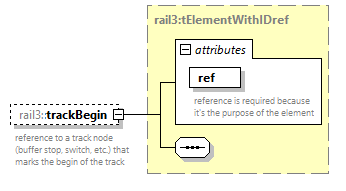 | ||||||||||||||
| namespace | https://www.railml.org/schemas/3.2 | ||||||||||||||
| type | rail3:tElementWithIDref | ||||||||||||||
| properties |
| ||||||||||||||
| attributes |
| ||||||||||||||
| annotation |
| ||||||||||||||
| source | <xs:element name="trackBegin" type="rail3:tElementWithIDref" minOccurs="0" maxOccurs="1"> <xs:annotation> <xs:documentation>reference to a track node (buffer stop, switch, etc.) that marks the begin of the track</xs:documentation> </xs:annotation> </xs:element> |
element Track/trackEnd
| diagram | 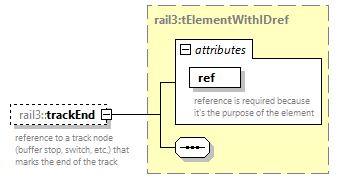 | ||||||||||||||
| namespace | https://www.railml.org/schemas/3.2 | ||||||||||||||
| type | rail3:tElementWithIDref | ||||||||||||||
| properties |
| ||||||||||||||
| attributes |
| ||||||||||||||
| annotation |
| ||||||||||||||
| source | <xs:element name="trackEnd" type="rail3:tElementWithIDref" minOccurs="0" maxOccurs="1"> <xs:annotation> <xs:documentation>reference to a track node (buffer stop, switch, etc.) that marks the end of the track</xs:documentation> </xs:annotation> </xs:element> |
element Track/length
| diagram | 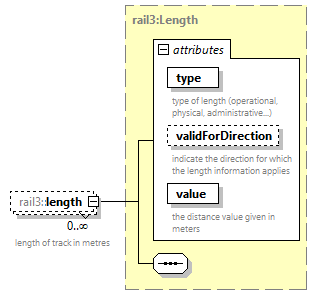 | ||||||||||||||||||||||||||||||
| namespace | https://www.railml.org/schemas/3.2 | ||||||||||||||||||||||||||||||
| type | rail3:Length | ||||||||||||||||||||||||||||||
| properties |
| ||||||||||||||||||||||||||||||
| attributes |
| ||||||||||||||||||||||||||||||
| annotation |
| ||||||||||||||||||||||||||||||
| source | <xs:element name="length" type="rail3:Length" minOccurs="0" maxOccurs="unbounded"> <xs:annotation> <xs:documentation>length of track in metres</xs:documentation> </xs:annotation> </xs:element> |
element Track/belongsToParent
| diagram | 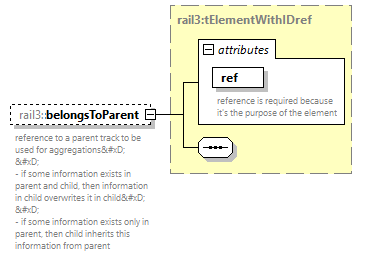 | ||||||||||||||
| namespace | https://www.railml.org/schemas/3.2 | ||||||||||||||
| type | rail3:tElementWithIDref | ||||||||||||||
| properties |
| ||||||||||||||
| attributes |
| ||||||||||||||
| annotation |
| ||||||||||||||
| source | <xs:element name="belongsToParent" type="rail3:tElementWithIDref" minOccurs="0" maxOccurs="1"> <xs:annotation> <xs:documentation>reference to a parent track to be used for aggregations
 
 - if some information exists in parent and child, then information in child overwrites it in child
 
 - if some information exists only in parent, then child inherits this information from parent</xs:documentation> </xs:annotation> </xs:element> |
complexType TrackBed
| diagram | 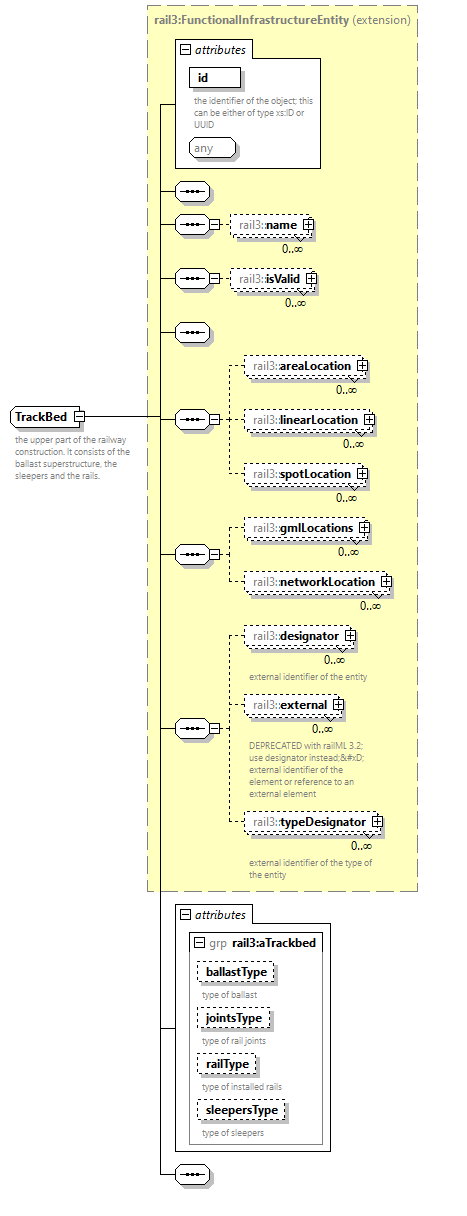 | ||||||||||||||||||||||||||||||||||||||||||||||
| namespace | https://www.railml.org/schemas/3.2 | ||||||||||||||||||||||||||||||||||||||||||||||
| type | extension of rail3:FunctionalInfrastructureEntity | ||||||||||||||||||||||||||||||||||||||||||||||
| properties |
| ||||||||||||||||||||||||||||||||||||||||||||||
| children | rail3:name rail3:isValid rail3:areaLocation rail3:linearLocation rail3:spotLocation rail3:gmlLocations rail3:networkLocation rail3:designator rail3:external rail3:typeDesignator | ||||||||||||||||||||||||||||||||||||||||||||||
| used by |
| ||||||||||||||||||||||||||||||||||||||||||||||
| attributes |
| ||||||||||||||||||||||||||||||||||||||||||||||
| annotation |
| ||||||||||||||||||||||||||||||||||||||||||||||
| source | <xs:complexType name="TrackBed"> <xs:annotation> <xs:documentation>the upper part of the railway construction. It consists of the ballast superstructure, the sleepers and the rails.</xs:documentation> </xs:annotation> <xs:complexContent> <xs:extension base="rail3:FunctionalInfrastructureEntity"> <xs:sequence/> <xs:attributeGroup ref="rail3:aTrackbed"/> </xs:extension> </xs:complexContent> </xs:complexType> |
complexType TrackBeds
| diagram |  | ||
| namespace | https://www.railml.org/schemas/3.2 | ||
| children | rail3:trackBed | ||
| used by |
| ||
| source | <xs:complexType name="TrackBeds"> <xs:sequence> <xs:element name="trackBed" type="rail3:TrackBed" minOccurs="1" maxOccurs="unbounded"/> </xs:sequence> </xs:complexType> |
element TrackBeds/trackBed
| diagram | 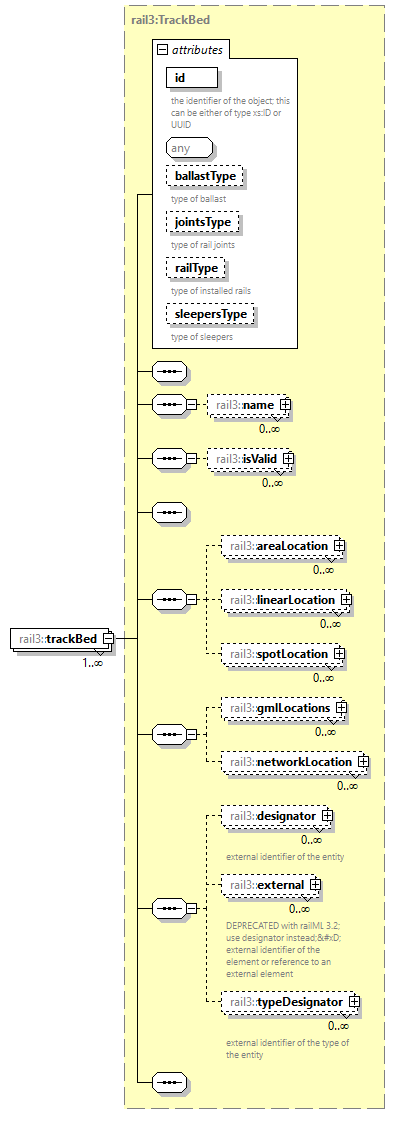 | ||||||||||||||||||||||||||||||||||||||||||||||
| namespace | https://www.railml.org/schemas/3.2 | ||||||||||||||||||||||||||||||||||||||||||||||
| type | rail3:TrackBed | ||||||||||||||||||||||||||||||||||||||||||||||
| properties |
| ||||||||||||||||||||||||||||||||||||||||||||||
| children | rail3:name rail3:isValid rail3:areaLocation rail3:linearLocation rail3:spotLocation rail3:gmlLocations rail3:networkLocation rail3:designator rail3:external rail3:typeDesignator | ||||||||||||||||||||||||||||||||||||||||||||||
| attributes |
| ||||||||||||||||||||||||||||||||||||||||||||||
| source | <xs:element name="trackBed" type="rail3:TrackBed" minOccurs="1" maxOccurs="unbounded"/> |
complexType TrackGauge
| diagram | 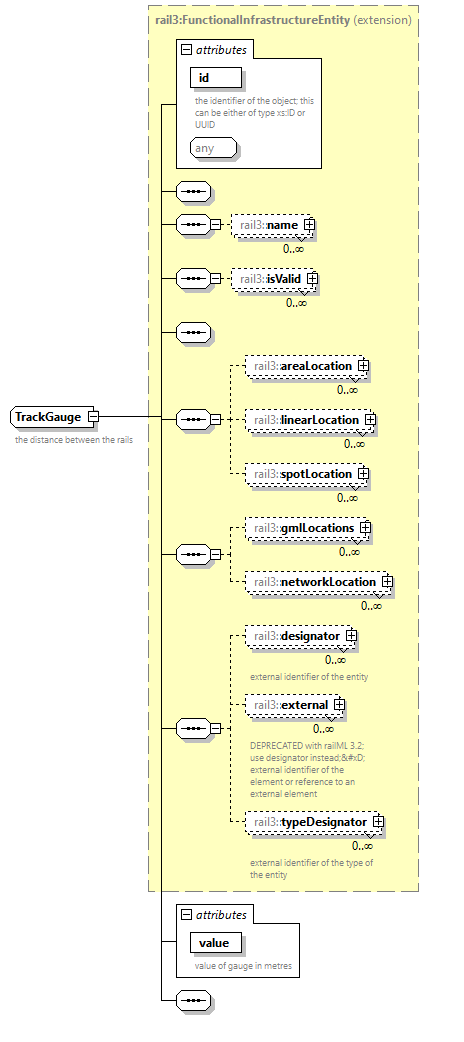 | ||||||||||||||||||||||
| namespace | https://www.railml.org/schemas/3.2 | ||||||||||||||||||||||
| type | extension of rail3:FunctionalInfrastructureEntity | ||||||||||||||||||||||
| properties |
| ||||||||||||||||||||||
| children | rail3:name rail3:isValid rail3:areaLocation rail3:linearLocation rail3:spotLocation rail3:gmlLocations rail3:networkLocation rail3:designator rail3:external rail3:typeDesignator | ||||||||||||||||||||||
| used by |
| ||||||||||||||||||||||
| attributes |
| ||||||||||||||||||||||
| annotation |
| ||||||||||||||||||||||
| source | <xs:complexType name="TrackGauge"> <xs:annotation> <xs:documentation>the distance between the rails</xs:documentation> </xs:annotation> <xs:complexContent> <xs:extension base="rail3:FunctionalInfrastructureEntity"> <xs:sequence/> <xs:attribute name="value" type="rail3:tLengthM" use="required"> <xs:annotation> <xs:documentation>value of gauge in metres</xs:documentation> </xs:annotation> </xs:attribute> </xs:extension> </xs:complexContent> </xs:complexType> |
attribute TrackGauge/@value
| type | rail3:tLengthM | ||
| properties |
| ||
| annotation |
| ||
| source | <xs:attribute name="value" type="rail3:tLengthM" use="required"> <xs:annotation> <xs:documentation>value of gauge in metres</xs:documentation> </xs:annotation> </xs:attribute> |
complexType TrackGauges
| diagram |  | ||
| namespace | https://www.railml.org/schemas/3.2 | ||
| children | rail3:trackGauge | ||
| used by |
| ||
| annotation |
| ||
| source | <xs:complexType name="TrackGauges"> <xs:annotation> <xs:documentation>umbrella element for all trackGauge elements</xs:documentation> </xs:annotation> <xs:sequence> <xs:element name="trackGauge" type="rail3:TrackGauge" minOccurs="1" maxOccurs="unbounded"> <xs:annotation> <xs:documentation>Allows describing the distance between the rails</xs:documentation> </xs:annotation> </xs:element> </xs:sequence> </xs:complexType> |
element TrackGauges/trackGauge
| diagram | 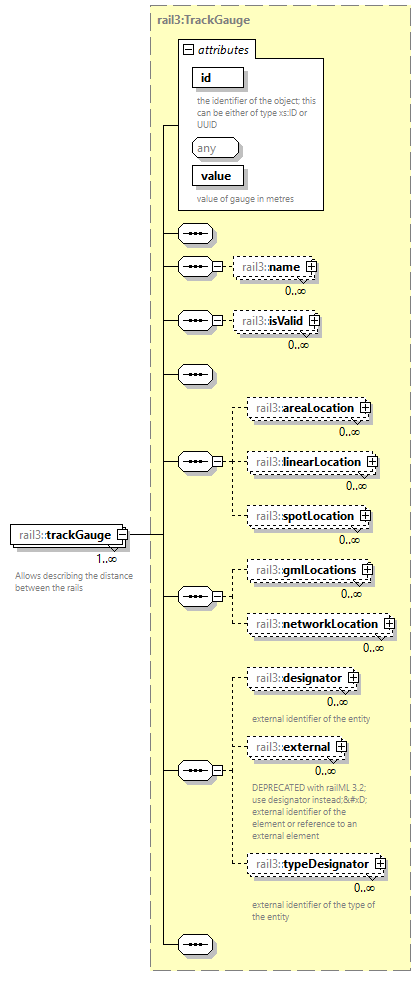 | ||||||||||||||||||||||
| namespace | https://www.railml.org/schemas/3.2 | ||||||||||||||||||||||
| type | rail3:TrackGauge | ||||||||||||||||||||||
| properties |
| ||||||||||||||||||||||
| children | rail3:name rail3:isValid rail3:areaLocation rail3:linearLocation rail3:spotLocation rail3:gmlLocations rail3:networkLocation rail3:designator rail3:external rail3:typeDesignator | ||||||||||||||||||||||
| attributes |
| ||||||||||||||||||||||
| annotation |
| ||||||||||||||||||||||
| source | <xs:element name="trackGauge" type="rail3:TrackGauge" minOccurs="1" maxOccurs="unbounded"> <xs:annotation> <xs:documentation>Allows describing the distance between the rails</xs:documentation> </xs:annotation> </xs:element> |
complexType TrackNode
| diagram | 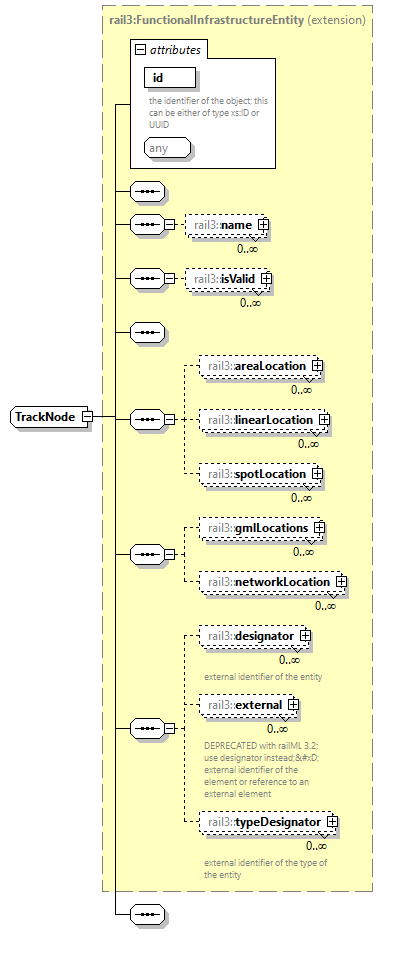 | ||||||||||||||
| namespace | https://www.railml.org/schemas/3.2 | ||||||||||||||
| type | extension of rail3:FunctionalInfrastructureEntity | ||||||||||||||
| properties |
| ||||||||||||||
| children | rail3:name rail3:isValid rail3:areaLocation rail3:linearLocation rail3:spotLocation rail3:gmlLocations rail3:networkLocation rail3:designator rail3:external rail3:typeDesignator | ||||||||||||||
| used by |
| ||||||||||||||
| attributes |
| ||||||||||||||
| source | <xs:complexType name="TrackNode" abstract="true"> <xs:complexContent> <xs:extension base="rail3:FunctionalInfrastructureEntity"> <xs:sequence/> </xs:extension> </xs:complexContent> </xs:complexType> |
complexType Tracks
| diagram |  | ||
| namespace | https://www.railml.org/schemas/3.2 | ||
| children | rail3:track | ||
| used by |
| ||
| source | <xs:complexType name="Tracks"> <xs:sequence> <xs:element name="track" type="rail3:Track" minOccurs="1" maxOccurs="unbounded"> <xs:annotation> <xs:documentation>A Track is a railway section that can be traversed by a train in a continuous motion.</xs:documentation> </xs:annotation> </xs:element> </xs:sequence> </xs:complexType> |
element Tracks/track
| diagram |  | ||||||||||||||||||||||||||||||||||||||
| namespace | https://www.railml.org/schemas/3.2 | ||||||||||||||||||||||||||||||||||||||
| type | rail3:Track | ||||||||||||||||||||||||||||||||||||||
| properties |
| ||||||||||||||||||||||||||||||||||||||
| children | rail3:name rail3:isValid rail3:areaLocation rail3:linearLocation rail3:spotLocation rail3:gmlLocations rail3:networkLocation rail3:designator rail3:external rail3:typeDesignator rail3:trackBegin rail3:trackEnd rail3:length rail3:belongsToParent | ||||||||||||||||||||||||||||||||||||||
| attributes |
| ||||||||||||||||||||||||||||||||||||||
| annotation |
| ||||||||||||||||||||||||||||||||||||||
| source | <xs:element name="track" type="rail3:Track" minOccurs="1" maxOccurs="unbounded"> <xs:annotation> <xs:documentation>A Track is a railway section that can be traversed by a train in a continuous motion.</xs:documentation> </xs:annotation> </xs:element> |
complexType TrainDetectionElement
| diagram | 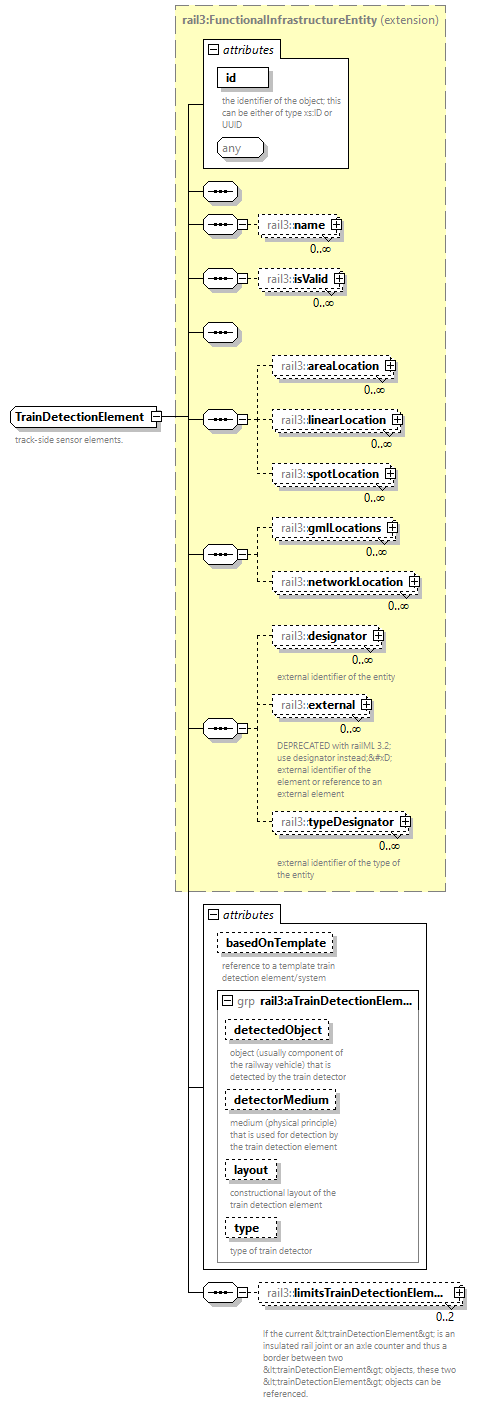 | ||||||||||||||||||||||||||||||||||||||||||||||||||||||
| namespace | https://www.railml.org/schemas/3.2 | ||||||||||||||||||||||||||||||||||||||||||||||||||||||
| type | extension of rail3:FunctionalInfrastructureEntity | ||||||||||||||||||||||||||||||||||||||||||||||||||||||
| properties |
| ||||||||||||||||||||||||||||||||||||||||||||||||||||||
| children | rail3:name rail3:isValid rail3:areaLocation rail3:linearLocation rail3:spotLocation rail3:gmlLocations rail3:networkLocation rail3:designator rail3:external rail3:typeDesignator rail3:limitsTrainDetectionElement | ||||||||||||||||||||||||||||||||||||||||||||||||||||||
| used by |
| ||||||||||||||||||||||||||||||||||||||||||||||||||||||
| attributes |
| ||||||||||||||||||||||||||||||||||||||||||||||||||||||
| annotation |
| ||||||||||||||||||||||||||||||||||||||||||||||||||||||
| source | <xs:complexType name="TrainDetectionElement"> <xs:annotation> <xs:documentation>track-side sensor elements.</xs:documentation> </xs:annotation> <xs:complexContent> <xs:extension base="rail3:FunctionalInfrastructureEntity"> <xs:sequence> <xs:element name="limitsTrainDetectionElement" type="rail3:tElementWithIDref" minOccurs="0" maxOccurs="2"> <xs:annotation> <xs:documentation>If the current <trainDetectionElement> is an insulated rail joint or an axle counter and thus a border between two <trainDetectionElement> objects, these two <trainDetectionElement> objects can be referenced.</xs:documentation> </xs:annotation> </xs:element> </xs:sequence> <xs:attribute name="basedOnTemplate" type="rail3:tRef" use="optional"> <xs:annotation> <xs:documentation>reference to a template train detection element/system</xs:documentation> </xs:annotation> </xs:attribute> <xs:attributeGroup ref="rail3:aTrainDetectionElement"/> </xs:extension> </xs:complexContent> </xs:complexType> |
attribute TrainDetectionElement/@basedOnTemplate
| type | rail3:tRef | ||
| properties |
| ||
| annotation |
| ||
| source | <xs:attribute name="basedOnTemplate" type="rail3:tRef" use="optional"> <xs:annotation> <xs:documentation>reference to a template train detection element/system</xs:documentation> </xs:annotation> </xs:attribute> |
element TrainDetectionElement/limitsTrainDetectionElement
| diagram | 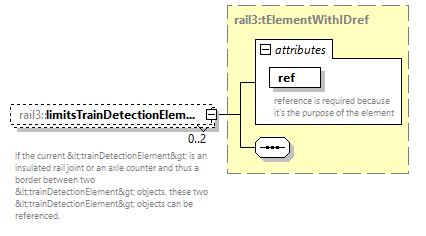 | ||||||||||||||
| namespace | https://www.railml.org/schemas/3.2 | ||||||||||||||
| type | rail3:tElementWithIDref | ||||||||||||||
| properties |
| ||||||||||||||
| attributes |
| ||||||||||||||
| annotation |
| ||||||||||||||
| source | <xs:element name="limitsTrainDetectionElement" type="rail3:tElementWithIDref" minOccurs="0" maxOccurs="2"> <xs:annotation> <xs:documentation>If the current <trainDetectionElement> is an insulated rail joint or an axle counter and thus a border between two <trainDetectionElement> objects, these two <trainDetectionElement> objects can be referenced.</xs:documentation> </xs:annotation> </xs:element> |
complexType TrainDetectionElements
| diagram |  | ||
| namespace | https://www.railml.org/schemas/3.2 | ||
| children | rail3:trainDetectionElement | ||
| used by |
| ||
| source | <xs:complexType name="TrainDetectionElements"> <xs:sequence> <xs:element name="trainDetectionElement" type="rail3:TrainDetectionElement" minOccurs="0" maxOccurs="unbounded"> <xs:annotation> <xs:documentation>track-side sensor elements.</xs:documentation> </xs:annotation> </xs:element> </xs:sequence> </xs:complexType> |
element TrainDetectionElements/trainDetectionElement
| diagram | 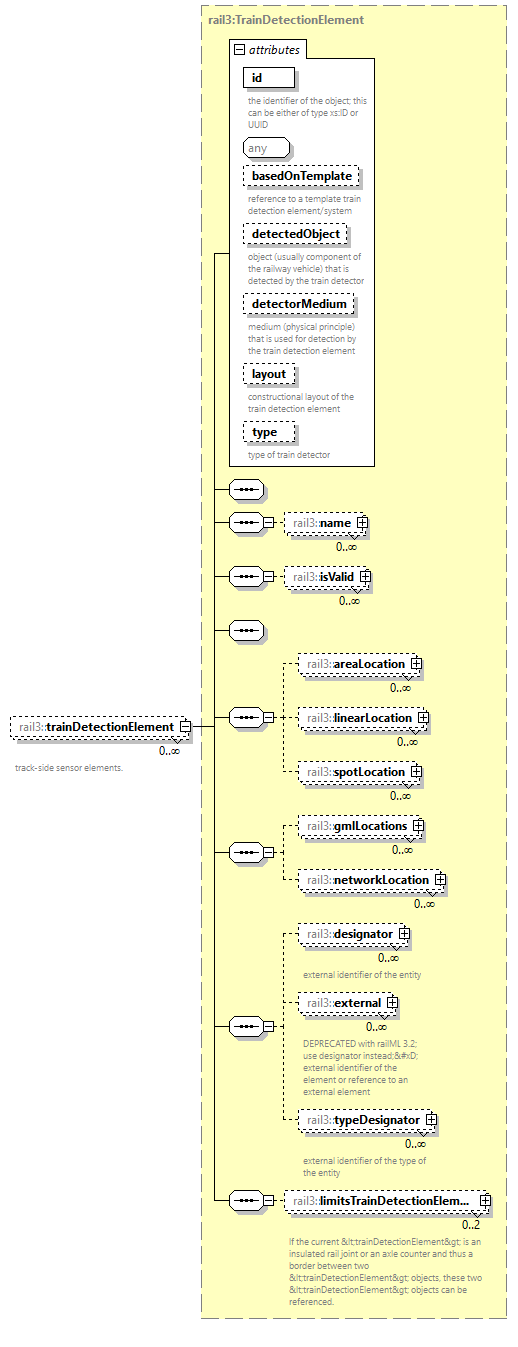 | ||||||||||||||||||||||||||||||||||||||||||||||||||||||
| namespace | https://www.railml.org/schemas/3.2 | ||||||||||||||||||||||||||||||||||||||||||||||||||||||
| type | rail3:TrainDetectionElement | ||||||||||||||||||||||||||||||||||||||||||||||||||||||
| properties |
| ||||||||||||||||||||||||||||||||||||||||||||||||||||||
| children | rail3:name rail3:isValid rail3:areaLocation rail3:linearLocation rail3:spotLocation rail3:gmlLocations rail3:networkLocation rail3:designator rail3:external rail3:typeDesignator rail3:limitsTrainDetectionElement | ||||||||||||||||||||||||||||||||||||||||||||||||||||||
| attributes |
| ||||||||||||||||||||||||||||||||||||||||||||||||||||||
| annotation |
| ||||||||||||||||||||||||||||||||||||||||||||||||||||||
| source | <xs:element name="trainDetectionElement" type="rail3:TrainDetectionElement" minOccurs="0" maxOccurs="unbounded"> <xs:annotation> <xs:documentation>track-side sensor elements.</xs:documentation> </xs:annotation> </xs:element> |
complexType TrainMovement
| diagram | 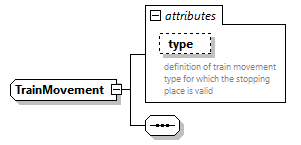 | ||||||||||||||
| namespace | https://www.railml.org/schemas/3.2 | ||||||||||||||
| used by |
| ||||||||||||||
| attributes |
| ||||||||||||||
| source | <xs:complexType name="TrainMovement"> <xs:sequence/> <xs:attribute name="type" type="rail3:tTrainMovementTypeExt" use="optional"> <xs:annotation> <xs:documentation>definition of train movement type for which the stopping place is valid</xs:documentation> </xs:annotation> </xs:attribute> </xs:complexType> |
attribute TrainMovement/@type
| type | rail3:tTrainMovementTypeExt | ||
| properties |
| ||
| annotation |
| ||
| source | <xs:attribute name="type" type="rail3:tTrainMovementTypeExt" use="optional"> <xs:annotation> <xs:documentation>definition of train movement type for which the stopping place is valid</xs:documentation> </xs:annotation> </xs:attribute> |
complexType TrainProtectionElement
| diagram | 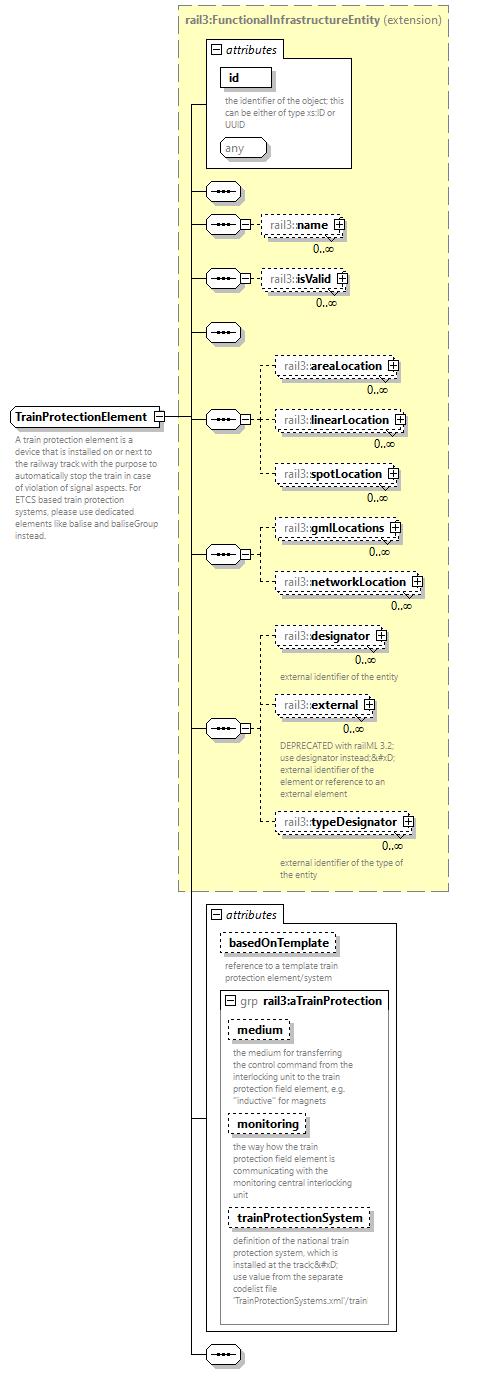 | ||||||||||||||||||||||||||||||||||||||||||||||
| namespace | https://www.railml.org/schemas/3.2 | ||||||||||||||||||||||||||||||||||||||||||||||
| type | extension of rail3:FunctionalInfrastructureEntity | ||||||||||||||||||||||||||||||||||||||||||||||
| properties |
| ||||||||||||||||||||||||||||||||||||||||||||||
| children | rail3:name rail3:isValid rail3:areaLocation rail3:linearLocation rail3:spotLocation rail3:gmlLocations rail3:networkLocation rail3:designator rail3:external rail3:typeDesignator | ||||||||||||||||||||||||||||||||||||||||||||||
| used by |
| ||||||||||||||||||||||||||||||||||||||||||||||
| attributes |
| ||||||||||||||||||||||||||||||||||||||||||||||
| annotation |
| ||||||||||||||||||||||||||||||||||||||||||||||
| source | <xs:complexType name="TrainProtectionElement"> <xs:annotation> <xs:documentation>A train protection element is a device that is installed on or next to the railway track with the purpose to automatically stop the train in case of violation of signal aspects. For ETCS based train protection systems, please use dedicated elements like balise and baliseGroup instead.</xs:documentation> </xs:annotation> <xs:complexContent> <xs:extension base="rail3:FunctionalInfrastructureEntity"> <xs:sequence/> <xs:attribute name="basedOnTemplate" type="rail3:tRef" use="optional"> <xs:annotation> <xs:documentation>reference to a template train protection element/system</xs:documentation> </xs:annotation> </xs:attribute> <xs:attributeGroup ref="rail3:aTrainProtection"/> </xs:extension> </xs:complexContent> </xs:complexType> |
attribute TrainProtectionElement/@basedOnTemplate
| type | rail3:tRef | ||
| properties |
| ||
| annotation |
| ||
| source | <xs:attribute name="basedOnTemplate" type="rail3:tRef" use="optional"> <xs:annotation> <xs:documentation>reference to a template train protection element/system</xs:documentation> </xs:annotation> </xs:attribute> |
complexType TrainProtectionElements
| diagram |  | ||
| namespace | https://www.railml.org/schemas/3.2 | ||
| children | rail3:trainProtectionElement | ||
| used by |
| ||
| source | <xs:complexType name="TrainProtectionElements"> <xs:sequence> <xs:element name="trainProtectionElement" type="rail3:TrainProtectionElement" minOccurs="0" maxOccurs="unbounded"> <xs:annotation> <xs:documentation>Allows specifying technical installations to ensure safe operation in the event of human error.</xs:documentation> </xs:annotation> </xs:element> </xs:sequence> </xs:complexType> |
element TrainProtectionElements/trainProtectionElement
| diagram | 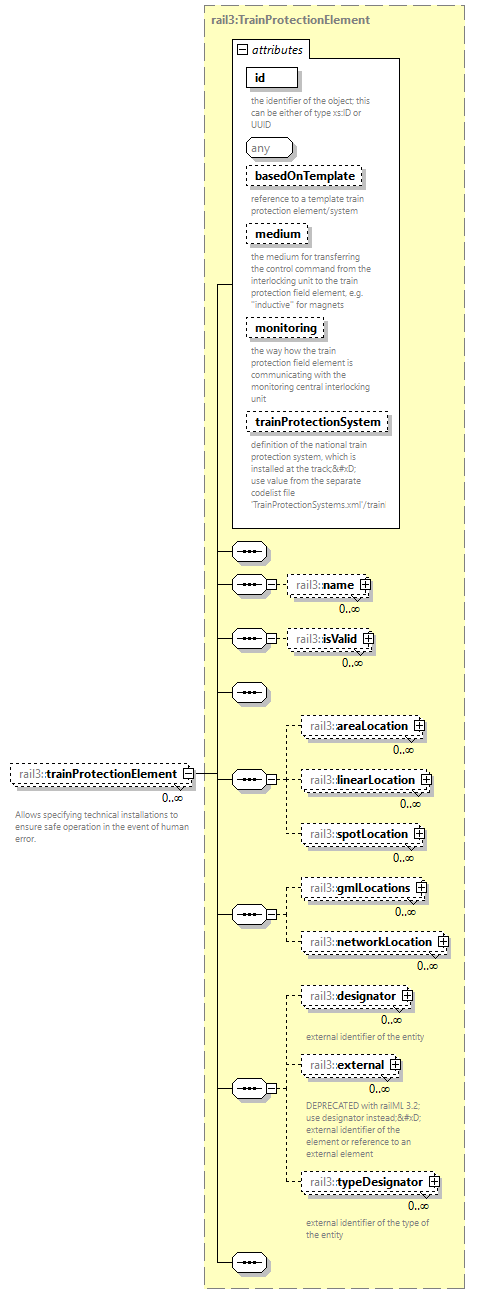 | ||||||||||||||||||||||||||||||||||||||||||||||
| namespace | https://www.railml.org/schemas/3.2 | ||||||||||||||||||||||||||||||||||||||||||||||
| type | rail3:TrainProtectionElement | ||||||||||||||||||||||||||||||||||||||||||||||
| properties |
| ||||||||||||||||||||||||||||||||||||||||||||||
| children | rail3:name rail3:isValid rail3:areaLocation rail3:linearLocation rail3:spotLocation rail3:gmlLocations rail3:networkLocation rail3:designator rail3:external rail3:typeDesignator | ||||||||||||||||||||||||||||||||||||||||||||||
| attributes |
| ||||||||||||||||||||||||||||||||||||||||||||||
| annotation |
| ||||||||||||||||||||||||||||||||||||||||||||||
| source | <xs:element name="trainProtectionElement" type="rail3:TrainProtectionElement" minOccurs="0" maxOccurs="unbounded"> <xs:annotation> <xs:documentation>Allows specifying technical installations to ensure safe operation in the event of human error.</xs:documentation> </xs:annotation> </xs:element> |
complexType TrainRadio
| diagram |  | ||||||||||||||||||||||||||||||||||||||||||||||||||||||||||||||||||||||
| namespace | https://www.railml.org/schemas/3.2 | ||||||||||||||||||||||||||||||||||||||||||||||||||||||||||||||||||||||
| type | extension of rail3:FunctionalInfrastructureEntity | ||||||||||||||||||||||||||||||||||||||||||||||||||||||||||||||||||||||
| properties |
| ||||||||||||||||||||||||||||||||||||||||||||||||||||||||||||||||||||||
| children | rail3:name rail3:isValid rail3:areaLocation rail3:linearLocation rail3:spotLocation rail3:gmlLocations rail3:networkLocation rail3:designator rail3:external rail3:typeDesignator | ||||||||||||||||||||||||||||||||||||||||||||||||||||||||||||||||||||||
| used by |
| ||||||||||||||||||||||||||||||||||||||||||||||||||||||||||||||||||||||
| attributes |
| ||||||||||||||||||||||||||||||||||||||||||||||||||||||||||||||||||||||
| annotation |
| ||||||||||||||||||||||||||||||||||||||||||||||||||||||||||||||||||||||
| source | <xs:complexType name="TrainRadio"> <xs:annotation> <xs:documentation>a radio communication system for communication between the train driver and the track side.</xs:documentation> </xs:annotation> <xs:complexContent> <xs:extension base="rail3:FunctionalInfrastructureEntity"> <xs:sequence/> <xs:attribute name="networkSelection" type="rail3:tTrainRadioNetworkSelectionExt" use="optional"> <xs:annotation> <xs:documentation>defines the procedure of train radio network selection</xs:documentation> </xs:annotation> </xs:attribute> <xs:attribute name="radioSystem" type="rail3:tTrainRadioSystemExt" use="optional"> <xs:annotation> <xs:documentation>the train radio system, e.g. 'GSM-R'</xs:documentation> </xs:annotation> </xs:attribute> <xs:attribute name="supportsBroadcastCalls" type="xs:boolean" use="optional"> <xs:annotation> <xs:documentation>defines whether broadcast call functionality is available</xs:documentation> </xs:annotation> </xs:attribute> <xs:attribute name="supportsDirectMode" type="xs:boolean" use="optional"> <xs:annotation> <xs:documentation>defines whether direct mode train radio is available</xs:documentation> </xs:annotation> </xs:attribute> <xs:attribute name="supportsPublicEmergency" type="xs:boolean" use="optional"> <xs:annotation> <xs:documentation>defines whether public emergency calls are available</xs:documentation> </xs:annotation> </xs:attribute> <xs:attribute name="supportsPublicNetworkRoaming" type="xs:boolean" use="optional"> <xs:annotation> <xs:documentation>defines whether roaming via public networks is available</xs:documentation> </xs:annotation> </xs:attribute> <xs:attribute name="supportsTextMessageService" type="xs:boolean" use="optional"> <xs:annotation> <xs:documentation>defines whether text message service (SMS) is available</xs:documentation> </xs:annotation> </xs:attribute> </xs:extension> </xs:complexContent> </xs:complexType> |
attribute TrainRadio/@networkSelection
| type | rail3:tTrainRadioNetworkSelectionExt | ||
| properties |
| ||
| annotation |
| ||
| source | <xs:attribute name="networkSelection" type="rail3:tTrainRadioNetworkSelectionExt" use="optional"> <xs:annotation> <xs:documentation>defines the procedure of train radio network selection</xs:documentation> </xs:annotation> </xs:attribute> |
attribute TrainRadio/@radioSystem
| type | rail3:tTrainRadioSystemExt | ||
| properties |
| ||
| annotation |
| ||
| source | <xs:attribute name="radioSystem" type="rail3:tTrainRadioSystemExt" use="optional"> <xs:annotation> <xs:documentation>the train radio system, e.g. 'GSM-R'</xs:documentation> </xs:annotation> </xs:attribute> |
attribute TrainRadio/@supportsBroadcastCalls
| type | xs:boolean | ||
| properties |
| ||
| annotation |
| ||
| source | <xs:attribute name="supportsBroadcastCalls" type="xs:boolean" use="optional"> <xs:annotation> <xs:documentation>defines whether broadcast call functionality is available</xs:documentation> </xs:annotation> </xs:attribute> |
attribute TrainRadio/@supportsDirectMode
| type | xs:boolean | ||
| properties |
| ||
| annotation |
| ||
| source | <xs:attribute name="supportsDirectMode" type="xs:boolean" use="optional"> <xs:annotation> <xs:documentation>defines whether direct mode train radio is available</xs:documentation> </xs:annotation> </xs:attribute> |
attribute TrainRadio/@supportsPublicEmergency
| type | xs:boolean | ||
| properties |
| ||
| annotation |
| ||
| source | <xs:attribute name="supportsPublicEmergency" type="xs:boolean" use="optional"> <xs:annotation> <xs:documentation>defines whether public emergency calls are available</xs:documentation> </xs:annotation> </xs:attribute> |
attribute TrainRadio/@supportsPublicNetworkRoaming
| type | xs:boolean | ||
| properties |
| ||
| annotation |
| ||
| source | <xs:attribute name="supportsPublicNetworkRoaming" type="xs:boolean" use="optional"> <xs:annotation> <xs:documentation>defines whether roaming via public networks is available</xs:documentation> </xs:annotation> </xs:attribute> |
attribute TrainRadio/@supportsTextMessageService
| type | xs:boolean | ||
| properties |
| ||
| annotation |
| ||
| source | <xs:attribute name="supportsTextMessageService" type="xs:boolean" use="optional"> <xs:annotation> <xs:documentation>defines whether text message service (SMS) is available</xs:documentation> </xs:annotation> </xs:attribute> |
complexType TrainRadios
| diagram |  | ||
| namespace | https://www.railml.org/schemas/3.2 | ||
| children | rail3:trainRadio | ||
| used by |
| ||
| annotation |
| ||
| source | <xs:complexType name="TrainRadios"> <xs:annotation> <xs:documentation>umbrella element for all trainRadio elements</xs:documentation> </xs:annotation> <xs:sequence> <xs:element name="trainRadio" type="rail3:TrainRadio" minOccurs="1" maxOccurs="unbounded"/> </xs:sequence> </xs:complexType> |
element TrainRadios/trainRadio
| diagram |  | ||||||||||||||||||||||||||||||||||||||||||||||||||||||||||||||||||||||
| namespace | https://www.railml.org/schemas/3.2 | ||||||||||||||||||||||||||||||||||||||||||||||||||||||||||||||||||||||
| type | rail3:TrainRadio | ||||||||||||||||||||||||||||||||||||||||||||||||||||||||||||||||||||||
| properties |
| ||||||||||||||||||||||||||||||||||||||||||||||||||||||||||||||||||||||
| children | rail3:name rail3:isValid rail3:areaLocation rail3:linearLocation rail3:spotLocation rail3:gmlLocations rail3:networkLocation rail3:designator rail3:external rail3:typeDesignator | ||||||||||||||||||||||||||||||||||||||||||||||||||||||||||||||||||||||
| attributes |
| ||||||||||||||||||||||||||||||||||||||||||||||||||||||||||||||||||||||
| source | <xs:element name="trainRadio" type="rail3:TrainRadio" minOccurs="1" maxOccurs="unbounded"/> |
complexType TunnelGateIS
| diagram | 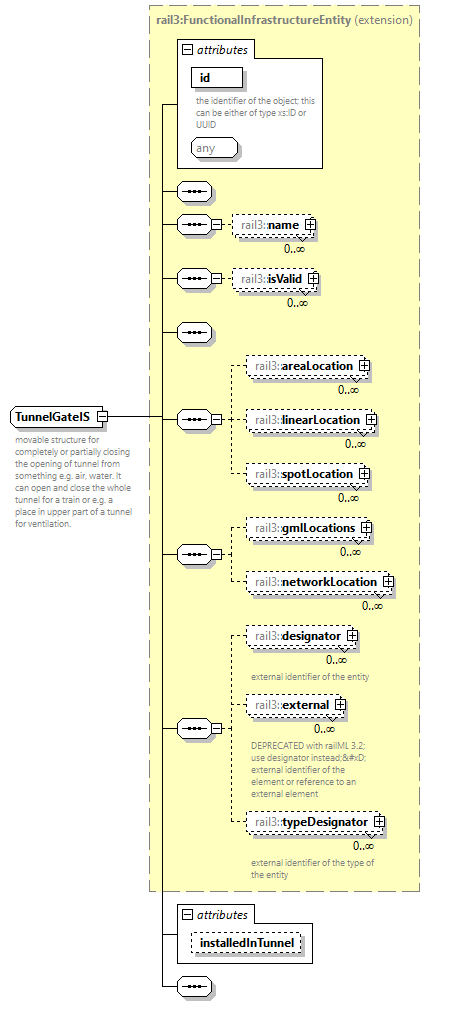 | ||||||||||||||||||||
| namespace | https://www.railml.org/schemas/3.2 | ||||||||||||||||||||
| type | extension of rail3:FunctionalInfrastructureEntity | ||||||||||||||||||||
| properties |
| ||||||||||||||||||||
| children | rail3:name rail3:isValid rail3:areaLocation rail3:linearLocation rail3:spotLocation rail3:gmlLocations rail3:networkLocation rail3:designator rail3:external rail3:typeDesignator | ||||||||||||||||||||
| used by |
| ||||||||||||||||||||
| attributes |
| ||||||||||||||||||||
| annotation |
| ||||||||||||||||||||
| source | <xs:complexType name="TunnelGateIS"> <xs:annotation> <xs:documentation>movable structure for completely or partially closing the opening of tunnel from something e.g. air, water. It can open and close the whole tunnel for a train or e.g. a place in upper part of a tunnel for ventilation.</xs:documentation> </xs:annotation> <xs:complexContent> <xs:extension base="rail3:FunctionalInfrastructureEntity"> <xs:sequence/> <xs:attribute name="installedInTunnel" type="rail3:tRef" use="optional"/> </xs:extension> </xs:complexContent> </xs:complexType> |
attribute TunnelGateIS/@installedInTunnel
| type | rail3:tRef | ||
| properties |
| ||
| source | <xs:attribute name="installedInTunnel" type="rail3:tRef" use="optional"/> |
complexType TunnelGatesIS
| diagram |  | ||
| namespace | https://www.railml.org/schemas/3.2 | ||
| children | rail3:tunnelGateIS | ||
| used by |
| ||
| source | <xs:complexType name="TunnelGatesIS"> <xs:sequence> <xs:element name="tunnelGateIS" type="rail3:TunnelGateIS" minOccurs="1" maxOccurs="unbounded"/> </xs:sequence> </xs:complexType> |
element TunnelGatesIS/tunnelGateIS
| diagram | 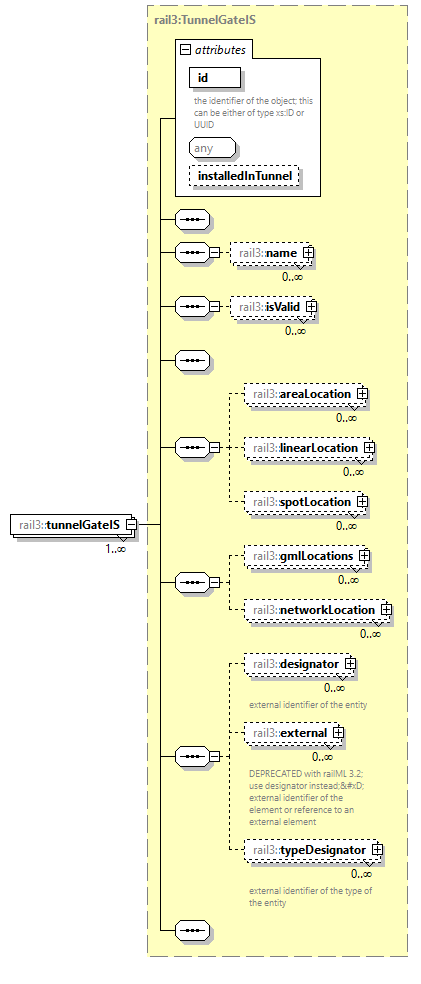 | ||||||||||||||||||||
| namespace | https://www.railml.org/schemas/3.2 | ||||||||||||||||||||
| type | rail3:TunnelGateIS | ||||||||||||||||||||
| properties |
| ||||||||||||||||||||
| children | rail3:name rail3:isValid rail3:areaLocation rail3:linearLocation rail3:spotLocation rail3:gmlLocations rail3:networkLocation rail3:designator rail3:external rail3:typeDesignator | ||||||||||||||||||||
| attributes |
| ||||||||||||||||||||
| source | <xs:element name="tunnelGateIS" type="rail3:TunnelGateIS" minOccurs="1" maxOccurs="unbounded"/> |
complexType TypeDesignator
| diagram | 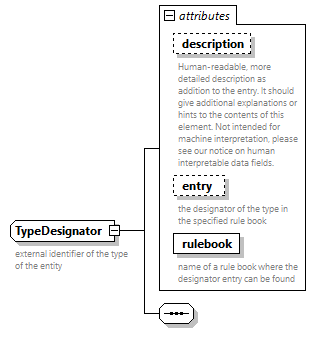 | ||||||||||||||||||||||||||||||
| namespace | https://www.railml.org/schemas/3.2 | ||||||||||||||||||||||||||||||
| used by |
| ||||||||||||||||||||||||||||||
| attributes |
| ||||||||||||||||||||||||||||||
| annotation |
| ||||||||||||||||||||||||||||||
| source | <xs:complexType name="TypeDesignator"> <xs:annotation> <xs:documentation>external identifier of the type of the entity</xs:documentation> </xs:annotation> <xs:sequence/> <xs:attribute name="description" type="xs:string" use="optional"> <xs:annotation> <xs:documentation>Human-readable, more detailed description as addition to the entry. It should give additional explanations or hints to the contents of this element. Not intended for machine interpretation, please see our notice on human interpretable data fields.</xs:documentation> </xs:annotation> </xs:attribute> <xs:attribute name="entry" type="xs:string" use="optional"> <xs:annotation> <xs:documentation>the designator of the type in the specified rule book</xs:documentation> </xs:annotation> </xs:attribute> <xs:attribute name="rulebook" type="xs:string" use="required"> <xs:annotation> <xs:documentation>name of a rule book where the designator entry can be found</xs:documentation> </xs:annotation> </xs:attribute> </xs:complexType> |
attribute TypeDesignator/@description
| type | xs:string | ||
| properties |
| ||
| annotation |
| ||
| source | <xs:attribute name="description" type="xs:string" use="optional"> <xs:annotation> <xs:documentation>Human-readable, more detailed description as addition to the entry. It should give additional explanations or hints to the contents of this element. Not intended for machine interpretation, please see our notice on human interpretable data fields.</xs:documentation> </xs:annotation> </xs:attribute> |
attribute TypeDesignator/@entry
| type | xs:string | ||
| properties |
| ||
| annotation |
| ||
| source | <xs:attribute name="entry" type="xs:string" use="optional"> <xs:annotation> <xs:documentation>the designator of the type in the specified rule book</xs:documentation> </xs:annotation> </xs:attribute> |
attribute TypeDesignator/@rulebook
| type | xs:string | ||
| properties |
| ||
| annotation |
| ||
| source | <xs:attribute name="rulebook" type="xs:string" use="required"> <xs:annotation> <xs:documentation>name of a rule book where the designator entry can be found</xs:documentation> </xs:annotation> </xs:attribute> |
complexType UnderCrossing
| diagram |  | ||||||||||||||||||||||||||||||||||||||
| namespace | https://www.railml.org/schemas/3.2 | ||||||||||||||||||||||||||||||||||||||
| type | extension of rail3:XCrossing | ||||||||||||||||||||||||||||||||||||||
| properties |
| ||||||||||||||||||||||||||||||||||||||
| children | rail3:name rail3:isValid rail3:areaLocation rail3:linearLocation rail3:spotLocation rail3:gmlLocations rail3:networkLocation rail3:designator rail3:external rail3:typeDesignator rail3:crossesElement rail3:allowedWeightLimit rail3:length | ||||||||||||||||||||||||||||||||||||||
| used by |
| ||||||||||||||||||||||||||||||||||||||
| attributes |
| ||||||||||||||||||||||||||||||||||||||
| annotation |
| ||||||||||||||||||||||||||||||||||||||
| source | <xs:complexType name="UnderCrossing"> <xs:annotation> <xs:documentation>An under crossing describes a crossing, where something crosses under the railway line. The most common constructional type of an under crossing is a bridge.</xs:documentation> </xs:annotation> <xs:complexContent> <xs:extension base="rail3:XCrossing"> <xs:sequence> <xs:element name="allowedWeightLimit" type="rail3:tElementWithIDref" minOccurs="0" maxOccurs="unbounded"> <xs:annotation> <xs:documentation>reference to weight limit classes that are allowed to pass over this under crossing</xs:documentation> </xs:annotation> </xs:element> <xs:element name="length" type="rail3:Length" minOccurs="0" maxOccurs="unbounded"> <xs:annotation> <xs:documentation>length of the under crossing relative to the railway in metres</xs:documentation> </xs:annotation> </xs:element> </xs:sequence> <xs:attribute name="belongsToParent" type="rail3:tRef" use="optional"> <xs:annotation> <xs:documentation>reference to a parent under crossing
 
 - if some information exists in parent and child, then information in child overwrites it in child
 
 - if some information exists only in parent, then child inherits this information from parent</xs:documentation> </xs:annotation> </xs:attribute> <xs:attribute name="constructionType" type="rail3:tCrossingConstructionTypeExt" use="required"> <xs:annotation> <xs:documentation>construction type of under crossing: bridge or tunnel</xs:documentation> </xs:annotation> </xs:attribute> <xs:attributeGroup ref="rail3:aVerbalConstraint"/> </xs:extension> </xs:complexContent> </xs:complexType> |
attribute UnderCrossing/@belongsToParent
| type | rail3:tRef | ||
| properties |
| ||
| annotation |
| ||
| source | <xs:attribute name="belongsToParent" type="rail3:tRef" use="optional"> <xs:annotation> <xs:documentation>reference to a parent under crossing
 
 - if some information exists in parent and child, then information in child overwrites it in child
 
 - if some information exists only in parent, then child inherits this information from parent</xs:documentation> </xs:annotation> </xs:attribute> |
attribute UnderCrossing/@constructionType
| type | rail3:tCrossingConstructionTypeExt | ||
| properties |
| ||
| annotation |
| ||
| source | <xs:attribute name="constructionType" type="rail3:tCrossingConstructionTypeExt" use="required"> <xs:annotation> <xs:documentation>construction type of under crossing: bridge or tunnel</xs:documentation> </xs:annotation> </xs:attribute> |
element UnderCrossing/allowedWeightLimit
| diagram | 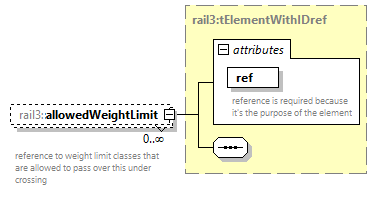 | ||||||||||||||
| namespace | https://www.railml.org/schemas/3.2 | ||||||||||||||
| type | rail3:tElementWithIDref | ||||||||||||||
| properties |
| ||||||||||||||
| attributes |
| ||||||||||||||
| annotation |
| ||||||||||||||
| source | <xs:element name="allowedWeightLimit" type="rail3:tElementWithIDref" minOccurs="0" maxOccurs="unbounded"> <xs:annotation> <xs:documentation>reference to weight limit classes that are allowed to pass over this under crossing</xs:documentation> </xs:annotation> </xs:element> |
element UnderCrossing/length
| diagram | 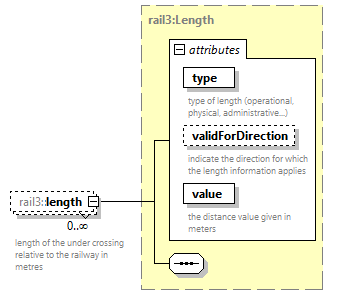 | ||||||||||||||||||||||||||||||
| namespace | https://www.railml.org/schemas/3.2 | ||||||||||||||||||||||||||||||
| type | rail3:Length | ||||||||||||||||||||||||||||||
| properties |
| ||||||||||||||||||||||||||||||
| attributes |
| ||||||||||||||||||||||||||||||
| annotation |
| ||||||||||||||||||||||||||||||
| source | <xs:element name="length" type="rail3:Length" minOccurs="0" maxOccurs="unbounded"> <xs:annotation> <xs:documentation>length of the under crossing relative to the railway in metres</xs:documentation> </xs:annotation> </xs:element> |
complexType UnderCrossings
| diagram |  | ||
| namespace | https://www.railml.org/schemas/3.2 | ||
| children | rail3:underCrossing | ||
| used by |
| ||
| source | <xs:complexType name="UnderCrossings"> <xs:sequence> <xs:element name="underCrossing" type="rail3:UnderCrossing" minOccurs="1" maxOccurs="unbounded"/> </xs:sequence> </xs:complexType> |
element UnderCrossings/underCrossing
| diagram |  | ||||||||||||||||||||||||||||||||||||||
| namespace | https://www.railml.org/schemas/3.2 | ||||||||||||||||||||||||||||||||||||||
| type | rail3:UnderCrossing | ||||||||||||||||||||||||||||||||||||||
| properties |
| ||||||||||||||||||||||||||||||||||||||
| children | rail3:name rail3:isValid rail3:areaLocation rail3:linearLocation rail3:spotLocation rail3:gmlLocations rail3:networkLocation rail3:designator rail3:external rail3:typeDesignator rail3:crossesElement rail3:allowedWeightLimit rail3:length | ||||||||||||||||||||||||||||||||||||||
| attributes |
| ||||||||||||||||||||||||||||||||||||||
| source | <xs:element name="underCrossing" type="rail3:UnderCrossing" minOccurs="1" maxOccurs="unbounded"/> |
complexType WeightLimit
| diagram | 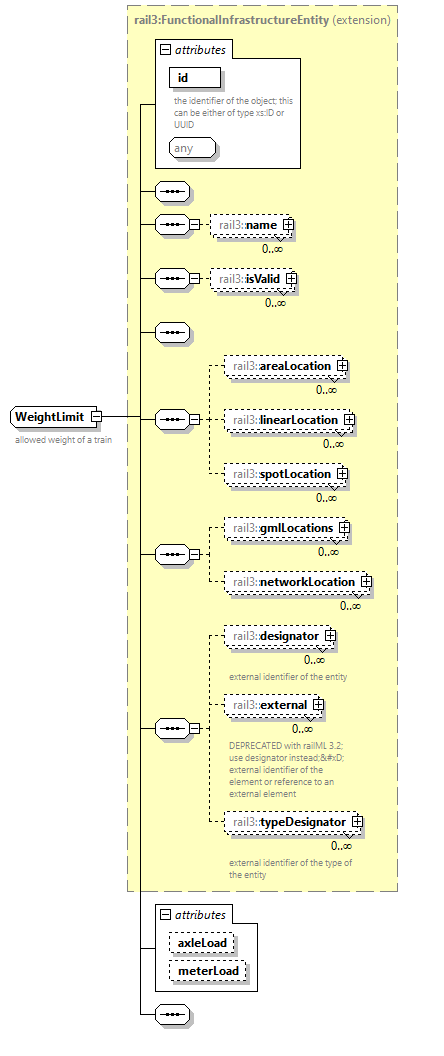 | ||||||||||||||||||||||||||
| namespace | https://www.railml.org/schemas/3.2 | ||||||||||||||||||||||||||
| type | extension of rail3:FunctionalInfrastructureEntity | ||||||||||||||||||||||||||
| properties |
| ||||||||||||||||||||||||||
| children | rail3:name rail3:isValid rail3:areaLocation rail3:linearLocation rail3:spotLocation rail3:gmlLocations rail3:networkLocation rail3:designator rail3:external rail3:typeDesignator | ||||||||||||||||||||||||||
| used by |
| ||||||||||||||||||||||||||
| attributes |
| ||||||||||||||||||||||||||
| annotation |
| ||||||||||||||||||||||||||
| source | <xs:complexType name="WeightLimit"> <xs:annotation> <xs:documentation>allowed weight of a train</xs:documentation> </xs:annotation> <xs:complexContent> <xs:extension base="rail3:FunctionalInfrastructureEntity"> <xs:sequence/> <xs:attribute name="axleLoad" type="rail3:tWeightTons" use="optional"/> <xs:attribute name="meterLoad" type="rail3:tMeterloadTonsPerMeter" use="optional"/> </xs:extension> </xs:complexContent> </xs:complexType> |
attribute WeightLimit/@axleLoad
| type | rail3:tWeightTons | ||
| properties |
| ||
| source | <xs:attribute name="axleLoad" type="rail3:tWeightTons" use="optional"/> |
attribute WeightLimit/@meterLoad
| type | rail3:tMeterloadTonsPerMeter | ||
| properties |
| ||
| source | <xs:attribute name="meterLoad" type="rail3:tMeterloadTonsPerMeter" use="optional"/> |
complexType WeightLimits
| diagram |  | ||
| namespace | https://www.railml.org/schemas/3.2 | ||
| children | rail3:weightLimit | ||
| used by |
| ||
| annotation |
| ||
| source | <xs:complexType name="WeightLimits"> <xs:annotation> <xs:documentation>umbrella element for all weightLimit elements</xs:documentation> </xs:annotation> <xs:sequence> <xs:element name="weightLimit" type="rail3:WeightLimit" minOccurs="1" maxOccurs="unbounded"/> </xs:sequence> </xs:complexType> |
element WeightLimits/weightLimit
| diagram | 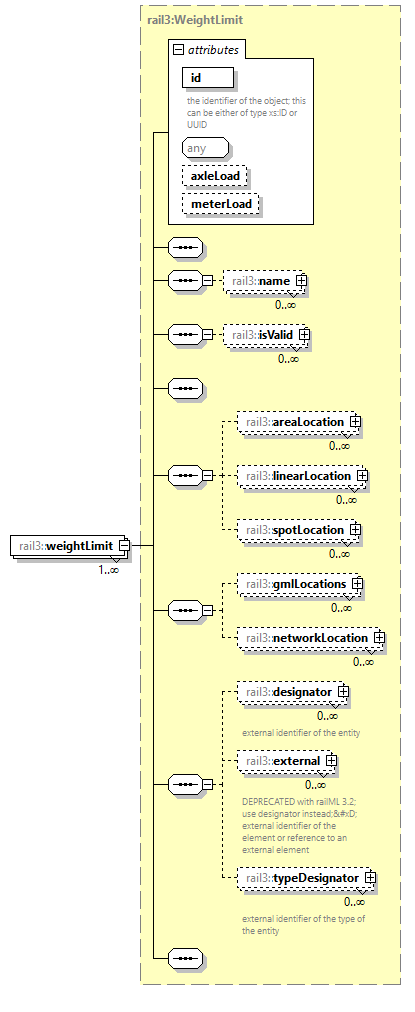 | ||||||||||||||||||||||||||
| namespace | https://www.railml.org/schemas/3.2 | ||||||||||||||||||||||||||
| type | rail3:WeightLimit | ||||||||||||||||||||||||||
| properties |
| ||||||||||||||||||||||||||
| children | rail3:name rail3:isValid rail3:areaLocation rail3:linearLocation rail3:spotLocation rail3:gmlLocations rail3:networkLocation rail3:designator rail3:external rail3:typeDesignator | ||||||||||||||||||||||||||
| attributes |
| ||||||||||||||||||||||||||
| source | <xs:element name="weightLimit" type="rail3:WeightLimit" minOccurs="1" maxOccurs="unbounded"/> |
complexType XCrossing
| diagram | 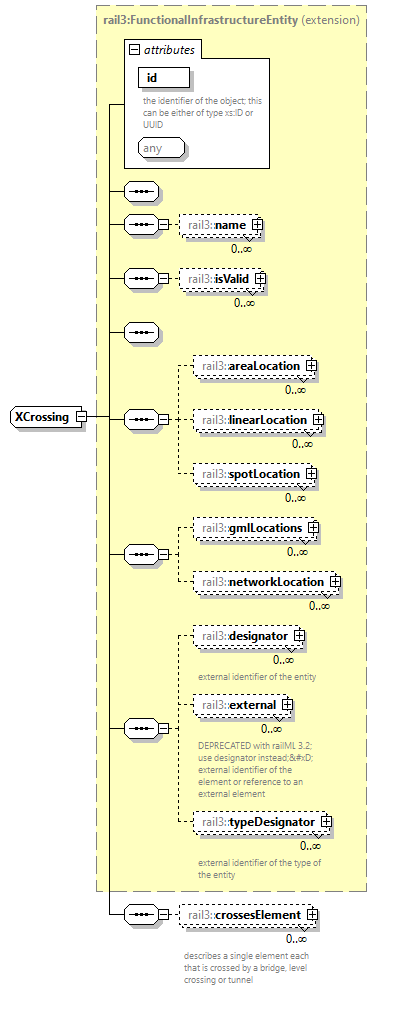 | ||||||||||||||
| namespace | https://www.railml.org/schemas/3.2 | ||||||||||||||
| type | extension of rail3:FunctionalInfrastructureEntity | ||||||||||||||
| properties |
| ||||||||||||||
| children | rail3:name rail3:isValid rail3:areaLocation rail3:linearLocation rail3:spotLocation rail3:gmlLocations rail3:networkLocation rail3:designator rail3:external rail3:typeDesignator rail3:crossesElement | ||||||||||||||
| used by |
| ||||||||||||||
| attributes |
| ||||||||||||||
| source | <xs:complexType name="XCrossing" abstract="true"> <xs:complexContent> <xs:extension base="rail3:FunctionalInfrastructureEntity"> <xs:sequence> <xs:element name="crossesElement" type="rail3:CrossedElement" minOccurs="0" maxOccurs="unbounded"> <xs:annotation> <xs:documentation>describes a single element each that is crossed by a bridge, level crossing or tunnel</xs:documentation> </xs:annotation> </xs:element> </xs:sequence> </xs:extension> </xs:complexContent> </xs:complexType> |
element XCrossing/crossesElement
| diagram | 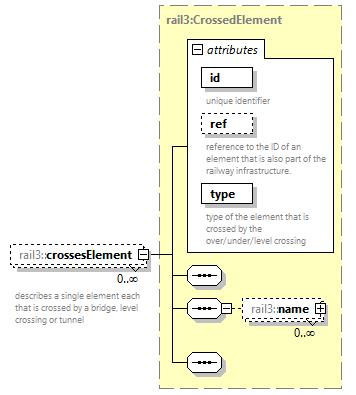 | ||||||||||||||||||||||||||||||
| namespace | https://www.railml.org/schemas/3.2 | ||||||||||||||||||||||||||||||
| type | rail3:CrossedElement | ||||||||||||||||||||||||||||||
| properties |
| ||||||||||||||||||||||||||||||
| children | rail3:name | ||||||||||||||||||||||||||||||
| attributes |
| ||||||||||||||||||||||||||||||
| annotation |
| ||||||||||||||||||||||||||||||
| source | <xs:element name="crossesElement" type="rail3:CrossedElement" minOccurs="0" maxOccurs="unbounded"> <xs:annotation> <xs:documentation>describes a single element each that is crossed by a bridge, level crossing or tunnel</xs:documentation> </xs:annotation> </xs:element> |
simpleType EtcsLevelType
| namespace | https://www.railml.org/schemas/3.2 | |||||||||||
| type | restriction of xs:string | |||||||||||
| properties |
| |||||||||||
| used by |
| |||||||||||
| facets |
| |||||||||||
| source | <xs:simpleType name="EtcsLevelType"> <xs:restriction base="xs:string"> <xs:enumeration value="ETCS"/> <xs:enumeration value="NTC"> <xs:annotation> <xs:documentation>national train control system</xs:documentation> </xs:annotation> </xs:enumeration> </xs:restriction> </xs:simpleType> |
simpleType EtcsLevelTypeExt
| namespace | https://www.railml.org/schemas/3.2 | ||
| type | union of (rail3:EtcsLevelType, rail3:tOtherEnumerationValue) | ||
| used by |
| ||
| source | <xs:simpleType name="EtcsLevelTypeExt"> <xs:union memberTypes="rail3:EtcsLevelType rail3:tOtherEnumerationValue"/> </xs:simpleType> |
simpleType MileageChangeType
| namespace | https://www.railml.org/schemas/3.2 | |||||||||||||
| type | restriction of xs:string | |||||||||||||
| properties |
| |||||||||||||
| used by |
| |||||||||||||
| facets |
| |||||||||||||
| source | <xs:simpleType name="MileageChangeType"> <xs:restriction base="xs:string"> <xs:enumeration value="gap"> <xs:annotation> <xs:documentation>a mileage anomaly which happens when the value of algebraic difference between adjacent kilometre posts is lower than actual distance between them. This occurs when re-alignment made new track longer.</xs:documentation> </xs:annotation> </xs:enumeration> <xs:enumeration value="overlap"> <xs:annotation> <xs:documentation>a mileage anomaly which happens when the value of algebraic difference between adjacent kilometre posts is higher than actual distance between them. This occurs when re-alignment made new track shorter.</xs:documentation> </xs:annotation> </xs:enumeration> </xs:restriction> </xs:simpleType> |
simpleType SwitchReferencePoint
| namespace | https://www.railml.org/schemas/3.2 | |||||||||||||
| type | restriction of xs:string | |||||||||||||
| properties |
| |||||||||||||
| used by |
| |||||||||||||
| facets |
| |||||||||||||
| source | <xs:simpleType name="SwitchReferencePoint"> <xs:restriction base="xs:string"> <xs:enumeration value="switchBegin"> <xs:annotation> <xs:documentation>useful when creating schematic track plans, but exists only "virtual"</xs:documentation> </xs:annotation> </xs:enumeration> <xs:enumeration value="switchCenter"> <xs:annotation> <xs:documentation>the point, where the branching starts, which is easy to determine outside in the field</xs:documentation> </xs:annotation> </xs:enumeration> </xs:restriction> </xs:simpleType> |
simpleType tBaliseDuplicate
| namespace | https://www.railml.org/schemas/3.2 | ||||||||||||
| type | restriction of xs:string | ||||||||||||
| properties |
| ||||||||||||
| used by |
| ||||||||||||
| facets |
| ||||||||||||
| source | <xs:simpleType name="tBaliseDuplicate"> <xs:restriction base="xs:string"> <xs:enumeration value="no"/> <xs:enumeration value="ofNextBalise"/> <xs:enumeration value="ofPreviousBalise"/> </xs:restriction> </xs:simpleType> |
simpleType tBaliseGroupApplicationType
| namespace | https://www.railml.org/schemas/3.2 | ||||||||||||||||||||||||||||
| type | restriction of xs:string | ||||||||||||||||||||||||||||
| properties |
| ||||||||||||||||||||||||||||
| used by |
| ||||||||||||||||||||||||||||
| facets |
| ||||||||||||||||||||||||||||
| source | <xs:simpleType name="tBaliseGroupApplicationType"> <xs:restriction base="xs:string"> <xs:enumeration value="ETCS"> <xs:annotation> <xs:documentation>European Train Control System</xs:documentation> </xs:annotation> </xs:enumeration> <xs:enumeration value="GNT"> <xs:annotation> <xs:documentation>Geschwindigkeitsüberwachung Neigetechnik (German, translated "Speed Control for Tilting Technology)</xs:documentation> </xs:annotation> </xs:enumeration> <xs:enumeration value="NTC"> <xs:annotation> <xs:documentation>National Train Control</xs:documentation> </xs:annotation> </xs:enumeration> <xs:enumeration value="TBL1+"> <xs:annotation> <xs:documentation>A transitional solution intended to facilitate migration to the European train control system ETCS . The same signal terms as with TBL1 are transmitted and interpreted by the vehicle in the same way. However, Eurobalises are used as the transmission path from the track to the vehicle, as in the ETCS system.</xs:documentation> </xs:annotation> </xs:enumeration> <xs:enumeration value="ZBS"> <xs:annotation> <xs:documentation>Zugbeeinflussungssystem S-Bahn Berlin</xs:documentation> </xs:annotation> </xs:enumeration> </xs:restriction> </xs:simpleType> |
simpleType tBaliseGroupApplicationTypeExt
| namespace | https://www.railml.org/schemas/3.2 | ||
| type | union of (rail3:tBaliseGroupApplicationType, rail3:tOtherEnumerationValue) | ||
| used by |
| ||
| source | <xs:simpleType name="tBaliseGroupApplicationTypeExt"> <xs:union memberTypes="rail3:tBaliseGroupApplicationType rail3:tOtherEnumerationValue"/> </xs:simpleType> |
simpleType tBaliseGroupConnectionType
| namespace | https://www.railml.org/schemas/3.2 | |||||||||
| type | restriction of xs:string | |||||||||
| properties |
| |||||||||
| used by |
| |||||||||
| facets |
| |||||||||
| source | <xs:simpleType name="tBaliseGroupConnectionType"> <xs:restriction base="xs:string"> <xs:enumeration value="logical"/> <xs:enumeration value="physical"/> </xs:restriction> </xs:simpleType> |
simpleType tBaliseGroupCoverage
| namespace | https://www.railml.org/schemas/3.2 | |||||||||||||||
| type | restriction of xs:string | |||||||||||||||
| properties |
| |||||||||||||||
| used by |
| |||||||||||||||
| facets |
| |||||||||||||||
| source | <xs:simpleType name="tBaliseGroupCoverage"> <xs:restriction base="xs:string"> <xs:enumeration value="both"/> <xs:enumeration value="none"/> <xs:enumeration value="physical"/> <xs:enumeration value="virtual"/> </xs:restriction> </xs:simpleType> |
simpleType tBaliseGroupFunctionalType
| namespace | https://www.railml.org/schemas/3.2 | ||||||||||||||||||||||||||||||||||||||||||||||||||||||||||||||||||||||||||||||
| type | restriction of xs:string | ||||||||||||||||||||||||||||||||||||||||||||||||||||||||||||||||||||||||||||||
| properties |
| ||||||||||||||||||||||||||||||||||||||||||||||||||||||||||||||||||||||||||||||
| used by |
| ||||||||||||||||||||||||||||||||||||||||||||||||||||||||||||||||||||||||||||||
| facets |
| ||||||||||||||||||||||||||||||||||||||||||||||||||||||||||||||||||||||||||||||
| source | <xs:simpleType name="tBaliseGroupFunctionalType"> <xs:restriction base="xs:string"> <xs:enumeration value="announcementLevelTransition"> <xs:annotation> <xs:documentation>In relation to this balise group, at least the UNISIG Packet 41 including D_LEVELTR < 32767 will be transmitted to the train (via balise: ETCS L1 or L2 or via radio: ETCS L2 only) for the mileageDirection valid for this function.</xs:documentation> </xs:annotation> </xs:enumeration> <xs:enumeration value="announcementTemporarySpeedRestriction"> <xs:annotation> <xs:documentation>This balise group transmits at least a UNISIG Packet 65 for the mileageDirection valid for this function.</xs:documentation> </xs:annotation> </xs:enumeration> <xs:enumeration value="border"> <xs:annotation> <xs:documentation>In relation to this balise group, at least the UNISIG Packet 41 including D_LEVELTR = 32767 will be transmitted to the train (via balise: ETCS L1 or L2 or via radio: ETCS L2 only) for the mileageDirection valid for this function.</xs:documentation> </xs:annotation> </xs:enumeration> <xs:enumeration value="handover"> <xs:annotation> <xs:documentation>This balise group transmits at least a UNISIG Packet 131 for the mileageDirection valid for this function.</xs:documentation> </xs:annotation> </xs:enumeration> <xs:enumeration value="infill"> <xs:annotation> <xs:documentation>This balise group transmits at least a UNISIG Packet 136 for the mileageDirection valid for this function.</xs:documentation> </xs:annotation> </xs:enumeration> <xs:enumeration value="networkRegistration"> <xs:annotation> <xs:documentation>This balise group transmits at least a UNISIG Packet 45 for the mileageDirection valid for this function.</xs:documentation> </xs:annotation> </xs:enumeration> <xs:enumeration value="normal"> <xs:annotation> <xs:documentation>Normal balisegroup used in all the other context.</xs:documentation> </xs:annotation> </xs:enumeration> <xs:enumeration value="odometryPurposeOnly"> <xs:annotation> <xs:documentation>Each balise of this balise group transmits only UNISIG defined ETCS telegram header and UNISIG Packet 255 (End of information) for the mileageDirection valid for this function.</xs:documentation> </xs:annotation> </xs:enumeration> <xs:enumeration value="revocationTemporarySpeedRestriction"> <xs:annotation> <xs:documentation>This balise group transmits at least a UNISIG Packet 66 for the mileageDirection valid for this function.</xs:documentation> </xs:annotation> </xs:enumeration> <xs:enumeration value="sessionEstablishment"> <xs:annotation> <xs:documentation>This balise group transmits at least a UNISIG Packet 42 including Q_RBC=1 for the mileageDirection valid for this function.</xs:documentation> </xs:annotation> </xs:enumeration> <xs:enumeration value="sessionTermination"> <xs:annotation> <xs:documentation>This balise group transmits at least a UNISIG Packet 42 including Q_RBC=0 for the mileageDirection valid for this function.</xs:documentation> </xs:annotation> </xs:enumeration> <xs:enumeration value="signal"> <xs:annotation> <xs:documentation>This balise group is linked physically (in case of ETCS L1) or logical (in case of ETCS Level 2) with a main signal. In relation to this balise group, at least the UNISIG Packets MA (12: ETCS L1 or 15: ETCS L2), 21 and 27 will be transmitted to the train (via balise: ETCS L1 or via radio: ETCS L2) for the mileageDirection valid for this function.</xs:documentation> </xs:annotation> </xs:enumeration> <xs:enumeration value="stopIfInShunting"> <xs:annotation> <xs:documentation>This balise group transmits at least a UNISIG Packet 132 including Q_ASPECT=0 for the mileageDirection valid for this function.</xs:documentation> </xs:annotation> </xs:enumeration> <xs:enumeration value="trackAheadFree"> <xs:annotation> <xs:documentation>This balise group transmits at least a UNISIG Packet 90.</xs:documentation> </xs:annotation> </xs:enumeration> <xs:enumeration value="stopIfInStaffResponsible"> <xs:annotation> <xs:documentation>This balise group transmits at least a UNISIG Packet 137 including Q_SRSTOP=0 for the mileageDirection valid for this function.</xs:documentation> </xs:annotation> </xs:enumeration> </xs:restriction> </xs:simpleType> |
simpleType tBaliseGroupFunctionalTypeExt
| namespace | https://www.railml.org/schemas/3.2 | ||
| type | union of (rail3:tBaliseGroupFunctionalType, rail3:tOtherEnumerationValue) | ||
| used by |
| ||
| source | <xs:simpleType name="tBaliseGroupFunctionalTypeExt"> <xs:union memberTypes="rail3:tBaliseGroupFunctionalType rail3:tOtherEnumerationValue"/> </xs:simpleType> |
simpleType tBaliseGroupLinkReaction
| namespace | https://www.railml.org/schemas/3.2 | ||||||||||||
| type | restriction of xs:string | ||||||||||||
| properties |
| ||||||||||||
| used by |
| ||||||||||||
| facets |
| ||||||||||||
| source | <xs:simpleType name="tBaliseGroupLinkReaction"> <xs:restriction base="xs:string"> <xs:enumeration value="applyServiceBrake"/> <xs:enumeration value="noReaction"/> <xs:enumeration value="trainTrip"/> </xs:restriction> </xs:simpleType> |
simpleType tBaliseGroupType
| namespace | https://www.railml.org/schemas/3.2 | ||||||||||||
| type | restriction of xs:string | ||||||||||||
| properties |
| ||||||||||||
| used by |
| ||||||||||||
| facets |
| ||||||||||||
| annotation |
| ||||||||||||
| source | <xs:simpleType name="tBaliseGroupType"> <xs:annotation> <xs:documentation>DEPRECATED with railML 3.2</xs:documentation> </xs:annotation> <xs:restriction base="xs:string"> <xs:enumeration value="fixed"/> <xs:enumeration value="infill"/> <xs:enumeration value="signal"/> </xs:restriction> </xs:simpleType> |
simpleType tBaliseGroupTypeExt
| namespace | https://www.railml.org/schemas/3.2 | ||
| type | union of (rail3:tBaliseGroupType, rail3:tOtherEnumerationValue) | ||
| used by |
| ||
| annotation |
| ||
| source | <xs:simpleType name="tBaliseGroupTypeExt"> <xs:annotation> <xs:documentation>DEPRECATED with railML 3.2</xs:documentation> </xs:annotation> <xs:union memberTypes="rail3:tBaliseGroupType rail3:tOtherEnumerationValue"/> </xs:simpleType> |
simpleType tBaliseType
| namespace | https://www.railml.org/schemas/3.2 | ||||||||||||||||||
| type | restriction of xs:string | ||||||||||||||||||
| properties |
| ||||||||||||||||||
| used by |
| ||||||||||||||||||
| facets |
| ||||||||||||||||||
| source | <xs:simpleType name="tBaliseType"> <xs:restriction base="xs:string"> <xs:enumeration value="controlled"> <xs:annotation> <xs:documentation>describes a controlled data balise</xs:documentation> </xs:annotation> </xs:enumeration> <xs:enumeration value="fixed"> <xs:annotation> <xs:documentation>describes a fixed data balise</xs:documentation> </xs:annotation> </xs:enumeration> <xs:enumeration value="transparent"> <xs:annotation> <xs:documentation>DEPRECATED with railML 3.2, use value 'controlled' instead</xs:documentation> </xs:annotation> </xs:enumeration> </xs:restriction> </xs:simpleType> |
simpleType tBallastType
| namespace | https://www.railml.org/schemas/3.2 | |||||||||
| type | restriction of xs:string | |||||||||
| properties |
| |||||||||
| used by |
| |||||||||
| facets |
| |||||||||
| source | <xs:simpleType name="tBallastType"> <xs:restriction base="xs:string"> <xs:enumeration value="ballast"/> <xs:enumeration value="slabTrack"/> </xs:restriction> </xs:simpleType> |
simpleType tBorderType
| namespace | https://www.railml.org/schemas/3.2 | |||||||||||||||||||||||||||||||||
| type | restriction of xs:string | |||||||||||||||||||||||||||||||||
| properties |
| |||||||||||||||||||||||||||||||||
| used by |
| |||||||||||||||||||||||||||||||||
| facets |
| |||||||||||||||||||||||||||||||||
| source | <xs:simpleType name="tBorderType"> <xs:restriction base="xs:string"> <xs:enumeration value="area"> <xs:annotation> <xs:documentation>border between different areas, e.g. areas that are controlled by different controllers</xs:documentation> </xs:annotation> </xs:enumeration> <xs:enumeration value="country"> <xs:annotation> <xs:documentation>border between different (national) countries</xs:documentation> </xs:annotation> </xs:enumeration> <xs:enumeration value="infrastructureManager"> <xs:annotation> <xs:documentation>border between infrastructure networks of different infrastructure managers</xs:documentation> </xs:annotation> </xs:enumeration> <xs:enumeration value="state"> <xs:annotation> <xs:documentation>border of a (federal) state</xs:documentation> </xs:annotation> </xs:enumeration> <xs:enumeration value="station"> <xs:annotation> <xs:documentation>border of a station</xs:documentation> </xs:annotation> </xs:enumeration> <xs:enumeration value="tariff"> <xs:annotation> <xs:documentation>border between different tariff zones;
 Shall also be used for borders between two (or more) transport associations</xs:documentation> </xs:annotation> </xs:enumeration> </xs:restriction> </xs:simpleType> |
simpleType tBorderTypeExt
| namespace | https://www.railml.org/schemas/3.2 | ||
| type | union of (rail3:tBorderType, rail3:tOtherEnumerationValue) | ||
| used by |
| ||
| source | <xs:simpleType name="tBorderTypeExt"> <xs:union memberTypes="rail3:tBorderType rail3:tOtherEnumerationValue"/> </xs:simpleType> |
simpleType tBufferStopType
| namespace | https://www.railml.org/schemas/3.2 | |||||||||||||||
| type | restriction of xs:string | |||||||||||||||
| properties |
| |||||||||||||||
| used by |
| |||||||||||||||
| facets |
| |||||||||||||||
| source | <xs:simpleType name="tBufferStopType"> <xs:restriction base="xs:string"> <xs:enumeration value="brakingBufferStop"/> <xs:enumeration value="fixedBufferStop"/> <xs:enumeration value="headRamp"/> <xs:enumeration value="sleeperCross"/> </xs:restriction> </xs:simpleType> |
simpleType tBufferStopTypeExt
| namespace | https://www.railml.org/schemas/3.2 |
| type | union of (rail3:tBufferStopType, rail3:tOtherEnumerationValue) |
| source | <xs:simpleType name="tBufferStopTypeExt"> <xs:union memberTypes="rail3:tBufferStopType rail3:tOtherEnumerationValue"/> </xs:simpleType> |
simpleType tContactLineType
| namespace | https://www.railml.org/schemas/3.2 | |||||||||||||||||||||
| type | restriction of xs:string | |||||||||||||||||||||
| properties |
| |||||||||||||||||||||
| used by |
| |||||||||||||||||||||
| facets |
| |||||||||||||||||||||
| source | <xs:simpleType name="tContactLineType"> <xs:restriction base="xs:string"> <xs:enumeration value="3rdRailBottom"/> <xs:enumeration value="3rdRailSide"/> <xs:enumeration value="3rdRailTop"/> <xs:enumeration value="none"/> <xs:enumeration value="overhead"/> <xs:enumeration value="sideRail"/> </xs:restriction> </xs:simpleType> |
simpleType tContactLineTypeExt
| namespace | https://www.railml.org/schemas/3.2 |
| type | union of (rail3:tContactLineType, rail3:tOtherEnumerationValue) |
| source | <xs:simpleType name="tContactLineTypeExt"> <xs:union memberTypes="rail3:tContactLineType rail3:tOtherEnumerationValue"/> </xs:simpleType> |
simpleType tContactStripMaterial
| namespace | https://www.railml.org/schemas/3.2 | |||||||||||||||||||||||||||||||||
| type | restriction of xs:string | |||||||||||||||||||||||||||||||||
| properties |
| |||||||||||||||||||||||||||||||||
| used by |
| |||||||||||||||||||||||||||||||||
| facets |
| |||||||||||||||||||||||||||||||||
| source | <xs:simpleType name="tContactStripMaterial"> <xs:restriction base="xs:string"> <xs:enumeration value="carbonAdditiveMaterial"/> <xs:enumeration value="carbonCladdedCopper"/> <xs:enumeration value="copper"/> <xs:enumeration value="copperAlloy"/> <xs:enumeration value="copperCladCarbon"/> <xs:enumeration value="copperSteel"/> <xs:enumeration value="impregnatedCarbon"/> <xs:enumeration value="other"/> <xs:enumeration value="plainCarbon"/> <xs:enumeration value="sinteredCopper"/> </xs:restriction> </xs:simpleType> |
simpleType tContactStripMaterialList
| namespace | https://www.railml.org/schemas/3.2 | ||
| type | list of rail3:tContactStripMaterial | ||
| properties |
| ||
| used by |
| ||
| source | <xs:simpleType name="tContactStripMaterialList"> <xs:list itemType="rail3:tContactStripMaterial"/> </xs:simpleType> |
simpleType tCourse
| namespace | https://www.railml.org/schemas/3.2 | |||||||||
| type | restriction of xs:string | |||||||||
| properties |
| |||||||||
| used by |
| |||||||||
| facets |
| |||||||||
| source | <xs:simpleType name="tCourse"> <xs:restriction base="xs:string"> <xs:enumeration value="left"/> <xs:enumeration value="right"/> </xs:restriction> </xs:simpleType> |
simpleType tCrossedElementType
| namespace | https://www.railml.org/schemas/3.2 | ||||||||||||||||||||||||||||||||||||||||||||||||||||||||||||||||||||||||||||||||||||||||
| type | restriction of xs:string | ||||||||||||||||||||||||||||||||||||||||||||||||||||||||||||||||||||||||||||||||||||||||
| properties |
| ||||||||||||||||||||||||||||||||||||||||||||||||||||||||||||||||||||||||||||||||||||||||
| used by |
| ||||||||||||||||||||||||||||||||||||||||||||||||||||||||||||||||||||||||||||||||||||||||
| facets |
| ||||||||||||||||||||||||||||||||||||||||||||||||||||||||||||||||||||||||||||||||||||||||
| source | <xs:simpleType name="tCrossedElementType"> <xs:restriction base="xs:string"> <xs:enumeration value="area"> <xs:annotation> <xs:documentation>generic value for describing an areal location within the network</xs:documentation> </xs:annotation> </xs:enumeration> <xs:enumeration value="city"> <xs:annotation> <xs:documentation>a human settlement of a notable size [The Penguin Dictionary of Human Geography].</xs:documentation> </xs:annotation> </xs:enumeration> <xs:enumeration value="cycleway"> <xs:annotation> <xs:documentation>path, track or lane restricted to bicycles</xs:documentation> </xs:annotation> </xs:enumeration> <xs:enumeration value="footway"> <xs:annotation> <xs:documentation>path, track or sidewalk restricted to pedestrian traffic</xs:documentation> </xs:annotation> </xs:enumeration> <xs:enumeration value="lake"> <xs:annotation> <xs:documentation>naturally occurring, relatively large body of water localized in a basin surrounded by dry land [Encyclopaedia Britannica].</xs:documentation> </xs:annotation> </xs:enumeration> <xs:enumeration value="motorway"> <xs:annotation> <xs:documentation>national road with restricted access, divided traffic and grade separated junctions</xs:documentation> </xs:annotation> </xs:enumeration> <xs:enumeration value="peak"> <xs:annotation> <xs:documentation>of a hill or mountain - is immaterial and maps the highest point of a natural or renaturalised physical feature [openStreetMap].</xs:documentation> </xs:annotation> </xs:enumeration> <xs:enumeration value="permissiveRoad"> <xs:annotation> <xs:documentation>private road with public access</xs:documentation> </xs:annotation> </xs:enumeration> <xs:enumeration value="primaryRoad"> <xs:annotation> <xs:documentation>national road linking large towns; no motorway</xs:documentation> </xs:annotation> </xs:enumeration> <xs:enumeration value="privateRoad"> <xs:annotation> <xs:documentation>private road with no public access</xs:documentation> </xs:annotation> </xs:enumeration> <xs:enumeration value="ridge"> <xs:annotation> <xs:documentation>a hill or mountain landform with a continuous elevated crest. The sides of the ridge slope away on either side of the crest. The line along the crest formed by the highest points is called the ridgeline [openStreetMap].</xs:documentation> </xs:annotation> </xs:enumeration> <xs:enumeration value="river"> <xs:annotation> <xs:documentation>linear flow of larger natural waterways, in flow direction. Note that the linear ways should form a complete routable description of the watercourse [openStreetMap].</xs:documentation> </xs:annotation> </xs:enumeration> <xs:enumeration value="road"> <xs:annotation> <xs:documentation>unknown road type</xs:documentation> </xs:annotation> </xs:enumeration> <xs:enumeration value="secondaryRoad"> <xs:annotation> <xs:documentation>county road linking towns</xs:documentation> </xs:annotation> </xs:enumeration> <xs:enumeration value="tertiaryRoad"> <xs:annotation> <xs:documentation>municipal road within towns and in the countryside</xs:documentation> </xs:annotation> </xs:enumeration> <xs:enumeration value="valley"> <xs:annotation> <xs:documentation>an elongated natural depression flanked by ridges or ranges of mountains or hills, and at least partially formed by fluvial degration [openStreetMap].</xs:documentation> </xs:annotation> </xs:enumeration> <xs:enumeration value="railway"> <xs:annotation> <xs:documentation>A track, consisting of parallel rails, over which wheeled vehicles such as trains may travel [wiktionary].</xs:documentation> </xs:annotation> </xs:enumeration> </xs:restriction> </xs:simpleType> |
simpleType tCrossedElementTypeExt
| namespace | https://www.railml.org/schemas/3.2 | ||
| type | union of (rail3:tCrossedElementType, rail3:tOtherEnumerationValue) | ||
| used by |
| ||
| source | <xs:simpleType name="tCrossedElementTypeExt"> <xs:union memberTypes="rail3:tCrossedElementType rail3:tOtherEnumerationValue"/> </xs:simpleType> |
simpleType tCrossingConstructionType
| namespace | https://www.railml.org/schemas/3.2 | ||||||||||||||||||
| type | restriction of xs:string | ||||||||||||||||||
| properties |
| ||||||||||||||||||
| used by |
| ||||||||||||||||||
| facets |
| ||||||||||||||||||
| source | <xs:simpleType name="tCrossingConstructionType"> <xs:restriction base="xs:string"> <xs:enumeration value="bridge"> <xs:annotation> <xs:documentation>a structure built to span a physical obstacle (such as a body of water, valley, road, or railway) without blocking the way underneath [wikipedia].</xs:documentation> </xs:annotation> </xs:enumeration> <xs:enumeration value="tunnel"> <xs:annotation> <xs:documentation>underground passageway, dug through surrounding soil, earth or rock, and enclosed except for the entrance and exit, commonly at each end [wikipedia].</xs:documentation> </xs:annotation> </xs:enumeration> <xs:enumeration value="movableBridge"> <xs:annotation> <xs:documentation>A special movable bridge (undercrossing) which is used for railway traffic passing a waterway underneath the railway line in normal position but allows for temporarily being moved out of the way of the vessels. It is then not passable by trains.
 The normal position is locked and supervised by interlocking system. The other control of the bridge is outside the interlocking system.</xs:documentation> </xs:annotation> </xs:enumeration> </xs:restriction> </xs:simpleType> |
simpleType tCrossingConstructionTypeExt
| namespace | https://www.railml.org/schemas/3.2 | ||
| type | union of (rail3:tCrossingConstructionType, rail3:tOtherEnumerationValue) | ||
| used by |
| ||
| source | <xs:simpleType name="tCrossingConstructionTypeExt"> <xs:union memberTypes="rail3:tCrossingConstructionType rail3:tOtherEnumerationValue"/> </xs:simpleType> |
simpleType tCurrentSystem
| namespace | https://www.railml.org/schemas/3.2 | |||||||||
| type | restriction of xs:string | |||||||||
| properties |
| |||||||||
| facets |
| |||||||||
| source | <xs:simpleType name="tCurrentSystem"> <xs:restriction base="xs:string"> <xs:enumeration value="AC"/> <xs:enumeration value="DC"/> </xs:restriction> </xs:simpleType> |
simpleType tDerailerType
| namespace | https://www.railml.org/schemas/3.2 | |||||||||||||
| type | restriction of xs:string | |||||||||||||
| properties |
| |||||||||||||
| used by |
| |||||||||||||
| facets |
| |||||||||||||
| source | <xs:simpleType name="tDerailerType"> <xs:restriction base="xs:string"> <xs:enumeration value="doubleDerailer"> <xs:annotation> <xs:documentation>two derail devices installed on two rails</xs:documentation> </xs:annotation> </xs:enumeration> <xs:enumeration value="singleDerailer"> <xs:annotation> <xs:documentation>one derail device installed on one rail</xs:documentation> </xs:annotation> </xs:enumeration> </xs:restriction> </xs:simpleType> |
simpleType tDetectedObject
| namespace | https://www.railml.org/schemas/3.2 | |||||||||||||||
| type | restriction of xs:string | |||||||||||||||
| properties |
| |||||||||||||||
| used by |
| |||||||||||||||
| facets |
| |||||||||||||||
| source | <xs:simpleType name="tDetectedObject"> <xs:restriction base="xs:string"> <xs:enumeration value="axle"/> <xs:enumeration value="endOfTrain"/> <xs:enumeration value="train"/> <xs:enumeration value="wheel"/> </xs:restriction> </xs:simpleType> |
simpleType tDetectorLayout
| namespace | https://www.railml.org/schemas/3.2 | |||||||||||||||||||||
| type | restriction of xs:string | |||||||||||||||||||||
| properties |
| |||||||||||||||||||||
| used by |
| |||||||||||||||||||||
| facets |
| |||||||||||||||||||||
| source | <xs:simpleType name="tDetectorLayout"> <xs:restriction base="xs:string"> <xs:enumeration value="doubleLoop"/> <xs:enumeration value="doubleSensor"/> <xs:enumeration value="railCircuitStandAlone"/> <xs:enumeration value="singleLoop"/> <xs:enumeration value="singleSensor"/> <xs:enumeration value="tripleLoop"/> </xs:restriction> </xs:simpleType> |
simpleType tDetectorMedium
| namespace | https://www.railml.org/schemas/3.2 | ||||||||||||||||||||||||
| type | restriction of xs:string | ||||||||||||||||||||||||
| properties |
| ||||||||||||||||||||||||
| used by |
| ||||||||||||||||||||||||
| facets |
| ||||||||||||||||||||||||
| source | <xs:simpleType name="tDetectorMedium"> <xs:restriction base="xs:string"> <xs:enumeration value="hydraulic"/> <xs:enumeration value="inductive"/> <xs:enumeration value="magnetic"/> <xs:enumeration value="mechanical"/> <xs:enumeration value="optical"/> <xs:enumeration value="pneumatic"/> <xs:enumeration value="radio"/> </xs:restriction> </xs:simpleType> |
simpleType tGradientCurveType
| namespace | https://www.railml.org/schemas/3.2 | ||||||||||||||||||
| type | restriction of xs:string | ||||||||||||||||||
| properties |
| ||||||||||||||||||
| used by |
| ||||||||||||||||||
| facets |
| ||||||||||||||||||
| source | <xs:simpleType name="tGradientCurveType"> <xs:restriction base="xs:string"> <xs:enumeration value="arc"> <xs:annotation> <xs:documentation>curve, that link two (e.g. straight) elements of gradient profile of a railway track, with a constant radius that is not infinite</xs:documentation> </xs:annotation> </xs:enumeration> <xs:enumeration value="mixed"> <xs:annotation> <xs:documentation>an aggregated curve with arcs and straight parts</xs:documentation> </xs:annotation> </xs:enumeration> <xs:enumeration value="straight"> <xs:annotation> <xs:documentation>curve with constant infinite radius (zero curvature)</xs:documentation> </xs:annotation> </xs:enumeration> </xs:restriction> </xs:simpleType> |
simpleType tHazardTypes
| namespace | https://www.railml.org/schemas/3.2 | ||||||||||||||||||
| type | restriction of xs:string | ||||||||||||||||||
| properties |
| ||||||||||||||||||
| used by |
| ||||||||||||||||||
| facets |
| ||||||||||||||||||
| source | <xs:simpleType name="tHazardTypes"> <xs:restriction base="xs:string"> <xs:enumeration value="avalanche"/> <xs:enumeration value="camels"/> <xs:enumeration value="reindeer"/> <xs:enumeration value="rocks"/> <xs:enumeration value="sand"/> </xs:restriction> </xs:simpleType> |
simpleType tHazardTypesExt
| namespace | https://www.railml.org/schemas/3.2 | ||
| type | union of (rail3:tHazardTypes, rail3:tOtherEnumerationValue) | ||
| used by |
| ||
| source | <xs:simpleType name="tHazardTypesExt"> <xs:union memberTypes="rail3:tHazardTypes rail3:tOtherEnumerationValue"/> </xs:simpleType> |
simpleType tHorizontalCurveType
| namespace | https://www.railml.org/schemas/3.2 | ||||||||||||||||||||||||||||||||||
| type | restriction of xs:string | ||||||||||||||||||||||||||||||||||
| properties |
| ||||||||||||||||||||||||||||||||||
| used by |
| ||||||||||||||||||||||||||||||||||
| facets |
| ||||||||||||||||||||||||||||||||||
| source | <xs:simpleType name="tHorizontalCurveType"> <xs:restriction base="xs:string"> <xs:enumeration value="arc"> <xs:annotation> <xs:documentation>An arc has a constant radius that is not infinite and not zero.</xs:documentation> </xs:annotation> </xs:enumeration> <xs:enumeration value="clothoide"/> <xs:enumeration value="cosinusoide"/> <xs:enumeration value="cubicParabola"/> <xs:enumeration value="curveBloss"/> <xs:enumeration value="curveWiener"/> <xs:enumeration value="doucine"/> <xs:enumeration value="sinusoide"/> <xs:enumeration value="straight"> <xs:annotation> <xs:documentation>A straight curve has a constant radius that is infinite.</xs:documentation> </xs:annotation> </xs:enumeration> </xs:restriction> </xs:simpleType> |
simpleType tHorizontalCurveTypeExt
| namespace | https://www.railml.org/schemas/3.2 | ||
| type | union of (rail3:tHorizontalCurveType, rail3:tOtherEnumerationValue) | ||
| used by |
| ||
| source | <xs:simpleType name="tHorizontalCurveTypeExt"> <xs:union memberTypes="rail3:tHorizontalCurveType rail3:tOtherEnumerationValue"/> </xs:simpleType> |
simpleType tInfrastructureState
| namespace | https://www.railml.org/schemas/3.2 | ||||||||||||||||||||||||||||
| type | restriction of xs:string | ||||||||||||||||||||||||||||
| properties |
| ||||||||||||||||||||||||||||
| used by |
| ||||||||||||||||||||||||||||
| facets |
| ||||||||||||||||||||||||||||
| source | <xs:simpleType name="tInfrastructureState"> <xs:restriction base="xs:string"> <xs:enumeration value="closed"> <xs:annotation> <xs:documentation>The element is no longer available, removed, dismantled, or no longer exists. Planning, construction or commissioning activities are absolutely necessary for recommissioning.</xs:documentation> </xs:annotation> </xs:enumeration> <xs:enumeration value="conceptual"> <xs:annotation> <xs:documentation>The construction or commissioning of the element is planned for the medium or long term. However, there are still no concrete (planning) activities for the construction of the element beyond the preliminary planning and cost estimation.</xs:documentation> </xs:annotation> </xs:enumeration> <xs:enumeration value="disabled"> <xs:annotation> <xs:documentation>The element is currently not usable, switched off or deactivated and therefore cannot be used regularly. However, it can be put back into operation at short notice without further construction, acceptance or approval activities.</xs:documentation> </xs:annotation> </xs:enumeration> <xs:enumeration value="operational"> <xs:annotation> <xs:documentation>The element is operational and can be used regularly.</xs:documentation> </xs:annotation> </xs:enumeration> <xs:enumeration value="planned"> <xs:annotation> <xs:documentation>The construction or commissioning of the element is planned concretely and at short notice or concrete planning activities for the construction take place, e.g. design, approval or implementation planning, cost calculation, award of contracts. It is not normally possible to use the element.</xs:documentation> </xs:annotation> </xs:enumeration> </xs:restriction> </xs:simpleType> |
simpleType tInfrastructureStateExt
| namespace | https://www.railml.org/schemas/3.2 | ||
| type | union of (rail3:tInfrastructureState, rail3:tOtherEnumerationValue) | ||
| used by |
| ||
| source | <xs:simpleType name="tInfrastructureStateExt"> <xs:union memberTypes="rail3:tInfrastructureState rail3:tOtherEnumerationValue"/> </xs:simpleType> |
simpleType tJointsType
| namespace | https://www.railml.org/schemas/3.2 | ||||||||||||
| type | restriction of xs:string | ||||||||||||
| properties |
| ||||||||||||
| used by |
| ||||||||||||
| facets |
| ||||||||||||
| annotation |
| ||||||||||||
| source | <xs:simpleType name="tJointsType"> <xs:annotation> <xs:documentation>rail joints implementation type</xs:documentation> </xs:annotation> <xs:restriction base="xs:string"> <xs:enumeration value="glued"/> <xs:enumeration value="insulated"/> <xs:enumeration value="welded"/> </xs:restriction> </xs:simpleType> |
simpleType tLengthType
| namespace | https://www.railml.org/schemas/3.2 | |||||||||||||
| type | restriction of xs:string | |||||||||||||
| properties |
| |||||||||||||
| used by |
| |||||||||||||
| facets |
| |||||||||||||
| source | <xs:simpleType name="tLengthType"> <xs:restriction base="xs:string"> <xs:enumeration value="operational"> <xs:annotation> <xs:documentation>operational or administrative length value</xs:documentation> </xs:annotation> </xs:enumeration> <xs:enumeration value="physical"> <xs:annotation> <xs:documentation>physical length value</xs:documentation> </xs:annotation> </xs:enumeration> </xs:restriction> </xs:simpleType> |
simpleType tLengthTypeExt
| namespace | https://www.railml.org/schemas/3.2 | ||
| type | union of (rail3:tLengthType, rail3:tOtherEnumerationValue) | ||
| used by |
| ||
| source | <xs:simpleType name="tLengthTypeExt"> <xs:union memberTypes="rail3:tLengthType rail3:tOtherEnumerationValue"/> </xs:simpleType> |
simpleType tLevelCrossingActivation
| namespace | https://www.railml.org/schemas/3.2 | ||||||||||||||||||||||||||||
| type | restriction of xs:string | ||||||||||||||||||||||||||||
| properties |
| ||||||||||||||||||||||||||||
| used by |
| ||||||||||||||||||||||||||||
| facets |
| ||||||||||||||||||||||||||||
| source | <xs:simpleType name="tLevelCrossingActivation"> <xs:restriction base="xs:string"> <xs:enumeration value="infrastructureAutomatic"> <xs:annotation> <xs:documentation>level crossing is activated automatically from infrastructure side (e.g. via activating rail detector)</xs:documentation> </xs:annotation> </xs:enumeration> <xs:enumeration value="infrastructureManual"> <xs:annotation> <xs:documentation>level crossing is activated manually from infrastructure side (e.g. by a dispatcher)</xs:documentation> </xs:annotation> </xs:enumeration> <xs:enumeration value="none"> <xs:annotation> <xs:documentation>there is no activation of the level crossing protection</xs:documentation> </xs:annotation> </xs:enumeration> <xs:enumeration value="trainAutomatic"> <xs:annotation> <xs:documentation>level crossing is activated automatically from train side</xs:documentation> </xs:annotation> </xs:enumeration> <xs:enumeration value="trainManual"> <xs:annotation> <xs:documentation>level crossing is activated manually from train side (action of train driver required)</xs:documentation> </xs:annotation> </xs:enumeration> </xs:restriction> </xs:simpleType> |
simpleType tLevelCrossingObstacleDetection
| namespace | https://www.railml.org/schemas/3.2 | ||||||||||||||||||
| type | restriction of xs:string | ||||||||||||||||||
| properties |
| ||||||||||||||||||
| used by |
| ||||||||||||||||||
| facets |
| ||||||||||||||||||
| source | <xs:simpleType name="tLevelCrossingObstacleDetection"> <xs:restriction base="xs:string"> <xs:enumeration value="automatic"> <xs:annotation> <xs:documentation>obstacle detection in level crossing danger area is done automatically (e.g. via radar)</xs:documentation> </xs:annotation> </xs:enumeration> <xs:enumeration value="manual"> <xs:annotation> <xs:documentation>obstacle detection in level crossing danger area is done manually (e.g. via dispatcher looking)</xs:documentation> </xs:annotation> </xs:enumeration> <xs:enumeration value="none"> <xs:annotation> <xs:documentation>there is no obstacle detection taking place in the level crossing danger area</xs:documentation> </xs:annotation> </xs:enumeration> </xs:restriction> </xs:simpleType> |
simpleType tLevelCrossingProtectionAcoustic
| namespace | https://www.railml.org/schemas/3.2 | |||||||||||||
| type | restriction of xs:string | |||||||||||||
| properties |
| |||||||||||||
| used by |
| |||||||||||||
| facets |
| |||||||||||||
| source | <xs:simpleType name="tLevelCrossingProtectionAcoustic"> <xs:restriction base="xs:string"> <xs:enumeration value="bell"> <xs:annotation> <xs:documentation>acoustic level crossing protection with a bell</xs:documentation> </xs:annotation> </xs:enumeration> <xs:enumeration value="none"> <xs:annotation> <xs:documentation>no acoustic level crossing protection</xs:documentation> </xs:annotation> </xs:enumeration> </xs:restriction> </xs:simpleType> |
simpleType tLevelCrossingProtectionAcousticExt
| namespace | https://www.railml.org/schemas/3.2 | ||
| type | union of (rail3:tLevelCrossingProtectionAcoustic, rail3:tOtherEnumerationValue) | ||
| used by |
| ||
| source | <xs:simpleType name="tLevelCrossingProtectionAcousticExt"> <xs:union memberTypes="rail3:tLevelCrossingProtectionAcoustic rail3:tOtherEnumerationValue"/> </xs:simpleType> |
simpleType tLevelCrossingProtectionBarrier
| namespace | https://www.railml.org/schemas/3.2 | |||||||||||||||||||||||
| type | restriction of xs:string | |||||||||||||||||||||||
| properties |
| |||||||||||||||||||||||
| used by |
| |||||||||||||||||||||||
| facets |
| |||||||||||||||||||||||
| source | <xs:simpleType name="tLevelCrossingProtectionBarrier"> <xs:restriction base="xs:string"> <xs:enumeration value="doubleHalfBarrier"> <xs:annotation> <xs:documentation>protection of the level crossing with half barriers on entry and exit side</xs:documentation> </xs:annotation> </xs:enumeration> <xs:enumeration value="none"> <xs:annotation> <xs:documentation>no barriers</xs:documentation> </xs:annotation> </xs:enumeration> <xs:enumeration value="singleFullBarrier"> <xs:annotation> <xs:documentation>protection of the level crossing with full barriers</xs:documentation> </xs:annotation> </xs:enumeration> <xs:enumeration value="singleHalfBarrier"> <xs:annotation> <xs:documentation>protection of the level crossing with half barriers on entry side</xs:documentation> </xs:annotation> </xs:enumeration> </xs:restriction> </xs:simpleType> |
simpleType tLevelCrossingProtectionBarrierExt
| namespace | https://www.railml.org/schemas/3.2 | ||
| type | union of (rail3:tLevelCrossingProtectionBarrier, rail3:tOtherEnumerationValue) | ||
| used by |
| ||
| source | <xs:simpleType name="tLevelCrossingProtectionBarrierExt"> <xs:union memberTypes="rail3:tLevelCrossingProtectionBarrier rail3:tOtherEnumerationValue"/> </xs:simpleType> |
simpleType tLevelCrossingProtectionLights
| namespace | https://www.railml.org/schemas/3.2 | ||||||||||||||||||
| type | restriction of xs:string | ||||||||||||||||||
| properties |
| ||||||||||||||||||
| used by |
| ||||||||||||||||||
| facets |
| ||||||||||||||||||
| source | <xs:simpleType name="tLevelCrossingProtectionLights"> <xs:restriction base="xs:string"> <xs:enumeration value="continuous"> <xs:annotation> <xs:documentation>visual level crossing protection with continuous light</xs:documentation> </xs:annotation> </xs:enumeration> <xs:enumeration value="flashing"> <xs:annotation> <xs:documentation>visual level crossing protection with flashing light</xs:documentation> </xs:annotation> </xs:enumeration> <xs:enumeration value="none"> <xs:annotation> <xs:documentation>no visual level crossing protection with lights</xs:documentation> </xs:annotation> </xs:enumeration> </xs:restriction> </xs:simpleType> |
simpleType tLevelCrossingProtectionLightsExt
| namespace | https://www.railml.org/schemas/3.2 | ||
| type | union of (rail3:tLevelCrossingProtectionLights, rail3:tOtherEnumerationValue) | ||
| used by |
| ||
| source | <xs:simpleType name="tLevelCrossingProtectionLightsExt"> <xs:union memberTypes="rail3:tLevelCrossingProtectionLights rail3:tOtherEnumerationValue"/> </xs:simpleType> |
simpleType tLevelCrossingSupervision
| namespace | https://www.railml.org/schemas/3.2 | |||||||||||||||||||||||
| type | restriction of xs:string | |||||||||||||||||||||||
| properties |
| |||||||||||||||||||||||
| used by |
| |||||||||||||||||||||||
| facets |
| |||||||||||||||||||||||
| source | <xs:simpleType name="tLevelCrossingSupervision"> <xs:restriction base="xs:string"> <xs:enumeration value="infrastructureAutomatic"> <xs:annotation> <xs:documentation>level crossing is supervised automatically from infrastructure side (e.g. via camera)</xs:documentation> </xs:annotation> </xs:enumeration> <xs:enumeration value="infrastructureManual"> <xs:annotation> <xs:documentation>level crossing is supervised manually from infrastructure side (e.g. by dispatcher looking)</xs:documentation> </xs:annotation> </xs:enumeration> <xs:enumeration value="none"> <xs:annotation> <xs:documentation>the level crossing is not supervised</xs:documentation> </xs:annotation> </xs:enumeration> <xs:enumeration value="trainManual"> <xs:annotation> <xs:documentation>level crossing is supervised manually from train side (by train driver)</xs:documentation> </xs:annotation> </xs:enumeration> </xs:restriction> </xs:simpleType> |
simpleType tLineCategory
| namespace | https://www.railml.org/schemas/3.2 | |||||||||||||||||||||||||||||||||||||||||||||||||||||||||||||||
| type | restriction of xs:string | |||||||||||||||||||||||||||||||||||||||||||||||||||||||||||||||
| properties |
| |||||||||||||||||||||||||||||||||||||||||||||||||||||||||||||||
| used by |
| |||||||||||||||||||||||||||||||||||||||||||||||||||||||||||||||
| facets |
| |||||||||||||||||||||||||||||||||||||||||||||||||||||||||||||||
| source | <xs:simpleType name="tLineCategory"> <xs:restriction base="xs:string"> <xs:enumeration value="A"> <xs:annotation> <xs:documentation>axle load: 16.0 t, meter load: 5.0 t/m</xs:documentation> </xs:annotation> </xs:enumeration> <xs:enumeration value="B1"> <xs:annotation> <xs:documentation>axle load: 18.0 t, meter load: 5.0 t/m</xs:documentation> </xs:annotation> </xs:enumeration> <xs:enumeration value="B2"> <xs:annotation> <xs:documentation>axle load: 18.0 t, meter load: 6.4 t/m</xs:documentation> </xs:annotation> </xs:enumeration> <xs:enumeration value="C2"> <xs:annotation> <xs:documentation>axle load: 20.0 t, meter load: 6.4 t/m</xs:documentation> </xs:annotation> </xs:enumeration> <xs:enumeration value="C3"> <xs:annotation> <xs:documentation>axle load: 20.0 t, meter load: 7.2 t/m</xs:documentation> </xs:annotation> </xs:enumeration> <xs:enumeration value="C4"> <xs:annotation> <xs:documentation>axle load: 20.0 t, meter load: 8.0 t/m</xs:documentation> </xs:annotation> </xs:enumeration> <xs:enumeration value="D2"> <xs:annotation> <xs:documentation>axle load: 22.5 t, meter load: 6.4 t/m</xs:documentation> </xs:annotation> </xs:enumeration> <xs:enumeration value="D3"> <xs:annotation> <xs:documentation>axle load: 22.5 t, meter load: 7.2 t/m</xs:documentation> </xs:annotation> </xs:enumeration> <xs:enumeration value="D4"> <xs:annotation> <xs:documentation>axle load: 22.5 t, meter load: 8.0 t/m</xs:documentation> </xs:annotation> </xs:enumeration> <xs:enumeration value="D4xL"> <xs:annotation> <xs:documentation>only valid for locomotives</xs:documentation> </xs:annotation> </xs:enumeration> <xs:enumeration value="E4"> <xs:annotation> <xs:documentation>axle load: 25.0 t, meter load: 8.0 t/m
 only valid for freight cars</xs:documentation> </xs:annotation> </xs:enumeration> <xs:enumeration value="E5"> <xs:annotation> <xs:documentation>axle load: 25.0 t, meter load: 8.8 t/m
 only valid for freight cars</xs:documentation> </xs:annotation> </xs:enumeration> </xs:restriction> </xs:simpleType> |
simpleType tLineCategoryExt
| namespace | https://www.railml.org/schemas/3.2 | ||
| type | union of (rail3:tLineCategory, rail3:tOtherEnumerationValue) | ||
| used by |
| ||
| source | <xs:simpleType name="tLineCategoryExt"> <xs:union memberTypes="rail3:tLineCategory rail3:tOtherEnumerationValue"/> </xs:simpleType> |
simpleType tLineCoordinateTrack
| namespace | https://www.railml.org/schemas/3.2 | |||||||||
| type | restriction of xs:string | |||||||||
| properties |
| |||||||||
| facets |
| |||||||||
| source | <xs:simpleType name="tLineCoordinateTrack"> <xs:restriction base="xs:string"> <xs:enumeration value="left"/> <xs:enumeration value="right"/> </xs:restriction> </xs:simpleType> |
simpleType tLineOperationMode
| namespace | https://www.railml.org/schemas/3.2 | |||||||||||||||
| type | restriction of xs:string | |||||||||||||||
| properties |
| |||||||||||||||
| used by |
| |||||||||||||||
| facets |
| |||||||||||||||
| source | <xs:simpleType name="tLineOperationMode"> <xs:restriction base="xs:string"> <xs:enumeration value="DE:DB:408"/> <xs:enumeration value="DE:DB:436"/> <xs:enumeration value="DE:DB:437"/> <xs:enumeration value="DE:DB:438"/> </xs:restriction> </xs:simpleType> |
simpleType tLineOperationModeExt
| namespace | https://www.railml.org/schemas/3.2 | ||
| type | union of (rail3:tLineOperationMode, rail3:tOtherEnumerationValue) | ||
| used by |
| ||
| source | <xs:simpleType name="tLineOperationModeExt"> <xs:union memberTypes="rail3:tLineOperationMode rail3:tOtherEnumerationValue"/> </xs:simpleType> |
simpleType tLineTrafficCode
| namespace | https://www.railml.org/schemas/3.2 | |||||||||||||||||||||||||||||||||||||||||||||
| type | restriction of xs:string | |||||||||||||||||||||||||||||||||||||||||||||
| properties |
| |||||||||||||||||||||||||||||||||||||||||||||
| used by |
| |||||||||||||||||||||||||||||||||||||||||||||
| facets |
| |||||||||||||||||||||||||||||||||||||||||||||
| source | <xs:simpleType name="tLineTrafficCode"> <xs:restriction base="xs:string"> <xs:enumeration value="F1"/> <xs:enumeration value="F1520"/> <xs:enumeration value="F1600"/> <xs:enumeration value="F2"/> <xs:enumeration value="F3"/> <xs:enumeration value="F4"/> <xs:enumeration value="P1"/> <xs:enumeration value="P1520"/> <xs:enumeration value="P1600"/> <xs:enumeration value="P2"/> <xs:enumeration value="P3"/> <xs:enumeration value="P4"/> <xs:enumeration value="P5"/> <xs:enumeration value="P6"/> </xs:restriction> </xs:simpleType> |
simpleType tLineTrafficCodeExt
| namespace | https://www.railml.org/schemas/3.2 | ||
| type | union of (rail3:tLineTrafficCode, rail3:tOtherEnumerationValue) | ||
| used by |
| ||
| source | <xs:simpleType name="tLineTrafficCodeExt"> <xs:union memberTypes="rail3:tLineTrafficCode rail3:tOtherEnumerationValue"/> </xs:simpleType> |
simpleType tLineType
| namespace | https://www.railml.org/schemas/3.2 | |||||||||||||
| type | restriction of xs:string | |||||||||||||
| properties |
| |||||||||||||
| used by |
| |||||||||||||
| facets |
| |||||||||||||
| source | <xs:simpleType name="tLineType"> <xs:restriction base="xs:string"> <xs:enumeration value="branchLine"> <xs:annotation> <xs:documentation>A branch line is a railway line which branches off a more important through route, usually a main line. These lines have mainly local traffic only, lower speeds and lower equipment criteria.</xs:documentation> </xs:annotation> </xs:enumeration> <xs:enumeration value="mainLine"> <xs:annotation> <xs:documentation>A main line is an important section of a railway network, which connects cities or hubs and does serve high(er) speed passenger, larger cargo or suburban trains. Normally these lines are equipped with signals, train protection systems and allow higher speeds and axle loads</xs:documentation> </xs:annotation> </xs:enumeration> </xs:restriction> </xs:simpleType> |
simpleType tMaxTrainCurrentOperation
| namespace | https://www.railml.org/schemas/3.2 | |||||||||
| type | restriction of xs:string | |||||||||
| properties |
| |||||||||
| facets |
| |||||||||
| source | <xs:simpleType name="tMaxTrainCurrentOperation"> <xs:restriction base="xs:string"> <xs:enumeration value="driving"/> <xs:enumeration value="standstill"/> </xs:restriction> </xs:simpleType> |
simpleType tMaxTrainCurrentValid
| namespace | https://www.railml.org/schemas/3.2 | |||||||||
| type | restriction of xs:string | |||||||||
| properties |
| |||||||||
| facets |
| |||||||||
| source | <xs:simpleType name="tMaxTrainCurrentValid"> <xs:restriction base="xs:string"> <xs:enumeration value="pantograph"/> <xs:enumeration value="train"/> </xs:restriction> </xs:simpleType> |
simpleType tMileageDirection
| namespace | https://www.railml.org/schemas/3.2 | |||||||||||||
| type | restriction of xs:string | |||||||||||||
| properties |
| |||||||||||||
| used by |
| |||||||||||||
| facets |
| |||||||||||||
| source | <xs:simpleType name="tMileageDirection"> <xs:restriction base="xs:string"> <xs:enumeration value="nominal"> <xs:annotation> <xs:documentation>rising</xs:documentation> </xs:annotation> </xs:enumeration> <xs:enumeration value="reverse"> <xs:annotation> <xs:documentation>falling</xs:documentation> </xs:annotation> </xs:enumeration> </xs:restriction> </xs:simpleType> |
simpleType tNumberOfTracks
| namespace | https://www.railml.org/schemas/3.2 | |||||||||||||||||||||||
| type | restriction of xs:string | |||||||||||||||||||||||
| properties |
| |||||||||||||||||||||||
| used by |
| |||||||||||||||||||||||
| facets |
| |||||||||||||||||||||||
| source | <xs:simpleType name="tNumberOfTracks"> <xs:restriction base="xs:string"> <xs:enumeration value="double"> <xs:annotation> <xs:documentation>double track line</xs:documentation> </xs:annotation> </xs:enumeration> <xs:enumeration value="mixed"> <xs:annotation> <xs:documentation>line with changing number of tracks</xs:documentation> </xs:annotation> </xs:enumeration> <xs:enumeration value="multiple"> <xs:annotation> <xs:documentation>line with more than two tracks</xs:documentation> </xs:annotation> </xs:enumeration> <xs:enumeration value="single"> <xs:annotation> <xs:documentation>single track line</xs:documentation> </xs:annotation> </xs:enumeration> </xs:restriction> </xs:simpleType> |
simpleType tOperationalTrainType
| namespace | https://www.railml.org/schemas/3.2 | |||||||||||||||
| type | restriction of xs:string | |||||||||||||||
| properties |
| |||||||||||||||
| used by |
| |||||||||||||||
| facets |
| |||||||||||||||
| source | <xs:simpleType name="tOperationalTrainType"> <xs:restriction base="xs:string"> <xs:enumeration value="all"/> <xs:enumeration value="freight"/> <xs:enumeration value="highspeed"/> <xs:enumeration value="passenger"/> </xs:restriction> </xs:simpleType> |
simpleType tOpOperationalType
| namespace | https://www.railml.org/schemas/3.2 | |||||||||||||||||||||||||||||||||||||||||||
| type | restriction of xs:string | |||||||||||||||||||||||||||||||||||||||||||
| properties |
| |||||||||||||||||||||||||||||||||||||||||||
| used by |
| |||||||||||||||||||||||||||||||||||||||||||
| facets |
| |||||||||||||||||||||||||||||||||||||||||||
| source | <xs:simpleType name="tOpOperationalType"> <xs:restriction base="xs:string"> <xs:enumeration value="depot"> <xs:annotation> <xs:documentation>an operational point where railway vehicles can start and end</xs:documentation> </xs:annotation> </xs:enumeration> <xs:enumeration value="block"> <xs:annotation> <xs:documentation>on operational point where the spacing of trains is monitored; can be a block signal (mainly unstaffed and automated) or a block post (mainly staffed)</xs:documentation> </xs:annotation> </xs:enumeration> <xs:enumeration value="siding"> <xs:annotation> <xs:documentation>an operational point to collect and deliver of cargo wagons to build trains, but not for train operation</xs:documentation> </xs:annotation> </xs:enumeration> <xs:enumeration value="borderPoint"> <xs:annotation> <xs:documentation>operational point is a border point (e.g. at national border)</xs:documentation> </xs:annotation> </xs:enumeration> <xs:enumeration value="crossover"> <xs:annotation> <xs:documentation>a connection between two tracks of a double-track line</xs:documentation> </xs:annotation> </xs:enumeration> <xs:enumeration value="junction"> <xs:annotation> <xs:documentation>joining/splitting of two lines</xs:documentation> </xs:annotation> </xs:enumeration> <xs:enumeration value="station"> <xs:annotation> <xs:documentation>a usual station for beginning, ending, overtaking of trains with passing tracks, etc.</xs:documentation> </xs:annotation> </xs:enumeration> <xs:enumeration value="stoppingPoint"> <xs:annotation> <xs:documentation>an operational point without signals, switches, additional tracks where trains start, stop or end e. g. for passenger exchange</xs:documentation> </xs:annotation> </xs:enumeration> </xs:restriction> </xs:simpleType> |
simpleType tOpOperationalTypeExt
| namespace | https://www.railml.org/schemas/3.2 | ||
| type | union of (rail3:tOpOperationalType, rail3:tOtherEnumerationValue) | ||
| used by |
| ||
| source | <xs:simpleType name="tOpOperationalTypeExt"> <xs:union memberTypes="rail3:tOpOperationalType rail3:tOtherEnumerationValue"/> </xs:simpleType> |
simpleType tOpTrafficType
| namespace | https://www.railml.org/schemas/3.2 | |||||||||||||||||
| type | restriction of xs:string | |||||||||||||||||
| properties |
| |||||||||||||||||
| used by |
| |||||||||||||||||
| facets |
| |||||||||||||||||
| source | <xs:simpleType name="tOpTrafficType"> <xs:restriction base="xs:string"> <xs:enumeration value="freight"/> <xs:enumeration value="operational"> <xs:annotation> <xs:documentation>no passengers, no goods, just staff</xs:documentation> </xs:annotation> </xs:enumeration> <xs:enumeration value="passenger"/> <xs:enumeration value="shunting"/> </xs:restriction> </xs:simpleType> |
simpleType tOpTrafficTypeExt
| namespace | https://www.railml.org/schemas/3.2 | ||
| type | union of (rail3:tOpTrafficType, rail3:tOtherEnumerationValue) | ||
| used by |
| ||
| source | <xs:simpleType name="tOpTrafficTypeExt"> <xs:union memberTypes="rail3:tOpTrafficType rail3:tOtherEnumerationValue"/> </xs:simpleType> |
simpleType tPantoHeadType
| namespace | https://www.railml.org/schemas/3.2 | ||||||||||||||||||||||||||||||||||||
| type | restriction of xs:string | ||||||||||||||||||||||||||||||||||||
| properties |
| ||||||||||||||||||||||||||||||||||||
| used by |
| ||||||||||||||||||||||||||||||||||||
| facets |
| ||||||||||||||||||||||||||||||||||||
| source | <xs:simpleType name="tPantoHeadType"> <xs:restriction base="xs:string"> <xs:enumeration value="AC_1450"/> <xs:enumeration value="BE_1760"/> <xs:enumeration value="DC_1450"/> <xs:enumeration value="EP_1600"/> <xs:enumeration value="GB_1600"/> <xs:enumeration value="GB_CTRL_1600"/> <xs:enumeration value="NO_SO_1800"/> <xs:enumeration value="other"/> <xs:enumeration value="PL_1950"/> <xs:enumeration value="Type1_1950"/> <xs:enumeration value="Type2_1950"/> </xs:restriction> </xs:simpleType> |
simpleType tPantoHeadTypeList
| namespace | https://www.railml.org/schemas/3.2 | ||
| type | list of rail3:tPantoHeadType | ||
| properties |
| ||
| used by |
| ||
| source | <xs:simpleType name="tPantoHeadTypeList"> <xs:list itemType="rail3:tPantoHeadType"/> </xs:simpleType> |
simpleType tPlaneTrackPosition
| namespace | https://www.railml.org/schemas/3.2 | |||||||||
| type | restriction of xs:string | |||||||||
| properties |
| |||||||||
| facets |
| |||||||||
| source | <xs:simpleType name="tPlaneTrackPosition"> <xs:restriction base="xs:string"> <xs:enumeration value="left"/> <xs:enumeration value="right"/> </xs:restriction> </xs:simpleType> |
simpleType tRbcBorderTransitionKind
| namespace | https://www.railml.org/schemas/3.2 | |||||||||||||||
| type | restriction of xs:string | |||||||||||||||
| properties |
| |||||||||||||||
| used by |
| |||||||||||||||
| facets |
| |||||||||||||||
| source | <xs:simpleType name="tRbcBorderTransitionKind"> <xs:restriction base="xs:string"> <xs:enumeration value="accepting"/> <xs:enumeration value="entry"/> <xs:enumeration value="exit"/> <xs:enumeration value="handover"/> </xs:restriction> </xs:simpleType> |
simpleType tRestrictionAreaType
| namespace | https://www.railml.org/schemas/3.2 | ||||||||||||||||||||||||||||||||||||||||||||||||||||||||||||||||||||||||||||
| type | restriction of xs:string | ||||||||||||||||||||||||||||||||||||||||||||||||||||||||||||||||||||||||||||
| properties |
| ||||||||||||||||||||||||||||||||||||||||||||||||||||||||||||||||||||||||||||
| used by |
| ||||||||||||||||||||||||||||||||||||||||||||||||||||||||||||||||||||||||||||
| facets |
| ||||||||||||||||||||||||||||||||||||||||||||||||||||||||||||||||||||||||||||
| source | <xs:simpleType name="tRestrictionAreaType"> <xs:restriction base="xs:string"> <xs:enumeration value="airTightness"> <xs:annotation> <xs:documentation>In this section, a passenger train must be equipped exclusively with pressure-tight vehicles (usual on high-speed lines with long tunnels).</xs:documentation> </xs:annotation> </xs:enumeration> <xs:enumeration value="bigMetalMasses"> <xs:annotation> <xs:documentation>metal masses outside of the tolerancesspecified l in 6.2.1.7 ETCS SUBSET-036</xs:documentation> </xs:annotation> </xs:enumeration> <xs:enumeration value="changeAllowedCurrentConsumption"> <xs:annotation> <xs:documentation>change in the maximum allowable power consumption taken from the electrified track system.
</xs:documentation> </xs:annotation> </xs:enumeration> <xs:enumeration value="changeTractionSystem"> <xs:annotation> <xs:documentation>the change of electrified track system. </xs:documentation> </xs:annotation> </xs:enumeration> <xs:enumeration value="lowerPantograph"> <xs:annotation> <xs:documentation>the pantograph has to be lowered</xs:documentation> </xs:annotation> </xs:enumeration> <xs:enumeration value="mainPowerSwitchOff"> <xs:annotation> <xs:documentation>the main power engine has to be switched off</xs:documentation> </xs:annotation> </xs:enumeration> <xs:enumeration value="noEddyCurrentBrakeForEmergencyBrake"> <xs:annotation> <xs:documentation>The use of eddy current brakes (external link) is not allowed on this track section for emergencz brake</xs:documentation> </xs:annotation> </xs:enumeration> <xs:enumeration value="noEddyCurrentBrakeForServiceBrake"> <xs:annotation> <xs:documentation>The use of eddy current brakes (external link) is not allowed on this track section for service brake</xs:documentation> </xs:annotation> </xs:enumeration> <xs:enumeration value="noMagneticShoeBrake"> <xs:annotation> <xs:documentation>it is forbidden to use the magnetic shoe brake</xs:documentation> </xs:annotation> </xs:enumeration> <xs:enumeration value="noRegenerativeBrake"> <xs:annotation> <xs:documentation>it is forbidden to use regenerative braking</xs:documentation> </xs:annotation> </xs:enumeration> <xs:enumeration value="noSanding"> <xs:annotation> <xs:documentation>it is forbidden to use sanding for increasing coefficient of adhesion (noSanding is not included in SUBSET-026 3.12.1.3)</xs:documentation> </xs:annotation> </xs:enumeration> <xs:enumeration value="noStopping"> <xs:annotation> <xs:documentation>it is forbidden to stop</xs:documentation> </xs:annotation> </xs:enumeration> <xs:enumeration value="radioHole"> <xs:annotation> <xs:documentation>In this section the reception of train radio is not ensured or not possible.</xs:documentation> </xs:annotation> </xs:enumeration> <xs:enumeration value="soundHorn"/> <xs:enumeration value="tunnelStoppingArea"> <xs:annotation> <xs:documentation>In the middle of the tunnel is an emergency stopping area.</xs:documentation> </xs:annotation> </xs:enumeration> </xs:restriction> </xs:simpleType> |
simpleType tRestrictionAreaTypeExt
| namespace | https://www.railml.org/schemas/3.2 | ||
| type | union of (rail3:tRestrictionAreaType, rail3:tOtherEnumerationValue) | ||
| used by |
| ||
| source | <xs:simpleType name="tRestrictionAreaTypeExt"> <xs:union memberTypes="rail3:tRestrictionAreaType rail3:tOtherEnumerationValue"/> </xs:simpleType> |
simpleType tRSFireCategoryType
| namespace | https://www.railml.org/schemas/3.2 | ||||||||||||
| type | restriction of xs:string | ||||||||||||
| properties |
| ||||||||||||
| used by |
| ||||||||||||
| facets |
| ||||||||||||
| source | <xs:simpleType name="tRSFireCategoryType"> <xs:restriction base="xs:string"> <xs:enumeration value="A"/> <xs:enumeration value="B"/> <xs:enumeration value="none"/> </xs:restriction> </xs:simpleType> |
simpleType tSide
| namespace | https://www.railml.org/schemas/3.2 | |||||||||
| type | restriction of xs:string | |||||||||
| properties |
| |||||||||
| used by |
| |||||||||
| facets |
| |||||||||
| source | <xs:simpleType name="tSide"> <xs:restriction base="xs:string"> <xs:enumeration value="left"/> <xs:enumeration value="right"/> </xs:restriction> </xs:simpleType> |
simpleType tSignalCatenaryType
| namespace | https://www.railml.org/schemas/3.2 | |||||||||||||
| type | restriction of xs:string | |||||||||||||
| properties |
| |||||||||||||
| used by |
| |||||||||||||
| facets |
| |||||||||||||
| source | <xs:simpleType name="tSignalCatenaryType"> <xs:restriction base="xs:string"> <xs:enumeration value="announcement"> <xs:annotation> <xs:documentation>informs about incoming need of an action related to catenary, e.g. lower pantograph</xs:documentation> </xs:annotation> </xs:enumeration> <xs:enumeration value="execution"> <xs:annotation> <xs:documentation>marking a beginning of a section with changed catenary conditions, e.g. lower pantograph</xs:documentation> </xs:annotation> </xs:enumeration> </xs:restriction> </xs:simpleType> |
simpleType tSignalConstructionType
| namespace | https://www.railml.org/schemas/3.2 | ||||||||||||||||||||||||||||
| type | restriction of xs:string | ||||||||||||||||||||||||||||
| properties |
| ||||||||||||||||||||||||||||
| used by |
| ||||||||||||||||||||||||||||
| facets |
| ||||||||||||||||||||||||||||
| source | <xs:simpleType name="tSignalConstructionType"> <xs:restriction base="xs:string"> <xs:enumeration value="board"> <xs:annotation> <xs:documentation>a board is a panel that expresses one (unchangeable) signal aspect</xs:documentation> </xs:annotation> </xs:enumeration> <xs:enumeration value="light"> <xs:annotation> <xs:documentation>a signal with lamps</xs:documentation> </xs:annotation> </xs:enumeration> <xs:enumeration value="pole"> <xs:annotation> <xs:documentation>the signal aspect is expressed via a color code painted on the pole</xs:documentation> </xs:annotation> </xs:enumeration> <xs:enumeration value="semaphore"> <xs:annotation> <xs:documentation>a signal, where the signal aspect is expressed by the position of its movable arms</xs:documentation> </xs:annotation> </xs:enumeration> <xs:enumeration value="virtual"> <xs:annotation> <xs:documentation>signal has no physical presence on the track. Command is passed in some other way, e.g. radio</xs:documentation> </xs:annotation> </xs:enumeration> </xs:restriction> </xs:simpleType> |
simpleType tSignalConstructionTypeExt
| namespace | https://www.railml.org/schemas/3.2 |
| type | union of (rail3:tSignalConstructionType, rail3:tOtherEnumerationValue) |
| source | <xs:simpleType name="tSignalConstructionTypeExt"> <xs:union memberTypes="rail3:tSignalConstructionType rail3:tOtherEnumerationValue"/> </xs:simpleType> |
simpleType tSignalLevelCrossingType
| namespace | https://www.railml.org/schemas/3.2 | ||||||||||||||||||||||||||||
| type | restriction of xs:string | ||||||||||||||||||||||||||||
| properties |
| ||||||||||||||||||||||||||||
| used by |
| ||||||||||||||||||||||||||||
| facets |
| ||||||||||||||||||||||||||||
| source | <xs:simpleType name="tSignalLevelCrossingType"> <xs:restriction base="xs:string"> <xs:enumeration value="activating"> <xs:annotation> <xs:documentation>Notice (board) indicating the activation point at technically secured level crossings (with warning light and/or barrier).</xs:documentation> </xs:annotation> </xs:enumeration> <xs:enumeration value="announcing"> <xs:annotation> <xs:documentation>Announcement signal which indicates the state of the technical safety at technically secured level crossings (with warning light and/or barrier).</xs:documentation> </xs:annotation> </xs:enumeration> <xs:enumeration value="bell"> <xs:annotation> <xs:documentation>Bell board as a request to the driver to switch on the engine bell</xs:documentation> </xs:annotation> </xs:enumeration> <xs:enumeration value="supervision"> <xs:annotation> <xs:documentation>final level crossing supervision signal that is located immediately before the level crossing.</xs:documentation> </xs:annotation> </xs:enumeration> <xs:enumeration value="whistle"> <xs:annotation> <xs:documentation>Whistle board, as a command to the driver to activate the engine whistle.</xs:documentation> </xs:annotation> </xs:enumeration> </xs:restriction> </xs:simpleType> |
simpleType tSignalSpeedType
| namespace | https://www.railml.org/schemas/3.2 | |||||||||||||
| type | restriction of xs:string | |||||||||||||
| properties |
| |||||||||||||
| used by |
| |||||||||||||
| facets |
| |||||||||||||
| source | <xs:simpleType name="tSignalSpeedType"> <xs:restriction base="xs:string"> <xs:enumeration value="announcement"> <xs:annotation> <xs:documentation>announcing a change of allowed speed</xs:documentation> </xs:annotation> </xs:enumeration> <xs:enumeration value="execution"> <xs:annotation> <xs:documentation>marking begin of section with changed allowed speed</xs:documentation> </xs:annotation> </xs:enumeration> </xs:restriction> </xs:simpleType> |
simpleType tSleepersType
| namespace | https://www.railml.org/schemas/3.2 | |||||||||||||||
| type | restriction of xs:string | |||||||||||||||
| properties |
| |||||||||||||||
| used by |
| |||||||||||||||
| facets |
| |||||||||||||||
| source | <xs:simpleType name="tSleepersType"> <xs:restriction base="xs:string"> <xs:enumeration value="composite"/> <xs:enumeration value="concrete"/> <xs:enumeration value="steel"/> <xs:enumeration value="wood"/> </xs:restriction> </xs:simpleType> |
simpleType tSwitchType
| namespace | https://www.railml.org/schemas/3.2 | |||||||||||||||||||||||||||
| type | restriction of xs:string | |||||||||||||||||||||||||||
| properties |
| |||||||||||||||||||||||||||
| used by |
| |||||||||||||||||||||||||||
| facets |
| |||||||||||||||||||||||||||
| source | <xs:simpleType name="tSwitchType"> <xs:restriction base="xs:string"> <xs:enumeration value="doubleSwitchCrossing"> <xs:annotation> <xs:documentation>It is a point where two tracks cross each other and enable trains to move from one track to the other. It is used to guide a train from one straight track to another as well as going straight across. It allows going in eight directions. </xs:documentation> </xs:annotation> </xs:enumeration> <xs:enumeration value="switchCrossingPart"> <xs:annotation> <xs:documentation>a switch being a part of a switch crossing</xs:documentation> </xs:annotation> </xs:enumeration> <xs:enumeration value="insideCurvedSwitch"/> <xs:enumeration value="ordinarySwitch"/> <xs:enumeration value="outsideCurvedSwitch"/> <xs:enumeration value="singleSwitchCrossing"> <xs:annotation> <xs:documentation>It is a point where two tracks cross each other and enable trains to move from one track to the other. It is combination of a simple crossing, switch and connecting tracks used to guide a train from one straight track to another as well as going straight across. It allows going in 6 directions.</xs:documentation> </xs:annotation> </xs:enumeration> </xs:restriction> </xs:simpleType> |
simpleType tSwitchTypeExt
| namespace | https://www.railml.org/schemas/3.2 |
| type | union of (rail3:tSwitchType, rail3:tOtherEnumerationValue) |
| source | <xs:simpleType name="tSwitchTypeExt"> <xs:union memberTypes="rail3:tSwitchType rail3:tOtherEnumerationValue"/> </xs:simpleType> |
simpleType tTrackType
| namespace | https://www.railml.org/schemas/3.2 | |||||||||||||||||||||||
| type | restriction of xs:string | |||||||||||||||||||||||
| properties |
| |||||||||||||||||||||||
| used by |
| |||||||||||||||||||||||
| facets |
| |||||||||||||||||||||||
| source | <xs:simpleType name="tTrackType"> <xs:restriction base="xs:string"> <xs:enumeration value="mainTrack"> <xs:annotation> <xs:documentation>A main track is either an open track between operational points or the extension of an open track within an operational point. It typically connects stations and is used for planned train journeys (trains in commercial operation or trains being moved between operational points). CH: Hauptgleis (signalisiertes Gleis). CZ: Hlavní kolej. DE: durchgehendes Hauptgleis. NL: Hoofdspoorweg. NO: hovedspor.</xs:documentation> </xs:annotation> </xs:enumeration> <xs:enumeration value="secondaryTrack"> <xs:annotation> <xs:documentation>A secondary track is a track used for planned train journeys running in commercial operation or trains being moved between operational points, but it is not an open track between operational points or the extension of an open track. CZ: Spojovací kolej. DE: nicht-durchgehendes Hauptgleis. NL: Lokaalspoorweg. NO: øvrige</xs:documentation> </xs:annotation> </xs:enumeration> <xs:enumeration value="sidingTrack"> <xs:annotation> <xs:documentation>Siding tracks are tracks that are not used for planned train journeys, except at the start and end of a train journey if the train is shunted to or from a parking spot. CH: Nebengleis (nicht-signalisiertes Gleis). CZ: Manipulacní koleje. DE: Nebengleis. NL: Raccordement. NO: Sidespor</xs:documentation> </xs:annotation> </xs:enumeration> <xs:enumeration value="connectingTrack"> <xs:annotation> <xs:documentation>Connecting tracks are typically very short and connect other tracks. Examples are short track sections connecting two tracks where switches allow to move from one track to the other. CZ: Kolejová spojka. DE: Gleisverbindung. NO: øvrige</xs:documentation> </xs:annotation> </xs:enumeration> </xs:restriction> </xs:simpleType> |
simpleType tTrainDetectionElementType
| namespace | https://www.railml.org/schemas/3.2 | |||||||||||||||||||||||||||||||||
| type | restriction of xs:string | |||||||||||||||||||||||||||||||||
| properties |
| |||||||||||||||||||||||||||||||||
| used by |
| |||||||||||||||||||||||||||||||||
| facets |
| |||||||||||||||||||||||||||||||||
| source | <xs:simpleType name="tTrainDetectionElementType"> <xs:restriction base="xs:string"> <xs:enumeration value="axleCounter"> <xs:annotation> <xs:documentation>a system used in railway signalling to detect the clear or occupied status of a section of track between two points. The system generally consists of a wheel sensor (one for each end of the section) and an evaluation unit for counting the axles of the train both into and out of the section [wikipedia]. </xs:documentation> </xs:annotation> </xs:enumeration> <xs:enumeration value="axleCountingCircuit"> <xs:annotation> <xs:documentation>virtual track circuit</xs:documentation> </xs:annotation> </xs:enumeration> <xs:enumeration value="clearancePoint"> <xs:annotation> <xs:documentation>The nominated point where rail traffic is deemed clear of others at converging points or other locations. This point may or may not be delineated by signs or clearance posts [Australian Rail Track Corporation Limited].</xs:documentation> </xs:annotation> </xs:enumeration> <xs:enumeration value="insulatedRailJoint"> <xs:annotation> <xs:documentation>a small gap between two rail sections filled with an insulating material [Sandström et.al.].</xs:documentation> </xs:annotation> </xs:enumeration> <xs:enumeration value="trackCircuit"> <xs:annotation> <xs:documentation> an electrical device used to prove the absence of a train on rail tracks to signallers and control relevant signals [wikipedia]. </xs:documentation> </xs:annotation> </xs:enumeration> <xs:enumeration value="virtualClearancePoint"> <xs:annotation> <xs:documentation>describes a clearance point, that is not linked with a physical element,
 e.g. the "police man" in Germany.</xs:documentation> </xs:annotation> </xs:enumeration> </xs:restriction> </xs:simpleType> |
simpleType tTrainMovementType
| namespace | https://www.railml.org/schemas/3.2 | |||||||||||||||
| type | restriction of xs:string | |||||||||||||||
| properties |
| |||||||||||||||
| used by |
| |||||||||||||||
| facets |
| |||||||||||||||
| source | <xs:simpleType name="tTrainMovementType"> <xs:restriction base="xs:string"> <xs:enumeration value="allTrains"/> <xs:enumeration value="freightTrains"/> <xs:enumeration value="passengerTrains"/> <xs:enumeration value="shunting"/> </xs:restriction> </xs:simpleType> |
simpleType tTrainMovementTypeExt
| namespace | https://www.railml.org/schemas/3.2 | ||
| type | union of (rail3:tTrainMovementType, rail3:tOtherEnumerationValue) | ||
| used by |
| ||
| source | <xs:simpleType name="tTrainMovementTypeExt"> <xs:union memberTypes="rail3:tTrainMovementType rail3:tOtherEnumerationValue"/> </xs:simpleType> |
simpleType tTrainProtectionMedium
| namespace | https://www.railml.org/schemas/3.2 | ||||||||||||||||||
| type | restriction of xs:string | ||||||||||||||||||
| properties |
| ||||||||||||||||||
| used by |
| ||||||||||||||||||
| facets |
| ||||||||||||||||||
| annotation |
| ||||||||||||||||||
| source | <xs:simpleType name="tTrainProtectionMedium"> <xs:annotation> <xs:documentation>classification of a train protection system by physical medium;
 further values may be "electrical", "magnetic" and "optical"?</xs:documentation> </xs:annotation> <xs:restriction base="xs:string"> <xs:enumeration value="cable"/> <xs:enumeration value="inductive"/> <xs:enumeration value="mechanical"/> <xs:enumeration value="radio"/> <xs:enumeration value="rail"/> </xs:restriction> </xs:simpleType> |
simpleType tTrainProtectionMonitoring
| namespace | https://www.railml.org/schemas/3.2 | ||||||||||||
| type | restriction of xs:string | ||||||||||||
| properties |
| ||||||||||||
| used by |
| ||||||||||||
| facets |
| ||||||||||||
| annotation |
| ||||||||||||
| source | <xs:simpleType name="tTrainProtectionMonitoring"> <xs:annotation> <xs:documentation>classification of a train protection system by coverage</xs:documentation> </xs:annotation> <xs:restriction base="xs:string"> <xs:enumeration value="continuous"/> <xs:enumeration value="intermittent"/> <xs:enumeration value="none"/> </xs:restriction> </xs:simpleType> |
simpleType tTrainRadioNetworkSelection
| namespace | https://www.railml.org/schemas/3.2 | ||||||||||||
| type | restriction of xs:string | ||||||||||||
| properties |
| ||||||||||||
| used by |
| ||||||||||||
| facets |
| ||||||||||||
| source | <xs:simpleType name="tTrainRadioNetworkSelection"> <xs:restriction base="xs:string"> <xs:enumeration value="automatically"/> <xs:enumeration value="byBalise"/> <xs:enumeration value="manually"/> </xs:restriction> </xs:simpleType> |
simpleType tTrainRadioNetworkSelectionExt
| namespace | https://www.railml.org/schemas/3.2 | ||
| type | union of (rail3:tTrainRadioNetworkSelection, rail3:tOtherEnumerationValue) | ||
| used by |
| ||
| source | <xs:simpleType name="tTrainRadioNetworkSelectionExt"> <xs:union memberTypes="rail3:tTrainRadioNetworkSelection rail3:tOtherEnumerationValue"/> </xs:simpleType> |
simpleType tTrainRadioSystem
| namespace | https://www.railml.org/schemas/3.2 | |||||||||||||||
| type | restriction of xs:string | |||||||||||||||
| properties |
| |||||||||||||||
| used by |
| |||||||||||||||
| facets |
| |||||||||||||||
| source | <xs:simpleType name="tTrainRadioSystem"> <xs:restriction base="xs:string"> <xs:enumeration value="analogDistantRadio"/> <xs:enumeration value="analogLocalRadio"/> <xs:enumeration value="GSM-R"/> <xs:enumeration value="otherDigitalRadio"/> </xs:restriction> </xs:simpleType> |
simpleType tTrainRadioSystemExt
| namespace | https://www.railml.org/schemas/3.2 | ||
| type | union of (rail3:tTrainRadioSystem, rail3:tOtherEnumerationValue) | ||
| used by |
| ||
| source | <xs:simpleType name="tTrainRadioSystemExt"> <xs:union memberTypes="rail3:tTrainRadioSystem rail3:tOtherEnumerationValue"/> </xs:simpleType> |
simpleType tTSIPantoHeadType
| namespace | https://www.railml.org/schemas/3.2 | |||||||||||||||
| type | restriction of xs:string | |||||||||||||||
| properties |
| |||||||||||||||
| used by |
| |||||||||||||||
| facets |
| |||||||||||||||
| source | <xs:simpleType name="tTSIPantoHeadType"> <xs:restriction base="xs:string"> <xs:enumeration value="none"/> <xs:enumeration value="tsi1600"/> <xs:enumeration value="tsi1950"/> <xs:enumeration value="tsi2000_2260"/> </xs:restriction> </xs:simpleType> |
simpleType tTSIPantoHeadTypeList
| namespace | https://www.railml.org/schemas/3.2 | ||
| type | list of rail3:tTSIPantoHeadType | ||
| properties |
| ||
| used by |
| ||
| source | <xs:simpleType name="tTSIPantoHeadTypeList"> <xs:list itemType="rail3:tTSIPantoHeadType"/> </xs:simpleType> |
simpleType tVMax
| namespace | https://www.railml.org/schemas/3.2 | ||
| type | union of (rail3:tVMaxEnd, rail3:tSpeedKmPerHour) | ||
| used by |
| ||
| source | <xs:simpleType name="tVMax"> <xs:union memberTypes="rail3:tVMaxEnd rail3:tSpeedKmPerHour"/> </xs:simpleType> |
simpleType tVMaxEnd
| namespace | https://www.railml.org/schemas/3.2 | ||||||
| type | restriction of xs:string | ||||||
| properties |
| ||||||
| used by |
| ||||||
| facets |
| ||||||
| source | <xs:simpleType name="tVMaxEnd"> <xs:restriction base="xs:string"> <xs:enumeration value="end"/> </xs:restriction> </xs:simpleType> |
simpleType tWiderTrackPosition
| namespace | https://www.railml.org/schemas/3.2 | ||||||||||||||||||
| type | restriction of xs:string | ||||||||||||||||||
| properties |
| ||||||||||||||||||
| used by |
| ||||||||||||||||||
| facets |
| ||||||||||||||||||
| source | <xs:simpleType name="tWiderTrackPosition"> <xs:restriction base="xs:string"> <xs:enumeration value="above"> <xs:annotation> <xs:documentation>signal is above the track</xs:documentation> </xs:annotation> </xs:enumeration> <xs:enumeration value="left"> <xs:annotation> <xs:documentation>signal is to the left of the track according to its application direction</xs:documentation> </xs:annotation> </xs:enumeration> <xs:enumeration value="right"> <xs:annotation> <xs:documentation>signal is to the right of the track according to its application direction</xs:documentation> </xs:annotation> </xs:enumeration> </xs:restriction> </xs:simpleType> |
attributeGroup aRbcEtcs
| namespace | https://www.railml.org/schemas/3.2 | ||||||||||||||||||||||||||||||
| attributes |
| ||||||||||||||||||||||||||||||
| source | <xs:attributeGroup name="aRbcEtcs"> <xs:attribute name="nid_c" type="xs:integer" use="optional"/> <xs:attribute name="nid_mn" type="xs:string" use="optional"/> <xs:attribute name="nid_radio" type="xs:string" use="optional"/> <xs:attribute name="nid_rbc" type="xs:integer" use="optional"/> </xs:attributeGroup> |
attribute aRbcEtcs/@nid_c
| type | xs:integer | ||
| properties |
| ||
| source | <xs:attribute name="nid_c" type="xs:integer" use="optional"/> |
attribute aRbcEtcs/@nid_mn
| type | xs:string | ||
| properties |
| ||
| source | <xs:attribute name="nid_mn" type="xs:string" use="optional"/> |
attribute aRbcEtcs/@nid_radio
| type | xs:string | ||
| properties |
| ||
| source | <xs:attribute name="nid_radio" type="xs:string" use="optional"/> |
attribute aRbcEtcs/@nid_rbc
| type | xs:integer | ||
| properties |
| ||
| source | <xs:attribute name="nid_rbc" type="xs:integer" use="optional"/> |
attributeGroup aServiceSection
| namespace | https://www.railml.org/schemas/3.2 | ||||||||||||||||||||||||||||||||||||||||||||||||||||||||||||||||||||||||||||||||||||||||||||||||||||||||||||||||||||||||||||||||||||||||||||||||||||||||||||||||||||||||||||||
| used by |
| ||||||||||||||||||||||||||||||||||||||||||||||||||||||||||||||||||||||||||||||||||||||||||||||||||||||||||||||||||||||||||||||||||||||||||||||||||||||||||||||||||||||||||||||
| attributes |
| ||||||||||||||||||||||||||||||||||||||||||||||||||||||||||||||||||||||||||||||||||||||||||||||||||||||||||||||||||||||||||||||||||||||||||||||||||||||||||||||||||||||||||||||
| source | <xs:attributeGroup name="aServiceSection"> <xs:attribute name="allowsCleaning" type="xs:boolean" use="optional"> <xs:annotation> <xs:documentation>DEPRECATED: indicate whether service section is equipped with cleaning facilities
 
 Please use @allowsRollingstockCleaning instead.</xs:documentation> </xs:annotation> </xs:attribute> <xs:attribute name="allowsFueling" type="xs:boolean" use="optional"> <xs:annotation> <xs:documentation>DEPRICATED: indicate whether service section is equipped with fueling facilities
 
 Please use allowsRollingstockRueling instead.</xs:documentation> </xs:annotation> </xs:attribute> <xs:attribute name="allowsInfrastructureMaintenance" type="xs:boolean" use="optional"> <xs:annotation> <xs:documentation>indicate whether service section is equipped with facilities for infrastructure maintenance</xs:documentation> </xs:annotation> </xs:attribute> <xs:attribute name="allowsLoading" type="xs:boolean" use="optional"> <xs:annotation> <xs:documentation>DEPRECATED: indicate whether service section is equipped with loading facilities.
 
 Please use allowsRollingstockLoading instead.</xs:documentation> </xs:annotation> </xs:attribute> <xs:attribute name="allowsMaintenance" type="xs:boolean" use="optional"> <xs:annotation> <xs:documentation>DEPRECATED: indicate whether service section is equipped with facilities for vehicle maintenance.
 
 Please use allowsRollingstockMaintenance instead, please.</xs:documentation> </xs:annotation> </xs:attribute> <xs:attribute name="allowsParking" type="xs:boolean" use="optional"> <xs:annotation> <xs:documentation>DEPRECATED: indicate whether service section allows parking of vehicles
 
 Please use allowsRollingstockParking instead.</xs:documentation> </xs:annotation> </xs:attribute> <xs:attribute name="allowsPreheating" type="xs:boolean" use="optional"> <xs:annotation> <xs:documentation>DEPRECATED: indicate whether service section is equipped with preheating facilities
 
 Please use allowsRollingstockPreheating instead.</xs:documentation> </xs:annotation> </xs:attribute> <xs:attribute name="allowsRollingstockCleaning" type="xs:boolean" use="optional"> <xs:annotation> <xs:documentation>indicate whether service section is equipped with cleaning facilities</xs:documentation> </xs:annotation> </xs:attribute> <xs:attribute name="allowsRollingstockFueling" type="xs:boolean" use="optional"> <xs:annotation> <xs:documentation>indicate whether service section is equipped with fueling facilities</xs:documentation> </xs:annotation> </xs:attribute> <xs:attribute name="allowsRollingstockLoading" type="xs:boolean" use="optional"> <xs:annotation> <xs:documentation>indicate whether service section is equipped with loading facilities</xs:documentation> </xs:annotation> </xs:attribute> <xs:attribute name="allowsRollingstockMaintenance" type="xs:boolean" use="optional"> <xs:annotation> <xs:documentation>indicate whether service section is equipped with facilities for vehicle maintenance</xs:documentation> </xs:annotation> </xs:attribute> <xs:attribute name="allowsRollingstockParking" type="xs:boolean" use="optional"> <xs:annotation> <xs:documentation>indicate whether service section allows parking of vehicles</xs:documentation> </xs:annotation> </xs:attribute> <xs:attribute name="allowsRollingstockPreheating" type="xs:boolean" use="optional"> <xs:annotation> <xs:documentation>indicate whether service section is equipped with preheating facilities</xs:documentation> </xs:annotation> </xs:attribute> <xs:attribute name="allowsRollingstockSandRestocking" type="xs:boolean" use="optional"> <xs:annotation> <xs:documentation>indicate whether service section is equipped with sand restocking facilities</xs:documentation> </xs:annotation> </xs:attribute> <xs:attribute name="allowsRollingstockToiletDischarge" type="xs:boolean" use="optional"> <xs:annotation> <xs:documentation>indicate whether service section is equipped with facilities for toilet discharge</xs:documentation> </xs:annotation> </xs:attribute> <xs:attribute name="allowsRollingstockWaterRestocking" type="xs:boolean" use="optional"> <xs:annotation> <xs:documentation>indicate whether service section is equipped with water restocking facilities</xs:documentation> </xs:annotation> </xs:attribute> <xs:attribute name="allowsSandRestocking" type="xs:boolean" use="optional"> <xs:annotation> <xs:documentation>DEPRECATED: indicate whether service section is equipped with sand restocking facilities.
 
 Please use allowsRollingstockSandRestocking instead.</xs:documentation> </xs:annotation> </xs:attribute> <xs:attribute name="allowsToiletDischarge" type="xs:boolean" use="optional"> <xs:annotation> <xs:documentation>DEPRECATED: indicate whether service section is equipped with facilities for toilet discharge.
 
 Please use allowsRollingstockToiletDischarge instead.</xs:documentation> </xs:annotation> </xs:attribute> <xs:attribute name="allowsWaterRestocking" type="xs:boolean" use="optional"> <xs:annotation> <xs:documentation>DEPRECATED: indicate whether service section is equipped with water restocking facilities
 
 Please use allowsRollingstockWaterRestocking instead.</xs:documentation> </xs:annotation> </xs:attribute> <xs:attribute name="hasElectricSupply" type="xs:boolean" use="optional"> <xs:annotation> <xs:documentation>indicate whether service section is equipped with facilities supplying electricity</xs:documentation> </xs:annotation> </xs:attribute> <xs:attribute name="hasRamp" type="xs:boolean" use="optional"> <xs:annotation> <xs:documentation>indicate whether service section is equipped with ramps for loading</xs:documentation> </xs:annotation> </xs:attribute> </xs:attributeGroup> |
attribute aServiceSection/@allowsCleaning
| type | xs:boolean | ||
| properties |
| ||
| annotation |
| ||
| source | <xs:attribute name="allowsCleaning" type="xs:boolean" use="optional"> <xs:annotation> <xs:documentation>DEPRECATED: indicate whether service section is equipped with cleaning facilities
 
 Please use @allowsRollingstockCleaning instead.</xs:documentation> </xs:annotation> </xs:attribute> |
attribute aServiceSection/@allowsFueling
| type | xs:boolean | ||
| properties |
| ||
| annotation |
| ||
| source | <xs:attribute name="allowsFueling" type="xs:boolean" use="optional"> <xs:annotation> <xs:documentation>DEPRICATED: indicate whether service section is equipped with fueling facilities
 
 Please use allowsRollingstockRueling instead.</xs:documentation> </xs:annotation> </xs:attribute> |
attribute aServiceSection/@allowsInfrastructureMaintenance
| type | xs:boolean | ||
| properties |
| ||
| annotation |
| ||
| source | <xs:attribute name="allowsInfrastructureMaintenance" type="xs:boolean" use="optional"> <xs:annotation> <xs:documentation>indicate whether service section is equipped with facilities for infrastructure maintenance</xs:documentation> </xs:annotation> </xs:attribute> |
attribute aServiceSection/@allowsLoading
| type | xs:boolean | ||
| properties |
| ||
| annotation |
| ||
| source | <xs:attribute name="allowsLoading" type="xs:boolean" use="optional"> <xs:annotation> <xs:documentation>DEPRECATED: indicate whether service section is equipped with loading facilities.
 
 Please use allowsRollingstockLoading instead.</xs:documentation> </xs:annotation> </xs:attribute> |
attribute aServiceSection/@allowsMaintenance
| type | xs:boolean | ||
| properties |
| ||
| annotation |
| ||
| source | <xs:attribute name="allowsMaintenance" type="xs:boolean" use="optional"> <xs:annotation> <xs:documentation>DEPRECATED: indicate whether service section is equipped with facilities for vehicle maintenance.
 
 Please use allowsRollingstockMaintenance instead, please.</xs:documentation> </xs:annotation> </xs:attribute> |
attribute aServiceSection/@allowsParking
| type | xs:boolean | ||
| properties |
| ||
| annotation |
| ||
| source | <xs:attribute name="allowsParking" type="xs:boolean" use="optional"> <xs:annotation> <xs:documentation>DEPRECATED: indicate whether service section allows parking of vehicles
 
 Please use allowsRollingstockParking instead.</xs:documentation> </xs:annotation> </xs:attribute> |
attribute aServiceSection/@allowsPreheating
| type | xs:boolean | ||
| properties |
| ||
| annotation |
| ||
| source | <xs:attribute name="allowsPreheating" type="xs:boolean" use="optional"> <xs:annotation> <xs:documentation>DEPRECATED: indicate whether service section is equipped with preheating facilities
 
 Please use allowsRollingstockPreheating instead.</xs:documentation> </xs:annotation> </xs:attribute> |
attribute aServiceSection/@allowsRollingstockCleaning
| type | xs:boolean | ||
| properties |
| ||
| annotation |
| ||
| source | <xs:attribute name="allowsRollingstockCleaning" type="xs:boolean" use="optional"> <xs:annotation> <xs:documentation>indicate whether service section is equipped with cleaning facilities</xs:documentation> </xs:annotation> </xs:attribute> |
attribute aServiceSection/@allowsRollingstockFueling
| type | xs:boolean | ||
| properties |
| ||
| annotation |
| ||
| source | <xs:attribute name="allowsRollingstockFueling" type="xs:boolean" use="optional"> <xs:annotation> <xs:documentation>indicate whether service section is equipped with fueling facilities</xs:documentation> </xs:annotation> </xs:attribute> |
attribute aServiceSection/@allowsRollingstockLoading
| type | xs:boolean | ||
| properties |
| ||
| annotation |
| ||
| source | <xs:attribute name="allowsRollingstockLoading" type="xs:boolean" use="optional"> <xs:annotation> <xs:documentation>indicate whether service section is equipped with loading facilities</xs:documentation> </xs:annotation> </xs:attribute> |
attribute aServiceSection/@allowsRollingstockMaintenance
| type | xs:boolean | ||
| properties |
| ||
| annotation |
| ||
| source | <xs:attribute name="allowsRollingstockMaintenance" type="xs:boolean" use="optional"> <xs:annotation> <xs:documentation>indicate whether service section is equipped with facilities for vehicle maintenance</xs:documentation> </xs:annotation> </xs:attribute> |
attribute aServiceSection/@allowsRollingstockParking
| type | xs:boolean | ||
| properties |
| ||
| annotation |
| ||
| source | <xs:attribute name="allowsRollingstockParking" type="xs:boolean" use="optional"> <xs:annotation> <xs:documentation>indicate whether service section allows parking of vehicles</xs:documentation> </xs:annotation> </xs:attribute> |
attribute aServiceSection/@allowsRollingstockPreheating
| type | xs:boolean | ||
| properties |
| ||
| annotation |
| ||
| source | <xs:attribute name="allowsRollingstockPreheating" type="xs:boolean" use="optional"> <xs:annotation> <xs:documentation>indicate whether service section is equipped with preheating facilities</xs:documentation> </xs:annotation> </xs:attribute> |
attribute aServiceSection/@allowsRollingstockSandRestocking
| type | xs:boolean | ||
| properties |
| ||
| annotation |
| ||
| source | <xs:attribute name="allowsRollingstockSandRestocking" type="xs:boolean" use="optional"> <xs:annotation> <xs:documentation>indicate whether service section is equipped with sand restocking facilities</xs:documentation> </xs:annotation> </xs:attribute> |
attribute aServiceSection/@allowsRollingstockToiletDischarge
| type | xs:boolean | ||
| properties |
| ||
| annotation |
| ||
| source | <xs:attribute name="allowsRollingstockToiletDischarge" type="xs:boolean" use="optional"> <xs:annotation> <xs:documentation>indicate whether service section is equipped with facilities for toilet discharge</xs:documentation> </xs:annotation> </xs:attribute> |
attribute aServiceSection/@allowsRollingstockWaterRestocking
| type | xs:boolean | ||
| properties |
| ||
| annotation |
| ||
| source | <xs:attribute name="allowsRollingstockWaterRestocking" type="xs:boolean" use="optional"> <xs:annotation> <xs:documentation>indicate whether service section is equipped with water restocking facilities</xs:documentation> </xs:annotation> </xs:attribute> |
attribute aServiceSection/@allowsSandRestocking
| type | xs:boolean | ||
| properties |
| ||
| annotation |
| ||
| source | <xs:attribute name="allowsSandRestocking" type="xs:boolean" use="optional"> <xs:annotation> <xs:documentation>DEPRECATED: indicate whether service section is equipped with sand restocking facilities.
 
 Please use allowsRollingstockSandRestocking instead.</xs:documentation> </xs:annotation> </xs:attribute> |
attribute aServiceSection/@allowsToiletDischarge
| type | xs:boolean | ||
| properties |
| ||
| annotation |
| ||
| source | <xs:attribute name="allowsToiletDischarge" type="xs:boolean" use="optional"> <xs:annotation> <xs:documentation>DEPRECATED: indicate whether service section is equipped with facilities for toilet discharge.
 
 Please use allowsRollingstockToiletDischarge instead.</xs:documentation> </xs:annotation> </xs:attribute> |
attribute aServiceSection/@allowsWaterRestocking
| type | xs:boolean | ||
| properties |
| ||
| annotation |
| ||
| source | <xs:attribute name="allowsWaterRestocking" type="xs:boolean" use="optional"> <xs:annotation> <xs:documentation>DEPRECATED: indicate whether service section is equipped with water restocking facilities
 
 Please use allowsRollingstockWaterRestocking instead.</xs:documentation> </xs:annotation> </xs:attribute> |
attribute aServiceSection/@hasElectricSupply
| type | xs:boolean | ||
| properties |
| ||
| annotation |
| ||
| source | <xs:attribute name="hasElectricSupply" type="xs:boolean" use="optional"> <xs:annotation> <xs:documentation>indicate whether service section is equipped with facilities supplying electricity</xs:documentation> </xs:annotation> </xs:attribute> |
attribute aServiceSection/@hasRamp
| type | xs:boolean | ||
| properties |
| ||
| annotation |
| ||
| source | <xs:attribute name="hasRamp" type="xs:boolean" use="optional"> <xs:annotation> <xs:documentation>indicate whether service section is equipped with ramps for loading</xs:documentation> </xs:annotation> </xs:attribute> |
attributeGroup aStoppingPlace
| namespace | https://www.railml.org/schemas/3.2 | ||||||||||||||||||||||||||||||||||||||||||||||||||||||||||||||
| used by |
| ||||||||||||||||||||||||||||||||||||||||||||||||||||||||||||||
| attributes |
| ||||||||||||||||||||||||||||||||||||||||||||||||||||||||||||||
| source | <xs:attributeGroup name="aStoppingPlace"> <xs:attribute name="axleCount" type="xs:positiveInteger" use="optional"> <xs:annotation> <xs:documentation>set this value if the stopping place is only valid for trains with a certain number of axles</xs:documentation> </xs:annotation> </xs:attribute> <xs:attribute name="isSignalized" type="xs:boolean" use="optional"> <xs:annotation> <xs:documentation>indicates whether the stopping place is marked by a signal or panel (true) or only in the "driver's timetable" (false)</xs:documentation> </xs:annotation> </xs:attribute> <xs:attribute name="platformEdgeRef" type="rail3:tRef" use="optional"> <xs:annotation> <xs:documentation>DEPRECATED with railML 3.2, use element allowsUsageOfPlatformEdge instead;
 reference to a platform edge for which the stopping place is relevant</xs:documentation> </xs:annotation> </xs:attribute> <xs:attribute name="trainLength" type="rail3:tLengthM" use="optional"> <xs:annotation> <xs:documentation>set this value if the stopping place is only valid for trains with a certain train length</xs:documentation> </xs:annotation> </xs:attribute> <xs:attribute name="trainRelation" type="rail3:tTrainRelation" use="optional"> <xs:annotation> <xs:documentation>Reference to the part of the train from where on the stopping place is valid. Normally, a stopping place relates to the head of the train.</xs:documentation> </xs:annotation> </xs:attribute> <xs:attribute name="verbalConstraint" type="xs:string" use="optional"> <xs:annotation> <xs:documentation>set this value if the stopping place is only valid for trains fulfilling a certain verbal constraint</xs:documentation> </xs:annotation> </xs:attribute> <xs:attribute name="wagonCount" type="xs:positiveInteger" use="optional"> <xs:annotation> <xs:documentation>set this value if the stopping place is only valid for trains with a certain number of wagons</xs:documentation> </xs:annotation> </xs:attribute> </xs:attributeGroup> |
attribute aStoppingPlace/@axleCount
| type | xs:positiveInteger | ||
| properties |
| ||
| annotation |
| ||
| source | <xs:attribute name="axleCount" type="xs:positiveInteger" use="optional"> <xs:annotation> <xs:documentation>set this value if the stopping place is only valid for trains with a certain number of axles</xs:documentation> </xs:annotation> </xs:attribute> |
attribute aStoppingPlace/@isSignalized
| type | xs:boolean | ||
| properties |
| ||
| annotation |
| ||
| source | <xs:attribute name="isSignalized" type="xs:boolean" use="optional"> <xs:annotation> <xs:documentation>indicates whether the stopping place is marked by a signal or panel (true) or only in the "driver's timetable" (false)</xs:documentation> </xs:annotation> </xs:attribute> |
attribute aStoppingPlace/@platformEdgeRef
| type | rail3:tRef | ||
| properties |
| ||
| annotation |
| ||
| source | <xs:attribute name="platformEdgeRef" type="rail3:tRef" use="optional"> <xs:annotation> <xs:documentation>DEPRECATED with railML 3.2, use element allowsUsageOfPlatformEdge instead;
 reference to a platform edge for which the stopping place is relevant</xs:documentation> </xs:annotation> </xs:attribute> |
attribute aStoppingPlace/@trainLength
| type | rail3:tLengthM | ||
| properties |
| ||
| annotation |
| ||
| source | <xs:attribute name="trainLength" type="rail3:tLengthM" use="optional"> <xs:annotation> <xs:documentation>set this value if the stopping place is only valid for trains with a certain train length</xs:documentation> </xs:annotation> </xs:attribute> |
attribute aStoppingPlace/@trainRelation
| type | rail3:tTrainRelation | ||||||||||||||||||
| properties |
| ||||||||||||||||||
| facets |
| ||||||||||||||||||
| annotation |
| ||||||||||||||||||
| source | <xs:attribute name="trainRelation" type="rail3:tTrainRelation" use="optional"> <xs:annotation> <xs:documentation>Reference to the part of the train from where on the stopping place is valid. Normally, a stopping place relates to the head of the train.</xs:documentation> </xs:annotation> </xs:attribute> |
attribute aStoppingPlace/@verbalConstraint
| type | xs:string | ||
| properties |
| ||
| annotation |
| ||
| source | <xs:attribute name="verbalConstraint" type="xs:string" use="optional"> <xs:annotation> <xs:documentation>set this value if the stopping place is only valid for trains fulfilling a certain verbal constraint</xs:documentation> </xs:annotation> </xs:attribute> |
attribute aStoppingPlace/@wagonCount
| type | xs:positiveInteger | ||
| properties |
| ||
| annotation |
| ||
| source | <xs:attribute name="wagonCount" type="xs:positiveInteger" use="optional"> <xs:annotation> <xs:documentation>set this value if the stopping place is only valid for trains with a certain number of wagons</xs:documentation> </xs:annotation> </xs:attribute> |
attributeGroup aTrackbed
| namespace | https://www.railml.org/schemas/3.2 | ||||||||||||||||||||||||||||||||||||||
| used by |
| ||||||||||||||||||||||||||||||||||||||
| attributes |
| ||||||||||||||||||||||||||||||||||||||
| source | <xs:attributeGroup name="aTrackbed"> <xs:attribute name="ballastType" type="rail3:tBallastType" use="optional"> <xs:annotation> <xs:documentation>type of ballast</xs:documentation> </xs:annotation> </xs:attribute> <xs:attribute name="jointsType" type="rail3:tJointsType" use="optional"> <xs:annotation> <xs:documentation>type of rail joints</xs:documentation> </xs:annotation> </xs:attribute> <xs:attribute name="railType" type="xs:string" use="optional"> <xs:annotation> <xs:documentation>type of installed rails</xs:documentation> </xs:annotation> </xs:attribute> <xs:attribute name="sleepersType" type="rail3:tSleepersType" use="optional"> <xs:annotation> <xs:documentation>type of sleepers</xs:documentation> </xs:annotation> </xs:attribute> </xs:attributeGroup> |
attribute aTrackbed/@ballastType
| type | rail3:tBallastType | |||||||||
| properties |
| |||||||||
| facets |
| |||||||||
| annotation |
| |||||||||
| source | <xs:attribute name="ballastType" type="rail3:tBallastType" use="optional"> <xs:annotation> <xs:documentation>type of ballast</xs:documentation> </xs:annotation> </xs:attribute> |
attribute aTrackbed/@jointsType
| type | rail3:tJointsType | ||||||||||||
| properties |
| ||||||||||||
| facets |
| ||||||||||||
| annotation |
| ||||||||||||
| source | <xs:attribute name="jointsType" type="rail3:tJointsType" use="optional"> <xs:annotation> <xs:documentation>type of rail joints</xs:documentation> </xs:annotation> </xs:attribute> |
attribute aTrackbed/@railType
| type | xs:string | ||
| properties |
| ||
| annotation |
| ||
| source | <xs:attribute name="railType" type="xs:string" use="optional"> <xs:annotation> <xs:documentation>type of installed rails</xs:documentation> </xs:annotation> </xs:attribute> |
attribute aTrackbed/@sleepersType
| type | rail3:tSleepersType | |||||||||||||||
| properties |
| |||||||||||||||
| facets |
| |||||||||||||||
| annotation |
| |||||||||||||||
| source | <xs:attribute name="sleepersType" type="rail3:tSleepersType" use="optional"> <xs:annotation> <xs:documentation>type of sleepers</xs:documentation> </xs:annotation> </xs:attribute> |
attributeGroup aTrainDetectionElement
| namespace | https://www.railml.org/schemas/3.2 | ||||||||||||||||||||||||||||||||||||||
| used by |
| ||||||||||||||||||||||||||||||||||||||
| attributes |
| ||||||||||||||||||||||||||||||||||||||
| source | <xs:attributeGroup name="aTrainDetectionElement"> <xs:attribute name="detectedObject" type="rail3:tDetectedObject" use="optional"> <xs:annotation> <xs:documentation>object (usually component of the railway vehicle) that is detected by the train detector</xs:documentation> </xs:annotation> </xs:attribute> <xs:attribute name="detectorMedium" type="rail3:tDetectorMedium" use="optional"> <xs:annotation> <xs:documentation>medium (physical principle) that is used for detection by the train detection element</xs:documentation> </xs:annotation> </xs:attribute> <xs:attribute name="layout" type="rail3:tDetectorLayout" use="optional"> <xs:annotation> <xs:documentation>constructional layout of the train detection element</xs:documentation> </xs:annotation> </xs:attribute> <xs:attribute name="type" type="rail3:tTrainDetectionElementType" use="optional"> <xs:annotation> <xs:documentation>type of train detector</xs:documentation> </xs:annotation> </xs:attribute> </xs:attributeGroup> |
attribute aTrainDetectionElement/@detectedObject
| type | rail3:tDetectedObject | |||||||||||||||
| properties |
| |||||||||||||||
| facets |
| |||||||||||||||
| annotation |
| |||||||||||||||
| source | <xs:attribute name="detectedObject" type="rail3:tDetectedObject" use="optional"> <xs:annotation> <xs:documentation>object (usually component of the railway vehicle) that is detected by the train detector</xs:documentation> </xs:annotation> </xs:attribute> |
attribute aTrainDetectionElement/@detectorMedium
| type | rail3:tDetectorMedium | ||||||||||||||||||||||||
| properties |
| ||||||||||||||||||||||||
| facets |
| ||||||||||||||||||||||||
| annotation |
| ||||||||||||||||||||||||
| source | <xs:attribute name="detectorMedium" type="rail3:tDetectorMedium" use="optional"> <xs:annotation> <xs:documentation>medium (physical principle) that is used for detection by the train detection element</xs:documentation> </xs:annotation> </xs:attribute> |
attribute aTrainDetectionElement/@layout
| type | rail3:tDetectorLayout | |||||||||||||||||||||
| properties |
| |||||||||||||||||||||
| facets |
| |||||||||||||||||||||
| annotation |
| |||||||||||||||||||||
| source | <xs:attribute name="layout" type="rail3:tDetectorLayout" use="optional"> <xs:annotation> <xs:documentation>constructional layout of the train detection element</xs:documentation> </xs:annotation> </xs:attribute> |
attribute aTrainDetectionElement/@type
| type | rail3:tTrainDetectionElementType | |||||||||||||||||||||||||||||||||
| properties |
| |||||||||||||||||||||||||||||||||
| facets |
| |||||||||||||||||||||||||||||||||
| annotation |
| |||||||||||||||||||||||||||||||||
| source | <xs:attribute name="type" type="rail3:tTrainDetectionElementType" use="optional"> <xs:annotation> <xs:documentation>type of train detector</xs:documentation> </xs:annotation> </xs:attribute> |
attributeGroup aTrainProtection
| namespace | https://www.railml.org/schemas/3.2 | ||||||||||||||||||||||||||||||
| used by |
| ||||||||||||||||||||||||||||||
| attributes |
| ||||||||||||||||||||||||||||||
| source | <xs:attributeGroup name="aTrainProtection"> <xs:attribute name="medium" type="rail3:tTrainProtectionMedium" use="optional"> <xs:annotation> <xs:documentation>the medium for transferring the control command from the interlocking unit to the train protection field element, e.g. "inductive" for magnets</xs:documentation> </xs:annotation> </xs:attribute> <xs:attribute name="monitoring" type="rail3:tTrainProtectionMonitoring" use="optional"> <xs:annotation> <xs:documentation>the way how the train protection field element is communicating with the monitoring central interlocking unit</xs:documentation> </xs:annotation> </xs:attribute> <xs:attribute name="trainProtectionSystem" type="xs:string" use="optional"> <xs:annotation> <xs:documentation>definition of the national train protection system, which is installed at the track;
 use value from the separate codelist file 'TrainProtectionSystems.xml'/trainProtectionSystemsAtTrack</xs:documentation> </xs:annotation> </xs:attribute> </xs:attributeGroup> |
attribute aTrainProtection/@medium
| type | rail3:tTrainProtectionMedium | ||||||||||||||||||
| properties |
| ||||||||||||||||||
| facets |
| ||||||||||||||||||
| annotation |
| ||||||||||||||||||
| source | <xs:attribute name="medium" type="rail3:tTrainProtectionMedium" use="optional"> <xs:annotation> <xs:documentation>the medium for transferring the control command from the interlocking unit to the train protection field element, e.g. "inductive" for magnets</xs:documentation> </xs:annotation> </xs:attribute> |
attribute aTrainProtection/@monitoring
| type | rail3:tTrainProtectionMonitoring | ||||||||||||
| properties |
| ||||||||||||
| facets |
| ||||||||||||
| annotation |
| ||||||||||||
| source | <xs:attribute name="monitoring" type="rail3:tTrainProtectionMonitoring" use="optional"> <xs:annotation> <xs:documentation>the way how the train protection field element is communicating with the monitoring central interlocking unit</xs:documentation> </xs:annotation> </xs:attribute> |
attribute aTrainProtection/@trainProtectionSystem
| type | xs:string | ||
| properties |
| ||
| annotation |
| ||
| source | <xs:attribute name="trainProtectionSystem" type="xs:string" use="optional"> <xs:annotation> <xs:documentation>definition of the national train protection system, which is installed at the track;
 use value from the separate codelist file 'TrainProtectionSystems.xml'/trainProtectionSystemsAtTrack</xs:documentation> </xs:annotation> </xs:attribute> |
attributeGroup aVerbalConstraint
| namespace | https://www.railml.org/schemas/3.2 | ||||||||||||||
| used by |
| ||||||||||||||
| attributes |
| ||||||||||||||
| source | <xs:attributeGroup name="aVerbalConstraint"> <xs:attribute name="verbalConstraint" type="xs:string" use="optional"> <xs:annotation> <xs:documentation>verbal formulation for any kind of further constraint that applies for using the overCrossing or underCrossing</xs:documentation> </xs:annotation> </xs:attribute> </xs:attributeGroup> |
attribute aVerbalConstraint/@verbalConstraint
| type | xs:string | ||
| properties |
| ||
| annotation |
| ||
| source | <xs:attribute name="verbalConstraint" type="xs:string" use="optional"> <xs:annotation> <xs:documentation>verbal formulation for any kind of further constraint that applies for using the overCrossing or underCrossing</xs:documentation> </xs:annotation> </xs:attribute> |
complexType Alternative
| diagram | 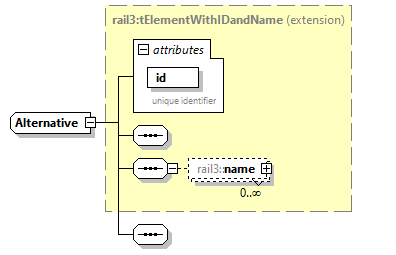 | ||||||||||||||
| namespace | https://www.railml.org/schemas/3.2 | ||||||||||||||
| type | extension of rail3:tElementWithIDandName | ||||||||||||||
| properties |
| ||||||||||||||
| children | rail3:name | ||||||||||||||
| used by |
| ||||||||||||||
| attributes |
| ||||||||||||||
| source | <xs:complexType name="Alternative"> <xs:complexContent> <xs:extension base="rail3:tElementWithIDandName"> <xs:sequence/> </xs:extension> </xs:complexContent> </xs:complexType> |
complexType Common
| diagram | 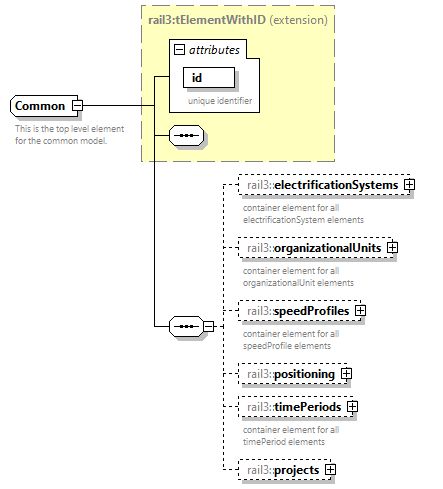 | ||||||||||||||
| namespace | https://www.railml.org/schemas/3.2 | ||||||||||||||
| type | extension of rail3:tElementWithID | ||||||||||||||
| properties |
| ||||||||||||||
| children | rail3:electrificationSystems rail3:organizationalUnits rail3:speedProfiles rail3:positioning rail3:timePeriods rail3:projects | ||||||||||||||
| used by |
| ||||||||||||||
| attributes |
| ||||||||||||||
| annotation |
| ||||||||||||||
| source | <xs:complexType name="Common"> <xs:annotation> <xs:documentation>This is the top level element for the common model.</xs:documentation> </xs:annotation> <xs:complexContent> <xs:extension base="rail3:tElementWithID"> <xs:sequence> <xs:element name="electrificationSystems" type="rail3:ElectrificationSystems" minOccurs="0" maxOccurs="1"> <xs:annotation> <xs:documentation>container element for all electrificationSystem elements</xs:documentation> </xs:annotation> </xs:element> <xs:element name="organizationalUnits" type="rail3:OrganizationalUnits" minOccurs="0" maxOccurs="1"> <xs:annotation> <xs:documentation>container element for all organizationalUnit elements</xs:documentation> </xs:annotation> </xs:element> <xs:element name="speedProfiles" type="rail3:SpeedProfiles" minOccurs="0" maxOccurs="1"> <xs:annotation> <xs:documentation>container element for all speedProfile elements</xs:documentation> </xs:annotation> </xs:element> <xs:element name="positioning" type="rail3:PositioningSystems" minOccurs="0" maxOccurs="1"/> <xs:element name="timePeriods" type="rail3:TimePeriods" minOccurs="0" maxOccurs="1"> <xs:annotation> <xs:documentation>container element for all timePeriod elements</xs:documentation> </xs:annotation> </xs:element> <xs:element name="projects" type="rail3:Projects" minOccurs="0" maxOccurs="1"/> </xs:sequence> </xs:extension> </xs:complexContent> </xs:complexType> |
element Common/electrificationSystems
| diagram | 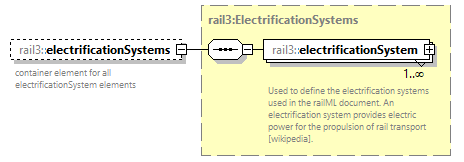 | ||||||
| namespace | https://www.railml.org/schemas/3.2 | ||||||
| type | rail3:ElectrificationSystems | ||||||
| properties |
| ||||||
| children | rail3:electrificationSystem | ||||||
| annotation |
| ||||||
| source | <xs:element name="electrificationSystems" type="rail3:ElectrificationSystems" minOccurs="0" maxOccurs="1"> <xs:annotation> <xs:documentation>container element for all electrificationSystem elements</xs:documentation> </xs:annotation> </xs:element> |
element Common/organizationalUnits
| diagram | 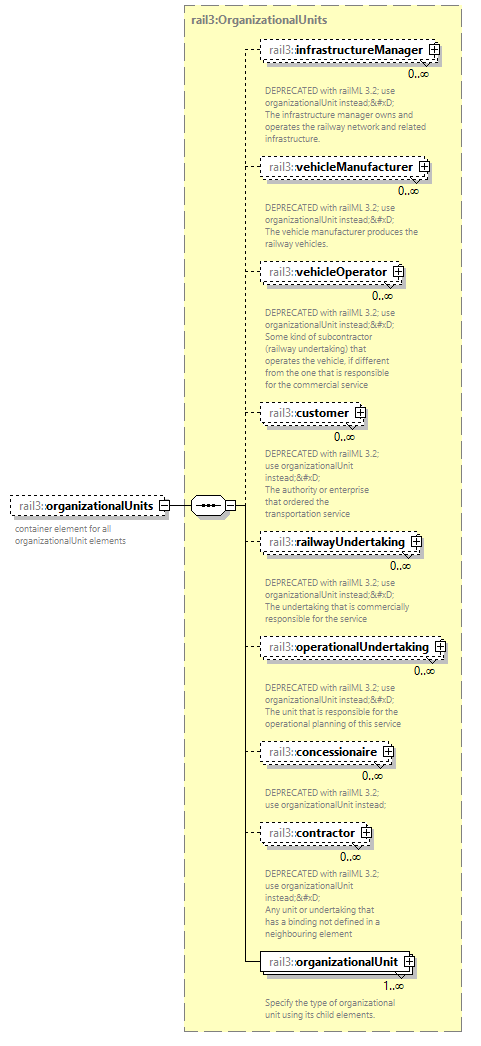 | ||||||
| namespace | https://www.railml.org/schemas/3.2 | ||||||
| type | rail3:OrganizationalUnits | ||||||
| properties |
| ||||||
| children | rail3:infrastructureManager rail3:vehicleManufacturer rail3:vehicleOperator rail3:customer rail3:railwayUndertaking rail3:operationalUndertaking rail3:concessionaire rail3:contractor rail3:organizationalUnit | ||||||
| annotation |
| ||||||
| source | <xs:element name="organizationalUnits" type="rail3:OrganizationalUnits" minOccurs="0" maxOccurs="1"> <xs:annotation> <xs:documentation>container element for all organizationalUnit elements</xs:documentation> </xs:annotation> </xs:element> |
element Common/speedProfiles
| diagram |  | ||||||
| namespace | https://www.railml.org/schemas/3.2 | ||||||
| type | rail3:SpeedProfiles | ||||||
| properties |
| ||||||
| children | rail3:speedProfile | ||||||
| annotation |
| ||||||
| source | <xs:element name="speedProfiles" type="rail3:SpeedProfiles" minOccurs="0" maxOccurs="1"> <xs:annotation> <xs:documentation>container element for all speedProfile elements</xs:documentation> </xs:annotation> </xs:element> |
element Common/positioning
| diagram | 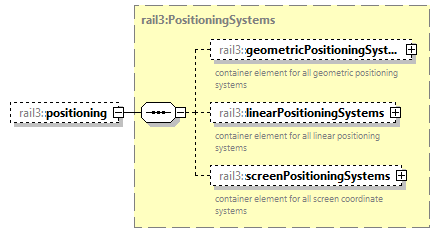 | ||||||
| namespace | https://www.railml.org/schemas/3.2 | ||||||
| type | rail3:PositioningSystems | ||||||
| properties |
| ||||||
| children | rail3:geometricPositioningSystems rail3:linearPositioningSystems rail3:screenPositioningSystems | ||||||
| source | <xs:element name="positioning" type="rail3:PositioningSystems" minOccurs="0" maxOccurs="1"/> |
element Common/timePeriods
| diagram | 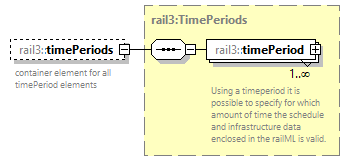 | ||||||
| namespace | https://www.railml.org/schemas/3.2 | ||||||
| type | rail3:TimePeriods | ||||||
| properties |
| ||||||
| children | rail3:timePeriod | ||||||
| annotation |
| ||||||
| source | <xs:element name="timePeriods" type="rail3:TimePeriods" minOccurs="0" maxOccurs="1"> <xs:annotation> <xs:documentation>container element for all timePeriod elements</xs:documentation> </xs:annotation> </xs:element> |
element Common/projects
| diagram | 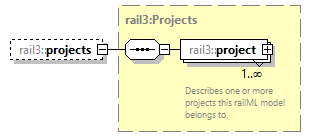 | ||||||
| namespace | https://www.railml.org/schemas/3.2 | ||||||
| type | rail3:Projects | ||||||
| properties |
| ||||||
| children | rail3:project | ||||||
| source | <xs:element name="projects" type="rail3:Projects" minOccurs="0" maxOccurs="1"/> |
complexType Concessionaire
| diagram |  | ||
| namespace | https://www.railml.org/schemas/3.2 | ||
| used by |
| ||
| source | <xs:complexType name="Concessionaire"> <xs:sequence/> </xs:complexType> |
complexType Contractor
| diagram |  | ||
| namespace | https://www.railml.org/schemas/3.2 | ||
| used by |
| ||
| source | <xs:complexType name="Contractor"> <xs:sequence/> </xs:complexType> |
complexType Customer
| diagram |  | ||
| namespace | https://www.railml.org/schemas/3.2 | ||
| used by |
| ||
| source | <xs:complexType name="Customer"> <xs:sequence/> </xs:complexType> |
complexType DoneBy
| diagram | 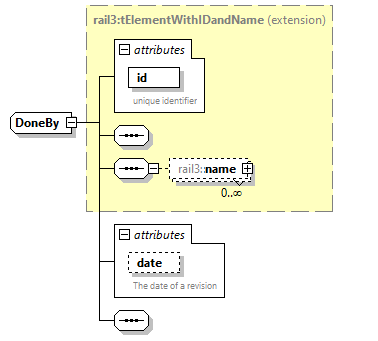 | ||||||||||||||||||||||
| namespace | https://www.railml.org/schemas/3.2 | ||||||||||||||||||||||
| type | extension of rail3:tElementWithIDandName | ||||||||||||||||||||||
| properties |
| ||||||||||||||||||||||
| children | rail3:name | ||||||||||||||||||||||
| used by |
| ||||||||||||||||||||||
| attributes |
| ||||||||||||||||||||||
| source | <xs:complexType name="DoneBy"> <xs:complexContent> <xs:extension base="rail3:tElementWithIDandName"> <xs:sequence/> <xs:attribute name="date" type="xs:date" use="optional"> <xs:annotation> <xs:documentation>The date of a revision</xs:documentation> </xs:annotation> </xs:attribute> </xs:extension> </xs:complexContent> </xs:complexType> |
attribute DoneBy/@date
| type | xs:date | ||
| properties |
| ||
| annotation |
| ||
| source | <xs:attribute name="date" type="xs:date" use="optional"> <xs:annotation> <xs:documentation>The date of a revision</xs:documentation> </xs:annotation> </xs:attribute> |
complexType ElectrificationSystem
| diagram | 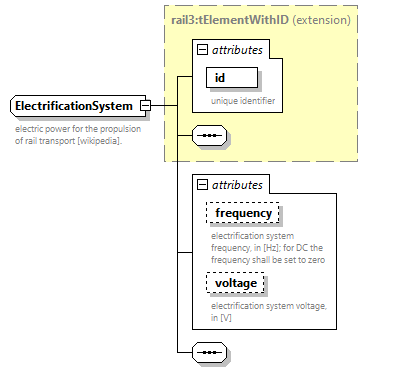 | ||||||||||||||||||||||||||||||
| namespace | https://www.railml.org/schemas/3.2 | ||||||||||||||||||||||||||||||
| type | extension of rail3:tElementWithID | ||||||||||||||||||||||||||||||
| properties |
| ||||||||||||||||||||||||||||||
| used by |
| ||||||||||||||||||||||||||||||
| attributes |
| ||||||||||||||||||||||||||||||
| annotation |
| ||||||||||||||||||||||||||||||
| source | <xs:complexType name="ElectrificationSystem"> <xs:annotation> <xs:documentation>electric power for the propulsion of rail transport [wikipedia].</xs:documentation> </xs:annotation> <xs:complexContent> <xs:extension base="rail3:tElementWithID"> <xs:sequence/> <xs:attribute name="frequency" type="rail3:tFrequencyHertz" use="optional"> <xs:annotation> <xs:documentation>electrification system frequency, in [Hz]; for DC the frequency shall be set to zero</xs:documentation> </xs:annotation> </xs:attribute> <xs:attribute name="voltage" type="rail3:tVoltageVolt" use="optional"> <xs:annotation> <xs:documentation>electrification system voltage, in [V]</xs:documentation> </xs:annotation> </xs:attribute> </xs:extension> </xs:complexContent> </xs:complexType> |
attribute ElectrificationSystem/@frequency
| type | rail3:tFrequencyHertz | |||||||||
| properties |
| |||||||||
| facets |
| |||||||||
| annotation |
| |||||||||
| source | <xs:attribute name="frequency" type="rail3:tFrequencyHertz" use="optional"> <xs:annotation> <xs:documentation>electrification system frequency, in [Hz]; for DC the frequency shall be set to zero</xs:documentation> </xs:annotation> </xs:attribute> |
attribute ElectrificationSystem/@voltage
| type | rail3:tVoltageVolt | ||||||
| properties |
| ||||||
| facets |
| ||||||
| annotation |
| ||||||
| source | <xs:attribute name="voltage" type="rail3:tVoltageVolt" use="optional"> <xs:annotation> <xs:documentation>electrification system voltage, in [V]</xs:documentation> </xs:annotation> </xs:attribute> |
complexType ElectrificationSystems
| diagram |  | ||
| namespace | https://www.railml.org/schemas/3.2 | ||
| children | rail3:electrificationSystem | ||
| used by |
| ||
| source | <xs:complexType name="ElectrificationSystems"> <xs:sequence> <xs:element name="electrificationSystem" type="rail3:ElectrificationSystem" minOccurs="1" maxOccurs="unbounded"> <xs:annotation> <xs:documentation>Used to define the electrification systems used in the railML document. An electrification system provides electric power for the propulsion of rail transport [wikipedia].</xs:documentation> </xs:annotation> </xs:element> </xs:sequence> </xs:complexType> |
element ElectrificationSystems/electrificationSystem
| diagram | 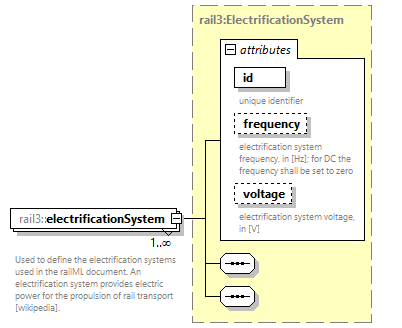 | ||||||||||||||||||||||||||||||
| namespace | https://www.railml.org/schemas/3.2 | ||||||||||||||||||||||||||||||
| type | rail3:ElectrificationSystem | ||||||||||||||||||||||||||||||
| properties |
| ||||||||||||||||||||||||||||||
| attributes |
| ||||||||||||||||||||||||||||||
| annotation |
| ||||||||||||||||||||||||||||||
| source | <xs:element name="electrificationSystem" type="rail3:ElectrificationSystem" minOccurs="1" maxOccurs="unbounded"> <xs:annotation> <xs:documentation>Used to define the electrification systems used in the railML document. An electrification system provides electric power for the propulsion of rail transport [wikipedia].</xs:documentation> </xs:annotation> </xs:element> |
complexType GeometricPositioningSystems
| diagram |  | ||
| namespace | https://www.railml.org/schemas/3.2 | ||
| children | rail3:geometricPositioningSystem | ||
| used by |
| ||
| source | <xs:complexType name="GeometricPositioningSystems"> <xs:sequence> <xs:element name="geometricPositioningSystem" type="rail3:RTM_GeometricPositioningSystem" minOccurs="1" maxOccurs="unbounded"/> </xs:sequence> </xs:complexType> |
element GeometricPositioningSystems/geometricPositioningSystem
| diagram | 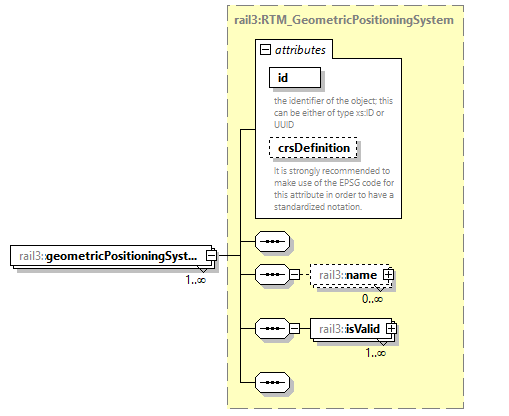 | ||||||||||||||||||||||
| namespace | https://www.railml.org/schemas/3.2 | ||||||||||||||||||||||
| type | rail3:RTM_GeometricPositioningSystem | ||||||||||||||||||||||
| properties |
| ||||||||||||||||||||||
| children | rail3:name rail3:isValid | ||||||||||||||||||||||
| attributes |
| ||||||||||||||||||||||
| source | <xs:element name="geometricPositioningSystem" type="rail3:RTM_GeometricPositioningSystem" minOccurs="1" maxOccurs="unbounded"/> |
complexType Holiday
| diagram | 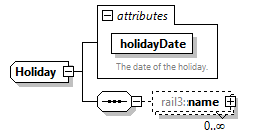 | ||||||||||||||
| namespace | https://www.railml.org/schemas/3.2 | ||||||||||||||
| children | rail3:name | ||||||||||||||
| used by |
| ||||||||||||||
| attributes |
| ||||||||||||||
| source | <xs:complexType name="Holiday"> <xs:sequence> <xs:element name="name" type="rail3:Name" minOccurs="0" maxOccurs="unbounded"/> </xs:sequence> <xs:attribute name="holidayDate" type="xs:date" use="required"> <xs:annotation> <xs:documentation>The date of the holiday. </xs:documentation> </xs:annotation> </xs:attribute> </xs:complexType> |
attribute Holiday/@holidayDate
| type | xs:date | ||
| properties |
| ||
| annotation |
| ||
| source | <xs:attribute name="holidayDate" type="xs:date" use="required"> <xs:annotation> <xs:documentation>The date of the holiday. </xs:documentation> </xs:annotation> </xs:attribute> |
element Holiday/name
| diagram | 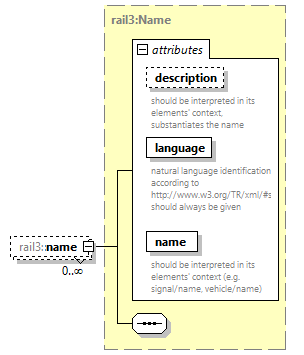 | ||||||||||||||||||||||||||||||
| namespace | https://www.railml.org/schemas/3.2 | ||||||||||||||||||||||||||||||
| type | rail3:Name | ||||||||||||||||||||||||||||||
| properties |
| ||||||||||||||||||||||||||||||
| attributes |
| ||||||||||||||||||||||||||||||
| source | <xs:element name="name" type="rail3:Name" minOccurs="0" maxOccurs="unbounded"/> |
complexType Holidays
| diagram | 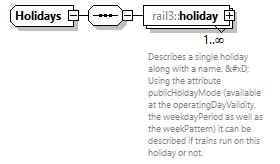 | ||
| namespace | https://www.railml.org/schemas/3.2 | ||
| children | rail3:holiday | ||
| used by |
| ||
| source | <xs:complexType name="Holidays"> <xs:sequence> <xs:element name="holiday" type="rail3:Holiday" minOccurs="1" maxOccurs="unbounded"> <xs:annotation> <xs:documentation>Describes a single holiday along with a name. 
 Using the attribute publicHoldayMode (available at the operatingDayValidity, the weekdayPeriod as well as the weekPattern) it can be described if trains run on this holiday or not.</xs:documentation> </xs:annotation> </xs:element> </xs:sequence> </xs:complexType> |
element Holidays/holiday
| diagram | 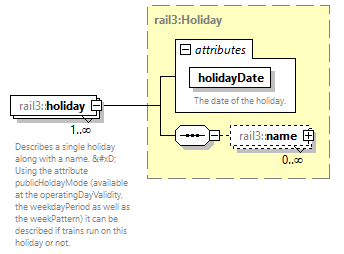 | ||||||||||||||
| namespace | https://www.railml.org/schemas/3.2 | ||||||||||||||
| type | rail3:Holiday | ||||||||||||||
| properties |
| ||||||||||||||
| children | rail3:name | ||||||||||||||
| attributes |
| ||||||||||||||
| annotation |
| ||||||||||||||
| source | <xs:element name="holiday" type="rail3:Holiday" minOccurs="1" maxOccurs="unbounded"> <xs:annotation> <xs:documentation>Describes a single holiday along with a name. 
 Using the attribute publicHoldayMode (available at the operatingDayValidity, the weekdayPeriod as well as the weekPattern) it can be described if trains run on this holiday or not.</xs:documentation> </xs:annotation> </xs:element> |
complexType InfrastructureManager
| diagram |  | ||
| namespace | https://www.railml.org/schemas/3.2 | ||
| used by |
| ||
| source | <xs:complexType name="InfrastructureManager"> <xs:sequence/> </xs:complexType> |
complexType LinearPositioningSystems
| diagram |  | ||
| namespace | https://www.railml.org/schemas/3.2 | ||
| children | rail3:linearPositioningSystem | ||
| used by |
| ||
| source | <xs:complexType name="LinearPositioningSystems"> <xs:sequence> <xs:element name="linearPositioningSystem" type="rail3:RTM_LinearPositioningSystem" minOccurs="1" maxOccurs="unbounded"/> </xs:sequence> </xs:complexType> |
element LinearPositioningSystems/linearPositioningSystem
| diagram | 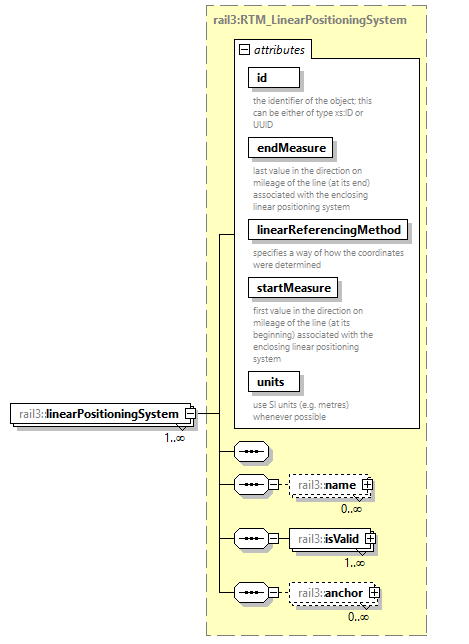 | ||||||||||||||||||||||||||||||||||||||||||||||
| namespace | https://www.railml.org/schemas/3.2 | ||||||||||||||||||||||||||||||||||||||||||||||
| type | rail3:RTM_LinearPositioningSystem | ||||||||||||||||||||||||||||||||||||||||||||||
| properties |
| ||||||||||||||||||||||||||||||||||||||||||||||
| children | rail3:name rail3:isValid rail3:anchor | ||||||||||||||||||||||||||||||||||||||||||||||
| attributes |
| ||||||||||||||||||||||||||||||||||||||||||||||
| source | <xs:element name="linearPositioningSystem" type="rail3:RTM_LinearPositioningSystem" minOccurs="1" maxOccurs="unbounded"/> |
complexType Metadata
| diagram | 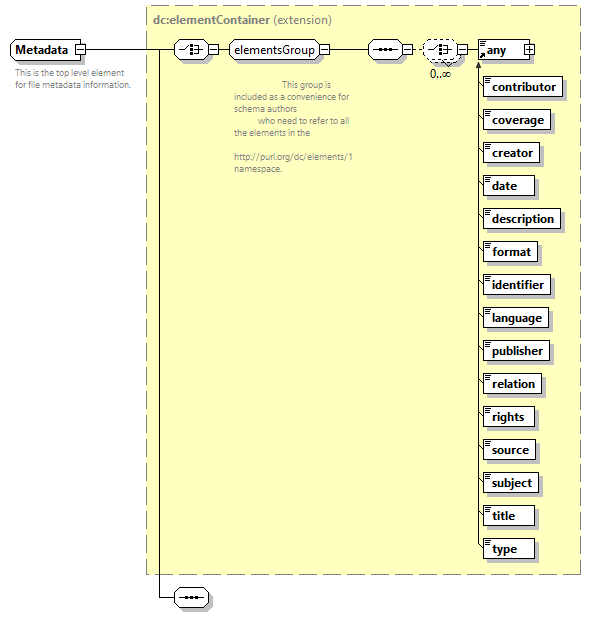 | ||
| namespace | https://www.railml.org/schemas/3.2 | ||
| type | extension of elementContainer | ||
| properties |
| ||
| children | any | ||
| used by |
| ||
| annotation |
| ||
| source | <xs:complexType name="Metadata"> <xs:annotation> <xs:documentation>This is the top level element for file metadata information.</xs:documentation> </xs:annotation> <xs:complexContent> <xs:extension base="dc:elementContainer"> <xs:sequence/> </xs:extension> </xs:complexContent> </xs:complexType> |
complexType ObjectsRevised
| diagram |  | ||
| namespace | https://www.railml.org/schemas/3.2 | ||
| children | rail3:objectRevised | ||
| used by |
| ||
| source | <xs:complexType name="ObjectsRevised"> <xs:sequence> <xs:element name="objectRevised" type="rail3:tElementWithIDref" minOccurs="1" maxOccurs="unbounded"> <xs:annotation> <xs:documentation>Reference to an object that was changed in this revision.</xs:documentation> </xs:annotation> </xs:element> </xs:sequence> </xs:complexType> |
element ObjectsRevised/objectRevised
| diagram | 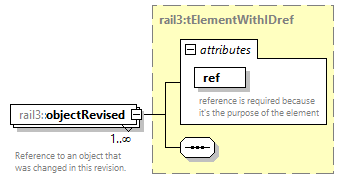 | ||||||||||||||
| namespace | https://www.railml.org/schemas/3.2 | ||||||||||||||
| type | rail3:tElementWithIDref | ||||||||||||||
| properties |
| ||||||||||||||
| attributes |
| ||||||||||||||
| annotation |
| ||||||||||||||
| source | <xs:element name="objectRevised" type="rail3:tElementWithIDref" minOccurs="1" maxOccurs="unbounded"> <xs:annotation> <xs:documentation>Reference to an object that was changed in this revision.</xs:documentation> </xs:annotation> </xs:element> |
complexType OperationalUndertaking
| diagram |  | ||
| namespace | https://www.railml.org/schemas/3.2 | ||
| used by |
| ||
| source | <xs:complexType name="OperationalUndertaking"> <xs:sequence/> </xs:complexType> |
complexType OrganizationalUnit
| diagram | 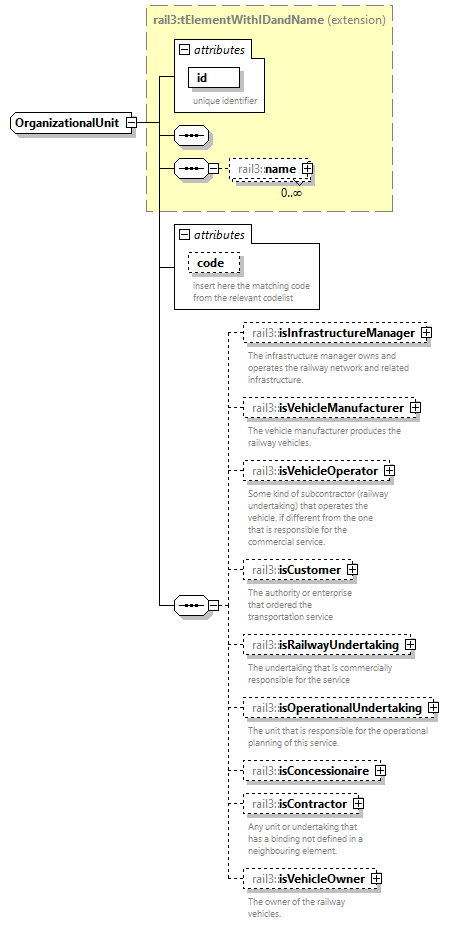 | ||||||||||||||||||||||
| namespace | https://www.railml.org/schemas/3.2 | ||||||||||||||||||||||
| type | extension of rail3:tElementWithIDandName | ||||||||||||||||||||||
| properties |
| ||||||||||||||||||||||
| children | rail3:name rail3:isInfrastructureManager rail3:isVehicleManufacturer rail3:isVehicleOperator rail3:isCustomer rail3:isRailwayUndertaking rail3:isOperationalUndertaking rail3:isConcessionaire rail3:isContractor rail3:isVehicleOwner | ||||||||||||||||||||||
| used by |
| ||||||||||||||||||||||
| attributes |
| ||||||||||||||||||||||
| source | <xs:complexType name="OrganizationalUnit"> <xs:complexContent> <xs:extension base="rail3:tElementWithIDandName"> <xs:sequence> <xs:element name="isInfrastructureManager" type="rail3:InfrastructureManager" minOccurs="0" maxOccurs="1"> <xs:annotation> <xs:documentation>The infrastructure manager owns and operates the railway network and related infrastructure.</xs:documentation> </xs:annotation> </xs:element> <xs:element name="isVehicleManufacturer" type="rail3:VehicleManufacturer" minOccurs="0" maxOccurs="1"> <xs:annotation> <xs:documentation>The vehicle manufacturer produces the railway vehicles.</xs:documentation> </xs:annotation> </xs:element> <xs:element name="isVehicleOperator" type="rail3:VehicleOperator" minOccurs="0" maxOccurs="1"> <xs:annotation> <xs:documentation>Some kind of subcontractor (railway undertaking) that operates the vehicle, if different from the one that is responsible for the commercial service.</xs:documentation> </xs:annotation> </xs:element> <xs:element name="isCustomer" type="rail3:Customer" minOccurs="0" maxOccurs="1"> <xs:annotation> <xs:documentation>The authority or enterprise that ordered the transportation service</xs:documentation> </xs:annotation> </xs:element> <xs:element name="isRailwayUndertaking" type="rail3:RailwayUndertaking" minOccurs="0" maxOccurs="1"> <xs:annotation> <xs:documentation>The undertaking that is commercially responsible for the service</xs:documentation> </xs:annotation> </xs:element> <xs:element name="isOperationalUndertaking" type="rail3:OperationalUndertaking" minOccurs="0" maxOccurs="1"> <xs:annotation> <xs:documentation>The unit that is responsible for the operational planning of this service.</xs:documentation> </xs:annotation> </xs:element> <xs:element name="isConcessionaire" type="rail3:Concessionaire" minOccurs="0" maxOccurs="1"/> <xs:element name="isContractor" type="rail3:Contractor" minOccurs="0" maxOccurs="1"> <xs:annotation> <xs:documentation>Any unit or undertaking that has a binding not defined in a neighbouring element.</xs:documentation> </xs:annotation> </xs:element> <xs:element name="isVehicleOwner" type="rail3:VehicleOwner" minOccurs="0" maxOccurs="1"> <xs:annotation> <xs:documentation>The owner of the railway vehicles.</xs:documentation> </xs:annotation> </xs:element> </xs:sequence> <xs:attribute name="code" type="xs:string" use="optional"> <xs:annotation> <xs:documentation>insert here the matching code from the relevant codelist</xs:documentation> </xs:annotation> </xs:attribute> </xs:extension> </xs:complexContent> </xs:complexType> |
attribute OrganizationalUnit/@code
| type | xs:string | ||
| properties |
| ||
| annotation |
| ||
| source | <xs:attribute name="code" type="xs:string" use="optional"> <xs:annotation> <xs:documentation>insert here the matching code from the relevant codelist</xs:documentation> </xs:annotation> </xs:attribute> |
element OrganizationalUnit/isInfrastructureManager
| diagram |  | ||||||
| namespace | https://www.railml.org/schemas/3.2 | ||||||
| type | rail3:InfrastructureManager | ||||||
| properties |
| ||||||
| annotation |
| ||||||
| source | <xs:element name="isInfrastructureManager" type="rail3:InfrastructureManager" minOccurs="0" maxOccurs="1"> <xs:annotation> <xs:documentation>The infrastructure manager owns and operates the railway network and related infrastructure.</xs:documentation> </xs:annotation> </xs:element> |
element OrganizationalUnit/isVehicleManufacturer
| diagram |  | ||||||
| namespace | https://www.railml.org/schemas/3.2 | ||||||
| type | rail3:VehicleManufacturer | ||||||
| properties |
| ||||||
| annotation |
| ||||||
| source | <xs:element name="isVehicleManufacturer" type="rail3:VehicleManufacturer" minOccurs="0" maxOccurs="1"> <xs:annotation> <xs:documentation>The vehicle manufacturer produces the railway vehicles.</xs:documentation> </xs:annotation> </xs:element> |
element OrganizationalUnit/isVehicleOperator
| diagram | 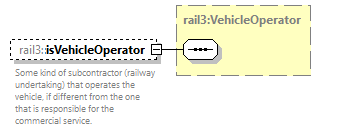 | ||||||
| namespace | https://www.railml.org/schemas/3.2 | ||||||
| type | rail3:VehicleOperator | ||||||
| properties |
| ||||||
| annotation |
| ||||||
| source | <xs:element name="isVehicleOperator" type="rail3:VehicleOperator" minOccurs="0" maxOccurs="1"> <xs:annotation> <xs:documentation>Some kind of subcontractor (railway undertaking) that operates the vehicle, if different from the one that is responsible for the commercial service.</xs:documentation> </xs:annotation> </xs:element> |
element OrganizationalUnit/isCustomer
| diagram | 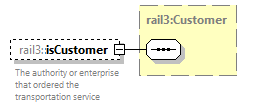 | ||||||
| namespace | https://www.railml.org/schemas/3.2 | ||||||
| type | rail3:Customer | ||||||
| properties |
| ||||||
| annotation |
| ||||||
| source | <xs:element name="isCustomer" type="rail3:Customer" minOccurs="0" maxOccurs="1"> <xs:annotation> <xs:documentation>The authority or enterprise that ordered the transportation service</xs:documentation> </xs:annotation> </xs:element> |
element OrganizationalUnit/isRailwayUndertaking
| diagram |  | ||||||
| namespace | https://www.railml.org/schemas/3.2 | ||||||
| type | rail3:RailwayUndertaking | ||||||
| properties |
| ||||||
| annotation |
| ||||||
| source | <xs:element name="isRailwayUndertaking" type="rail3:RailwayUndertaking" minOccurs="0" maxOccurs="1"> <xs:annotation> <xs:documentation>The undertaking that is commercially responsible for the service</xs:documentation> </xs:annotation> </xs:element> |
element OrganizationalUnit/isOperationalUndertaking
| diagram |  | ||||||
| namespace | https://www.railml.org/schemas/3.2 | ||||||
| type | rail3:OperationalUndertaking | ||||||
| properties |
| ||||||
| annotation |
| ||||||
| source | <xs:element name="isOperationalUndertaking" type="rail3:OperationalUndertaking" minOccurs="0" maxOccurs="1"> <xs:annotation> <xs:documentation>The unit that is responsible for the operational planning of this service.</xs:documentation> </xs:annotation> </xs:element> |
element OrganizationalUnit/isConcessionaire
| diagram |  | ||||||
| namespace | https://www.railml.org/schemas/3.2 | ||||||
| type | rail3:Concessionaire | ||||||
| properties |
| ||||||
| source | <xs:element name="isConcessionaire" type="rail3:Concessionaire" minOccurs="0" maxOccurs="1"/> |
element OrganizationalUnit/isContractor
| diagram | 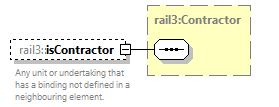 | ||||||
| namespace | https://www.railml.org/schemas/3.2 | ||||||
| type | rail3:Contractor | ||||||
| properties |
| ||||||
| annotation |
| ||||||
| source | <xs:element name="isContractor" type="rail3:Contractor" minOccurs="0" maxOccurs="1"> <xs:annotation> <xs:documentation>Any unit or undertaking that has a binding not defined in a neighbouring element.</xs:documentation> </xs:annotation> </xs:element> |
element OrganizationalUnit/isVehicleOwner
| diagram |  | ||||||
| namespace | https://www.railml.org/schemas/3.2 | ||||||
| type | rail3:VehicleOwner | ||||||
| properties |
| ||||||
| annotation |
| ||||||
| source | <xs:element name="isVehicleOwner" type="rail3:VehicleOwner" minOccurs="0" maxOccurs="1"> <xs:annotation> <xs:documentation>The owner of the railway vehicles.</xs:documentation> </xs:annotation> </xs:element> |
complexType OrganizationalUnits
| diagram | 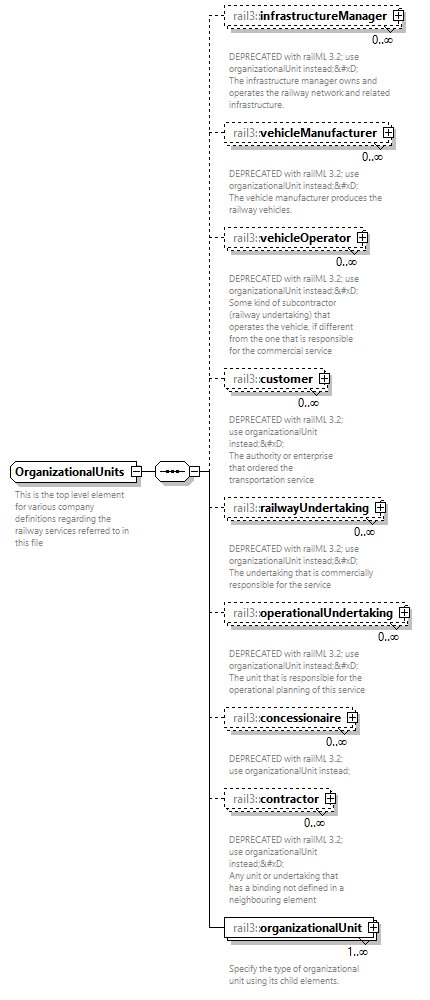 | ||
| namespace | https://www.railml.org/schemas/3.2 | ||
| children | rail3:infrastructureManager rail3:vehicleManufacturer rail3:vehicleOperator rail3:customer rail3:railwayUndertaking rail3:operationalUndertaking rail3:concessionaire rail3:contractor rail3:organizationalUnit | ||
| used by |
| ||
| annotation |
| ||
| source | <xs:complexType name="OrganizationalUnits"> <xs:annotation> <xs:documentation>This is the top level element for various company definitions regarding the railway services referred to in this file</xs:documentation> </xs:annotation> <xs:sequence> <xs:element name="infrastructureManager" type="rail3:OrganizationalUnit" minOccurs="0" maxOccurs="unbounded"> <xs:annotation> <xs:documentation>DEPRECATED with railML 3.2; use organizationalUnit instead;
 The infrastructure manager owns and operates the railway network and related infrastructure.</xs:documentation> </xs:annotation> </xs:element> <xs:element name="vehicleManufacturer" type="rail3:OrganizationalUnit" minOccurs="0" maxOccurs="unbounded"> <xs:annotation> <xs:documentation>DEPRECATED with railML 3.2; use organizationalUnit instead;
 The vehicle manufacturer produces the railway vehicles.</xs:documentation> </xs:annotation> </xs:element> <xs:element name="vehicleOperator" type="rail3:OrganizationalUnit" minOccurs="0" maxOccurs="unbounded"> <xs:annotation> <xs:documentation>DEPRECATED with railML 3.2; use organizationalUnit instead;
 Some kind of subcontractor (railway undertaking) that operates the vehicle, if different from the one that is responsible for the commercial service</xs:documentation> </xs:annotation> </xs:element> <xs:element name="customer" type="rail3:OrganizationalUnit" minOccurs="0" maxOccurs="unbounded"> <xs:annotation> <xs:documentation>DEPRECATED with railML 3.2; use organizationalUnit instead;
 The authority or enterprise that ordered the transportation service</xs:documentation> </xs:annotation> </xs:element> <xs:element name="railwayUndertaking" type="rail3:OrganizationalUnit" minOccurs="0" maxOccurs="unbounded"> <xs:annotation> <xs:documentation>DEPRECATED with railML 3.2; use organizationalUnit instead;
 The undertaking that is commercially responsible for the service</xs:documentation> </xs:annotation> </xs:element> <xs:element name="operationalUndertaking" type="rail3:OrganizationalUnit" minOccurs="0" maxOccurs="unbounded"> <xs:annotation> <xs:documentation>DEPRECATED with railML 3.2; use organizationalUnit instead;
 The unit that is responsible for the operational planning of this service</xs:documentation> </xs:annotation> </xs:element> <xs:element name="concessionaire" type="rail3:OrganizationalUnit" minOccurs="0" maxOccurs="unbounded"> <xs:annotation> <xs:documentation>DEPRECATED with railML 3.2; use organizationalUnit instead;</xs:documentation> </xs:annotation> </xs:element> <xs:element name="contractor" type="rail3:OrganizationalUnit" minOccurs="0" maxOccurs="unbounded"> <xs:annotation> <xs:documentation>DEPRECATED with railML 3.2; use organizationalUnit instead;
 Any unit or undertaking that has a binding not defined in a neighbouring element</xs:documentation> </xs:annotation> </xs:element> <xs:element name="organizationalUnit" type="rail3:OrganizationalUnit" minOccurs="1" maxOccurs="unbounded"> <xs:annotation> <xs:documentation>Specify the type of organizational unit using its child elements.</xs:documentation> </xs:annotation> </xs:element> </xs:sequence> </xs:complexType> |
element OrganizationalUnits/infrastructureManager
| diagram | 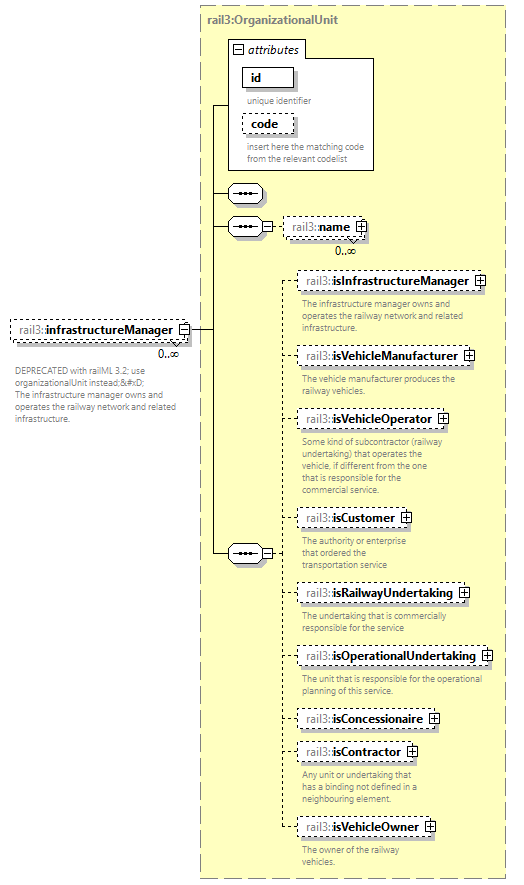 | ||||||||||||||||||||||
| namespace | https://www.railml.org/schemas/3.2 | ||||||||||||||||||||||
| type | rail3:OrganizationalUnit | ||||||||||||||||||||||
| properties |
| ||||||||||||||||||||||
| children | rail3:name rail3:isInfrastructureManager rail3:isVehicleManufacturer rail3:isVehicleOperator rail3:isCustomer rail3:isRailwayUndertaking rail3:isOperationalUndertaking rail3:isConcessionaire rail3:isContractor rail3:isVehicleOwner | ||||||||||||||||||||||
| attributes |
| ||||||||||||||||||||||
| annotation |
| ||||||||||||||||||||||
| source | <xs:element name="infrastructureManager" type="rail3:OrganizationalUnit" minOccurs="0" maxOccurs="unbounded"> <xs:annotation> <xs:documentation>DEPRECATED with railML 3.2; use organizationalUnit instead;
 The infrastructure manager owns and operates the railway network and related infrastructure.</xs:documentation> </xs:annotation> </xs:element> |
element OrganizationalUnits/vehicleManufacturer
| diagram | 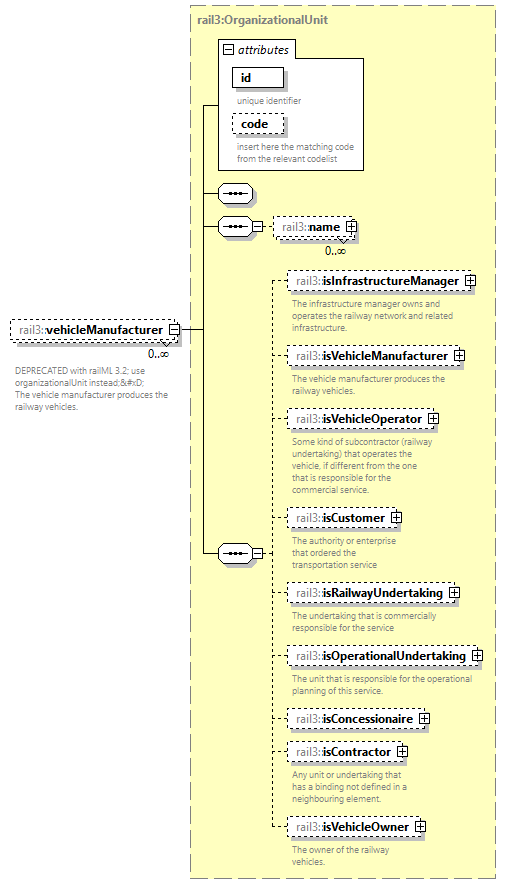 | ||||||||||||||||||||||
| namespace | https://www.railml.org/schemas/3.2 | ||||||||||||||||||||||
| type | rail3:OrganizationalUnit | ||||||||||||||||||||||
| properties |
| ||||||||||||||||||||||
| children | rail3:name rail3:isInfrastructureManager rail3:isVehicleManufacturer rail3:isVehicleOperator rail3:isCustomer rail3:isRailwayUndertaking rail3:isOperationalUndertaking rail3:isConcessionaire rail3:isContractor rail3:isVehicleOwner | ||||||||||||||||||||||
| attributes |
| ||||||||||||||||||||||
| annotation |
| ||||||||||||||||||||||
| source | <xs:element name="vehicleManufacturer" type="rail3:OrganizationalUnit" minOccurs="0" maxOccurs="unbounded"> <xs:annotation> <xs:documentation>DEPRECATED with railML 3.2; use organizationalUnit instead;
 The vehicle manufacturer produces the railway vehicles.</xs:documentation> </xs:annotation> </xs:element> |
element OrganizationalUnits/vehicleOperator
| diagram | 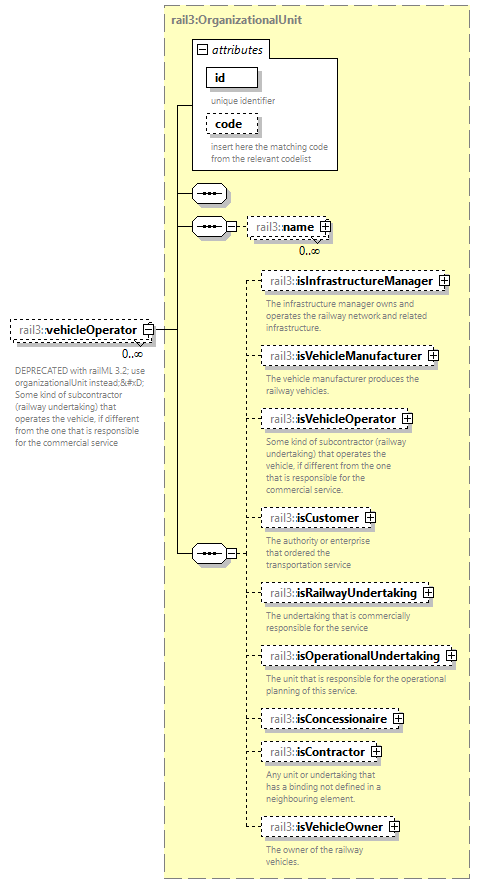 | ||||||||||||||||||||||
| namespace | https://www.railml.org/schemas/3.2 | ||||||||||||||||||||||
| type | rail3:OrganizationalUnit | ||||||||||||||||||||||
| properties |
| ||||||||||||||||||||||
| children | rail3:name rail3:isInfrastructureManager rail3:isVehicleManufacturer rail3:isVehicleOperator rail3:isCustomer rail3:isRailwayUndertaking rail3:isOperationalUndertaking rail3:isConcessionaire rail3:isContractor rail3:isVehicleOwner | ||||||||||||||||||||||
| attributes |
| ||||||||||||||||||||||
| annotation |
| ||||||||||||||||||||||
| source | <xs:element name="vehicleOperator" type="rail3:OrganizationalUnit" minOccurs="0" maxOccurs="unbounded"> <xs:annotation> <xs:documentation>DEPRECATED with railML 3.2; use organizationalUnit instead;
 Some kind of subcontractor (railway undertaking) that operates the vehicle, if different from the one that is responsible for the commercial service</xs:documentation> </xs:annotation> </xs:element> |
element OrganizationalUnits/customer
| diagram | 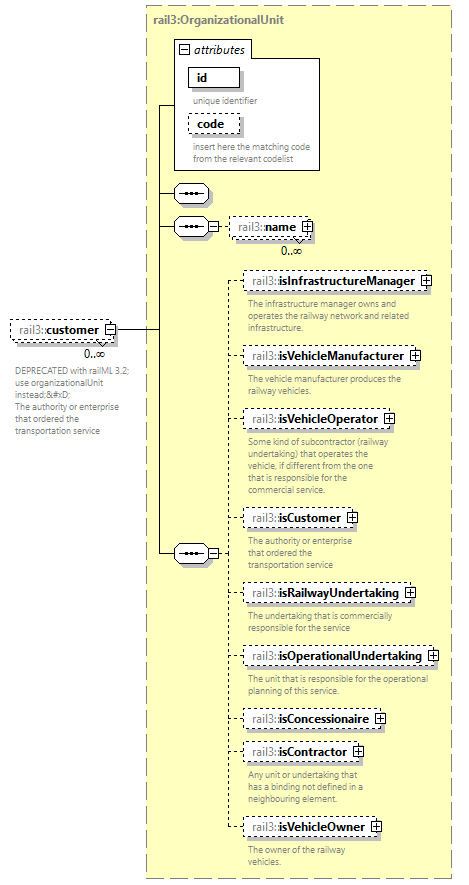 | ||||||||||||||||||||||
| namespace | https://www.railml.org/schemas/3.2 | ||||||||||||||||||||||
| type | rail3:OrganizationalUnit | ||||||||||||||||||||||
| properties |
| ||||||||||||||||||||||
| children | rail3:name rail3:isInfrastructureManager rail3:isVehicleManufacturer rail3:isVehicleOperator rail3:isCustomer rail3:isRailwayUndertaking rail3:isOperationalUndertaking rail3:isConcessionaire rail3:isContractor rail3:isVehicleOwner | ||||||||||||||||||||||
| attributes |
| ||||||||||||||||||||||
| annotation |
| ||||||||||||||||||||||
| source | <xs:element name="customer" type="rail3:OrganizationalUnit" minOccurs="0" maxOccurs="unbounded"> <xs:annotation> <xs:documentation>DEPRECATED with railML 3.2; use organizationalUnit instead;
 The authority or enterprise that ordered the transportation service</xs:documentation> </xs:annotation> </xs:element> |
element OrganizationalUnits/railwayUndertaking
| diagram | 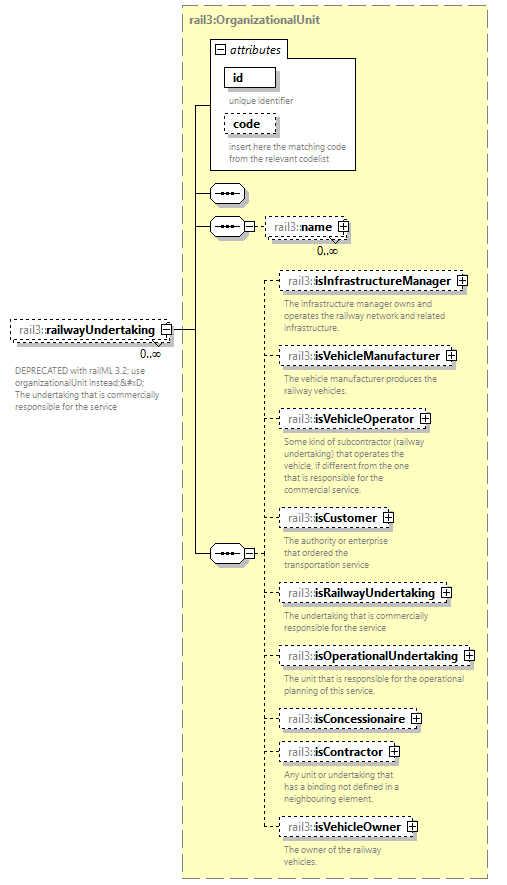 | ||||||||||||||||||||||
| namespace | https://www.railml.org/schemas/3.2 | ||||||||||||||||||||||
| type | rail3:OrganizationalUnit | ||||||||||||||||||||||
| properties |
| ||||||||||||||||||||||
| children | rail3:name rail3:isInfrastructureManager rail3:isVehicleManufacturer rail3:isVehicleOperator rail3:isCustomer rail3:isRailwayUndertaking rail3:isOperationalUndertaking rail3:isConcessionaire rail3:isContractor rail3:isVehicleOwner | ||||||||||||||||||||||
| attributes |
| ||||||||||||||||||||||
| annotation |
| ||||||||||||||||||||||
| source | <xs:element name="railwayUndertaking" type="rail3:OrganizationalUnit" minOccurs="0" maxOccurs="unbounded"> <xs:annotation> <xs:documentation>DEPRECATED with railML 3.2; use organizationalUnit instead;
 The undertaking that is commercially responsible for the service</xs:documentation> </xs:annotation> </xs:element> |
element OrganizationalUnits/operationalUndertaking
| diagram | 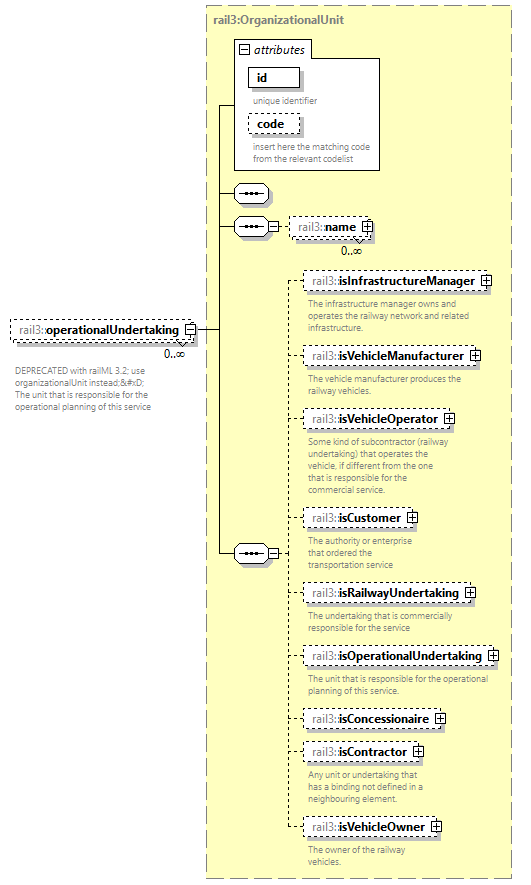 | ||||||||||||||||||||||
| namespace | https://www.railml.org/schemas/3.2 | ||||||||||||||||||||||
| type | rail3:OrganizationalUnit | ||||||||||||||||||||||
| properties |
| ||||||||||||||||||||||
| children | rail3:name rail3:isInfrastructureManager rail3:isVehicleManufacturer rail3:isVehicleOperator rail3:isCustomer rail3:isRailwayUndertaking rail3:isOperationalUndertaking rail3:isConcessionaire rail3:isContractor rail3:isVehicleOwner | ||||||||||||||||||||||
| attributes |
| ||||||||||||||||||||||
| annotation |
| ||||||||||||||||||||||
| source | <xs:element name="operationalUndertaking" type="rail3:OrganizationalUnit" minOccurs="0" maxOccurs="unbounded"> <xs:annotation> <xs:documentation>DEPRECATED with railML 3.2; use organizationalUnit instead;
 The unit that is responsible for the operational planning of this service</xs:documentation> </xs:annotation> </xs:element> |
element OrganizationalUnits/concessionaire
| diagram | 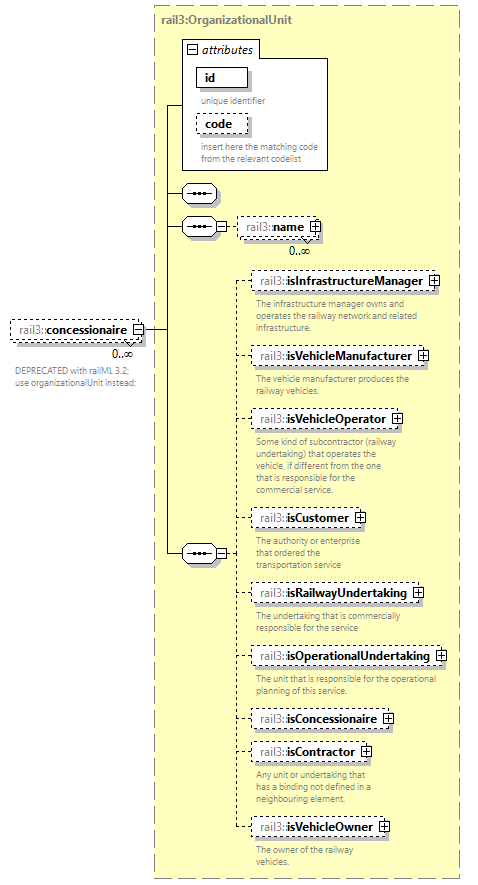 | ||||||||||||||||||||||
| namespace | https://www.railml.org/schemas/3.2 | ||||||||||||||||||||||
| type | rail3:OrganizationalUnit | ||||||||||||||||||||||
| properties |
| ||||||||||||||||||||||
| children | rail3:name rail3:isInfrastructureManager rail3:isVehicleManufacturer rail3:isVehicleOperator rail3:isCustomer rail3:isRailwayUndertaking rail3:isOperationalUndertaking rail3:isConcessionaire rail3:isContractor rail3:isVehicleOwner | ||||||||||||||||||||||
| attributes |
| ||||||||||||||||||||||
| annotation |
| ||||||||||||||||||||||
| source | <xs:element name="concessionaire" type="rail3:OrganizationalUnit" minOccurs="0" maxOccurs="unbounded"> <xs:annotation> <xs:documentation>DEPRECATED with railML 3.2; use organizationalUnit instead;</xs:documentation> </xs:annotation> </xs:element> |
element OrganizationalUnits/contractor
| diagram | 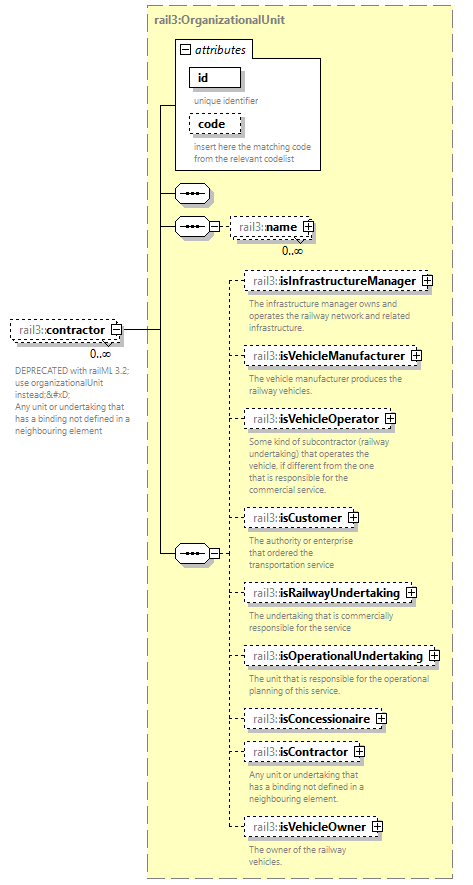 | ||||||||||||||||||||||
| namespace | https://www.railml.org/schemas/3.2 | ||||||||||||||||||||||
| type | rail3:OrganizationalUnit | ||||||||||||||||||||||
| properties |
| ||||||||||||||||||||||
| children | rail3:name rail3:isInfrastructureManager rail3:isVehicleManufacturer rail3:isVehicleOperator rail3:isCustomer rail3:isRailwayUndertaking rail3:isOperationalUndertaking rail3:isConcessionaire rail3:isContractor rail3:isVehicleOwner | ||||||||||||||||||||||
| attributes |
| ||||||||||||||||||||||
| annotation |
| ||||||||||||||||||||||
| source | <xs:element name="contractor" type="rail3:OrganizationalUnit" minOccurs="0" maxOccurs="unbounded"> <xs:annotation> <xs:documentation>DEPRECATED with railML 3.2; use organizationalUnit instead;
 Any unit or undertaking that has a binding not defined in a neighbouring element</xs:documentation> </xs:annotation> </xs:element> |
element OrganizationalUnits/organizationalUnit
| diagram | 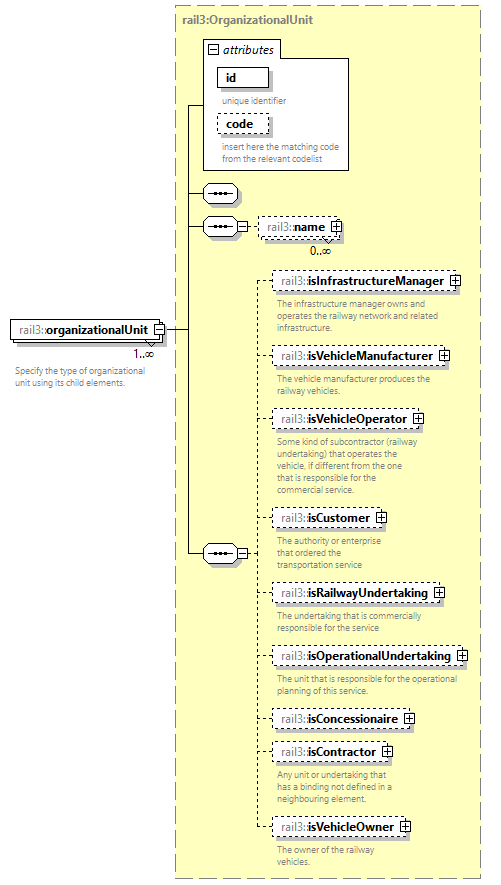 | ||||||||||||||||||||||
| namespace | https://www.railml.org/schemas/3.2 | ||||||||||||||||||||||
| type | rail3:OrganizationalUnit | ||||||||||||||||||||||
| properties |
| ||||||||||||||||||||||
| children | rail3:name rail3:isInfrastructureManager rail3:isVehicleManufacturer rail3:isVehicleOperator rail3:isCustomer rail3:isRailwayUndertaking rail3:isOperationalUndertaking rail3:isConcessionaire rail3:isContractor rail3:isVehicleOwner | ||||||||||||||||||||||
| attributes |
| ||||||||||||||||||||||
| annotation |
| ||||||||||||||||||||||
| source | <xs:element name="organizationalUnit" type="rail3:OrganizationalUnit" minOccurs="1" maxOccurs="unbounded"> <xs:annotation> <xs:documentation>Specify the type of organizational unit using its child elements.</xs:documentation> </xs:annotation> </xs:element> |
complexType Phase
| diagram | 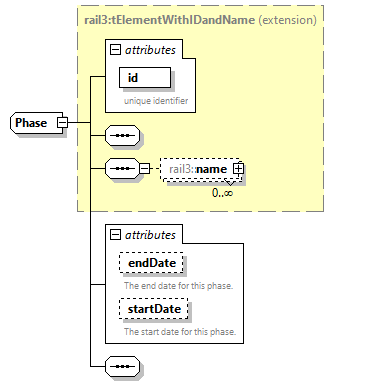 | ||||||||||||||||||||||||||||||
| namespace | https://www.railml.org/schemas/3.2 | ||||||||||||||||||||||||||||||
| type | extension of rail3:tElementWithIDandName | ||||||||||||||||||||||||||||||
| properties |
| ||||||||||||||||||||||||||||||
| children | rail3:name | ||||||||||||||||||||||||||||||
| used by |
| ||||||||||||||||||||||||||||||
| attributes |
| ||||||||||||||||||||||||||||||
| source | <xs:complexType name="Phase"> <xs:complexContent> <xs:extension base="rail3:tElementWithIDandName"> <xs:sequence/> <xs:attribute name="endDate" type="xs:date" use="optional"> <xs:annotation> <xs:documentation>The end date for this phase.</xs:documentation> </xs:annotation> </xs:attribute> <xs:attribute name="startDate" type="xs:date" use="optional"> <xs:annotation> <xs:documentation>The start date for this phase.</xs:documentation> </xs:annotation> </xs:attribute> </xs:extension> </xs:complexContent> </xs:complexType> |
attribute Phase/@endDate
| type | xs:date | ||
| properties |
| ||
| annotation |
| ||
| source | <xs:attribute name="endDate" type="xs:date" use="optional"> <xs:annotation> <xs:documentation>The end date for this phase.</xs:documentation> </xs:annotation> </xs:attribute> |
attribute Phase/@startDate
| type | xs:date | ||
| properties |
| ||
| annotation |
| ||
| source | <xs:attribute name="startDate" type="xs:date" use="optional"> <xs:annotation> <xs:documentation>The start date for this phase.</xs:documentation> </xs:annotation> </xs:attribute> |
complexType PositioningSystems
| diagram | 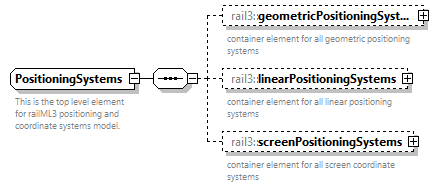 | ||
| namespace | https://www.railml.org/schemas/3.2 | ||
| children | rail3:geometricPositioningSystems rail3:linearPositioningSystems rail3:screenPositioningSystems | ||
| used by |
| ||
| annotation |
| ||
| source | <xs:complexType name="PositioningSystems"> <xs:annotation> <xs:documentation>This is the top level element for railML3 positioning and coordinate systems model.</xs:documentation> </xs:annotation> <xs:sequence> <xs:element name="geometricPositioningSystems" type="rail3:GeometricPositioningSystems" minOccurs="0" maxOccurs="1"> <xs:annotation> <xs:documentation>container element for all geometric positioning systems</xs:documentation> </xs:annotation> </xs:element> <xs:element name="linearPositioningSystems" type="rail3:LinearPositioningSystems" minOccurs="0" maxOccurs="1"> <xs:annotation> <xs:documentation>container element for all linear positioning systems</xs:documentation> </xs:annotation> </xs:element> <xs:element name="screenPositioningSystems" type="rail3:ScreenPositioningSystems" minOccurs="0" maxOccurs="1"> <xs:annotation> <xs:documentation>container element for all screen coordinate systems</xs:documentation> </xs:annotation> </xs:element> </xs:sequence> </xs:complexType> |
element PositioningSystems/geometricPositioningSystems
| diagram |  | ||||||
| namespace | https://www.railml.org/schemas/3.2 | ||||||
| type | rail3:GeometricPositioningSystems | ||||||
| properties |
| ||||||
| children | rail3:geometricPositioningSystem | ||||||
| annotation |
| ||||||
| source | <xs:element name="geometricPositioningSystems" type="rail3:GeometricPositioningSystems" minOccurs="0" maxOccurs="1"> <xs:annotation> <xs:documentation>container element for all geometric positioning systems</xs:documentation> </xs:annotation> </xs:element> |
element PositioningSystems/linearPositioningSystems
| diagram |  | ||||||
| namespace | https://www.railml.org/schemas/3.2 | ||||||
| type | rail3:LinearPositioningSystems | ||||||
| properties |
| ||||||
| children | rail3:linearPositioningSystem | ||||||
| annotation |
| ||||||
| source | <xs:element name="linearPositioningSystems" type="rail3:LinearPositioningSystems" minOccurs="0" maxOccurs="1"> <xs:annotation> <xs:documentation>container element for all linear positioning systems</xs:documentation> </xs:annotation> </xs:element> |
element PositioningSystems/screenPositioningSystems
| diagram |  | ||||||
| namespace | https://www.railml.org/schemas/3.2 | ||||||
| type | rail3:ScreenPositioningSystems | ||||||
| properties |
| ||||||
| children | rail3:screenPositioningSystem | ||||||
| annotation |
| ||||||
| source | <xs:element name="screenPositioningSystems" type="rail3:ScreenPositioningSystems" minOccurs="0" maxOccurs="1"> <xs:annotation> <xs:documentation>container element for all screen coordinate systems</xs:documentation> </xs:annotation> </xs:element> |
complexType Project
| diagram | 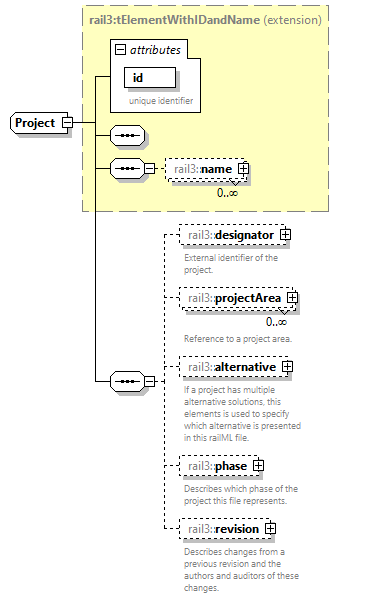 | ||||||||||||||
| namespace | https://www.railml.org/schemas/3.2 | ||||||||||||||
| type | extension of rail3:tElementWithIDandName | ||||||||||||||
| properties |
| ||||||||||||||
| children | rail3:name rail3:designator rail3:projectArea rail3:alternative rail3:phase rail3:revision | ||||||||||||||
| used by |
| ||||||||||||||
| attributes |
| ||||||||||||||
| source | <xs:complexType name="Project"> <xs:complexContent> <xs:extension base="rail3:tElementWithIDandName"> <xs:sequence> <xs:element name="designator" type="rail3:Designator" minOccurs="0" maxOccurs="1"> <xs:annotation> <xs:documentation>External identifier of the project.</xs:documentation> </xs:annotation> </xs:element> <xs:element name="projectArea" type="rail3:tElementWithIDref" minOccurs="0" maxOccurs="unbounded"> <xs:annotation> <xs:documentation>Reference to a project area.</xs:documentation> </xs:annotation> </xs:element> <xs:element name="alternative" type="rail3:Alternative" minOccurs="0" maxOccurs="1"> <xs:annotation> <xs:documentation>If a project has multiple alternative solutions, this elements is used to specify which alternative is presented in this railML file.</xs:documentation> </xs:annotation> </xs:element> <xs:element name="phase" type="rail3:Phase" minOccurs="0" maxOccurs="1"> <xs:annotation> <xs:documentation>Describes which phase of the project this file represents.</xs:documentation> </xs:annotation> </xs:element> <xs:element name="revision" type="rail3:Revision" minOccurs="0" maxOccurs="1"> <xs:annotation> <xs:documentation>Describes changes from a previous revision and the authors and auditors of these changes.</xs:documentation> </xs:annotation> </xs:element> </xs:sequence> </xs:extension> </xs:complexContent> </xs:complexType> |
element Project/designator
| diagram | 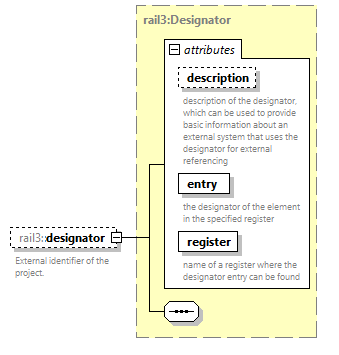 | ||||||||||||||||||||||||||||||
| namespace | https://www.railml.org/schemas/3.2 | ||||||||||||||||||||||||||||||
| type | rail3:Designator | ||||||||||||||||||||||||||||||
| properties |
| ||||||||||||||||||||||||||||||
| attributes |
| ||||||||||||||||||||||||||||||
| annotation |
| ||||||||||||||||||||||||||||||
| source | <xs:element name="designator" type="rail3:Designator" minOccurs="0" maxOccurs="1"> <xs:annotation> <xs:documentation>External identifier of the project.</xs:documentation> </xs:annotation> </xs:element> |
element Project/projectArea
| diagram | 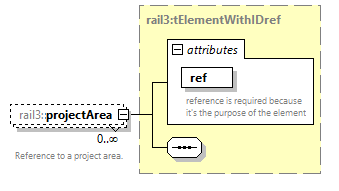 | ||||||||||||||
| namespace | https://www.railml.org/schemas/3.2 | ||||||||||||||
| type | rail3:tElementWithIDref | ||||||||||||||
| properties |
| ||||||||||||||
| attributes |
| ||||||||||||||
| annotation |
| ||||||||||||||
| source | <xs:element name="projectArea" type="rail3:tElementWithIDref" minOccurs="0" maxOccurs="unbounded"> <xs:annotation> <xs:documentation>Reference to a project area.</xs:documentation> </xs:annotation> </xs:element> |
element Project/alternative
| diagram | 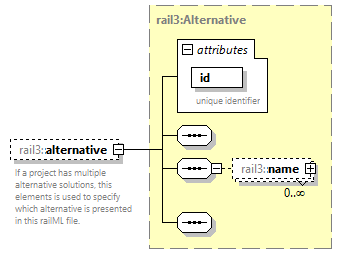 | ||||||||||||||
| namespace | https://www.railml.org/schemas/3.2 | ||||||||||||||
| type | rail3:Alternative | ||||||||||||||
| properties |
| ||||||||||||||
| children | rail3:name | ||||||||||||||
| attributes |
| ||||||||||||||
| annotation |
| ||||||||||||||
| source | <xs:element name="alternative" type="rail3:Alternative" minOccurs="0" maxOccurs="1"> <xs:annotation> <xs:documentation>If a project has multiple alternative solutions, this elements is used to specify which alternative is presented in this railML file.</xs:documentation> </xs:annotation> </xs:element> |
element Project/phase
| diagram | 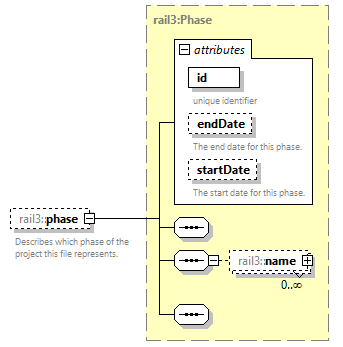 | ||||||||||||||||||||||||||||||
| namespace | https://www.railml.org/schemas/3.2 | ||||||||||||||||||||||||||||||
| type | rail3:Phase | ||||||||||||||||||||||||||||||
| properties |
| ||||||||||||||||||||||||||||||
| children | rail3:name | ||||||||||||||||||||||||||||||
| attributes |
| ||||||||||||||||||||||||||||||
| annotation |
| ||||||||||||||||||||||||||||||
| source | <xs:element name="phase" type="rail3:Phase" minOccurs="0" maxOccurs="1"> <xs:annotation> <xs:documentation>Describes which phase of the project this file represents.</xs:documentation> </xs:annotation> </xs:element> |
element Project/revision
| diagram | 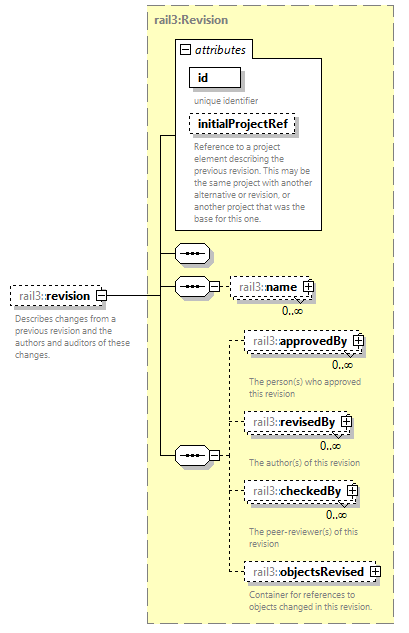 | ||||||||||||||||||||||
| namespace | https://www.railml.org/schemas/3.2 | ||||||||||||||||||||||
| type | rail3:Revision | ||||||||||||||||||||||
| properties |
| ||||||||||||||||||||||
| children | rail3:name rail3:approvedBy rail3:revisedBy rail3:checkedBy rail3:objectsRevised | ||||||||||||||||||||||
| attributes |
| ||||||||||||||||||||||
| annotation |
| ||||||||||||||||||||||
| source | <xs:element name="revision" type="rail3:Revision" minOccurs="0" maxOccurs="1"> <xs:annotation> <xs:documentation>Describes changes from a previous revision and the authors and auditors of these changes.</xs:documentation> </xs:annotation> </xs:element> |
complexType Projects
| diagram |  | ||
| namespace | https://www.railml.org/schemas/3.2 | ||
| children | rail3:project | ||
| used by |
| ||
| source | <xs:complexType name="Projects"> <xs:sequence> <xs:element name="project" type="rail3:Project" minOccurs="1" maxOccurs="unbounded"> <xs:annotation> <xs:documentation>Describes one or more projects this railML model belongs to.</xs:documentation> </xs:annotation> </xs:element> </xs:sequence> </xs:complexType> |
element Projects/project
| diagram | 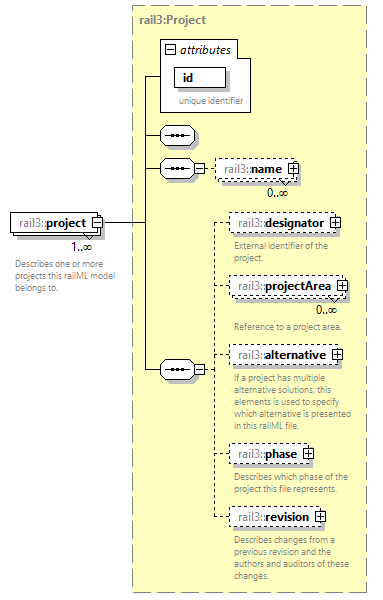 | ||||||||||||||
| namespace | https://www.railml.org/schemas/3.2 | ||||||||||||||
| type | rail3:Project | ||||||||||||||
| properties |
| ||||||||||||||
| children | rail3:name rail3:designator rail3:projectArea rail3:alternative rail3:phase rail3:revision | ||||||||||||||
| attributes |
| ||||||||||||||
| annotation |
| ||||||||||||||
| source | <xs:element name="project" type="rail3:Project" minOccurs="1" maxOccurs="unbounded"> <xs:annotation> <xs:documentation>Describes one or more projects this railML model belongs to.</xs:documentation> </xs:annotation> </xs:element> |
complexType RailwayUndertaking
| diagram |  | ||
| namespace | https://www.railml.org/schemas/3.2 | ||
| used by |
| ||
| source | <xs:complexType name="RailwayUndertaking"> <xs:sequence/> </xs:complexType> |
complexType Revision
| diagram | 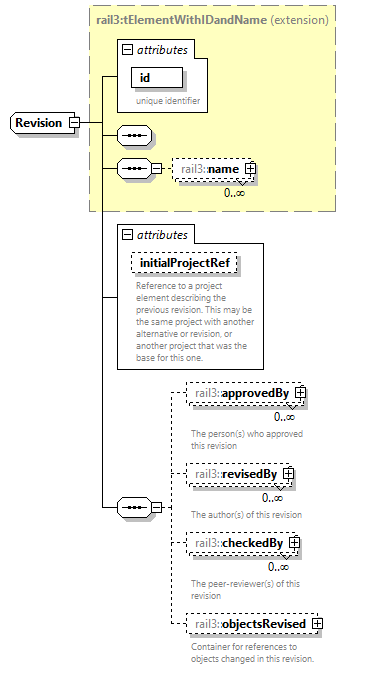 | ||||||||||||||||||||||
| namespace | https://www.railml.org/schemas/3.2 | ||||||||||||||||||||||
| type | extension of rail3:tElementWithIDandName | ||||||||||||||||||||||
| properties |
| ||||||||||||||||||||||
| children | rail3:name rail3:approvedBy rail3:revisedBy rail3:checkedBy rail3:objectsRevised | ||||||||||||||||||||||
| used by |
| ||||||||||||||||||||||
| attributes |
| ||||||||||||||||||||||
| source | <xs:complexType name="Revision"> <xs:complexContent> <xs:extension base="rail3:tElementWithIDandName"> <xs:sequence> <xs:element name="approvedBy" type="rail3:DoneBy" minOccurs="0" maxOccurs="unbounded"> <xs:annotation> <xs:documentation>The person(s) who approved this revision</xs:documentation> </xs:annotation> </xs:element> <xs:element name="revisedBy" type="rail3:DoneBy" minOccurs="0" maxOccurs="unbounded"> <xs:annotation> <xs:documentation>The author(s) of this revision</xs:documentation> </xs:annotation> </xs:element> <xs:element name="checkedBy" type="rail3:DoneBy" minOccurs="0" maxOccurs="unbounded"> <xs:annotation> <xs:documentation>The peer-reviewer(s) of this revision</xs:documentation> </xs:annotation> </xs:element> <xs:element name="objectsRevised" type="rail3:ObjectsRevised" minOccurs="0" maxOccurs="1"> <xs:annotation> <xs:documentation>Container for references to objects changed in this revision.</xs:documentation> </xs:annotation> </xs:element> </xs:sequence> <xs:attribute name="initialProjectRef" type="rail3:tGenericRef" use="optional"> <xs:annotation> <xs:documentation>Reference to a project element describing the previous revision. This may be the same project with another alternative or revision, or another project that was the base for this one.</xs:documentation> </xs:annotation> </xs:attribute> </xs:extension> </xs:complexContent> </xs:complexType> |
attribute Revision/@initialProjectRef
| type | rail3:tGenericRef | ||
| properties |
| ||
| annotation |
| ||
| source | <xs:attribute name="initialProjectRef" type="rail3:tGenericRef" use="optional"> <xs:annotation> <xs:documentation>Reference to a project element describing the previous revision. This may be the same project with another alternative or revision, or another project that was the base for this one.</xs:documentation> </xs:annotation> </xs:attribute> |
element Revision/approvedBy
| diagram | 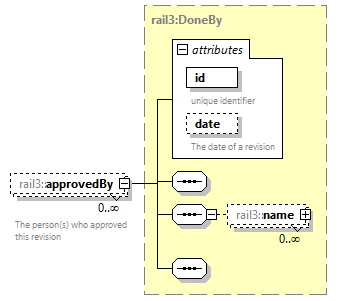 | ||||||||||||||||||||||
| namespace | https://www.railml.org/schemas/3.2 | ||||||||||||||||||||||
| type | rail3:DoneBy | ||||||||||||||||||||||
| properties |
| ||||||||||||||||||||||
| children | rail3:name | ||||||||||||||||||||||
| attributes |
| ||||||||||||||||||||||
| annotation |
| ||||||||||||||||||||||
| source | <xs:element name="approvedBy" type="rail3:DoneBy" minOccurs="0" maxOccurs="unbounded"> <xs:annotation> <xs:documentation>The person(s) who approved this revision</xs:documentation> </xs:annotation> </xs:element> |
element Revision/revisedBy
| diagram | 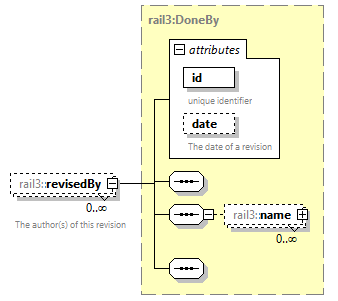 | ||||||||||||||||||||||
| namespace | https://www.railml.org/schemas/3.2 | ||||||||||||||||||||||
| type | rail3:DoneBy | ||||||||||||||||||||||
| properties |
| ||||||||||||||||||||||
| children | rail3:name | ||||||||||||||||||||||
| attributes |
| ||||||||||||||||||||||
| annotation |
| ||||||||||||||||||||||
| source | <xs:element name="revisedBy" type="rail3:DoneBy" minOccurs="0" maxOccurs="unbounded"> <xs:annotation> <xs:documentation>The author(s) of this revision</xs:documentation> </xs:annotation> </xs:element> |
element Revision/checkedBy
| diagram | 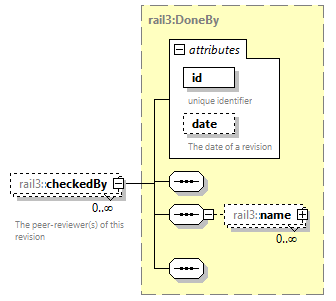 | ||||||||||||||||||||||
| namespace | https://www.railml.org/schemas/3.2 | ||||||||||||||||||||||
| type | rail3:DoneBy | ||||||||||||||||||||||
| properties |
| ||||||||||||||||||||||
| children | rail3:name | ||||||||||||||||||||||
| attributes |
| ||||||||||||||||||||||
| annotation |
| ||||||||||||||||||||||
| source | <xs:element name="checkedBy" type="rail3:DoneBy" minOccurs="0" maxOccurs="unbounded"> <xs:annotation> <xs:documentation>The peer-reviewer(s) of this revision</xs:documentation> </xs:annotation> </xs:element> |
element Revision/objectsRevised
| diagram |  | ||||||
| namespace | https://www.railml.org/schemas/3.2 | ||||||
| type | rail3:ObjectsRevised | ||||||
| properties |
| ||||||
| children | rail3:objectRevised | ||||||
| annotation |
| ||||||
| source | <xs:element name="objectsRevised" type="rail3:ObjectsRevised" minOccurs="0" maxOccurs="1"> <xs:annotation> <xs:documentation>Container for references to objects changed in this revision.</xs:documentation> </xs:annotation> </xs:element> |
complexType ScreenPositioningSystem
| diagram | 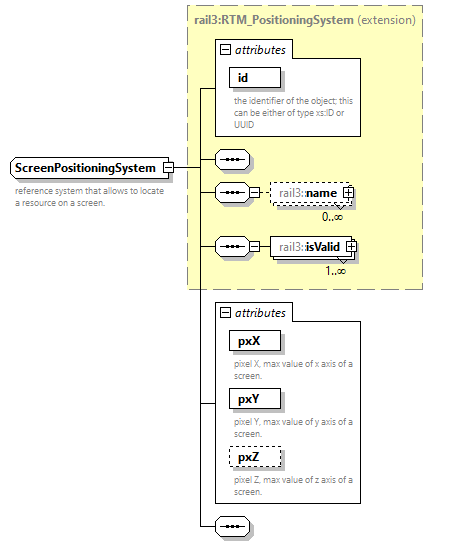 | ||||||||||||||||||||||||||||||||||||||
| namespace | https://www.railml.org/schemas/3.2 | ||||||||||||||||||||||||||||||||||||||
| type | extension of rail3:RTM_PositioningSystem | ||||||||||||||||||||||||||||||||||||||
| properties |
| ||||||||||||||||||||||||||||||||||||||
| children | rail3:name rail3:isValid | ||||||||||||||||||||||||||||||||||||||
| used by |
| ||||||||||||||||||||||||||||||||||||||
| attributes |
| ||||||||||||||||||||||||||||||||||||||
| annotation |
| ||||||||||||||||||||||||||||||||||||||
| source | <xs:complexType name="ScreenPositioningSystem"> <xs:annotation> <xs:documentation>reference system that allows to locate a resource on a screen.</xs:documentation> </xs:annotation> <xs:complexContent> <xs:extension base="rail3:RTM_PositioningSystem"> <xs:sequence/> <xs:attribute name="pxX" type="xs:positiveInteger" use="required"> <xs:annotation> <xs:documentation>pixel X, max value of x axis of a screen.</xs:documentation> </xs:annotation> </xs:attribute> <xs:attribute name="pxY" type="xs:positiveInteger" use="required"> <xs:annotation> <xs:documentation>pixel Y, max value of y axis of a screen.</xs:documentation> </xs:annotation> </xs:attribute> <xs:attribute name="pxZ" type="xs:positiveInteger" use="optional"> <xs:annotation> <xs:documentation>pixel Z, max value of z axis of a screen.</xs:documentation> </xs:annotation> </xs:attribute> </xs:extension> </xs:complexContent> </xs:complexType> |
attribute ScreenPositioningSystem/@pxX
| type | xs:positiveInteger | ||
| properties |
| ||
| annotation |
| ||
| source | <xs:attribute name="pxX" type="xs:positiveInteger" use="required"> <xs:annotation> <xs:documentation>pixel X, max value of x axis of a screen.</xs:documentation> </xs:annotation> </xs:attribute> |
attribute ScreenPositioningSystem/@pxY
| type | xs:positiveInteger | ||
| properties |
| ||
| annotation |
| ||
| source | <xs:attribute name="pxY" type="xs:positiveInteger" use="required"> <xs:annotation> <xs:documentation>pixel Y, max value of y axis of a screen.</xs:documentation> </xs:annotation> </xs:attribute> |
attribute ScreenPositioningSystem/@pxZ
| type | xs:positiveInteger | ||
| properties |
| ||
| annotation |
| ||
| source | <xs:attribute name="pxZ" type="xs:positiveInteger" use="optional"> <xs:annotation> <xs:documentation>pixel Z, max value of z axis of a screen.</xs:documentation> </xs:annotation> </xs:attribute> |
complexType ScreenPositioningSystems
| diagram |  | ||
| namespace | https://www.railml.org/schemas/3.2 | ||
| children | rail3:screenPositioningSystem | ||
| used by |
| ||
| source | <xs:complexType name="ScreenPositioningSystems"> <xs:sequence> <xs:element name="screenPositioningSystem" type="rail3:ScreenPositioningSystem" minOccurs="1" maxOccurs="unbounded"/> </xs:sequence> </xs:complexType> |
element ScreenPositioningSystems/screenPositioningSystem
| diagram | 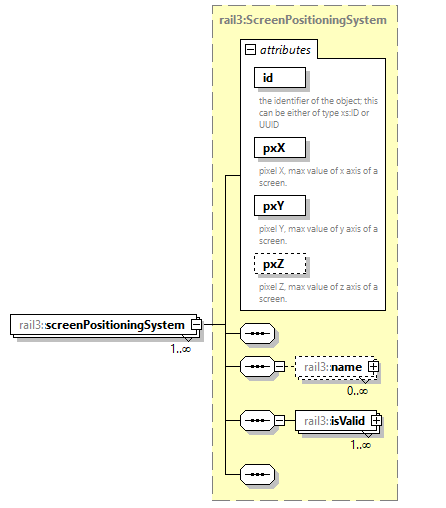 | ||||||||||||||||||||||||||||||||||||||
| namespace | https://www.railml.org/schemas/3.2 | ||||||||||||||||||||||||||||||||||||||
| type | rail3:ScreenPositioningSystem | ||||||||||||||||||||||||||||||||||||||
| properties |
| ||||||||||||||||||||||||||||||||||||||
| children | rail3:name rail3:isValid | ||||||||||||||||||||||||||||||||||||||
| attributes |
| ||||||||||||||||||||||||||||||||||||||
| source | <xs:element name="screenPositioningSystem" type="rail3:ScreenPositioningSystem" minOccurs="1" maxOccurs="unbounded"/> |
complexType SpeedProfile
| diagram | 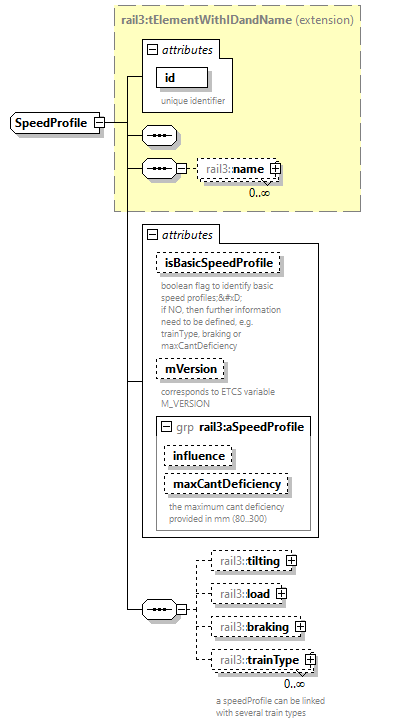 | ||||||||||||||||||||||||||||||||||||||||||||
| namespace | https://www.railml.org/schemas/3.2 | ||||||||||||||||||||||||||||||||||||||||||||
| type | extension of rail3:tElementWithIDandName | ||||||||||||||||||||||||||||||||||||||||||||
| properties |
| ||||||||||||||||||||||||||||||||||||||||||||
| children | rail3:name rail3:tilting rail3:load rail3:braking rail3:trainType | ||||||||||||||||||||||||||||||||||||||||||||
| used by |
| ||||||||||||||||||||||||||||||||||||||||||||
| attributes |
| ||||||||||||||||||||||||||||||||||||||||||||
| source | <xs:complexType name="SpeedProfile"> <xs:complexContent> <xs:extension base="rail3:tElementWithIDandName"> <xs:sequence> <xs:element name="tilting" type="rail3:SpeedProfileTilting" minOccurs="0" maxOccurs="1"/> <xs:element name="load" type="rail3:SpeedProfileLoad" minOccurs="0" maxOccurs="1"/> <xs:element name="braking" type="rail3:SpeedProfileBraking" minOccurs="0" maxOccurs="1"/> <xs:element name="trainType" type="rail3:SpeedProfileTrainType" minOccurs="0" maxOccurs="unbounded"> <xs:annotation> <xs:documentation>a speedProfile can be linked with several train types</xs:documentation> </xs:annotation> </xs:element> </xs:sequence> <xs:attribute name="isBasicSpeedProfile" type="xs:boolean" use="optional"> <xs:annotation> <xs:documentation>boolean flag to identify basic speed profiles;
 if NO, then further information need to be defined, e.g. trainType, braking or maxCantDeficiency</xs:documentation> </xs:annotation> </xs:attribute> <xs:attribute name="mVersion" type="xs:nonNegativeInteger" use="optional"> <xs:annotation> <xs:documentation>corresponds to ETCS variable M_VERSION</xs:documentation> </xs:annotation> </xs:attribute> <xs:attributeGroup ref="rail3:aSpeedProfile"/> </xs:extension> </xs:complexContent> </xs:complexType> |
attribute SpeedProfile/@isBasicSpeedProfile
| type | xs:boolean | ||
| properties |
| ||
| annotation |
| ||
| source | <xs:attribute name="isBasicSpeedProfile" type="xs:boolean" use="optional"> <xs:annotation> <xs:documentation>boolean flag to identify basic speed profiles;
 if NO, then further information need to be defined, e.g. trainType, braking or maxCantDeficiency</xs:documentation> </xs:annotation> </xs:attribute> |
attribute SpeedProfile/@mVersion
| type | xs:nonNegativeInteger | ||
| properties |
| ||
| annotation |
| ||
| source | <xs:attribute name="mVersion" type="xs:nonNegativeInteger" use="optional"> <xs:annotation> <xs:documentation>corresponds to ETCS variable M_VERSION</xs:documentation> </xs:annotation> </xs:attribute> |
element SpeedProfile/tilting
| diagram | 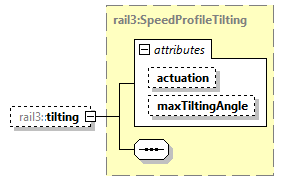 | ||||||||||||||||||
| namespace | https://www.railml.org/schemas/3.2 | ||||||||||||||||||
| type | rail3:SpeedProfileTilting | ||||||||||||||||||
| properties |
| ||||||||||||||||||
| attributes |
| ||||||||||||||||||
| source | <xs:element name="tilting" type="rail3:SpeedProfileTilting" minOccurs="0" maxOccurs="1"/> |
element SpeedProfile/load
| diagram | 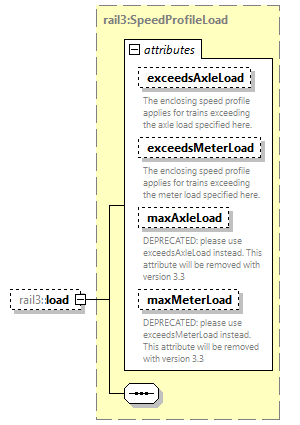 | ||||||||||||||||||||||||||||||||||||||
| namespace | https://www.railml.org/schemas/3.2 | ||||||||||||||||||||||||||||||||||||||
| type | rail3:SpeedProfileLoad | ||||||||||||||||||||||||||||||||||||||
| properties |
| ||||||||||||||||||||||||||||||||||||||
| attributes |
| ||||||||||||||||||||||||||||||||||||||
| source | <xs:element name="load" type="rail3:SpeedProfileLoad" minOccurs="0" maxOccurs="1"/> |
element SpeedProfile/braking
| diagram | 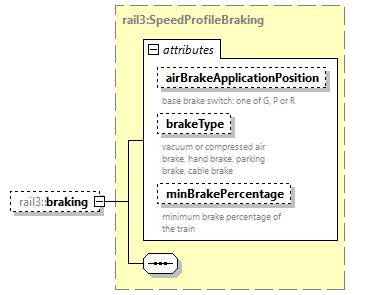 | ||||||||||||||||||||||||||||||
| namespace | https://www.railml.org/schemas/3.2 | ||||||||||||||||||||||||||||||
| type | rail3:SpeedProfileBraking | ||||||||||||||||||||||||||||||
| properties |
| ||||||||||||||||||||||||||||||
| attributes |
| ||||||||||||||||||||||||||||||
| source | <xs:element name="braking" type="rail3:SpeedProfileBraking" minOccurs="0" maxOccurs="1"/> |
element SpeedProfile/trainType
| diagram | 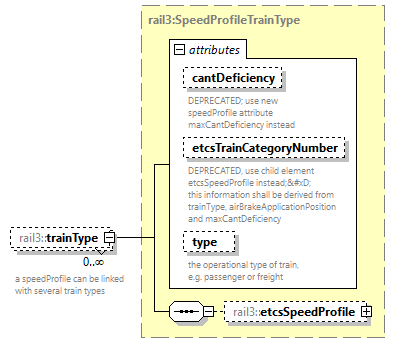 | ||||||||||||||||||||||||||||||
| namespace | https://www.railml.org/schemas/3.2 | ||||||||||||||||||||||||||||||
| type | rail3:SpeedProfileTrainType | ||||||||||||||||||||||||||||||
| properties |
| ||||||||||||||||||||||||||||||
| children | rail3:etcsSpeedProfile | ||||||||||||||||||||||||||||||
| attributes |
| ||||||||||||||||||||||||||||||
| annotation |
| ||||||||||||||||||||||||||||||
| source | <xs:element name="trainType" type="rail3:SpeedProfileTrainType" minOccurs="0" maxOccurs="unbounded"> <xs:annotation> <xs:documentation>a speedProfile can be linked with several train types</xs:documentation> </xs:annotation> </xs:element> |
complexType SpeedProfileBraking
| diagram | 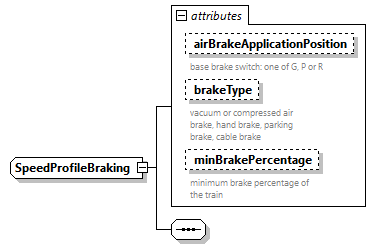 | ||||||||||||||||||||||||||||||
| namespace | https://www.railml.org/schemas/3.2 | ||||||||||||||||||||||||||||||
| used by |
| ||||||||||||||||||||||||||||||
| attributes |
| ||||||||||||||||||||||||||||||
| source | <xs:complexType name="SpeedProfileBraking"> <xs:sequence/> <xs:attribute name="airBrakeApplicationPosition" type="rail3:tAirBrakeApplicationDirection" use="optional"> <xs:annotation> <xs:documentation>base brake switch: one of G, P or R</xs:documentation> </xs:annotation> </xs:attribute> <xs:attribute name="brakeType" type="rail3:tBrakeTypeExt" use="optional"> <xs:annotation> <xs:documentation>vacuum or compressed air brake, hand brake, parking brake, cable brake</xs:documentation> </xs:annotation> </xs:attribute> <xs:attribute name="minBrakePercentage" type="rail3:tBrakePercentage" use="optional"> <xs:annotation> <xs:documentation>minimum brake percentage of the train</xs:documentation> </xs:annotation> </xs:attribute> </xs:complexType> |
attribute SpeedProfileBraking/@airBrakeApplicationPosition
| type | rail3:tAirBrakeApplicationDirection | |||||||||||||||||||||
| properties |
| |||||||||||||||||||||
| facets |
| |||||||||||||||||||||
| annotation |
| |||||||||||||||||||||
| source | <xs:attribute name="airBrakeApplicationPosition" type="rail3:tAirBrakeApplicationDirection" use="optional"> <xs:annotation> <xs:documentation>base brake switch: one of G, P or R</xs:documentation> </xs:annotation> </xs:attribute> |
attribute SpeedProfileBraking/@brakeType
| type | rail3:tBrakeTypeExt | ||
| properties |
| ||
| annotation |
| ||
| source | <xs:attribute name="brakeType" type="rail3:tBrakeTypeExt" use="optional"> <xs:annotation> <xs:documentation>vacuum or compressed air brake, hand brake, parking brake, cable brake</xs:documentation> </xs:annotation> </xs:attribute> |
attribute SpeedProfileBraking/@minBrakePercentage
| type | rail3:tBrakePercentage | |||||||||
| properties |
| |||||||||
| facets |
| |||||||||
| annotation |
| |||||||||
| source | <xs:attribute name="minBrakePercentage" type="rail3:tBrakePercentage" use="optional"> <xs:annotation> <xs:documentation>minimum brake percentage of the train</xs:documentation> </xs:annotation> </xs:attribute> |
complexType SpeedProfileEtcs
| diagram | 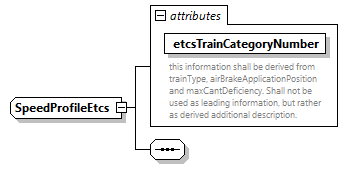 | ||||||||||||||
| namespace | https://www.railml.org/schemas/3.2 | ||||||||||||||
| used by |
| ||||||||||||||
| attributes |
| ||||||||||||||
| source | <xs:complexType name="SpeedProfileEtcs"> <xs:sequence/> <xs:attribute name="etcsTrainCategoryNumber" type="rail3:tEtcsTrainCategoryNumber" use="required"> <xs:annotation> <xs:documentation>this information shall be derived from trainType, airBrakeApplicationPosition and maxCantDeficiency. Shall not be used as leading information, but rather as derived additional description.</xs:documentation> </xs:annotation> </xs:attribute> </xs:complexType> |
attribute SpeedProfileEtcs/@etcsTrainCategoryNumber
| type | rail3:tEtcsTrainCategoryNumber | |||||||||
| properties |
| |||||||||
| facets |
| |||||||||
| annotation |
| |||||||||
| source | <xs:attribute name="etcsTrainCategoryNumber" type="rail3:tEtcsTrainCategoryNumber" use="required"> <xs:annotation> <xs:documentation>this information shall be derived from trainType, airBrakeApplicationPosition and maxCantDeficiency. Shall not be used as leading information, but rather as derived additional description.</xs:documentation> </xs:annotation> </xs:attribute> |
complexType SpeedProfileLoad
| diagram | 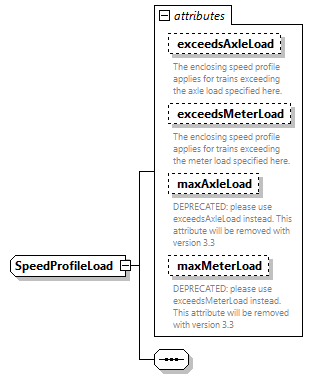 | ||||||||||||||||||||||||||||||||||||||
| namespace | https://www.railml.org/schemas/3.2 | ||||||||||||||||||||||||||||||||||||||
| used by |
| ||||||||||||||||||||||||||||||||||||||
| attributes |
| ||||||||||||||||||||||||||||||||||||||
| source | <xs:complexType name="SpeedProfileLoad"> <xs:sequence/> <xs:attribute name="exceedsAxleLoad" type="rail3:tWeightTons" use="optional"> <xs:annotation> <xs:documentation>The enclosing speed profile applies for trains exceeding the axle load specified here.</xs:documentation> </xs:annotation> </xs:attribute> <xs:attribute name="exceedsMeterLoad" type="rail3:tMeterloadTonsPerMeter" use="optional"> <xs:annotation> <xs:documentation>The enclosing speed profile applies for trains exceeding the meter load specified here.</xs:documentation> </xs:annotation> </xs:attribute> <xs:attribute name="maxAxleLoad" type="rail3:tWeightTons" use="optional"> <xs:annotation> <xs:documentation>DEPRECATED: please use exceedsAxleLoad instead. This attribute will be removed with version 3.3</xs:documentation> </xs:annotation> </xs:attribute> <xs:attribute name="maxMeterLoad" type="rail3:tMeterloadTonsPerMeter" use="optional"> <xs:annotation> <xs:documentation>DEPRECATED: please use exceedsMeterLoad instead. This attribute will be removed with version 3.3</xs:documentation> </xs:annotation> </xs:attribute> </xs:complexType> |
attribute SpeedProfileLoad/@exceedsAxleLoad
| type | rail3:tWeightTons | ||
| properties |
| ||
| annotation |
| ||
| source | <xs:attribute name="exceedsAxleLoad" type="rail3:tWeightTons" use="optional"> <xs:annotation> <xs:documentation>The enclosing speed profile applies for trains exceeding the axle load specified here.</xs:documentation> </xs:annotation> </xs:attribute> |
attribute SpeedProfileLoad/@exceedsMeterLoad
| type | rail3:tMeterloadTonsPerMeter | ||
| properties |
| ||
| annotation |
| ||
| source | <xs:attribute name="exceedsMeterLoad" type="rail3:tMeterloadTonsPerMeter" use="optional"> <xs:annotation> <xs:documentation>The enclosing speed profile applies for trains exceeding the meter load specified here.</xs:documentation> </xs:annotation> </xs:attribute> |
attribute SpeedProfileLoad/@maxAxleLoad
| type | rail3:tWeightTons | ||
| properties |
| ||
| annotation |
| ||
| source | <xs:attribute name="maxAxleLoad" type="rail3:tWeightTons" use="optional"> <xs:annotation> <xs:documentation>DEPRECATED: please use exceedsAxleLoad instead. This attribute will be removed with version 3.3</xs:documentation> </xs:annotation> </xs:attribute> |
attribute SpeedProfileLoad/@maxMeterLoad
| type | rail3:tMeterloadTonsPerMeter | ||
| properties |
| ||
| annotation |
| ||
| source | <xs:attribute name="maxMeterLoad" type="rail3:tMeterloadTonsPerMeter" use="optional"> <xs:annotation> <xs:documentation>DEPRECATED: please use exceedsMeterLoad instead. This attribute will be removed with version 3.3</xs:documentation> </xs:annotation> </xs:attribute> |
complexType SpeedProfiles
| diagram |  | ||
| namespace | https://www.railml.org/schemas/3.2 | ||
| children | rail3:speedProfile | ||
| used by |
| ||
| source | <xs:complexType name="SpeedProfiles"> <xs:sequence> <xs:element name="speedProfile" type="rail3:SpeedProfile" minOccurs="1" maxOccurs="unbounded"/> </xs:sequence> </xs:complexType> |
element SpeedProfiles/speedProfile
| diagram | 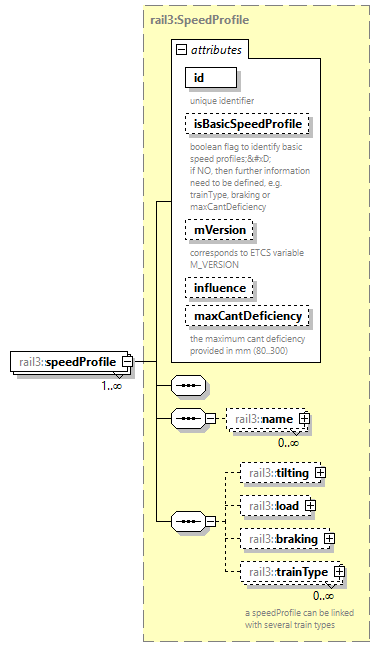 | ||||||||||||||||||||||||||||||||||||||||||||
| namespace | https://www.railml.org/schemas/3.2 | ||||||||||||||||||||||||||||||||||||||||||||
| type | rail3:SpeedProfile | ||||||||||||||||||||||||||||||||||||||||||||
| properties |
| ||||||||||||||||||||||||||||||||||||||||||||
| children | rail3:name rail3:tilting rail3:load rail3:braking rail3:trainType | ||||||||||||||||||||||||||||||||||||||||||||
| attributes |
| ||||||||||||||||||||||||||||||||||||||||||||
| source | <xs:element name="speedProfile" type="rail3:SpeedProfile" minOccurs="1" maxOccurs="unbounded"/> |
complexType SpeedProfileTilting
| diagram | 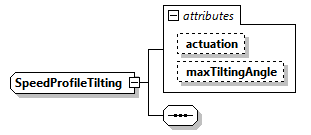 | ||||||||||||||||||
| namespace | https://www.railml.org/schemas/3.2 | ||||||||||||||||||
| used by |
| ||||||||||||||||||
| attributes |
| ||||||||||||||||||
| source | <xs:complexType name="SpeedProfileTilting"> <xs:sequence/> <xs:attribute name="actuation" type="rail3:tTiltingActuationType" use="optional"/> <xs:attribute name="maxTiltingAngle" type="rail3:tAngleDegQuadrant" use="optional"/> </xs:complexType> |
attribute SpeedProfileTilting/@actuation
| type | rail3:tTiltingActuationType | |||||||||||||||
| properties |
| |||||||||||||||
| facets |
| |||||||||||||||
| source | <xs:attribute name="actuation" type="rail3:tTiltingActuationType" use="optional"/> |
attribute SpeedProfileTilting/@maxTiltingAngle
| type | rail3:tAngleDegQuadrant | ||
| properties |
| ||
| source | <xs:attribute name="maxTiltingAngle" type="rail3:tAngleDegQuadrant" use="optional"/> |
complexType SpeedProfileTrainType
| diagram | 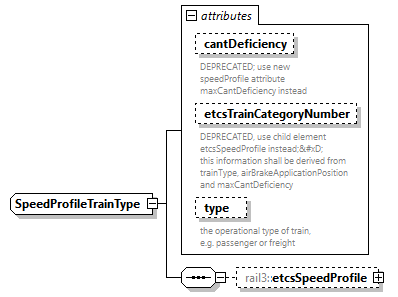 | ||||||||||||||||||||||||||||||
| namespace | https://www.railml.org/schemas/3.2 | ||||||||||||||||||||||||||||||
| children | rail3:etcsSpeedProfile | ||||||||||||||||||||||||||||||
| used by |
| ||||||||||||||||||||||||||||||
| attributes |
| ||||||||||||||||||||||||||||||
| source | <xs:complexType name="SpeedProfileTrainType"> <xs:sequence> <xs:element name="etcsSpeedProfile" type="rail3:SpeedProfileEtcs" minOccurs="0" maxOccurs="1"/> </xs:sequence> <xs:attribute name="cantDeficiency" type="rail3:tCantDeficiency" use="optional"> <xs:annotation> <xs:documentation>DEPRECATED; use new speedProfile attribute maxCantDeficiency instead</xs:documentation> </xs:annotation> </xs:attribute> <xs:attribute name="etcsTrainCategoryNumber" type="rail3:tEtcsTrainCategoryNumber" use="optional"> <xs:annotation> <xs:documentation>DEPRECATED, use child element etcsSpeedProfile instead;
 this information shall be derived from trainType, airBrakeApplicationPosition and maxCantDeficiency</xs:documentation> </xs:annotation> </xs:attribute> <xs:attribute name="type" type="rail3:tTrainTypeExt" use="optional"> <xs:annotation> <xs:documentation>the operational type of train, e.g. passenger or freight</xs:documentation> </xs:annotation> </xs:attribute> </xs:complexType> |
attribute SpeedProfileTrainType/@cantDeficiency
| type | rail3:tCantDeficiency | |||||||||
| properties |
| |||||||||
| facets |
| |||||||||
| annotation |
| |||||||||
| source | <xs:attribute name="cantDeficiency" type="rail3:tCantDeficiency" use="optional"> <xs:annotation> <xs:documentation>DEPRECATED; use new speedProfile attribute maxCantDeficiency instead</xs:documentation> </xs:annotation> </xs:attribute> |
attribute SpeedProfileTrainType/@etcsTrainCategoryNumber
| type | rail3:tEtcsTrainCategoryNumber | |||||||||
| properties |
| |||||||||
| facets |
| |||||||||
| annotation |
| |||||||||
| source | <xs:attribute name="etcsTrainCategoryNumber" type="rail3:tEtcsTrainCategoryNumber" use="optional"> <xs:annotation> <xs:documentation>DEPRECATED, use child element etcsSpeedProfile instead;
 this information shall be derived from trainType, airBrakeApplicationPosition and maxCantDeficiency</xs:documentation> </xs:annotation> </xs:attribute> |
attribute SpeedProfileTrainType/@type
| type | rail3:tTrainTypeExt | ||
| properties |
| ||
| annotation |
| ||
| source | <xs:attribute name="type" type="rail3:tTrainTypeExt" use="optional"> <xs:annotation> <xs:documentation>the operational type of train, e.g. passenger or freight</xs:documentation> </xs:annotation> </xs:attribute> |
element SpeedProfileTrainType/etcsSpeedProfile
| diagram | 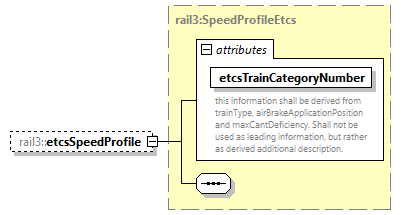 | ||||||||||||||
| namespace | https://www.railml.org/schemas/3.2 | ||||||||||||||
| type | rail3:SpeedProfileEtcs | ||||||||||||||
| properties |
| ||||||||||||||
| attributes |
| ||||||||||||||
| source | <xs:element name="etcsSpeedProfile" type="rail3:SpeedProfileEtcs" minOccurs="0" maxOccurs="1"/> |
complexType TimePeriod
| diagram | 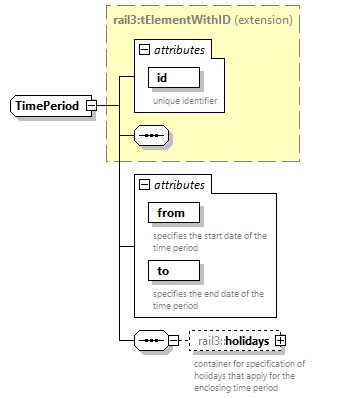 | ||||||||||||||||||||||||||||||
| namespace | https://www.railml.org/schemas/3.2 | ||||||||||||||||||||||||||||||
| type | extension of rail3:tElementWithID | ||||||||||||||||||||||||||||||
| properties |
| ||||||||||||||||||||||||||||||
| children | rail3:holidays | ||||||||||||||||||||||||||||||
| used by |
| ||||||||||||||||||||||||||||||
| attributes |
| ||||||||||||||||||||||||||||||
| source | <xs:complexType name="TimePeriod"> <xs:complexContent> <xs:extension base="rail3:tElementWithID"> <xs:sequence> <xs:element name="holidays" type="rail3:Holidays" minOccurs="0" maxOccurs="1"> <xs:annotation> <xs:documentation>container for specification of holidays that apply for the enclosing time period</xs:documentation> </xs:annotation> </xs:element> </xs:sequence> <xs:attribute name="from" type="xs:date" use="required"> <xs:annotation> <xs:documentation>specifies the start date of the time period</xs:documentation> </xs:annotation> </xs:attribute> <xs:attribute name="to" type="xs:date" use="required"> <xs:annotation> <xs:documentation>specifies the end date of the time period</xs:documentation> </xs:annotation> </xs:attribute> </xs:extension> </xs:complexContent> </xs:complexType> |
attribute TimePeriod/@from
| type | xs:date | ||
| properties |
| ||
| annotation |
| ||
| source | <xs:attribute name="from" type="xs:date" use="required"> <xs:annotation> <xs:documentation>specifies the start date of the time period</xs:documentation> </xs:annotation> </xs:attribute> |
attribute TimePeriod/@to
| type | xs:date | ||
| properties |
| ||
| annotation |
| ||
| source | <xs:attribute name="to" type="xs:date" use="required"> <xs:annotation> <xs:documentation>specifies the end date of the time period</xs:documentation> </xs:annotation> </xs:attribute> |
element TimePeriod/holidays
| diagram | 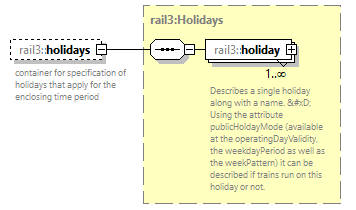 | ||||||
| namespace | https://www.railml.org/schemas/3.2 | ||||||
| type | rail3:Holidays | ||||||
| properties |
| ||||||
| children | rail3:holiday | ||||||
| annotation |
| ||||||
| source | <xs:element name="holidays" type="rail3:Holidays" minOccurs="0" maxOccurs="1"> <xs:annotation> <xs:documentation>container for specification of holidays that apply for the enclosing time period</xs:documentation> </xs:annotation> </xs:element> |
complexType TimePeriods
| diagram | 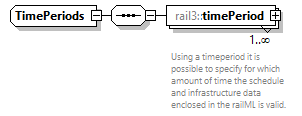 | ||
| namespace | https://www.railml.org/schemas/3.2 | ||
| children | rail3:timePeriod | ||
| used by |
| ||
| source | <xs:complexType name="TimePeriods"> <xs:sequence> <xs:element name="timePeriod" type="rail3:TimePeriod" minOccurs="1" maxOccurs="unbounded"> <xs:annotation> <xs:documentation>Using a timeperiod it is possible to specify for which amount of time the schedule and infrastructure data enclosed in the railML is valid.</xs:documentation> </xs:annotation> </xs:element> </xs:sequence> </xs:complexType> |
element TimePeriods/timePeriod
| diagram | 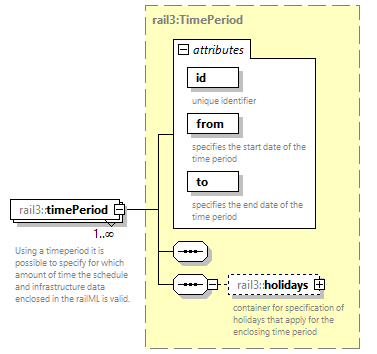 | ||||||||||||||||||||||||||||||
| namespace | https://www.railml.org/schemas/3.2 | ||||||||||||||||||||||||||||||
| type | rail3:TimePeriod | ||||||||||||||||||||||||||||||
| properties |
| ||||||||||||||||||||||||||||||
| children | rail3:holidays | ||||||||||||||||||||||||||||||
| attributes |
| ||||||||||||||||||||||||||||||
| annotation |
| ||||||||||||||||||||||||||||||
| source | <xs:element name="timePeriod" type="rail3:TimePeriod" minOccurs="1" maxOccurs="unbounded"> <xs:annotation> <xs:documentation>Using a timeperiod it is possible to specify for which amount of time the schedule and infrastructure data enclosed in the railML is valid.</xs:documentation> </xs:annotation> </xs:element> |
complexType TractionMode
| diagram | 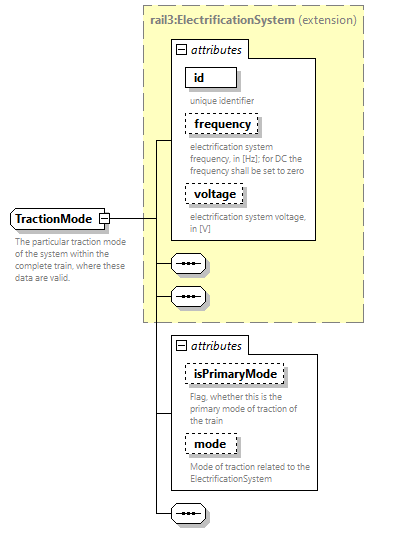 | ||||||||||||||||||||||||||||||||||||||||||||||
| namespace | https://www.railml.org/schemas/3.2 | ||||||||||||||||||||||||||||||||||||||||||||||
| type | extension of rail3:ElectrificationSystem | ||||||||||||||||||||||||||||||||||||||||||||||
| properties |
| ||||||||||||||||||||||||||||||||||||||||||||||
| used by |
| ||||||||||||||||||||||||||||||||||||||||||||||
| attributes |
| ||||||||||||||||||||||||||||||||||||||||||||||
| annotation |
| ||||||||||||||||||||||||||||||||||||||||||||||
| source | <xs:complexType name="TractionMode"> <xs:annotation> <xs:documentation>The particular traction mode of the system within the complete train, where these data are valid.</xs:documentation> </xs:annotation> <xs:complexContent> <xs:extension base="rail3:ElectrificationSystem"> <xs:sequence/> <xs:attribute name="isPrimaryMode" type="xs:boolean" use="optional"> <xs:annotation> <xs:documentation>Flag, whether this is the primary mode of traction of the train</xs:documentation> </xs:annotation> </xs:attribute> <xs:attribute name="mode" type="rail3:tTractionModeListExt" use="optional"> <xs:annotation> <xs:documentation>Mode of traction related to the ElectrificationSystem</xs:documentation> </xs:annotation> </xs:attribute> </xs:extension> </xs:complexContent> </xs:complexType> |
attribute TractionMode/@isPrimaryMode
| type | xs:boolean | ||
| properties |
| ||
| annotation |
| ||
| source | <xs:attribute name="isPrimaryMode" type="xs:boolean" use="optional"> <xs:annotation> <xs:documentation>Flag, whether this is the primary mode of traction of the train</xs:documentation> </xs:annotation> </xs:attribute> |
attribute TractionMode/@mode
| type | rail3:tTractionModeListExt | ||
| properties |
| ||
| annotation |
| ||
| source | <xs:attribute name="mode" type="rail3:tTractionModeListExt" use="optional"> <xs:annotation> <xs:documentation>Mode of traction related to the ElectrificationSystem</xs:documentation> </xs:annotation> </xs:attribute> |
complexType VehicleManufacturer
| diagram |  | ||
| namespace | https://www.railml.org/schemas/3.2 | ||
| used by |
| ||
| source | <xs:complexType name="VehicleManufacturer"> <xs:sequence/> </xs:complexType> |
complexType VehicleOperator
| diagram |  | ||
| namespace | https://www.railml.org/schemas/3.2 | ||
| used by |
| ||
| source | <xs:complexType name="VehicleOperator"> <xs:sequence/> </xs:complexType> |
complexType VehicleOwner
| diagram |  | ||
| namespace | https://www.railml.org/schemas/3.2 | ||
| used by |
| ||
| source | <xs:complexType name="VehicleOwner"> <xs:sequence/> </xs:complexType> |
simpleType tSpeedProfileInfluence
| namespace | https://www.railml.org/schemas/3.2 | |||||||||
| type | restriction of xs:string | |||||||||
| properties |
| |||||||||
| used by |
| |||||||||
| facets |
| |||||||||
| source | <xs:simpleType name="tSpeedProfileInfluence"> <xs:restriction base="xs:string"> <xs:enumeration value="decreasing"/> <xs:enumeration value="increasing"/> </xs:restriction> </xs:simpleType> |
simpleType tTractionModeList
| namespace | https://www.railml.org/schemas/3.2 | ||||||||||||||||||
| type | restriction of xs:string | ||||||||||||||||||
| properties |
| ||||||||||||||||||
| used by |
| ||||||||||||||||||
| facets |
| ||||||||||||||||||
| source | <xs:simpleType name="tTractionModeList"> <xs:restriction base="xs:string"> <xs:enumeration value="battery"/> <xs:enumeration value="diesel"/> <xs:enumeration value="electricOverheadLine"/> <xs:enumeration value="electricThirdRail"/> <xs:enumeration value="hydrogenFuelCell"/> </xs:restriction> </xs:simpleType> |
simpleType tTractionModeListExt
| namespace | https://www.railml.org/schemas/3.2 | ||
| type | union of (rail3:tTractionModeList, rail3:tOtherEnumerationValue) | ||
| used by |
| ||
| source | <xs:simpleType name="tTractionModeListExt"> <xs:union memberTypes="rail3:tTractionModeList rail3:tOtherEnumerationValue"/> </xs:simpleType> |
simpleType tTrainType
| namespace | https://www.railml.org/schemas/3.2 | ||||||||||||||||||||||||||||
| type | restriction of xs:string | ||||||||||||||||||||||||||||
| properties |
| ||||||||||||||||||||||||||||
| used by |
| ||||||||||||||||||||||||||||
| facets |
| ||||||||||||||||||||||||||||
| source | <xs:simpleType name="tTrainType"> <xs:restriction base="xs:string"> <xs:enumeration value="all"> <xs:annotation> <xs:documentation>use value 'all' to specify that the speed profile is valid for all types of train</xs:documentation> </xs:annotation> </xs:enumeration> <xs:enumeration value="freight"> <xs:annotation> <xs:documentation>used to specify that the speed profile is valid for freight trains</xs:documentation> </xs:annotation> </xs:enumeration> <xs:enumeration value="mixed"> <xs:annotation> <xs:documentation>a mixed train includes passenger and freight waggons</xs:documentation> </xs:annotation> </xs:enumeration> <xs:enumeration value="passenger"> <xs:annotation> <xs:documentation>used to specify that the speed profile is valid for passenger trains</xs:documentation> </xs:annotation> </xs:enumeration> <xs:enumeration value="tiltingPassenger"> <xs:annotation> <xs:documentation>DEPRECATED; use tilting element instead</xs:documentation> </xs:annotation> </xs:enumeration> </xs:restriction> </xs:simpleType> |
simpleType tTrainTypeExt
| namespace | https://www.railml.org/schemas/3.2 | ||
| type | union of (rail3:tTrainType, rail3:tOtherEnumerationValue) | ||
| used by |
| ||
| source | <xs:simpleType name="tTrainTypeExt"> <xs:union memberTypes="rail3:tTrainType rail3:tOtherEnumerationValue"/> </xs:simpleType> |
attributeGroup aSpeedProfile
| namespace | https://www.railml.org/schemas/3.2 | ||||||||||||||||||||
| used by |
| ||||||||||||||||||||
| attributes |
| ||||||||||||||||||||
| source | <xs:attributeGroup name="aSpeedProfile"> <xs:attribute name="influence" type="rail3:tSpeedProfileInfluence" use="optional"/> <xs:attribute name="maxCantDeficiency" type="rail3:tCantDeficiency" use="optional"> <xs:annotation> <xs:documentation>the maximum cant deficiency provided in mm (80..300)</xs:documentation> </xs:annotation> </xs:attribute> </xs:attributeGroup> |
attribute aSpeedProfile/@influence
| type | rail3:tSpeedProfileInfluence | |||||||||
| properties |
| |||||||||
| facets |
| |||||||||
| source | <xs:attribute name="influence" type="rail3:tSpeedProfileInfluence" use="optional"/> |
attribute aSpeedProfile/@maxCantDeficiency
| type | rail3:tCantDeficiency | |||||||||
| properties |
| |||||||||
| facets |
| |||||||||
| annotation |
| |||||||||
| source | <xs:attribute name="maxCantDeficiency" type="rail3:tCantDeficiency" use="optional"> <xs:annotation> <xs:documentation>the maximum cant deficiency provided in mm (80..300)</xs:documentation> </xs:annotation> </xs:attribute> |
complexType BitmaskValidity
| diagram | 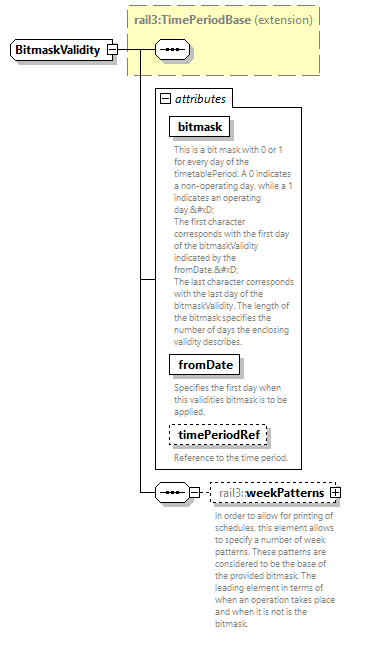 | ||||||||||||||||||||||||||||||
| namespace | https://www.railml.org/schemas/3.2 | ||||||||||||||||||||||||||||||
| type | extension of rail3:TimePeriodBase | ||||||||||||||||||||||||||||||
| properties |
| ||||||||||||||||||||||||||||||
| children | rail3:weekPatterns | ||||||||||||||||||||||||||||||
| used by |
| ||||||||||||||||||||||||||||||
| attributes |
| ||||||||||||||||||||||||||||||
| source | <xs:complexType name="BitmaskValidity"> <xs:complexContent> <xs:extension base="rail3:TimePeriodBase"> <xs:sequence> <xs:element name="weekPatterns" type="rail3:WeekPatterns" minOccurs="0" maxOccurs="1"> <xs:annotation> <xs:documentation>In order to allow for printing of schedules, this element allows to specify a number of week patterns. These patterns are considered to be the base of the provided bitmask. The leading element in terms of when an operation takes place and when it is not is the bitmask.</xs:documentation> </xs:annotation> </xs:element> </xs:sequence> <xs:attribute name="bitmask" type="rail3:tBitmaskAny" use="required"> <xs:annotation> <xs:documentation>This is a bit mask with 0 or 1 for every day of the timetablePeriod. A 0 indicates a non-operating day, while a 1 indicates an operating day.
 The first character corresponds with the first day of the bitmaskValidity indicated by the fromDate.
 The last character corresponds with the last day of the bitmaskValidity. The length of the bitmask specifies the number of days the enclosing validity describes.</xs:documentation> </xs:annotation> </xs:attribute> <xs:attribute name="fromDate" type="xs:date" use="required"> <xs:annotation> <xs:documentation>Specifies the first day when this validities bitmask is to be applied.</xs:documentation> </xs:annotation> </xs:attribute> <xs:attribute name="timePeriodRef" type="rail3:tRef" use="optional"> <xs:annotation> <xs:documentation>Reference to the time period. </xs:documentation> </xs:annotation> </xs:attribute> </xs:extension> </xs:complexContent> </xs:complexType> |
attribute BitmaskValidity/@bitmask
| type | rail3:tBitmaskAny | ||||||
| properties |
| ||||||
| facets |
| ||||||
| annotation |
| ||||||
| source | <xs:attribute name="bitmask" type="rail3:tBitmaskAny" use="required"> <xs:annotation> <xs:documentation>This is a bit mask with 0 or 1 for every day of the timetablePeriod. A 0 indicates a non-operating day, while a 1 indicates an operating day.
 The first character corresponds with the first day of the bitmaskValidity indicated by the fromDate.
 The last character corresponds with the last day of the bitmaskValidity. The length of the bitmask specifies the number of days the enclosing validity describes.</xs:documentation> </xs:annotation> </xs:attribute> |
attribute BitmaskValidity/@fromDate
| type | xs:date | ||
| properties |
| ||
| annotation |
| ||
| source | <xs:attribute name="fromDate" type="xs:date" use="required"> <xs:annotation> <xs:documentation>Specifies the first day when this validities bitmask is to be applied.</xs:documentation> </xs:annotation> </xs:attribute> |
attribute BitmaskValidity/@timePeriodRef
| type | rail3:tRef | ||
| properties |
| ||
| annotation |
| ||
| source | <xs:attribute name="timePeriodRef" type="rail3:tRef" use="optional"> <xs:annotation> <xs:documentation>Reference to the time period. </xs:documentation> </xs:annotation> </xs:attribute> |
element BitmaskValidity/weekPatterns
| diagram | 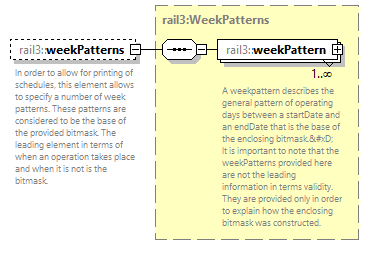 | ||||||
| namespace | https://www.railml.org/schemas/3.2 | ||||||
| type | rail3:WeekPatterns | ||||||
| properties |
| ||||||
| children | rail3:weekPattern | ||||||
| annotation |
| ||||||
| source | <xs:element name="weekPatterns" type="rail3:WeekPatterns" minOccurs="0" maxOccurs="1"> <xs:annotation> <xs:documentation>In order to allow for printing of schedules, this element allows to specify a number of week patterns. These patterns are considered to be the base of the provided bitmask. The leading element in terms of when an operation takes place and when it is not is the bitmask.</xs:documentation> </xs:annotation> </xs:element> |
complexType CalendarTimePeriod
| diagram | 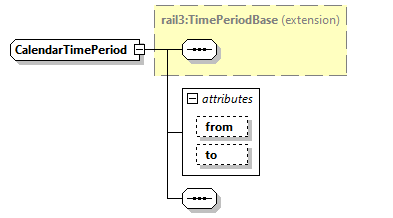 | ||||||||||||||||||
| namespace | https://www.railml.org/schemas/3.2 | ||||||||||||||||||
| type | extension of rail3:TimePeriodBase | ||||||||||||||||||
| properties |
| ||||||||||||||||||
| used by |
| ||||||||||||||||||
| attributes |
| ||||||||||||||||||
| source | <xs:complexType name="CalendarTimePeriod"> <xs:complexContent> <xs:extension base="rail3:TimePeriodBase"> <xs:sequence/> <xs:attribute name="from" type="xs:dateTime" use="optional"/> <xs:attribute name="to" type="xs:dateTime" use="optional"/> </xs:extension> </xs:complexContent> </xs:complexType> |
attribute CalendarTimePeriod/@from
| type | xs:dateTime | ||
| properties |
| ||
| source | <xs:attribute name="from" type="xs:dateTime" use="optional"/> |
attribute CalendarTimePeriod/@to
| type | xs:dateTime | ||
| properties |
| ||
| source | <xs:attribute name="to" type="xs:dateTime" use="optional"/> |
complexType CalendarTimePeriodWithBitmask
| diagram | 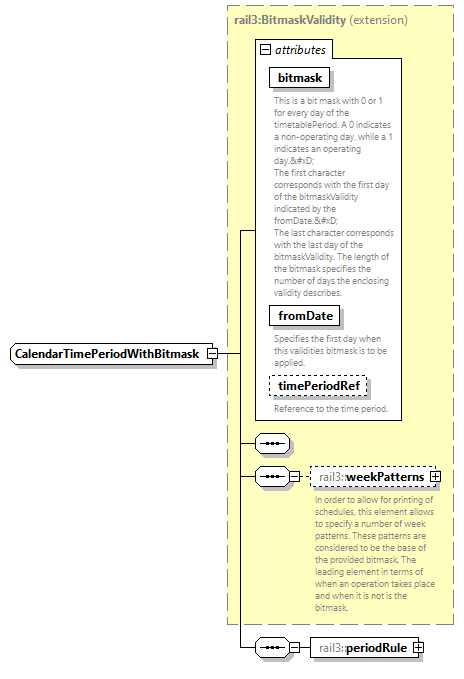 | ||||||||||||||||||||||||||||||
| namespace | https://www.railml.org/schemas/3.2 | ||||||||||||||||||||||||||||||
| type | extension of rail3:BitmaskValidity | ||||||||||||||||||||||||||||||
| properties |
| ||||||||||||||||||||||||||||||
| children | rail3:weekPatterns rail3:periodRule | ||||||||||||||||||||||||||||||
| used by |
| ||||||||||||||||||||||||||||||
| attributes |
| ||||||||||||||||||||||||||||||
| source | <xs:complexType name="CalendarTimePeriodWithBitmask"> <xs:complexContent> <xs:extension base="rail3:BitmaskValidity"> <xs:sequence> <xs:element name="periodRule" type="rail3:PeriodRule" minOccurs="1" maxOccurs="1"/> </xs:sequence> </xs:extension> </xs:complexContent> </xs:complexType> |
element CalendarTimePeriodWithBitmask/periodRule
| diagram | 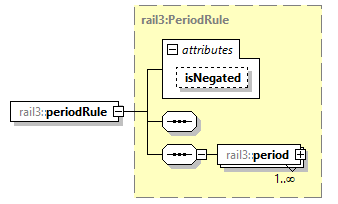 | ||||||||||||
| namespace | https://www.railml.org/schemas/3.2 | ||||||||||||
| type | rail3:PeriodRule | ||||||||||||
| properties |
| ||||||||||||
| children | rail3:period | ||||||||||||
| attributes |
| ||||||||||||
| source | <xs:element name="periodRule" type="rail3:PeriodRule" minOccurs="1" maxOccurs="1"/> |
complexType ClockTimePeriod
| diagram | 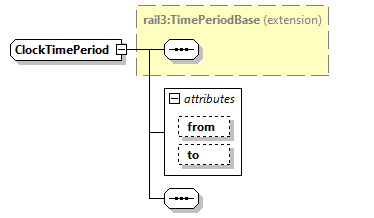 | ||||||||||||||||||
| namespace | https://www.railml.org/schemas/3.2 | ||||||||||||||||||
| type | extension of rail3:TimePeriodBase | ||||||||||||||||||
| properties |
| ||||||||||||||||||
| used by |
| ||||||||||||||||||
| attributes |
| ||||||||||||||||||
| source | <xs:complexType name="ClockTimePeriod"> <xs:complexContent> <xs:extension base="rail3:TimePeriodBase"> <xs:sequence/> <xs:attribute name="from" type="xs:time" use="optional"/> <xs:attribute name="to" type="xs:time" use="optional"/> </xs:extension> </xs:complexContent> </xs:complexType> |
attribute ClockTimePeriod/@from
| type | xs:time | ||
| properties |
| ||
| source | <xs:attribute name="from" type="xs:time" use="optional"/> |
attribute ClockTimePeriod/@to
| type | xs:time | ||
| properties |
| ||
| source | <xs:attribute name="to" type="xs:time" use="optional"/> |
complexType DateWithBitmask
| diagram | 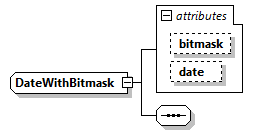 | ||||||||||||||||||
| namespace | https://www.railml.org/schemas/3.2 | ||||||||||||||||||
| used by |
| ||||||||||||||||||
| attributes |
| ||||||||||||||||||
| source | <xs:complexType name="DateWithBitmask"> <xs:sequence/> <xs:attribute name="bitmask" type="rail3:tBitmaskAny" use="optional"/> <xs:attribute name="date" type="xs:date" use="optional"/> </xs:complexType> |
attribute DateWithBitmask/@bitmask
| type | rail3:tBitmaskAny | ||||||
| properties |
| ||||||
| facets |
| ||||||
| source | <xs:attribute name="bitmask" type="rail3:tBitmaskAny" use="optional"/> |
attribute DateWithBitmask/@date
| type | xs:date | ||
| properties |
| ||
| source | <xs:attribute name="date" type="xs:date" use="optional"/> |
complexType Designator
| diagram | 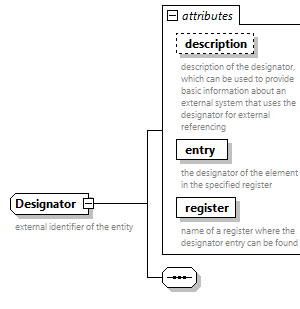 | ||||||||||||||||||||||||||||||
| namespace | https://www.railml.org/schemas/3.2 | ||||||||||||||||||||||||||||||
| used by |
| ||||||||||||||||||||||||||||||
| attributes |
| ||||||||||||||||||||||||||||||
| annotation |
| ||||||||||||||||||||||||||||||
| source | <xs:complexType name="Designator"> <xs:annotation> <xs:documentation>external identifier of the entity</xs:documentation> </xs:annotation> <xs:sequence/> <xs:attribute name="description" type="xs:string" use="optional"> <xs:annotation> <xs:documentation>description of the designator, which can be used to provide basic information about an external system that uses the designator for external referencing</xs:documentation> </xs:annotation> </xs:attribute> <xs:attribute name="entry" type="xs:string" use="required"> <xs:annotation> <xs:documentation>the designator of the element in the specified register</xs:documentation> </xs:annotation> </xs:attribute> <xs:attribute name="register" type="xs:string" use="required"> <xs:annotation> <xs:documentation>name of a register where the designator entry can be found</xs:documentation> </xs:annotation> </xs:attribute> </xs:complexType> |
attribute Designator/@description
| type | xs:string | ||
| properties |
| ||
| annotation |
| ||
| source | <xs:attribute name="description" type="xs:string" use="optional"> <xs:annotation> <xs:documentation>description of the designator, which can be used to provide basic information about an external system that uses the designator for external referencing</xs:documentation> </xs:annotation> </xs:attribute> |
attribute Designator/@entry
| type | xs:string | ||
| properties |
| ||
| annotation |
| ||
| source | <xs:attribute name="entry" type="xs:string" use="required"> <xs:annotation> <xs:documentation>the designator of the element in the specified register</xs:documentation> </xs:annotation> </xs:attribute> |
attribute Designator/@register
| type | xs:string | ||
| properties |
| ||
| annotation |
| ||
| source | <xs:attribute name="register" type="xs:string" use="required"> <xs:annotation> <xs:documentation>name of a register where the designator entry can be found</xs:documentation> </xs:annotation> </xs:attribute> |
complexType ElemBasedPeriodRule
| diagram | 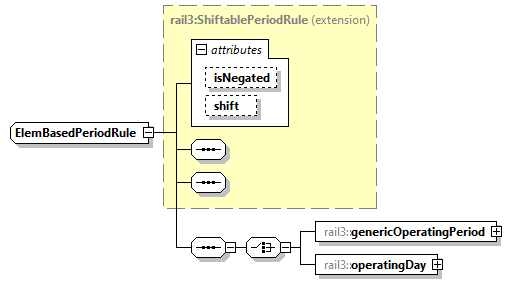 | ||||||||||||||||||
| namespace | https://www.railml.org/schemas/3.2 | ||||||||||||||||||
| type | extension of rail3:ShiftablePeriodRule | ||||||||||||||||||
| properties |
| ||||||||||||||||||
| children | rail3:genericOperatingPeriod rail3:operatingDay | ||||||||||||||||||
| used by |
| ||||||||||||||||||
| attributes |
| ||||||||||||||||||
| source | <xs:complexType name="ElemBasedPeriodRule"> <xs:complexContent> <xs:extension base="rail3:ShiftablePeriodRule"> <xs:sequence> <xs:choice minOccurs="1" maxOccurs="1"> <xs:element name="genericOperatingPeriod" type="rail3:GenericOperatingPeriodDescription" minOccurs="1" maxOccurs="1"/> <xs:element name="operatingDay" type="rail3:OperatingDay" minOccurs="1" maxOccurs="1"/> </xs:choice> </xs:sequence> </xs:extension> </xs:complexContent> </xs:complexType> |
element ElemBasedPeriodRule/genericOperatingPeriod
| diagram | 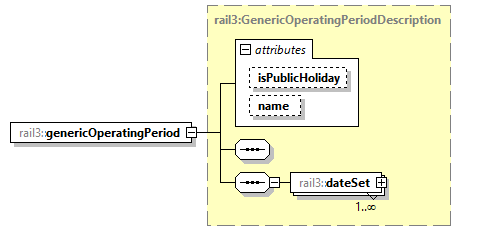 | ||||||||||||||||||
| namespace | https://www.railml.org/schemas/3.2 | ||||||||||||||||||
| type | rail3:GenericOperatingPeriodDescription | ||||||||||||||||||
| properties |
| ||||||||||||||||||
| children | rail3:dateSet | ||||||||||||||||||
| attributes |
| ||||||||||||||||||
| source | <xs:element name="genericOperatingPeriod" type="rail3:GenericOperatingPeriodDescription" minOccurs="1" maxOccurs="1"/> |
element ElemBasedPeriodRule/operatingDay
| diagram | 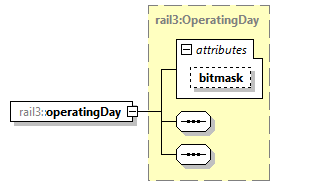 | ||||||||||||
| namespace | https://www.railml.org/schemas/3.2 | ||||||||||||
| type | rail3:OperatingDay | ||||||||||||
| properties |
| ||||||||||||
| attributes |
| ||||||||||||
| source | <xs:element name="operatingDay" type="rail3:OperatingDay" minOccurs="1" maxOccurs="1"/> |
complexType External
| diagram | 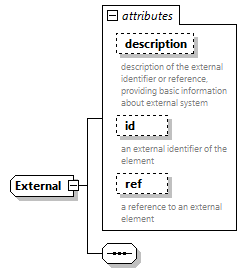 | ||||||||||||||||||||||||||||||
| namespace | https://www.railml.org/schemas/3.2 | ||||||||||||||||||||||||||||||
| used by |
| ||||||||||||||||||||||||||||||
| attributes |
| ||||||||||||||||||||||||||||||
| source | <xs:complexType name="External"> <xs:sequence/> <xs:attribute name="description" type="xs:string" use="optional"> <xs:annotation> <xs:documentation>description of the external identifier or reference, providing basic information about external system</xs:documentation> </xs:annotation> </xs:attribute> <xs:attribute name="id" type="xs:string" use="optional"> <xs:annotation> <xs:documentation>an external identifier of the element</xs:documentation> </xs:annotation> </xs:attribute> <xs:attribute name="ref" type="xs:string" use="optional"> <xs:annotation> <xs:documentation>a reference to an external element</xs:documentation> </xs:annotation> </xs:attribute> </xs:complexType> |
attribute External/@description
| type | xs:string | ||
| properties |
| ||
| annotation |
| ||
| source | <xs:attribute name="description" type="xs:string" use="optional"> <xs:annotation> <xs:documentation>description of the external identifier or reference, providing basic information about external system</xs:documentation> </xs:annotation> </xs:attribute> |
attribute External/@id
| type | xs:string | ||
| properties |
| ||
| annotation |
| ||
| source | <xs:attribute name="id" type="xs:string" use="optional"> <xs:annotation> <xs:documentation>an external identifier of the element</xs:documentation> </xs:annotation> </xs:attribute> |
attribute External/@ref
| type | xs:string | ||
| properties |
| ||
| annotation |
| ||
| source | <xs:attribute name="ref" type="xs:string" use="optional"> <xs:annotation> <xs:documentation>a reference to an external element</xs:documentation> </xs:annotation> </xs:attribute> |
complexType FreightFacilities
| diagram | 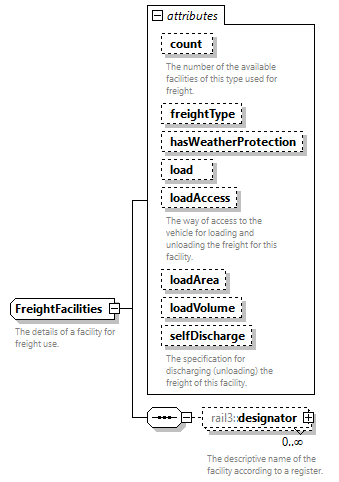 | ||||||||||||||||||||||||||||||||||||||||||||||||||||||||||||
| namespace | https://www.railml.org/schemas/3.2 | ||||||||||||||||||||||||||||||||||||||||||||||||||||||||||||
| children | rail3:designator | ||||||||||||||||||||||||||||||||||||||||||||||||||||||||||||
| used by |
| ||||||||||||||||||||||||||||||||||||||||||||||||||||||||||||
| attributes |
| ||||||||||||||||||||||||||||||||||||||||||||||||||||||||||||
| annotation |
| ||||||||||||||||||||||||||||||||||||||||||||||||||||||||||||
| source | <xs:complexType name="FreightFacilities"> <xs:annotation> <xs:documentation>The details of a facility for freight use.</xs:documentation> </xs:annotation> <xs:sequence> <xs:element name="designator" type="rail3:Designator" minOccurs="0" maxOccurs="unbounded"> <xs:annotation> <xs:documentation>The descriptive name of the facility according to a register.</xs:documentation> </xs:annotation> </xs:element> </xs:sequence> <xs:attribute name="count" type="xs:positiveInteger" use="optional"> <xs:annotation> <xs:documentation>The number of the available facilities of this type used for freight.</xs:documentation> </xs:annotation> </xs:attribute> <xs:attribute name="freightType" type="rail3:tFreightListExt" use="optional"/> <xs:attribute name="hasWeatherProtection" type="xs:boolean" use="optional"/> <xs:attribute name="load" type="rail3:tWeightTons" use="optional"/> <xs:attribute name="loadAccess" type="rail3:tLoadAccessListExt" use="optional"> <xs:annotation> <xs:documentation>The way of access to the vehicle for loading and unloading the freight for this facility.</xs:documentation> </xs:annotation> </xs:attribute> <xs:attribute name="loadArea" type="rail3:tAreaSquareM" use="optional"/> <xs:attribute name="loadVolume" type="rail3:tVolumeCubicM" use="optional"/> <xs:attribute name="selfDischarge" type="rail3:tSelfDischargeListExt" use="optional"> <xs:annotation> <xs:documentation>The specification for discharging (unloading) the freight of this facility.</xs:documentation> </xs:annotation> </xs:attribute> </xs:complexType> |
attribute FreightFacilities/@count
| type | xs:positiveInteger | ||
| properties |
| ||
| annotation |
| ||
| source | <xs:attribute name="count" type="xs:positiveInteger" use="optional"> <xs:annotation> <xs:documentation>The number of the available facilities of this type used for freight.</xs:documentation> </xs:annotation> </xs:attribute> |
attribute FreightFacilities/@freightType
| type | rail3:tFreightListExt | ||
| properties |
| ||
| source | <xs:attribute name="freightType" type="rail3:tFreightListExt" use="optional"/> |
attribute FreightFacilities/@hasWeatherProtection
| type | xs:boolean | ||
| properties |
| ||
| source | <xs:attribute name="hasWeatherProtection" type="xs:boolean" use="optional"/> |
attribute FreightFacilities/@load
| type | rail3:tWeightTons | ||
| properties |
| ||
| source | <xs:attribute name="load" type="rail3:tWeightTons" use="optional"/> |
attribute FreightFacilities/@loadAccess
| type | rail3:tLoadAccessListExt | ||
| properties |
| ||
| annotation |
| ||
| source | <xs:attribute name="loadAccess" type="rail3:tLoadAccessListExt" use="optional"> <xs:annotation> <xs:documentation>The way of access to the vehicle for loading and unloading the freight for this facility.</xs:documentation> </xs:annotation> </xs:attribute> |
attribute FreightFacilities/@loadArea
| type | rail3:tAreaSquareM | ||
| properties |
| ||
| source | <xs:attribute name="loadArea" type="rail3:tAreaSquareM" use="optional"/> |
attribute FreightFacilities/@loadVolume
| type | rail3:tVolumeCubicM | ||
| properties |
| ||
| source | <xs:attribute name="loadVolume" type="rail3:tVolumeCubicM" use="optional"/> |
attribute FreightFacilities/@selfDischarge
| type | rail3:tSelfDischargeListExt | ||
| properties |
| ||
| annotation |
| ||
| source | <xs:attribute name="selfDischarge" type="rail3:tSelfDischargeListExt" use="optional"> <xs:annotation> <xs:documentation>The specification for discharging (unloading) the freight of this facility.</xs:documentation> </xs:annotation> </xs:attribute> |
element FreightFacilities/designator
| diagram | 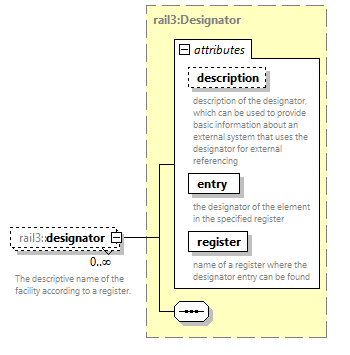 | ||||||||||||||||||||||||||||||
| namespace | https://www.railml.org/schemas/3.2 | ||||||||||||||||||||||||||||||
| type | rail3:Designator | ||||||||||||||||||||||||||||||
| properties |
| ||||||||||||||||||||||||||||||
| attributes |
| ||||||||||||||||||||||||||||||
| annotation |
| ||||||||||||||||||||||||||||||
| source | <xs:element name="designator" type="rail3:Designator" minOccurs="0" maxOccurs="unbounded"> <xs:annotation> <xs:documentation>The descriptive name of the facility according to a register.</xs:documentation> </xs:annotation> </xs:element> |
complexType GenericOperatingPeriodDescription
| diagram | 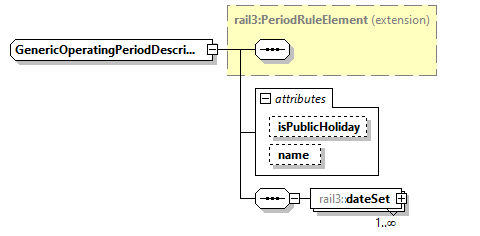 | ||||||||||||||||||
| namespace | https://www.railml.org/schemas/3.2 | ||||||||||||||||||
| type | extension of rail3:PeriodRuleElement | ||||||||||||||||||
| properties |
| ||||||||||||||||||
| children | rail3:dateSet | ||||||||||||||||||
| used by |
| ||||||||||||||||||
| attributes |
| ||||||||||||||||||
| source | <xs:complexType name="GenericOperatingPeriodDescription"> <xs:complexContent> <xs:extension base="rail3:PeriodRuleElement"> <xs:sequence> <xs:element name="dateSet" type="rail3:DateWithBitmask" minOccurs="1" maxOccurs="unbounded"/> </xs:sequence> <xs:attribute name="isPublicHoliday" type="xs:boolean" use="optional"/> <xs:attribute name="name" type="xs:string" use="optional"/> </xs:extension> </xs:complexContent> </xs:complexType> |
attribute GenericOperatingPeriodDescription/@isPublicHoliday
| type | xs:boolean | ||
| properties |
| ||
| source | <xs:attribute name="isPublicHoliday" type="xs:boolean" use="optional"/> |
attribute GenericOperatingPeriodDescription/@name
| type | xs:string | ||
| properties |
| ||
| source | <xs:attribute name="name" type="xs:string" use="optional"/> |
element GenericOperatingPeriodDescription/dateSet
| diagram | 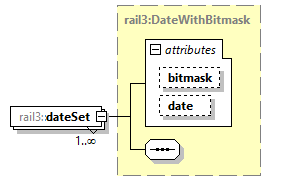 | ||||||||||||||||||
| namespace | https://www.railml.org/schemas/3.2 | ||||||||||||||||||
| type | rail3:DateWithBitmask | ||||||||||||||||||
| properties |
| ||||||||||||||||||
| attributes |
| ||||||||||||||||||
| source | <xs:element name="dateSet" type="rail3:DateWithBitmask" minOccurs="1" maxOccurs="unbounded"/> |
complexType GenericTimePeriod
| diagram |  | ||
| namespace | https://www.railml.org/schemas/3.2 | ||
| type | extension of rail3:TimePeriodBase | ||
| properties |
| ||
| children | rail3:containedSituation | ||
| used by |
| ||
| source | <xs:complexType name="GenericTimePeriod"> <xs:complexContent> <xs:extension base="rail3:TimePeriodBase"> <xs:sequence> <xs:element name="containedSituation" type="rail3:TimePeriodRuleSituation" minOccurs="1" maxOccurs="unbounded"/> </xs:sequence> </xs:extension> </xs:complexContent> </xs:complexType> |
element GenericTimePeriod/containedSituation
| diagram | 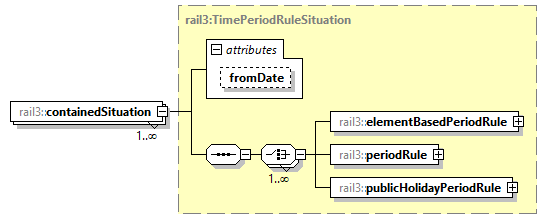 | ||||||||||||
| namespace | https://www.railml.org/schemas/3.2 | ||||||||||||
| type | rail3:TimePeriodRuleSituation | ||||||||||||
| properties |
| ||||||||||||
| children | rail3:elementBasedPeriodRule rail3:periodRule rail3:publicHolidayPeriodRule | ||||||||||||
| attributes |
| ||||||||||||
| source | <xs:element name="containedSituation" type="rail3:TimePeriodRuleSituation" minOccurs="1" maxOccurs="unbounded"/> |
complexType Name
| diagram | 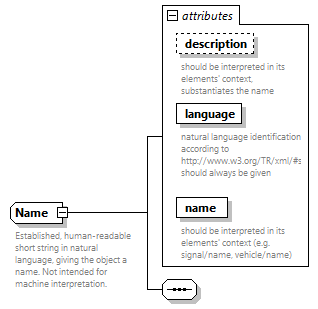 | ||||||||||||||||||||||||||||||
| namespace | https://www.railml.org/schemas/3.2 | ||||||||||||||||||||||||||||||
| used by |
| ||||||||||||||||||||||||||||||
| attributes |
| ||||||||||||||||||||||||||||||
| annotation |
| ||||||||||||||||||||||||||||||
| source | <xs:complexType name="Name"> <xs:annotation> <xs:documentation>Established, human-readable short string in natural language, giving the object a name. Not intended for machine interpretation.</xs:documentation> </xs:annotation> <xs:sequence/> <xs:attribute name="description" type="xs:string" use="optional"> <xs:annotation> <xs:documentation>should be interpreted in its elements' context, substantiates the name</xs:documentation> </xs:annotation> </xs:attribute> <xs:attribute name="language" type="xs:language" use="required"> <xs:annotation> <xs:documentation>natural language identification according to http://www.w3.org/TR/xml/#sec-lang-tag; should always be given</xs:documentation> </xs:annotation> </xs:attribute> <xs:attribute name="name" type="xs:string" use="required"> <xs:annotation> <xs:documentation>should be interpreted in its elements' context (e.g. signal/name, vehicle/name)</xs:documentation> </xs:annotation> </xs:attribute> </xs:complexType> |
attribute Name/@description
| type | xs:string | ||
| properties |
| ||
| annotation |
| ||
| source | <xs:attribute name="description" type="xs:string" use="optional"> <xs:annotation> <xs:documentation>should be interpreted in its elements' context, substantiates the name</xs:documentation> </xs:annotation> </xs:attribute> |
attribute Name/@language
| type | xs:language | ||
| properties |
| ||
| annotation |
| ||
| source | <xs:attribute name="language" type="xs:language" use="required"> <xs:annotation> <xs:documentation>natural language identification according to http://www.w3.org/TR/xml/#sec-lang-tag; should always be given</xs:documentation> </xs:annotation> </xs:attribute> |
attribute Name/@name
| type | xs:string | ||
| properties |
| ||
| annotation |
| ||
| source | <xs:attribute name="name" type="xs:string" use="required"> <xs:annotation> <xs:documentation>should be interpreted in its elements' context (e.g. signal/name, vehicle/name)</xs:documentation> </xs:annotation> </xs:attribute> |
complexType OperatingDay
| diagram | 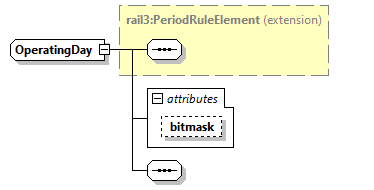 | ||||||||||||
| namespace | https://www.railml.org/schemas/3.2 | ||||||||||||
| type | extension of rail3:PeriodRuleElement | ||||||||||||
| properties |
| ||||||||||||
| used by |
| ||||||||||||
| attributes |
| ||||||||||||
| source | <xs:complexType name="OperatingDay"> <xs:complexContent> <xs:extension base="rail3:PeriodRuleElement"> <xs:sequence/> <xs:attribute name="bitmask" type="rail3:tBitmaskWeek" use="optional"/> </xs:extension> </xs:complexContent> </xs:complexType> |
attribute OperatingDay/@bitmask
| type | rail3:tBitmaskWeek | |||||||||
| properties |
| |||||||||
| facets |
| |||||||||
| source | <xs:attribute name="bitmask" type="rail3:tBitmaskWeek" use="optional"/> |
complexType PassengerFacilities
| diagram | 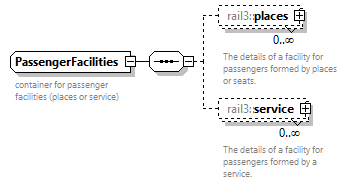 | ||
| namespace | https://www.railml.org/schemas/3.2 | ||
| children | rail3:places rail3:service | ||
| used by |
| ||
| annotation |
| ||
| source | <xs:complexType name="PassengerFacilities"> <xs:annotation> <xs:documentation>container for passenger facilities (places or service)</xs:documentation> </xs:annotation> <xs:sequence> <xs:element name="places" type="rail3:Places" minOccurs="0" maxOccurs="unbounded"> <xs:annotation> <xs:documentation>The details of a facility for passengers formed by places or seats.</xs:documentation> </xs:annotation> </xs:element> <xs:element name="service" type="rail3:Service" minOccurs="0" maxOccurs="unbounded"> <xs:annotation> <xs:documentation>The details of a facility for passengers formed by a service.</xs:documentation> </xs:annotation> </xs:element> </xs:sequence> </xs:complexType> |
element PassengerFacilities/places
| diagram | 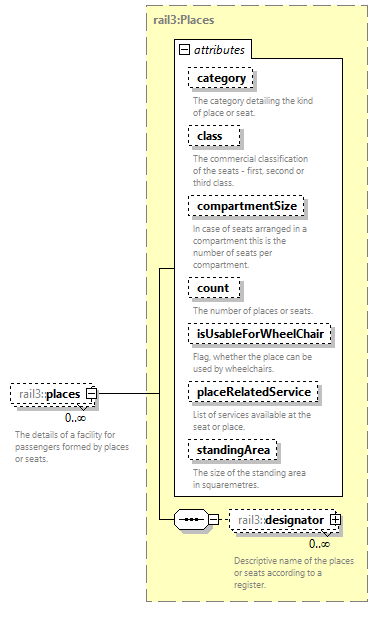 | ||||||||||||||||||||||||||||||||||||||||||||||||||||||||||||||
| namespace | https://www.railml.org/schemas/3.2 | ||||||||||||||||||||||||||||||||||||||||||||||||||||||||||||||
| type | rail3:Places | ||||||||||||||||||||||||||||||||||||||||||||||||||||||||||||||
| properties |
| ||||||||||||||||||||||||||||||||||||||||||||||||||||||||||||||
| children | rail3:designator | ||||||||||||||||||||||||||||||||||||||||||||||||||||||||||||||
| attributes |
| ||||||||||||||||||||||||||||||||||||||||||||||||||||||||||||||
| annotation |
| ||||||||||||||||||||||||||||||||||||||||||||||||||||||||||||||
| source | <xs:element name="places" type="rail3:Places" minOccurs="0" maxOccurs="unbounded"> <xs:annotation> <xs:documentation>The details of a facility for passengers formed by places or seats.</xs:documentation> </xs:annotation> </xs:element> |
element PassengerFacilities/service
| diagram | 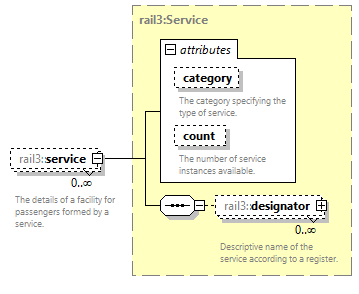 | ||||||||||||||||||||||
| namespace | https://www.railml.org/schemas/3.2 | ||||||||||||||||||||||
| type | rail3:Service | ||||||||||||||||||||||
| properties |
| ||||||||||||||||||||||
| children | rail3:designator | ||||||||||||||||||||||
| attributes |
| ||||||||||||||||||||||
| annotation |
| ||||||||||||||||||||||
| source | <xs:element name="service" type="rail3:Service" minOccurs="0" maxOccurs="unbounded"> <xs:annotation> <xs:documentation>The details of a facility for passengers formed by a service.</xs:documentation> </xs:annotation> </xs:element> |
complexType Period
| diagram | 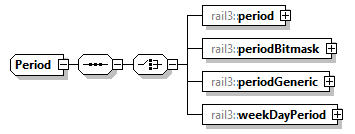 | ||
| namespace | https://www.railml.org/schemas/3.2 | ||
| children | rail3:period rail3:periodBitmask rail3:periodGeneric rail3:weekDayPeriod | ||
| used by |
| ||
| source | <xs:complexType name="Period"> <xs:sequence> <xs:choice minOccurs="1" maxOccurs="1"> <xs:element name="period" type="rail3:CalendarTimePeriod" minOccurs="1" maxOccurs="1"/> <xs:element name="periodBitmask" type="rail3:CalendarTimePeriodWithBitmask" minOccurs="1" maxOccurs="1"/> <xs:element name="periodGeneric" type="rail3:GenericTimePeriod" minOccurs="1" maxOccurs="1"/> <xs:element name="weekDayPeriod" type="rail3:WeekDayPeriodWithTime" minOccurs="1" maxOccurs="1"/> </xs:choice> </xs:sequence> </xs:complexType> |
element Period/period
| diagram | 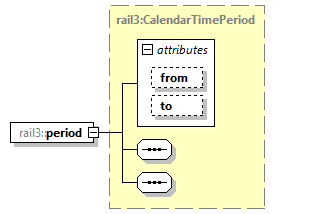 | ||||||||||||||||||
| namespace | https://www.railml.org/schemas/3.2 | ||||||||||||||||||
| type | rail3:CalendarTimePeriod | ||||||||||||||||||
| properties |
| ||||||||||||||||||
| attributes |
| ||||||||||||||||||
| source | <xs:element name="period" type="rail3:CalendarTimePeriod" minOccurs="1" maxOccurs="1"/> |
element Period/periodBitmask
| diagram | 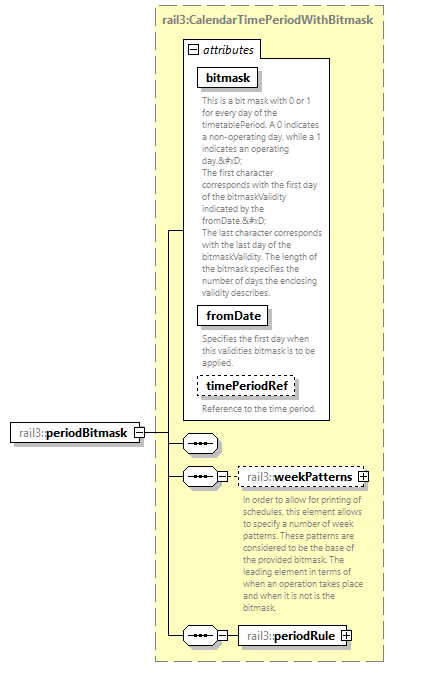 | ||||||||||||||||||||||||||||||
| namespace | https://www.railml.org/schemas/3.2 | ||||||||||||||||||||||||||||||
| type | rail3:CalendarTimePeriodWithBitmask | ||||||||||||||||||||||||||||||
| properties |
| ||||||||||||||||||||||||||||||
| children | rail3:weekPatterns rail3:periodRule | ||||||||||||||||||||||||||||||
| attributes |
| ||||||||||||||||||||||||||||||
| source | <xs:element name="periodBitmask" type="rail3:CalendarTimePeriodWithBitmask" minOccurs="1" maxOccurs="1"/> |
element Period/periodGeneric
| diagram |  | ||
| namespace | https://www.railml.org/schemas/3.2 | ||
| type | rail3:GenericTimePeriod | ||
| properties |
| ||
| children | rail3:containedSituation | ||
| source | <xs:element name="periodGeneric" type="rail3:GenericTimePeriod" minOccurs="1" maxOccurs="1"/> |
element Period/weekDayPeriod
| diagram | 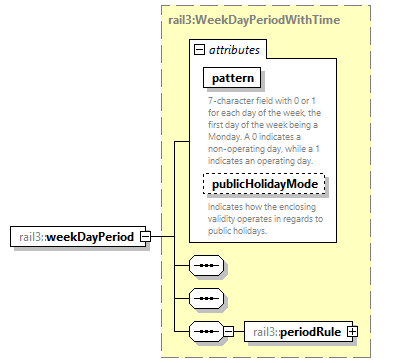 | ||||||||||||||||||||||
| namespace | https://www.railml.org/schemas/3.2 | ||||||||||||||||||||||
| type | rail3:WeekDayPeriodWithTime | ||||||||||||||||||||||
| properties |
| ||||||||||||||||||||||
| children | rail3:periodRule | ||||||||||||||||||||||
| attributes |
| ||||||||||||||||||||||
| source | <xs:element name="weekDayPeriod" type="rail3:WeekDayPeriodWithTime" minOccurs="1" maxOccurs="1"/> |
complexType PeriodRule
| diagram | 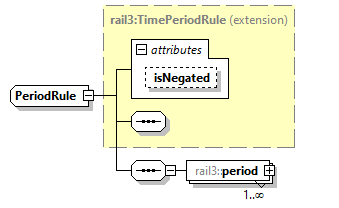 | ||||||||||||
| namespace | https://www.railml.org/schemas/3.2 | ||||||||||||
| type | extension of rail3:TimePeriodRule | ||||||||||||
| properties |
| ||||||||||||
| children | rail3:period | ||||||||||||
| used by |
| ||||||||||||
| attributes |
| ||||||||||||
| source | <xs:complexType name="PeriodRule"> <xs:complexContent> <xs:extension base="rail3:TimePeriodRule"> <xs:sequence> <xs:element name="period" type="rail3:ClockTimePeriod" minOccurs="1" maxOccurs="unbounded"/> </xs:sequence> </xs:extension> </xs:complexContent> </xs:complexType> |
element PeriodRule/period
| diagram | 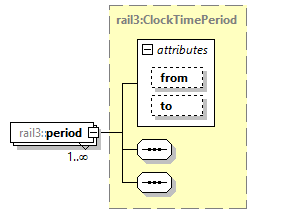 | ||||||||||||||||||
| namespace | https://www.railml.org/schemas/3.2 | ||||||||||||||||||
| type | rail3:ClockTimePeriod | ||||||||||||||||||
| properties |
| ||||||||||||||||||
| attributes |
| ||||||||||||||||||
| source | <xs:element name="period" type="rail3:ClockTimePeriod" minOccurs="1" maxOccurs="unbounded"/> |
complexType PeriodRuleElement
| diagram |  | ||
| namespace | https://www.railml.org/schemas/3.2 | ||
| properties |
| ||
| used by |
| ||
| source | <xs:complexType name="PeriodRuleElement" abstract="true"> <xs:sequence/> </xs:complexType> |
complexType Places
| diagram | 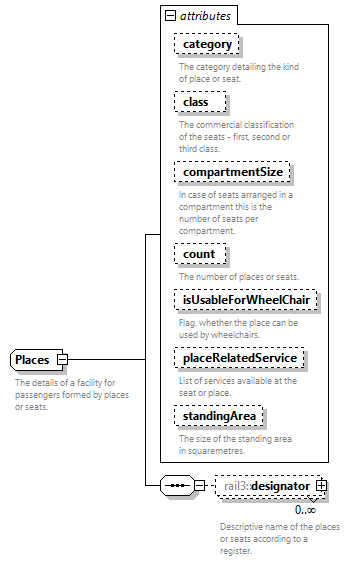 | ||||||||||||||||||||||||||||||||||||||||||||||||||||||||||||||
| namespace | https://www.railml.org/schemas/3.2 | ||||||||||||||||||||||||||||||||||||||||||||||||||||||||||||||
| children | rail3:designator | ||||||||||||||||||||||||||||||||||||||||||||||||||||||||||||||
| used by |
| ||||||||||||||||||||||||||||||||||||||||||||||||||||||||||||||
| attributes |
| ||||||||||||||||||||||||||||||||||||||||||||||||||||||||||||||
| annotation |
| ||||||||||||||||||||||||||||||||||||||||||||||||||||||||||||||
| source | <xs:complexType name="Places"> <xs:annotation> <xs:documentation>The details of a facility for passengers formed by places or seats.</xs:documentation> </xs:annotation> <xs:sequence> <xs:element name="designator" type="rail3:Designator" minOccurs="0" maxOccurs="unbounded"> <xs:annotation> <xs:documentation>Descriptive name of the places or seats according to a register.</xs:documentation> </xs:annotation> </xs:element> </xs:sequence> <xs:attribute name="category" type="rail3:tPlacesCategoryListExt" use="optional"> <xs:annotation> <xs:documentation>The category detailing the kind of place or seat.</xs:documentation> </xs:annotation> </xs:attribute> <xs:attribute name="class" type="rail3:tClassesListExt" use="optional"> <xs:annotation> <xs:documentation>The commercial classification of the seats - first, second or third class.</xs:documentation> </xs:annotation> </xs:attribute> <xs:attribute name="compartmentSize" type="xs:positiveInteger" use="optional"> <xs:annotation> <xs:documentation>In case of seats arranged in a compartment this is the number of seats per compartment.</xs:documentation> </xs:annotation> </xs:attribute> <xs:attribute name="count" type="xs:positiveInteger" use="optional"> <xs:annotation> <xs:documentation>The number of places or seats.</xs:documentation> </xs:annotation> </xs:attribute> <xs:attribute name="isUsableForWheelChair" type="xs:boolean" use="optional"> <xs:annotation> <xs:documentation>Flag, whether the place can be used by wheelchairs.</xs:documentation> </xs:annotation> </xs:attribute> <xs:attribute name="placeRelatedService" type="rail3:tServiceCategoryListExt" use="optional"> <xs:annotation> <xs:documentation>List of services available at the seat or place.</xs:documentation> </xs:annotation> </xs:attribute> <xs:attribute name="standingArea" type="xs:double" use="optional"> <xs:annotation> <xs:documentation>The size of the standing area in squaremetres.</xs:documentation> </xs:annotation> </xs:attribute> </xs:complexType> |
attribute Places/@category
| type | rail3:tPlacesCategoryListExt | ||
| properties |
| ||
| annotation |
| ||
| source | <xs:attribute name="category" type="rail3:tPlacesCategoryListExt" use="optional"> <xs:annotation> <xs:documentation>The category detailing the kind of place or seat.</xs:documentation> </xs:annotation> </xs:attribute> |
attribute Places/@class
| type | rail3:tClassesListExt | ||
| properties |
| ||
| annotation |
| ||
| source | <xs:attribute name="class" type="rail3:tClassesListExt" use="optional"> <xs:annotation> <xs:documentation>The commercial classification of the seats - first, second or third class.</xs:documentation> </xs:annotation> </xs:attribute> |
attribute Places/@compartmentSize
| type | xs:positiveInteger | ||
| properties |
| ||
| annotation |
| ||
| source | <xs:attribute name="compartmentSize" type="xs:positiveInteger" use="optional"> <xs:annotation> <xs:documentation>In case of seats arranged in a compartment this is the number of seats per compartment.</xs:documentation> </xs:annotation> </xs:attribute> |
attribute Places/@count
| type | xs:positiveInteger | ||
| properties |
| ||
| annotation |
| ||
| source | <xs:attribute name="count" type="xs:positiveInteger" use="optional"> <xs:annotation> <xs:documentation>The number of places or seats.</xs:documentation> </xs:annotation> </xs:attribute> |
attribute Places/@isUsableForWheelChair
| type | xs:boolean | ||
| properties |
| ||
| annotation |
| ||
| source | <xs:attribute name="isUsableForWheelChair" type="xs:boolean" use="optional"> <xs:annotation> <xs:documentation>Flag, whether the place can be used by wheelchairs.</xs:documentation> </xs:annotation> </xs:attribute> |
attribute Places/@placeRelatedService
| type | rail3:tServiceCategoryListExt | ||
| properties |
| ||
| annotation |
| ||
| source | <xs:attribute name="placeRelatedService" type="rail3:tServiceCategoryListExt" use="optional"> <xs:annotation> <xs:documentation>List of services available at the seat or place.</xs:documentation> </xs:annotation> </xs:attribute> |
attribute Places/@standingArea
| type | xs:double | ||
| properties |
| ||
| annotation |
| ||
| source | <xs:attribute name="standingArea" type="xs:double" use="optional"> <xs:annotation> <xs:documentation>The size of the standing area in squaremetres.</xs:documentation> </xs:annotation> </xs:attribute> |
element Places/designator
| diagram | 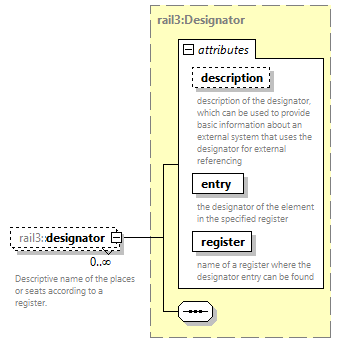 | ||||||||||||||||||||||||||||||
| namespace | https://www.railml.org/schemas/3.2 | ||||||||||||||||||||||||||||||
| type | rail3:Designator | ||||||||||||||||||||||||||||||
| properties |
| ||||||||||||||||||||||||||||||
| attributes |
| ||||||||||||||||||||||||||||||
| annotation |
| ||||||||||||||||||||||||||||||
| source | <xs:element name="designator" type="rail3:Designator" minOccurs="0" maxOccurs="unbounded"> <xs:annotation> <xs:documentation>Descriptive name of the places or seats according to a register.</xs:documentation> </xs:annotation> </xs:element> |
complexType PublicHolidayPeriodRule
| diagram | 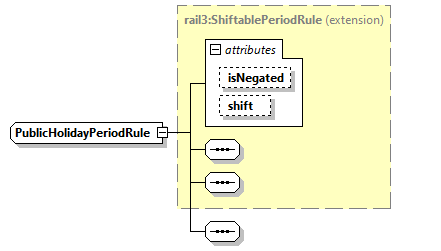 | ||||||||||||||||||
| namespace | https://www.railml.org/schemas/3.2 | ||||||||||||||||||
| type | extension of rail3:ShiftablePeriodRule | ||||||||||||||||||
| properties |
| ||||||||||||||||||
| used by |
| ||||||||||||||||||
| attributes |
| ||||||||||||||||||
| source | <xs:complexType name="PublicHolidayPeriodRule"> <xs:complexContent> <xs:extension base="rail3:ShiftablePeriodRule"> <xs:sequence/> </xs:extension> </xs:complexContent> </xs:complexType> |
complexType Service
| diagram | 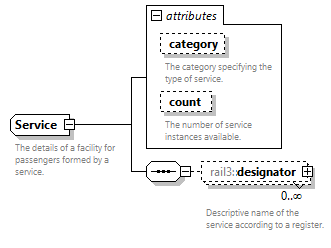 | ||||||||||||||||||||||
| namespace | https://www.railml.org/schemas/3.2 | ||||||||||||||||||||||
| children | rail3:designator | ||||||||||||||||||||||
| used by |
| ||||||||||||||||||||||
| attributes |
| ||||||||||||||||||||||
| annotation |
| ||||||||||||||||||||||
| source | <xs:complexType name="Service"> <xs:annotation> <xs:documentation>The details of a facility for passengers formed by a service.</xs:documentation> </xs:annotation> <xs:sequence> <xs:element name="designator" type="rail3:Designator" minOccurs="0" maxOccurs="unbounded"> <xs:annotation> <xs:documentation>Descriptive name of the service according to a register.</xs:documentation> </xs:annotation> </xs:element> </xs:sequence> <xs:attribute name="category" type="rail3:tServiceCategoryListExt" use="optional"> <xs:annotation> <xs:documentation>The category specifying the type of service.</xs:documentation> </xs:annotation> </xs:attribute> <xs:attribute name="count" type="xs:positiveInteger" use="optional"> <xs:annotation> <xs:documentation>The number of service instances available.</xs:documentation> </xs:annotation> </xs:attribute> </xs:complexType> |
attribute Service/@category
| type | rail3:tServiceCategoryListExt | ||
| properties |
| ||
| annotation |
| ||
| source | <xs:attribute name="category" type="rail3:tServiceCategoryListExt" use="optional"> <xs:annotation> <xs:documentation>The category specifying the type of service.</xs:documentation> </xs:annotation> </xs:attribute> |
attribute Service/@count
| type | xs:positiveInteger | ||
| properties |
| ||
| annotation |
| ||
| source | <xs:attribute name="count" type="xs:positiveInteger" use="optional"> <xs:annotation> <xs:documentation>The number of service instances available.</xs:documentation> </xs:annotation> </xs:attribute> |
element Service/designator
| diagram | 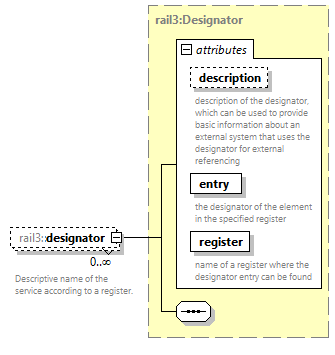 | ||||||||||||||||||||||||||||||
| namespace | https://www.railml.org/schemas/3.2 | ||||||||||||||||||||||||||||||
| type | rail3:Designator | ||||||||||||||||||||||||||||||
| properties |
| ||||||||||||||||||||||||||||||
| attributes |
| ||||||||||||||||||||||||||||||
| annotation |
| ||||||||||||||||||||||||||||||
| source | <xs:element name="designator" type="rail3:Designator" minOccurs="0" maxOccurs="unbounded"> <xs:annotation> <xs:documentation>Descriptive name of the service according to a register.</xs:documentation> </xs:annotation> </xs:element> |
complexType ShiftablePeriodRule
| diagram | 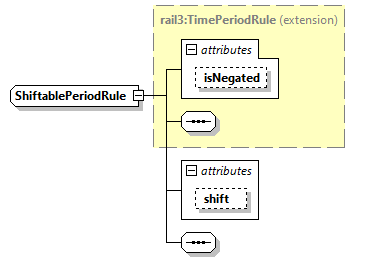 | ||||||||||||||||||
| namespace | https://www.railml.org/schemas/3.2 | ||||||||||||||||||
| type | extension of rail3:TimePeriodRule | ||||||||||||||||||
| properties |
| ||||||||||||||||||
| used by |
| ||||||||||||||||||
| attributes |
| ||||||||||||||||||
| source | <xs:complexType name="ShiftablePeriodRule"> <xs:complexContent> <xs:extension base="rail3:TimePeriodRule"> <xs:sequence/> <xs:attribute name="shift" type="xs:integer" use="optional"/> </xs:extension> </xs:complexContent> </xs:complexType> |
attribute ShiftablePeriodRule/@shift
| type | xs:integer | ||
| properties |
| ||
| source | <xs:attribute name="shift" type="xs:integer" use="optional"/> |
complexType tAuxiliaryBrakes
| diagram | 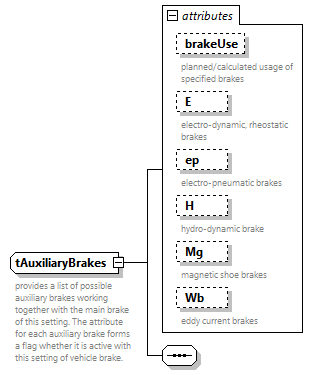 | ||||||||||||||||||||||||||||||||||||||||||||||||||||||
| namespace | https://www.railml.org/schemas/3.2 | ||||||||||||||||||||||||||||||||||||||||||||||||||||||
| used by |
| ||||||||||||||||||||||||||||||||||||||||||||||||||||||
| attributes |
| ||||||||||||||||||||||||||||||||||||||||||||||||||||||
| annotation |
| ||||||||||||||||||||||||||||||||||||||||||||||||||||||
| source | <xs:complexType name="tAuxiliaryBrakes"> <xs:annotation> <xs:documentation>provides a list of possible auxiliary brakes working together with the main brake of this setting. The attribute for each auxiliary brake forms a flag whether it is active with this setting of vehicle brake.</xs:documentation> </xs:annotation> <xs:sequence/> <xs:attribute name="brakeUse" type="rail3:tBrakeUseExt" use="optional"> <xs:annotation> <xs:documentation>planned/calculated usage of specified brakes</xs:documentation> </xs:annotation> </xs:attribute> <xs:attribute name="E" type="xs:boolean" use="optional"> <xs:annotation> <xs:documentation>electro-dynamic, rheostatic brakes</xs:documentation> </xs:annotation> </xs:attribute> <xs:attribute name="ep" type="xs:boolean" use="optional"> <xs:annotation> <xs:documentation>electro-pneumatic brakes</xs:documentation> </xs:annotation> </xs:attribute> <xs:attribute name="H" type="xs:boolean" use="optional"> <xs:annotation> <xs:documentation>hydro-dynamic brake</xs:documentation> </xs:annotation> </xs:attribute> <xs:attribute name="Mg" type="xs:boolean" use="optional"> <xs:annotation> <xs:documentation>magnetic shoe brakes</xs:documentation> </xs:annotation> </xs:attribute> <xs:attribute name="Wb" type="xs:boolean" use="optional"> <xs:annotation> <xs:documentation>eddy current brakes</xs:documentation> </xs:annotation> </xs:attribute> </xs:complexType> |
attribute tAuxiliaryBrakes/@brakeUse
| type | rail3:tBrakeUseExt | ||
| properties |
| ||
| annotation |
| ||
| source | <xs:attribute name="brakeUse" type="rail3:tBrakeUseExt" use="optional"> <xs:annotation> <xs:documentation>planned/calculated usage of specified brakes</xs:documentation> </xs:annotation> </xs:attribute> |
attribute tAuxiliaryBrakes/@E
| type | xs:boolean | ||
| properties |
| ||
| annotation |
| ||
| source | <xs:attribute name="E" type="xs:boolean" use="optional"> <xs:annotation> <xs:documentation>electro-dynamic, rheostatic brakes</xs:documentation> </xs:annotation> </xs:attribute> |
attribute tAuxiliaryBrakes/@ep
| type | xs:boolean | ||
| properties |
| ||
| annotation |
| ||
| source | <xs:attribute name="ep" type="xs:boolean" use="optional"> <xs:annotation> <xs:documentation>electro-pneumatic brakes</xs:documentation> </xs:annotation> </xs:attribute> |
attribute tAuxiliaryBrakes/@H
| type | xs:boolean | ||
| properties |
| ||
| annotation |
| ||
| source | <xs:attribute name="H" type="xs:boolean" use="optional"> <xs:annotation> <xs:documentation>hydro-dynamic brake</xs:documentation> </xs:annotation> </xs:attribute> |
attribute tAuxiliaryBrakes/@Mg
| type | xs:boolean | ||
| properties |
| ||
| annotation |
| ||
| source | <xs:attribute name="Mg" type="xs:boolean" use="optional"> <xs:annotation> <xs:documentation>magnetic shoe brakes</xs:documentation> </xs:annotation> </xs:attribute> |
attribute tAuxiliaryBrakes/@Wb
| type | xs:boolean | ||
| properties |
| ||
| annotation |
| ||
| source | <xs:attribute name="Wb" type="xs:boolean" use="optional"> <xs:annotation> <xs:documentation>eddy current brakes</xs:documentation> </xs:annotation> </xs:attribute> |
complexType tBrakeSystem
| diagram | 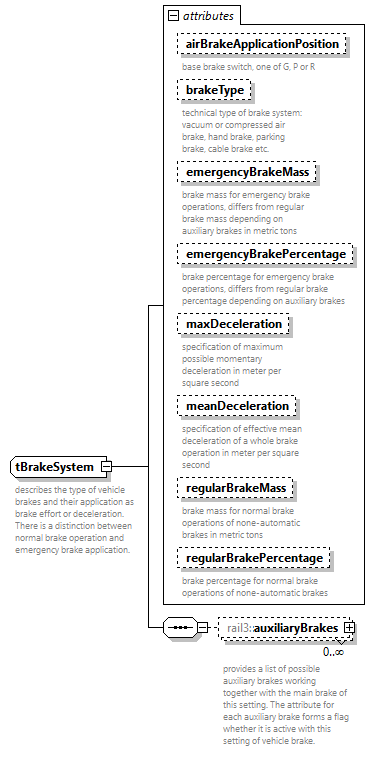 | ||||||||||||||||||||||||||||||||||||||||||||||||||||||||||||||||||||||
| namespace | https://www.railml.org/schemas/3.2 | ||||||||||||||||||||||||||||||||||||||||||||||||||||||||||||||||||||||
| children | rail3:auxiliaryBrakes | ||||||||||||||||||||||||||||||||||||||||||||||||||||||||||||||||||||||
| used by |
| ||||||||||||||||||||||||||||||||||||||||||||||||||||||||||||||||||||||
| attributes |
| ||||||||||||||||||||||||||||||||||||||||||||||||||||||||||||||||||||||
| annotation |
| ||||||||||||||||||||||||||||||||||||||||||||||||||||||||||||||||||||||
| source | <xs:complexType name="tBrakeSystem"> <xs:annotation> <xs:documentation>describes the type of vehicle brakes and their application as brake effort or deceleration. There is a distinction between normal brake operation and emergency brake application.</xs:documentation> </xs:annotation> <xs:sequence> <xs:element name="auxiliaryBrakes" type="rail3:tAuxiliaryBrakes" minOccurs="0" maxOccurs="unbounded"> <xs:annotation> <xs:documentation>provides a list of possible auxiliary brakes working together with the main brake of this setting. The attribute for each auxiliary brake forms a flag whether it is active with this setting of vehicle brake.</xs:documentation> </xs:annotation> </xs:element> </xs:sequence> <xs:attribute name="airBrakeApplicationPosition" type="rail3:tAirBrakeApplicationDirection" use="optional"> <xs:annotation> <xs:documentation>base brake switch, one of G, P or R</xs:documentation> </xs:annotation> </xs:attribute> <xs:attribute name="brakeType" type="rail3:tBrakeTypeExt" use="optional"> <xs:annotation> <xs:documentation>technical type of brake system: vacuum or compressed air brake, hand brake, parking brake, cable brake etc.</xs:documentation> </xs:annotation> </xs:attribute> <xs:attribute name="emergencyBrakeMass" type="rail3:tWeightTons" use="optional"> <xs:annotation> <xs:documentation>brake mass for emergency brake operations, differs from regular brake mass depending on auxiliary brakes in metric tons</xs:documentation> </xs:annotation> </xs:attribute> <xs:attribute name="emergencyBrakePercentage" type="rail3:tBrakePercentage" use="optional"> <xs:annotation> <xs:documentation>brake percentage for emergency brake operations, differs from regular brake percentage depending on auxiliary brakes</xs:documentation> </xs:annotation> </xs:attribute> <xs:attribute name="maxDeceleration" type="rail3:tAccelerationMeterPerSquareSec" use="optional"> <xs:annotation> <xs:documentation>specification of maximum possible momentary deceleration in meter per square second</xs:documentation> </xs:annotation> </xs:attribute> <xs:attribute name="meanDeceleration" type="rail3:tAccelerationMeterPerSquareSec" use="optional"> <xs:annotation> <xs:documentation>specification of effective mean deceleration of a whole brake operation in meter per square second</xs:documentation> </xs:annotation> </xs:attribute> <xs:attribute name="regularBrakeMass" type="rail3:tWeightTons" use="optional"> <xs:annotation> <xs:documentation>brake mass for normal brake operations of none-automatic brakes in metric tons</xs:documentation> </xs:annotation> </xs:attribute> <xs:attribute name="regularBrakePercentage" type="rail3:tBrakePercentage" use="optional"> <xs:annotation> <xs:documentation>brake percentage for normal brake operations of none-automatic brakes</xs:documentation> </xs:annotation> </xs:attribute> </xs:complexType> |
attribute tBrakeSystem/@airBrakeApplicationPosition
| type | rail3:tAirBrakeApplicationDirection | |||||||||||||||||||||
| properties |
| |||||||||||||||||||||
| facets |
| |||||||||||||||||||||
| annotation |
| |||||||||||||||||||||
| source | <xs:attribute name="airBrakeApplicationPosition" type="rail3:tAirBrakeApplicationDirection" use="optional"> <xs:annotation> <xs:documentation>base brake switch, one of G, P or R</xs:documentation> </xs:annotation> </xs:attribute> |
attribute tBrakeSystem/@brakeType
| type | rail3:tBrakeTypeExt | ||
| properties |
| ||
| annotation |
| ||
| source | <xs:attribute name="brakeType" type="rail3:tBrakeTypeExt" use="optional"> <xs:annotation> <xs:documentation>technical type of brake system: vacuum or compressed air brake, hand brake, parking brake, cable brake etc.</xs:documentation> </xs:annotation> </xs:attribute> |
attribute tBrakeSystem/@emergencyBrakeMass
| type | rail3:tWeightTons | ||
| properties |
| ||
| annotation |
| ||
| source | <xs:attribute name="emergencyBrakeMass" type="rail3:tWeightTons" use="optional"> <xs:annotation> <xs:documentation>brake mass for emergency brake operations, differs from regular brake mass depending on auxiliary brakes in metric tons</xs:documentation> </xs:annotation> </xs:attribute> |
attribute tBrakeSystem/@emergencyBrakePercentage
| type | rail3:tBrakePercentage | |||||||||
| properties |
| |||||||||
| facets |
| |||||||||
| annotation |
| |||||||||
| source | <xs:attribute name="emergencyBrakePercentage" type="rail3:tBrakePercentage" use="optional"> <xs:annotation> <xs:documentation>brake percentage for emergency brake operations, differs from regular brake percentage depending on auxiliary brakes</xs:documentation> </xs:annotation> </xs:attribute> |
attribute tBrakeSystem/@maxDeceleration
| type | rail3:tAccelerationMeterPerSquareSec | ||
| properties |
| ||
| annotation |
| ||
| source | <xs:attribute name="maxDeceleration" type="rail3:tAccelerationMeterPerSquareSec" use="optional"> <xs:annotation> <xs:documentation>specification of maximum possible momentary deceleration in meter per square second</xs:documentation> </xs:annotation> </xs:attribute> |
attribute tBrakeSystem/@meanDeceleration
| type | rail3:tAccelerationMeterPerSquareSec | ||
| properties |
| ||
| annotation |
| ||
| source | <xs:attribute name="meanDeceleration" type="rail3:tAccelerationMeterPerSquareSec" use="optional"> <xs:annotation> <xs:documentation>specification of effective mean deceleration of a whole brake operation in meter per square second</xs:documentation> </xs:annotation> </xs:attribute> |
attribute tBrakeSystem/@regularBrakeMass
| type | rail3:tWeightTons | ||
| properties |
| ||
| annotation |
| ||
| source | <xs:attribute name="regularBrakeMass" type="rail3:tWeightTons" use="optional"> <xs:annotation> <xs:documentation>brake mass for normal brake operations of none-automatic brakes in metric tons</xs:documentation> </xs:annotation> </xs:attribute> |
attribute tBrakeSystem/@regularBrakePercentage
| type | rail3:tBrakePercentage | |||||||||
| properties |
| |||||||||
| facets |
| |||||||||
| annotation |
| |||||||||
| source | <xs:attribute name="regularBrakePercentage" type="rail3:tBrakePercentage" use="optional"> <xs:annotation> <xs:documentation>brake percentage for normal brake operations of none-automatic brakes</xs:documentation> </xs:annotation> </xs:attribute> |
element tBrakeSystem/auxiliaryBrakes
| diagram | 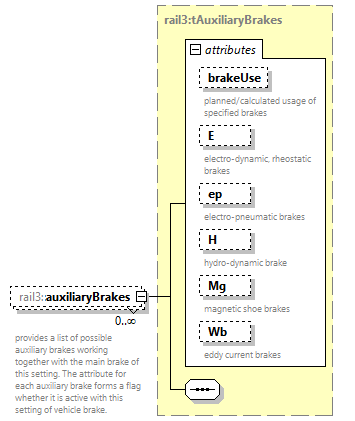 | ||||||||||||||||||||||||||||||||||||||||||||||||||||||
| namespace | https://www.railml.org/schemas/3.2 | ||||||||||||||||||||||||||||||||||||||||||||||||||||||
| type | rail3:tAuxiliaryBrakes | ||||||||||||||||||||||||||||||||||||||||||||||||||||||
| properties |
| ||||||||||||||||||||||||||||||||||||||||||||||||||||||
| attributes |
| ||||||||||||||||||||||||||||||||||||||||||||||||||||||
| annotation |
| ||||||||||||||||||||||||||||||||||||||||||||||||||||||
| source | <xs:element name="auxiliaryBrakes" type="rail3:tAuxiliaryBrakes" minOccurs="0" maxOccurs="unbounded"> <xs:annotation> <xs:documentation>provides a list of possible auxiliary brakes working together with the main brake of this setting. The attribute for each auxiliary brake forms a flag whether it is active with this setting of vehicle brake.</xs:documentation> </xs:annotation> </xs:element> |
complexType tElementBitmaskAny
| diagram | 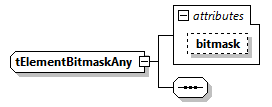 | ||||||||||||
| namespace | https://www.railml.org/schemas/3.2 | ||||||||||||
| attributes |
| ||||||||||||
| source | <xs:complexType name="tElementBitmaskAny"> <xs:sequence/> <xs:attribute name="bitmask" type="rail3:tBitmaskAny" use="optional"/> </xs:complexType> |
attribute tElementBitmaskAny/@bitmask
| type | rail3:tBitmaskAny | ||||||
| properties |
| ||||||
| facets |
| ||||||
| source | <xs:attribute name="bitmask" type="rail3:tBitmaskAny" use="optional"/> |
complexType tElementBitmaskWeek
| diagram | 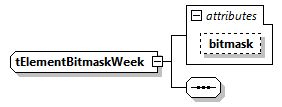 | ||||||||||||
| namespace | https://www.railml.org/schemas/3.2 | ||||||||||||
| attributes |
| ||||||||||||
| source | <xs:complexType name="tElementBitmaskWeek"> <xs:sequence/> <xs:attribute name="bitmask" type="rail3:tBitmaskWeek" use="optional"/> </xs:complexType> |
attribute tElementBitmaskWeek/@bitmask
| type | rail3:tBitmaskWeek | |||||||||
| properties |
| |||||||||
| facets |
| |||||||||
| source | <xs:attribute name="bitmask" type="rail3:tBitmaskWeek" use="optional"/> |
complexType tElementTimeStamp
| diagram | 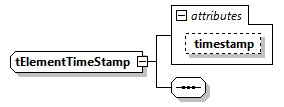 | ||||||||||||
| namespace | https://www.railml.org/schemas/3.2 | ||||||||||||
| attributes |
| ||||||||||||
| source | <xs:complexType name="tElementTimeStamp"> <xs:sequence/> <xs:attribute name="timestamp" type="xs:dateTime" use="optional"/> </xs:complexType> |
attribute tElementTimeStamp/@timestamp
| type | xs:dateTime | ||
| properties |
| ||
| source | <xs:attribute name="timestamp" type="xs:dateTime" use="optional"/> |
complexType tElementWithID
| diagram | 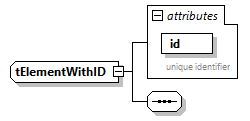 | ||||||||||||||
| namespace | https://www.railml.org/schemas/3.2 | ||||||||||||||
| properties |
| ||||||||||||||
| used by |
| ||||||||||||||
| attributes |
| ||||||||||||||
| source | <xs:complexType name="tElementWithID" abstract="true"> <xs:sequence/> <xs:attribute name="id" type="rail3:tID" use="required"> <xs:annotation> <xs:documentation>unique identifier</xs:documentation> </xs:annotation> </xs:attribute> </xs:complexType> |
attribute tElementWithID/@id
| type | rail3:tID | ||
| properties |
| ||
| annotation |
| ||
| source | <xs:attribute name="id" type="rail3:tID" use="required"> <xs:annotation> <xs:documentation>unique identifier</xs:documentation> </xs:annotation> </xs:attribute> |
complexType tElementWithIDandCode
| diagram | 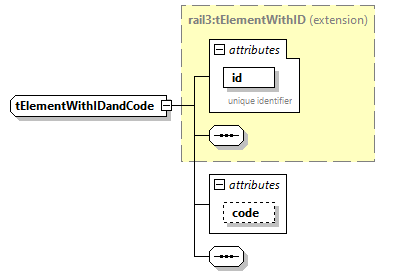 | ||||||||||||||||||||
| namespace | https://www.railml.org/schemas/3.2 | ||||||||||||||||||||
| type | extension of rail3:tElementWithID | ||||||||||||||||||||
| properties |
| ||||||||||||||||||||
| attributes |
| ||||||||||||||||||||
| source | <xs:complexType name="tElementWithIDandCode"> <xs:complexContent> <xs:extension base="rail3:tElementWithID"> <xs:sequence/> <xs:attribute name="code" type="xs:string" use="optional"/> </xs:extension> </xs:complexContent> </xs:complexType> |
attribute tElementWithIDandCode/@code
| type | xs:string | ||
| properties |
| ||
| source | <xs:attribute name="code" type="xs:string" use="optional"/> |
complexType tElementWithIDandName
| diagram | 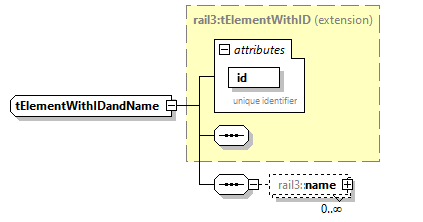 | ||||||||||||||
| namespace | https://www.railml.org/schemas/3.2 | ||||||||||||||
| type | extension of rail3:tElementWithID | ||||||||||||||
| properties |
| ||||||||||||||
| children | rail3:name | ||||||||||||||
| used by |
| ||||||||||||||
| attributes |
| ||||||||||||||
| source | <xs:complexType name="tElementWithIDandName" abstract="true"> <xs:complexContent> <xs:extension base="rail3:tElementWithID"> <xs:sequence> <xs:element name="name" type="rail3:Name" minOccurs="0" maxOccurs="unbounded"/> </xs:sequence> </xs:extension> </xs:complexContent> </xs:complexType> |
element tElementWithIDandName/name
| diagram | 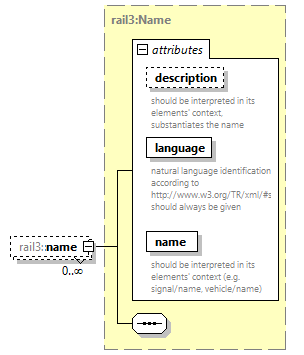 | ||||||||||||||||||||||||||||||
| namespace | https://www.railml.org/schemas/3.2 | ||||||||||||||||||||||||||||||
| type | rail3:Name | ||||||||||||||||||||||||||||||
| properties |
| ||||||||||||||||||||||||||||||
| attributes |
| ||||||||||||||||||||||||||||||
| source | <xs:element name="name" type="rail3:Name" minOccurs="0" maxOccurs="unbounded"/> |
complexType tElementWithIDref
| diagram | 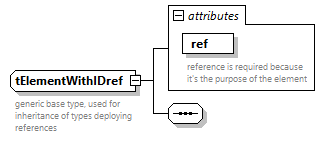 | ||||||||||||||
| namespace | https://www.railml.org/schemas/3.2 | ||||||||||||||
| used by |
| ||||||||||||||
| attributes |
| ||||||||||||||
| annotation |
| ||||||||||||||
| source | <xs:complexType name="tElementWithIDref"> <xs:annotation> <xs:documentation>generic base type, used for inheritance of types deploying references</xs:documentation> </xs:annotation> <xs:sequence/> <xs:attribute name="ref" type="rail3:tRef" use="required"> <xs:annotation> <xs:documentation>reference is required because it's the purpose of the element</xs:documentation> </xs:annotation> </xs:attribute> </xs:complexType> |
attribute tElementWithIDref/@ref
| type | rail3:tRef | ||
| properties |
| ||
| annotation |
| ||
| source | <xs:attribute name="ref" type="rail3:tRef" use="required"> <xs:annotation> <xs:documentation>reference is required because it's the purpose of the element</xs:documentation> </xs:annotation> </xs:attribute> |
complexType TimePeriodBase
| diagram |  | ||
| namespace | https://www.railml.org/schemas/3.2 | ||
| properties |
| ||
| used by |
| ||
| source | <xs:complexType name="TimePeriodBase" abstract="true"> <xs:sequence/> </xs:complexType> |
complexType TimePeriodRule
| diagram | 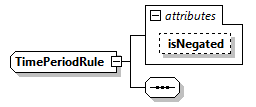 | ||||||||||||
| namespace | https://www.railml.org/schemas/3.2 | ||||||||||||
| properties |
| ||||||||||||
| used by |
| ||||||||||||
| attributes |
| ||||||||||||
| source | <xs:complexType name="TimePeriodRule" abstract="true"> <xs:sequence/> <xs:attribute name="isNegated" type="xs:boolean" use="optional"/> </xs:complexType> |
attribute TimePeriodRule/@isNegated
| type | xs:boolean | ||
| properties |
| ||
| source | <xs:attribute name="isNegated" type="xs:boolean" use="optional"/> |
complexType TimePeriodRuleSituation
| diagram |  | ||||||||||||
| namespace | https://www.railml.org/schemas/3.2 | ||||||||||||
| children | rail3:elementBasedPeriodRule rail3:periodRule rail3:publicHolidayPeriodRule | ||||||||||||
| used by |
| ||||||||||||
| attributes |
| ||||||||||||
| source | <xs:complexType name="TimePeriodRuleSituation"> <xs:sequence> <xs:choice minOccurs="1" maxOccurs="unbounded"> <xs:element name="elementBasedPeriodRule" type="rail3:ElemBasedPeriodRule" minOccurs="1" maxOccurs="1"/> <xs:element name="periodRule" type="rail3:PeriodRule" minOccurs="1" maxOccurs="1"/> <xs:element name="publicHolidayPeriodRule" type="rail3:PublicHolidayPeriodRule" minOccurs="1" maxOccurs="1"/> </xs:choice> </xs:sequence> <xs:attribute name="fromDate" type="xs:date" use="optional"/> </xs:complexType> |
attribute TimePeriodRuleSituation/@fromDate
| type | xs:date | ||
| properties |
| ||
| source | <xs:attribute name="fromDate" type="xs:date" use="optional"/> |
element TimePeriodRuleSituation/elementBasedPeriodRule
| diagram | 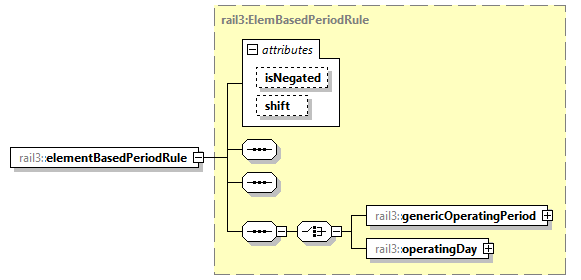 | ||||||||||||||||||
| namespace | https://www.railml.org/schemas/3.2 | ||||||||||||||||||
| type | rail3:ElemBasedPeriodRule | ||||||||||||||||||
| properties |
| ||||||||||||||||||
| children | rail3:genericOperatingPeriod rail3:operatingDay | ||||||||||||||||||
| attributes |
| ||||||||||||||||||
| source | <xs:element name="elementBasedPeriodRule" type="rail3:ElemBasedPeriodRule" minOccurs="1" maxOccurs="1"/> |
element TimePeriodRuleSituation/periodRule
| diagram | 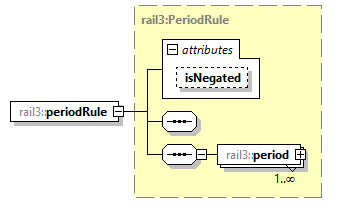 | ||||||||||||
| namespace | https://www.railml.org/schemas/3.2 | ||||||||||||
| type | rail3:PeriodRule | ||||||||||||
| properties |
| ||||||||||||
| children | rail3:period | ||||||||||||
| attributes |
| ||||||||||||
| source | <xs:element name="periodRule" type="rail3:PeriodRule" minOccurs="1" maxOccurs="1"/> |
element TimePeriodRuleSituation/publicHolidayPeriodRule
| diagram | 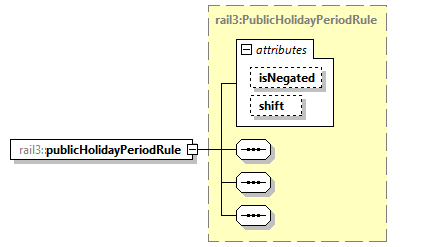 | ||||||||||||||||||
| namespace | https://www.railml.org/schemas/3.2 | ||||||||||||||||||
| type | rail3:PublicHolidayPeriodRule | ||||||||||||||||||
| properties |
| ||||||||||||||||||
| attributes |
| ||||||||||||||||||
| source | <xs:element name="publicHolidayPeriodRule" type="rail3:PublicHolidayPeriodRule" minOccurs="1" maxOccurs="1"/> |
complexType TimeStamp
| diagram | 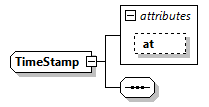 | ||||||||||||
| namespace | https://www.railml.org/schemas/3.2 | ||||||||||||
| attributes |
| ||||||||||||
| source | <xs:complexType name="TimeStamp"> <xs:sequence/> <xs:attribute name="at" type="xs:dateTime" use="optional"/> </xs:complexType> |
attribute TimeStamp/@at
| type | xs:dateTime | ||
| properties |
| ||
| source | <xs:attribute name="at" type="xs:dateTime" use="optional"/> |
complexType WeekDayPeriod
| diagram | 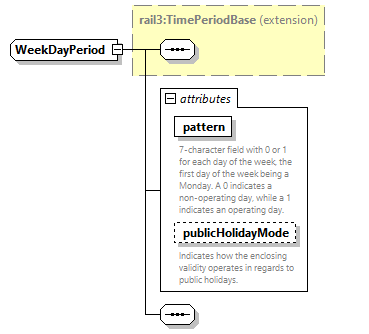 | ||||||||||||||||||||||
| namespace | https://www.railml.org/schemas/3.2 | ||||||||||||||||||||||
| type | extension of rail3:TimePeriodBase | ||||||||||||||||||||||
| properties |
| ||||||||||||||||||||||
| used by |
| ||||||||||||||||||||||
| attributes |
| ||||||||||||||||||||||
| source | <xs:complexType name="WeekDayPeriod"> <xs:complexContent> <xs:extension base="rail3:TimePeriodBase"> <xs:sequence/> <xs:attribute name="pattern" type="rail3:tBitmaskWeek" use="required"> <xs:annotation> <xs:documentation>7-character field with 0 or 1 for each day of the week, the first day of the week being a Monday. A 0 indicates a non-operating day, while a 1 indicates an operating day. </xs:documentation> </xs:annotation> </xs:attribute> <xs:attribute name="publicHolidayMode" type="rail3:HolidayMode" use="optional" default="runsOnIndicatedHolidays"> <xs:annotation> <xs:documentation>Indicates how the enclosing validity operates in regards to public holidays.</xs:documentation> </xs:annotation> </xs:attribute> </xs:extension> </xs:complexContent> </xs:complexType> |
attribute WeekDayPeriod/@pattern
| type | rail3:tBitmaskWeek | |||||||||
| properties |
| |||||||||
| facets |
| |||||||||
| annotation |
| |||||||||
| source | <xs:attribute name="pattern" type="rail3:tBitmaskWeek" use="required"> <xs:annotation> <xs:documentation>7-character field with 0 or 1 for each day of the week, the first day of the week being a Monday. A 0 indicates a non-operating day, while a 1 indicates an operating day. </xs:documentation> </xs:annotation> </xs:attribute> |
attribute WeekDayPeriod/@publicHolidayMode
| type | rail3:HolidayMode | ||||||||||||||||||
| properties |
| ||||||||||||||||||
| facets |
| ||||||||||||||||||
| annotation |
| ||||||||||||||||||
| source | <xs:attribute name="publicHolidayMode" type="rail3:HolidayMode" use="optional" default="runsOnIndicatedHolidays"> <xs:annotation> <xs:documentation>Indicates how the enclosing validity operates in regards to public holidays.</xs:documentation> </xs:annotation> </xs:attribute> |
complexType WeekDayPeriodWithTime
| diagram | 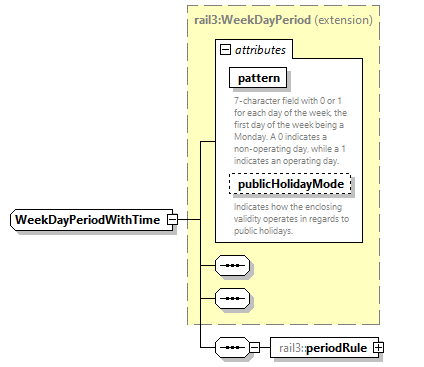 | ||||||||||||||||||||||
| namespace | https://www.railml.org/schemas/3.2 | ||||||||||||||||||||||
| type | extension of rail3:WeekDayPeriod | ||||||||||||||||||||||
| properties |
| ||||||||||||||||||||||
| children | rail3:periodRule | ||||||||||||||||||||||
| used by |
| ||||||||||||||||||||||
| attributes |
| ||||||||||||||||||||||
| source | <xs:complexType name="WeekDayPeriodWithTime"> <xs:complexContent> <xs:extension base="rail3:WeekDayPeriod"> <xs:sequence> <xs:element name="periodRule" type="rail3:PeriodRule" minOccurs="1" maxOccurs="1"/> </xs:sequence> </xs:extension> </xs:complexContent> </xs:complexType> |
element WeekDayPeriodWithTime/periodRule
| diagram | 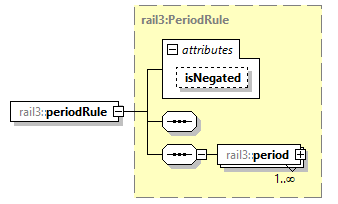 | ||||||||||||
| namespace | https://www.railml.org/schemas/3.2 | ||||||||||||
| type | rail3:PeriodRule | ||||||||||||
| properties |
| ||||||||||||
| children | rail3:period | ||||||||||||
| attributes |
| ||||||||||||
| source | <xs:element name="periodRule" type="rail3:PeriodRule" minOccurs="1" maxOccurs="1"/> |
complexType WeekPattern
| diagram | 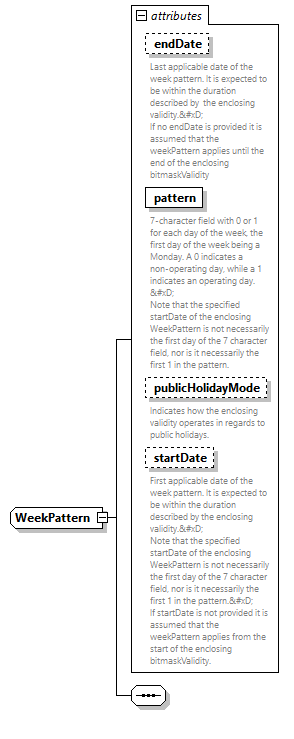 | ||||||||||||||||||||||||||||||||||||||
| namespace | https://www.railml.org/schemas/3.2 | ||||||||||||||||||||||||||||||||||||||
| used by |
| ||||||||||||||||||||||||||||||||||||||
| attributes |
| ||||||||||||||||||||||||||||||||||||||
| source | <xs:complexType name="WeekPattern"> <xs:sequence/> <xs:attribute name="endDate" type="xs:date" use="optional"> <xs:annotation> <xs:documentation>Last applicable date of the week pattern. It is expected to be within the duration described by the enclosing validity.
 If no endDate is provided it is assumed that the weekPattern applies until the end of the enclosing bitmaskValidity</xs:documentation> </xs:annotation> </xs:attribute> <xs:attribute name="pattern" type="rail3:tBitmaskWeek" use="required"> <xs:annotation> <xs:documentation>7-character field with 0 or 1 for each day of the week, the first day of the week being a Monday. A 0 indicates a non-operating day, while a 1 indicates an operating day. 
 Note that the specified startDate of the enclosing WeekPattern is not necessarily the first day of the 7 character field, nor is it necessarily the first 1 in the pattern.</xs:documentation> </xs:annotation> </xs:attribute> <xs:attribute name="publicHolidayMode" type="rail3:HolidayMode" use="optional" default="runsOnIndicatedHolidays"> <xs:annotation> <xs:documentation>Indicates how the enclosing validity operates in regards to public holidays.</xs:documentation> </xs:annotation> </xs:attribute> <xs:attribute name="startDate" type="xs:date" use="optional"> <xs:annotation> <xs:documentation>First applicable date of the week pattern. It is expected to be within the duration described by the enclosing validity.
 Note that the specified startDate of the enclosing WeekPattern is not necessarily the first day of the 7 character field, nor is it necessarily the first 1 in the pattern.
 If startDate is not provided it is assumed that the weekPattern applies from the start of the enclosing bitmaskValidity.</xs:documentation> </xs:annotation> </xs:attribute> </xs:complexType> |
attribute WeekPattern/@endDate
| type | xs:date | ||
| properties |
| ||
| annotation |
| ||
| source | <xs:attribute name="endDate" type="xs:date" use="optional"> <xs:annotation> <xs:documentation>Last applicable date of the week pattern. It is expected to be within the duration described by the enclosing validity.
 If no endDate is provided it is assumed that the weekPattern applies until the end of the enclosing bitmaskValidity</xs:documentation> </xs:annotation> </xs:attribute> |
attribute WeekPattern/@pattern
| type | rail3:tBitmaskWeek | |||||||||
| properties |
| |||||||||
| facets |
| |||||||||
| annotation |
| |||||||||
| source | <xs:attribute name="pattern" type="rail3:tBitmaskWeek" use="required"> <xs:annotation> <xs:documentation>7-character field with 0 or 1 for each day of the week, the first day of the week being a Monday. A 0 indicates a non-operating day, while a 1 indicates an operating day. 
 Note that the specified startDate of the enclosing WeekPattern is not necessarily the first day of the 7 character field, nor is it necessarily the first 1 in the pattern.</xs:documentation> </xs:annotation> </xs:attribute> |
attribute WeekPattern/@publicHolidayMode
| type | rail3:HolidayMode | ||||||||||||||||||
| properties |
| ||||||||||||||||||
| facets |
| ||||||||||||||||||
| annotation |
| ||||||||||||||||||
| source | <xs:attribute name="publicHolidayMode" type="rail3:HolidayMode" use="optional" default="runsOnIndicatedHolidays"> <xs:annotation> <xs:documentation>Indicates how the enclosing validity operates in regards to public holidays.</xs:documentation> </xs:annotation> </xs:attribute> |
attribute WeekPattern/@startDate
| type | xs:date | ||
| properties |
| ||
| annotation |
| ||
| source | <xs:attribute name="startDate" type="xs:date" use="optional"> <xs:annotation> <xs:documentation>First applicable date of the week pattern. It is expected to be within the duration described by the enclosing validity.
 Note that the specified startDate of the enclosing WeekPattern is not necessarily the first day of the 7 character field, nor is it necessarily the first 1 in the pattern.
 If startDate is not provided it is assumed that the weekPattern applies from the start of the enclosing bitmaskValidity.</xs:documentation> </xs:annotation> </xs:attribute> |
complexType WeekPatterns
| diagram | 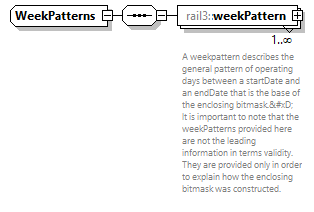 | ||
| namespace | https://www.railml.org/schemas/3.2 | ||
| children | rail3:weekPattern | ||
| used by |
| ||
| source | <xs:complexType name="WeekPatterns"> <xs:sequence> <xs:element name="weekPattern" type="rail3:WeekPattern" minOccurs="1" maxOccurs="unbounded"> <xs:annotation> <xs:documentation>A weekpattern describes the general pattern of operating days between a startDate and an endDate that is the base of the enclosing bitmask.
 It is important to note that the weekPatterns provided here are not the leading information in terms validity. They are provided only in order to explain how the enclosing bitmask was constructed.</xs:documentation> </xs:annotation> </xs:element> </xs:sequence> </xs:complexType> |
element WeekPatterns/weekPattern
| diagram | 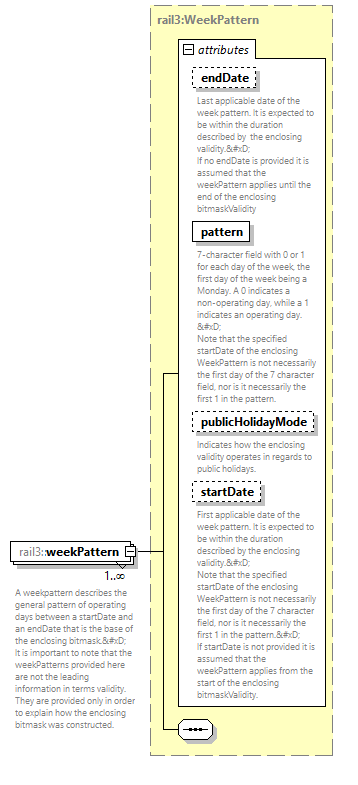 | ||||||||||||||||||||||||||||||||||||||
| namespace | https://www.railml.org/schemas/3.2 | ||||||||||||||||||||||||||||||||||||||
| type | rail3:WeekPattern | ||||||||||||||||||||||||||||||||||||||
| properties |
| ||||||||||||||||||||||||||||||||||||||
| attributes |
| ||||||||||||||||||||||||||||||||||||||
| annotation |
| ||||||||||||||||||||||||||||||||||||||
| source | <xs:element name="weekPattern" type="rail3:WeekPattern" minOccurs="1" maxOccurs="unbounded"> <xs:annotation> <xs:documentation>A weekpattern describes the general pattern of operating days between a startDate and an endDate that is the base of the enclosing bitmask.
 It is important to note that the weekPatterns provided here are not the leading information in terms validity. They are provided only in order to explain how the enclosing bitmask was constructed.</xs:documentation> </xs:annotation> </xs:element> |
simpleType HolidayMode
| namespace | https://www.railml.org/schemas/3.2 | ||||||||||||||||||
| type | restriction of xs:string | ||||||||||||||||||
| properties |
| ||||||||||||||||||
| used by |
| ||||||||||||||||||
| facets |
| ||||||||||||||||||
| source | <xs:simpleType name="HolidayMode"> <xs:restriction base="xs:string"> <xs:enumeration value="neverRunsOnHolidays"> <xs:annotation> <xs:documentation>Indicates that the validity does not apply on all public holidays no matter if the specified pattern is marked with one for that day. Trains referencing a validity with this value set will not run on public holidays.</xs:documentation> </xs:annotation> </xs:enumeration> <xs:enumeration value="runsOnAllHolidays"> <xs:annotation> <xs:documentation>Indicates that the validity applies on all public holidays. This means that no matter what is specified via the bitMask, the validity will apply and a train using this validity is scheduled to run.</xs:documentation> </xs:annotation> </xs:enumeration> <xs:enumeration value="runsOnIndicatedHolidays"> <xs:annotation> <xs:documentation>Indicates that the validity applies even if a day is a public holiday. </xs:documentation> </xs:annotation> </xs:enumeration> </xs:restriction> </xs:simpleType> |
simpleType tAcceleration
| namespace | https://www.railml.org/schemas/3.2 | ||
| type | xs:decimal | ||
| properties |
| ||
| used by |
| ||
| annotation |
| ||
| source | <xs:simpleType name="tAcceleration"> <xs:annotation> <xs:documentation>applies as basic type for inheritance, should not be used directly because of missing unit of measure</xs:documentation> </xs:annotation> <xs:restriction base="xs:decimal"/> </xs:simpleType> |
simpleType tAccelerationMeterPerSquareSec
| namespace | https://www.railml.org/schemas/3.2 | ||
| type | rail3:tAcceleration | ||
| properties |
| ||
| used by |
| ||
| annotation |
| ||
| source | <xs:simpleType name="tAccelerationMeterPerSquareSec"> <xs:annotation> <xs:documentation>generic type for acceleration values measured in metres per square second</xs:documentation> </xs:annotation> <xs:restriction base="rail3:tAcceleration"/> </xs:simpleType> |
simpleType tAirBrakeApplicationDirection
| namespace | https://www.railml.org/schemas/3.2 | |||||||||||||||||||||
| type | restriction of xs:string | |||||||||||||||||||||
| properties |
| |||||||||||||||||||||
| used by |
| |||||||||||||||||||||
| facets |
| |||||||||||||||||||||
| source | <xs:simpleType name="tAirBrakeApplicationDirection"> <xs:restriction base="xs:string"> <xs:enumeration value="N/A"/> <xs:enumeration value="P"> <xs:annotation> <xs:documentation>Passenger</xs:documentation> </xs:annotation> </xs:enumeration> <xs:enumeration value="R"> <xs:annotation> <xs:documentation>Rapid</xs:documentation> </xs:annotation> </xs:enumeration> <xs:enumeration value="G"> <xs:annotation> <xs:documentation>Goods</xs:documentation> </xs:annotation> </xs:enumeration> </xs:restriction> </xs:simpleType> |
simpleType tAngleDeg
| namespace | https://www.railml.org/schemas/3.2 | ||||
| type | xs:decimal | ||||
| properties |
| ||||
| used by |
| ||||
| annotation |
| ||||
| source | <xs:simpleType name="tAngleDeg"> <xs:annotation> <xs:documentation>applies as basic type for inheritance, should not be used directly because of missing unit of measure</xs:documentation> </xs:annotation> <xs:restriction base="xs:decimal"/> </xs:simpleType> |
simpleType tAngleDegQuadrant
| namespace | https://www.railml.org/schemas/3.2 | ||
| type | rail3:tAngleDeg | ||
| properties |
| ||
| used by |
| ||
| annotation |
| ||
| source | <xs:simpleType name="tAngleDegQuadrant"> <xs:annotation> <xs:documentation>generic type for angle values measured in degree, allowing 0 ... +90</xs:documentation> </xs:annotation> <xs:restriction base="rail3:tAngleDeg"/> </xs:simpleType> |
simpleType tArea
| namespace | https://www.railml.org/schemas/3.2 | ||
| type | xs:decimal | ||
| properties |
| ||
| used by |
| ||
| annotation |
| ||
| source | <xs:simpleType name="tArea"> <xs:annotation> <xs:documentation>applies as basic type for inheritance, should not be used directly because of missing unit of measure</xs:documentation> </xs:annotation> <xs:restriction base="xs:decimal"/> </xs:simpleType> |
simpleType tAreaSquareM
| namespace | https://www.railml.org/schemas/3.2 | ||
| type | rail3:tArea | ||
| properties |
| ||
| used by |
| ||
| annotation |
| ||
| source | <xs:simpleType name="tAreaSquareM"> <xs:annotation> <xs:documentation>generic type for area values measured in square metres</xs:documentation> </xs:annotation> <xs:restriction base="rail3:tArea"/> </xs:simpleType> |
simpleType tBitmaskAny
| namespace | https://www.railml.org/schemas/3.2 | ||||||
| type | restriction of xs:string | ||||||
| properties |
| ||||||
| used by |
| ||||||
| facets |
| ||||||
| source | <xs:simpleType name="tBitmaskAny"> <xs:restriction base="xs:string"> <xs:pattern value="[0-1]*"/> </xs:restriction> </xs:simpleType> |
simpleType tBitmaskWeek
| namespace | https://www.railml.org/schemas/3.2 | |||||||||
| type | restriction of xs:string | |||||||||
| properties |
| |||||||||
| used by |
| |||||||||
| facets |
| |||||||||
| source | <xs:simpleType name="tBitmaskWeek"> <xs:restriction base="xs:string"> <xs:length value="7"/> <xs:pattern value="[0-1]{7}"/> </xs:restriction> </xs:simpleType> |
simpleType tBrakePercentage
| namespace | https://www.railml.org/schemas/3.2 | |||||||||
| type | restriction of xs:integer | |||||||||
| properties |
| |||||||||
| used by |
| |||||||||
| facets |
| |||||||||
| annotation |
| |||||||||
| source | <xs:simpleType name="tBrakePercentage"> <xs:annotation> <xs:documentation>Brake percentage as value of braking performance in relation to vehicle weight</xs:documentation> </xs:annotation> <xs:restriction base="xs:integer"> <xs:maxInclusive value="225"/> <xs:minInclusive value="6"/> </xs:restriction> </xs:simpleType> |
simpleType tBrakeType
| namespace | https://www.railml.org/schemas/3.2 | |||||||||||||||||||||||||||
| type | restriction of xs:string | |||||||||||||||||||||||||||
| properties |
| |||||||||||||||||||||||||||
| used by |
| |||||||||||||||||||||||||||
| facets |
| |||||||||||||||||||||||||||
| source | <xs:simpleType name="tBrakeType"> <xs:restriction base="xs:string"> <xs:enumeration value="none"/> <xs:enumeration value="compressedAirBrake"> <xs:annotation> <xs:documentation>de: Druckluftbremse</xs:documentation> </xs:annotation> </xs:enumeration> <xs:enumeration value="vacuumAirBrake"> <xs:annotation> <xs:documentation>de: Saugluftbremse</xs:documentation> </xs:annotation> </xs:enumeration> <xs:enumeration value="cableBrake"> <xs:annotation> <xs:documentation>de: Seilzugbremse</xs:documentation> </xs:annotation> </xs:enumeration> <xs:enumeration value="parkingBrake"/> <xs:enumeration value="handBrake"/> </xs:restriction> </xs:simpleType> |
simpleType tBrakeTypeExt
| namespace | https://www.railml.org/schemas/3.2 | ||
| type | union of (rail3:tBrakeType, rail3:tOtherEnumerationValue) | ||
| used by |
| ||
| source | <xs:simpleType name="tBrakeTypeExt"> <xs:union memberTypes="rail3:tBrakeType rail3:tOtherEnumerationValue"/> </xs:simpleType> |
simpleType tBrakeUse
| namespace | https://www.railml.org/schemas/3.2 | |||||||||||||||
| type | restriction of xs:string | |||||||||||||||
| properties |
| |||||||||||||||
| used by |
| |||||||||||||||
| facets |
| |||||||||||||||
| source | <xs:simpleType name="tBrakeUse"> <xs:restriction base="xs:string"> <xs:enumeration value="both"/> <xs:enumeration value="emergency"/> <xs:enumeration value="normal"/> <xs:enumeration value="unknown"/> </xs:restriction> </xs:simpleType> |
simpleType tBrakeUseExt
| namespace | https://www.railml.org/schemas/3.2 | ||
| type | union of (rail3:tBrakeUse, rail3:tOtherEnumerationValue) | ||
| used by |
| ||
| source | <xs:simpleType name="tBrakeUseExt"> <xs:union memberTypes="rail3:tBrakeUse rail3:tOtherEnumerationValue"/> </xs:simpleType> |
simpleType tCantDeficiency
| namespace | https://www.railml.org/schemas/3.2 | |||||||||
| type | restriction of xs:integer | |||||||||
| properties |
| |||||||||
| used by |
| |||||||||
| facets |
| |||||||||
| source | <xs:simpleType name="tCantDeficiency"> <xs:restriction base="xs:integer"> <xs:maxInclusive value="300"/> <xs:minInclusive value="80"/> </xs:restriction> </xs:simpleType> |
simpleType tClassesList
| namespace | https://www.railml.org/schemas/3.2 | ||||||||||||
| type | restriction of xs:string | ||||||||||||
| properties |
| ||||||||||||
| used by |
| ||||||||||||
| facets |
| ||||||||||||
| source | <xs:simpleType name="tClassesList"> <xs:restriction base="xs:string"> <xs:enumeration value="first"/> <xs:enumeration value="second"/> <xs:enumeration value="third"/> </xs:restriction> </xs:simpleType> |
simpleType tClassesListExt
| namespace | https://www.railml.org/schemas/3.2 | ||
| type | union of (rail3:tClassesList, rail3:tOtherEnumerationValue) | ||
| used by |
| ||
| source | <xs:simpleType name="tClassesListExt"> <xs:union memberTypes="rail3:tClassesList rail3:tOtherEnumerationValue"/> </xs:simpleType> |
simpleType tCurrent
| namespace | https://www.railml.org/schemas/3.2 | ||
| type | xs:decimal | ||
| properties |
| ||
| used by |
| ||
| annotation |
| ||
| source | <xs:simpleType name="tCurrent"> <xs:annotation> <xs:documentation>applies as basic type for inheritance, should not be used directly because of missing unit of measure</xs:documentation> </xs:annotation> <xs:restriction base="xs:decimal"/> </xs:simpleType> |
simpleType tCurrentAmpere
| namespace | https://www.railml.org/schemas/3.2 | ||
| type | rail3:tCurrent | ||
| properties |
| ||
| used by |
| ||
| annotation |
| ||
| source | <xs:simpleType name="tCurrentAmpere"> <xs:annotation> <xs:documentation>generic type for electric current values measured in ampere</xs:documentation> </xs:annotation> <xs:restriction base="rail3:tCurrent"/> </xs:simpleType> |
simpleType tEtcsTrainCategoryNumber
| namespace | https://www.railml.org/schemas/3.2 | |||||||||
| type | restriction of xs:integer | |||||||||
| properties |
| |||||||||
| used by |
| |||||||||
| facets |
| |||||||||
| source | <xs:simpleType name="tEtcsTrainCategoryNumber"> <xs:restriction base="xs:integer"> <xs:maxInclusive value="15"/> <xs:minInclusive value="0"/> </xs:restriction> </xs:simpleType> |
simpleType tExtendedDirection
| namespace | https://www.railml.org/schemas/3.2 | ||||||||||||
| type | restriction of xs:string | ||||||||||||
| properties |
| ||||||||||||
| used by |
| ||||||||||||
| facets |
| ||||||||||||
| source | <xs:simpleType name="tExtendedDirection"> <xs:restriction base="xs:string"> <xs:enumeration value="both"/> <xs:enumeration value="reverse"/> <xs:enumeration value="normal"/> </xs:restriction> </xs:simpleType> |
simpleType tForce
| namespace | https://www.railml.org/schemas/3.2 | ||
| type | xs:decimal | ||
| properties |
| ||
| used by |
| ||
| source | <xs:simpleType name="tForce"> <xs:restriction base="xs:decimal"/> </xs:simpleType> |
simpleType tForceN
| namespace | https://www.railml.org/schemas/3.2 | ||
| type | rail3:tForce | ||
| properties |
| ||
| used by |
| ||
| source | <xs:simpleType name="tForceN"> <xs:restriction base="rail3:tForce"/> </xs:simpleType> |
simpleType tFreightList
| namespace | https://www.railml.org/schemas/3.2 | |||||||||||||||||||||||||||||||||||||||||||||
| type | restriction of xs:string | |||||||||||||||||||||||||||||||||||||||||||||
| properties |
| |||||||||||||||||||||||||||||||||||||||||||||
| used by |
| |||||||||||||||||||||||||||||||||||||||||||||
| facets |
| |||||||||||||||||||||||||||||||||||||||||||||
| source | <xs:simpleType name="tFreightList"> <xs:restriction base="xs:string"> <xs:enumeration value="bulkGoods"/> <xs:enumeration value="cars"/> <xs:enumeration value="container20"/> <xs:enumeration value="container40"/> <xs:enumeration value="flatPlatform"/> <xs:enumeration value="gas"/> <xs:enumeration value="liquidGas"/> <xs:enumeration value="liquids"/> <xs:enumeration value="liveStock"/> <xs:enumeration value="pallets"/> <xs:enumeration value="partLoadGoods"/> <xs:enumeration value="powder"/> <xs:enumeration value="trailers"/> <xs:enumeration value="trucks"/> </xs:restriction> </xs:simpleType> |
simpleType tFreightListExt
| namespace | https://www.railml.org/schemas/3.2 | ||
| type | union of (rail3:tFreightList, rail3:tOtherEnumerationValue) | ||
| used by |
| ||
| source | <xs:simpleType name="tFreightListExt"> <xs:union memberTypes="rail3:tFreightList rail3:tOtherEnumerationValue"/> </xs:simpleType> |
simpleType tFrequency
| namespace | https://www.railml.org/schemas/3.2 | |||||||||
| type | restriction of xs:decimal | |||||||||
| properties |
| |||||||||
| used by |
| |||||||||
| facets |
| |||||||||
| annotation |
| |||||||||
| source | <xs:simpleType name="tFrequency"> <xs:annotation> <xs:documentation>applies as basic type for inheritance, should not be used directly because of missing unit of measure</xs:documentation> </xs:annotation> <xs:restriction base="xs:decimal"> <xs:fractionDigits value="3"/> <xs:minInclusive value="0"/> </xs:restriction> </xs:simpleType> |
simpleType tFrequencyHertz
| namespace | https://www.railml.org/schemas/3.2 | |||||||||
| type | rail3:tFrequency | |||||||||
| properties |
| |||||||||
| used by |
| |||||||||
| facets |
| |||||||||
| annotation |
| |||||||||
| source | <xs:simpleType name="tFrequencyHertz"> <xs:annotation> <xs:documentation>generic type for frequency values measured in hertz</xs:documentation> </xs:annotation> <xs:restriction base="rail3:tFrequency"/> </xs:simpleType> |
simpleType tGenericID
| namespace | https://www.railml.org/schemas/3.2 | ||
| type | xs:ID | ||
| properties |
| ||
| used by |
| ||
| annotation |
| ||
| source | <xs:simpleType name="tGenericID"> <xs:annotation> <xs:documentation>an XML-side constrained bi-unique identity; unique across an XML file including its outsourced components (xi:include mechanism); white spaces not allowed</xs:documentation> </xs:annotation> <xs:restriction base="xs:ID"/> </xs:simpleType> |
simpleType tGenericRef
| namespace | https://www.railml.org/schemas/3.2 | ||||
| type | xs:IDREF | ||||
| properties |
| ||||
| used by |
| ||||
| annotation |
| ||||
| source | <xs:simpleType name="tGenericRef"> <xs:annotation> <xs:documentation>an XML-side constrained reference to one xs:ID value, acts across an XML file including its outsourced components (xi:include mechanism)</xs:documentation> </xs:annotation> <xs:restriction base="xs:IDREF"/> </xs:simpleType> |
simpleType tGradientPerMille
| namespace | https://www.railml.org/schemas/3.2 | ||
| type | xs:decimal | ||
| properties |
| ||
| used by |
| ||
| source | <xs:simpleType name="tGradientPerMille"> <xs:restriction base="xs:decimal"/> </xs:simpleType> |
simpleType tID
| namespace | https://www.railml.org/schemas/3.2 | ||
| type | union of (rail3:tGenericID, rail3:tUUID) | ||
| used by |
| ||
| annotation |
| ||
| source | <xs:simpleType name="tID"> <xs:annotation> <xs:documentation>use UUID if your system supports this functionality, otherwise use GenericID (xs:ID)</xs:documentation> </xs:annotation> <xs:union memberTypes="rail3:tGenericID rail3:tUUID"/> </xs:simpleType> |
simpleType tLength
| namespace | https://www.railml.org/schemas/3.2 | ||
| type | xs:decimal | ||
| properties |
| ||
| used by |
| ||
| annotation |
| ||
| source | <xs:simpleType name="tLength"> <xs:annotation> <xs:documentation>applies as basic type for inheritance, should not be used directly because of missing unit of measure</xs:documentation> </xs:annotation> <xs:restriction base="xs:decimal"/> </xs:simpleType> |
simpleType tLengthM
| namespace | https://www.railml.org/schemas/3.2 | ||
| type | rail3:tLength | ||
| properties |
| ||
| used by |
| ||
| annotation |
| ||
| source | <xs:simpleType name="tLengthM"> <xs:annotation> <xs:documentation>generic type for length values measured in metres</xs:documentation> </xs:annotation> <xs:restriction base="rail3:tLength"/> </xs:simpleType> |
simpleType tLengthMM
| namespace | https://www.railml.org/schemas/3.2 | ||
| type | rail3:tLength | ||
| properties |
| ||
| used by |
| ||
| annotation |
| ||
| source | <xs:simpleType name="tLengthMM"> <xs:annotation> <xs:documentation>generic type for length values measured in millimetres</xs:documentation> </xs:annotation> <xs:restriction base="rail3:tLength"/> </xs:simpleType> |
simpleType tLoadAccessList
| namespace | https://www.railml.org/schemas/3.2 | ||||||||||||
| type | restriction of xs:string | ||||||||||||
| properties |
| ||||||||||||
| used by |
| ||||||||||||
| facets |
| ||||||||||||
| source | <xs:simpleType name="tLoadAccessList"> <xs:restriction base="xs:string"> <xs:enumeration value="sideDoors"/> <xs:enumeration value="slidingRoof"/> <xs:enumeration value="slidingWalls"/> </xs:restriction> </xs:simpleType> |
simpleType tLoadAccessListExt
| namespace | https://www.railml.org/schemas/3.2 | ||
| type | union of (rail3:tLoadAccessList, rail3:tOtherEnumerationValue) | ||
| used by |
| ||
| source | <xs:simpleType name="tLoadAccessListExt"> <xs:union memberTypes="rail3:tLoadAccessList rail3:tOtherEnumerationValue"/> </xs:simpleType> |
simpleType tMeterload
| namespace | https://www.railml.org/schemas/3.2 | ||
| type | xs:decimal | ||
| properties |
| ||
| used by |
| ||
| annotation |
| ||
| source | <xs:simpleType name="tMeterload"> <xs:annotation> <xs:documentation>applies as basic type for inheritance, should not be used directly because of missing unit of measure</xs:documentation> </xs:annotation> <xs:restriction base="xs:decimal"/> </xs:simpleType> |
simpleType tMeterloadTonsPerMeter
| namespace | https://www.railml.org/schemas/3.2 | ||
| type | rail3:tMeterload | ||
| properties |
| ||
| used by |
| ||
| annotation |
| ||
| source | <xs:simpleType name="tMeterloadTonsPerMeter"> <xs:annotation> <xs:documentation>generic type for load per meter values measured in tonnes per metre</xs:documentation> </xs:annotation> <xs:restriction base="rail3:tMeterload"/> </xs:simpleType> |
simpleType tOtherEnumerationValue
| namespace | https://www.railml.org/schemas/3.2 | ||||||
| type | restriction of xs:string | ||||||
| properties |
| ||||||
| used by |
| ||||||
| facets |
| ||||||
| annotation |
| ||||||
| source | <xs:simpleType name="tOtherEnumerationValue"> <xs:annotation> <xs:documentation>an arbitrary string starting with 'other:' followed by at minimum two characters, white space not allowed for extending railML enumeration lists</xs:documentation> </xs:annotation> <xs:restriction base="xs:string"> <xs:pattern value="other:\w{2,}"/> </xs:restriction> </xs:simpleType> |
simpleType tPlaceCategoryList
| namespace | https://www.railml.org/schemas/3.2 | ||||||||||||||||||||||||||||||||||||||||||
| type | restriction of xs:string | ||||||||||||||||||||||||||||||||||||||||||
| properties |
| ||||||||||||||||||||||||||||||||||||||||||
| used by |
| ||||||||||||||||||||||||||||||||||||||||||
| facets |
| ||||||||||||||||||||||||||||||||||||||||||
| source | <xs:simpleType name="tPlaceCategoryList"> <xs:restriction base="xs:string"> <xs:enumeration value="bicycle"/> <xs:enumeration value="bistroSeat"/> <xs:enumeration value="couchette"/> <xs:enumeration value="foldingSeat"/> <xs:enumeration value="pullmannSeat"/> <xs:enumeration value="restaurantSeat"/> <xs:enumeration value="seat"/> <xs:enumeration value="sleeper"/> <xs:enumeration value="sleeperette"/> <xs:enumeration value="sleeperWithShower"/> <xs:enumeration value="sleeperWithShowerWC"/> <xs:enumeration value="standing"/> <xs:enumeration value="wheelchair"/> </xs:restriction> </xs:simpleType> |
simpleType tPlacesCategoryListExt
| namespace | https://www.railml.org/schemas/3.2 | ||
| type | union of (rail3:tOtherEnumerationValue, rail3:tPlaceCategoryList) | ||
| used by |
| ||
| source | <xs:simpleType name="tPlacesCategoryListExt"> <xs:union memberTypes="rail3:tOtherEnumerationValue rail3:tPlaceCategoryList"/> </xs:simpleType> |
simpleType tPower
| namespace | https://www.railml.org/schemas/3.2 | ||
| type | xs:decimal | ||
| properties |
| ||
| used by |
| ||
| source | <xs:simpleType name="tPower"> <xs:restriction base="xs:decimal"/> </xs:simpleType> |
simpleType tPowerWatt
| namespace | https://www.railml.org/schemas/3.2 | ||
| type | rail3:tPower | ||
| properties |
| ||
| used by |
| ||
| source | <xs:simpleType name="tPowerWatt"> <xs:restriction base="rail3:tPower"/> </xs:simpleType> |
simpleType tPriority
| namespace | https://www.railml.org/schemas/3.2 | ||
| type | xs:nonNegativeInteger | ||
| properties |
| ||
| used by |
| ||
| annotation |
| ||
| source | <xs:simpleType name="tPriority"> <xs:annotation> <xs:documentation>Priorities are hints for resolving conflicts between similar objects. Lower values indicate a higher priority. In consequence the highest possible priority is 0.</xs:documentation> </xs:annotation> <xs:restriction base="xs:nonNegativeInteger"/> </xs:simpleType> |
simpleType tRef
| namespace | https://www.railml.org/schemas/3.2 | ||
| type | union of (rail3:tGenericRef, rail3:tUUID) | ||
| used by |
| ||
| annotation |
| ||
| source | <xs:simpleType name="tRef"> <xs:annotation> <xs:documentation>reference an object using its UUID or GenericID (xs:ID)</xs:documentation> </xs:annotation> <xs:union memberTypes="rail3:tGenericRef rail3:tUUID"/> </xs:simpleType> |
simpleType tSelfDischargeList
| namespace | https://www.railml.org/schemas/3.2 | ||||||||||||
| type | restriction of xs:string | ||||||||||||
| properties |
| ||||||||||||
| used by |
| ||||||||||||
| facets |
| ||||||||||||
| source | <xs:simpleType name="tSelfDischargeList"> <xs:restriction base="xs:string"> <xs:enumeration value="controlled"/> <xs:enumeration value="sideTipping"/> <xs:enumeration value="uncontrolled"/> </xs:restriction> </xs:simpleType> |
simpleType tSelfDischargeListExt
| namespace | https://www.railml.org/schemas/3.2 | ||
| type | union of (rail3:tOtherEnumerationValue, rail3:tSelfDischargeList) | ||
| used by |
| ||
| source | <xs:simpleType name="tSelfDischargeListExt"> <xs:union memberTypes="rail3:tOtherEnumerationValue rail3:tSelfDischargeList"/> </xs:simpleType> |
simpleType tServiceCategoryList
| namespace | https://www.railml.org/schemas/3.2 | |||||||||||||||||||||||||||||||||||||||||||||
| type | restriction of xs:string | |||||||||||||||||||||||||||||||||||||||||||||
| properties |
| |||||||||||||||||||||||||||||||||||||||||||||
| used by |
| |||||||||||||||||||||||||||||||||||||||||||||
| facets |
| |||||||||||||||||||||||||||||||||||||||||||||
| source | <xs:simpleType name="tServiceCategoryList"> <xs:restriction base="xs:string"> <xs:enumeration value="airConditioning"/> <xs:enumeration value="automaticPassengerCountingSystem"/> <xs:enumeration value="impairedToilet"/> <xs:enumeration value="integratedHeatingVentilationAirConditioning"/> <xs:enumeration value="mobileCatering"/> <xs:enumeration value="passengerInformationSystem"/> <xs:enumeration value="powerSocket"/> <xs:enumeration value="selfService"/> <xs:enumeration value="snackVendingMachine"/> <xs:enumeration value="surveillanceCamera"/> <xs:enumeration value="toilet"/> <xs:enumeration value="usbSocket"/> <xs:enumeration value="wheelchairLift"/> <xs:enumeration value="wlan"/> </xs:restriction> </xs:simpleType> |
simpleType tServiceCategoryListExt
| namespace | https://www.railml.org/schemas/3.2 | ||
| type | union of (rail3:tOtherEnumerationValue, rail3:tServiceCategoryList) | ||
| used by |
| ||
| source | <xs:simpleType name="tServiceCategoryListExt"> <xs:union memberTypes="rail3:tOtherEnumerationValue rail3:tServiceCategoryList"/> </xs:simpleType> |
simpleType tSpeed
| namespace | https://www.railml.org/schemas/3.2 | ||
| type | xs:decimal | ||
| properties |
| ||
| used by |
| ||
| annotation |
| ||
| source | <xs:simpleType name="tSpeed"> <xs:annotation> <xs:documentation>applies as basic type for inheritance, should not be used directly because of missing unit of measure</xs:documentation> </xs:annotation> <xs:restriction base="xs:decimal"/> </xs:simpleType> |
simpleType tSpeedKmPerHour
| namespace | https://www.railml.org/schemas/3.2 | ||||
| type | rail3:tSpeed | ||||
| properties |
| ||||
| used by |
| ||||
| annotation |
| ||||
| source | <xs:simpleType name="tSpeedKmPerHour"> <xs:annotation> <xs:documentation>generic type for speed/velocity values measured in kilometres per hour</xs:documentation> </xs:annotation> <xs:restriction base="rail3:tSpeed"/> </xs:simpleType> |
simpleType tTiltingActuationType
| namespace | https://www.railml.org/schemas/3.2 | |||||||||||||||
| type | restriction of xs:string | |||||||||||||||
| properties |
| |||||||||||||||
| used by |
| |||||||||||||||
| facets |
| |||||||||||||||
| source | <xs:simpleType name="tTiltingActuationType"> <xs:restriction base="xs:string"> <xs:enumeration value="active"/> <xs:enumeration value="none"/> <xs:enumeration value="passive"/> <xs:enumeration value="rollCompensation"/> </xs:restriction> </xs:simpleType> |
simpleType tTrainRelation
| namespace | https://www.railml.org/schemas/3.2 | ||||||||||||||||||
| type | restriction of xs:string | ||||||||||||||||||
| properties |
| ||||||||||||||||||
| used by |
| ||||||||||||||||||
| facets |
| ||||||||||||||||||
| source | <xs:simpleType name="tTrainRelation"> <xs:restriction base="xs:string"> <xs:enumeration value="endOfTrain"> <xs:annotation> <xs:documentation>The tail of the train should be located at the stopping place when the train has stopped.</xs:documentation> </xs:annotation> </xs:enumeration> <xs:enumeration value="headOfTrain"> <xs:annotation> <xs:documentation>The headof the train should be located at the stopping place when the train has stopped. This is the default setting.</xs:documentation> </xs:annotation> </xs:enumeration> <xs:enumeration value="midOfTrain"> <xs:annotation> <xs:documentation>The center of the train should be located at the stopping place when the train has stopped.</xs:documentation> </xs:annotation> </xs:enumeration> </xs:restriction> </xs:simpleType> |
simpleType tUnitNameList
| namespace | https://www.railml.org/schemas/3.2 | |||||||||||||||||||||||||||||||||||||||
| type | restriction of xs:string | |||||||||||||||||||||||||||||||||||||||
| properties |
| |||||||||||||||||||||||||||||||||||||||
| used by |
| |||||||||||||||||||||||||||||||||||||||
| facets |
| |||||||||||||||||||||||||||||||||||||||
| source | <xs:simpleType name="tUnitNameList"> <xs:restriction base="xs:string"> <xs:enumeration value="%"/> <xs:enumeration value="1"/> <xs:enumeration value="A"/> <xs:enumeration value="Hz"/> <xs:enumeration value="km/h"/> <xs:enumeration value="kWh"/> <xs:enumeration value="m/s"/> <xs:enumeration value="N"/> <xs:enumeration value="V"/> <xs:enumeration value="VA"/> <xs:enumeration value="Vs"/> <xs:enumeration value="W"/> </xs:restriction> </xs:simpleType> |
simpleType tUnitNameListExt
| namespace | https://www.railml.org/schemas/3.2 | ||
| type | union of (rail3:tOtherEnumerationValue, rail3:tUnitNameList) | ||
| used by |
| ||
| source | <xs:simpleType name="tUnitNameListExt"> <xs:union memberTypes="rail3:tOtherEnumerationValue rail3:tUnitNameList"/> </xs:simpleType> |
simpleType tUUID
| namespace | https://www.railml.org/schemas/3.2 | ||||||
| type | restriction of xs:string | ||||||
| properties |
| ||||||
| used by |
| ||||||
| facets |
| ||||||
| annotation |
| ||||||
| source | <xs:simpleType name="tUUID"> <xs:annotation> <xs:documentation>syntax taken from http://msdn.microsoft.com/de-de/library/office/fp123689%28v=office.1501401%29.aspx</xs:documentation> </xs:annotation> <xs:restriction base="xs:string"> <xs:pattern value="(urn:uuid:)?[0-9a-fA-F]{8}-[0-9a-fA-F]{4}-[0-9a-fA-F]{4}-[0-9a-fA-F]{4}-[0-9a-fA-F]{12}|\{[0-9a-fA-F]{8}-[0-9a-fA-F]{4}-[0-9a-fA-F]{4}-[0-9a-fA-F]{4}-[0-9a-fA-F]{12}\}"/> </xs:restriction> </xs:simpleType> |
simpleType tVoltage
| namespace | https://www.railml.org/schemas/3.2 | ||||||
| type | restriction of xs:decimal | ||||||
| properties |
| ||||||
| used by |
| ||||||
| facets |
| ||||||
| annotation |
| ||||||
| source | <xs:simpleType name="tVoltage"> <xs:annotation> <xs:documentation>applies as basic type for inheritance, should not be used directly because of missing unit of measure</xs:documentation> </xs:annotation> <xs:restriction base="xs:decimal"> <xs:fractionDigits value="1"/> </xs:restriction> </xs:simpleType> |
simpleType tVoltageVolt
| namespace | https://www.railml.org/schemas/3.2 | ||||||
| type | rail3:tVoltage | ||||||
| properties |
| ||||||
| used by |
| ||||||
| facets |
| ||||||
| annotation |
| ||||||
| source | <xs:simpleType name="tVoltageVolt"> <xs:annotation> <xs:documentation>generic type for voltage values measured in volts</xs:documentation> </xs:annotation> <xs:restriction base="rail3:tVoltage"/> </xs:simpleType> |
simpleType tVolume
| namespace | https://www.railml.org/schemas/3.2 | ||
| type | xs:decimal | ||
| properties |
| ||
| used by |
| ||
| source | <xs:simpleType name="tVolume"> <xs:restriction base="xs:decimal"/> </xs:simpleType> |
simpleType tVolumeCubicM
| namespace | https://www.railml.org/schemas/3.2 | ||
| type | rail3:tVolume | ||
| properties |
| ||
| used by |
| ||
| source | <xs:simpleType name="tVolumeCubicM"> <xs:restriction base="rail3:tVolume"/> </xs:simpleType> |
simpleType tWeight
| namespace | https://www.railml.org/schemas/3.2 | ||
| type | xs:decimal | ||
| properties |
| ||
| used by |
| ||
| annotation |
| ||
| source | <xs:simpleType name="tWeight"> <xs:annotation> <xs:documentation>applies as basic type for inheritance, should not be used directly because of missing unit of measure</xs:documentation> </xs:annotation> <xs:restriction base="xs:decimal"/> </xs:simpleType> |
simpleType tWeightTons
| namespace | https://www.railml.org/schemas/3.2 | ||
| type | rail3:tWeight | ||
| properties |
| ||
| used by |
| ||
| annotation |
| ||
| source | <xs:simpleType name="tWeightTons"> <xs:annotation> <xs:documentation>generic type for weight/load values measured in tonnes</xs:documentation> </xs:annotation> <xs:restriction base="rail3:tWeight"/> </xs:simpleType> |
attributeGroup anyAttribute
| namespace | https://www.railml.org/schemas/3.2 | ||||||
| used by |
| ||||||
| attributes |
| ||||||
| annotation |
| ||||||
| source | <xs:attributeGroup name="anyAttribute"> <xs:annotation> <xs:documentation>provide an extension point for non-railML 'any attribute' in a foreign namespace</xs:documentation> </xs:annotation> <xs:anyAttribute processContents="strict"/> </xs:attributeGroup> |
complexType RTM_AreaLocation
| diagram | 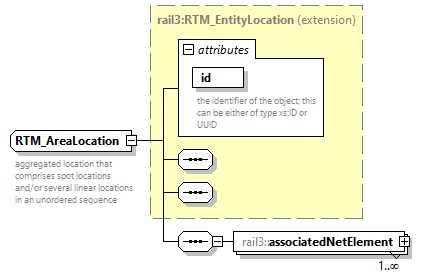 | ||||||||||||||
| namespace | https://www.railml.org/schemas/3.2 | ||||||||||||||
| type | extension of rail3:RTM_EntityLocation | ||||||||||||||
| properties |
| ||||||||||||||
| children | rail3:associatedNetElement | ||||||||||||||
| used by |
| ||||||||||||||
| attributes |
| ||||||||||||||
| annotation |
| ||||||||||||||
| source | <xs:complexType name="RTM_AreaLocation"> <xs:annotation> <xs:documentation>aggregated location that comprises spot locations and/or several linear locations in an unordered sequence</xs:documentation> </xs:annotation> <xs:complexContent> <xs:extension base="rail3:RTM_EntityLocation"> <xs:sequence> <xs:element name="associatedNetElement" type="rail3:RTM_AssociatedNetElement" minOccurs="1" maxOccurs="unbounded"/> </xs:sequence> </xs:extension> </xs:complexContent> </xs:complexType> |
element RTM_AreaLocation/associatedNetElement
| diagram | 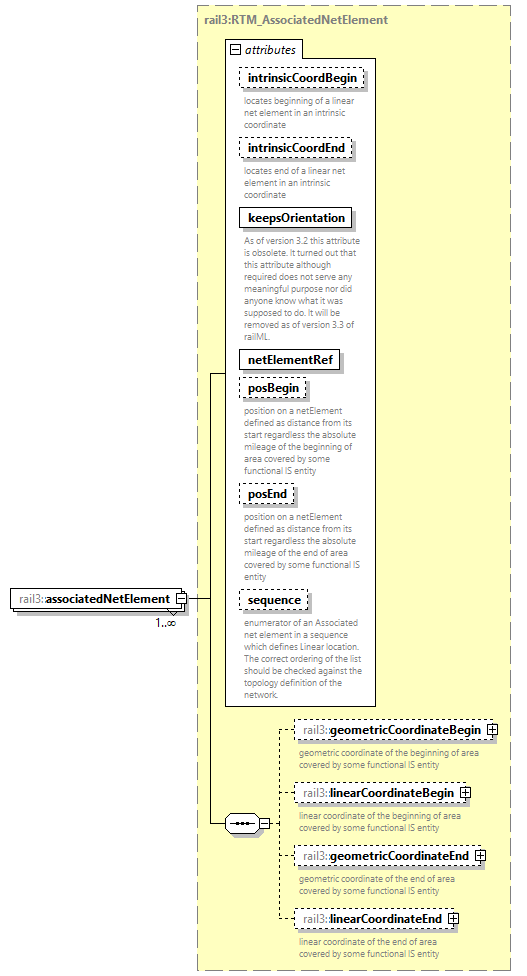 | ||||||||||||||||||||||||||||||||||||||||||||||||||||||||||||
| namespace | https://www.railml.org/schemas/3.2 | ||||||||||||||||||||||||||||||||||||||||||||||||||||||||||||
| type | rail3:RTM_AssociatedNetElement | ||||||||||||||||||||||||||||||||||||||||||||||||||||||||||||
| properties |
| ||||||||||||||||||||||||||||||||||||||||||||||||||||||||||||
| children | rail3:geometricCoordinateBegin rail3:linearCoordinateBegin rail3:geometricCoordinateEnd rail3:linearCoordinateEnd | ||||||||||||||||||||||||||||||||||||||||||||||||||||||||||||
| attributes |
| ||||||||||||||||||||||||||||||||||||||||||||||||||||||||||||
| source | <xs:element name="associatedNetElement" type="rail3:RTM_AssociatedNetElement" minOccurs="1" maxOccurs="unbounded"/> |
complexType RTM_AssociatedNetElement
| diagram | 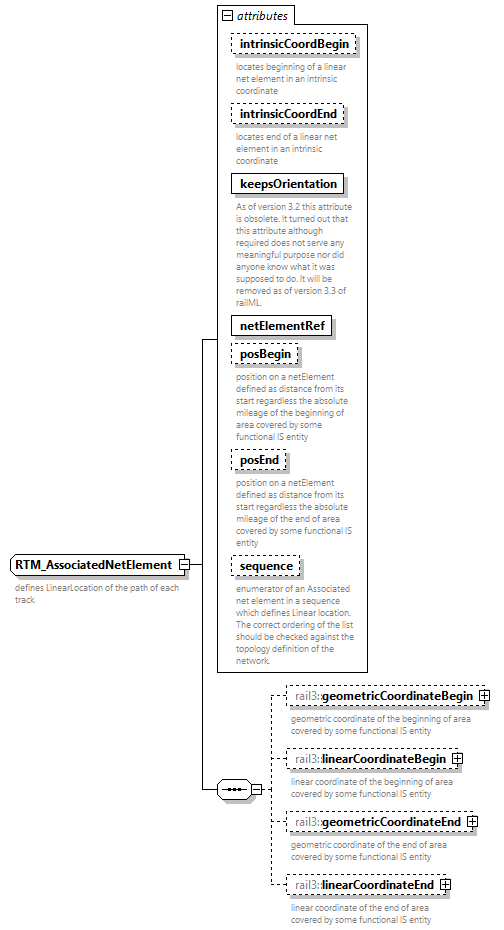 | ||||||||||||||||||||||||||||||||||||||||||||||||||||||||||||
| namespace | https://www.railml.org/schemas/3.2 | ||||||||||||||||||||||||||||||||||||||||||||||||||||||||||||
| children | rail3:geometricCoordinateBegin rail3:linearCoordinateBegin rail3:geometricCoordinateEnd rail3:linearCoordinateEnd | ||||||||||||||||||||||||||||||||||||||||||||||||||||||||||||
| used by |
| ||||||||||||||||||||||||||||||||||||||||||||||||||||||||||||
| attributes |
| ||||||||||||||||||||||||||||||||||||||||||||||||||||||||||||
| annotation |
| ||||||||||||||||||||||||||||||||||||||||||||||||||||||||||||
| source | <xs:complexType name="RTM_AssociatedNetElement"> <xs:annotation> <xs:documentation>defines LinearLocation of the path of each track</xs:documentation> </xs:annotation> <xs:sequence> <xs:element name="geometricCoordinateBegin" type="rail3:RTM_GeometricCoordinate" minOccurs="0" maxOccurs="1"> <xs:annotation> <xs:documentation>geometric coordinate of the beginning of area covered by some functional IS entity</xs:documentation> </xs:annotation> </xs:element> <xs:element name="linearCoordinateBegin" type="rail3:RTM_LinearCoordinate" minOccurs="0" maxOccurs="1"> <xs:annotation> <xs:documentation>linear coordinate of the beginning of area covered by some functional IS entity</xs:documentation> </xs:annotation> </xs:element> <xs:element name="geometricCoordinateEnd" type="rail3:RTM_GeometricCoordinate" minOccurs="0" maxOccurs="1"> <xs:annotation> <xs:documentation>geometric coordinate of the end of area covered by some functional IS entity</xs:documentation> </xs:annotation> </xs:element> <xs:element name="linearCoordinateEnd" type="rail3:RTM_LinearCoordinate" minOccurs="0" maxOccurs="1"> <xs:annotation> <xs:documentation>linear coordinate of the end of area covered by some functional IS entity</xs:documentation> </xs:annotation> </xs:element> </xs:sequence> <xs:attribute name="intrinsicCoordBegin" type="xs:double" use="optional"> <xs:annotation> <xs:documentation>locates beginning of a linear net element in an intrinsic coordinate</xs:documentation> </xs:annotation> </xs:attribute> <xs:attribute name="intrinsicCoordEnd" type="xs:double" use="optional"> <xs:annotation> <xs:documentation>locates end of a linear net element in an intrinsic coordinate</xs:documentation> </xs:annotation> </xs:attribute> <xs:attribute name="keepsOrientation" type="xs:boolean" use="required"> <xs:annotation> <xs:documentation>As of version 3.2 this attribute is obsolete. It turned out that this attribute although required does not serve any meaningful purpose nor did anyone know what it was supposed to do. It will be removed as of version 3.3 of railML.</xs:documentation> </xs:annotation> </xs:attribute> <xs:attribute name="netElementRef" type="rail3:tRef" use="required"/> <xs:attribute name="posBegin" type="rail3:tLengthM" use="optional"> <xs:annotation> <xs:documentation>position on a netElement defined as distance from its start regardless the absolute mileage of the beginning of area covered by some functional IS entity</xs:documentation> </xs:annotation> </xs:attribute> <xs:attribute name="posEnd" type="rail3:tLengthM" use="optional"> <xs:annotation> <xs:documentation>position on a netElement defined as distance from its start regardless the absolute mileage of the end of area covered by some functional IS entity</xs:documentation> </xs:annotation> </xs:attribute> <xs:attribute name="sequence" type="xs:nonNegativeInteger" use="optional"> <xs:annotation> <xs:documentation>enumerator of an Associated net element in a sequence which defines Linear location. The correct ordering of the list should be checked against the topology definition of the network.</xs:documentation> </xs:annotation> </xs:attribute> </xs:complexType> |
attribute RTM_AssociatedNetElement/@intrinsicCoordBegin
| type | xs:double | ||
| properties |
| ||
| annotation |
| ||
| source | <xs:attribute name="intrinsicCoordBegin" type="xs:double" use="optional"> <xs:annotation> <xs:documentation>locates beginning of a linear net element in an intrinsic coordinate</xs:documentation> </xs:annotation> </xs:attribute> |
attribute RTM_AssociatedNetElement/@intrinsicCoordEnd
| type | xs:double | ||
| properties |
| ||
| annotation |
| ||
| source | <xs:attribute name="intrinsicCoordEnd" type="xs:double" use="optional"> <xs:annotation> <xs:documentation>locates end of a linear net element in an intrinsic coordinate</xs:documentation> </xs:annotation> </xs:attribute> |
attribute RTM_AssociatedNetElement/@keepsOrientation
| type | xs:boolean | ||
| properties |
| ||
| annotation |
| ||
| source | <xs:attribute name="keepsOrientation" type="xs:boolean" use="required"> <xs:annotation> <xs:documentation>As of version 3.2 this attribute is obsolete. It turned out that this attribute although required does not serve any meaningful purpose nor did anyone know what it was supposed to do. It will be removed as of version 3.3 of railML.</xs:documentation> </xs:annotation> </xs:attribute> |
attribute RTM_AssociatedNetElement/@netElementRef
| type | rail3:tRef | ||
| properties |
| ||
| source | <xs:attribute name="netElementRef" type="rail3:tRef" use="required"/> |
attribute RTM_AssociatedNetElement/@posBegin
| type | rail3:tLengthM | ||
| properties |
| ||
| annotation |
| ||
| source | <xs:attribute name="posBegin" type="rail3:tLengthM" use="optional"> <xs:annotation> <xs:documentation>position on a netElement defined as distance from its start regardless the absolute mileage of the beginning of area covered by some functional IS entity</xs:documentation> </xs:annotation> </xs:attribute> |
attribute RTM_AssociatedNetElement/@posEnd
| type | rail3:tLengthM | ||
| properties |
| ||
| annotation |
| ||
| source | <xs:attribute name="posEnd" type="rail3:tLengthM" use="optional"> <xs:annotation> <xs:documentation>position on a netElement defined as distance from its start regardless the absolute mileage of the end of area covered by some functional IS entity</xs:documentation> </xs:annotation> </xs:attribute> |
attribute RTM_AssociatedNetElement/@sequence
| type | xs:nonNegativeInteger | ||
| properties |
| ||
| annotation |
| ||
| source | <xs:attribute name="sequence" type="xs:nonNegativeInteger" use="optional"> <xs:annotation> <xs:documentation>enumerator of an Associated net element in a sequence which defines Linear location. The correct ordering of the list should be checked against the topology definition of the network.</xs:documentation> </xs:annotation> </xs:attribute> |
element RTM_AssociatedNetElement/geometricCoordinateBegin
| diagram | 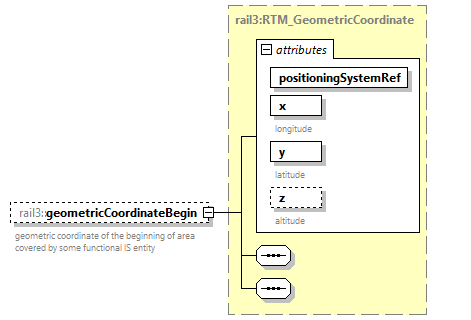 | ||||||||||||||||||||||||||||||||||||
| namespace | https://www.railml.org/schemas/3.2 | ||||||||||||||||||||||||||||||||||||
| type | rail3:RTM_GeometricCoordinate | ||||||||||||||||||||||||||||||||||||
| properties |
| ||||||||||||||||||||||||||||||||||||
| attributes |
| ||||||||||||||||||||||||||||||||||||
| annotation |
| ||||||||||||||||||||||||||||||||||||
| source | <xs:element name="geometricCoordinateBegin" type="rail3:RTM_GeometricCoordinate" minOccurs="0" maxOccurs="1"> <xs:annotation> <xs:documentation>geometric coordinate of the beginning of area covered by some functional IS entity</xs:documentation> </xs:annotation> </xs:element> |
element RTM_AssociatedNetElement/linearCoordinateBegin
| diagram | 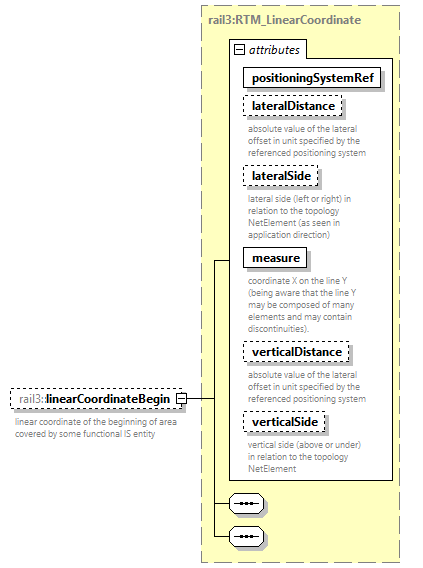 | ||||||||||||||||||||||||||||||||||||||||||||||||||||
| namespace | https://www.railml.org/schemas/3.2 | ||||||||||||||||||||||||||||||||||||||||||||||||||||
| type | rail3:RTM_LinearCoordinate | ||||||||||||||||||||||||||||||||||||||||||||||||||||
| properties |
| ||||||||||||||||||||||||||||||||||||||||||||||||||||
| attributes |
| ||||||||||||||||||||||||||||||||||||||||||||||||||||
| annotation |
| ||||||||||||||||||||||||||||||||||||||||||||||||||||
| source | <xs:element name="linearCoordinateBegin" type="rail3:RTM_LinearCoordinate" minOccurs="0" maxOccurs="1"> <xs:annotation> <xs:documentation>linear coordinate of the beginning of area covered by some functional IS entity</xs:documentation> </xs:annotation> </xs:element> |
element RTM_AssociatedNetElement/geometricCoordinateEnd
| diagram | 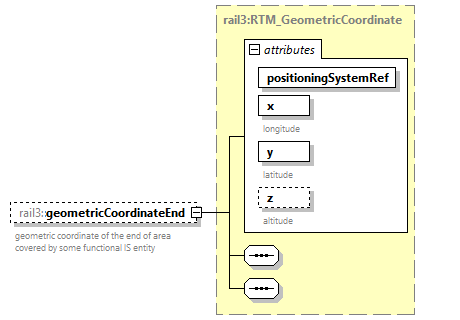 | ||||||||||||||||||||||||||||||||||||
| namespace | https://www.railml.org/schemas/3.2 | ||||||||||||||||||||||||||||||||||||
| type | rail3:RTM_GeometricCoordinate | ||||||||||||||||||||||||||||||||||||
| properties |
| ||||||||||||||||||||||||||||||||||||
| attributes |
| ||||||||||||||||||||||||||||||||||||
| annotation |
| ||||||||||||||||||||||||||||||||||||
| source | <xs:element name="geometricCoordinateEnd" type="rail3:RTM_GeometricCoordinate" minOccurs="0" maxOccurs="1"> <xs:annotation> <xs:documentation>geometric coordinate of the end of area covered by some functional IS entity</xs:documentation> </xs:annotation> </xs:element> |
element RTM_AssociatedNetElement/linearCoordinateEnd
| diagram | 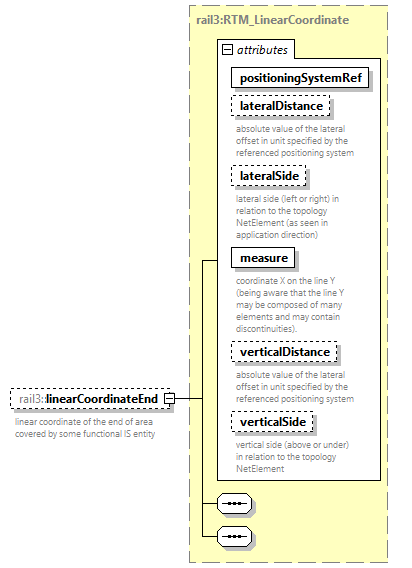 | ||||||||||||||||||||||||||||||||||||||||||||||||||||
| namespace | https://www.railml.org/schemas/3.2 | ||||||||||||||||||||||||||||||||||||||||||||||||||||
| type | rail3:RTM_LinearCoordinate | ||||||||||||||||||||||||||||||||||||||||||||||||||||
| properties |
| ||||||||||||||||||||||||||||||||||||||||||||||||||||
| attributes |
| ||||||||||||||||||||||||||||||||||||||||||||||||||||
| annotation |
| ||||||||||||||||||||||||||||||||||||||||||||||||||||
| source | <xs:element name="linearCoordinateEnd" type="rail3:RTM_LinearCoordinate" minOccurs="0" maxOccurs="1"> <xs:annotation> <xs:documentation>linear coordinate of the end of area covered by some functional IS entity</xs:documentation> </xs:annotation> </xs:element> |
complexType RTM_AssociatedPositioningSystem
| diagram | 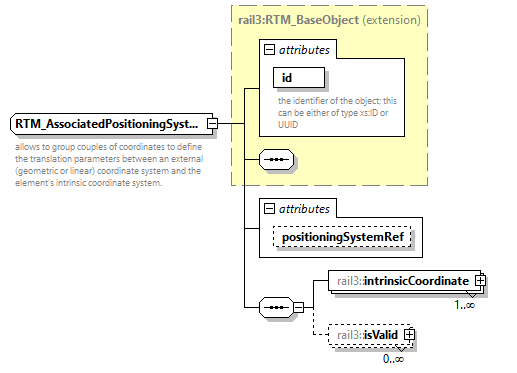 | ||||||||||||||||||||
| namespace | https://www.railml.org/schemas/3.2 | ||||||||||||||||||||
| type | extension of rail3:RTM_BaseObject | ||||||||||||||||||||
| properties |
| ||||||||||||||||||||
| children | rail3:intrinsicCoordinate rail3:isValid | ||||||||||||||||||||
| used by |
| ||||||||||||||||||||
| attributes |
| ||||||||||||||||||||
| annotation |
| ||||||||||||||||||||
| source | <xs:complexType name="RTM_AssociatedPositioningSystem"> <xs:annotation> <xs:documentation>allows to group couples of coordinates to define the translation parameters between an external (geometric or linear) coordinate system and the element’s intrinsic coordinate system.</xs:documentation> </xs:annotation> <xs:complexContent> <xs:extension base="rail3:RTM_BaseObject"> <xs:sequence> <xs:element name="intrinsicCoordinate" type="rail3:RTM_IntrinsicCoordinate" minOccurs="1" maxOccurs="unbounded"/> <xs:element name="isValid" type="rail3:RTM_Validity" minOccurs="0" maxOccurs="unbounded"/> </xs:sequence> <xs:attribute name="positioningSystemRef" type="rail3:tRef" use="optional"/> </xs:extension> </xs:complexContent> </xs:complexType> |
attribute RTM_AssociatedPositioningSystem/@positioningSystemRef
| type | rail3:tRef | ||
| properties |
| ||
| source | <xs:attribute name="positioningSystemRef" type="rail3:tRef" use="optional"/> |
element RTM_AssociatedPositioningSystem/intrinsicCoordinate
| diagram | 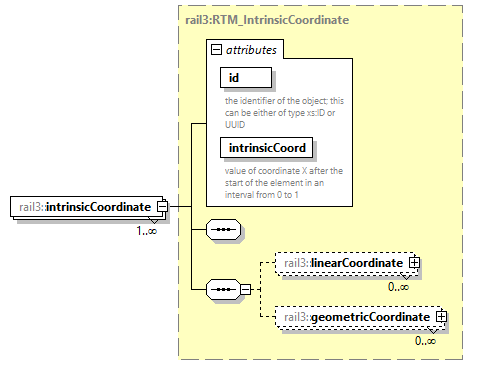 | ||||||||||||||||||||||
| namespace | https://www.railml.org/schemas/3.2 | ||||||||||||||||||||||
| type | rail3:RTM_IntrinsicCoordinate | ||||||||||||||||||||||
| properties |
| ||||||||||||||||||||||
| children | rail3:linearCoordinate rail3:geometricCoordinate | ||||||||||||||||||||||
| attributes |
| ||||||||||||||||||||||
| source | <xs:element name="intrinsicCoordinate" type="rail3:RTM_IntrinsicCoordinate" minOccurs="1" maxOccurs="unbounded"/> |
element RTM_AssociatedPositioningSystem/isValid
| diagram | 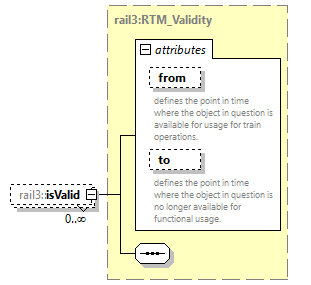 | ||||||||||||||||||||||
| namespace | https://www.railml.org/schemas/3.2 | ||||||||||||||||||||||
| type | rail3:RTM_Validity | ||||||||||||||||||||||
| properties |
| ||||||||||||||||||||||
| attributes |
| ||||||||||||||||||||||
| source | <xs:element name="isValid" type="rail3:RTM_Validity" minOccurs="0" maxOccurs="unbounded"/> |
complexType RTM_BaseObject
| diagram | 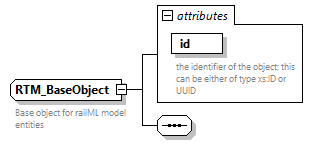 | ||||||||||||||
| namespace | https://www.railml.org/schemas/3.2 | ||||||||||||||
| properties |
| ||||||||||||||
| used by |
| ||||||||||||||
| attributes |
| ||||||||||||||
| annotation |
| ||||||||||||||
| source | <xs:complexType name="RTM_BaseObject" abstract="true"> <xs:annotation> <xs:documentation>Base object for railML model entities</xs:documentation> </xs:annotation> <xs:sequence/> <xs:attribute name="id" type="rail3:tID" use="required"> <xs:annotation> <xs:documentation>the identifier of the object; this can be either of type xs:ID or UUID</xs:documentation> </xs:annotation> </xs:attribute> </xs:complexType> |
attribute RTM_BaseObject/@id
| type | rail3:tID | ||
| properties |
| ||
| annotation |
| ||
| source | <xs:attribute name="id" type="rail3:tID" use="required"> <xs:annotation> <xs:documentation>the identifier of the object; this can be either of type xs:ID or UUID</xs:documentation> </xs:annotation> </xs:attribute> |
complexType RTM_CompositionNetElement
| diagram | 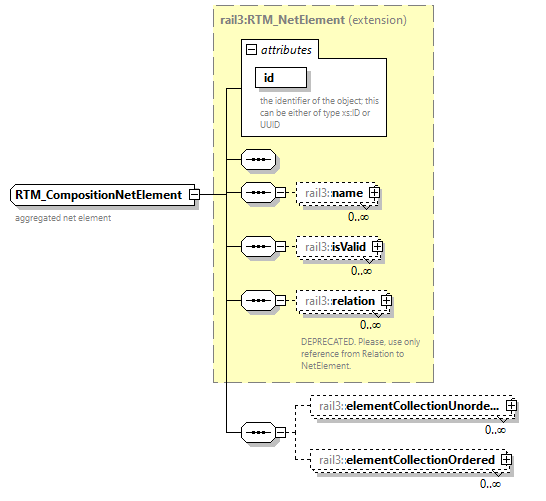 | ||||||||||||||
| namespace | https://www.railml.org/schemas/3.2 | ||||||||||||||
| type | extension of rail3:RTM_NetElement | ||||||||||||||
| properties |
| ||||||||||||||
| children | rail3:name rail3:isValid rail3:relation rail3:elementCollectionUnordered rail3:elementCollectionOrdered | ||||||||||||||
| used by |
| ||||||||||||||
| attributes |
| ||||||||||||||
| annotation |
| ||||||||||||||
| source | <xs:complexType name="RTM_CompositionNetElement"> <xs:annotation> <xs:documentation>aggregated net element</xs:documentation> </xs:annotation> <xs:complexContent> <xs:extension base="rail3:RTM_NetElement"> <xs:sequence> <xs:element name="elementCollectionUnordered" type="rail3:RTM_UnorderedCollection" minOccurs="0" maxOccurs="unbounded"/> <xs:element name="elementCollectionOrdered" type="rail3:RTM_OrderedCollection" minOccurs="0" maxOccurs="unbounded"/> </xs:sequence> </xs:extension> </xs:complexContent> </xs:complexType> |
element RTM_CompositionNetElement/elementCollectionUnordered
| diagram | 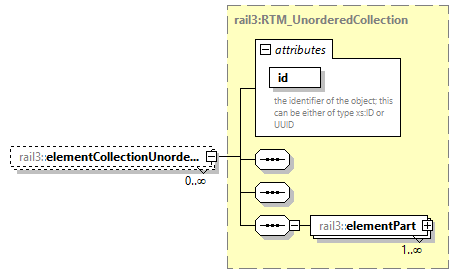 | ||||||||||||||
| namespace | https://www.railml.org/schemas/3.2 | ||||||||||||||
| type | rail3:RTM_UnorderedCollection | ||||||||||||||
| properties |
| ||||||||||||||
| children | rail3:elementPart | ||||||||||||||
| attributes |
| ||||||||||||||
| source | <xs:element name="elementCollectionUnordered" type="rail3:RTM_UnorderedCollection" minOccurs="0" maxOccurs="unbounded"/> |
element RTM_CompositionNetElement/elementCollectionOrdered
| diagram | 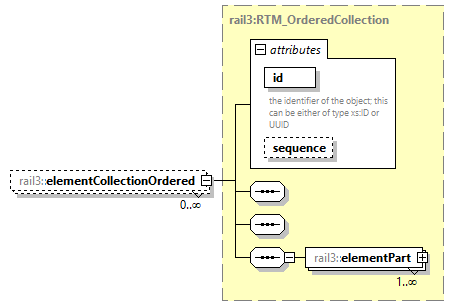 | ||||||||||||||||||||
| namespace | https://www.railml.org/schemas/3.2 | ||||||||||||||||||||
| type | rail3:RTM_OrderedCollection | ||||||||||||||||||||
| properties |
| ||||||||||||||||||||
| children | rail3:elementPart | ||||||||||||||||||||
| attributes |
| ||||||||||||||||||||
| source | <xs:element name="elementCollectionOrdered" type="rail3:RTM_OrderedCollection" minOccurs="0" maxOccurs="unbounded"/> |
complexType RTM_ElementPartCollection
| diagram | 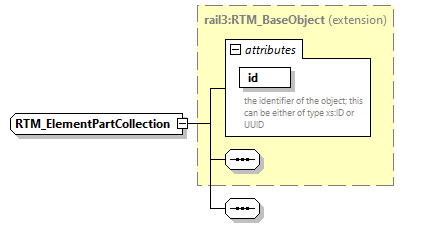 | ||||||||||||||
| namespace | https://www.railml.org/schemas/3.2 | ||||||||||||||
| type | extension of rail3:RTM_BaseObject | ||||||||||||||
| properties |
| ||||||||||||||
| used by |
| ||||||||||||||
| attributes |
| ||||||||||||||
| source | <xs:complexType name="RTM_ElementPartCollection" abstract="true"> <xs:complexContent> <xs:extension base="rail3:RTM_BaseObject"> <xs:sequence/> </xs:extension> </xs:complexContent> </xs:complexType> |
complexType RTM_EntityLocation
| diagram | 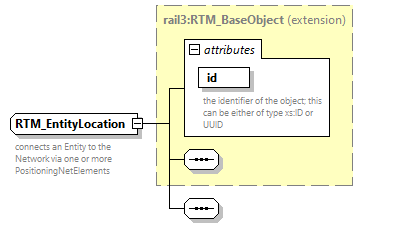 | ||||||||||||||
| namespace | https://www.railml.org/schemas/3.2 | ||||||||||||||
| type | extension of rail3:RTM_BaseObject | ||||||||||||||
| properties |
| ||||||||||||||
| used by |
| ||||||||||||||
| attributes |
| ||||||||||||||
| annotation |
| ||||||||||||||
| source | <xs:complexType name="RTM_EntityLocation" abstract="true"> <xs:annotation> <xs:documentation>connects an Entity to the Network via one or more PositioningNetElements</xs:documentation> </xs:annotation> <xs:complexContent> <xs:extension base="rail3:RTM_BaseObject"> <xs:sequence/> </xs:extension> </xs:complexContent> </xs:complexType> |
complexType RTM_GeometricCoordinate
| diagram | 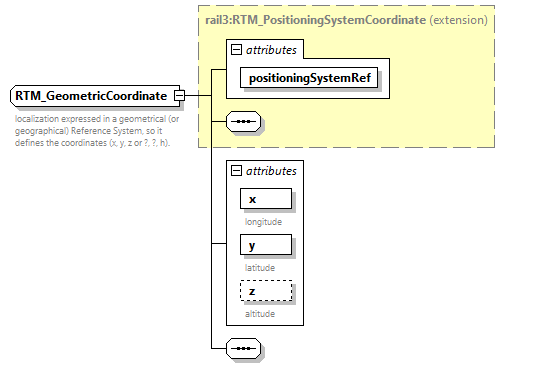 | ||||||||||||||||||||||||||||||||||||
| namespace | https://www.railml.org/schemas/3.2 | ||||||||||||||||||||||||||||||||||||
| type | extension of rail3:RTM_PositioningSystemCoordinate | ||||||||||||||||||||||||||||||||||||
| properties |
| ||||||||||||||||||||||||||||||||||||
| used by |
| ||||||||||||||||||||||||||||||||||||
| attributes |
| ||||||||||||||||||||||||||||||||||||
| annotation |
| ||||||||||||||||||||||||||||||||||||
| source | <xs:complexType name="RTM_GeometricCoordinate"> <xs:annotation> <xs:documentation>localization expressed in a geometrical (or geographical) Reference System, so it defines the coordinates (x, y, z or ?, ?, h).</xs:documentation> </xs:annotation> <xs:complexContent> <xs:extension base="rail3:RTM_PositioningSystemCoordinate"> <xs:sequence/> <xs:attribute name="x" type="xs:double" use="required"> <xs:annotation> <xs:documentation>longitude</xs:documentation> </xs:annotation> </xs:attribute> <xs:attribute name="y" type="xs:double" use="required"> <xs:annotation> <xs:documentation>latitude</xs:documentation> </xs:annotation> </xs:attribute> <xs:attribute name="z" type="xs:double" use="optional"> <xs:annotation> <xs:documentation>altitude</xs:documentation> </xs:annotation> </xs:attribute> </xs:extension> </xs:complexContent> </xs:complexType> |
attribute RTM_GeometricCoordinate/@x
| type | xs:double | ||
| properties |
| ||
| annotation |
| ||
| source | <xs:attribute name="x" type="xs:double" use="required"> <xs:annotation> <xs:documentation>longitude</xs:documentation> </xs:annotation> </xs:attribute> |
attribute RTM_GeometricCoordinate/@y
| type | xs:double | ||
| properties |
| ||
| annotation |
| ||
| source | <xs:attribute name="y" type="xs:double" use="required"> <xs:annotation> <xs:documentation>latitude</xs:documentation> </xs:annotation> </xs:attribute> |
attribute RTM_GeometricCoordinate/@z
| type | xs:double | ||
| properties |
| ||
| annotation |
| ||
| source | <xs:attribute name="z" type="xs:double" use="optional"> <xs:annotation> <xs:documentation>altitude</xs:documentation> </xs:annotation> </xs:attribute> |
complexType RTM_GeometricPositioningSystem
| diagram | 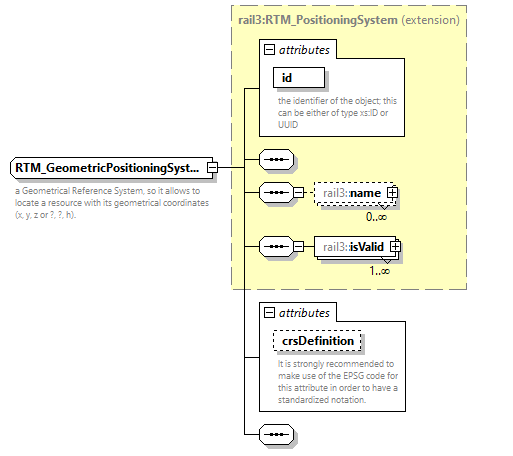 | ||||||||||||||||||||||
| namespace | https://www.railml.org/schemas/3.2 | ||||||||||||||||||||||
| type | extension of rail3:RTM_PositioningSystem | ||||||||||||||||||||||
| properties |
| ||||||||||||||||||||||
| children | rail3:name rail3:isValid | ||||||||||||||||||||||
| used by |
| ||||||||||||||||||||||
| attributes |
| ||||||||||||||||||||||
| annotation |
| ||||||||||||||||||||||
| source | <xs:complexType name="RTM_GeometricPositioningSystem"> <xs:annotation> <xs:documentation>a Geometrical Reference System, so it allows to locate a resource with its geometrical coordinates (x, y, z or ?, ?, h). </xs:documentation> </xs:annotation> <xs:complexContent> <xs:extension base="rail3:RTM_PositioningSystem"> <xs:sequence/> <xs:attribute name="crsDefinition" type="xs:string" use="optional"> <xs:annotation> <xs:documentation>It is strongly recommended to make use of the EPSG code for this attribute in order to have a standardized notation.</xs:documentation> </xs:annotation> </xs:attribute> </xs:extension> </xs:complexContent> </xs:complexType> |
attribute RTM_GeometricPositioningSystem/@crsDefinition
| type | xs:string | ||
| properties |
| ||
| annotation |
| ||
| source | <xs:attribute name="crsDefinition" type="xs:string" use="optional"> <xs:annotation> <xs:documentation>It is strongly recommended to make use of the EPSG code for this attribute in order to have a standardized notation.</xs:documentation> </xs:annotation> </xs:attribute> |
complexType RTM_IntrinsicCoordinate
| diagram | 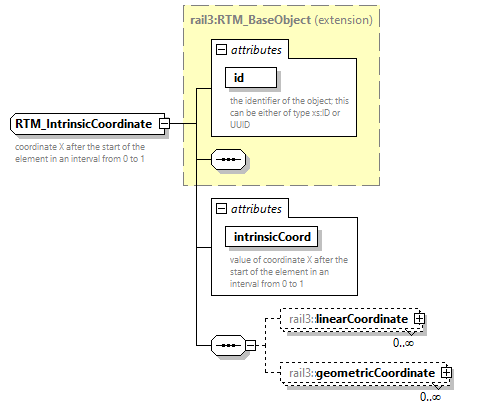 | ||||||||||||||||||||||
| namespace | https://www.railml.org/schemas/3.2 | ||||||||||||||||||||||
| type | extension of rail3:RTM_BaseObject | ||||||||||||||||||||||
| properties |
| ||||||||||||||||||||||
| children | rail3:linearCoordinate rail3:geometricCoordinate | ||||||||||||||||||||||
| used by |
| ||||||||||||||||||||||
| attributes |
| ||||||||||||||||||||||
| annotation |
| ||||||||||||||||||||||
| source | <xs:complexType name="RTM_IntrinsicCoordinate"> <xs:annotation> <xs:documentation>coordinate X after the start of the element in an interval from 0 to 1 </xs:documentation> </xs:annotation> <xs:complexContent> <xs:extension base="rail3:RTM_BaseObject"> <xs:sequence> <xs:element name="linearCoordinate" type="rail3:RTM_LinearCoordinate" minOccurs="0" maxOccurs="unbounded"/> <xs:element name="geometricCoordinate" type="rail3:RTM_GeometricCoordinate" minOccurs="0" maxOccurs="unbounded"/> </xs:sequence> <xs:attribute name="intrinsicCoord" type="xs:double" use="required"> <xs:annotation> <xs:documentation>value of coordinate X after the start of the element in an interval from 0 to 1 </xs:documentation> </xs:annotation> </xs:attribute> </xs:extension> </xs:complexContent> </xs:complexType> |
attribute RTM_IntrinsicCoordinate/@intrinsicCoord
| type | xs:double | ||
| properties |
| ||
| annotation |
| ||
| source | <xs:attribute name="intrinsicCoord" type="xs:double" use="required"> <xs:annotation> <xs:documentation>value of coordinate X after the start of the element in an interval from 0 to 1 </xs:documentation> </xs:annotation> </xs:attribute> |
element RTM_IntrinsicCoordinate/linearCoordinate
| diagram | 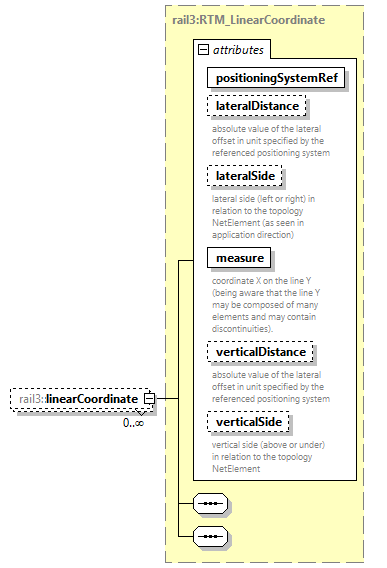 | ||||||||||||||||||||||||||||||||||||||||||||||||||||
| namespace | https://www.railml.org/schemas/3.2 | ||||||||||||||||||||||||||||||||||||||||||||||||||||
| type | rail3:RTM_LinearCoordinate | ||||||||||||||||||||||||||||||||||||||||||||||||||||
| properties |
| ||||||||||||||||||||||||||||||||||||||||||||||||||||
| attributes |
| ||||||||||||||||||||||||||||||||||||||||||||||||||||
| source | <xs:element name="linearCoordinate" type="rail3:RTM_LinearCoordinate" minOccurs="0" maxOccurs="unbounded"/> |
element RTM_IntrinsicCoordinate/geometricCoordinate
| diagram | 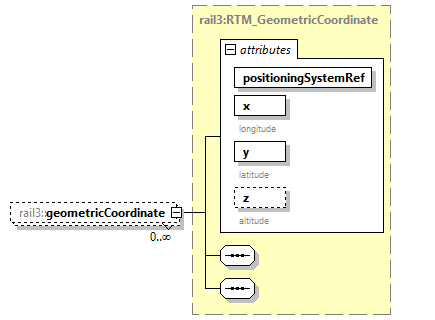 | ||||||||||||||||||||||||||||||||||||
| namespace | https://www.railml.org/schemas/3.2 | ||||||||||||||||||||||||||||||||||||
| type | rail3:RTM_GeometricCoordinate | ||||||||||||||||||||||||||||||||||||
| properties |
| ||||||||||||||||||||||||||||||||||||
| attributes |
| ||||||||||||||||||||||||||||||||||||
| source | <xs:element name="geometricCoordinate" type="rail3:RTM_GeometricCoordinate" minOccurs="0" maxOccurs="unbounded"/> |
complexType RTM_LevelNetwork
| diagram | 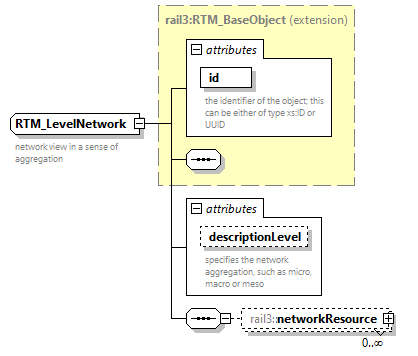 | ||||||||||||||||||||||
| namespace | https://www.railml.org/schemas/3.2 | ||||||||||||||||||||||
| type | extension of rail3:RTM_BaseObject | ||||||||||||||||||||||
| properties |
| ||||||||||||||||||||||
| children | rail3:networkResource | ||||||||||||||||||||||
| used by |
| ||||||||||||||||||||||
| attributes |
| ||||||||||||||||||||||
| annotation |
| ||||||||||||||||||||||
| source | <xs:complexType name="RTM_LevelNetwork"> <xs:annotation> <xs:documentation>network view in a sense of aggregation</xs:documentation> </xs:annotation> <xs:complexContent> <xs:extension base="rail3:RTM_BaseObject"> <xs:sequence> <xs:element name="networkResource" type="rail3:tElementWithIDref" minOccurs="0" maxOccurs="unbounded"/> </xs:sequence> <xs:attribute name="descriptionLevel" type="rail3:tDescriptionLevel" use="optional"> <xs:annotation> <xs:documentation>specifies the network aggregation, such as micro, macro or meso</xs:documentation> </xs:annotation> </xs:attribute> </xs:extension> </xs:complexContent> </xs:complexType> |
attribute RTM_LevelNetwork/@descriptionLevel
| type | rail3:tDescriptionLevel | ||||||||||||
| properties |
| ||||||||||||
| facets |
| ||||||||||||
| annotation |
| ||||||||||||
| source | <xs:attribute name="descriptionLevel" type="rail3:tDescriptionLevel" use="optional"> <xs:annotation> <xs:documentation>specifies the network aggregation, such as micro, macro or meso</xs:documentation> </xs:annotation> </xs:attribute> |
element RTM_LevelNetwork/networkResource
| diagram | 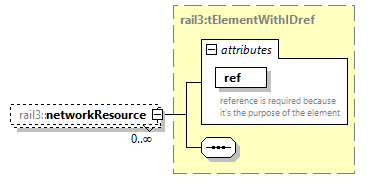 | ||||||||||||||
| namespace | https://www.railml.org/schemas/3.2 | ||||||||||||||
| type | rail3:tElementWithIDref | ||||||||||||||
| properties |
| ||||||||||||||
| attributes |
| ||||||||||||||
| source | <xs:element name="networkResource" type="rail3:tElementWithIDref" minOccurs="0" maxOccurs="unbounded"/> |
complexType RTM_LinearAnchorPoint
| diagram | 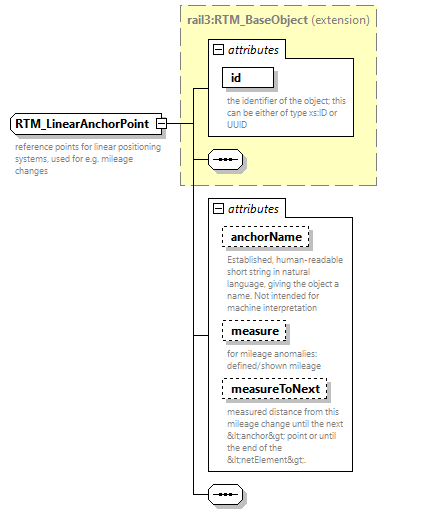 | ||||||||||||||||||||||||||||||||||||||
| namespace | https://www.railml.org/schemas/3.2 | ||||||||||||||||||||||||||||||||||||||
| type | extension of rail3:RTM_BaseObject | ||||||||||||||||||||||||||||||||||||||
| properties |
| ||||||||||||||||||||||||||||||||||||||
| used by |
| ||||||||||||||||||||||||||||||||||||||
| attributes |
| ||||||||||||||||||||||||||||||||||||||
| annotation |
| ||||||||||||||||||||||||||||||||||||||
| source | <xs:complexType name="RTM_LinearAnchorPoint"> <xs:annotation> <xs:documentation>reference points for linear positioning systems, used for e.g. mileage changes</xs:documentation> </xs:annotation> <xs:complexContent> <xs:extension base="rail3:RTM_BaseObject"> <xs:sequence/> <xs:attribute name="anchorName" type="xs:string" use="optional"> <xs:annotation> <xs:documentation>Established, human-readable short string in natural language, giving the object a name. Not intended for machine interpretation</xs:documentation> </xs:annotation> </xs:attribute> <xs:attribute name="measure" type="xs:double" use="optional"> <xs:annotation> <xs:documentation>for mileage anomalies: defined/shown mileage</xs:documentation> </xs:annotation> </xs:attribute> <xs:attribute name="measureToNext" type="xs:double" use="optional"> <xs:annotation> <xs:documentation>measured distance from this mileage change until the next <anchor> point or until the end of the <netElement>. </xs:documentation> </xs:annotation> </xs:attribute> </xs:extension> </xs:complexContent> </xs:complexType> |
attribute RTM_LinearAnchorPoint/@anchorName
| type | xs:string | ||
| properties |
| ||
| annotation |
| ||
| source | <xs:attribute name="anchorName" type="xs:string" use="optional"> <xs:annotation> <xs:documentation>Established, human-readable short string in natural language, giving the object a name. Not intended for machine interpretation</xs:documentation> </xs:annotation> </xs:attribute> |
attribute RTM_LinearAnchorPoint/@measure
| type | xs:double | ||
| properties |
| ||
| annotation |
| ||
| source | <xs:attribute name="measure" type="xs:double" use="optional"> <xs:annotation> <xs:documentation>for mileage anomalies: defined/shown mileage</xs:documentation> </xs:annotation> </xs:attribute> |
attribute RTM_LinearAnchorPoint/@measureToNext
| type | xs:double | ||
| properties |
| ||
| annotation |
| ||
| source | <xs:attribute name="measureToNext" type="xs:double" use="optional"> <xs:annotation> <xs:documentation>measured distance from this mileage change until the next <anchor> point or until the end of the <netElement>. </xs:documentation> </xs:annotation> </xs:attribute> |
complexType RTM_LinearCoordinate
| diagram | 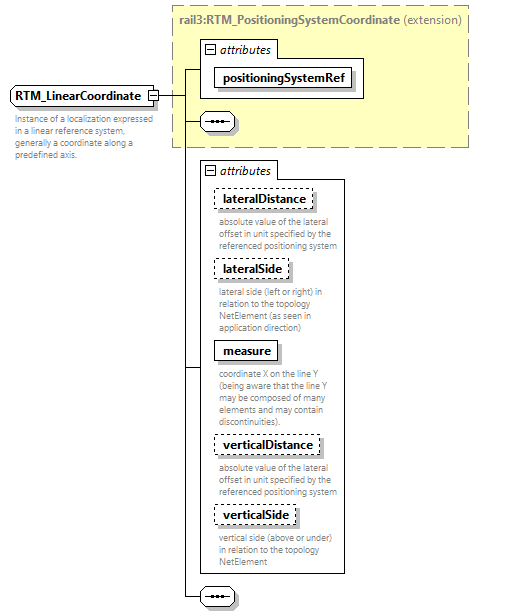 | ||||||||||||||||||||||||||||||||||||||||||||||||||||
| namespace | https://www.railml.org/schemas/3.2 | ||||||||||||||||||||||||||||||||||||||||||||||||||||
| type | extension of rail3:RTM_PositioningSystemCoordinate | ||||||||||||||||||||||||||||||||||||||||||||||||||||
| properties |
| ||||||||||||||||||||||||||||||||||||||||||||||||||||
| used by |
| ||||||||||||||||||||||||||||||||||||||||||||||||||||
| attributes |
| ||||||||||||||||||||||||||||||||||||||||||||||||||||
| annotation |
| ||||||||||||||||||||||||||||||||||||||||||||||||||||
| source | <xs:complexType name="RTM_LinearCoordinate"> <xs:annotation> <xs:documentation>Instance of a localization expressed in a linear reference system, generally a coordinate along a predefined axis.</xs:documentation> </xs:annotation> <xs:complexContent> <xs:extension base="rail3:RTM_PositioningSystemCoordinate"> <xs:sequence/> <xs:attribute name="lateralDistance" type="xs:double" use="optional"> <xs:annotation> <xs:documentation>absolute value of the lateral offset in unit specified by the referenced positioning system</xs:documentation> </xs:annotation> </xs:attribute> <xs:attribute name="lateralSide" type="rail3:tLateralSide" use="optional"> <xs:annotation> <xs:documentation>lateral side (left or right) in relation to the topology NetElement (as seen in application direction)</xs:documentation> </xs:annotation> </xs:attribute> <xs:attribute name="measure" type="xs:double" use="required"> <xs:annotation> <xs:documentation>coordinate X on the line Y (being aware that the line Y may be composed of many elements and may contain discontinuities).</xs:documentation> </xs:annotation> </xs:attribute> <xs:attribute name="verticalDistance" type="xs:double" use="optional"> <xs:annotation> <xs:documentation>absolute value of the lateral offset in unit specified by the referenced positioning system</xs:documentation> </xs:annotation> </xs:attribute> <xs:attribute name="verticalSide" type="rail3:tVerticalSide" use="optional"> <xs:annotation> <xs:documentation>vertical side (above or under) in relation to the topology NetElement</xs:documentation> </xs:annotation> </xs:attribute> </xs:extension> </xs:complexContent> </xs:complexType> |
attribute RTM_LinearCoordinate/@lateralDistance
| type | xs:double | ||
| properties |
| ||
| annotation |
| ||
| source | <xs:attribute name="lateralDistance" type="xs:double" use="optional"> <xs:annotation> <xs:documentation>absolute value of the lateral offset in unit specified by the referenced positioning system</xs:documentation> </xs:annotation> </xs:attribute> |
attribute RTM_LinearCoordinate/@lateralSide
| type | rail3:tLateralSide | ||||||||||||
| properties |
| ||||||||||||
| facets |
| ||||||||||||
| annotation |
| ||||||||||||
| source | <xs:attribute name="lateralSide" type="rail3:tLateralSide" use="optional"> <xs:annotation> <xs:documentation>lateral side (left or right) in relation to the topology NetElement (as seen in application direction)</xs:documentation> </xs:annotation> </xs:attribute> |
attribute RTM_LinearCoordinate/@measure
| type | xs:double | ||
| properties |
| ||
| annotation |
| ||
| source | <xs:attribute name="measure" type="xs:double" use="required"> <xs:annotation> <xs:documentation>coordinate X on the line Y (being aware that the line Y may be composed of many elements and may contain discontinuities).</xs:documentation> </xs:annotation> </xs:attribute> |
attribute RTM_LinearCoordinate/@verticalDistance
| type | xs:double | ||
| properties |
| ||
| annotation |
| ||
| source | <xs:attribute name="verticalDistance" type="xs:double" use="optional"> <xs:annotation> <xs:documentation>absolute value of the lateral offset in unit specified by the referenced positioning system</xs:documentation> </xs:annotation> </xs:attribute> |
attribute RTM_LinearCoordinate/@verticalSide
| type | rail3:tVerticalSide | |||||||||
| properties |
| |||||||||
| facets |
| |||||||||
| annotation |
| |||||||||
| source | <xs:attribute name="verticalSide" type="rail3:tVerticalSide" use="optional"> <xs:annotation> <xs:documentation>vertical side (above or under) in relation to the topology NetElement</xs:documentation> </xs:annotation> </xs:attribute> |
complexType RTM_LinearLocation
| diagram | 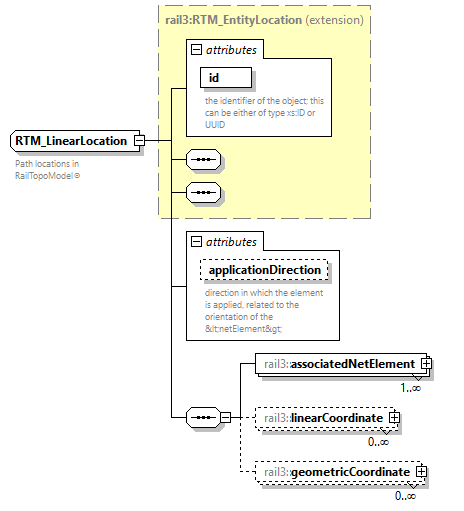 | ||||||||||||||||||||||
| namespace | https://www.railml.org/schemas/3.2 | ||||||||||||||||||||||
| type | extension of rail3:RTM_EntityLocation | ||||||||||||||||||||||
| properties |
| ||||||||||||||||||||||
| children | rail3:associatedNetElement rail3:linearCoordinate rail3:geometricCoordinate | ||||||||||||||||||||||
| used by |
| ||||||||||||||||||||||
| attributes |
| ||||||||||||||||||||||
| annotation |
| ||||||||||||||||||||||
| source | <xs:complexType name="RTM_LinearLocation"> <xs:annotation> <xs:documentation>Path locations in RailTopoModel®</xs:documentation> </xs:annotation> <xs:complexContent> <xs:extension base="rail3:RTM_EntityLocation"> <xs:sequence> <xs:element name="associatedNetElement" type="rail3:RTM_AssociatedNetElement" minOccurs="1" maxOccurs="unbounded"/> <xs:element name="linearCoordinate" type="rail3:RTM_LinearCoordinate" minOccurs="0" maxOccurs="unbounded"/> <xs:element name="geometricCoordinate" type="rail3:RTM_GeometricCoordinate" minOccurs="0" maxOccurs="unbounded"/> </xs:sequence> <xs:attribute name="applicationDirection" type="rail3:tApplicationDirection" use="optional"> <xs:annotation> <xs:documentation>direction in which the element is applied, related to the orientation of the <netElement></xs:documentation> </xs:annotation> </xs:attribute> </xs:extension> </xs:complexContent> </xs:complexType> |
attribute RTM_LinearLocation/@applicationDirection
| type | rail3:tApplicationDirection | ||||||||||||
| properties |
| ||||||||||||
| facets |
| ||||||||||||
| annotation |
| ||||||||||||
| source | <xs:attribute name="applicationDirection" type="rail3:tApplicationDirection" use="optional"> <xs:annotation> <xs:documentation>direction in which the element is applied, related to the orientation of the <netElement></xs:documentation> </xs:annotation> </xs:attribute> |
element RTM_LinearLocation/associatedNetElement
| diagram | 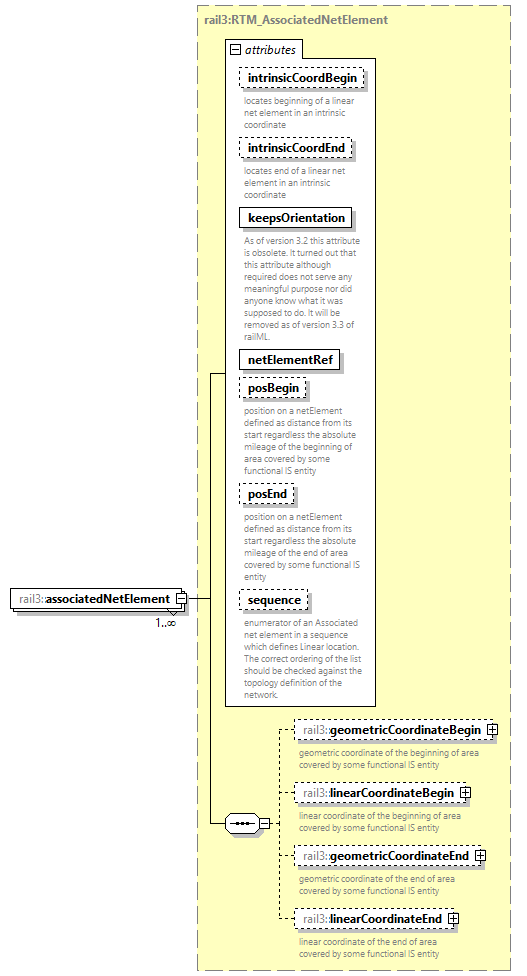 | ||||||||||||||||||||||||||||||||||||||||||||||||||||||||||||
| namespace | https://www.railml.org/schemas/3.2 | ||||||||||||||||||||||||||||||||||||||||||||||||||||||||||||
| type | rail3:RTM_AssociatedNetElement | ||||||||||||||||||||||||||||||||||||||||||||||||||||||||||||
| properties |
| ||||||||||||||||||||||||||||||||||||||||||||||||||||||||||||
| children | rail3:geometricCoordinateBegin rail3:linearCoordinateBegin rail3:geometricCoordinateEnd rail3:linearCoordinateEnd | ||||||||||||||||||||||||||||||||||||||||||||||||||||||||||||
| attributes |
| ||||||||||||||||||||||||||||||||||||||||||||||||||||||||||||
| source | <xs:element name="associatedNetElement" type="rail3:RTM_AssociatedNetElement" minOccurs="1" maxOccurs="unbounded"/> |
element RTM_LinearLocation/linearCoordinate
| diagram | 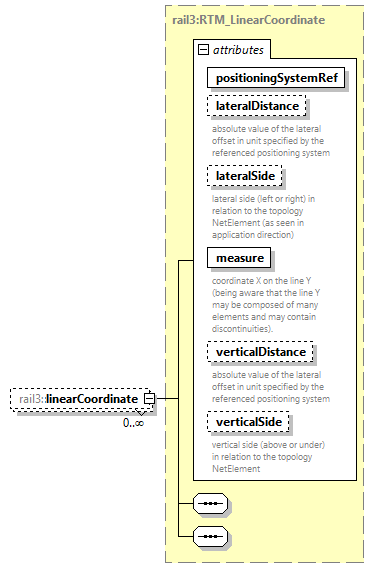 | ||||||||||||||||||||||||||||||||||||||||||||||||||||
| namespace | https://www.railml.org/schemas/3.2 | ||||||||||||||||||||||||||||||||||||||||||||||||||||
| type | rail3:RTM_LinearCoordinate | ||||||||||||||||||||||||||||||||||||||||||||||||||||
| properties |
| ||||||||||||||||||||||||||||||||||||||||||||||||||||
| attributes |
| ||||||||||||||||||||||||||||||||||||||||||||||||||||
| source | <xs:element name="linearCoordinate" type="rail3:RTM_LinearCoordinate" minOccurs="0" maxOccurs="unbounded"/> |
element RTM_LinearLocation/geometricCoordinate
| diagram | 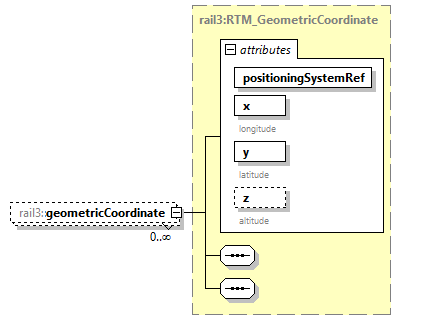 | ||||||||||||||||||||||||||||||||||||
| namespace | https://www.railml.org/schemas/3.2 | ||||||||||||||||||||||||||||||||||||
| type | rail3:RTM_GeometricCoordinate | ||||||||||||||||||||||||||||||||||||
| properties |
| ||||||||||||||||||||||||||||||||||||
| attributes |
| ||||||||||||||||||||||||||||||||||||
| source | <xs:element name="geometricCoordinate" type="rail3:RTM_GeometricCoordinate" minOccurs="0" maxOccurs="unbounded"/> |
complexType RTM_LinearNetElement
| diagram | 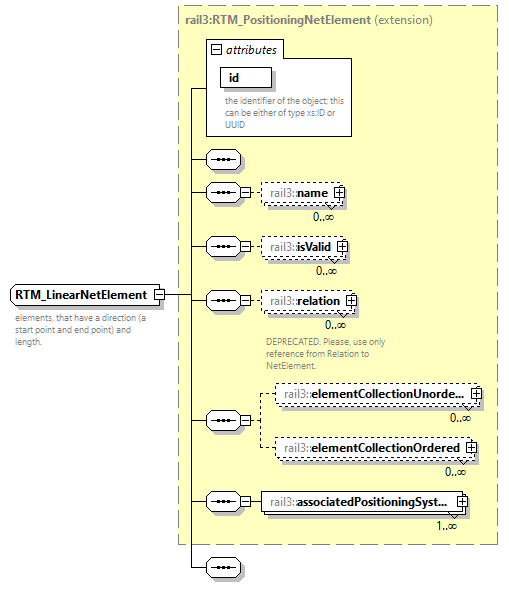 | ||||||||||||||
| namespace | https://www.railml.org/schemas/3.2 | ||||||||||||||
| type | extension of rail3:RTM_PositioningNetElement | ||||||||||||||
| properties |
| ||||||||||||||
| children | rail3:name rail3:isValid rail3:relation rail3:elementCollectionUnordered rail3:elementCollectionOrdered rail3:associatedPositioningSystem | ||||||||||||||
| attributes |
| ||||||||||||||
| annotation |
| ||||||||||||||
| source | <xs:complexType name="RTM_LinearNetElement"> <xs:annotation> <xs:documentation>elements, that have a direction (a start point and end point) and length.</xs:documentation> </xs:annotation> <xs:complexContent> <xs:extension base="rail3:RTM_PositioningNetElement"> <xs:sequence/> </xs:extension> </xs:complexContent> </xs:complexType> |
complexType RTM_LinearPositioningSystem
| diagram | 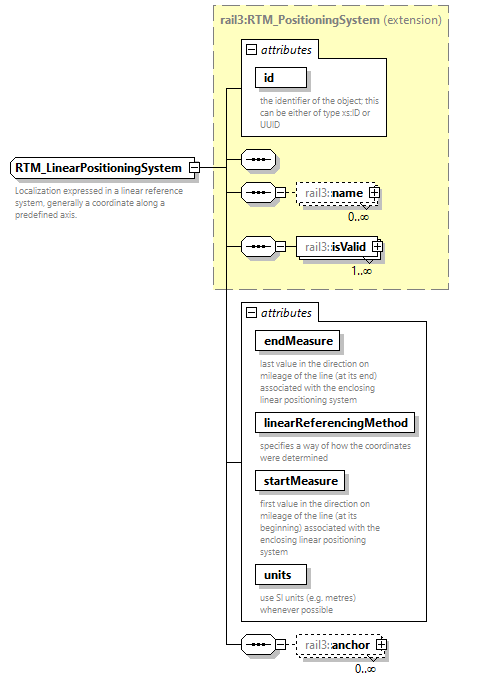 | ||||||||||||||||||||||||||||||||||||||||||||||
| namespace | https://www.railml.org/schemas/3.2 | ||||||||||||||||||||||||||||||||||||||||||||||
| type | extension of rail3:RTM_PositioningSystem | ||||||||||||||||||||||||||||||||||||||||||||||
| properties |
| ||||||||||||||||||||||||||||||||||||||||||||||
| children | rail3:name rail3:isValid rail3:anchor | ||||||||||||||||||||||||||||||||||||||||||||||
| used by |
| ||||||||||||||||||||||||||||||||||||||||||||||
| attributes |
| ||||||||||||||||||||||||||||||||||||||||||||||
| annotation |
| ||||||||||||||||||||||||||||||||||||||||||||||
| source | <xs:complexType name="RTM_LinearPositioningSystem"> <xs:annotation> <xs:documentation>Localization expressed in a linear reference system, generally a coordinate along a predefined axis.</xs:documentation> </xs:annotation> <xs:complexContent> <xs:extension base="rail3:RTM_PositioningSystem"> <xs:sequence> <xs:element name="anchor" type="rail3:RTM_LinearAnchorPoint" minOccurs="0" maxOccurs="unbounded"/> </xs:sequence> <xs:attribute name="endMeasure" type="xs:double" use="required"> <xs:annotation> <xs:documentation>last value in the direction on mileage of the line (at its end) associated with the enclosing linear positioning system</xs:documentation> </xs:annotation> </xs:attribute> <xs:attribute name="linearReferencingMethod" type="rail3:tLrsMethod" use="required"> <xs:annotation> <xs:documentation>specifies a way of how the coordinates were determined</xs:documentation> </xs:annotation> </xs:attribute> <xs:attribute name="startMeasure" type="xs:double" use="required"> <xs:annotation> <xs:documentation>first value in the direction on mileage of the line (at its beginning) associated with the enclosing linear positioning system</xs:documentation> </xs:annotation> </xs:attribute> <xs:attribute name="units" type="xs:string" use="required"> <xs:annotation> <xs:documentation>use SI units (e.g. metres) whenever possible</xs:documentation> </xs:annotation> </xs:attribute> </xs:extension> </xs:complexContent> </xs:complexType> |
attribute RTM_LinearPositioningSystem/@endMeasure
| type | xs:double | ||
| properties |
| ||
| annotation |
| ||
| source | <xs:attribute name="endMeasure" type="xs:double" use="required"> <xs:annotation> <xs:documentation>last value in the direction on mileage of the line (at its end) associated with the enclosing linear positioning system</xs:documentation> </xs:annotation> </xs:attribute> |
attribute RTM_LinearPositioningSystem/@linearReferencingMethod
| type | rail3:tLrsMethod | ||||||||||||
| properties |
| ||||||||||||
| facets |
| ||||||||||||
| annotation |
| ||||||||||||
| source | <xs:attribute name="linearReferencingMethod" type="rail3:tLrsMethod" use="required"> <xs:annotation> <xs:documentation>specifies a way of how the coordinates were determined</xs:documentation> </xs:annotation> </xs:attribute> |
attribute RTM_LinearPositioningSystem/@startMeasure
| type | xs:double | ||
| properties |
| ||
| annotation |
| ||
| source | <xs:attribute name="startMeasure" type="xs:double" use="required"> <xs:annotation> <xs:documentation>first value in the direction on mileage of the line (at its beginning) associated with the enclosing linear positioning system</xs:documentation> </xs:annotation> </xs:attribute> |
attribute RTM_LinearPositioningSystem/@units
| type | xs:string | ||
| properties |
| ||
| annotation |
| ||
| source | <xs:attribute name="units" type="xs:string" use="required"> <xs:annotation> <xs:documentation>use SI units (e.g. metres) whenever possible</xs:documentation> </xs:annotation> </xs:attribute> |
element RTM_LinearPositioningSystem/anchor
| diagram | 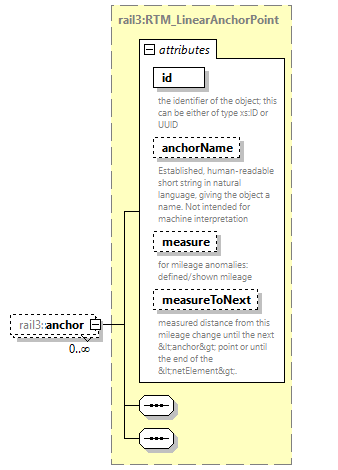 | ||||||||||||||||||||||||||||||||||||||
| namespace | https://www.railml.org/schemas/3.2 | ||||||||||||||||||||||||||||||||||||||
| type | rail3:RTM_LinearAnchorPoint | ||||||||||||||||||||||||||||||||||||||
| properties |
| ||||||||||||||||||||||||||||||||||||||
| attributes |
| ||||||||||||||||||||||||||||||||||||||
| source | <xs:element name="anchor" type="rail3:RTM_LinearAnchorPoint" minOccurs="0" maxOccurs="unbounded"/> |
complexType RTM_LocatedNetEntity
| diagram | 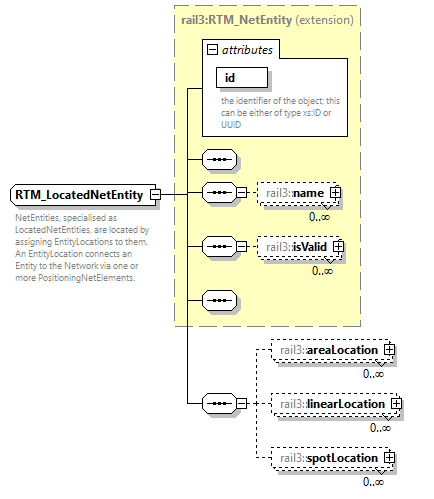 | ||||||||||||||
| namespace | https://www.railml.org/schemas/3.2 | ||||||||||||||
| type | extension of rail3:RTM_NetEntity | ||||||||||||||
| properties |
| ||||||||||||||
| children | rail3:name rail3:isValid rail3:areaLocation rail3:linearLocation rail3:spotLocation | ||||||||||||||
| used by |
| ||||||||||||||
| attributes |
| ||||||||||||||
| annotation |
| ||||||||||||||
| source | <xs:complexType name="RTM_LocatedNetEntity"> <xs:annotation> <xs:documentation>NetEntities, specialised as LocatedNetEntities, are located by assigning EntityLocations to them. An EntityLocation connects an Entity to the Network via one or more PositioningNetElements.</xs:documentation> </xs:annotation> <xs:complexContent> <xs:extension base="rail3:RTM_NetEntity"> <xs:sequence> <xs:element name="areaLocation" type="rail3:RTM_AreaLocation" minOccurs="0" maxOccurs="unbounded"/> <xs:element name="linearLocation" type="rail3:RTM_LinearLocation" minOccurs="0" maxOccurs="unbounded"/> <xs:element name="spotLocation" type="rail3:RTM_SpotLocation" minOccurs="0" maxOccurs="unbounded"/> </xs:sequence> </xs:extension> </xs:complexContent> </xs:complexType> |
element RTM_LocatedNetEntity/areaLocation
| diagram | 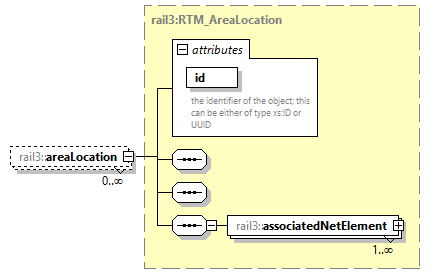 | ||||||||||||||
| namespace | https://www.railml.org/schemas/3.2 | ||||||||||||||
| type | rail3:RTM_AreaLocation | ||||||||||||||
| properties |
| ||||||||||||||
| children | rail3:associatedNetElement | ||||||||||||||
| attributes |
| ||||||||||||||
| source | <xs:element name="areaLocation" type="rail3:RTM_AreaLocation" minOccurs="0" maxOccurs="unbounded"/> |
element RTM_LocatedNetEntity/linearLocation
| diagram | 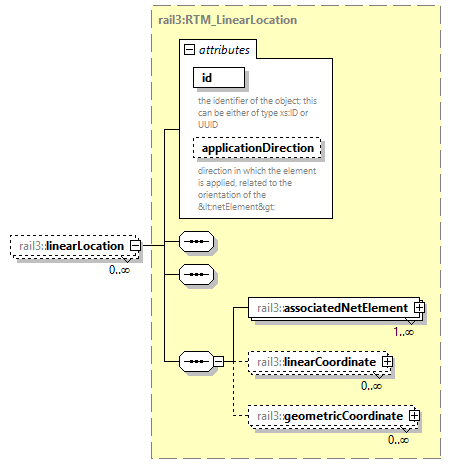 | ||||||||||||||||||||||
| namespace | https://www.railml.org/schemas/3.2 | ||||||||||||||||||||||
| type | rail3:RTM_LinearLocation | ||||||||||||||||||||||
| properties |
| ||||||||||||||||||||||
| children | rail3:associatedNetElement rail3:linearCoordinate rail3:geometricCoordinate | ||||||||||||||||||||||
| attributes |
| ||||||||||||||||||||||
| source | <xs:element name="linearLocation" type="rail3:RTM_LinearLocation" minOccurs="0" maxOccurs="unbounded"/> |
element RTM_LocatedNetEntity/spotLocation
| diagram | 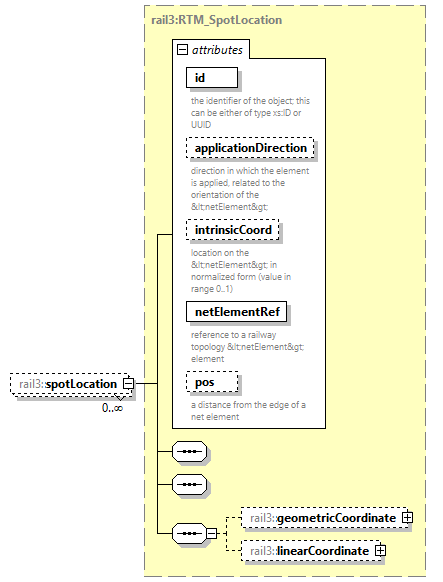 | ||||||||||||||||||||||||||||||||||||||||||||||
| namespace | https://www.railml.org/schemas/3.2 | ||||||||||||||||||||||||||||||||||||||||||||||
| type | rail3:RTM_SpotLocation | ||||||||||||||||||||||||||||||||||||||||||||||
| properties |
| ||||||||||||||||||||||||||||||||||||||||||||||
| children | rail3:geometricCoordinate rail3:linearCoordinate | ||||||||||||||||||||||||||||||||||||||||||||||
| attributes |
| ||||||||||||||||||||||||||||||||||||||||||||||
| source | <xs:element name="spotLocation" type="rail3:RTM_SpotLocation" minOccurs="0" maxOccurs="unbounded"/> |
complexType RTM_NamedResource
| diagram | 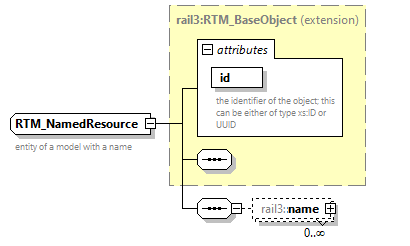 | ||||||||||||||
| namespace | https://www.railml.org/schemas/3.2 | ||||||||||||||
| type | extension of rail3:RTM_BaseObject | ||||||||||||||
| properties |
| ||||||||||||||
| children | rail3:name | ||||||||||||||
| used by |
| ||||||||||||||
| attributes |
| ||||||||||||||
| annotation |
| ||||||||||||||
| source | <xs:complexType name="RTM_NamedResource"> <xs:annotation> <xs:documentation>entity of a model with a name</xs:documentation> </xs:annotation> <xs:complexContent> <xs:extension base="rail3:RTM_BaseObject"> <xs:sequence> <xs:element name="name" type="rail3:Name" minOccurs="0" maxOccurs="unbounded"/> </xs:sequence> </xs:extension> </xs:complexContent> </xs:complexType> |
element RTM_NamedResource/name
| diagram | 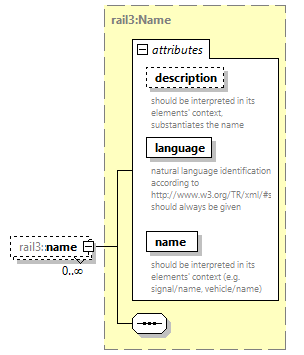 | ||||||||||||||||||||||||||||||
| namespace | https://www.railml.org/schemas/3.2 | ||||||||||||||||||||||||||||||
| type | rail3:Name | ||||||||||||||||||||||||||||||
| properties |
| ||||||||||||||||||||||||||||||
| attributes |
| ||||||||||||||||||||||||||||||
| source | <xs:element name="name" type="rail3:Name" minOccurs="0" maxOccurs="unbounded"/> |
complexType RTM_NetElement
| diagram | 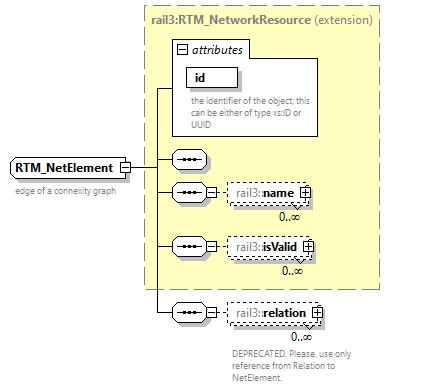 | ||||||||||||||
| namespace | https://www.railml.org/schemas/3.2 | ||||||||||||||
| type | extension of rail3:RTM_NetworkResource | ||||||||||||||
| properties |
| ||||||||||||||
| children | rail3:name rail3:isValid rail3:relation | ||||||||||||||
| used by |
| ||||||||||||||
| attributes |
| ||||||||||||||
| annotation |
| ||||||||||||||
| source | <xs:complexType name="RTM_NetElement"> <xs:annotation> <xs:documentation>edge of a connexity graph</xs:documentation> </xs:annotation> <xs:complexContent> <xs:extension base="rail3:RTM_NetworkResource"> <xs:sequence> <xs:element name="relation" type="rail3:tElementWithIDref" form="qualified" minOccurs="0" maxOccurs="unbounded"> <xs:annotation> <xs:documentation>DEPRECATED. Please, use only reference from Relation to NetElement.</xs:documentation> </xs:annotation> </xs:element> </xs:sequence> </xs:extension> </xs:complexContent> </xs:complexType> |
element RTM_NetElement/relation
| diagram | 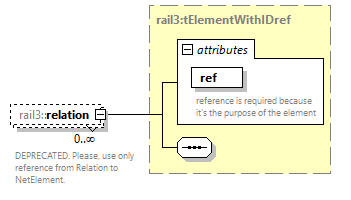 | ||||||||||||||
| namespace | https://www.railml.org/schemas/3.2 | ||||||||||||||
| type | rail3:tElementWithIDref | ||||||||||||||
| properties |
| ||||||||||||||
| attributes |
| ||||||||||||||
| annotation |
| ||||||||||||||
| source | <xs:element name="relation" type="rail3:tElementWithIDref" form="qualified" minOccurs="0" maxOccurs="unbounded"> <xs:annotation> <xs:documentation>DEPRECATED. Please, use only reference from Relation to NetElement.</xs:documentation> </xs:annotation> </xs:element> |
complexType RTM_NetEntity
| diagram | 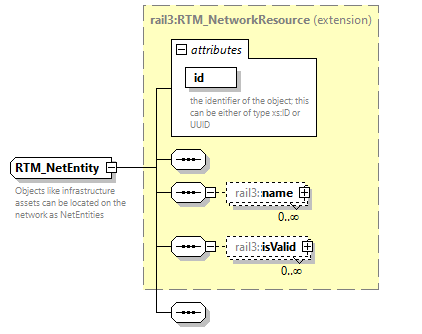 | ||||||||||||||
| namespace | https://www.railml.org/schemas/3.2 | ||||||||||||||
| type | extension of rail3:RTM_NetworkResource | ||||||||||||||
| properties |
| ||||||||||||||
| children | rail3:name rail3:isValid | ||||||||||||||
| used by |
| ||||||||||||||
| attributes |
| ||||||||||||||
| annotation |
| ||||||||||||||
| source | <xs:complexType name="RTM_NetEntity"> <xs:annotation> <xs:documentation>Objects like infrastructure assets can be located on the network as NetEntities</xs:documentation> </xs:annotation> <xs:complexContent> <xs:extension base="rail3:RTM_NetworkResource"> <xs:sequence/> </xs:extension> </xs:complexContent> </xs:complexType> |
complexType RTM_Network
| diagram | 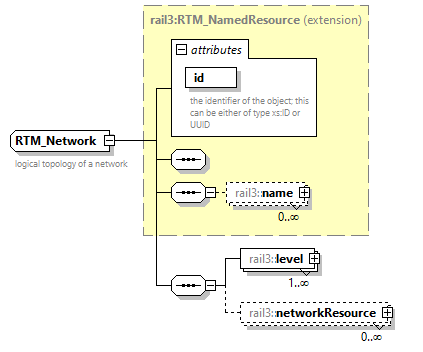 | ||||||||||||||
| namespace | https://www.railml.org/schemas/3.2 | ||||||||||||||
| type | extension of rail3:RTM_NamedResource | ||||||||||||||
| properties |
| ||||||||||||||
| children | rail3:name rail3:level rail3:networkResource | ||||||||||||||
| used by |
| ||||||||||||||
| attributes |
| ||||||||||||||
| annotation |
| ||||||||||||||
| source | <xs:complexType name="RTM_Network" abstract="true"> <xs:annotation> <xs:documentation>logical topology of a network</xs:documentation> </xs:annotation> <xs:complexContent> <xs:extension base="rail3:RTM_NamedResource"> <xs:sequence> <xs:element name="level" type="rail3:RTM_LevelNetwork" minOccurs="1" maxOccurs="unbounded"/> <xs:element name="networkResource" type="rail3:RTM_NetworkResource" minOccurs="0" maxOccurs="unbounded"/> </xs:sequence> </xs:extension> </xs:complexContent> </xs:complexType> |
element RTM_Network/level
| diagram | 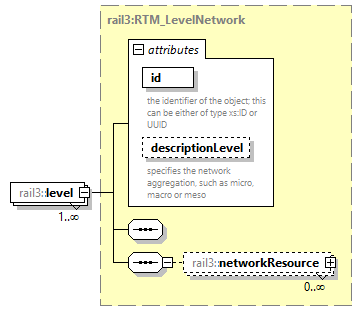 | ||||||||||||||||||||||
| namespace | https://www.railml.org/schemas/3.2 | ||||||||||||||||||||||
| type | rail3:RTM_LevelNetwork | ||||||||||||||||||||||
| properties |
| ||||||||||||||||||||||
| children | rail3:networkResource | ||||||||||||||||||||||
| attributes |
| ||||||||||||||||||||||
| source | <xs:element name="level" type="rail3:RTM_LevelNetwork" minOccurs="1" maxOccurs="unbounded"/> |
element RTM_Network/networkResource
| diagram | 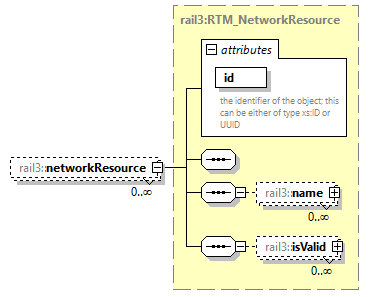 | ||||||||||||||
| namespace | https://www.railml.org/schemas/3.2 | ||||||||||||||
| type | rail3:RTM_NetworkResource | ||||||||||||||
| properties |
| ||||||||||||||
| children | rail3:name rail3:isValid | ||||||||||||||
| attributes |
| ||||||||||||||
| source | <xs:element name="networkResource" type="rail3:RTM_NetworkResource" minOccurs="0" maxOccurs="unbounded"/> |
complexType RTM_NetworkResource
| diagram | 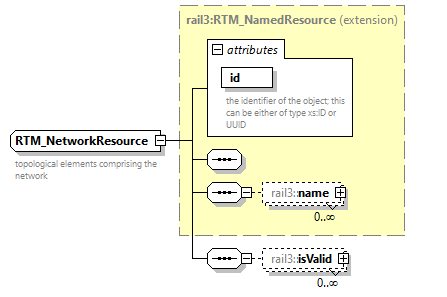 | ||||||||||||||
| namespace | https://www.railml.org/schemas/3.2 | ||||||||||||||
| type | extension of rail3:RTM_NamedResource | ||||||||||||||
| properties |
| ||||||||||||||
| children | rail3:name rail3:isValid | ||||||||||||||
| used by |
| ||||||||||||||
| attributes |
| ||||||||||||||
| annotation |
| ||||||||||||||
| source | <xs:complexType name="RTM_NetworkResource"> <xs:annotation> <xs:documentation>topological elements comprising the network</xs:documentation> </xs:annotation> <xs:complexContent> <xs:extension base="rail3:RTM_NamedResource"> <xs:sequence> <xs:element name="isValid" type="rail3:RTM_Validity" minOccurs="0" maxOccurs="unbounded"/> </xs:sequence> </xs:extension> </xs:complexContent> </xs:complexType> |
element RTM_NetworkResource/isValid
| diagram | 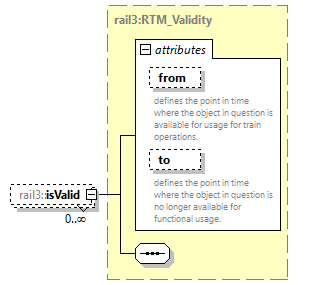 | ||||||||||||||||||||||
| namespace | https://www.railml.org/schemas/3.2 | ||||||||||||||||||||||
| type | rail3:RTM_Validity | ||||||||||||||||||||||
| properties |
| ||||||||||||||||||||||
| attributes |
| ||||||||||||||||||||||
| source | <xs:element name="isValid" type="rail3:RTM_Validity" minOccurs="0" maxOccurs="unbounded"/> |
complexType RTM_NonLinearNetElement
| diagram | 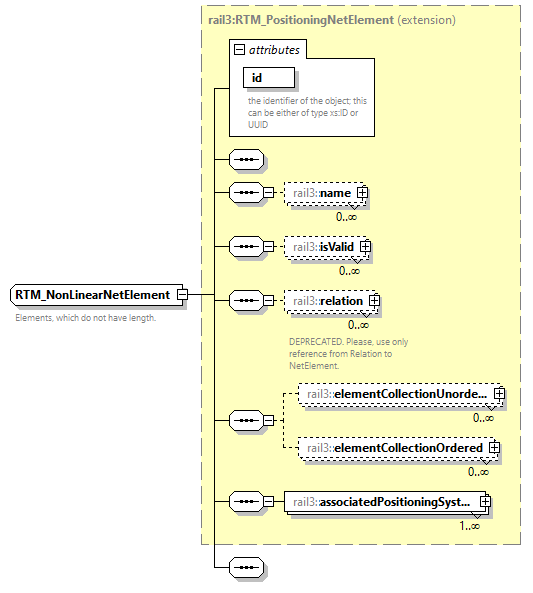 | ||||||||||||||
| namespace | https://www.railml.org/schemas/3.2 | ||||||||||||||
| type | extension of rail3:RTM_PositioningNetElement | ||||||||||||||
| properties |
| ||||||||||||||
| children | rail3:name rail3:isValid rail3:relation rail3:elementCollectionUnordered rail3:elementCollectionOrdered rail3:associatedPositioningSystem | ||||||||||||||
| attributes |
| ||||||||||||||
| annotation |
| ||||||||||||||
| source | <xs:complexType name="RTM_NonLinearNetElement"> <xs:annotation> <xs:documentation>Elements, which do not have length.</xs:documentation> </xs:annotation> <xs:complexContent> <xs:extension base="rail3:RTM_PositioningNetElement"> <xs:sequence/> </xs:extension> </xs:complexContent> </xs:complexType> |
complexType RTM_OrderedCollection
| diagram | 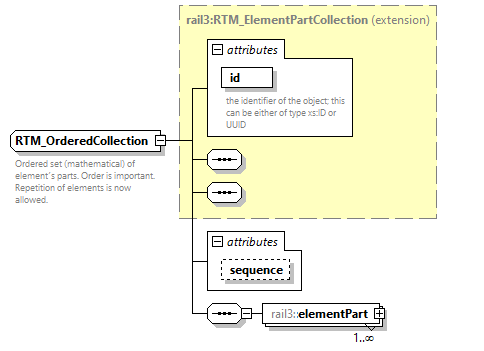 | ||||||||||||||||||||
| namespace | https://www.railml.org/schemas/3.2 | ||||||||||||||||||||
| type | extension of rail3:RTM_ElementPartCollection | ||||||||||||||||||||
| properties |
| ||||||||||||||||||||
| children | rail3:elementPart | ||||||||||||||||||||
| used by |
| ||||||||||||||||||||
| attributes |
| ||||||||||||||||||||
| annotation |
| ||||||||||||||||||||
| source | <xs:complexType name="RTM_OrderedCollection"> <xs:annotation> <xs:documentation>Ordered set (mathematical) of element´s parts. Order is important. Repetition of elements is now allowed.</xs:documentation> </xs:annotation> <xs:complexContent> <xs:extension base="rail3:RTM_ElementPartCollection"> <xs:sequence> <xs:element name="elementPart" type="rail3:tElementWithIDref" minOccurs="1" maxOccurs="unbounded"/> </xs:sequence> <xs:attribute name="sequence" type="xs:nonNegativeInteger" use="optional"/> </xs:extension> </xs:complexContent> </xs:complexType> |
attribute RTM_OrderedCollection/@sequence
| type | xs:nonNegativeInteger | ||
| properties |
| ||
| source | <xs:attribute name="sequence" type="xs:nonNegativeInteger" use="optional"/> |
element RTM_OrderedCollection/elementPart
| diagram | 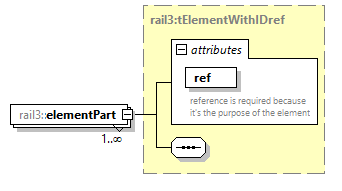 | ||||||||||||||
| namespace | https://www.railml.org/schemas/3.2 | ||||||||||||||
| type | rail3:tElementWithIDref | ||||||||||||||
| properties |
| ||||||||||||||
| attributes |
| ||||||||||||||
| source | <xs:element name="elementPart" type="rail3:tElementWithIDref" minOccurs="1" maxOccurs="unbounded"/> |
complexType RTM_PositioningNetElement
| diagram | 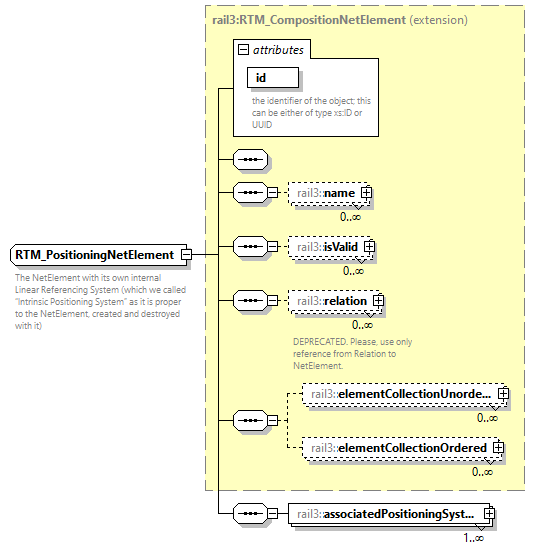 | ||||||||||||||
| namespace | https://www.railml.org/schemas/3.2 | ||||||||||||||
| type | extension of rail3:RTM_CompositionNetElement | ||||||||||||||
| properties |
| ||||||||||||||
| children | rail3:name rail3:isValid rail3:relation rail3:elementCollectionUnordered rail3:elementCollectionOrdered rail3:associatedPositioningSystem | ||||||||||||||
| used by |
| ||||||||||||||
| attributes |
| ||||||||||||||
| annotation |
| ||||||||||||||
| source | <xs:complexType name="RTM_PositioningNetElement"> <xs:annotation> <xs:documentation>The NetElement with its own internal Linear Referencing System (which we called “Intrinsic Positioning System” as it is proper to the NetElement, created and destroyed with it)</xs:documentation> </xs:annotation> <xs:complexContent> <xs:extension base="rail3:RTM_CompositionNetElement"> <xs:sequence> <xs:element name="associatedPositioningSystem" type="rail3:RTM_AssociatedPositioningSystem" minOccurs="1" maxOccurs="unbounded"/> </xs:sequence> </xs:extension> </xs:complexContent> </xs:complexType> |
element RTM_PositioningNetElement/associatedPositioningSystem
| diagram | 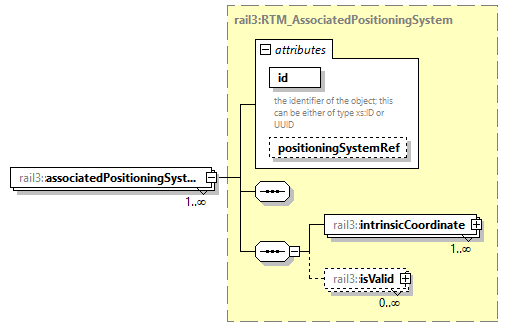 | ||||||||||||||||||||
| namespace | https://www.railml.org/schemas/3.2 | ||||||||||||||||||||
| type | rail3:RTM_AssociatedPositioningSystem | ||||||||||||||||||||
| properties |
| ||||||||||||||||||||
| children | rail3:intrinsicCoordinate rail3:isValid | ||||||||||||||||||||
| attributes |
| ||||||||||||||||||||
| source | <xs:element name="associatedPositioningSystem" type="rail3:RTM_AssociatedPositioningSystem" minOccurs="1" maxOccurs="unbounded"/> |
complexType RTM_PositioningSystem
| diagram | 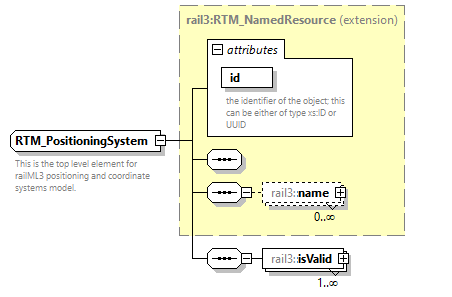 | ||||||||||||||
| namespace | https://www.railml.org/schemas/3.2 | ||||||||||||||
| type | extension of rail3:RTM_NamedResource | ||||||||||||||
| properties |
| ||||||||||||||
| children | rail3:name rail3:isValid | ||||||||||||||
| used by |
| ||||||||||||||
| attributes |
| ||||||||||||||
| annotation |
| ||||||||||||||
| source | <xs:complexType name="RTM_PositioningSystem"> <xs:annotation> <xs:documentation>This is the top level element for railML3 positioning and coordinate systems model.</xs:documentation> </xs:annotation> <xs:complexContent> <xs:extension base="rail3:RTM_NamedResource"> <xs:sequence> <xs:element name="isValid" type="rail3:RTM_Validity" minOccurs="1" maxOccurs="unbounded"/> </xs:sequence> </xs:extension> </xs:complexContent> </xs:complexType> |
element RTM_PositioningSystem/isValid
| diagram | 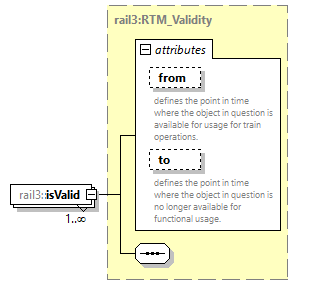 | ||||||||||||||||||||||
| namespace | https://www.railml.org/schemas/3.2 | ||||||||||||||||||||||
| type | rail3:RTM_Validity | ||||||||||||||||||||||
| properties |
| ||||||||||||||||||||||
| attributes |
| ||||||||||||||||||||||
| source | <xs:element name="isValid" type="rail3:RTM_Validity" minOccurs="1" maxOccurs="unbounded"/> |
complexType RTM_PositioningSystemCoordinate
| diagram |  | ||||||||||||
| namespace | https://www.railml.org/schemas/3.2 | ||||||||||||
| used by |
| ||||||||||||
| attributes |
| ||||||||||||
| annotation |
| ||||||||||||
| source | <xs:complexType name="RTM_PositioningSystemCoordinate"> <xs:annotation> <xs:documentation>uniquely determine the position of the points or other geometric elements on a manifold such as Euclidean space [wikipedia].</xs:documentation> </xs:annotation> <xs:sequence/> <xs:attribute name="positioningSystemRef" type="rail3:tRef" use="required"/> </xs:complexType> |
attribute RTM_PositioningSystemCoordinate/@positioningSystemRef
| type | rail3:tRef | ||
| properties |
| ||
| source | <xs:attribute name="positioningSystemRef" type="rail3:tRef" use="required"/> |
complexType RTM_Relation
| diagram | 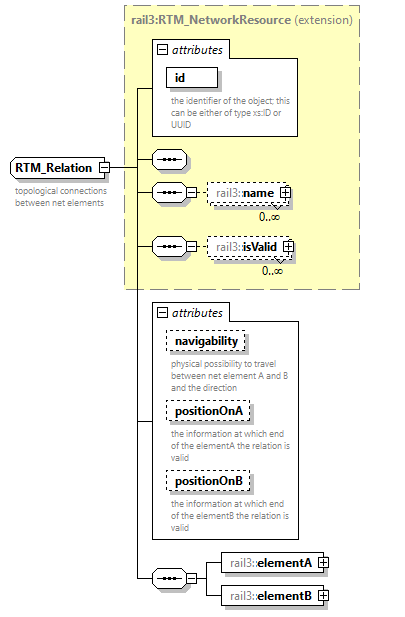 | ||||||||||||||||||||||||||||||||||||||
| namespace | https://www.railml.org/schemas/3.2 | ||||||||||||||||||||||||||||||||||||||
| type | extension of rail3:RTM_NetworkResource | ||||||||||||||||||||||||||||||||||||||
| properties |
| ||||||||||||||||||||||||||||||||||||||
| children | rail3:name rail3:isValid rail3:elementA rail3:elementB | ||||||||||||||||||||||||||||||||||||||
| used by |
| ||||||||||||||||||||||||||||||||||||||
| attributes |
| ||||||||||||||||||||||||||||||||||||||
| annotation |
| ||||||||||||||||||||||||||||||||||||||
| source | <xs:complexType name="RTM_Relation"> <xs:annotation> <xs:documentation>topological connections between net elements</xs:documentation> </xs:annotation> <xs:complexContent> <xs:extension base="rail3:RTM_NetworkResource"> <xs:sequence> <xs:element name="elementA" type="rail3:tElementWithIDref" form="qualified" minOccurs="1" maxOccurs="1"/> <xs:element name="elementB" type="rail3:tElementWithIDref" form="qualified" minOccurs="1" maxOccurs="1"/> </xs:sequence> <xs:attribute name="navigability" type="rail3:tNavigability" use="optional"> <xs:annotation> <xs:documentation>physical possibility to travel between net element A and B and the direction</xs:documentation> </xs:annotation> </xs:attribute> <xs:attribute name="positionOnA" type="rail3:tUsage" use="optional"> <xs:annotation> <xs:documentation>the information at which end of the elementA the relation is valid</xs:documentation> </xs:annotation> </xs:attribute> <xs:attribute name="positionOnB" type="rail3:tUsage" use="optional"> <xs:annotation> <xs:documentation>the information at which end of the elementB the relation is valid</xs:documentation> </xs:annotation> </xs:attribute> </xs:extension> </xs:complexContent> </xs:complexType> |
attribute RTM_Relation/@navigability
| type | rail3:tNavigability | |||||||||||||||
| properties |
| |||||||||||||||
| facets |
| |||||||||||||||
| annotation |
| |||||||||||||||
| source | <xs:attribute name="navigability" type="rail3:tNavigability" use="optional"> <xs:annotation> <xs:documentation>physical possibility to travel between net element A and B and the direction</xs:documentation> </xs:annotation> </xs:attribute> |
attribute RTM_Relation/@positionOnA
| type | rail3:tUsage | |||||||||
| properties |
| |||||||||
| facets |
| |||||||||
| annotation |
| |||||||||
| source | <xs:attribute name="positionOnA" type="rail3:tUsage" use="optional"> <xs:annotation> <xs:documentation>the information at which end of the elementA the relation is valid</xs:documentation> </xs:annotation> </xs:attribute> |
attribute RTM_Relation/@positionOnB
| type | rail3:tUsage | |||||||||
| properties |
| |||||||||
| facets |
| |||||||||
| annotation |
| |||||||||
| source | <xs:attribute name="positionOnB" type="rail3:tUsage" use="optional"> <xs:annotation> <xs:documentation>the information at which end of the elementB the relation is valid</xs:documentation> </xs:annotation> </xs:attribute> |
element RTM_Relation/elementA
| diagram | 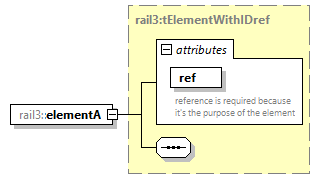 | ||||||||||||||
| namespace | https://www.railml.org/schemas/3.2 | ||||||||||||||
| type | rail3:tElementWithIDref | ||||||||||||||
| properties |
| ||||||||||||||
| attributes |
| ||||||||||||||
| source | <xs:element name="elementA" type="rail3:tElementWithIDref" form="qualified" minOccurs="1" maxOccurs="1"/> |
element RTM_Relation/elementB
| diagram | 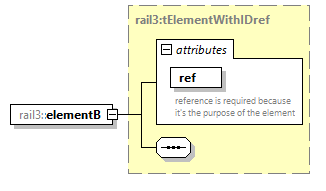 | ||||||||||||||
| namespace | https://www.railml.org/schemas/3.2 | ||||||||||||||
| type | rail3:tElementWithIDref | ||||||||||||||
| properties |
| ||||||||||||||
| attributes |
| ||||||||||||||
| source | <xs:element name="elementB" type="rail3:tElementWithIDref" form="qualified" minOccurs="1" maxOccurs="1"/> |
complexType RTM_SpotLocation
| diagram | 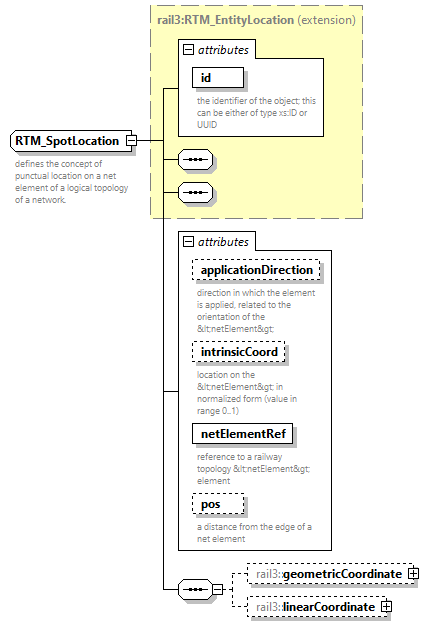 | ||||||||||||||||||||||||||||||||||||||||||||||
| namespace | https://www.railml.org/schemas/3.2 | ||||||||||||||||||||||||||||||||||||||||||||||
| type | extension of rail3:RTM_EntityLocation | ||||||||||||||||||||||||||||||||||||||||||||||
| properties |
| ||||||||||||||||||||||||||||||||||||||||||||||
| children | rail3:geometricCoordinate rail3:linearCoordinate | ||||||||||||||||||||||||||||||||||||||||||||||
| used by |
| ||||||||||||||||||||||||||||||||||||||||||||||
| attributes |
| ||||||||||||||||||||||||||||||||||||||||||||||
| annotation |
| ||||||||||||||||||||||||||||||||||||||||||||||
| source | <xs:complexType name="RTM_SpotLocation"> <xs:annotation> <xs:documentation>defines the concept of punctual location on a net element of a logical topology of a network.</xs:documentation> </xs:annotation> <xs:complexContent> <xs:extension base="rail3:RTM_EntityLocation"> <xs:sequence> <xs:element name="geometricCoordinate" type="rail3:RTM_GeometricCoordinate" minOccurs="0" maxOccurs="1"/> <xs:element name="linearCoordinate" type="rail3:RTM_LinearCoordinate" minOccurs="0" maxOccurs="1"/> </xs:sequence> <xs:attribute name="applicationDirection" type="rail3:tApplicationDirection" use="optional"> <xs:annotation> <xs:documentation>direction in which the element is applied, related to the orientation of the <netElement></xs:documentation> </xs:annotation> </xs:attribute> <xs:attribute name="intrinsicCoord" type="xs:double" use="optional"> <xs:annotation> <xs:documentation>location on the <netElement> in normalized form (value in range 0..1)</xs:documentation> </xs:annotation> </xs:attribute> <xs:attribute name="netElementRef" type="rail3:tRef" use="required"> <xs:annotation> <xs:documentation>reference to a railway topology <netElement> element</xs:documentation> </xs:annotation> </xs:attribute> <xs:attribute name="pos" type="rail3:tLengthM" use="optional"> <xs:annotation> <xs:documentation>a distance from the edge of a net element</xs:documentation> </xs:annotation> </xs:attribute> </xs:extension> </xs:complexContent> </xs:complexType> |
attribute RTM_SpotLocation/@applicationDirection
| type | rail3:tApplicationDirection | ||||||||||||
| properties |
| ||||||||||||
| facets |
| ||||||||||||
| annotation |
| ||||||||||||
| source | <xs:attribute name="applicationDirection" type="rail3:tApplicationDirection" use="optional"> <xs:annotation> <xs:documentation>direction in which the element is applied, related to the orientation of the <netElement></xs:documentation> </xs:annotation> </xs:attribute> |
attribute RTM_SpotLocation/@intrinsicCoord
| type | xs:double | ||
| properties |
| ||
| annotation |
| ||
| source | <xs:attribute name="intrinsicCoord" type="xs:double" use="optional"> <xs:annotation> <xs:documentation>location on the <netElement> in normalized form (value in range 0..1)</xs:documentation> </xs:annotation> </xs:attribute> |
attribute RTM_SpotLocation/@netElementRef
| type | rail3:tRef | ||
| properties |
| ||
| annotation |
| ||
| source | <xs:attribute name="netElementRef" type="rail3:tRef" use="required"> <xs:annotation> <xs:documentation>reference to a railway topology <netElement> element</xs:documentation> </xs:annotation> </xs:attribute> |
attribute RTM_SpotLocation/@pos
| type | rail3:tLengthM | ||
| properties |
| ||
| annotation |
| ||
| source | <xs:attribute name="pos" type="rail3:tLengthM" use="optional"> <xs:annotation> <xs:documentation>a distance from the edge of a net element</xs:documentation> </xs:annotation> </xs:attribute> |
element RTM_SpotLocation/geometricCoordinate
| diagram | 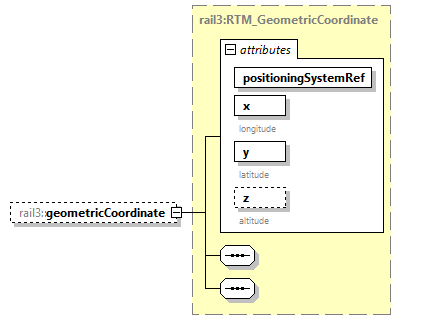 | ||||||||||||||||||||||||||||||||||||
| namespace | https://www.railml.org/schemas/3.2 | ||||||||||||||||||||||||||||||||||||
| type | rail3:RTM_GeometricCoordinate | ||||||||||||||||||||||||||||||||||||
| properties |
| ||||||||||||||||||||||||||||||||||||
| attributes |
| ||||||||||||||||||||||||||||||||||||
| source | <xs:element name="geometricCoordinate" type="rail3:RTM_GeometricCoordinate" minOccurs="0" maxOccurs="1"/> |
element RTM_SpotLocation/linearCoordinate
| diagram | 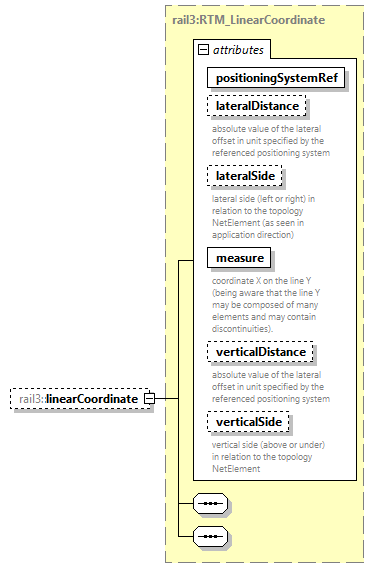 | ||||||||||||||||||||||||||||||||||||||||||||||||||||
| namespace | https://www.railml.org/schemas/3.2 | ||||||||||||||||||||||||||||||||||||||||||||||||||||
| type | rail3:RTM_LinearCoordinate | ||||||||||||||||||||||||||||||||||||||||||||||||||||
| properties |
| ||||||||||||||||||||||||||||||||||||||||||||||||||||
| attributes |
| ||||||||||||||||||||||||||||||||||||||||||||||||||||
| source | <xs:element name="linearCoordinate" type="rail3:RTM_LinearCoordinate" minOccurs="0" maxOccurs="1"/> |
complexType RTM_UnorderedCollection
| diagram | 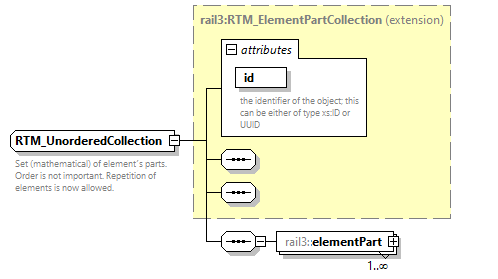 | ||||||||||||||
| namespace | https://www.railml.org/schemas/3.2 | ||||||||||||||
| type | extension of rail3:RTM_ElementPartCollection | ||||||||||||||
| properties |
| ||||||||||||||
| children | rail3:elementPart | ||||||||||||||
| used by |
| ||||||||||||||
| attributes |
| ||||||||||||||
| annotation |
| ||||||||||||||
| source | <xs:complexType name="RTM_UnorderedCollection"> <xs:annotation> <xs:documentation>Set (mathematical) of element´s parts. Order is not important. Repetition of elements is now allowed.</xs:documentation> </xs:annotation> <xs:complexContent> <xs:extension base="rail3:RTM_ElementPartCollection"> <xs:sequence> <xs:element name="elementPart" type="rail3:tElementWithIDref" minOccurs="1" maxOccurs="unbounded"/> </xs:sequence> </xs:extension> </xs:complexContent> </xs:complexType> |
element RTM_UnorderedCollection/elementPart
| diagram | 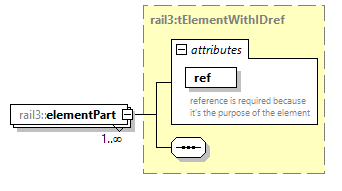 | ||||||||||||||
| namespace | https://www.railml.org/schemas/3.2 | ||||||||||||||
| type | rail3:tElementWithIDref | ||||||||||||||
| properties |
| ||||||||||||||
| attributes |
| ||||||||||||||
| source | <xs:element name="elementPart" type="rail3:tElementWithIDref" minOccurs="1" maxOccurs="unbounded"/> |
complexType RTM_Validity
| diagram | 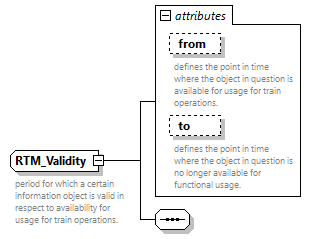 | ||||||||||||||||||||||
| namespace | https://www.railml.org/schemas/3.2 | ||||||||||||||||||||||
| used by |
| ||||||||||||||||||||||
| attributes |
| ||||||||||||||||||||||
| annotation |
| ||||||||||||||||||||||
| source | <xs:complexType name="RTM_Validity"> <xs:annotation> <xs:documentation>period for which a certain information object is valid in respect to availability for usage for train operations.</xs:documentation> </xs:annotation> <xs:sequence/> <xs:attribute name="from" type="xs:date" use="optional"> <xs:annotation> <xs:documentation>defines the point in time where the object in question is available for usage for train operations.</xs:documentation> </xs:annotation> </xs:attribute> <xs:attribute name="to" type="xs:date" use="optional"> <xs:annotation> <xs:documentation>defines the point in time where the object in question is no longer available for functional usage. </xs:documentation> </xs:annotation> </xs:attribute> </xs:complexType> |
attribute RTM_Validity/@from
| type | xs:date | ||
| properties |
| ||
| annotation |
| ||
| source | <xs:attribute name="from" type="xs:date" use="optional"> <xs:annotation> <xs:documentation>defines the point in time where the object in question is available for usage for train operations.</xs:documentation> </xs:annotation> </xs:attribute> |
attribute RTM_Validity/@to
| type | xs:date | ||
| properties |
| ||
| annotation |
| ||
| source | <xs:attribute name="to" type="xs:date" use="optional"> <xs:annotation> <xs:documentation>defines the point in time where the object in question is no longer available for functional usage. </xs:documentation> </xs:annotation> </xs:attribute> |
simpleType tApplicationDirection
| namespace | https://www.railml.org/schemas/3.2 | ||||||||||||
| type | restriction of xs:string | ||||||||||||
| properties |
| ||||||||||||
| used by |
| ||||||||||||
| facets |
| ||||||||||||
| source | <xs:simpleType name="tApplicationDirection"> <xs:restriction base="xs:string"> <xs:enumeration value="both"/> <xs:enumeration value="normal"/> <xs:enumeration value="reverse"/> </xs:restriction> </xs:simpleType> |
simpleType tDescriptionLevel
| namespace | https://www.railml.org/schemas/3.2 | ||||||||||||
| type | restriction of xs:string | ||||||||||||
| properties |
| ||||||||||||
| used by |
| ||||||||||||
| facets |
| ||||||||||||
| source | <xs:simpleType name="tDescriptionLevel"> <xs:restriction base="xs:string"> <xs:enumeration value="Macro"/> <xs:enumeration value="Meso"/> <xs:enumeration value="Micro"/> </xs:restriction> </xs:simpleType> |
simpleType tLateralSide
| namespace | https://www.railml.org/schemas/3.2 | ||||||||||||
| type | restriction of xs:string | ||||||||||||
| properties |
| ||||||||||||
| used by |
| ||||||||||||
| facets |
| ||||||||||||
| source | <xs:simpleType name="tLateralSide"> <xs:restriction base="xs:string"> <xs:enumeration value="left"/> <xs:enumeration value="right"/> <xs:enumeration value="both"/> </xs:restriction> </xs:simpleType> |
simpleType tLrsMethod
| namespace | https://www.railml.org/schemas/3.2 | ||||||||||||
| type | restriction of xs:string | ||||||||||||
| properties |
| ||||||||||||
| used by |
| ||||||||||||
| facets |
| ||||||||||||
| source | <xs:simpleType name="tLrsMethod"> <xs:restriction base="xs:string"> <xs:enumeration value="absolute"/> <xs:enumeration value="interpolation"/> <xs:enumeration value="relative"/> </xs:restriction> </xs:simpleType> |
simpleType tNavigability
| namespace | https://www.railml.org/schemas/3.2 | |||||||||||||||
| type | restriction of xs:string | |||||||||||||||
| properties |
| |||||||||||||||
| used by |
| |||||||||||||||
| facets |
| |||||||||||||||
| source | <xs:simpleType name="tNavigability"> <xs:restriction base="xs:string"> <xs:enumeration value="AB"/> <xs:enumeration value="BA"/> <xs:enumeration value="Both"/> <xs:enumeration value="None"/> </xs:restriction> </xs:simpleType> |
simpleType tOrientation
| namespace | https://www.railml.org/schemas/3.2 | |||||||||
| type | restriction of xs:integer | |||||||||
| properties |
| |||||||||
| facets |
| |||||||||
| source | <xs:simpleType name="tOrientation"> <xs:restriction base="xs:integer"> <xs:enumeration value="1"/> <xs:enumeration value="-1"/> </xs:restriction> </xs:simpleType> |
simpleType tUsage
| namespace | https://www.railml.org/schemas/3.2 | |||||||||
| type | restriction of xs:integer | |||||||||
| properties |
| |||||||||
| used by |
| |||||||||
| facets |
| |||||||||
| source | <xs:simpleType name="tUsage"> <xs:restriction base="xs:integer"> <xs:enumeration value="0"/> <xs:enumeration value="1"/> </xs:restriction> </xs:simpleType> |
simpleType tVerticalSide
| namespace | https://www.railml.org/schemas/3.2 | |||||||||
| type | restriction of xs:string | |||||||||
| properties |
| |||||||||
| used by |
| |||||||||
| facets |
| |||||||||
| source | <xs:simpleType name="tVerticalSide"> <xs:restriction base="xs:string"> <xs:enumeration value="above"/> <xs:enumeration value="under"/> </xs:restriction> </xs:simpleType> |
group StandardObjectProperties
| diagram | 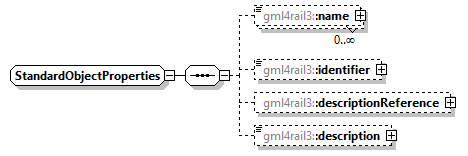 | ||
| namespace | https://www.railml.org/schemas/3.2/gml | ||
| children | gml4rail3:name gml4rail3:identifier gml4rail3:descriptionReference gml4rail3:description | ||
| used by |
| ||
| source | <xs:group name="StandardObjectProperties"> <xs:sequence> <xs:element name="name" type="gml4rail3:CodeType" minOccurs="0" maxOccurs="unbounded"/> <xs:element name="identifier" type="gml4rail3:CodeWithAuthorityType" minOccurs="0" maxOccurs="1"/> <xs:element name="descriptionReference" type="gml4rail3:ReferenceType" minOccurs="0" maxOccurs="1"/> <xs:element name="description" type="gml4rail3:StringOrRefType" minOccurs="0" maxOccurs="1"/> </xs:sequence> </xs:group> |
element StandardObjectProperties/name
| diagram | 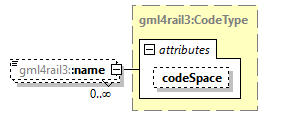 | ||||||||||||
| namespace | https://www.railml.org/schemas/3.2/gml | ||||||||||||
| type | gml4rail3:CodeType | ||||||||||||
| properties |
| ||||||||||||
| attributes |
| ||||||||||||
| source | <xs:element name="name" type="gml4rail3:CodeType" minOccurs="0" maxOccurs="unbounded"/> |
element StandardObjectProperties/identifier
| diagram |  | ||||||||||||
| namespace | https://www.railml.org/schemas/3.2/gml | ||||||||||||
| type | gml4rail3:CodeWithAuthorityType | ||||||||||||
| properties |
| ||||||||||||
| attributes |
| ||||||||||||
| source | <xs:element name="identifier" type="gml4rail3:CodeWithAuthorityType" minOccurs="0" maxOccurs="1"/> |
element StandardObjectProperties/descriptionReference
| diagram | 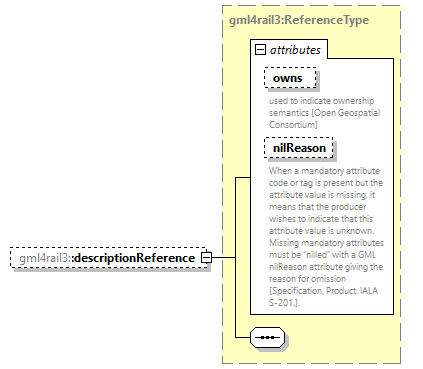 | ||||||||||||||||||||||
| namespace | https://www.railml.org/schemas/3.2/gml | ||||||||||||||||||||||
| type | gml4rail3:ReferenceType | ||||||||||||||||||||||
| properties |
| ||||||||||||||||||||||
| attributes |
| ||||||||||||||||||||||
| source | <xs:element name="descriptionReference" type="gml4rail3:ReferenceType" minOccurs="0" maxOccurs="1"/> |
element StandardObjectProperties/description
| diagram | 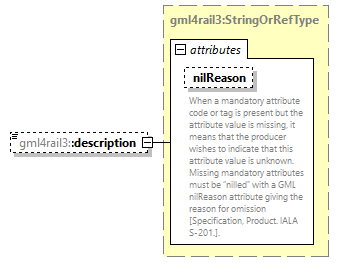 | ||||||||||||||
| namespace | https://www.railml.org/schemas/3.2/gml | ||||||||||||||
| type | gml4rail3:StringOrRefType | ||||||||||||||
| properties |
| ||||||||||||||
| attributes |
| ||||||||||||||
| source | <xs:element name="description" type="gml4rail3:StringOrRefType" minOccurs="0" maxOccurs="1"/> |
complexType AbstractCurveType
| diagram | 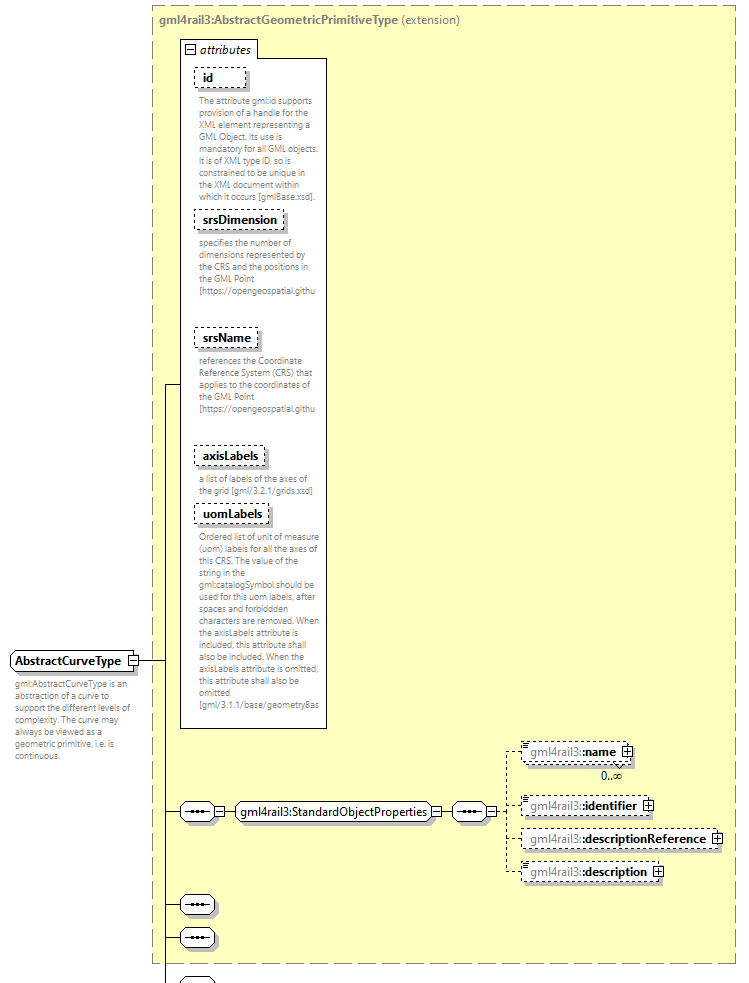 | ||||||||||||||||||||||||||||||||||||||||||||||
| namespace | https://www.railml.org/schemas/3.2/gml | ||||||||||||||||||||||||||||||||||||||||||||||
| type | extension of gml4rail3:AbstractGeometricPrimitiveType | ||||||||||||||||||||||||||||||||||||||||||||||
| properties |
| ||||||||||||||||||||||||||||||||||||||||||||||
| children | gml4rail3:name gml4rail3:identifier gml4rail3:descriptionReference gml4rail3:description | ||||||||||||||||||||||||||||||||||||||||||||||
| used by |
| ||||||||||||||||||||||||||||||||||||||||||||||
| attributes |
| ||||||||||||||||||||||||||||||||||||||||||||||
| annotation |
| ||||||||||||||||||||||||||||||||||||||||||||||
| source | <xs:complexType name="AbstractCurveType" abstract="true"> <xs:annotation> <xs:documentation>gml:AbstractCurveType is an abstraction of a curve to support the different levels of complexity. The curve may always be viewed as a geometric primitive, i.e. is continuous.</xs:documentation> </xs:annotation> <xs:complexContent> <xs:extension base="gml4rail3:AbstractGeometricPrimitiveType"> <xs:sequence/> </xs:extension> </xs:complexContent> </xs:complexType> |
complexType AbstractGeometricPrimitiveType
| diagram | 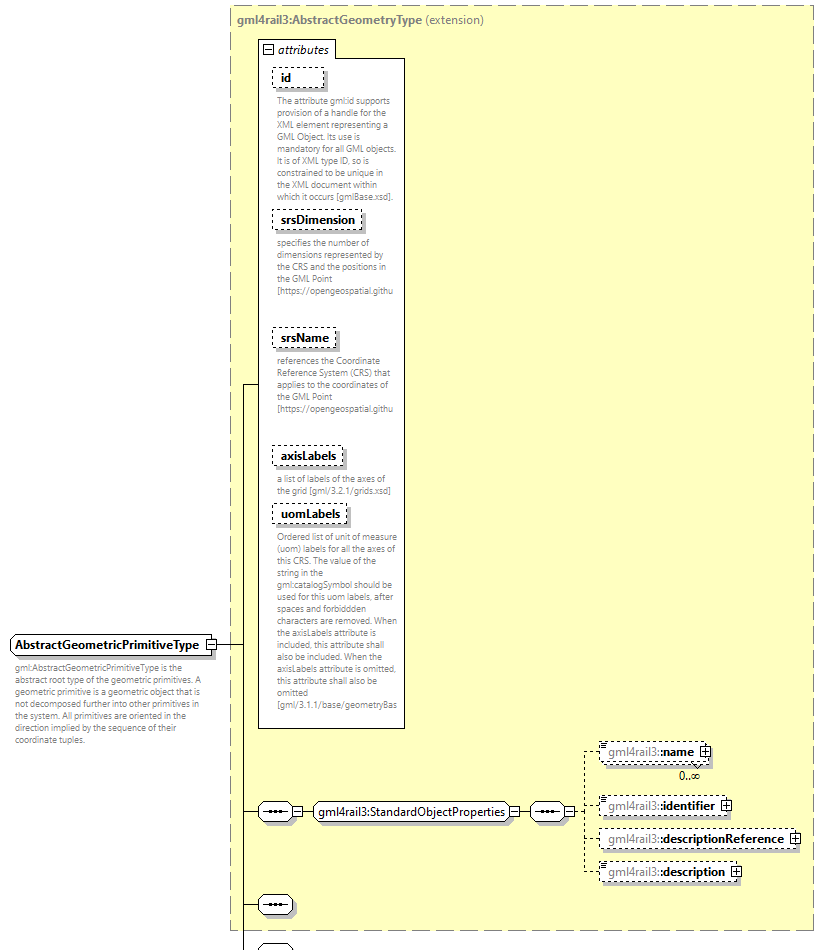 | ||||||||||||||||||||||||||||||||||||||||||||||
| namespace | https://www.railml.org/schemas/3.2/gml | ||||||||||||||||||||||||||||||||||||||||||||||
| type | extension of gml4rail3:AbstractGeometryType | ||||||||||||||||||||||||||||||||||||||||||||||
| properties |
| ||||||||||||||||||||||||||||||||||||||||||||||
| children | gml4rail3:name gml4rail3:identifier gml4rail3:descriptionReference gml4rail3:description | ||||||||||||||||||||||||||||||||||||||||||||||
| used by |
| ||||||||||||||||||||||||||||||||||||||||||||||
| attributes |
| ||||||||||||||||||||||||||||||||||||||||||||||
| annotation |
| ||||||||||||||||||||||||||||||||||||||||||||||
| source | <xs:complexType name="AbstractGeometricPrimitiveType" abstract="true"> <xs:annotation> <xs:documentation>gml:AbstractGeometricPrimitiveType is the abstract root type of the geometric primitives. A geometric primitive is a geometric object that is not decomposed further into other primitives in the system. All primitives are oriented in the direction implied by the sequence of their coordinate tuples.</xs:documentation> </xs:annotation> <xs:complexContent> <xs:extension base="gml4rail3:AbstractGeometryType"> <xs:sequence/> </xs:extension> </xs:complexContent> </xs:complexType> |
complexType AbstractGeometryType
| diagram | 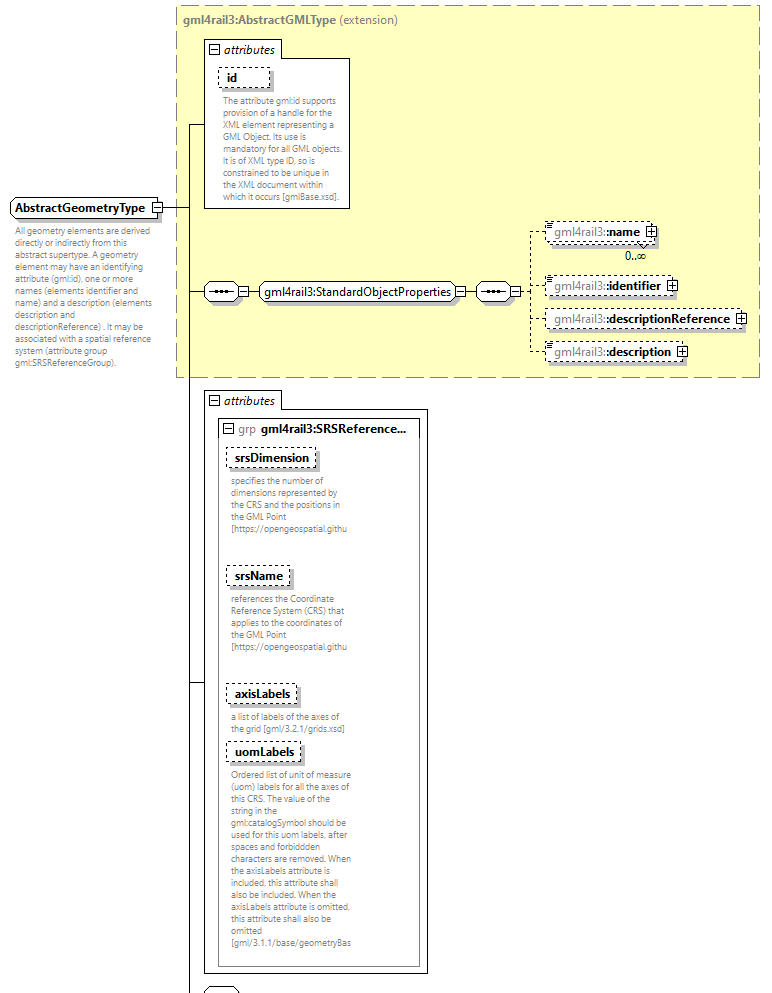 | ||||||||||||||||||||||||||||||||||||||||||||||
| namespace | https://www.railml.org/schemas/3.2/gml | ||||||||||||||||||||||||||||||||||||||||||||||
| type | extension of gml4rail3:AbstractGMLType | ||||||||||||||||||||||||||||||||||||||||||||||
| properties |
| ||||||||||||||||||||||||||||||||||||||||||||||
| children | gml4rail3:name gml4rail3:identifier gml4rail3:descriptionReference gml4rail3:description | ||||||||||||||||||||||||||||||||||||||||||||||
| used by |
| ||||||||||||||||||||||||||||||||||||||||||||||
| attributes |
| ||||||||||||||||||||||||||||||||||||||||||||||
| annotation |
| ||||||||||||||||||||||||||||||||||||||||||||||
| source | <xs:complexType name="AbstractGeometryType" abstract="true"> <xs:annotation> <xs:documentation>All geometry elements are derived directly or indirectly from this abstract supertype. A geometry element may have an identifying attribute (gml:id), one or more names (elements identifier and name) and a description (elements description and descriptionReference) . It may be associated with a spatial reference system (attribute group gml:SRSReferenceGroup).</xs:documentation> </xs:annotation> <xs:complexContent> <xs:extension base="gml4rail3:AbstractGMLType"> <xs:sequence/> <xs:attributeGroup ref="gml4rail3:SRSReferenceGroup"/> </xs:extension> </xs:complexContent> </xs:complexType> |
complexType AbstractGMLType
| diagram | 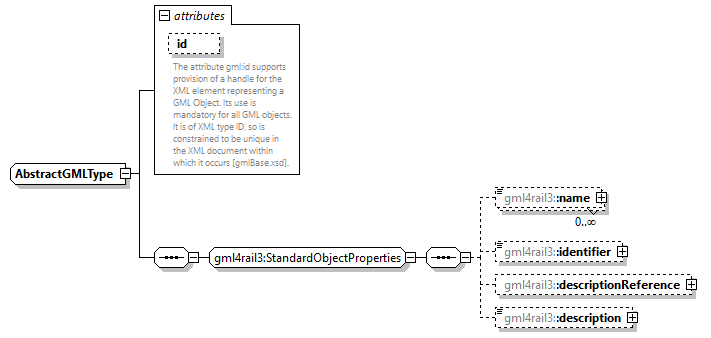 | ||||||||||||||
| namespace | https://www.railml.org/schemas/3.2/gml | ||||||||||||||
| properties |
| ||||||||||||||
| children | gml4rail3:name gml4rail3:identifier gml4rail3:descriptionReference gml4rail3:description | ||||||||||||||
| used by |
| ||||||||||||||
| attributes |
| ||||||||||||||
| source | <xs:complexType name="AbstractGMLType" abstract="true"> <xs:sequence> <xs:group ref="gml4rail3:StandardObjectProperties" minOccurs="1" maxOccurs="1"/> </xs:sequence> <xs:attribute name="id" type="xs:ID" use="optional"> <xs:annotation> <xs:documentation>The attribute gml:id supports provision of a handle for the XML element representing a GML Object. Its use is mandatory for all GML objects. It is of XML type ID, so is constrained to be unique in the XML document within which it occurs [gmlBase.xsd].</xs:documentation> </xs:annotation> </xs:attribute> </xs:complexType> |
attribute AbstractGMLType/@id
| type | xs:ID | ||
| properties |
| ||
| annotation |
| ||
| source | <xs:attribute name="id" type="xs:ID" use="optional"> <xs:annotation> <xs:documentation>The attribute gml:id supports provision of a handle for the XML element representing a GML Object. Its use is mandatory for all GML objects. It is of XML type ID, so is constrained to be unique in the XML document within which it occurs [gmlBase.xsd].</xs:documentation> </xs:annotation> </xs:attribute> |
complexType CodeType
| diagram | 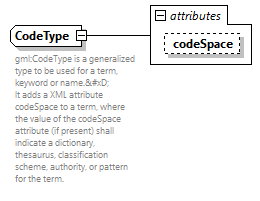 | ||||||||||||
| namespace | https://www.railml.org/schemas/3.2/gml | ||||||||||||
| type | extension of xs:string | ||||||||||||
| properties |
| ||||||||||||
| used by |
| ||||||||||||
| attributes |
| ||||||||||||
| annotation |
| ||||||||||||
| source | <xs:complexType name="CodeType"> <xs:annotation> <xs:documentation>gml:CodeType is a generalized type to be used for a term, keyword or name.
 It adds a XML attribute codeSpace to a term, where the value of the codeSpace attribute (if present) shall indicate a dictionary, thesaurus, classification scheme, authority, or pattern for the term.</xs:documentation> </xs:annotation> <xs:simpleContent> <xs:extension base="xs:string"> <xs:attribute name="codeSpace" type="xs:anyURI" use="optional"/> </xs:extension> </xs:simpleContent> </xs:complexType> |
attribute CodeType/@codeSpace
| type | xs:anyURI | ||
| properties |
| ||
| source | <xs:attribute name="codeSpace" type="xs:anyURI" use="optional"/> |
complexType CodeWithAuthorityType
| diagram |  | ||||||||||||
| namespace | https://www.railml.org/schemas/3.2/gml | ||||||||||||
| type | extension of xs:string | ||||||||||||
| properties |
| ||||||||||||
| used by |
| ||||||||||||
| attributes |
| ||||||||||||
| annotation |
| ||||||||||||
| source | <xs:complexType name="CodeWithAuthorityType"> <xs:annotation> <xs:documentation>gml:CodeWithAuthorityType requires that the codeSpace attribute is provided in an instance.</xs:documentation> </xs:annotation> <xs:simpleContent> <xs:extension base="xs:string"> <xs:attribute name="codeSpace" type="xs:anyURI" use="required"/> </xs:extension> </xs:simpleContent> </xs:complexType> |
attribute CodeWithAuthorityType/@codeSpace
| type | xs:anyURI | ||
| properties |
| ||
| source | <xs:attribute name="codeSpace" type="xs:anyURI" use="required"/> |
complexType DirectPositionListType
| diagram | 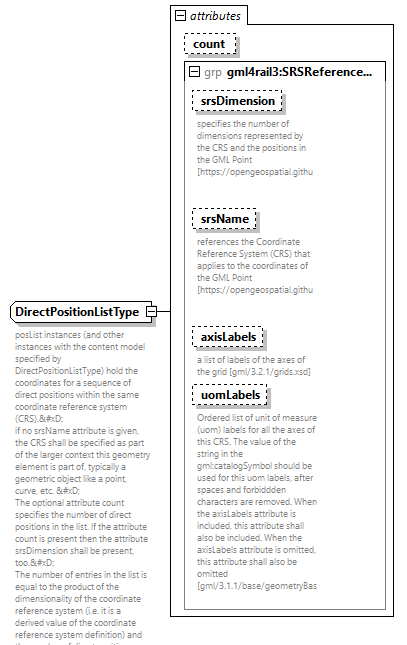 | ||||||||||||||||||||||||||||||||||||||||||||
| namespace | https://www.railml.org/schemas/3.2/gml | ||||||||||||||||||||||||||||||||||||||||||||
| type | extension of gml4rail3:doubleList | ||||||||||||||||||||||||||||||||||||||||||||
| properties |
| ||||||||||||||||||||||||||||||||||||||||||||
| used by |
| ||||||||||||||||||||||||||||||||||||||||||||
| attributes |
| ||||||||||||||||||||||||||||||||||||||||||||
| annotation |
| ||||||||||||||||||||||||||||||||||||||||||||
| source | <xs:complexType name="DirectPositionListType"> <xs:annotation> <xs:documentation>posList instances (and other instances with the content model specified by DirectPositionListType) hold the coordinates for a sequence of direct positions within the same coordinate reference system (CRS).
 if no srsName attribute is given, the CRS shall be specified as part of the larger context this geometry element is part of, typically a geometric object like a point, curve, etc. 
 The optional attribute count specifies the number of direct positions in the list. If the attribute count is present then the attribute srsDimension shall be present, too.
 The number of entries in the list is equal to the product of the dimensionality of the coordinate reference system (i.e. it is a derived value of the coordinate reference system definition) and the number of direct positions.</xs:documentation> </xs:annotation> <xs:simpleContent> <xs:extension base="gml4rail3:doubleList"> <xs:attribute name="count" type="xs:positiveInteger" use="optional"/> <xs:attributeGroup ref="gml4rail3:SRSReferenceGroup"/> </xs:extension> </xs:simpleContent> </xs:complexType> |
attribute DirectPositionListType/@count
| type | xs:positiveInteger | ||
| properties |
| ||
| source | <xs:attribute name="count" type="xs:positiveInteger" use="optional"/> |
complexType DirectPositionType
| diagram | 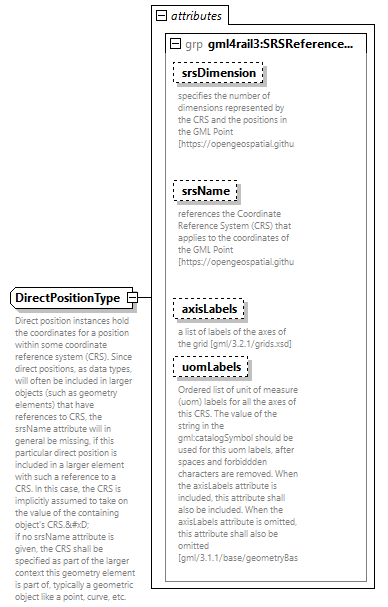 | ||||||||||||||||||||||||||||||||||||||
| namespace | https://www.railml.org/schemas/3.2/gml | ||||||||||||||||||||||||||||||||||||||
| type | extension of gml4rail3:doubleList | ||||||||||||||||||||||||||||||||||||||
| properties |
| ||||||||||||||||||||||||||||||||||||||
| used by |
| ||||||||||||||||||||||||||||||||||||||
| attributes |
| ||||||||||||||||||||||||||||||||||||||
| annotation |
| ||||||||||||||||||||||||||||||||||||||
| source | <xs:complexType name="DirectPositionType"> <xs:annotation> <xs:documentation>Direct position instances hold the coordinates for a position within some coordinate reference system (CRS). Since direct positions, as data types, will often be included in larger objects (such as geometry elements) that have references to CRS, the srsName attribute will in general be missing, if this particular direct position is included in a larger element with such a reference to a CRS. In this case, the CRS is implicitly assumed to take on the value of the containing object's CRS.
 if no srsName attribute is given, the CRS shall be specified as part of the larger context this geometry element is part of, typically a geometric object like a point, curve, etc.</xs:documentation> </xs:annotation> <xs:simpleContent> <xs:extension base="gml4rail3:doubleList"> <xs:attributeGroup ref="gml4rail3:SRSReferenceGroup"/> </xs:extension> </xs:simpleContent> </xs:complexType> |
complexType LineStringType
| diagram | 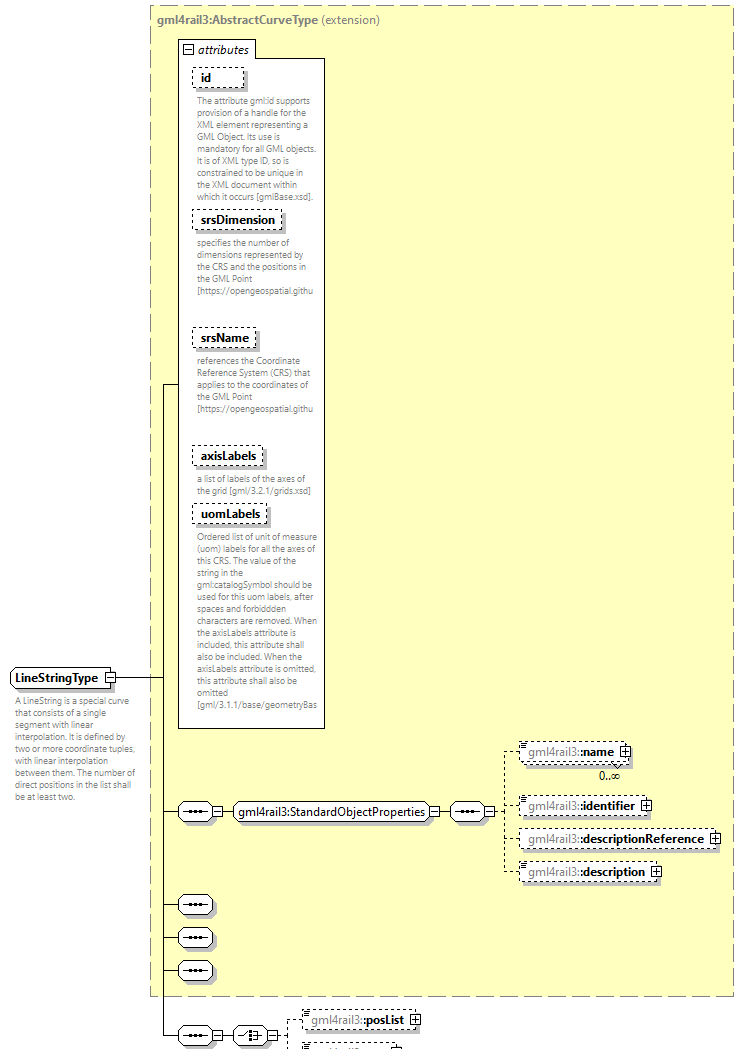 | ||||||||||||||||||||||||||||||||||||||||||||||
| namespace | https://www.railml.org/schemas/3.2/gml | ||||||||||||||||||||||||||||||||||||||||||||||
| type | extension of gml4rail3:AbstractCurveType | ||||||||||||||||||||||||||||||||||||||||||||||
| properties |
| ||||||||||||||||||||||||||||||||||||||||||||||
| children | gml4rail3:name gml4rail3:identifier gml4rail3:descriptionReference gml4rail3:description gml4rail3:posList gml4rail3:pos | ||||||||||||||||||||||||||||||||||||||||||||||
| used by |
| ||||||||||||||||||||||||||||||||||||||||||||||
| attributes |
| ||||||||||||||||||||||||||||||||||||||||||||||
| annotation |
| ||||||||||||||||||||||||||||||||||||||||||||||
| source | <xs:complexType name="LineStringType"> <xs:annotation> <xs:documentation>A LineString is a special curve that consists of a single segment with linear interpolation. It is defined by two or more coordinate tuples, with linear interpolation between them. The number of direct positions in the list shall be at least two.</xs:documentation> </xs:annotation> <xs:complexContent> <xs:extension base="gml4rail3:AbstractCurveType"> <xs:sequence> <xs:choice minOccurs="1" maxOccurs="1"> <xs:element name="posList" type="gml4rail3:DirectPositionListType" minOccurs="0" maxOccurs="1"/> <xs:element name="pos" type="gml4rail3:DirectPositionType" minOccurs="0" maxOccurs="1"/> </xs:choice> </xs:sequence> </xs:extension> </xs:complexContent> </xs:complexType> |
element LineStringType/posList
| diagram | 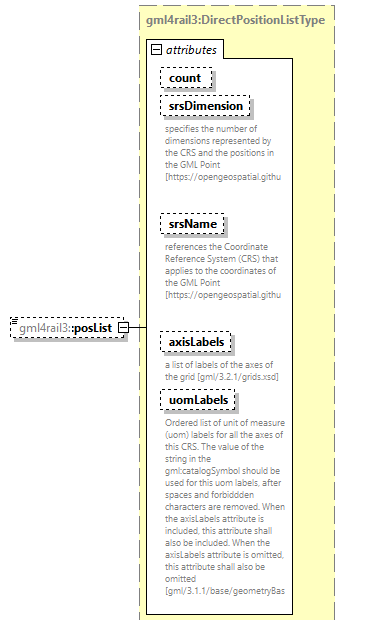 | ||||||||||||||||||||||||||||||||||||||||||||
| namespace | https://www.railml.org/schemas/3.2/gml | ||||||||||||||||||||||||||||||||||||||||||||
| type | gml4rail3:DirectPositionListType | ||||||||||||||||||||||||||||||||||||||||||||
| properties |
| ||||||||||||||||||||||||||||||||||||||||||||
| attributes |
| ||||||||||||||||||||||||||||||||||||||||||||
| source | <xs:element name="posList" type="gml4rail3:DirectPositionListType" minOccurs="0" maxOccurs="1"/> |
element LineStringType/pos
| diagram | 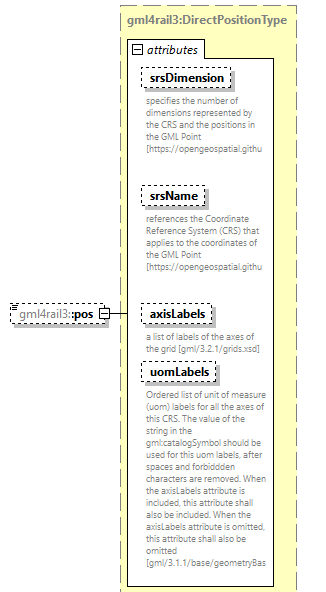 | ||||||||||||||||||||||||||||||||||||||
| namespace | https://www.railml.org/schemas/3.2/gml | ||||||||||||||||||||||||||||||||||||||
| type | gml4rail3:DirectPositionType | ||||||||||||||||||||||||||||||||||||||
| properties |
| ||||||||||||||||||||||||||||||||||||||
| attributes |
| ||||||||||||||||||||||||||||||||||||||
| source | <xs:element name="pos" type="gml4rail3:DirectPositionType" minOccurs="0" maxOccurs="1"/> |
complexType PointType
| diagram | 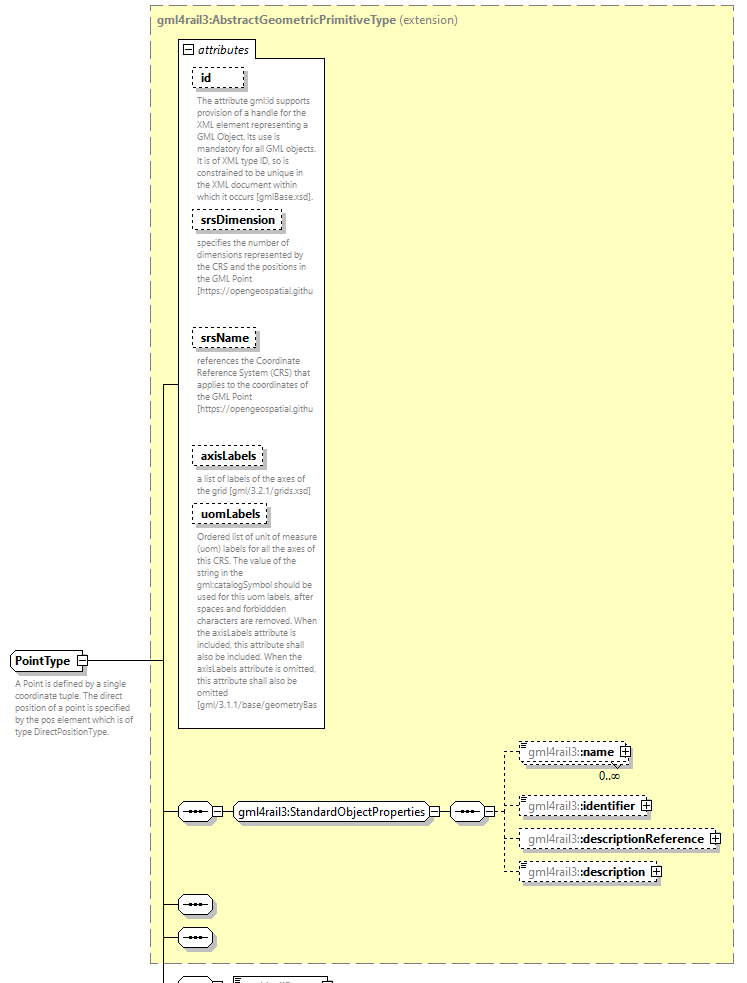 | ||||||||||||||||||||||||||||||||||||||||||||||
| namespace | https://www.railml.org/schemas/3.2/gml | ||||||||||||||||||||||||||||||||||||||||||||||
| type | extension of gml4rail3:AbstractGeometricPrimitiveType | ||||||||||||||||||||||||||||||||||||||||||||||
| properties |
| ||||||||||||||||||||||||||||||||||||||||||||||
| children | gml4rail3:name gml4rail3:identifier gml4rail3:descriptionReference gml4rail3:description gml4rail3:pos | ||||||||||||||||||||||||||||||||||||||||||||||
| used by |
| ||||||||||||||||||||||||||||||||||||||||||||||
| attributes |
| ||||||||||||||||||||||||||||||||||||||||||||||
| annotation |
| ||||||||||||||||||||||||||||||||||||||||||||||
| source | <xs:complexType name="PointType"> <xs:annotation> <xs:documentation>A Point is defined by a single coordinate tuple. The direct position of a point is specified by the pos element which is of type DirectPositionType.</xs:documentation> </xs:annotation> <xs:complexContent> <xs:extension base="gml4rail3:AbstractGeometricPrimitiveType"> <xs:sequence> <xs:element name="pos" type="gml4rail3:DirectPositionType" minOccurs="1" maxOccurs="1"/> </xs:sequence> </xs:extension> </xs:complexContent> </xs:complexType> |
element PointType/pos
| diagram | 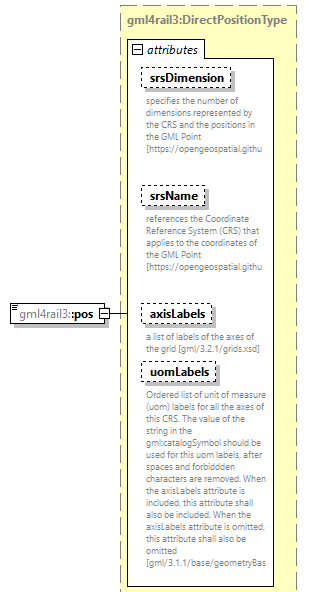 | ||||||||||||||||||||||||||||||||||||||
| namespace | https://www.railml.org/schemas/3.2/gml | ||||||||||||||||||||||||||||||||||||||
| type | gml4rail3:DirectPositionType | ||||||||||||||||||||||||||||||||||||||
| properties |
| ||||||||||||||||||||||||||||||||||||||
| attributes |
| ||||||||||||||||||||||||||||||||||||||
| source | <xs:element name="pos" type="gml4rail3:DirectPositionType" minOccurs="1" maxOccurs="1"/> |
complexType ReferenceType
| diagram | 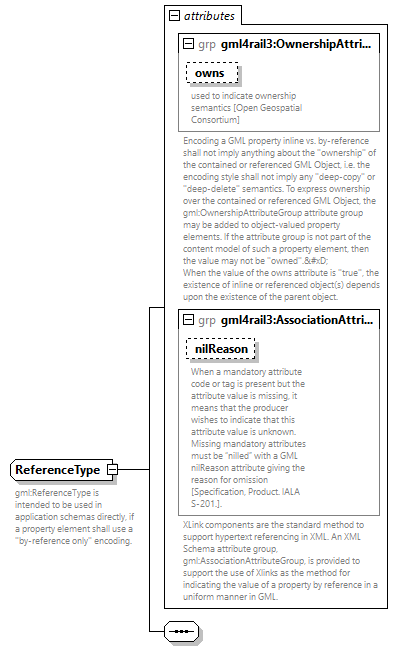 | ||||||||||||||||||||||
| namespace | https://www.railml.org/schemas/3.2/gml | ||||||||||||||||||||||
| used by |
| ||||||||||||||||||||||
| attributes |
| ||||||||||||||||||||||
| annotation |
| ||||||||||||||||||||||
| source | <xs:complexType name="ReferenceType"> <xs:annotation> <xs:documentation>gml:ReferenceType is intended to be used in application schemas directly, if a property element shall use a "by-reference only" encoding.</xs:documentation> </xs:annotation> <xs:sequence/> <xs:attributeGroup ref="gml4rail3:OwnershipAttributeGroup"/> <xs:attributeGroup ref="gml4rail3:AssociationAttributeGroup"/> </xs:complexType> |
complexType StringOrRefType
| diagram | 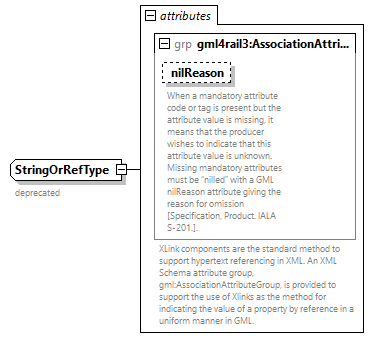 | ||||||||||||||
| namespace | https://www.railml.org/schemas/3.2/gml | ||||||||||||||
| type | extension of xs:string | ||||||||||||||
| properties |
| ||||||||||||||
| used by |
| ||||||||||||||
| attributes |
| ||||||||||||||
| annotation |
| ||||||||||||||
| source | <xs:complexType name="StringOrRefType"> <xs:annotation> <xs:documentation>deprecated</xs:documentation> </xs:annotation> <xs:simpleContent> <xs:extension base="xs:string"> <xs:attributeGroup ref="gml4rail3:AssociationAttributeGroup"/> </xs:extension> </xs:simpleContent> </xs:complexType> |
simpleType doubleList
| namespace | https://www.railml.org/schemas/3.2/gml | ||
| type | list of xs:double | ||
| properties |
| ||
| used by |
| ||
| annotation |
| ||
| source | <xs:simpleType name="doubleList"> <xs:annotation> <xs:documentation>A type for a list of values of the respective simple type.</xs:documentation> </xs:annotation> <xs:list itemType="xs:double"/> </xs:simpleType> |
simpleType NCNameList
| namespace | https://www.railml.org/schemas/3.2/gml | ||
| type | list of xs:NCName | ||
| properties |
| ||
| used by |
| ||
| annotation |
| ||
| source | <xs:simpleType name="NCNameList"> <xs:annotation> <xs:documentation>A type for a list of values of the respective simple type.</xs:documentation> </xs:annotation> <xs:list itemType="xs:NCName"/> </xs:simpleType> |
simpleType NilReasonType
| namespace | https://www.railml.org/schemas/3.2/gml | ||
| type | xs:string | ||
| properties |
| ||
| source | <xs:simpleType name="NilReasonType"> <xs:restriction base="xs:string"/> </xs:simpleType> |
attributeGroup AssociationAttributeGroup
| namespace | https://www.railml.org/schemas/3.2/gml | ||||||||||||||
| used by |
| ||||||||||||||
| attributes |
| ||||||||||||||
| annotation |
| ||||||||||||||
| source | <xs:attributeGroup name="AssociationAttributeGroup"> <xs:annotation> <xs:documentation>XLink components are the standard method to support hypertext referencing in XML. An XML Schema attribute group, gml:AssociationAttributeGroup, is provided to support the use of Xlinks as the method for indicating the value of a property by reference in a uniform manner in GML.</xs:documentation> </xs:annotation> <xs:attribute name="nilReason" type="xs:string" use="optional"> <xs:annotation> <xs:documentation>When a mandatory attribute code or tag is present but the attribute value is missing, it means that the producer wishes to indicate that this attribute value is unknown. Missing mandatory attributes must be “nilled” with a GML nilReason attribute giving the reason for omission [Specification, Product. IALA S-201.].</xs:documentation> </xs:annotation> </xs:attribute> </xs:attributeGroup> |
attribute AssociationAttributeGroup/@nilReason
| type | xs:string | ||
| properties |
| ||
| annotation |
| ||
| source | <xs:attribute name="nilReason" type="xs:string" use="optional"> <xs:annotation> <xs:documentation>When a mandatory attribute code or tag is present but the attribute value is missing, it means that the producer wishes to indicate that this attribute value is unknown. Missing mandatory attributes must be “nilled” with a GML nilReason attribute giving the reason for omission [Specification, Product. IALA S-201.].</xs:documentation> </xs:annotation> </xs:attribute> |
attributeGroup OwnershipAttributeGroup
| namespace | https://www.railml.org/schemas/3.2/gml | ||||||||||||||
| used by |
| ||||||||||||||
| attributes |
| ||||||||||||||
| annotation |
| ||||||||||||||
| source | <xs:attributeGroup name="OwnershipAttributeGroup"> <xs:annotation> <xs:documentation>Encoding a GML property inline vs. by-reference shall not imply anything about the "ownership" of the contained or referenced GML Object, i.e. the encoding style shall not imply any "deep-copy" or "deep-delete" semantics. To express ownership over the contained or referenced GML Object, the gml:OwnershipAttributeGroup attribute group may be added to object-valued property elements. If the attribute group is not part of the content model of such a property element, then the value may not be "owned".
 When the value of the owns attribute is "true", the existence of inline or referenced object(s) depends upon the existence of the parent object.</xs:documentation> </xs:annotation> <xs:attribute name="owns" type="xs:boolean" use="optional"> <xs:annotation> <xs:documentation>used to indicate ownership semantics [Open Geospatial Consortium]</xs:documentation> </xs:annotation> </xs:attribute> </xs:attributeGroup> |
attribute OwnershipAttributeGroup/@owns
| type | xs:boolean | ||
| properties |
| ||
| annotation |
| ||
| source | <xs:attribute name="owns" type="xs:boolean" use="optional"> <xs:annotation> <xs:documentation>used to indicate ownership semantics [Open Geospatial Consortium]</xs:documentation> </xs:annotation> </xs:attribute> |
attributeGroup SRSInformationGroup
| namespace | https://www.railml.org/schemas/3.2/gml | ||||||||||||||||||||||
| used by |
| ||||||||||||||||||||||
| attributes |
| ||||||||||||||||||||||
| source | <xs:attributeGroup name="SRSInformationGroup"> <xs:attribute name="axisLabels" type="gml4rail3:NCNameList" use="optional"> <xs:annotation> <xs:documentation>a list of labels of the axes of the grid [gml/3.2.1/grids.xsd]</xs:documentation> </xs:annotation> </xs:attribute> <xs:attribute name="uomLabels" type="gml4rail3:NCNameList" use="optional"> <xs:annotation> <xs:documentation>Ordered list of unit of measure (uom) labels for all the axes of this CRS. The value of the string in the gml:catalogSymbol should be used for this uom labels, after spaces and forbiddden characters are removed. When the axisLabels attribute is included, this attribute shall also be included. When the axisLabels attribute is omitted, this attribute shall also be omitted [gml/3.1.1/base/geometryBasic0d1d.xsd].</xs:documentation> </xs:annotation> </xs:attribute> </xs:attributeGroup> |
attribute SRSInformationGroup/@axisLabels
| type | gml4rail3:NCNameList | ||
| properties |
| ||
| annotation |
| ||
| source | <xs:attribute name="axisLabels" type="gml4rail3:NCNameList" use="optional"> <xs:annotation> <xs:documentation>a list of labels of the axes of the grid [gml/3.2.1/grids.xsd]</xs:documentation> </xs:annotation> </xs:attribute> |
attribute SRSInformationGroup/@uomLabels
| type | gml4rail3:NCNameList | ||
| properties |
| ||
| annotation |
| ||
| source | <xs:attribute name="uomLabels" type="gml4rail3:NCNameList" use="optional"> <xs:annotation> <xs:documentation>Ordered list of unit of measure (uom) labels for all the axes of this CRS. The value of the string in the gml:catalogSymbol should be used for this uom labels, after spaces and forbiddden characters are removed. When the axisLabels attribute is included, this attribute shall also be included. When the axisLabels attribute is omitted, this attribute shall also be omitted [gml/3.1.1/base/geometryBasic0d1d.xsd].</xs:documentation> </xs:annotation> </xs:attribute> |
attributeGroup SRSReferenceGroup
| namespace | https://www.railml.org/schemas/3.2/gml | ||||||||||||||||||||||||||||||||||||||
| used by |
| ||||||||||||||||||||||||||||||||||||||
| attributes |
| ||||||||||||||||||||||||||||||||||||||
| source | <xs:attributeGroup name="SRSReferenceGroup"> <xs:attribute name="srsDimension" type="xs:positiveInteger" use="optional"> <xs:annotation> <xs:documentation>specifies the number of dimensions represented by the CRS and the positions in the GML Point [https://opengeospatial.github.io/e-learning/gml/text/main.html]</xs:documentation> </xs:annotation> </xs:attribute> <xs:attribute name="srsName" type="xs:anyURI" use="optional"> <xs:annotation> <xs:documentation>references the Coordinate Reference System (CRS) that applies to the coordinates of the GML Point [https://opengeospatial.github.io/e-learning/gml/text/main.html].</xs:documentation> </xs:annotation> </xs:attribute> <xs:attributeGroup ref="gml4rail3:SRSInformationGroup"/> </xs:attributeGroup> |
attribute SRSReferenceGroup/@srsDimension
| type | xs:positiveInteger | ||
| properties |
| ||
| annotation |
| ||
| source | <xs:attribute name="srsDimension" type="xs:positiveInteger" use="optional"> <xs:annotation> <xs:documentation>specifies the number of dimensions represented by the CRS and the positions in the GML Point [https://opengeospatial.github.io/e-learning/gml/text/main.html]</xs:documentation> </xs:annotation> </xs:attribute> |
attribute SRSReferenceGroup/@srsName
| type | xs:anyURI | ||
| properties |
| ||
| annotation |
| ||
| source | <xs:attribute name="srsName" type="xs:anyURI" use="optional"> <xs:annotation> <xs:documentation>references the Coordinate Reference System (CRS) that applies to the coordinates of the GML Point [https://opengeospatial.github.io/e-learning/gml/text/main.html].</xs:documentation> </xs:annotation> </xs:attribute> |
element any
| diagram |  | ||||||||||||||
| namespace | http://purl.org/dc/elements/1.1/ | ||||||||||||||
| type | SimpleLiteral | ||||||||||||||
| properties |
| ||||||||||||||
| used by |
| ||||||||||||||
| attributes |
| ||||||||||||||
| source | <xs:element name="any" type="SimpleLiteral" abstract="true"/> |
element contributor
| diagram |  |
| namespace | http://purl.org/dc/elements/1.1/ |
| substitution group | any |
| source | <xs:element name="contributor" substitutionGroup="any"/> |
element coverage
| diagram |  |
| namespace | http://purl.org/dc/elements/1.1/ |
| substitution group | any |
| source | <xs:element name="coverage" substitutionGroup="any"/> |
element creator
| diagram |  |
| namespace | http://purl.org/dc/elements/1.1/ |
| substitution group | any |
| source | <xs:element name="creator" substitutionGroup="any"/> |
element date
| diagram |  |
| namespace | http://purl.org/dc/elements/1.1/ |
| substitution group | any |
| source | <xs:element name="date" substitutionGroup="any"/> |
element description
| diagram |  |
| namespace | http://purl.org/dc/elements/1.1/ |
| substitution group | any |
| source | <xs:element name="description" substitutionGroup="any"/> |
element format
| diagram |  |
| namespace | http://purl.org/dc/elements/1.1/ |
| substitution group | any |
| source | <xs:element name="format" substitutionGroup="any"/> |
element identifier
| diagram |  |
| namespace | http://purl.org/dc/elements/1.1/ |
| substitution group | any |
| source | <xs:element name="identifier" substitutionGroup="any"/> |
element language
| diagram |  |
| namespace | http://purl.org/dc/elements/1.1/ |
| substitution group | any |
| source | <xs:element name="language" substitutionGroup="any"/> |
element publisher
| diagram |  |
| namespace | http://purl.org/dc/elements/1.1/ |
| substitution group | any |
| source | <xs:element name="publisher" substitutionGroup="any"/> |
element relation
| diagram |  |
| namespace | http://purl.org/dc/elements/1.1/ |
| substitution group | any |
| source | <xs:element name="relation" substitutionGroup="any"/> |
element rights
| diagram |  |
| namespace | http://purl.org/dc/elements/1.1/ |
| substitution group | any |
| source | <xs:element name="rights" substitutionGroup="any"/> |
element source
| diagram |  |
| namespace | http://purl.org/dc/elements/1.1/ |
| substitution group | any |
| source | <xs:element name="source" substitutionGroup="any"/> |
element subject
| diagram |  |
| namespace | http://purl.org/dc/elements/1.1/ |
| substitution group | any |
| source | <xs:element name="subject" substitutionGroup="any"/> |
element title
| diagram |  |
| namespace | http://purl.org/dc/elements/1.1/ |
| substitution group | any |
| source | <xs:element name="title" substitutionGroup="any"/> |
element type
| diagram |  |
| namespace | http://purl.org/dc/elements/1.1/ |
| substitution group | any |
| source | <xs:element name="type" substitutionGroup="any"/> |
group elementsGroup
| diagram | 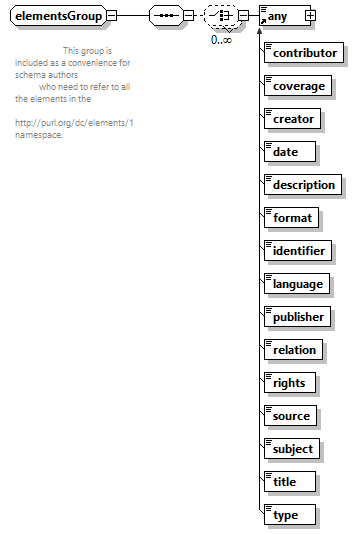 | ||
| namespace | http://purl.org/dc/elements/1.1/ | ||
| children | any | ||
| used by |
| ||
| annotation |
| ||
| source | <xs:group name="elementsGroup"> <xs:annotation> <xs:documentation xml:lang="en"> This group is included as a convenience for schema authors who need to refer to all the elements in the http://purl.org/dc/elements/1.1/ namespace. </xs:documentation> </xs:annotation> <xs:sequence> <xs:choice minOccurs="0" maxOccurs="unbounded"> <xs:element ref="any"/> </xs:choice> </xs:sequence> </xs:group> |
complexType elementContainer
| diagram | 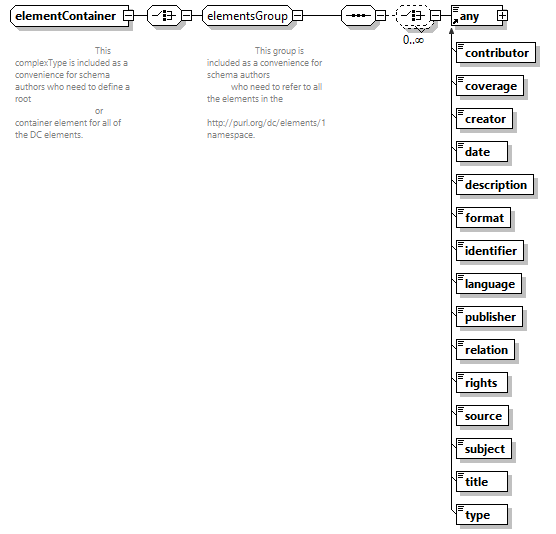 | ||
| namespace | http://purl.org/dc/elements/1.1/ | ||
| children | any | ||
| used by |
| ||
| annotation |
| ||
| source | <xs:complexType name="elementContainer"> <xs:annotation> <xs:documentation xml:lang="en"> This complexType is included as a convenience for schema authors who need to define a root or container element for all of the DC elements. </xs:documentation> </xs:annotation> <xs:choice> <xs:group ref="elementsGroup"/> </xs:choice> </xs:complexType> |
complexType SimpleLiteral
| diagram | 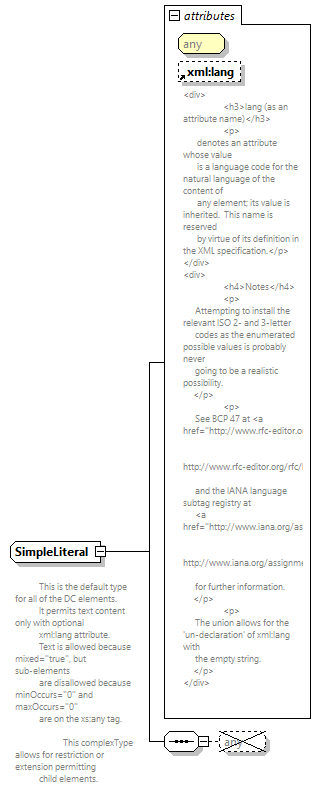 | ||||||||||||||
| namespace | http://purl.org/dc/elements/1.1/ | ||||||||||||||
| type | restriction of xs:anyType | ||||||||||||||
| properties |
| ||||||||||||||
| used by |
| ||||||||||||||
| attributes |
| ||||||||||||||
| annotation |
| ||||||||||||||
| source | <xs:complexType name="SimpleLiteral" mixed="true"> <xs:annotation> <xs:documentation xml:lang="en"> This is the default type for all of the DC elements. It permits text content only with optional xml:lang attribute. Text is allowed because mixed="true", but sub-elements are disallowed because minOccurs="0" and maxOccurs="0" are on the xs:any tag. This complexType allows for restriction or extension permitting child elements. </xs:documentation> </xs:annotation> <xs:complexContent> <xs:restriction base="xs:anyType"> <xs:sequence> <xs:any processContents="lax" minOccurs="0" maxOccurs="0"/> </xs:sequence> <xs:attribute ref="xml:lang" use="optional"/> </xs:restriction> </xs:complexContent> </xs:complexType> |
attribute base
| namespace | http://www.w3.org/XML/1998/namespace | ||
| type | xs:anyURI | ||
| used by |
| ||
| annotation |
| ||
| source | <xs:attribute name="base" type="xs:anyURI"> <xs:annotation> <xs:documentation> <div> <h3>base (as an attribute name)</h3> <p> denotes an attribute whose value provides a URI to be used as the base for interpreting any relative URIs in the scope of the element on which it appears; its value is inherited. This name is reserved by virtue of its definition in the XML Base specification.</p> <p> See <a href="http://www.w3.org/TR/xmlbase/">http://www.w3.org/TR/xmlbase/</a> for information about this attribute. </p> </div> </xs:documentation> </xs:annotation> </xs:attribute> |
attribute id
| namespace | http://www.w3.org/XML/1998/namespace | ||
| type | xs:ID | ||
| used by |
| ||
| annotation |
| ||
| source | <xs:attribute name="id" type="xs:ID"> <xs:annotation> <xs:documentation> <div> <h3>id (as an attribute name)</h3> <p> denotes an attribute whose value should be interpreted as if declared to be of type ID. This name is reserved by virtue of its definition in the xml:id specification.</p> <p> See <a href="http://www.w3.org/TR/xml-id/">http://www.w3.org/TR/xml-id/</a> for information about this attribute. </p> </div> </xs:documentation> </xs:annotation> </xs:attribute> |
attribute lang
| namespace | http://www.w3.org/XML/1998/namespace | ||||
| type | union of (xs:language, restriction of xs:string) | ||||
| used by |
| ||||
| annotation |
| ||||
| source | <xs:attribute name="lang"> <xs:annotation> <xs:documentation> <div> <h3>lang (as an attribute name)</h3> <p> denotes an attribute whose value is a language code for the natural language of the content of any element; its value is inherited. This name is reserved by virtue of its definition in the XML specification.</p> </div> <div> <h4>Notes</h4> <p> Attempting to install the relevant ISO 2- and 3-letter codes as the enumerated possible values is probably never going to be a realistic possibility. </p> <p> See BCP 47 at <a href="http://www.rfc-editor.org/rfc/bcp/bcp47.txt"> http://www.rfc-editor.org/rfc/bcp/bcp47.txt</a> and the IANA language subtag registry at <a href="http://www.iana.org/assignments/language-subtag-registry"> http://www.iana.org/assignments/language-subtag-registry</a> for further information. </p> <p> The union allows for the 'un-declaration' of xml:lang with the empty string. </p> </div> </xs:documentation> </xs:annotation> <xs:simpleType> <xs:union memberTypes="xs:language"> <xs:simpleType> <xs:restriction base="xs:string"> <xs:enumeration value=""/> </xs:restriction> </xs:simpleType> </xs:union> </xs:simpleType> </xs:attribute> |
attribute space
| namespace | http://www.w3.org/XML/1998/namespace | |||||||||
| type | restriction of xs:NCName | |||||||||
| used by |
| |||||||||
| facets |
| |||||||||
| annotation |
| |||||||||
| source | <xs:attribute name="space"> <xs:annotation> <xs:documentation> <div> <h3>space (as an attribute name)</h3> <p> denotes an attribute whose value is a keyword indicating what whitespace processing discipline is intended for the content of the element; its value is inherited. This name is reserved by virtue of its definition in the XML specification.</p> </div> </xs:documentation> </xs:annotation> <xs:simpleType> <xs:restriction base="xs:NCName"> <xs:enumeration value="default"/> <xs:enumeration value="preserve"/> </xs:restriction> </xs:simpleType> </xs:attribute> |
attributeGroup specialAttrs
| namespace | http://www.w3.org/XML/1998/namespace | ||||||||||||||||||||||||||||||||||||||
| attributes |
| ||||||||||||||||||||||||||||||||||||||
| source | <xs:attributeGroup name="specialAttrs"> <xs:attribute ref="xml:base"/> <xs:attribute ref="xml:lang"/> <xs:attribute ref="xml:space"/> <xs:attribute ref="xml:id"/> </xs:attributeGroup> |
XML Schema documentation generated by XMLSpy Schema Editor http://www.altova.com/xmlspy
